cure-dolly-transcript
In minor editing. If you want to help, PM me. Transcript originally by nunko/dinuz.
For feedback, tips, edit permissions or stuff I might have overseen or made unclear/inaccurate (mail Mordraug or モルドラウグ), or just contact me on Discord Mordraug (ID “morudoraugu”).
Since I am careful about bots/scams, I do not accept randoms, so you should also let me know either through a message / email or join the MoeWay Discord, so I know it is someone Japanese-related.
For a VERY comprehensive list of resources covering all areas of Japanese, I wrote this Google docs document, where I also record all Japanese observations & experiences I had/read about.
Also sorry if this editing style gives you headaches, I like to highlight things so they are visible:D
If you want to download this whole document, unfortunately due to Google Docs limitations, you cannot download the PDF and EPUB file forms since the document is too big for it, so it will not trigger the download, the way I found is to download the Word form and then convert it to a PDF, which mostly works, but the images will have worse quality unless you use some quality software & it will be somewhat blurry; also no Yomitan / 10ten (tho can use Yomininja - must-have tool imo)
The formatting of the text might also be a bit screwed up there, but should be good enough.
**However, “AlekDavid_” came up with a pretty simple solution and that is to simply divide the transcript into parts and put them as links here, which will enable direct PDF, EPUB etc. download.
So, here they are (the file sizes are still quite big though):
Full Transcript (YOU ARE HERE)**
Cure Dolly Complete Grammar Series Transcript (in minor editing)
If you want to download this massive transcript in PDF etc., click on these links and click Download as PDF etc. up in the “File” tab. It might still take roughly 20 seconds for the download to initiate, but it should work fine. This also might be useful if this full instance of the transcript lags for you. I suppose it should lag less there. You could then merge the PDFs I suppose if you want one whole transcript file.
**Alas, this is the G-Docs limitation. If you had an idea of putting the Transcript elsewhere or such, you can let me know, but it is outside of my ability to host a site or the like unfortunately.
*Be free to archive the entire document if anything happens to this one & can share it on MoeWay etc. (give me and Nunko credit/don’t change it too much please, but can fix mistakes/improve etc.).
Unfortunately, I cannot make the document public on search engines, just through a link directly.
So the best way is to simply share the link elsewhere, not sure why Google changed this…
I would like to add more videos and even archive the comments under the videos just in case in the future, but alas I am really burned out. It would take a LOT of work so I am not feeling it now.
If anyone ever felt like doing it and helping, let me know, you are free to do so & help is welcome!
**Note:* I use notes to clear up stuff I deem confusing/typos etc., going from what Dolly says herself mostly.
*You can always spot my notes through the italic non-bold purple colour (this version).
I include links too, which are in blue (click on the blue text & then on the link to use it…can try it!)
I mostly removed the bolded style because it was quite bloated and it was recommended to me to do it.
*The notes are there just as a bonus (originally for myself) and something to maybe keep in mind and look further into on your own. They’re NOT absolute, nor do I claim to understand stuff better, take them with a LOT of salt, I’m just a passionate learner who wants to help. I am aware they might be misleading / have factual errors in them, since my Japanese ability is still largely limited.
**Please let me know of any mistakes I say in them / elsewhere, I never change Dolly’s text.
**Dolly tends to explain specifics more in-depth in the comments of the videos, so always look there first if in doubt. Provided it was mentioned & Dolly responded to it, but I would not take her as gospel too much.
Since she is no longer here, we cannot ask her to elaborate on stuff, do not get me wrong, she was clearly knowledgeable, but due to her course being mostly aimed at beginners, stuff is often somewhat simplified which might later on cause misunderstandings hence why I say this. But, do refer to her word over mine.
I do tend to sometimes speculate in my notes and go on long essays in them about how I understand things, but obviously that is just me speculating and looking up some sources online for it that SEEM to suggest it, I do it for myself mainly, I do not intend to undermine Dolly or such with them. You should take my long speculating notes with some skepticism. Moreover, they are fully optional so you can skip them. *
The normal underline marks important info by Dolly or to highlight discussed parts of sentences.
But, I am not too sure about it, so it’s not every lesson for now… feedback would be welcome!
*If the pictures don’t want to load, just wait for some time and they should load eventually.
Let me know if you see white lines or glitching while scrolling (especially in the later half of the document) as I switched to the pageless mode which seems more fitting for a document this huge.
After some testing, it seems to be due to a bloated browser (when you use lots of extensions like I do, and keep all your Cache/Cookies always etc.) so you can try letting it load a bit or simply clear your Cache/browser (it will sign you off)**, or you may have an unstable Internet connection or such. *
*Yomitan** by TheMoeWay works for Google Docs, so use it; or you can use 10ten/Rikaichamp (or both).
Since Yomichan ended development, it will likely become incompatible in the future and Yomitan continues its legacy now. RIP Legend. Another continuation is Yomibaba, if anything happens to Yomitan.
However, Yomitan cannot scan differently modified text, e.g. 歩く / 歩く / 歩く (く is italic) so scanning both will result in Yomitan not being able to scan both at once… I do not know why this is, if you know please PM me… however, 10ten/Rikaichamp is completely fine with scanning this, so use that one then.
In Memory of Cure Dolly
Hello, everyone. My name is Cure Dolly and I am here to teach you Organic Japanese.
What is Organic Japanese? It is Japanese pure and simple, with no harmful additives.
Japanese is the simplest, most logical, most easily understandable language I have ever encountered – much easier than Western languages.
But you wouldn’t know that if you try to learn it from Western textbooks or Japanese learning websites. Why not? Because they don’t teach Japanese structure. They teach English structure and then try to force Japanese into it. And it doesn’t fit, and it doesn’t work very well. That is the main reason, I think, why so many people give up Japanese. The Western system makes it seem complicated, full of strange exceptions and odd rules that you have to memorize. And none of this is true if you learn the language the way it really is.
So, this course is not just for people beginning Japanese. It’s very good for those people – this is the best way to start. But if you’ve been learning Japanese for a while and you find yourself getting confused by things, it would be very good to watch this series and learn from the start the way Japanese should have been explained in the first place. All right, let’s get started.
Table of Contents
Not the best, I know, but so far this is the best I could do, since G-Docs is a bit limited.
Simply click on an entry or sub-entry & there will be a link that will get you there.
***You can also use the Document Outline on the left side of the page, just let it load with the rest.
*For some reason, the handy document summary above the Outline is gone… but also not gone since it still shows when this document link is shared on Discord etc., but I can’t access it anymore… nor can anyone, including me, see it… which makes me rather angry:D Fix it Google…please…
The page numbers here are now inaccurate if you zoom-in from the default 100% zoom since I switched to the Pageless mode due to collapsible headings and it seems to be a bit better for reading, if I update the table automatically, it will render page numbers null, so it must be done manually…
I also did so because I no longer need to try to fit the pictures onto pages, hence some can be bigger.
But the Outline is much better anyway, so I may get rid of this table if anything since it is not that needed…
**Again, like mentioned above, let me know if there are some glitches with white spaces/text not showing while scrolling (especially in the later parts of the document), after testing, it seems to be due to bloated browser (when you use lots of extensions like I do, or keep your Cache etc.).
So you can try letting it load a bit or simply clear your cache or you may have an unstable Internet connection or such. Or switch a browser…
**Would be good if Google fixed it…
- Table of Contents
- 1. The Basic Types of Sentences 14
- 2. The Invisible Carriage and the を Particle 19
- 3. The は Particle 27
- 4. Japanese Verb Tenses 35
- 5. Verb Groups and the て-form 44
- 6. Adjectives 53
- 7. Negative Forms and Adjectives in Past Tense 67
- 7.5. Conjugation 81
- 8. The に and へ particles 95
- 8b. Particles explained 108
- 9. The Subject of the Japanese Sentence & Expressing Desire: ほしい, たい, たがる 116
- 10. Helper verbs & the potential helper verb 132
- 11. Compound sentences, くれる, あげる and more uses of the て-form 145
- 12. Quotation particle と, compound verbs & nouns 155
- 13. Passive Conjugation / Receptive Helper Verb 172
- 14. Adverbs and the も Particle 185
- 15. Transitive & intransitive verbs 203
- 16. てみる, や particle, から particle, exclusive “and” 217
- 17. Formal Japanese and the volitional 237
- 18. って = は?? Mysteries explained! -おうとする, とする, として, という, っていう 247
- 19. Causative + causative receptive 259
- 20. Directionals: それ・その・そんな・そう etc. 272
- 21. てある/ている & ておく 284
- 22. ては & ても 297
- 23. だって + だから & それから 308
- 24. Hearsay & guesses - そう・そうだ・そうです 317
- 25. らしい vs そうだ / そうです + っぽい (ppoi) 327
- 26. Similes: ようだ・のように・のような ・みたい 338
- 27. ばかり 348
- 28. ように - one key to all the main uses 355
- 29. ことにする & ことになる 363
- 30. Japanese Conditionals: と 370
- 31. The ば / れば Conditional 375
- 32. The たら, なら Conditionals 380
- 33. Limiting terms: だけ, しか, ばかり, のみ 384
- 34. Understand any sentence 392
- 35. より, のほう, 一方 406
- 36. 所 - the concept of “place” 414
- 37. New structure secrets + な vs の, なる & たる adjectives 420
- 38. When “it isn’t” means “it is”: じゃない, ではない 431
- 39. The か Particle: “Buried questions”,
かな, もんか, かどうか… 438 - 40. 3 pitfalls in Japanese and how to avoid them 449
- 41. 5 key facts about the basic structure of Japanese 457
- 42. Basic word-confusion - まま 470
- 43. PARADIGM SHIFT: Cut through the confusion 477
- 44. How to use natural Japanese: ちゃう, ちゃった 488
- 45. First-Step Guide into Self Immersion Technique 493
- 46. Word Order MATTERS 2 Simple rules to crack tough sentences 506
- 47. How to Understand Japanese: Your Secret Weapon for breaking down sentences 519
- 48. Dealing with ambiguity in Japanese 532
- 49. Japanese Point-of-View Deconfused! -もらう・てもらう 545
- 50. 2 Aspects of Japanese that Foreigners Can’t Fathom: させてもらう Last Secret of the Potential 554
- 51. How to read a Japanese 怪談 / かいだん (ghost story) 562
- 52. In-depth Japanese Sentence Analysis in Real Native Context 569
- 53. Enjoy Japanese Horror in Japanese 579
- 54. IRREGULARITIES & how they work 見る, 見られる, 見れる, 見える, 聞く, 聞ける, 聞こえる 590
- 55. Secrets of the で particle. Why do we say みんなで行く? and 世界で一番? 600
- 56. “Agility”: Deeper secrets of は and の particles 610
- 57. 込む (Komu) and the secret of multi-meaning Japanese words 618
- 58. Japanese double particles. How they work 626
- 59. Untranslatable Japanese exists! How to understand it 637
- 60. The OTHER HALF of Japanese Structure - non-logical topic/comment structure 645
- 61. は and が: the Deeper Secrets! The yin-yang structure of Japanese 653
- 62. ておく vs てしまう, helper verb secrets 664
- 63. WILD sentence enders in real life Japanese かい、だい,、ぜ、ぞ、さ、から、し、ちょうだい 669
- 64. “Things” get Strange! もの and こと - Advanced secrets: ものだ, ことがある, こと as sentence-ender 681
- 65. Coming and Going: Deeper secrets of 行く and 来る、て行くand て来る (te-iku, te-kuru) 692
- 66. HIDDEN Subjects in Japanese - and how to understand them 701
- 67. もう and まだ the time-relations that make sense of them 712
- 68. Japanese “underlying logic”: わけ、そういうわけ、わけが分からない、わけない 730
- 69. Japanese in the Wild! Tackling native Japanese material. 怪談 4 746
- 70. かける / かかる All-purpose Japanese Explained! 762
- 71. Japanese counters: 3 simple rules 774
- 72. The Great Connector (い-stem magic) 790
- 73. Secrets of 気: 気になる, 気にする, 気がする, 気に入る etc. 808
- 74. LOVE and other mysteries of こと! あなたのことが好き, 私のことが嫌い, ということ, そういうこと, どういうこと, そんなこと 823
- 75. Japanese is NOT English: How expression strategies differ - polite 英本語=rude Japanese 833
- 76. The Right Opening? - あく, あける, ひらく, ひらける, 開く, 開け 846
- 77. Real Japanese Structure vs Tae Kim: Structural Review of Tae Kim’s Japanese Grammar 858
- 78. Breaking the Core: Tae Kim vs the Copula - Japanese Structure-Based Critical Review 876
- 79. Deeper secret of the copula 895
- 80. Dropped particles & casual omissions 908
- 81. Global principle of all Japanese word-forms. 921
- 82. なんて、なんか、など: 3 Common words clarified. 933
- など 934
- など in informal Japanese 937
- なんか 938
- なんか used with oneself 940
- なんか - contraction of なにか / 何か 940
- なんか as “something”, “somewhat” to make things vaguer 940
- なんか as “somehow / for some reason” 941
- なんか in very casual / sloppy speech as “kinda” x 941
- なんて 943
- なんて as “What a (this)” or “What a (that)” 944
- なんて used in a belittling manner 944
- なんて used to express surprise 945
- なんて as this vague という 947
- 83. Three Levels of Command in Japanese: て-form commands, なさい, な-commands, imperative form. 949
- 84. である and the Structure of Japanese. What older copulas tell us: である, であります、でござる、でございます 962
- 85. まい - the negative helper 980
- What is まい? 981
- What a negative volitional cannot do 984
- The uses of まい 984
- Using まい to say that something is unlikely 984
- An exact Japanese equivalent to あるまい 986
- まい used for a strong decision or determination not to do something 988
- Using positive & negative volitional together 989
- Attaching し to the まい construction 989
- 86. 次第 (shidai). 991
- 87. Japanese Structure INVERTED: strange life of しか. 1003
- 88. Xをしたい vs Xがしたい 1016
- 89. De-mystifying Japanese. The Universal Subject 1031
- 90. Japanese Punctuation: How it works. 1043
- 91. Outer Limits! 限る & 限り: Its many meanings and how they work 知っている限り、とは限らない and more 1056
- 92. Will English EAT Japanese? Loan-word invasion - is it really a threat? 1069
- 93. Cussin’ ‘Em Out with くせに. How it works. 1083
- 94. くらい VS ほど 1096
- 95. Using Word-History the Smart Way どうも、やっぱり、やはり 1109
- 96. 通り and せっかく: A metaphorical road and an untranslatable word. 1126
- 97. The meanings of うち: Home, Self, Social boundary, Time marker: いまのうち、そのうち 1136
1. The Basic Types of Sentences
Lesson 1: Japanese made easy! What schools never teach. The core Japanese sentence -organic Japanese
The most basic thing about Japanese is the Japanese core sentence. Every Japanese sentence fundamentally has the same core. What does it look like? It looks like this.
We’re going to picture it as a train. Every Japanese sentence has these two elements:
the main carriage, A and the engine, B.
The engine is what makes the sentence move, what makes it work.
The carriage has to be there because without the carriage there’s nothing for the engine to move. Those two things are the core of every Japanese sentence.
We can say more about A; we can say more about B; we can combine logical sentences together to make complex sentences.
But every Japanese sentence conforms to this basic type.
So, what are A and B? Let’s begin by reminding ourselves that in any language there are only two kinds of sentences: “A is B” sentences and “A does B” sentences.
An example of an “A does B” sentence is “Sakura walks”. Note: (or rather “Sakura throws a ball”) An example of an “A is B” sentence is “Sakura is Japanese”.
And we can put these into the past tense; we can put them in the negative; we can turn them into questions; we can say more about A; we can say more about B.
But, ultimately, every sentence boils down to one of these:
an “A is B” or an “A does B” sentence.
So let’s look at how we do this in Japanese.
Verb sentences
In Japanese, if we want to say “Sakura walks” (A does B: Sakura walks), then A is Sakura, the main carriage, and B is walks, the thing she does, the engine of the sentence.
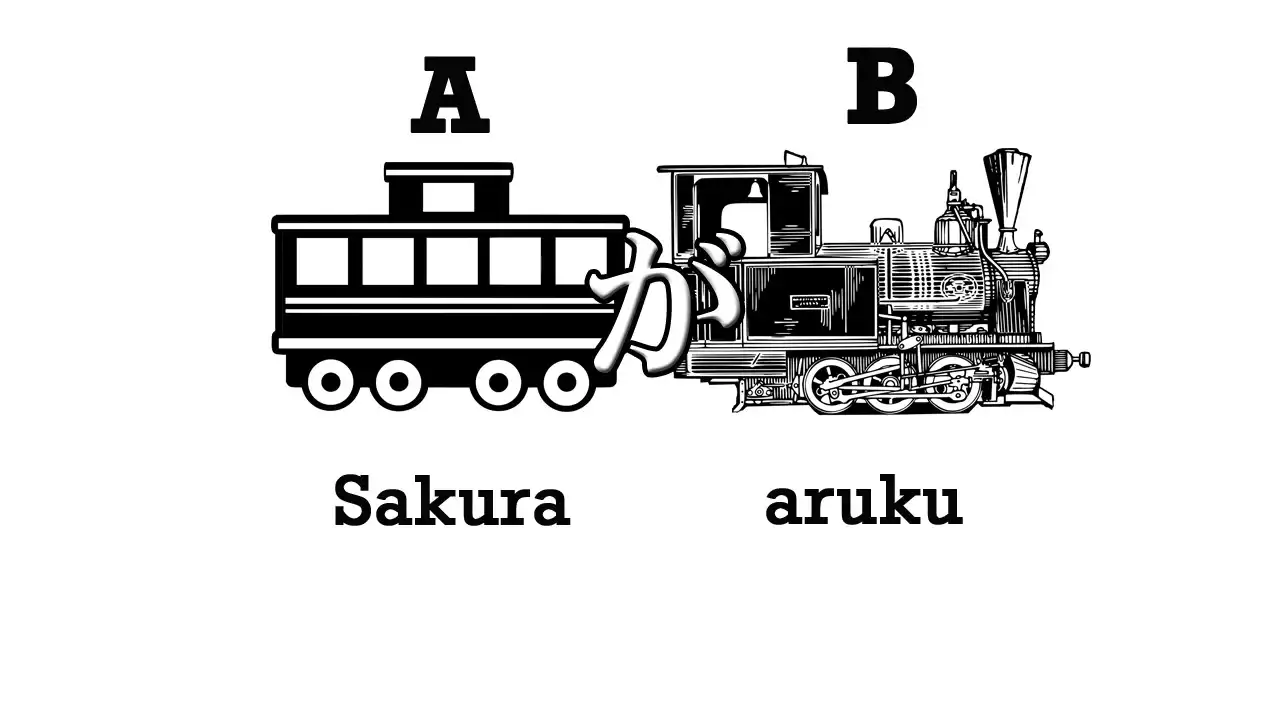
Walk in Japanese is “あるく”. We need one more thing to make the core Japanese sentence, and that is the linchpin of every sentence, が (ga).
が is the center of Japanese grammar. Every Japanese sentence revolves around が.
In some sentences we’re not going to be able to see the が, but it’s always there, and it’s always doing the same job. It links together A and B and turns them into a sentence.
So, our core “A does B” sentence is “さくらがあるく” = “Sakura walks”.
Copula sentences
Now let’s take an A is B sentence: “Sakura is Japanese”, or, as we say, “Sakura is a Japanese person”. So, A again is Sakura, B is にほんじん/日本人, which means Japanese person, and once again we need が to link them together.
So we’re going to picture the A car, the main carriage, with a が on it, because the main carriage, the subject of the sentence, always carries a が, to link it to the engine.
So, さくらが日本人 – and we need one more thing.
There’s one other thing that I want you to make friends with, and that’s だ (da).
“さくらが日本人だ” = “Sakura is a Japanese person”.
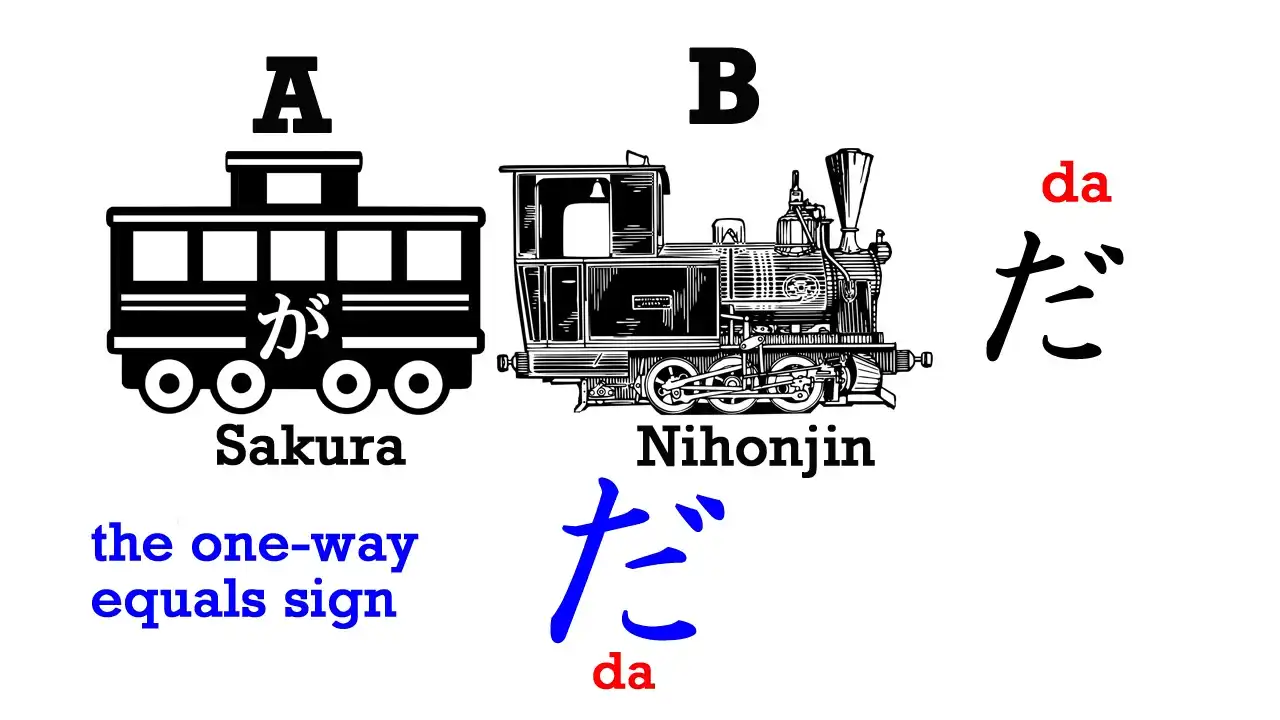
Now, you may have met this だ in its fancy form, です, but there are very good reasons for learning the plain, simple form first.
So we’re going to learn だ.
Now if you look at だ, it’s like an equals sign boxed off to the left.
And this is a perfect mnemonic for what it does, because だ tells us that A is B.
Why is it boxed off to the left?
Because it only works one way.
Think about this logically: さくらが日本人だ means “Sakura = Japanese person.” But it doesn’t work the other way: Japanese people are Sakura – they’re not all Sakura.
Sakura is a Japanese person, but a Japanese person is not necessarily Sakura.
Adjective sentences
So now we have an “A is B” sentence and an “A does B” sentence.
There is one more form of the Japanese core sentence, for it has three forms.
The third form is when we have a describing word, an adjective.
In Japanese, describing words end with い (i), just as they often do in English: happy, sunny, cloudy, silly.
In Japanese it’s just the same:
happy – うれしい/嬉しい; sad – かなしい/悲しい; blue – あおい/青い.
Now, we don’t have to learn all these, but we do need to know about Japanese adjectives ending in い because they make the third kind of sentence.
So let’s take an easy one: ペン (that’s a nice easy word because it means pen) – “ペンが赤い/あかい” = “pen is red”.
Now, you notice that we don’t have a だ on this sentence.
Why is that?
Because the い-adjective あかい/赤い (red) – it doesn’t mean red, it means is-red.
The だ function, the equals function, is built into those い-adjectives.
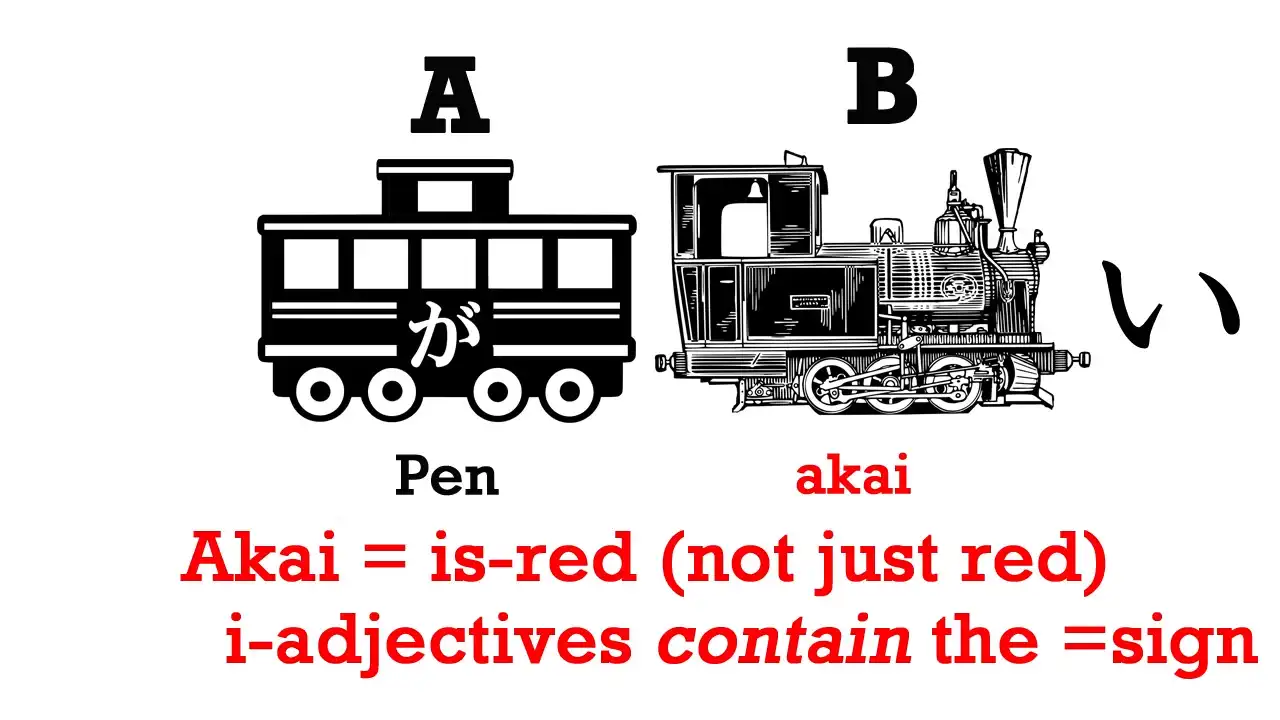
So those are the three forms of Japanese sentence.
They all start with the subject of the sentence, they’re all connected with が, and
they can end in three ways: with a verb, which will end in う, with the copula だ, or with an い
because the last word is an adjective. And now you know the basics of Japanese.
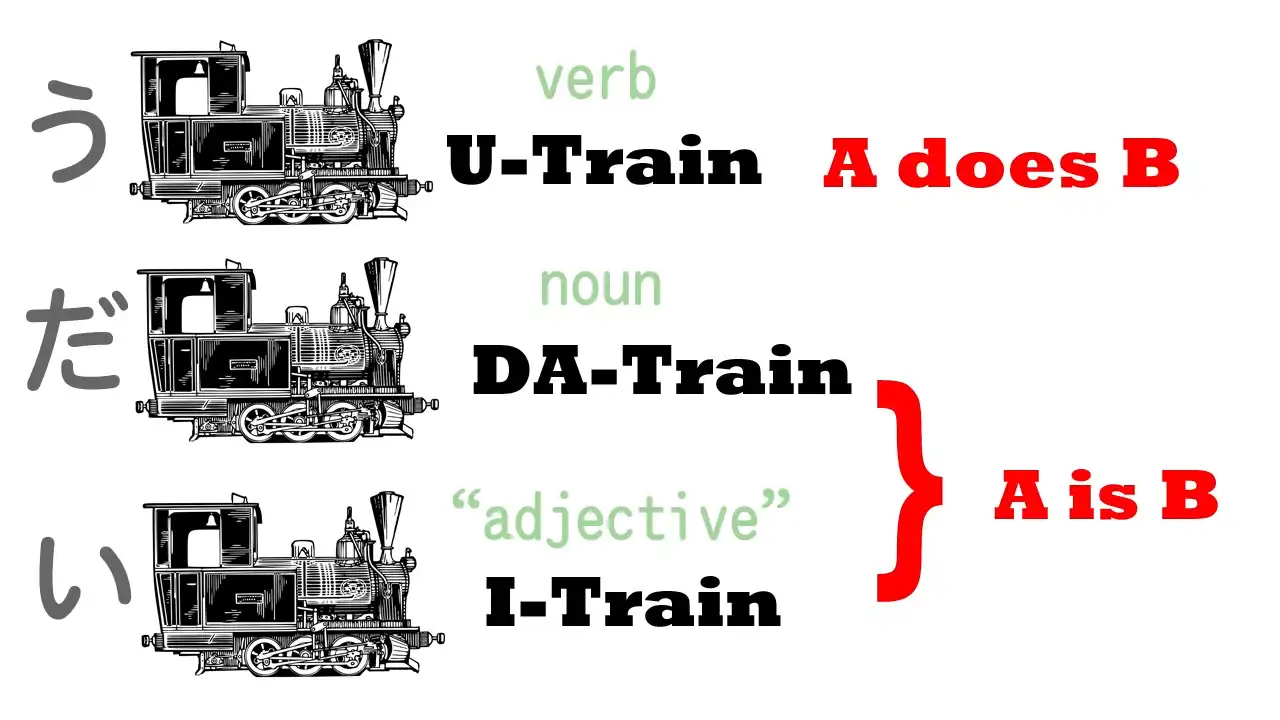
2. The Invisible Carriage and the を Particle
Lesson 2: Core Secrets. Japanese made easy - unlocking the “code”. Learn Japanese from scratch
The Invisible Carriage
In the last lesson, we learned that every Japanese sentence has the same core: the main carriage and the engine, also known as A and B, also known as the thing we are talking about and the thing we are saying about it. And I told you that we can have a lot more carriages as sentences become more complex, but they still always have the same core.
Now we are going to look at some of those extra carriages.
Previously, I stated that while every sentence has the same two core elements, you can’t always see both of them. You can always see the engine, but sometimes you can’t see the main carriage.
Why not?
When you can’t see the main carriage, it’s been replaced by the invisible carriage.
So, what is the invisible carriage? In English, the closest equivalent is “it”.
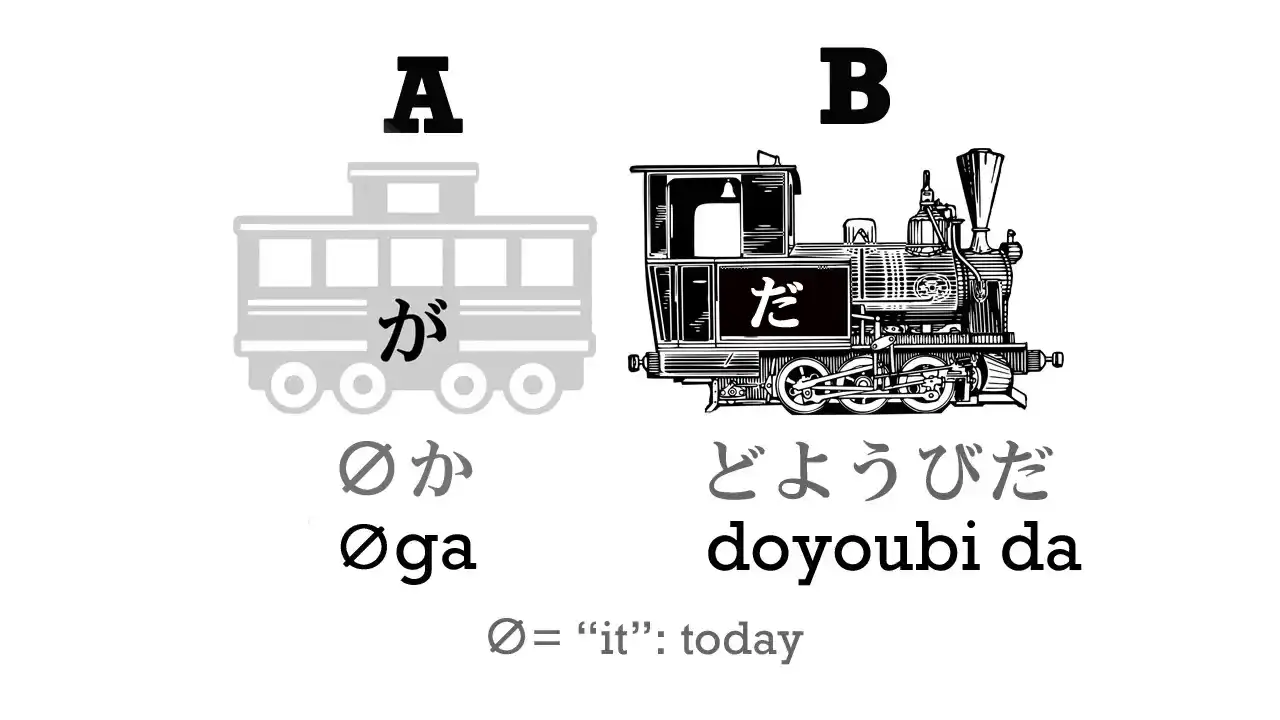
So, let’s begin by seeing what “it” does in English. Let’s look at this example:
“The ball rolled down the hill.
When the ball got to the bottom, the ball hit a sharp stone.
The ball was punctured and all the air came out of the ball.”
Now, would anybody ever say this?
Of course they wouldn’t, because once we have established what we are talking about, we replace it with “it”.
Instead we say,
“The ball rolled down the hill.
When it got to the bottom, it hit a sharp stone.
It was punctured and all the air came out of it.”
“It” means nothing because it can mean absolutely anything.
If I say “it”, I may be talking about a flower or about the sky.
I may be talking about a tree, or my finger, or the Eiffel Tower or the Andromeda galaxy.
“It” in itself doesn’t mean anything: you know what “it” is from context.
Now, let’s suppose a small child tries to say this and says,
“Ball rolled down hill,
got to bottom, hit sharp stone,
got punctured, all the air came out.”
Now, is that difficult to understand?
No, it isn’t difficult at all, is it?
Because in fact we don’t need to use “it” every time, over and over again, to understand what’s being said.
While English grammar demands we do, but there’s no actual communicative need to include “it” everytime.
Japanese doesn’t have “it”. (I guess what is meant is in the substituting sense as above)
So, if a small child, or even an adult, comes down to the kitchen at night and someone sees her,
she might say, “Got really hungry. Came for something to eat.”
Again, there’s nothing confusing or difficult about this.
She means, “I got really hungry. I came down for something to eat.”
In English this isn’t a proper sentence, but in Japanese it is. All those little pronouns, like “it”, “she”, “he”, “I”, “they”, in Japanese can be replaced by the invisible carriage, the zero pronoun. But the important thing to remember is that they are still there.
So let’s look at this at work in Japanese.
I might say, “ドリーだ”, and that means “I am Dolly”.
Initially this looks as if it only has an engine and no main carriage, but actually the main carriage is simply the invisible carriage.
The full sentence is really, “(zeroが)ドリーだ”.
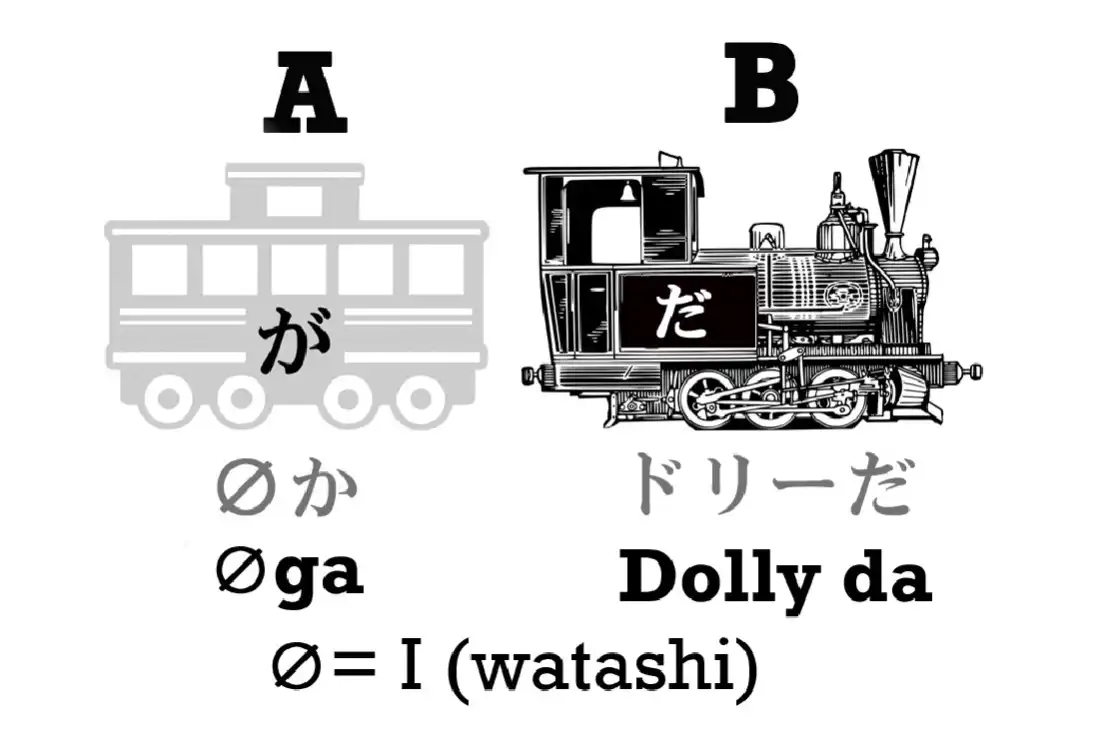
We can say that “I” is the default value of the zero pronoun, the invisible carriage.
However, the context can define it as anything.
For example, if we hear a rustling in the woods and look over in the direction of it, and I say, “ウサギだ!”, that means “(zeroが)ウサギだ!” “It is a rabbit!” It, that thing we just looked toward, rustling in the trees, that’s a rabbit.
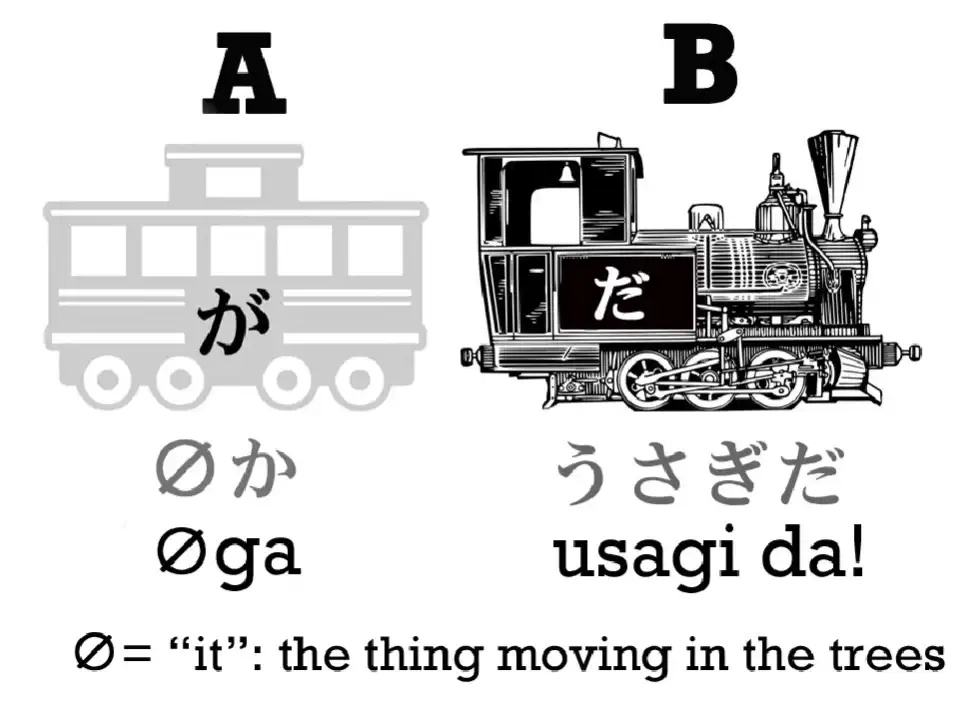
If I say, “土曜日だ” (土曜日/どようび means Saturday), I’m saying “(It) is Saturday”.
What’s “it”? Today is.
All these sentences are full, complete Japanese sentences, with a が-marked subject/ A carriage/main carriage, and an engine.
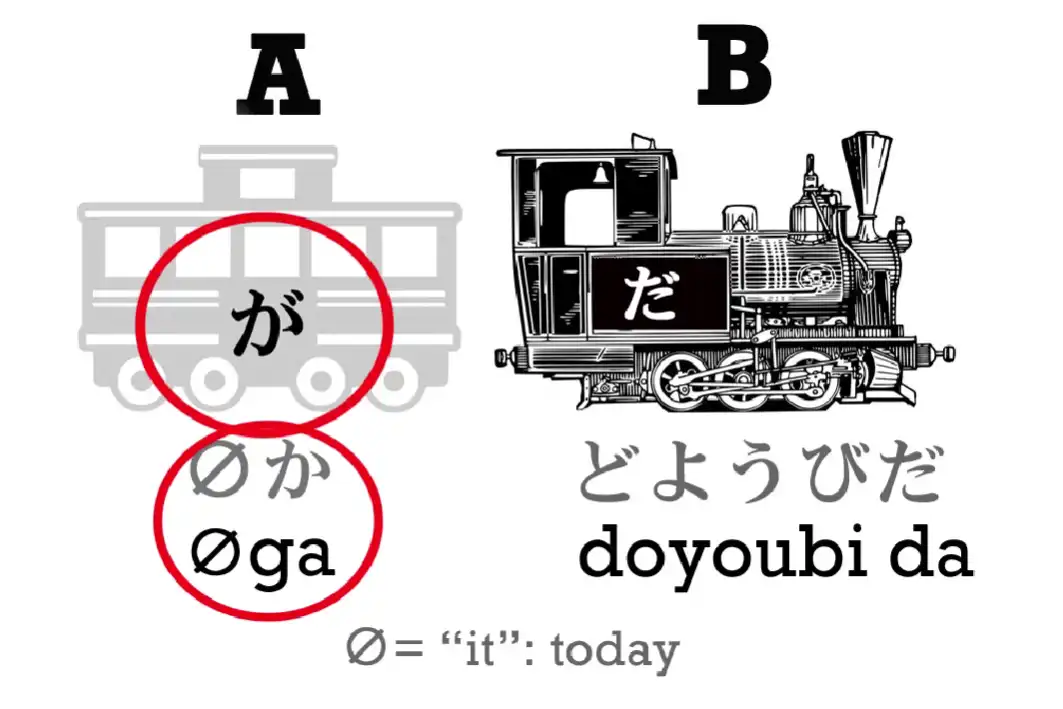
The を particle
I’m going to introduce you to one more kind of carriage and that is an を car.
This means a noun marked by the particle を, pronounced “o”.
And if you know the English grammatical term “object”, which means the thing we’re doing something to, it’s a good mnemonic to remember that “o” stands for “object”.
So the を car looks like this, and as you see, it’s white.
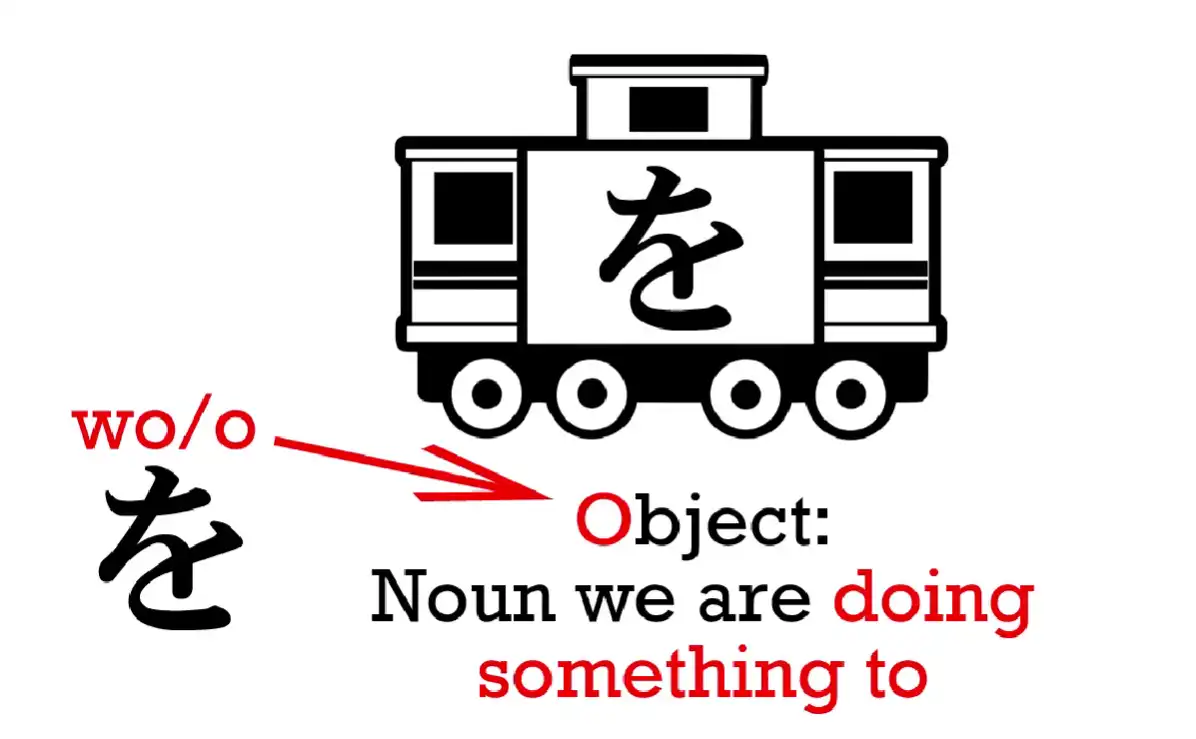
It’s white because it’s not part of the core train.
The core train always consists of just two elements, the engine and the main carriage.
When we see white cars, we know that they’re telling us something more about the engine or about the main carriage.
So let’s take a sentence here: “わたしがケーキを食べる”.
This means “I eat cake”.
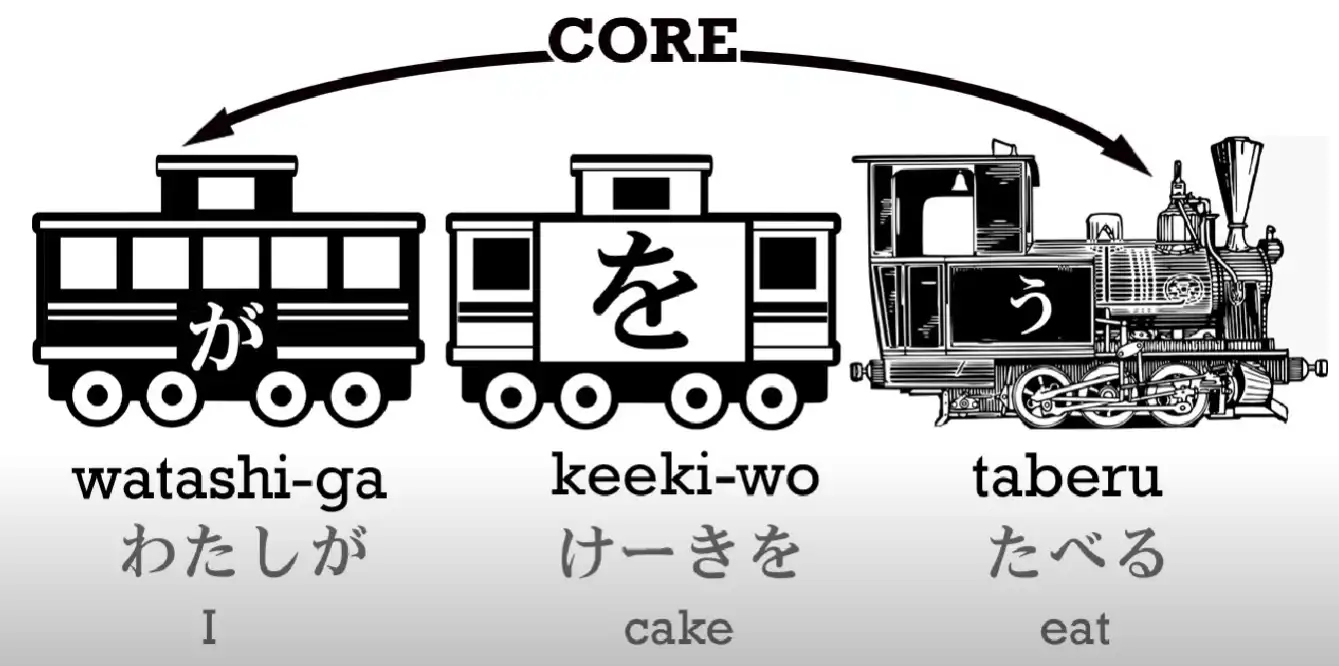
Now, the core sentence here is “I eat”.
Those are the two black carriages.
The white carriage, “ケーキを”, is telling us more about the engine.
The core sentence is “I eat” and “ケーキを” is telling us what it is that I eat.
Now, the interesting thing here is that we may often see this said like this: “ケーキをたべる”.
And you already know what’s going on when this happens.
This is another case where we have the invisible A car.
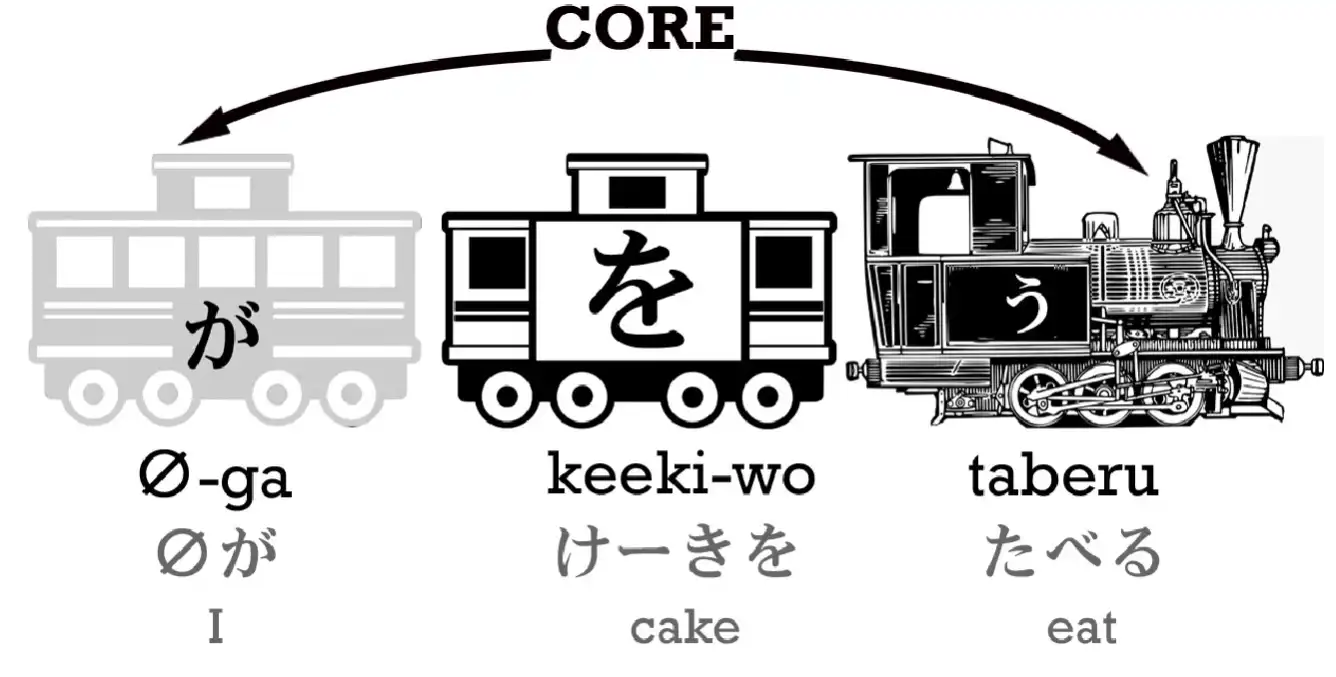
We can’t have a sentence without a が.
We can’t have an action being done without a doer.
If we say “ケーキをたべる”, what we’re really saying is “(zeroが)ケーキをたべる”.
And the default value for “zero”, for the invisible carriage, is “わたし”.
So usually this is going to be “I eat cake”, although if you were talking about someone
else at the time, it might mean that that person eats cake.
Note: Just in case - as can be seen from from the pictures, every particle attaches to/assigns itself to the word BEFORE it, Not after it.
3. The は Particle
Lesson 3: WA-particle secrets schools don’t ever teach. How WA can make or break your Japanese
こんにちは。 Welcome to Lesson 3. Some of you who have done some Japanese already may be wondering how I’ve managed to get through two entire lessons without using or even mentioning the は (always read as wa) particle.
I’m well aware that most courses start you on は from the beginning.
“わたしはアメリカ人だ” “ペンはあおい.” And this is really a very very bad idea because it leaves you completely unclear about what the particles really do and about the logical structure of sentences.
However, we’re now ready to look at the は particle and find out what it does and, just as important, what it doesn’t do.
The は particle can never be a part of the core sentence.
It can never be one of the black carriages, the main car A (the thing we are saying something about) or the engine B (the thing we are saying about it).
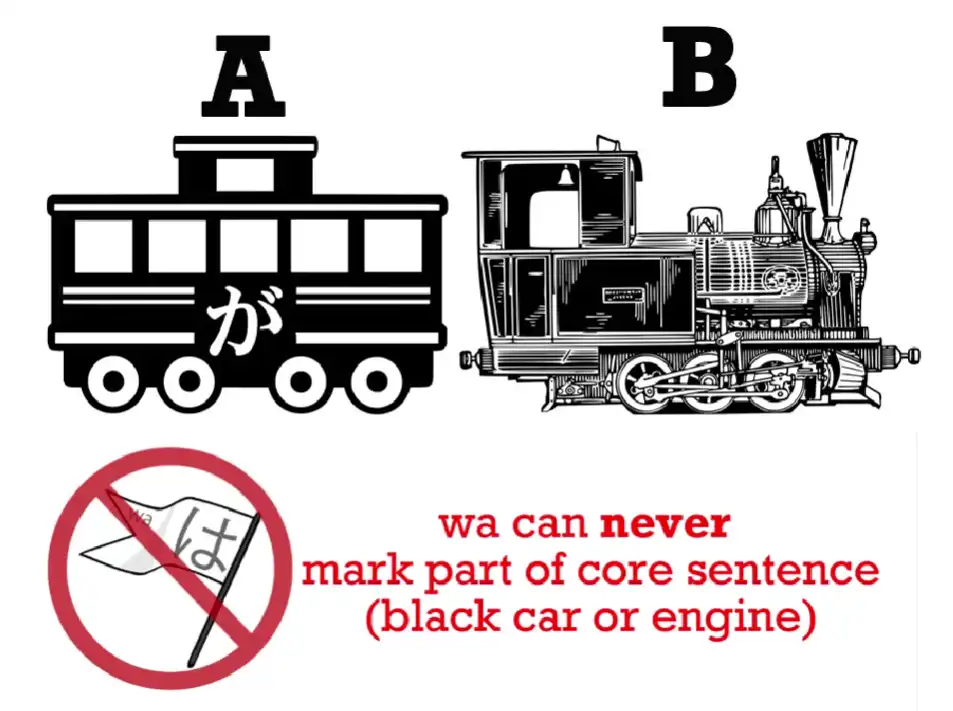
It can’t be a white car either, because white cars like the を (wo) car, are part of the logical structure of the sentence.
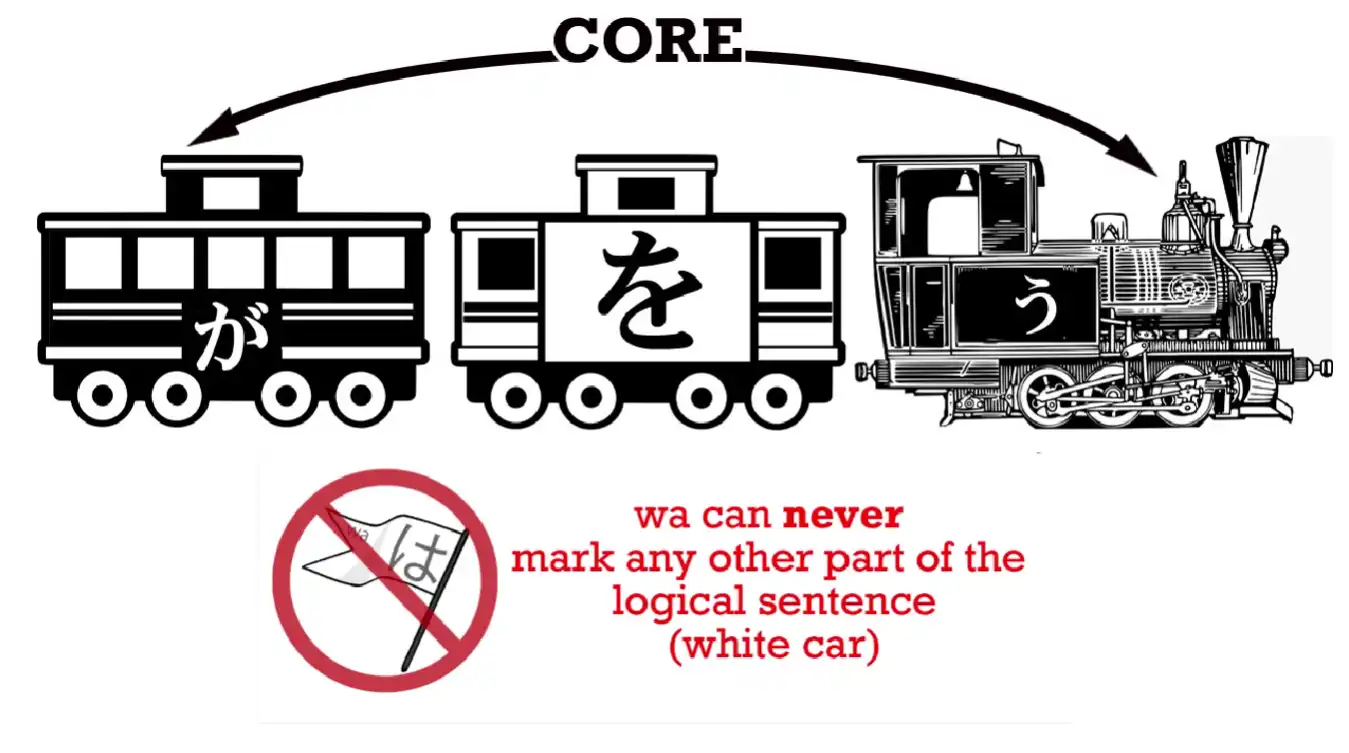
And a は-marked noun is never part of the logical structure of a sentence.
は is a non-logical particle.
So if は is not a black car or a white car, what kind of a carriage is it?
Well, it’s not a carriage at all. A は-marked noun looks like this…
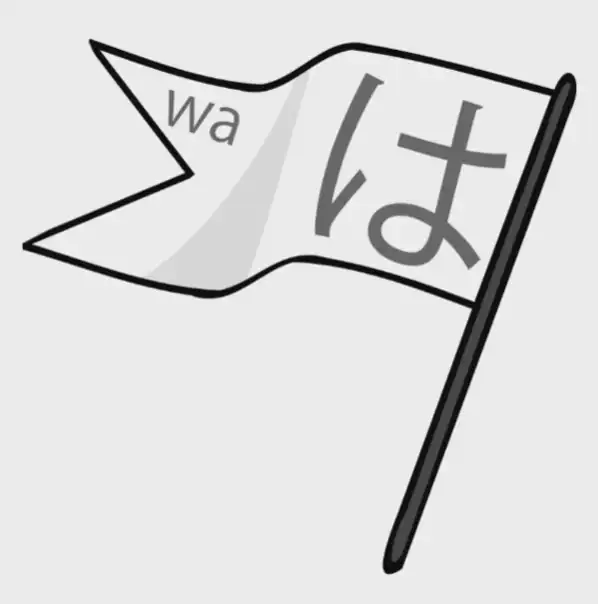
That’s right, it’s a flag.
Why do we depict it as a flag? Because that is what は does.
It flags something as the topic of the sentence.
It doesn’t say anything about it. That’s what the logical sentence is there for.
Wa simply flags the topic.
Now, some of the textbooks will tell you that a sentence like “わたしはアメリカ人だ” literally means “As for me, I am an American”, and that is exactly correct.
If they would stick with that logic and carry it through, we wouldn’t have the trouble we have.
So, “わたし/私は” means “as for me”. “アメリカ人だ” means “=American” or “am American”.
So as you see, with a sentence like this something is missing, both from the Japanese and the English.
We can’t say “as for me, am American”. Neither can we have a sentence
without an A car, without a が-marked doer.
So if we put the A car in, it makes sense in both English and Japanese.
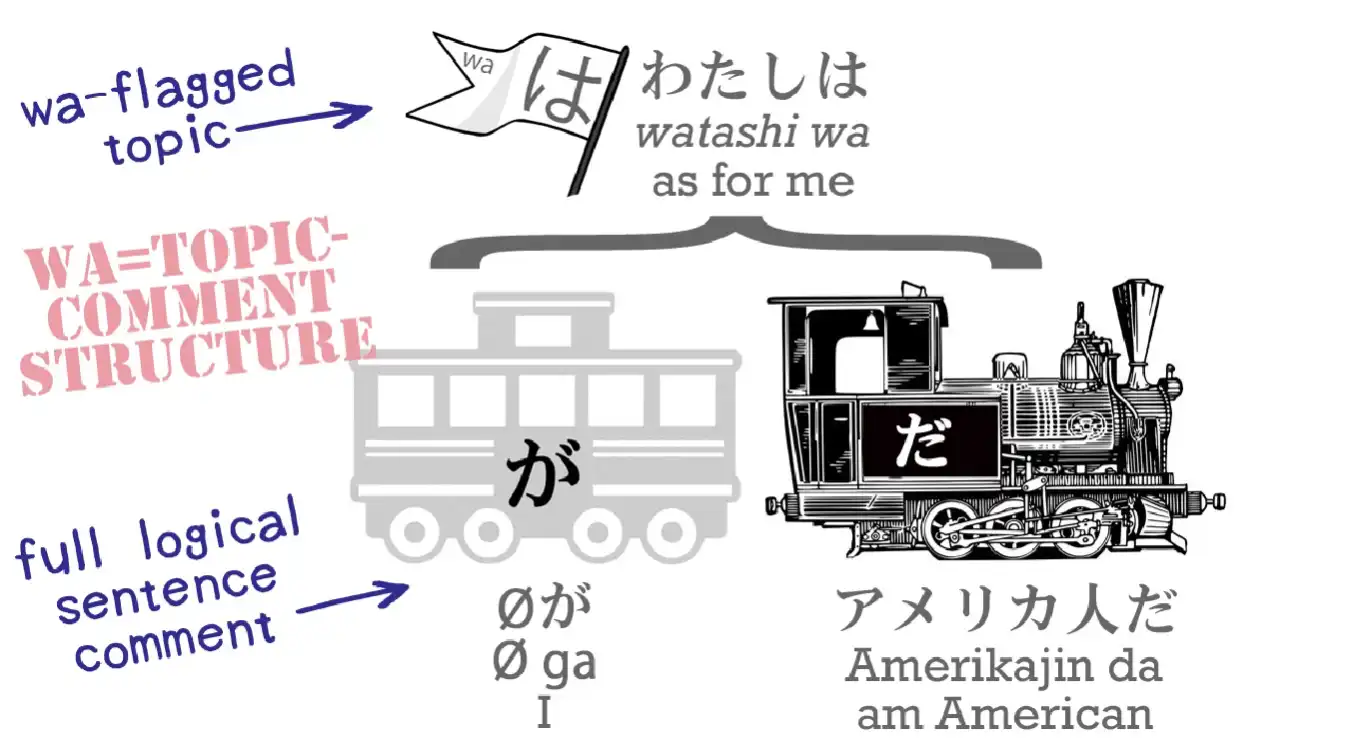
“私は(zeroが)アメリカ人だ” – “As for me, (I) am an American.”
Now, some of you may be saying, “Isn’t it over-complicated?
Can’t we just pretend that ‘わたしは’ is the main car of the sentence?”
And the answer to that is “No”.
Because although it works in this case and some other cases, it doesn’t work in every case and that is why we really mustn’t do it.
Let’s take an example. There’s an old joke among Japanese learners and it’s only possible because of how badly Japanese is taught.
The joke is: A group of people are dining in a restaurant and they’re discussing what they’re going to eat, and somebody says, “わたしはうなぎだ”.
Unagi/うなぎ means eel, so the joke is that this person has literally said, “I am an eel”.
After all, if “わたしはアメリカ人だ” means “I am an American”, then “わたしはうなぎだ” must mean “I am an eel”.
That’s absolutely perfect logic – except that “わたしはアメリカ人だ” doesn’t mean “I am an American”. It means “As for me, I am an American”.
As we know, the default value of the invisible car, the zero pronoun, is “私/わたし”, but that isn’t its only value. Its value depends on context.
In “わたしはアメリカ人だ” (“As for me, I am an American”) the value of the zero pronoun is indeed “私/わたし”.
But in “わたしはうなぎだ”, which is “わたしは(zeroが)うなぎだ”, zero is not “私”. Zero is “it”.
“It” is the thing we are talking about, the subject of the conversation: what we are eating for dinner.
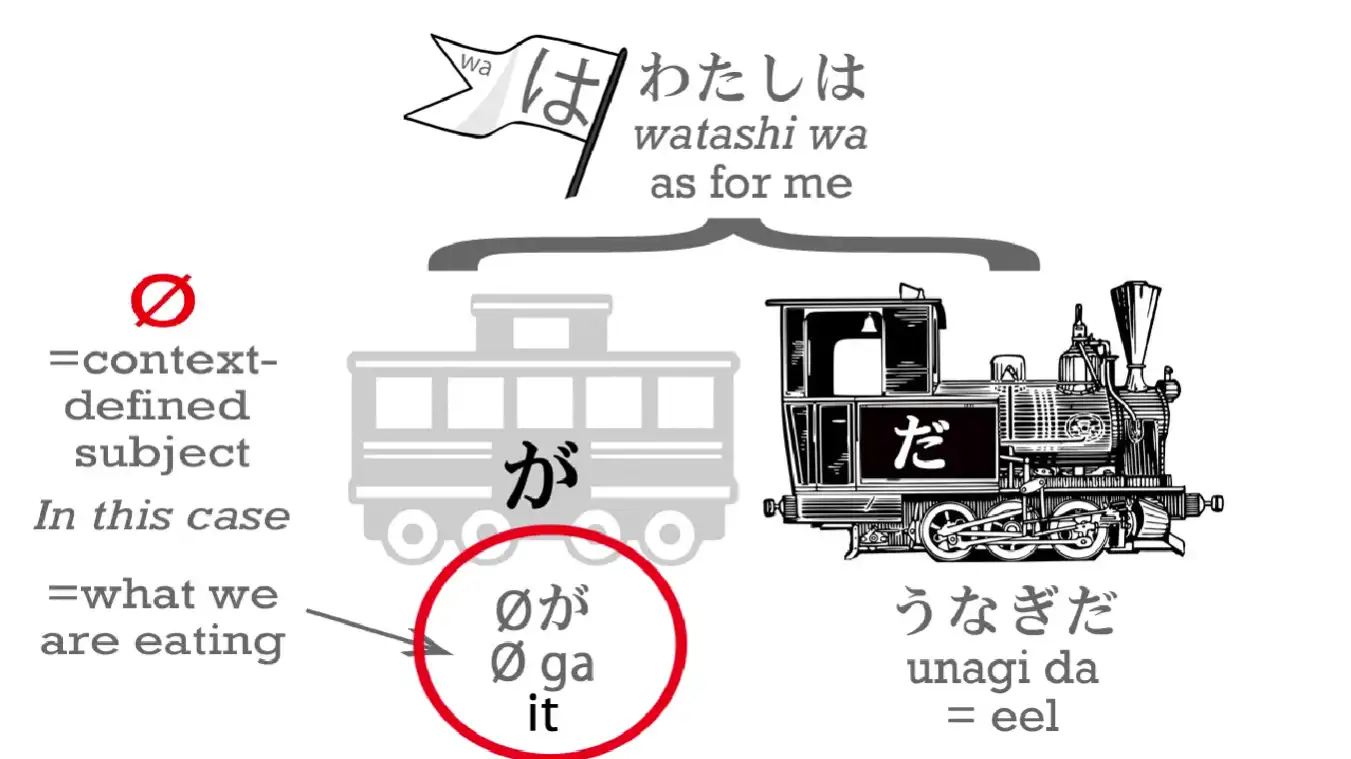
And this is going to affect all kinds of sentences as we become more advanced in Japanese.
So what we are going to do now is take another one of the cars and look at that and then see how it all works together with は.
The car we’re going to introduce today is a white car, and this is the に (ni) car.
It makes a kind of trio with が (ga) and を (wo).
In “A does B” sentences, が tells us who does the doing, を tells us what it is done to, and に tells us the ultimate target of that doing.
Now, we don’t always have a を; we don’t always have a に.
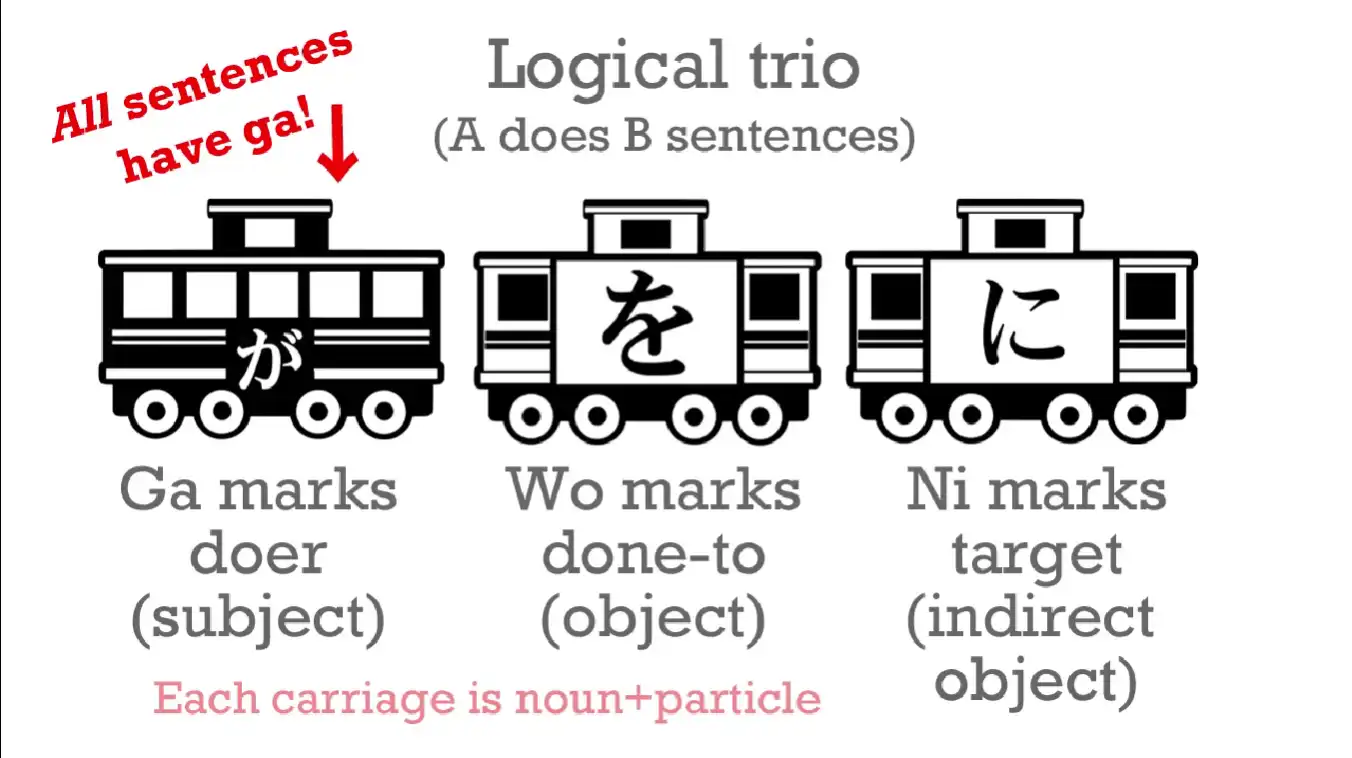
But let’s take this を sentence: “わたしがボールをなげる” ボール is ball and なげる means throw. So this is, “I throw a ball”.
The core sentence is “I throw” – “わたしがなげる”,
and the white car tells us what I threw: it was a ball.
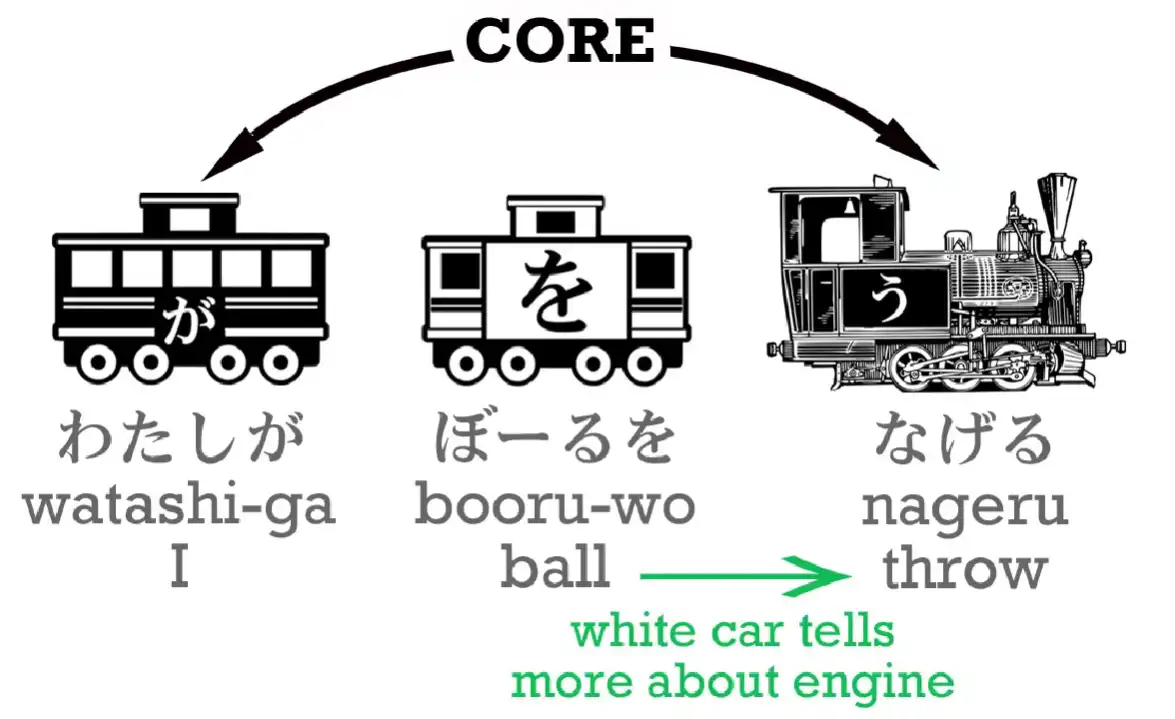
Now, if we say, “わたしがボールをさくらになげる”,
this means “I throw a ball at Sakura” (or “to Sakura”).
Sakura is the destination, the target, of my throwing.
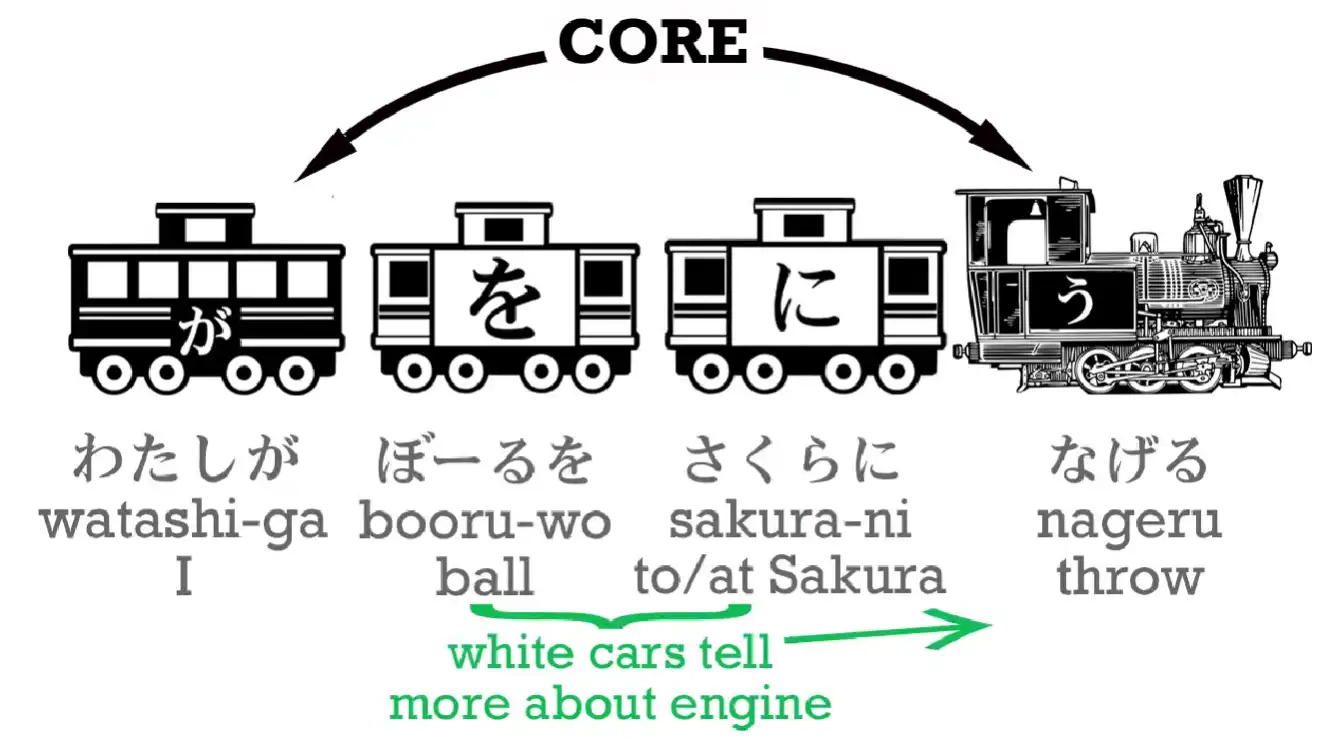
And it’s very important to note here that it is the logical particles – が, を and に – that tell us what is happening.
The order of the words doesn’t really matter the way it does in English.
What matters is the logical particle.
So if I say, “わたしにさくらがボールをなげる”, I’m saying, “Sakura throws the ball at me”.
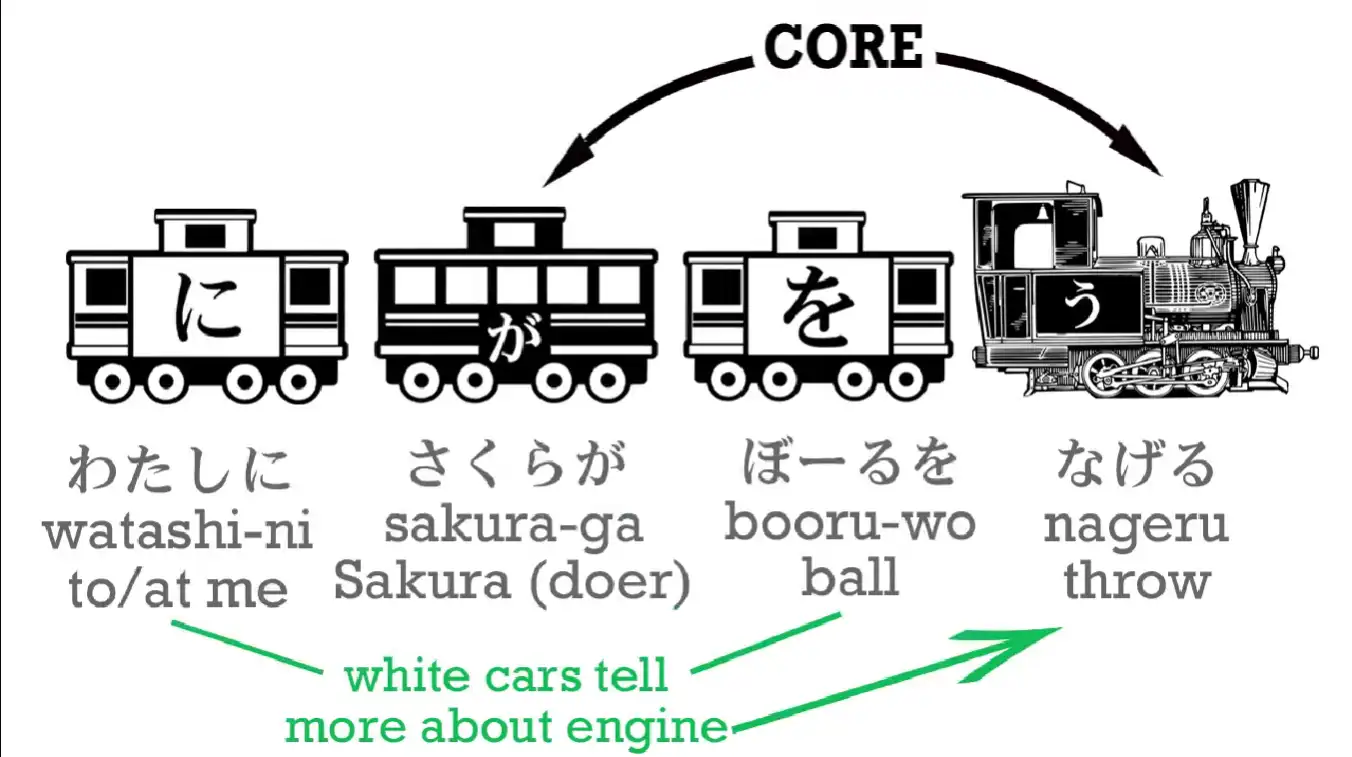
If I say, “ボールがわたしにさくらをなげる”, I’m saying, “The ball throws Sakura at me”. It doesn’t make any sense, but we might want to say it in a fantasy novel or something.
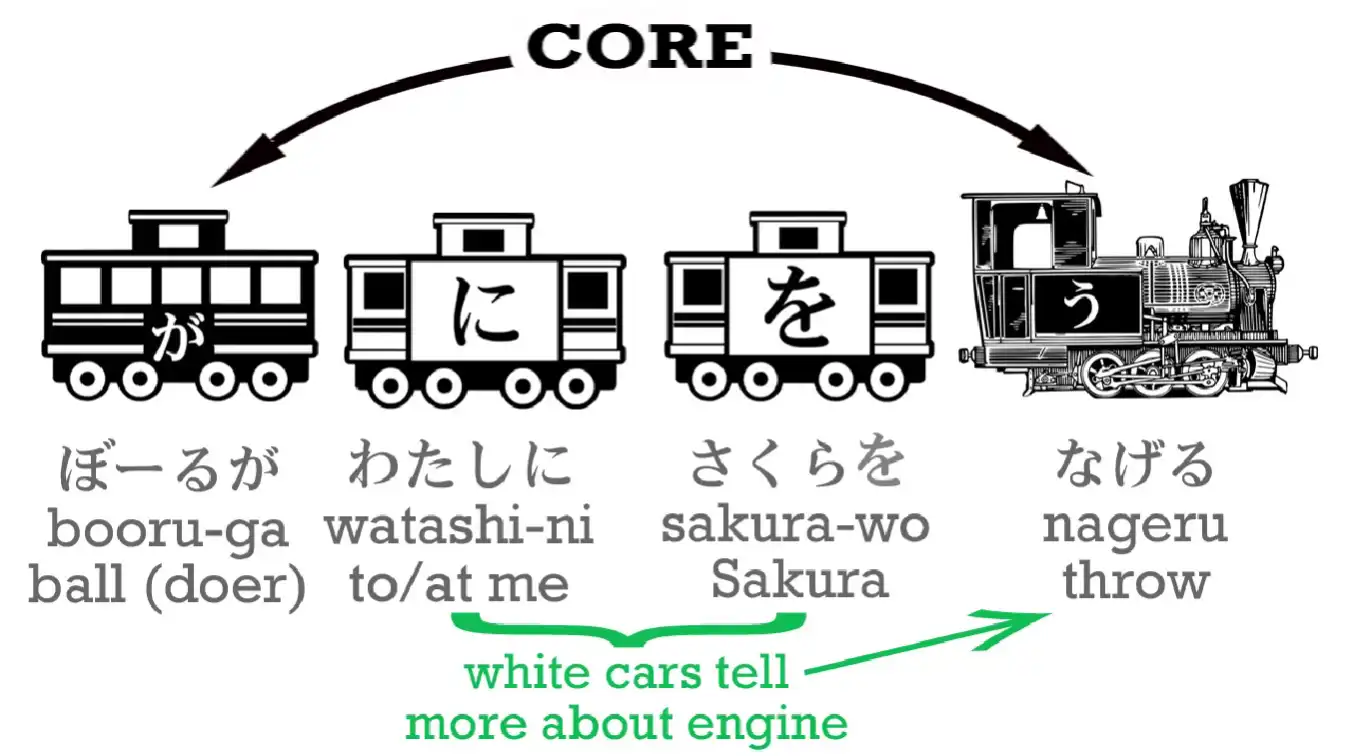
We can say whatever we like in Japanese so long as we have the logic of the particles correct. But now let’s introduce は into this sentence: “わたしはさくらにボールをなげる.” This is “わたしは(zeroが)さくらにボールをなげる”.
As we know, what it means is “As for me, I throw the ball at Sakura”.
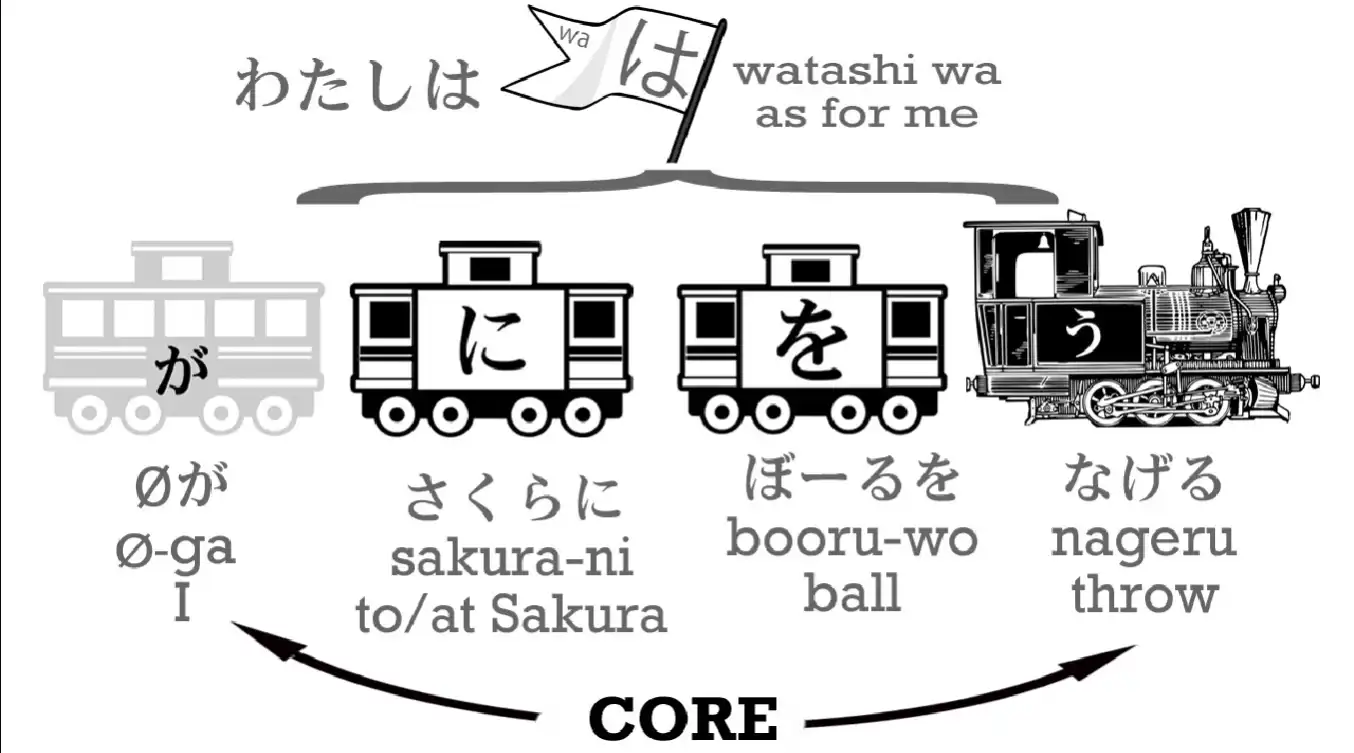
Now let’s give the は to the ball: “ボールは私がさくらに(zeroを)なげる” What we are saying now is “As for the ball, I throw it at Sakura”.
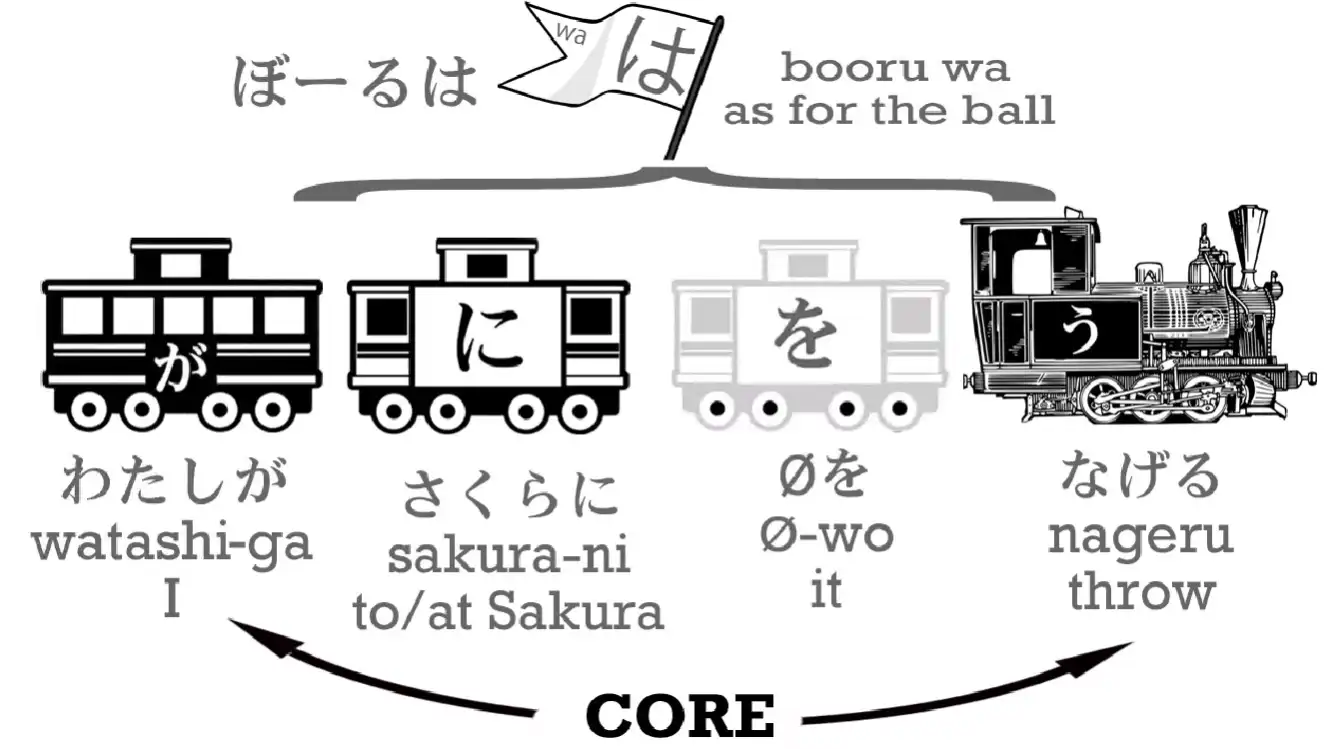
The important thing to notice here is that when we change a logical particle from one noun to another we change what’s actually happening in the sentence, but when we change the non-logical particle は from one noun to another – I can change it from me to the ball – it makes no difference to the logic of the sentence.
It makes a difference to the emphasis: I’m now talking about the ball, “as for the ball…”
What happens to the ball is that I throw it at Sakura, but who is doing what, and what they are doing it with and what they are doing it to, none of that changes when you change the は particle and that’s the difference between a logical and a non-logical particle.
4. Japanese Verb Tenses
Lesson 4: Japanese past, present, and future tense. How Japanese verb tenses really work
こんにちは。 Today we’re going to talk about tenses.
Up to now, we’ve only been using one tense, and that is the one represented by the plain dictionary form of verbs: 食べる/たべる - eat; 歩く/あるく - walk, and so forth.
To use natural-sounding Japanese, we need three tenses.
You might think they would be past, present and future, but in fact they’re not.
The non-past tense
The one we’ve been using up to now is not a present tense.
It’s called the non-past tense, and a lot of people think this is confusing.
Why can’t Japanese have a simple present tense like English instead of something vague and mysterious like a non-past tense?
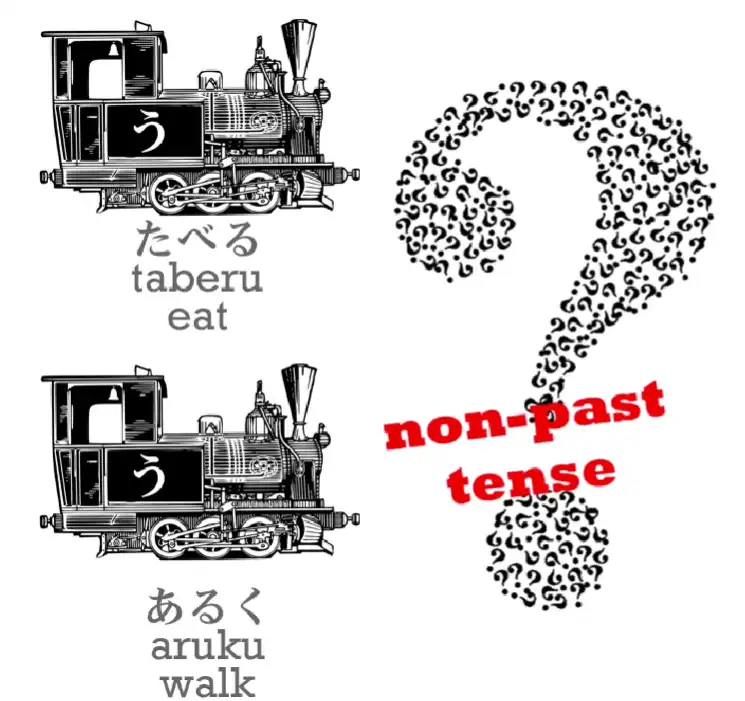
Well, actually it isn’t confusing at all, and what makes it confusing is, for a change, not the fact that Japanese is taught in a strange way, but the fact that English is taught in a strange way.
The truth is that the Japanese non-past tense is very similar to the English non-past tense.
What is the English non-past tense?
Well, it is the plain dictionary form of English words: eat, walk, etc.
Why do I call it a non-past tense?
Well, let’s take an example.
Suppose you get a message on your 携帯/けいたい (phone) saying, “I walked to the cafe and now I eat cake and drink coffee”.
What would you know about the person who sent that message?
Well, you’d know that it was not a native English speaker, wouldn’t you?
Because no native English speaker says “I eat cake and I drink coffee” when they mean “I am eating cake and drinking coffee right now”.
When do we say “I eat cake”?
Well, we might say it when we mean that we eat cake sometimes: “I eat cake.
I’m not one of these people who doesn’t eat cake. I do eat cake.
Whenever there’s any cake around, I eat it.
But that doesn’t mean I’m eating cake right at this moment.” When else do we use the English non-past plain form of verbs?
Well, sometimes we use them for future events: “Next week I fly to Tokyo.” “Next month I have an exam.” And sometimes we use them for something that’s going on right now, but not mostly.
For example, in a literary description: “The sun sinks over the sea and a small happy robot runs across the beach.” But that isn’t the way we use it most of the time in everyday speech, is it?
So, the Japanese non-past tense is very similar in the way it functions to the English non-past tense.
If you understand one you can pretty much understand the other.
Most of the time, the Japanese non-past tense refers to future events.
“いぬがたべる” - “The dog will-eat”; “さくらがあるく” - “Sakura will-walk.”
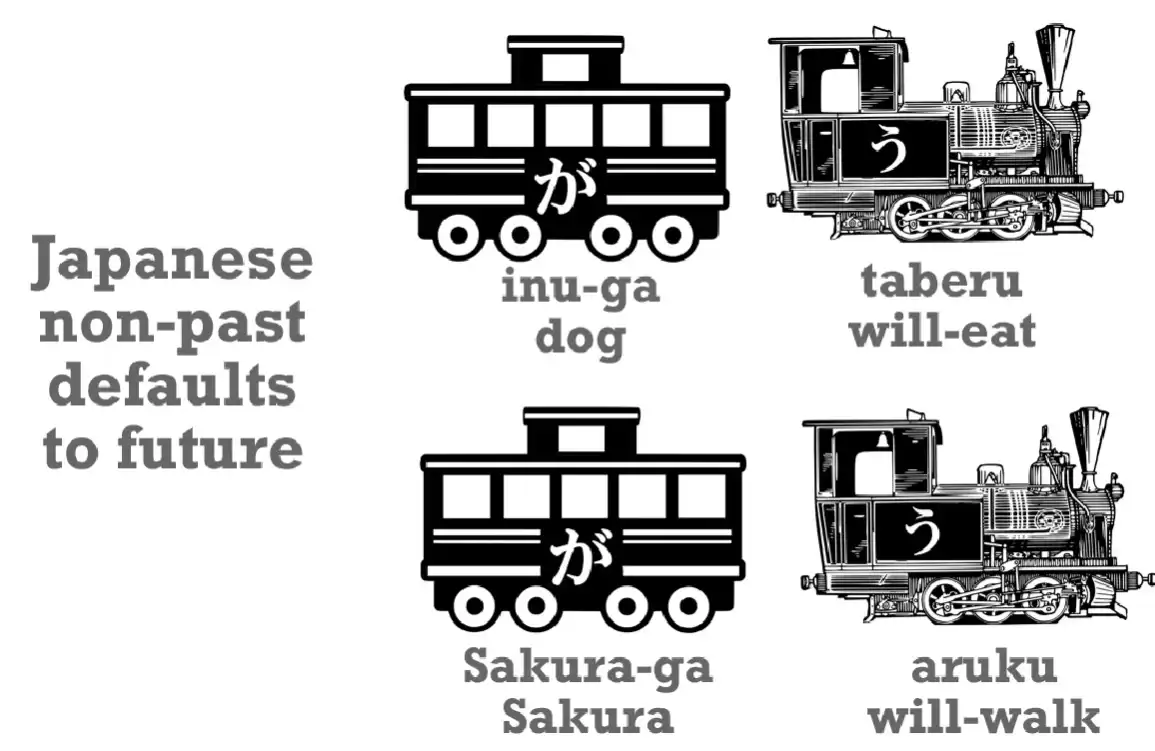
The way we’ve been using it up to now - “Sakura walks” - is possible, but it isn’t the most natural way.
We’ve been using it that way because it was the only tense we knew.
Continuous actions and ている
If we want to say something more natural, like “Sakura is walking”, what do we do?
Well, what do we do in English?
In English we say, don’t we, “Sakura IS walking”.
We use the word “to be”.
You can “BE walking”.
“Sakura IS walking”; “We ARE walking.” Fortunately, in Japanese we don’t have all these different forms of the word “to be”.
We use the same word every time, and the word is “いる”.
“いる” means “be” in relation to animals and people, and to make this continuous present tense, we always use “いる”.
So, “Sakura is walking” – “さくらがあるいている”.
“Dog is eating” – “いぬがたべている”
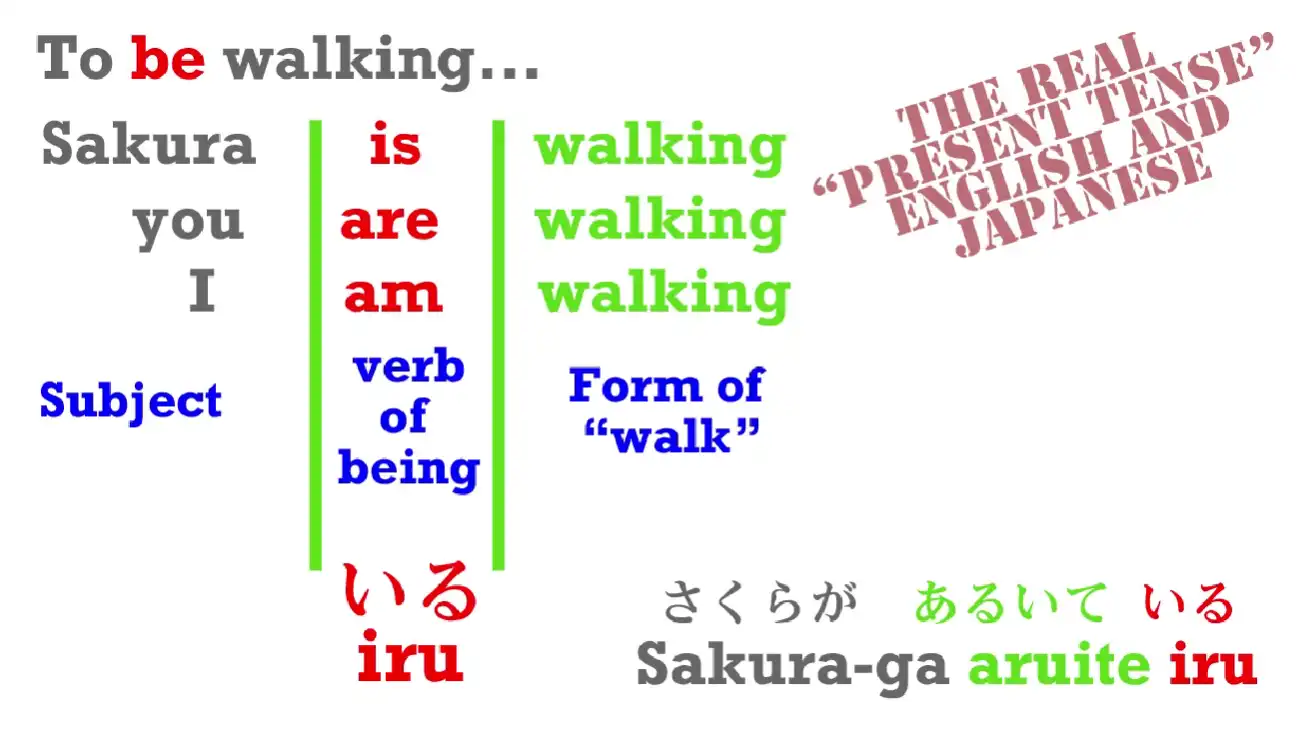
Now, let’s notice that in a sentence like “いぬがたべている,” we have something we haven’t yet seen, and that’s a white engine.
A white engine is an element that could be an engine but in this case it’s NOT the engine of this sentence.
It’s modifying, or telling us more about, one of the core elements of the sentence.
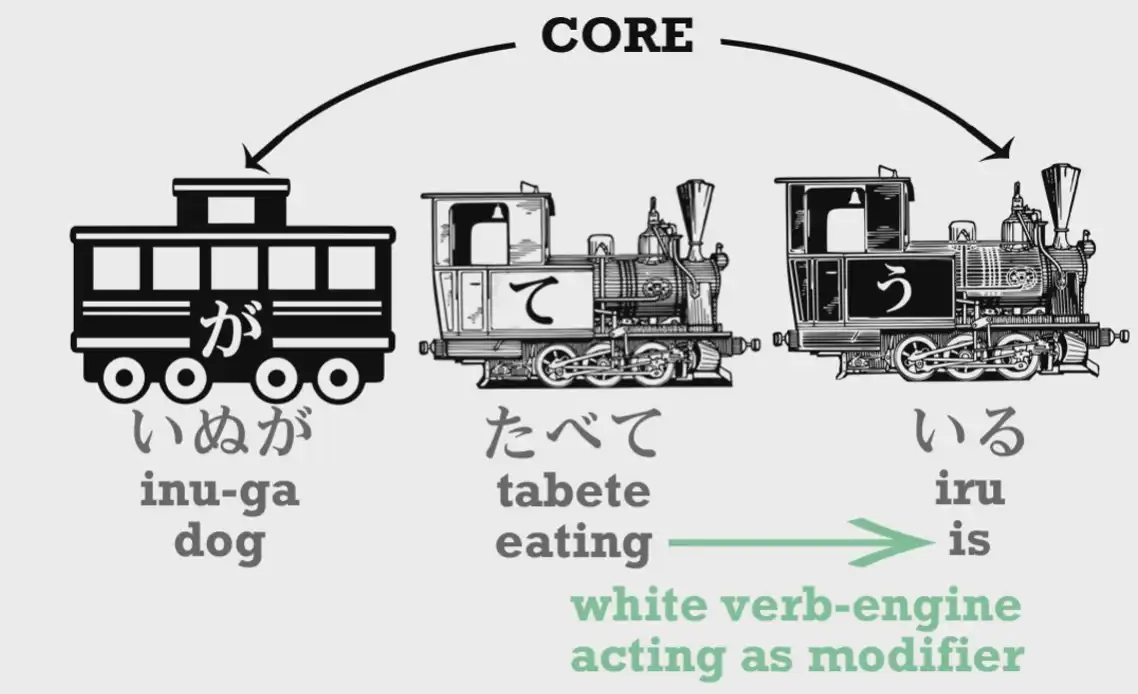
So, the core of this sentence is “いぬがいる” - “the dog is”.
But the dog isn’t just existing – the dog is doing something.
And that white engine tells us what it is doing.
It is “eating”.
And we’re going to see this white engine structure over and over again as we go deeper into Japanese.
And just as in English we don’t say “the dog is eat”, we use a special form of the verb that goes along with the verb of being.
So in English we say “is walking”, “is eating”.
In Japanese we say “食べている/たべている”, “歩いている/あるいている”.
Now, how do we form this “て-form”, which is the form we use for making the continuous present?
With a word like “食べる/たべる”, it’s very easy indeed.
All we have to do is take off the “る” and put “て” in its place.
たべる becomes たべて.
The bad news is that with other verbs, we do have slightly different ways of attaching the
“て”. Apart from the plain る-form, there are four other ways.
The textbooks will say five, but in fact two of them are so similar that we can treat them as four.
And I’ve made a video on exactly what these ways are (Lesson 5, so the next lesson). And it makes it much simpler than most explanations.
So it’s very important to watch that so that you can learn how to form the continuous present tense.
The good news: it’s perfectly regular.
Once you know the ending of a verb you also know how to put the “て” onto it.
The only one that’s a bit tricky is る-ending verbs, but the video will explain that.
Past tense
So, how do we put things into the past tense?
Fortunately that’s very easy indeed.
All we do is add “た” – that’s the whole thing.
So, “いぬがたべる” – “dog will-eat” / “いぬがたべた” – “dog ate”.
Now, there are different ways of attaching “た” to different kinds of verb, verbs with different endings, but the good news here is that they are exactly the same as the ways that you attach “て”.
So once you’ve learned the ways that “て” attaches, you’ve also learned the ways that “た” attaches.
So if you watch that て-form video (Lesson 5), you’ll be able to do both the continuous present and the past.
Now, there’s one more thing about time expressions that is useful to learn now.
If we want to make it clear, when we say “私はケーキを食べる”, that we’re talking about a future event, we can say “明日/あした” (which means “tomorrow”) “あしたケーキを食べる”.
That’s all we have to do.
Time expressions
We just say “tomorrow” before we say the rest of the sentence, just as we do in English.
“Tomorrow I’m going to eat cake” – “あした(zeroが)ケーキを食べる”.
Note: Sometimes I add zeroが even when Dolly does not say it in the transcript, BUT she shows it in the videos, I obviously only add it then if it is shown by her, I do not do it on my own…
Now, “tomorrow” is what we call a “relative time expression” because it’s relative to today.
Today is yesterday’s tomorrow.
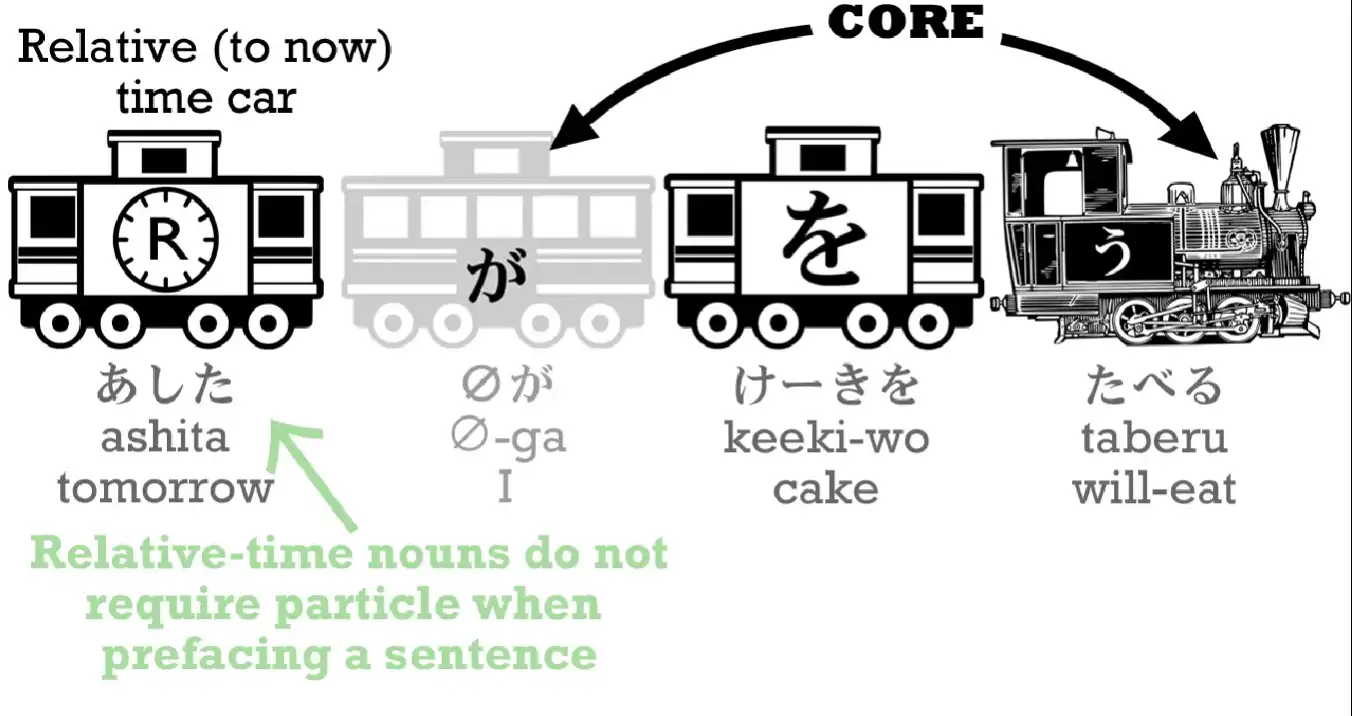
And with all relative time expressions like that: yesterday, last week, next year, and so forth, times that are relative to the present time, we just do what we did then.
We put the time expression at the beginning of the sentence and that puts that whole sentence into that time.
However, when we have an “absolute time expression”, an expression that is not relative to the present, such as Tuesday or six o’clock, then we have to use “に”.
Tuesday is “火曜日/かようび” and we may may say
“かようびに(zeroが)ケーキをたべる” – “On Tuesday (I) will eat cake.”
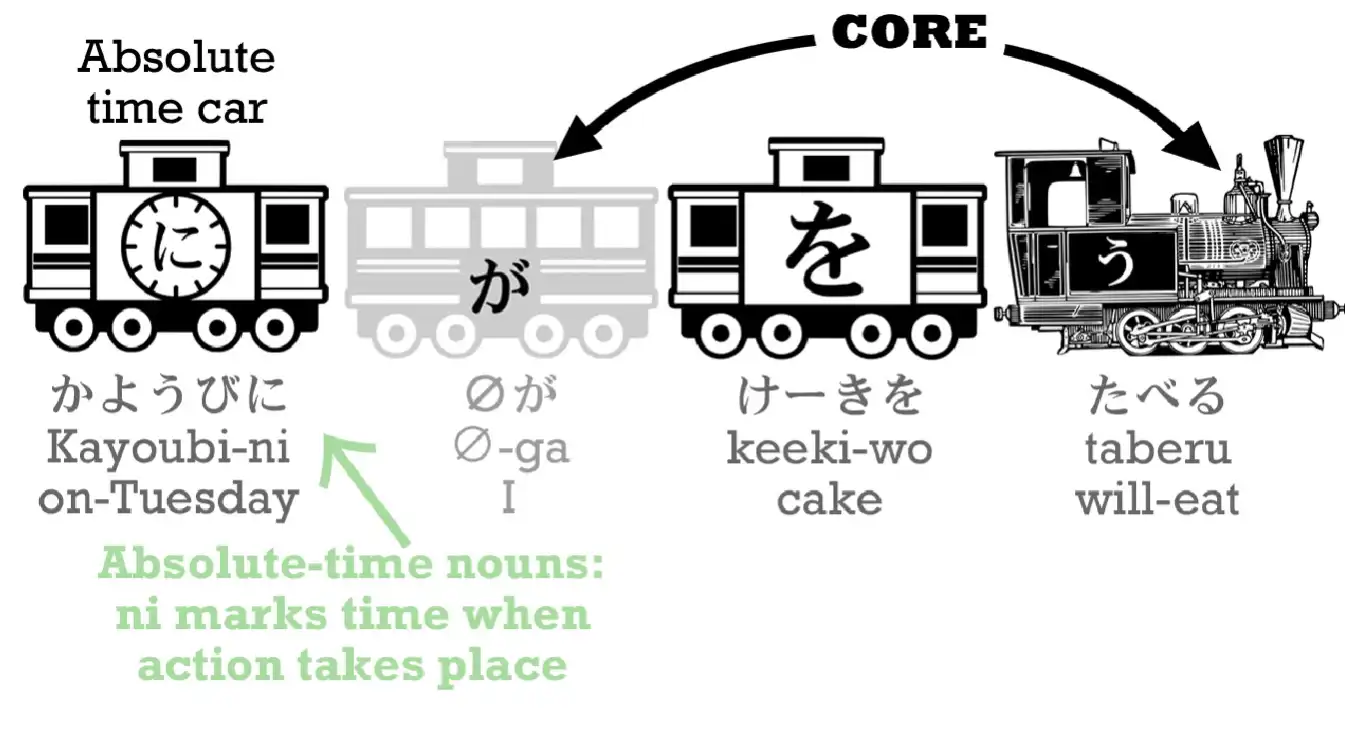
The important thing here is that it can seem a bit complicated to have to work out, “Is the time absolute or relative?” And the good thing to know here is that it’s not complicated at all, because it works exactly the same as English.
In English, we say, “Tomorrow I eat cake”, “Next week, I have an exam”, and so forth, but when we use an absolute time expression we say, “On Monday I will eat cake”, “At six o’clock I have an exam”; if we’re talking about a month we say, “In July I’m going to Tokyo”.
Now, Japanese works in exactly the same way except that we don’t have to remember when we’re using “on”, when we’re using “at’ and when we’re using “in”.
In Japanese we use “に” every time.
But in English when we need one of those little words, “on”, “in” or “at”,
then we need “に” in Japanese.
And when we don’t, then we don’t need “に” in Japanese.
English and Japanese are identical in that respect.
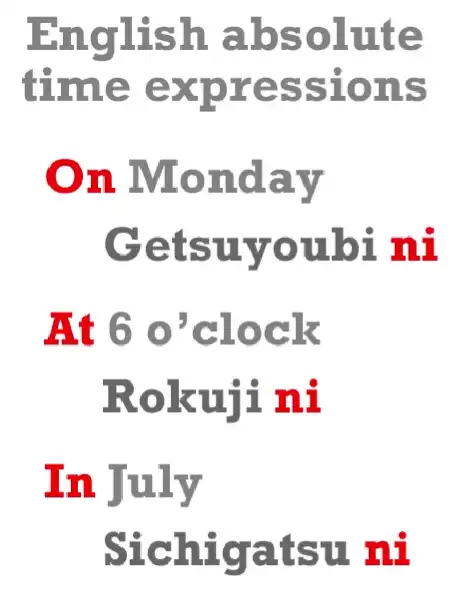
So rather than sitting down to work out “Is this relative, or is this absolute?”, just think whether you need an “on”, “in” or “at” in English, and if you do, you need “に” in Japanese.
And if you don’t, you don’t need “に” in Japanese.
It’s really as simple as that.
5. Verb Groups and the て-form
Lesson 5: Japanese verb groups and the te-form. Verb groups 1, 2, 3 made easy. Organic Japanese
こんにちは。 Today we’re going to talk about Japanese verb groups.
Japanese verbs fall into three groups, and these don’t matter except when we’re going to make some change in the form of the verb.
But because we do that pretty often, it’s important to understand the three groups.
Ichidan verbs
The first group of Japanese verbs is called ichidan verbs or “one-level” verbs.
Some people call them “る-verbs”, which is a very silly name.
If you’re going to call them anything like that, we should probably call them “いる/える verbs”.
They are the simplest and most basic kind of verb.
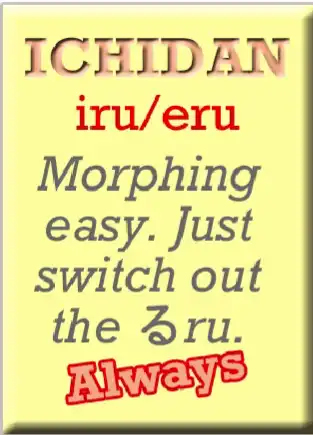
When we want to make any change, we always do it the same way.
All we do is take the -る off the end and put on whatever we want to put on.
Ichidan verbs can only end with either -いる or -える, that’s to say,
with one of the kana from the い-row or one of the kana from the え-row plus -る.
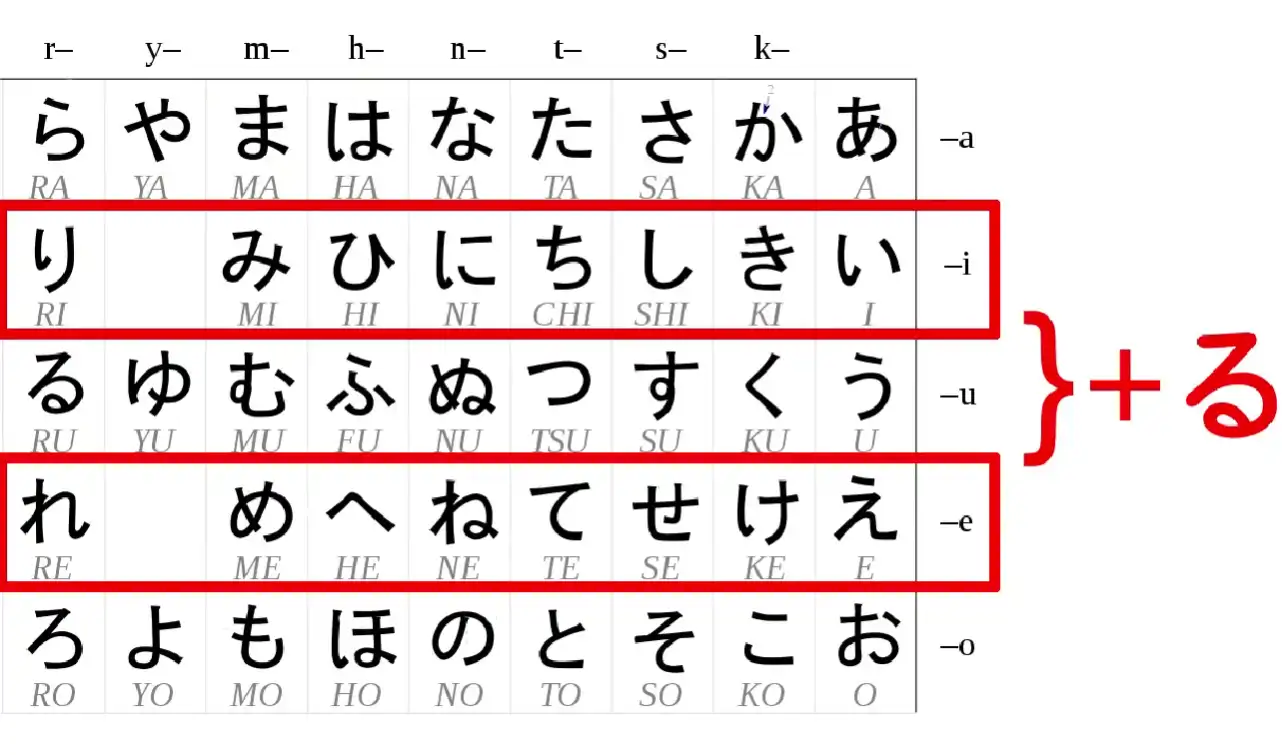
Godan verbs
The second group of verbs is by far the largest and any ending that a verb can have, verbs in this group can have.
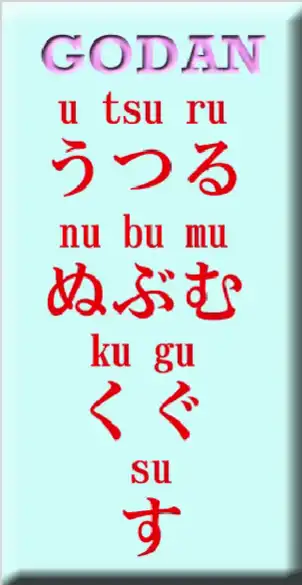
Verbs always end with the う-sound, but not all う-kana can make the end of a verb, but a lot of them can and all of them can make godan verbs.
They are called godan verbs, or “five-level” verbs, for reasons that we’ll see shortly, and as I say they can end in any う-sound, including -いる or -える.
Unlike ichidan verbs, they can also end in -おる, -ある or -うる.
So the only time we have any ambiguity is when we have a verb ending in -いる or -える.
Most of those verbs are ichidan verbs, but there is a substantial minority of いる/える-ending godan verbs.
It’s not as difficult to differentiate them as you might think, and I’ve made a video on that, although it’s a little bit more advanced than this lesson.
Irregular verbs
The third group of verbs is irregular verbs, and the good news here is that there are only two of them.
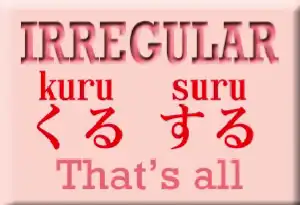
You know those pages and pages of irregular verbs in your Spanish or French textbook?
Well, Japanese has just two.
There are a couple of other verbs that are irregular in just one small respect, but very few.
The irregular verbs are くる (come) and する (do).
The -て Form
So now that we know the three groups, we’re going to take a look at how you make them into the -て and -た form.
As I explained last week (Lesson 4), we need those two forms for making the Japanese present and past tenses.
And they have a number of other uses too, which we’ll learn as we go along with this course.
And as I demonstrated last week, ichidan verbs are always very easy.
You never do anything except take off the -る and put on whatever you’re going to put on, in this case a て or a た.
As for the godan verbs, they fall into five groups, as you would expect (五段/ごだん, five-level verbs), and I made a video about this a while ago.
So what I’m going to do is run that video right now, because it explains things pretty clearly.
All right, roll the video.
Godan verbs have five kinds of possible ending – that’s why they’re called godan verbs: five-level verbs.
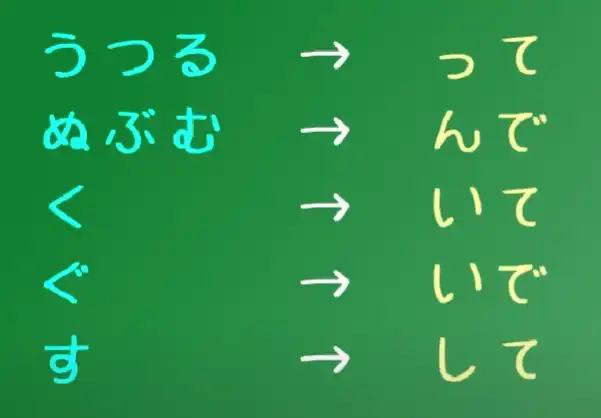
And although that seems a little bit difficult, it really isn’t.
We can combine two of the levels anyway, because they are so close that we only need to learn them once.
And I’m going to go through the main groups.
#
The First Godan Group
The first group is what I call the UTSURU/うつる verbs.
Those are the verbs ending in -う, -つ and -る.
The word うつる in Japanese – if you don’t know it, now is a good time to learn it – うつる means to move from one thing to another, and that’s exactly what we’re doing here – moving our verbs from one type to another.
So the verbs which end in -う, -つ and -る all transform in the same way to the て-form.
We take off the -う, the -つ or the -る, and we replace it with a small -っplus て (or た in the た-form).
So わらう - laugh, becomes わらって (Waratte);
もつ - hold, becomes もって (Motte);
and とる - take, becomes とって (Totte).
Now, you’ll notice that うつる has つ in the middle.
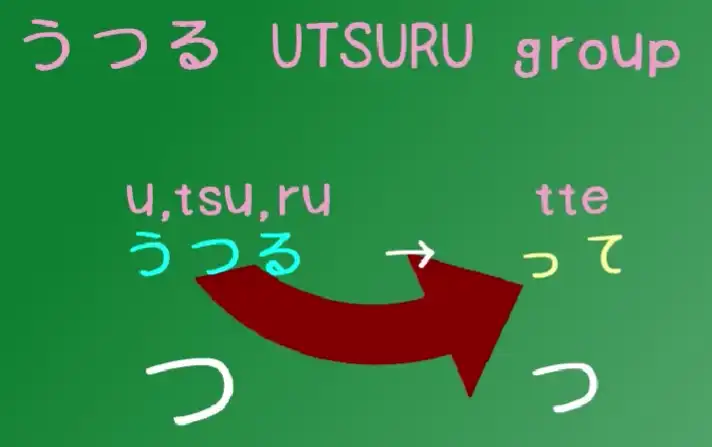
And the て-form of the うつる verbs is formed by using a small っ plus that て.
It’s the only group that has つ in it, and it’s the only group that has a つ in the て-form ending.
Tip: you can type the small っ by typing t before a T-kana った (tta), or by X key + tsu. This also applies to “あ, い, う, え, お” kana - ぁ (X + a), ぃ (X + i)… Note also づ (typed - Du) and ぢ (Di) - irregular ず and じ kana forms. In case you ever need to type them, can happen. And ん is “nn”.
So it’s really easy to remember.
#
The Second Godan Group
The second group is what I call the NEW BOOM group.
In Japanese when something is really taking off, when it’s becoming popular, we call it a ブーム (BUUMU).
That’s an English word, isn’t it?
Buumu, a New Buumu! So, this group I call the New Boom group because there isn’t a Japanese word that you can make out of ぬ, ぶ and む that I know of, and what I want you to notice about this group of verbs is that they all end in what I would call a dull sound – ぬ, ぶ, む.
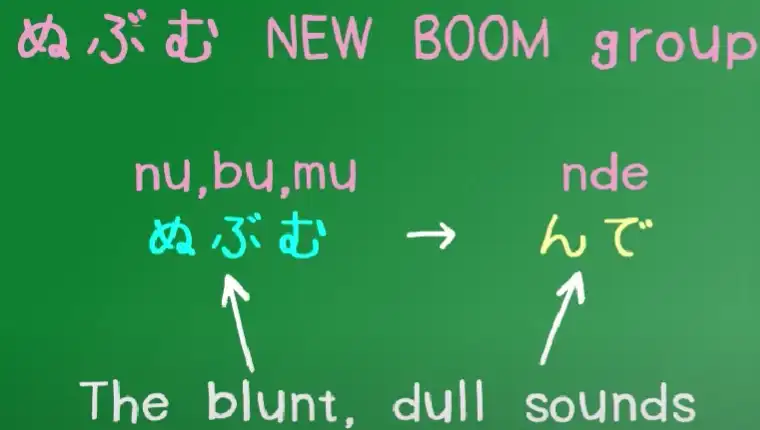
It’s not a sharp sound like す, つ, く, and it’s not a neutral sound like る or う.
It’s a dull sound – ぬ, ぶ, む (Nu, Bu, Mu).
And this is important because the ending is also a dull sound.
The て-form ending is -んで, the た-form is -んだ.
So しぬ, the only -ぬ ending verb, becomes しんで / しんだ;
のむ - drink, becomes のんで / のんだ; あそぶ - play, becomes あそんで / あそんだ.
So that’s the New Boom group, the dull-ending verbs.
And because only a limited number of the possible kana can be used as a verb ending, they include all the dull sounds except for ぐ (Gu).
We’ll come to that right now.
#
The Third & Fourth Godan Group
I told you that two of the groups could be combined - and that is the く and ぐ group.
To make the て form of a -く ending verb, we cut off the -く and add -いて, or -いた in the た form.
So あるく - walk, becomes あるいて / あるいた.
Now, if we have a〃(ten-ten) on that -く, to make it into a -ぐ,
it’s exactly the same, except that there is also a ten-ten on the て-ending.
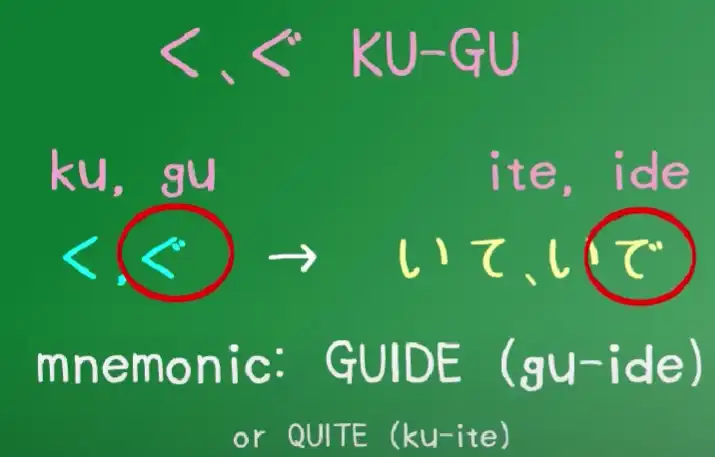
So あるく becomes あるいて, but およぐ - to swim, becomes およいで.
But, as you see, the two are more or less identical.
It’s just that if there’s a ten-ten on the original verb, there’s a ten-ten on the て-form too.
あるく, あるいて; およぐ, およいで.
#
The Fifth Godan Group
And now we just have one left, and that is す.
And verbs ending in -す drop the -す and add -して.
As you will notice, if you have followed our last lesson (Not sure which, but will be discussed),
we are just doing that regular thing of shifting the す kana to its い-row equivalent, し.
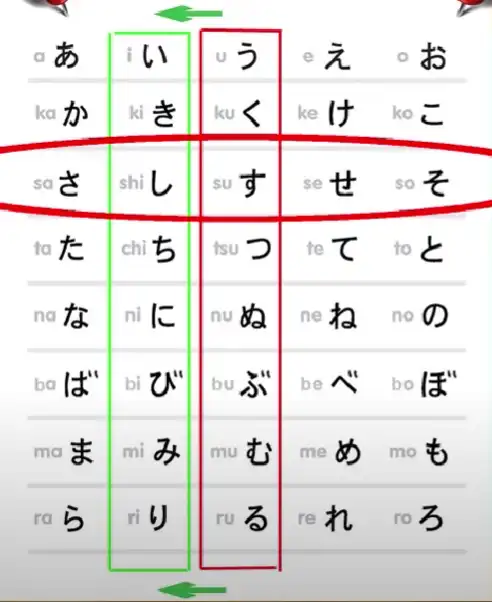
So はなす - talk, becomes はなして; the ます helper verb, which turns verbs into formal (polite) verbs, in the past tense becomes ました.
Note: Whenever Dolly uses the term “formal” for です or ます, it should be POLITE instead, there is a difference between the two terms in Japanese, not sure why she did not bring this one up, but it is quite important to distinguish, if you look into their definitions, dictionaries mark them as polite. They are part of the 丁寧語 (polite language). So it is more accurate to call them polite instead. So now we have all the godan verbs. Didn’t I look young in that old video?
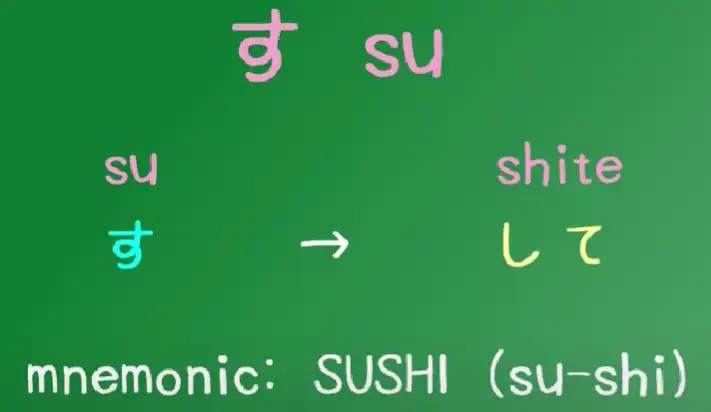
#
The Exceptions
Now, we are just going to look at the exceptions.
There are only three altogether: our two irregular verbs and one other small one.
And these are very simple. くる (come) becomes きて; する (do) becomes して.
And いく – the verb いく (to go) – because it ends in -く,
you would expect it to become いいて, but it doesn’t, it becomes いって.
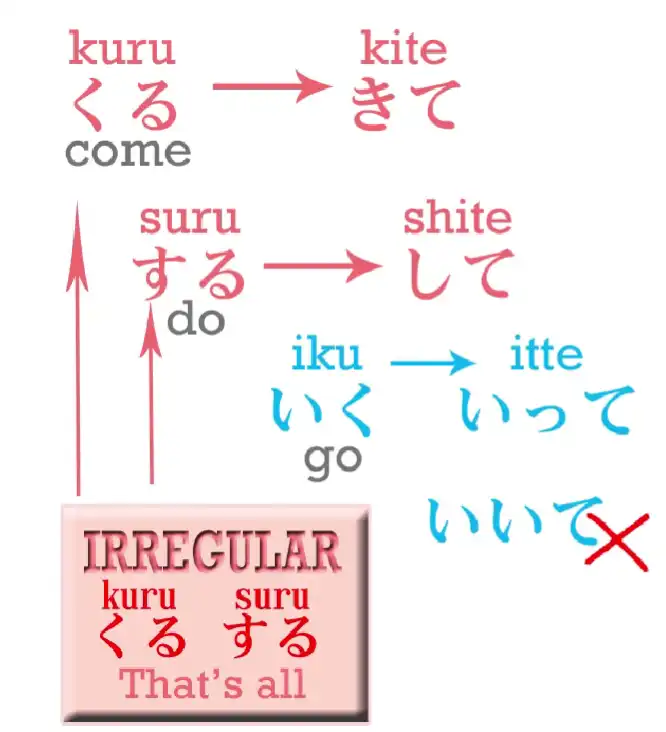
And those are the only exceptions. So if you go over the video / this lesson a couple of times,
I think you’ll find it pretty easy to know exactly how to make the -て and -た forms in all cases.
6. Adjectives
Lesson 6: Japanese “Adjectives” - the real secret that makes them easy. What schools never teach.
こんにちは。 Today we are going to talk about adjectives.
Now, Japanese adjectives are not the same thing as English adjectives.
As we know, Japanese sentences come in three fundamental kinds, depending on the kind of engine they have.
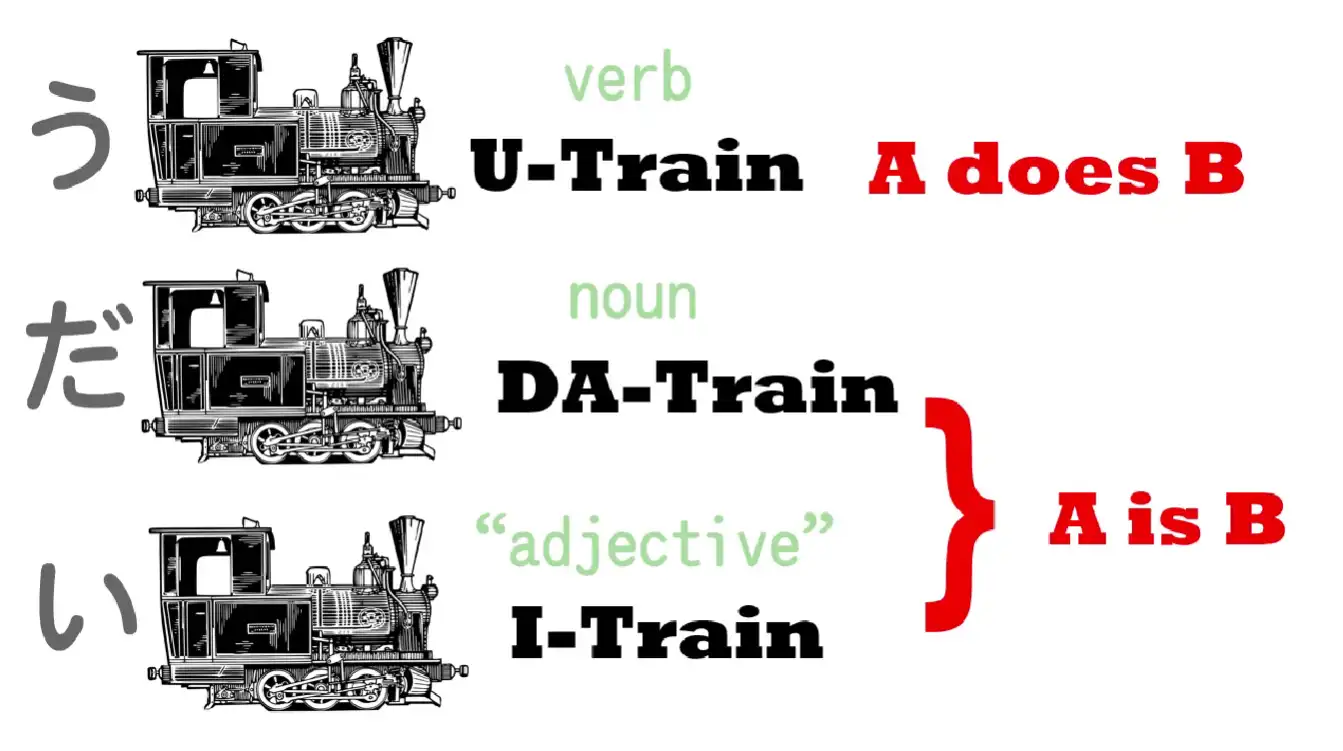
We have the う-Train, verb sentences; the だ-Train, noun sentences; and the い-Train, which is the so-called adjectival sentences.
But the truth is that any one of the three kinds of engine can be used like an adjective.

So let’s start off with the most obvious one, the one that’s called “adjective” in English.
い-train adjectives
A simple い-Train sentence is “ペンがあかい”.
As you know, “あかい” doesn’t mean “red”, it means “is-red”.
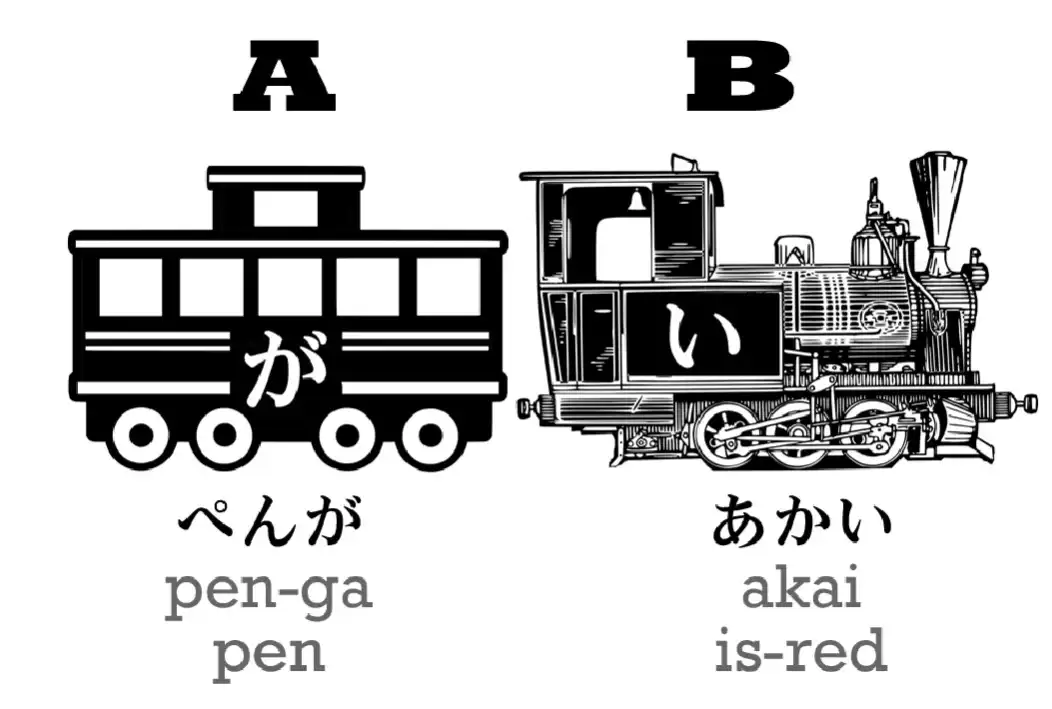
Now, we can turn this black engine white and put it behind the pen.
Now we have “あかいペンが”.
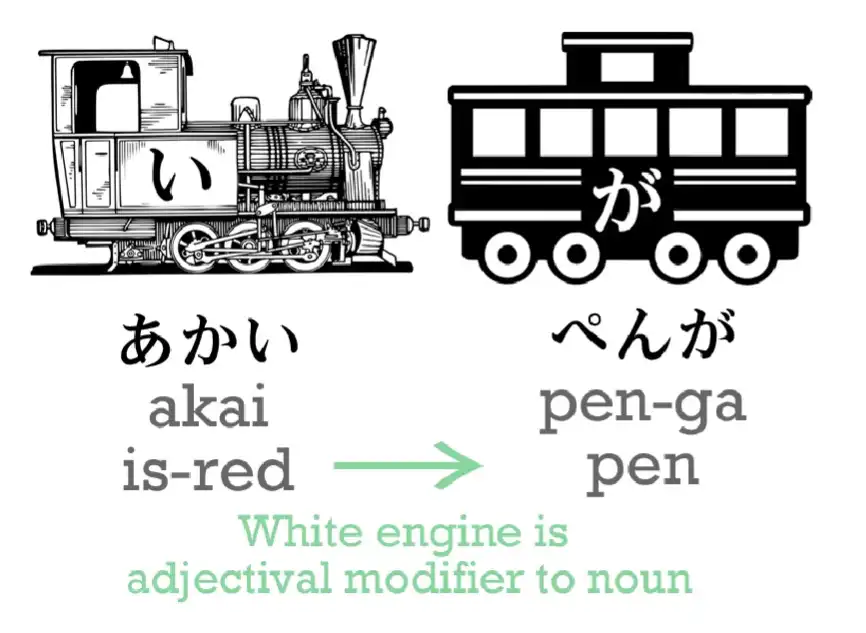
“あかいペン” means “is-red pen” or, as we say in English, “red pen”.
As you see, this isn’t a full sentence in itself any more because a white engine doesn’t pull the train, it just tells us more about whatever it is sitting behind.
So “あかい”, once it becomes a white engine, is just telling us more about the main car of the sentence, which is “ペン”.
And if we want to make it into a full sentence, we have to have a new engine.
So, let’s take “ちいさい”, which means “is-small”.
“あかいペンがちいさい” – “The red pen is small”. (or I guess “is-red pen is-small”)
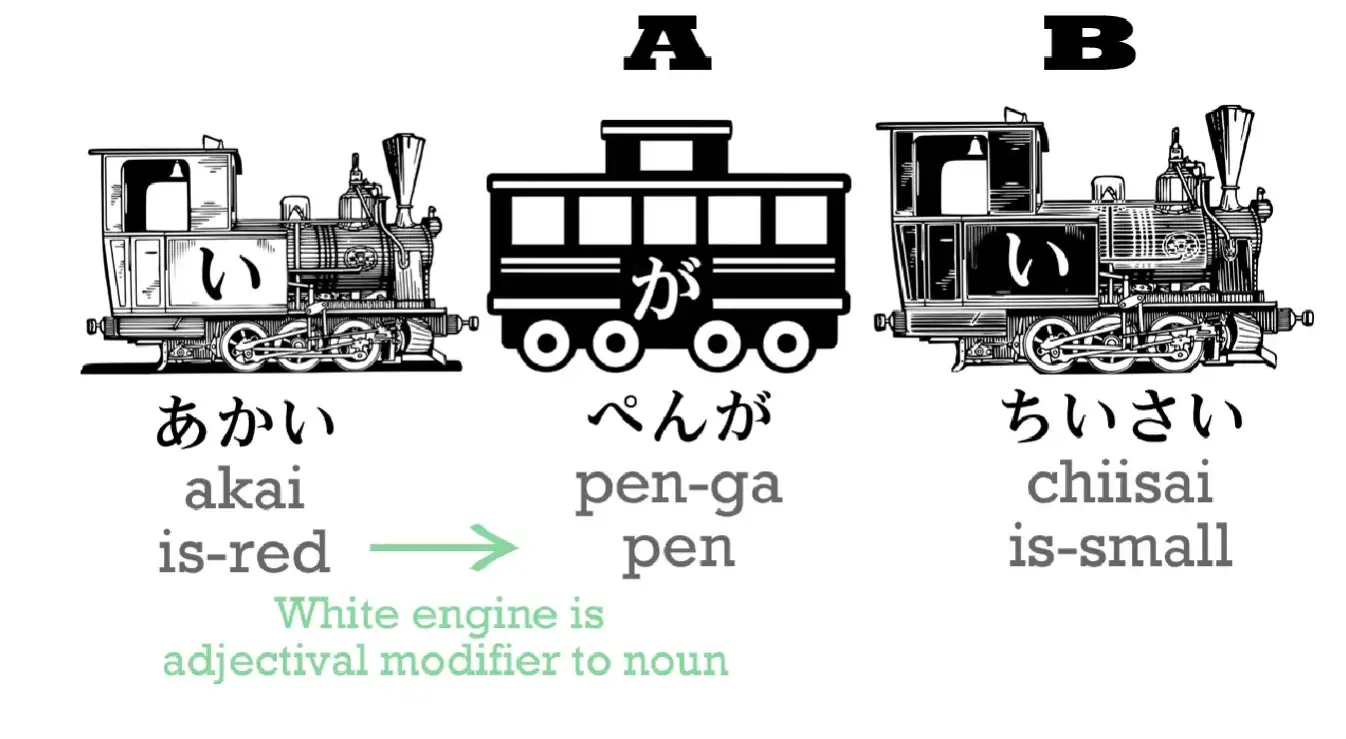
So that’s simple enough.
Using verbs like adjectives
Now let’s look at verbs.
Now, if you’re worrying about な-adjectives, as they are called, don’t worry.
They are nouns, and we’ll get to them in a minute.
Any う-Engine, any verb, in any tense, can be used like an adjective.
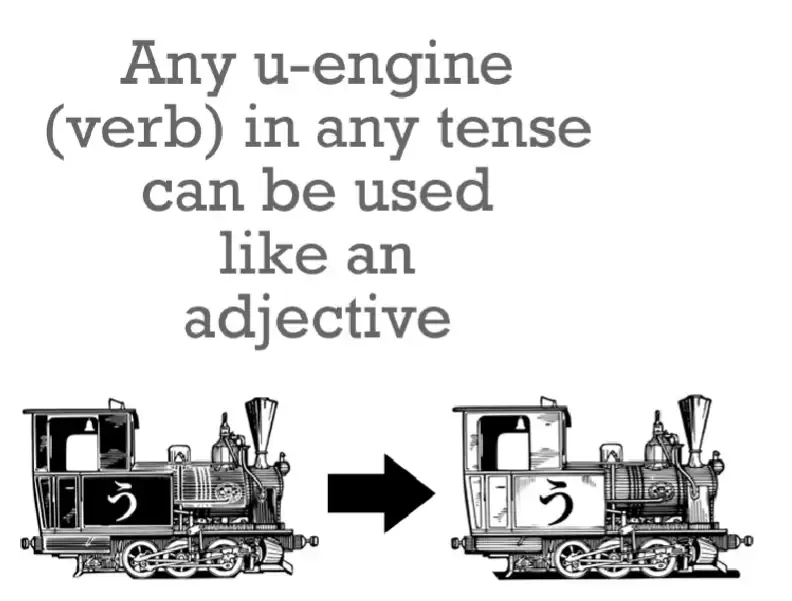
So, we can say, “しょうじょがうたった”.
“歌った/うたった” means “sang”.
The word for sing is “うたう”, so the た-form, as we know from our last lesson, is “うたった”.
“しょうじょがうたった” – “The girl sang”,
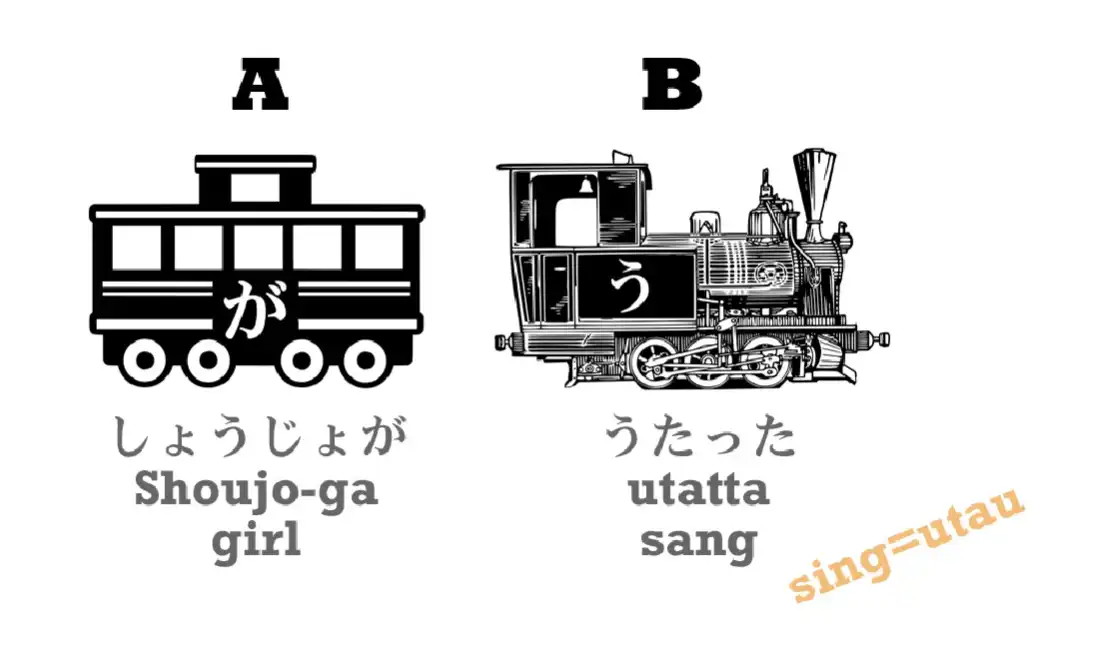
and if we turn that engine white and put it behind the girl, we have “うたったしょうじょ” – “the girl who sang”.

And of course, once again this isn’t a sentence.
But we can put in into any sentence we like, such as “うたったしょうじょがねている” – “the girl who sang is sleeping”.
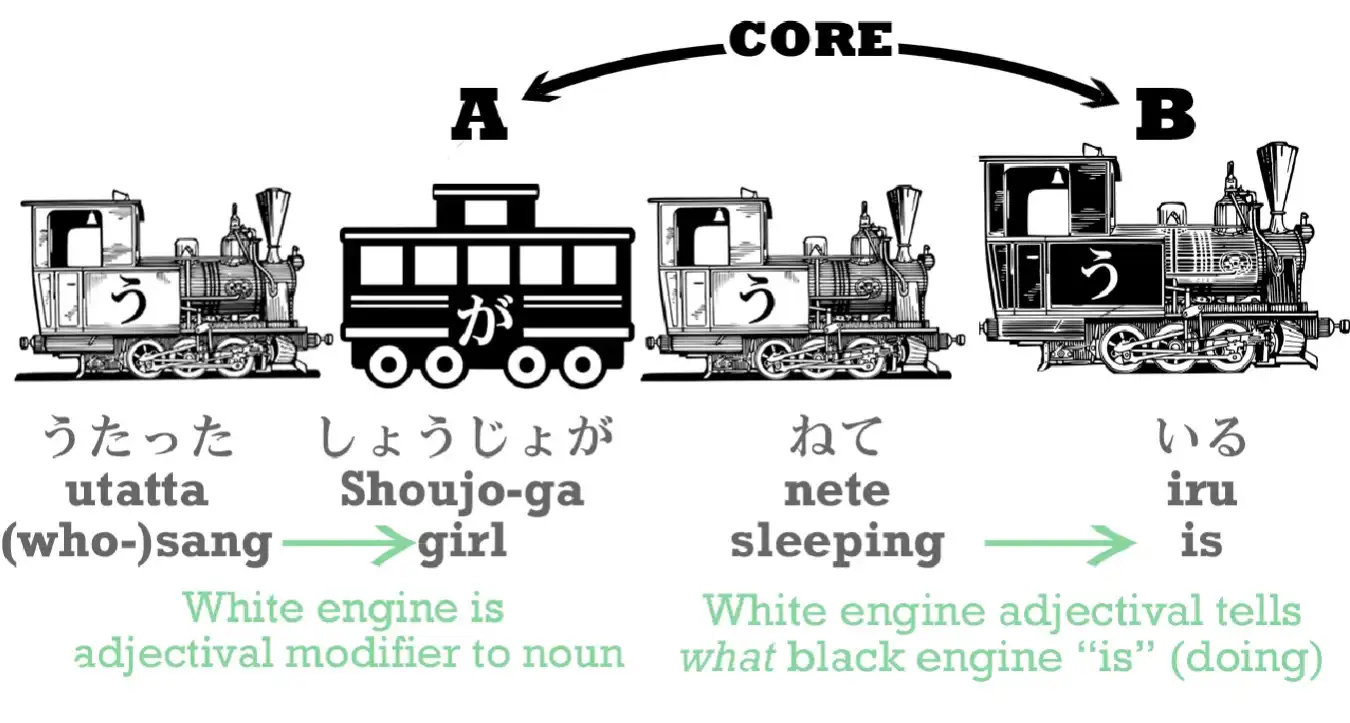
And this is terribly important because a lot of Japanese is structured this way. We can use entire verb-sentences as adjectivals if we want to, and this happens very often.
For example, “いぬがじしょをたべた” – “the dog ate the dictionary”.
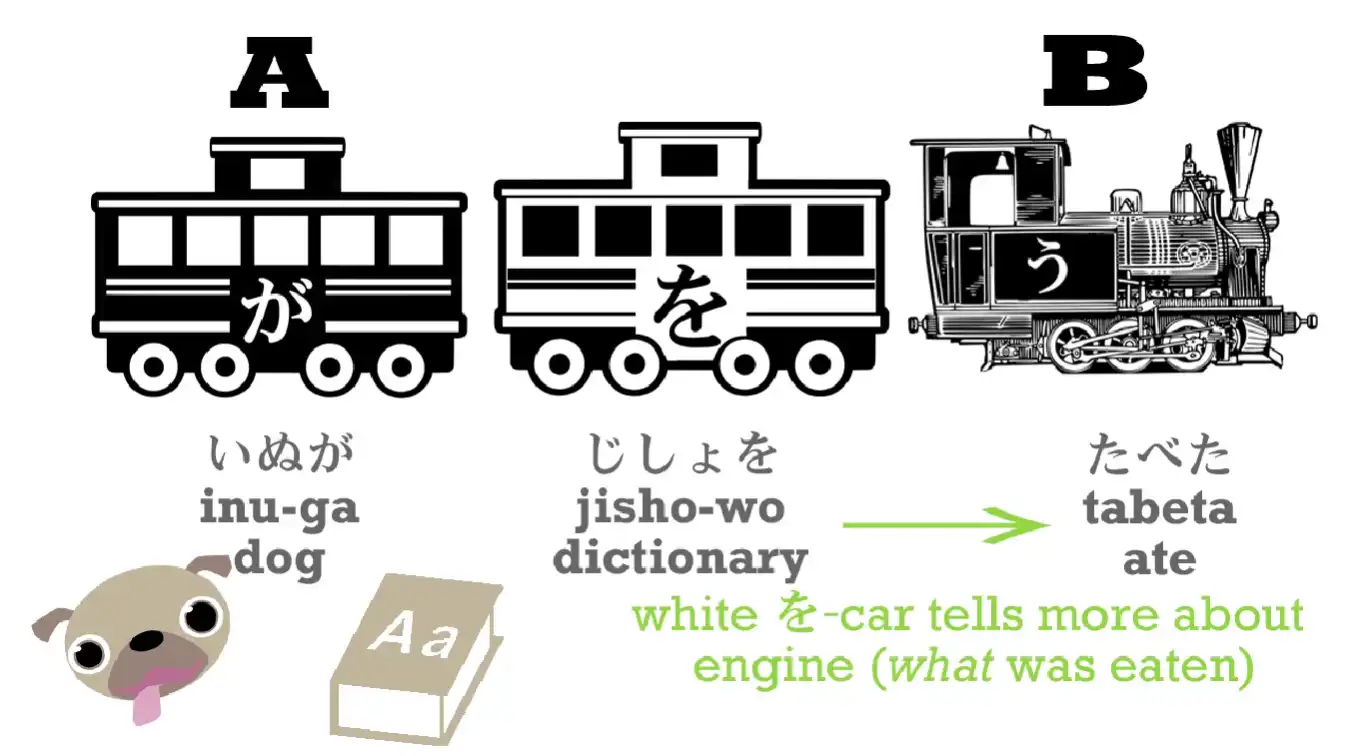
We can turn this around to “じしょをたべたいぬが” – “the dog who ate the dictionary”.
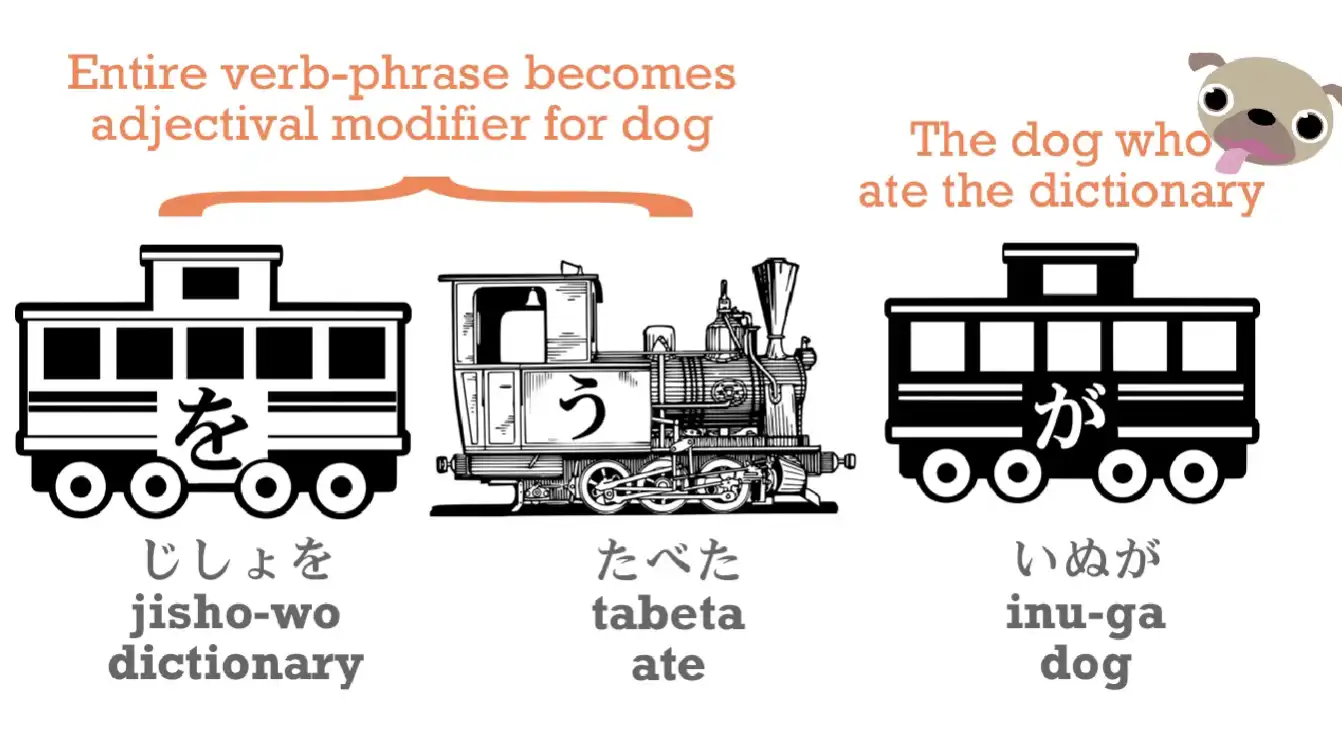
Or we can say, “いぬがたべたじしょ” – “the dictionary that was eaten by the dog”.
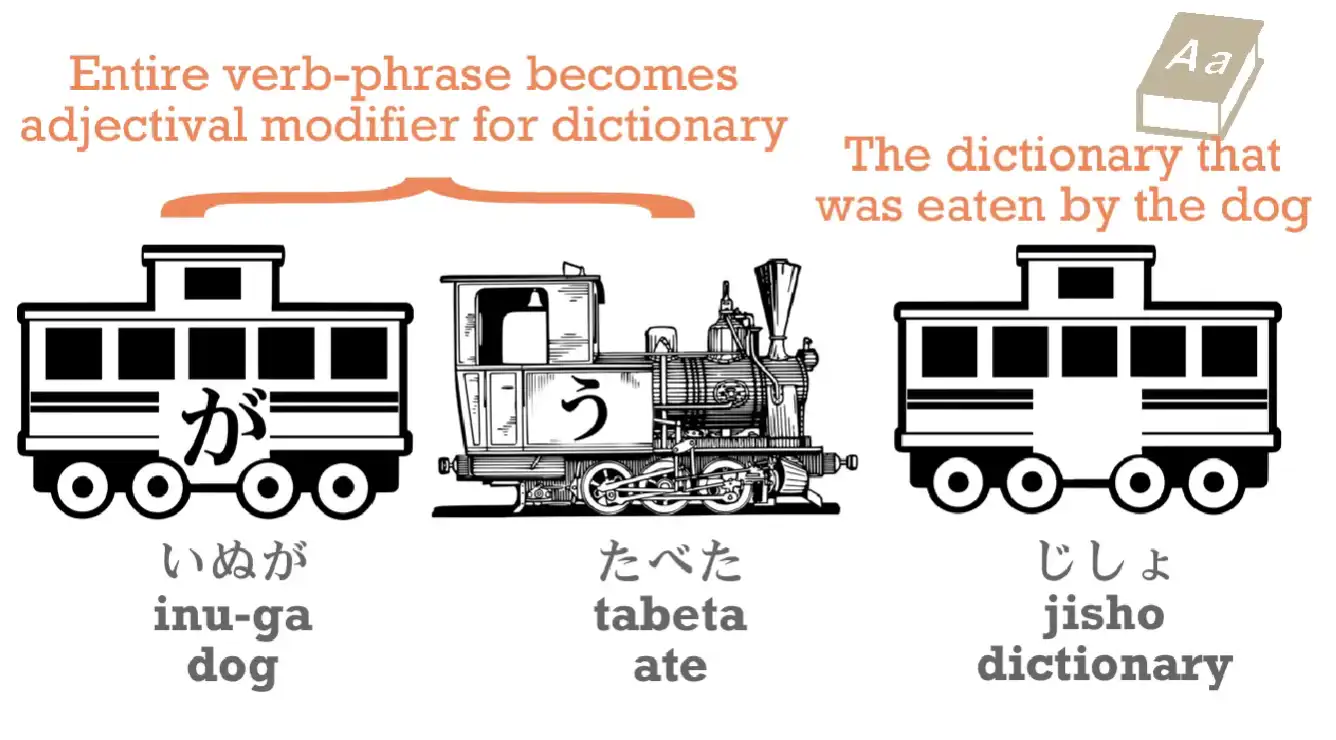
Note: In Japanese, this is not a passive sentence obviously. It is just a bit hard to translate into English as it would be in Japanese. As can be seen, the Japanese parts are much simpler. And then this can build into the full sentence, “じしょをたべたいぬがやんちゃだ”.
“やんちゃ” is a noun that means “naughty” or “bad”, so, “the dog who ate the dictionary is bad”.
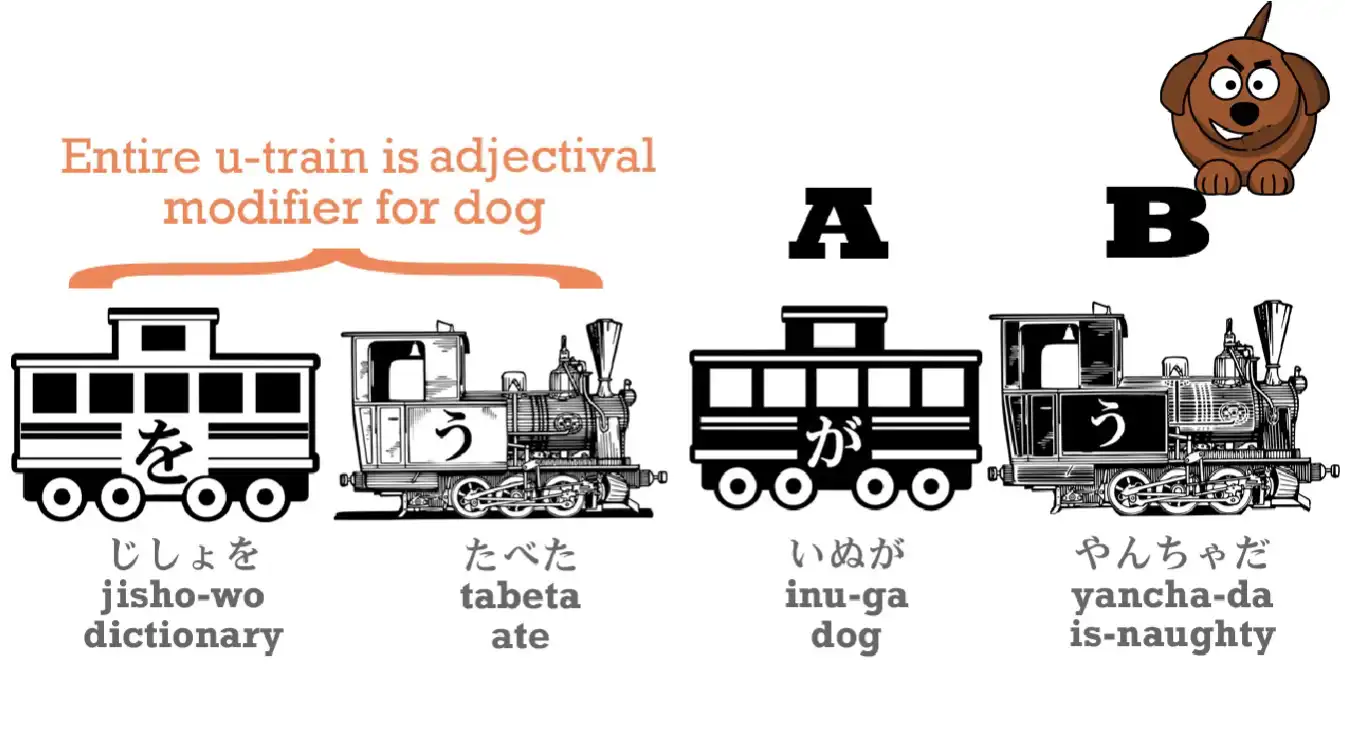
Using adjectival-nouns as adjectives
This brings us to the noun-engine.
If we just say “いぬがやんちゃだ”, we have a simple noun sentence.
But we can turn this engine as well into a white engine and put it behind the dog.
But there is one change we have to make.
When we turn “だ” or “です” into a white engine, when we connect it to anything, it changes its form from “だ” to “な”.
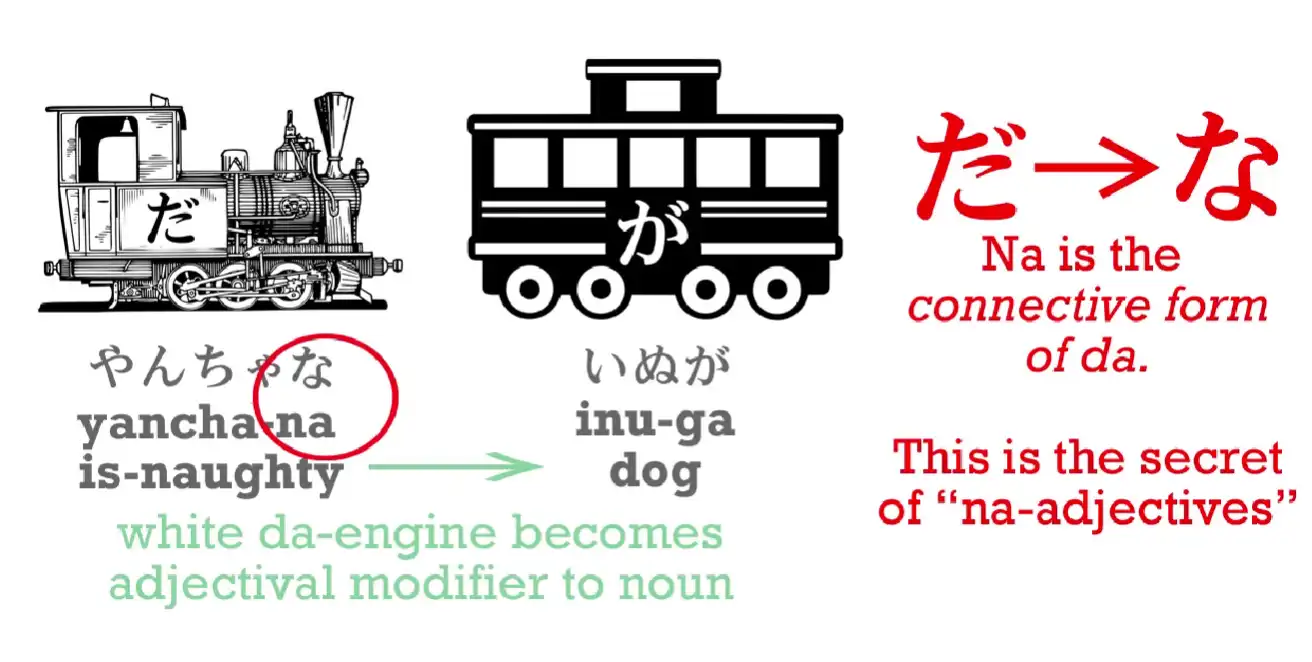
So we say “いぬがやんちゃだ”, but we say “やんちゃないぬ”,
which is the same as saying “やんちゃだいぬ” – “is-bad dog / the dog that is bad / the bad dog”.
So we can say “やんちゃないぬがねている” – “the bad dog is sleeping”.
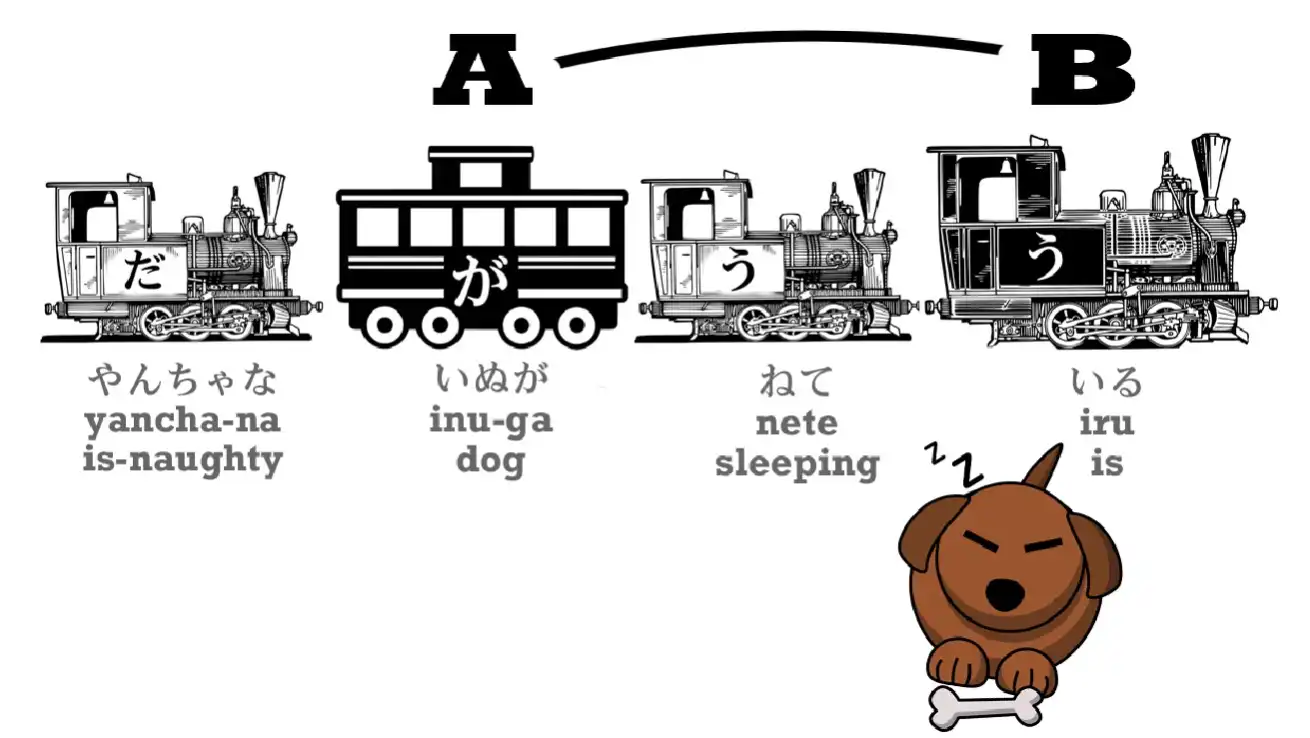
Now, the important thing to note here is that you can’t do this with every noun.
There are only some nouns that are frequently used in an adjectival way, that you can use in the way we showed here.
These are what the textbooks call “な-adjectives”, and it’s a slightly confusing term, because as we see they are in fact nouns, but they are a certain class of noun.
Note: Mark that “a certain class of noun”, they are NOT actual proper nouns. Just a subclass. They cannot be used alone like proper nouns (e.g. a subject). There are different names for them for that reason - Adjectival Nouns, な-adjectives, Adjectivals, Nominal Adjectives etc…
It is just that they mostly resemble a form similar to proper nouns and take a copula like them and so they can be considered to be (and likely are) a class of nouns, just not as proper nouns.
—
Can we use other nouns as adjectives?
Yes, we can, but we use them in a somewhat different way and they aren’t engines.
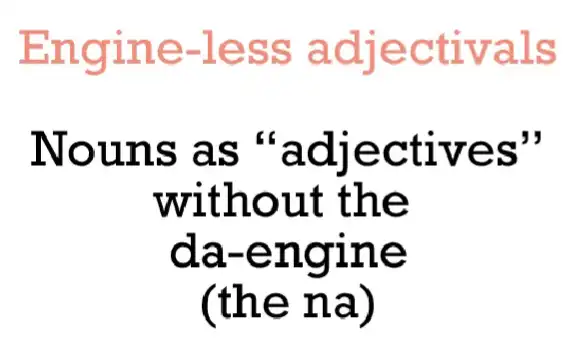
The の car
To explain this we have to introduce a new type of car for our train.
And this is the の car.
の [no] is a very simple particle because it works exactly like apostrophe-s [’s] in English.
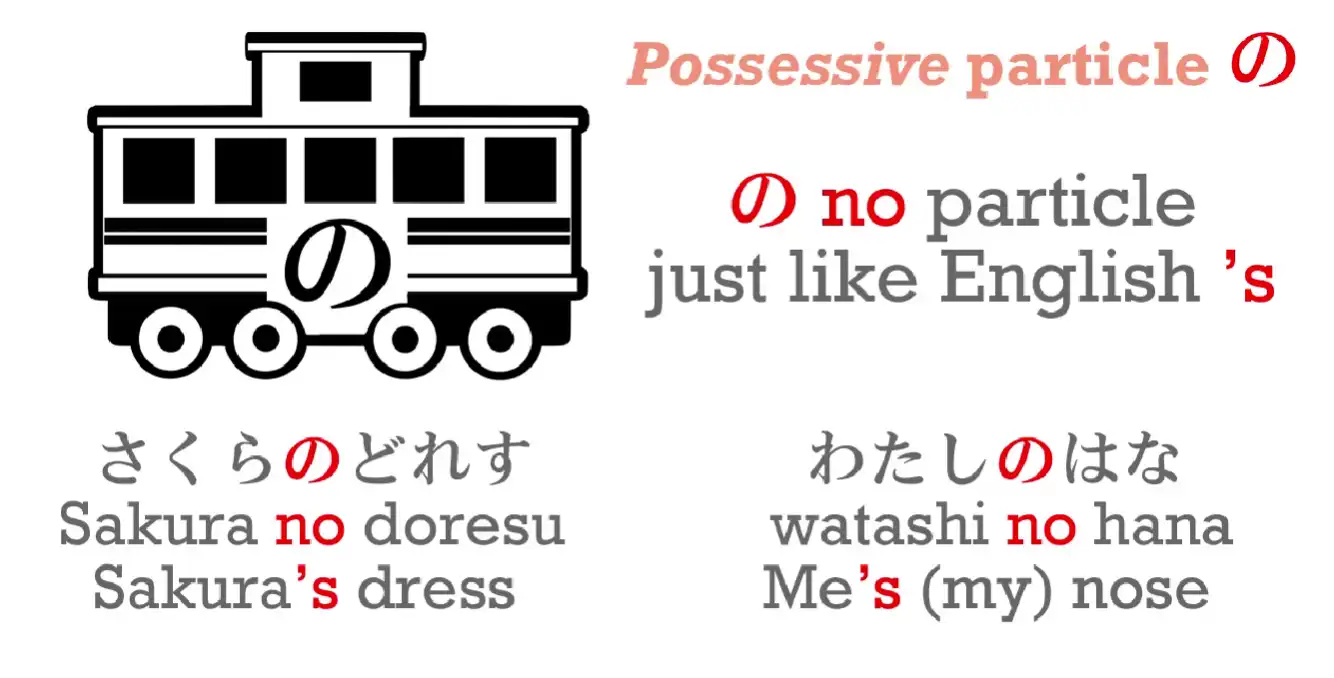
So, “さくらのドレス” means “Sakura’s dress”.
“わたしのはな/鼻” means “my nose”. Note: Or as shown, literally “Me’s nose”. Luckily, we don’t have to worry about things like “my” and “your” and “her” and “his” in Japanese; we always just use “の”.
Now, because “の” is the possessive particle, it can be used in another, slightly different way.
At the beginning of my older videos, I always used to say,
“カワジャパのキュアドリです” – “(I am) KawaJapa’s Cure Dolly”. (*です = だ)
In other words, KawaJapa is the group or party or website that I belong to.
And we can use this more widely for defining the group or class to which anything belongs.
So, “あかい” means “red” because we can turn the noun “あか” into the adjectival form “あかい”.
But we can’t do that with all colors.
For example, “ピンクいろ”.
“いろ/色” means “color”, and we say “ピンクいろ”, that means “pink”.
But that doesn’t have an い-form.
And it doesn’t count as an adjectival noun, a な-adjective, as they are called in English, either.
So what we do with it is, we use “の”.
“ピンクいろのドレス” – “pink dress”.
And this means “dress belonging to the class of pink things”.
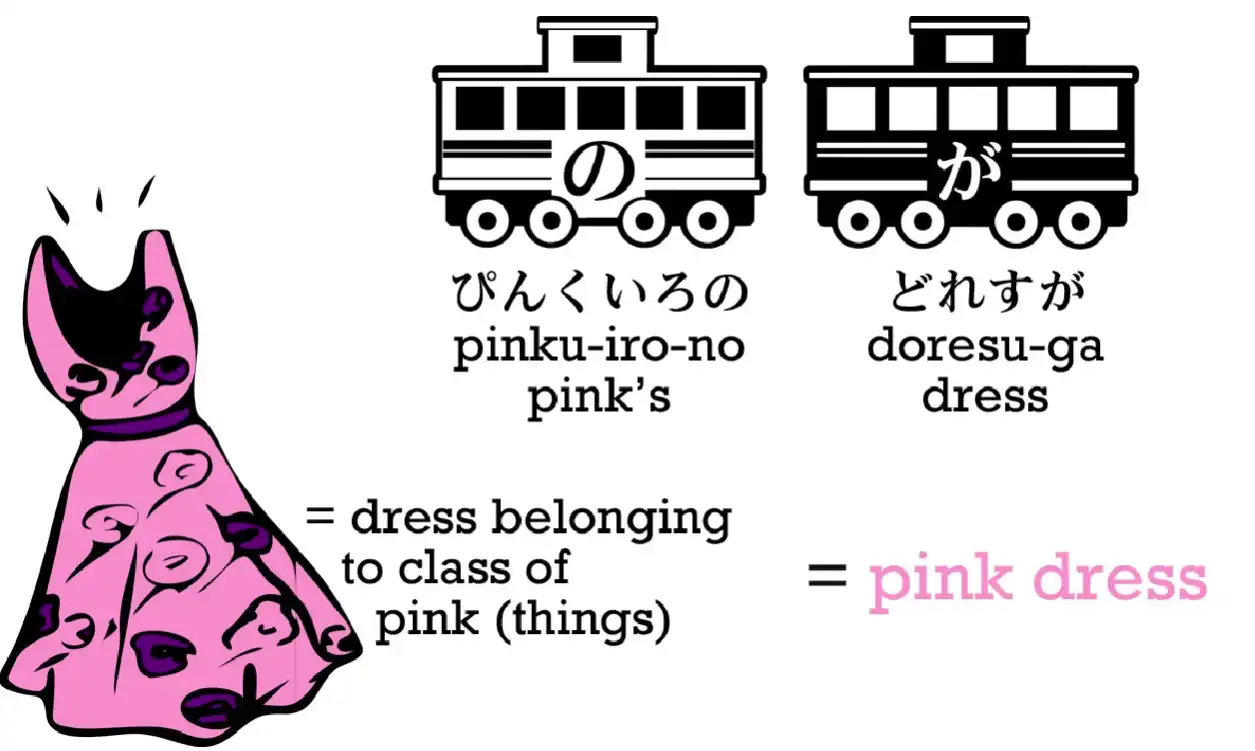
Note: Dolly uses Hiragana here for “Pink”. Normally it is written in Katakana, as a loan word. If we want to say “Oscar the Rabbit”, we say “ウサギのオスカル”, which literally means “rabbit’s Oscar”, and what it means is “Oscar who belongs to the class ‘rabbit’ “.
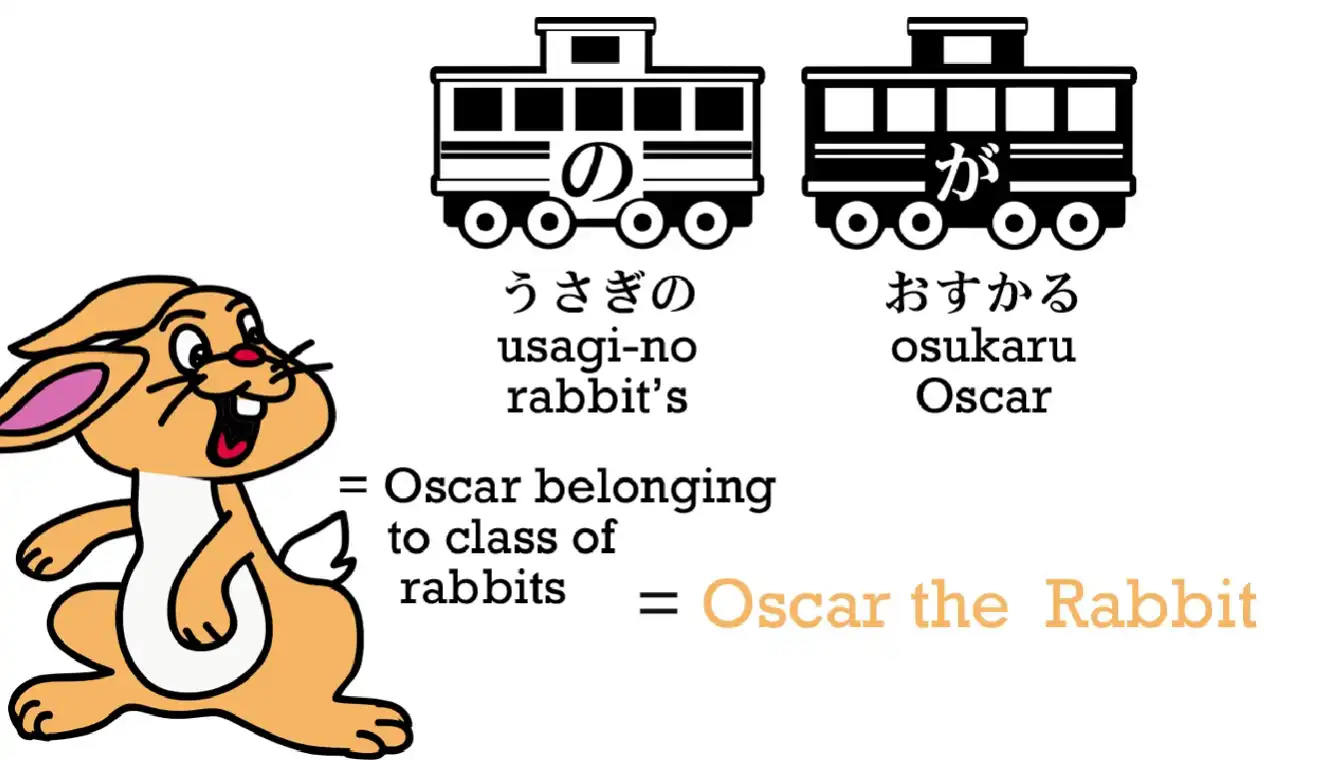
“ゼルダのでんせつ” means “the legend of Zelda”; “でんせつのせんし” means “legendary warrior / warrior who belongs to the class of legendary things”.
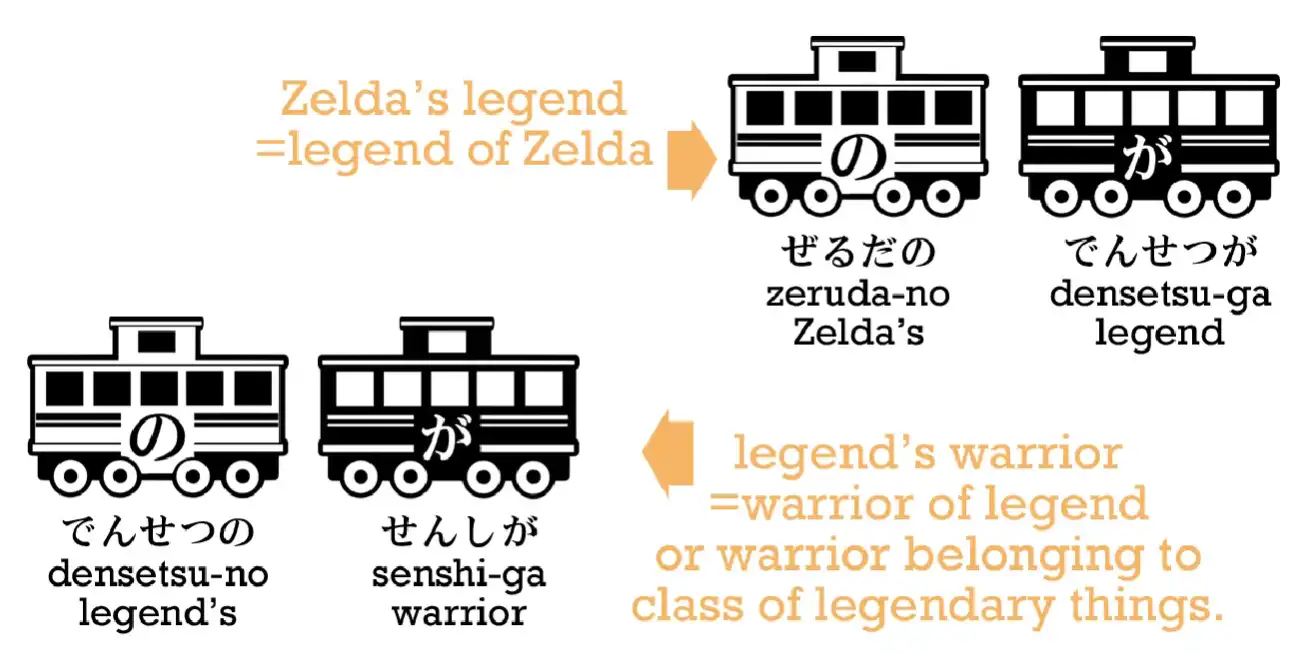
So we have four ways of forming adjectivals: the three engines plus the の car.
And using this we can make all kinds of sentences and they can become very complex, especially with verbal adjectives in which we can use whole complex sentences in an adjectival manner.
And I’m going to do some worksheets that will help us to get used to some of those more complex sentences and I’ll put them in the information section below this video lesson.
Now, one thing you may be thinking is,
“Since some nouns are used as adjectives with ‘な’ and some with ‘の’, do I have to start learning lists of which ones go with ‘の’ and which ones go with ‘な’?”
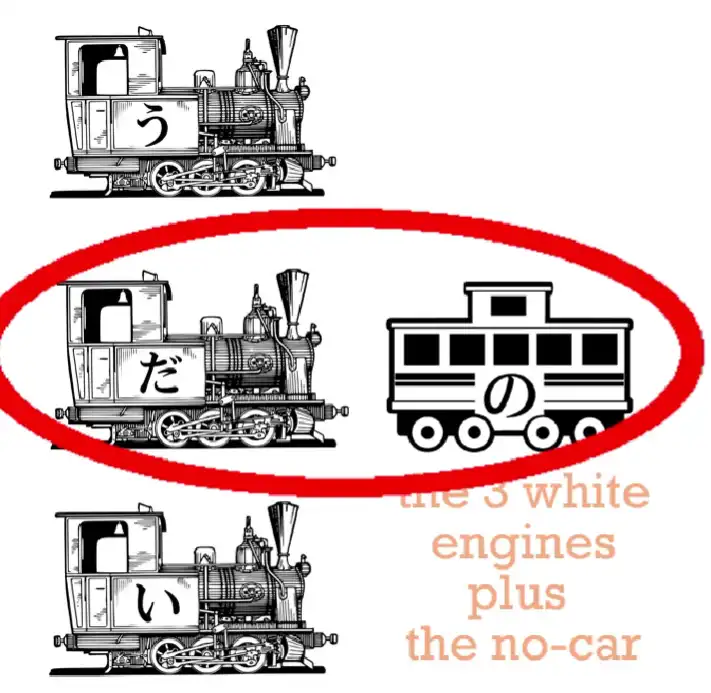
And my answer to that is, I don’t see any good reason to do so unless you are having to learn them for an exam.
Why not?
Well, look at it logically.
If you hear someone use them with either “の” or “な”, you’re going to know what they’re saying.
If you use them yourself and you get it wrong, nobody is going to have any difficulty understanding what you’re saying, and it’s a very small and typical foreigner’s mistake, and frankly it’s the least of your worries at an early stage.
If you’re writing, you can of course look them up very easily.
As you use Japanese more, hear more Japanese, read more Japanese, you will pick up which ones are “の” and which ones are “な”.
And if you’re not going to use Japanese very much, well, why do you need to know?
To me, Japanese isn’t a game of learning abstract information for no particular reason.
It’s a language that for the most part we can learn in a natural manner, and understanding its real structure helps us very greatly to do that.
Note: If it is a bit too much to take, I always recommend checking the comments under the video. And obviously, rereading and taking it in smaller chunks. You can do it! \(⌒▽⌒)
7. Negative Forms and Adjectives in Past Tense
Lesson 7: Secrets of Japanese negative verbs, and Adjective “conjugations” Today we’re going to talk about negatives.
And in order to do that we’re going to have to introduce one of the fundamental secrets of Japanese that the schools and textbooks almost never tell you.
And it makes the whole of Japanese much much easier.
But before we get to that, let’s look at the fundamental basis of Japanese negatives.
The adjective ない
The fundamental basis of negatives is the adjective “ない”.
This adjective means “non-exist / not-be”.
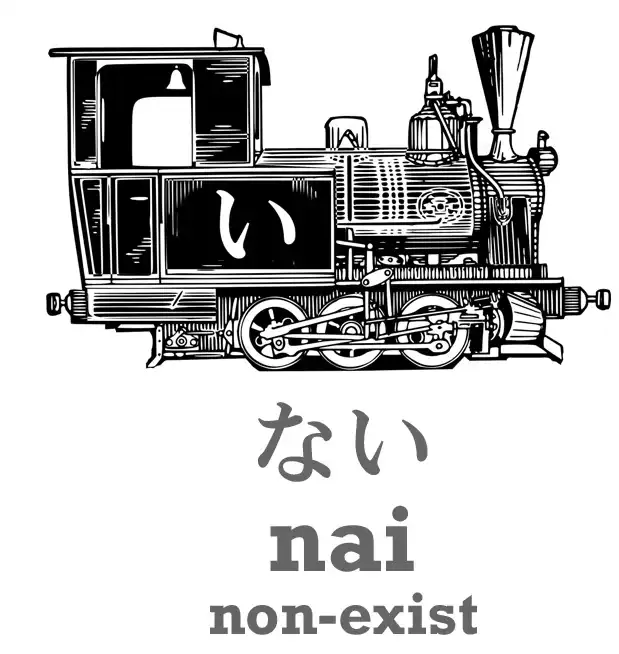
The word for “exist” for any object, any inanimate thing, the sky, the sea, the universe, a grain of rice, a flower, a tree, anything, is “ある”.
So, if we want to say, “There is a pen / A pen exists”, we say “ペンがある”.
But if we want to say there isn’t a pen, we say “ペンがない”.
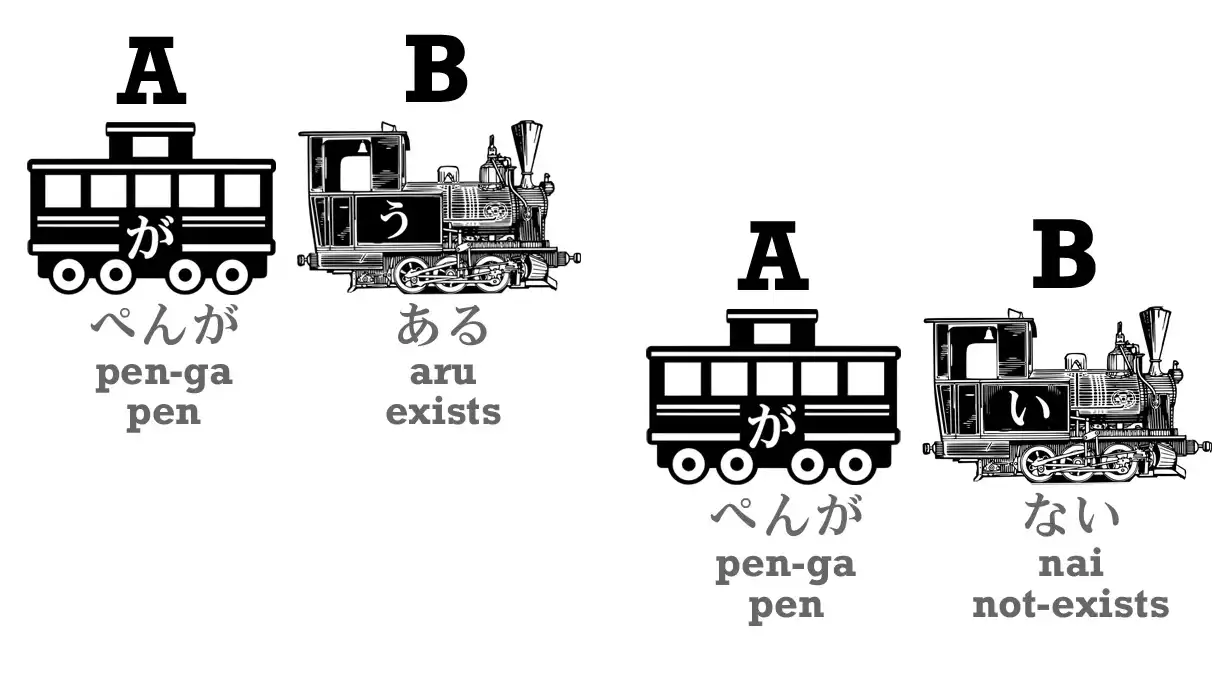
Now, why do we use a verb for being and an adjective for non-being?
Because this happens throughout Japanese.
Whenever we DO something we use a verb.
Whether we walk, or sing, or run, or anything – that’s a verb.
But if we don’t do it, then we attach “ない” to the verb and that becomes the engine of the sentence.
So when we say we’re not doing something, we’re not using a verb, we’re using an adjective.
Why is that?
Because Japanese is very logical.
When we do something, an action is taking place.
That’s a verb.
But when we don’t do it, no action is taking place and we are describing a state of non-action.
So, that’s an adjective.
All right.
So, if we want to say, “There is no pen”, we say “ペンがない.” But what if we want to say, “This is not a pen”?
That’s not quite the same thing, is it?
So, how do we say that?
If we want to say “There is a pen”, as we know, we say “これは (“これ” – “this”)… これはペンだ”.
“As for this, pen = / As for this, it’s a pen.”
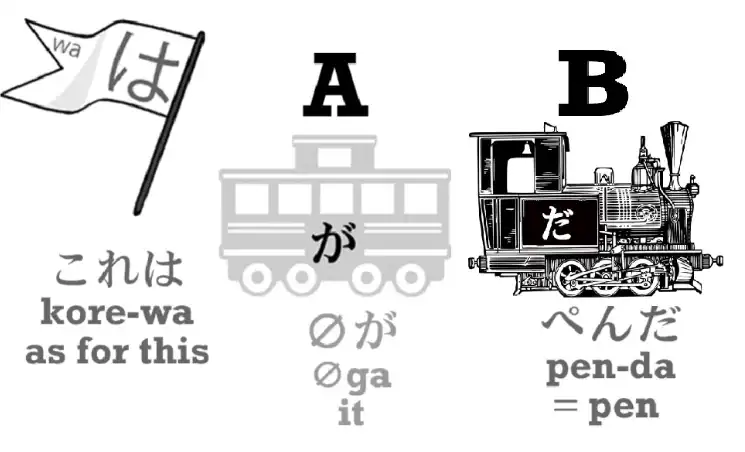
Note: In the video, Dolly makes a mistake and shows a black が car in ペンだ.
I fixed it through my “highly professional” skills in Paint (•̀o•́)ง… anyway here is her comment.

But if we want to say, “This is not a pen”, we say, “これは(zeroが)ペンではない”.
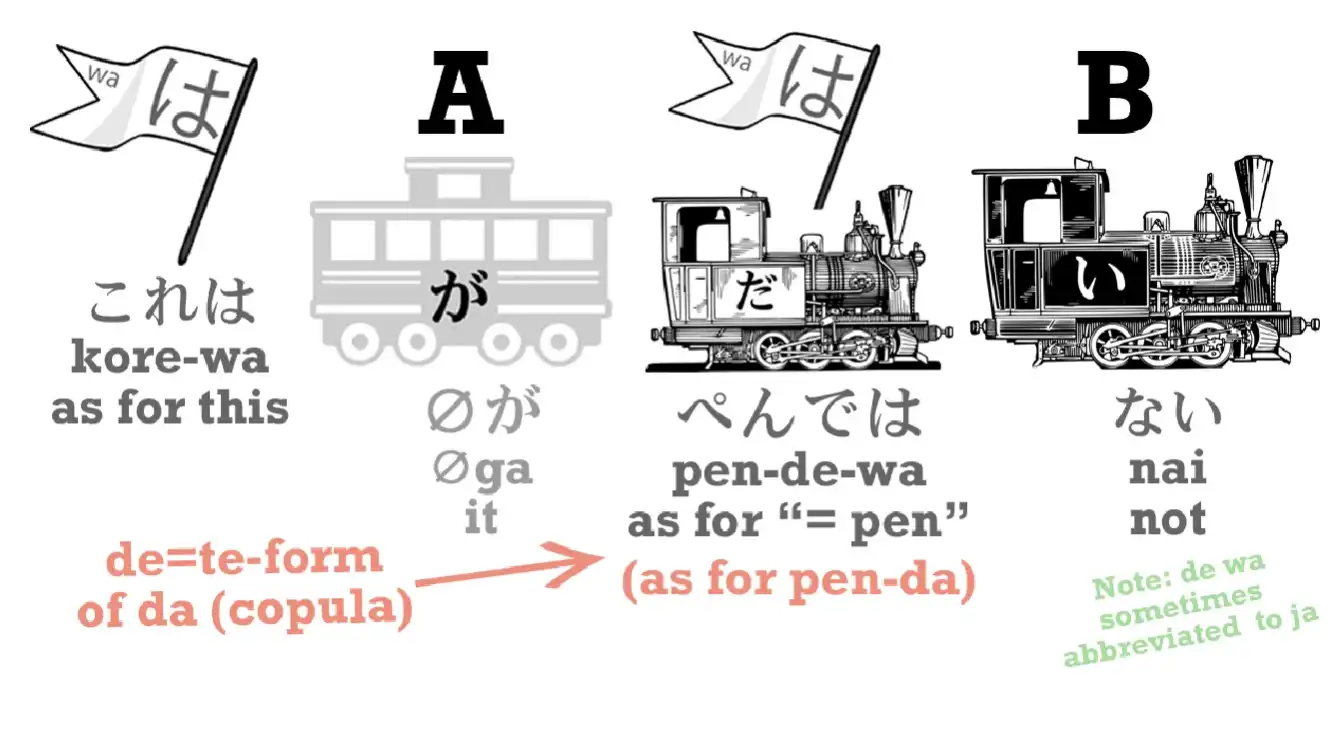
So what does that mean?
Well, the “で” is the て-form of “だ” or “です”.
So we still have “これはペンだ” in the form of “これはペンで” and then we’re attaching “ない”.
So what we’re saying is, “As for this, as for being a pen, it isn’t / This is not a pen”.
All right.
Negative forms of verbs
So now let’s move on to the largest part of this question, which is verbs.
In order to put a verb into the negative, we have to attach “ない”, and we do this by attaching it to the あ-stem.
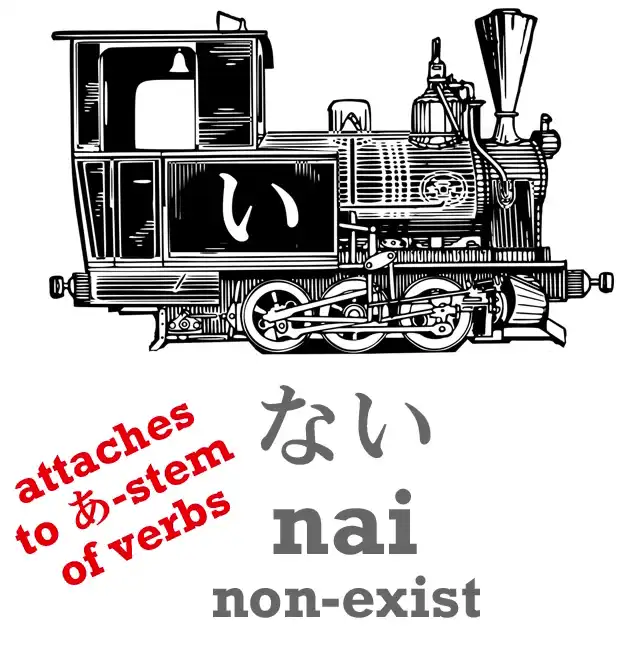
What does that mean?
Well, let’s look at the stem system.
The Japanese verb-stem system is the simplest, the most logical and the most beautiful verb transformation system in this world.
It’s almost absolutely regular.
Once you know how to do it, you can make any transformation (except for the て- and た-form, which you already know).
But the schools and textbooks don’t tell you this.
Instead of telling you this, they present each “conjugation”, as they call it (and they aren’t in fact conjugations)…
they present each one as a separate case with separate rules which appear to be random.
And because they don’t tell you the fundamental logic of the whole system, and because they describe the changes that take place as if they were really written in the Roman alphabet when they are written in kana, it really looks like that.
Students really think they have to treat each case as a separate case and learn separate rules in every case.
And you don’t have to.
You just have to know the stem system.
So let’s look at it.
As we’ve already learned, every verb ends in one of the う-row kana.
And I’m turning the chart on its side here for reasons you’ll see in a moment.
So these kana in the red box are the ones that can end a verb.
It’s not every う-row kana, but it’s most of them.
So we have verbs like “かう” (buy), “きく” (hear), “はなす” (speak), “もつ” (hold) etc.
Now, as you can see, there are four other possible ways in which a verb could end.
And each of those four ways is used, and they are called the verb-stems.
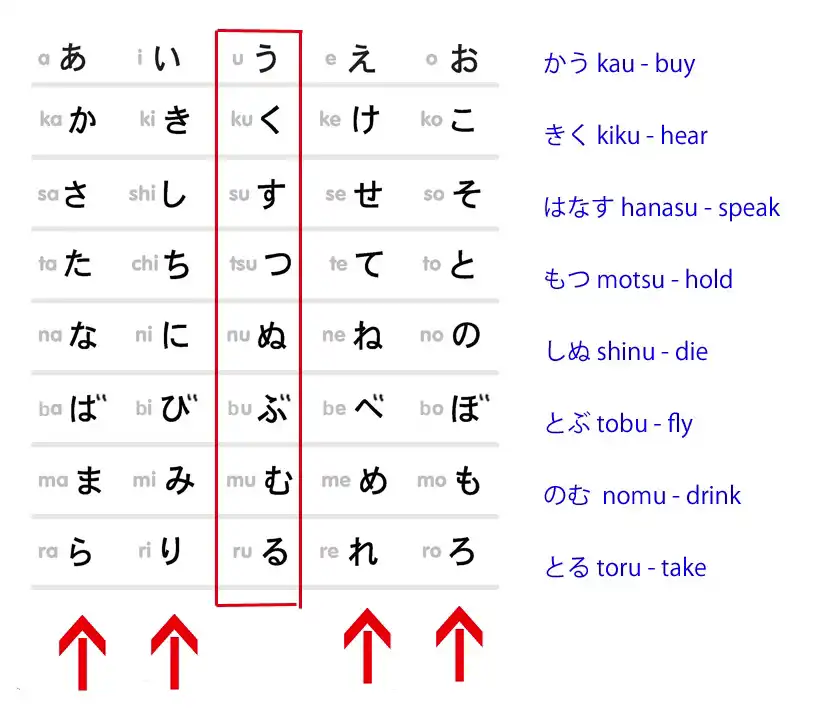
Today we are only going to look at the あ-stem, because that’s the one we need for the negative.
So, to form the あ-stem,
we simply shift the last kana of the verb from the う-row to the あ-row.
So “きく” (hear) becomes “きか”, “はなす” (speak) becomes “はなさ”, “もつ” (hold) becomes “もた”, and so forth.
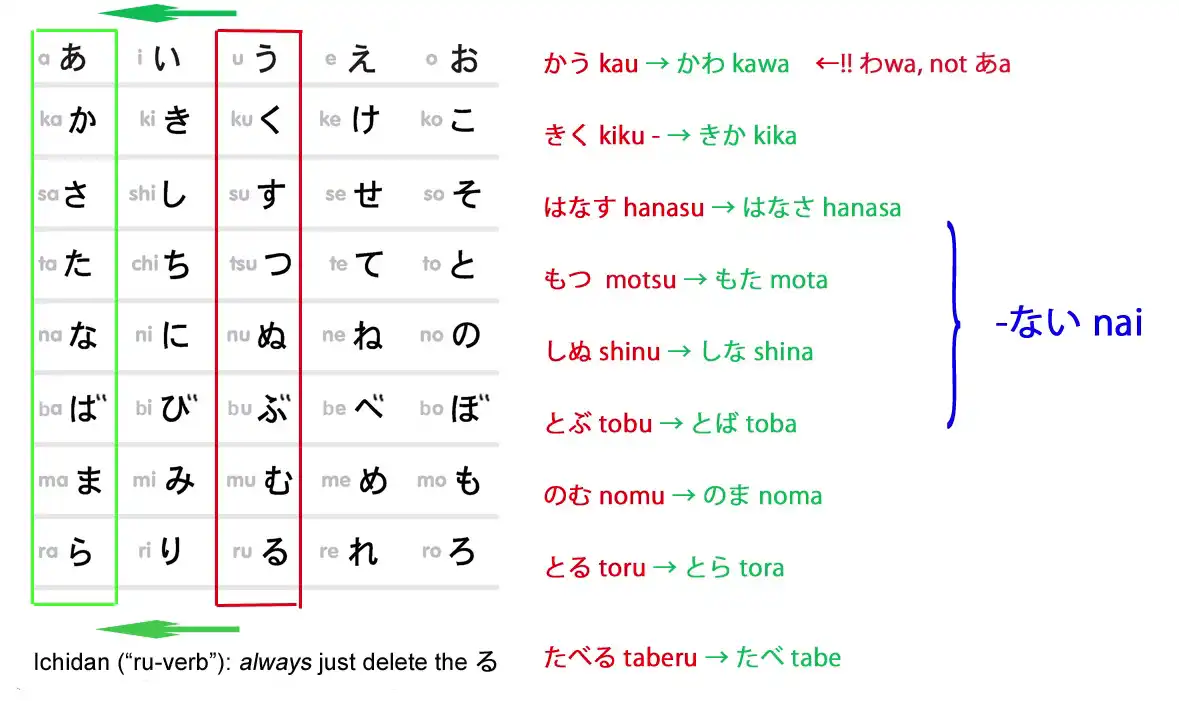
There’s only one exception in this system – and when I say that I mean the whole system, all the stems – there’s only this one exception, which is that when a word ends in the う-kana the stem doesn’t change to “-あ”, it changes to “わ”.
So the negative of “かう” is not “かあない”, it’s “かわない”.
And it’s only in the あ-stem that we have this exception, so that’s the only exception in the whole system, and you can see why it exists: “かあない” is not as easy to say as “かわない”, is it?
All the others are perfectly regular.
“きく” (hear) becomes “きかない” (not-hear); “はなす” (speak) becomes “はなさない” (not-speak); “もつ” (hold) becomes “もたない” (not hold), and so forth.
And as we already know, with ichidan verbs, they only ever drop that “-る” and put on whatever we want to put on, so “たべる” (eat) becomes “たべない” (not-eat).
And that’s it.
That’s how we turn any verb negative.
It’s very, very simple.
Negative forms of adjectives
Now, what about adjectives? How do we make adjectives negative?
Well, when we make a transformation to an adjective, what we always do is we turn the “-い” at the end of it into “-く”: “あかい” (is-red) becomes “あかく”; “かわいい” (is-cute) becomes “かわいく”; こわい (is-scary) becomes “こわく”.
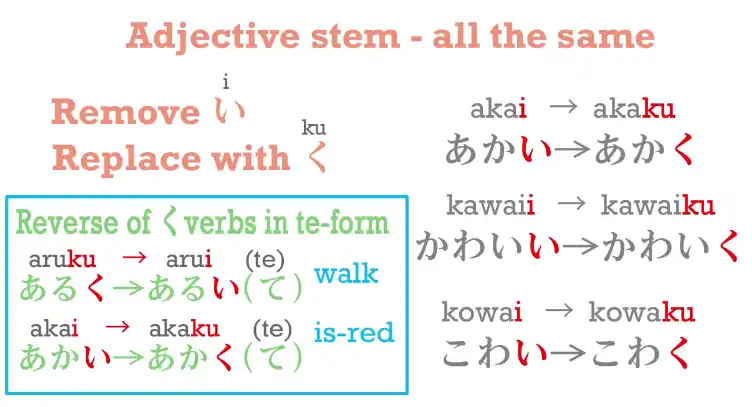
And this is the way we make the て-form of adjectives: “あかく” becomes “あかくて”.
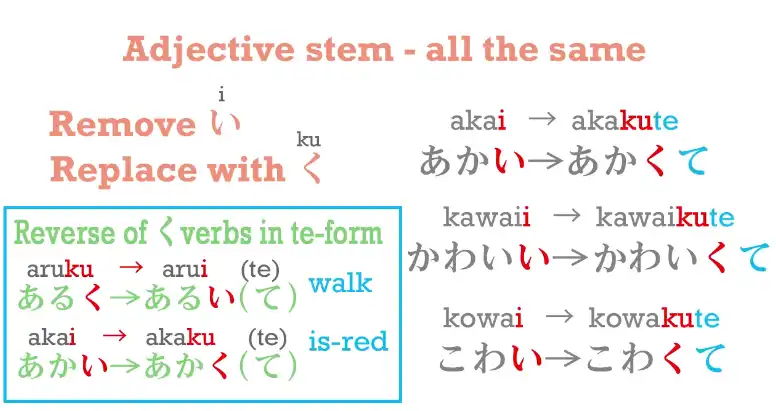
And it’s also the way we make the negative: “あかい” becomes “あかくない” (not-red).
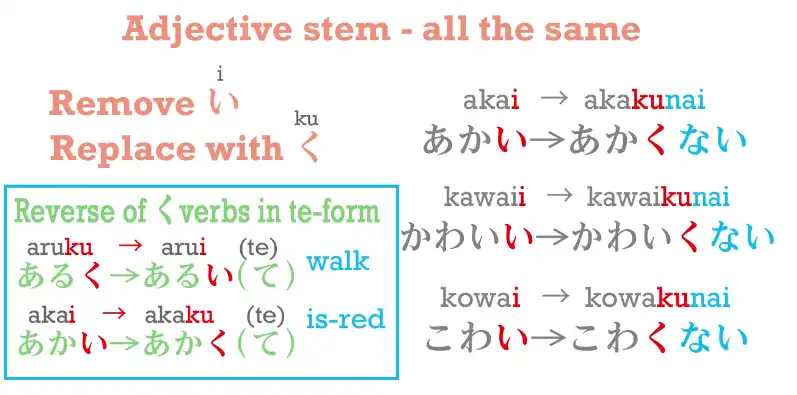
Now interestingly, this -く is the opposite of what happens in the て-form, isn’t it?
If a word ends in -く, in the て-form we turn that -く into -い.
But in an adjective we turn the -い into -く.
Note: Dolly makes a little typo here, in the video, she writes かわいく as あわいく. I fixed it.
Adjectives in the past tense
If we want to put an adjective into the past tense, we take off the -い and use -かった.
So “こわい” (is-scary) becomes “こわかった” (was-scary).
And because “ない” is also an い-adjective,
when we put that into the past we also say “なかった”.
So, if we want to say “Sakura runs”, we say “さくらがはしる”;
if we want to say “Sakura doesn’t run”, we say “さくらがはしらない”;
if we want to say “Sakura ran (in the past)”, we say “さくらがはしった” – because it’s a godan verb;
Note: Notice the っ before た instead of just た, as given in Lesson 5 Godan Verb Group 1.
and if we want to say “Sakura didn’t run (in the past)”, we say “さくらがはしらなかった”.
“はしらない”, and then we put “ない” into the past: “はしらなかった”.
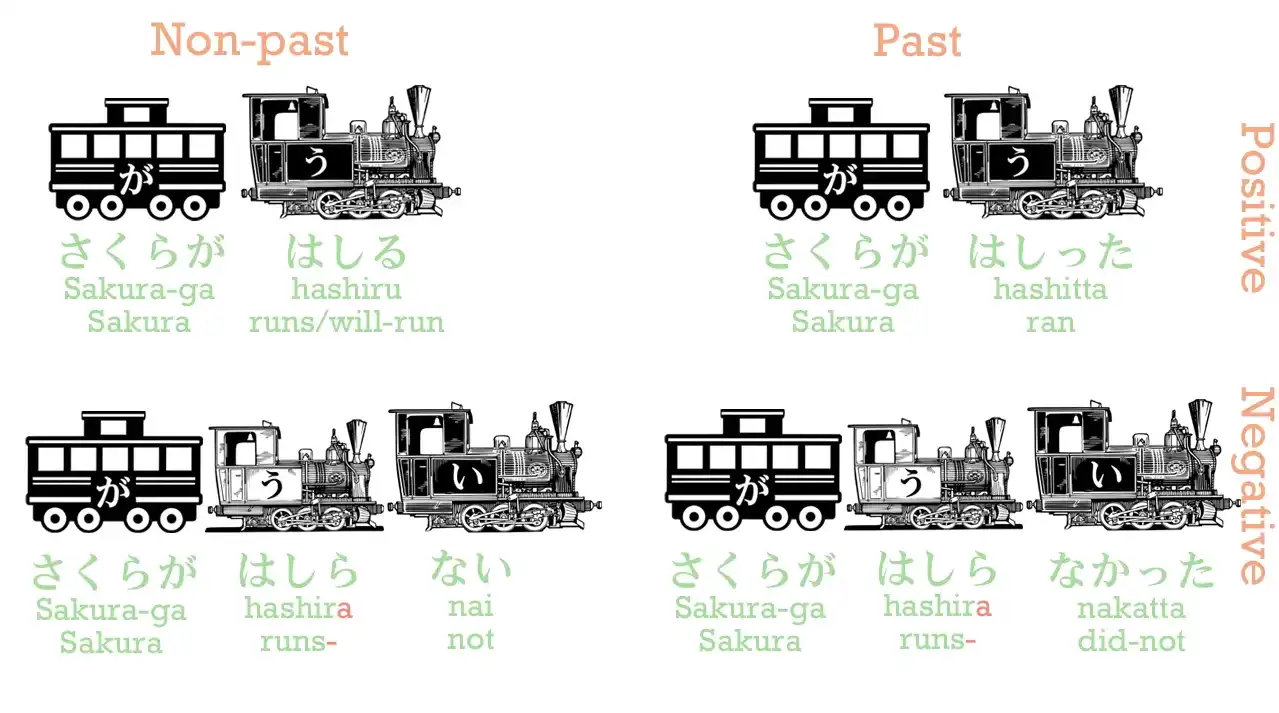
Now, as we all know.
“さくらがはしる” is rather unnatural Japanese, just as it’s rather unnatural English.
We say “Sakura is running” in English, and in Japanese we say “さくらがはしっている”.
So if we want to put all that in the past, what do we do?
Well, all we have to do is put that “いる” into the past.
So we say “さくらがはしっていた” – “Sakura was running”.
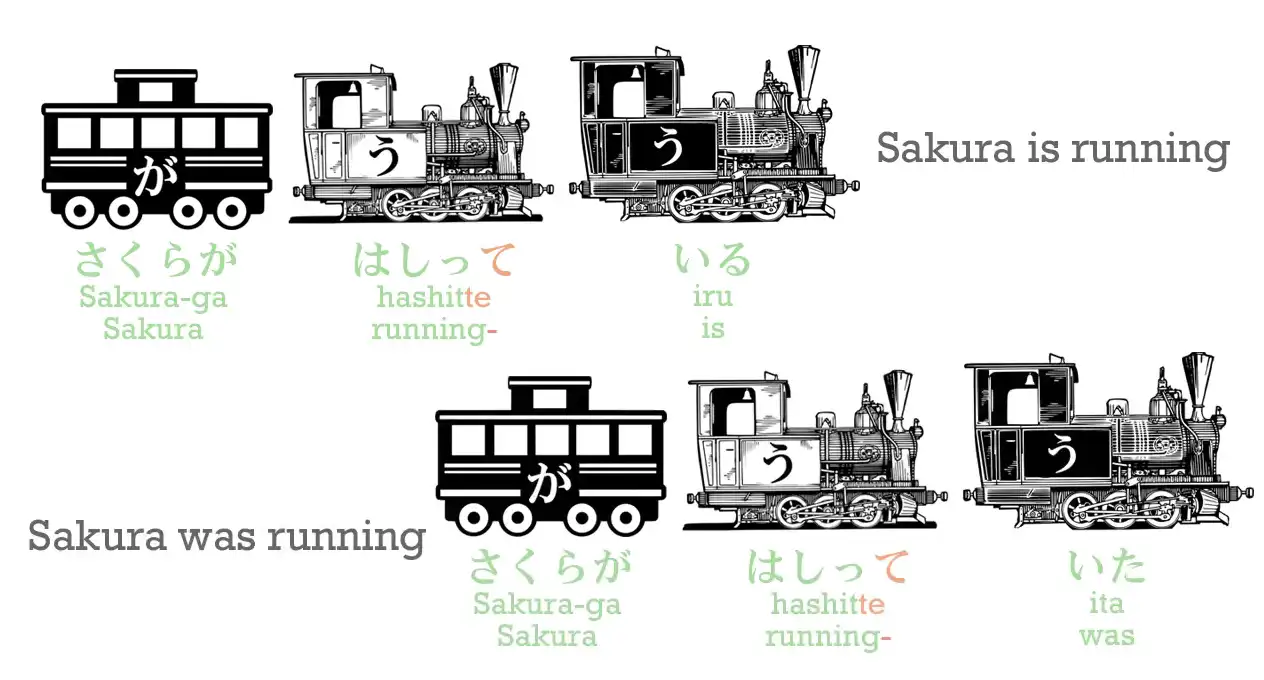
And if we want to say “Sakura wasn’t running”, we say “さくらがはしっていなかった”.
That “いる” is a simple ichidan verb, so we just drop the -る and put on た (positive past)
or ない (negative) and, in the past, なかった. (since ない in the past becomes なかった)

I always say that Japanese is like Lego.
Once you know the basic building blocks you can build anything.
And there are almost no exceptions in Japanese.
Exceptions
In the whole of what we’ve been talking about today there are really just two exceptions.
And I’m going to introduce those so that you know everything you need to know.
The only real exception to every verb being made negative by adding “ない” is the verb “ます”, which is a helper verb that makes words formal.(polite).
We add it to the い-stem of a verb, and we will look at the い-stem later, but I think you can already guess what it is.
So, “はなす” becomes “はなします”, “きく” becomes “ききます” and so on.
When you put “ます” into the negative, it does not become “まさない”, as you would expect – it becomes “ません”.

Because it’s formal, it’s a bit old-fashioned and it uses the old Japanese negative “せん” instead of “ない”.
Note: Dolly once again makes a typo here in the video, I fixed it again.

The only other apparent exception is that “いい” , the adjective “いい/良い”, which means “is-good”, has an older form, “よい/良い”, which is still used quite often.
And when we make any transformation to “いい”, it turns back to “よい”, so in the past tense we don’t say “いかった”, we say “よかった” – and if you’ve seen much anime you’ve probably heard this quite often.
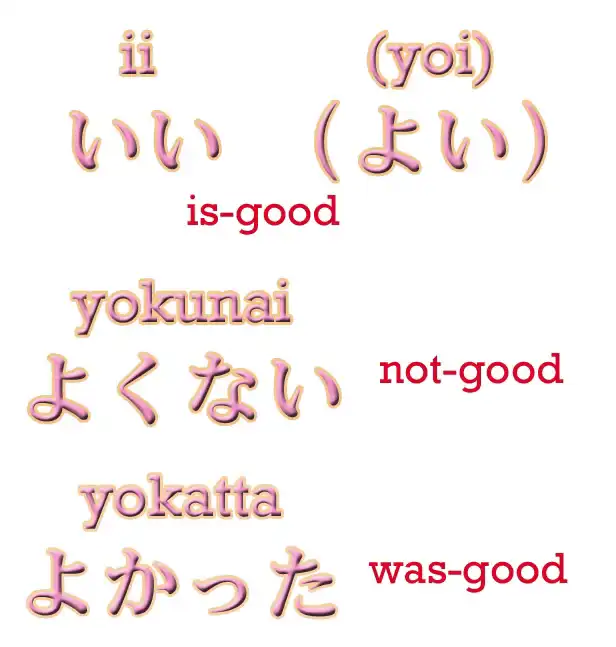
“よかった”, literally “(zeroが)よかった” – “(It) was good / That turned out well / That’s great”.
And if you want to say something is not good, you don’t say “いくない”, you say “よくない”.
And those are the only exceptions.
Note: I recommend reading Morg’s comments about ない in this Discord thread on MoeWay.
It touches on how there are two ないs, and that adjetival ない is not the same as the verbal ない.
In verbs, the ない is apparently an auxiliary verb, not the same as the ない/無い in adjectives.
7.5. Conjugation
Japanese conjugation made easy! The super-simple key to all conjugations. Today we are going to talk about Japanese conjugation.
Which particular conjugation?, you may ask.
Well, all of them.
Except for the た and て form, which we will discuss in a different video (Lesson 81).
Why are we dealing with them all at once?
Because we can.
Because Japanese conjugation all works the same way.
It’s very simple, very logical and very consistent, and very very easy to understand.
However, when we look in the textbook, we get the impression of lots of different rules and forms that you have to learn for each particular conjugation.
Why is that?
Why do the textbooks make it seem so complicated when it’s actually so very simple?
Two reasons.
The first is that they insist on this European concept of conjugation.
Actually, what we are doing is not conjugation at all.
If you truly love reading, there’s a VERY long, interesting discussion about this under Lesson 13, so it depends on you how you refer to it, calling it conjugation is okay, especially when it is called as such mostly so at least familiarise yourself with it. ###
Just one of my rambling terminology notes and some other ramblings… (click on the arrow to expand)
Note: Linguistically it could be argued that there indeed is something like conjugation in Japanese, but it seems to be quite unlike European languages, which is likely why Dolly avoids it, so as not to make us interpret it like that and be confused. As to why most sources call it conjugation.
Again, take this not as a definitive statement, it is just to dodge some associations that come from the word “conjugation” in terms of European languages, since there is a form of conjugation in Japanese, just like Adjectival Nouns are basically nouns, BUT not proper nouns (though that is just 1 model out of many).
This is to just show that there are multiple ways of looking at things and it is not strictly black n’ white, it is a model, and since you cannot explain everything at once, you simplify some things.
—
Though, keep in mind that Dolly sometimes does get a bit too negative towards textbooks (while some are valid, textbooks aim for something different and as long as any source helps you start massive immersion it is good) and sometimes frames herself as “the best way” to acquire grammar or such click-baity titles on some of her videos, I do not agree with that mindset/presentation of hers and would take it with a grain of salt. Since Dolly uses simple explanations to make it easy to grasp, some stuff she says is simplified and uses it to fit her model, and sometimes she is at least slightly inaccurate/wrong, at least from some of the examples I heard being discussed on the internet and in certain Discords by people who seemed to have some deeper understanding of Japanese though I will not make any conclusions since I am nowhere near to be an authority on anything Japanese-related or to reach such conclusions on my own.
If you want to know why check this MoeWay Discord discussion. So do not take Dolly as gospel but just as a useful way to attain Japanese basics that push you into immersion = what truly matters.
—
My explanations are just my guesses and how I personally understand stuff, but they are definitely not fully accurate either anyway since I am not a linguist or such (at least not yet and not for a LONG time lol), so obviously what I say is also likely not entirely correct and may be wrong/incomplete/simplified (which is why I want to be notified of everything I say wrong if you notice).
But if the claims are true and Dolly is indeed wrong in at least some cases/partially, that is still alright mostly since Dolly is here to just introduce the very basics and there it does not matter too much since it can be “fixed” through immersion. Dolly simply serves to push you into immersing rather than show you full Japanese, full Japanese cannot be learnt, no language can… it can only be acquired through a massive consumption and use of the natural, native language.
—
In linguistics and grammar, things are not simple and so if you want to explain it simply, you must sacrifice some accuracy for the sake of simplification. Just keep in mind that things get more complex as you dive deeper and I would take Dolly as just the basis rather than a 100% correct assessment of Japanese since that probably is not even possible unless you use 100% native-Japanese advanced linguistics sources and even there are differentiating opinions on some stuff, so it all depends on the model / focus.
Intro to Conjugation
This is what Dolly says in her book “Unlocking Japanese” about Conjugation, so just keep it in mind:

What we are doing all the time is attaching a simple helper verb – or helper adjective or helper noun – to the stems of the verb.
And once we see how that works, it becomes very, very simple and easy to understand.
The other problem is that they spend a lot of time explaining the changes that take place in terms of the Roman sound system – the alphabet.
But in fact that causes a lot of confusion and difficulty.
Once we see it in the terms it actually exists in, that is to say, the *Japanese* sound system, it all becomes very logical.
I would say it is a 100% consistent, logical and simple – except there is one exception in the whole system, and there are two irregular verbs, so perhaps we had better say 99.9% logical, consistent and easy to understand.
All right.
So, let’s give you the master chart, which will show you how all of this works.
チャートをください! So, here is the familiar Japanese kana chart, with all the sounds of Japanese.
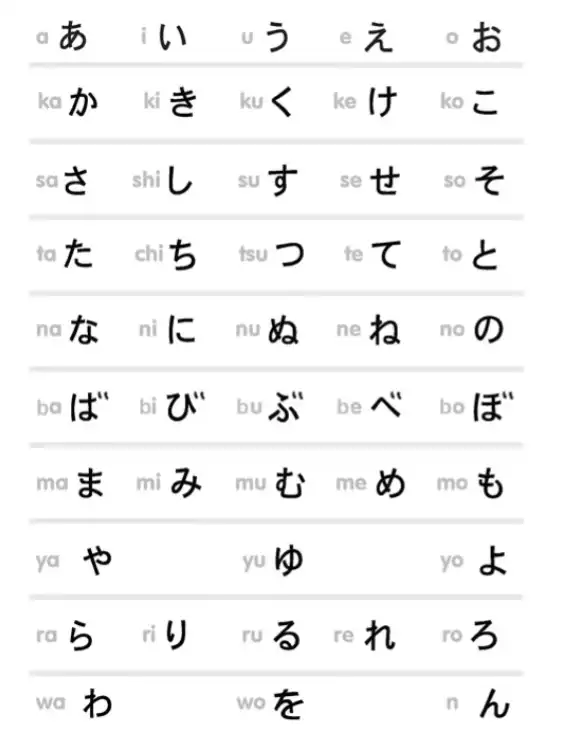
I’ve turned it on its side, for reasons which will become apparent shortly. All Japanese verbs end with one of the kana in the middle row – it looks like a column because I’ve turned it on its side. That is the う-row – う, く, す, つ, ぬ etc.
However, there is no verb ending in ゆ, so we can get rid of these two columns and simplify the chart.
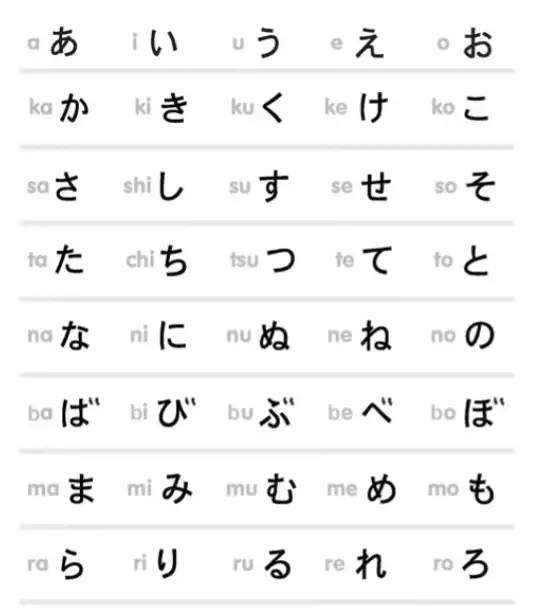
Actually, there is only one verb that ends in ぬ – that’s しぬ, to die – so we could get rid of that too and make it look even simpler, but I’m keeping it in for completeness.
So, every verb ends with one of the kana in the red box. Let’s have an example of each of the possible endings:
かう, buy; きく, hear; はなす, speak; もつ, hold; しぬ, die; とぶ, fly; のむ, drink; とる, take.
Now, as you can see, there are four other possible endings that the verbs could have, and in fact each of those endings is used.
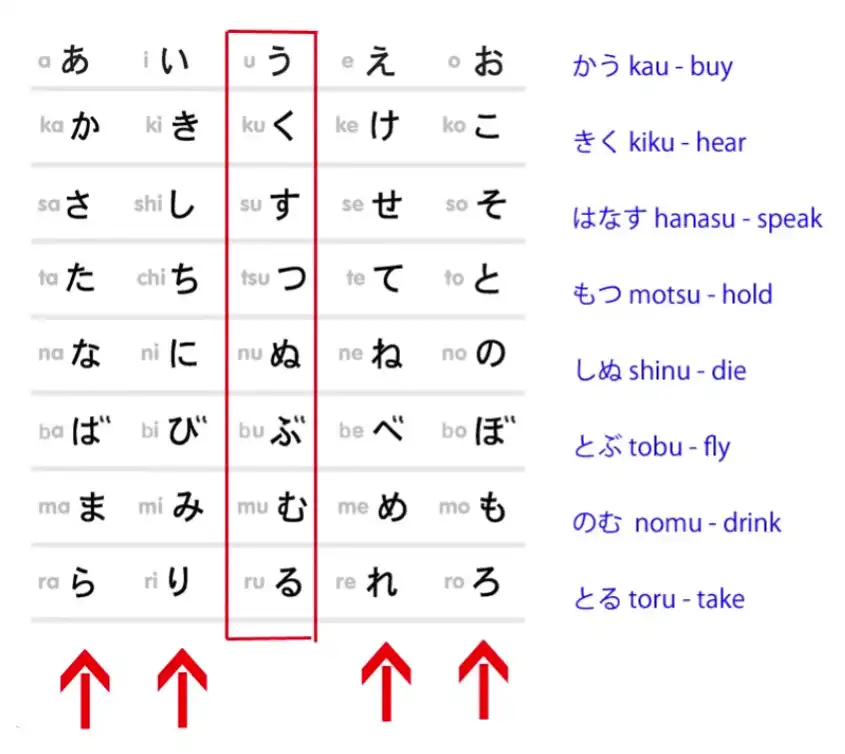
And when we use one of the other endings, the verb stops being a verb and becomes what I call a ‘sticky stem’, that is, a stem to which we stick something else.
The い-stem
So, here is the い-stem.
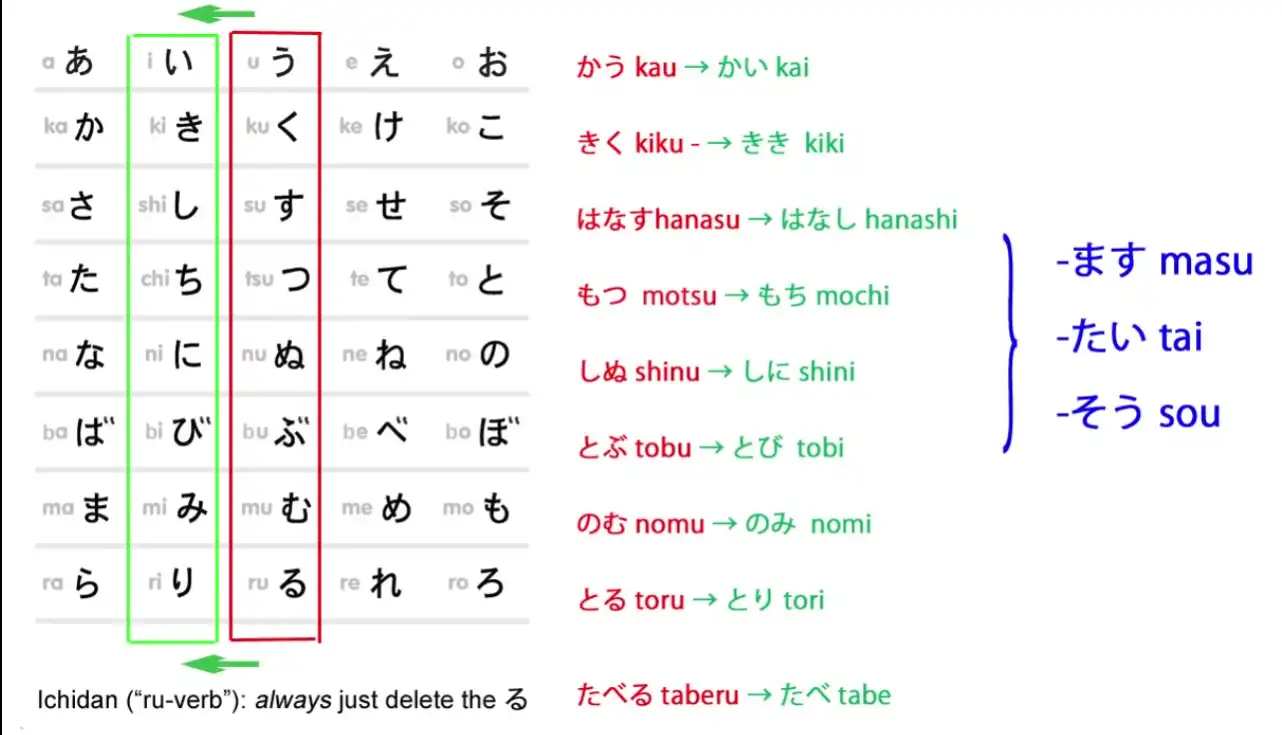
Note: If you are wondering why そう is there, yet is not mentioned here. It’ll be in Lesson 24.

With the い-sticky stem, we change the う-row kana to the corresponding い-row kana.
So, かう becomes かい, きく becomes きき, はなす becomes はなし, and so forth.
What do we do with the ‘い’ row sticky stem?
#
Helper verb ます
Well, the thing that you have all seen, I’m sure, is we can attach the helper verb ます to the い-row sticky stem.
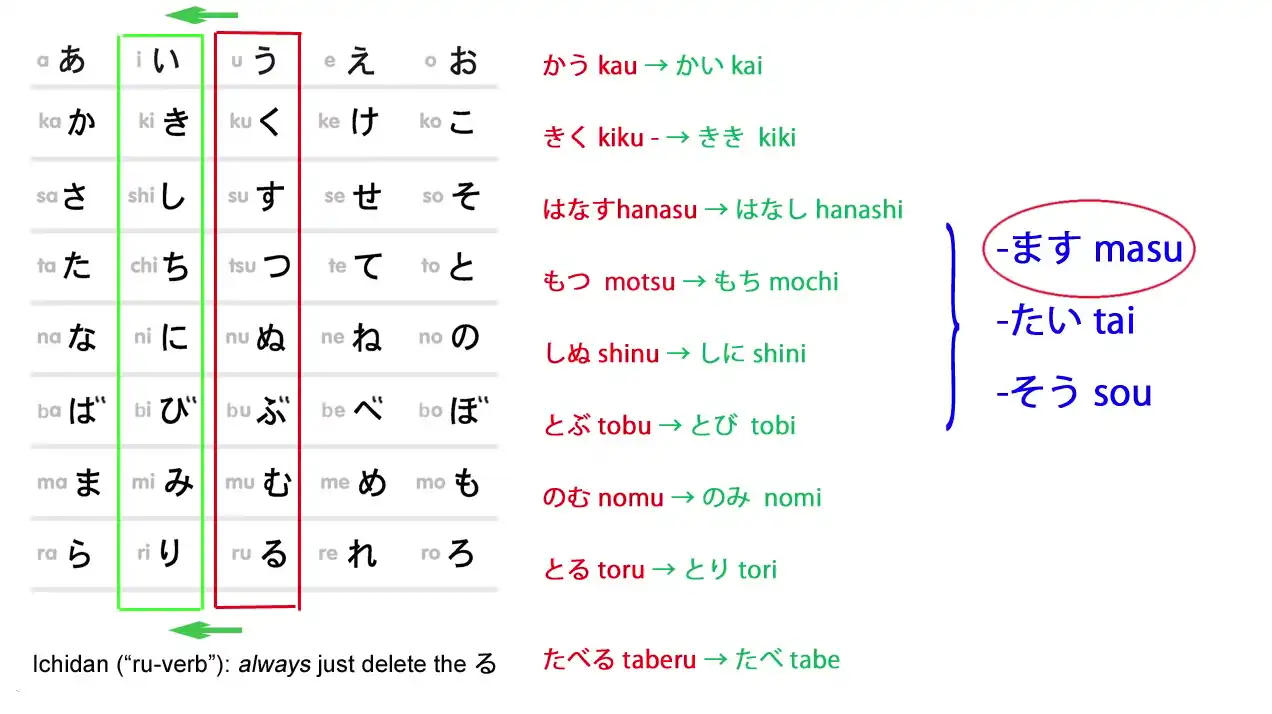
ます is not a conjugation. It is a verb. It is a helper verb and it attaches to the い-row sticky stem. It does not change the meaning of the verb, but it makes it formal. (polite) So, かう is the regular, informal version, meaning buy; かいます is the formal version.
きく is the informal version, hear; ききます is the formal version.
#
Helper adjective たい
What else do we do with the い-row sticky stem?
Well, we can attach the helper adjective たい.
たい is a helper adjective which means want.
So, かいたい means want to buy; ききたい, want to hear; はなしたい, want to speak, and so forth. Note: Whereas in English it is usually translated as a verb, in Japanese it is an adjective. #
Converting verbs into nouns
We also use the い-row sticky stem for attaching nouns in order to convert a verb into a new noun.
So, かいもの, that is buy-thing: it means shopping.
のみもの, drink-thing, means a drink.
はなしかた (かた means form or shape)…
はなしかた means form of speaking, manner of speaking.
So now we know how to attach all these except for what are called “る-verbs”, the ichidan verbs, and they are very very simple, because all you ever do with these, ever, is simply cut off the る and you have *all* the possible sticky stems of the ichidan verbs.
So たべる becomes たべ; たべます is the formal form of the verb;
たべたい, want to eat; たべもの, eat-thing, food.
Note: There also exists a noun 買い (it is a noun), that means shopping, buying, product etc.
So it is similar in meaning, I don’t know what the connection is between it and 買い物 or such, but just so that you know there are a few such cases. It also shows that not every word ending in い is automatically an Adjective, although the vast majority are… perhaps the い was some Kanji noun in the past too and now it no longer takes its Kanji form???, who knows…
- *
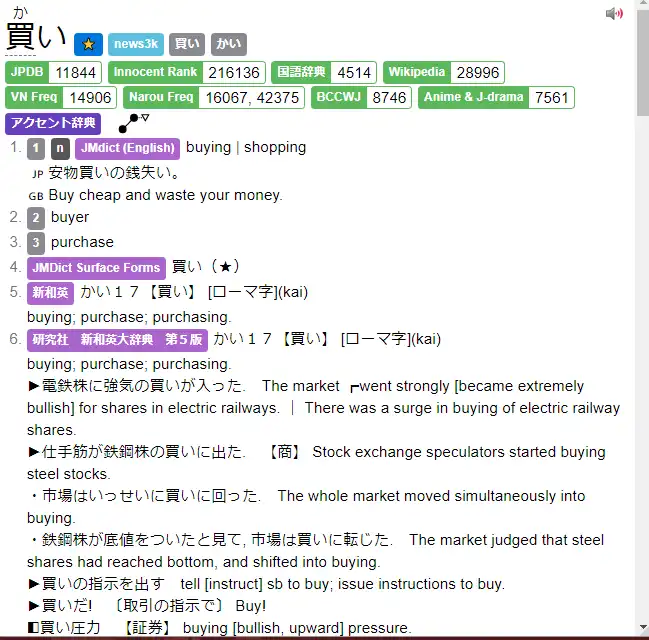
The あ-stem
So now we come to the あ-row sticky stem, and this has one exception.
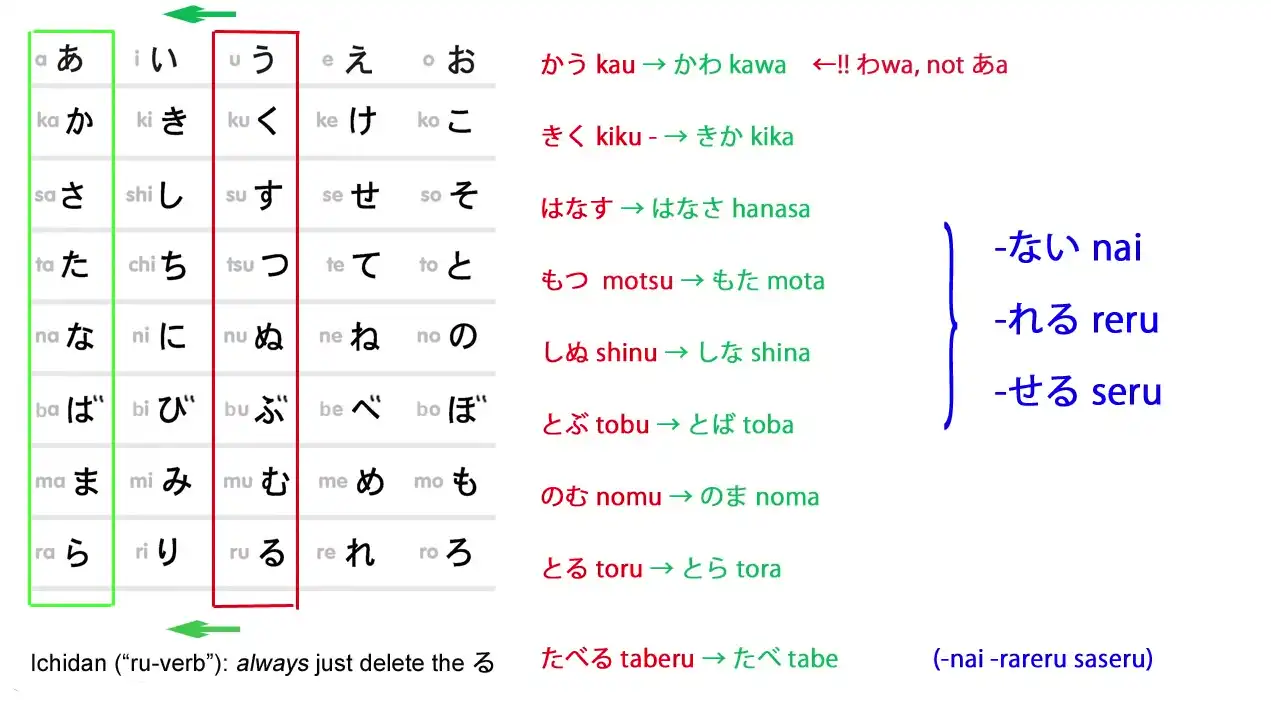
And you’ll say, “Ah, languages! Full of exceptions!” This is the only exception in the whole system, and it’s a very natural one that you can well understand.
The う-ending verb does not become “かあ”, it becomes “かわ”, which is a lot easier to say, and understand in conversation, isn’t it?
So かう does not become “かあない”, it becomes かわない.
Note: In the comments under the video, there is an insightful comment by one “pycage” about this exception not actually even being an exception when one regards the history of Japanese. You can check it out if you are interested (o^▽^o) But it is a rather more advanced explanation. So what do we use the あ-ending stem for?
#
Helper adjective ない
I’ve already mentioned it (Lesson 7) – probably the most common use is to attach the helper adjective ない to the sticky stem of a verb.
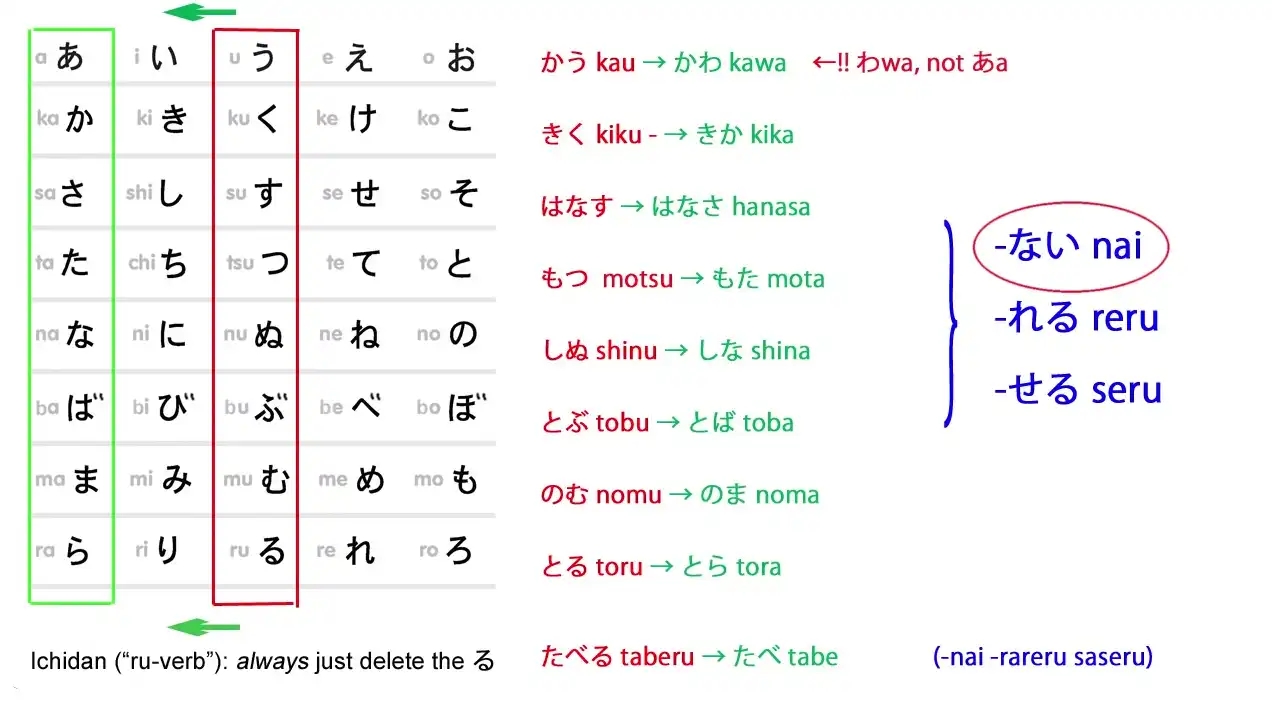
It attaches to the あ-sticky stem, so かう, buy, becomes かわない, not buy;
きく, hear, becomes きかない, not hear;
はなす becomes はなさない, not speak, and so forth. Very simple.
#
The causative
We also use the あ-sticky stem for the causative
and the so-called “passive” forms of verbs (the receptive),
and these “conjugations” often give beginners quite a lot of trouble.
And I have made videos (later lessons) that show how simple they really are, how they work, what they mean, and how simple it really is if you understand them the way they actually are.
Today we are just going to look at the structure.
So, the causative form of a verb, which means to allow someone to do something or make someone do something, is formed by attaching the helper verb せる / させる to the あ-row sticky stem.
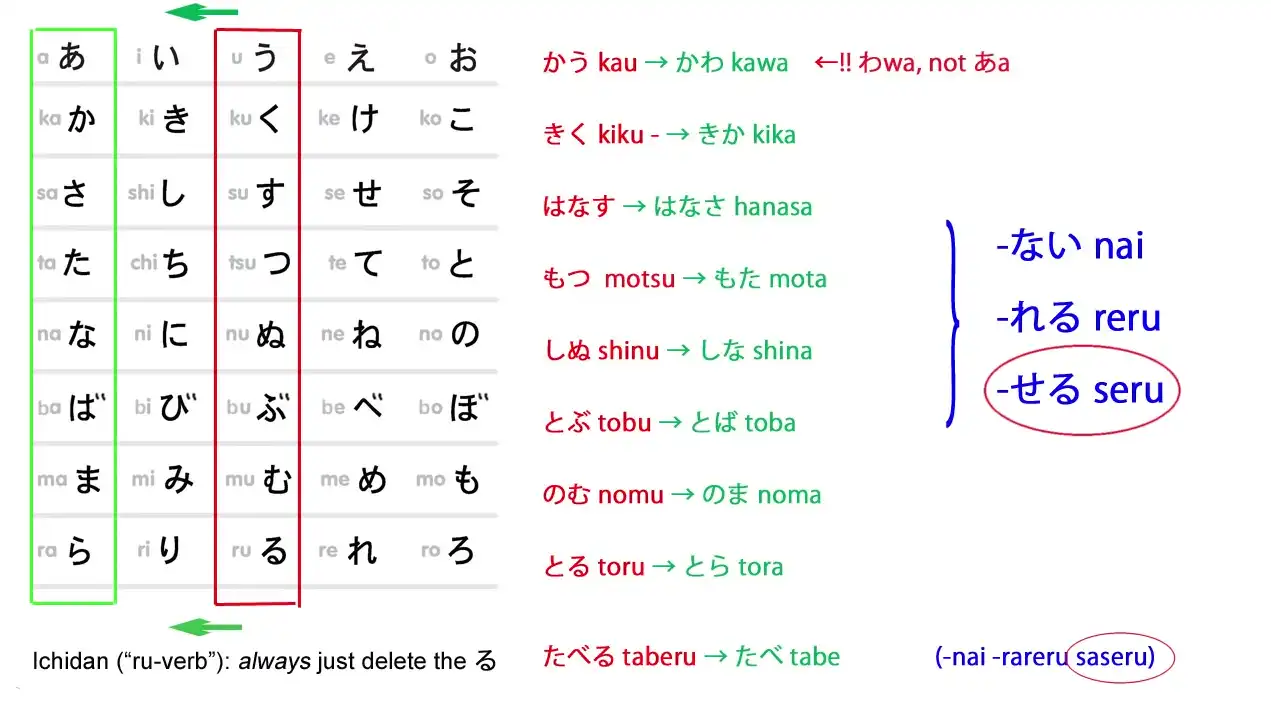
Now, I say せる / させる – what does that mean?
Well, it means that there are actually two forms of this helper verb.
せる attaches to all those sticky stems that we’re working with – all the ones that change.
Note: Dolly here means the godan verbs.
And させる attaches to the ichidan – the so-called “る-verb” – sticky stem.
Where there is a slight variation in the helper verb, we always find that the longer version goes onto the ichidan verb, because that verb is generally shorter.
The ichidan verb, we take off the whole last syllable; with the godan verbs, the changing sticky stems, we don’t take off the last syllable, we change it to a different sound.
So, せる / させる makes the causative form of a verb.
かう becomes かわせる, allow to buy, make to buy;
はなす becomes はなさせる, allow to speak, make to speak;
Note: はなす is a godan verb ending with す, so it changes to あ-stem + せる, which looks the same as the ichidan causative form of させる. Dolly explains stuff like this in the later lessons.
のむ, becomes のませる, allow to drink, make to drink;
and たべる becomes たべさせる, allow to eat, make to eat.
Note: たべる is an ichidan verb, so it just deletes the る and adds させる to make the causative.
#
The receptive / passive
The so-called passive – which isn’t really passive (this can be argued, but let’s stick to Dolly now),
and we have a video helping you with understanding
what it really does and how simple that really is – the so-called passive,
the receptive form, is formed with the helper verb れる / られる.
So, かう becomes かわれる, which means get bought, be bought, get bought – get bought is better because that is closer to what the Japanese really means, and you will understand that when you see the video (Lesson 13);
きく becomes きかれる, get heard;
のむ becomes のまれる, get drunk – I don’t mean become intoxicated, I mean the way the cup of coffee got drunk;
たべる becomes たべられる, get eaten.
So as you see, there are really – apart from that one exception, there are not lots and lots of different ways of attaching these together.
It’s because it’s presented as a (“West-based”) conjugation and because it’s explained as if it was written in Roman letters that the confusion arises.
We can see that it’s actually very, very regular.
We just shift to the あ-row and add the helper adjective ない, the helper verb れる / られる,the helper verb せる / させる, and it’s just as simple as that.
The え-stem
Now we come to the え-row sticky stem.
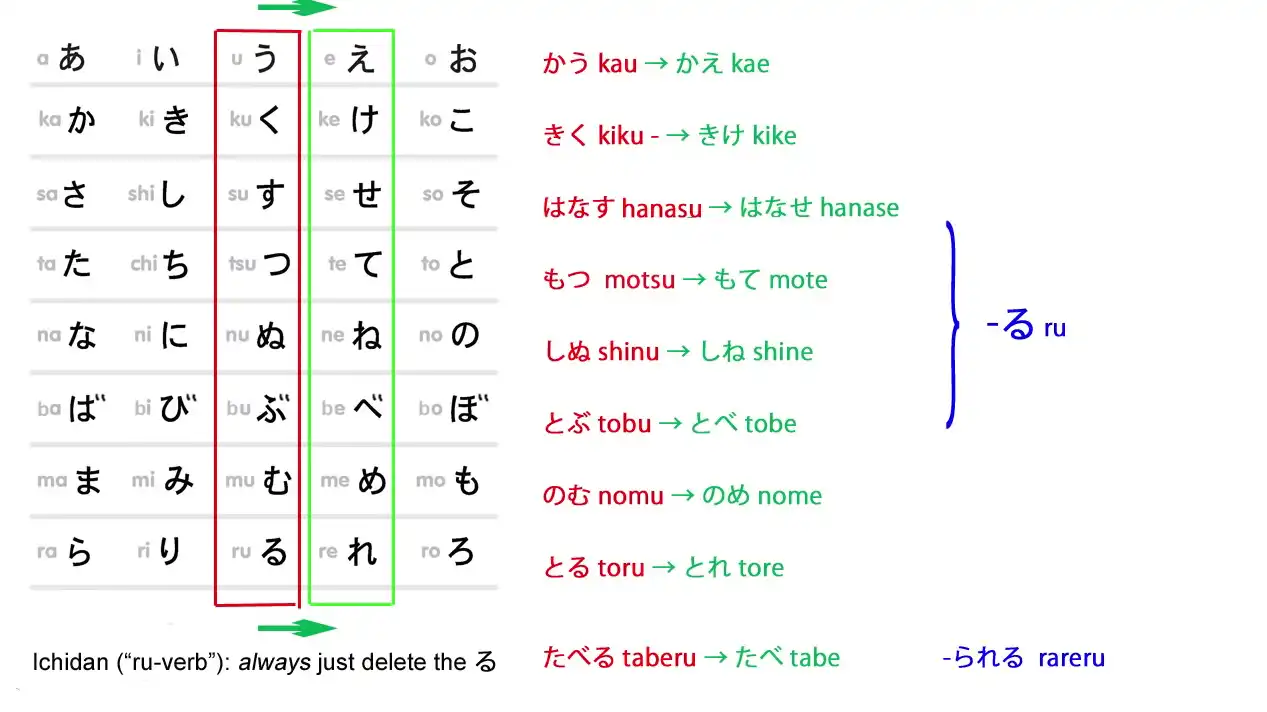
Just like the others, it’s perfectly consistent.
You just change the う-row kana into the corresponding え-row kana.
So かう becomes かえ, きく becomes きけ, はなす becomes はなせ, and so forth.
#
The potential
We use the え-row sticky stem to create the potential form of verbs,
which means you “can do” the verb.
The helper verb, which is stuck onto the え-row sticky stem, is る / られる.
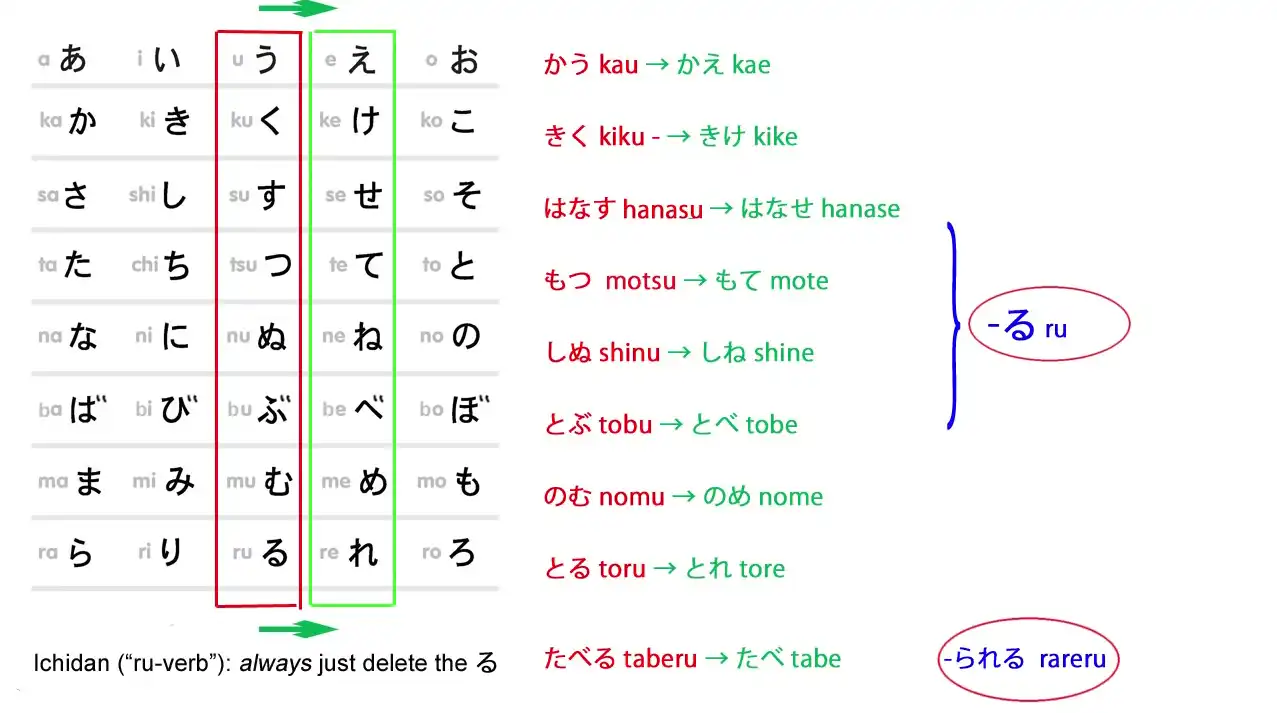
And yes, even though it’s simply る, just that one character, it is a helper verb – if you look it up in a Japanese dictionary (not a Japanese-English dictionary, but a real Japanese dictionary), you will find る there as a 助動詞/じょどうし, a helper verb – and it has these two forms, る and られる.
られる is, you will have noticed, the same as the so-called passive (the receptive),
れる / られる, so the ichidan form of the passive and the potential are the same – but because they are used very differently, there are very very few occasions on which you would confuse the two, so it’s not really a problem.
So, we have かえる, can buy; きける, can hear; はなせる, can speak, and so forth;
plus たべられる, can eat. Note: can as in “is possible / is able”, later on that in Lesson 10.
The お-stem
So, now we come the last sticky stem, the お-row sticky stem, and just as with the others, it’s perfectly consistent.
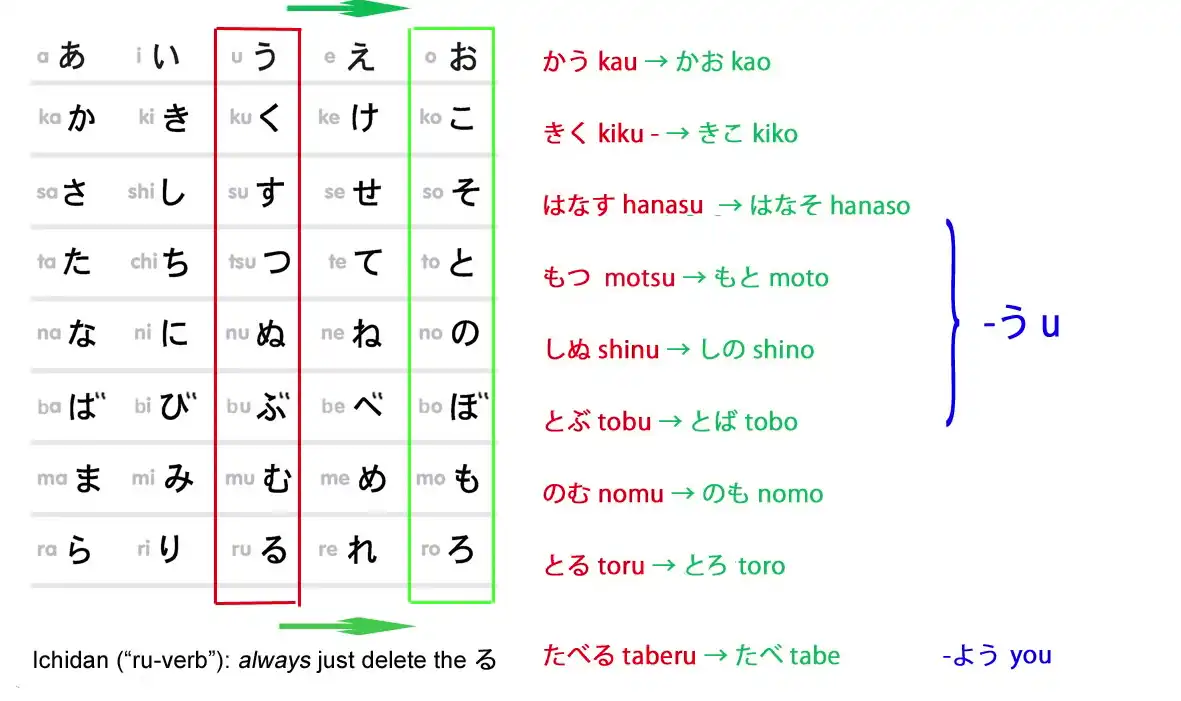
かう becomes かお; きく becomes きこ; はなす becomes はなそ.
#
The volitional
And what we do with this sticky stem is attach う, and, as you know, う when attached to お generally lengthens the お.
So かう doesn’t become kao-u, it becomes かおう/kaō;
*Note: Dolly is referring to pronunciation here, not saying individually o and u, but just long o.
*きく becomes きこう/kikō; はなす becomes はなそう/hanasō.
The volitional has a number of uses, and I’m only talking about structure here, so I’ll just use one of the uses.
かう becomes かおう, let’s buy; きく becomes きこう, let’s listen, let’s hear;
はなす becomes はなそう, let’s talk.
In the ichidan form, we add よう to the end of the ichidan sticky stem. (And ofc. delete る) So たべる becomes たべよう, let’s eat.
One peculiarity of the volitional form is that you can also make it by changing the form of ます to use the volitional in its formal (polite) mode.
And when you do this, you say ましょう instead of ます, and when you do this, naturally enough you use the い-row sticky stem, just as you do with the regular ます.
So, いきましょう, let’s go.
8. The に and へ particles
Lesson 8: Location, purpose and transformation - keys to the ni particle and he particle
The に Particle
こんにちは。 Today we are going to talk about the particle “に”, and in doing so we are going to level up.
What do I mean by that?
In the past seven lessons we’ve learned quite a lot of basic Japanese structure.
We can say quite a lot of things now if we have the vocabulary.
But everything we can say is very, very concrete.
We can talk about doing things and being things, which of course is the core of every sentence.
But we also need to have some more sophisticated concepts at our disposal.
Things like purpose and intention and transformation.
So today we’re going to look at uses of the に-particle, some of which are very concrete still and some of which begin to take us into those more sophisticated areas.
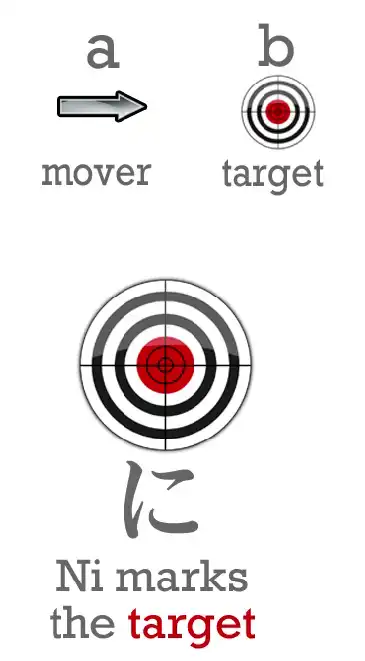
Now, we’ve already looked at the に-particle, haven’t we?
And we know that in a logical sentence it marks the ultimate target of an action.
So “(zeroが)さくらにボールをなげた” means “I threw the ball at Sakura”.
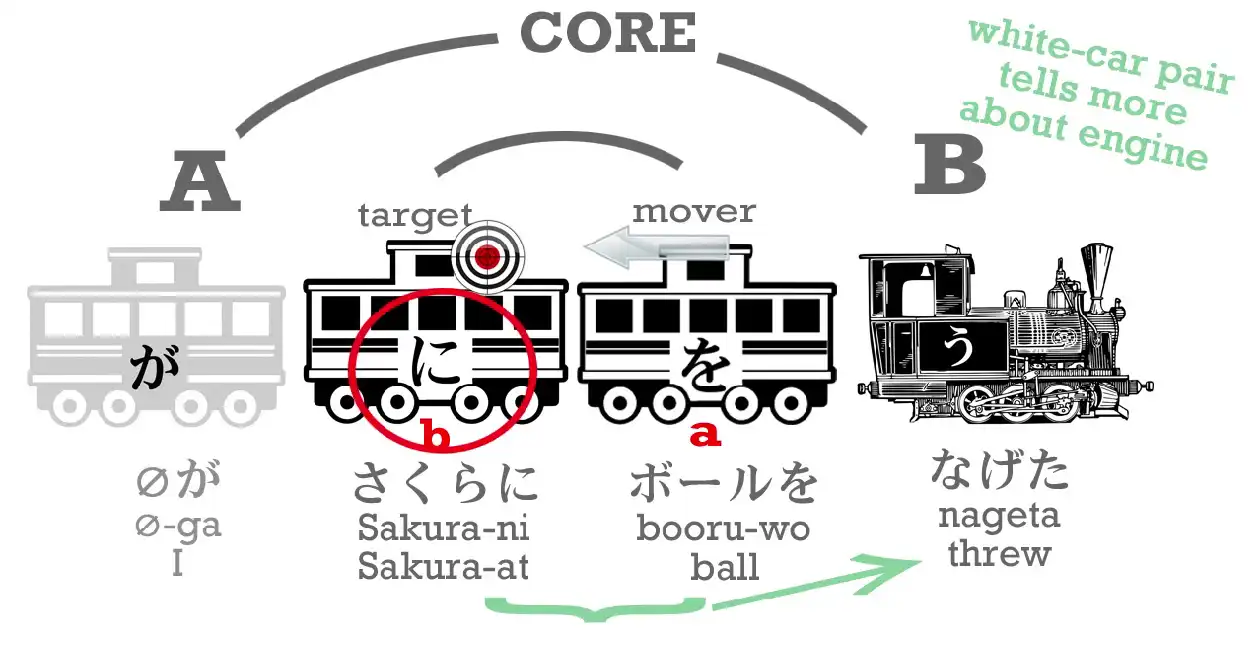
The ball is marked by を because it’s the thing I actually threw.
I am marked by が whether you can see me or not, because I am the one who did the action of throwing.
But Sakura is marked by に because she is the target of that action,
in this case very literally.
Now, the に-particle nearly always marks a target of one kind or another.
So, if we are going somewhere or sending something somewhere or putting something somewhere, we use に for that “somewhere”.
So if A is going to B, then B is marked by に.
B is the destination, the target of that going.
So if I’m going to the park, I say “(zeroが)こうえんにいく”.
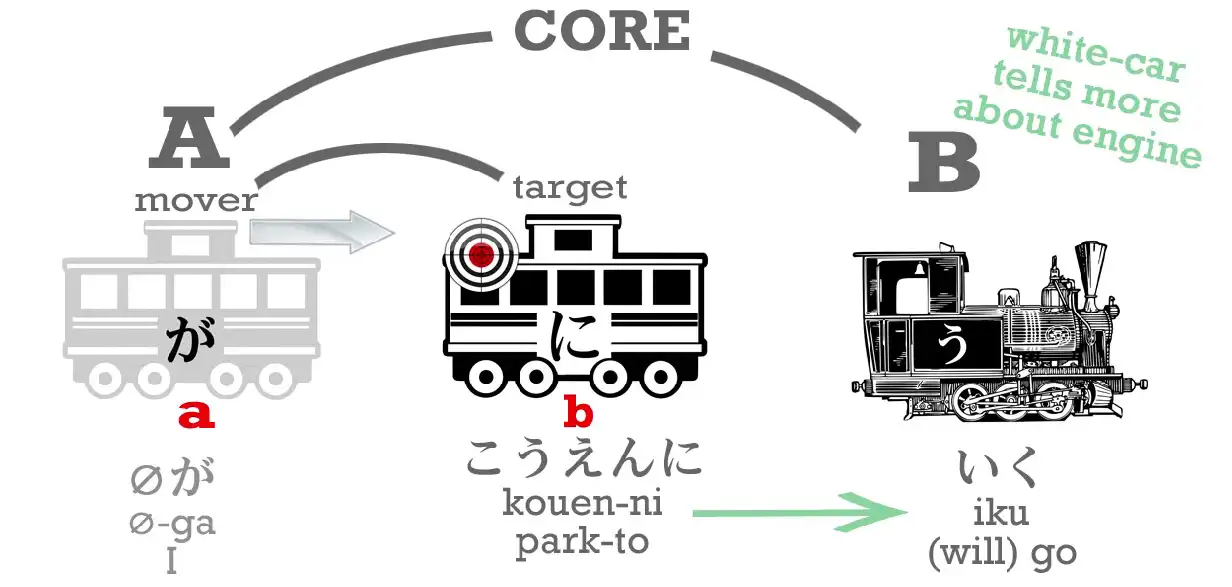
If I’m going to the shops, I say “(zeroが)おみせにいく”.
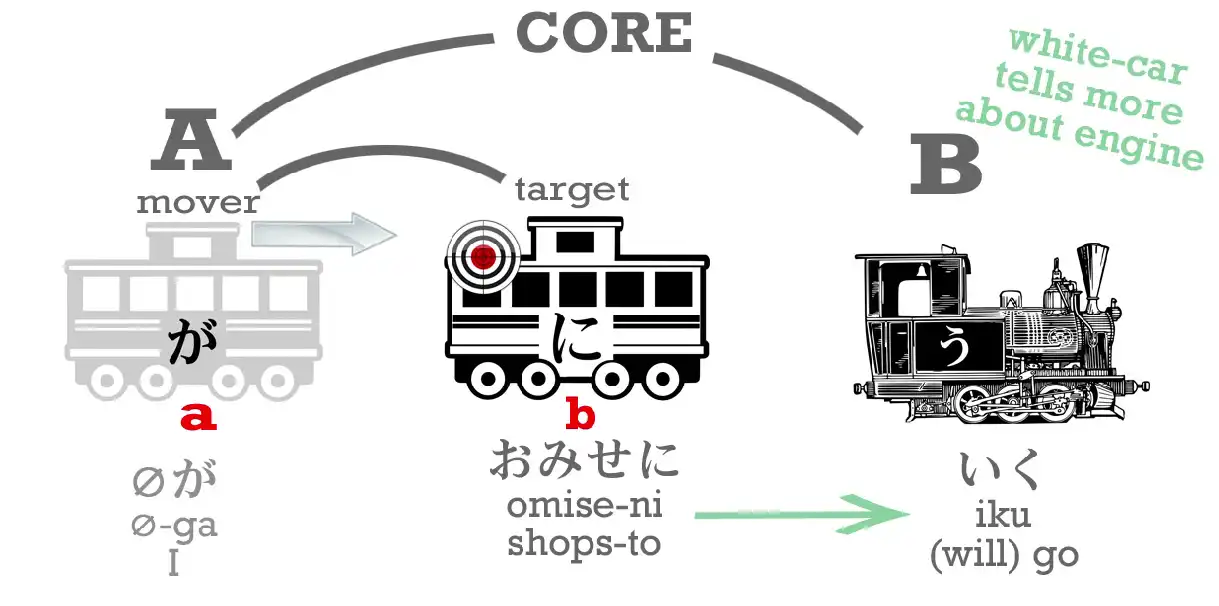
So the literal, physical destination or target of movement is marked by に.
However, we can also mark a subtler kind of target.
So we can say “(zeroが)おみせにたまごをかいにいく”.
This means “I go to the shops to buy eggs”.
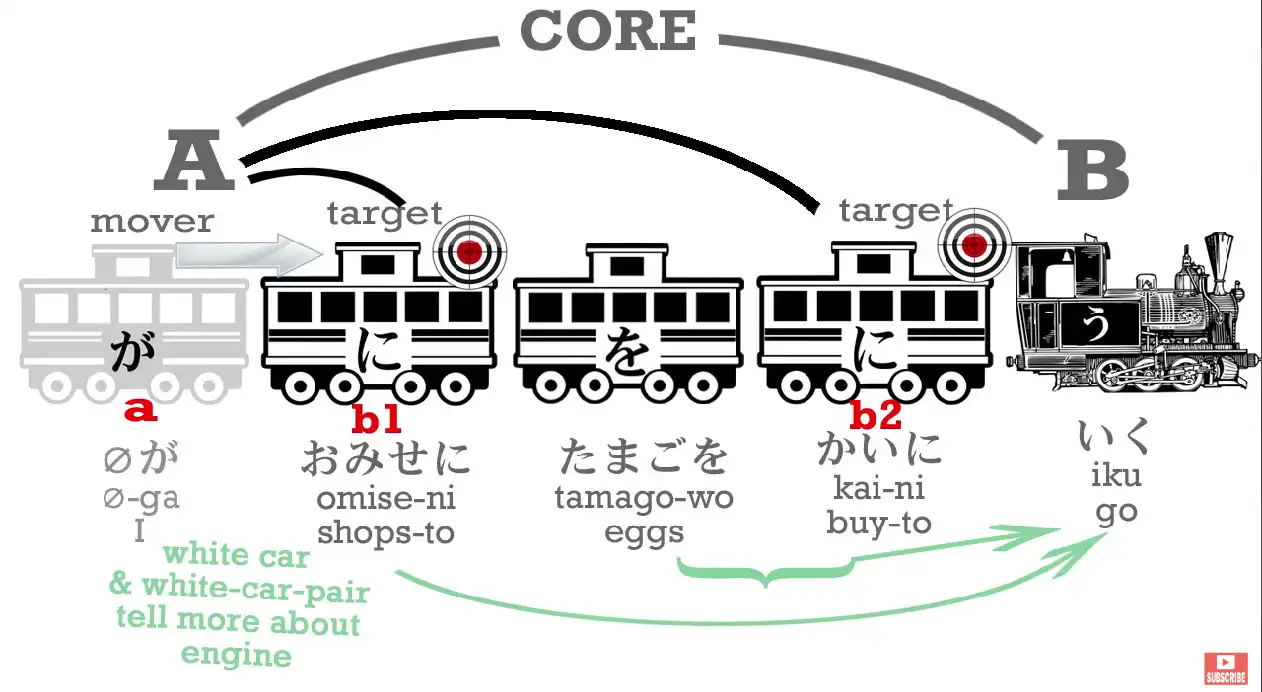
“おみせ” is “shop/s” – “shop” is “みせ” and we put the honorific “お” on it because we
give honor to the people who help us to have all the
lovely things that we are lucky enough to have.
“たまご” are eggs – you might, if you’re old enough, remember たまごっち/Tamagotchi, the little egg-person that you raise.
And “かい” is the い-stem of “かう” – to buy.
The い-stem is a very special stem and it can do lots of things, and it can also just be there on its own.
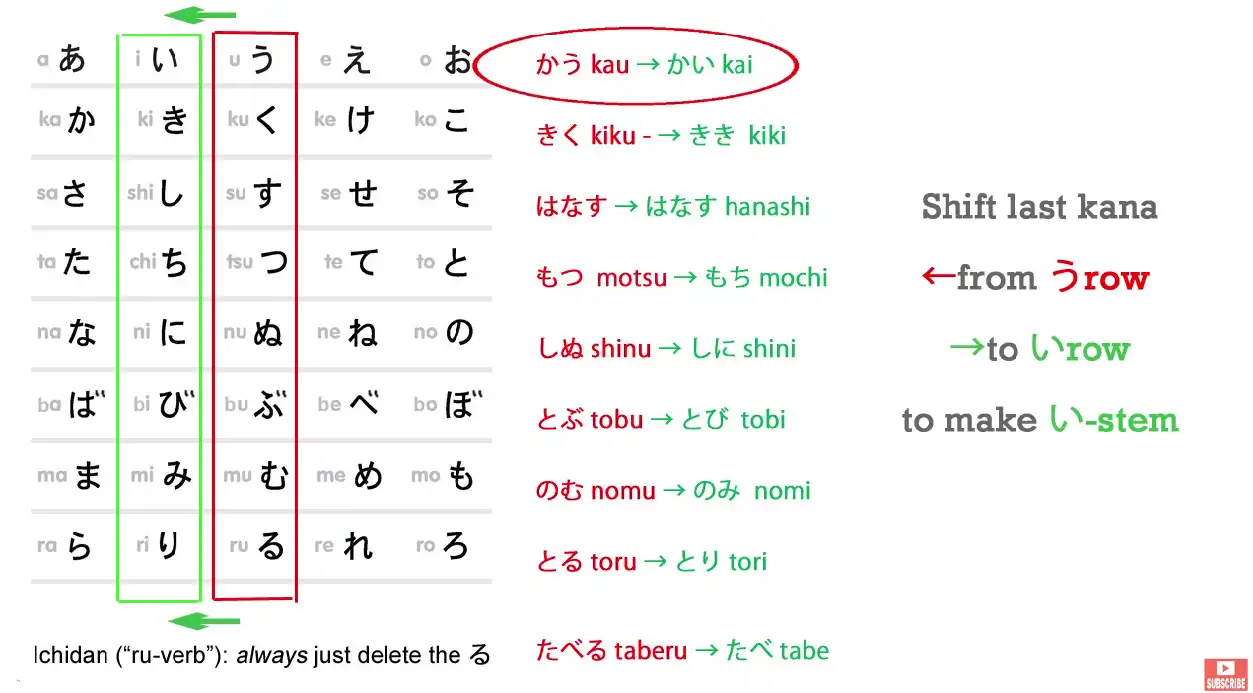
“かいにいく” means “[go] in order to buy, for the purpose of buying”.
Now, you may be saying, “I thought that logical particles like に and が and を can only mark nouns” – and that’s absolutely correct.
Because one of the things that the い-stem of a verb can do when it’s on its own is turn that verb into the equivalent noun. Note: Refer to Lesson 7.5, the い-stem, converting verbs (It can do something else as well, but I can talk about that another day.)
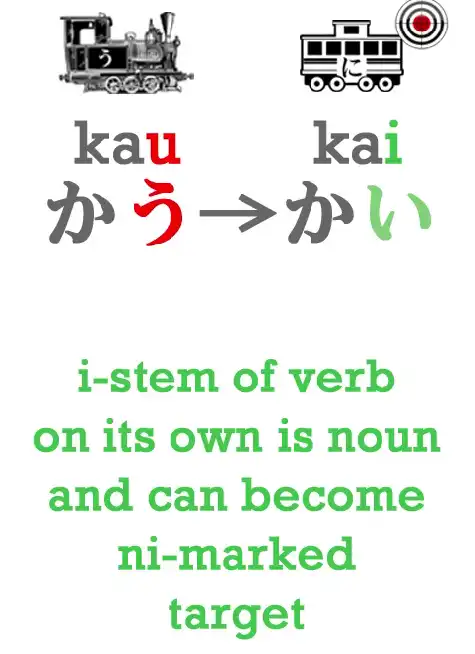
So “かい”, the act of buying, is a noun.
Just as in English if we say “I like swimming”, “swimming” is a noun, swimming is a thing I like, and if we say “I go to the shop for the purpose of buying eggs”, then that “buying” is also a noun, it’s the thing we’re going for.
And “かい” is just like that.
So “かい” is the thing we’re going to do and it’s a noun and it’s marked by に.
So, you see that in this sentence we have two targets:
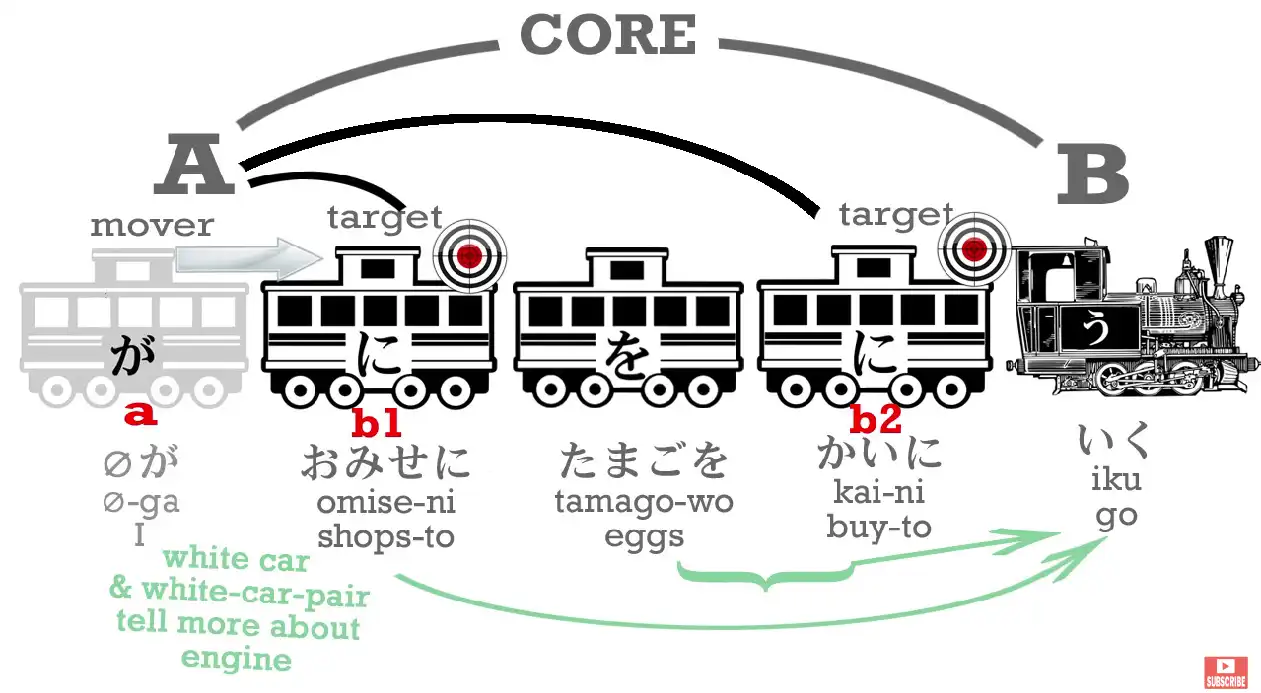
the shops – “おみせ” – is the actual physical target of our going, the place, and buying eggs is the reason for our going, so that’s the emotional target, the volitional target, a more subtle kind of target than the physical place we’re going to, but still a target.
And it’s possible to have two targets in the same sentence, both marked by に.
And that’s exactly what we’re doing here.
So に gives us the target of an action in the most literal sense and also the volitional target, the actual aim of our action.
Now, to get back to more concrete things,
に which marks the actual location target
of where we’re going, of where we’re putting something,
can also mark the place where a person or a thing IS.
So I can say, “おみせにいく” – “I am going to the shops / I will go to the shops” – and we can say, “おみせにいる” – “I am at the shops”.
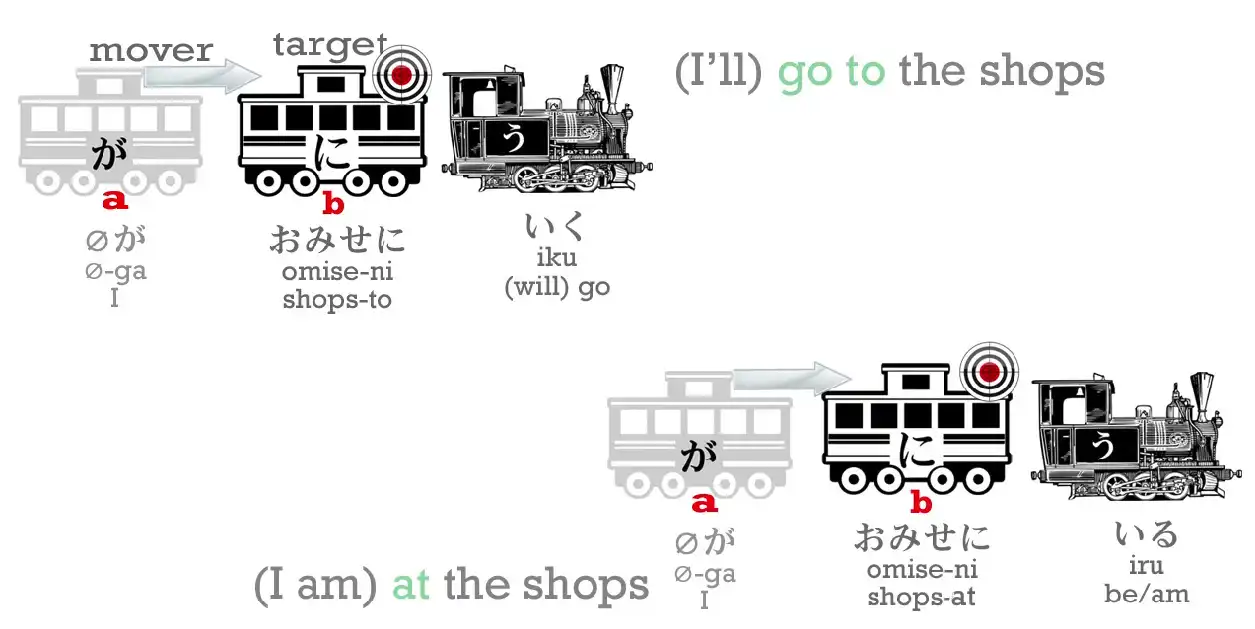
“こうえんにいく” – “I’ll go to the park”; “こうえんにいる” -“I’m at the park”.
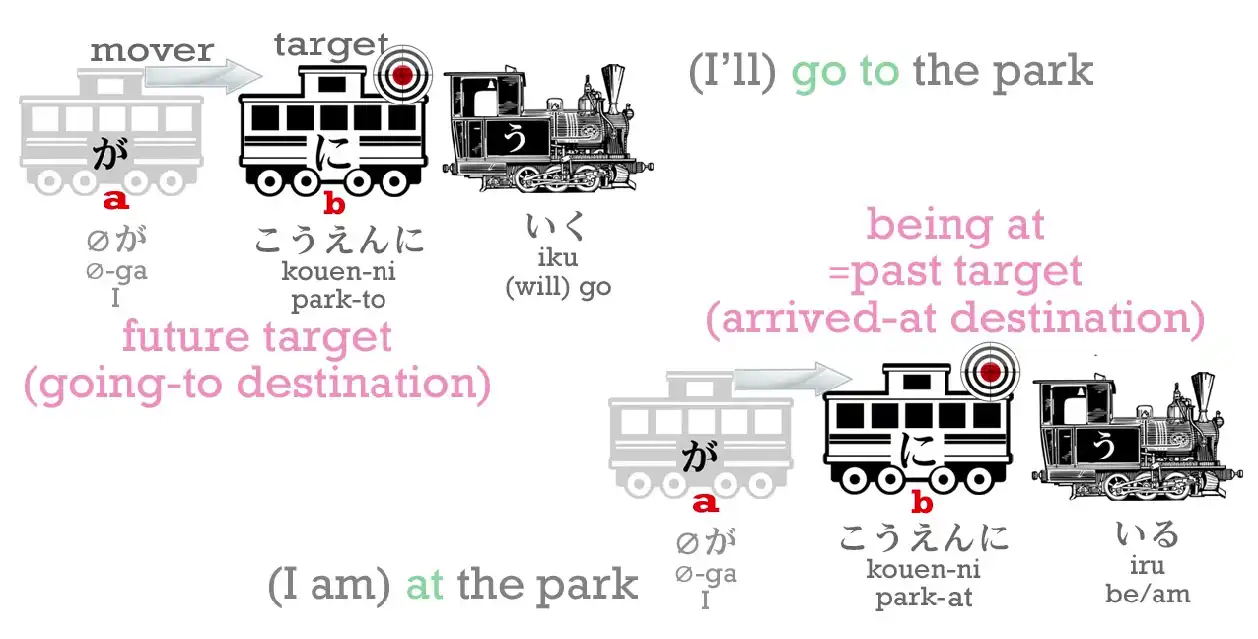
Now you see, this is also a target, because in order for a thing to be anywhere, it must have gotten there at some point.
So “に” can mark not only a future target, a place where I will go to, it can also mark a past target, a place where I went and where I still am.
And we also use this for inanimate objects: “ほんはテーブルのうえにある” – “The book is on the table”.
“うえ” is a noun, and in this case it means the “on” of the table.
“うえ” can mean “up” or “over”, in this case it means “on”, and it’s always a noun,
so in this case the “on of the table” is the place where the book is:
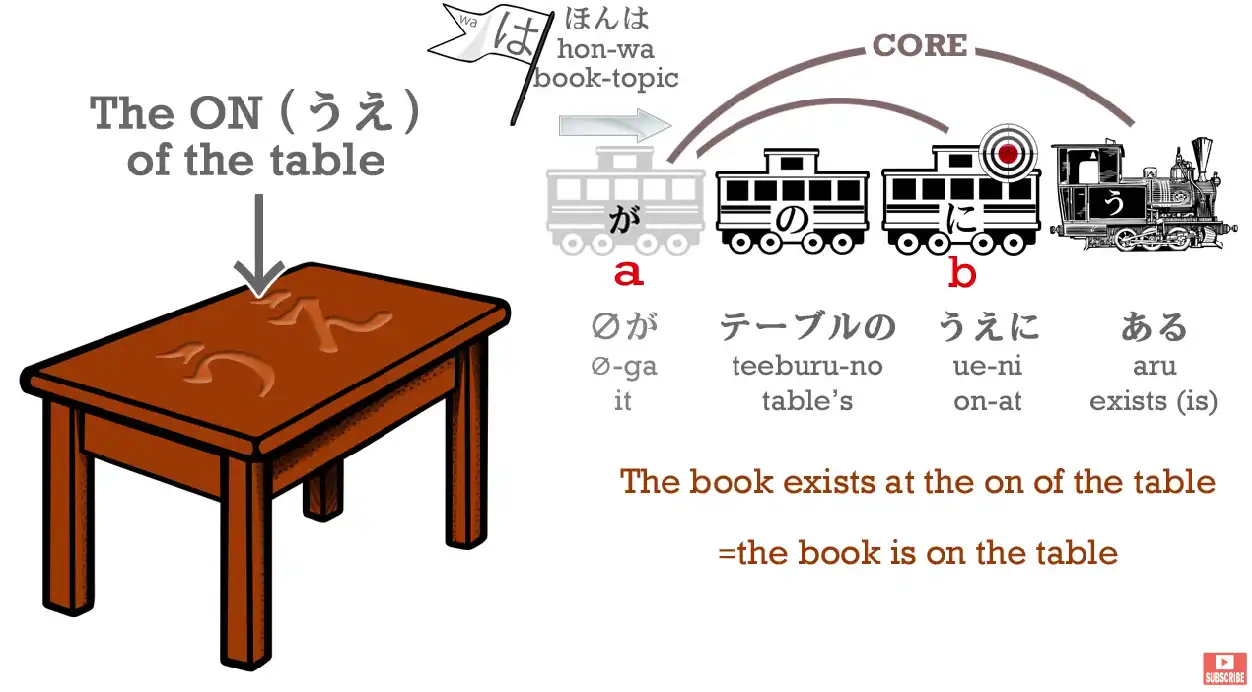
the past target of the book, to which it went and at which it now remains.
So に can also mark the place where a thing is, its past target.
#
に marking the target of a transformation
And the last aspect of “に” that I want to look at is that に can also mark the target of a transformation.
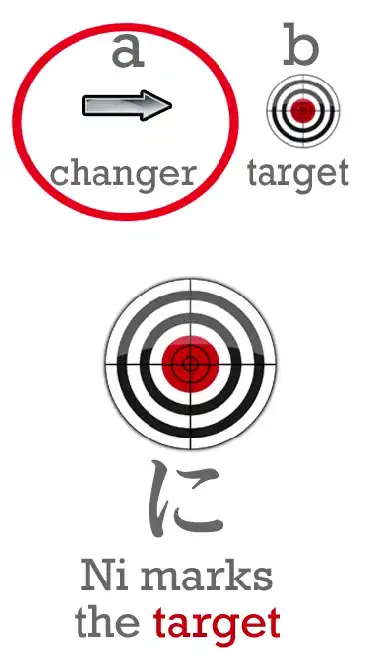
Just as if A is going to B, に marks B, the place where it’s going,
if A turns into B, becomes B, then に also marks B,
the thing it’s becoming, the thing it turns into.
So if I say, “さくらはかえるになった”…
“かえる” is “frog” and “なる” is a close cousin of “ある”:
“ある” means “be”; “なる” means “become”.
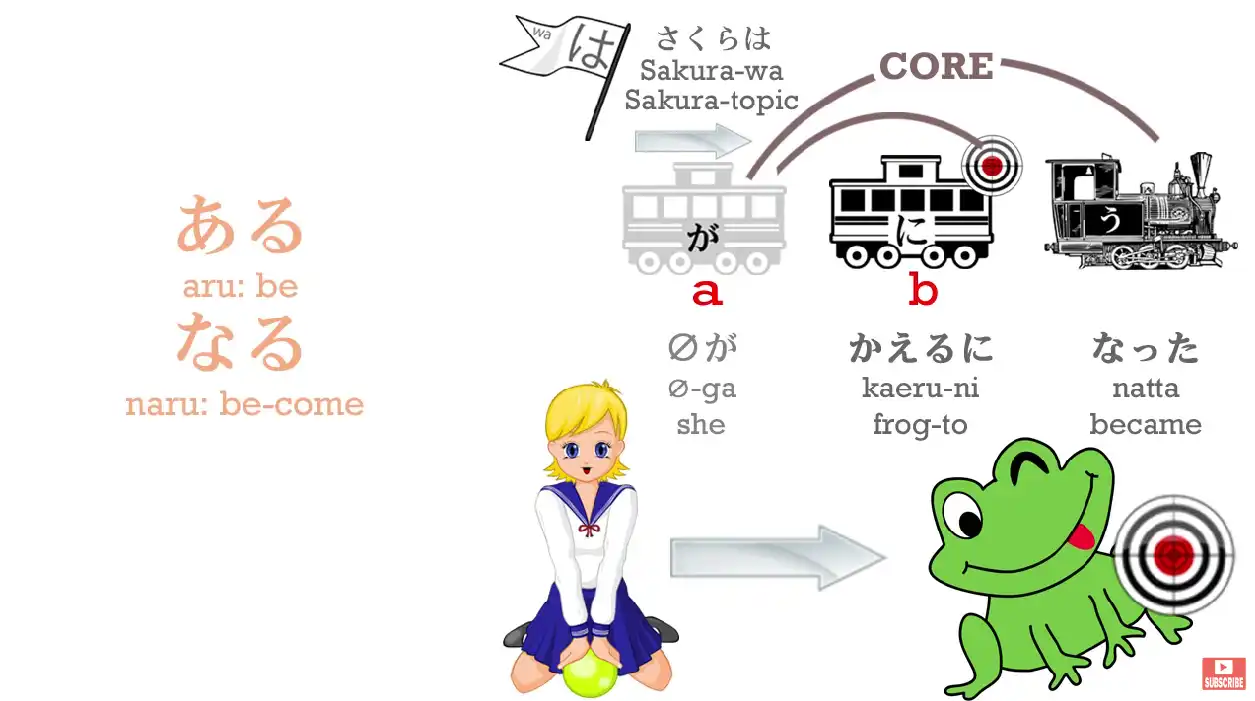
So, “さくらはかえるになった” – “Sakura became a frog / Sakura turned into a frog”, and に marks the thing she became, the thing she turned into.
Now, you may be thinking, “Mmm, how often do people turn into frogs these days?” – and I’ll grant that it isn’t very often.
However, this is a very important thing to learn because there are various more everyday things that turn into other things and also we use this form of expression much more in Japanese than we do in English.
For example, “ことし(zeroが)十八さいになる”: “ことし” is “this year”, “十八さい/じゅうはっさい” is “18 years of age”.
So we’re saying, “This year (I) become 18”. Or as given: “This year (I) 18 years old-to become”.

Now in English we’d say that a little differently: we might say, “I turn 18” or “I’ll be 18”, but in Japanese we say “I will become 18 years of age”.
And if the day’s going to get cloudy, we might say “あとで(zeroが)くもりになる”
(“くもり” is “cloudy”; “くも” is a cloud, “くもり” is the state of being cloudy,
and both of them are nouns).
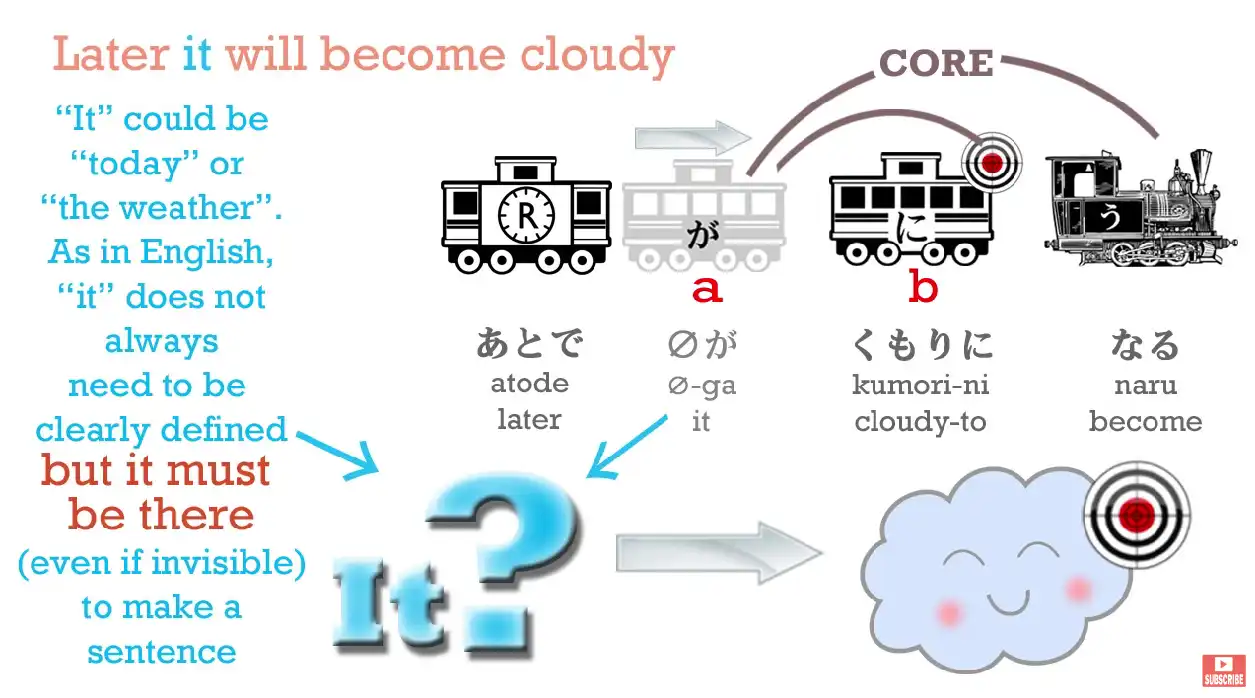
We say, “くもりになる” which means “become cloudy”. Or as given: “Cloudy-to become”. In English we could say that.
We might be more likely to say “get cloudy” or something, but in Japanese we use this “become” – “になる” – form of speech a lot of the time.
So it’s an important thing to learn.
#
に in the case of adjectives (aka using them as adverbs)
And I should just add here than in the case of an adjective it works slightly differently.
So if we want to say “Sakura is beautiful”, we say “さくらがうつくしい” (“うつくしい” means “is-beautiful”), but if we want to say “Sakura became beautiful”, we can’t use に because “うつくしい” isn’t a noun.
It isn’t a carriage, it’s an engine, isn’t it? Note: うつくしい is an adjectival/い-engine. So what do we do?
What we do is what we discussed last week: we turn that adjective into its stem.
So we take off the い (-i) and add く(-ku). Note: The stem is うつくし, and then add く.
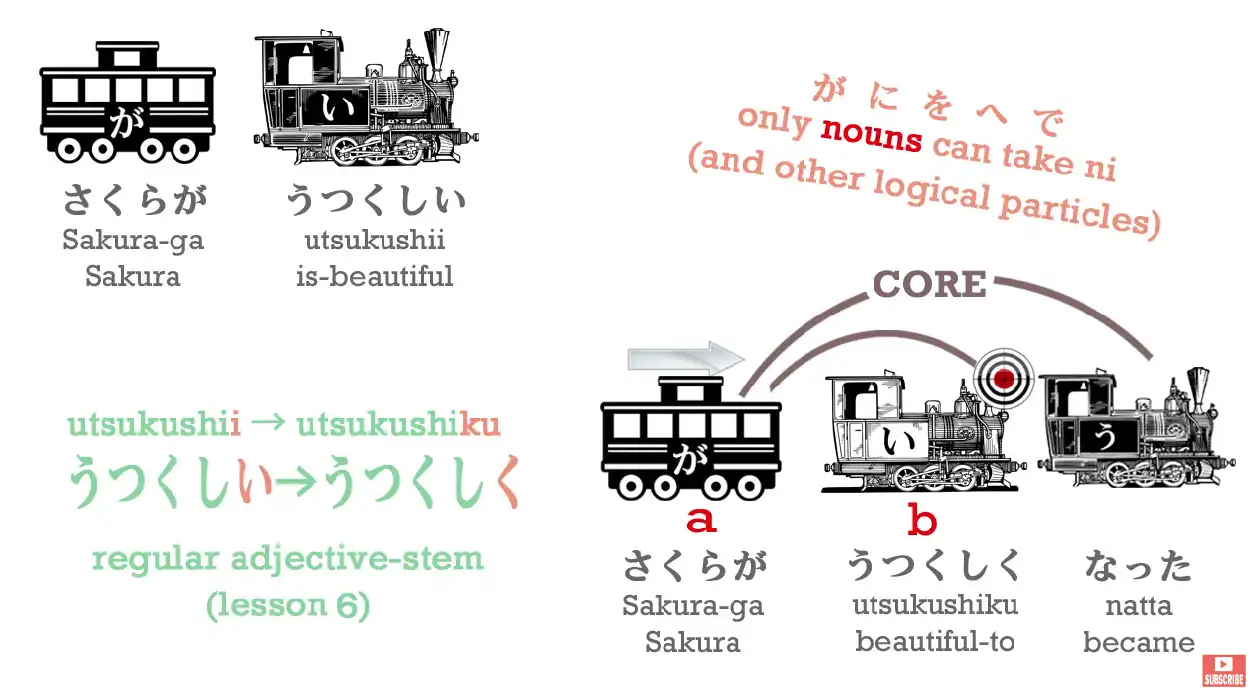
Note: the く is turning うつくしい into an adverb/adverbial noun. More on that in Lesson 41.

And that’s all we need to do.
That’s how we use it: “さくらがうつくしくなった” – “Sakura became beautiful”.
“なった” is the past of “なる” because “なる” is a godan verb
(it has to be a godan verb because it doesn’t end in -いる or -える, it ends in -ある).
So now we know some ways of expressing subtler concepts like intention, purpose, transformation – and we have leveled up.
The へ Particle
Before we finish, I’m just going to give you one more carriage that we haven’t seen before, and that’s the へ-car. And this is very, very simple.
The particle “へ” – as you see, this is the kana へ (he), but when we use it as a particle we just pronounce it え.
And it’s a very simple particle. It’s a one-trick pony.
And it duplicates one, and only one, of the uses of “に”.
So when we say where we’re going - “A is going to B” – we mark B with に.
We can also mark it with へ.
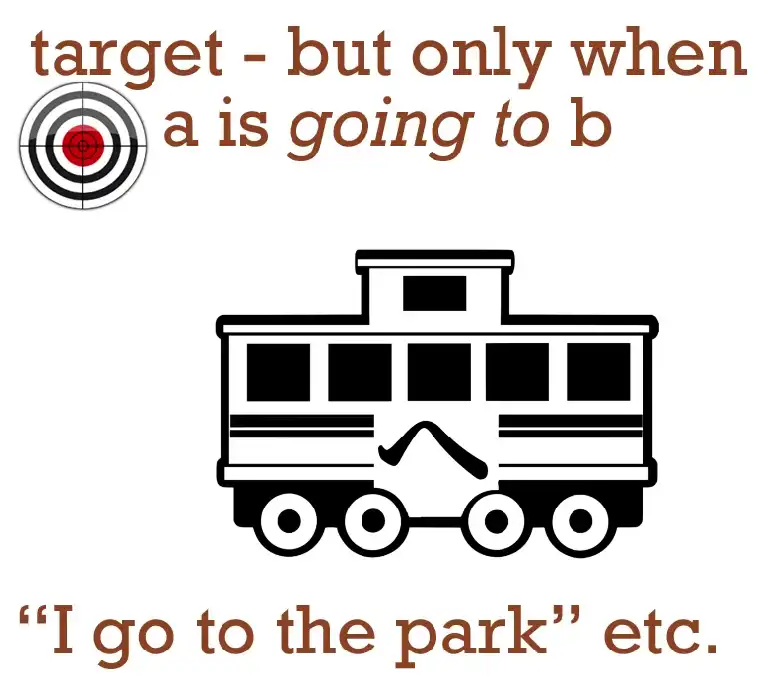
And that’s the only thing へ does. As I say, it’s a one-trick pony.
It can’t even mark the place where something has gone to and still is.
It only ever marks the place a thing is going to. Note: a direction, more on that in 8b. “へ” is very simple and it’s good to have another particle, another carriage, added to your arsenal, isn’t it?
8b. Particles explained.
Lesson 8b: Japanese particles explained. How they REALLY work. こんにちは.
Today we’re going to get the key to every Japanese sentence.
We’re going to do a round-up of the logical particles – and the logical particles are the linchpins of Japanese.
With a full understanding of what they do you can understand every Japanese sentence.
Without it, you can’t.
And that’s why the Japanese taught by the textbook which doesn’t explain the logical particles correctly leaves most learners non-functional in Japanese even after they’ve passed exams.
So, I’m going to do a round-up of the logical particles we’ve learned so far and I’m going to introduce the last major logical particle, which is the で-particle.
I’m going to do this with an analogy of detective work, because the logical particles essentially interrogate the nouns in the sentence and show how they relate to each other and to the verb of the sentence, and they give the structure of the sentence.
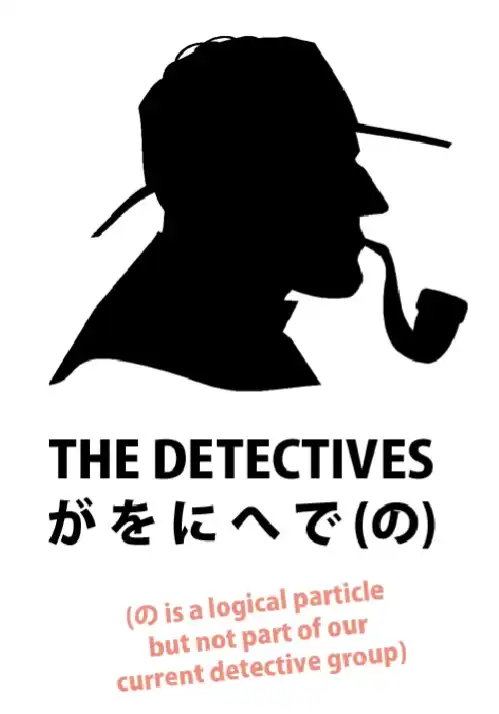
And this is what a logical particle is.
People sometimes ask “What do you mean by a logical particle?”
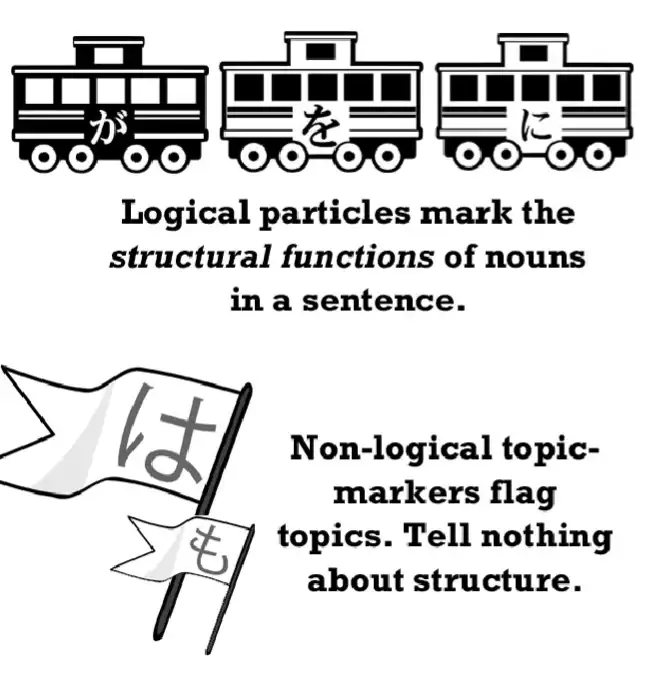
We’ve already discussed the difference between a logical particle and a non-logical topic-marker.
A logical particle tells us how the sentence logically holds together.
It tells us who does what to whom, with what, where, when and so forth.
The は-particle doesn’t do this, it just tells us what is the topic we’re speaking about.
There are other particles that I would call a-logical.
They’re not non-logical topic markers, but they’re not logical particles either.
For example, the particle -と adds two nouns together.
So if we say “さくらとメアリーがあるいていた”, we’re saying “Sakura and Mary were walking”.
The が-particle tells us who was doing the walking.
The と-particle simply adds those two together. It doesn’t tell us anything about what they were doing, where they were going, or anything else.
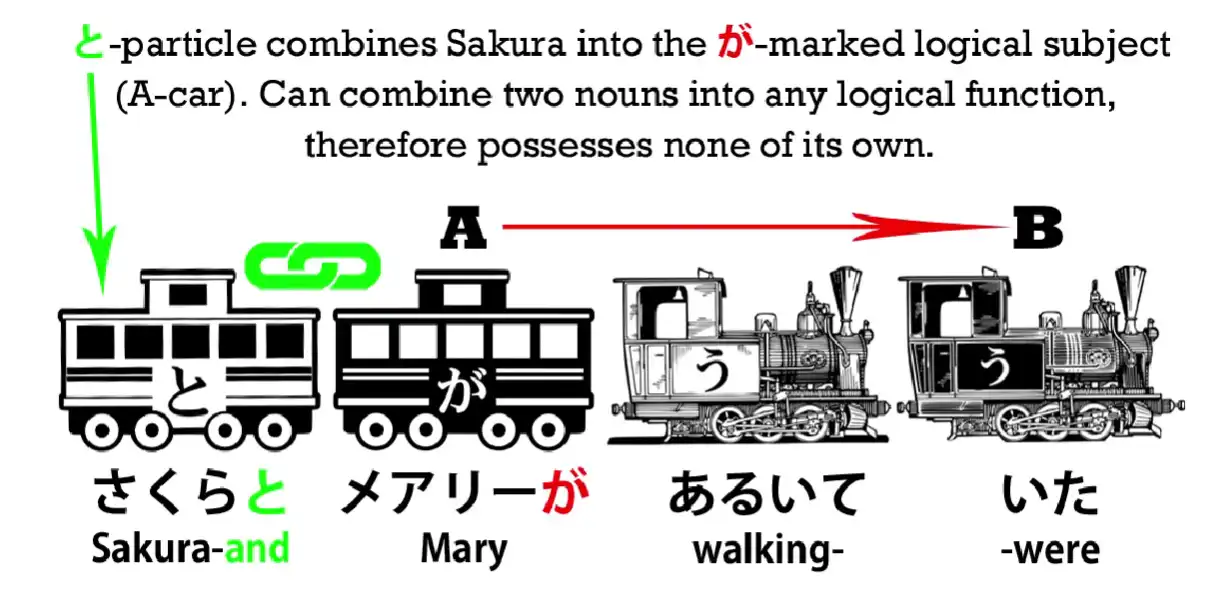
So, the logical particles are the ones that tell us what is actually happening in the sentence.
The other thing to remember about logical particles is that they always attach to a noun.
If you see a logical particle attaching to anything, you know that that word is in fact functionally a noun.
And we must always see the noun plus the particle attaching to it as an inseparable pair.
The two work together.
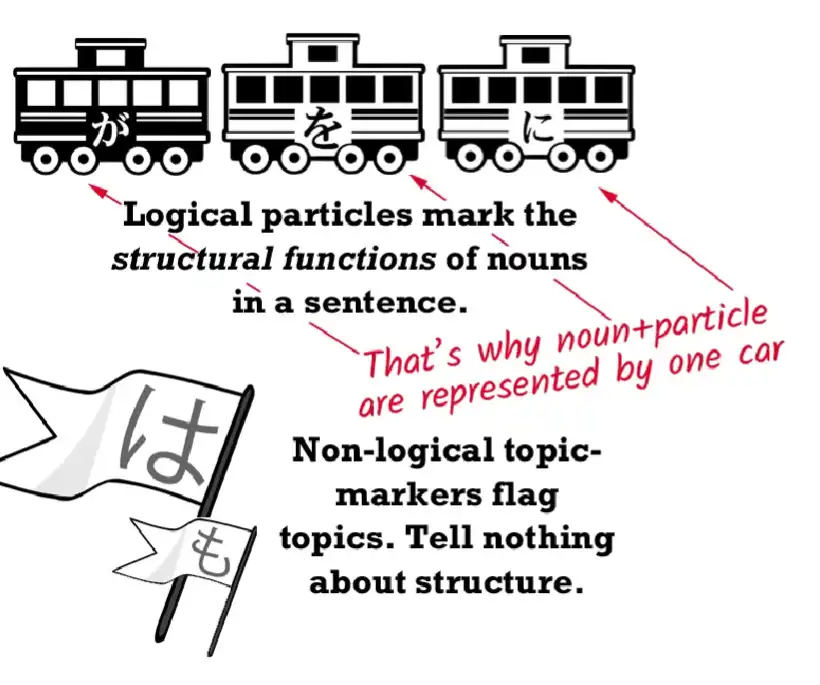
They are a question and an answer which form a fundamental unit of a Japanese sentence.
All right. So let’s look at this.
Particle が
The head of the Logical Particle Detective Agency is Detective が.

He is the Chief.
He has to be in every case.
There can’t be a sentence without が, as we already know, although sometimes you can’t see him because he’s in disguise, just like Sherlock Holmes is sometimes in disguise.
He also has powers that the other logical particles do not have.
He can work in A-is-B sentences, that is, descriptive sentences, sentences that tell us what something is, what its qualities are.
The other particles can’t do that.
They can only work in A-does-B sentences, that is, sentences with a verb engine.
To put it another way, while Detective Ga works in the office with descriptive work, the other detectives only work on cases, on actual actions, on incidents, on verb-ending clauses.
So, let’s look at them all at work on a verb-ending clause.
Each of them has its own specific questions.
Detective が asks the fundamental question: “Who did it?” This is the fundamental question of any sentence, and for that reason, only Detective が’s carriage can be black.

Because the core of every sentence is “who did the action?” So が asks, “Who was the actor? Who dunnit?” and that forms the core of the sentence.
The other logical particles ask other questions about the incident which give us a complete picture of the event.
We won’t usually see all of them in any one sentence.
Particles を, に, へ
Detective を asks “Who was it done to? Who was the receiver of the action?” Detective に asks “Where did he go?” or “Where is the weapon?” に asks where someone or something went to or where it is.
Detective へ asks “In what direction did he go?” Now, this is very close to Detective に’s question, isn’t it?
But we may not actually know where he went, so the answer to that question could be north, south, east or west, and that’s the kind of question that に can’t ask.
Or it could be “He went in the direction of Sakura’s house”, and that’s very close to the question that に does ask.
So they overlap to quite a degree.
Particle で
Now let’s look at Detective で.
Detective で asks the question “Where was it done?” and the question “With what was it done? What was the weapon?”
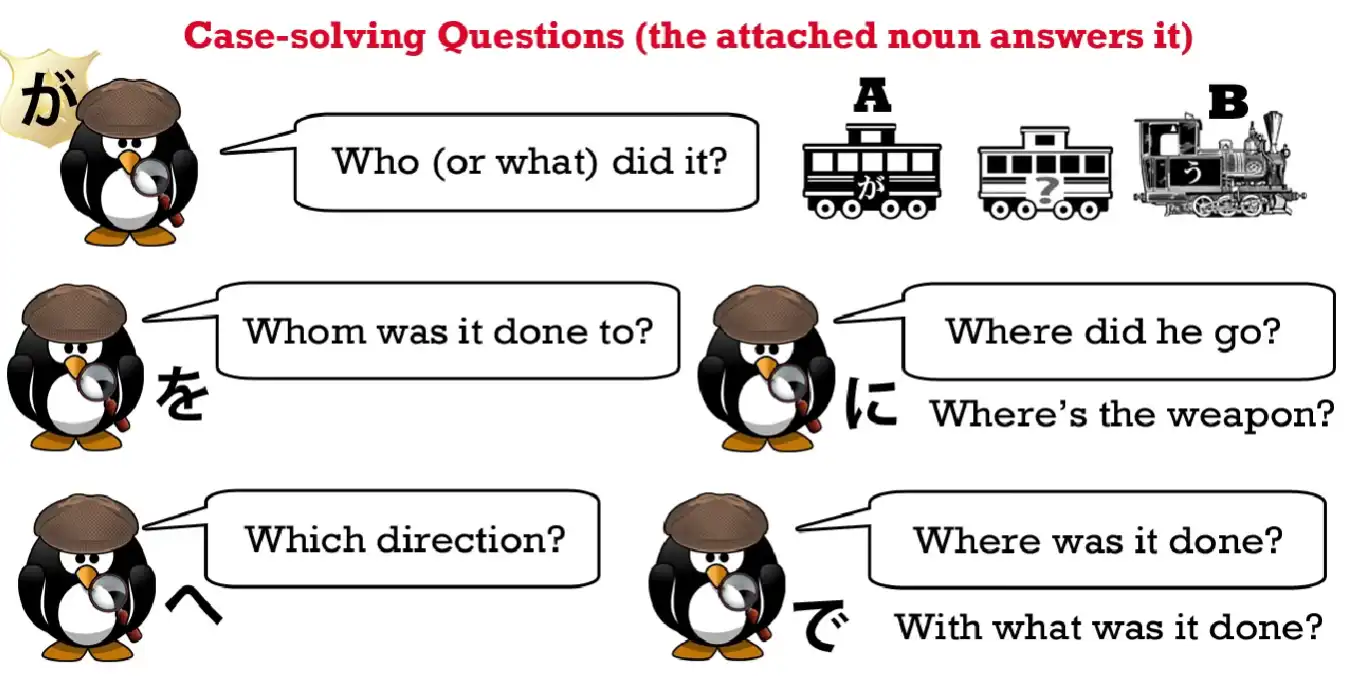
If we say “(zeroが)こうえんにいる”, we’re saying “(I) am in the park”.
But if we want to say “(I) am playing in the park”, we have to say
“(zeroが)こうえんであそんでいる”,
because to express that we are doing something in a place rather than just being there, we have to use で.
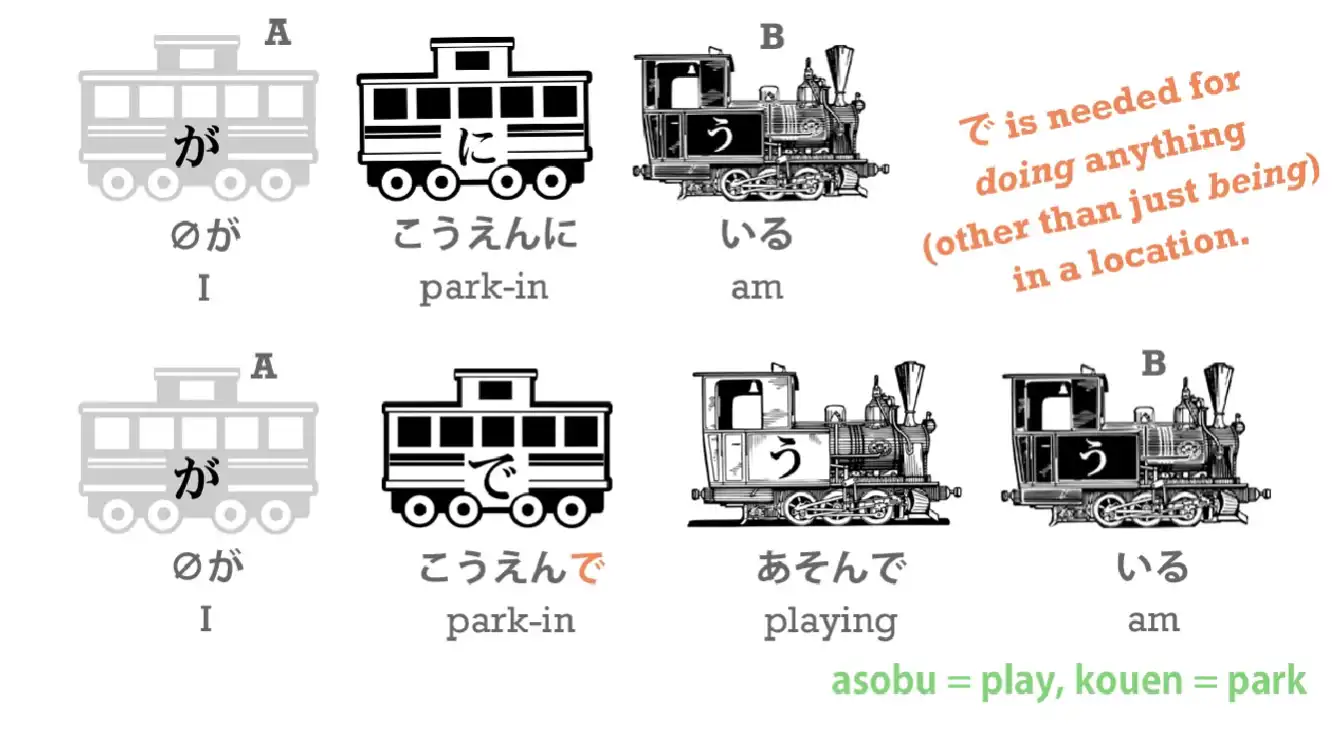
And we also use で to express the means (in terms of a noun) by which we do something.
So if we say “(zeroが)こえうんにいく”, we’re saying “(I) go to the park”.
But if we say “(zeroが)バスでこうえんにいく”, we’re saying the means by which we go to the park, in this case a bus.
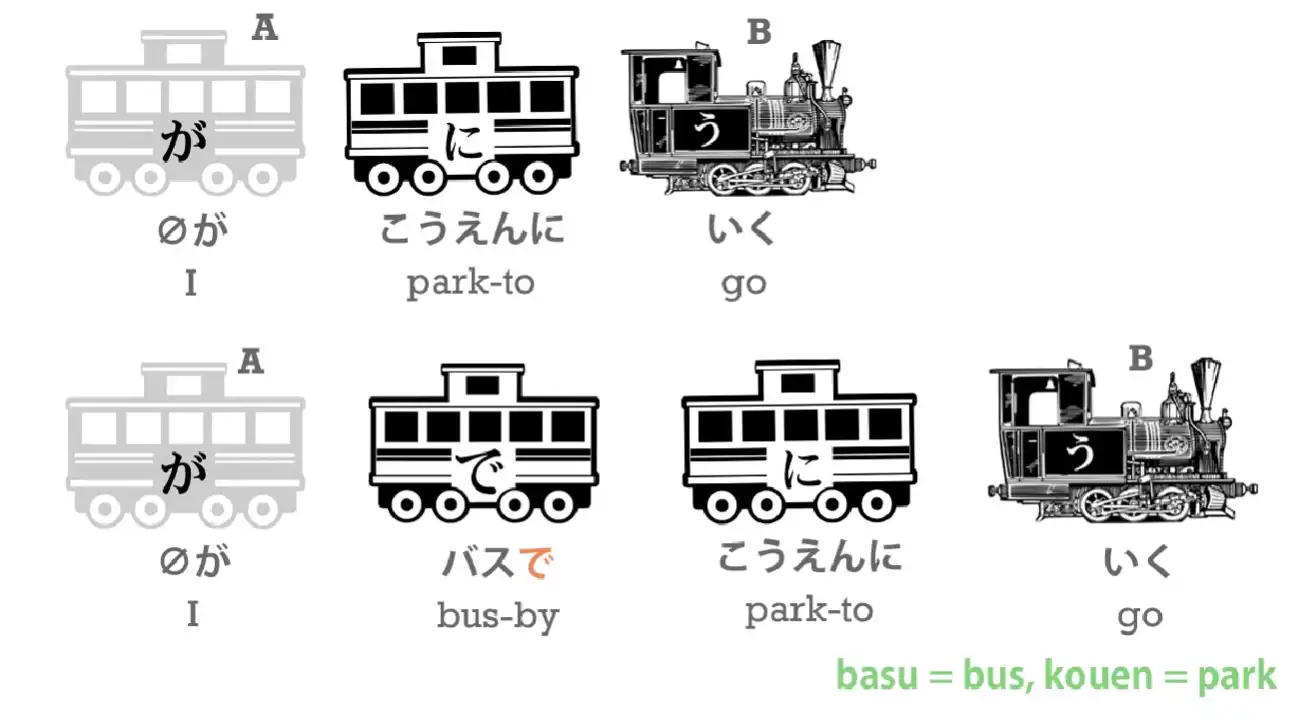
If we say that we knocked in a hammer with a nail or ate food with chopsticks, we use で for the thing we did it with.
If we say “(zeroが)にほんごをはなす”, we’re saying “(I) speak Japanese”,
but if we say “(zeroが)にほんごではなす”, we’re saying
“(I) speak with Japanese/Japanese is the means by which (I) speak”.
So this is equivalent in English to saying “I speak in Japanese”, but as you can see, the Japanese construction is more logical because that actually is what we’re doing, we’re speaking by the means of Japanese.
The other question, of course, that Detective に can ask is
“Who was the target of an action done to something else?”
but we’ve already discussed that in the に lesson. (Lesson 8)
So this covers all the basic functions of the main logical particles, and as you can see,
these are the particles that tell us what’s going on in any Japanese sentence.
If we understand them, we can understand the sentence; if we don’t understand them, we can’t.
So if we get confused by the logical particles, which we will if we take the textbooks seriously, we’ll have a lot of trouble understanding Japanese.
Don’t confuse the particles and they won’t confuse you.
9. The Subject of the Japanese Sentence & Expressing Desire: ほしい, たい, たがる
Lesson 9: How textbooks DESTROY your Japanese: No 1 Secret! + Expressing desire: hoshii, tai, tagaru
The Subject and ego in Japanese vs English
Japanese and English have very different world-outlooks. In some ways they are diametrically opposed. English is a very ego-centric language.
And this isn’t some kind of a moral statement: I’m talking about grammar.
English wants to have an “ego” as the main actor, the center of every sentence, if it possibly can. Preferably “me”, if not “me” then someone else, and if not a person then at least an animal.
It has to be some kind of “ego” actor.
Dolly seems to refer to Subject as the Actor sometimes and uses them interchangeably it seems, so just keep that in mind that by Actor she SHOULD mean Subject. This use may become confusing later in the Passive/Receptive if you know some basic linguistics… but maybe just a “me” problem… Japanese doesn’t work like that at all. It’s very happy to have non-sentient beings as the main actor of a sentence. You might call this a more animist way of looking at language.
Now, this may sound rather abstract, but it’s not abstract at all. Let’s get into some concrete examples. I’m going to begin with my favorite example, and if you’ve heard it before, don’t go away because we’re going much deeper this time.
My favorite example is: “わたしはコーヒーがすきだ.” Now, we can have the “わたし” or we can not have it (or rather do not need to have it); it will be understood whether we say it or not.
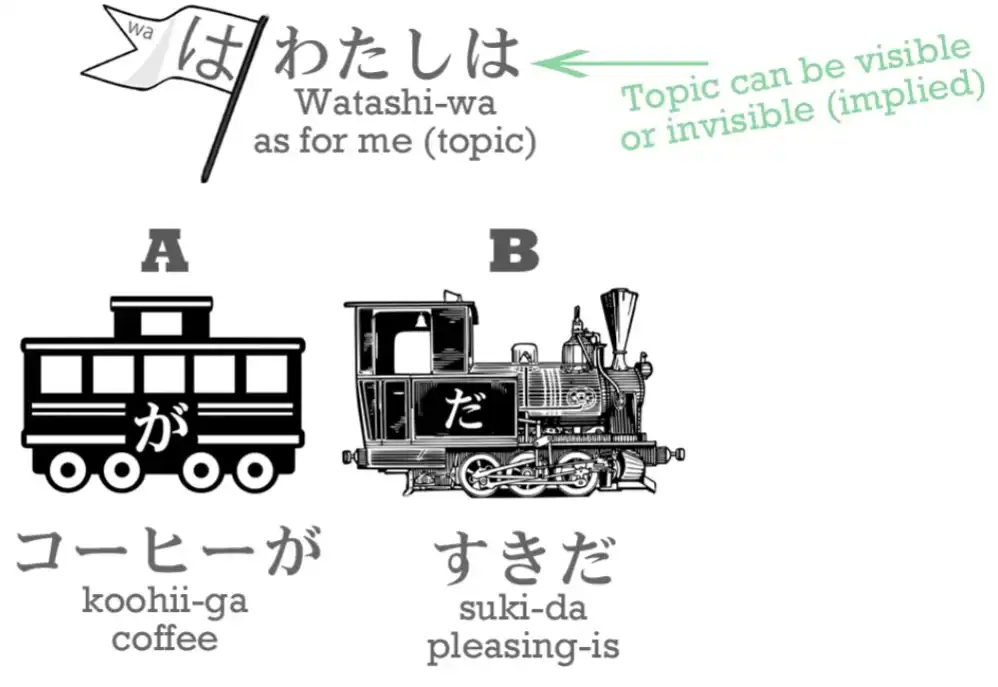
What the textbooks and the schools and everybody else tells you is that this means “I like coffee”. And “I like coffee” may well be what we would say in English if we wanted to say something similar, but it’s not what this sentence means. And if you’ve followed the course up to this point, you can see why it isn’t.
The first and most important point here is – look where the が is. The が is marking the coffee.
We know that the main actor (Subject in Active voice), the doer or the be-er of a sentence, is always marked by が, so we know that the main actor of this sentence is not “わたし” –”I”, it is the coffee, which is marked by が.
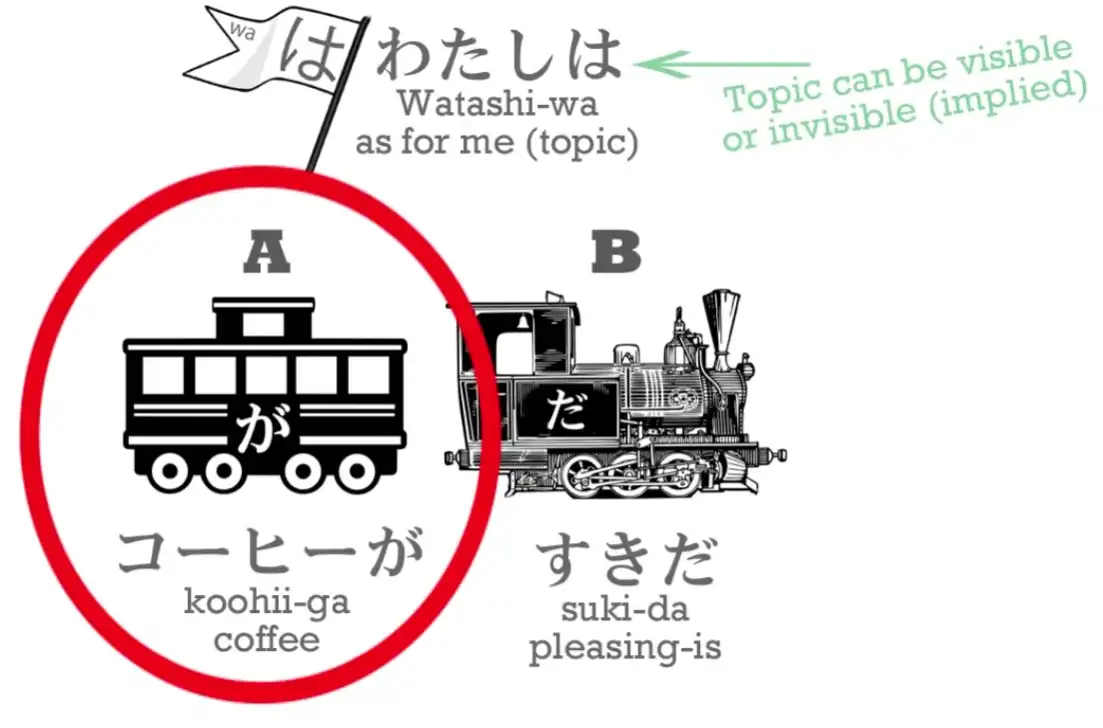
“わたし” could have an invisible が after it, but in this case it can’t, because we already know what the が is, it’s the coffee. So the coffee is being or doing something.
In English we are told that it is an “A does B” sentence, but we only have to look at it to see that it isn’t.
It ends with “だ” – it’s an “A is B” sentence, isn’t it?
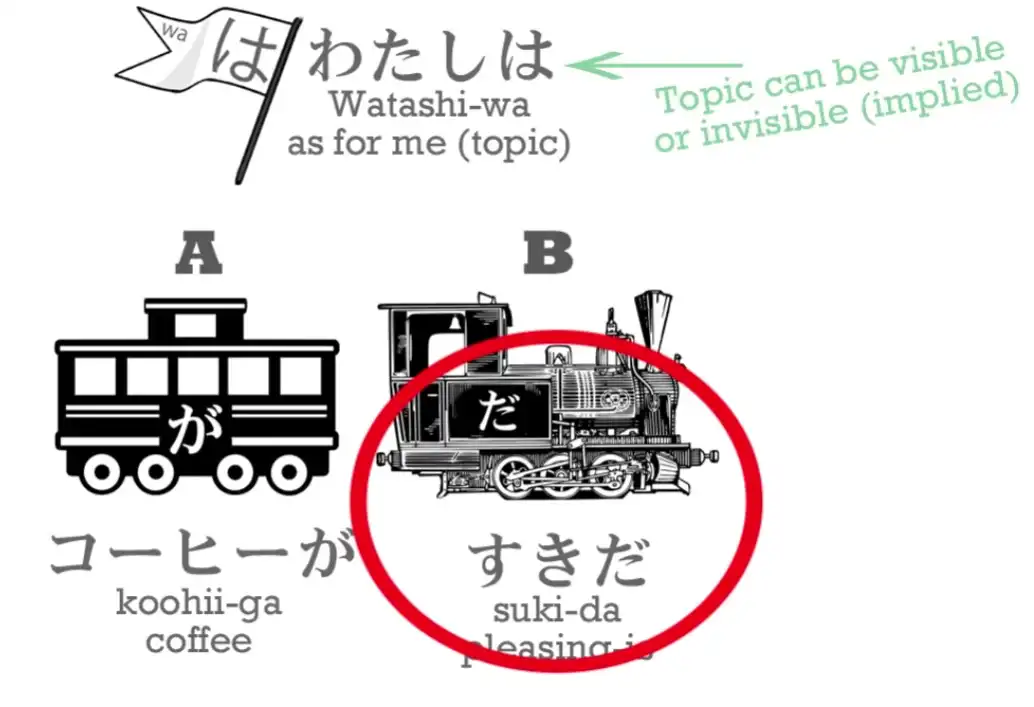
The coffee is “すき”.
So, what does “すき” mean? “すき” is a noun, and it’s one of those adjectival nouns that we’ve talked about before. So it’s telling us something about the nature or condition of the coffee. In this case, what it’s telling us is that the coffee is pleasing. That’s the core of the sentence: “Coffee is pleasing.”
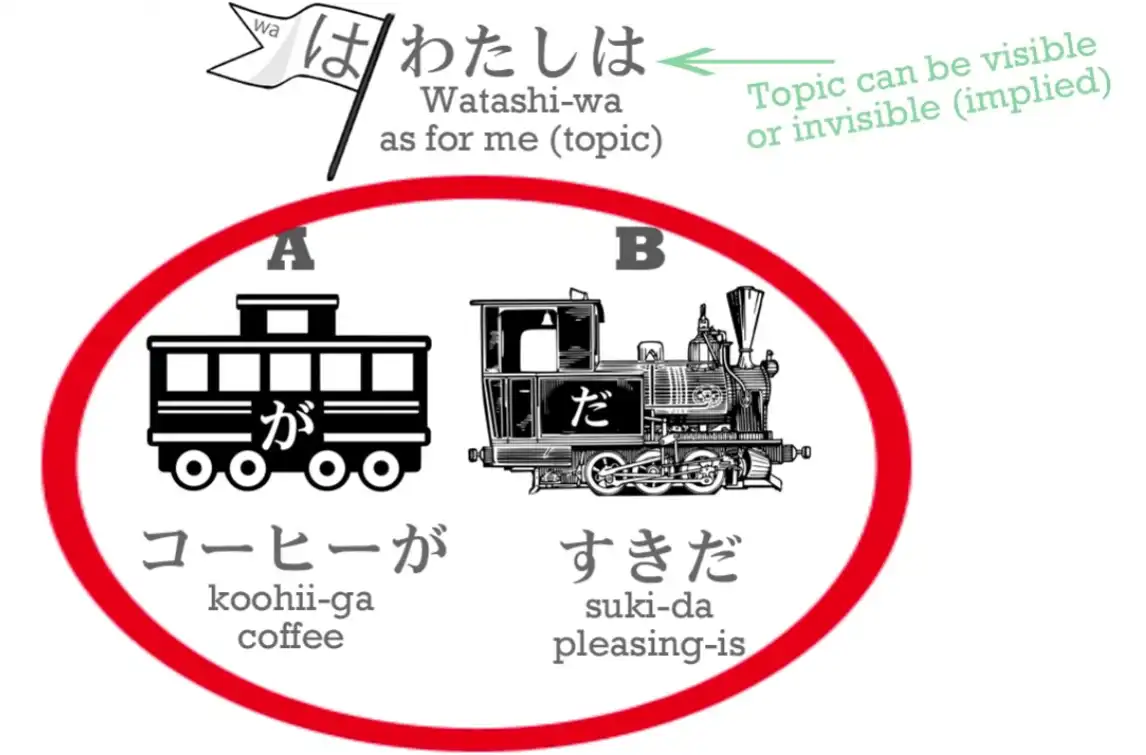
The “わたしは”, implicit or explicit, is telling us in whose case it is pleasing: “As for me, coffee is pleasing.” Now, this is very very very important.
Because if we don’t know that, if we really believe that this sentence means
“I like coffee”, our grasp of が and を is completely messed up.
If the actor of this sentence was “わたし”, it would have to be marked by が.
If the thing that the actor was acting upon, by liking it, was the coffee, then it would have to be marked by を.
So we have two particles, and two most fundamental particles, completely confused in our mind. We now believe that sometimes が can mark the object of the sentence instead of the subject, the thing acted upon instead of the be-er or doer of the sentence. And we now believe that the object of the sentence, the thing being acted on, can sometimes be marked by が instead of を. And none of this is true. It never can. That can never happen. And if that could happen, Japanese would become chaos. And that’s exactly what it does become in the minds of many students.
So, as we see in this sentence, “わたし” is the non-logical topic of the sentence.
It’s marked by は. It’s not the actor. It’s not the subject.
“コーヒー” is not the object, which would be marked by を if it was.
It is the subject.
And “すき” is not a verb meaning “to like”; it’s an adjective meaning “to be pleasing”.
So every single word in this sentence is being misdescribed by the standard explanation.
And this kind of misunderstanding throws Japanese into complete chaos.
Now, are there many cases like this in Japanese?
Well, frankly, it doesn’t matter if there are many or not.
Once your understanding of the particles is messed up, it’s messed up.
But as it happens there are a lot.
All kinds of different sentence structures in Japanese throw up this same misunderstanding.
For example, if we say “ほんがわかる”, or “わたしはほんがわかる”, we’re saying
the book is understandable, but the English texts tell you that this means “I understand the book”, and in this case it’s even less forgivable, because there isn’t really an equivalent to “すき” in English, but there is an equivalent to “わかる”.
It means “understandable” or “clear”.

We could say “In relation to me, or just to me, the book is understandable”, and then we wouldn’t be completely messing up what が does or thinking that a noun that should be marked by を can be marked by が, at random.
So why, at least in this case, don’t the schools and textbooks simply translate it as it really is?
“To me, the book is understandable / Speaking of me the book is understandable.” Because this prejudice for putting an ego at the center of every sentence is so strong that it takes precedence over learning Japanese correctly.
And these are not just a few random cases.
Later on, we’re going to look at the potential form (lesson 10) and we’re going to look at the receptive form (lesson 13), which is misdescribed as passive, and both of them are going to throw up forms of this same problem.
Since they are both fairly large subjects in themselves, I’m not going to talk about them now.
But let’s talk about the way we desire things in Japanese.
Let’s talk about how Japanese handles desire.
Whether we want something or want to do something,
how do we talk about this in Japanese?
Expressing desire with ほしい
Well, suppose we want something.
Let’s say “こねこがほしい”.

“こねこ” is a kitten: “こ/子” is child or small thing and “ねこ” is cat.
And “ほしい” is translated in English as “want”.
Now, if you look at it, the first thing you can see is that it’s not a verb. It’s an adjective.
It ends in “い”, not in “う”.
And the second thing you can see, which is the most important, is that the が-marked actor of this sentence is not me, who wants the cat.
It’s the cat, who is wanted.
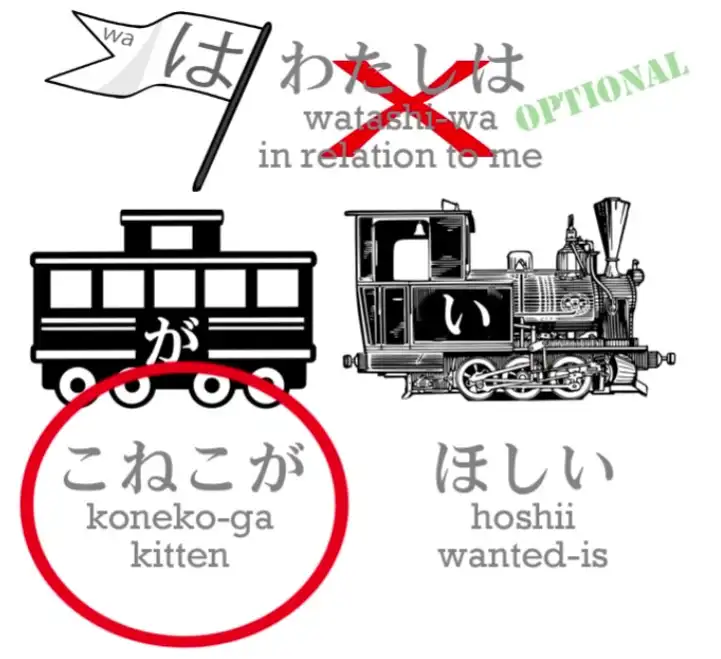
So, what does “ほしい” mean?
Well, quite simply, it means “is wanted”. Note: It is an adjective. “In relation to me, the cat is wanted.” Note: わたしはねこがほしい. And again, if we seriously believe that this means “I want a cat”, we’re thinking that the が can mark the object of a sentence, the object of the action, the thing we’re doing it to.
So again, we’re being confused about the role が plays in a sentence, we’re confused about the role を plays in a sentence, because the cat should be marked by を if it meant “I want a cat”.
And we’re confused between the verbs and adjectives.
So again Japanese becomes a strange guessing game in which particles and kinds of word can change their meaning at random.
Expressing wanting to do something with たい
Now, suppose we want to do something.
In Japanese we express wanting to do something differently from the way we express wanting to have something.
And the way we do it is by using the い-stem again.
The い-stem, as I told you before, is a very important stem.
So in order to say we want something we have to add the want-adjective, which is “たい”.
So we now have an adjective.
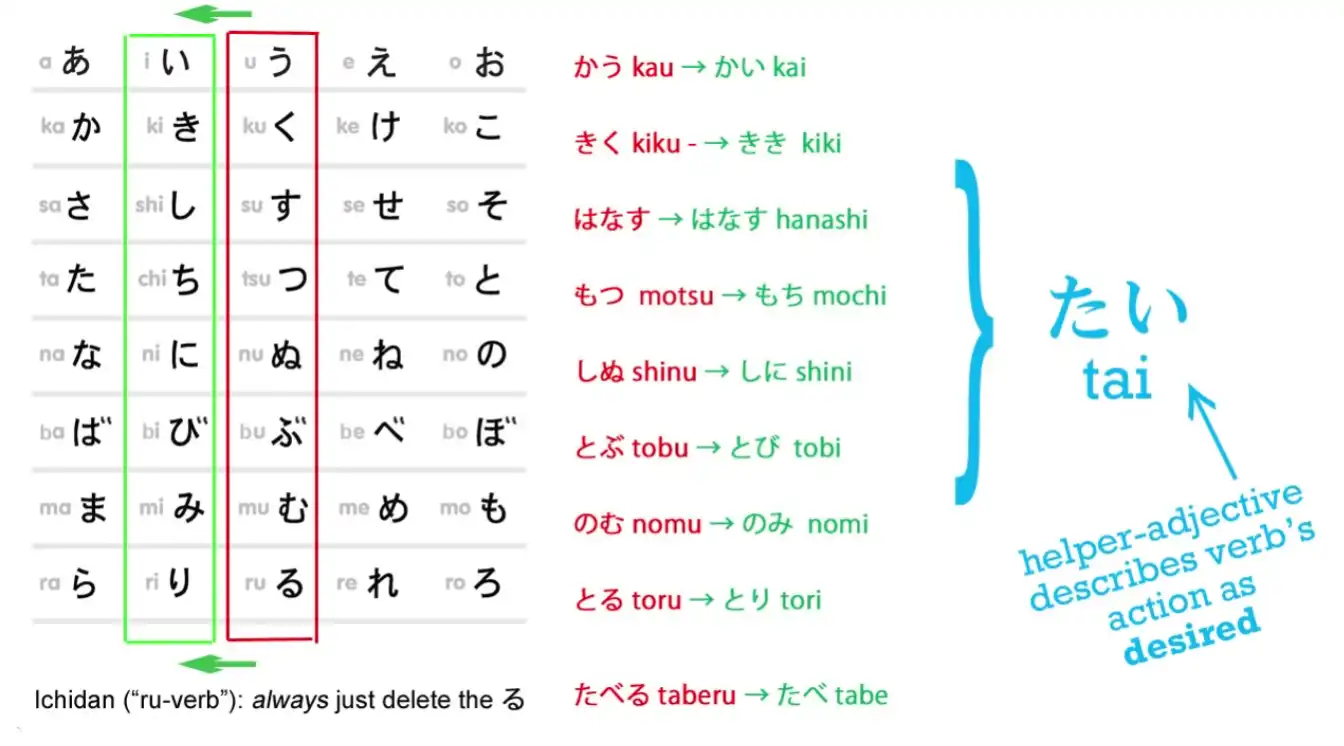
And what does this adjective mean?
It doesn’t mean “want” in the English sense.
It can’t, because “want” is a verb and “たい”, ending in “い”, is an adjective, isn’t it?
So let’s take an example.
This is a slightly notorious example.
“わたしはクレープがたべたい”.
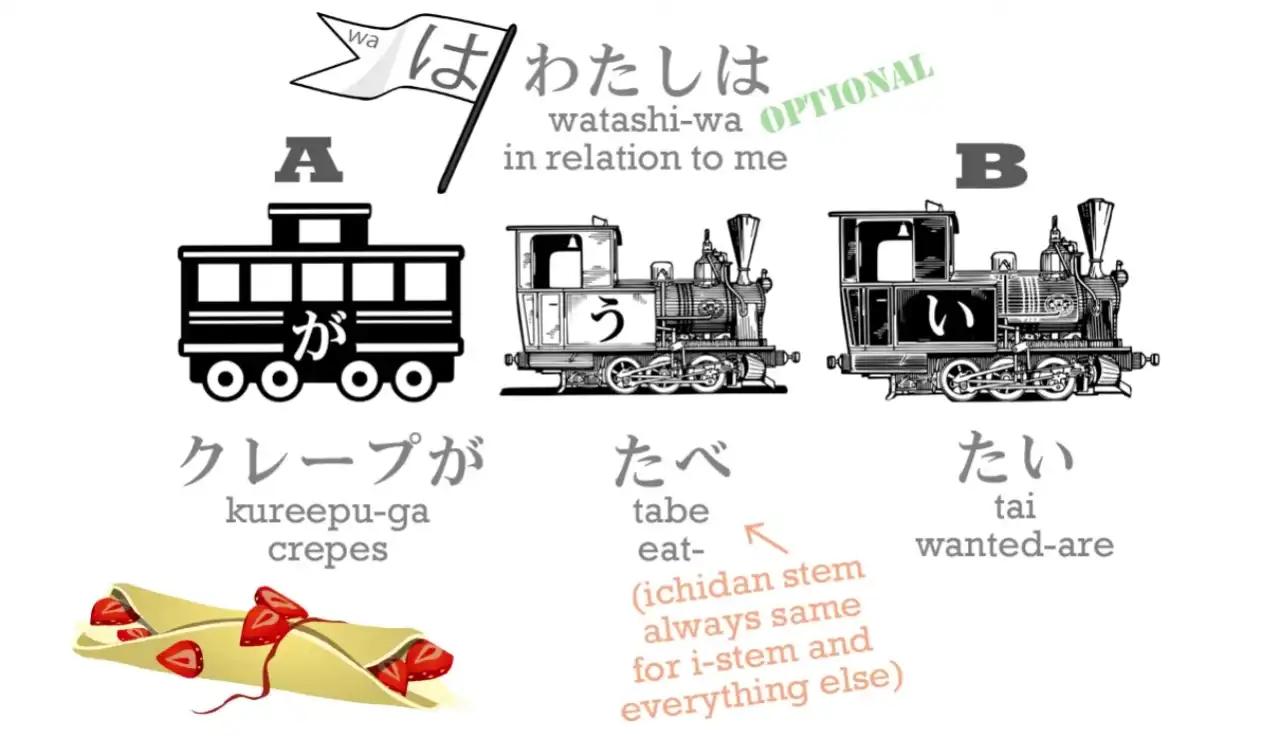
Now, the standard English translation of this is “I want to eat crepes”.
But, as you see, the pattern here is just the same as in the other cases we’ve been considering.
The が-marked actor is not “わたし”, it’s not “me”, it’s the crepes.
The desirability of the crepes is not a verb, it’s an adjective.
And we need to understand this because if we don’t it’s not just going to mess up this kind of sentence – it’s going to mess up our whole grasp of Japanese words, Japanese particles and Japanese structure.
Now, there’s no really good way of translating this into English.
We would have to say something like “In relation to me, crepes are desire-inducing”.
And that’s very awkward.
Note: it is okay to use “want/wanting” as a translation. Just remember that たい is not a verb as “want” is in English, but is rather an adjective. Translations don’t matter, understanding does. And sometimes people ask me, “Am I really supposed to use all these awkward literal translations that you give, rather than using natural English?” And the answer to that is “No”.
You’re not supposed to be thinking in terms of my awkward explanations or thinking in terms of natural English.
You’re supposed to be thinking of Japanese in terms of – guess what – Japanese.
I’m explaining it in English to give you a start toward doing that.
But these unnatural translations or explanations are there to help you grasp the structure of Japanese, not to give you a way of translating Japanese.
Now, as I say, the pattern is the same in all these cases, and I don’t think it’s very difficult to grasp.
But now we’re going to look at something which could seems a little confusing, and I promise you it isn’t, if you just follow carefully what I’m going to say.
We have this sentence here: “クレープがたべたい” but what if we didn’t have the crepes here?
What if we just said “(zeroが)たべたい”?
Now there’s no longer in this sentence what English wants to call the object of desire, what is in fact the subject of desire, the desire-inducer, and obviously there has to be a が-marked zero-car or, as you know, we don’t have a sentence.
But what is that zero-car in this case?
Well, the ironic thing is that in this case the zero-car is what the English textbooks thought it was all along. It’s “I”.
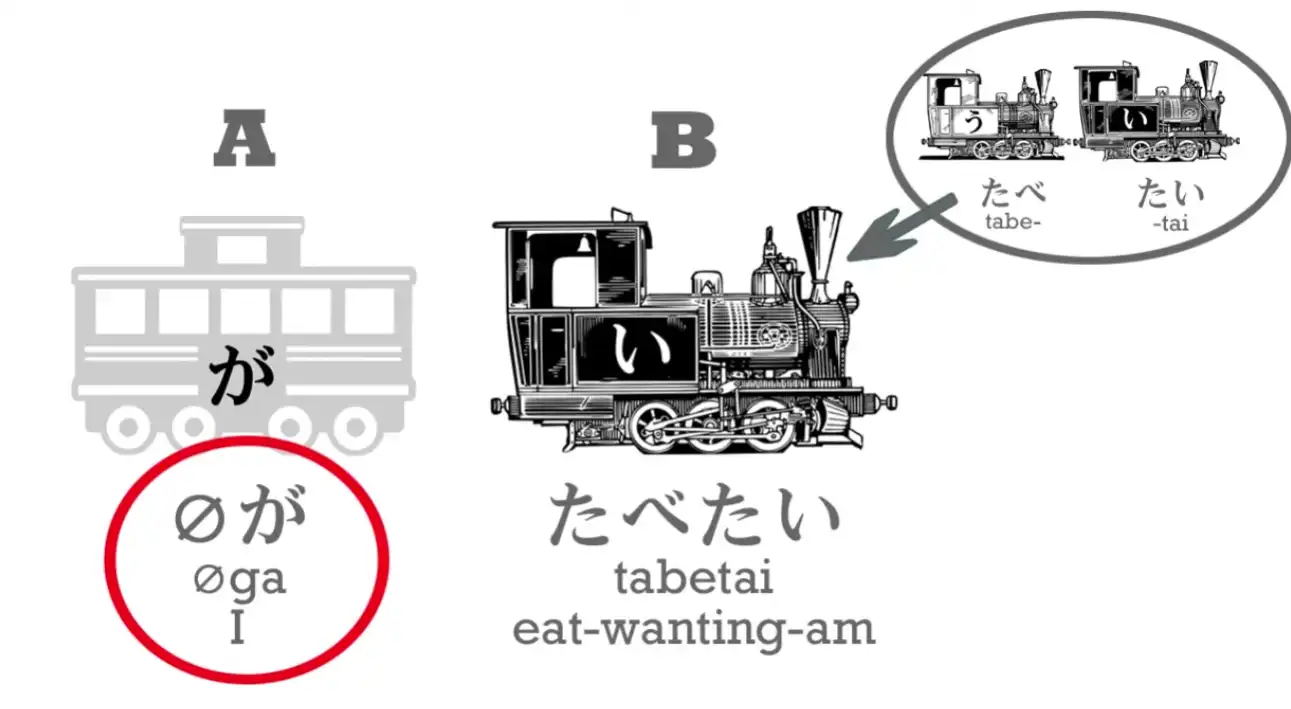
I really am the actor of the sentence this time, and that may be part of the reason for a lot of the confusion that happens on this subject.
“わたしがたべたい” means “I want to eat” – I don’t want to eat crepes necessarily or Sakura’s obento necessarily, I just want to eat. (I eat-wanting-am) And because there is no eat-inducing subject here, the want-to-eat is attributed directly to me.
And you may be asking – you should be asking – “So, what is this -たい?
Is it an adjective describing the condition of something making you want to do something, or is it an adjective describing my desire?” And the answer is that it can be either.
Obviously when it is describing a cake it’s also indirectly describing my feelings about the cake, it’s describing the feelings the cake induces in me.
And when there’s no cake there, or no crepe here, or no Sakura’s obento there, we just describe my feelings directly.
And this is often the case in Japanese with adjectives of desire.
For example, “こわい”, which means either “scared” or “scary”.
If I say, “おばけがこわい”, I’m saying, “Ghosts are scary”,
but if I say just “こわい”, I’m saying, “I am scared”.
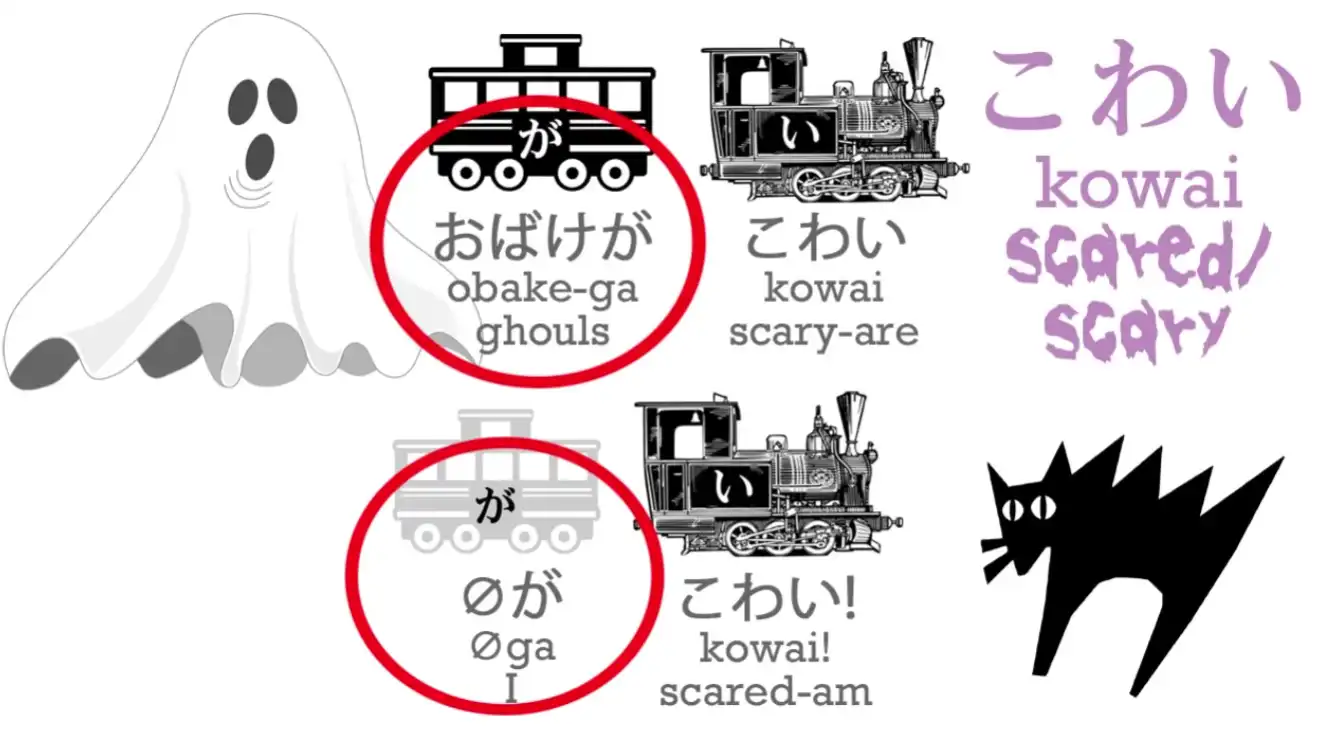
Now, is this confusing?
It isn’t confusing because we have a landmark that tells us what to do every time.
And that landmark is が.
In these sentences and in much much more complicated sentences, if we watch the が and watch the other logical particles, we’ll never go wrong, because the logical particles never ever ever change their function.
So we can use them as our compass.
And that’s why it’s so very destructive to induce people to believe they can change their function as the textbooks do.
If you have a compass and I say to you, “Ah, well, most of the time the compass points north, but sometimes points south and actually quite a lot of the time it also points east”, you might as well not have a compass.
I have destroyed the value of your compass for you.
And it’s the same with the logical particles.
They are absolutely reliable.
They always point north. (Or I guess, they always point to where they should point, one way) They never change their function.
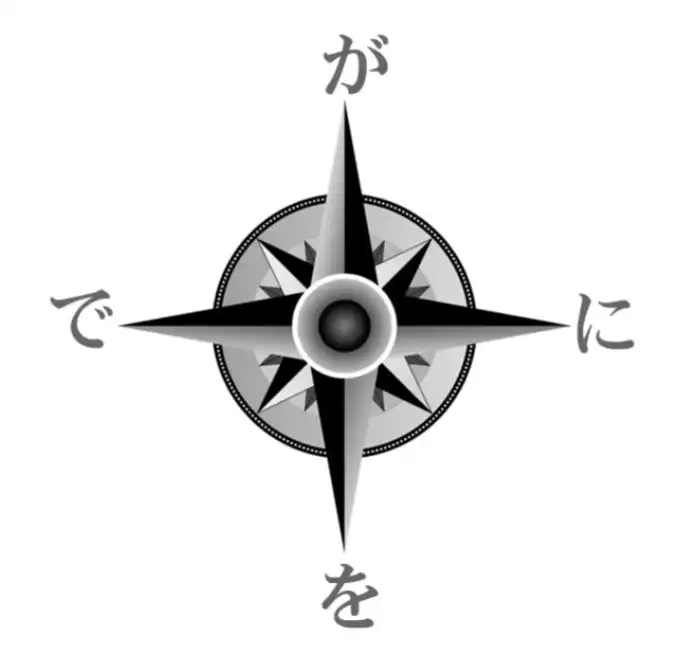
So, if が marks the crepes then we know that the subject of the sentence, the thing about which the engine is telling us, is the crepes, nothing else.
But if we don’t have the が-marked subject there, we know that by default the zero-pronoun is usually “I” unless there’s a reason to think it’s something else.
It’s just the same as in the eel example that we gave in the lesson on は.
Now, I’m going to tell you one more thing, and I hope I’m not overloading you with information in this lesson, but it will have the advantage of giving you even more confidence about what the zero pronoun is in these cases.
And that is that you cannot use these adjectives of desire, of feeling, about anyone but yourself.

So if I say “たべたい” and there is nothing to たべたい in the sentence or the context then I must be talking about me, I can’t be talking about you and I can’t be talking about Sakura.
Why not?
Because Japanese doesn’t permit us to do that.
You can’t use “-たい” about someone else, or “こわい” or “ほしい” – we can’t use any of these things about someone else.
What if we want to say that someone else wants something?
Well, because Japanese is a very logical language, it does not allow us to make definite statements about something we can’t know for sure,
(Note the word statement here, たい cannot be used when “exhibiting actual knowledge of someone else’s subjectivity” as Dolly puts in the comments, recommend reading that)
so you see it’s very different from Western languages.
One thing we can’t know for sure is someone else’s inner feelings.
So I might think that Sakura wants to eat cake, but I don’t know that.
All I know is how she’s acting, I know what she says, I know what she does, I know how she looks, but I don’t know what her inner feelings are.
So if I want to talk about her desire to eat cake, I can’t use “-たい”.
And I can’t use “こわい” to describe her fear, and I can’t use “ほしい” to describe a thing she might want.
Expressing statements of desire about other people with たがる
So what do I do?
I have to add to the adjective of desire a helper verb.
I take the “い” off the い-adjective and I add the helper verb “がる”.
And “がる” means “to show signs of / to look as if it is the case”.
So if I say, “さくらがケーキをほしがる” then I’m saying
Sakura is showing signs of wanting cake.
That’s what I’m literally saying.
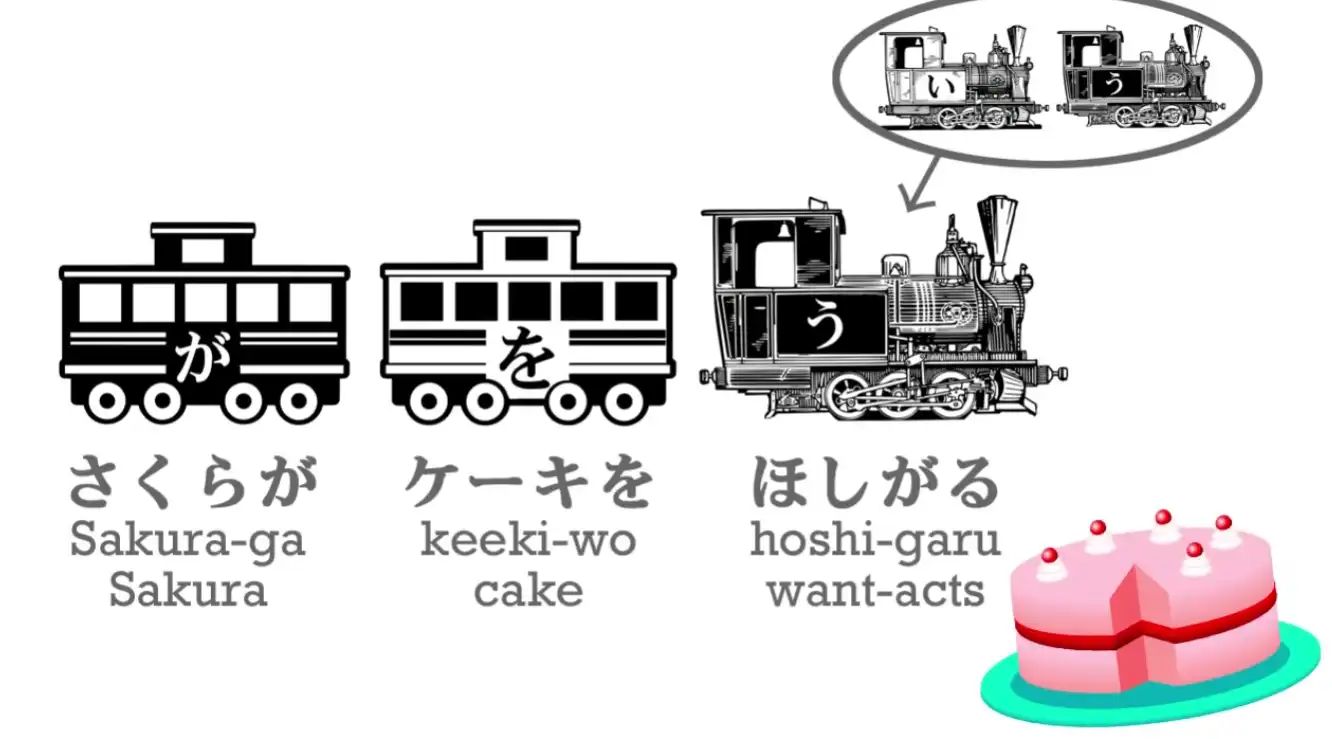
And even if she’s actually told me she wants cake, that’s still what I say, because I can’t feel her feelings.
I only know what she’s doing and saying.
Now, why do we use a verb in the case of other people when it’s an adjective in the case of ourselves?
Again, this is very logical.
I can’t describe someone else’s feelings because I can’t feel them.
I don’t know about them.
I can only speak of their actions, and their actions obviously must be a verb.
So this is a useful thing to know, but it also helps us to be very clear when we say “たべたい” or anything else -たい, or anything “ほしい”, that if there is not a cause of that emotion, then the zero pronoun must be me, “わたし”, because it can’t be anybody else. We actually can’t use it for anybody else.
Note: As mentioned above already, Dolly has that interesting comment about this たい vs がる. So that’s quite a lot of information in one lesson, but understanding this is going to short-cut you right through a huge area of confusion and misunderstanding that troubles many Japanese learners for years.
Note: This is one of the first “Big Reveals About Japanese” by Dolly, which is why it is quite packed. Don’t worry, take it slow, reread, check the comments of the video and with enough exposure it will eventually stick. However, obviously, like I said in the Lesson 7.5 long note of mine, keep in mind that Dolly is here to just make you get the basic idea and of course this means she simplifies stuff to make it fit her model and because it is for the basics, but if you go deeper, things are not as simple and a lot of nuance exists, grammar and linguistics can often be pretty messy and complex and things are not as simple as Dolly sometimes implies, but for the sake of her method, it is alright for the basic understanding.
If you want to know why check this MoeWay Discord discussion by Morg (AWESOME page btw!).
Also, check Morg’s comments in this は and が thread, since が is not always just the subject marker.
So do not take Dolly as gospel but just as a useful way to attain Japanese basics that push you into immersion = what truly matters. Dolly is still a great source of explanation! Just things are not as simple if you go more in-depth, however do not worry about it, it will all click once you immerse a ton and ton…
10. Helper verbs & the potential helper verb
Lesson 10: “Japanese conjugation” myth busted! Also, potential verb form secret unlocked
こんにちは。 Today we’re going to talk about the main helper-verbs and about the potential form.
When I say “the main helper-verbs”, I’m referring to what the standard Western Japanese grammar descriptions call “conjugation”.
And I only mention this word because I don’t want you to get confused if you see “conjugation” referred to somewhere else.
When they talk about “conjugation”, this is what they mean.
But in fact there is no such thing as conjugation in Japanese.
All we ever do is add helper-words to the four verb stems.
And there are a lot of helper-words and most of them are just a question of extra vocabulary so long as you don’t think of them as conjugation.
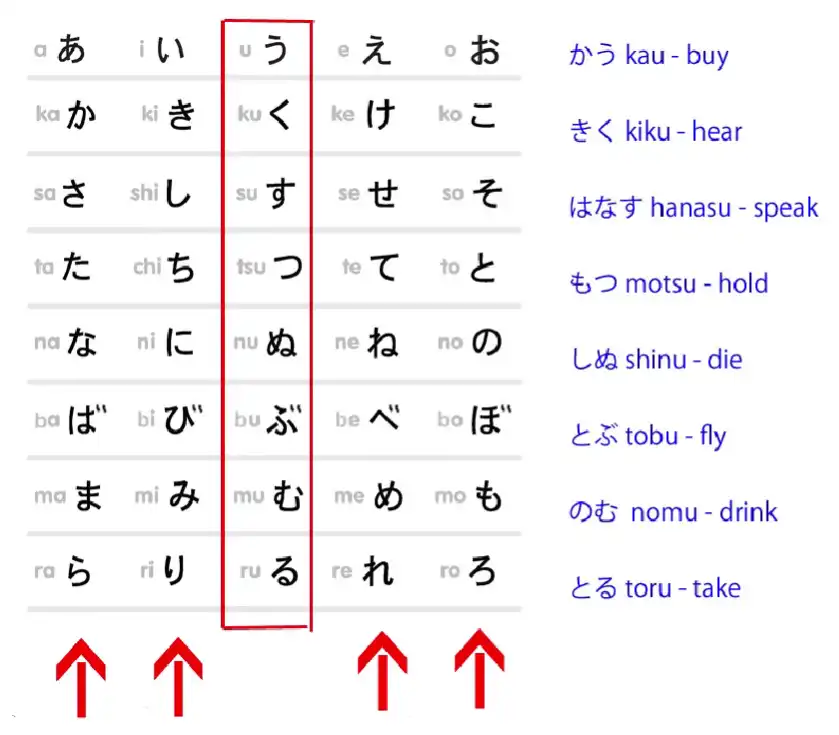
In some cases they get called “conjugation”, in other cases they don’t, and they’re exactly the same process every time.
The only difference is that some of them happen to accidentally, and only very vaguely, resemble European conjugation and others don’t.
All kinds of confusions arise from confusing Japanese helper-verbs and helper-adjectives with conjugations, but because we’re not going to use them, we don’t need to worry about that here. All right.
The potential helper verb
So, the first main helper-verb we’re going to look at is the potential verb.
Now, we’ve already looked, haven’t we, at helper-words.
We’ve looked at the helper-adjectives “ない”, which forms the negative, and “たい”, which is used for the desirability of an action.
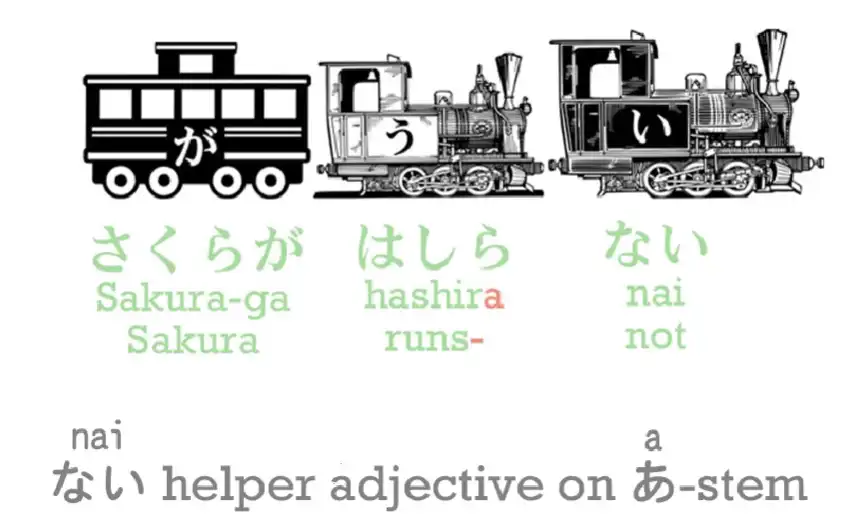
We’ve also looked at the helper-verb “がる”, which is attached to an adjective.
Now we’re going to look at the potential helper-verb, and this attaches to the え-stem.
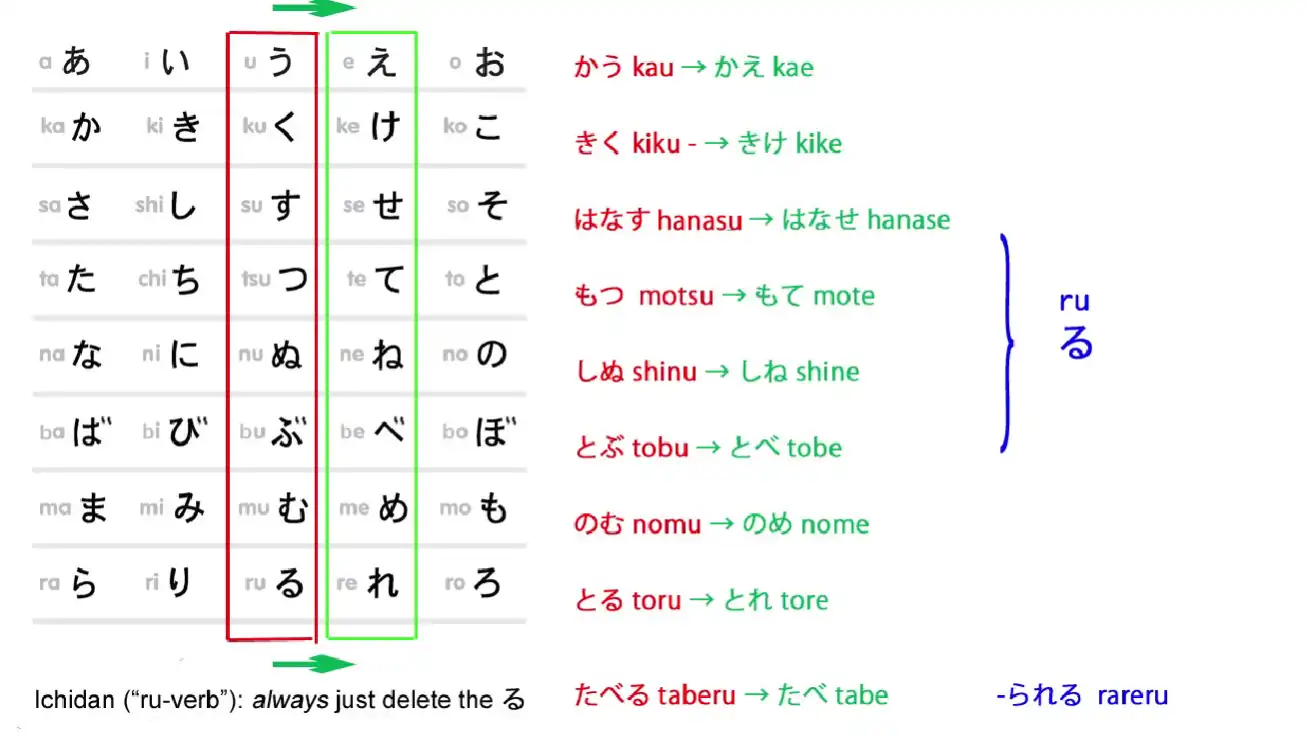
There aren’t as many things we do with the え-stem as we do with the あ and い-stems, but there are some.
And only one of them is a verb, so there’s no room for confusion here.
The potential helper-verb has two forms, and they are “-る” and “-られる”.
People can be a little disconcerted by the godan form of the helper-verb because it’s just one character, る(ru).
But that shouldn’t worry you at all, and because it only ever goes onto the え-stem, can’t be used on its own, it’s very very easy to recognize.
“-られる” is the form of the potential helper-verb that goes onto ichidan verbs – and we discussed godan and ichidan verbs before, didn’t we?
So, “かう” (buy) becomes “かえる” (buy-able); “きく” (hear) becomes “きける” (hear-able); “はなす” (speak) becomes “はなせる” (speak-able); “もつ” (hold) becomes “もてる” (hold-able) and so forth.
*Note: change to え-stem and then the godan potential form る. Also note this…
*

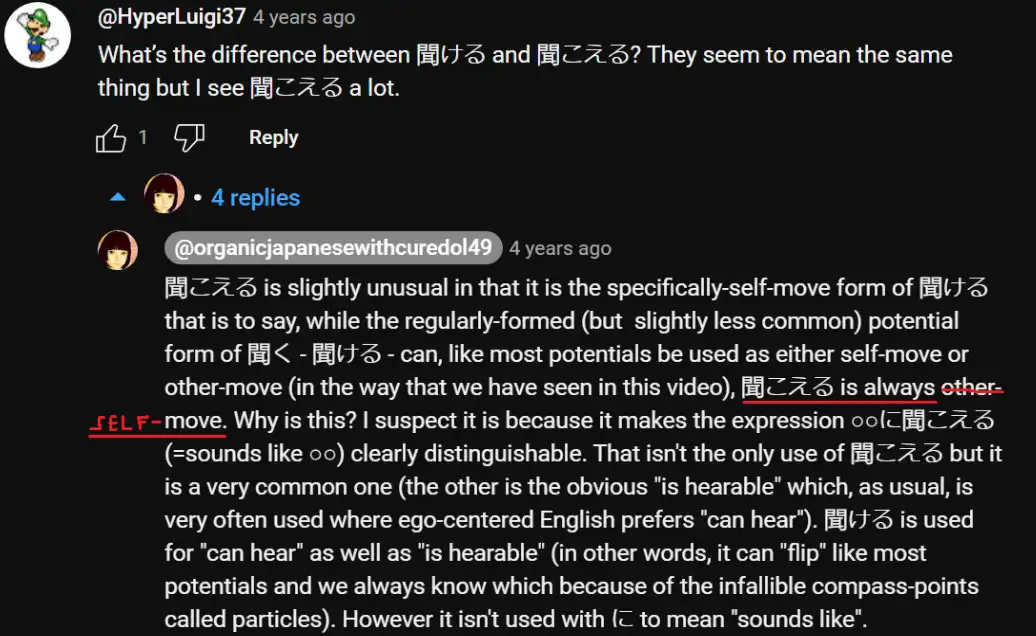
- There is some difference in their implication, Dolly clears them up further in LESSON 54.
Dolly SEEMS to make an error here by calling 聞こえる other-move, but it should be self-move as she implies in the beginning of the comment (+in comparison to other sources like Imabi).* And with “たべる”, which is an ichidan verb, we do what we always do, simply take off the -る and put on whatever we’re going to put on.
So “たべる” (eat) becomes “たべられる” (eat-able).
So this is very simple, isn’t it?
There are only two exceptions to this formation of the potential form and they are the two Japanese irregular verbs, “くる” and “する”.
“くる” become “こられる””, but “する” surprisingly becomes できる.
できる is the potential form of “する”.
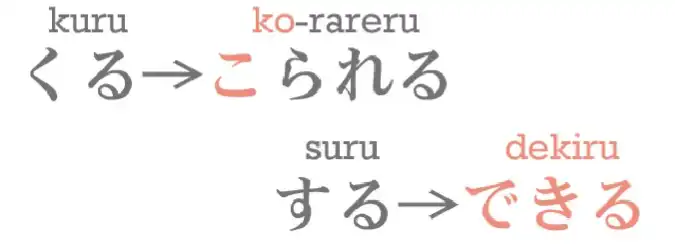
And this is an interesting word because it also means “come out” –
literally it’s made up of the kanji “out” and “come” – “出来る/できる”, 出る (exit) 来る (come)
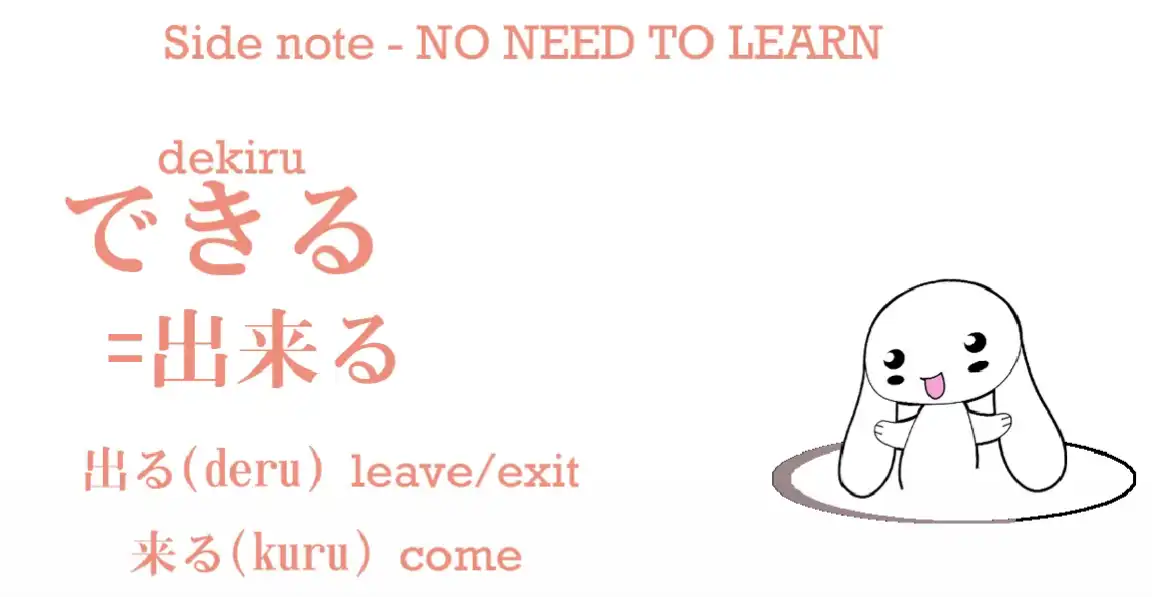
And if we say “にほんごができる”, we’re not saying “I can do Japanese”,
we’re saying “Japanese is possible” / “does” possible
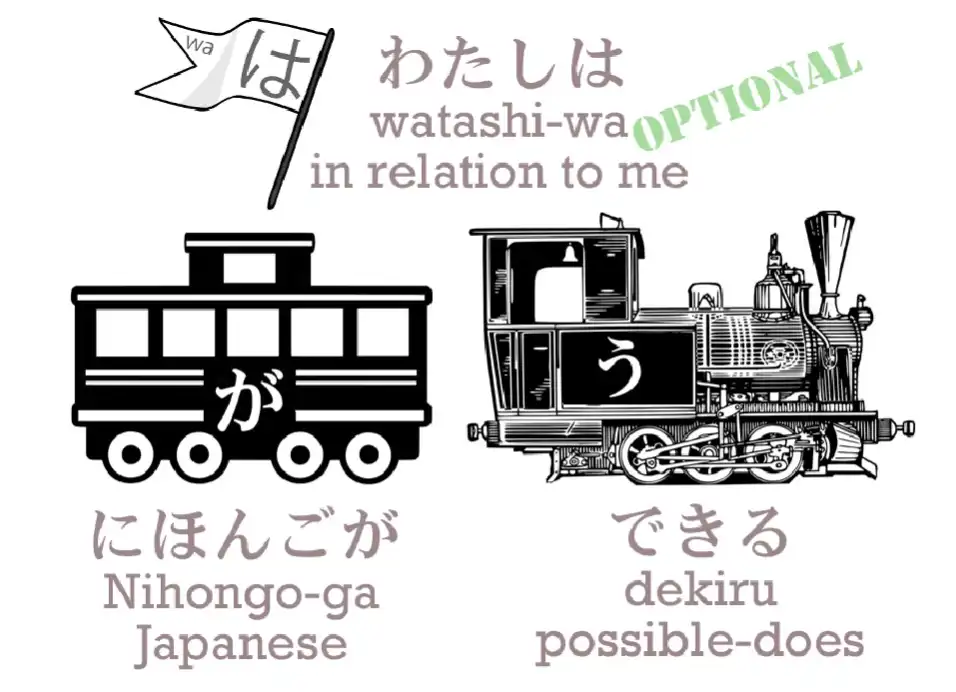
And if we say or imply “わたしはにほんごができる”, we’re saying,
“To me, Japanese is possible”. (Dolly gives “does possible” to imply it’s A does B; not A is B)
And it’s interesting if you see a small child perhaps trying to make something out of paper,
she may say, “I’m trying very hard, but it won’t come out right” – and this is just
the way できる is used in Japanese, isn’t it?
And there are some interesting ways in which できる is used which show how the idea of something being possible and something coming out are closely linked in the Japanese language.
But we won’t talk about that now – that’s a little bit more advanced.
There’s only one danger area with the potential form, and it’s very very close to something we dealt with last week. (Lesson 9) So if you’ve seen that lesson, this one should be very easy to you.
Let’s look at a typical sentence: “ほんがよめる.”
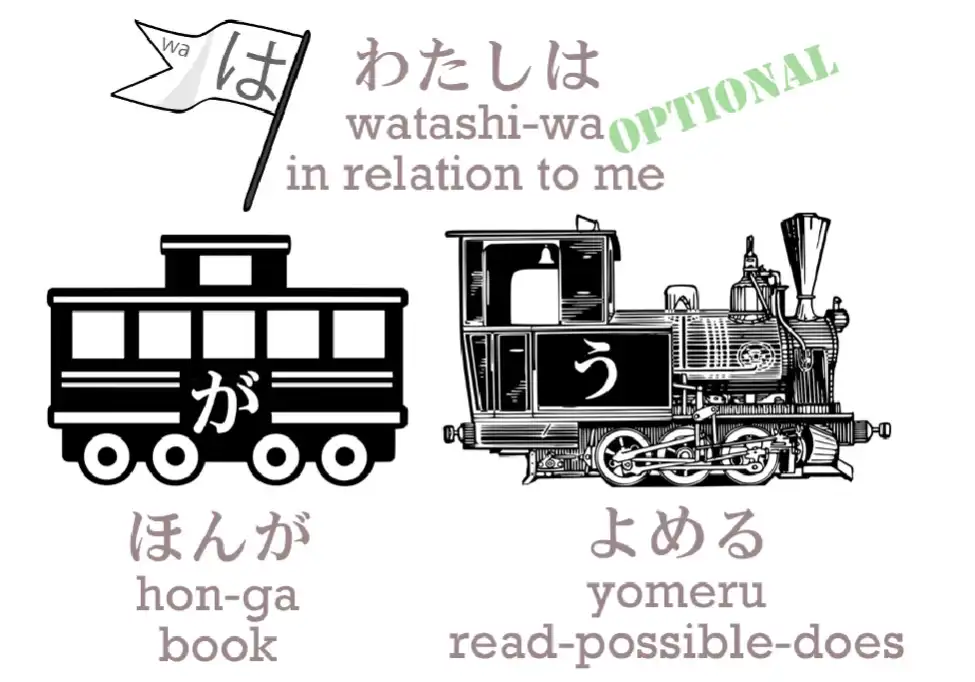
Now, the standard texts usually translate this as “I can read the book”.
But that isn’t what it means, as you can clearly understand if you followed our previous lesson.
Look where the が is. The が is marking what?
It’s marking the book! So who is the actor of this sentence?
It’s the book.
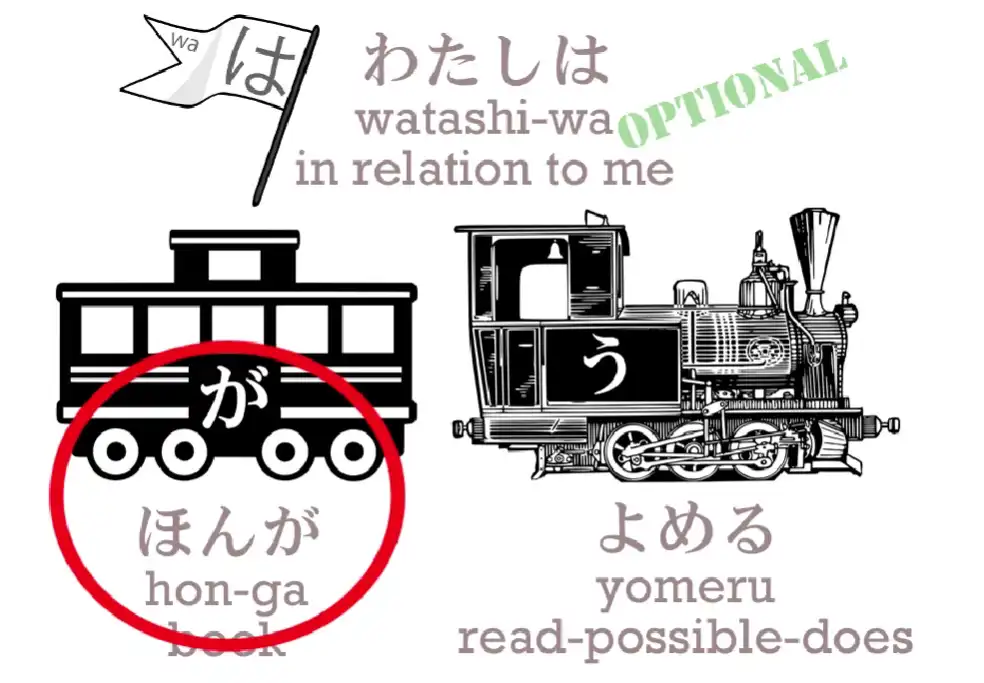
We are saying something about the book.
So the book is the main car and “よめる” is the engine.
We are saying the book is readable, it’s possible to read the book.
If we add “わたしは”, we are saying the book is readable “to me”.
What we are literally saying is, “In relation to me, the book is readable”.
But this does not and cannot mean, “I can read the book”.
If we wanted to say “I can read the book”, the book would have to be marked by を, wouldn’t it?
And I would have to be marked by が.
And it is in fact possible to do this, but it’s not what is usually done.
But also remember that if we want to put stress on the ego, the way English wants to, then we have to change the particles.
If we literally want to say, “I can read the book” – “わたしがほんをよめる”.
A lot of people think this is bad Japanese.
Note: I guess it isn’t how the Japanese tend to speak. It could be called “Englishised” Japanese as it puts emphasis on the ego first, as the subject, which isn’t how they tend to think in Japan.
Not our place to work out whether it is or isn’t bad Japanese.
The point is that most of the time you will see “ほんがよめる”,
and “(わたしは)ほんがよめる” can’t literally mean “I can read the book”.
It means “The book is readable”.
(Can say わたしは to imply book does readable TO ME - a topic, but it’s usually not mentioned)
So that’s simple enough, and provided we remember that, we don’t send all those particles into
crazy illogicality.
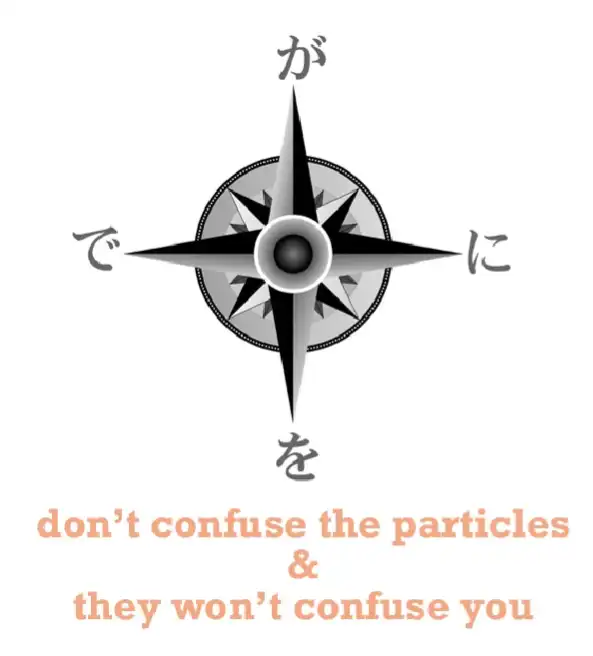
So really this is very much similar to the questions we discussed last week about -たい and adjectives of desire.
If we just keep that が straight in our minds, everything else will fall into place.
And just as with the たい-form if we say, “(わたしは)ケーキがたべたい”,
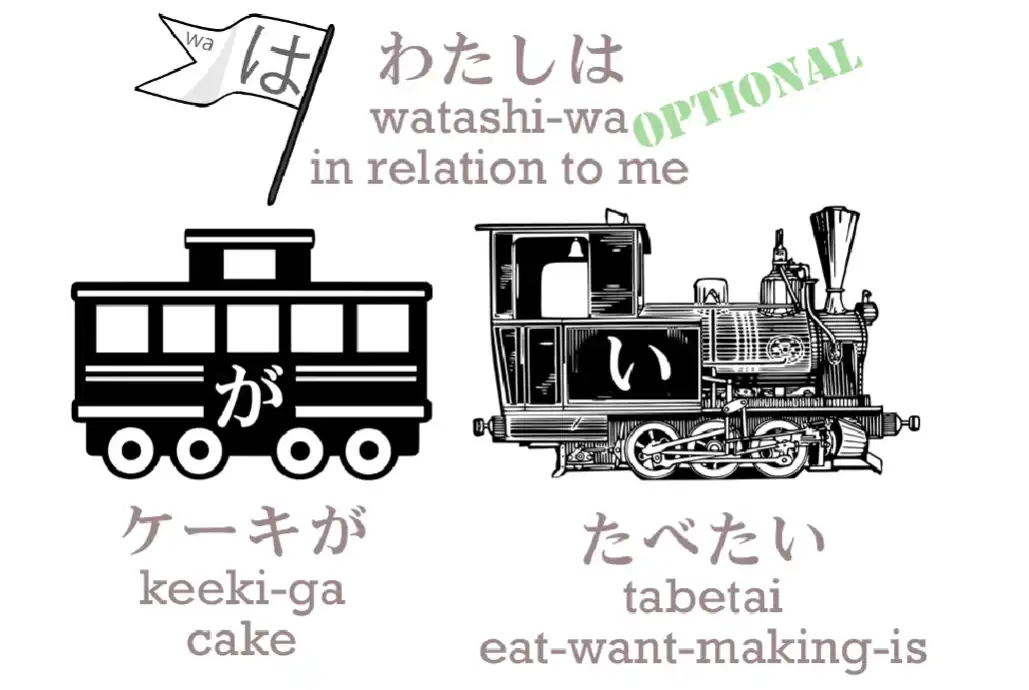
it’s the cake that’s being want-inducing (to me personally - topic), but if we just say
“(わたしは)(zeroが)たべたい” we do mean “(In relation to me) (I) want to eat” / eat-wanting-am,
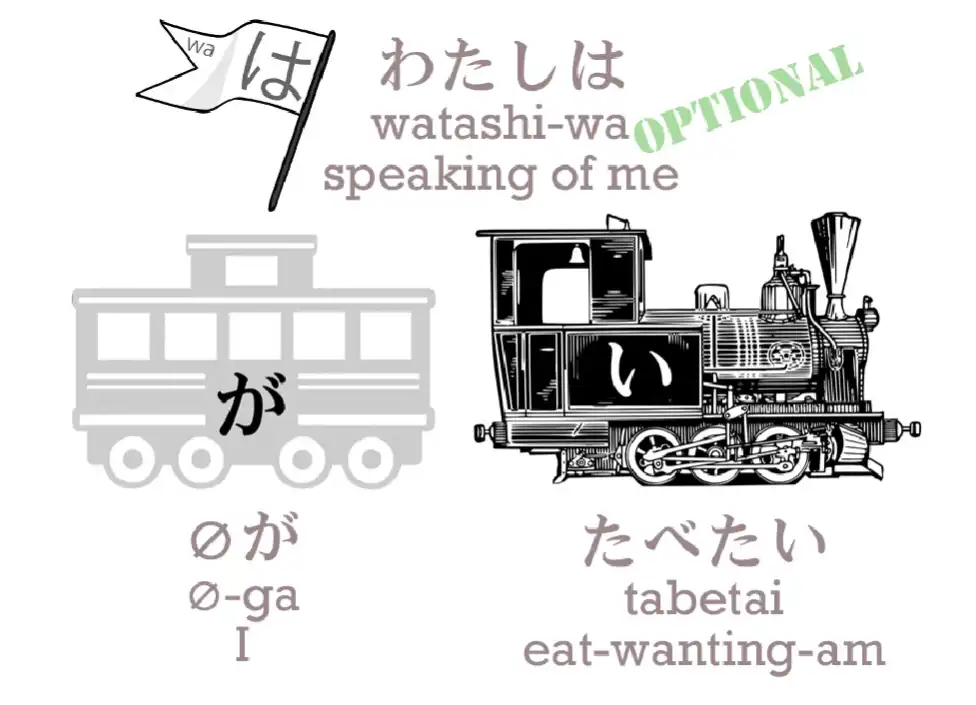
because when there’s no particular food there to do the being wanted, then I do the wanting.
(I’m the subject that just wants to eat something because I’m hungry; here I’m also the topic).
*However, do note that no food is present there, so it defaults to “me”.
Zeroが (and also zeroは) is dependent on the context of the situation/sentence, Dolly says…
*
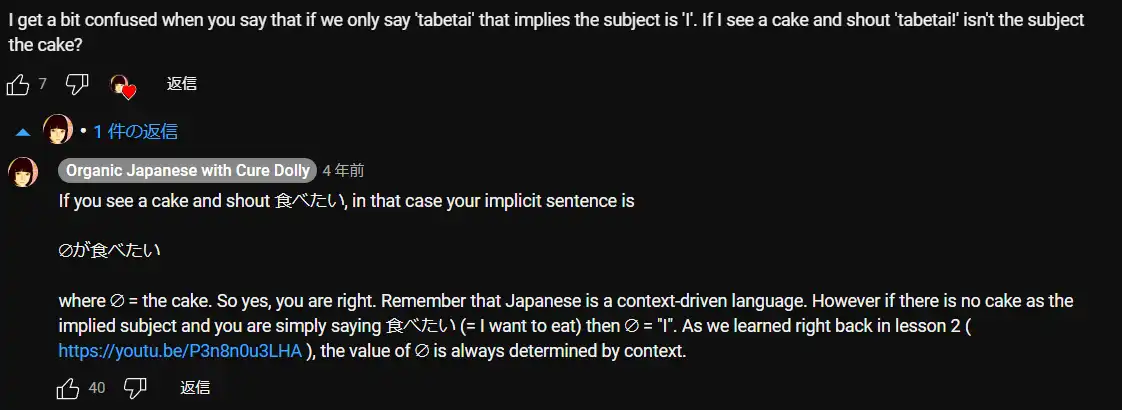
It’s the same with the potential form.
So we say, “(わたしは)ほんがよめる” – “(to me) the book is read-able”,
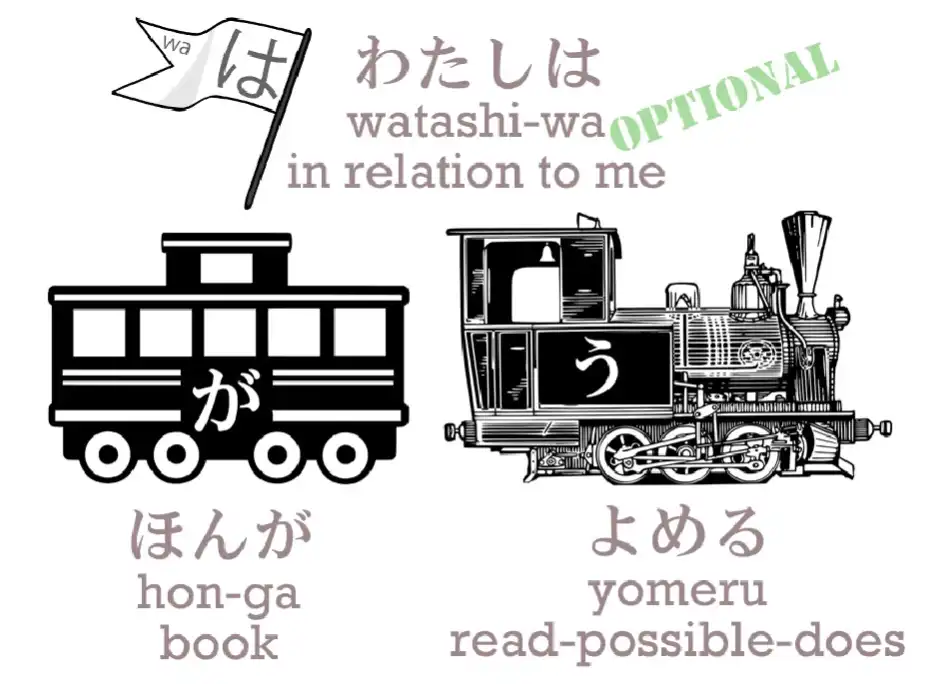
but if we just want to say “I can read” – not “I can read the book or I can read the newspaper
or I can read Sakura’s secret diary”, but
“I can read” – then we say “わたしがよめる” or just “よめる”, which means “(zeroが)よめる”.
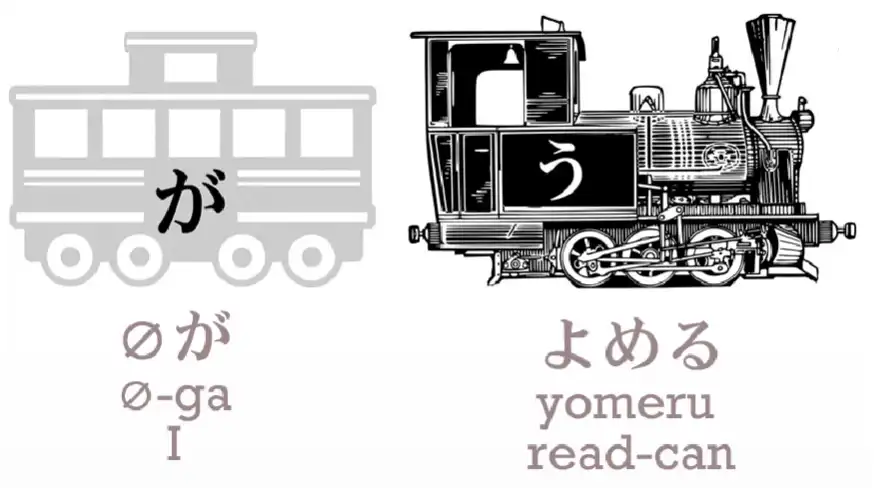
And we really have become the subject of the sentence.
And I am sure there are people who find this confusing, but if you followed the past lesson this should be completely clear.
And let’s remember that Japanese always fits together just like Lego,
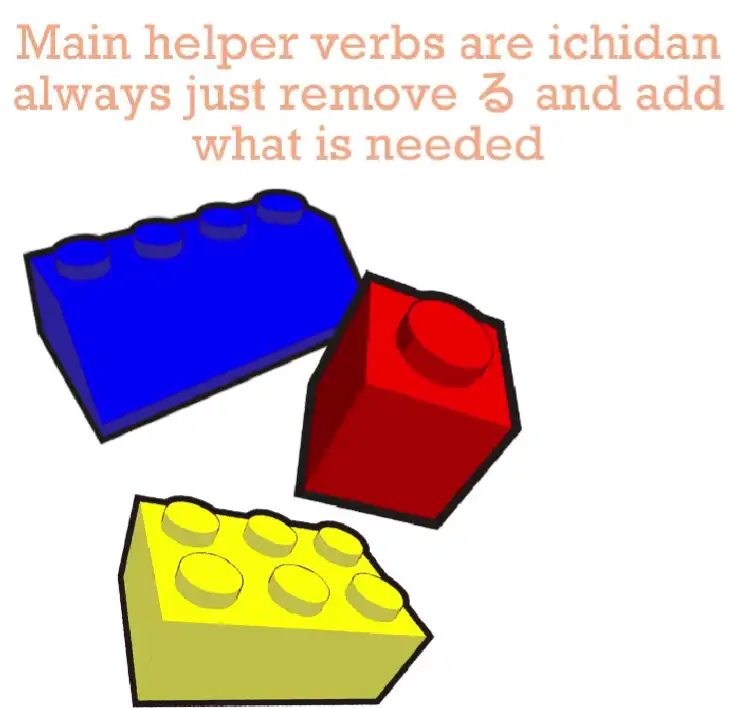
so the potential helper-verb, even when it’s just that single kana る(ru), is simply a regular ichidan verb like most helper-verbs, and we can do exactly the same things with it that we can do with other helper-verbs.
Note: I guess Dolly means the potential helper works like ichidan, so if adding anything to the potential, remove the る as with any ichidan and attach to the え-stem.
Dolly’s replies under one comment:
‘The “potential form” of godan verbs is ichidan because the る helper is ichidan…
Godan is a red herring here. As soon as we attach any ichidan helper to a godan verb we are dealing with an ichidan entity and anything we do after that follows the ichidan pattern…So there is no question of a godan verb becoming ichidan. What is happening is that a godan verb is attaching an ichidan helper.’
We’ll always recognize it, because it’s the only one that goes onto the え-stem, and we
can do everything with it that we do with any other ichidan verb.
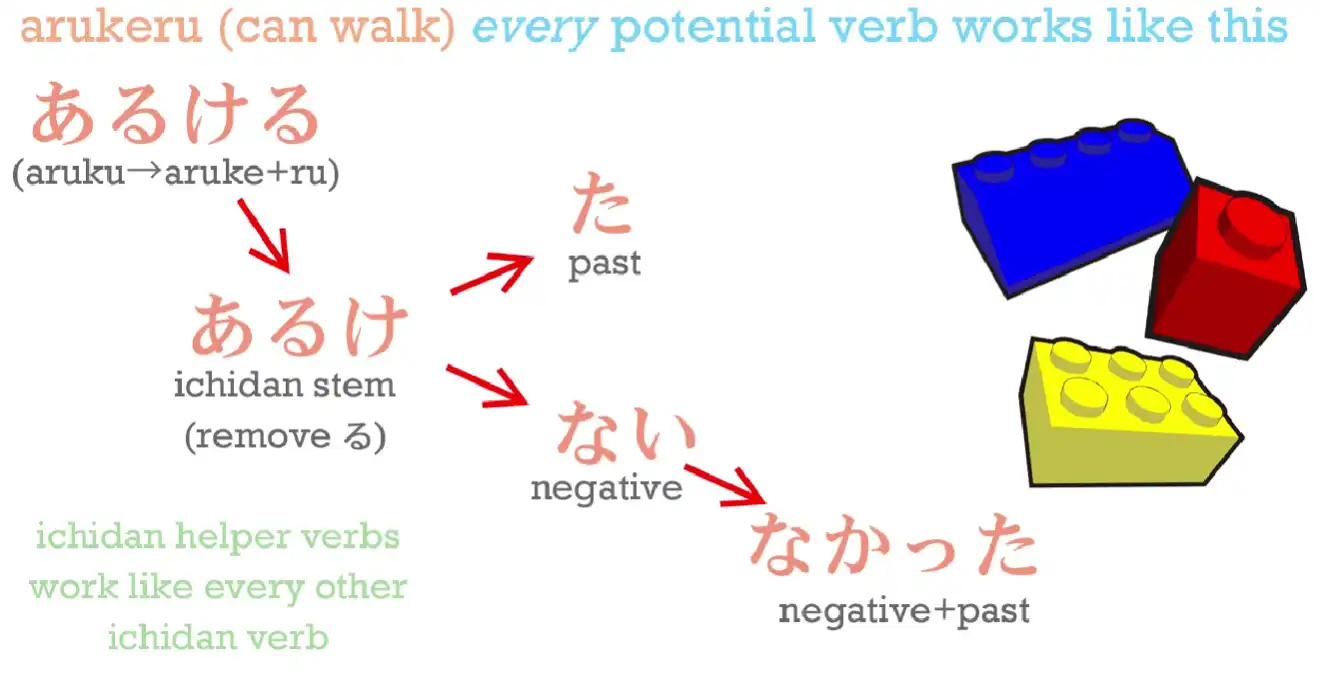
So: “あるける” – can walk; “あるけない” – can’t walk;
“あるけた” – could walk; “あるけなかった” – couldn’t walk.
And this regularity is the same even with the irregulars.
So: できる – possible; “できない” – not possible; “できた” – was possible; “できなかった” – wasn’t possible.
Note: I got quite confused, since I looked up 出来る/できる in Jisho and they actually show that it has a potential form of “できられる” which is interesting since できる should already imply the potential form. I looked up some Japanese forums (and others) and it seems that even the Japanese?? found できられる weird. Or it could be an honorific form?… Correct me if wrong…
E.g. 分かる also has no potential form, as it implies it. Dolly explains, “分かれる” is another word
—
Note: I will also add some regular ichidan verb example.
“たべられる” - can eat; “たべられない” - can’t eat;
“たべられた” - could eat; “たべられなかった” - couldn’t eat.
And it’s really as easy as that.
11. Compound sentences, くれる, あげる and more uses of the て-form
Lesson 11: Compound sentences, kureru, ageru, more te-form uses We’ve now completed ten lessons and it’s time for a change of pace.
We’ve learned enough now that we can start looking at some real narrative.
It’ll be a little simplified at first, but we can use this to bring together the things we’ve learned so far.
We’ll also be learning new structural elements because even in the simplest story we’re going to encounter things that we need to learn.
But this may be a more interesting way of doing it.
So please let me know what you think in the comments below. All right.
Now let’s go into a story that I believe we all know.
“ある日アリスは川のそばにいた.” Now, this is a simple sentence.
The word “川/かわ” means “river”, and “そば” means “beside” and it’s a noun.
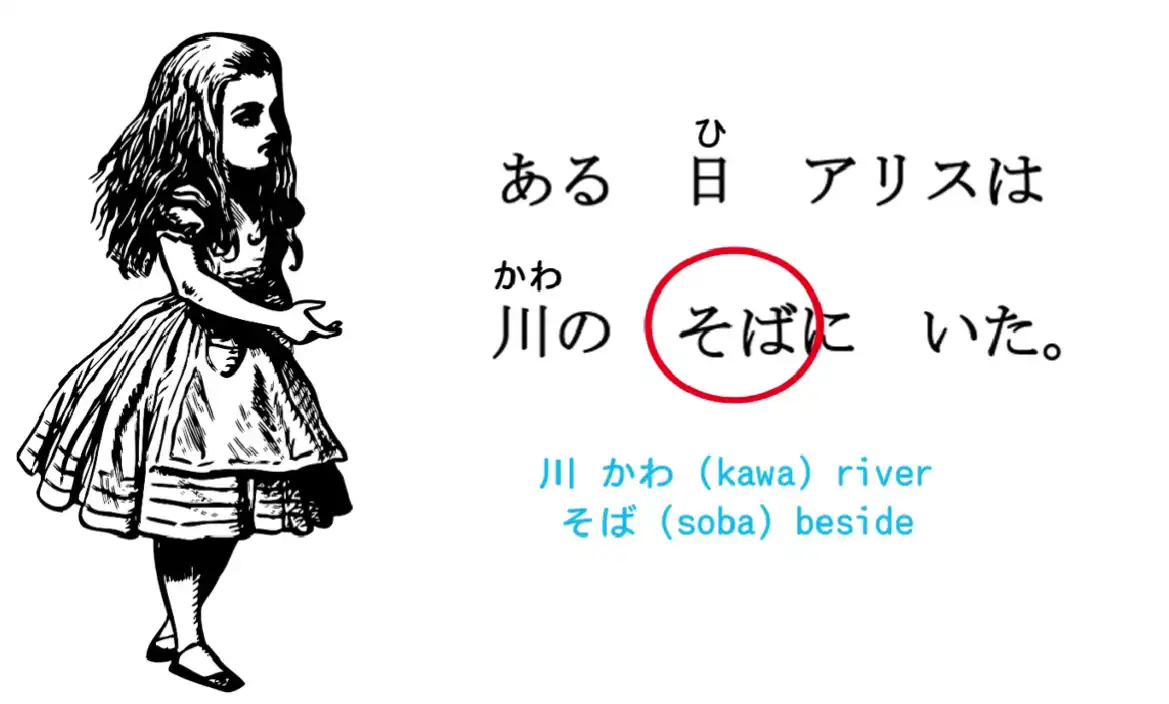
So “川のそば” is “the beside of the river”.
Just as we put something on the “on” of the table or the “under” of the table and we also always mark it with に, so the “beside of the river” is where Alice was.
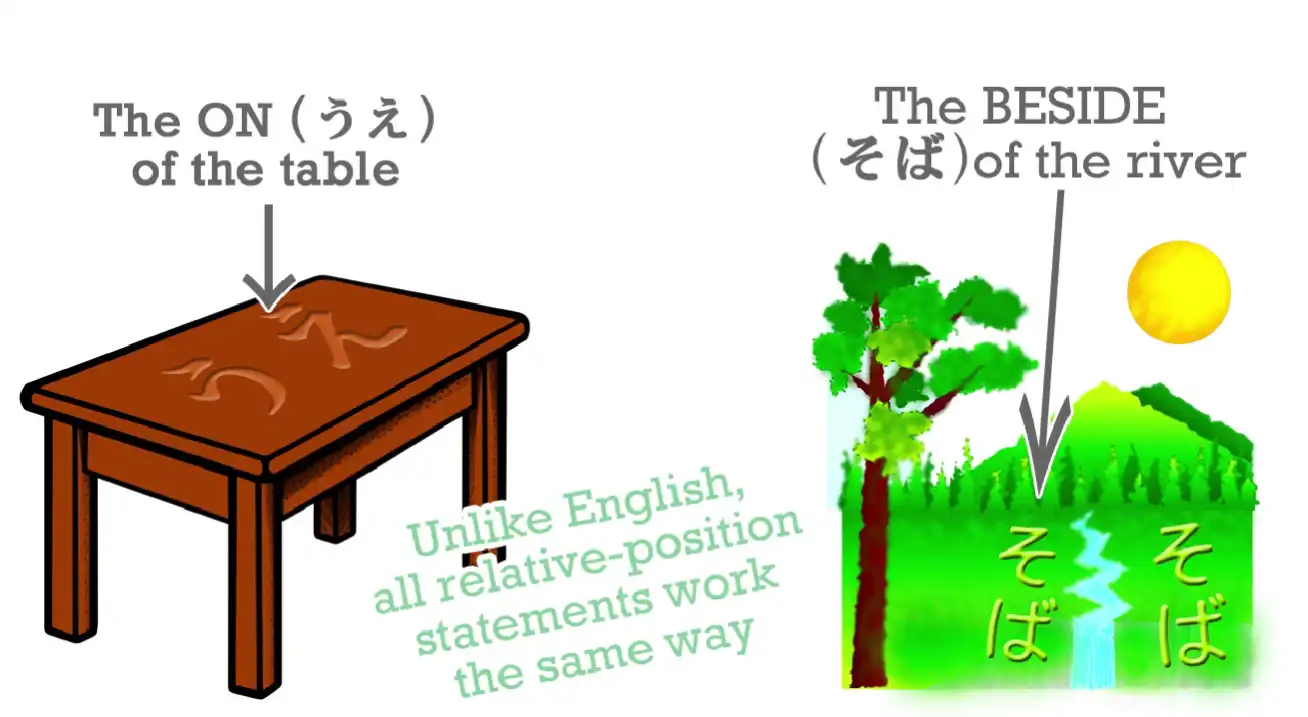
“ある” means “a certain”, so “ある日” is like “one day” or “a certain day”, and let’s notice that what’s happening here is what we’ve seen before.
“ある” is the verb that means “exist” or “be”, and what we’ve done here is what we’ve seen in the video lesson on so-called adjectives. (Lesson 6) We can make any engine into an adjective.
So, “ある” is an “A does B” engine, an う-engine,
so if we say “本がある” we are saying, “There is a book / a book exists”.
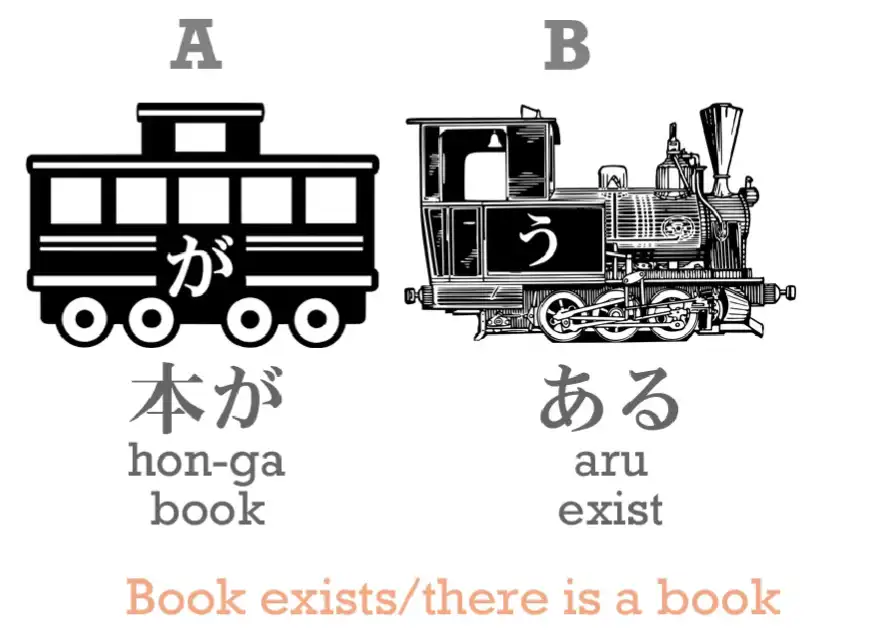
And if we move that “ある” engine to the other side of the book, we turn it white and it becomes a descriptor, an adjectival.
So we’re saying “ある本” – “an existing book / a certain book / a book that there is”.
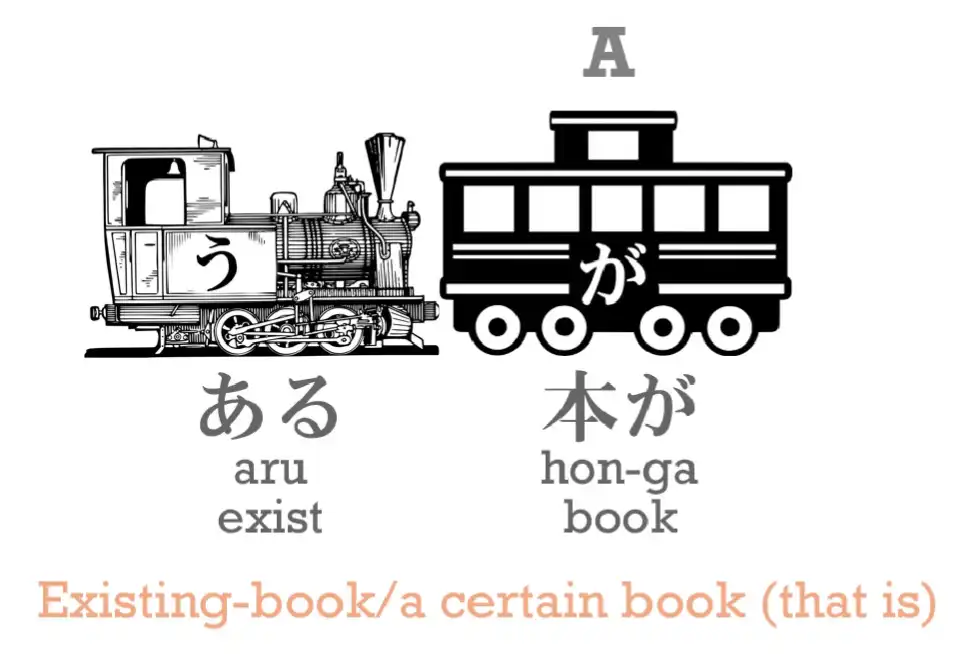
And it’s the same: “ある日” – “a certain day”.
“ある日アリスは川のそばにいた”
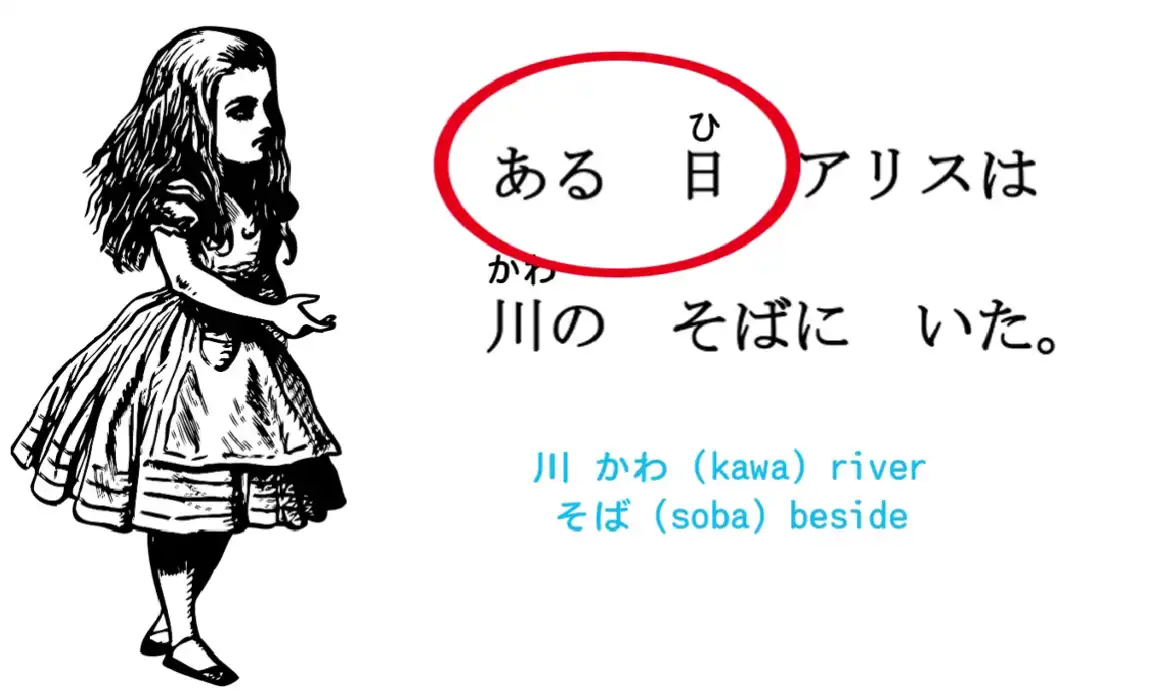
Now, the next sentence is going to be a little bit more complex, but don’t worry, it’s always easy when there’s a fully-functioning android to help you.
(Actually, I’m not quite fully-functioning, but for the purposes of showing you Japanese I am.) “おねえちゃんはつまらない本をよんでいてあそんでくれなかった”
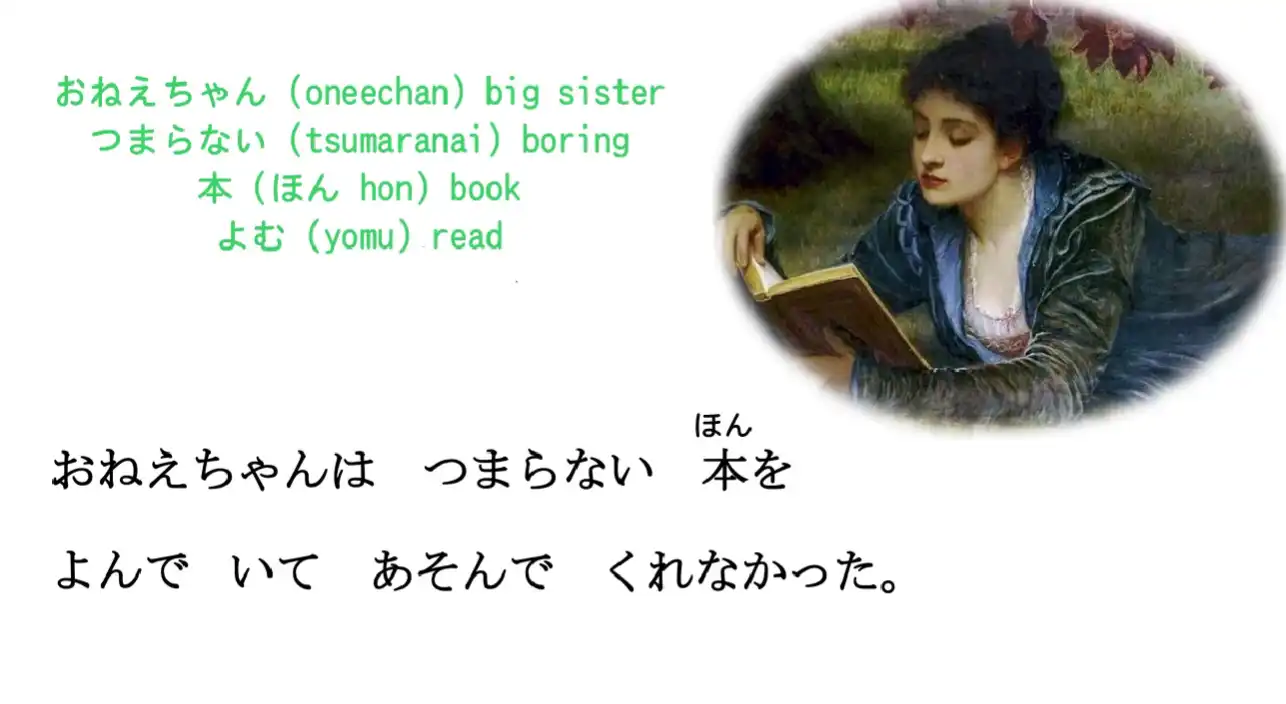
So we’ve got quite a complex sentence here, and let’s break it down.
“おねえちゃん” means “big sister”: “ねえ” is “sister”; “-ちゃん”, I’m sure you know, is a cute, friendly honorific; “お-“ is also an honorific.
So, “おねえちゃん” – “big sister”.
“つまらない” means “dull” or “boring”.
“本”, as we know, is “book”.
“よむ” means “read”; “よんでいる” – we put the “よむ” into the て-form and add “いる” and it means “is reading”; and then we put the “いる” itself into the て-form.
So why are we doing all that?
Let’s take a look.
“おねえちゃんはつまらない本をよんでいて” – “Big sister is reading a boring book” – but then that -て….
て-form has a lot of different uses.
In this case it will complete a clause.
“Big sister is reading a boring book” – that’s a complete clause, isn’t it?
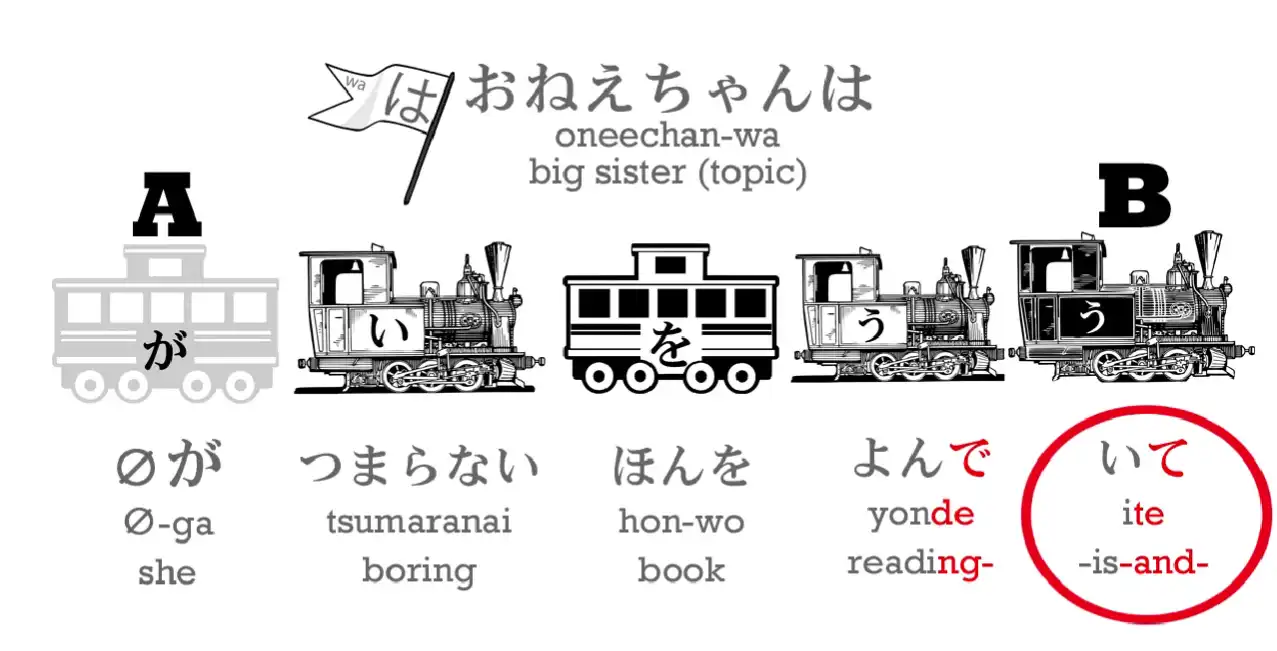
And if we turn that final う-engine into the て-form, what we’re saying is that something else is going to follow this clause.
We are indicating that we’re making a complex sentence made up of more than one clause.
So it’s like saying, “Big sister was reading a boring book and…” And that something else comes: “あそんでくれなかった”.
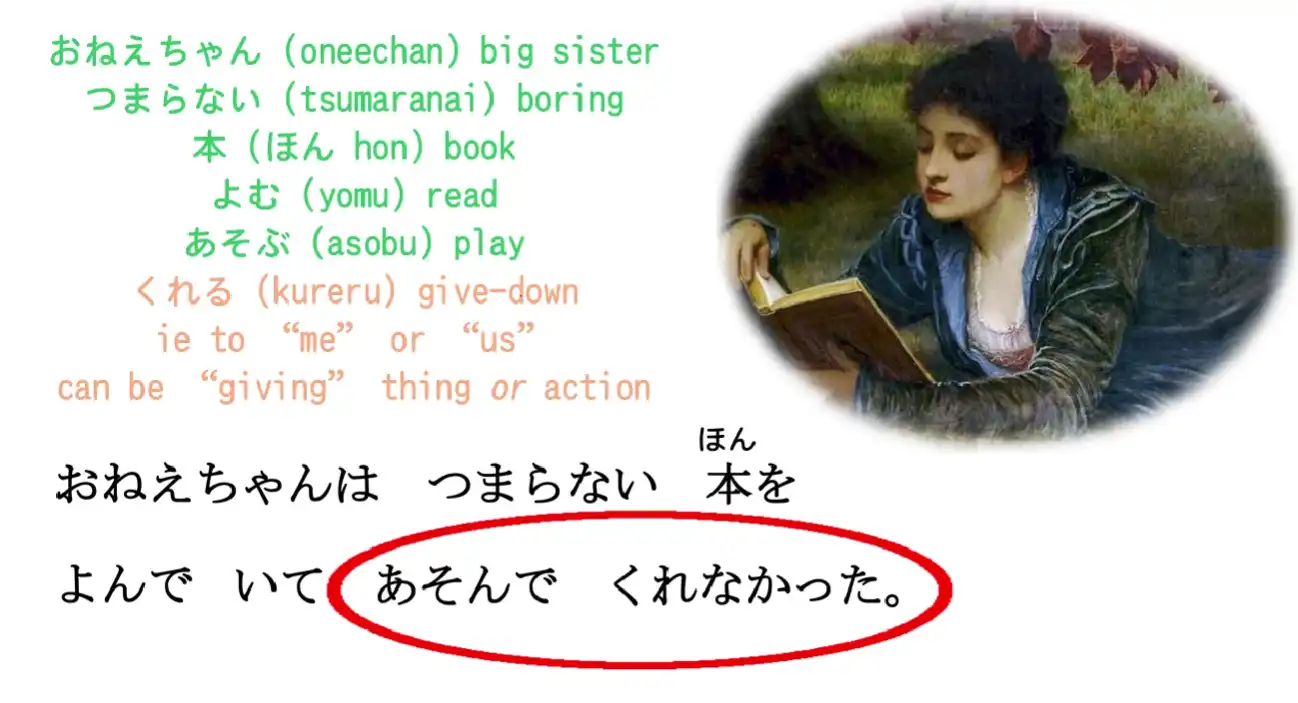
“あそぶ” means to “play”, and that also is in the て-form, isn’t it?
“あそぶ” –> あそんで”.
If you’re in any doubt of how we make these て-forms, please go back to the video lesson on the て-form and refresh your memory. (Lesson 5) “あそんでくれなかった” Now this is another use of the て-form.
て-form is terribly important and it does various different things.
What’s it doing here?
Well, “あそぶ”, as we know, means “play”.
“くれる” means to “give”, and it specifically means “give downwards”.
And the reason we say “give downwards” in Japanese
is because we are always polite to people.
So we always represent ourselves as being below other people and other people as being above ourselves.
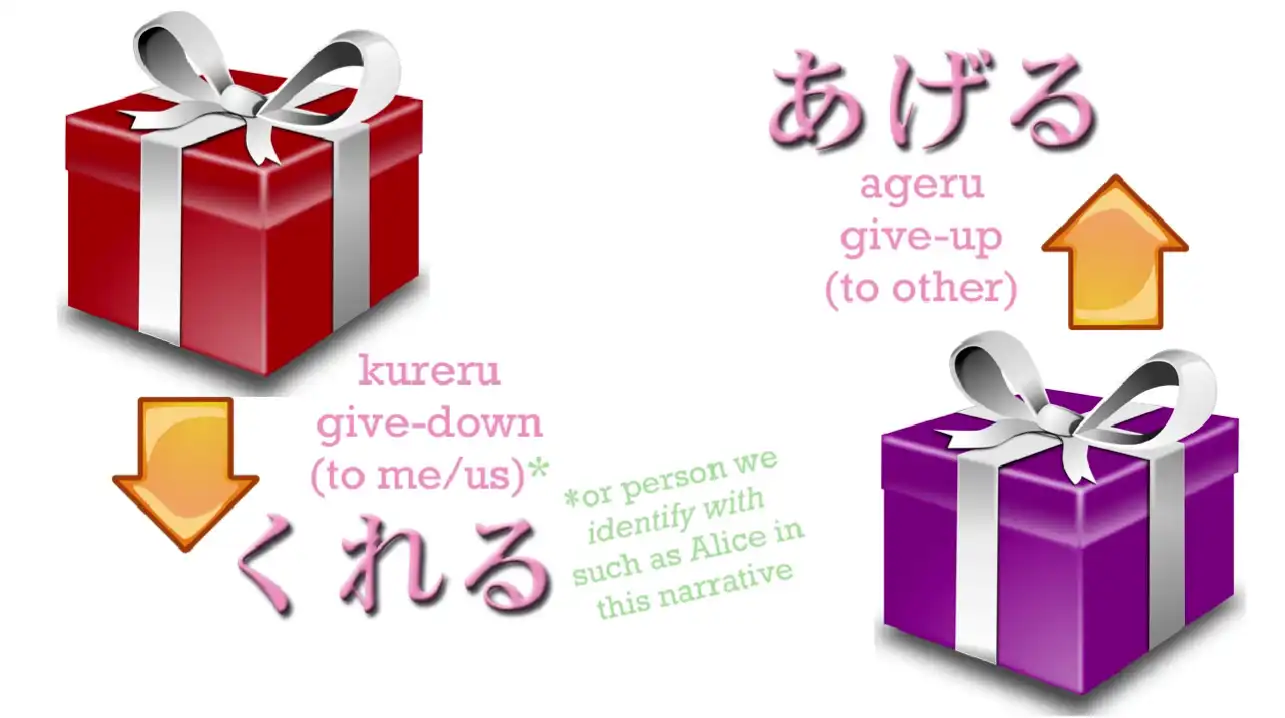
So if I say “くれる” (give), I always mean that someone is giving something to me or to someone close to me.
But what is Alice’s big sister giving – or not giving – to Alice?
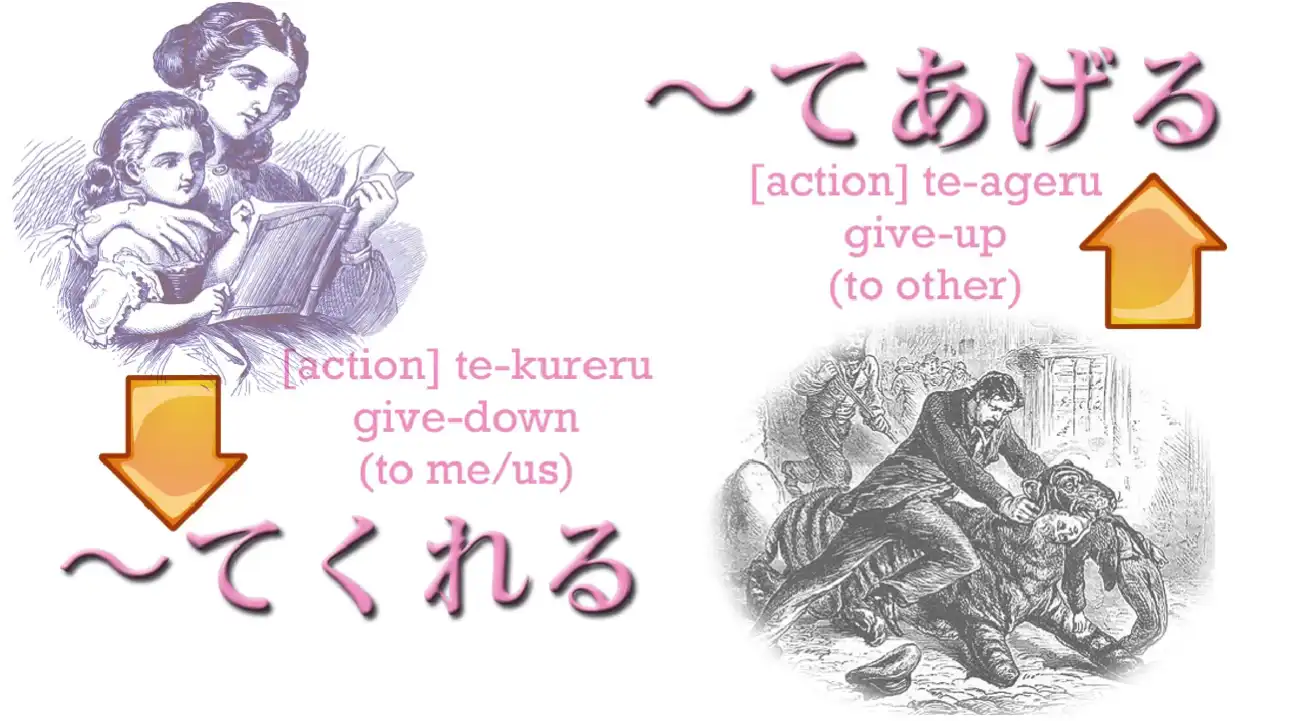
Well, it’s not the book. In fact, it’s not any actual object.
She is giving the action to which “くれる” is connected by the て-form.
She is giving – or in this case, not giving – the act of playing to Alice.
What do we mean by that?
Well, we say “くれる” not only for giving a thing – a book, a present, a candy – we also say it for giving an action, for doing something for our benefit.
This is very very often used in Japanese, so it’s important to understand it.
If someone does something for our benefit,
we turn that action to て-form and we add “くれる”.
If we do something for someone else’s benefit, we turn that action into te-form and add “あげる”, which means to “give upward”, in other words, to give to you, to give to another person.
“くれる” and “あげる” – give down to me or my group / [“あげる”] give up to you or someone else or your group or their group.
So what is this second part of the sentence?
It’s “あそんでくれなかった” – “she didn’t play / she didn’t give Alice playing-with / she didn’t play for Alice’s benefit”.
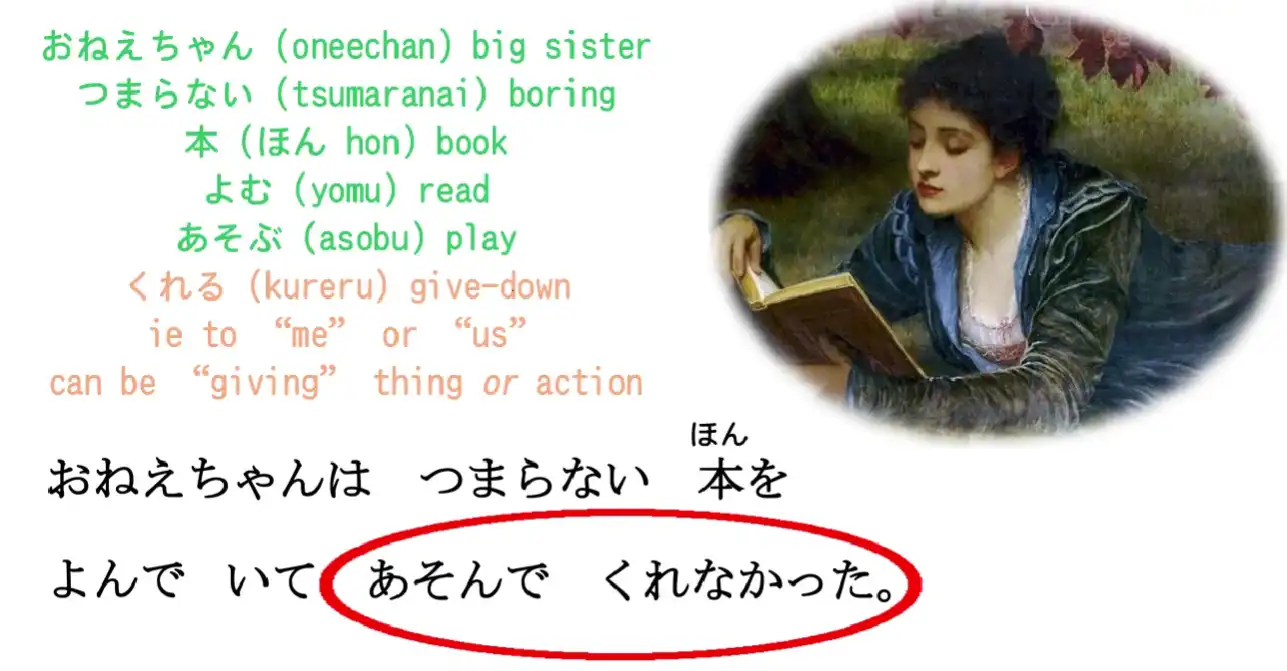
It’s rather different from anything we find in English, but it’s also very expressive, something we could actually do with having in English.
So now let’s look at the whole sentence again.
“おねえちゃんはつまらない本をよんでいてあそんでくれなかった” – “Big sister was reading a boring book and did not play [with Alice]”.
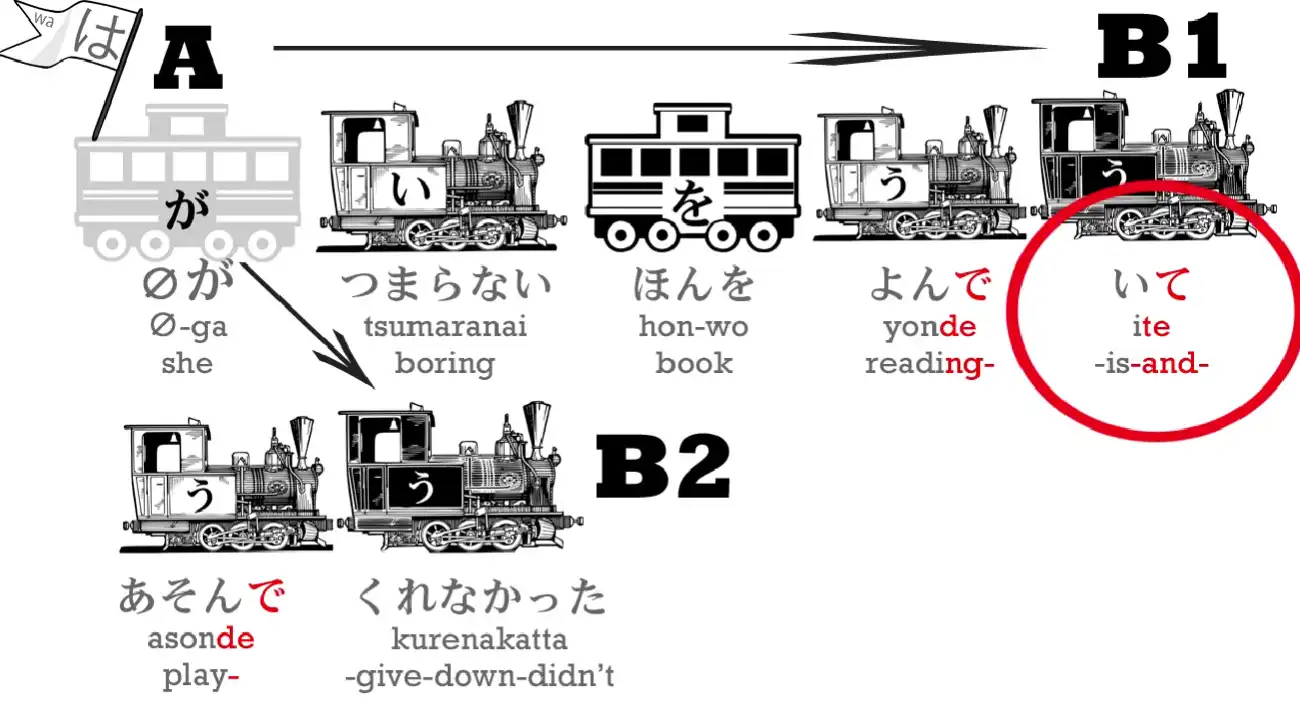
Notice that we have two complete clauses here:
Clause 1: “おねえちゃんはつまらない本をよんだ” – that’s a complete clause in itself, isn’t it?
Clause 2: “おねえちゃんはあそんでくれなかった” – “Oneechan did not play for Alice’s benefit” And we’ve connected the two together with the て-form.
A thing we should notice here is that “おねえちゃんはつまらない本をよんで”
doesn’t tell us the tense.
We don’t know whether she’s reading a boring book right now or in the future or in the past. We don’t know that until we get to the end of the sentence.
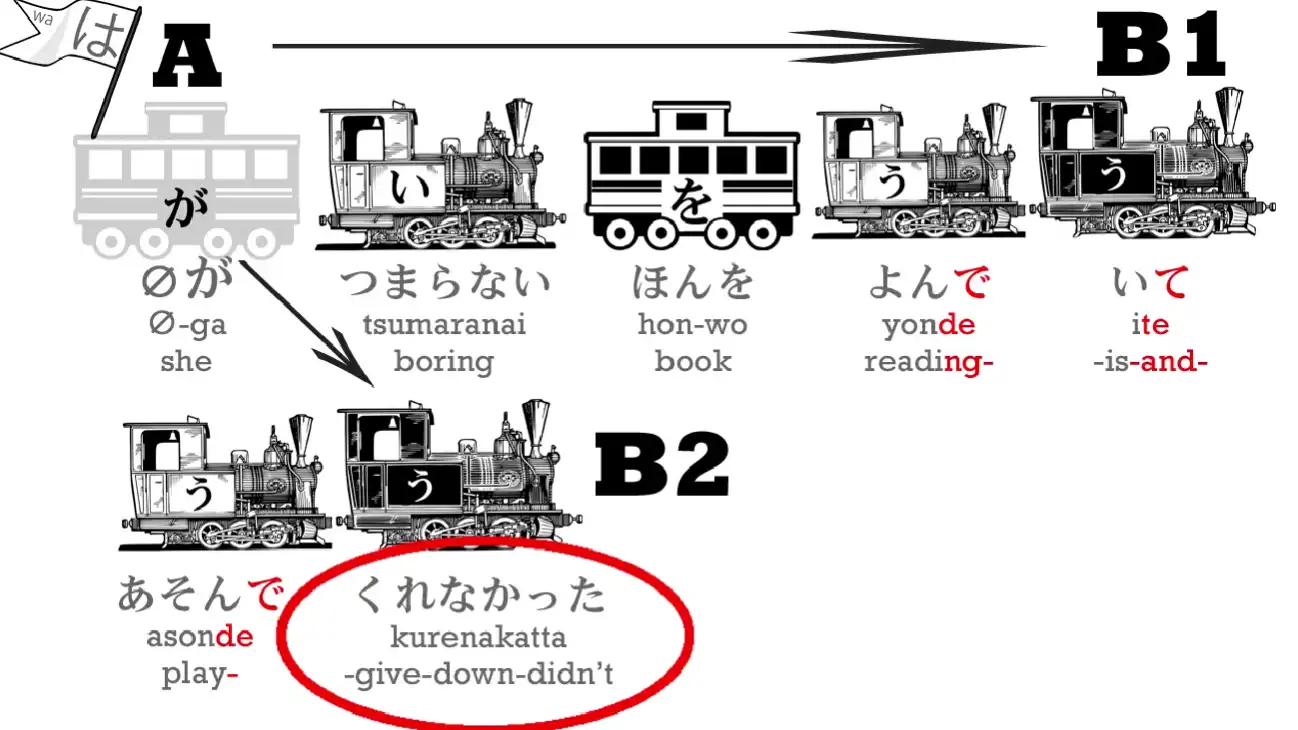
In English we put the tense marker on both halves of a complex sentence.
We would say, “Big sister WAS reading a boring book…” so we already know that it’s in the past.
But in Japanese we put that tense marker, -た or -かった, at the end and we only need one tense marker per sentence.
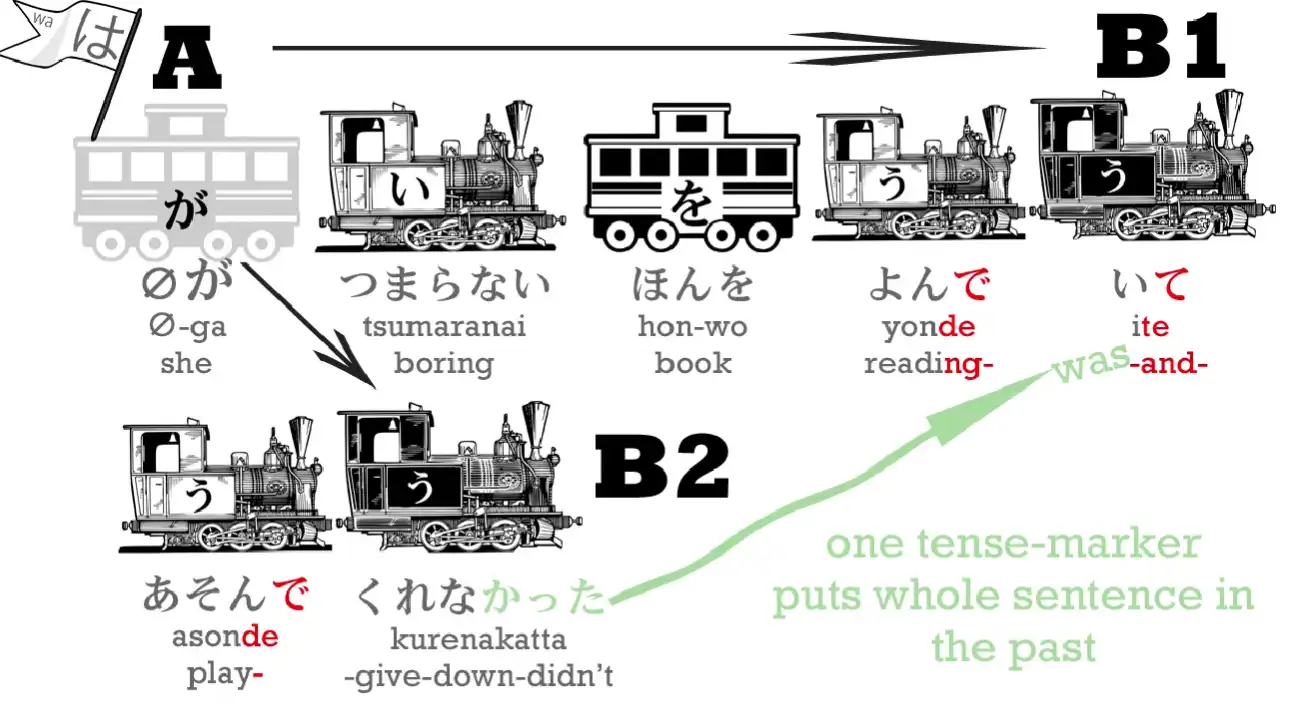
“よんでいて” could mean “is reading” or could mean “was reading”, but because the “あそんでくれなかった” is in the past and it’s part of the same sentence we have put everything into the past.
Well, we didn’t get very far into Alice’s adventure today, did we?
But we can proceed faster as we get used to real text and learn the basic narrative structures.
12. Quotation particle と, compound verbs & nouns
Lesson 12: と quotation particle secret - plus compound verbs, compound nouns - and More Alice!
こんにちは。 Today we’re going to continue with the narrative lessons that we started last week. And this time we’re going to be able to proceed a little faster. So let’s refresh our minds on the story we’ve read so far.
ある日アリスは川のそばにいた。 (One day Alice was by the river.) お姉ちゃんはつまらない本をよんでいてあそんでくれなかった。 (Big sister was reading a boring book and did not play with Alice.) 「おもしろいことがない」とアリスは言った。
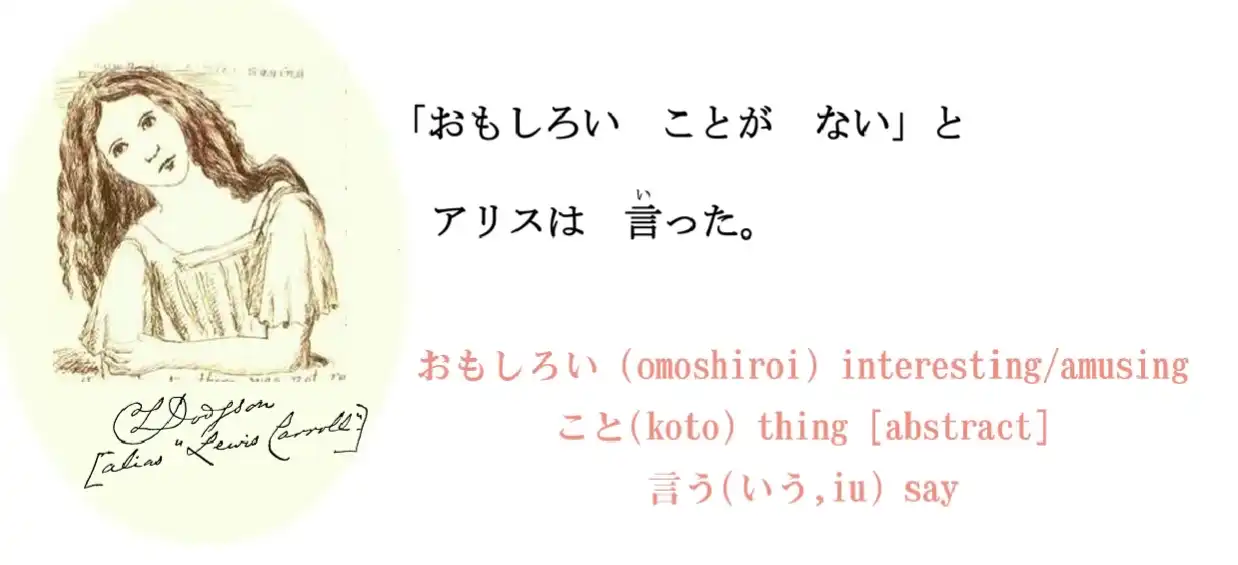
「おもしろい」 means “interesting or amusing”; 「こと」 means “a thing”. And in Japanese we have two common words for “thing” , and they are もの and こと.
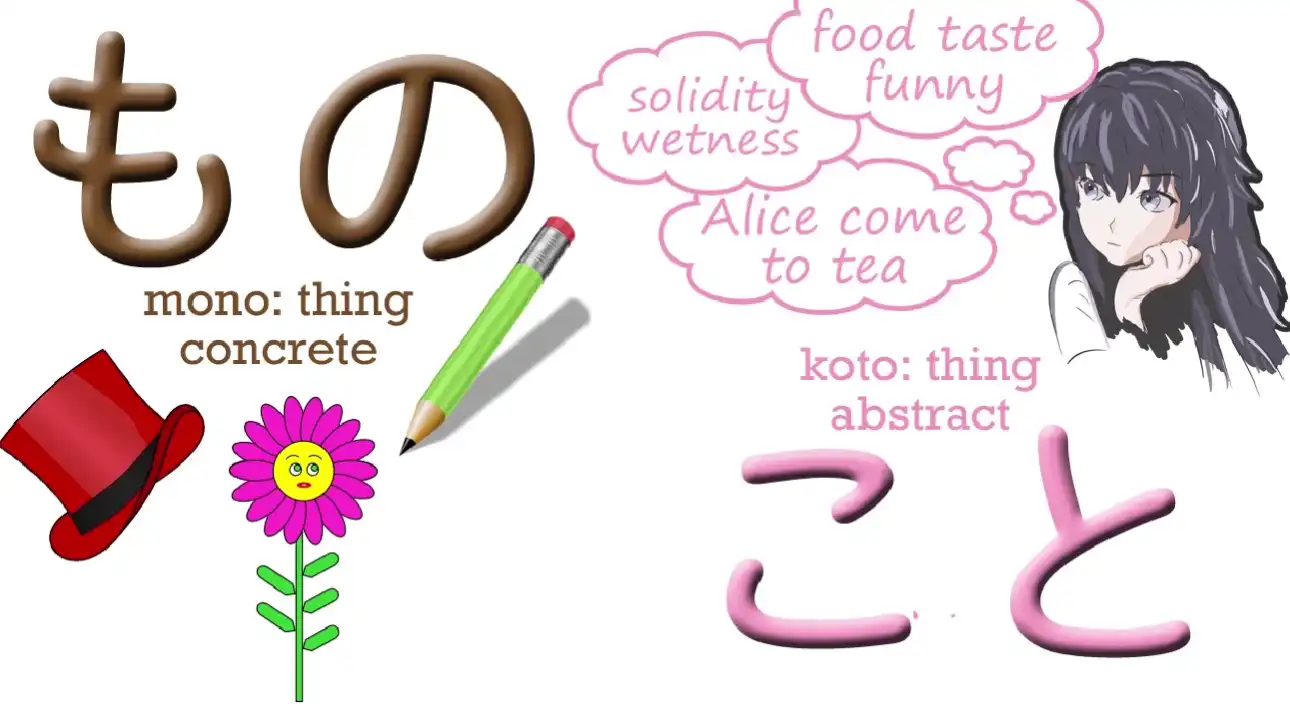
Now, a もの is a thing in the most usual sense: a physical thing – a hat, a book, a pair of glasses, Mount Fuji.
こと is a more abstract kind of “thing”: an affair, a matter, a circumstance.
So, when we say, “Is there anything in that box?” we mean もの.
And when we say, “The thing is…” we usually mean こと.
So, 「おもしろいことがない」means “There’s nothing interesting going on here, no interesting circumstance.” 言った - 言う means “say” and you can see it’s like a mouth with soundwaves coming out of it.
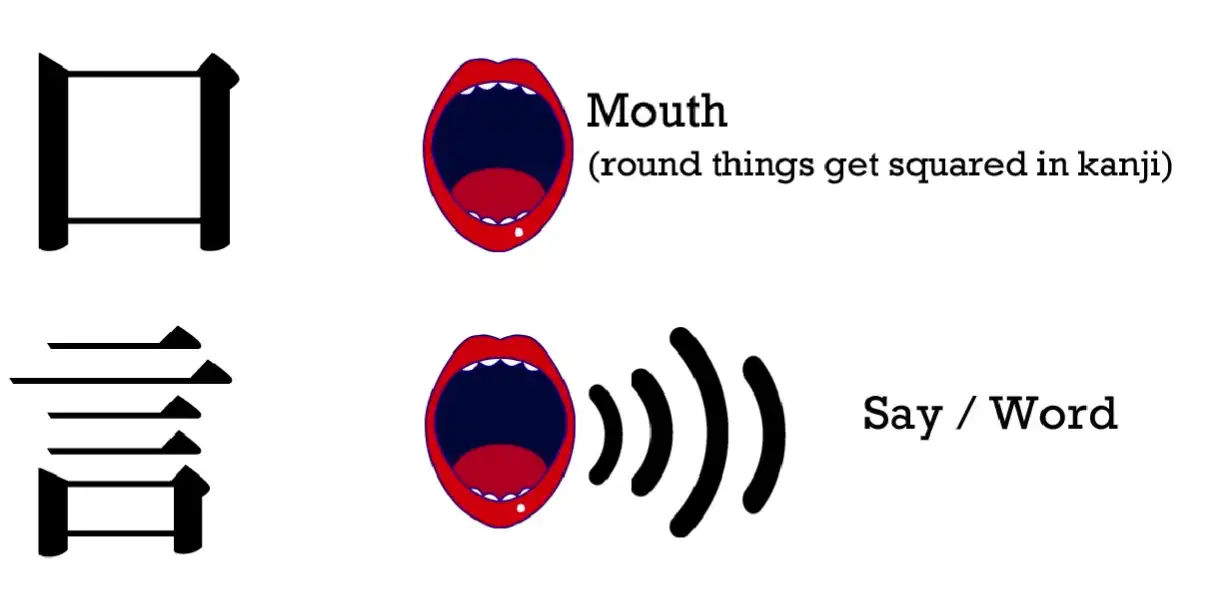
But the important thing to notice here is that little particle と.
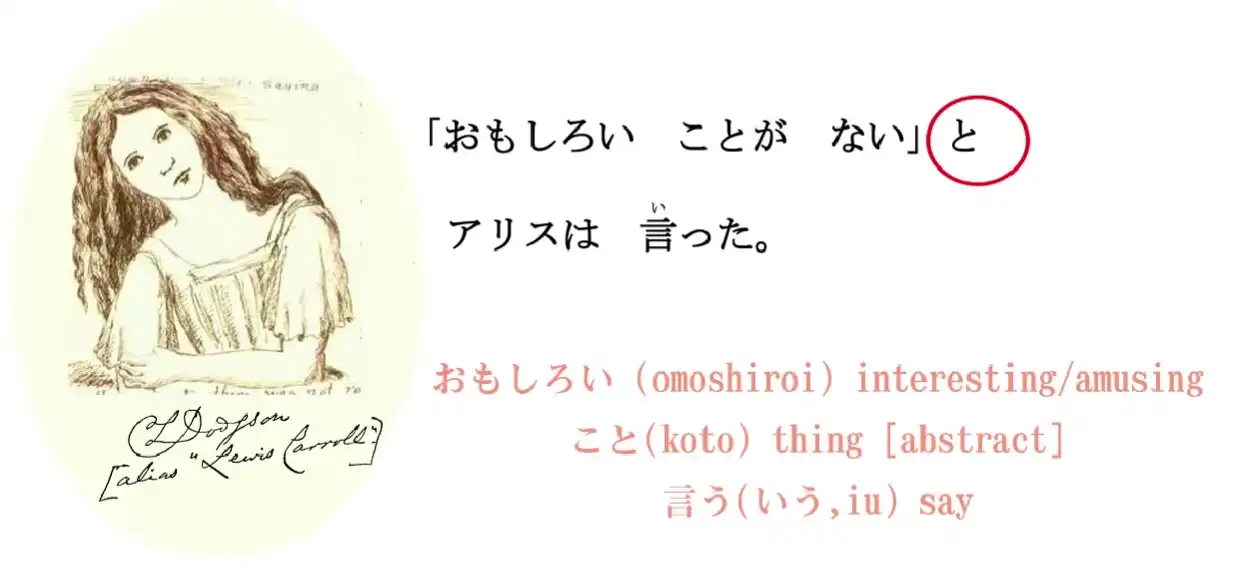
There are actually two と particles: one means “and” and it’s very simple; the other one is what we call the “quotation particle”, and that’s what we’re dealing with here.
When we quote someone as saying something or even as thinking something, we use this particle と. It’s kind of like a quotation mark that you can hear.
As you see, we use the square quotation marks in Japanese, which are the equivalent to English quotation marks, but we also use the と.
So we don’t just say, “ ‘Nothing interesting is happening,’ Alice said”. We say, “ ‘Nothing interesting is happening,’ と Alice said”. Now, と is a very interesting particle structurally and we’re going to look into that a little more deeply in a few minutes.
そのとき、白いウサギがとおりすぎた。
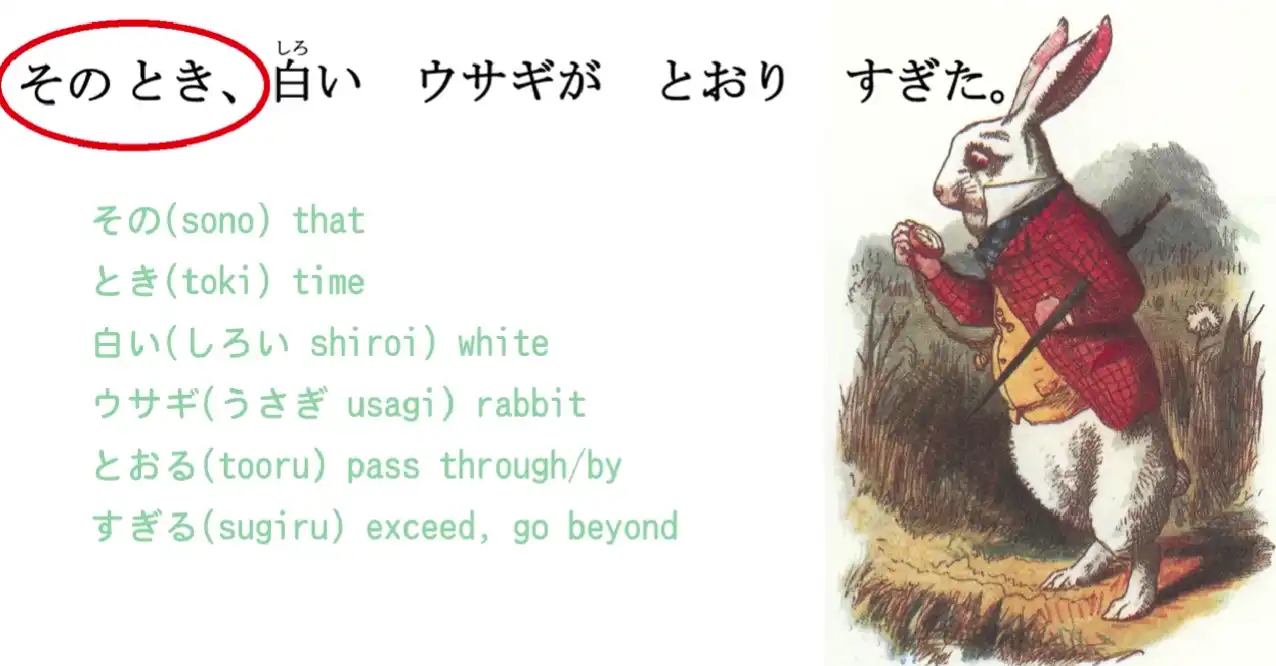
「そのとき」: その means “that” and とき means “time”, so we’re literally saying “that time”, but this is a bit more like saying “just then / at that moment / at that time”.
So we use just the way we use other relative time expressions: we don’t need to put に or anything else with it, we just state the time and then continue with what was happening at that time.
In this particular sentence, the point of 「そのとき」 is that just at that moment when Alice had been saying that there was nothing interesting happening, just at that time, this happened.
そのとき、白いウサギがとおりすぎた。 白い means “white”; it’s an い-adjective. ウサギ means “rabbit”. And 「とおりすぎた」is made up of two words, and it’s doing something that we’re going to see over and over and over again in Japanese.
It’s using the い-stem of one verb to attach another verb to give it extra meaning.
So とおる means to “pass through” and すぎる means to “exceed or go beyond”. So とおりすぎる connects those two words together: とおる (pass through); すぎる (go beyond) and it means “passing by”. A white rabbit passed by.
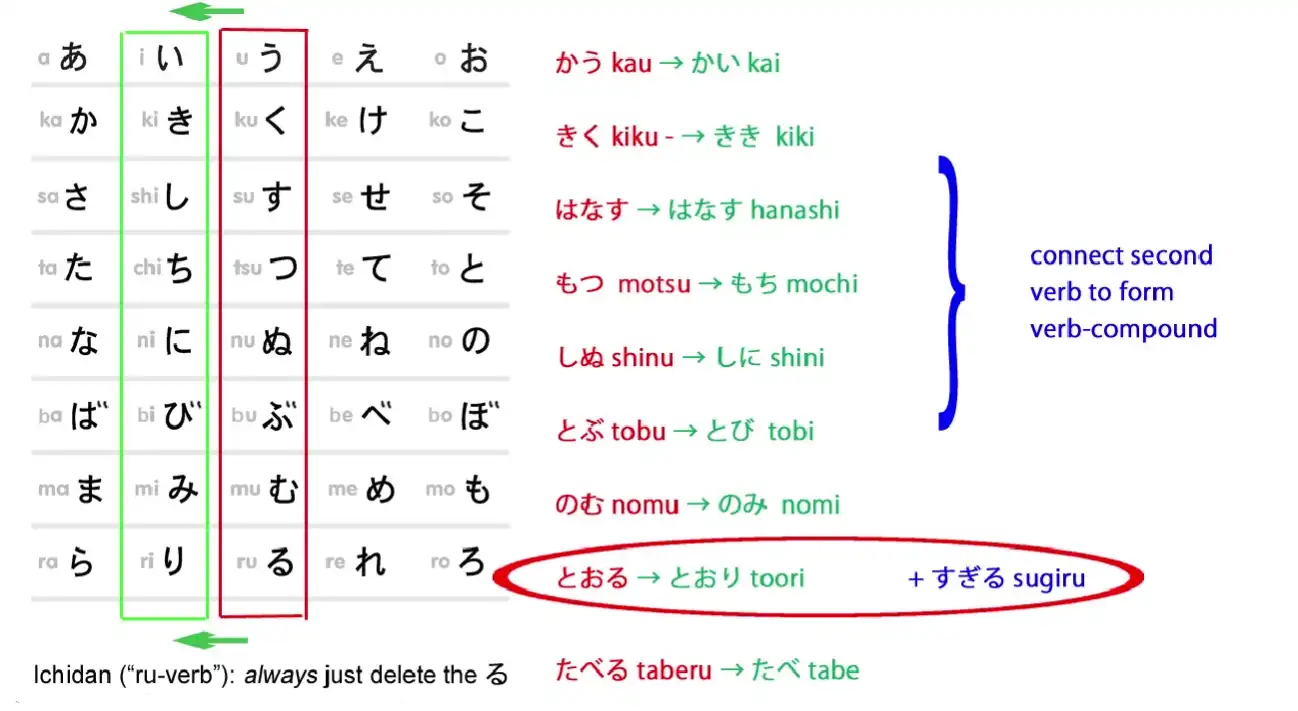
そのとき、白いウサギ (white rabbit) とおりすぎた (passed by)。
ふつうのウサギではなくて、チョッキをきているウサギだった。
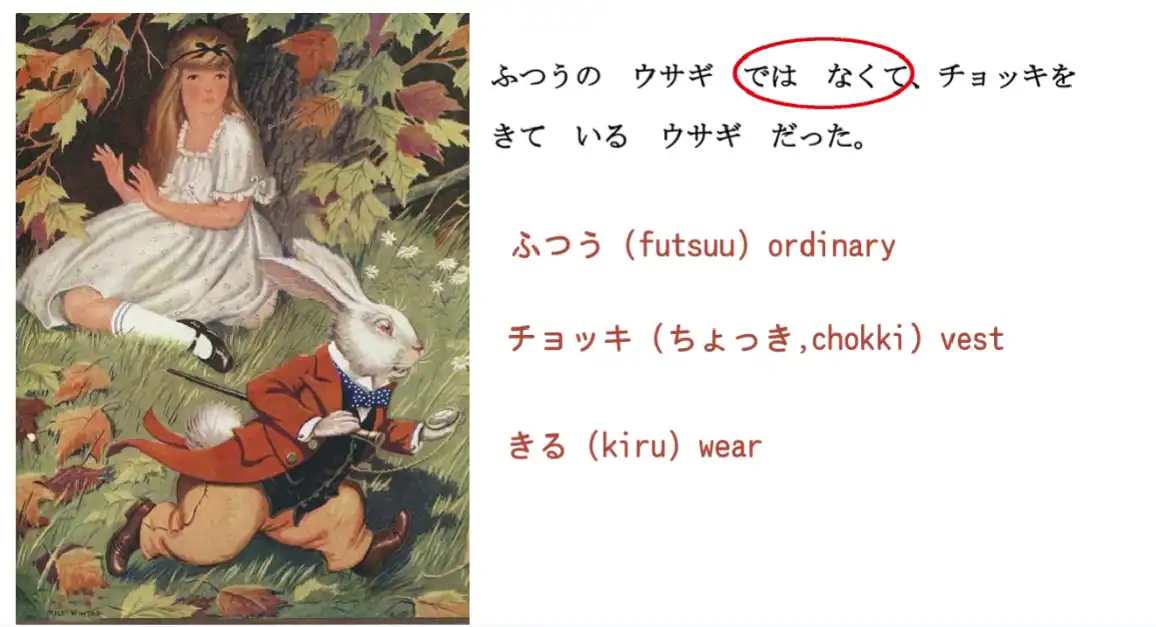
「ふつうのウサギではなくて…」 Now, ふつう means “ordinary”, and the rest of this you already know. ではない means “it isn’t / it wasn’t” and we’re putting into the て-form because this is part of a complex sentence – and we looked at complex sentences last week, didn’t we?
(Lesson 11, Dolly gives 7, but it might be an error since て-form isn’t there… but check also 5) So, 「ふつうのウサギではなくて」= “It was not an ordinary rabbit.” 「…チョッキをきているウサギだった。」 チョッキ means a vest; きる means “wear”, so 「きている」 means to “be wearing / be in the act of wearing”. And “だった”, of course, is the past tense of the copula.
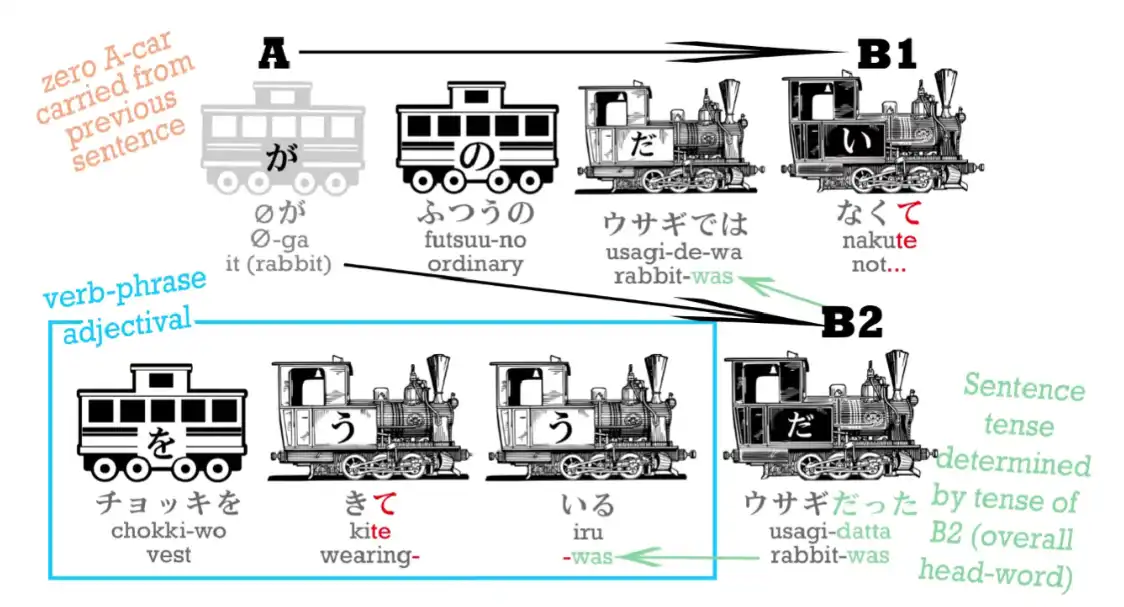
So this is: “It was not an ordinary rabbit, it was a wearing-a-vest rabbit / it was a rabbit that was wearing a vest.” ウサギはかいちゅうどけいを見て「おそい!おそい!」と言って、はしり出した。
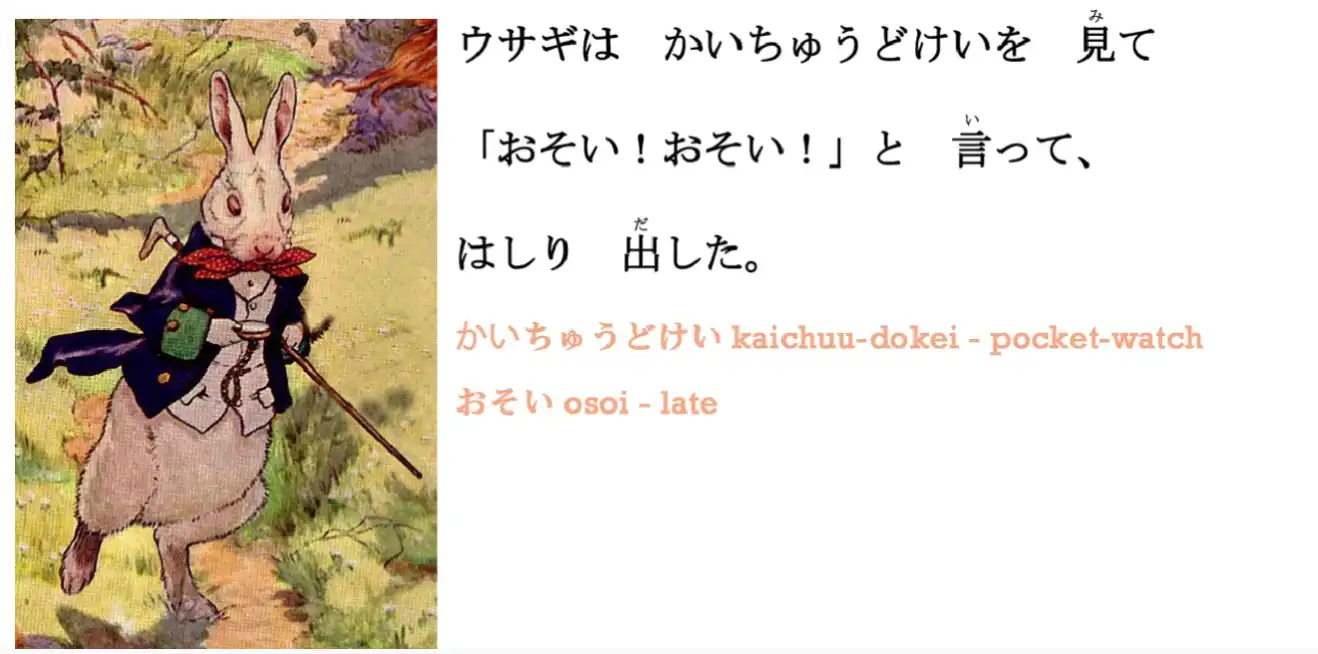
「ウサギはかいちゅうどけいを見て…」 かいちゅうどけい is not a word we’re going to encounter all that often because there aren’t many of them around these days, but it is an example of something we’re going to see an awful lot, which is that in Japanese, as you know, we can modify one noun with another by marking the first one with の (or な, which is a form of だ) but we can also, when we’re not just modifying one noun with another but forming a new noun, we can simply ram them together.
We don’t have to modify them in any way, the way we do with verbs (we turn them into the い-stem), but you can’t do that with nouns, nouns don’t have any stems, they don’t modify in any way – so, when you’re putting two nouns together to make a new noun, you simply push them into each other. This is the same as what we do in English, with words like seaweed or bookshelf. We just push two nouns together to make a new noun.
So the parts of this noun, 「かいちゅうどけい」: かいちゅう/懐中 is a slightly unusual noun – it means “in one’s pocket or the inside of one’s pocket” and とけい/時計 is a very common word – it means “clock or watch” (we have the same word for a clock in Japanese whether it’s a small one or a big one), so かいちゅうどけい/懐中時計 is a pocket watch.
And the reason we say 「どけい」instead of 「とけい」 is what Alice in “Alice in Kanji Land” calls “ten-ten hooking”, and this is that when you push two nouns together, in the way that we are doing here, and the second one begins with a sharp sound like “t” or “k”, we turn it into its equivalent dull sound like “d” or “b”. (=Rendaku - “sequential voicing”)

Note: It USUALLY seems to happen when the 2nd noun in the compound has a sharp Kun’yomi sound that has an equivalent dull sound - h -> b, t -> d, k -> g, tsu/s -> z, sh -> j etc. On’yomi compounds USUALLY don’t have this change, SOMETIMES, if “n” is before, it can trigger it too. And of course in Japanese you do this by adding those two small marks ゛(だくてん) to the kana, so と becomes ど, た becomes だ, く becomes ぐ, さ becomes ざ etc.
So, for example, あお is blue, as you know, そら is “sky” and when you put them together you get not あおそら but あおぞら. We put the ten-ten onto that sharp word, and Alice calls that “ten-ten hooking”. (ten-ten, lit. “dot-dot”, seems to be a colloquial name for dakuten ゛) It’s as if those two little points, those two little claws, hook into the word before it to turn them into a single word. It’s a thing you’re going to see very often.
And just as in English you can’t do this with any two nouns, but there are a lot of nouns that are made up of two nouns and so long as one of the nouns isn’t a slightly unusual one like かいちゅう, they’re very easy to understand, just as they are in English.
And then we have: 『…「おそい!おそい!」と言って…』
The と quotation particle
Now, we’re going to look at what this と actually does, and as we get into more complex sentences, three-level compound sentences like this one, we start to see how useful it becomes.

What と actually does structurally is that it takes whatever it marks – and that could be two words like this or it could be a whole paragraph with all kinds of other grammar going on in it – it takes whatever it marks as a quotation and turns it effectively into a single noun.
So a と carriage is a white noun-carriage marked with と.
And we’re going to find as we go on that this is used not only to mark things people say and things people think, but all kinds of other things. And we’ll have an example of that a little later in this lesson.
But this と structure is essentially making a quasi-noun out of whatever is marked with と, and the と then makes it function as a modifier to the verb that follows.
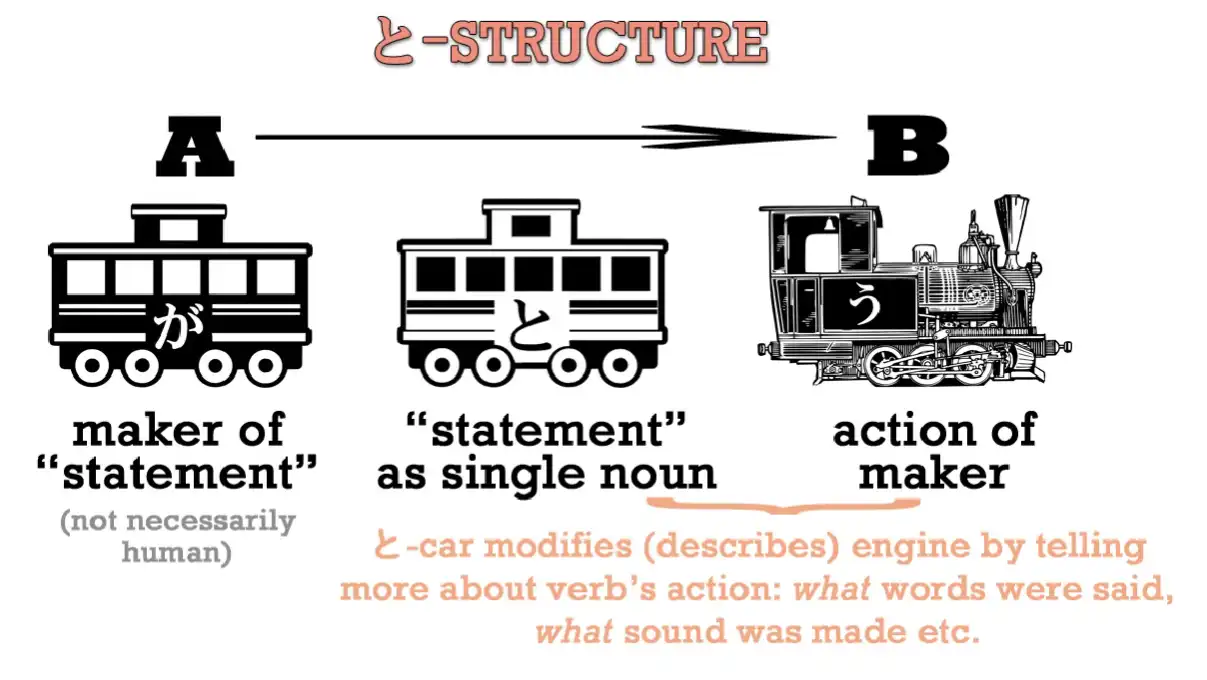
When it’s a simple quotation like that, the verb is going to be 言う (to say), but it could also be 考える (to think) or 思う (to think or feel), but it can be many other things too, as you’re going to see in a moment.
So this is the structure of a と marked statement of any kind.
『「おそい!おそい!」と言って、はしり出した。』 おそい means “late”. And in order to make it a sentence, obviously we have to have a zero-pronoun here. So the rabbit is either saying “It’s late!” or “I’m late!”

ウサギは(zeroが)かいちゅうどけいを見て「おそい!おそい!」と言って、はしり出した。 Rabbit as for (it/he) pocket watch looked-and “late! late!” said-and run-broke out. In the Disney version, of course, it was “I’m late!” 「おそい!おそい!」(“I’m late! I’m late!”) We don’t need to say と with ウサギは言って this time because we’ve got ウサギは at the beginning of the sentence and this is a compound sentence. So the second part of the compound sentence has the same main carriage, the same subject as the first half.
『「おそい!おそい!」と言って…』 (“The rabbit said, ‘I’m late! I’m late!’”) And that 言って is another compound 言って, so this time we have a three deep compound sentence.
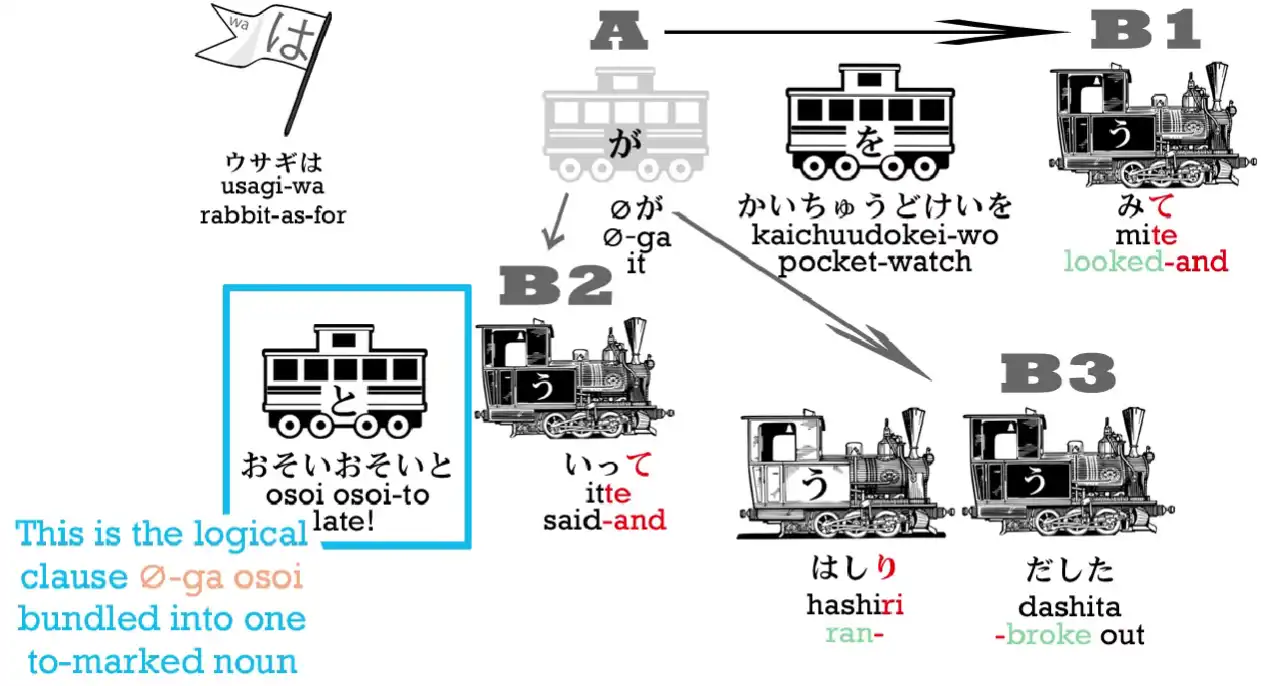
Note: Blue box - the quoted rabbit’s words also seem to have a zeroが since meaning (I) late. The rabbit looked at his watch, he said 「おそい!おそい!」, and then… he did something else: 「はしり出した。」 はしる means “run” and 出す literally means to “take out”, but this is a combination we’re going to see very often in Japanese.
Once again, we’re using that い-stem , which is the main connecting stem, to connect
はしる to 出す. And what does it mean here?
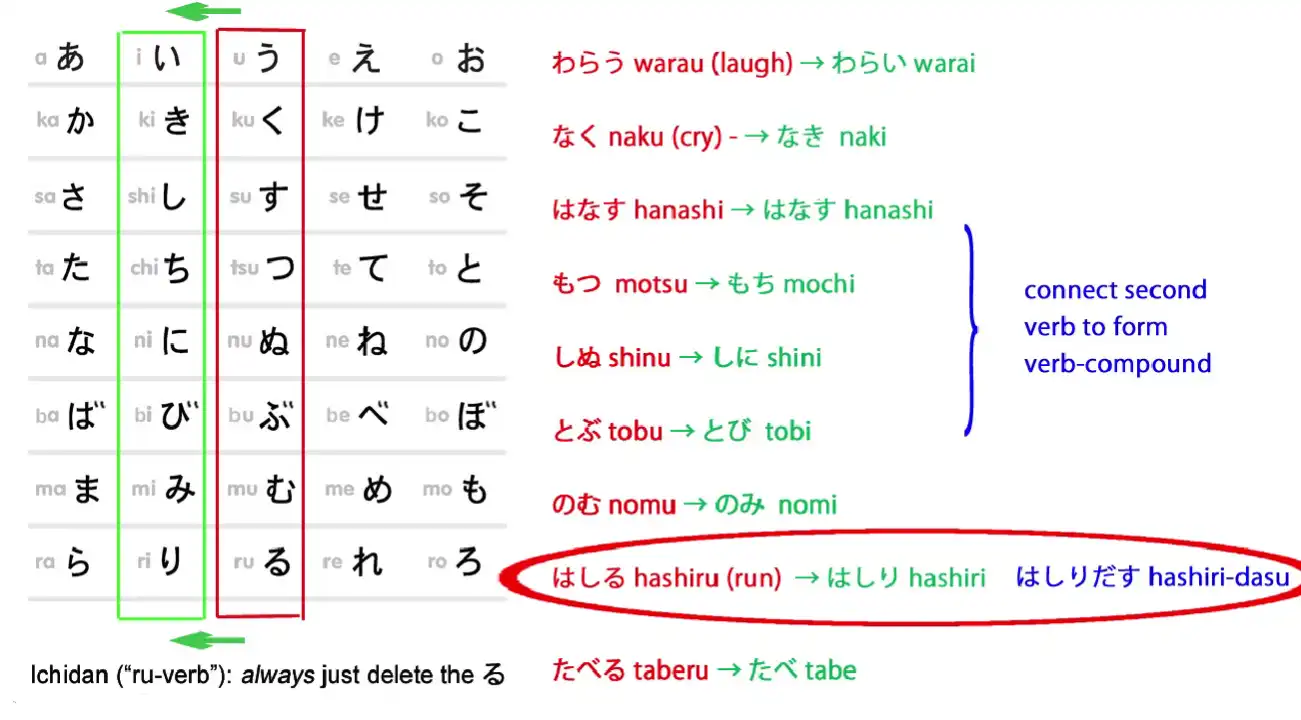
Well, that 出す when it’s connected to a verb means that the action of the verb “erupted”.
So we can say that someone 泣き出した: 泣く/なく is “cry”, and we connect the い stem of 泣くto 出す, and 泣き出す means “burst out crying”.
We can say 笑い出す: 笑う is “laugh” and if we connect the い-stem of 笑う to 出す, we’re saying “burst out laughing”.
And in this case what happened? The rabbit suddenly burst out running – it broke into a run.
ウサギはかいちゅうどけいを見て「おそい!おそい!」と言って、はしり出した。 (The rabbit looked at its pocket watch, it cried ‘I’m late! I’m late!’ and it broke into running.)
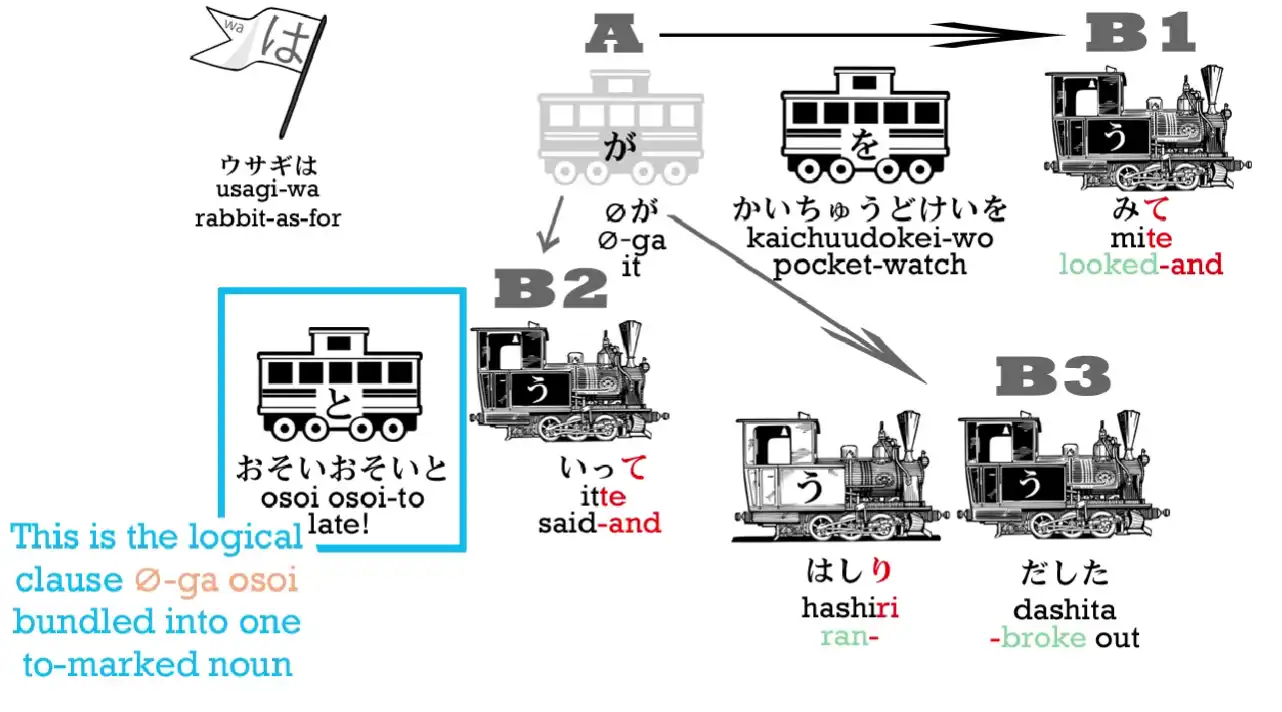
「ちょっとまってください」とアリスはよんだ。
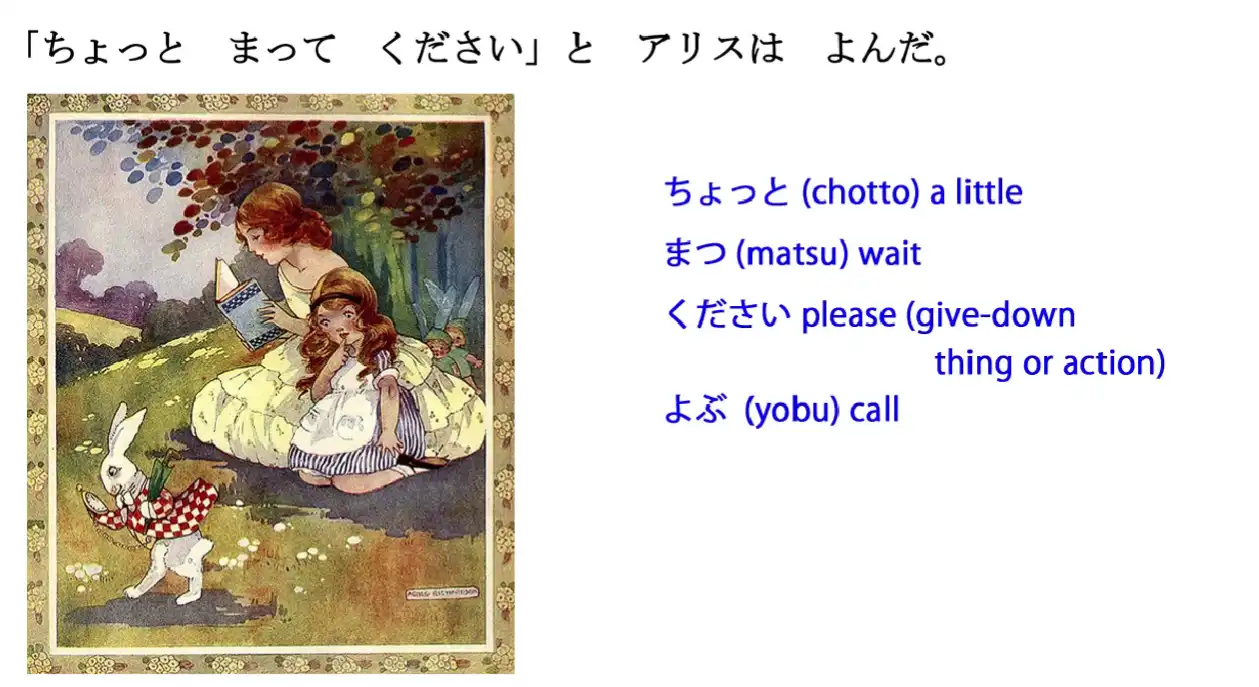
「ちょっとまってください」is a phrase you’re going to hear a lot in Japanese. Sometimes the ください will get left off. What does it mean?
ちょっと means “a little”; まって is the て-form of “待つ/まつ”, which means to “wait”; and ください means “please”. It’s actually connected with くれる, which we talked about last time (lesson 11); which also refers to giving down – it’s “please give down to me / please lower down to my level”, so that’s a polite way of saying “please give”.
But it’s not just giving a thing, just as with くれる and あげる, it’s not just giving a thing, it can also be, if you connect it to the て-form of a verb, giving the action of that verb.
So you can see it’s very related to that くれる and あげる that we learned last week.
「ちょっとまってください」 Now, because this is so common, very often when we put a verb into て-form and address it to someone, it’s kind of short for てください. 「ちょっとまってください」means “Please wait a little”. So she’s asking the rabbit to stop; she wants to meet with the rabbit.
「ちょっとまってください」とアリスはよんだ。 So we’ve got that と particle again, the quotation particle, which we need when we quote anything, and then よんだ. 「よんだ」: what does that mean? Well, we’ve come across よんだ before I think, haven’t we? And it means “read”, “read” in the past. That is the た form —the だ-form in this case—of 読む. But in this case it’s different. It’s the だ form of 呼ぶ.
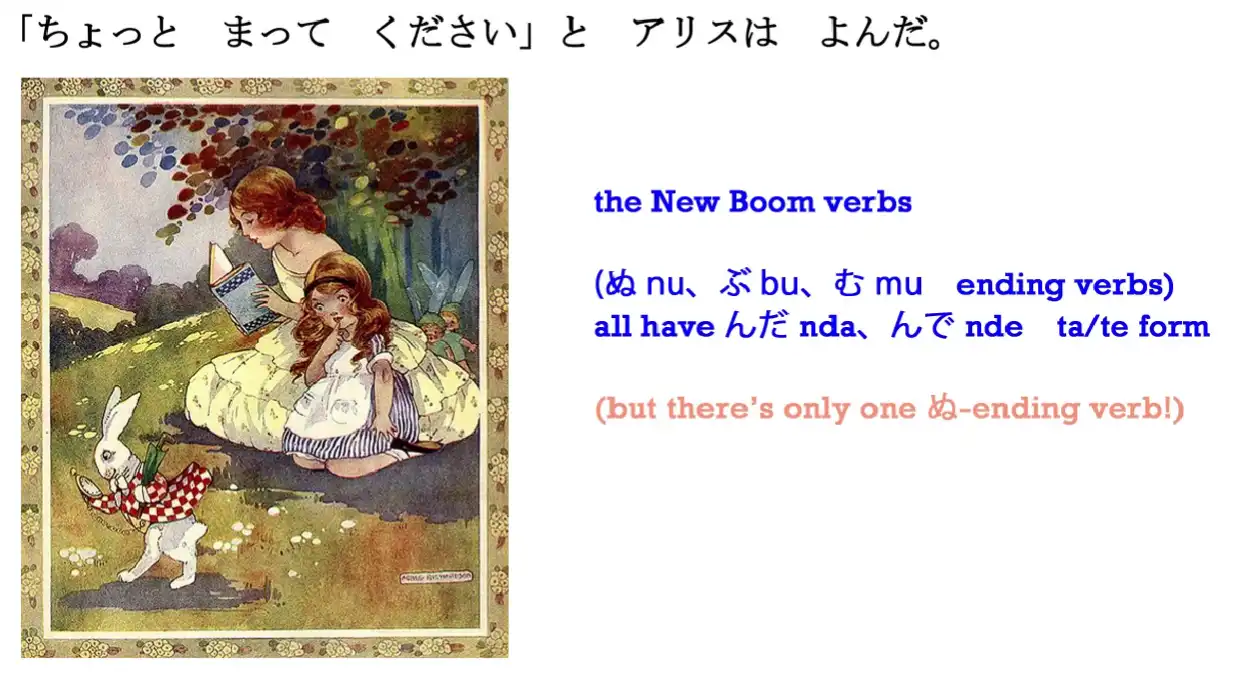
If you remember from our て and た form lesson (Lesson 5), the New Boom group of verbs, ぬ, ぶ, and む ending verbs, all form their て form with んで and their た form with んだ.
So both 読む and 呼ぶ have the past form よんだ. Fortunately, we’re not very often likely to get reading and calling mixed up, are we? This 呼ぶ means to “call”, to “shout out”. It can mean “call” in any of the senses that “call” is used in English. You can call someone a name, you can call an apple a lemon (but you’d be wrong) or you can call out.
「ちょっとまってください」とアリスはよんだ。 (‘Please wait a minute!’ called Alice.) でもウサギはピョンピョンとはしりつづけた。
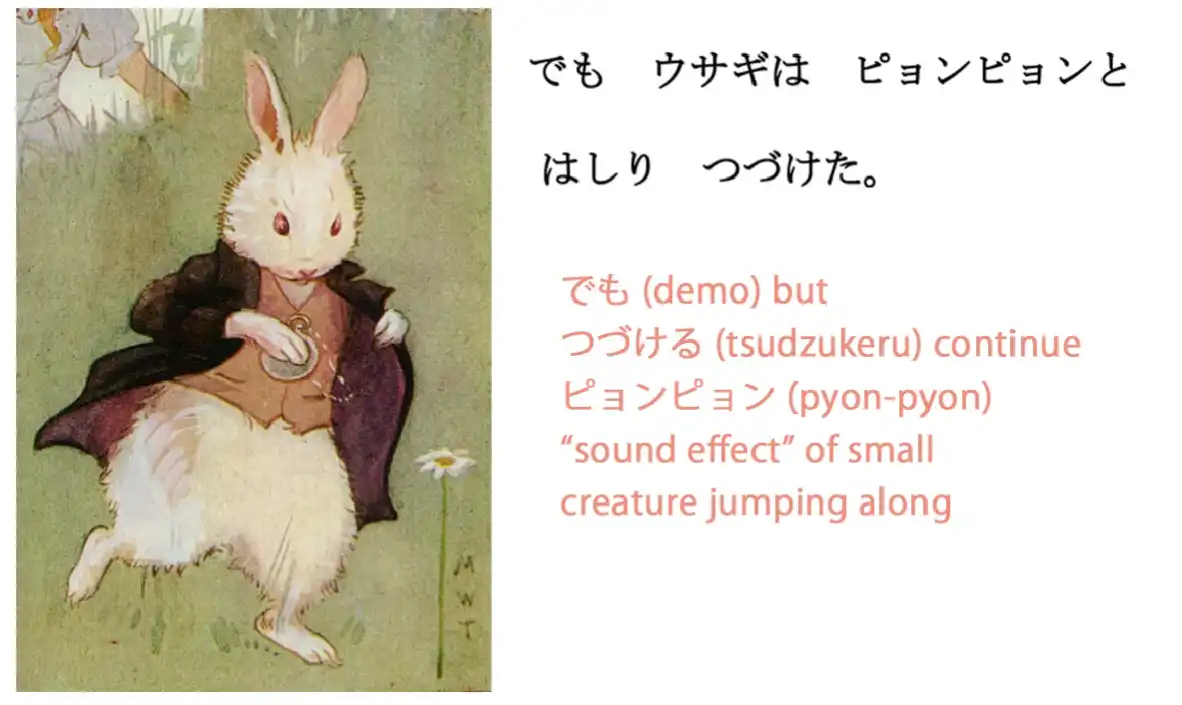
Note: If you want to type 続ける/つづける, you must type tsuDUkeru. Dzu gives ”dず”. でも means “but”. はしる means “run”.
And we’re going to leave out ピョンピョン for just a moment here. つづける means to “continue”.
So again we’ve got this form of taking the い-stem of a verb, はしる becomes はしり and then we add onto it the verb つづける (to continue).
So 「ウサギははしりつづけた」means “The rabbit continued running”.
ピョンピョン is something we’re going to find very often in Japanese and that is, a doubled word that is a sound effect.
There are lots and lots of these in Japanese, [e.g.] 「シクシク」, which is the sound effect for crying. And some of them will be literal sounds and some of them describe states of various kinds. So we’re going to be meeting a lot of these later.
ピョンピョン is almost a literal sound effect. It’s the sound of a small thing jumping along, and you’ll hear this an awful lot.
I do at any rate, but then, a lot of my friends are small things that jump along. So ピョンピョン is the sound, or not quite a sound, it’s… if it were an anime you’d probably hear the sound, wouldn’t you, ピョンピョンピョンピョン… – but in this case it’s not necessarily a sound you hear, but it’s the feeling, the sound-like feeling of a small thing, a small animal, jumping, jumping, little jumps. So, because it’s a rabbit, it didn’t run the way you run, it runs in a little jumping, bouncing fashion the way rabbits do.
And the thing to note here is that we say ピョンピョンと. So once again we’re using that quotation particle. In this case we’re using it to show how the rabbit ran, and because this is kind of technically a sound effect, we’re “quoting” the sound the rabbit made in order to tell the manner in which the rabbit ran. It ran in a little-jumps kind of manner.
All right. So next week we’ll find out what happened. What do you think Alice might have done?
Note: This one was pretty long and a bit annoying to edit, heh, but I have managed, yee (•̀o•́)ง
13. Passive Conjugation / Receptive Helper Verb
Lesson 13: “Passive Conjugation” debunked: NOT passive. NOT a conjugation. IS easy.
こんにちは。 Today we’re going to talk about the receptive helper verb.
In other places you will hear this referred to as the “passive conjugation”.
Now, as we’ve already learned, there are no conjugations in Japanese, so it can’t be a conjugation.
Note: Again, Dolly says this to make it easier to understand, but if one would go into depths of linguistics it could be argued. I say this to show that there are a LOT of nuances as one goes deeper into a language and things are rarely simple and straightforward as you get past the basics, so one should keep this in mind. If you truly love reading, under this video, there’s a VERY long, interesting discussion about this. But overall, there is no purely “right” or “wrong” really, just “more helpful” or “less helpful” for an individual. Also, it isn’t passive. So that’s zero out of two for the textbooks.
And this matters because if we think of the receptive helper verb as a passive conjugation, it completely disrupts our grasp of the structure and, once again, it throws those poor particles all over the room.
And as we know the particles are the linchpins, the hinges on which Japanese turns. So if we mess up the particles we are in deep trouble. And this is why so many people find Japanese hard to understand.
###
Just one of my rambling notes about the technicalities of terminology
Note: There is nothing wrong with calling it passive, you just need to keep in mind that it is different from the English passive, Dolly uses the term “receptive”, so this is her terminology she uses to avoid confusion in her model. In Japanese, it is referred to as 受身形 - passive form, though Dolly goes off the first Kanji which can mean receive, so I see why and it is a good term too if anything.
In basic terms, it could be said that the passive form in itself includes the receptive function as
it is mostly used to put the Subject function onto the Patient (the receiver) of the action of the base verb (through れる) instead of the Agent (the doer of the action of the base verb), while Agent is usually marked by the に in Passive, though there are more details which will be discussed, so Dolly’s approach is fully valid too, but the term Passive works too in my opinion, though requires more linguistic base.
Note that I am talking about the Syntax (Subject) vs Semantics (Patient/Agent) distinction.
In grammar, things are rarely “black n’ white”, so if it works for you, it’s okay, just remember not to regard Japanese as if it were English! It is just using different words to express the same basic idea, so it is not important if Dolly’s approach works well enough for a very basic understanding of grammar that can be fully grasped / corrected through lots of input.
The Receptive / Passive
So, now I’ve mentioned “passive conjugation” just so you know what we’re talking about if you find it in other contexts, let’s drop those words completely and call it what it is: the receptive helper verb.
So, what is the receptive helper verb?
It’s a verb that fits onto the あ-stem of another verb, and the あ-stem, that’s the same stem that we use for attaching the -ない negative helper adjective, isn’t it?
The receptive helper verb is 「れる・られる」: that’s れる for godan verbs, られる for ichidan verbs.

Now, a lot of people panic when they see that the られる of the ichidan receptive helper verb is the same as the られる of the ichidan potential helper verb. But there’s no need to panic. It’s perfectly all right.
In English we have things like this as well.
For example, we have the words “to”, “two” and “too”. And they’re all pronounced the same and they’re all very common words that are used hundreds of times every day. And how often do they get confused? Not very often at all.
And it’s the same with the potential and receptive helper verbs. They’re used in quite different situations and there’s very little chance of confusing them in real use.
And real use is what matters.
So, what does the receptive helper verb mean? It means “receive” or “get”.
Receive what? Receive the action of the verb to which it is attached.
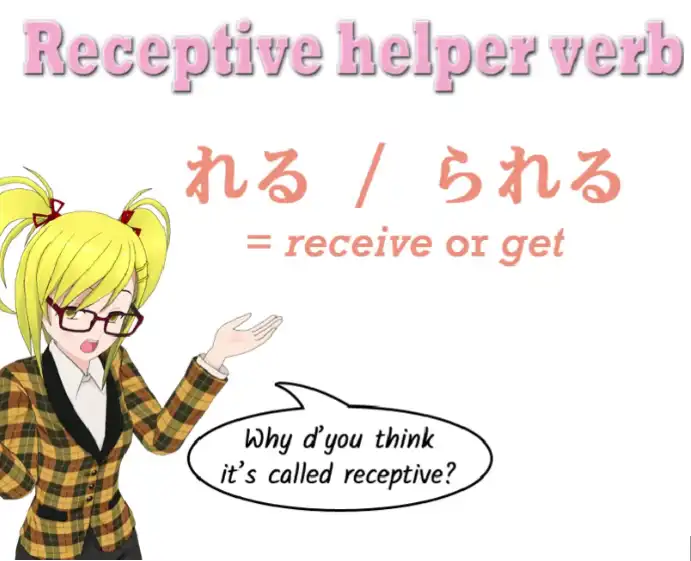
Now, most of the time I’m going to use the word “get” because this expresses very clearly what the helper verb does.
Note: To be more clear, as Dolly says in the comments:
‘So the “got” translation only works when English “got” means “receive (an action)”, not when it means “become (a state)”. Or to simplify the matter - you can use “got” to translate れる/られる but you can’t always use れる/られる to translate “got”.’
Your old English teacher might say it’s not the best way of expressing things, but it’s a perfectly good way of expressing things in English and in Japanese it is exactly how we express them.
All right?
So, let’s take a simple example: 「さくらがしかられた。」
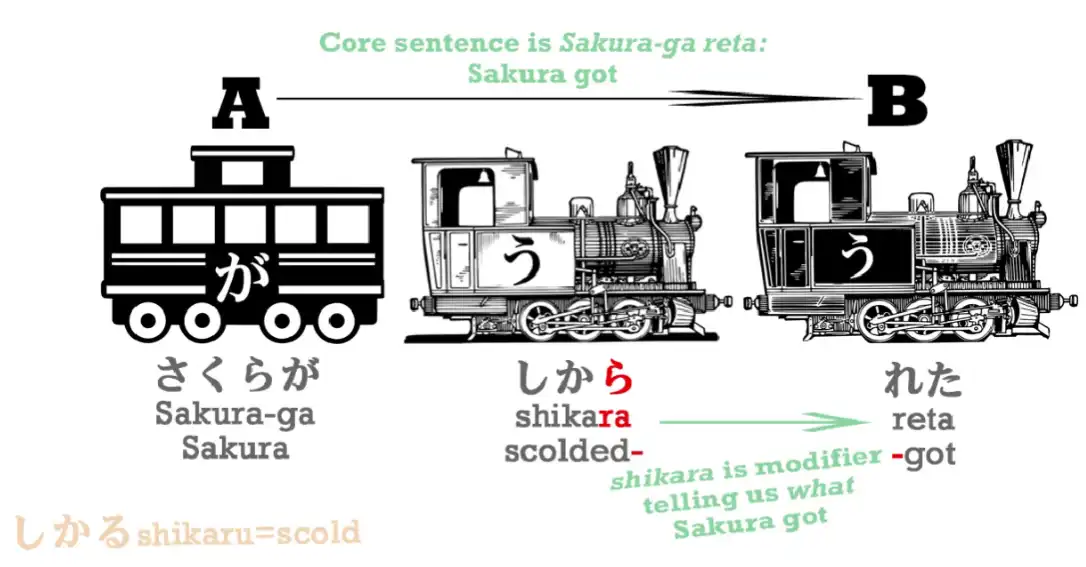
叱る/しかる means “scold” or “tell off”, and the あ-stem is 叱ら, so when we add to that れる and put it into the past tense we get しかれた/叱られた.
叱る is “scold”, 叱られる is “get scolded”, 叱られた is “got scolded”, so, “Sakura got scolded”.
Now, there’s an important thing to bear in mind here, and that is that we can sometimes, with a helper verb attached to a verb, we can, as a sort of railroad shorthand, condense those two parts into one verb.
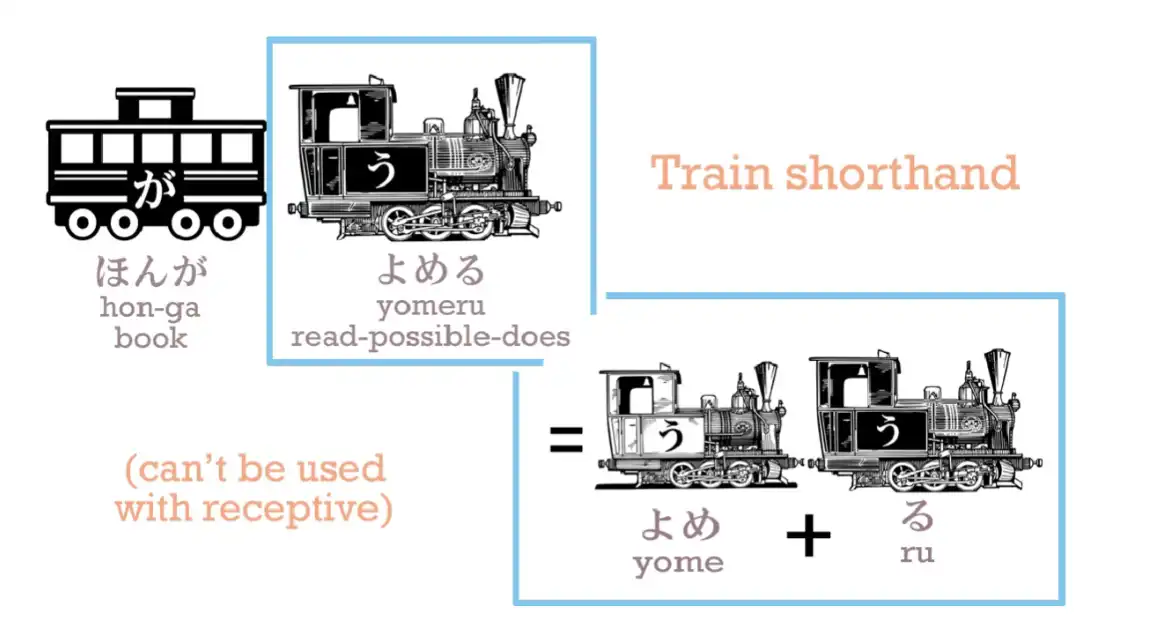
So we can say 「ほんがよめる」 and although よめる, which is the potential form of よむ, is strictly speaking よめ plus る, we can combine them together and treat よめる as one engine.
But we can’t, and never should, do that with the receptive helper verb. Why not? Because when the receptive helper verb is attached to another verb, the action of the first verb is always done by someone different from the action of the second verb れる・られる.
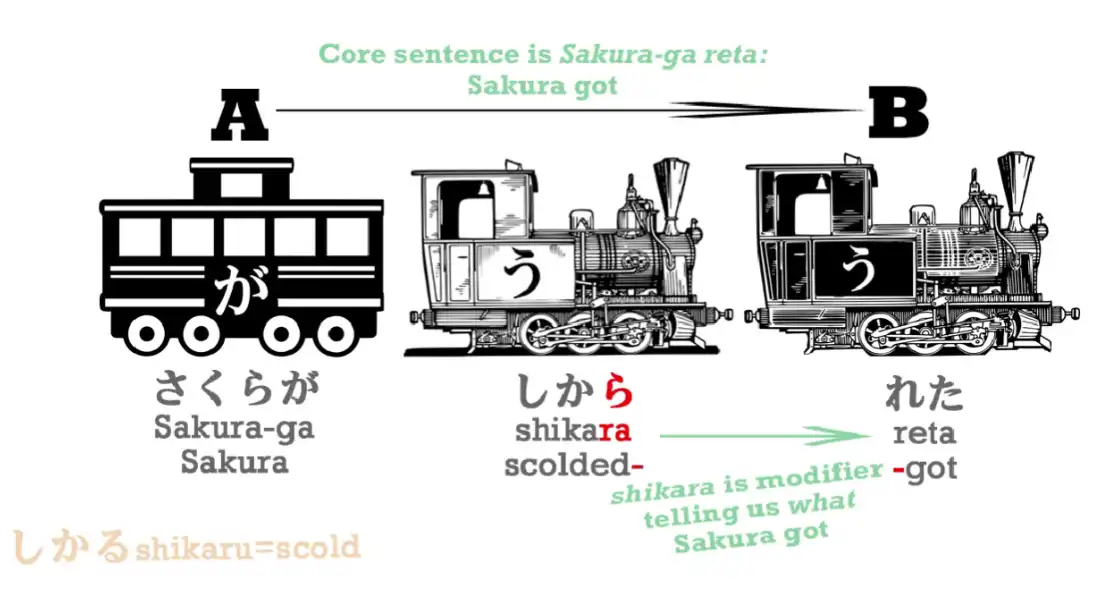
So we always have in a receptive sentence the action that is done by someone else, whom we may or may not know, plus the real action of the sentence which is れる・られる, the receiving—the getting—of that action.
And this is the fundamental point to bear in mind.
It’s because the textbooks don’t keep this in mind and don’t keep those two engines separate that all the confusion and difficulty over the so-called “passive conjugation” arises.
The head verb of a れる・られる receptive sentence is always れる or られる, not the verb to which it is attached.
Now, let’s also notice that the A-car, the actor of the sentence, is not necessarily a person.
So, if we say, 「水がのまれた」 (のむ/飲む=drink; のま= あ stem of drink; れた= got), we’re saying “The water got drunk”. And the actor of that sentence is the water.
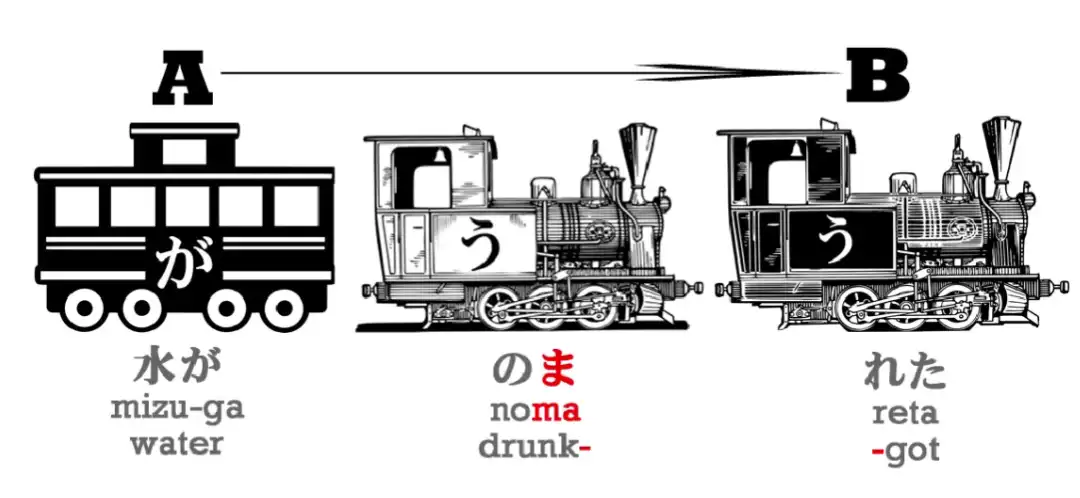
Now, even if we add a doer of the action: 「水がいぬにのまれた」,
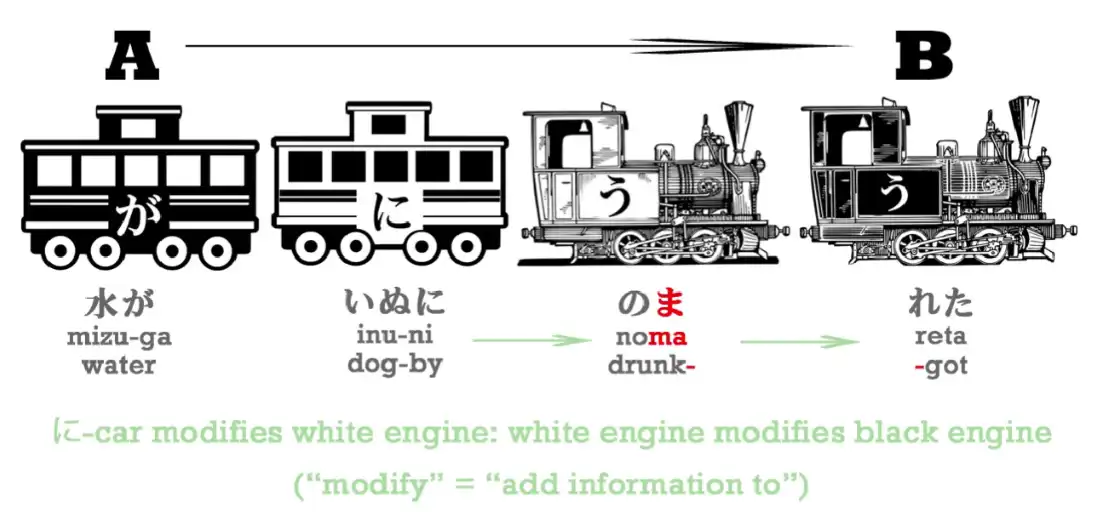
the actor of the sentence is still the water, not the dog, because it’s the water that got drunk, it’s the water that did the getting. The dog did the drinking, but the water did the getting.
And the dog drinking the water is all a white section which modifies that final head verb, “get”. “The water got drunk by the dog.” Now, why do I mark the dog with に? I’m going to come to that in just a moment.
Let’s get a fuller sentence so we can see all the particles working together in a receptive sentence: 「さくらはだれかにかばんがぬすまれた。」
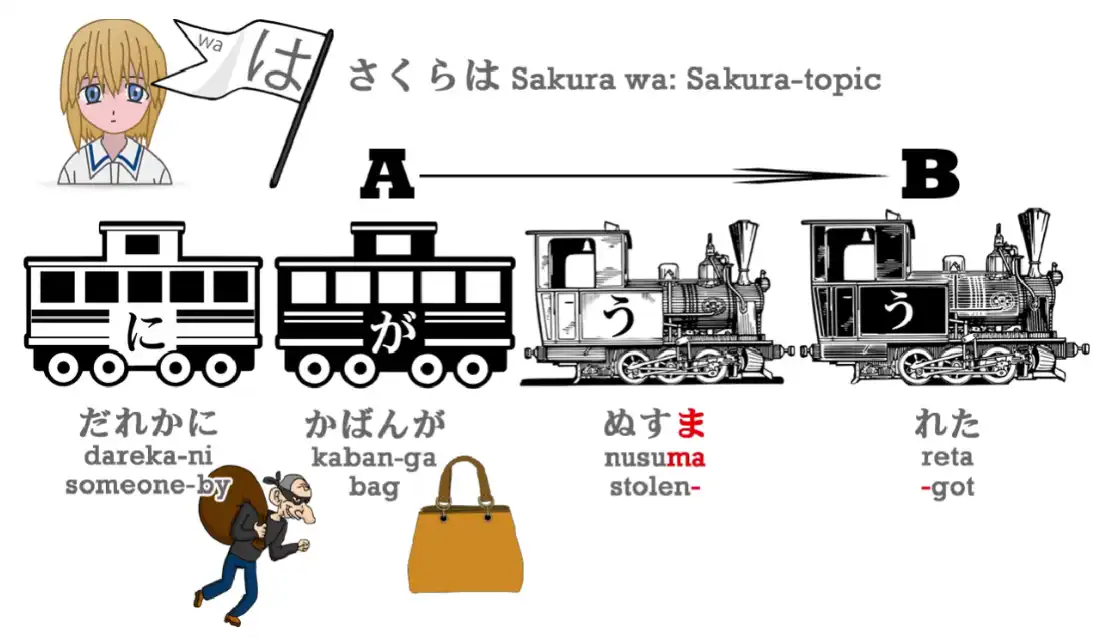
(盗む/ぬすむ= steal; 盗ま= あ stem of steal; 盗まれる= get stolen; 盗まれた= got stolen).
誰か/だれか means “someone” (誰= who, か= question). Who was it? We don’t know, no one in particular, but someone. 誰か=Someone.
So, what’s going on here?
Who is the receiver of the action? It’s not Sakura, who’s marked by は.
It’s not someone, who’s marked by に.
It’s the “person” who’s marked by が, and that’s the bag. The bag is what received that stealing, so the bag is the subject of the sentence. The bag is the one who did れる, who did “got”.
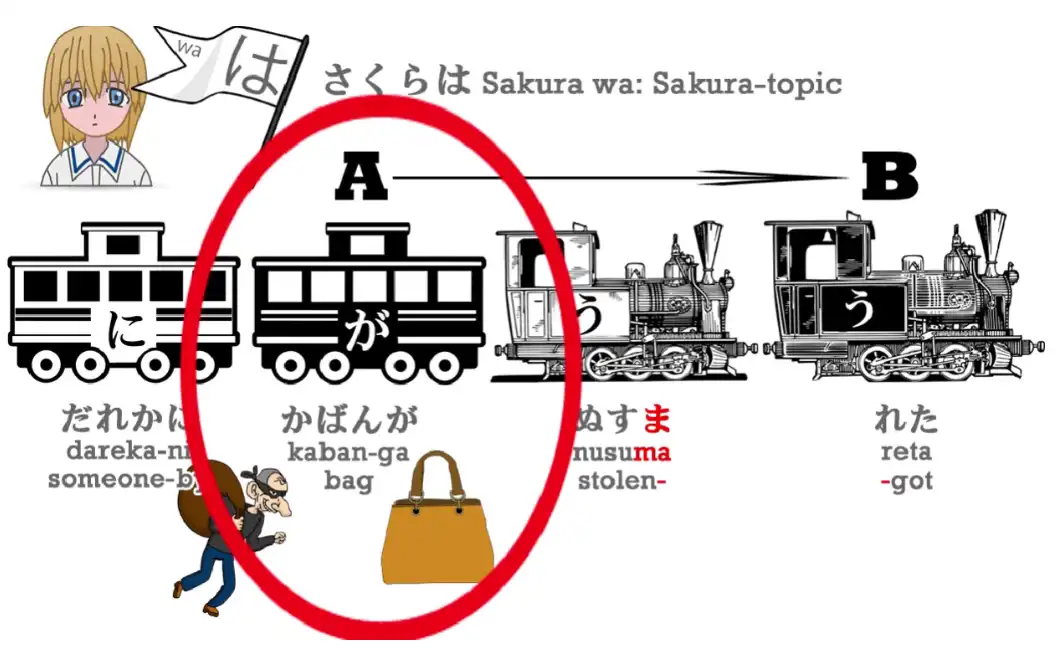
And に… what’s it doing here? Well, let’s remember that に marks the ultimate target of an action (だれか).
So, 「(zeroが)さくらにボールをなげた。」 the が marked actor is I, the object of the action is ボール, and the target of that action is Sakura. (The non-receptive use of the に)

Now, this kind of に can only be used when we are projecting something, whether it’s throwing a ball, sending a letter, giving a present, lending a book. We have to be projecting something toward the target.
Now, れる is not a projecting verb. It’s a receiving verb. It’s not a push-verb, it’s a pull-verb.
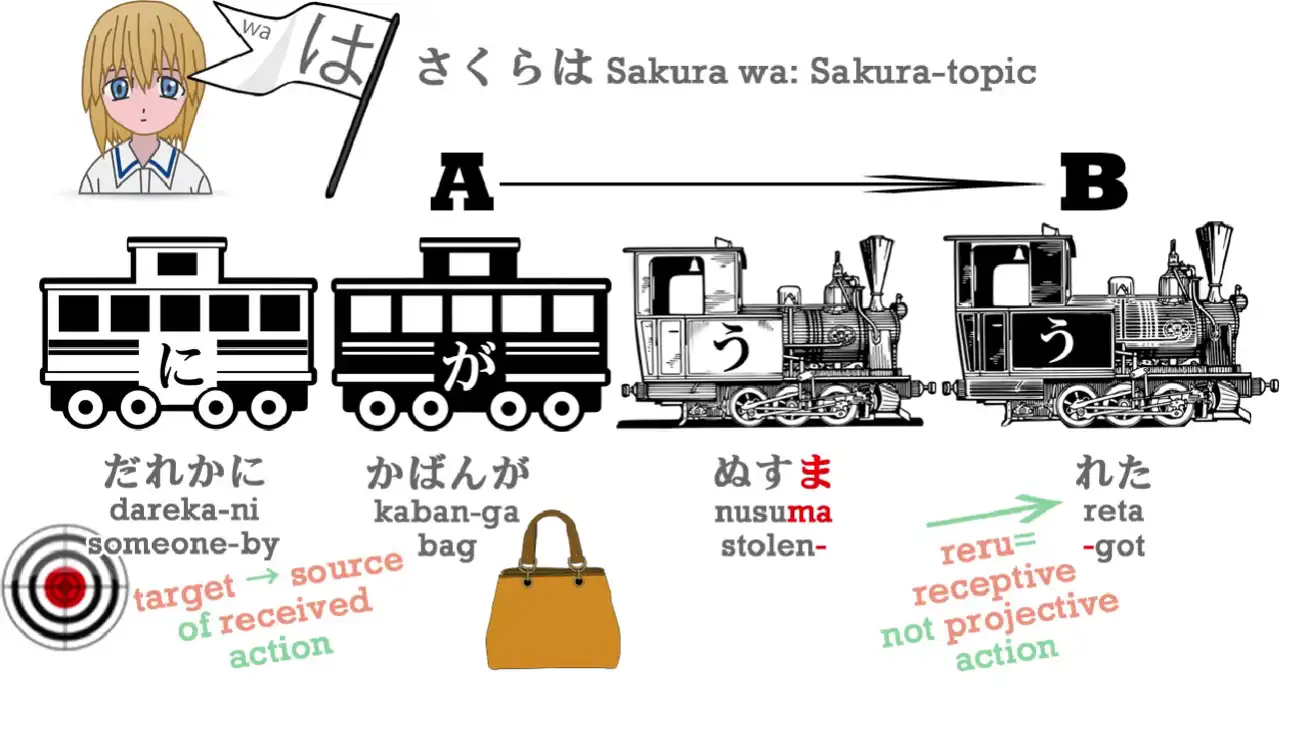
Therefore, the target of that verb is not something toward which you are projecting; it is the thing from which you are receiving.
So に performs the same function in relation to a pull-verb that it performs in relation to a push-verb, that is, the ultimate target of the push, the ultimate source of the pull.
Note: This may be helpful. From the comments like this under the video.
My understanding of this would be too long again, so I will not include it here, it is not needed here since I think Dolly explained it clearly enough and I do not want to put more headings here…


So you see, all the particles are doing exactly what they always do. Nothing is changing here.
Note: Well, as shown above, in the Passive/Receptive it sort of changes in that they reverse their polarity.
Hence why に is not “to” - receiver/”target” of action like in Active, but is now “by/from” - the doer, and が instead is the receiver of the base action (ぬすむ) via れる. It can be explained via Thematic Relations.
If you think of it as “passive conjugation”, all the particles do a strange dance and seem to be doing different things from what they usually do, but if you understand it as it is - the receptive helper verb - there isn’t any problem. And it all makes sense, just the way Japanese always does if you know what it’s really doing.
“Nuisance Receptive/Passive”/迷惑受け身
Now, there’s one other area in which the receptive sometimes confuses people, and that is in the so-called “suffering passive” or “adversity passive”, which is actually called in Japanese the 迷惑受け身/めいわくうけみ, which means the “nuisance receptive”. And that’s what it is. It’s the nuisance receptive.
「さくらはだれかにかばんがぬすまれた。」means “Sakura’s bag got stolen by someone” or, literally, “In relation to Sakura, bag got stolen by someone”. Note: Normal receptive.
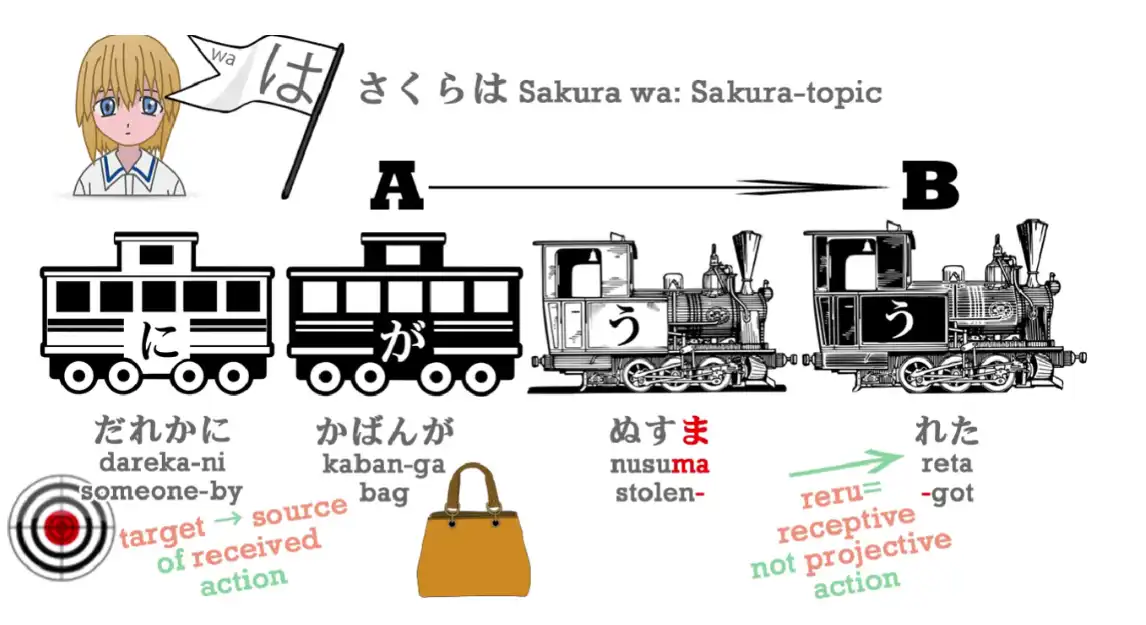
BIG note: Notice the が before a receptive-marked verb instead of a direct object を. I recommend reading THIS CHAIN about why there is が instead of を if you are not sure. Actor should mean Subject for Dolly but even that is just my guess based on when she uses it since she does not seem to explain what she really means by it, in one comment chain under this video she even calls Receptive に as “secondary actor” (which is more akin to the actual linguistic Actor…or Macrorole of Agent there) which does not help. ###
VERY optional “Explanation” Note & example of my chronic rambling (or whatever lol)
This is just one of my usual linguistic ramblings that do not really matter in the grand scheme of things & are here for especially my own linguistic interest (or those who want to go more in-depth)
I am just testing/practicing how I understand stuff with this in the general sense of linguistics.
MY KNOWLEDGE IS VERY LIMITED, SO IT IS JUST ME EXPERIMENTING WITH A HYPOTHESIS.
I AM VERY AWARE WHAT I SAY MIGHT BE MISLEADING IF NOT OUTRIGHT WRONG!
Dolly obviously does not use the terms as rigidly as I will here, because it is just basic grammar so it obviously has no need to be here anyway, but for the sake of it, I will have some linguistic fun:)
Grammar is complex, so I still have things to learn and whatnot so I will also use this to research.
Furthermore, please keep in mind that I am somewhat simplifying the Semantic roles here, that is I use the term “Agent” and “Patient”, but these are just one type and there are multiple “subtypes”, like Experiencer, Beneficiary, Goal etc. etc., but I feel it is complex enough with just Agent and Patient etc. , so keep this in mind. You can look them up in Thematic Relations for example.
If still unclear, to my understanding, it can be explained through Semantic roles/Thematic relations.
Mind that Syntax / Syntactic and Semantics / Semantic are two different fields and one Syntactic function (Subject etc.) can have multiple Semantic roles, especially in terms of Active vs Passive/Receptive.
It is because this is Passive/Receptive, かばん has the SYNTACTIC function of the SUBJECT (hence が marked) BUT it has the same SEMANTIC function of the PATIENT - it received the act of the (verbs) stealing/being stolen by someone. In Active voice かばん has the SYNTACTIC function of the DIRECT OBJECT but still would have the SEMANTIC function of the PATIENT.
Thus, if we were to have かばん marked by を (Direct Object - Syntactic function), it would have to be in the Active voice (since in Passive, we tend to put the Direct Object as the Subject instead) OR, as will be shown below, it would have to be in the form of a “Nuisance Receptive” as a secondary Object connected to a secondary Verb that adds “description” info about the main part.
The term Actor that Dolly uses SHOULD mean the same as Agent as said here and here from what I found, but Dolly seems to use it here for Subject, in a way Actor should imply the one that does the action of the main verb, so I am confused what Actor means for her here, but it might be that… in which case, I get what Dolly means, tho she might be here merging the Syntactic and Semantic functions, else I misunderstood what she is implying by Actor here, since she seems to point it to the Subject which is a SYNTACTIC property, while Actor (or Agent) is a SEMANTIC property and in this sentence, in the comment she calls かばん “Actor”, かばん should be the Patient (or Undergoer to be clearer), not “Actor” as it receives the action, not doing the action of the main verb. That is to say if Actor is indeed like Agent.
To be real, the term Actor I have seen used only rarely and it should imply Semantic function, BUT it can be used to refer to the “Semantic Macrorole” for Subject in the Active voice and by-phrase in the Passive (while Patient is the Direct Object in the Active and the Subject in the Passive, whose Macrorole is called “Undergoer”), as given here in the paper by a linguist Robert Van Valin[1] (Van Valin, Role and Reference Grammar, 2002) on pages 1 & 3 and it points to the relationship between Semantics & Syntax.
Usually Agent (or its sub-names) are used, so it greatly confused me, but from other lessons, Dolly seems to refer to Subject as the Actor sometimes and uses them interchangeably even in the Passive/Receptive, so just keep that in mind that by Actor she means Subject even if it should refer to different things in the Passive where it would be the に-marked phrase instead from what I PERSONALLY researched… though I tried to be thorough with research I might have missed something but I am quite confident it is somewhat like this from what I found in the paper etc.**
As given in the paper, Actor is the Subject in the Active, but is the by-phrase in the passive (に-phrase).
Hence, in the Passive, the Subject is NOT the Actor. Instead it is the Undergoer (Patient/Theme).*
***TLDR: Actor is a generalisation term for Agent-type thematic semantic relations (Active = Subject, and in Passive = by-phrase/に phrase, just as Undergoer is for Patient-type roles (in Active = Direct Object, and in Passive = Subject). It is complex, but just bear in mind that Subject and Actor refer to different, albeit (in Active) connected things. Actor in the Passive is not marking the Subject.
THESE ARE NOT MY WORDS HERE, CREDIT TO MR. VAN VALIN FOR HIS WORK…
**Furthermore **this seems to be the case in Japanese too**, as it is what **IMABI** seems to say in the Passive lesson, granted only using the term Agent, in Passive being marked by に / によって.
Sometimes the に can be ambiguous depending on the verb or other particles, where the doer is bound more to the verb than to れる/られる passive construction, in which case you tend to use によって to distinguish the doer from the receiver (which can still be marked by に), or you can use から for the doer.
Such as in **this example**.
—
In ACTIVE voice these two SEMANTIC (Agent / Patient or their generalisations of Actor / Undergoer) functions are generally in the Active Voice SYNTACTICALLY expressed through Subject (Agent / Actor) and Direct Object (Patient / Undergoer), but they refer to different fields, although they are related.
In the Passive/Receptive, Patient is instead mostly put into the SYNTACTIC role of the Subject.
Their SEMANTIC roles do not change - Patient & Agent are still the same words, but their SYNTACTIC functions are changed, where Patient now becomes the Subject and Agent is put into the by-phrase, in this case に-marked phrase. In Passive/Receptive there are 2 verbs - ぬすむ and れる, ぬすむ describes れる here, れる works as a Predicate? (not too sure here, but れる is marked as a black car like が and ぬすむ as just white) to かばん which is a Subject now.
It seems to surprisingly fit between English and Japanese in the basic Transitive / Other-move verbs even if we should not compare them, BUT they are not identical, Japanese is much more free, widespread and logical / clear with it than English is so Japanese can use Passive / Receptive for stuff that English cannot.
Sorry if it is a bit complex, but if you check what the terms refer to and reread it should clear up.
But there is a special case of Passive/Receptive in Japanese that can mark かばん as を while still having a Passive/Receptive sentence, can see it right below here - the Nuisance Receptive, tho that depends)
**If you notice ANY wrong info here, please let me know! Still, take it with a grain of salt. Again, what I am saying may not be fully accurate, I am aware of that as it depends on how well I understood it.
#
The Suffering Passive / Nuisance Receptive example
But we can also say 「さくらがだれかにかばんをぬすまれた。」 This is the nuisance receptive.
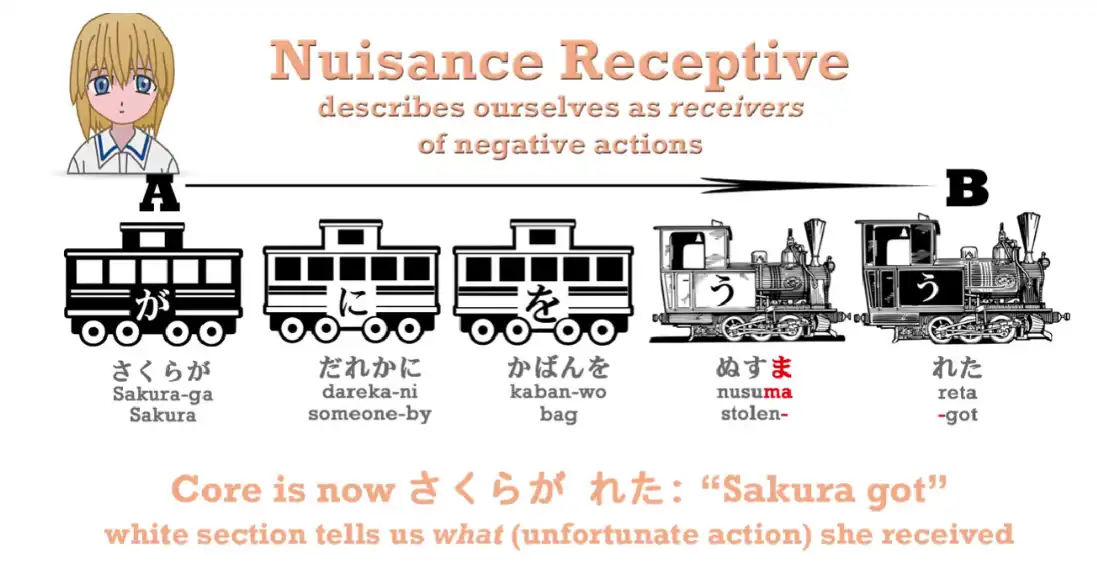
So what’s happening here? The が marked actor is now Sakura, isn’t it? She is the one who does the receiving. Note this:

So what does this sentence mean in English? Very simple: “Sakura got her bag stolen”. That’s what we say in English; our old English teacher might not like it, but we say it in English, it makes sense in English, and it’s exactly what we say in Japanese. “Sakura got her bag stolen by someone.” So, you can see that there is in fact no problem, no difficulty, no confusion about the receptive helper verb, just so long as you know that it is a receptive helper verb and not something else.
Note: Again, this will likely be VERY hard to fully grasp, so I recommend also reading through the comments under the video. There are quite a few (other) very interesting answers by Dolly.
Do not worry if it is too tough to fully grasp now, you will grasp the Passive/Receptive fully when you input and immerse in Japanese a lot, it will all clear up eventually on its own the more you consume. This is just to give the basic idea about it through Dolly’s basic explanation.
14. Adverbs and the も Particle
Lesson 14: All About Adverbs: Mo Particle Secret; and more Alice!
こんにちは。 Today we’re going to go back to Alice’s adventures. If you remember, Alice had spotted a white rabbit running along. The white rabbit looked at his watch and said,”I’m late! I’m late!” and ran off. Alice called to him to stop but, whether he heard or not, he didn’t stop.
「アリスはとび上がって、ウサギの後を追った」 「とび上がる」 is another one of those words of the kind we looked at last week, where a verb is joined to the い-stem of another verb to create a new verb.
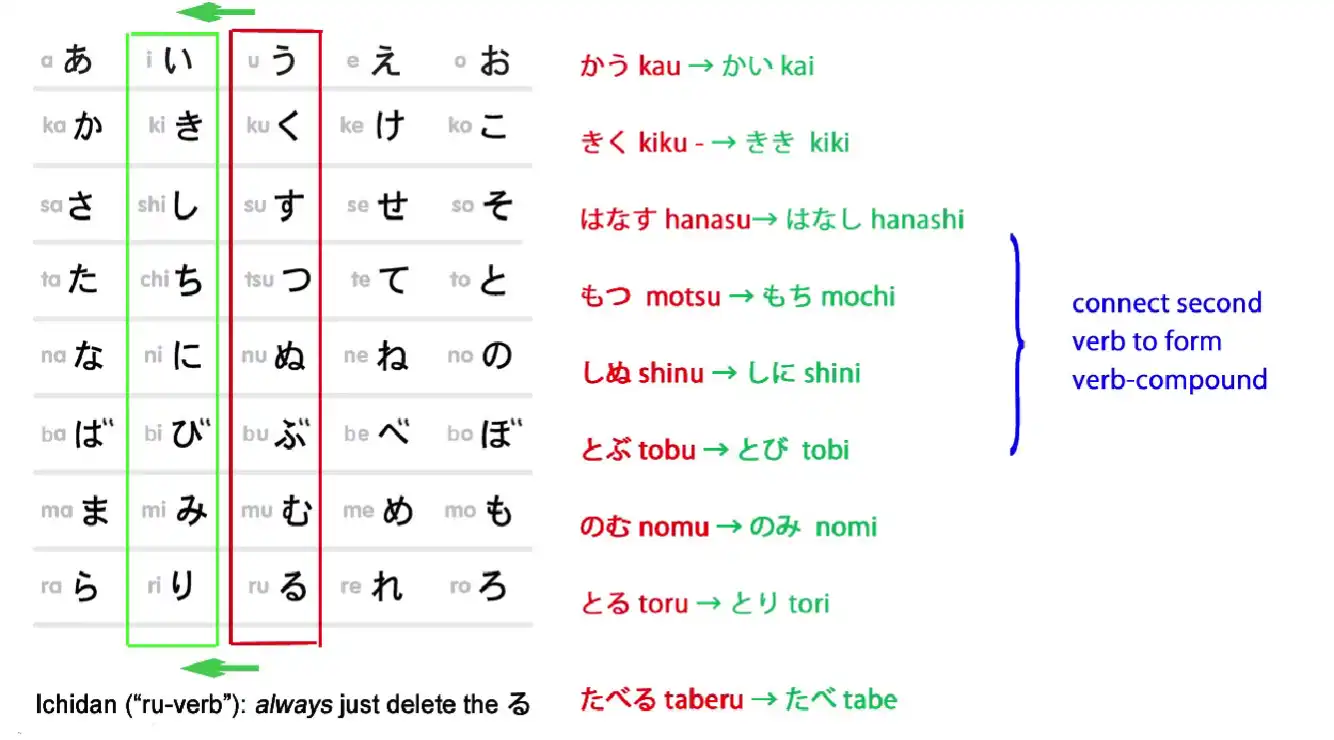
The first verb here is とぶ/飛ぶ, which means either “jump” or “fly”.
In this case, it obviously means “jump”, since Alice can’t fly. And 上がる means “rise up”.
So when you put them together, 飛び上がる means “jump up”.
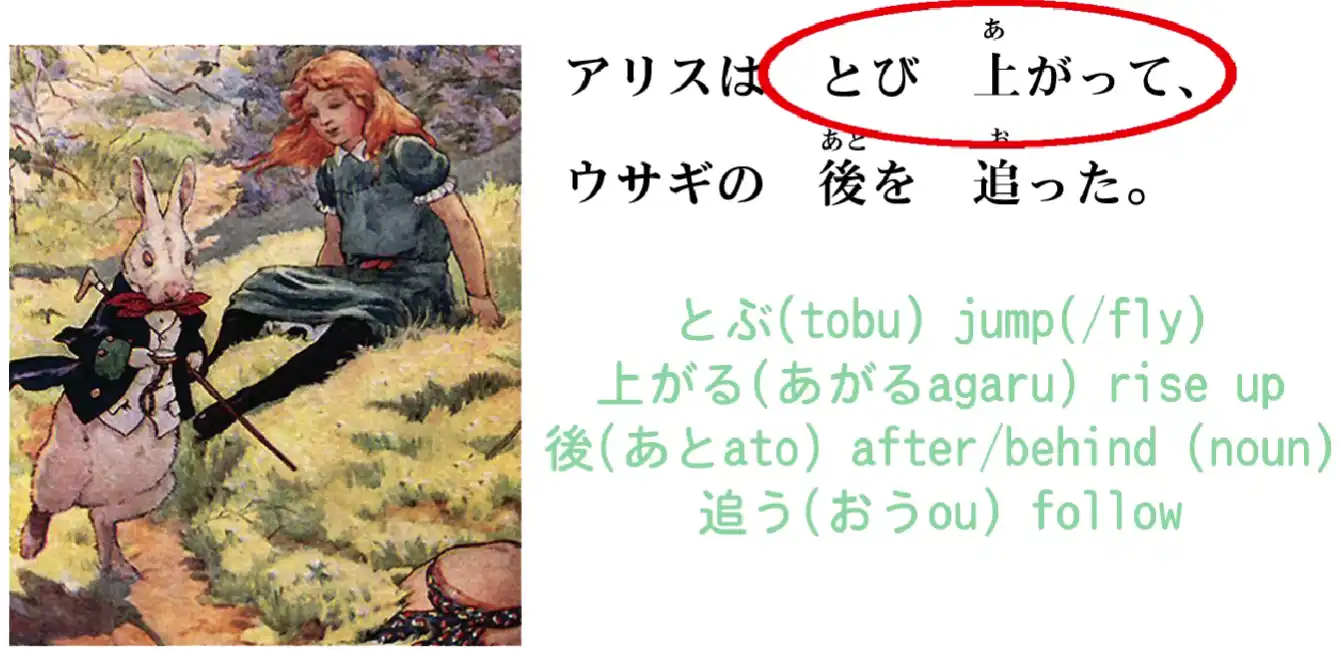
And we might notice that 上がる here, it’s the same kanji as 上, which means “up”, and 上がる is a verb meaning “rise up”, and we can see that it’s related to 上げる, which we looked at recently (Lesson 11), and that means to “give to someone upwards / (to) raise up toward someone else”.
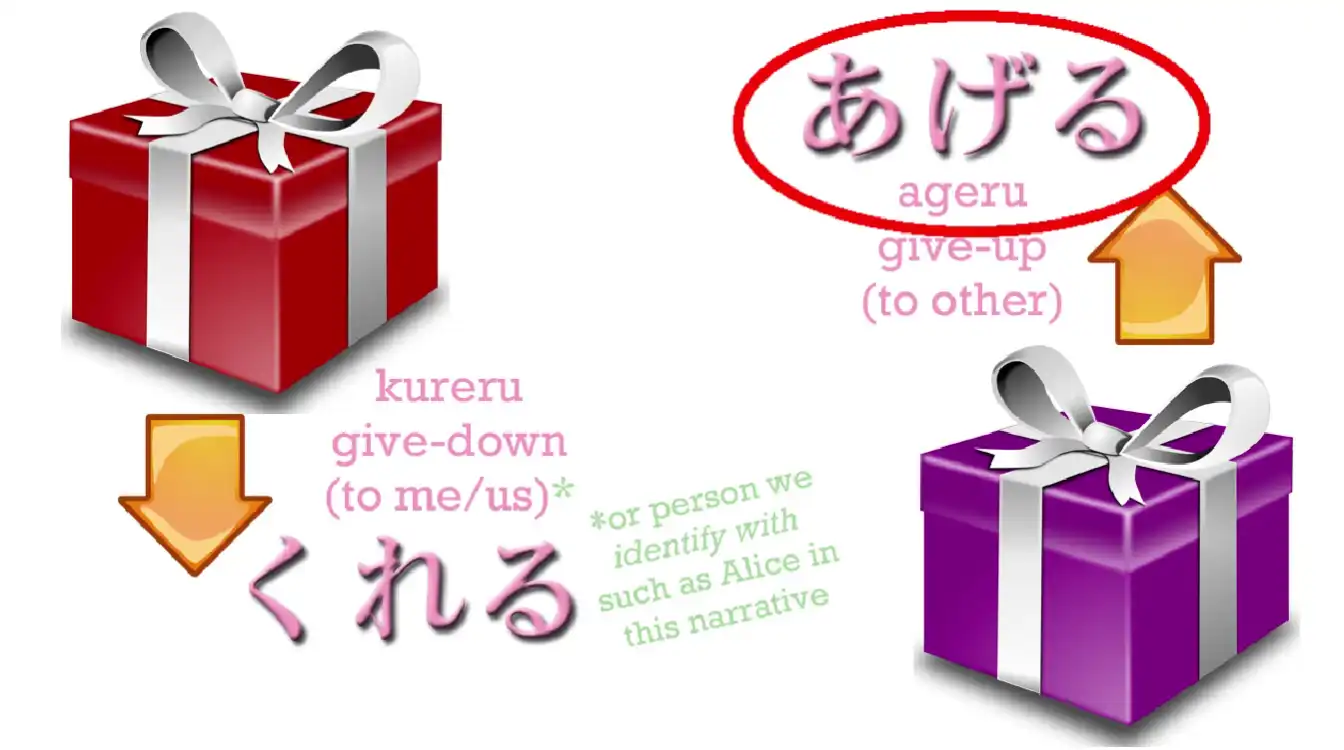
But 上がる means for something to “raise itself up / rise up in itself”. So we can see that the two are related. They’re both “upping” verbs.
「ウサギの後を追った」
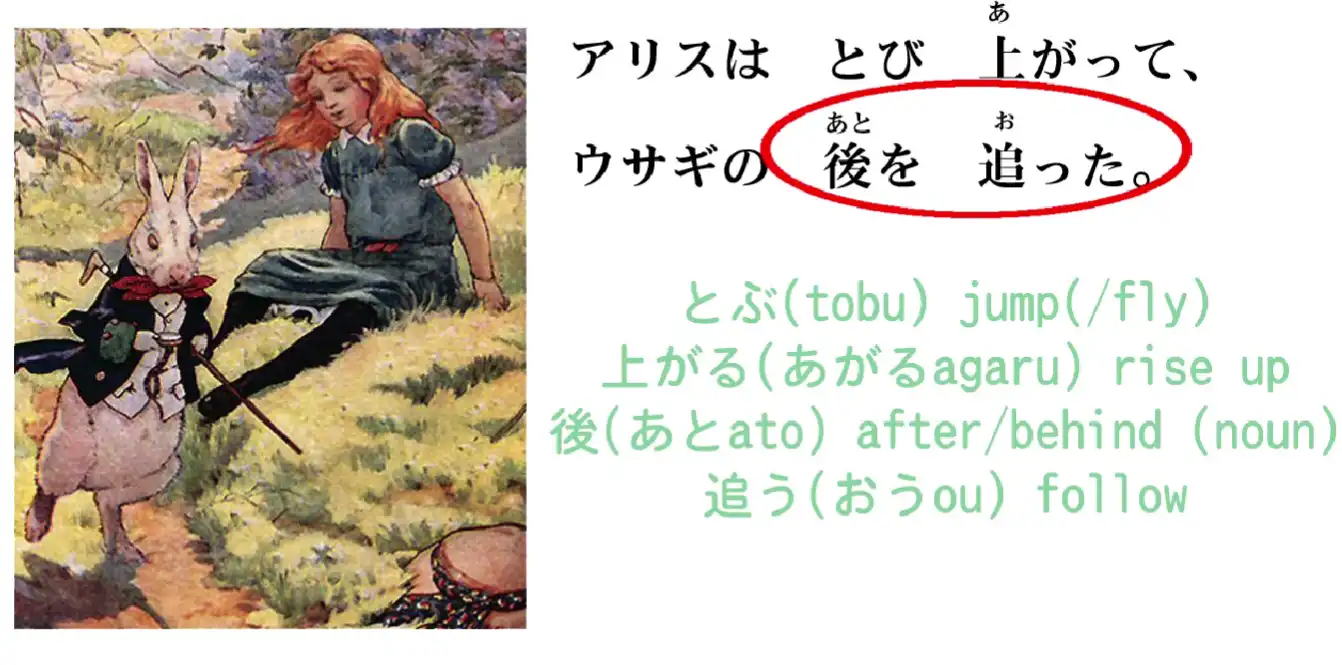
後 means “behind” or “after”, and 追う (which is spelled おう) means “follow.” 後を追う is a common expression and it means to “follow after / follow behind”.
But, as we’ve seen before, these positional expressions are always nouns in Japanese.

Note: What is meant is the 後 part being a noun, since 後を追う should be a verb. We talk about the “on” of the table, the “under” of the table, the “beside” of the river.
And here we’re talking about the “behind” or the “after” of the rabbit.
So Alice followed the “rabbit’s after” or the “rabbit’s behind”.
This is how we put it in Japanese.
アルスは飛び上がって、ウサギの後を追った。 (Alice jumped up and followed after the rabbit.) As for Alice, jumped up and rabbit’s after/behind followed. — しゃべるウサギを見たことがない。
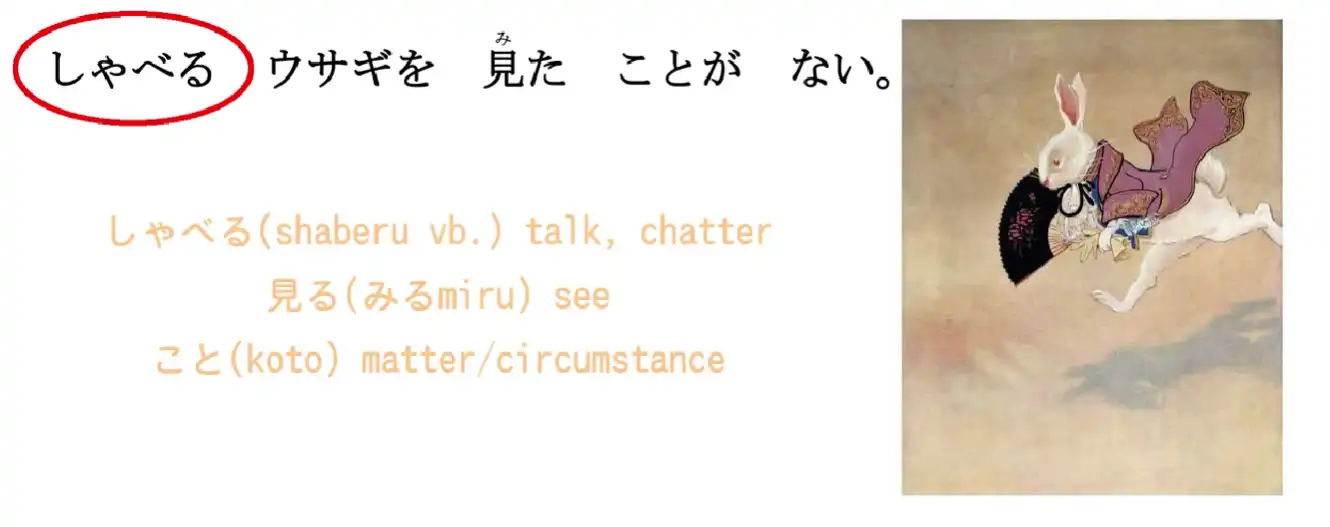
しゃべる/喋るmeans “talk” or “chatter”. It’s a bit like “jabber” in English, isn’t it?
「しゃべるウサギ」in this case obviously しゃべる, the verb, is being used, as any verb-engine can be used, as an adjective.
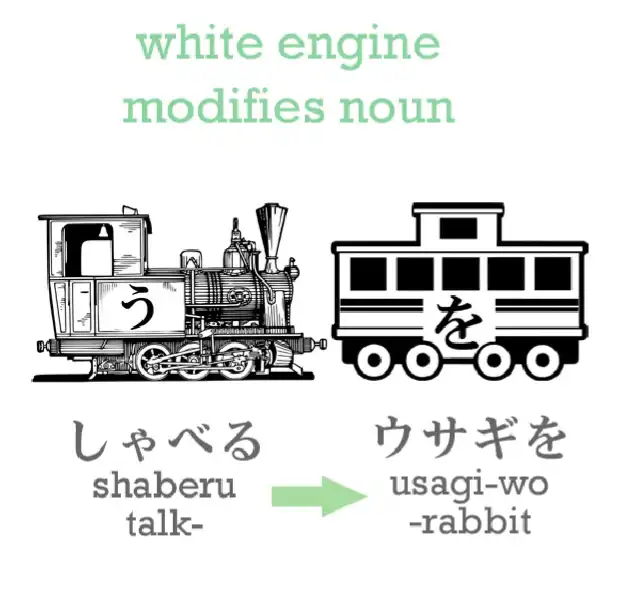
So 「しゃべるウサギ」 is a “talking rabbit” or a “talk-rabbit” literally.
見たことがない is a usage we’re going to find very often: ことがない, ことがある.
What does it mean?
ことがある
Well, こと, as we know, means a “thing” and it means a thing in an abstract sense, a condition, not a concrete thing like a pen or a book.

So, 「見たこと」: 見た is modifying the noun こと, isn’t it?
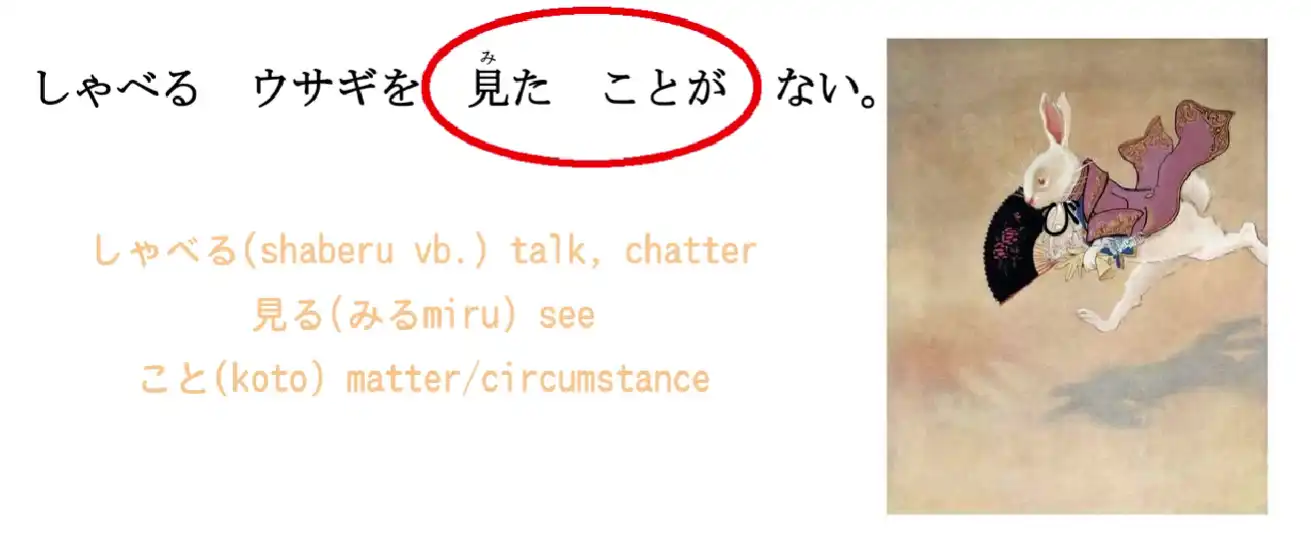
It’s telling us what kind of こと it is, and in this case 見る means “see”, 見た is “see” in the past tense, so the こと is actually “seeing” in the past tense.

So 見たこと means “the fact of having seen”.
見たことが ない means “the fact of having seen does not exist”.
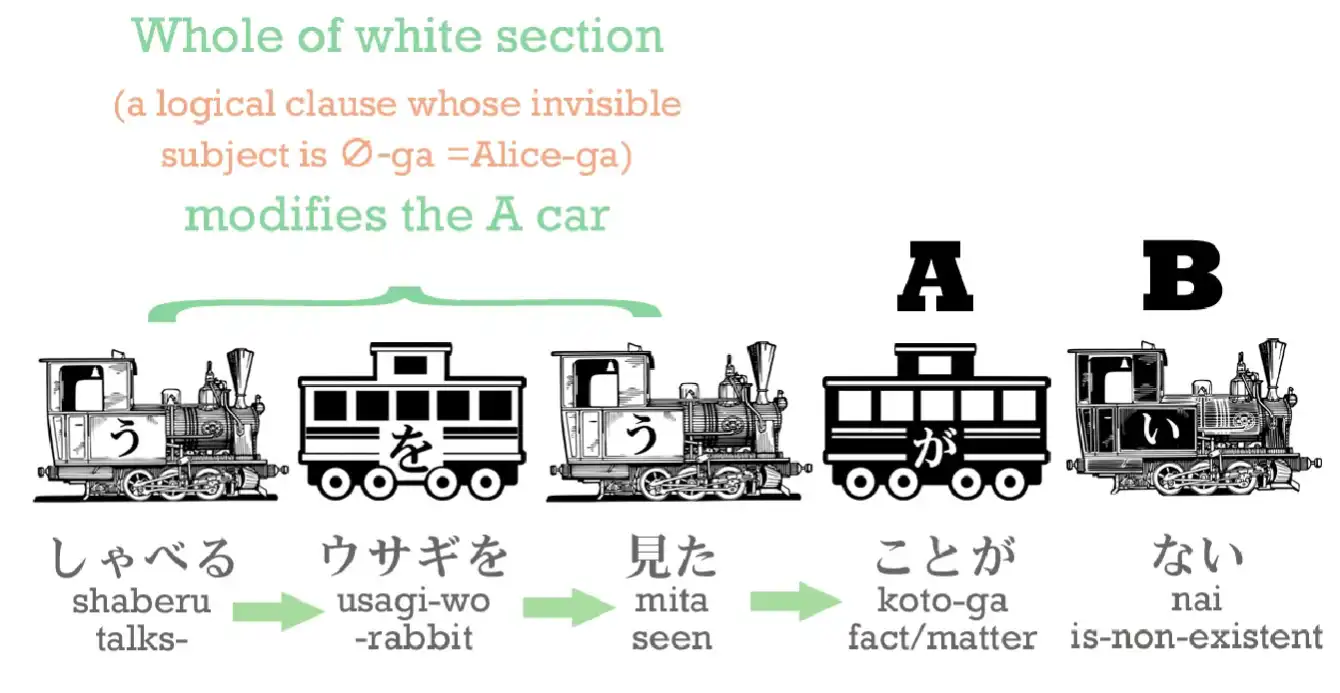
So what this is saying is, “Alice had never seen a talking rabbit”.
(“The fact of having seen a talking rabbit does not exist”) しゃべるウサギを見たことがない (Alice had never seen a talking rabbit.) And of course in English we always want to make Alice the actor of this sentence, but actually the subject of this sentence, the A-car, is not Alice, it’s こと.
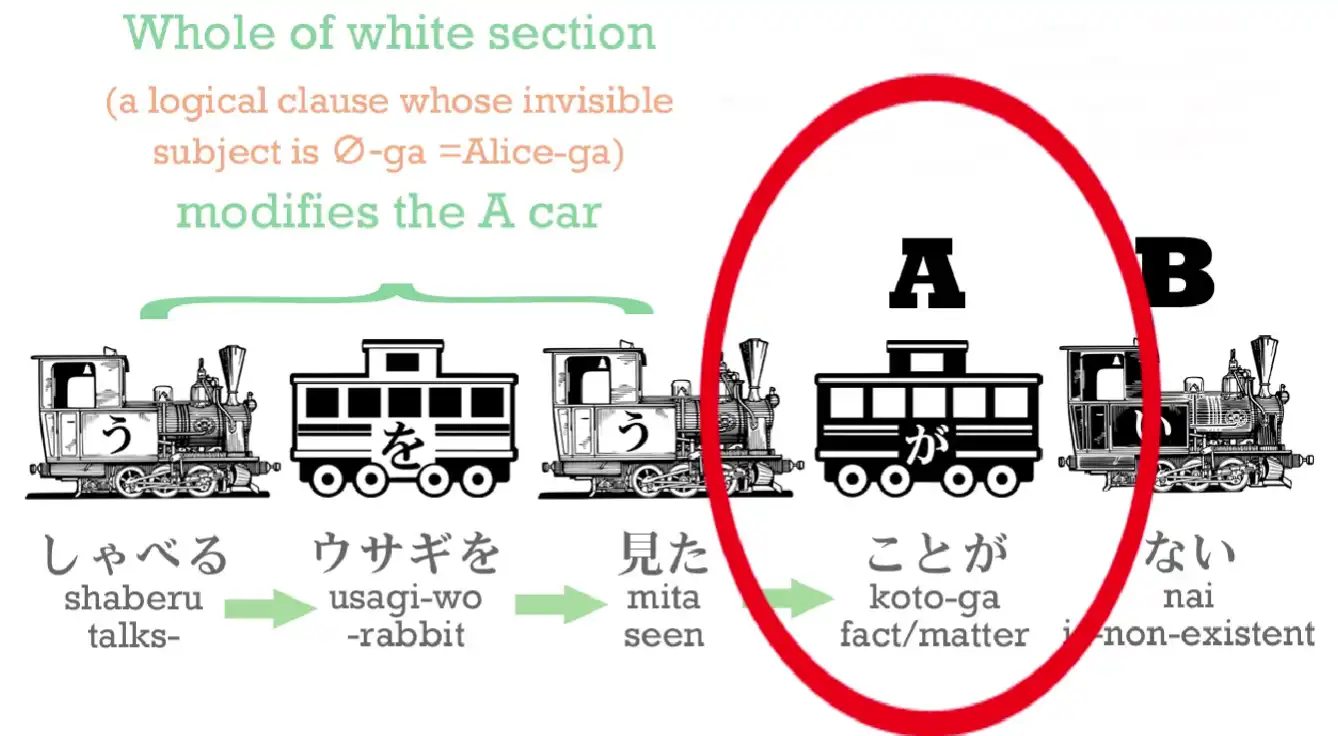
Even if we put Alice into the sentence, we would say, 「アリスは喋るウサギを見たことがない」. She would still not be the actor of the sentence. She would just be the topic about which the sentence was.
“Speaking of Alice, the fact of having seen a talking rabbit does not exist.”
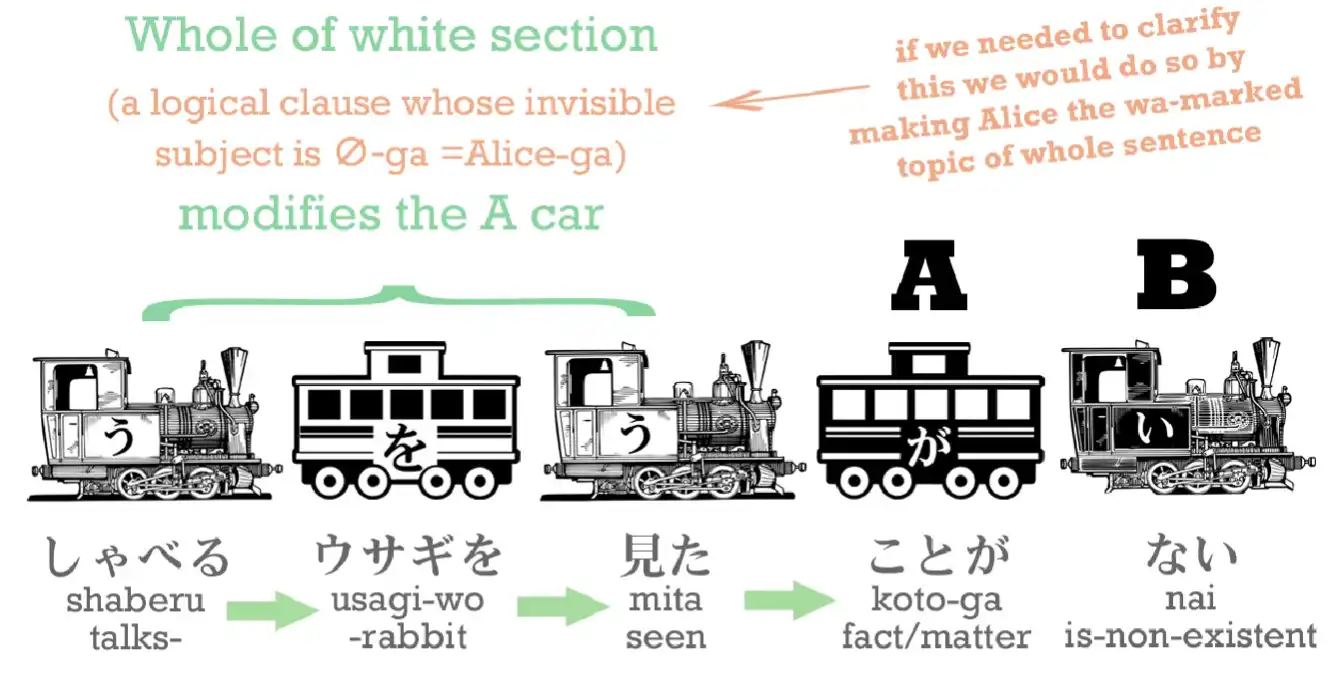
ウサギは早く走って、急にウサギの穴にとび込んだ。
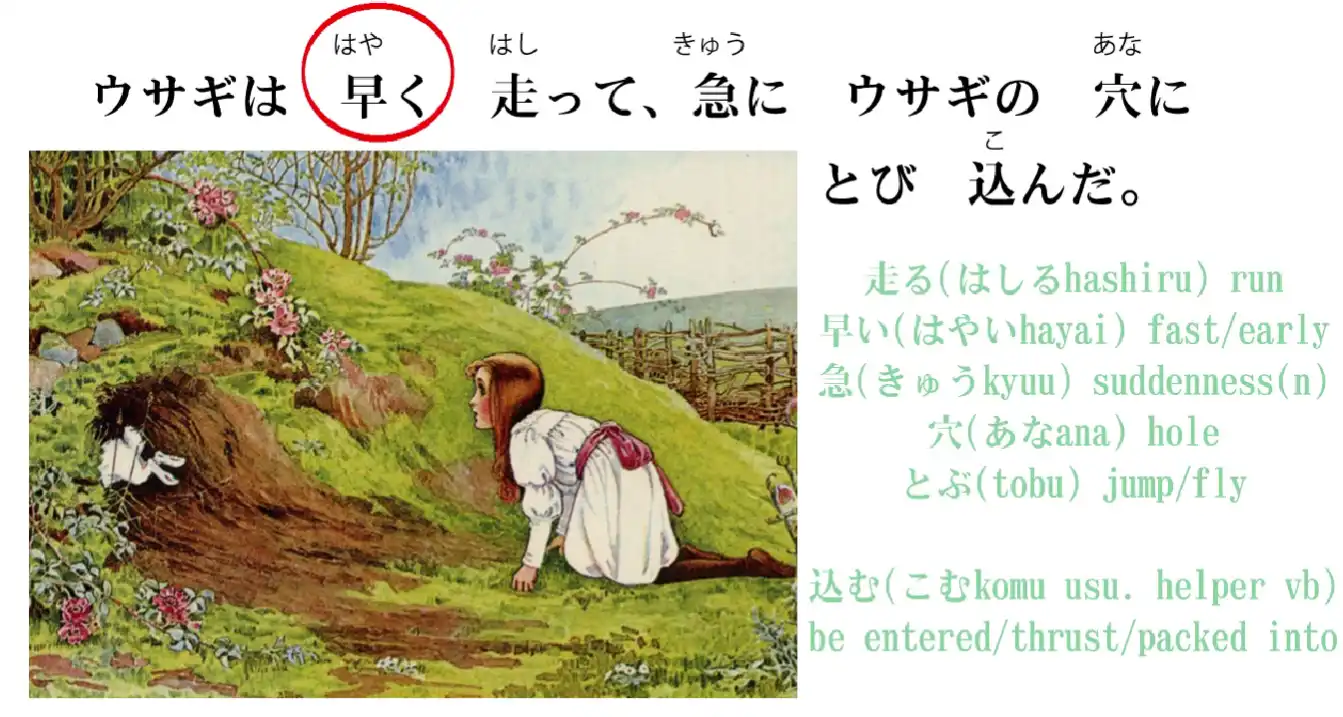
Right, so this is quite a long sentence and there’s quite a lot in it to unpack. I’ll tell you what it means to start with.
It means “The rabbit ran quickly and suddenly jumped into a rabbit-hole”.
So let’s look at it bit by bit.
「ウサギは早く走って…」 Now, 走る, as we know, is “run”; 早い is an adjective meaning “fast” or “early”.
In this case, it obviously means “fast” – we know the rabbit wasn’t early, don’t we?
If we want to say “the rabbit is fast”, we would say 「ウサギが早い」.
Adverbs
If we want to say that its movement is fast, its action is fast, we need an adverb. An adverb is an adjective that describes not an object, not a noun, but a verb.
Now, we can turn any adjective into an adverb in Japanese very easily.
All we do is we take the regular い ending adjective and use its stem く.
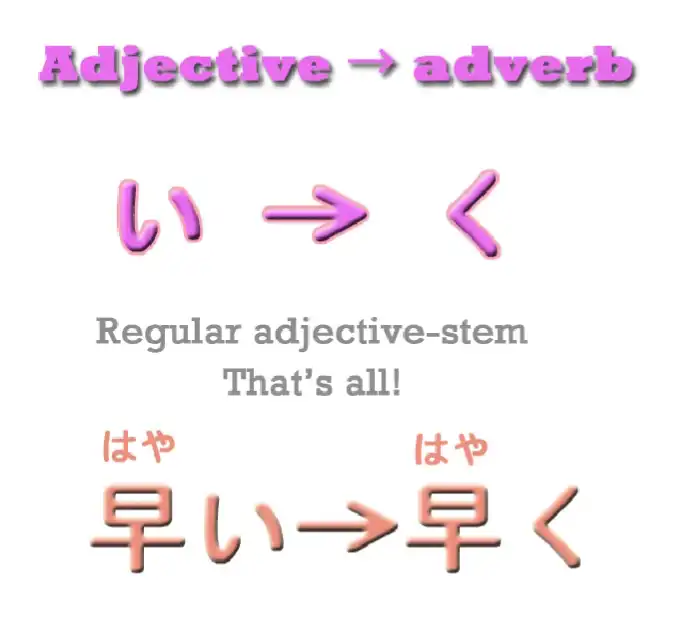
So 早い becomes 早く. 早い is an adjective describing a thing; 早く is an adverb describing an action. So: 「ウサギは早く走って…」 (The rabbit ran fast and…) - added translation for って… 「…急にウサギの穴にとび込んだ。」 Now,「ウサギの穴」: 穴 means “hole”, so ウサギの穴 means “rabbit-hole”.
とび込む is another one of these compound verbs.
とぶ/飛ぶ, as we know, means “jump”, and 込む means to “go into” something.
It’s not just like “enter”; it tends to be to “put into”, to “force into”, to do an action into something.
So we have a lot of verbs actually which are made up with “込む”, which is “doing an action into” something.
So “とび込む” means “jump into”, quite simply “jump into”.
So, the rabbit “jumped into a rabbit-hole.”
But 「急に」what does that mean?
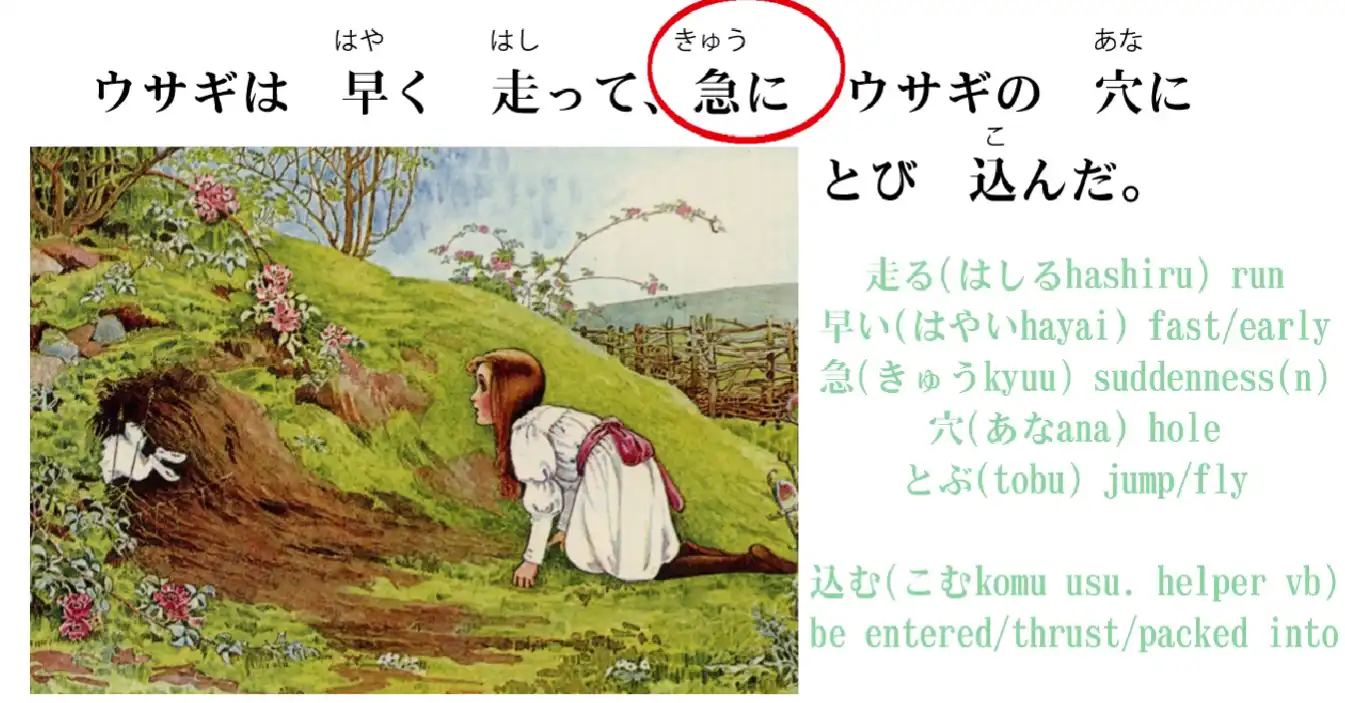
Well, 急 is a noun and it means “sudden”. And when we put に onto the end of it we turn that into an adverb as well.
So here we have two kinds of adverbs.
We can form an adverb from an adjective by simply using its く-stem.
And we form an adverb from a noun by adding に.
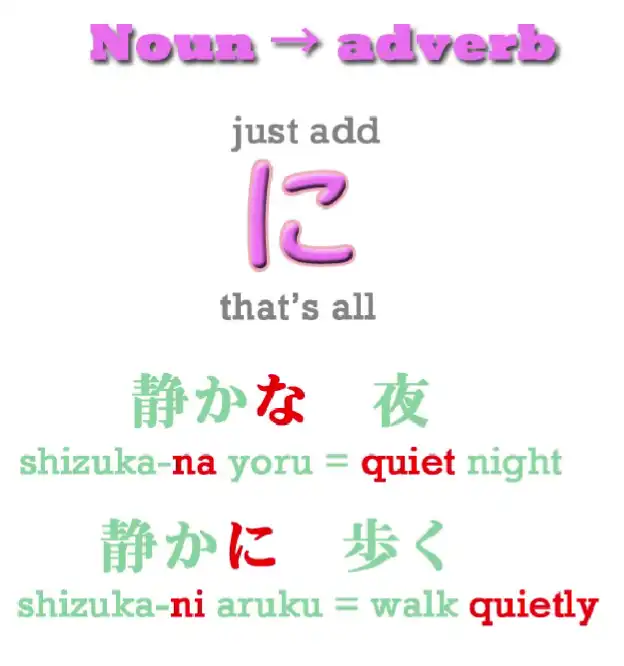
And this works with some regular nouns and pretty much all adjectival nouns.
So, 急 means “sudden” or “abrupt”; 急に means “suddenly”.
“The rabbit suddenly jumped into a rabbit-hole.” So, the entire sentence: ウサギは早く走って、急にウサギの穴にとび込んだ (The rabbit ran fast and suddenly jumped into a rabbit-hole.) アリスもウサギの穴にとび込んだ (Alice also jumped into the rabbit-hole.)
The も particle
Now here we’re going to meet a new element that we haven’t covered before, and that is the も-flag.
も is a flag, just like は. Why is that?
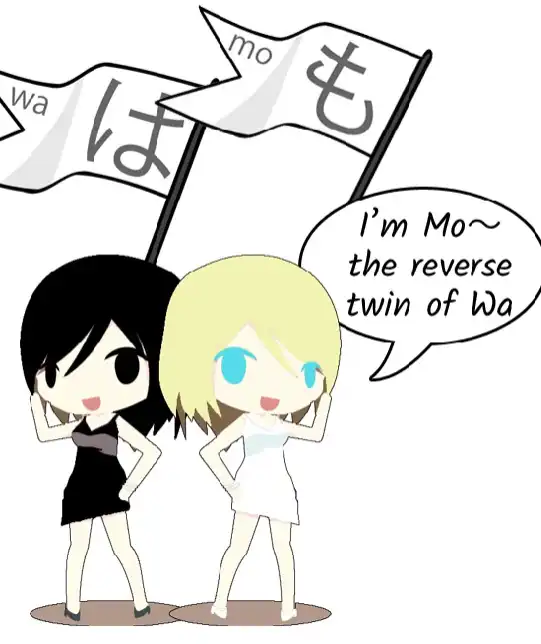
Well, we know that は (Lesson 3) is a non-logical topic-marking particle, don’t we?
も is another non-logical topic-marking particle; in fact, it’s the only other non-logical topic-marking particle.
So も marks the topic of the sentence just the way は does.
What’s the difference between them?
Well, は, as we know, declares the topic of the sentence, and obviously it can also change the topic of the sentence.
If we’re talking about one thing and we declare a new は topic, we have changed the topic of the sentence.
Now, も declares the topic of the sentence as well, but it always changes it.
You can’t use も unless there is a topic already current in the conversation.
So, the topic of our conversation up to this point has been the rabbit: the rabbit jumped into the hole. And now we’re changing the topic to Alice.
「アリスもウサギの穴に飛び込んだ」 When we change the topic with も, we are saying that the comment about this topic is the same as the comment on the previous topic, the topic we’re changing from.
When we change the topic with は, we are doing the opposite of that: we are drawing a distinction between the present topic and the previous topic.
So if we had said: 「アリスはお姉ちゃんのところに戻った」 – ところ” is “place” and 戻る is “return”, so this would have meant Alice went back to her sister, to the place where her sister was, to her sister’s place.

If we’d said this, that は would have been drawing a distinction between what the rabbit did and what Alice did.
We would be saying, “The rabbit jumped into the rabbit-hole. As for Alice, she returned to her sister”. And you see that in English too.
This has the implication that what Alice did was different from what the rabbit did.
“The rabbit jumped into the rabbit-hole. As for Alice, she went back to her sister.” This is what は does.
If we’d used が: 「アリスがお姉ちゃんのところに戻った」, we’d simply have been saying, “The rabbit jumped into the rabbit-hole and Alice went back to her sister.” Note: Alice = subject of its clause here, marked by が. But with は, we are drawing that distinction; we are saying, “The rabbit jumped into the rabbit-hole, but as for Alice, she went back to her sister.” — Now, if we say も instead of は, then we are making the opposite point: we are saying that the comment we made on the rabbit is the same as the comment we’re making on Alice.
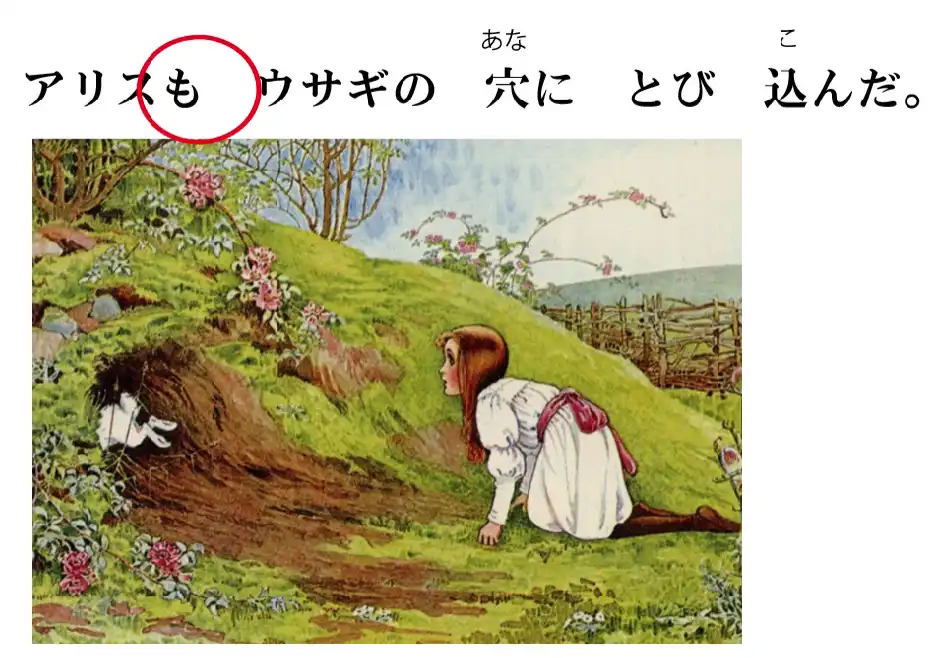
“The rabbit jumped into the rabbit-hole and Alice also jumped into the rabbit-hole.” So, there are various uses of も, which we’ll look at later, but this is the most fundamental one. It’s the topic-marking particle that tells us that the comment on the new topic is the same as the comment on the old topic.
穴の中はたて穴だった。アリスはすぐ下落ちた。
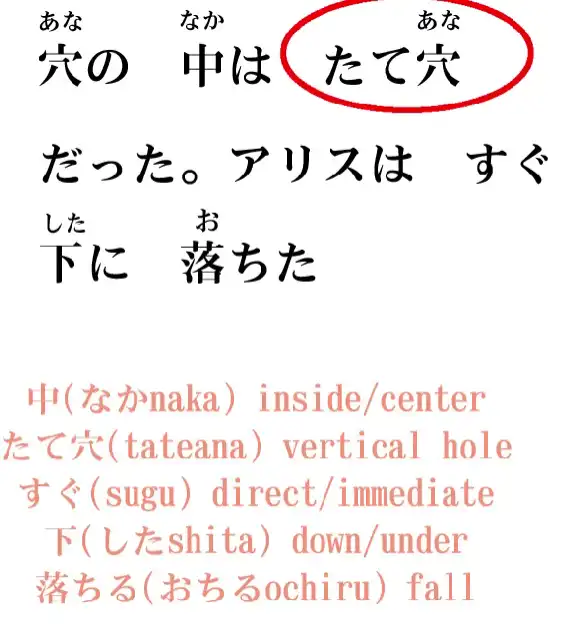
中 means “the inside”, either the middle or the inside of something, so 穴の中 is the inside of the hole.
たて穴/縦穴: the word たて/縦 means “vertical” or “upright” (and you can see it’s related to 立つ – to stand).
So, 「穴の中は竪穴だった」”the inside of the hole was a vertical hole” – it went straight down.
「アリスはすぐ下落ちた。」
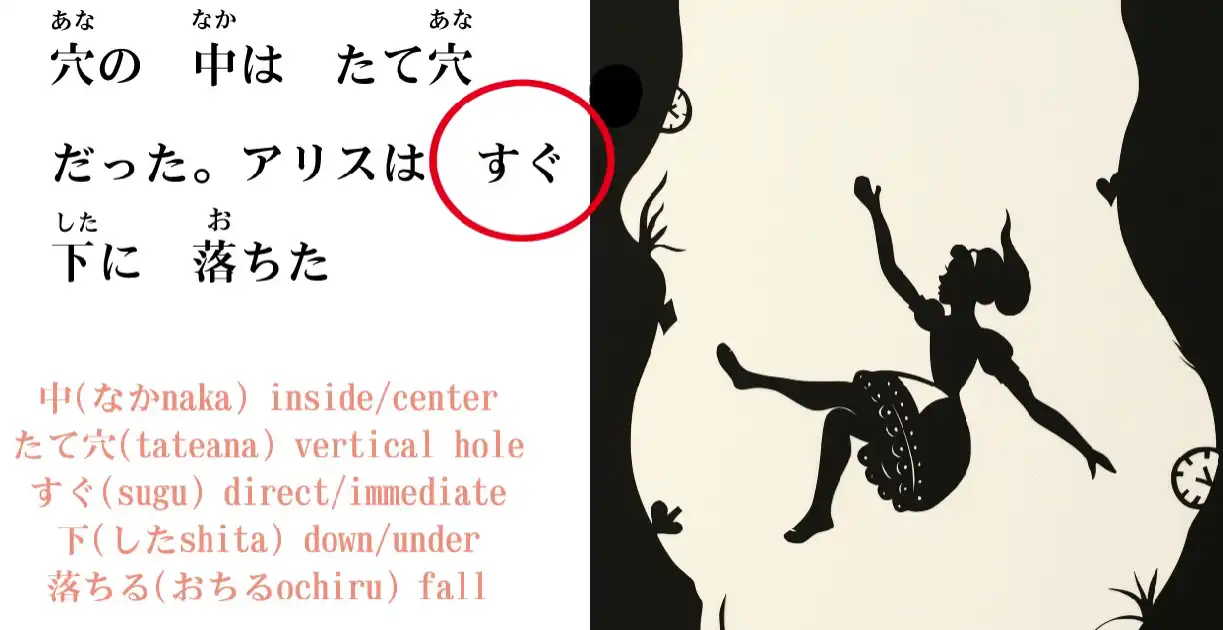
Now,下, as we know, is “down” or “below”. すぐ means “direct”; it can mean “soon” in the sense of English “It’ll happen directly (it’ll happen soon)”, or it can mean “straight / direct” in the other sense. So すぐ下 means “straight down / right down / directly down”.
「でも驚いたことにゆっくりゆっくり落ちた」
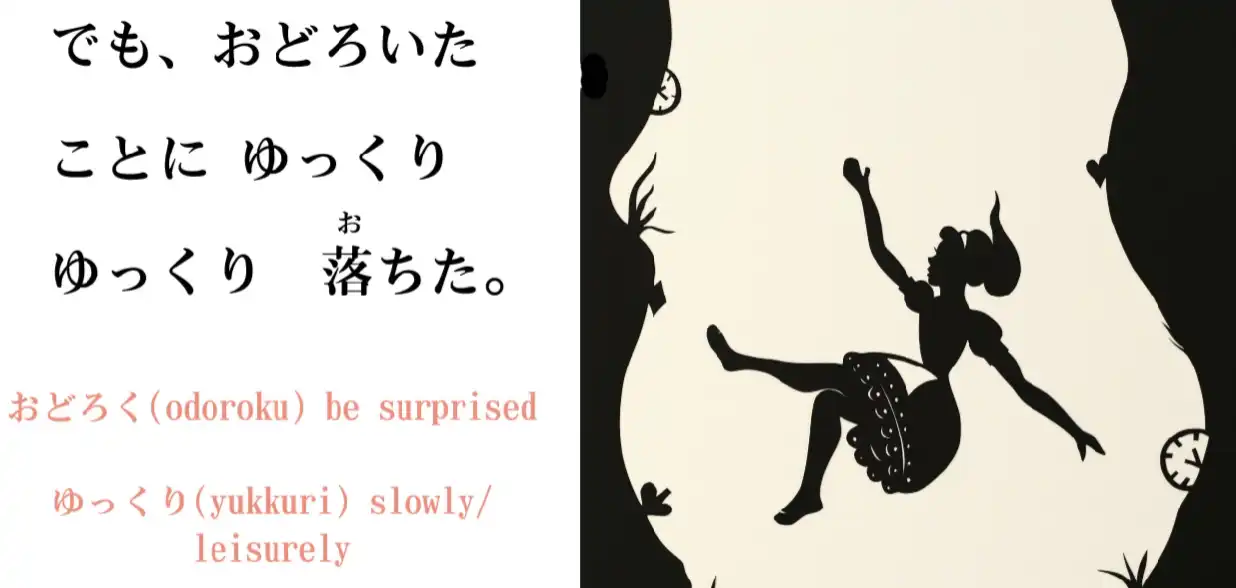
And this means “But surprisingly she fell very very slowly”.
“驚く” means “be surprised”, and “驚いたこと” is an interesting expression because it literally appears to mean, doesn’t it, a “surprised thing”.
But as we’ve seen with Japanese adjectives of emotion and desire, with things that describe emotion and desire, in Japanese they shift very easily from the thing that experiences the emotion to the thing that causes the emotion and back.
So “驚いたこと” here doesn’t mean a “surprised thing”, it means a “surprising thing”.
And に (“ことに”), is once again that technique of putting a に, putting に, after a noun to turn it into an adverb.
So, “驚いたことに落ちた.” (We’ll come to “ゆっくり” in just a moment.) It means “surprisingly fell / she fell in a surprising manner”.
And what kind of a surprising manner was this? “ゆっくりゆっくり”.
ゆっくり adverb
Now, “ゆっくり” is a very common word that we’ll encounter.
It’s a slightly unusual kind of adverb – the third kind of adverb we’re going to encounter commonly in Japanese.
The first two kinds, as we see, are the く-stem of an adjective or a noun with に.
“ゆっくり” is slightly unusual in that it is fundamentally a noun which can be applied as an adverb but we don’t need to use に with it. It stands on its own.
“ゆっくりゆっくり落ちた”. “ゆっくり” means “slowly / leisurely / at a gentle pace”.
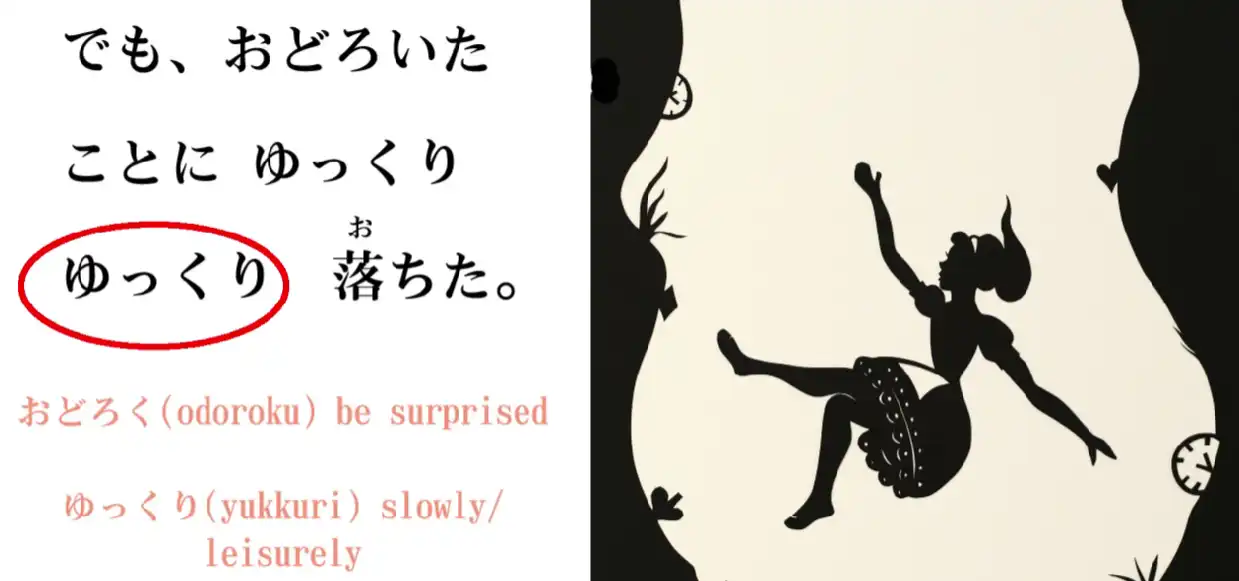
So, “驚いたことにゆっくりゆっくり落ちた” – “But surprisingly she fell very very slowly”.
So once again we’ve gone through the story a little more rapidly than the first time, and we’ve learned quite a lot.
Note: This is where Dolly fully incorporates Kanji into her lessons, also due to people requesting it, as indeed, once you embrace Kanji, Japanese text without it is truly a headache to read, let alone to comprehend. Do not be scared or hostile to Kanji, they are your friends, believe me. Both Yomichan (did not use to work, but it works again in the newest version) and Rikaichamp work here, so Kanji should not pose any real issue for you, as far as reading them goes.
15. Transitive & intransitive verbs
Lesson 15: Transitivity- the 3 facts that make it easy. Transitive/intransitive verbs unlocked
こんにちは。 Today we’re going to look at self-move and other-move words.
If you look in a standard Japanese textbook or dictionary, you usually see these defined as “transitive” and “intransitive” verbs.
Now, this isn’t as far off as some of the things you find in these books, such as conjugation, which doesn’t exist in Japanese; passive (there is no passive in Japanese).
Transitivity and intransitivity does exist in Japanese and most of the time there is a big overlap between that and self-move and other-move verbs.
However, it doesn’t work all the time and it isn’t exactly what is meant by self-move and other-move in Japanese.
So, if you’re familiar and comfortable with the Western terms “transitive” and “intransitive”, it doesn’t hurt a lot if you use them, at least not most of the time.
But if you’re not familiar with them, don’t try to learn them just for the sake of Japanese, because they’re not really accurate.
Note: My guess is in regards to English, since a lot of verbs that are transitive in English are not in Japanese etc., basically it is better to regard the two as their own entities to avoid confusion.
—
So what are self-move and other-move words?
In Japanese, a move-word, “ 動詞 (doushi)”, is a verb, a word that denotes an action or a movement.
So a self-move word is any verb that moves itself. So if I stand up, that’s a self-move action. I’m not moving something else, I’m moving myself.
If I throw a ball, that’s an other-move action. I’m not throwing myself, I’m throwing the ball. And really it’s as simple as that.
Now, Japanese has a lot of pairs of words – so we could say they’re either two forms of the same word or two very closely related words – where we have a self-move and an other-move version.
So, one very good example is “出る(でる)” and “出す(だす)”.
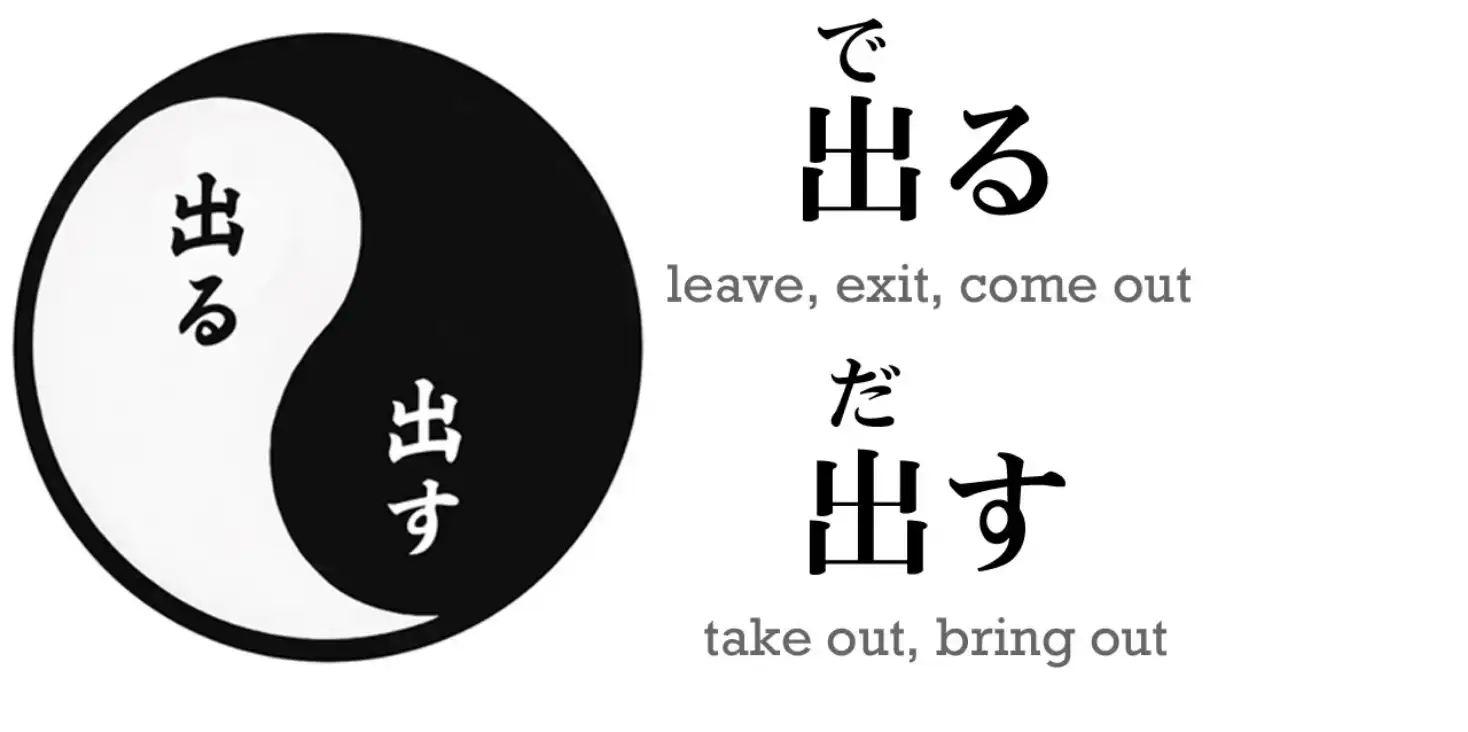
They both use the same kanji which means “come out”.
The base form is “出る(でる)” and that means simply “come out” or “emerge”, and that’s the self-move version.
The other-move version is “出す(だす)” and that means “take out” or “bring out”: cause something to come out. / Take something out etc…
Note: Not to confuse the translation “cause something to” as denoting causative (Lesson 19),
出す has its own “causative” form - 出させる(ださせる) that denotes its causative form.
Here, you are doing the action of moving something. You are not making someone else do it.
So in the first case whatever it is is moving itself; it’s coming out; it’s emerging.
In the second case, the actor of the sentence, the actor of the verb, is bringing something else out or taking something else out.
Note: so, just like transitive, other-move SEEMS to imply something to the grammar object, whereas intransitive/self-move verb has no direct object, since it describes/”moves” just itself. Now, this is often very useful, because in many cases it gives us two distinct words that are easy to understand because they’re closely related.
For example, “負ける (まける)” means “lose” – it doesn’t mean lose an object or lose money, but lose a contest, lose a war, lose a battle, lose a game – be defeated, in other words.
Now, “負かす(まかす)”, which is the other-move version of “負ける (まける)”, means “defeat” – in other words, cause someone else to lose / defeat someone.
So where we have two words in English, “lose” and “defeat”, in Japanese we have fundamentally the same word in its self-move and its other-move versions.
So that’s very useful – but not so useful if you don’t understand how to form self-move and other-move versions of a word. If you look in the standard textbooks, most of the time they’re going to tell you that you just have to learn all the self-move and all the other-move words separately. Sometimes they give you lists of self-move and other-move pairs – transitivity pairs, as they call them. But this isn’t true and it isn’t necessary.
Most of the time we can tell which is a self-move word and which is an other-move word.
There are a few very simple rules that cover most of the move-word pairs.
And those rules are even easier if you understand the logic that underlies them.
And that’s what we’re going to learn right now.
ある & する
The first thing to know is that there is, as it were, an Adam and Eve of self-move and other-move words, the mother and father of them all. And these are “ある” and “する”.
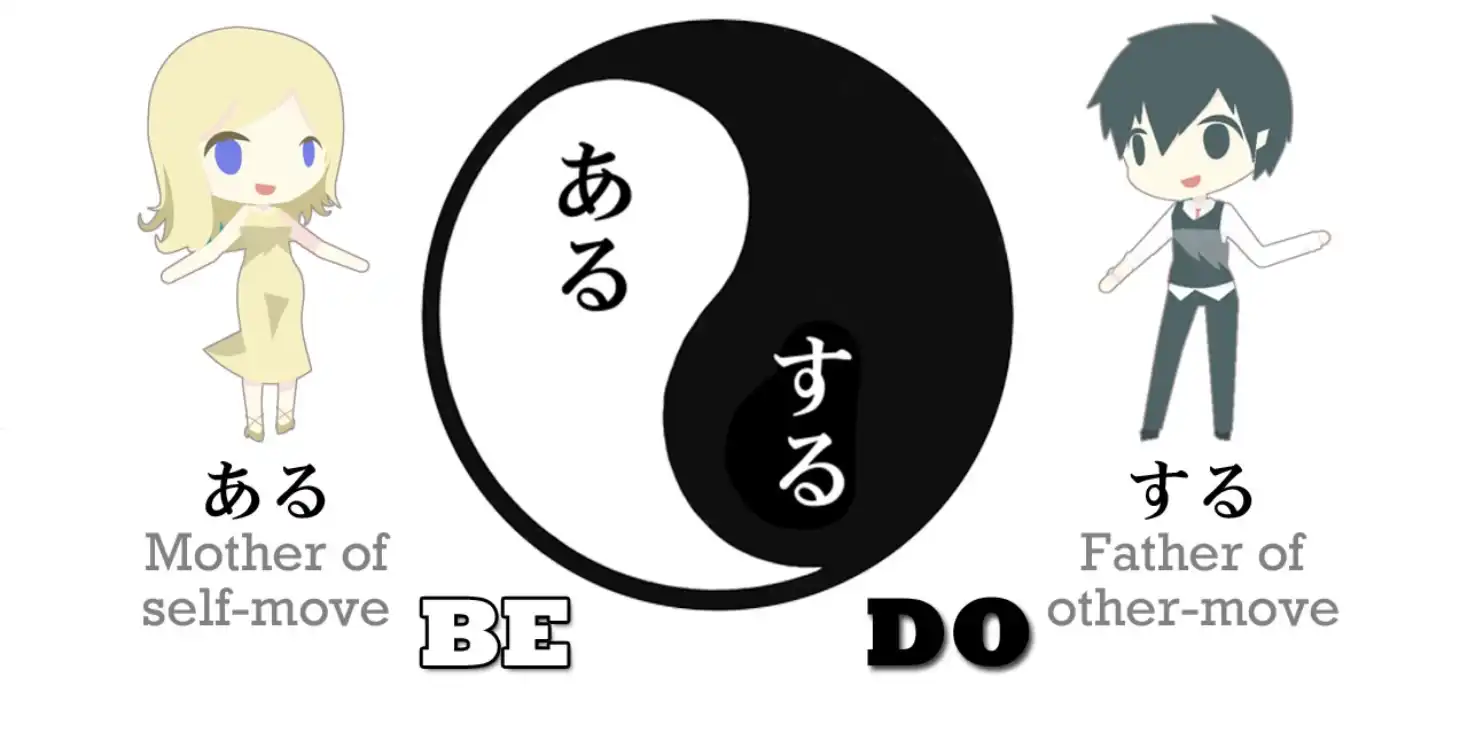
“ある” is the mother of all self-move words. It simply means “be”. So it’s a completely inward-directed verb. You can’t be or exist something else; you can only be and exist in yourself. It’s fundamentally and absolutely inward-directed, self-directed.
“する”, on the other hand, means “do”. So they mean “be” and “do”. And “する” in itself, just doing, can never exist on its own, you have to be doing something. So this is the father of all other-move verbs.
する Family Rule
Now why do we need to know that, why is it important to know that? Because when we know that, it unlocks most of the move-word pairs that we’re going to encounter.How does it do that?
Well, there are what I call 3 laws of move-word pairs.
And the first of those laws is that if one of a pair ends in -す, that is going to be the other-move word, always. Why? Because that -す is related to “する”.
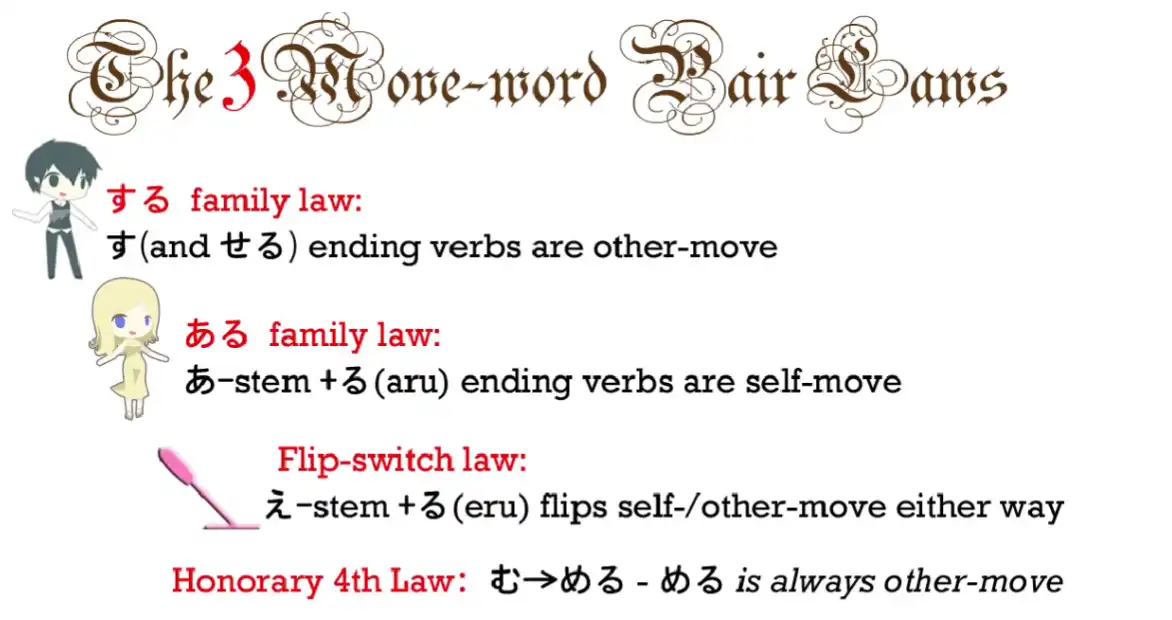
So, in the example we gave before, “出る (でる) / 出す (だす)”, “出る(でる)” means “come out” and “出す(だす)”, which ends in -す, is the other-move verb – that’s the one that means “take (something else) out”. - it requires a grammatical Object. In “負ける(まける) / 負かす(まかす)”, we know that the other-move verb, the verb that means “make (someone else) lose” is “負かす(まかす)” because it ends in -す.
And an awful lot of those -す pairs actually make that particular transformation, -える to -す. But not always.
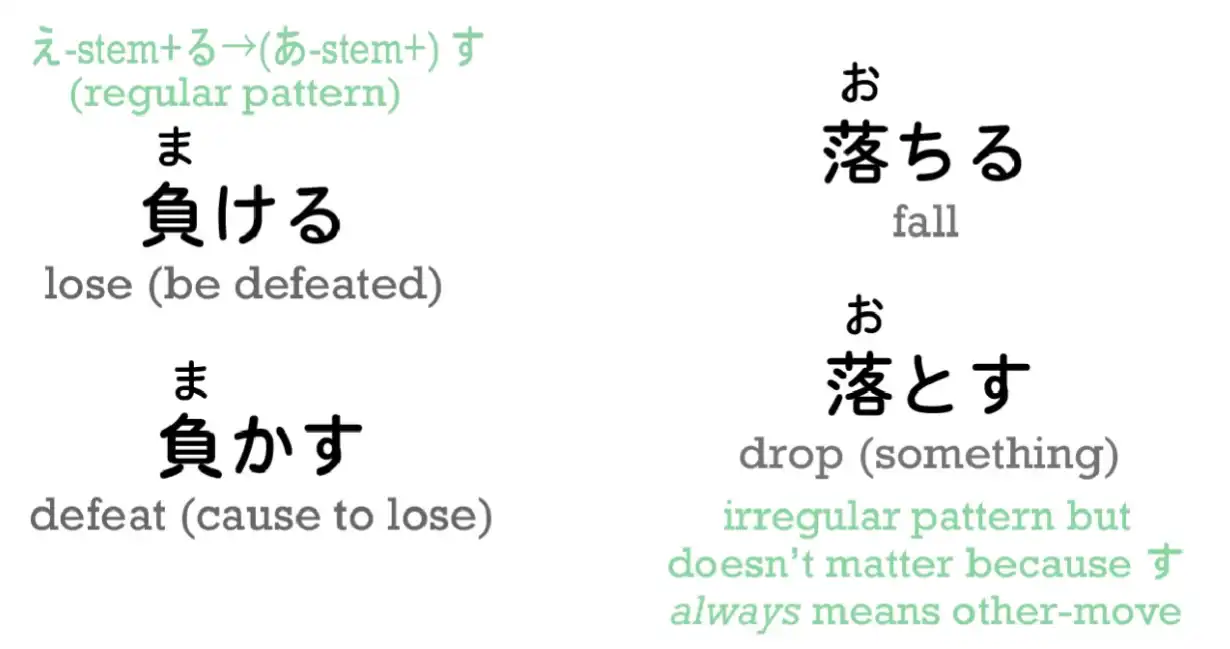
In some cases… we have, for example, “ 落ちる (おちる)”, which means “fall”, and “落とす (おとす)”, which means “drop”. They have the same kanji; they are a pair, they don’t have that regular -える to -す ending, but “落とす (おとす)” still has -す on the end, so we still know that that is the other-move partner of the pair.
ある Family Rule
Now, the second rule is that where one of a pair ends in any of the あ-stem + -る, so it ends in the sound -ある, that is going to be the self-move partner of the pair. Why?
Because that -ある is related to “ある”, the mother of all self-move verbs.

The usual pattern here is -える to -ある.
We already looked at that in the last lesson, where we have “上がる (あがる)”, which means “rise up/get up”, and “上げる (あげる)”, which means “raise (something) up”.
It is very often used to mean to “give (something) upward (to another person)”.
So we have “上がる (あがる)” and”上げる(あげる)”, and we know that the self-move partner of the pair is “上がる (あがる)” because it ends in -ある.
The usual form here is -える to -ある, but again it doesn’t have to be.
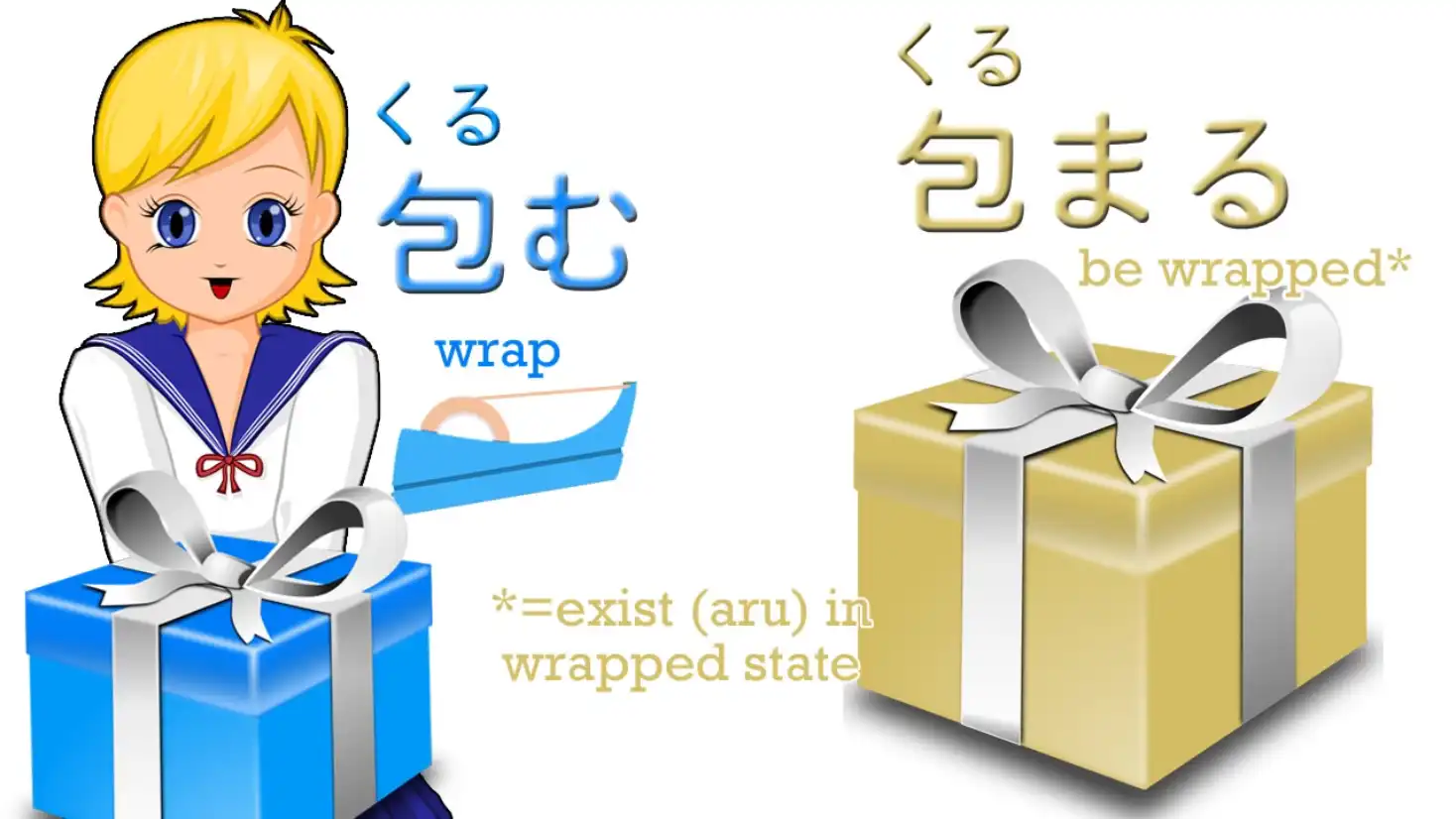
There are other cases, such as “包む(くるむ)”, which means “wrap”, and “包まる(くるまる)”, which means “be wrapped”, but again it doesn’t matter because we know that the one ending in -ある is always going to be the self-move partner of the pair.
Switch Rule
Now, the third law is that if we take any regular verb ending in -う sound (as they all do) and change it to the え-row and add -る, which means that it ends in -える, that flips a self-move word to an other-move word or an other-move word to a self-move word.
The problem is that we don’t in every case know from the structure which way the word will be flipped.
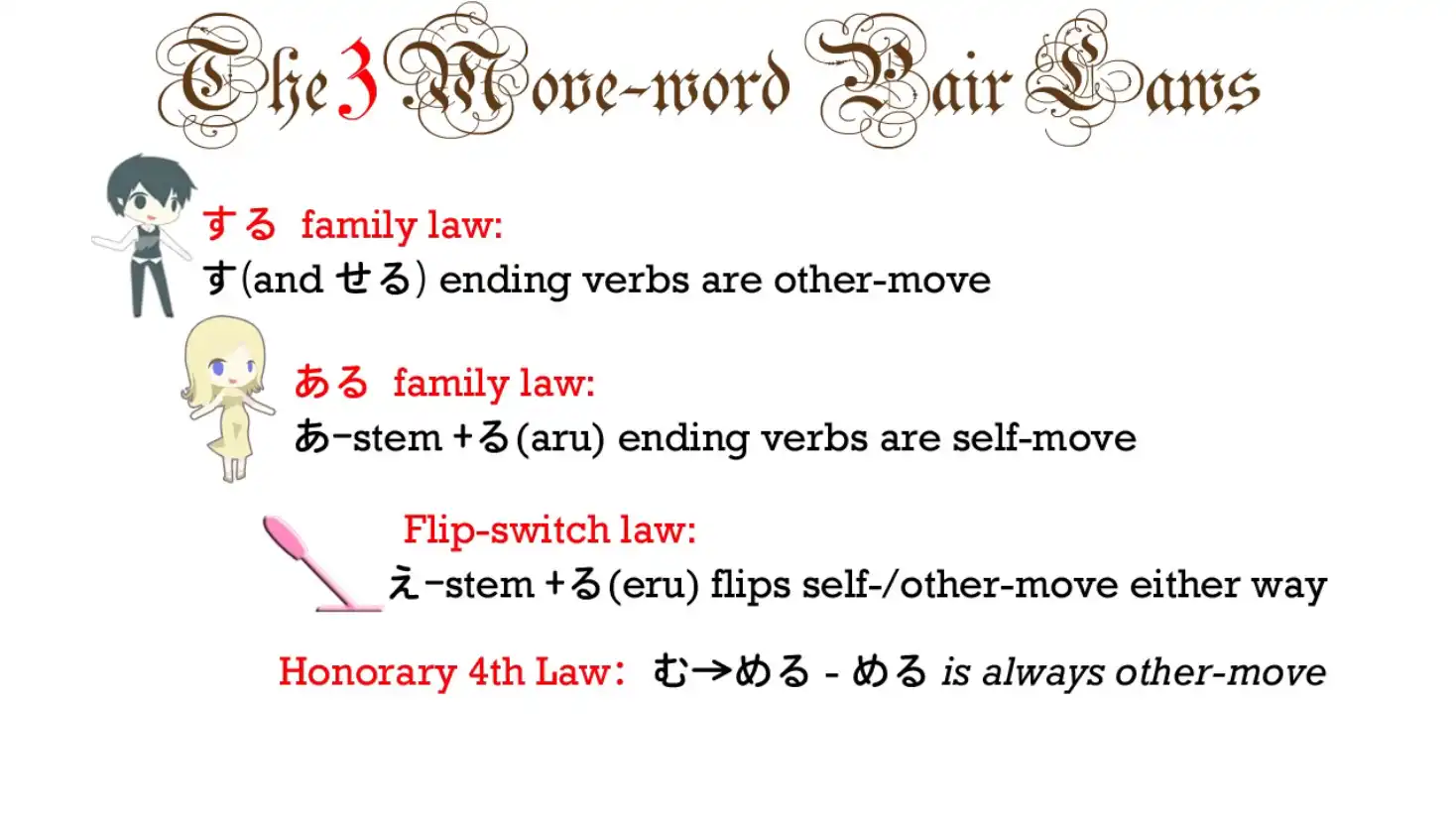
However, this is not as difficult as it seems, because first of all this is not a large number of verbs – the majority are covered by the first two rules – and of this group of -う to -える flips, the majority is -む to -める.
And -める is – I would call this an honorary member of the す family.
Or you could say that -む to -める is the honorary fourth law.
Whichever way you put it, in -む to -める, -める is always the other-move partner of the pair.
And indeed as you get more experienced in Japanese, you will get to feel that める-ending verbs have a する-like other-move feeling to them.
And this really is all you need to know if you’re beginning with self-move/other-move verbs, because this covers really the vast majority of all the pairs you’re going to encounter.
So don’t feel that you have to learn the rest of this lesson. You can come back to it later whenever you want to.
But I’m going to just complete it, partly so that you have all the information you might need for the future and partly because it’s going to give us more insight into how self-move and other-move really works.
Honorary Rules
So the next thing to know is that as well as -む/-める, which is the big one, there are also other honorary members of the す family and these are: -ぶ to -べる – -べる is always the other-move version (and -ぶ and -む are very close in Japanese; you may know “さびしい/さみしい” and other words like that, where you can just use ぶ or む in the same word, so -める and -べる naturally are both honorary members of the す family).
And also -つ/-てる – the -てる is always the other-move pair.
So in the end we really have very few wild cards in this pack.
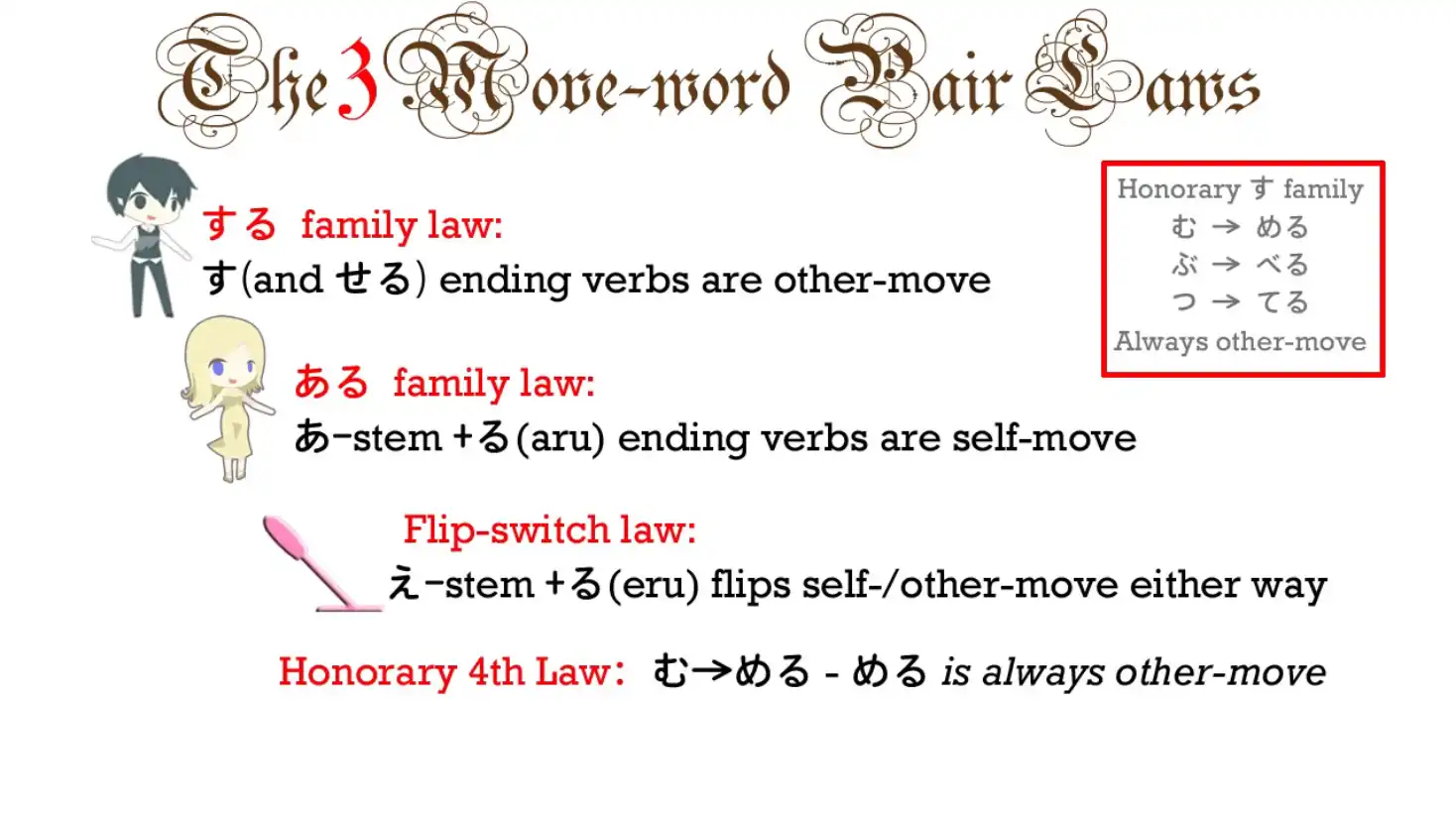
The only ones that we really can’t tell which way they are going is -く and -ぐ, to -ける and -げる, -う to -える, and those る-ending verbs that don’t fit either of the first two laws.
So these are in fact the only exceptions where you really can’t tell structurally which way they are going.
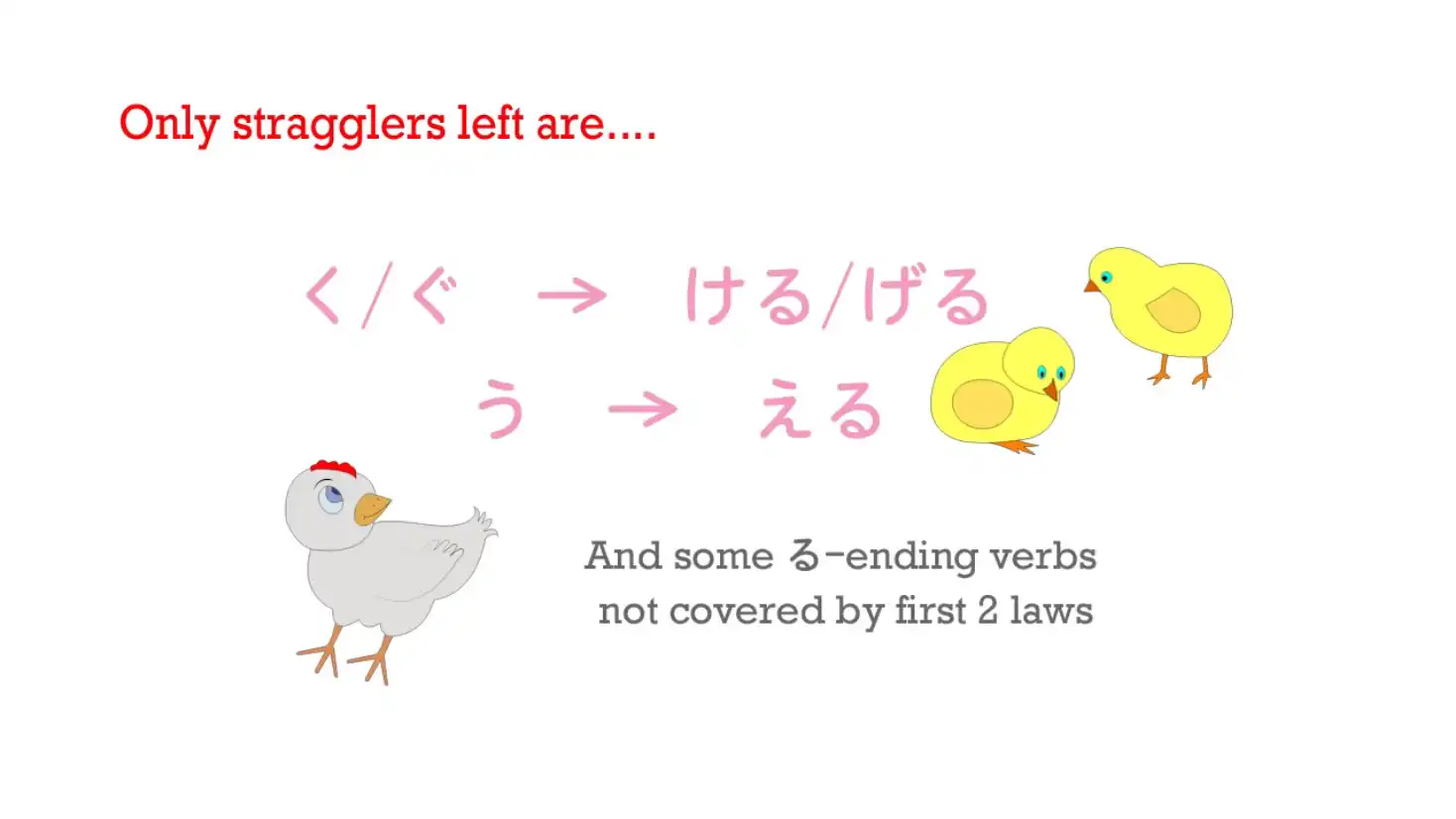
So is there anything we can actually do about this last small minority of self-move/other-move flips? And the answer to that is yes.
But it’s a little bit subtler and it will become easier as you become more competent in Japanese.
So you don’t need to worry about this if you’re at an early stage.
The rules I’ve given you cover most of the cases.
But when we take a verb that structurally you can’t tell which way it’s flipping, a lot of the time we can tell semantically – that’s to say, that when I say that the え-row plus -る flips transitivity, I mean exactly that.
The -える version is the flipped version; the -う version is the original, the one that’s in the basic form of the verb.
So to take an example, “売る(うる)” means “sell”; it’s a very common word.
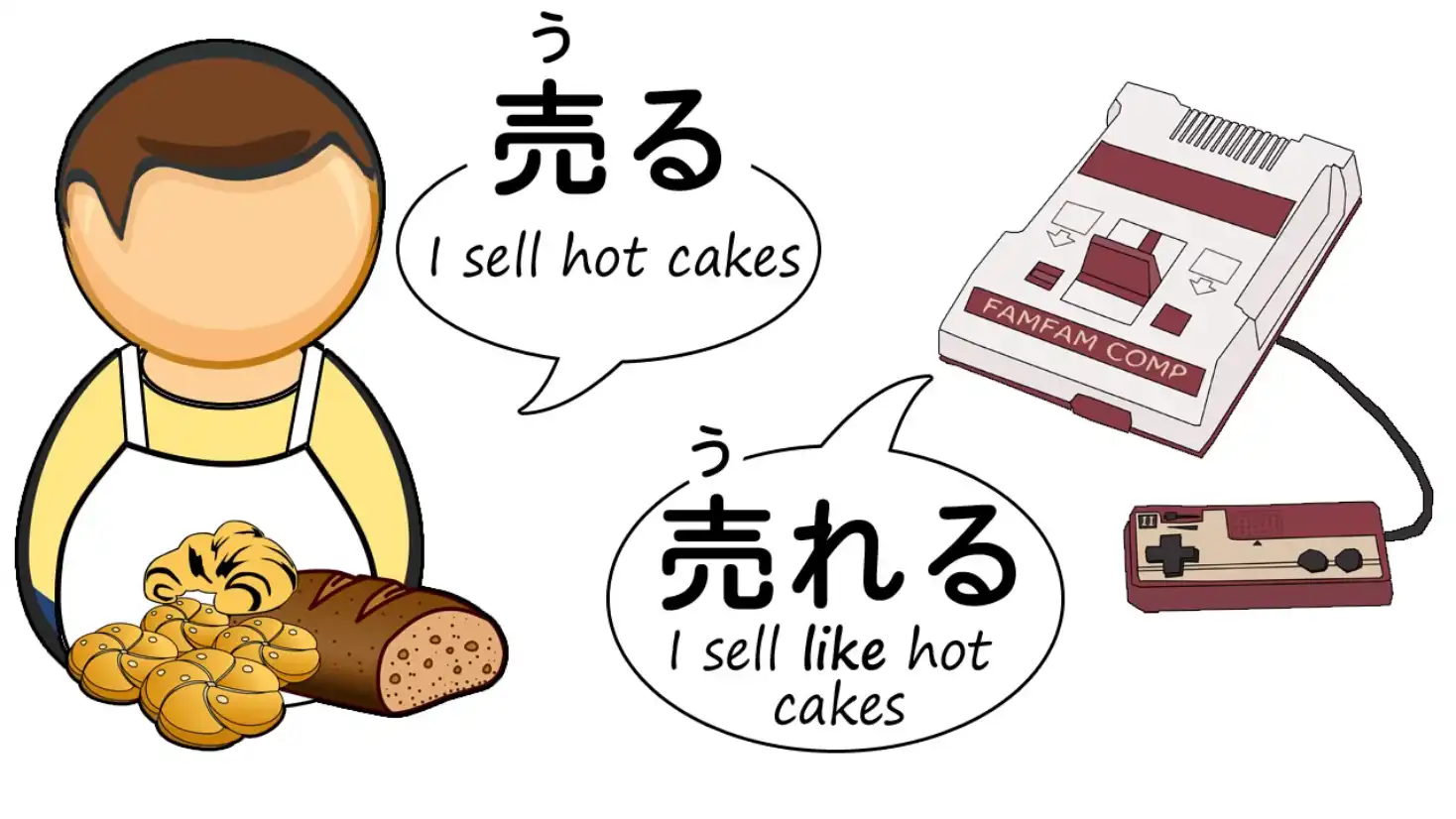
There’s a less common version of it which is “売れる(うれる)”, and that’s the flipped version. Now, “selling” is obviously an other-move verb – I sell something.
You can’t just sell in the abstract. I sell something-or-other and so I’m moving that other thing – quite literally.
But “売れる(うれる)” means “sell” in the other sense, as in “that game is selling like hot cakes”.
So in this case, they’re talking about a book selling or a game selling, so the thing that is doing the selling here is also the thing that is moving, so this is a self-move version, isn’t it?
So it’s clear that “売る(うる)” is basically an other-move verb but when it’s flipped it has a self-move version.
Now, if we take one that goes the other way, “従う(したがう)” means “obey” or “follow”, and it has a flipped version, “従える(したがえる)”, which means to “be followed by” or “be obeyed by”.
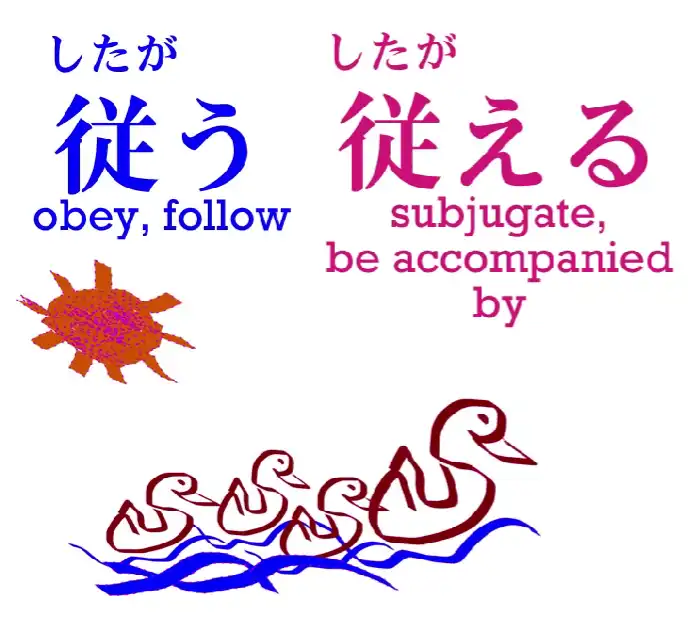
Now, it’s clear here that the basic idea is obeying or following and that the extended idea is being obeyed or being followed.
So here it’s clear that the other-move version is going to be the -える version, because that’s the flipped version of the basic concept, to obey or follow.
And we can also note here for those of you who’ve been asking yourselves, “Why does she say that transitive and intransitive aren’t correct?” – this is an example.
The Japanese-English dictionaries tell us that “従う(したがう)” is the intransitive version, but if you think about it “従う(したがう)” means “obey” or “follow”. This is not an intransitive word.
You can’t just obey or follow in the abstract. You obey someone or you follow someone. It’s a transitive verb.
Note: Dolly wrote this and this, there is also this Japanese article about some self-move/intransitive? verbs using を, which is normally…ungrammatical?, I am not entirely confident in explaining it since my Japanese is still quite limited, so if anything you can write me,
I guess it would be beneficial not to view them purely in transitive = always other-move etc.
So I recommend you do your own research about this problem and decide how to go about it.
So why do the dictionaries call it intransitive?
Because they have made the commitment to translating self-move as intransitive, but while it’s a transitive verb – you obey someone, you follow someone – it is also a self-move verb.
In obeying someone or following someone, you are not moving that other person.
You are moving yourself.
In being obeyed or being followed, you are not moving yourself, you’re moving that other person.
So this is one of the cases where self-move and other-move do not correspond to transitive and intransitive.
There aren’t too many of those cases, so it doesn’t matter if you want to use transitive and intransitive, just be aware that the meaning is not exactly the same in any case, and in some cases it doesn’t fit at all.
Now, as I say, if you just want to remember the three rules and nothing else, that is going to break the back of self-move and other-move verbs for you.
In most cases, you can understand them with nothing but that.
So the rest of what I’ve told you is very useful as you become more proficient at Japanese, but if you just remember the concept of self-move and other-move and the three basic rules: the -ある version is always self-move, the -す and -せる versions are always other-move and if you also remember that the -める version is always other-move, that’s worth throwing in because that covers a lot.
And with those, you really have the problem of self-move and other-move verbs mostly under control.
16. てみる, や particle, から particle, exclusive “and”
Lesson 16: Te-miru, “try doing”, ya-particle, kara-particle, exclusive-“and” + more Alice
こんにちは。 Today we’re going back to Alice, and we’re going to be using quite a lot of trains this time because I want us to really grasp the structure of these sentences.
So, if you remember from last time, Alice had just entered the rabbit hole and quite surprisingly she finds herself falling very slowly down a vertical hole.
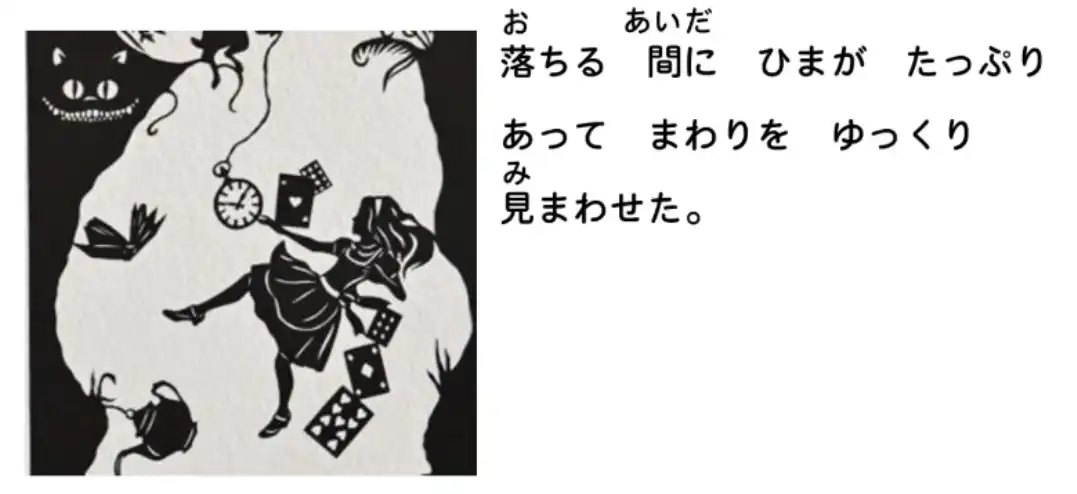
“落ちる間にひまがたっぷりあってまわりをゆっくり見まわせた” Now, I’m going to tell you what this means first and then we’re going to break it down.
“落ちる間に” “落ちる”, as we know, is “fall”. “間” is a period of time and it’s also the space between two things.
And obviously a period of time is always, metaphorically speaking - and we can only really talk about time in spatial metaphors - a period of time is always a space between two points, isn’t it? It has a beginning and it has an end.
So “落ちる間に” means “while (she) was falling / during the period of time while (she) was falling”.
“ひま” means “free time / open time”. It’s a word you’ll see quite often, and it can be used in both a positive or a negative sense. It can mean free time to do what you want to do, or it can mean empty time, being bored, having time hanging on your hands.
Here it just means having plenty of time available to look around, because she’s falling, she can’t do anything else, and she’s falling rather slowly.
“たっぷり” means “in large quantities”.
It’s another one of these り-ending adverbs that don’t need に.
And it means “in large quantities / in plentiful amounts” - rather like pouring from a tap: “たっぷり”, “in large quantities”.
And here it’s an adverb describing the fact that the “ひま”, the “free time”, exists.
So the free time exists in large quantities.
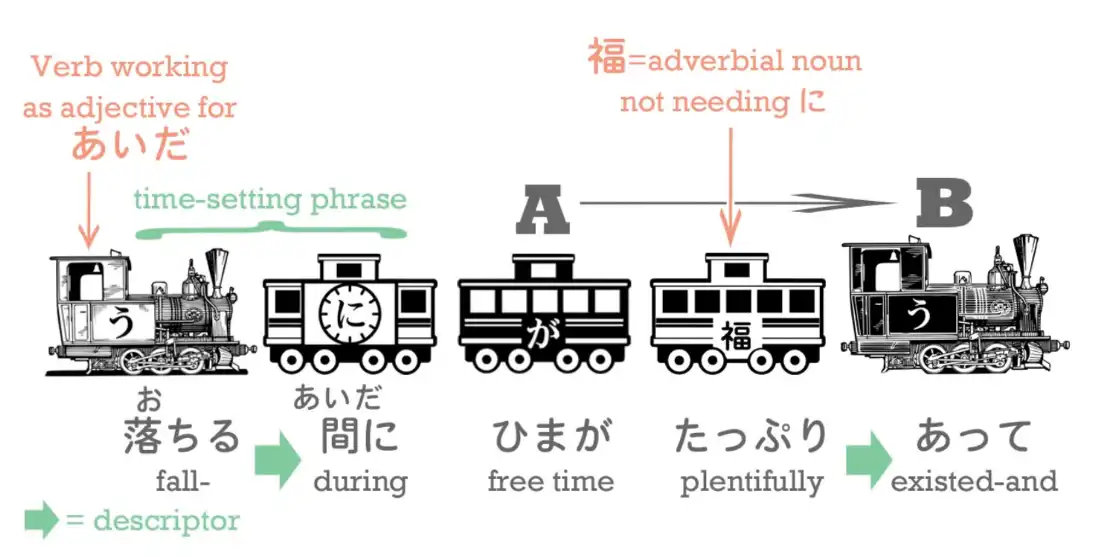
So that’s our first logical clause: “落ちる間に…” (which simply sets the scene, the time, for the action - it’s an absolute time expression because it’s a particular time, so it takes に) “…ひまがたっぷりあって” (“there was a lot of free time”).
Now, the next part - “まわりをゆっくり見まわせた” - is interesting because this is another example of what we were talking about last week: self-move/other-move pairs.
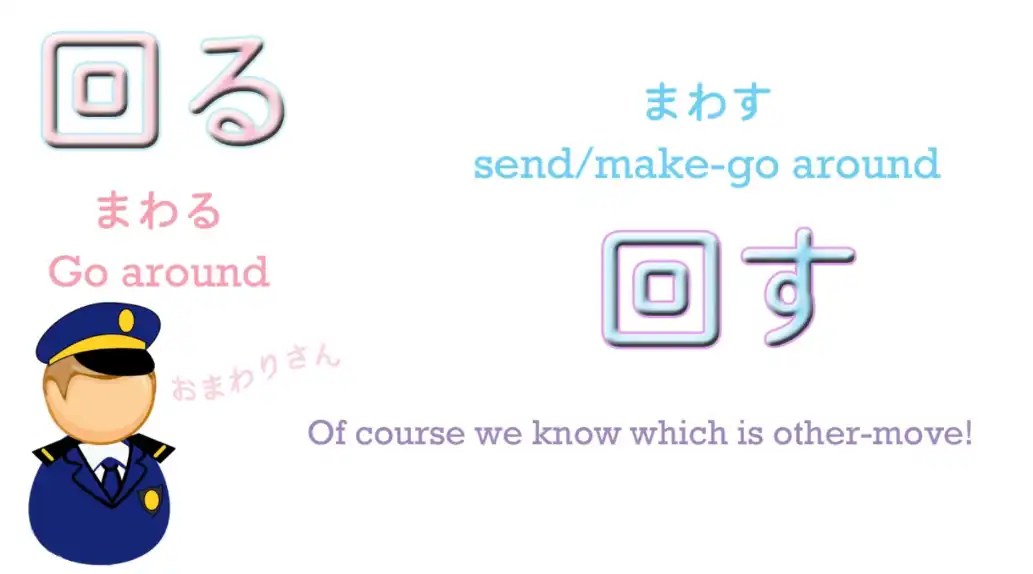
“回る” means to “go around/move around”.
The rather childish name for a policeman is “おまわりさん”, which means “someone who goes around / someone who does the rounds”.
“回す” means “make (something) go around / to send (something) around / to cause it to go around” and of course, as we learned last week, we easily know which of the pair is the self-move word (going around) and which is the other-move word (sending around) because the sending-around one ends in -す.
Now, we don’t actually have “回る” here; we have “まわり”.
And as we’ve mentioned before, when we take the い-stem of a verb and use it on its own it usually becomes a noun.
There is another use which we’re not going to enter into right now, but in this case it is becoming a noun.
So, what does “まわり” mean?
“まわり” can actually mean two things: it can be the noun-form of “回る”, in which case it’s “going around”, “doing the rounds”, and that’s what we have in “おまわりさん”, a policeman - here’s someone who does the act of doing the rounds, “まわり” is “the act of doing the rounds”, — but it can also mean “the surroundings”, and in this case it actually takes a different kanji to show that it’s a slightly different meaning of the word. Note: It’s this Kanji - 周り. It’s still the noun-form of “around”, but in this case it’s the surroundings, not the act of going around.
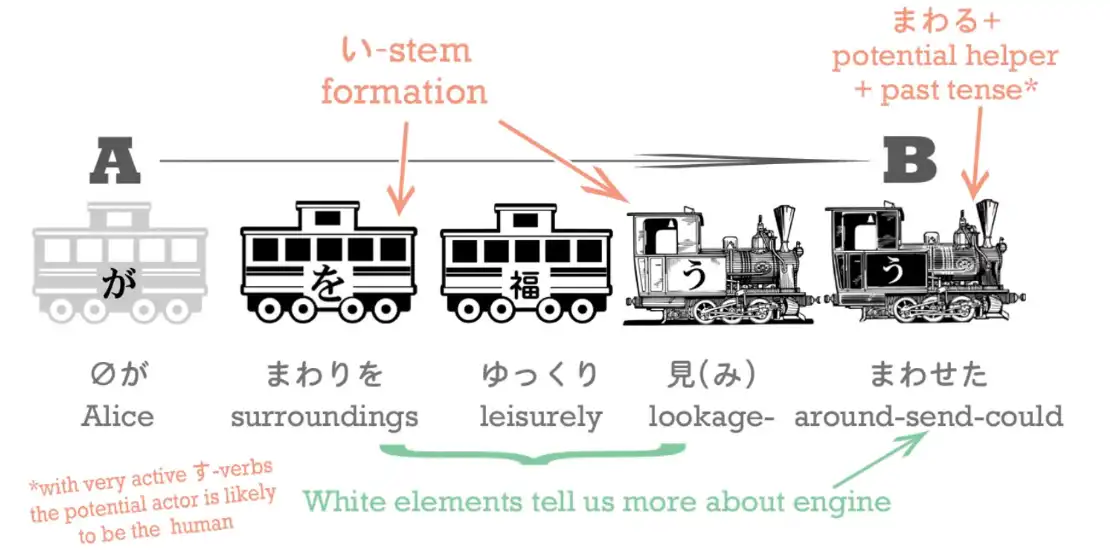
Note: The top right orange まわる should be まわす. (Dolly-先生 admits in the comments)

- So, “(zeroが)まわりをゆっくり見まわせた” means “(she) could in a leisurely manner…” (“ゆっくり”, that adverb we learned last week - *Lesson 14)…
she could in a leisurely manner 見まわす” What does “見まわす” mean?
We know what “まわす” means - it means to “make (something) go around”.
“見まわす” is attaching “まわす” to the い-stem of “見る”.
We can’t actually tell it’s the い-stem, because this is an ichidan verb, and all ichidan stems look the same, as we know, but we know that this is in fact the れんようけい/連用形, the い-stem, because that’s the one that gets used for attaching verbs to other verbs.
So, “見まわす” means literally “send your looking around / send your eye-beams around the place / make your looking go around”.
So, “まわりを見まわす” is “look around the place / send your eye-beams, send your looking around the place / surroundings”.
And “見まわせる” is, as we’ve seen, the potential form of “見まわす”.
So what this is saying is “because a lot of time existed she was able to leisurely send her looking around the surroundings”.
“落ちる間にひまがたっぷりあってまわりをゆっくり見まわせた”
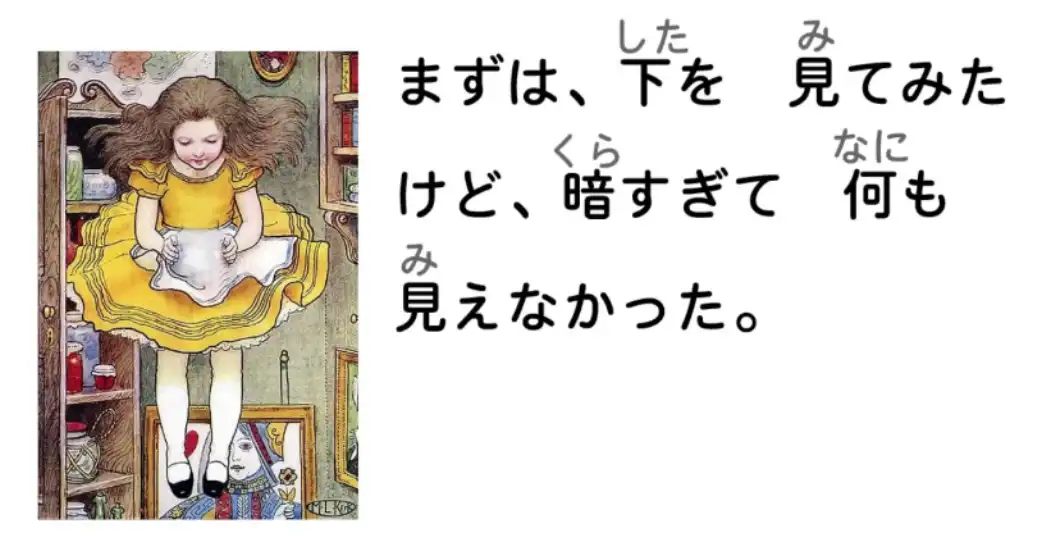
“まずは、下を見てみたけど、 暗すぎて何も見えなかった。” “First of all, she tried looking down, but it was too dark so nothing was visible (nothing could be seen).” “まずは” means “first of all”. “まず” is “from the start / from the beginning”.
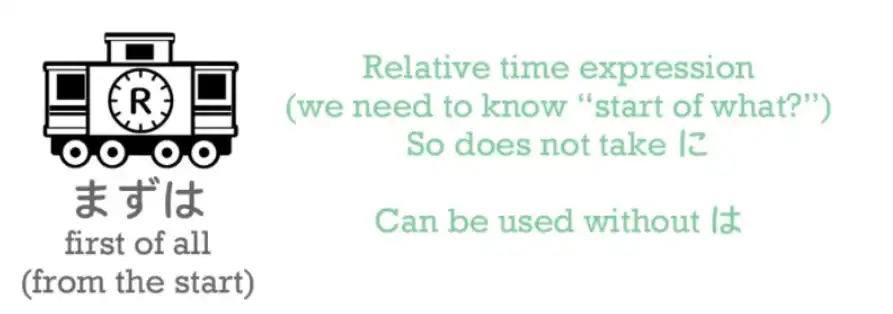
“まずは、下を 見てみた”.
Now, “下を見る” is “looking down / looking at the down”.
We know that in Japanese “down” is always a noun, don’t we?
So you look “at the down” - “下を見る”. But it doesn’t say “見る” here; it says “見てみた”. And this is a form of speech that we’re going to find a great deal.
-てみる / -て見る
When we add “みる” to the て-form of another verb, what we’re doing is saying “try doing something”; literally we’re saying “do it and see”.
So, “食べてみる” means “eat it and see / have a taste of it”. A: “Do you like this?” B: “I don’t know.” A: “食べてみてください. Try it, taste it, eat it and see.” We often say “やってみる” - “I’ll give it a try / I’ll try and see what happens”.
“やる” is a more casual form of “する”, and you can say “してみる”, especially in more formal circumstances, but more often we say “やってみる”: “Give it a try / give it a go / do it and see.”
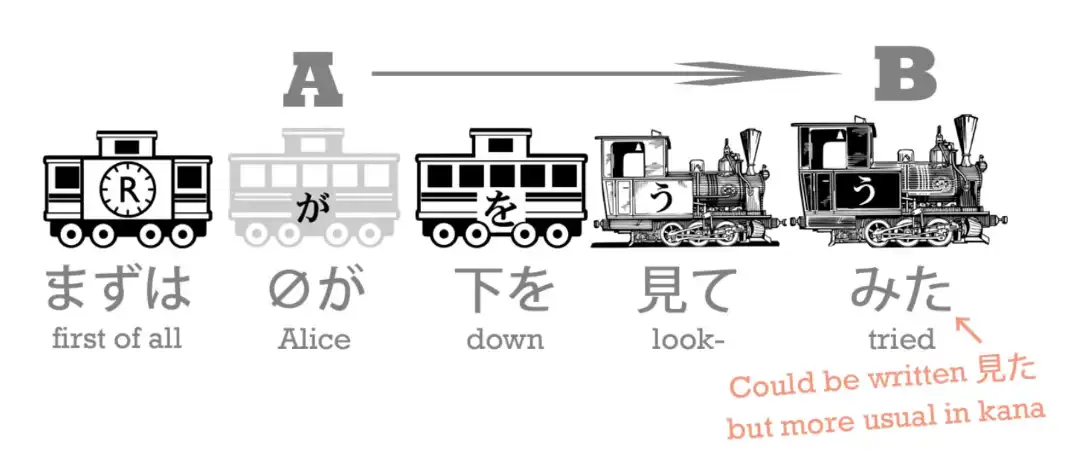
So here we’re actually using “見る” with “みる”. “見てみる” - “try having a look / take a look / have a look and see”.
So, “下を見てみたけど、暗すぎて”.
“暗い” is “dark” and “すぎる”, as we’ve talked about before, means “going by, going beyond”.
So in this case “すぎる” means “too much / going in excess of”.
In other words, it was too dark.
It was excessively dark; it was too dark.
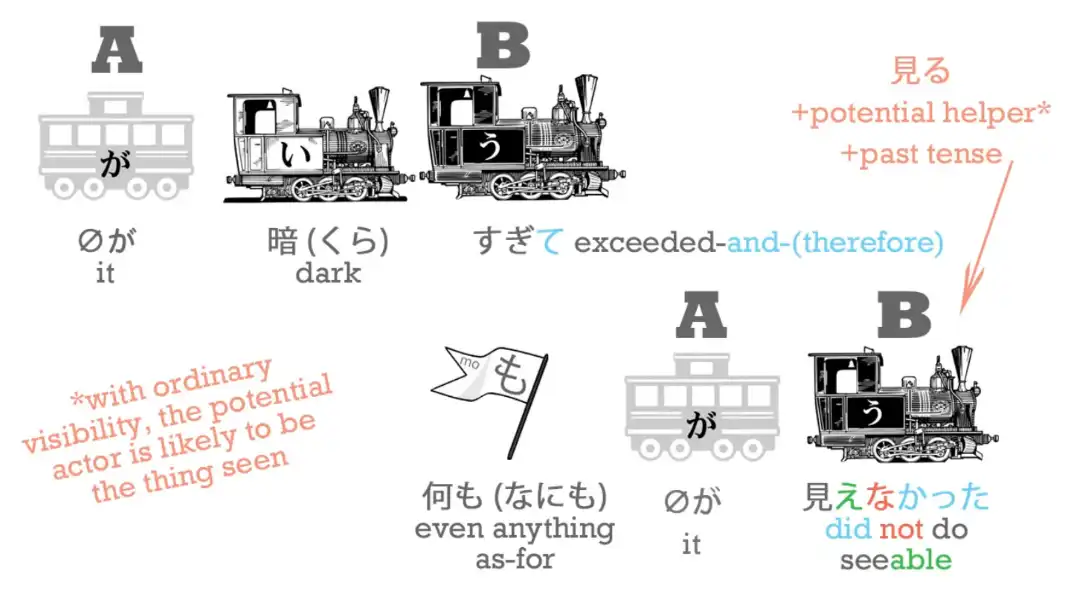
“暗すぎて何も見えなかった”.
“何も” means “even as much as (something)” - “何も”.
And I’ve done a video on these uses of も which you might want to watch.
“何も見えなかった” - now, “見る” is “see”; “見える” is “to be able to see/to be visible/be seen”.
Note: Might be better to translate as “to be visible/do seeable/do seen” (self-move ver. of 見る)
I added this in case there would be confusion, since it is a rather nuanced difference and people were confused about this in the comments under the video, let alone me during the first time.
What Cure Dolly says in the comments. I recommend reading through all comments about this.
In the video, Dolly-先生 misspeaks here (as she admits in the comments), calling 見える “be able to see”, which might confuse someone to think of the potential form 見られる instead.
—
In this case, she meant 見える as the self-move version of 見る, meaning something like
“be visible/seeable” as physical visibility (of a thing etc.). It is a nuanced difference to 見られる.
As Dolly says in the comments, it CAN both function as a potential and self-move version of
見る. It’s a different verb to 見られる, but 見える can also function as the irregular potential form of 見る and is also the self-moving partner to 見る. **Check lesson 54 for this, even right after. **
Also, this point (if you check 見える inflections on Jisho), just like with 出来る note in Lesson 10.
The point here is that while both imply potential, there is a difference, with “be able to see” translation being more reserved to the “見られる” instead of 見える, hence why this note.
—
And if we look at the trains here,
we’ve got to have a が marked subject in this second clause:
“何も(zeroが)見えなかった”.
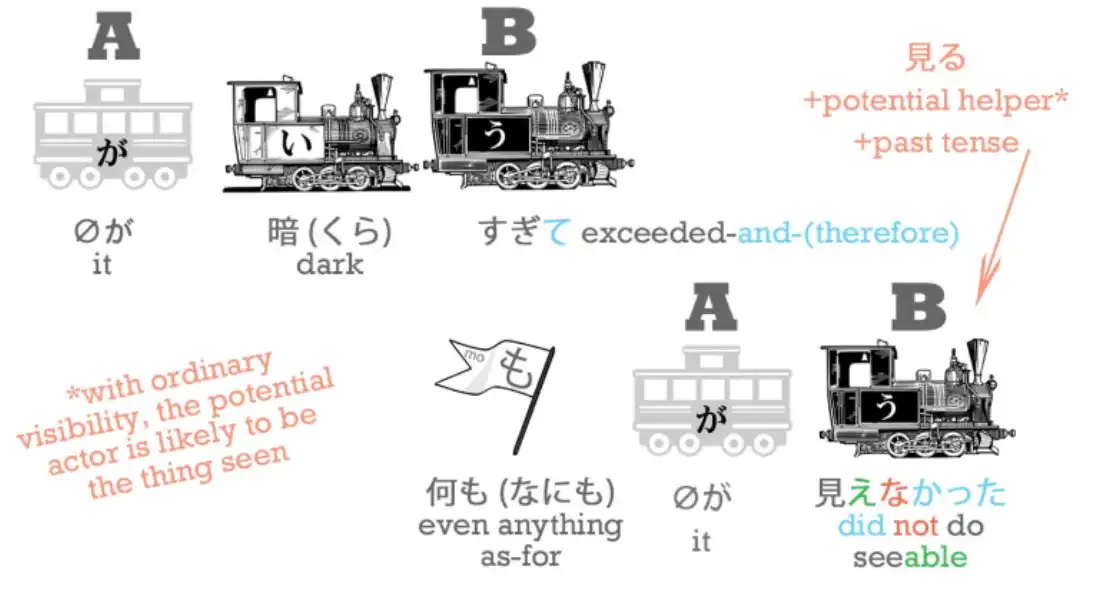
What is the zero in this case?
If we’re looking at it in English terms we might think it’s Alice - “Alice couldn’t see anything”.
But in Japanese it will usually in fact be “何”, which is “a thing / something”.
“Nothing was able to be seen, nothing could be seen”,
because usually with expressions like “見える / 見えない”, “聞こえる / 聞こえない”,
“be able to see/do seeable” “be able to hear/do hearable” (+ their ない-form not hearable etc.)
Note: The “do seeable” is a rough translation of how Dolly might translate it to I guess show that it’s a verb more per some of her comments as noted on the previous page’s note.
Another translation for 見える as per Dolly - to be visible/”do seen”/be seen/do seeable/visible.
While -ない, as its negative form is quite adjectival (see this). It doesn’t really matter how it’s translated, only if you wanted to be more technical as per Dolly’s way of rough translation & to more clearly show the difference between 見られる & 見える. Check lesson 54.
- we apply it not to the person who’s able to see, but to the thing that’s able to be seen.
And of course we’ve covered this, haven’t we, in our lesson on the potential. (Lesson 10)
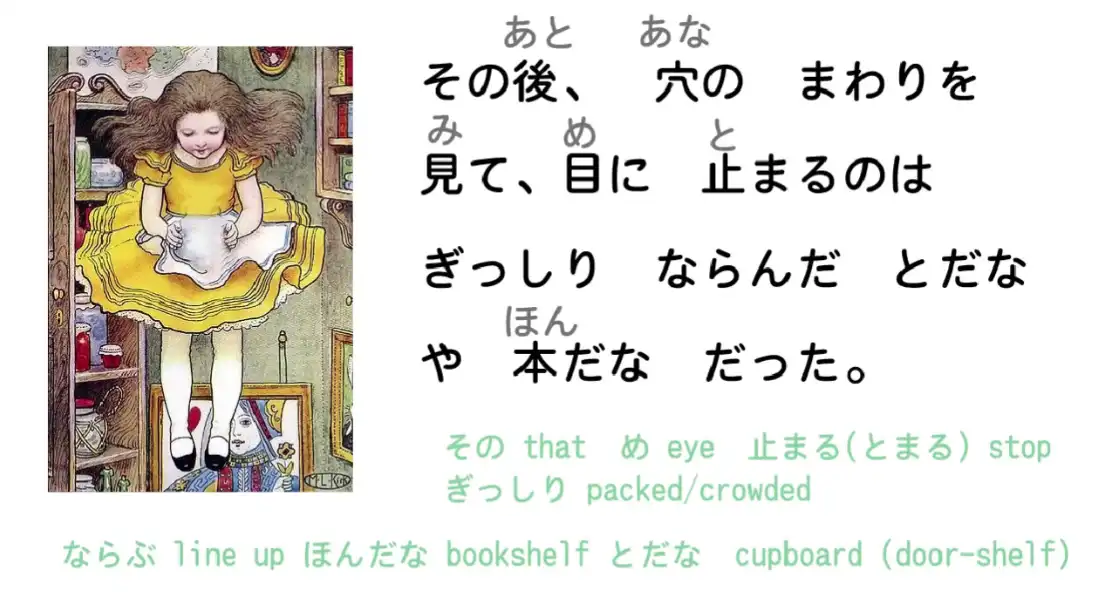
“その後”: “後”, as we know, means “after” - we’ve had it in following after someone, but it also means “after” in the other sense, “after that”.
“その” means “that”; “その後” means “after that”.
So again, this is just a time-expression, setting it in time.
And this time it’s a relative time-expression, “after that / after a particular thing”, so it doesn’t need に.
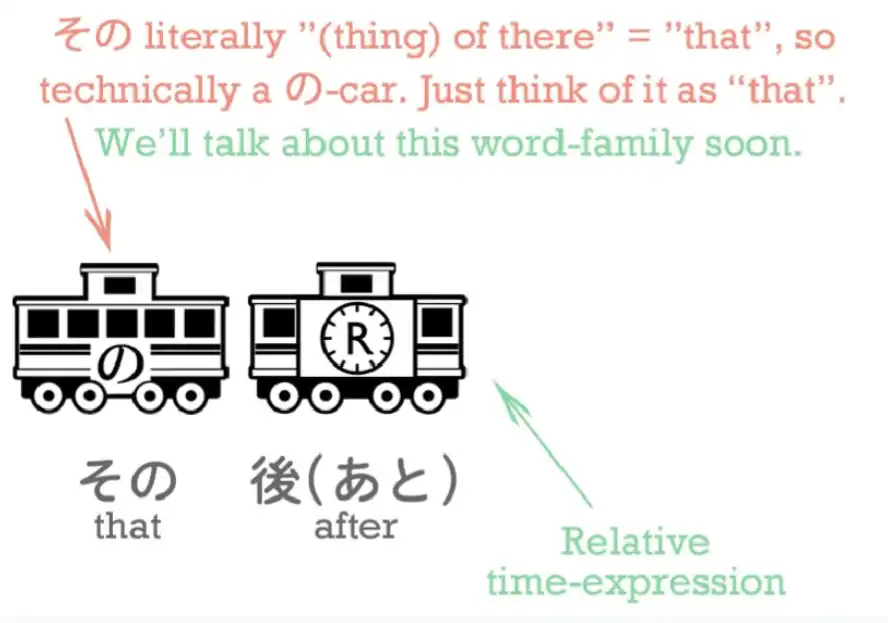
“その後、穴のまわりを見て” So now she’s not looking down. This means “the surroundings”, again, “まわり/周り”, of the hole, “をみて” - “after that, she looked at the surroundings of the hole”.

“目に止まるのはぎっしりならんだとだなや本だなだった.”
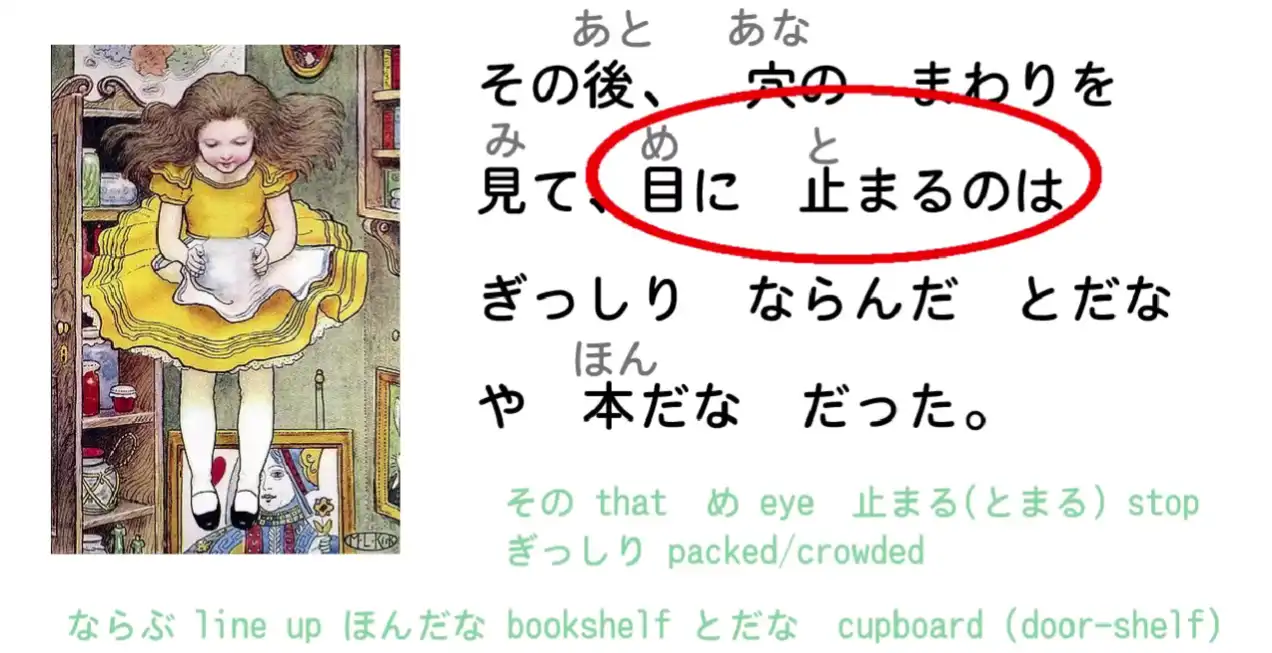
Right, so this is quite complex. The first clause is simple enough.
“その後、穴のまわり見て” - “After that, she looked at the surroundings of the hole”.
The second clause has quite a lot for us to consider.
“目に止まるのは” means literally “the thing that stopped in her eye”.
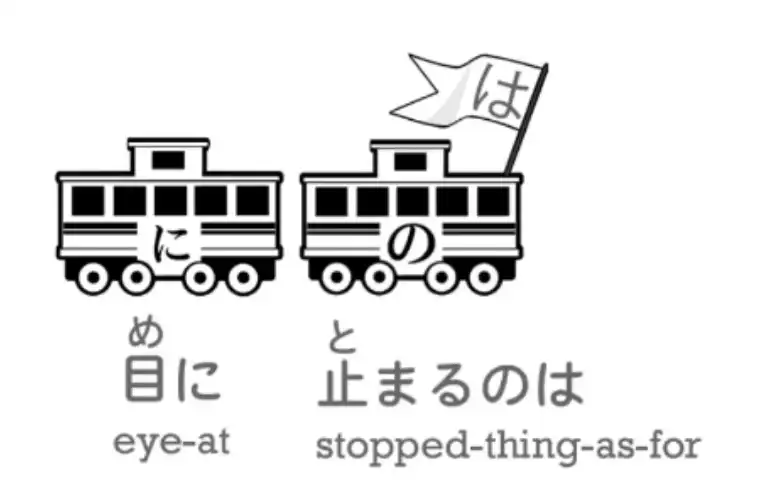
Now this is a similar expression to, in English, “the thing that caught her eye”, isn’t it?
Various things passed through her eye, passed through her vision, and the thing that stopped there was what we are going to talk about.
But we also need to look at this use of の.
As we’ve seen before, の is like apostrophe-s (‘s) in English.
So if we say “さくらのドレス”, we’re saying, “Sakura’s dress”.
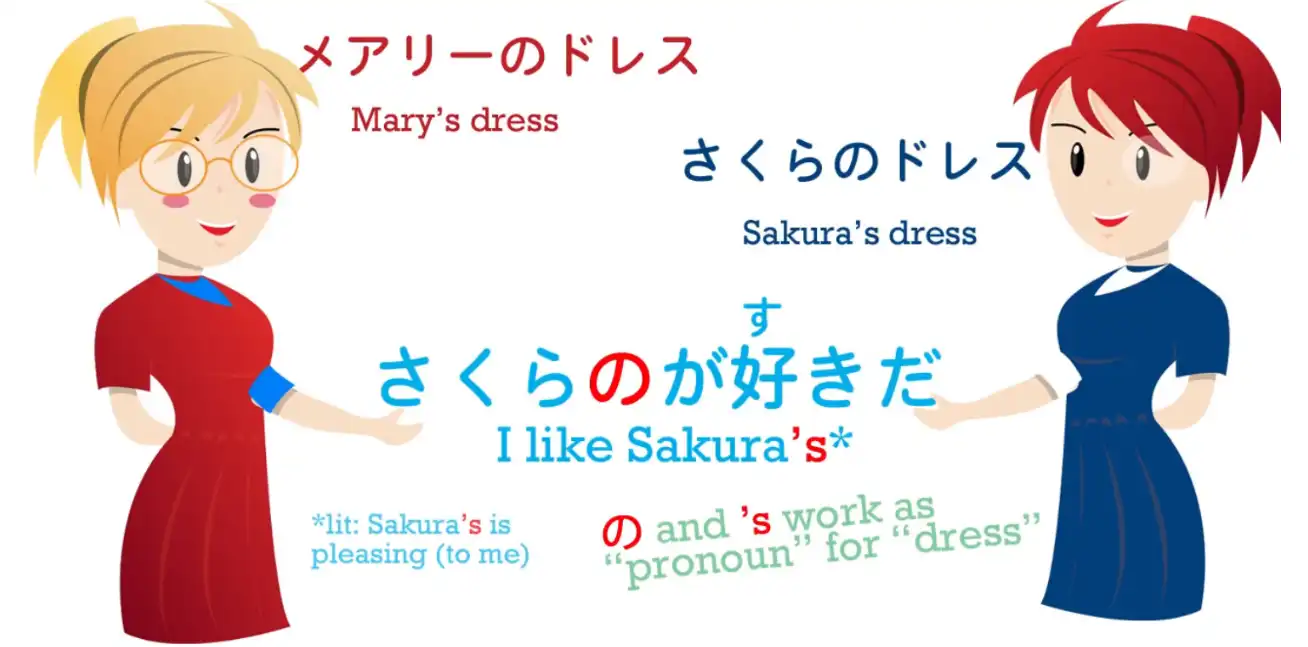
Now also, just as in English, if you say, “Which dress do you like best?” Suppose that Sakura and Mary are both wearing dresses and you say, “Which dress do you like best?” In English you might say, “Sakura’s. I like Sakura’s best”.
You could say, “Sakura’s dress” but you don’t have to, you can just say, “Sakura’s”.
And it’s the same in Japanese.
You can say (just) , “さくらの” - Sakura’s, the one that belongs to Sakura.
But this can be taken much further in Japanese, and I’ve done a whole video about this particular use of の, which you can look at if you want to go deeper.
But in this case the way it’s taken further is “目に止まるの” - this is “the thing, the one that stopped in her eye”.
“Which dress do you like best? Sakura’s, Sakura’s one, Sakura’s thing, Sakura’s dress.” “目に止まるの” - “the thing, the one that stopped in her eye”.
So, “穴のまわりを見て、目に止まるのは” - “looking at the surroundings of the hole, the thing that stopped in her eye was…” And what it was, was
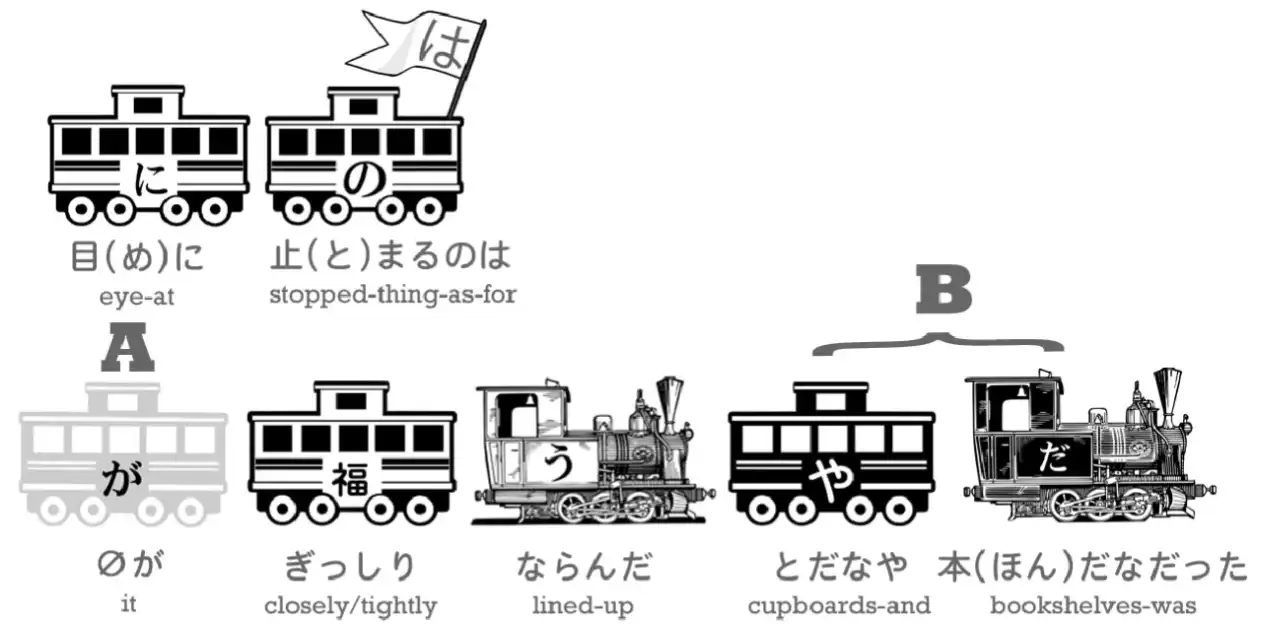
“(zeroが)ぎっしりならんだとだなや本だなだった”.
“ぎっしり” is yet another one of these り-ending adverbs that don’t need に.
“ぎっしり” means “tightly packed”. “ならんだ” is the past tense of “ならぶ” which means “lined-up”, so “ぎっしり ならんだ” means “tightly lined-up / packed together / lined-up and packed together”.
“ぎっしりならんだとだなや本だなだった”.
All right. Well, we’ll get to the “や” in just a moment, but “とだなや本だな”.
The word for a shelf in Japanese is “たな”, and when we add something before it to tell
us what kind of a shelf it is, we use that “ten-ten hooking” (〃) that we’ve talked about before.
Note: Lesson 5, “The third & fourth Godan group”.
So the “た” becomes “だ”: “とだな” - that “と” means “door”, so literally, “とだな” is a “door-shelf” and that is the Japanese word for a cupboard.
And it’s quite a good word, I think. That’s what a cupboard really is, isn’t it? Shelves, with a door. It’s a better way of saying cupboard than the English way which says it’s a board on which you put cups, which isn’t quite what a cupboard is.
“本だな” is even easier: it’s quite literally a book-shelf, bookshelves.
The や particle + exclusive “and”
Now, this “や” is something we need to cover.
When you want to say “and” - something “and” something else - how do you say it in Japanese?
We know that when you’re putting two clauses together, we use the て-form, or sometimes we use other things, like “でも”.
In English we use “and” in all cases: we say “bread and butter”, “pencil and paper”.
We also say “I went into the baker’s and bought some bread.” But in Japanese we don’t use the same “and” in the two cases.
We already know some of the ways we can “and” two clauses together, but when we’re “anding” two things together, there are two ways to do it.
And one is to use the と-particle.
We know that the と-particle is the quotation particle, but it’s also the and-particle.
So if you want to say “pen and book”, we say “ペンと本”.
But we can also use the や-particle, so we can say “と” or “や” when we want to “and” together two or more objects. What’s the difference?
Well, as a matter of fact it’s a very useful difference, and one that we could do with in English.
“と” is an exclusive “and”. If I say, “What’s in that box?” and you answer “ペンとえんぴつ” - “pens and pencils” - you are telling me that there are pens and pencils and nothing else in that box.
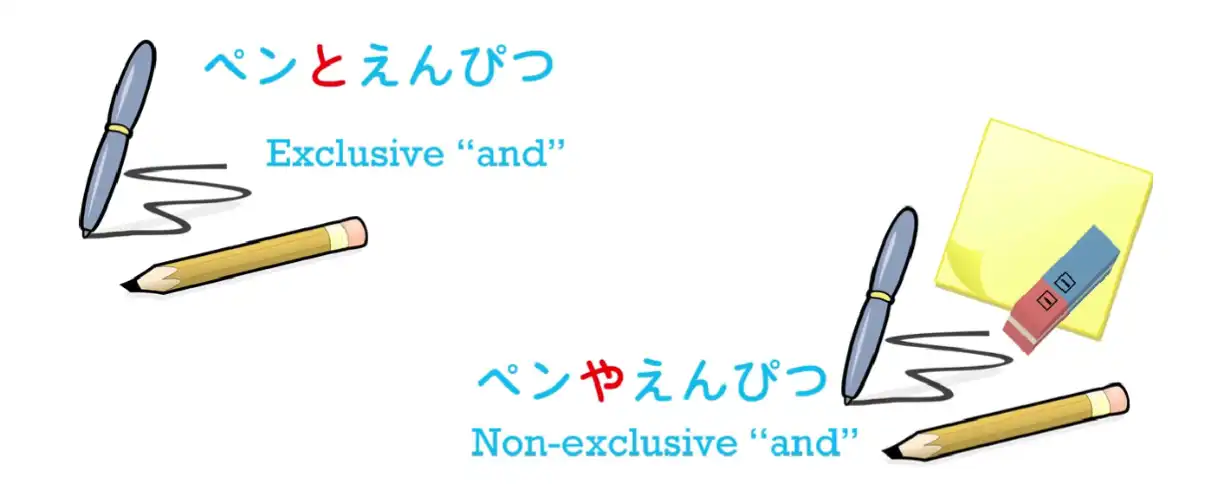
If you say “ペンやえんぴつ”, you’re saying there are pens and pencils and there might also be something else - and very often you’re implying that there is something else because you’re avoiding using the exclusive “and”.
So what “stopped in her eye” was the fact that cupboards and bookshelves (among other things) were tightly lined around the walls.
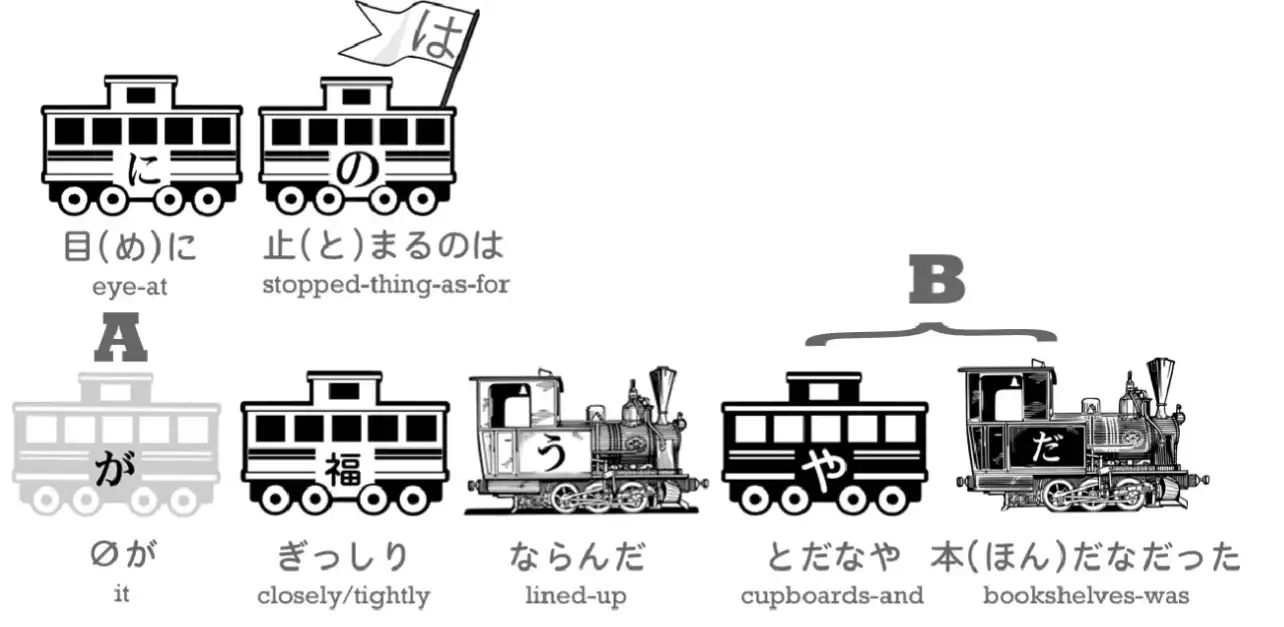
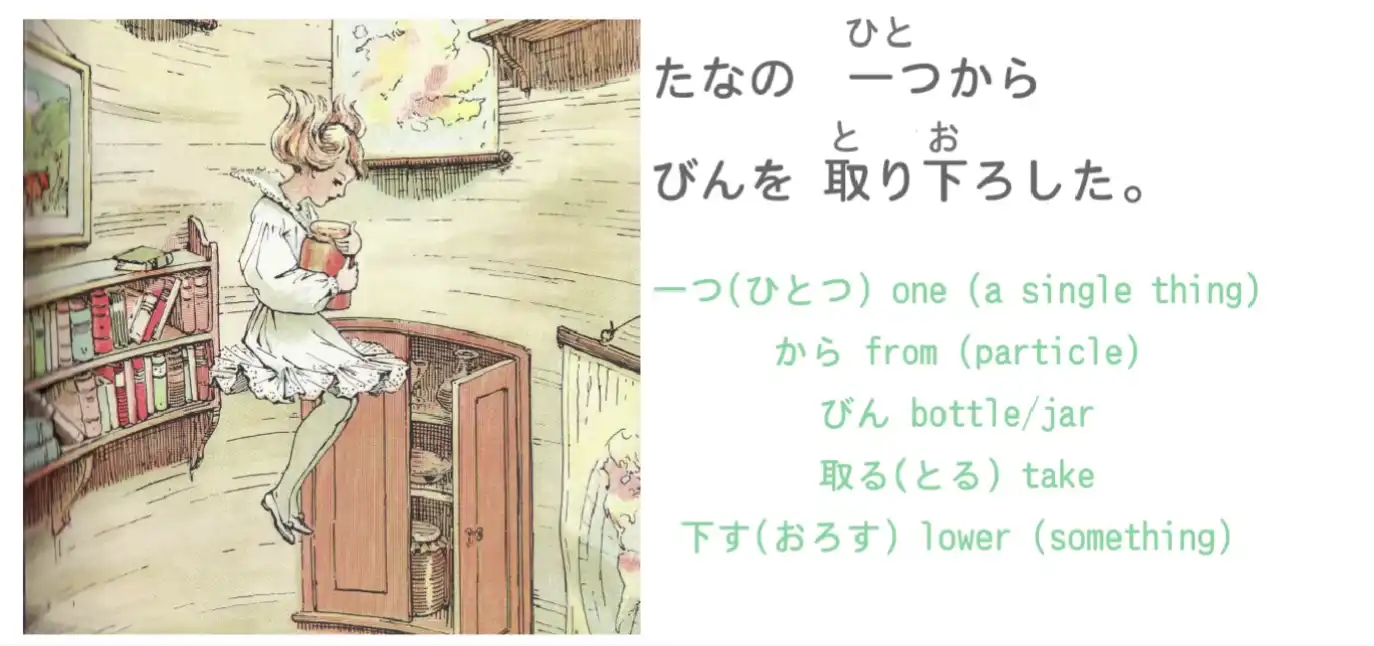
Note: 取り下ろした in the video has an extra ろ in its 下 furigana. Read “とりおろした” only.
I fixed it here. To lower (something) can be written as 下す (おろす) or 下ろす(おろす).
下す is the irregular okurigana usage version of 下ろす. Both are fine.
The most basic use of the から particle
“たなの一つからびんを取り下した” “たなの一つ”: “一つ” means “one”; “から” is a particle meaning “from”.
Now, here she’s using “たな” on its own - “shelves” - and because it’s not joined to anything, it’s “たな” not “だな”.
And so she is saying “from one of the shelves”- “たなの一つから”, “from one of the shelves” - notice here that “たなの一つ” is really just the same as English “one of the shelves” - “たなの一つ”.

“(zeroが)たなの一つからびんを取り下ろした.”
Now, “取る” means “take”, and “下す” - the kanji, as you can see, is the kanji for “down”,
and again this is part of a move-pair, self-move/other-move pair,
which is why I introduced them early.
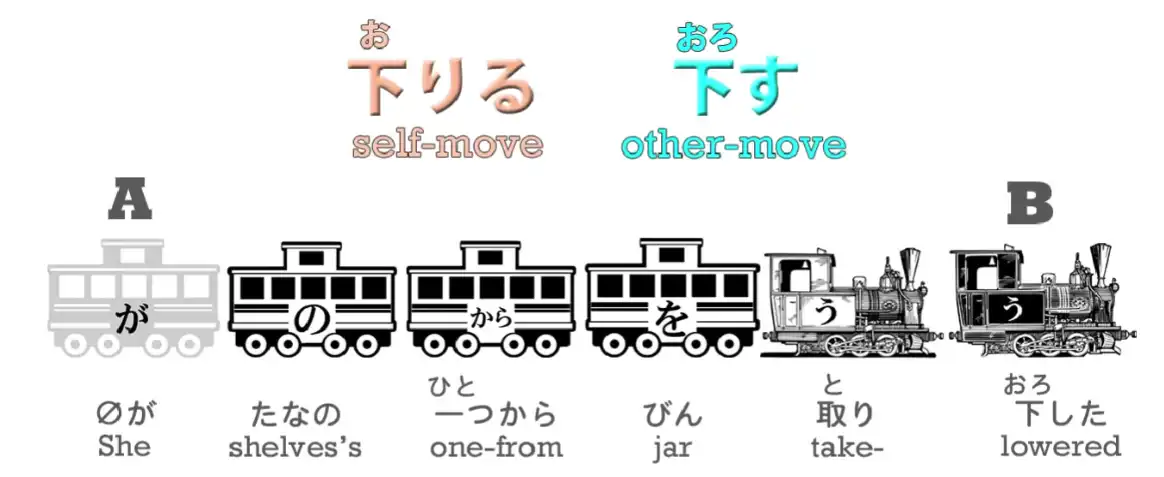
Note: The earlier furigana note also applies for 下りる, in the video there is a typo, it should only have お. I fixed it here. No 下る for (下りる) here though, it is not its irregular form.
Then it would rather mean くだる (下る) or さがる (下る), in their irregular okurigana forms.
Most courses would regard that as an intermediate thing, self-move and other-move, but I think
it makes it much easier to recognize what words are doing if you’re aware of this.
“下りる” means “come down / step down” - come down the stairs, come off a bus.
“下す/下ろす” means “bring (something) down”.
And once again, we know which is the other-move one
- you “bring (something else) down” - that’s the one that ends in -す: “下す”.
So “取り下ろす” means “take and bring down”.

“(zeroが)たなの一つからびんを取り下ろした.” “From one of the shelves (she) took down…” “びん” usually gets translated as “bottle”; in fact in this case it was more of a “jar”.
What was in it? Well, we’ll have to wait till next time to find out… Note: Again, I highly recommend going through all the comments under this video lesson, since some parts of it are further cleared up there by Dolly as this lesson is rather “intense” (; ̄Д ̄)
17. Polite Japanese and the volitional
Lesson 17: How desu/masu RUINS your Japanese! + How to use it correctly. Plus the volitional
こんにちは。 Today we’re going to talk about formal (polite) Japanese: です/ます.
Note: Whenever Dolly uses the term “formal” for です or ます, it should be POLITE instead, there is a difference between the two terms in Japanese, not sure why she did not bring this one up, but it is quite important to distinguish, if you look into their definitions, dictionaries mark them as polite. They are part of the 丁寧語 (polite language). So it is more accurate to call them polite instead. Some people may be surprised that we’ve gone for sixteen lessons without using this at all, when most courses use it from the very first lesson.
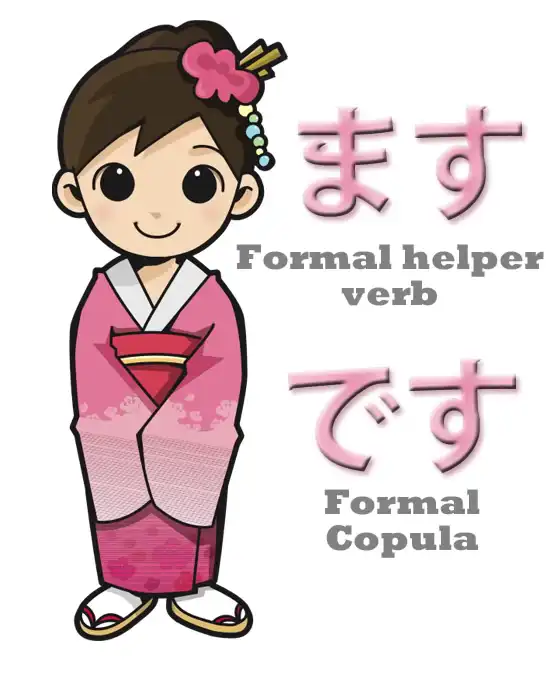
Now, there are good reasons why we haven’t. One reason is that です/ます form is actually quite eccentric. It does various things that most of the rest of Japanese doesn’t do.
So if we learn this as the standard way to speak, we get all sorts of strange ideas about the way Japanese works. We could have started learning it a little earlier, but frankly that there are more important priorities and that it’s a good idea to get real, standard Japanese firmly fixed in our minds before we enter the rather troubled area of です/ます.
It isn’t difficult once you have very firmly established standard Japanese structures in your mind, and we’ve done that now.
If you haven’t done it yet, if you haven’t followed this course, please go back to the first lesson right now. Off you go. Right.
ます
Now for the rest of you, let’s start with “ます”.
“ます” is a verb. It’s not part of a verb, it’s a verb in itself.
It’s a helper verb like lots of other helper verbs that we’ve looked at up to this point.
It attaches to our old friend the い-stem, and it doesn’t change the meaning of the word it attaches to in any way.
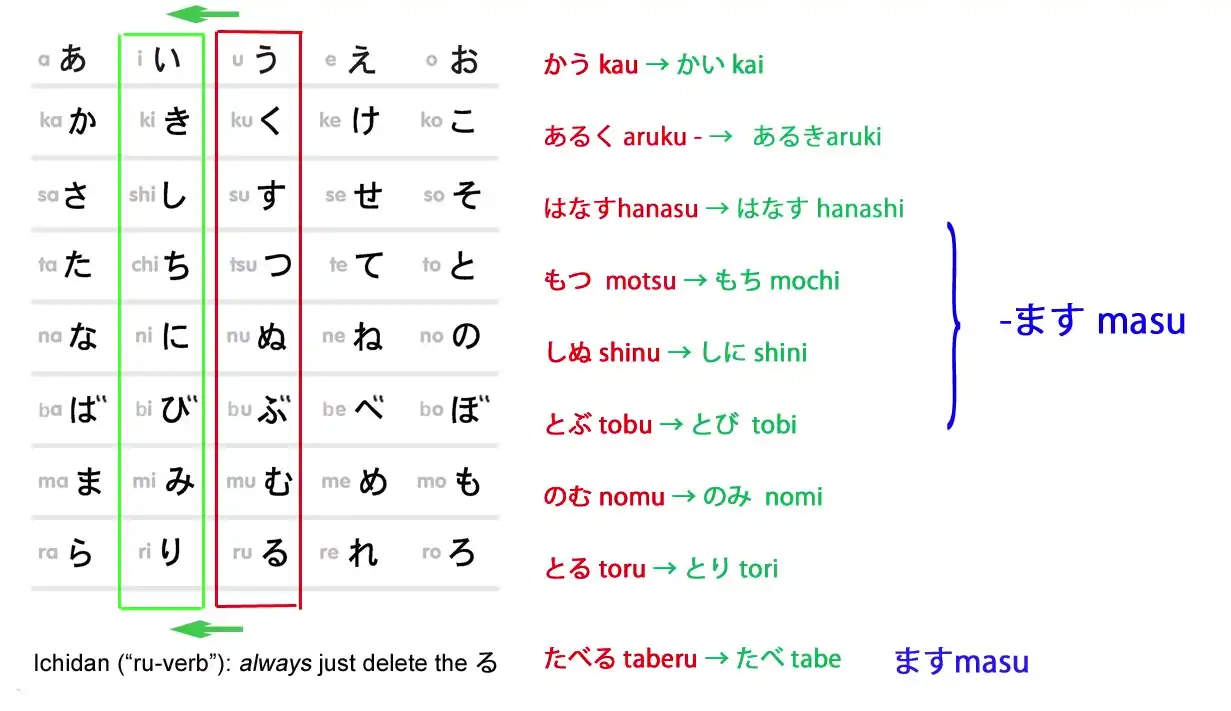
It simply makes it formal.
So “歩く” becomes “歩きます”; “話す” becomes “話します”, and so forth.
And they’re simply the formal way of saying “speak”, “walk”, etc.
Now, another reason I didn’t teach this earlier is because people say there are only two irregular verbs in Japanese – I’ve said this myself – but the truth is that there is another one, and it’s “ます”.
And “ます” isn’t irregular in the way that “くる” and “する” are irregular. It’s much worse.
It does something that is done nowhere else in modern Japanese.
Now the good news is that the past tense is completely regular and normal.
It works the same way as any other す-ending verb: it’s “ました”.
But the negative is not “まさない”; it’s “ません”.
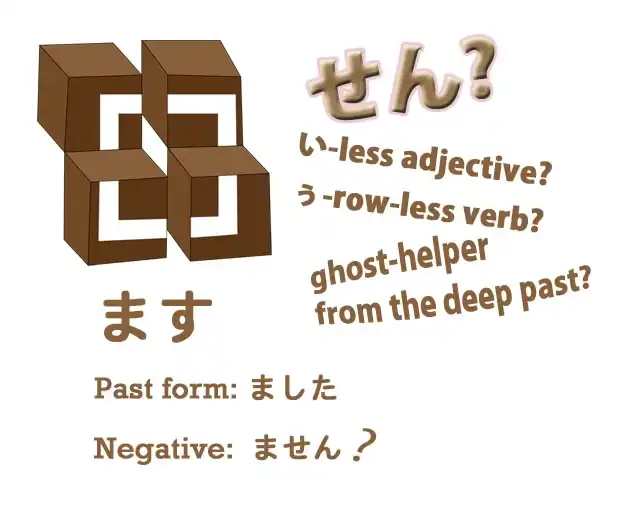
#
ません
And what kind of a word is “ません”?
It’s really nothing that exists in modern Japanese at all.
The textbooks tell us that it’s the negative form of the verb, but then they tell us that the verb is whatever “ます” is attached to, and they also tell us that “ない” is the negative form of a verb when it’s nothing of the sort.
It’s a helper adjective. (check Lesson 7) We don’t need to go into what “ません” actually is, structurally, because it doesn’t happen anywhere else in modern Japanese, so we just learn it as a fact.
The negative of “ます” is “ません”. Note: The non-past form. And that’s another reason I didn’t teach it earlier, because there isn’t much of this in Japanese: things that you just have to learn “as a fact”.
If you know the principles behind things, generally speaking you can understand how everything works without a lot of memorization.
So when you start off learning that you just have to learn that the negative of “ます-verbs”, as they’re called – in other words, the ます-helper verb – is “ません”, you start off with the idea that Japanese just does various random things like a European language.
Note: Which is a damaging mindset to get about Japanese, as we know, though some things are quite similar in a way, still it is best looking at Japanese as it is, not trying to force other language onto it outside of perhaps explaining some terminology (since we use English here) that is used if it is alright to do so. #
ませんでした
Now, the negative past gets even stranger.
There isn’t any past of -せん, the way -ない becomes -なかった, so what do we do?
We just throw the past tense of “です” on to the end of “ません” and say “ませんでした”.
“(zeroが)あるきませんでした” – “(I) didn’t walk”.
A lot of Japanese people who study Japanese grammar really dislike this, and I can’t blame them.
But it has, for better or worse, become standard Japanese grammar, so we just have to remember it. It’s really only a couple of irregularities and they’re not really difficult to remember just so long as we don’t learn them at the beginning, where they confuse our whole understanding of Japanese.
If we learn “ます” as a so-called “conjugation” and we believe that that is the base-form of the verb, then to make other forms of verbs we find ourselves taking off the -ます and then changing the い-stem for a different kind of stem in order to do something else.
Which would be complicated enough if we knew about stems but the textbooks don’t tell us that either, so we’ve just got a lot of completely random European-style rules and regulations that make no sense at all.
です
So let’s move on to “です”.
“です”, as you know, is the formal version of “だ”.
It’s the copula. It works exactly like “だ”, so if you know “だ”, you know “です” already.
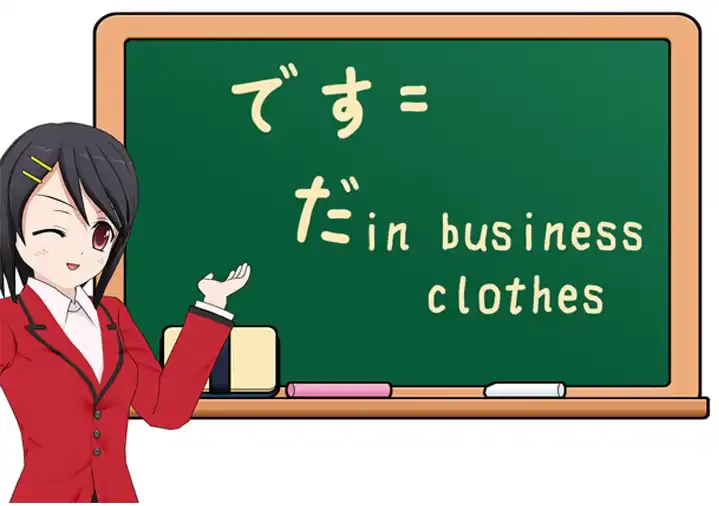
Except that this also has a strange quirk, which is that if we take an adjective like “赤い” meaning “is red”, we put “です” on to the end of it in formal speech.
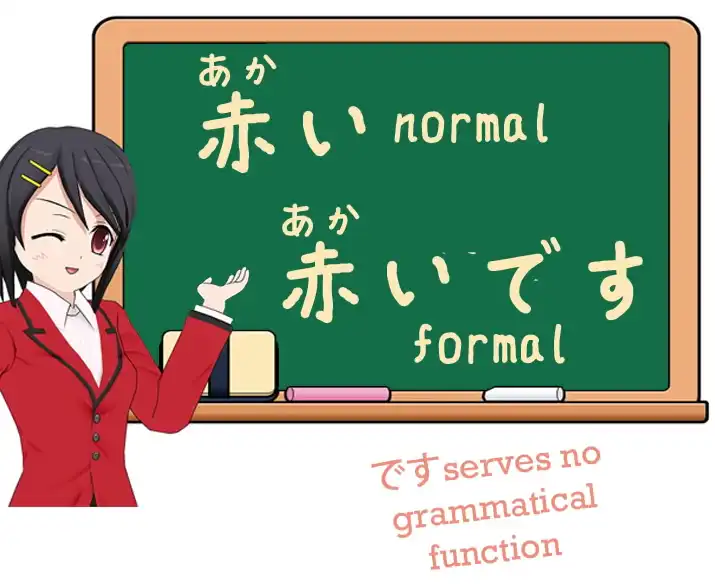
It doesn’t do anything; it just decorates the sentence and makes it formal.
Again, this is something you just have to learn and it’s not very difficult to learn, but if you learn it at the beginning you get the impression that you need the copula with an adjective like “赤い” just as you need the copula with an adjectival noun like “綺麗/きれい”.

And of course the fact that they call adjectival nouns “な-adjectives” (Lesson 6) just makes it even more confusing. You think that adjectives take the copula and they don’t.
Real adjectives, い-adjectives, do not take the copula except that in the rather strange です/ます form, we pop “です” on the end just for decoration.
Adjectival nouns, on the other hand, of course do take the copula because they’re nouns – and all nouns take the copula.
So we say “あかい” – “is red” / “綺麗だ” – “is pretty”; “赤いです” – “is red” with a decoration; “綺麗です” – “is pretty” with the proper copula that it needs in the formal form.
So as you see, formal Japanese is not really all that difficult.
We have to learn a few rather strange facts, and it’s not like most of the rest of Japanese which is terribly Lego-like and logical.
It’s got little quirky bits and pieces to it, but not many and so long as you’ve got real Japanese fixed firmly in your mind, adding on です/ます form is not particularly difficult.
A couple of other things worth knowing: one of the things is that as well as saying “ません”, we can also say “ないです”.
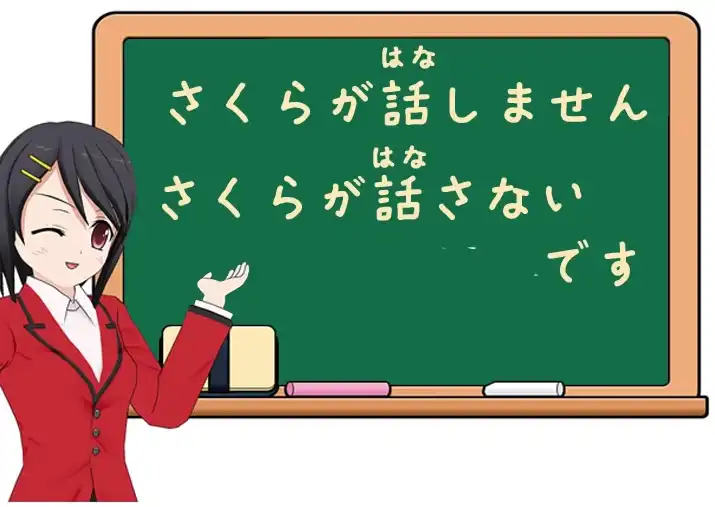
So we can say “さくらが話しません” – “Sakura doesn’t talk”, or we can say “さくらが話さないです”.
And that of course is perfectly logical and sensible, if any of it is, because since we put “です” on to the end of adjectives in formal speech, we can also put it on to the end of the ない-helper adjective, which is really just another adjective.
We don’t make many changes to “ます” because it really is a sentence-ender; we put it right at the end of whatever else we’re doing in order to add formality to the sentence.
However, we can use both “です” and “ます” with the volitional helper verb.
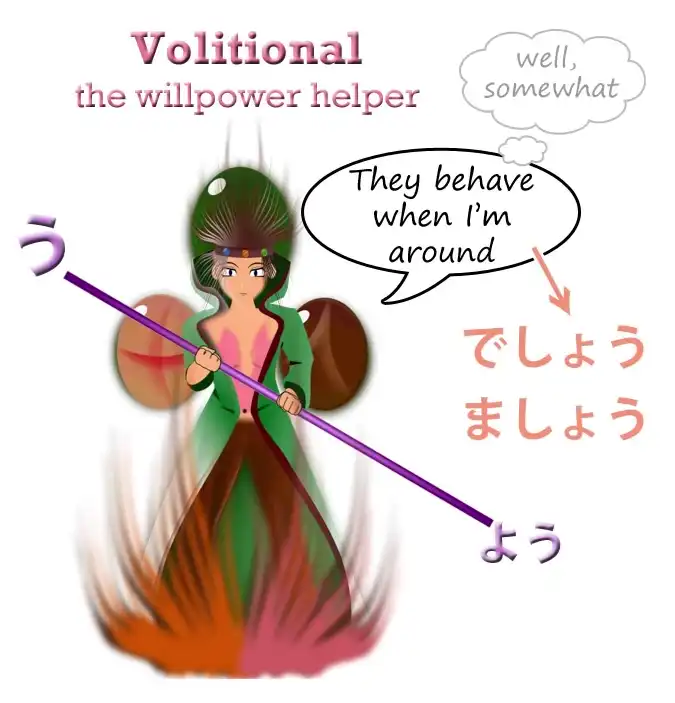
And once again “ます” behaves eccentrically, because its お-stem is not, as you would expect, “まそ” but “ましょう”. So the volitional form is ““ましょう”.
Fortunately, this is only slightly eccentric and not difficult to manage.
And also fortunately, “です” forms a matching pair with “ます” in the volitional form and becomes “でしょう”.
And since we’re raising the subject of the volitional, let’s cover that too.
The volitional
Its formation is very simple, and it’s one of the few things that we do with the お-stem of verbs.
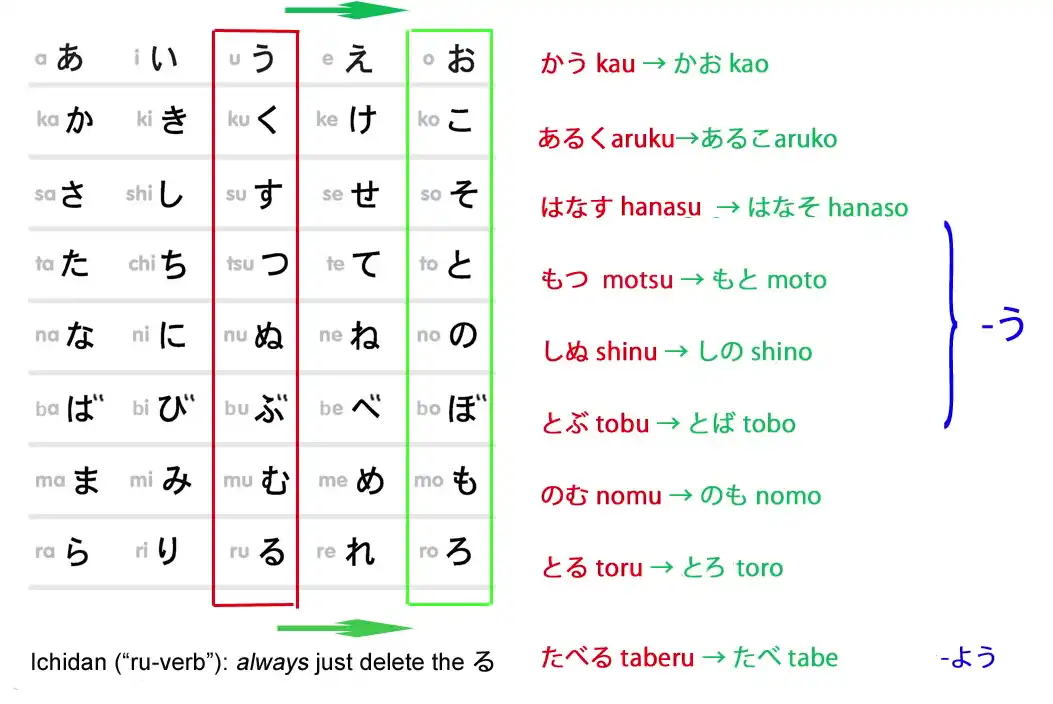
The godan volitional helper, like the potential helper – potential helper is just a single kana, る(-ru), and the volitional helper is just the single kana う(-u), and we put it on to the end of the お-stem and it lengthens the お-sound.
So, “話す” becomes “ 話そう”, “歩く” becomes “歩こう” and so forth.
What does it mean? Well, the name really tells you what it means. “Volition” means “will”, so the volitional expresses or invokes the will.
The most usual use of it is setting the will of a group of people in a particular direction. So we say, “行きましょう” (as mentioned, ましょう is the volitional form of ます), “Let’s go”.
And some people call the たい-helper adjective volitional as well, which is confusing because they aren’t the same thing.
And the thing here to remember is that -たい expresses desire, want, wanting to do something.
The volitional form expresses will. And will and desire aren’t the same thing.
For example, you may have a will to do your homework. It doesn’t mean that you want to do your homework.
What you actually want is to play “Captain Toad”, but you set your will to doing your homework.
And when we say things like “行こう”, “let’s go”, for things that we might all want to do, “let’s all have a picnic”, “let’s have a party”, but also “let’s tidy the room”, “let’s do our homework.” It’s expressing will, not want.
You’ll very often see on Japanese signs things like, “ゴミを持ち帰りましょう” – “let’s pick up our trash and take it home” – which always seems to me like quite a nice kind of exhortation, rather different from the Western signs that say, “Pick up your rubbish or we’ll confiscate your car and dye your children purple”.
Now, there are a number of uses of the volitional along with particles like -か and -と, but we’re not going to go into them here, because I don’t think that learning lists of usages is a good way to learn.
We’ll tackle these as we come to them, perhaps in the course of Alice’s adventures.
But one use of this form that is worth knowing because you’ll see it pretty often is that we use the volitional form of the copula, “だ” or “です” – “だ”, which isn’t really a verb in the usual sense, the volitional is “だろう” – and if we add that to any other sentence it gives the meaning of “probably”.
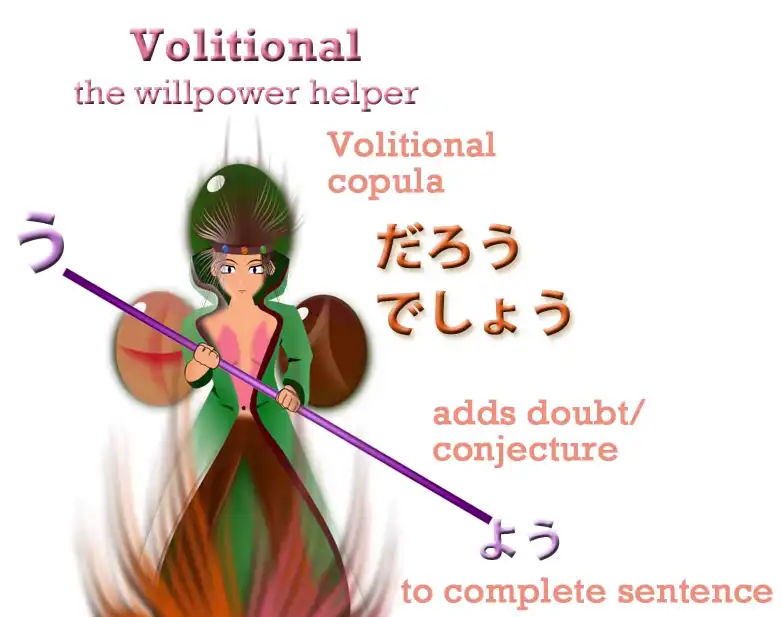
Note: For です it is でしょう. Sometimes, you may see だろう called a volitional form of である instead of だ. From my research, it seems that である is just a more literary/older form of だ.
Also do note that doubt/conjecture implication which だろう / でしょう gives to a sentence.
“それは赤いでしょう / だろう” – “That’s probably red / I think it’s red”;
“さくらがくるでしょう / だろう” – “I think Sakura’s coming / Sakura’s probably coming”.
Note: Even though だろう is a volitional form of the だ copula, it actually seems like it can be used with adjectives normally, whereas regular だ copula cannot. It might be because it expresses “probably/think/guess” and not “is” that is part of the -い; or that it came from である? There also is だろ/でしょ, which are less formal versions. だろ seems to be only used by men. So now we know how to use the volitional and how to use formal Japanese.

18. って = は?? Mysteries explained! -おうとする, とする, として, という, っていう
Lesson 18: ってtte = はwa?? Mysteries explained! Toshite, toiu, to suru, ou to suru, tteiu
こんにちは。 Today we’re going to talk about “trying to do something” and from there we’re going to broaden out into the wider meanings of the “と” quotation particle because this is a very central part of Japanese that’s used all the time.
So we need to get a firm understanding of what it is and how it works.
Now, last week (Lesson 17) we learned the volitional helper う and よう which makes a word end with the sound “おう” or “よう” and expresses will.
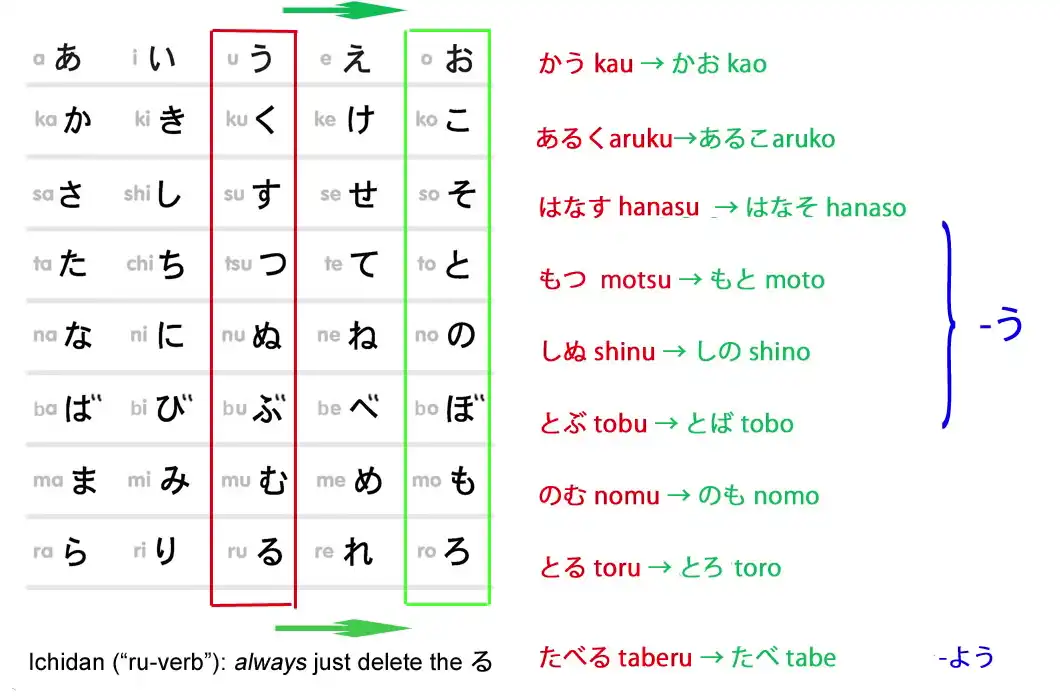
If we’re “trying” to do something we use the volitional for this.
So if we say, “山にのぼろうとする”, this means “try to climb mountain”.
Why does it mean that? What’s this construction actually doing?

Well, “のぼろう” expresses the will to climb.
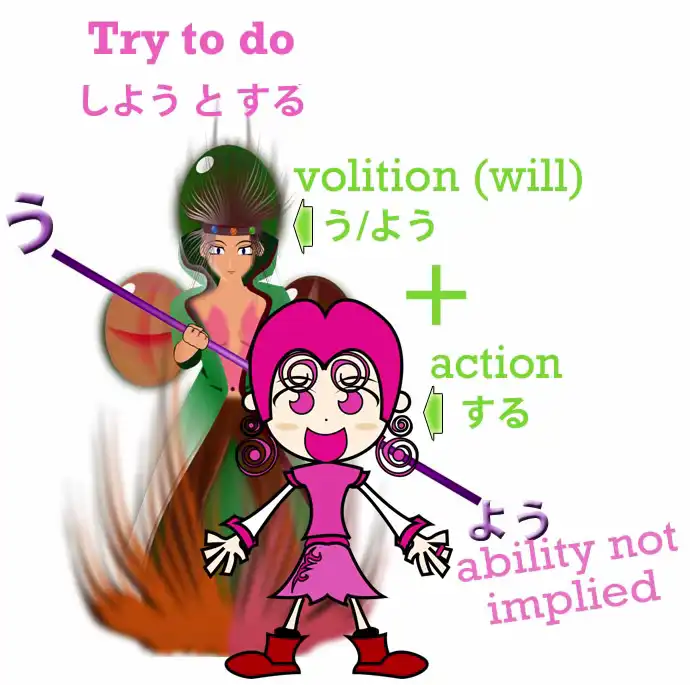
If we say “山にのぼろう”, we’re saying, “Let’s climb the mountain”.
Literally, set our will toward climbing the mountain.
おうとする / とする
“のぼろうとする” means doing the act implied by setting our will to climb the mountain.
If we just wanted to say “climb the mountain”, we’d just say, “山にのぼる”.
But we’re not saying “climb the mountain”, we’re saying “try to climb the mountain”.
Therefore, do the action implied in setting our will / enact our will to climb the mountain, whether we succeed in actually climbing it or not.
Some people find the distinction between “try climbing” and “try to climb” confusing.
And that’s really only because of the way it’s expressed in English.
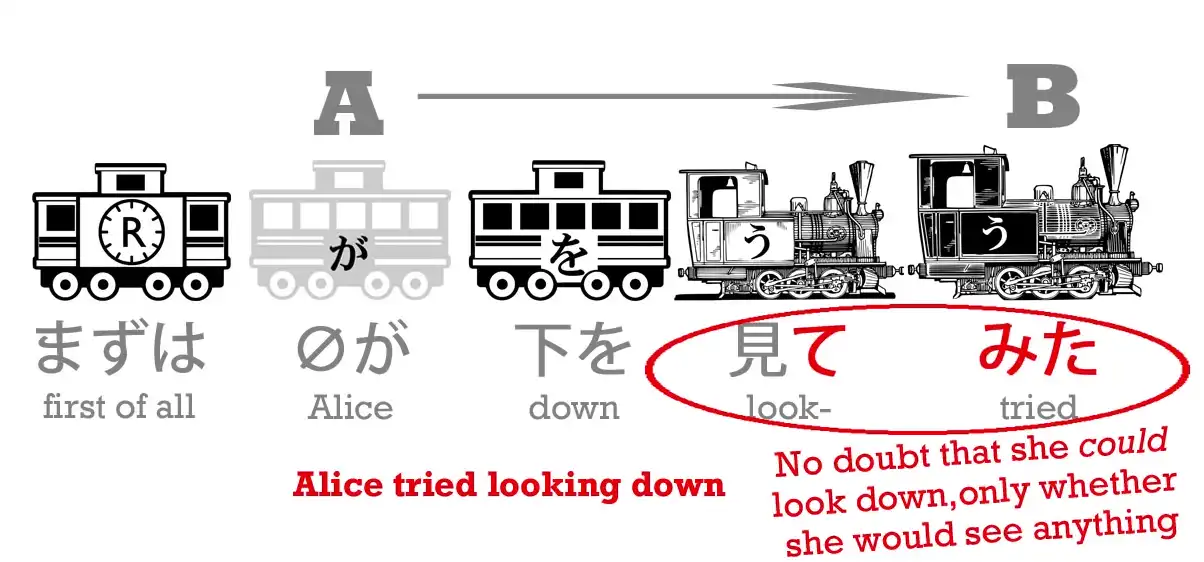
In Japanese, as we learned recently (Lesson 16), if we want to say, “try climbing the mountain”, we say, “山にのぼってみる.” The difference is that “try climbing / try eating / try swimming” doesn’t imply any doubt about the fact that we can actually do it.
It implies doubt about what would be the result when we’ve done it.
“Try eating” - we know we can eat, but don’t know if we’ll like it.
“Try eating” - “食べてみる” - means “eat and see”.
Eat it and then see what the result is, see if you like it, see if you don’t like it.
“山にのぼってみる” means “climb the mountain and see”.
See whether it was hard, see what the view’s like from the top.
“ケーキを食べようとする” - “try to eat the cake” - implies that we don’t know whether you can in fact eat the cake or not, but try it anyway.
Maybe it’s a huge cake and it would be very hard to eat it all.
So “してみる” - “do and see” - implies that there’s no doubt about the fact that we can do it, but there is some doubt about what the result of having done it is going to be.
Are we going to like it?
Is the building going to fall down?
We don’t know what will happen when we’ve done it, but we know we can do it.
“しようとする” implies that we don’t know whether we can do it or not, but we are going to try to do it.
So, an important thing here is to see what the と-particle is doing.
-と is encapsulating the sentence that came before it: “山にのぼろう” - will to climb the mountain.
It isn’t quoting it.
It’s not something we’ve said; it’s not something we’ve thought, exactly.
The point is that it’s taking the essence, the meaning, the import of that “山にのぼろう” and putting it into action.
And we’re going to find that in other cases.
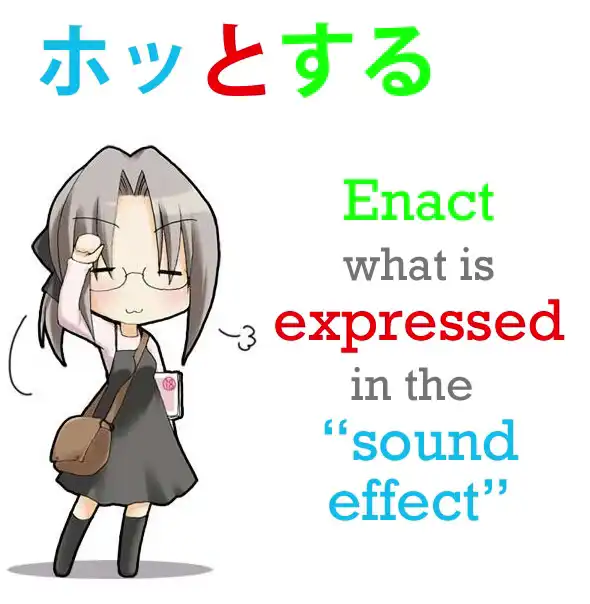
For example, we may read that someone “ホッとした” . Now, what does that mean?
“ホッ” is in fact a sound effect.
It’s the sound effect of breathing a sigh of relief: “ホッ”.
But “ホッとする” actually does not mean “breathe a sigh of relief”.
What it means is, “feel relief / be relieved”.
So what we’re doing here is enacting the idea, the feeling, expressed in “ホッ”, the sigh of relief.
Just as in “山にのぼろうとする” we’re enacting the feeling, the import of setting our will toward climbing the mountain, that is, trying to climb it.
#
とする & にする
Now, similarly, if we say “さくらを日本人とする”, it means regarding Sakura as a Japanese person.
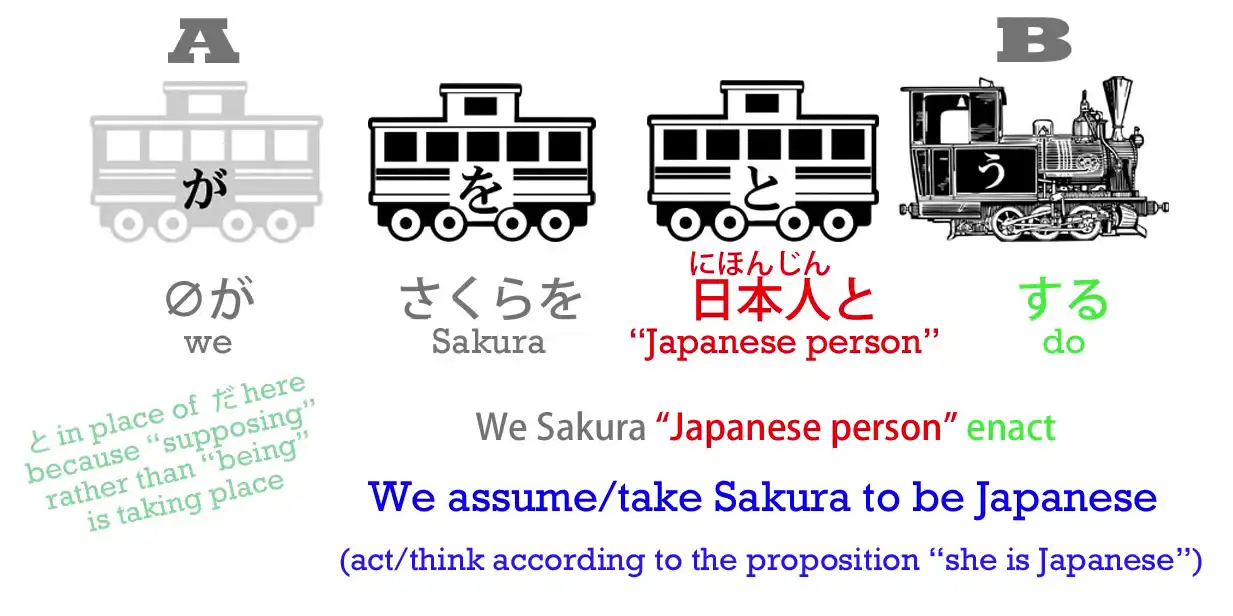
Now, we might also say, “さくらを日本人にする”, but that means something quite different.
It means “turn Sakura into a Japanese person”.
に is the target of an action.
A little while ago we had a lesson (Lesson 8) in which we talked about “さくらがかえるになる” - “Sakura becomes a frog”.
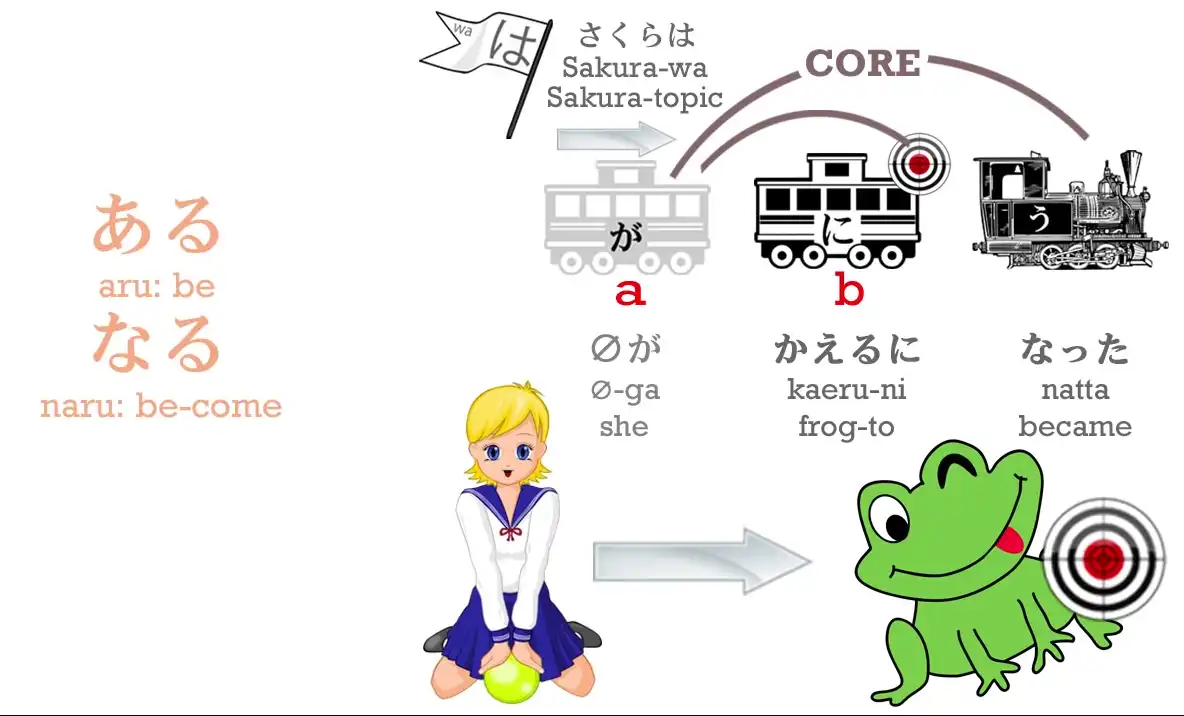
Now, we’ve also talked about (Lesson 15) the way that “ある” and “する” are the Eve and Adam of Japanese verbs,
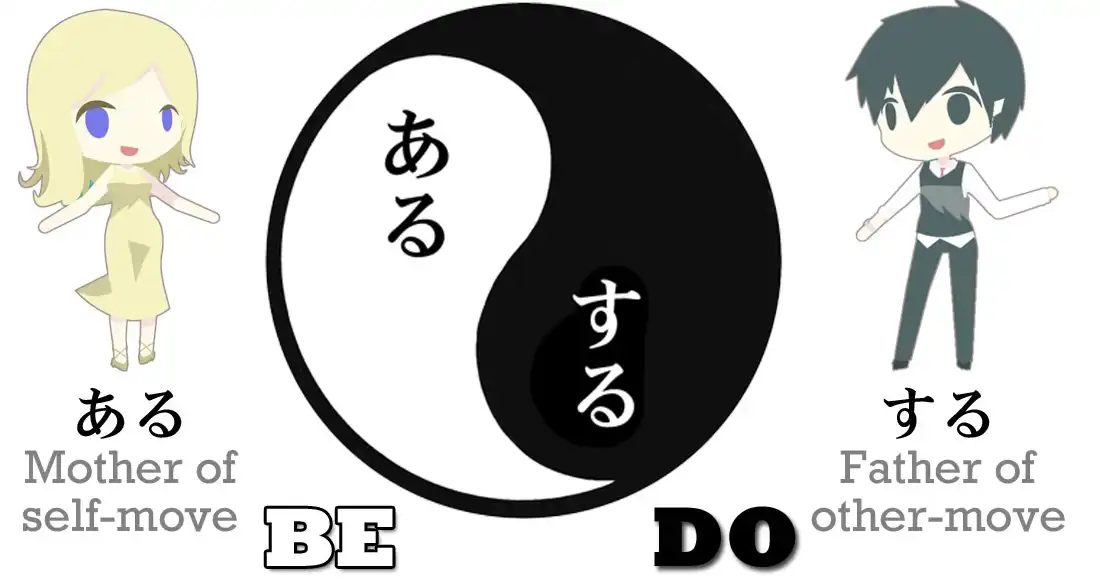
“ある” being the primary self-move verb and “する” the primary other-move verb.
“なる” is very closely related to “ある” - “ある” is “be”, “なる” is “become”.
And so if we say “になる” it means to become something.
If we say “にする” that’s the other-move version of “になる”.
It means to “turn something into something”.
So if we say, “まじょがさくらをカエルにした” - “the witch turned Sakura into a frog”.
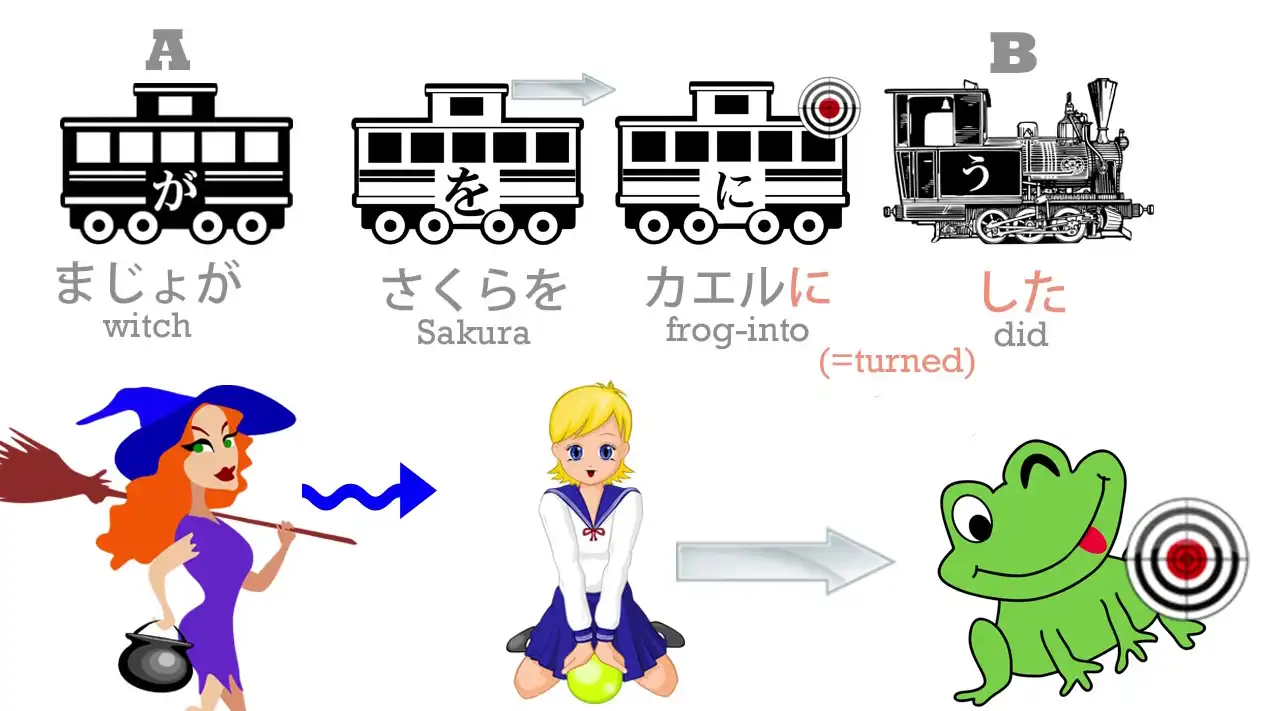
Note: カエル is just another way to write frog, via katakana. Animals are usually written that way.
“さくらを日本人にする” - turning Sakura into a Japanese person;
but “さくらを日本人とする” - regarding Sakura as a Japanese person / taking Sakura as a Japanese person.
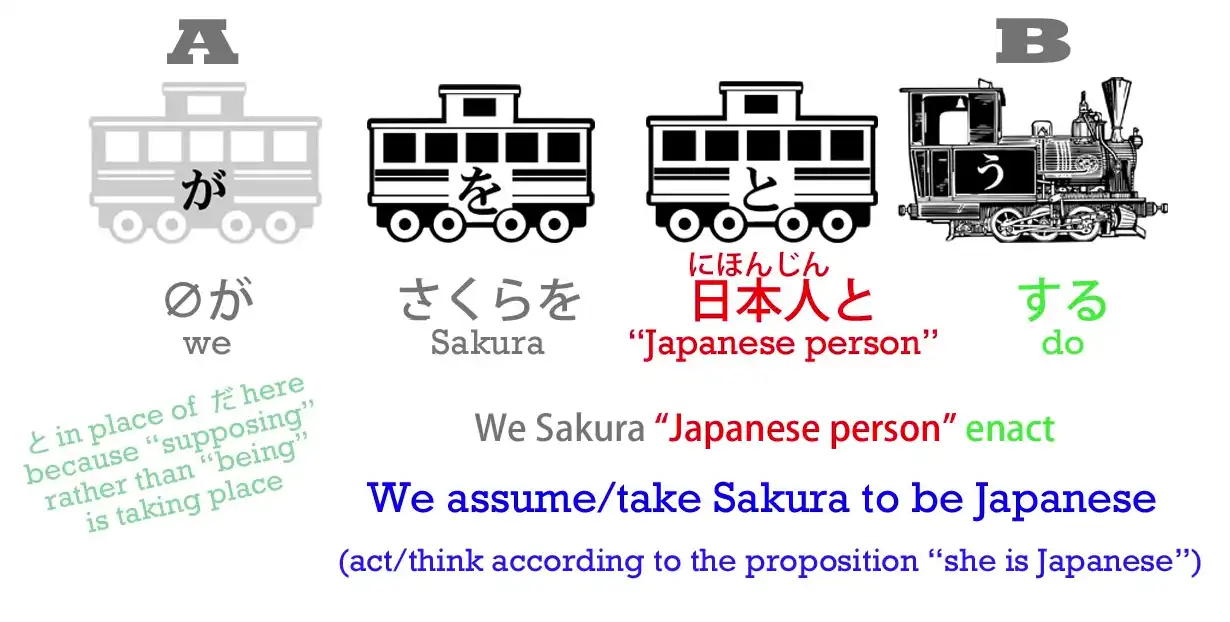
“かばんをまくらとする.”

“かばん” is “bag”, “まくら” is “pillow” and this means “using your bag as a pillow”.
You’re not turning your bag into a pillow, it’s not becoming a pillow, but you’re regarding it as one and using it as one.
So here we have some of the uses of “-とする”.
Generally speaking, it relates to how we regard something.
として
Now, if we say “-として”, this isn’t so much the act of regarding something as something, but seeing something in the light of being something.
So, in English it would usually be translated simply as “as” or “for”. Or “being in the role of”
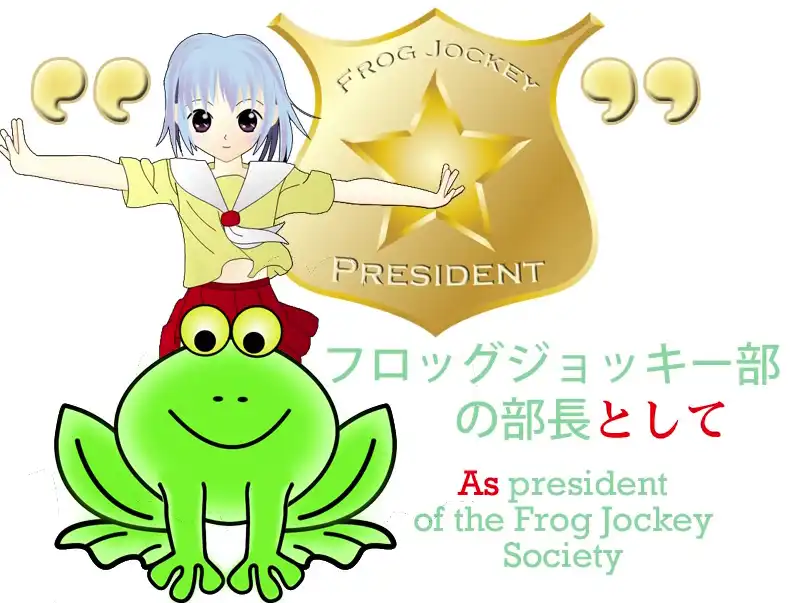
So, “こじん/個人としての いけん/意見” means “my opinion as a private person”, as opposed to, say, “my opinion as president of the Frog Jockey Society.” - just another example sentence (contrast in words “private person” & “president”), not some difference in the function of として. The wording may delude to Dolly meaning it as if it was として that had an opposing role there. Or we could say, “アメリカ人として小さい” - “She’s small for an American / As an American, she’s small.
So we can see that the quotation function of -と is used not only to quote ideas and thoughts, but also to take the feeling of something and bundle it up and then say something about it.

Note: just in case, this comment may help some in regards to とする & として.
という / と言う
Of course, the most basic thing that can follow -と is “いう”, in which case it’s a literal quotation, -という/と言う (it’s usually pronounced not so much “-という” but as “-とゆ”).
And this again can be used not just in a literal quotation but also saying how something is said or what it’s called.
So, “ふしぎの国のアリスという本”, means “book called ふしぎの国のアリス”
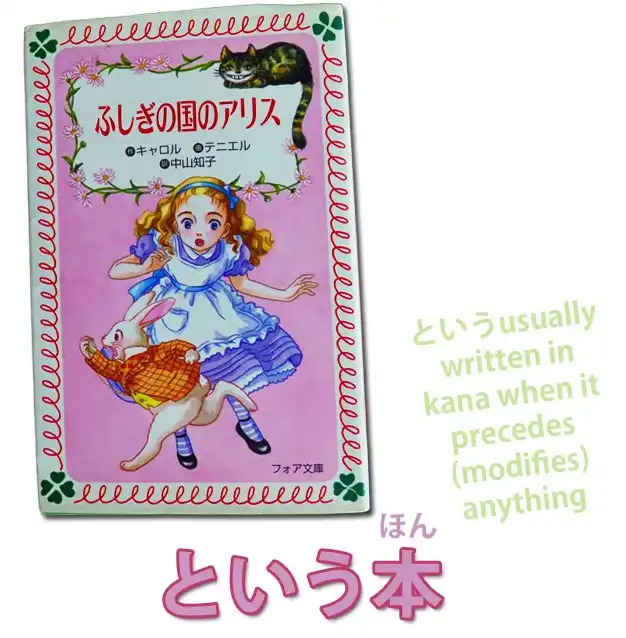
#
っていう / って言う
And the -と in “-という” can be reduced simply to -って.
So we can say “-っていう” - “ふしぎの国のアリスっていう本”, or it can be reduced down to just -って.
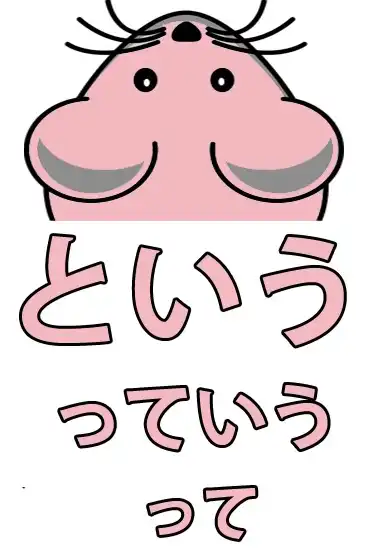
“ふしぎの国のアリスって本” still means “The book called Alice in Wonderland”.
So people sometimes get a little confused when they just see this -って.
It means -と or -という, but the thing that really confuses people sometimes is that it can also be used in place of the は-particle.
#
って used in place of は
Now, this seems particularly strange, until you realize what it’s actually doing.
If we remember what the は-particle is, the は-particle is the topic-marking particle.
So when we say “さくらは(zeroが)日本人だ”, we can put that into English as “Speaking of Sakura, (she) is Japanese person”.
Now, does that start to make things a little clearer?
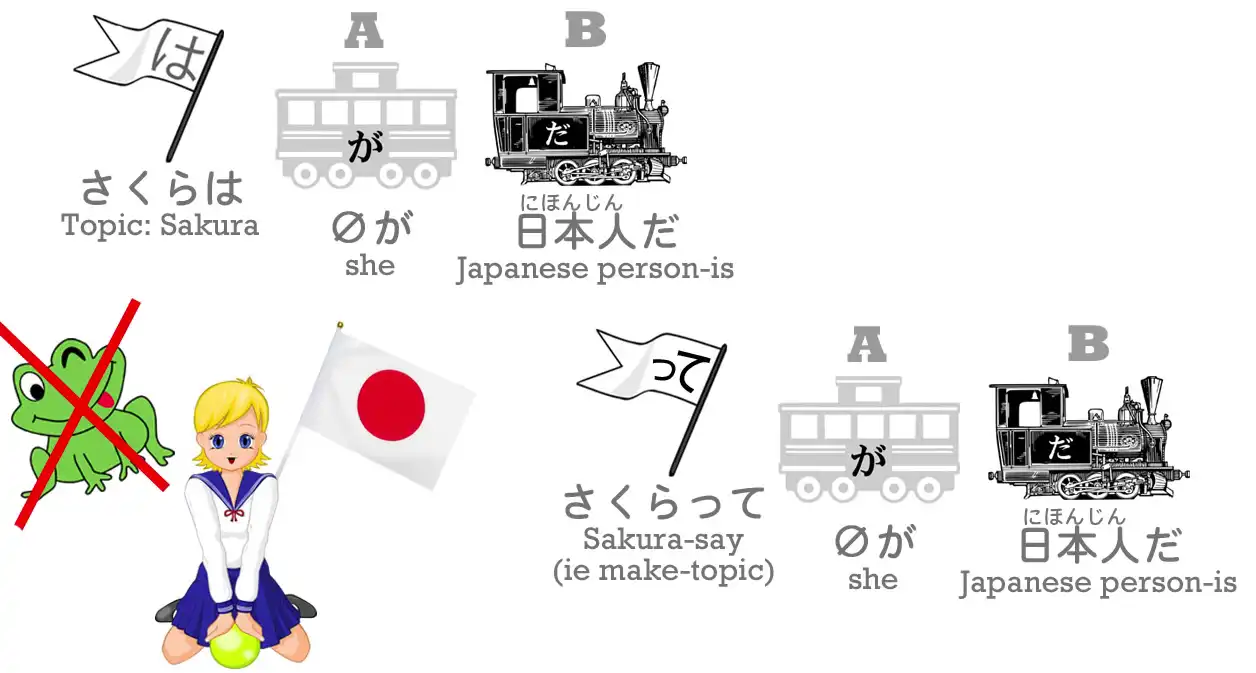
“さくらって(zeroが)日本人だ” - “Sakura-say, (she) Japanese-person is” - “Sakura-speaking of, (she) Japanese-person is” - “Sakura (topic), (she) Japanese-person is”.
Now, we can’t say -と or -という in place of the は-particle.
It’s a very casual use.
We just use -って.
But you can see that it’s really, even though it’s very colloquial, it’s not just some random and inexplicable thing.
It’s setting up Sakura as the thing we’re talking about, just as は is.
Now, there are other extended uses of -と.
We’ll cover those as we come to them.
19. Causative + causative receptive
Lesson 19: Causative + “causative passive”: what they NEVER tell you! It’s logical and super easy
こんにちは。
Today we are going to talk about the causative helper verb.
In the standard grammars this is called “causative” and it’s a perfectly good name because it indicates that we are causing someone to do the verb to which it is attached.
In the standard grammars it’s often taught along with the receptive (which they like to call the “passive”) and there’s a very very good reason for doing this although the real reason is never actually explained in the regular textbooks. So, I’ll be telling you that shortly.
But first of all let’s look at what the causative helper verb is.
It’s a helper verb which, like the receptive, goes onto the end of the あ-stem of another verb, and while the receptive helper is “れる/”られる””, the causative helper is “せる/させる”.
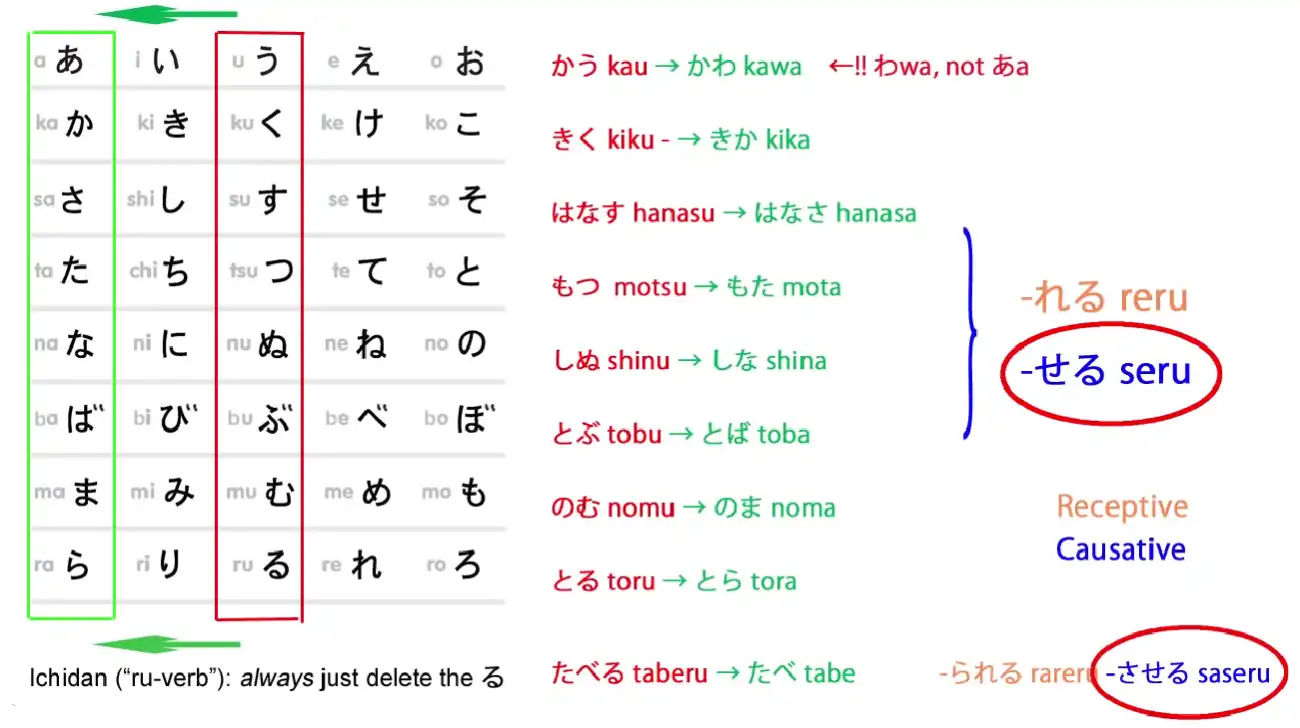
If they sound rather close to each other, there’s a good reason for that.
As we have noted earlier, the Eve and Adam of Japanese verbs are “ある” and “する” – “be” and “do”.
“ある” is the mother of all self-move verbs; “する” is the father of all other-move verbs.
Now, the receptive “れる/”られる”” is closely related to “ある”; the causative “せる/させる” is closely related to “する”.
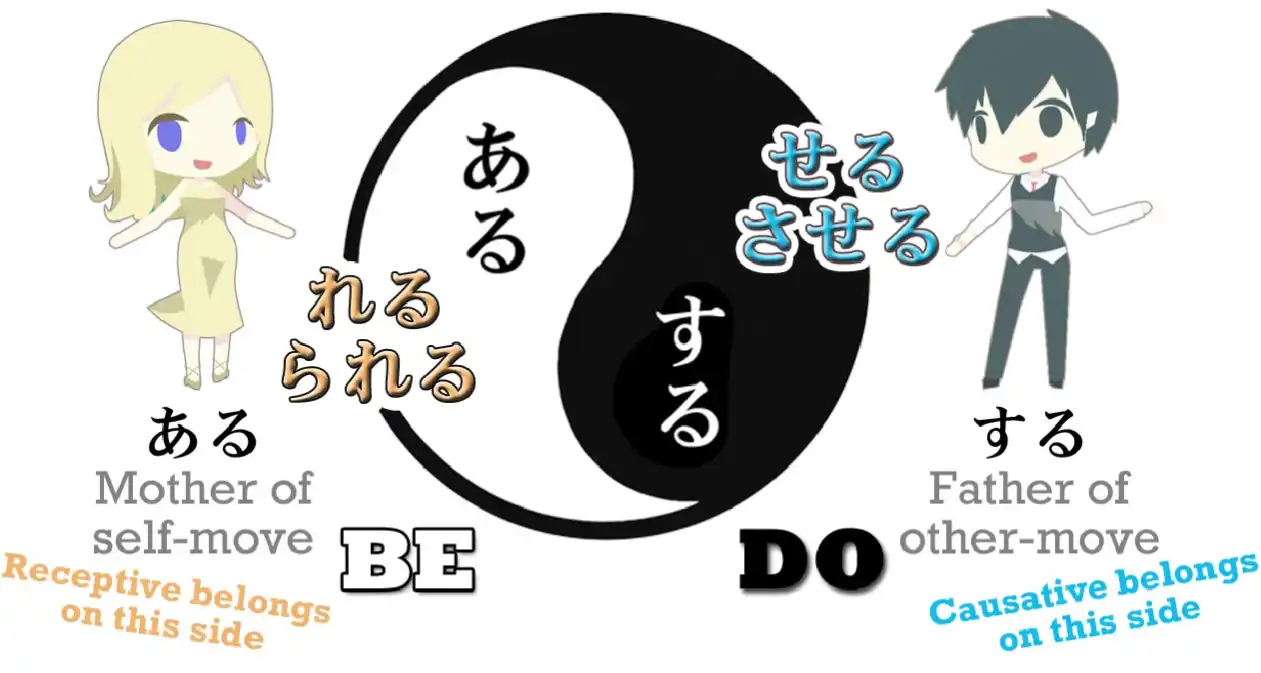
And while it’s not exact to say that they are the self-move and other-move versions of each other, we can see that they are very closely related conceptually to that.
“れる/”られる”” indicates receiving the action to which it is attached.
“せる/させる” means causing that action to be performed by somebody else.
And this leads on to the most fundamental similarity between the two pairs of helper verbs – the similarity that the textbooks never explain and that is most fundamental to understanding how they work.
Why don’t the textbooks explain it?
Well, the fundamental reason is that they call the causative and the receptive helper verbs “conjugations”.
And the real structure of how they work is completely destroyed and obscured by calling them “conjugations”.
A conjugated verb is by definition a single verb.
But a verb plus the receptive or the causative helper is never a single verb.
It’s two verbs.
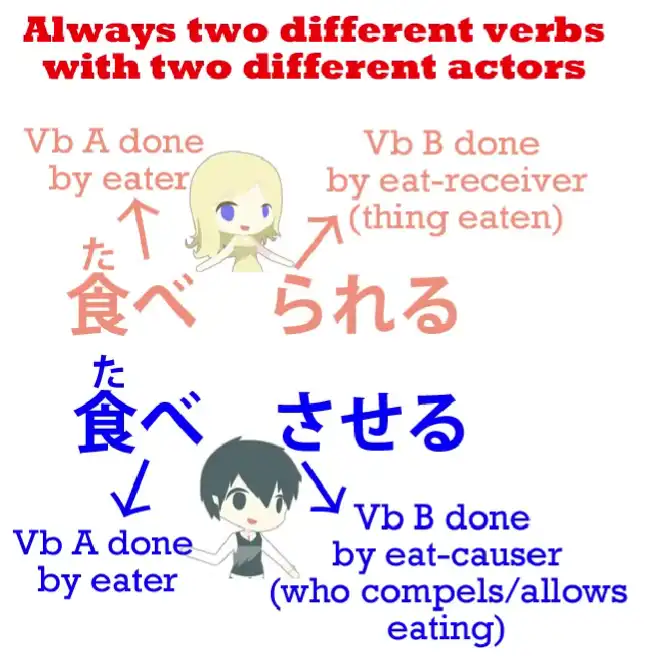
Not only is it two verbs, but the two verbs always have two separate subjects.
So in a sentence like “水が犬に飲まれた” – “the water got drunk by the dog” – we have two verbs, two actions, and two different actors doing the two different verbs.
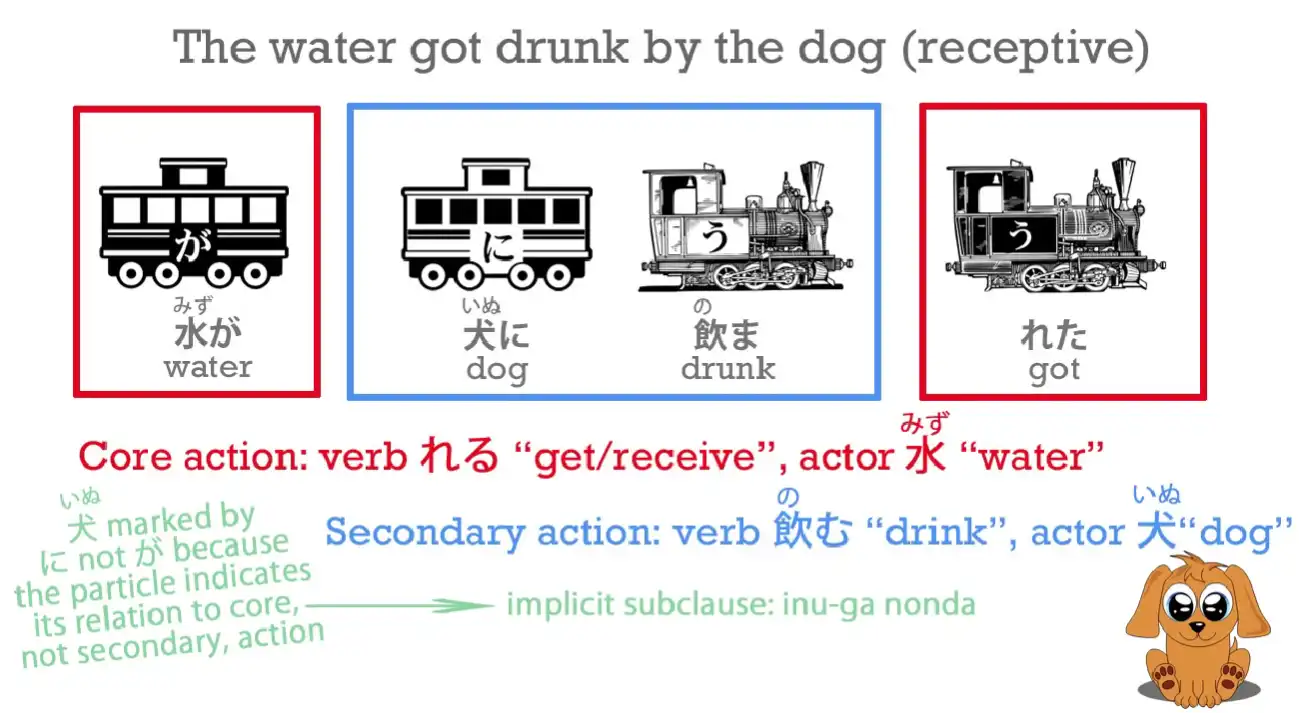
The main verb of the sentence, the core verb, is “れる” – “get” – and that’s being done by the water: the water is getting drunk by the dog.
The secondary verb is “drink” and that’s being done by the dog.
This becomes clearer in a slightly longer sentence: “さくらがだれかにかばんをぬすまれた” – “Sakura got her bag stolen by someone”.
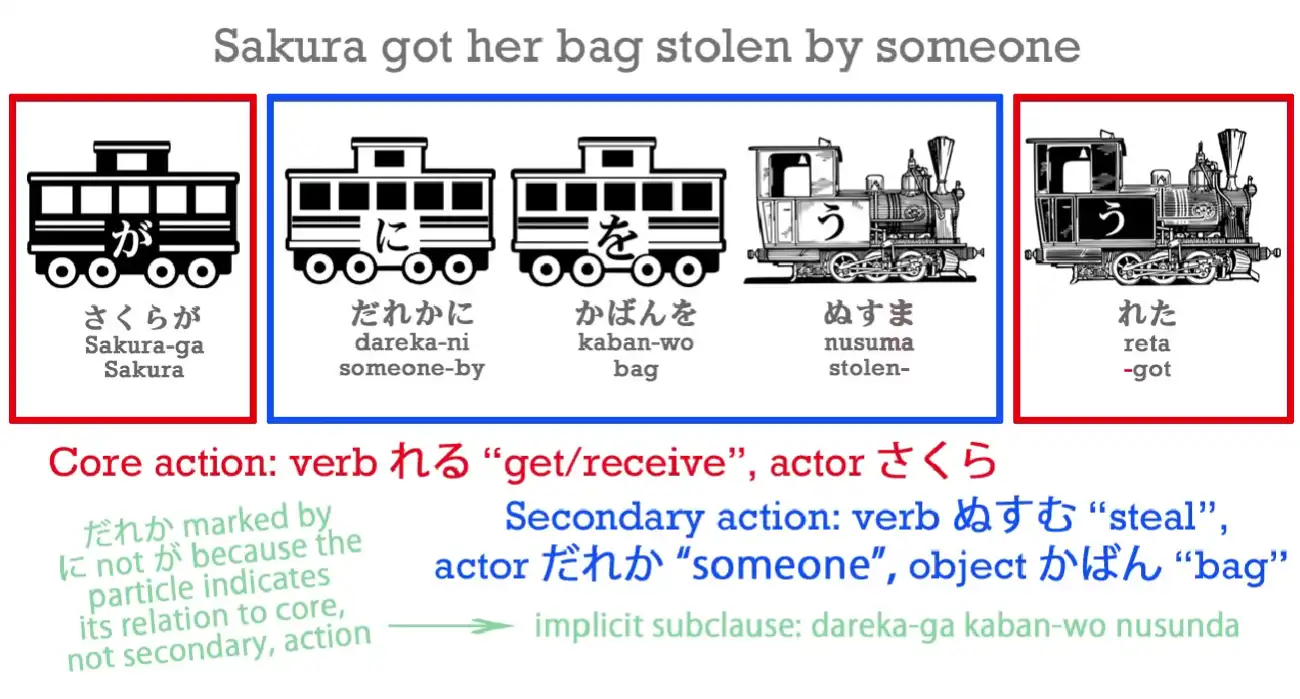
Again, there are two actions going on, and always in a receptive sentence the main action, the core action of the sentence, is “れる” – “receive”: “Sakura received”.
But there is a nested action within this done by the secondary verb, “ぬすむ” – “steal”.
And that’s done by “someone”.
Now, it’s exactly the same with the causative.
We always have two actors performing the two different verbs.
So if we say, “(zeroが)犬を食べさせた”, which means “I caused the dog to eat”, there are two actions going on.
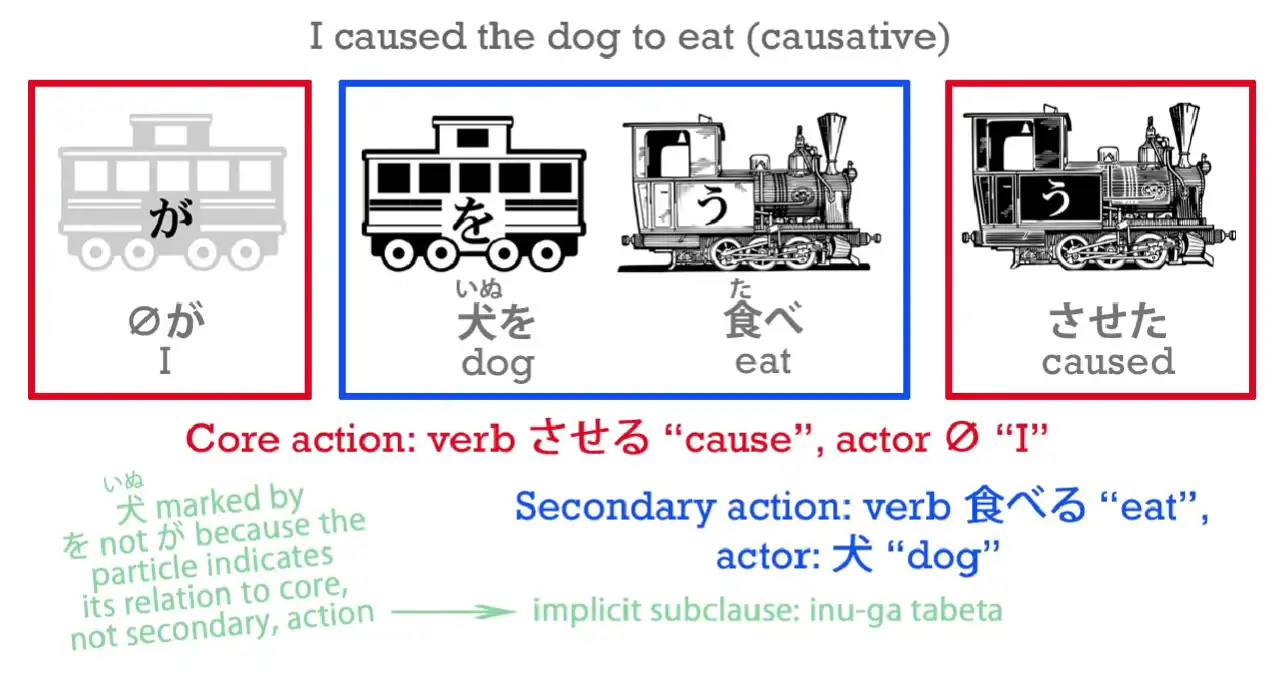
There is the action of eating, which is being done by the dog, and then there is the main action, the core action of the sentence, the action of causing, which is done by me.
So as you see, we cannot possibly talk about a conjugated verb in the case of either the receptive or the causative helper.
In each case, there are two separate verbs.
Even though they’re joined together, they not only remain separate in function but they refer to two different actors.
Now let’s also take a moment to understand what “せる/させる” actually means.
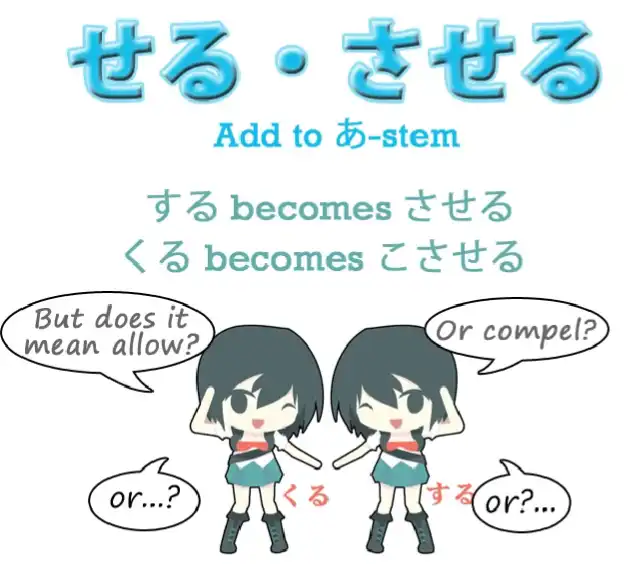
We’re told that in English it can mean either “make” someone do something or “allow” someone to do something.
And that’s correct: it can have either of those meanings.
But the important thing to understand is that it can have either of those meanings but it can also have neither of those meanings.
The best way to translate it is with the very un-English sounding “cause” someone to do something.
Why?
Because we can mean that we’re forcing them to do something, we can mean that we are allowing them to do something, but we can also mean something that isn’t covered by either of those English translations.
An example?
Well, you’ve already had one: “(zeroが)犬を食べさせた”
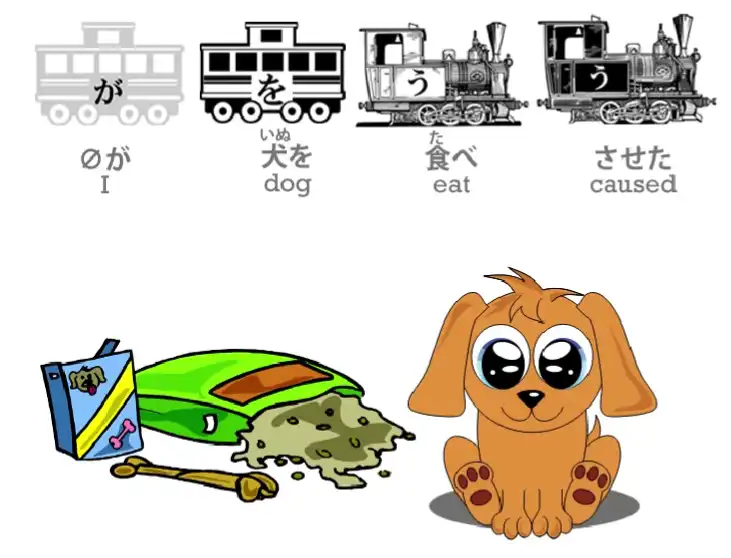
It doesn’t mean “I forced the dog to eat”, does it?
But it also doesn’t mean “I allowed the dog to eat”.
It doesn’t mean that I gave the dog permission to eat or I took it off its chain so it could reach the food.
That’s not what it means.
It means that I set up the conditions under which it was able to eat; I gave it food; I caused it to eat.
So “せる/させる” means “cause” a person or a thing to perform an action by whatever means, whether that causing is allowing, whether it’s compelling or whether it’s setting up the conditions to make it happen.
Now, the only thing that can appear to be a little confusing about the causative is that sometimes the person or thing that we are causing to do something can be marked by を and sometimes by に.
Now, I’ve told you before that Japanese particles do not change their function at random, as the textbooks strongly imply and sometimes openly state that they do –
and as we have to believe if we think that “コーヒーが好きだ” (Coffee pleasing is) literally means “I like coffee”.
And if you don’t know what I’m talking about here, please watch the relevant video (Lesson 9), because this is absolutely crucial to understanding Japanese correctly.
So how is it that two different logical particles can apply to the thing or person we are causing to do something?
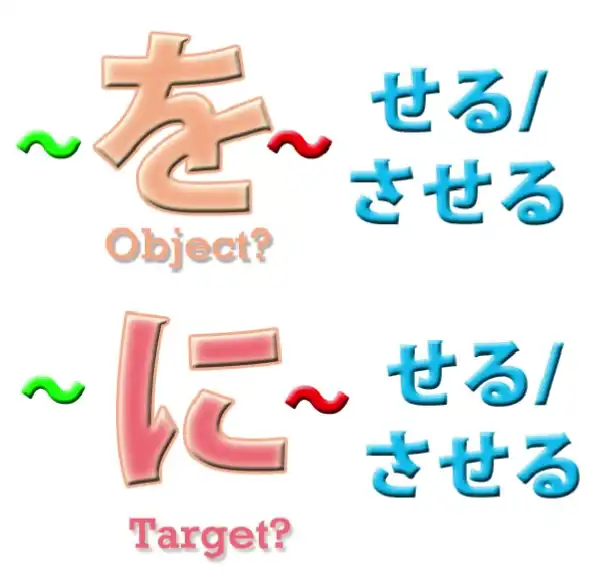
That is to say, the noun associated with “せる/させる”.
First of all, we have to understand that this thing can be seen as either the object or the target of the action (“せる/させる”) of the person or thing that is doing the causing.
If we take that object or target to be human, it becomes a little clearer.
If we treat the person as the object, we are assuming that they have no personal will in the matter; we are treating them literally as an object.
So this is more appropriate when we are compelling someone to do something; if we treat them as a target, the implication is more mutual, we are treating them more as an equal and this goes more naturally with allowing rather than compelling.
And I’ve talked about these degrees of mutuality between the particles を, に and と when dealing with people in a video which you may want to watch. However, the choice between に and を is not the main, or an exact, indicator of whether we mean allowing or compelling when we use “せる/させる”.
Why not?
There are two reasons for this.
The first, as we’ve already mentioned, is that saying that “せる/させる” either means “compel” or “allow” is warping the meaning of the causative by trying to find exact English analogies, and there is no precise English analogy.
On many occasions, as I demonstrated, it may mean neither “compel” nor “allow”.
It’s a sliding scale between the two; it’s subtler and more graduated than that.
Secondly, when the action that is being compelled itself has a を-marked object – for example, “(zeroが)犬に肉を食べさせた” – “(I) caused the dog to eat meat”.
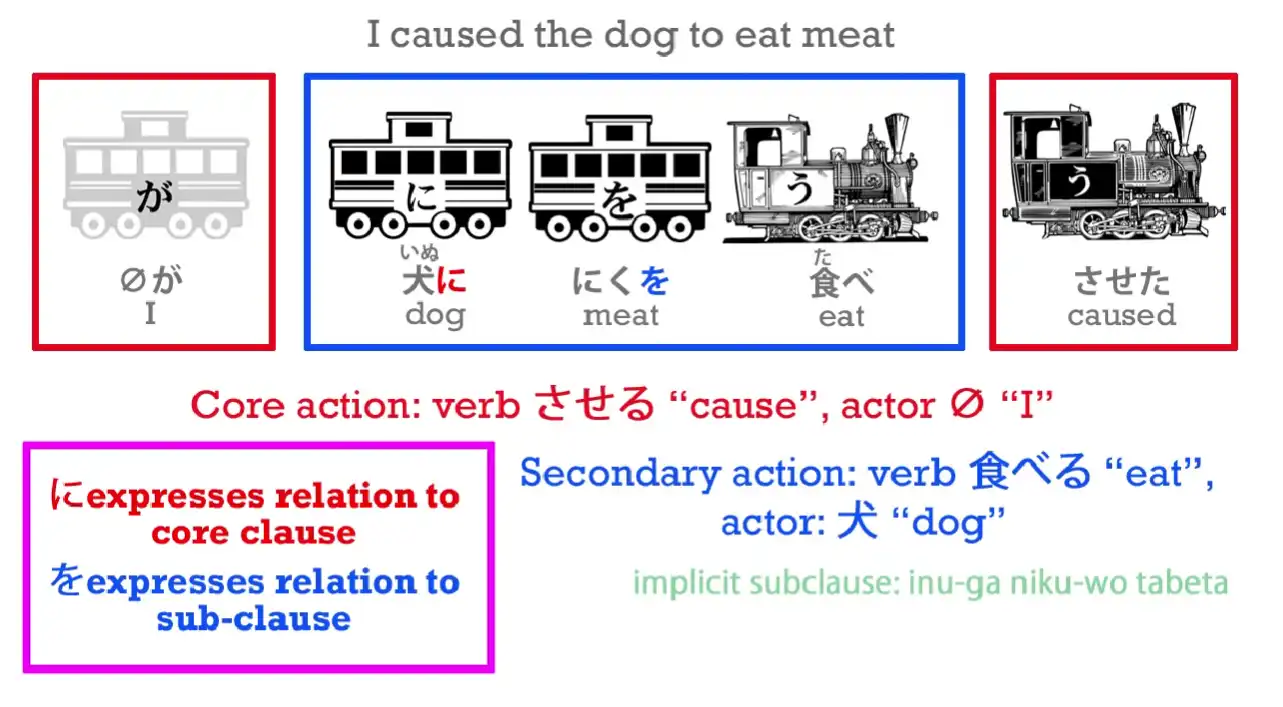
You can see the implied, subordinate sentence here is “犬が肉を食べた”.
The meat is the object of the dog’s action, and the dog is the thing I am causing to do that action.
Now, in these kinds of sentences, Japanese does not allow us to use the を-particle twice.
Since there is an を-particle attached to the meat which is being eaten by the dog – in other words, that’s the object of the inner, subordinate sentence – we can’t also use it on the dog itself who is the object or target of the causing.
Why is that?
Well, really this is partly stylistic, but largely a pragmatic strategy on the part of Japanese grammar.
Not only does it sound awkward if you have two をs in the sentence, it could, in some sentences, become ambiguous.
We might end up with some doubt as to which を marked the object associated with “食べる” (or whatever the verb is) and which を is associated with “せる/させる”, the causing of the action.
As it is, we always know that in a “せる/させる” sentence, a causative sentence, which also has an object of the action itself, that object will always be marked by を, and the target or object of the causation, the thing be made to do something or allowed to do something or facilitated in doing something, will be marked by に.
Well, that I think is the most complicated aspect of the whole thing, and it’s not really very difficult, is it?
Now, the other thing that people do find particularly difficult is the causative receptive (what is called the “causative passive” and, when taught with the standard grammatical model, causes people to receive a great deal of confusion)
Causative receptive / causative passive
Now, as a matter of fact, once we have understood what the causative and the receptive really are and really do, I don’t think there’s anything special about the causative receptive at all.
We know that helper verbs are simply verbs.
They attach to other verbs, but they are verbs in their own right.
If we don’t understand this, everything becomes very difficult.
Now also, the main structural helper verbs, like the causative, the potential and the receptive, are ichidan verbs.
So if we need to attach anything else to them, we simply do what we do with every other ichidan verb – we take off the -る and attach whatever it is we’re going to attach.
So if we want to attach the receptive to the causative, we simply take the -る off the causative, “せる” or “させる”, and attach “られる”, which is the ichidan helper form of the receptive.
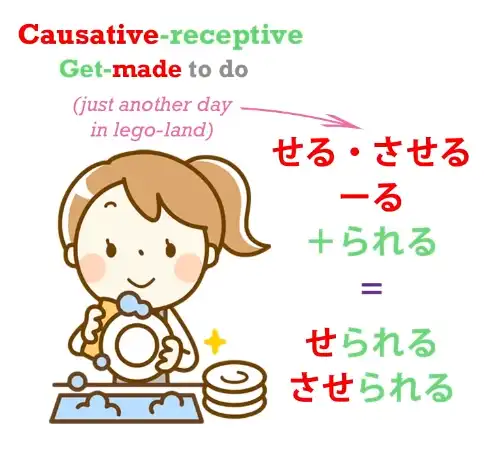
And it’s as simple as that.
Nothing complicated about it at all.
But somebody’s going to say, quite rightly, “But don’t we have three verbs in the sentence now?” and that’s exactly right.
We have three verbs in a causative receptive sentence.
For example, “私はブロコリを食べさせられた” – “I got made to eat broccoli”.
So we have three verbs: “食べる” – “eat”; “させる” – “compel” (in this case it will be “compel”); “られる” – “receive”: “I received being compelled to eat broccoli”.
So, if we have three verbs, do we have three subjects?
No, we have two subjects.
There are always two subjects.
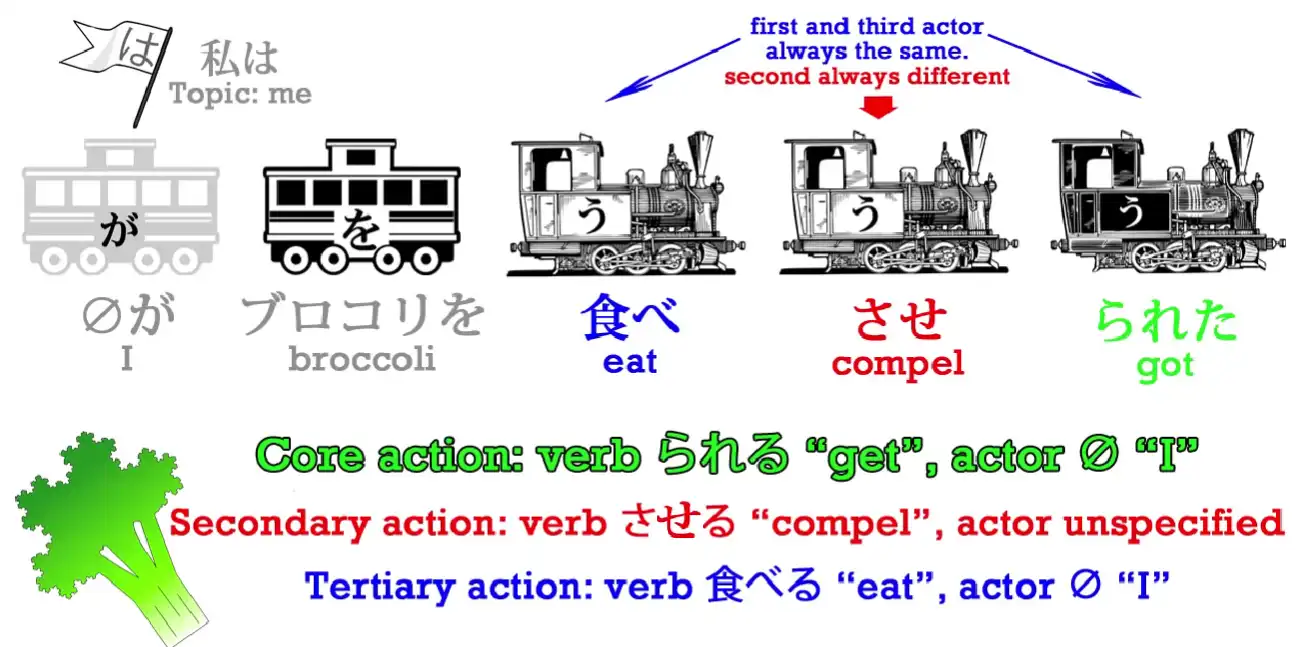
Note: In the video, the red “Secondary action: verb” has a typo ”さらる”. Jisho, Yomichan with 27 dictionaries…nor anything else…do not even know that “さらる”. I fixed it.

And is it difficult to understand what the two subjects are going to be?
No, it isn’t, because the person receiving and the person eating are always going to be the same.
“I received being made to eat…” – I was the one that received being made to eat, and therefore, I must have been also the one that ate.
So the first verb in the sentence, the verb to which the other two are attached, is always going to be performed by the same person as the last verb, the receiving.
And the compelling of the person to do something is always done by someone else.
So we have three verbs, two of which are attached to the person who received the compulsion and who did the action because she received the compulsion.
And the middle one belongs to the person who did the compulsion.
Note: If anything, take a look into the comments, as usual.
20. Directionals: それ・その・そんな・そう etc.
Lesson 20: “Sore/Sono/Sonna/Sou” etc. how directional words REALLY work!”
こんにちは。
Today we’re going to talk about the Japanese system of directional words which use
こ-, そ-, あ-, ど-.
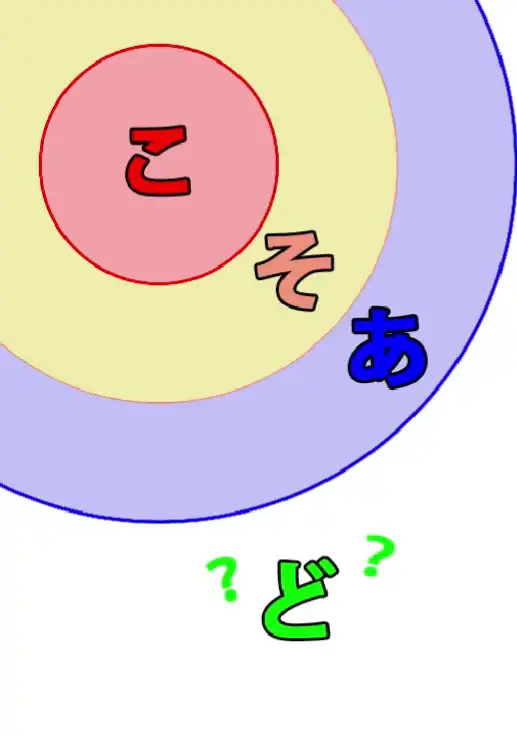
This is commonly called the こ-そ-あ-ど system and initially it simply marks physical locations, but it then expands out to more subtle and metaphorical uses.
This is common because all languages use physical metaphors to express abstract concepts.
And fortunately these means of expression are often similar across languages because the conceptual world maps to the physical world in certain quite predictable ways.
So let’s take the most basic meaning and use of こ-そ-あ-ど, and that is actual physical locations.
ここ, そこ, あそこ, どこ
The most basic location use is “ここ”, “そこ”, “あそこ”, “どこ”.
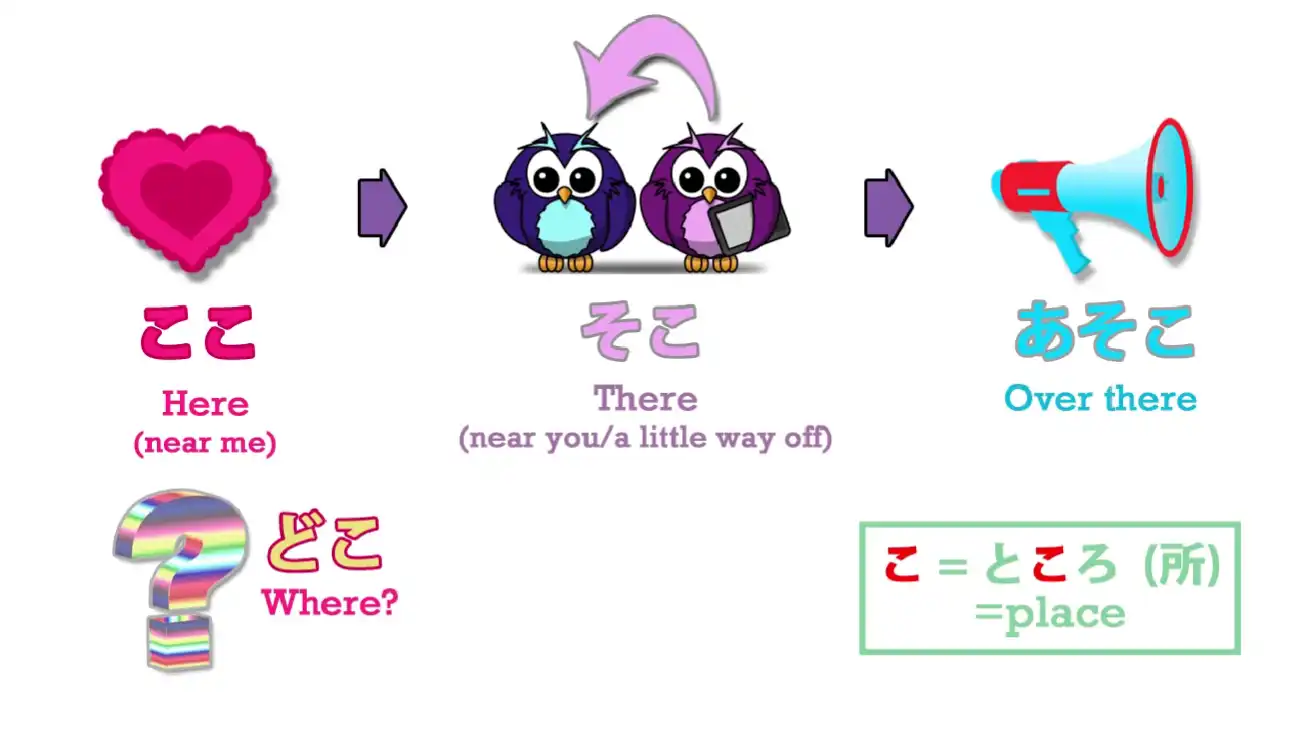
“ここ” means “here”.
If you know the Japanese word “こころ/心” - “heart” - it’s here, right where I am, right where my heart is. That’s not the etymology of the word, but it’s a mnemonic.
“そこ” means “there”.
Now, often “ここ” means the speaker’s place and “そこ” means the place of the listener.
“あそこ” means “over there” and it often means distant from both the speaker and the listener.
So the あ word means over there, somewhat in the distance, so it’s a bit far away, you have to aaaah - shout - to be heard over there.
“どこ” means “where”, so that’s a question word.
So, こ words mean here, possibly near to me, the そ words mean there, often near to you, the あ words mean over there, and the ど words form a question.
So, in anime or manga you’ll often see someone saying, “ここはどこ?” - “Where is this?” Literally, “Speaking of this place, where (is it)?” And that seems to be the most usual way for a Japanese person to ask that question finding herself suddenly in an unknown location.
The English way of asking it is more likely to be —- “Where am I?” but the Japanese way is “Where is this place?” “ここはどこ?” - “As for this place, where?” Now, that’s quite simple, I think.
And now we’re going to look at something that does occasionally confuse people, and that’s because when we come to the れ- and the の-group, in English we express both with the same word.
But we do have the distinction, so let’s look at those.
これ, それ, あれ, どれ
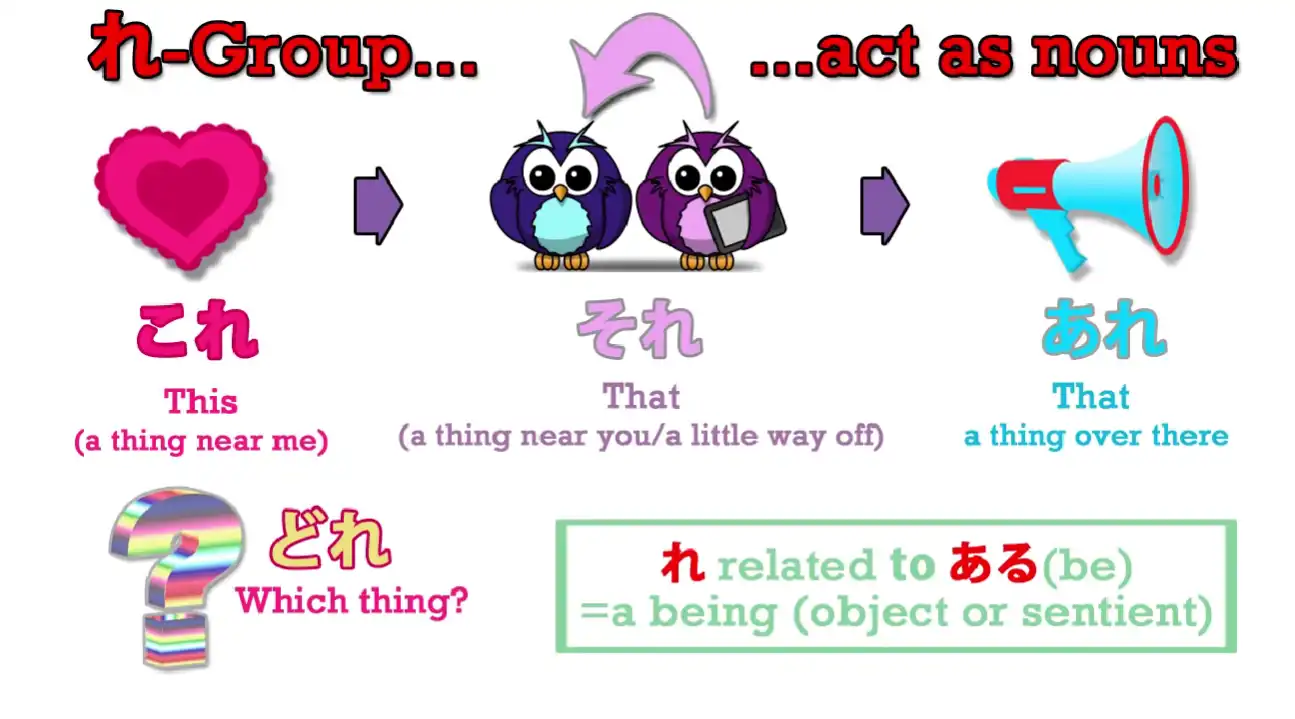
The れ-group is “これ”, “それ”, “あれ”, “どれ”.
And the thing here is that the -れ means “a thing”.
こ- means a place, a location, and it can actually be written with the kanji for “所” - “place”.
-れ is related to “ある”.
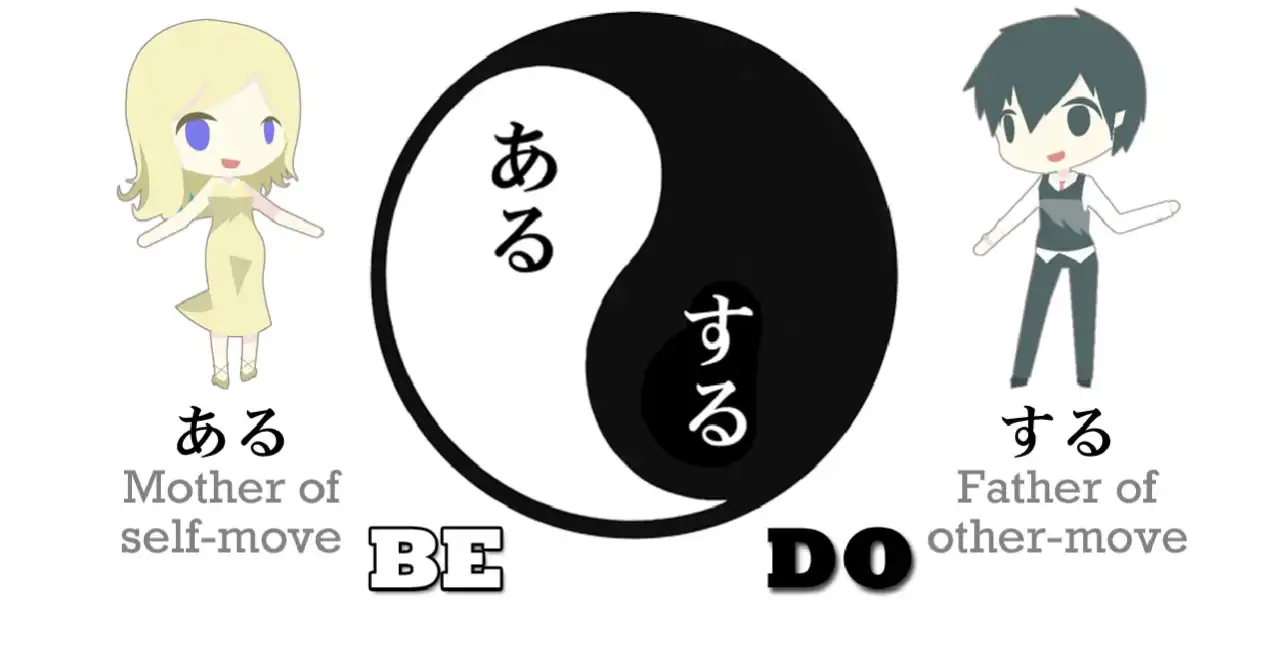
It’s one of these things that’s related to the fundamental “ある”, the mother of verbs.
And “ある” means to “be”; this -れ means “a being”.
When we say “a being” in English we usually mean a sentient being, an animal or a person or something, but this means any kind of a being, anything that exists.
So, “これ” means “this thing/this being”;
“それ” means “that thing/that being”;
“あれ” means “that thing over there/that being over there”,
and “どれ” means “which being/what thing?”
この, その, あの, どの
Now, what these can get confused with is the の-group: “この”, “その”, “あの”, “どの”.
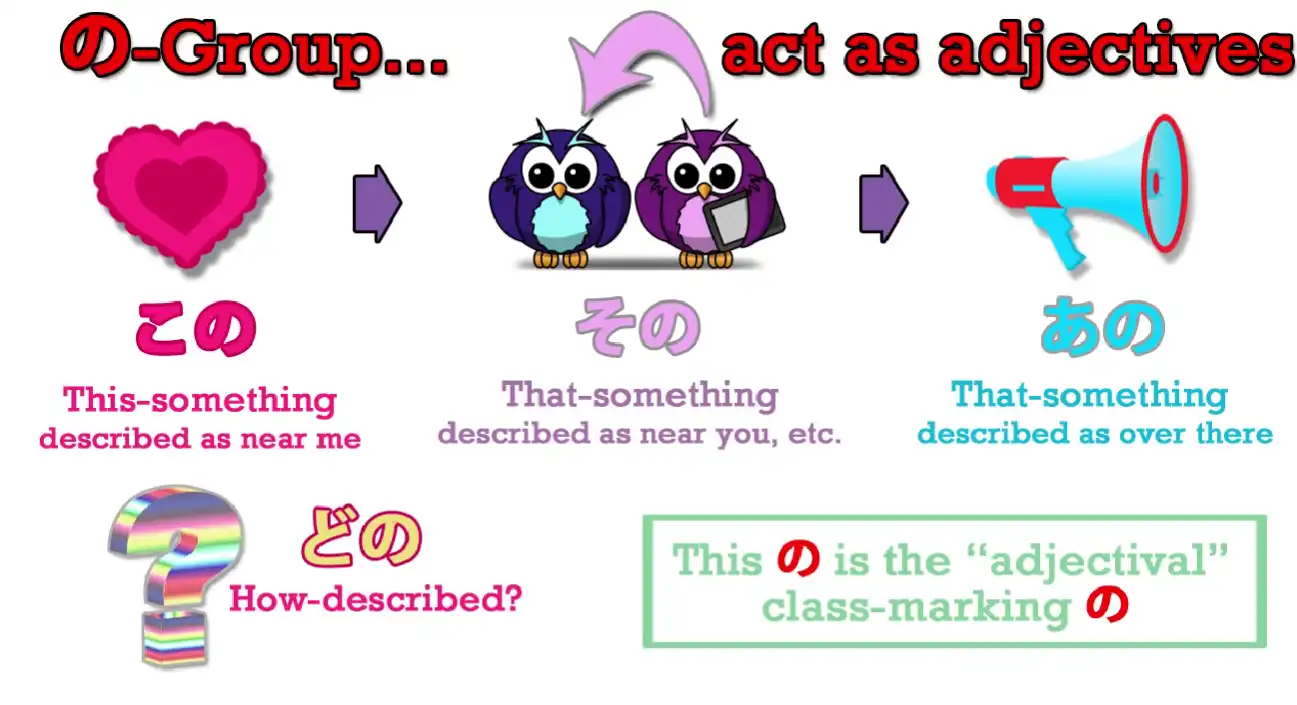
Now, -れ means a being and refers to a thing.
の, as we know, is used to make adjectivals or descriptors.
So if we say, “さくらのドレス”, we’re saying, “Sakura’s dress”.
If we say, “でんせつのせんし/伝説の戦士”, we’re saying, “legendary warrior/warrior that belongs to the class of legend”.
Now, this is the same の that we see in “この/その/あの/どの”.
So if we take a very basic textbook phrase like “これは (zeroが) ペンだ”, we’re saying, “this - this being - (it) is a pen.”
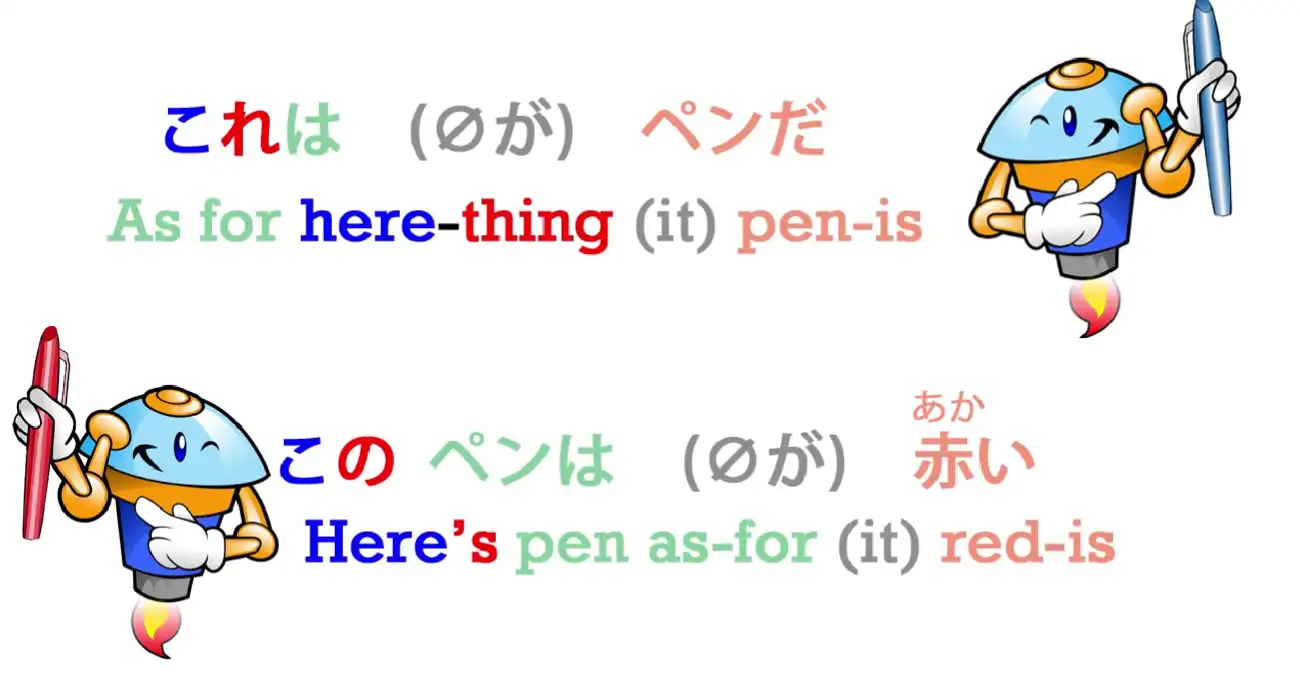
But if we say, “このペン(zeroが)は赤い” - “This pen (it) is red”.
“このペン” - the here pen, the pen that belongs to the class of things that are here.
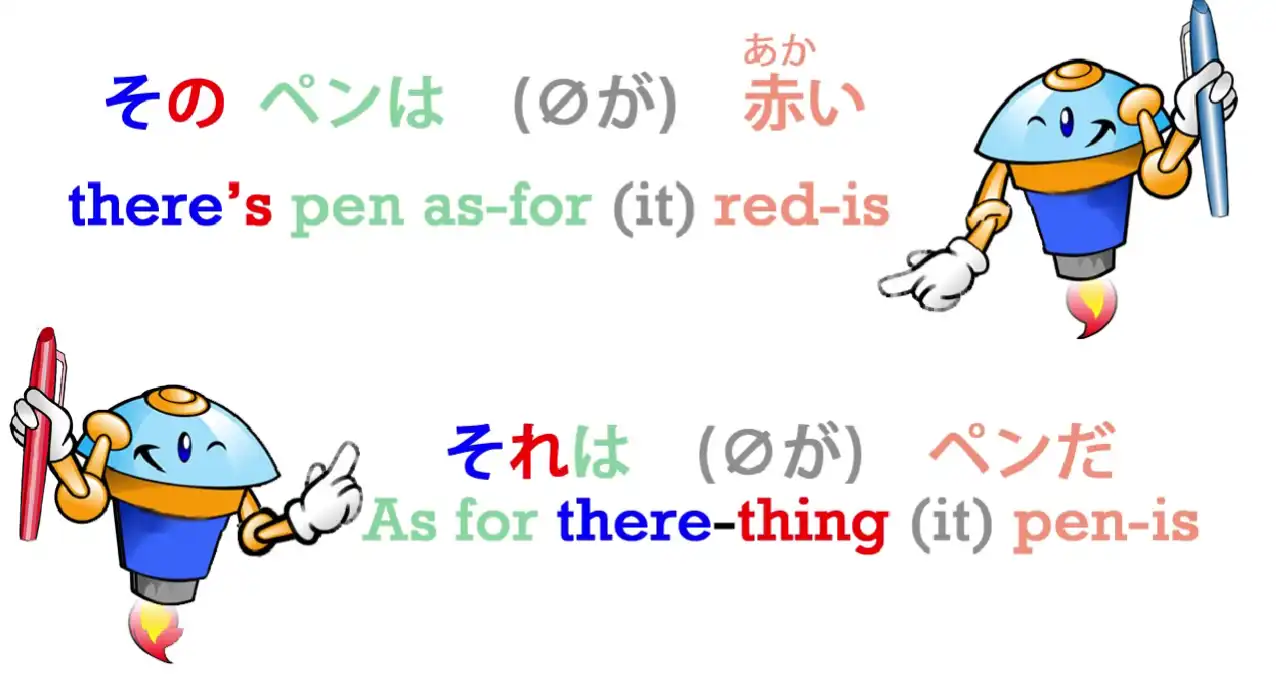
“それは(zeroが)ペンだ” - “That thing over there or the thing you’re holding (it) is a pen”.
“そのペンは(zeroが)赤い” - “That pen, the pen that belongs to the class of things over there, (it) is red”.
Now, in English we can say “this” or “this pen” and there’s no distinction between the words.
We’re using “this” in both cases.
So, once we’ve got used to how they work, I think those are very straightforward too.
こんな, そんな, あんな, どんな
Now, the next group is “こんな”,”そんな”, “あんな”, “どんな”.
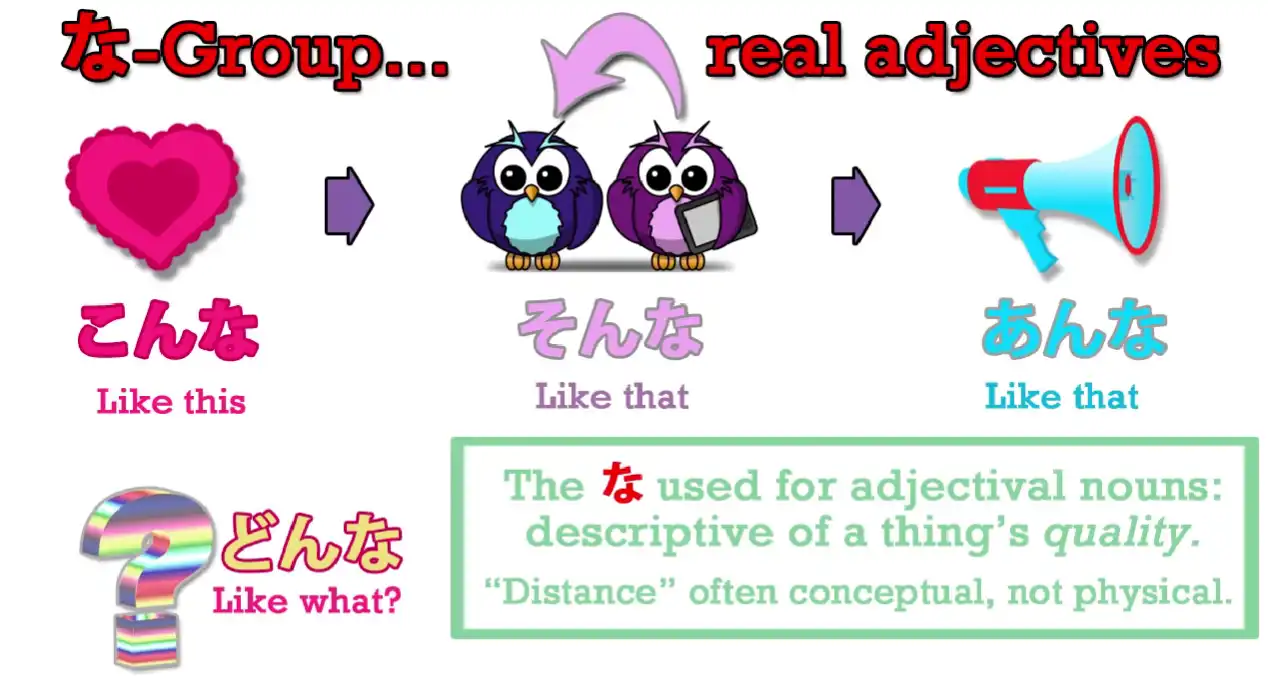
Now, in this case we are using -な.
And -な, as we know, is the form of the copula that turns an adjectival noun into an adjective that you can place before something else. (Lesson 6) And this is exactly what’s happening here.
So, “こんな” means “like this/this kind of”;
“そんな” means “that kind of”,
“あんな” means “that kind of over there/the further-away kind of”.
And I’m not going to go into the details of this, but whether we use “そんな” or “あんな”is going to depend on…
sometimes the literal position of something but very often on how far these things are from what we are talking about, from the present circumstance, from something we associate with ourselves.
So, we could say, “こんな食べ物が好きです” - “I like food like this”.
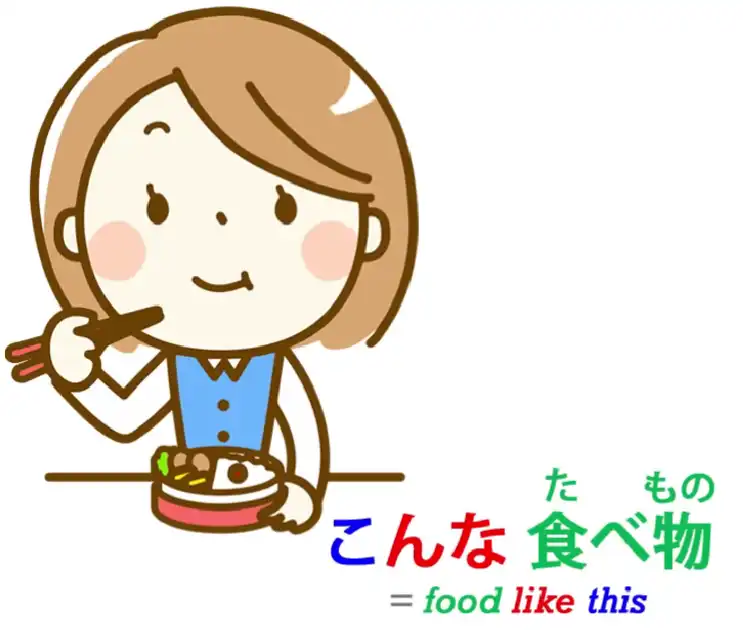
“そんなことがひどい” - “That kind of thing’s unkind/cruel”.
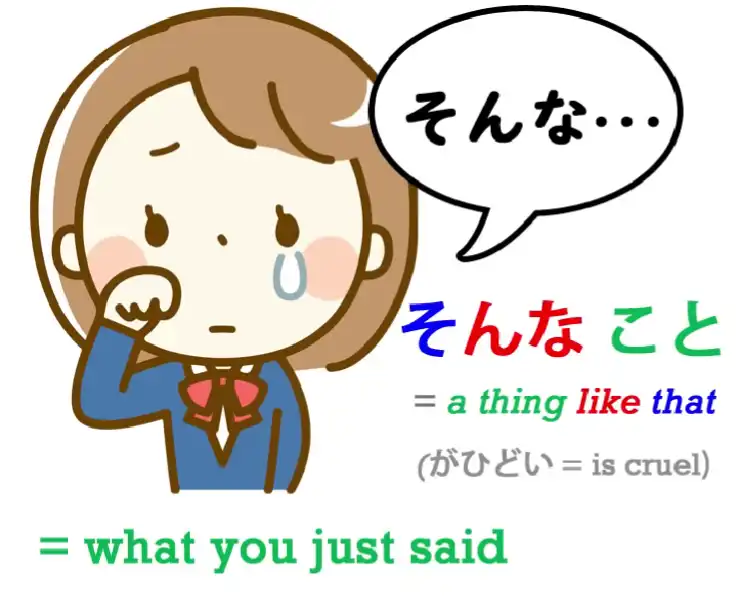
And in fact you’ll often find in anime or manga that someone just says, “そんな!” And when it’s said in that kind of a complaining or accusing kind of way, it’s short for saying “that kind of thing.” You’re saying, “that kind of thing”, and it would mean something like “that kind of thing is unkind/that kind of thing is mean / that kind of thing is something I don’t like.” “そんな!” - “That you said such a thing!” — So “そんな” is essentially a comparing adjectival:
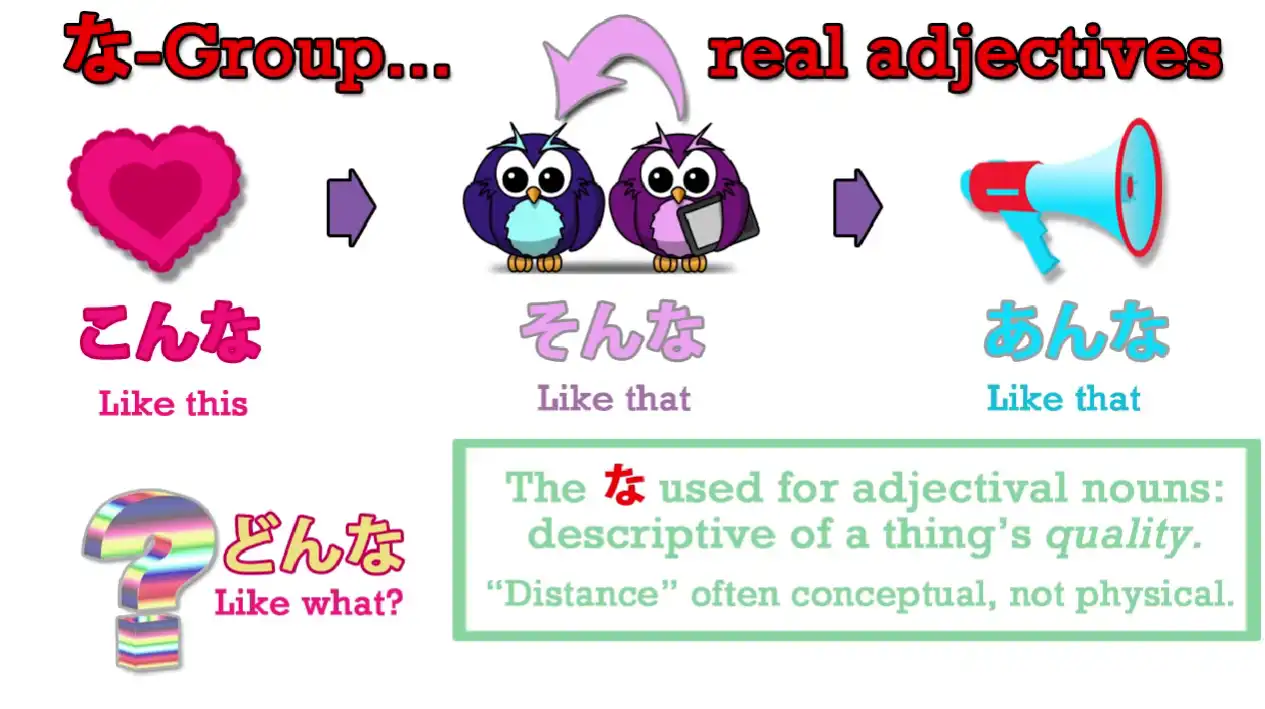
we’re describing what something is like by comparing it to something else that we’re referring to, something that’s here, something that’s over there or something that’s way over there, either in physical space or conceptually.
“どんな” is asking what kind of a thing something is.
Literally, what would we compare it to?
こう, そう, ああ, どう
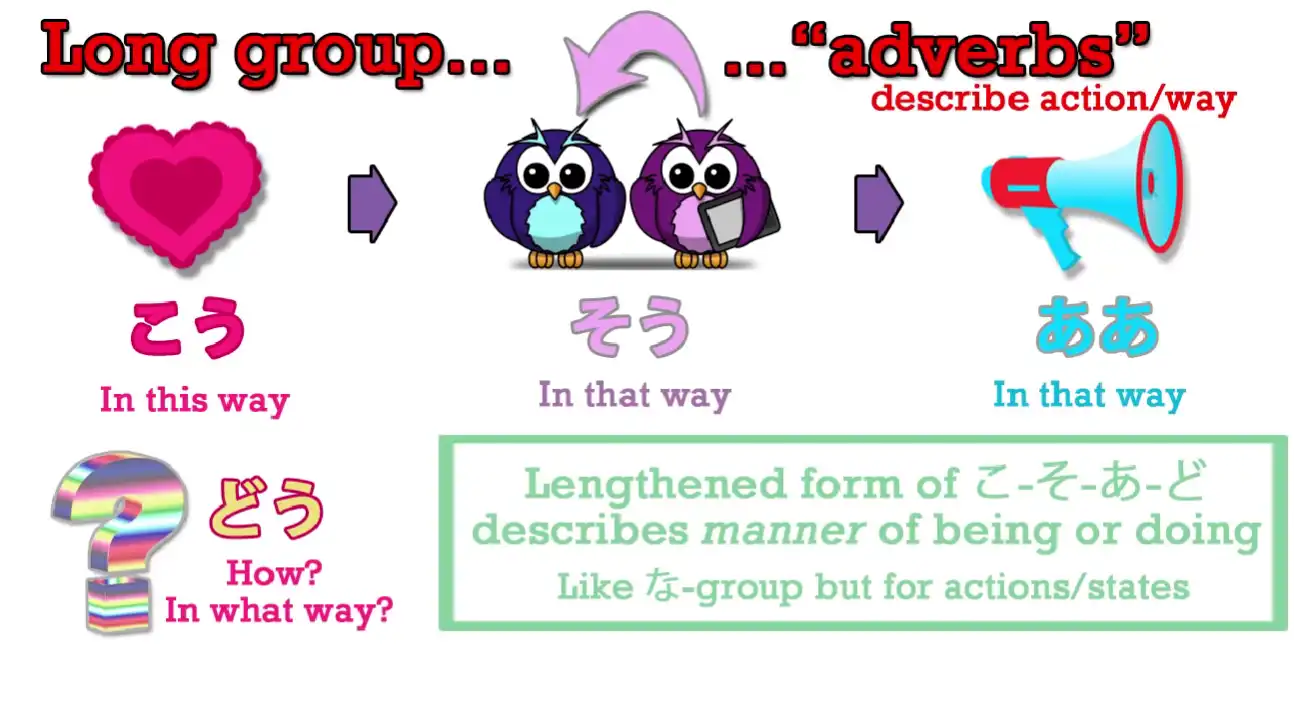
Now, when we use こ-そ-あ-ど on their own and lengthen them with -う
(or in the case of あ-, with an extra -あ) so they become “こう”, “そう”, “ああ”, “どう”,
then we are talking about the way something is or happens.
So when we say “(zeroが)そうですね?” we’re saying, “(It)That’s right, isn’t it?”
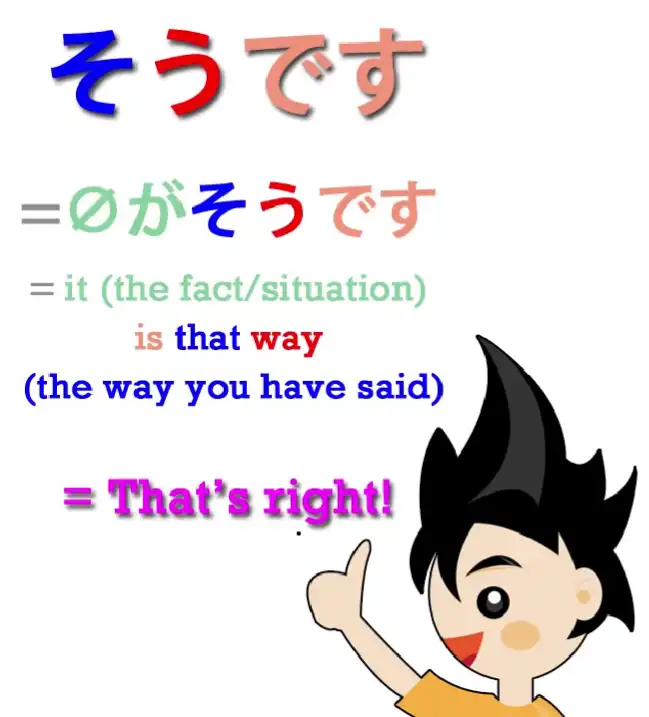
So what we are really saying is “(zeroが)そうだ/そうです” - “(It) is like that”.
If we say, “そうする” we mean “do like that”; if we say “こうする” we mean “do like this”: do in that way/do in this way.
If we say “どうする”, we say “do like how?” and we often say “どうすればいい?”

Now, “すれば” is the conditional form of “する”.
Saying “どうすればいい?” means “how if I do will be good?” And we often find these combined with “いう/言う” meaning “say”.
It’s another example of the wider application of the concept of quotation in Japanese, which we discussed recently.
And this is often used in relation to things that are not physical, concrete things - in other words, the kind of things which we call “こと” rather than “もの”.
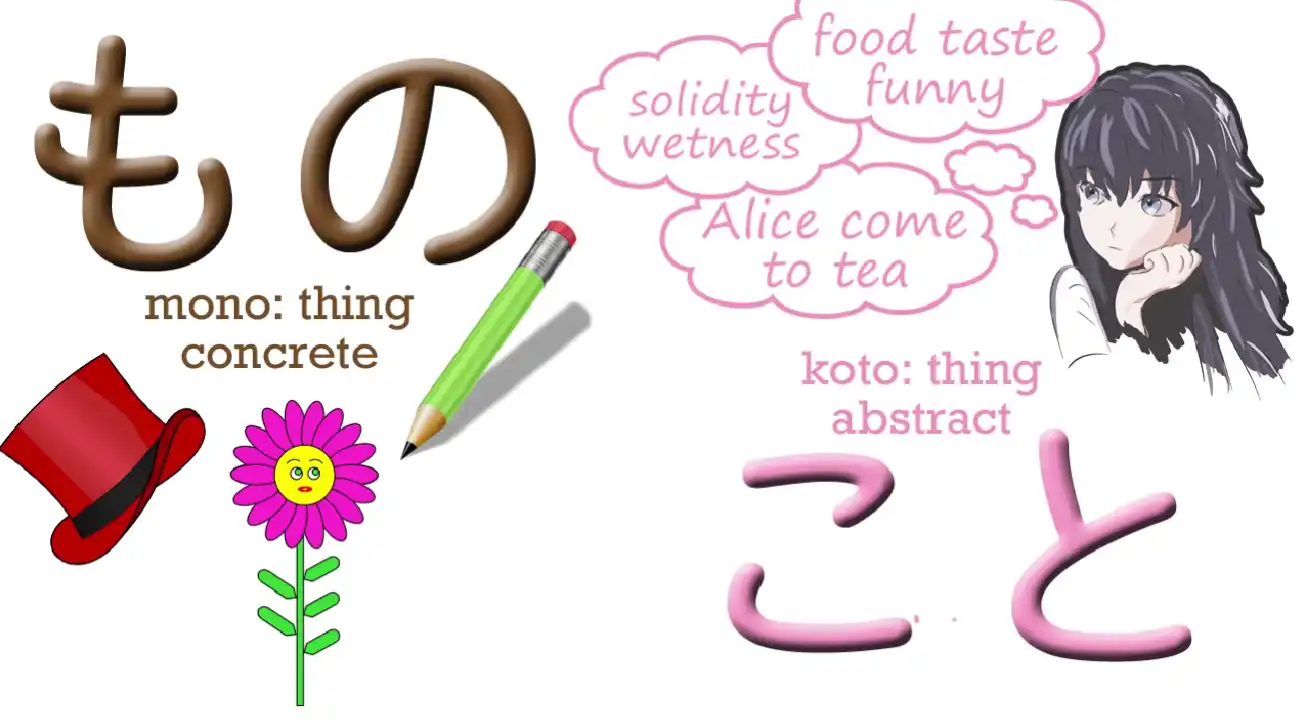
And we’re going to hear an awful lot “そういうこと”, “こういうこと” and “どういうこと”.
We also hear “ああいうこと”.
It’s less commonly used than the others, but it is used.
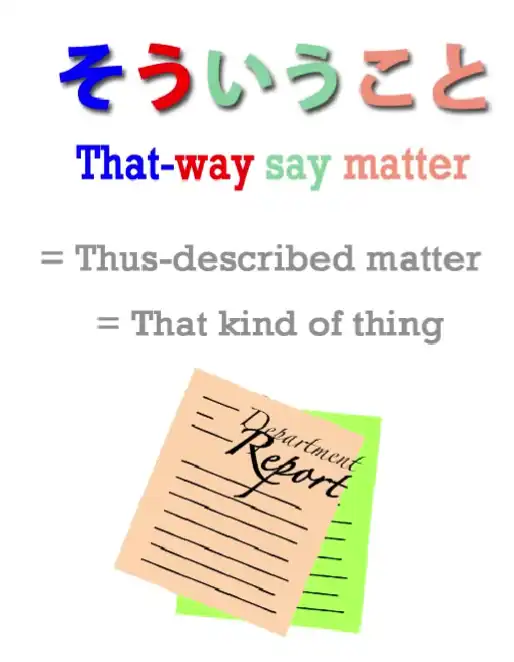
So what do we mean when we say “そういうこと” - “a thing of that kind”; “こういうこと” - “a thing of this kind”; “どういうこと” - “what kind of a thing”?
Why do we mean “what kind of a thing”?
This kind of a thing / that kind of thing, what kind of a thing?
What we’re actually saying is “how-said thing / how-said circumstance / how-said condition”.
In other words, in what way do we describe this condition / what kind of a description does this circumstance or condition have?
And we often hear as a kind of exclamation, “どういうこと!?” and it means “what’s going on here? / what is this? / what description of thing is this that’s happening?” And it can also mean “what are you talking about / what are you getting at / what are you saying here?” “どういうこと!?” And the thing to understand here is that the “いう” there is not referring to the fact that the person has just said it.
“どういうこと” meaning “What do you mean / what are you driving at / what are you talking about here?” The “いう” does not refer to the fact that you’re saying it.
The “いう” refers to the description of the thing.
So “どういうこと” is in this case short for “どういうことをいう?” - “how described thing are you saying?” So we see the こ-そ-あ-ど system works both in terms of literal location and in terms of metaphorical location.
21. てある/ている & ておく
Lesson 21: Te oku/te aru: how to REALLY understand them. What they never teach!
こんにちは。 Today, we’re going to go back to Alice’s adventures, and we’re going to use them as an opportunity to look into some of the deeper and more subtle uses of the て-form.
These are covered in the regular textbooks and Japanese learning websites, but as usual they don’t explain the logic behind them, which makes them more difficult to grasp.
And in some cases where there isn’t a straightforward English equivalent they really don’t tell you what’s actually going on, because they only talk in terms of English equivalents, which leaves you guessing quite a bit of the time.
So, if you remember, Alice was falling very slowly down the rabbit hole and she had taken a jar off one of the shelves as she fell.
“そのびんにはラベルが貼ってあって 「オレンジ・マーマレード」と書いてあった”

So we have three て-formed verbs in this sentence.
Let’s look at what they’re doing.
“そのびんにはラベルが貼ってあって.” “びん/瓶” is the word being used for a “jar” here.
It can mean “bottle” – it’s often translated as “bottle” – but it can also mean a “jar” and that’s what it means here.
“ラベル” means “label”.
It’s “ラベル” and not “レベル”, I believe, because it comes from another European language other than English. Note: レベル means “level”. We can also say “レーベル”, but that’s less common than “ラベル”. (The ー is important here) “貼る” means “stick” or “paste” something onto something else, so this means that a label was pasted onto the bottle.
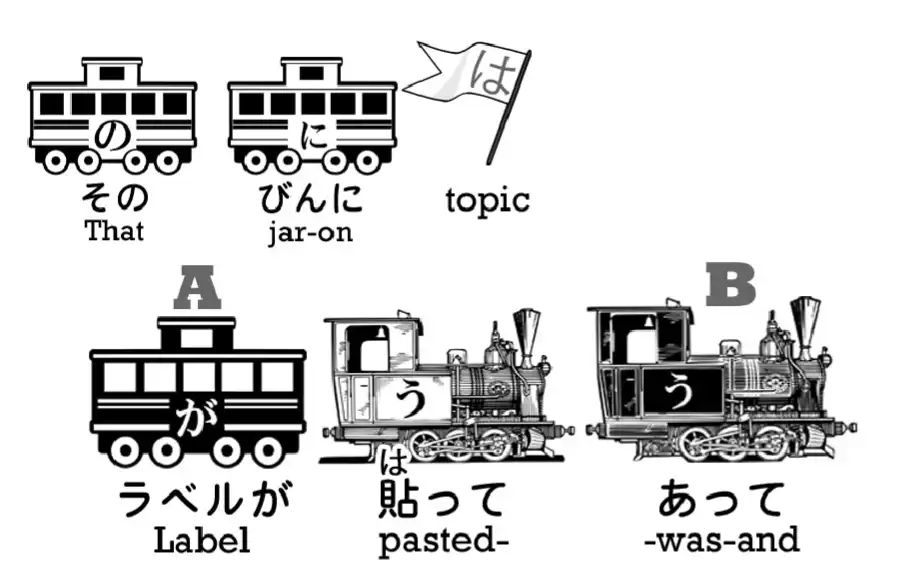
Literally, speaking of that bottle as the target of something, a label was pasted onto it.
Now this use, “貼ってある”, we haven’t covered in this course up to now.
We’ve talked about て-form of a verb plus “いる”, and we know that “いる” means “be” and て-form of a verb plus “いる” means to be-doing that verb or to be-in-a-state of that verb.
てある
What about “-てある”?
“ある” also means “be”, so the meaning is in fact very similar.
It also means to be-in-a-state of that verb.
However, there is a difference, and I’m going to explain that difference with another example.
Let’s take the sentence “窓が開いている” and the sentence “窓が開けてある”.
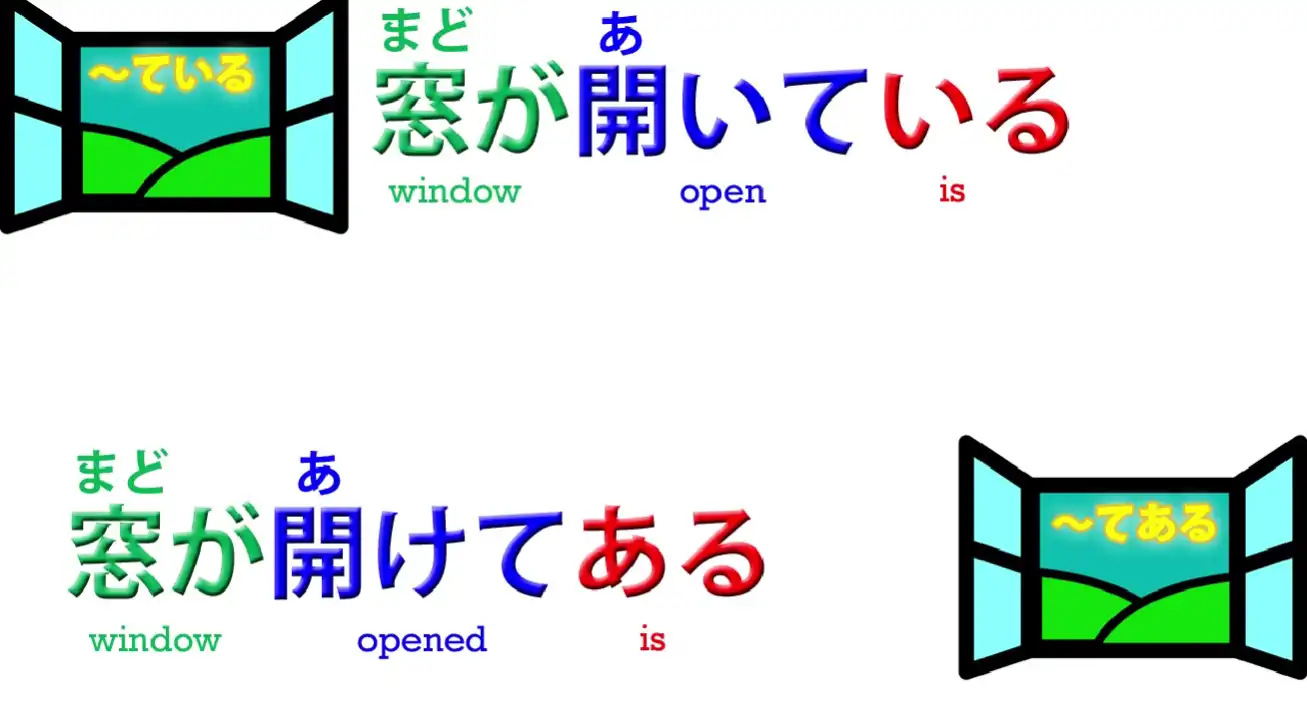
Both of them mean “The window is open”.
“開いている” simply means that the window is open, and we can translate that directly into English, and it’s really the same thing.
But “窓が開けてある” doesn’t have any English equivalent because it still means the window is open but it carries another implication.
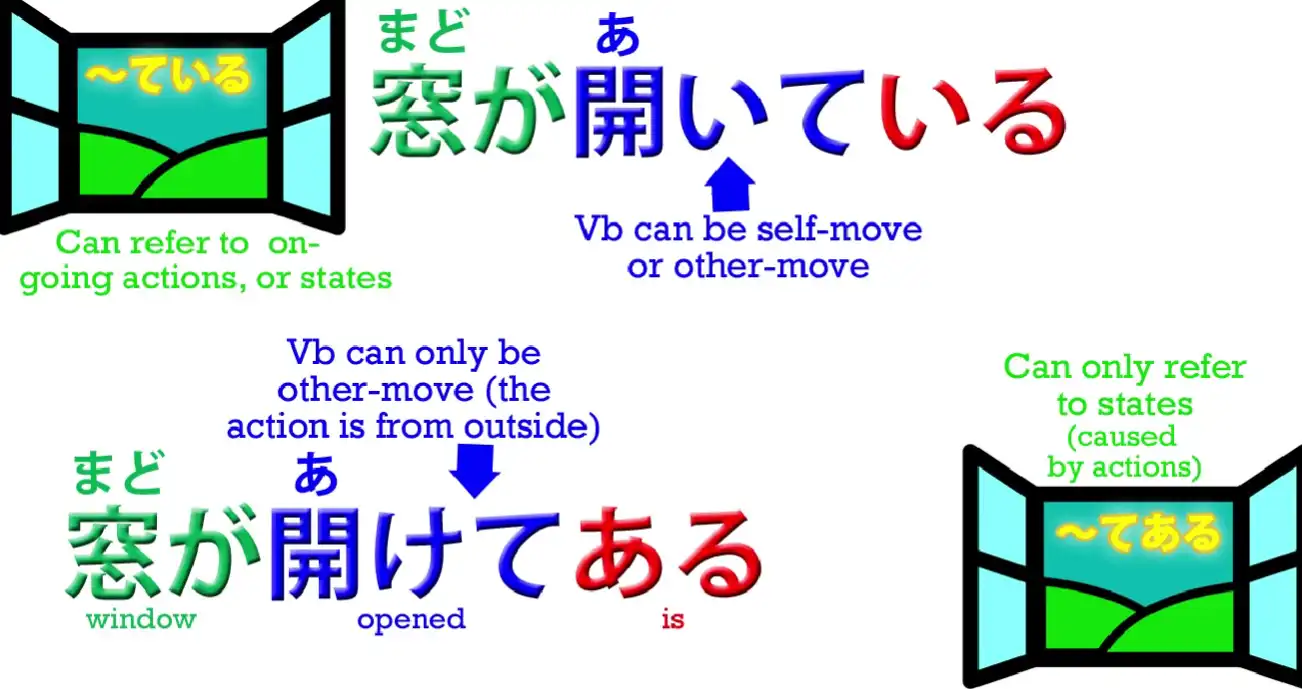
First of all, we are using the other-move version of “開く”, which is “開ける” (bottom one).
“窓が開いている” – that’s the self-move version of “開く” and it simply means to be open, to exist in a state of openness.
The other-move verb, “開ける”, which is the regular く / ける う-ending verb to え-stem + -る of the third law of self-move/other-move verbs that we’ve looked at already. (Lesson 15)
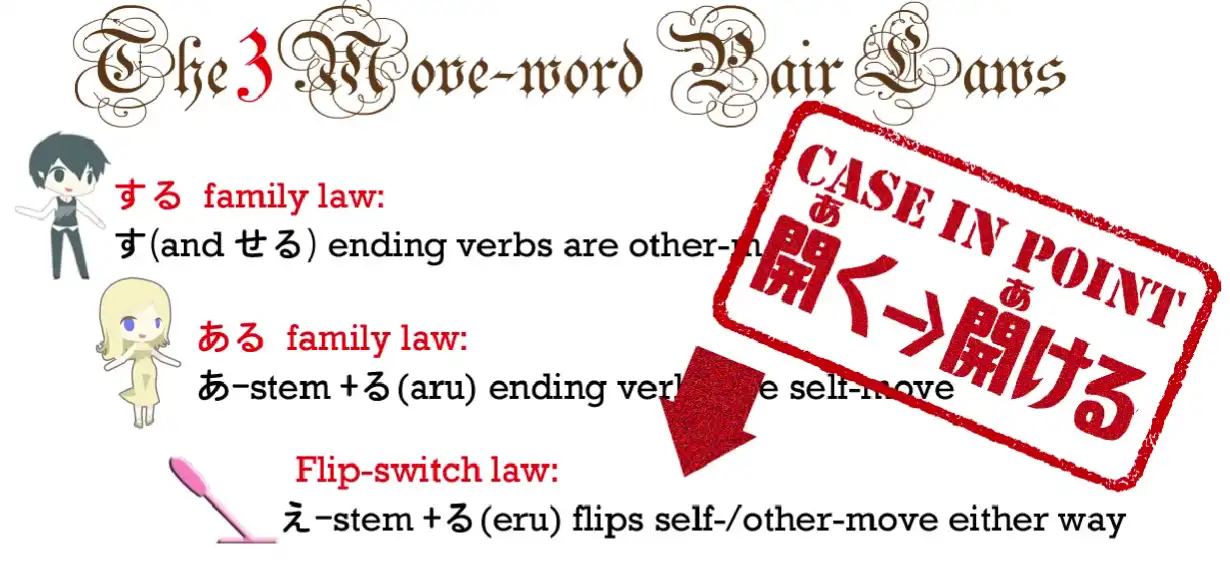
So “開く” (the one up) means be open yourself, whatever you are, a box or whatever; “開ける” (the one down) means open the box, open the door etc.
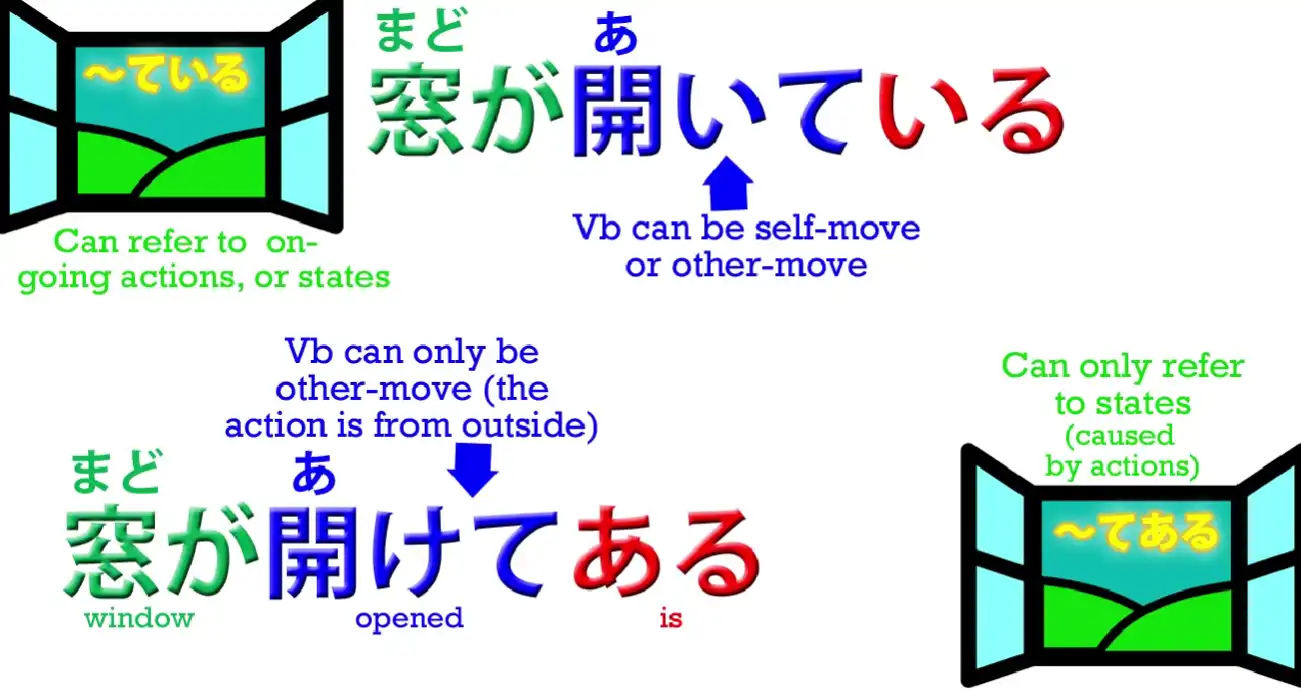
So what “窓が開けてある” means is that the window was open, but it was open because somebody else opened it.
We’re signalling that in the first place by using the other-move version of the verb and in the second place by using “ある” instead of “いる”.
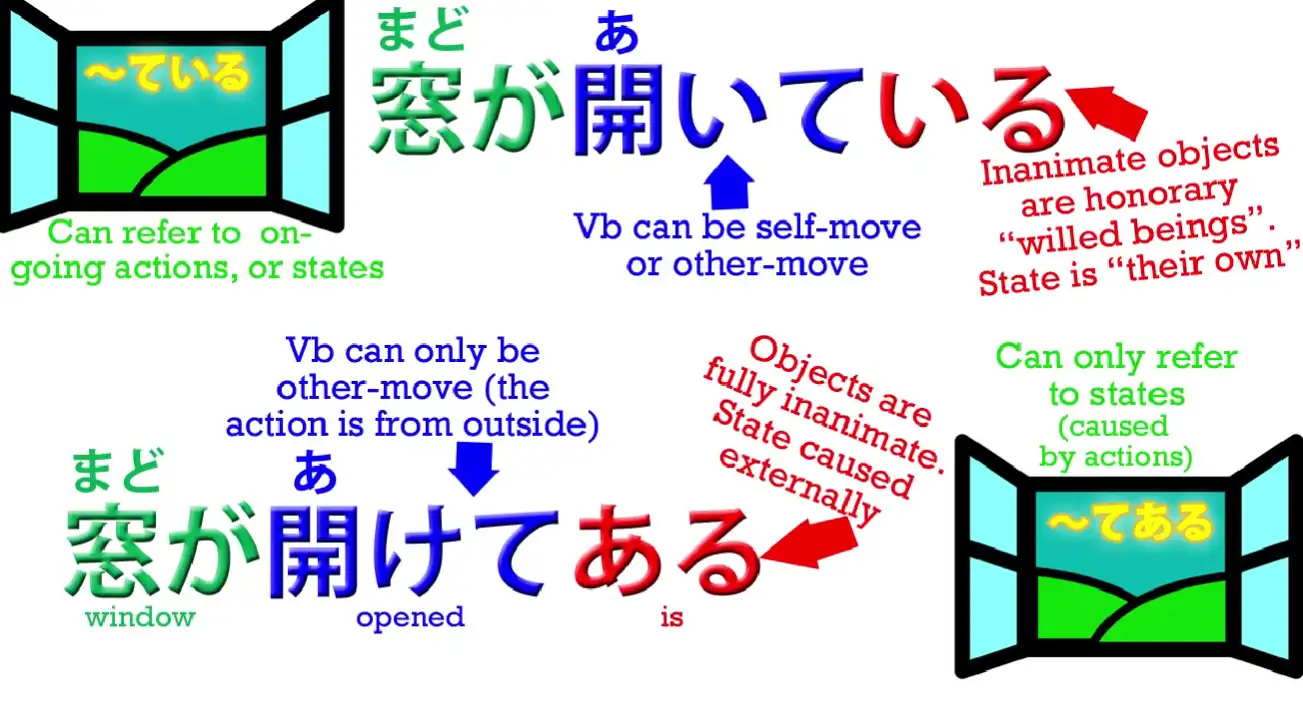
So what’s the reasoning behind that?
Well, when we say “窓が開いている”, although it is an inanimate object, we’re using the version of “be” which we use for animate beings, people and animals and such.
That in fact is the part that needs explaining, isn’t it?
Why are we using the animate version of “be” for an inanimate object like a window?
And we do this all the time.
We’re always saying “-ている” for inanimate objects of all kinds.
The reason is that in this expression we’re simply saying the window was open – we’re not implying that anybody opened the window.
So, in a way, we can say that we’re treating the window as an honorary animate being.
The window was open, as it were, of its own volition.
We’re not saying it’s open because of anybody’s will other than its own.
So in a certain sense we are treating the window as an honorary animate being: “窓が開いている”.
But if we say “窓が開けてある”, we are saying that somebody opened the window.
The window was the mere object of having been opened by somebody else.
So it loses its status as an honorary animate being.
It is treated as a mere object, an inanimate thing – “開けてある”.
And the thing to understand here is that even though it’s lost its status as an animate being, even though we’re using the other-move version of the verb, the が-marked actor of this sentence is the window: “窓が開けてある”.
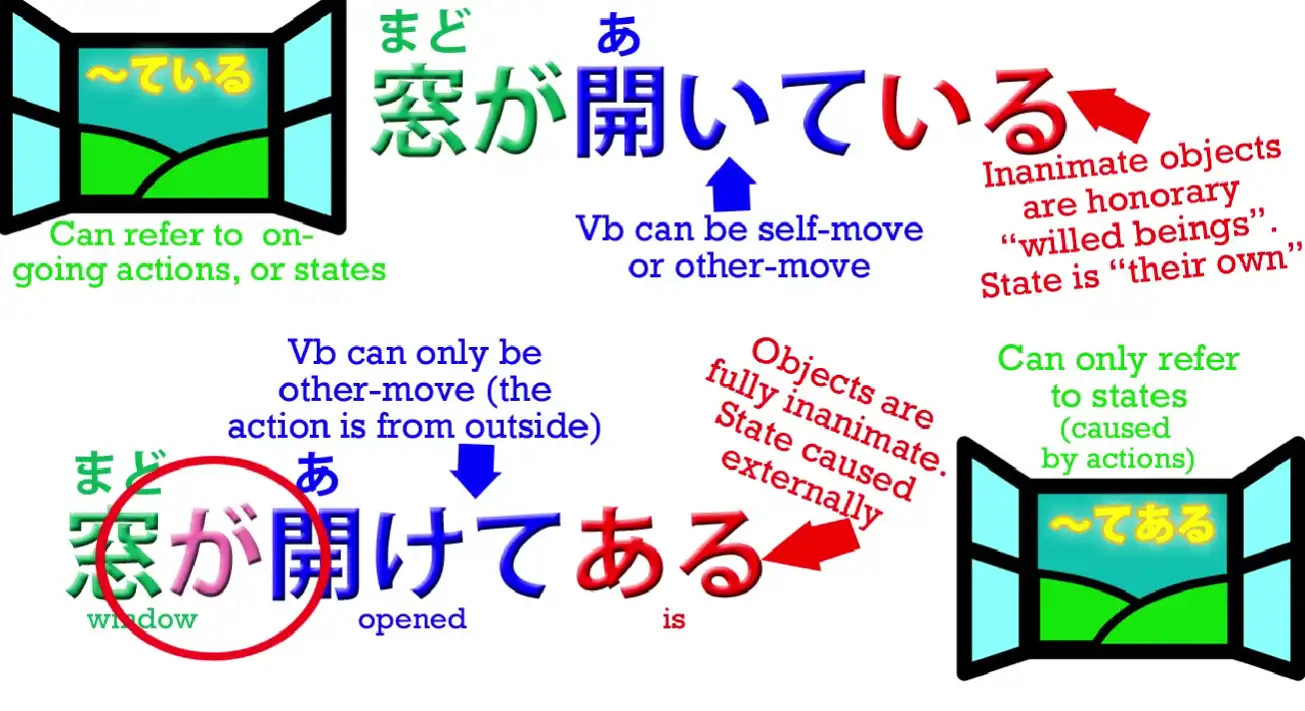
The window is doing the action, which is “ある”: the window is existing in a state of having been opened by somebody else.
And that is the same thing that’s happening in our sentence from Alice.
“そのびんにはラベルが貼ってあって” – “The jar existed in a state of having had a label pasted (onto it) and…” Now, as you see, there is really nothing equivalent to this in English, so we just need to get it into our minds so that we can look at the Japanese as Japanese.
This is fundamental to what I’m teaching here.
I’m teaching the real structure of Japanese, not simply throwing some Japanese at you and throwing some English at you and saying, “Well, this kind of means that.” We need to get rid of English translation as far as possible and look at the Japanese as it really works in itself as Japanese.
And that’s why my “translations” under the trains get weirder and weirder.
Because I’m not trying to translate this for you into natural English.
I’m trying to tell you what the Japanese is really doing.
So the second half of the sentence…
The second て-form (あって), of course, is simply joining the first logical clause in this compound sentence to the second logical clause.
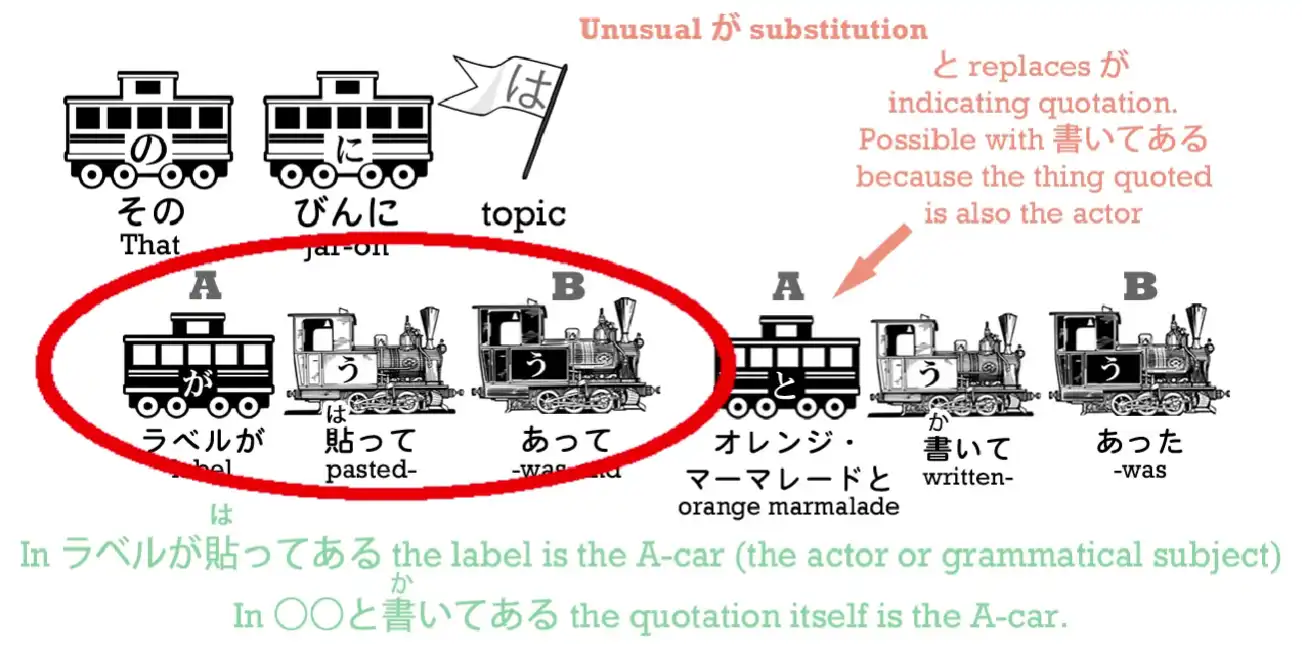
And the second logical clause is “「オレンジ・マーマレード」と書いてあった”.
And here we have again this “-てある” form.
And whenever we talk about something being written on something we tend to use this form.
We don’t say “The label said ‘Orange Marmalade’’’, which is what we say in English, as if the label could speak. We say “「オレンジ・マーマレード」と書いてあった”.
-と is our quotation particle, of course, that’s quoting exactly what was written on the label, and then “書いてある” means that it was in a state of having had those words written on it by somebody else.
Now, I’m going to do something a tiny bit unusual here. I hope you won’t mind.
I’m going to skip ahead just a little bit in the story, because the next part contains a very interesting point that really needs a lesson of its own, and the part immediately after that includes something that really rounds out what we’re doing today.
ておく
It introduces “-ておく”, which really belongs together with “-ている” and “-てある”.
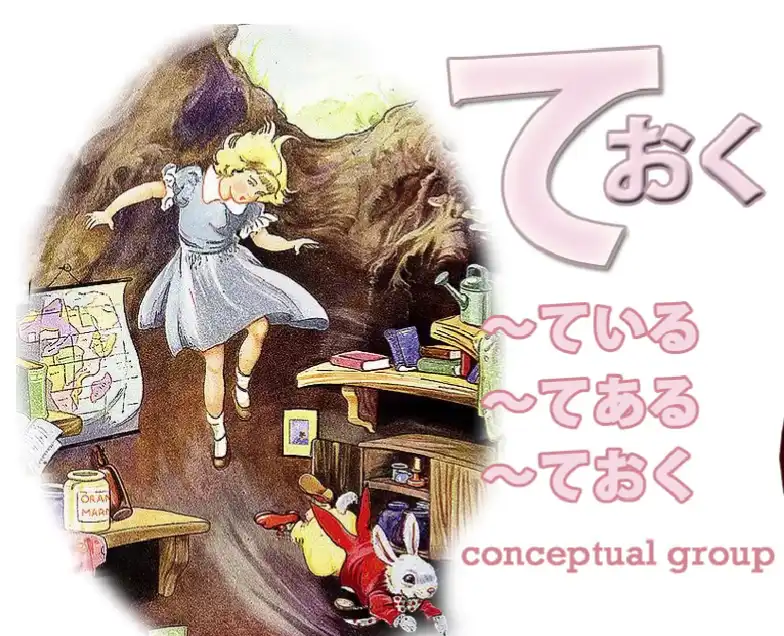
This relationship is something the textbooks don’t explain and because they don’t it leaves “-ておく” rather undefined in people’s minds.
Many quite advanced students don’t really understand why “-ておく” is used in some cases.
So we’ll go ahead with that now and I’ll just fill you in on the story in between.
It’s only a little bit.
Alice realizes that the marmalade jar is in fact empty, and what’s she going to do with it?
She doesn’t want to drop it because it’ll fall all the way down the hole and very likely kill someone.
And, if you read the newspapers, you’re probably aware that there are far too many empty marmalade jar incidents in Wonderland already.
So, now you know the background, let’s carry on.
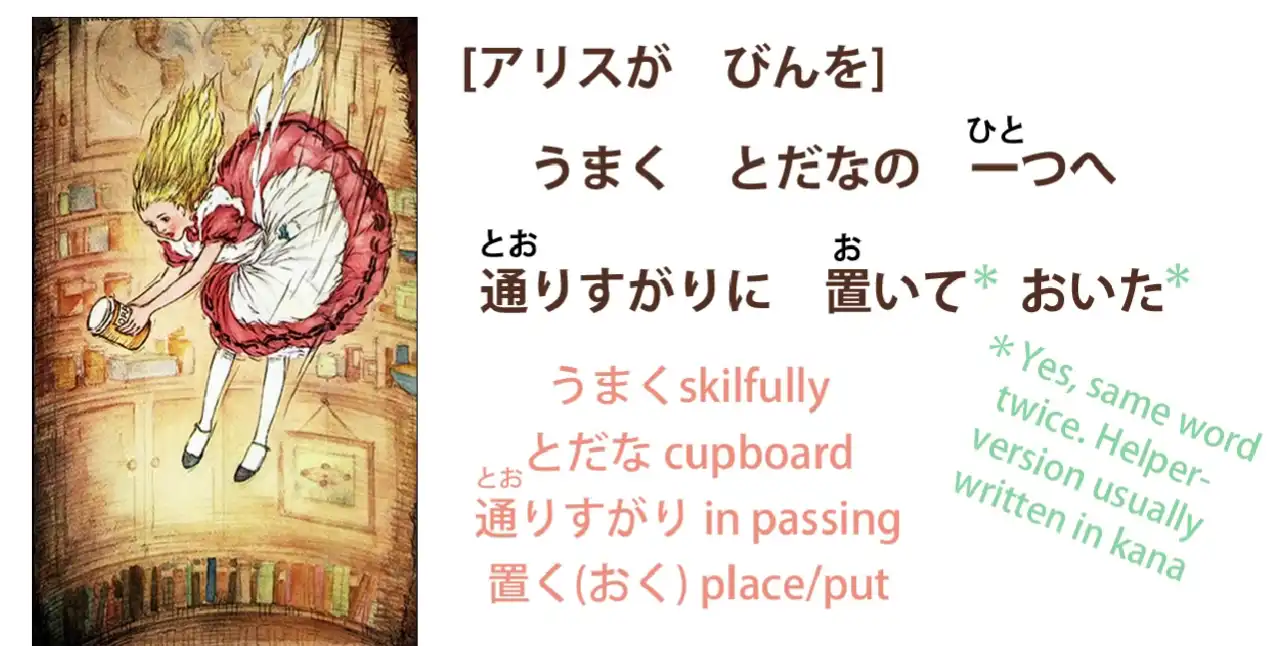
“うまくとだなの一つへ通りすがりに置いておいた” “うまく” means “skilfully”; “とだな/戸棚” as we know is a “cupboard”; “とだなの一つ”, as we talked about in the last lesson (Lesson ??), is “one of the cupboards”.
So she skilfully in passing put it into one of the cupboards.
And what’s this “置いておいた”?
Now, they’re both the same “置く”, “置く” meaning to “put”.
The first one is simple enough: she “put” it into the cupboard, but why do we have the second “おく” at the end of it – “置いておいた”?
Now, this is another very common and very important て-form usage and it’s one that the textbooks and English-language websites tend not to explain very well, because it’s something we really don’t have in English.
However, we already halfway know it,
because it is in a certain sense the other half of “-てある”.
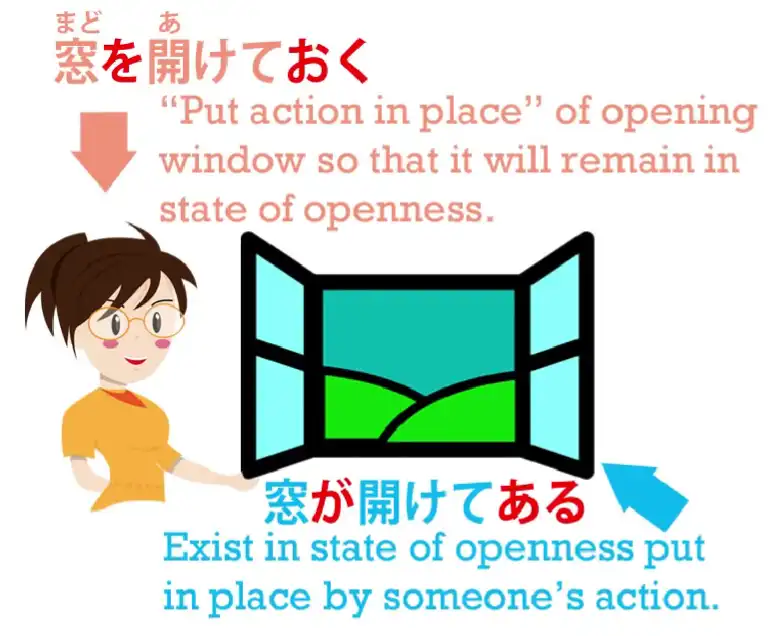
“-ておく” means to put the action in place.
Now in this particular use, it’s quite easy to see because she’s putting the jar literally into place and she’s putting that action into place.
What the textbooks and websites tell you is that it means doing something in advance, doing something for the purpose of something else. And this is true in many cases.
It’s probably the nearest you can get in English.
But what it actually means is putting the action in place.
And to understand this let’s go back to our example “窓が開けてある” – “the window is open because somebody opened it”.

Now, the somebody who opened it, if we say it instead of from the point of view of the window, from the point of view of the person doing the action, 👇 “開けておく” is the other side of this.
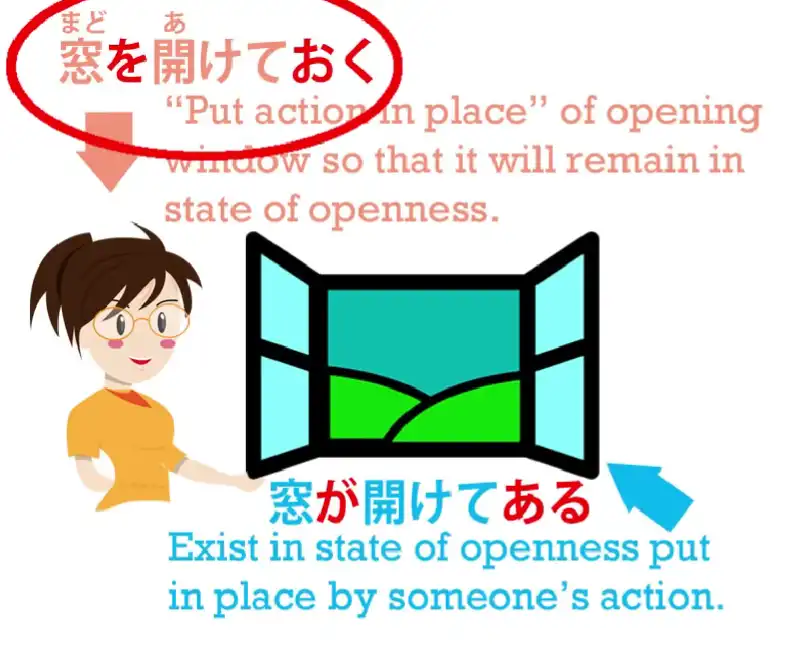
The person put the opening of the window into place so that thereafter the window would be open.
So you see we have the two halves of the same coin.
“窓が開けてある” – the window stands open because somebody put it there.
“窓を開けておく” – open a window so that it will stand open for the future, so that it will then be open, put into place the action of opening the window.
And this is what “おく” means – “おく” means “place”.
So you’re “placing” the action, you’re putting it into place, you’re setting it up.
And that’s why it tends to have the secondary meaning of “do in advance” or “do for another purpose”, because you are setting up that action and the implication is that you want the effect of that action to “remain in place” for whatever future purposes it may have.
In this case, Alice does not have a future purpose.
So in fact, て-form plus “おく” has a much wider range of meaning than the “do in advance” or “do for a purpose” kind of English translation that it gets in the textbooks.
In the case of Alice in this story, she isn’t really doing anything in advance or for a purpose; she’s simply trying to solve the problem of what to do with the empty marmalade jar without risking injuring the people below.
And there are many cases when this usage falls even further from the English-language definitions.
For example, people say, “It’s cruel to lock (up) a small child in her room”, and for this we use “閉じ込めておく”.
“閉じ込める” is “shut someone up/lock someone away” and the “-ておく” here doesn’t mean do it for a purpose, it doesn’t mean do it in advance.
It means do the action and leave its results in place/put the action in place and leave it in effect.
Similarly, people say, “It’s all right to leave a baby to cry sometimes” – “泣かせておく”.
“泣く” is “cry”; “泣かせる” is the causative of cry: “allow to cry” in this case. (Lesson 19) And the “-ておく” doesn’t mean do it in advance or do it for some special purpose.
It simply means do the action and leave its effects in place/put the action in place.
Note: This can be a bit tricky (judging also by the sheer amount of concentrated underlining, (btw. let me know if it is hard to read), so I recommend also checking the comments, as usual.
22. ては & ても
Lesson 22: Te-wa, te-mo - topic/comment magic! How 〜ては and 〜ても REALLY work
こんにちは。 Today, we’re going to go back and cover that little bit of Alice that we skipped last week and that’s going to give us the opportunity to look at the て-form + は and the て-form + も and some other things too.
So we’re going to return to the point where Alice had just taken the marmalade jar off the shelf.
“でも, びんは空っぽだった” – “But the jar was empty”.
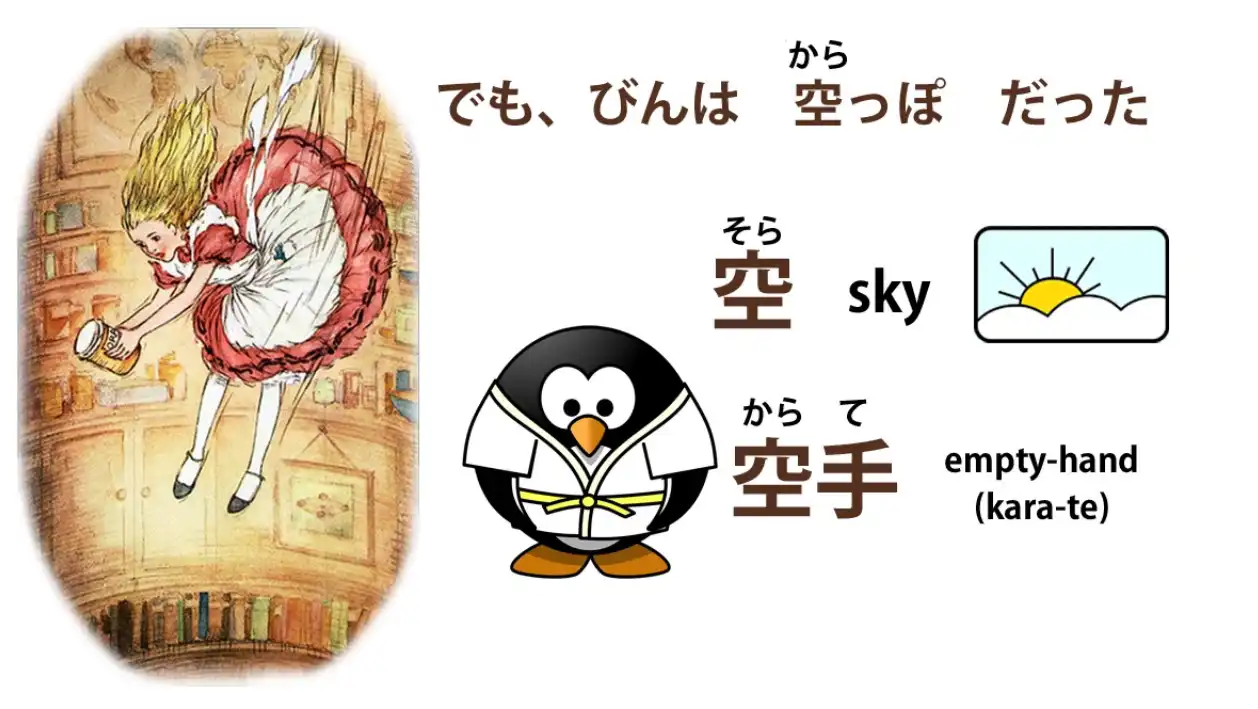
“空/から” means “empty”, and you can see it has the kanji for “sky” (空 as sky is read そら), which I guess is the biggest empty space in this world.
“空” – “empty” – is the “から” in “空手”, which is the art of fighting with empty hand, without any weapon.
“空っぽ” is a kind of strengthening of “empty”, meaning there was nothing in it, it was completely empty.
And “空っぽ” works as a noun, and generally speaking if you don’t know what kind of word a word is in Japanese, it’s most likely to be a noun.
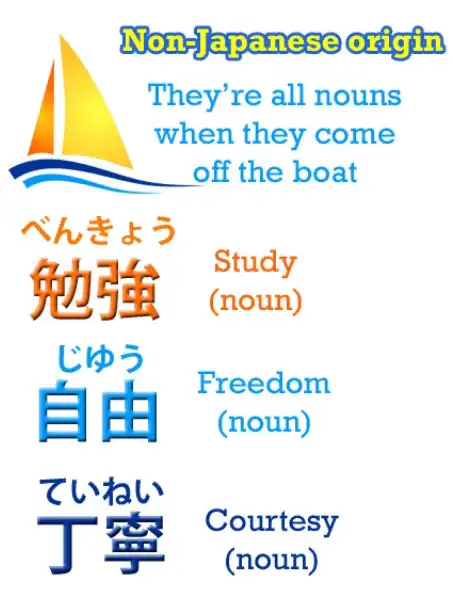
Japanese is quite a noun-centered language, because all the words that come in from other languages like Chinese, of which there are a huge amount, and English, and other languages too come in as nouns.
You can turn them into verbs by putting “する” after them;
you can turn them into adjectives with の and -な.
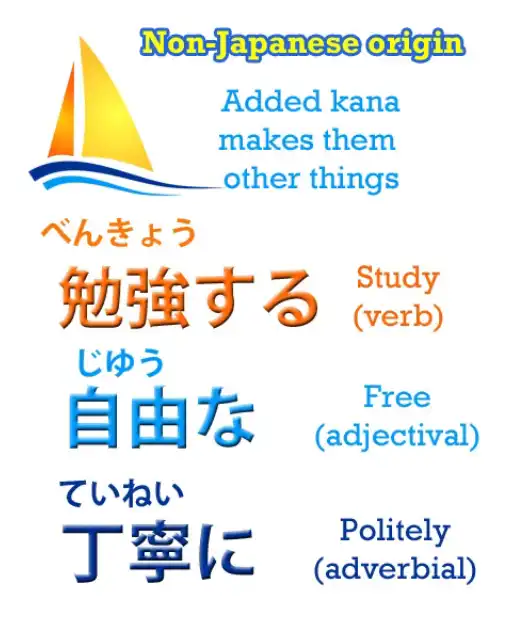
But fundamentally they’re nouns.
So it’s always a good guess when you don’t know what a word is, that it’s quite likely to be a noun.
“空っぽ” is a noun, “empty”.
“でも, びんは空っぽだった” – “However, the jar was empty”.
“アリスは空っぽのびんでも下へ落としては悪いと思った.” Here again, we’re going to see some other uses of the て-form.
でも / ても
First of all, “アリスは空っぽのびんでも”.
Now で here is the て-form of “だ” , and も, as we know, is the additive, inclusive sister of は: the additive, inclusive non-logical topic-marking particle.
So, “空っぽのびんでも”.
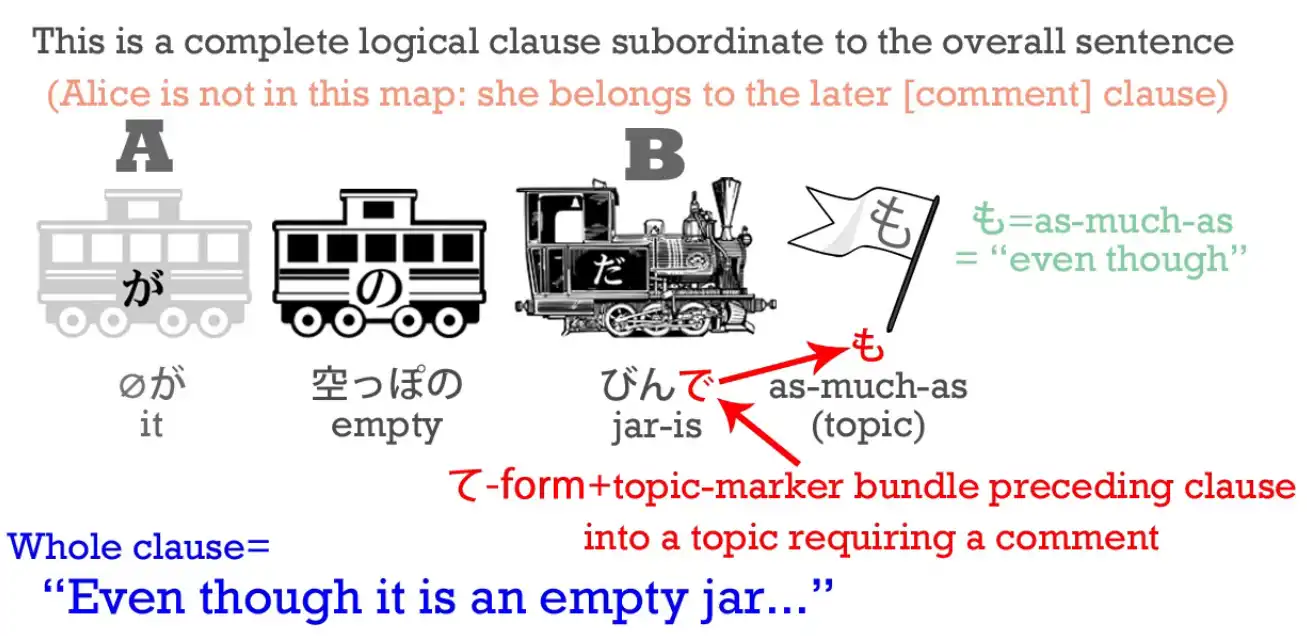
“で”, て-form of “です”, is “it was (an empty jar)” – and “でも” means “even though it was (an empty jar)”.
も can be used to mean “as much as” –”一万円もかかった” – “it took as much as 10,000 yen / cost as much as 10,000 yen”) – “でも” means something like “as much as it was (an empty jar) / even though it was (an empty jar)”.
And I’ve done a video on these uses of も that you may want to watch.
And we also use this “-ても” form when asking for permission, don’t we?
“ケーキを食べてもいい?” – “Is it all right if I eat the cake? / May I eat the cake?” Literally, “If I go as far as to eat the cake, will that be all right?” — “空っぽのびんでも下へ落としては悪いと思った”.
“落とす” means to “drop”. It’s another one of our self-move/other-move pairs.
“落ちる” means to “fall” – that’s self-move: a thing falls, by itself.
“落とす”, which ends in -す, according to the first law of self-move/other-move verbs, so it means “drop”: we don’t drop ourselves, we drop something else.
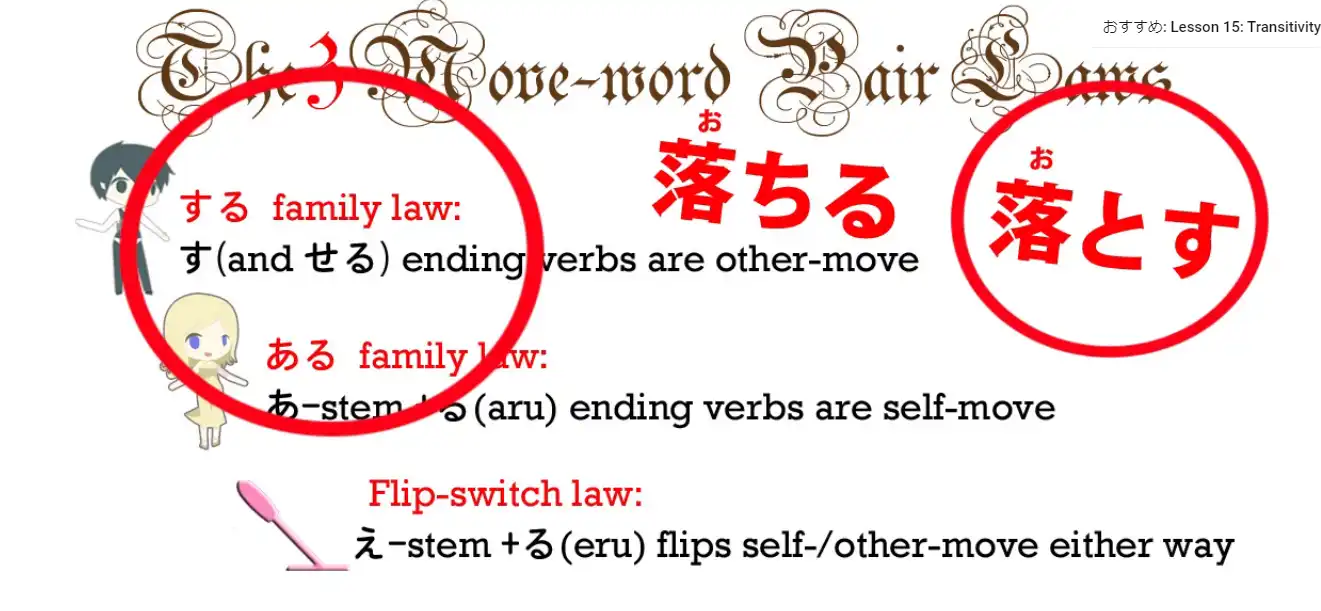
“下へ” : now, -へ, as we know, is the other targeting particle.
It’s very similar to に, but the difference is that -へ tends to refer more to the direction something is moving than to its actual target.
So in this particular case, “下に落とす” wouldn’t be right.
We’re not saying that we’re dropping it to a particular target, like “テーブルの下” – the under of the table / under the table.
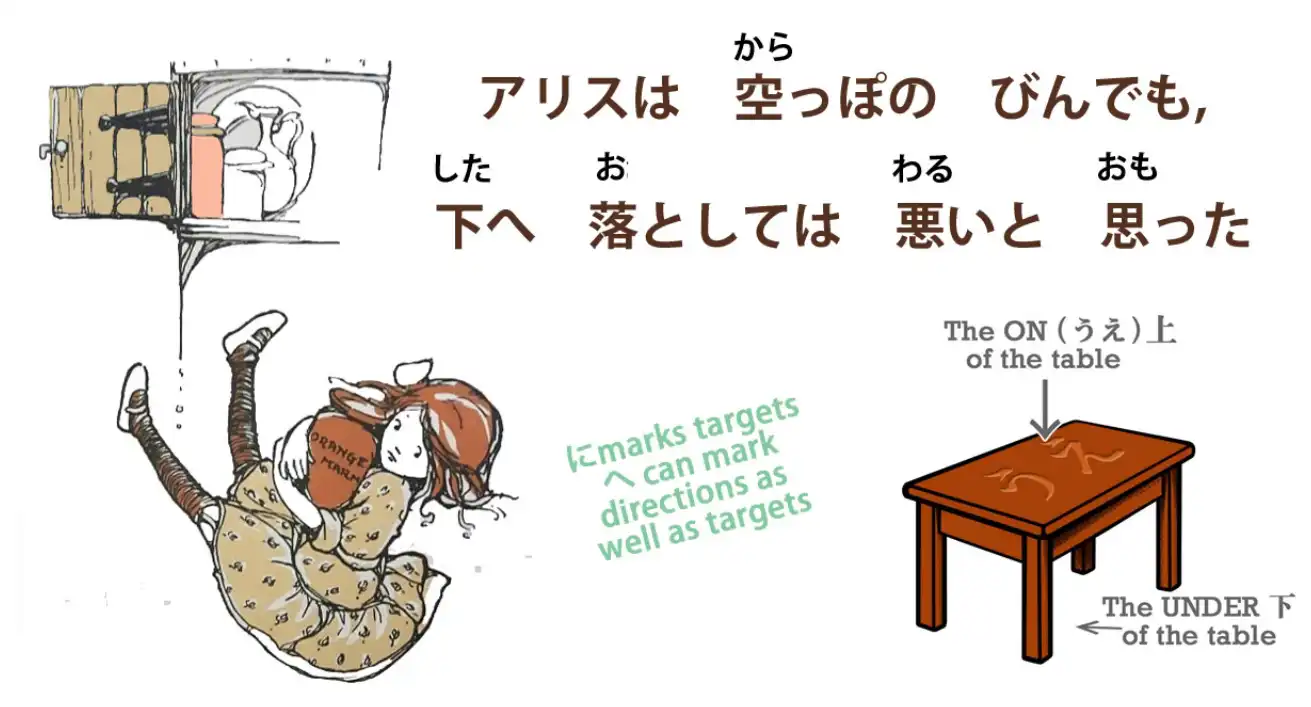
We’re just dropping it downwards, dropping it in a downward direction.
We don’t even know what’s down there.
She did try looking and she couldn’t see much.
So dropping it in the direction of down – “下へ落とす”.
Now, “したへ落としては悪い”.
Now here you see, we’ve just had て-form plus も; now we have て-form plus は.
And we know that も and は are the opposite twins.
While も is the additive, including particle, は is the subtractive, excluding particle.
So, while -ても means “as much as”, -ては means “as little as”.
ては
Now, we tend to use -ても in positive contexts – “If I do as much as this, will it be all right?” But we use -ては in negative, forbidding contexts – “don’t even do as little as that”.
So we often say, “-てはだめ” – “do that is no good / do that is bad” / if done (action), no good. In this case, it’s very similar: “落としては悪い” – “even as little as dropping it would be bad”.
The point isn’t really that dropping it is a small thing, or that eating the cake is a big thing.
The point is that we can go as far as eating the cake, that’s fine, but don’t even think about dropping it: “落としては悪い” – doing that is right out of the question.
Very often this forbidding -ては is just contracted to -ちゃ.
笑っちゃだめ!- Don’t laugh! / Even as little as a laugh is no good. (roughly) Now this pattern continues into other uses of -ては.
ては as a connector between two clauses
For example, we can use -ては as a connector between two clauses and
it implies that the second clause is unwanted or negative.
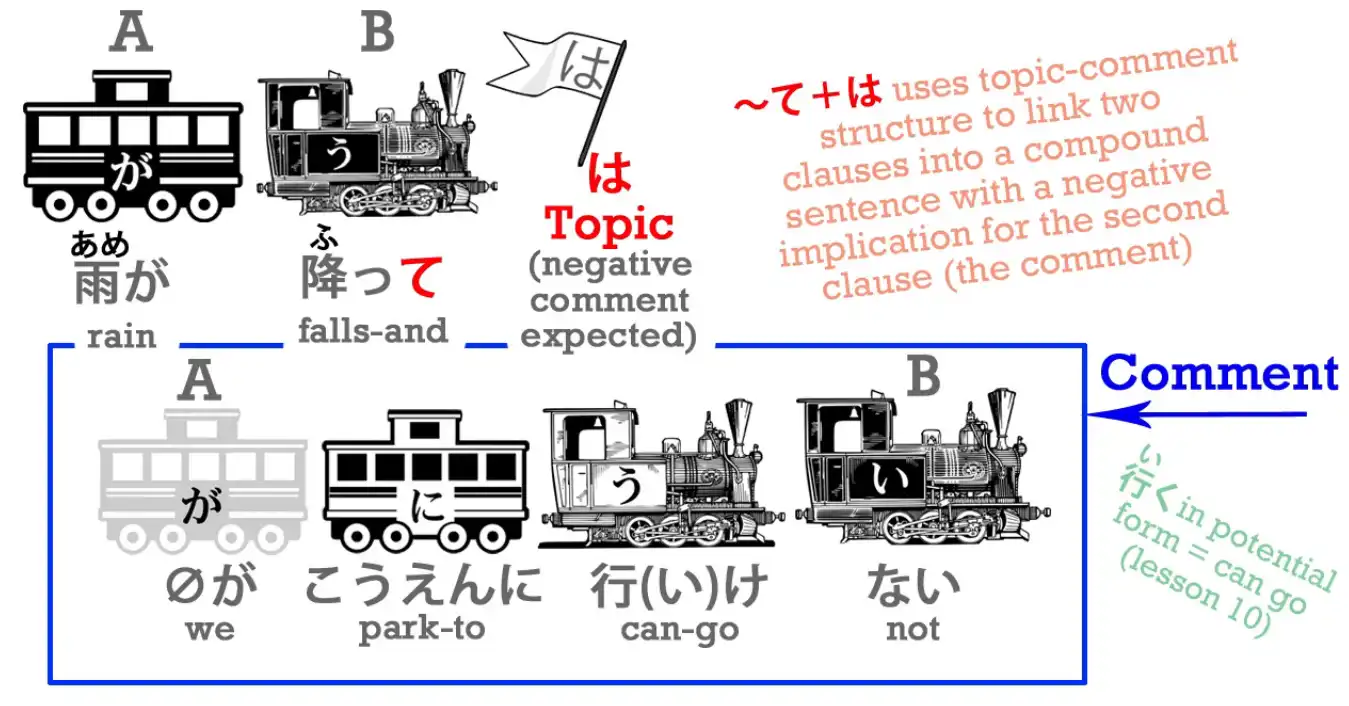
So we can say, “雨が降っては公園に行けない” – “It’s raining and we can’t go to the park”.
Now, as we know, -て can connect two sentences and if we just said, “雨が降って公園に行けない” we’re saying – “It’s raining and we can’t go to the park”.
There’s an implication that we can’t go to the park because it’s raining but there’s no suggestion of whether we’re happy or unhappy with the result.
“雨が降っては公園にいけない” is indicating that the result is unpleasant or unwanted.
And you can see that this does have its root in the restrictive quality of は.
For example, in English we might say, “Just because it’s raining, we can’t go to the park” and this is exactly what は means, doesn’t it?
Note: Bread is the direct object here (like in English).
If we say “パンを食べた”, we’re saying “I ate bread”, but if we say,
“パンは食べた” that often implies I ate bread but I didn’t eat something else.
Note: Speaking of the bread, (I) ate. (rough translation), bread is the topic of the convo I guess?
Conversely, if we say, “パンを食べなかった”, we’re saying “I didn’t eat bread”; if we say
“パンは食べなかった”, we’re often implying I didn’t eat bread, but I did eat something else.
“雨が降っては公園に行けない” originally could imply something like “Just because it’s raining, we can’t go to the park”, but now (with ては) its implication is more “Unfortunately, because it’s raining, we can’t go to the park”.
“(zeroが)妹とけんかしては母にしかられた” – “Because (I) quarrelled with my sister, I got scolded…”

And again, the は in there indicates that this is a negative result.
So it links two complete clauses with the indication that the second one follows as an unfortunate result from the first one.
So this is a continuation of the negative implication of -ては.
ても / でも as a connector
-ても, on the other hand, when it links two sentences, doesn’t indicate a negative result or a positive result.
It indicates an unexpected or contrasting result to the first.
So if we said, “雨が降っても公園に行く”, we’re saying “Even though/As much as it is raining, we’re going to the park”.
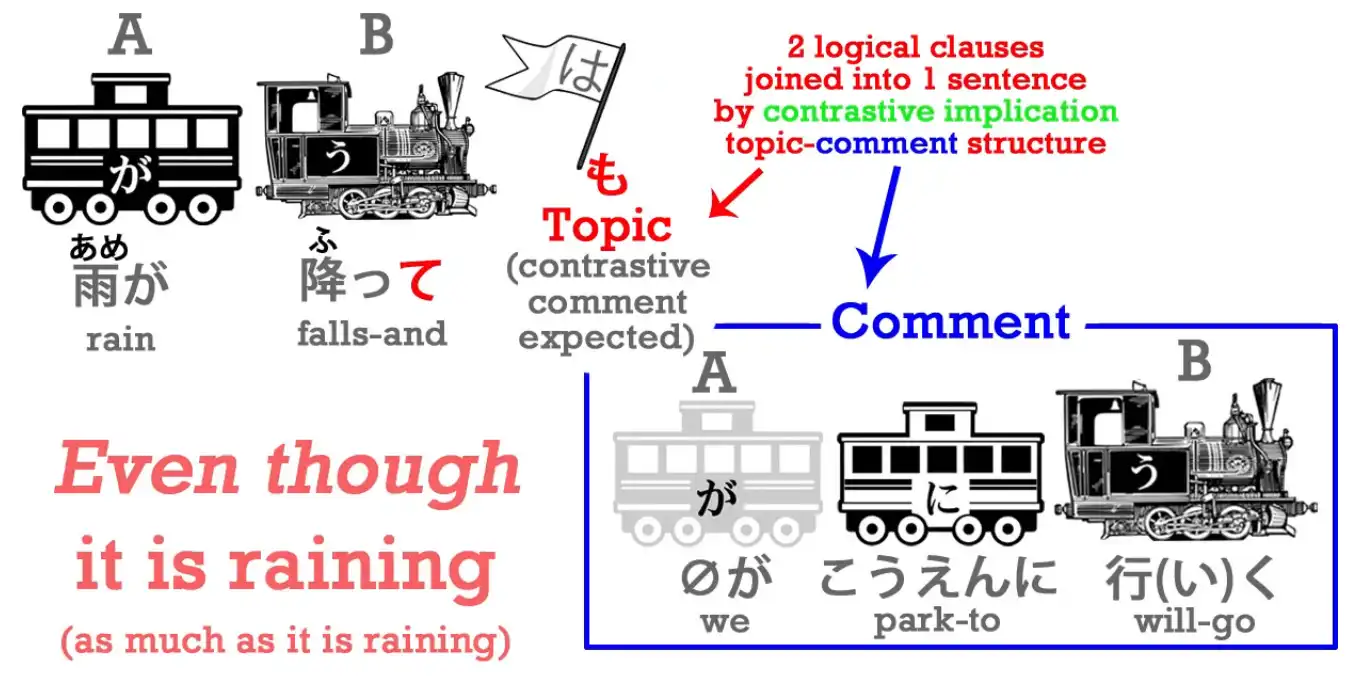
And you can see that this is essentially the same function as “でも”, which gets translated as “but”, quite correctly.
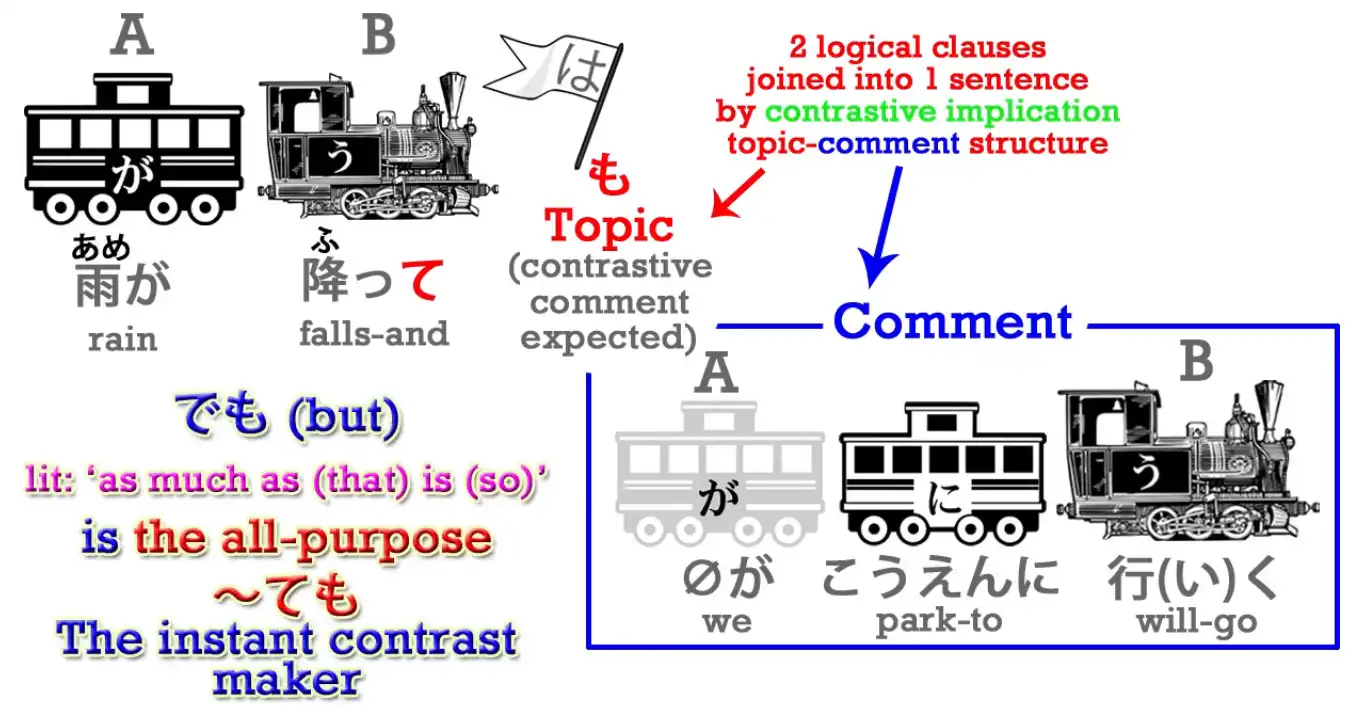
“でも” folds up whatever went before it into that “で”, which is the て-form of “だ”.
So we’re saying “that all happened” and the も then adds to it the “but” element, the “even though”, “as much as” element.
So we could also say, “雨が降るでも公園に行く”, which means almost exactly the same as “雨が降っても公園に行く”.
The difference structurally is that in “雨が降っても”, the -ても only attaches to “降る”, whereas in “雨が降るでも” the で is wrapping up the whole of the last sentence.
In practice that gives us pretty much the same meaning.
So let’s just go back to that sentence in Alice and see how it’s structured.
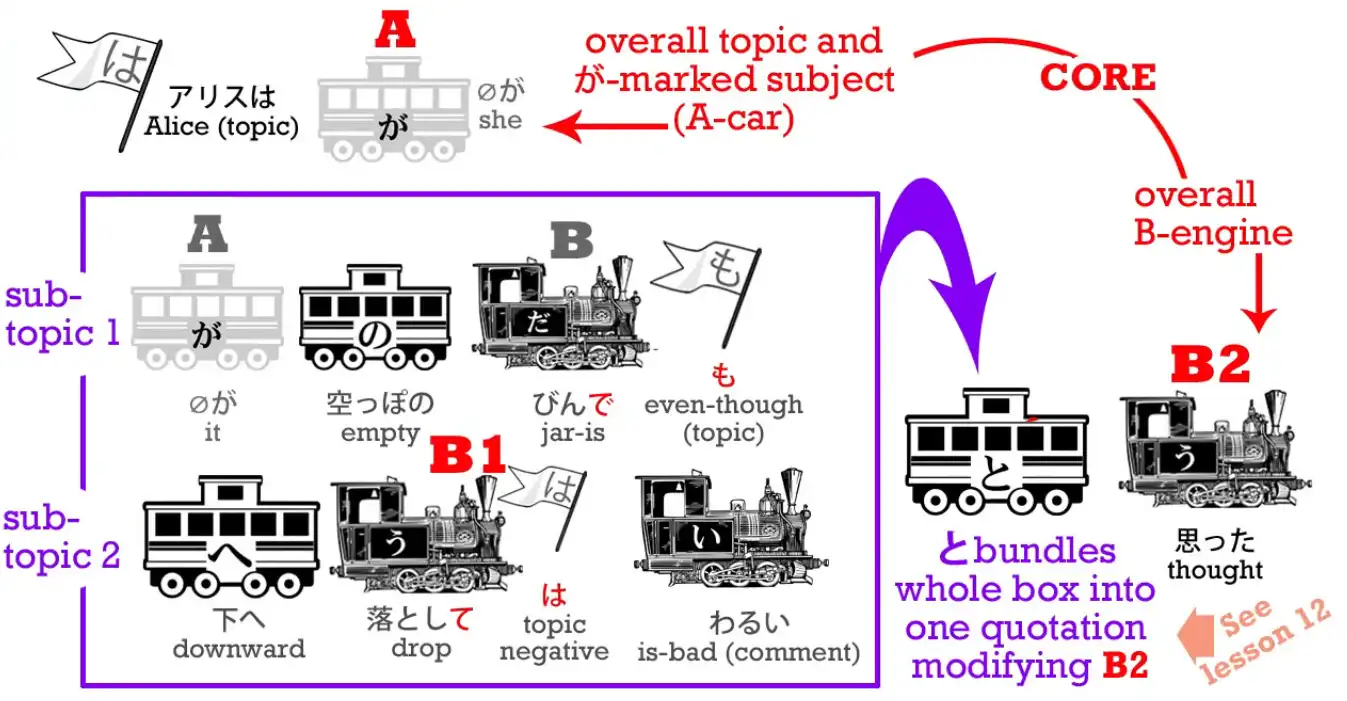
It’s a little more complex than it looks at first, but it’s very easy to understand.
And if we can understand it it gives us the key to analyzing much more complex sentences which could give us trouble in the future.
The core of the sentence is at the beginning and the end.
The whole sentence is just telling us what Alice thought.
So the core is “アリスは(zeroが)思った”.
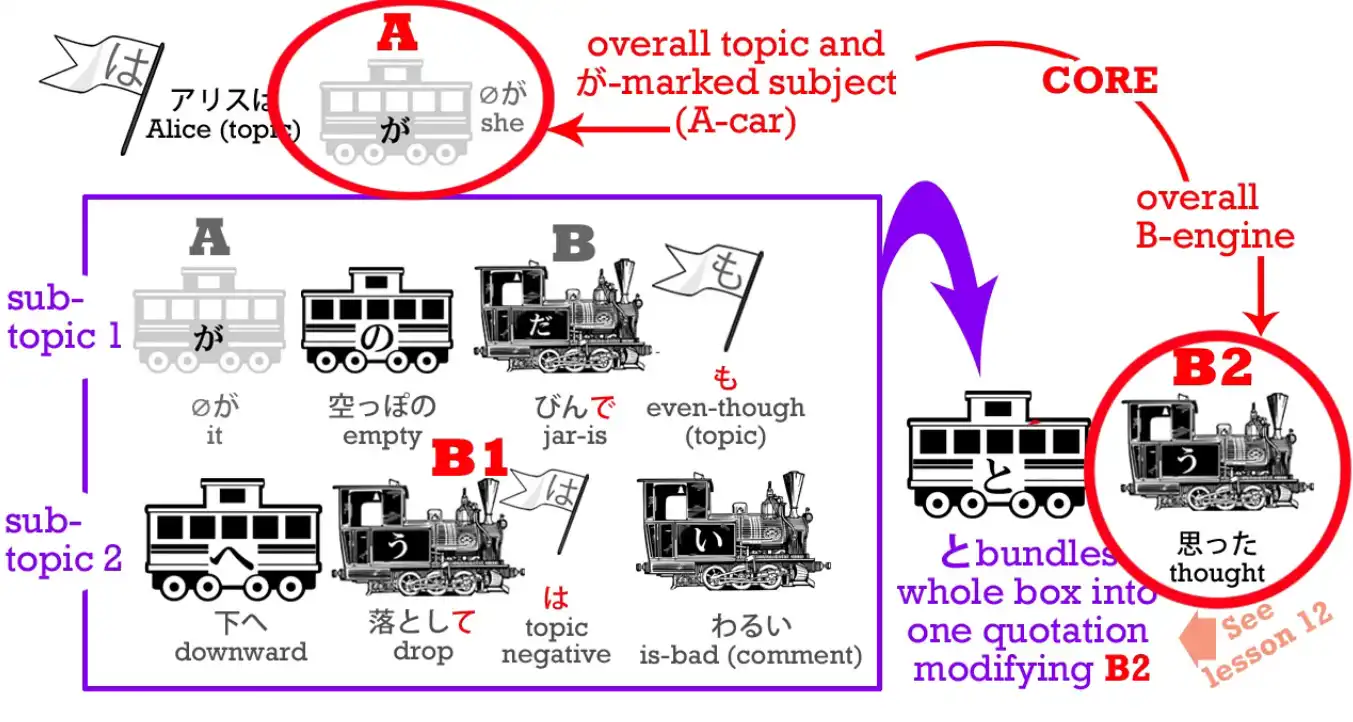
The inside of the sentence consists of two topic-comment structures.
The first topic is “even though it’s an empty bottle” (topic) - (zeroが)空っぽのびんでも and the comment on that is itself another topic-comment structure: “as for dropping it, that would be bad” - 下へ落としてはわるい — And then the whole of this double topic-comment structure is bundled up into that -と, which really means we can treat the whole thing as a kind of quasi-noun – just bundle up into that -と and attribute it to Alice as her thought. (思った) Now, of course, as we’re actually reading or looking at Japanese we don’t think of “as for” or “speaking of” every time we see a topic-comment statement, because “as for” in English is much weightier, much more cumbersome than the simple は and も in Japanese.
So what do we do?
Once again, as always, we don’t translate it into English except when we absolutely need to, to explain it or understand it.
We take the Japanese as it is in itself, and that’s how we learn Japanese as opposed to just learning about Japanese.
23. だって + だから & それから
Lesson 23: だって Datte: what it REALLY means (hint: it’s not a word) + dakara, sore kara
こんにちは。 Today we’re going to talk about “だって” and some of the issues that raises about the use of “だ” and “です”.
One of my commenters spoke about being confused by the “word” “だって” and I’m not surprised, because if you look at the Japanese-English dictionaries they tell you that “だって” means “because” and “but” and “even” and also “somebody said”, which is quite a confusing pile of meanings for one so-called word.
And I say “so-called” word because “だって” isn’t really even a word.
And the thing that never seems to get explained in dictionaries or anywhere else is what it really is, what it actually means, and therefore why it carries the range of meanings that it does.
So, let’s start off with the most basic meaning, which is the last one on the list, “somebody said”.
だって as “somebody said”
“だって” is actually simply made up of the copula “だ” plus って, which is not the て-form of anything, it’s the って which is a contraction, as we’ve talked about before (Lesson 18), of the quotation particle -と plus “いう”.
So って means “-という”, in other words, “says” a particular thing.
The -と bundles up something into a quotation and the “いう” says that somebody says it.
So it’s really as simple as that.
“(zeroが)明日は晴れだって” is simply “(zeroが)明日が晴れ…”
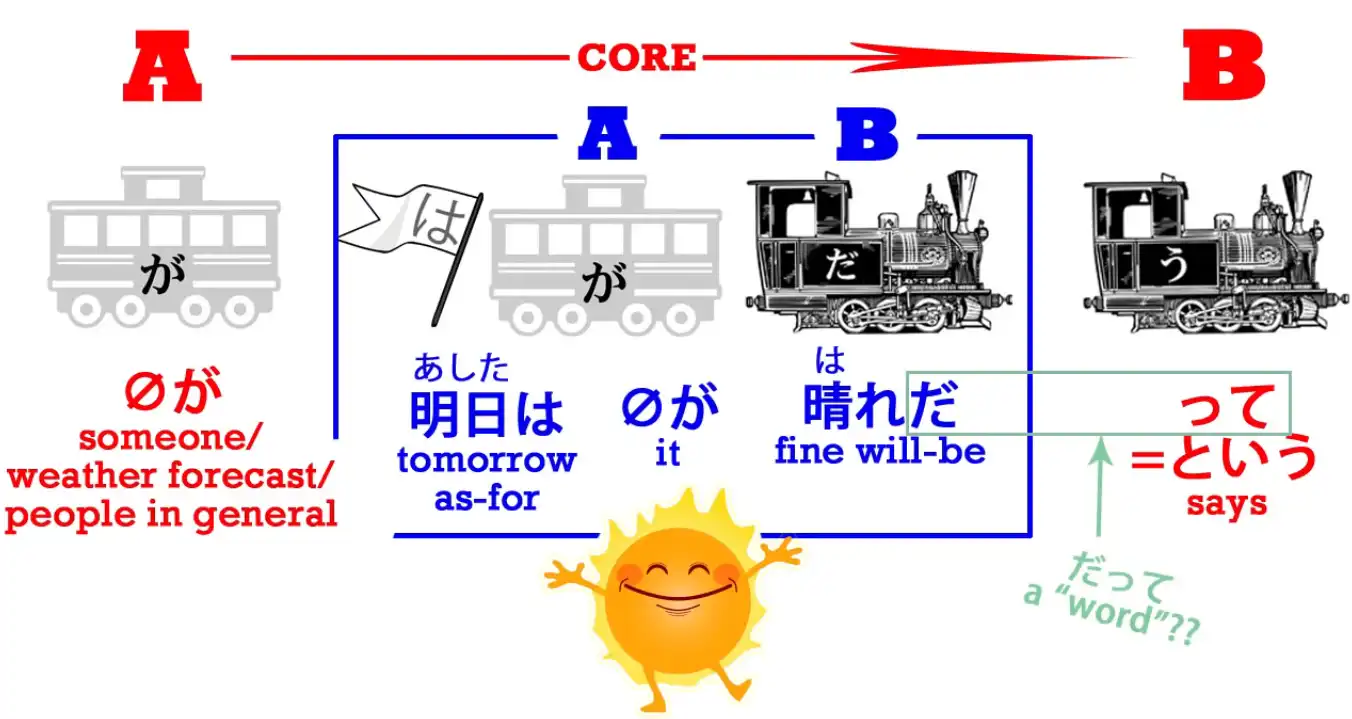
“晴れ” means “sunny” or “clear skies” – and as with most words where there’s some doubt of what kind of word they are, they usually turn out to be nouns, “晴れ” is a noun.
So, “明日は晴れだ” simply means “Tomorrow will be sunny”.
And when we add って, we’re saying, “It’s said that tomorrow will be fine”.
We might be saying that someone in particular says it or
we may just be saying “it’s said” in general –
“I hear tomorrow will be fine”, we might say in English.
“They say tomorrow will be fine.” So that’s very simple, and that’s what “だって” is: it’s “だ” plus って, the “-という” contraction.
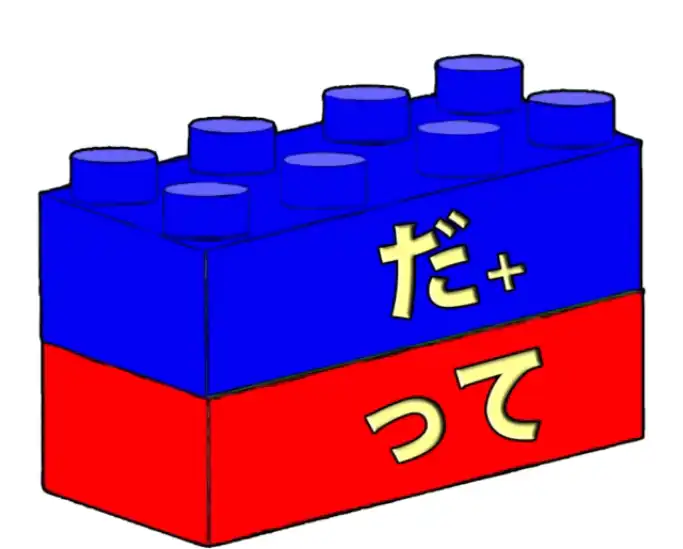
And that’s what it is in all the other cases too, so let’s see how it works.
How does it come to mean “but”?
だって as “but”
Well, to begin with let’s understand that when it’s used on its own – and it means “but” when it’s used on its own, not as the ending of a sentence as in the example we just looked at – it has a slightly childish and usually somewhat negative or argumentative feeling.
So if somebody says, “さくらがきれいだね” – “Sakura’s pretty, isn’t it?” And you say “だって頭が弱い”.
Now “頭が弱い” means literally “head is weak” – “She is not very smart”.
So it would be like saying, “But she’s not very smart”.
But what you’re actually doing here is taking the statement that the last person said and adding the copula “だ” to it.
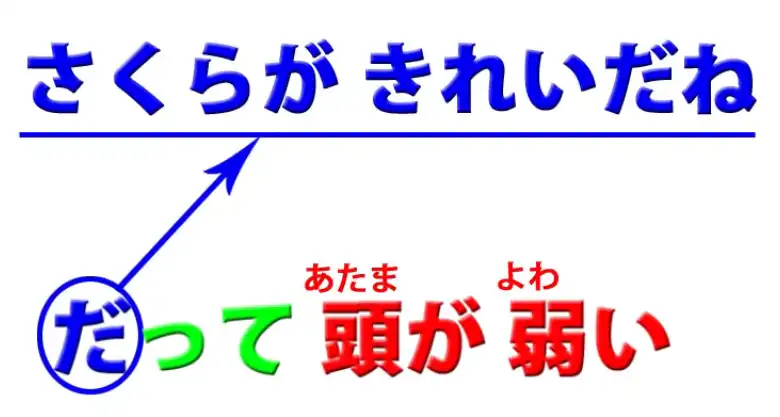
And in order to understand that let’s look for a moment at something else.
#
ですね
Very often, when we’re agreeing with something someone says, we might say “ですね”.
And literally that just means “is, isn’t it?” And how can it mean that, because really “だ” or “です” on its own doesn’t mean anything.
It has to join two other things together, and neither of them are stated here.
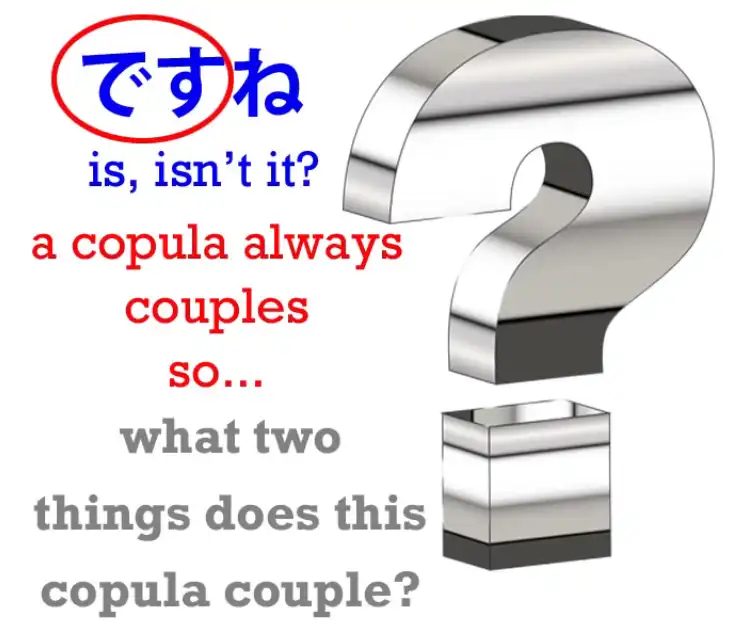
But what “です” is by implication attached to is the thing the person just said.
And what it’s joining it to is, by implication, something like “本当” or “そう” – “そうですね”.
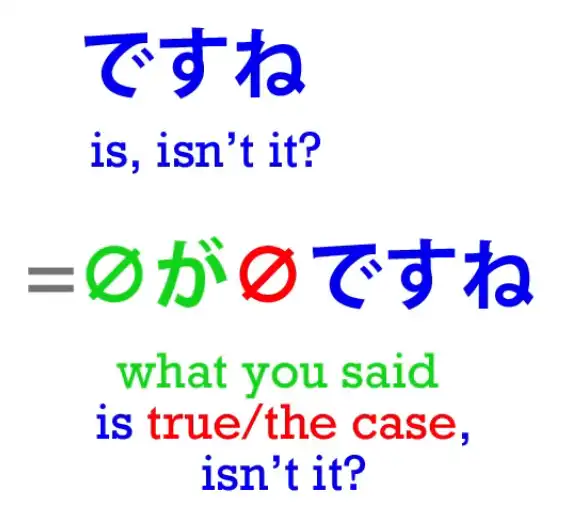
So we’re actually saying “That’s true, isn’t it?” or “That’s the case, isn’t it?” or “That’s how it is, isn’t it?”
それから & だから / ですから
We also do this when we say “だから” or “ですから”, which really means “because”.
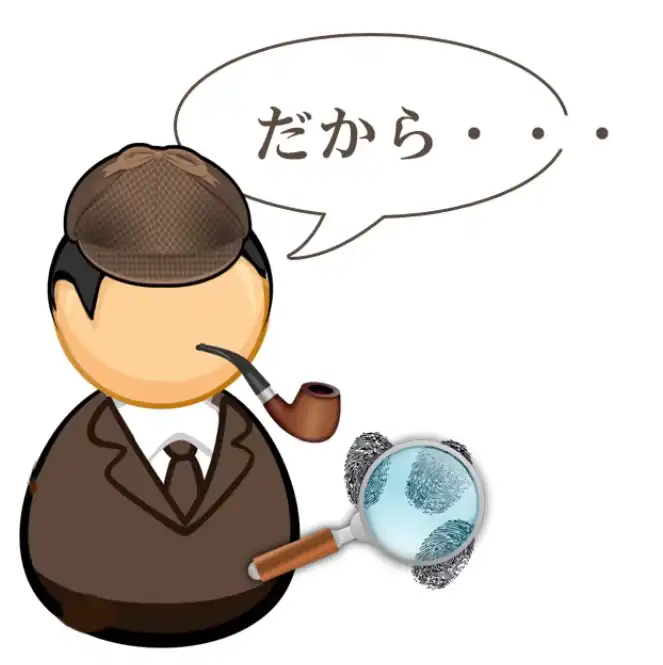
Now, we know that “から” means “because”; it means literally “from” and therefore also means “because”.
From A, B. From Fact A we can derive Fact B. From Fact A, Fact B emerges.
So, “から” – “because”.
We may be tempted sometimes to say “それから”, which is a literal translation of the English “because of that”.
But in fact “それから” doesn’t get used to mean “because of that”.
“それ” means “that” and “から” can mean ‘because”, but “それから” usually means “after that” – “から” in the more literal sense, “から” meaning “from”, and in this case “from” in point of time rather than space.
“From that forward / from that forward in time / after that”; “それから” – “after that”.
To say “because of that”, we say “ですから” or “だから”, and this is really short for “それはそうですから” or “それは本当ですから”.👇 We’re saying “because that is the case”, and if you think of it, this is more logical than what we say in English. We’re saying “because that is the case”.
“Because of that” really means literally in English “because that is the case” but we just cut it down to “because of that”, 👇 and in Japanese we just cut it down to “ですから”.
Back to だって as “but”
Now, when we understand this, we can understand “だって” in the sense of meaning “but”.
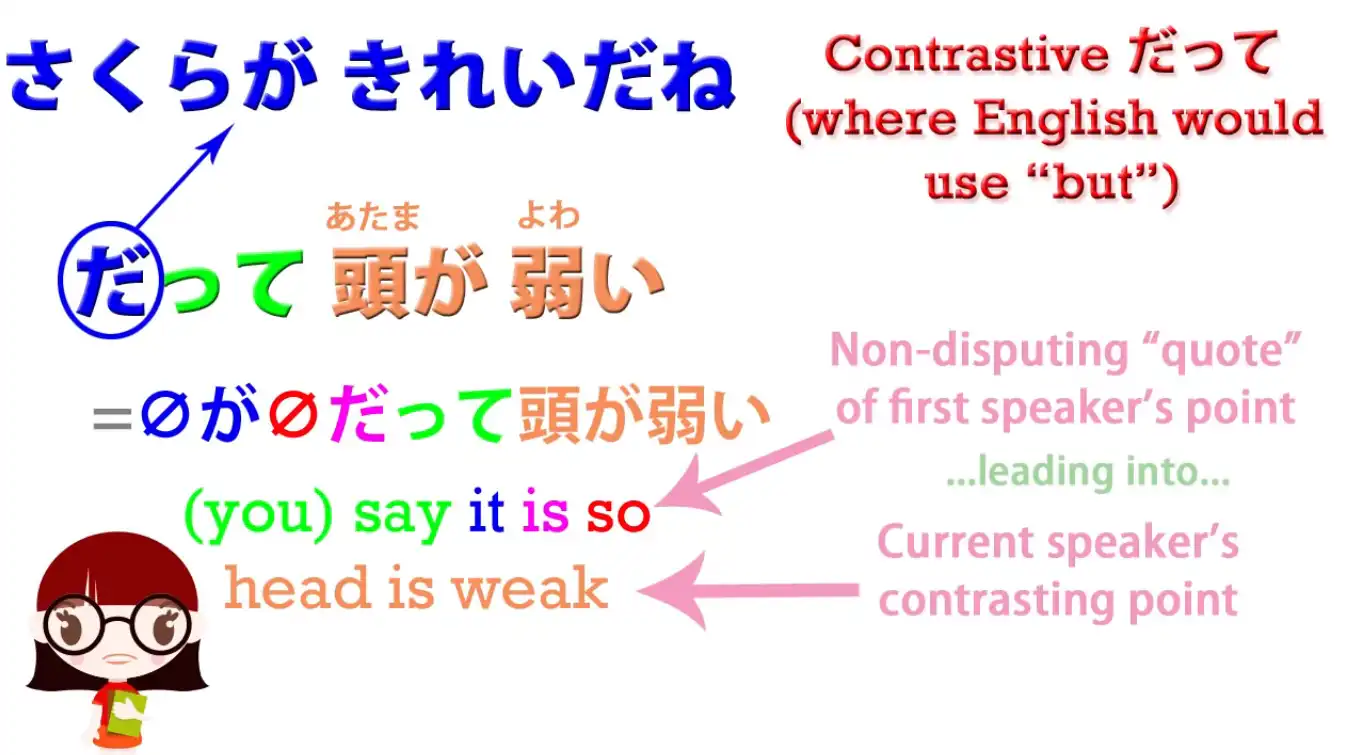
“だ” refers back to whatever it was the last person said,
and って simply states that they said it.
So, if someone says, “さくらがきれいだね” – Sakura’s pretty, isn’t it, isn’t she?” And you reply, “だって頭が弱い”.
Now, the “but” here is you saying “You said that…”.
And “だって” is a rather childish and argumentative-sounding way of saying it, so the implication is that what comes next is going to be negating what was said.
And this works in just the same way as English “but”.
If you think about it, “but” is not saying that what came before it is untrue.
In fact it is accepting that what came before it is true, but it’s then adding some information that is contrary to the impression given by that statement.
So “さくらがきれいだね” – “Sakura is pretty” – “だって…“– “You said that and I’m not disputing that that is the case, BUT – she’s not very smart”.
だって as “because”
So, how does it come to mean “because”, which in some ways seems almost opposed to “but”, almost an opposite kind of meaning?
Well, let’s notice that one thing that “but” and “because” have in common is that they accept the first statement.
“But” goes on to say something which contrasts with that statement, while still accepting it.
“Because” says something that goes on to explain that statement.
And this can be a harmonious explanation which simply gives us more information about it, but it can also be a contradictory explanation.
So, for example, if someone says, “You haven’t done much of your homework” and you reply, “Because you keep talking to me!” This could be expressed by “だって” in Japanese.
Again, what it’s really saying is “You say that and I don’t dispute it, but here’s something we can add to it which undermines the narrative that you are trying to put forward.” — So you see, it doesn’t literally mean either “but” or “because”.
What it means is, “I accept your statement and now I’m going to add something a bit argumentative”.
In English it could be translated as either “but” or “because” depending on the circumstances.
だって as “even”
So, how can it come to have the meaning of “even”?
Well, let’s understand that this is a slightly different use.
When we use it to mean “even”, we’re not using the “だ” in the way we’re using it when we say “だから” or “だって” in the senses we’ve just talked about.
In other words, we are not simply using it to refer back to the last statement.
We’re usually attaching it to something in particular within the statement we’re making.
So, if you say, “さくらはできる” – “Sakura can do that” and I say “私だってできる”, which is generally translated as “Even I can do that”, what we’re actually saying is “Say it’s me”, which means in both Japanese and English “Take the hypothesis that it’s me” or “Take the case of me in this circumstance” and we’re saying “私だってできる” “Say it’s me, I can do that”.
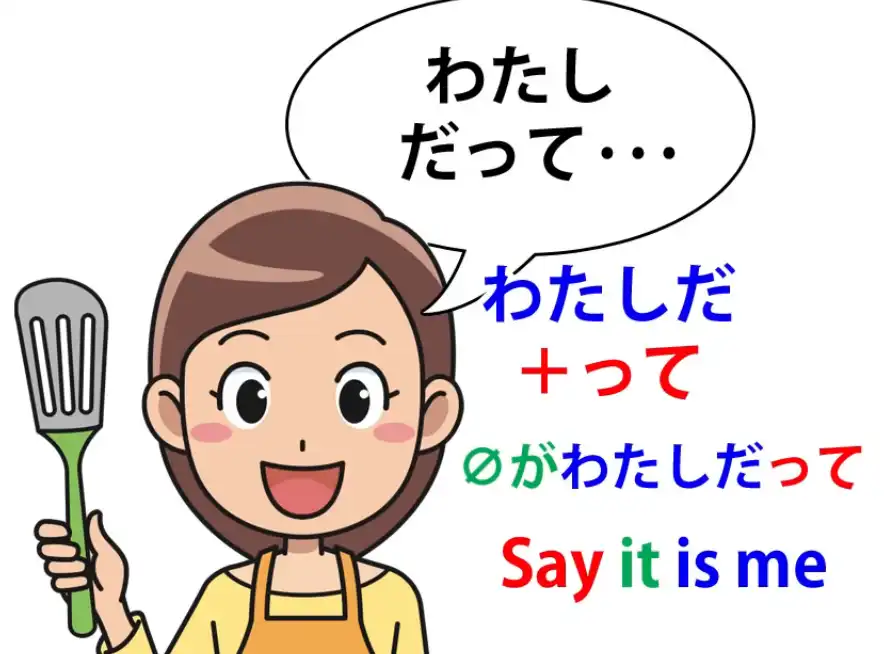
Now, this has a different implication from “私もできる”, which just means neutrally “I can do that too”.
“私だって”, because it’s very colloquial and because it’s associated with this slightly negative or contradictory implication, it means “Even I can do that”.
And it doesn’t have to be negative in the sense of contradicting anything.
Outside the context of Sakura, we might just say, “私だってホットケーキが作れる”
– “Even I can make hotcakes”.
Note: Dolly-先生 misspeaks by saying 作られる, but as a Godan potential, it should be 作れる.
*作られる is the receptive form of* 作る - we take う off, add あ stem + れる. Potential is え + る.

And in this case, we’re not saying it negatively, but that “私だって” still has the implication of “even me”.
It still has its slightly disparaging or negative ring, because what you’re saying is here “Even someone like me, even me, who can’t usually make very much, can make hotcakes”.
So I hope this makes “だって” clearer and also the ways in which “だ/です” can be used to accept and affirm previous statements made by oneself or by someone else and add something to it.
24. Hearsay & guesses - そう・そうだ・そうです
Lesson 24: Hearsay and guesses! 〜sou da, 〜sou desu - how they REALLY work.
こんにちは。 Today we’re going to talk about the helper noun “そう”, which can mean either likeness or hearsay, either that something seems like something or that we are stating not our own view or opinion but something we’ve heard.
Differentiating the two can seem difficult, especially when the textbooks give you a list of connections to nouns and verbs and various different things.
It’s much less complicated when you understand the underlying principle, what’s actually going on with “そう”.
So you don’t have to memorize a lot of different things.
So, first of all, what is “そう”?
It’s the same “そう” that we learned about recently that comes in “こう-そう-ああ-どう”.
(Lesson 20)
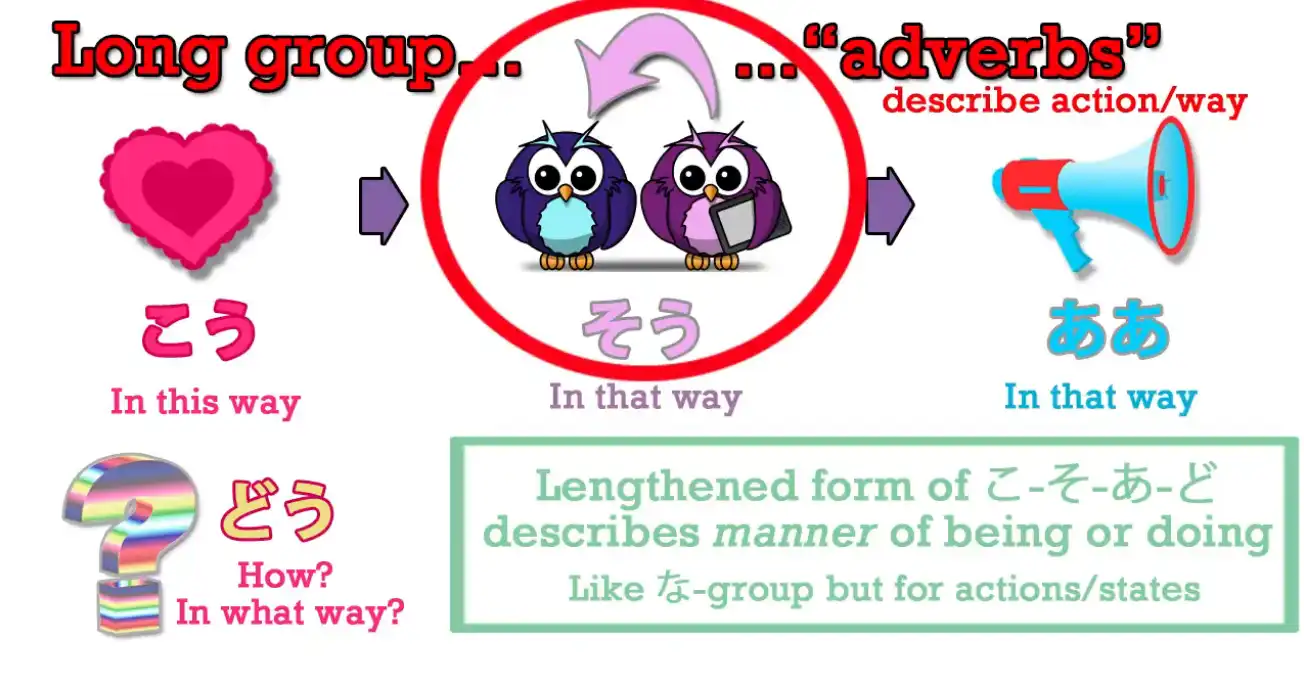
So “そう” means “like that”, which makes it of course a very good candidate
for describing something seeming like something.
そう as “seeming like something”
When it’s used in that way, we use it by attaching it to any one of the three engines.
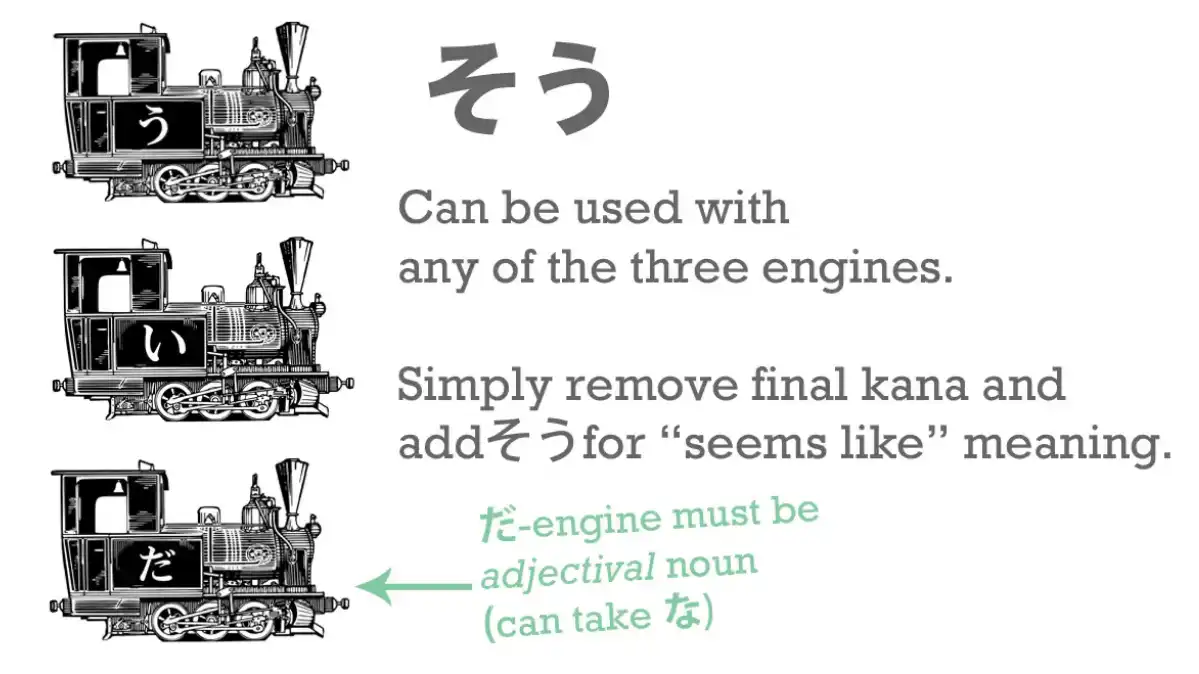
And remember, as we’ve learned before, that each of the three engines can be moved behind other cars to turn them into adjectives. (Lesson 6) Now, once -そう has been attached to an engine the engine becomes a new adjectival noun.
How do we attach them?
We do the same thing in every case.
We take the last kana from the engine.
That is the kana that makes it what it is, its active part.
So we take the “だ” from the だ-engine - the “だ” or the “な” from the だ / な-engine.
We take the “い” from the い-engine.
And from the verb engine, we take that last う-row kana.
And we just put -そう onto them, so it’s a very simple connection.
#
With adjectival nouns
And the important thing to remember here is in the case of nouns we can’t do it with an ordinary, regular noun.
We can only do it with an adjectival noun.
In other words, if an adjectival noun is an adjectival noun to start with, we can turn it into a different adjectival noun with -そう.
If it wasn’t an adjectival noun to start with, it can’t be turned into an adjectival noun.
So if we take adjectival nouns like “元気” (“lively” or “healthy”) and “静か” (which is “quiet”) - if we say “静かだ” we mean “is quiet” - if we say “元気だ” we mean “is lively or healthy”.
If we say “元気な学生”, we’re saying “a lively or healthy-is student”.
Now if we take off that “だ” or “な” and put on -そう - and we say “元気そうな学生”, we’re saying “a lively looking-is student/ a lively seeming-is student”.
Similarly, if we say “静かな女の子”, we’re saying “a quiet-is girl”.
If we take off that -な or だ and put on -そう and say “静かそうな女の子”, we’re saying “a quiet-seeming-is girl/ a quiet-looking-is girl”.
So that’s really very simple, isn’t it?
Note: As shown above, we take off the だ / な from the OG adjectival noun, but then when we connect
-そう after it, we then still use the だ / な, but it instead comes from the そう part.
It may be framed a bit confusingly, considering the examples Dolly gives still contain だ / な.
So just in case, to avoid possible confusion…
Because apparently そう is an adjectival noun itself, so the だ / な probably attaches to そう.
Here, 静か is an adjectival noun to which is attached そう, another adjectival noun, that seems to serve as a suffix to which is attached な to connect it with 女. So 静かそうな is one unit.
This would align with Dolly’s orange comment just below about copula being used with そう.
This is just my limited understanding, so take this with a grain of salt. Contact me if I am wrong.
#
With adjectives
With adjectives that end in “い”, we simply take off that -い and put -そう onto it.
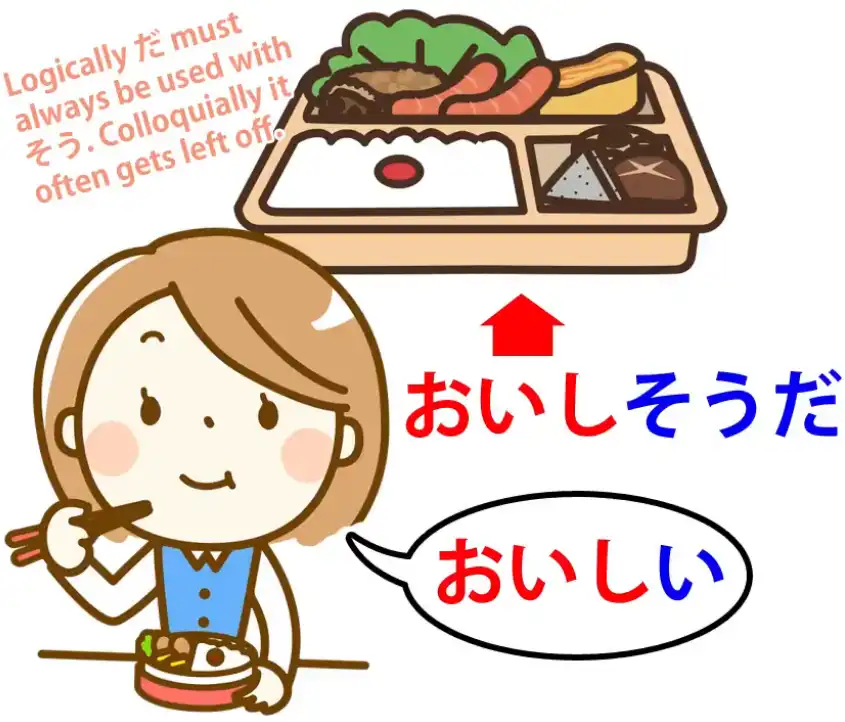
Note: Do carefully note that orange comment above on the picture with そう + だ.
*So, if we take “面白い” (“interesting-is” or “amusing-is”), “おいしい” (“delicious-is*”),
we just cut off the -い and add -そう.
So, “面白い” means “interesting-is” or “amusing-is”, “面白そう” means “seems interesting / seems amusing”.
“おいしい” means “delicious / tasty-is”, “おいしそう” means it “looks delicious”, it “looks tasty”.
And this is an important one to remember because, as we’ve mentioned before, Japanese is a lot stricter than English in restricting us to saying only things that we can actually know for ourselves.
So unless you’ve tasted something, you can’t say it’s “おいしい”.
Unless you’ve done something, you can’t say it’s “面白い” - interesting or amusing.
Logically this perhaps ought to be so in English, but Japanese is a lot stricter about it.
So, it’s important to know things like “面白そう”, “おいしそう” if we haven’t actually tasted the food, done the activity or whatever.
#
With verbs
Now, with a verb we cut off the う-row kana.
Obviously, as always, in the case of ichidan verbs that’s all we do.
And in the case of godan verbs we use the い-stem.
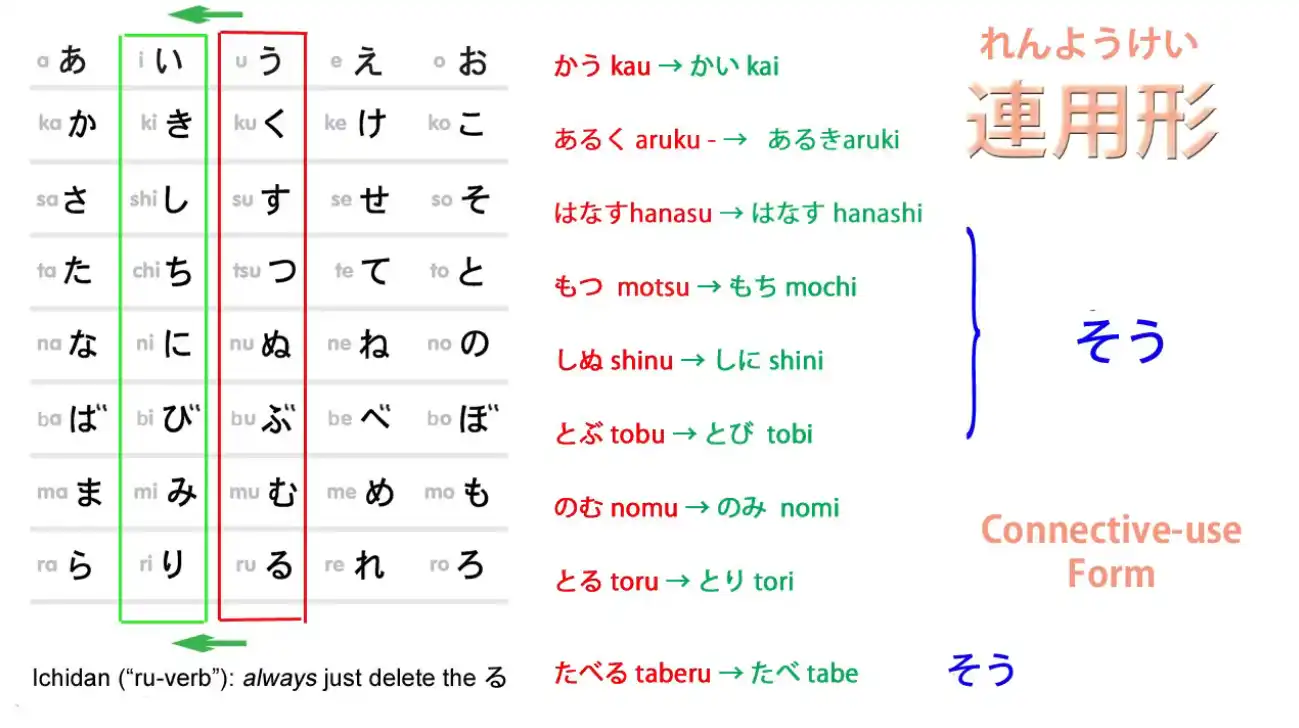
And the い-stem is what you might call the pure stem of a verb.
In Japanese it’s called “れんようけい/連用形”, which means “connective-use form”.
And that might sound strange because we know that all four stems actually connect things, but while the other three have particular uses, the “れんようけい/連用形”, the い-stem, as well as its particular uses, can be used to connect almost anything.
It can connect verbs to nouns to make new nouns; it can link verbs to verbs to make new verbs; and so on.
So, we connect -そう to the “連用形”, the い-stem, the general-purpose connecting stem of verbs.
What do they mean?
Well, generally speaking, they mean that something appears to be about to happen.
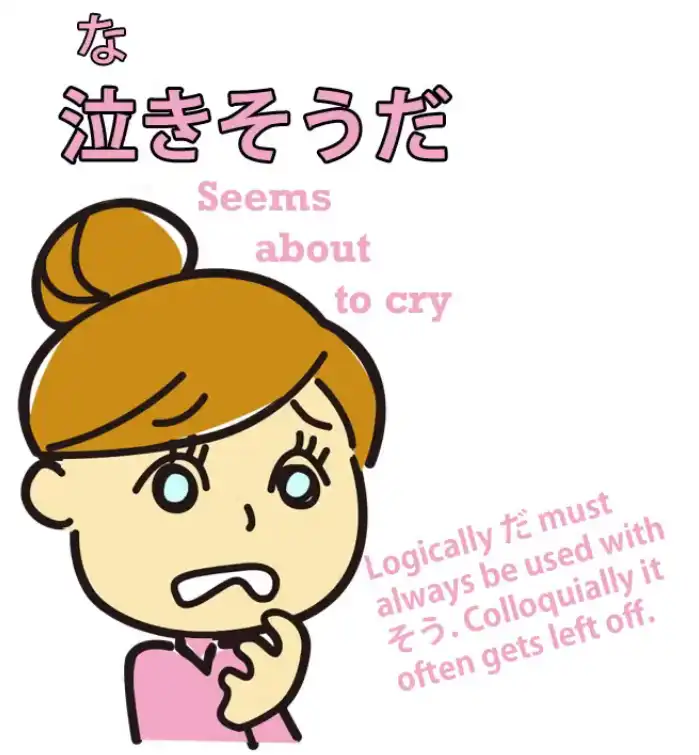
Note: Once again, the reminder comment about だ being used after そう. So, “雨が降りそうだ” means “it looks as if it’s about to rain”.
“子どもが泣きそう(だ)” means “The child looks as if she’s about to cry / seems as if she’s about to cry.”
And if you see that’s quite similar to what we might say in English:
“It looks like rain / it seems as if it’s about to rain.”
So these usages are really quite straightforward.
そう as hearsay
Now what do we do when we’re using “そう” to mean hearsay, to mean “I heard something - I’m not reporting my own observation or feeling, I’m reporting what I got at second-hand from somebody else”?
Some people would say that this is also a suffix and we have to observe different rules for applying it, but the truth is that it is not a suffix.
The -そう we’ve just discussed is a suffix.
We join it to other words in order to form a new word.
Whatever the word was to start with, once -そう is attached it becomes an adjectival noun.
Note: Seems to point to my previous idea above… — This is not what happens when we’re talking about hearsay.
When we’re talking about hearsay, we use “そうだ” or “そうです” after the entire, complete sentence.
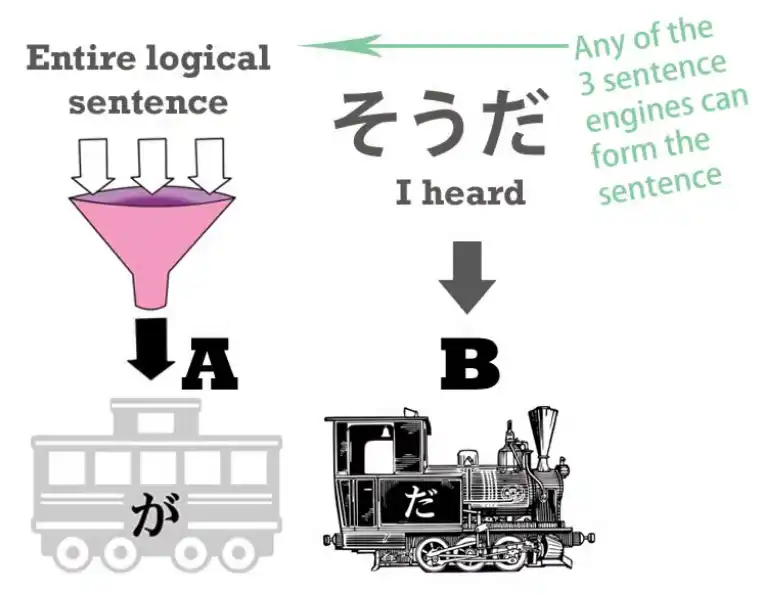
So the complete sentence becomes the A-car of the sentence and the “そうだ” becomes the B-engine.
And the content of the sentence is now subordinate.
So let’s take an example:
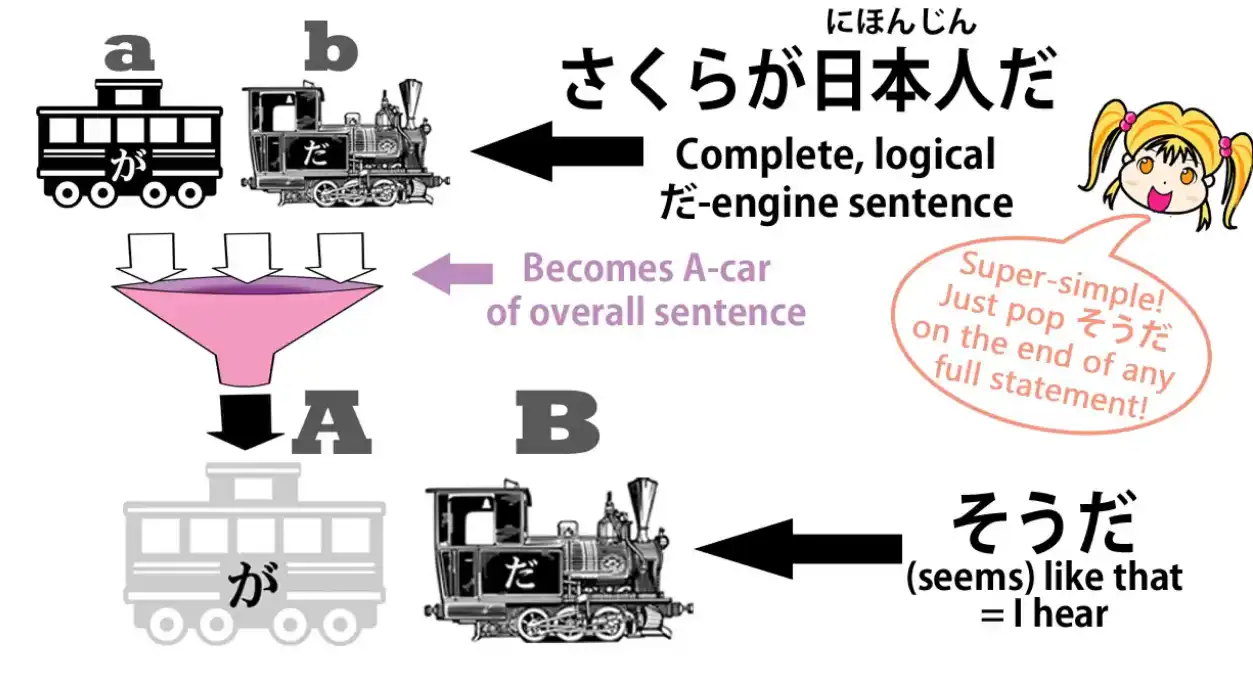
“さくらが日本人だそうだ”.
What we’re saying here is “I’ve heard that Sakura is a Japanese person”.
So, “Sakura is a Japanese person” is all taken together as Car A, the subject of the sentence, and then what we’re saying about it is that we’ve heard it.
Why do we use “そうだ/そうです” to mean “I’ve heard”?

Well, if you think about it, it’s similar to what we might say in English.
Suppose we say “Why isn’t that car in the street any more?” and you say “It seems some masked people came and drove it away”.
Now, when you say that, what that means is that somebody told you that, doesn’t it?
If you’d seen it yourself you’d have said “Some masked people came and drove it away”, but when you say “It seems some masked people came and drove it away”, what you’re saying is “Well, that’s the story I’ve heard”. Note: I would check this comment too… And it’s the same in Japanese only a little more systematically.
“そうだ/そうです” when added as the B-engine to an entire, completed sentence is always saying that this is what we’ve heard, this is the information we have, for what it’s worth.
25. らしい vs そうだ / そうです + っぽい (ppoi)
Lesson 25: らしい Rashii made rational!. Rashii vs sou desu. らしい vs そうです. っぽい ppoi
こんにちは。 Last week (Lesson 24) we talked about the helper adjectival noun “そう” and how we use it to express what something might be like, our impression of something, and hearsay.
Today we’re going to talk about other ways of expressing a similar range of ideas, how they work, how they are similar, and how they are different.
らしい
So, we’re going to look at “らしい”, which is a helper adjective.
And this is an adjective ending in -しい, which is what we can call a subclass of adjectives.
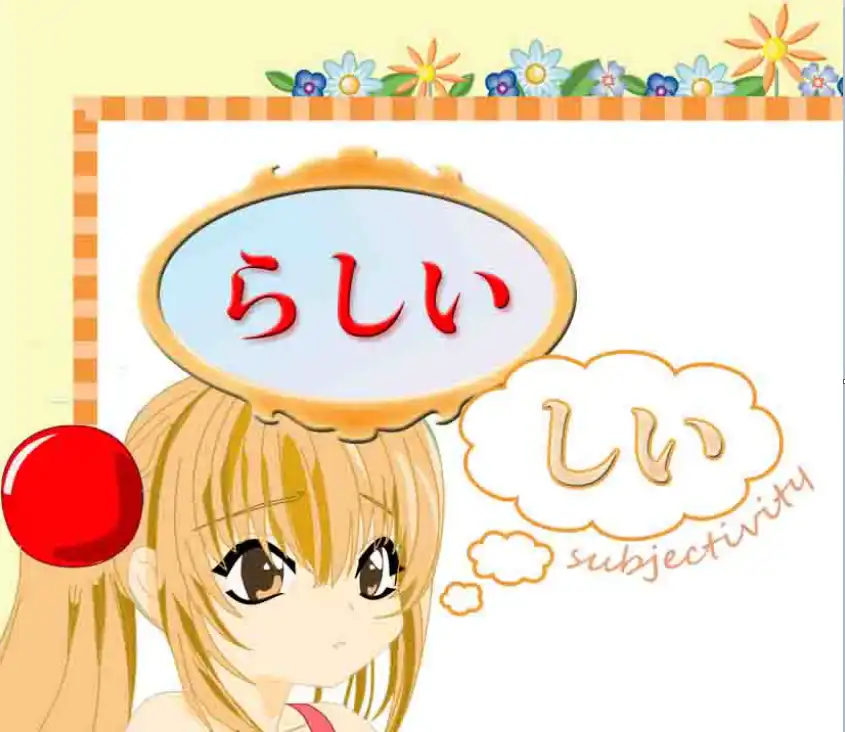
All real adjectives, as you know, end in -い.
So-called adjectives that don’t end in -い are in fact adjectival nouns. (such as きれい/綺麗) But a group of those い-ending adjectives ends with -しい. (I guess some of the “real” adj.) As you see, it’s still ending in -い but it also has -し, so it’s -しい.
And the characteristic of this group of adjectives is that on the whole they express subjectivities.
That is to say, not exact measurable qualities but things which are to some extent dependent upon human or other sentient beings’ impression of them.
So, for example, “かな/悲しい” is “sad”; “うれ/嬉しい” is “happy”.
“むずか/難しい” means “difficult” and while this seems somewhat more objective than “嬉しい” and “悲しい”, it’s still in some way a subjectivity because difficulty is relative to particular individuals.
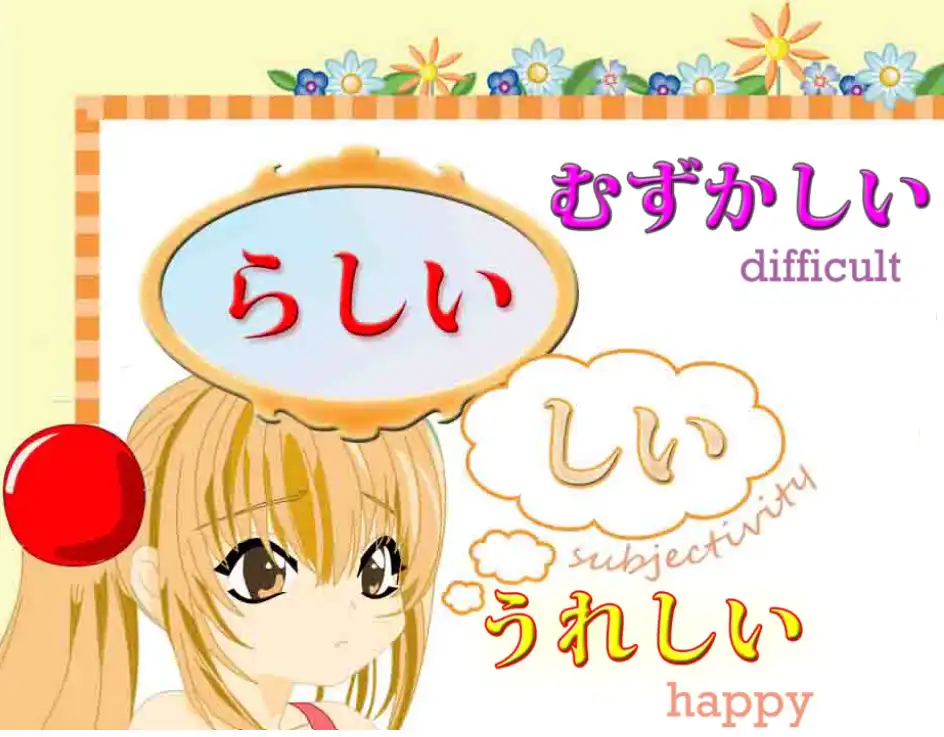
Whether you find a thing difficult or easy depends to a large extent on who you are and what your abilities are.
So this, as we’ll see, gives us an indication of what kind of a word this is and how it differs from
“そう”.
Its use is very simple.
Like “そう” it can be attached either to an individual word or to a complete logical clause or sentence.
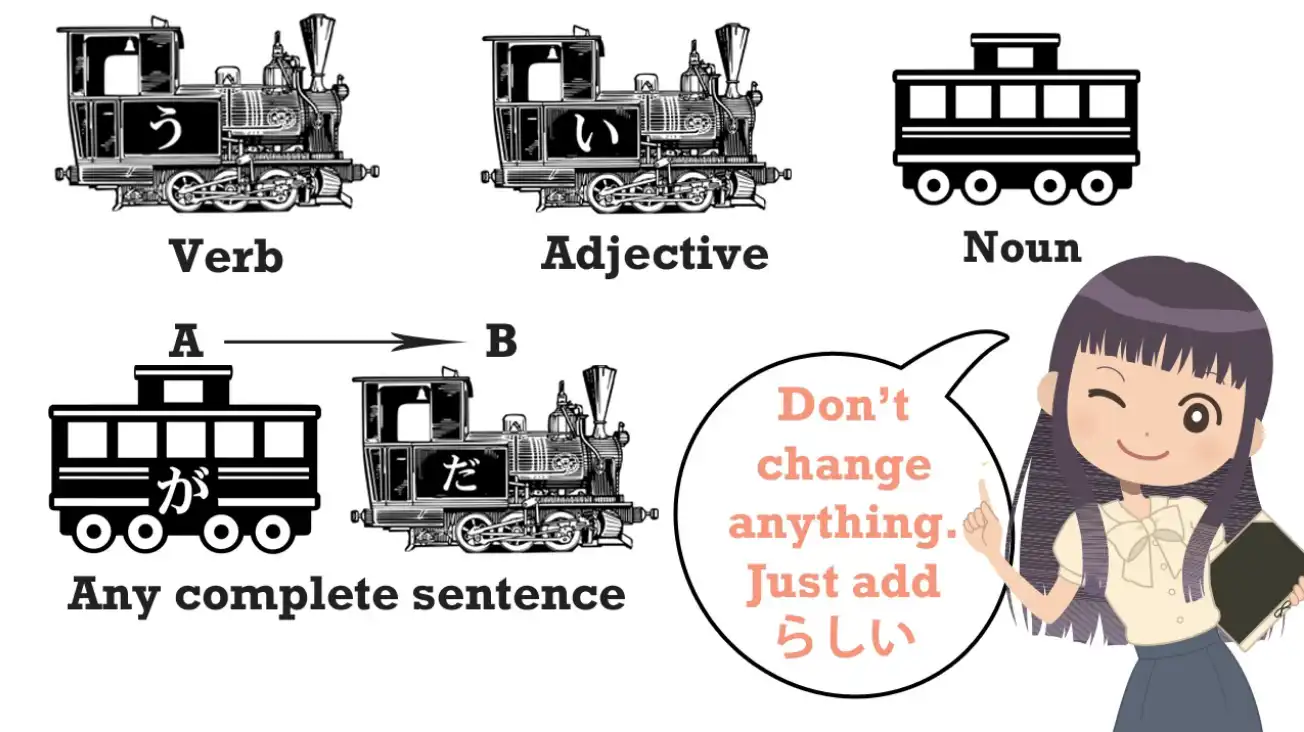
And the attachment is absolutely simple, because we never do anything at all except just put “らしい” after the word or after the completed logical clause.
We don’t change anything, we don’t do anything, so it really couldn’t be easier.
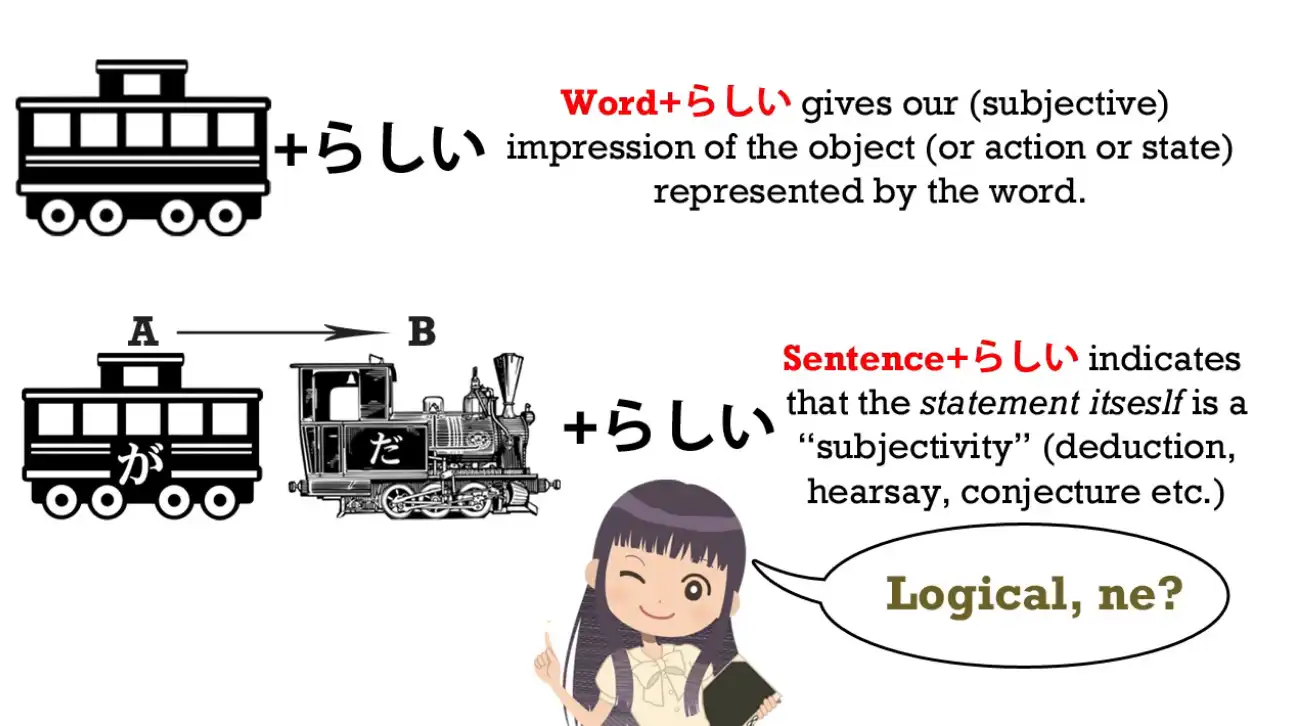
Now, as with “そう”, if we put it after a single word we are talking about our impressions of that particular object.
If we put it after a completed clause, we are saying “it seems to be that way”.
Difference between らしい & そうだ/です
However, there is a difference.
If we put “そうだ” after a completed clause, as you know, we complete the clause, if necessary with another “だ”, and that usage means that we’ve heard that that sentence is the case.
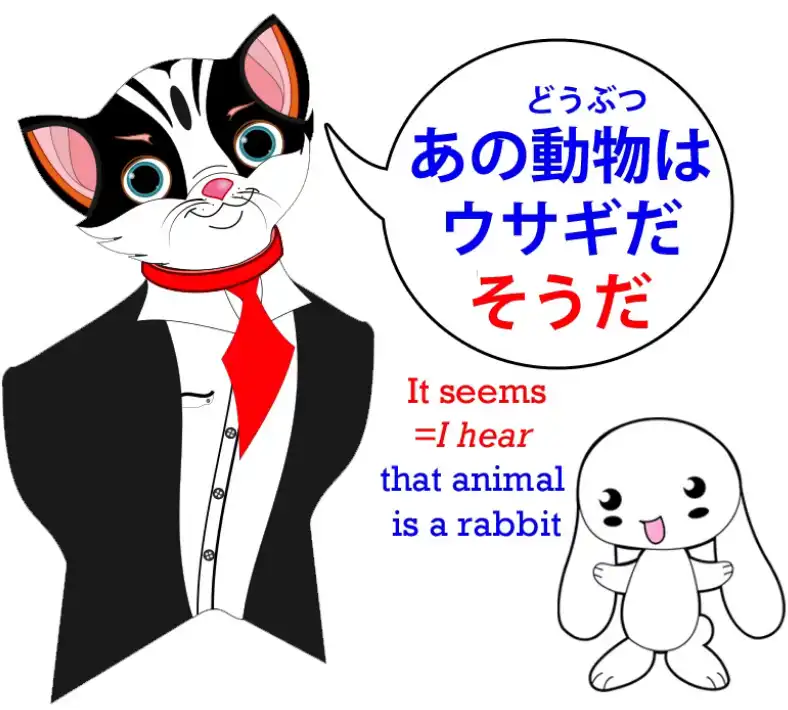
#
らしい vs そうだ - after a complete clause
So if we say, “あの動物はウサギだそうだ”, we’re saying “I’ve heard that that animal is a rabbit”.
Now, if we say, “あの動物はウサギだらしい”, we’re saying “It seems that animal is a rabbit”.
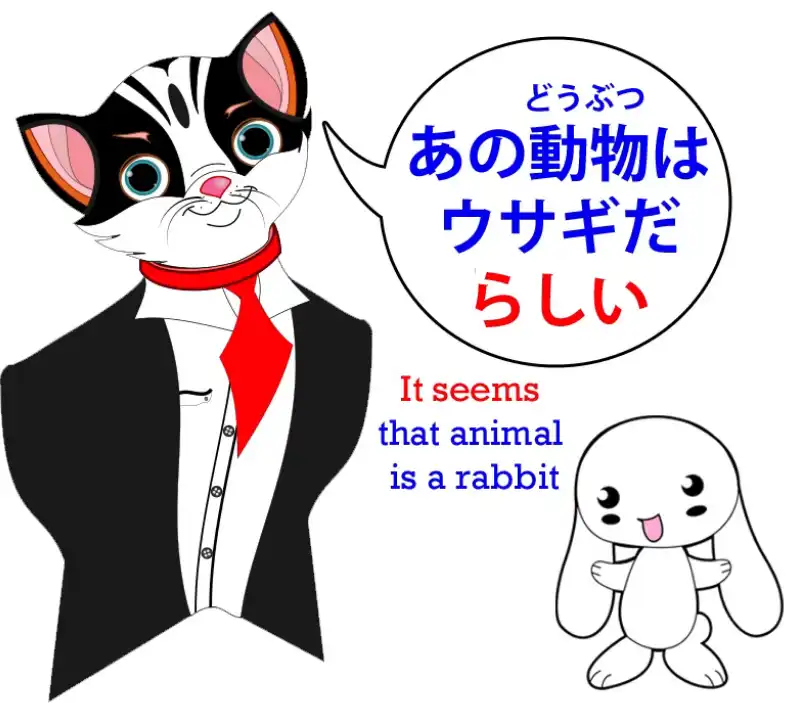
Now, that can mean the same thing as “ウサギだそうだ”.
It can mean “I’ve heard that it’s a rabbit”, and sometimes the textbooks get quite convoluted and confusing about whether “らしい” actually means “I’ve heard” or whether it means “it seems”, but it’s very simple if you understand exactly what it’s doing.
What it’s doing is actually saying “it appears” or “it seems”, and this has exactly the same ambiguity and lack of ambiguity as that has in English.
So let’s take the case of this mysterious animal.
Suppose I’m looking at it with a group of people and afterwards you come up to me and say, “What is that animal?” and I say, “ウサギだらしい”.
Now, I’ve given a complete sentence with “らしい” on the end, and the natural meaning here would be “I heard from those people that it was a rabbit.” — Now, you see this is just the same as if in English I say, “It appears that it’s a rabbit.” Now, you would take me, in English and in Japanese, to be saying, “From what I heard (from those people), it’s a rabbit”.
Now, take a different scenario.
The rabbit’s gone and I’m examining its footprints and you come up to me and say, “What was that animal?” and I say, “ウサギだったらしい”.
Again, “It appears that it was a rabbit”, or “It seems that it was a rabbit.”

In this case, you would probably conclude from what I’m doing that by saying “It appears it was a rabbit”, I’m saying, “From the evidence I’m looking at here, the appearances are that it’s a rabbit.” So you see, there’s nothing particularly grammatical or complicated about this.
It’s just the same as in English if you said “It appears that it’s a rabbit” or “It seems that it’s a rabbit”, it depends on context whether that implies that that’s the information you’ve heard or that that’s the conclusion you’re drawing from your observations.
If you want to be completely unambiguous that you’re talking about hearsay,
that you’re talking about something you heard from other people, then you say,
“ウサギだったそうだ”.
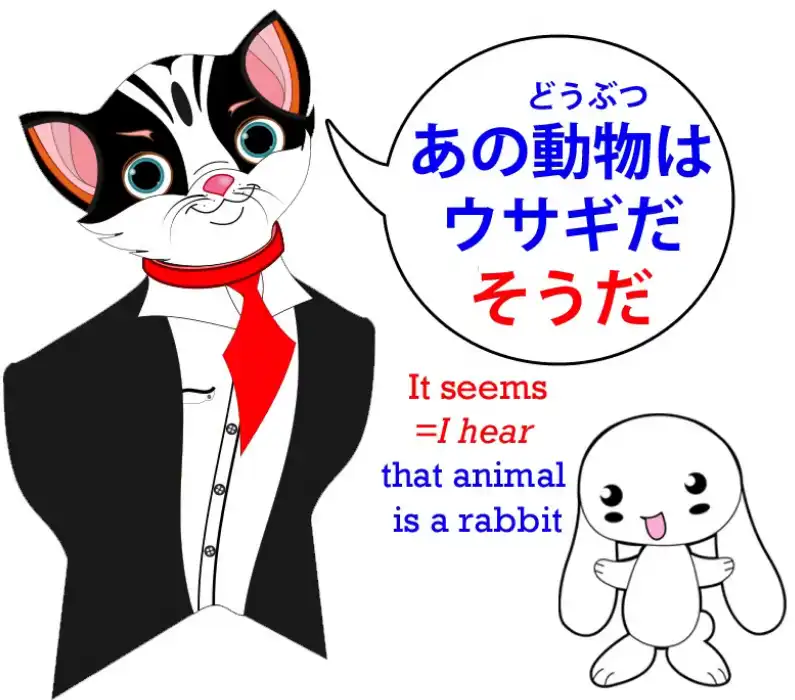
That is unambiguous. That can only mean “I heard it from somebody”.
#
らしい vs そうだ - an individual word
Now, when we apply “らしい” to an individual word, the most immediate difference between “らしい” and “そうだ” is that we can’t apply “そうだ” to a regular noun.
We can only apply it to an adjectival noun, and there’s a good reason for that.
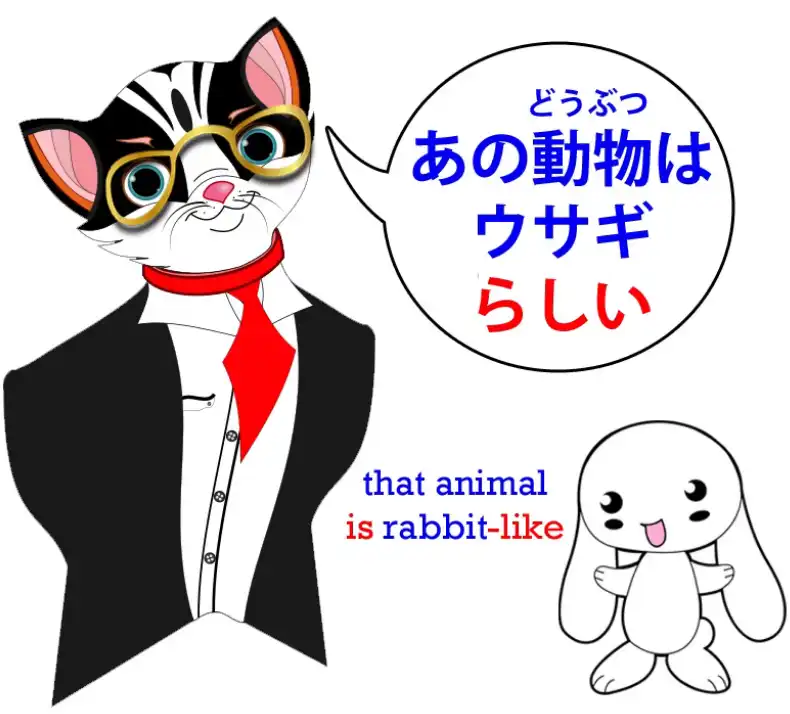
We’ll get to it in a moment.
“らしい” you can apply to any kind of noun, whether it’s an adjectival noun or whether it’s a regular noun.
But it really comes into its own when it’s being applied to regular nouns.
As you would expect from the fact that it is a -しい adjective – that’s to say, that we would expect it to be expressing a greater degree of subjectivity – it has the ability to liken one thing to another.
So we can say “あの動物はウサギらしい” – “That animal is rabbit-like / that animal’s like a rabbit.” — Now, the difference between this and “そう”, apart from the fact that you can only apply “そう” to adjectival nouns – and this is why you can only apply “そう” to adjectival nouns – is that when we say “あの動物はウサギらしい” we are not necessarily conjecturing that it is in fact a rabbit.
We may be completely aware that it isn’t a rabbit and we’re simply saying that it’s like a rabbit, it’s a rabbit-like animal.
And of course, we can turn it around into that kind of an adjective too: “ウサギらしい動物” – “a rabbit-like animal”.
And again, it’s just the same as in English.
If we say, “That animal looks like a rabbit”, we could mean “I’m guessing that it is a rabbit” or we could mean “It’s probably not a rabbit, but it certainly looks like one.” Now, this widens out into even greater areas of subjectivity.
#
らしい for more subjective areas
For example, we can say that something has the qualities of something.
For example, “男らしい男” is a “manly man”, a man who possesses the qualities of a man.
If we talk about someone who’s not a teacher and we say “先生らしい” – “That person’s like a teacher.” We might or might not be conjecturing that she is in fact a teacher.
But if we know that she’s a teacher and we say, “さくら先生は先生らしい”, we mean that she behaves like a teacher.
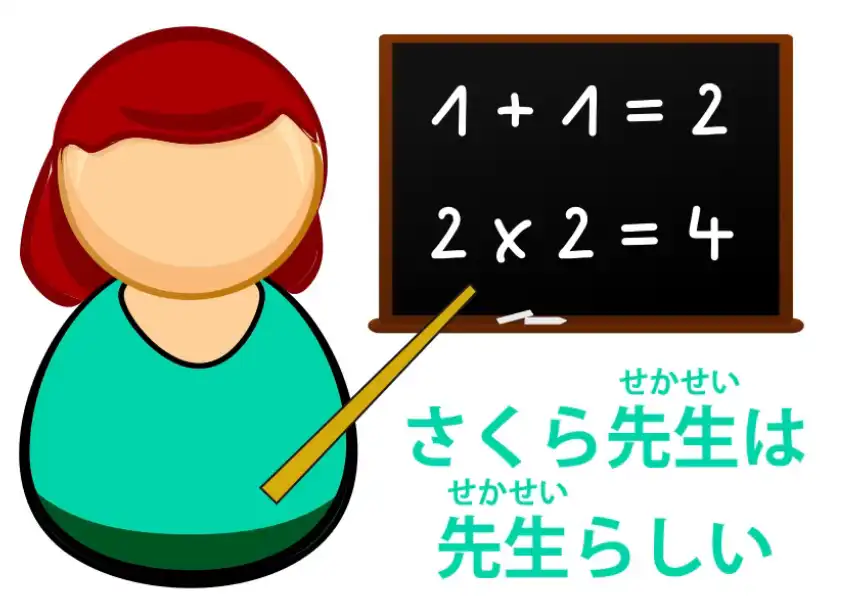
She is a teacher and she has the right qualities and manner for being a teacher.
Conversely, we could say, “さくら先生は、先生らしくない” and in that case, we’re saying, “Well, we know she’s a teacher, but she doesn’t behave like one, she doesn’t act like a teacher.”
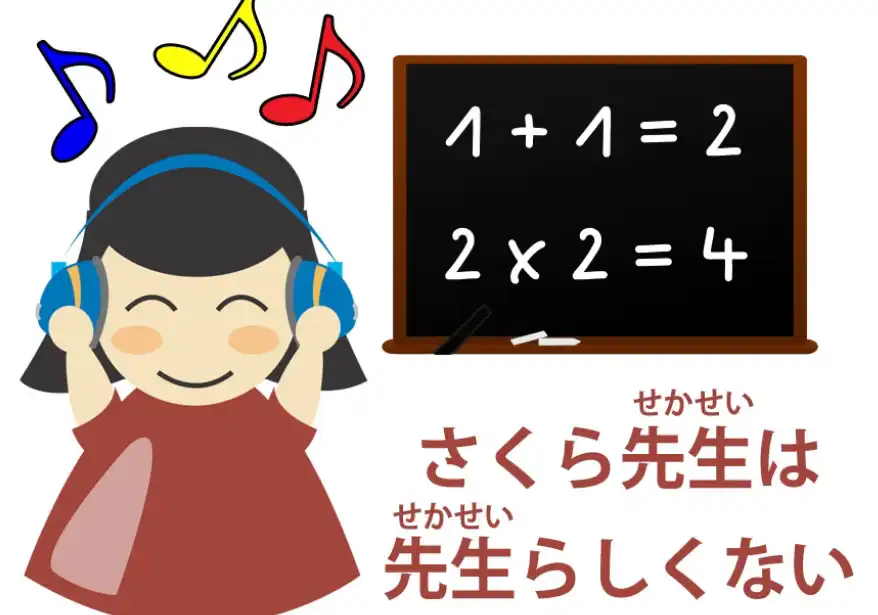
So you see, with “らしい” we are getting into much more subjective areas.
We’re not simply guessing whether something is in fact delicious or interesting, which we can confirm by experience.
We’re talking about our impressions and beliefs and subjectivities surrounding the phenomenon.
Now, we can also say things like, for example, if Sakura says something unpleasant and usually she’s a very sweet girl, we might say, “それはさくららしくない” – “That wasn’t (or I guess “isn’t”) like you, Sakura.” So we’re talking about the qualities, the subjectively perceived qualities of a thing.
So, in some areas it overlaps with “そうだ”, but in other areas it moves forward into more subtle and subjective areas.
っぽい
Now, we’re also going to quickly look at っぽい, which is a small っ followed by -ぽい, so we have a little break between that and what we’re saying.
So if we want to say “childish”, we might say “子どもっぽい”.
It works very much like “らしい”. It’s also a helper adjective.
It’s much more casual than “らしい” and we usually hear it in exactly that form –
“子どもっぽい”, “ウサギっぽい”.
You can’t use っぽい at the end of a completed clause. You can only attach it to a word.
And apart from its colloquial nature, a difference in tendency from “らしい” is that “らしい” will tend to imply that the quality is what something ought to have.
-っぽい often tends to imply the opposite. (basically, it tends to imply an undesirable quality)
There’s no hard-and-fast rule here,
but there tends to be a positive inclination in “らしい” and a negative one in っぽい,
although you will certainly hear them used the other way round on some occasions.
So “子どもらしい” is more likely to imply the child’s behaving in a way proper to a child, whereas “子どもっぽい” tends to mean “childish”.
In fact, in English we could say “子どもらしい” means “child-like” and “子どもっぽい” means “childish”, although it’s not as hard and fast as that is in English.
It could be used the other way round without breaking any actual laws.
When I first appeared in this particular shell, this body that I’m wearing now – I am of course the ghost in the shell (nice reference there, Dolly :D) – I was talking in English, introducing it, but I made a little aside in Japanese because I really don’t know quite how to say this in English.
I said, “What do you think of me when I look like this?
“人間っぽいね?” “人間っぽいね” – “It’s very human-looking, isn’t it?” And while it wasn’t exactly disparaging, the sense of what I was saying was “Good heavens, in this shell I look really more human than I actually am, don’t I?” Which I think is why some people call me “creepy”, because I’m probably just a little bit too human-looking for someone who isn’t human.
Note: It can get a bit tricky to say which translation parts I should highlight so as to correspond to what Dolly gives in 日本語, but hopefully it helps, I try to deduce it as best as I can (p^-^)p
Anyway, from here on, I will not use these underlines until around Lesson 78.
The later lessons will have them again, these lessons in-between do not have them because I used just bolding back then and did not add underlines until later, hence no lines on them for now.
**The reason also then being that I was (and still sort am) not entirely sure whether I should or should not use them (Yomichan does not want to properly scan differently styled parts, 10ten does though…
It took a lot of time and work to underline the important parts, so maybe I will return to it later to make it consistent at least, though now I am really burned out, so… can barely do my Japanese, let alone this.
If you can, please let me know through Discord or Mail whether you prefer underlined important parts or simply non-underlined text since sometimes the amount of “important stuff” may be a bit harder to read when everything is underlined. With bold it was even worse, hence why I stopped using it and converted.*
***Also, lessons from now up to 64 are among the first I edited, and I have not reviewed the notes there yet, so keep that in mind and take them with salt as usual just in case since my Japanese is still very limited and I have not got any more professional / advanced people’s feedback on them.
Though they should be fine basically speaking since I did as much research I could on them then..
26. Similes: ようだ・のように・のような ・みたい
Lesson 26: The crystalline logic of Japanese similes: のように・のような ・みたいgrammar
こんにちは。 Today we’re going to talk about “ようだ” and give a little mention to her cousin “みたい”.
We’re going to discover that “ようだ” constitutes the other end of a sliding scale with the expressions of conjecture and likeness that we discussed in the last two lessons.
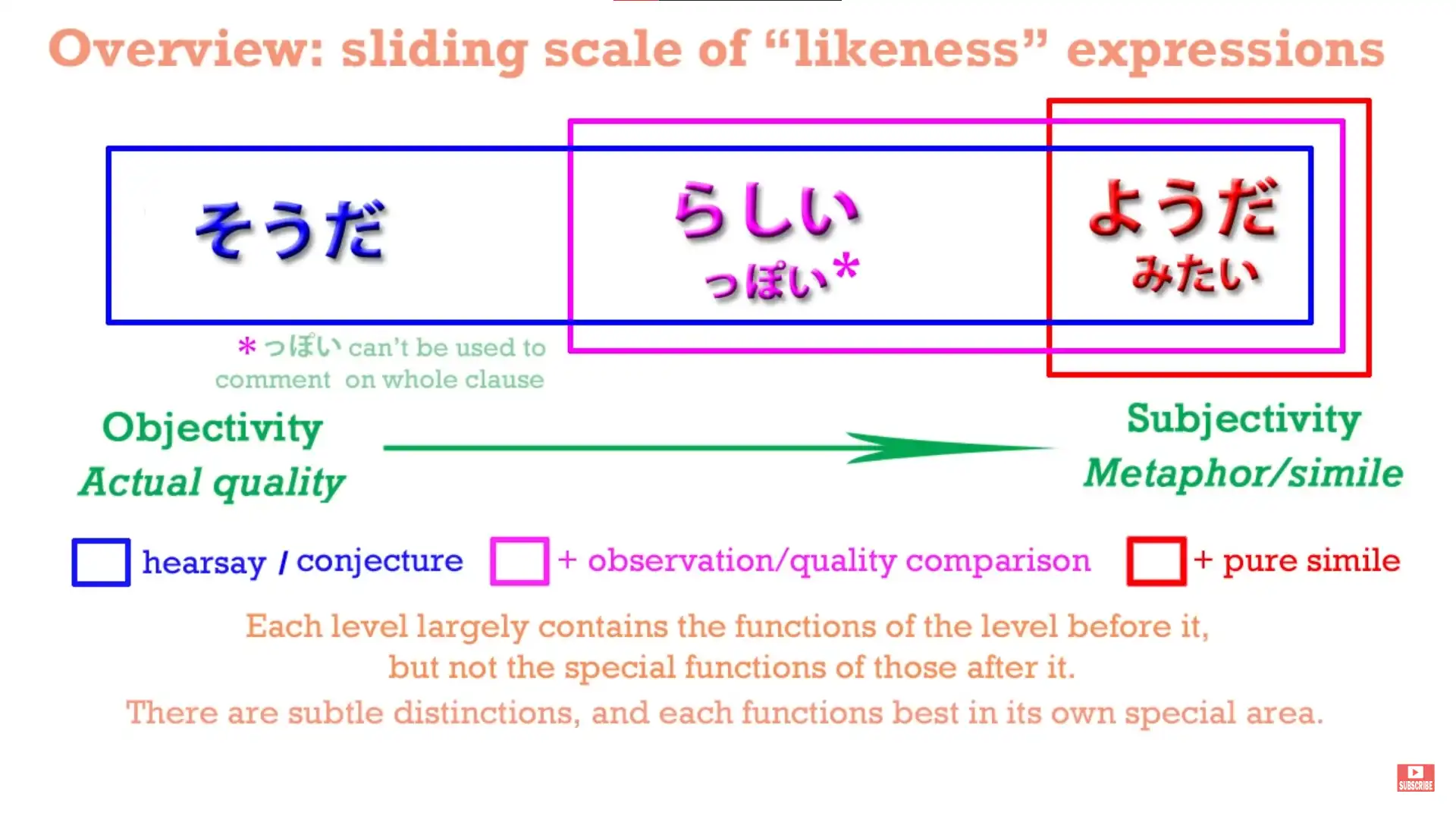
At one end we have “そうだ”, at the other end we have “ようだ”, and in the middle we have “らしい”.
All of these expressions can be placed at the end of a completed logical sentence in order to express that that sentence is either what we’ve heard or what we conjecture from the information we have or from what we can see.
But when we attach them to individual words, then we have this sliding scale of meaning.
With “そうだ”, as we know, we use this to conjecture what the quality of something is.
We can say “おいしそうだ” - “It looks delicious /I haven’t tried it, but I think if I did, I would find it delicious.” With “らしい” we have a much greater degree of subjectivity.
“らしい” overlaps with “そうだ” in many respects, but it can also do things that “そうだ” cannot do.
It can compare things to other things, to things that we know they aren’t.
We can say that an animal is “ウサギらしい” - “rabbit-like” - even though we know it isn’t a rabbit.
We can say that a person is “子どもらしい” - “child-like” - whether she is in fact a child or not.
We are not necessarily conjecturing that the animal is a rabbit or the person is a child.
We are just making that comparison.
ようだ ・ように・ような
Now, “ようだ” can go much further.
It can make an actual metaphor or simile.
So with “ようだ” we can say such things as “a sumo wrestler is like a mountain” or “a person runs like the wind”.
Now these are, if you like, literary style or poetic similes or metaphors.
We’re not saying that the wrestler’s anything like a mountain except in the sense that he’s big and solid.
We’re not saying that a person is in any way like the wind except that she’s fast.
And one of the ways we know when “ように” is acting in this way is that we can use the word “まるで” with it.
So we can say “まるで風のように走った” - “ran just like the wind”.
Literally, “まるで” means “roundly”.
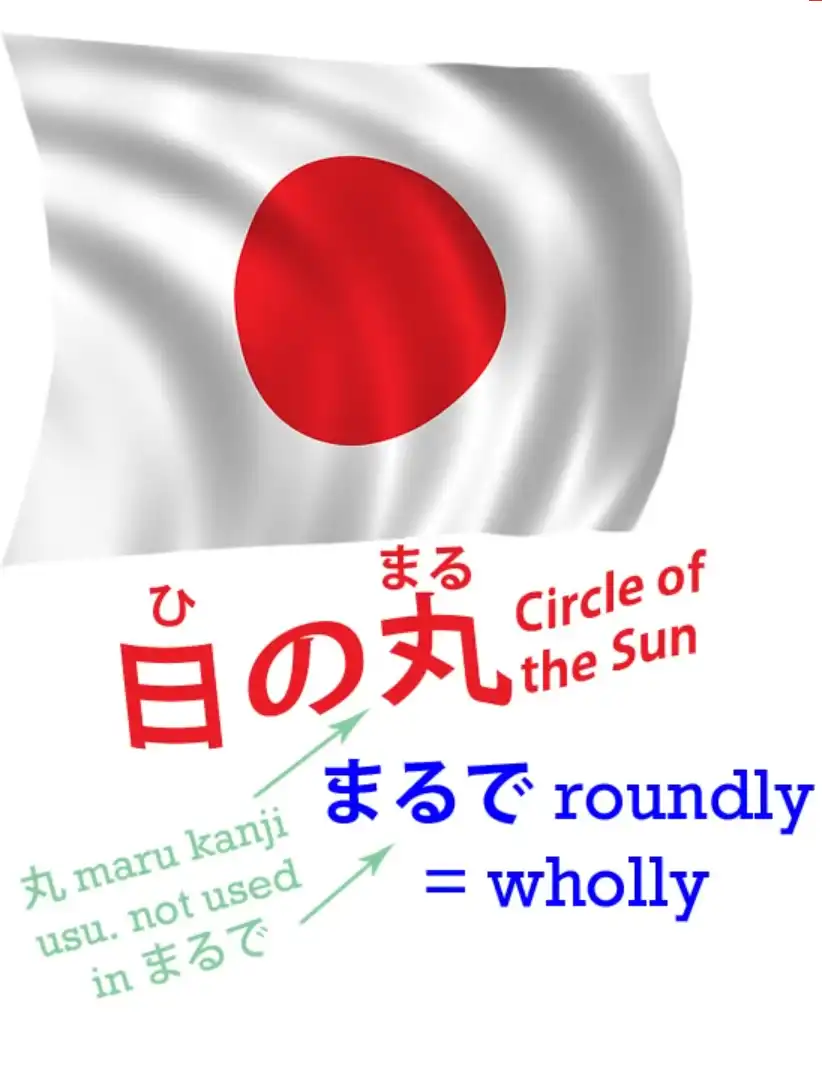
“まる/丸” means a “circle” or a “round”, so when we say “まるで” we mean “roundly/wholly/completely”.
And this is a hyperbole, which is common to many languages, certainly including English.
We might say, in English, “That wrestler is exactly like a mountain.” We might even say “I literally froze to death.” Now, that’s the opposite of what we really mean: we don’t mean that we “literally” froze to death, we mean that we figuratively froze to death.
In literal reality we appear still to be alive.
We don’t mean that the wrestler is “exactly” like a mountain.
There isn’t any snow on top of him! But the reason we say things like “exactly” and “literally” is to give emphasis to a poetic simile.
And in Japanese the usual collocation here is “まるで”.
And this also demonstrates the difference between “ようだ/ような/ように” and the other likeness-making expressions.
You can’t use “まるで” with “そうだ” or “そうです”.
You shouldn’t use “まるで” with “らしい”.
It’s out of place with those expressions.
We use “まるで” when we’re going on a kind of poetic flight of fancy.
It’s a hyperbolic expression that signals the coming of a simile or a metaphor.
When we say that a person is “子どもらしい” or an animal is “ウサギらしい”, we are extending reality a bit; we are comparing it to something that it could be but isn’t.
Now, if we look at the usage of these expressions, we can see that as usual in Japanese they’re very logical.
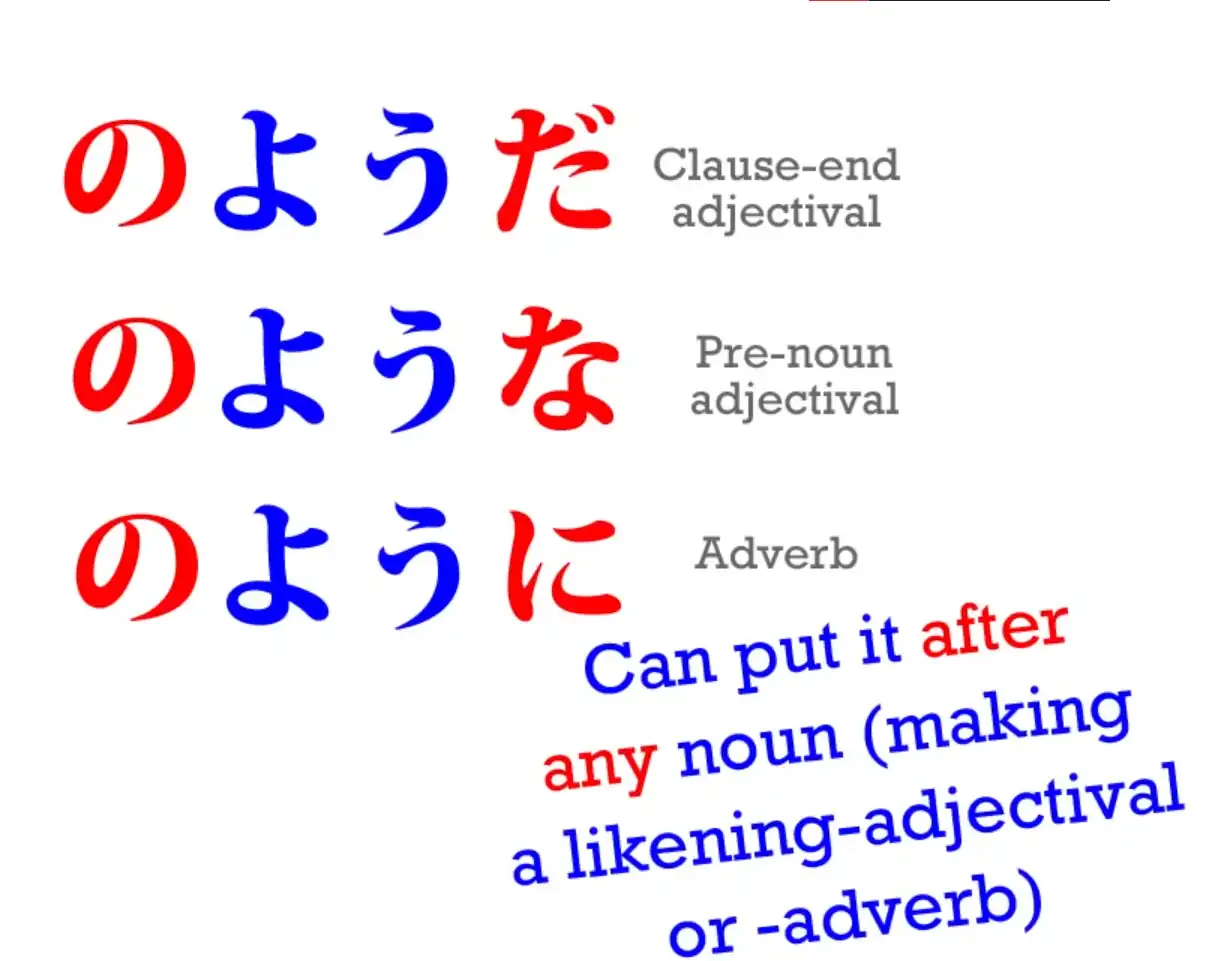
The textbooks will sometimes give you lists of connections and ways of using them.
But actually they all make sense.
We don’t need a list to tell us that “ようだ” can also be used as the adverb “ように” or that it can be placed before something as the adjective “ような” - because these connections are simply the same connections that you can make with any adjectival noun.
The only thing we have to know is that, just like “らしい” and unlike “そうだ”, we can use it with any kind of a noun, not just adjectival nouns.
And that also makes sense because with both “らしい” and “ようだ” we can compare things to other things, whereas with “そうだ” we can only conjecture at the quality of a thing, something that can be expressed by an adjective or an adjectival noun.
And when we attach it to a verb, as we’ve seen, it has a slightly different meaning.
However, “ようだ” has a special connection that the others don’t have.
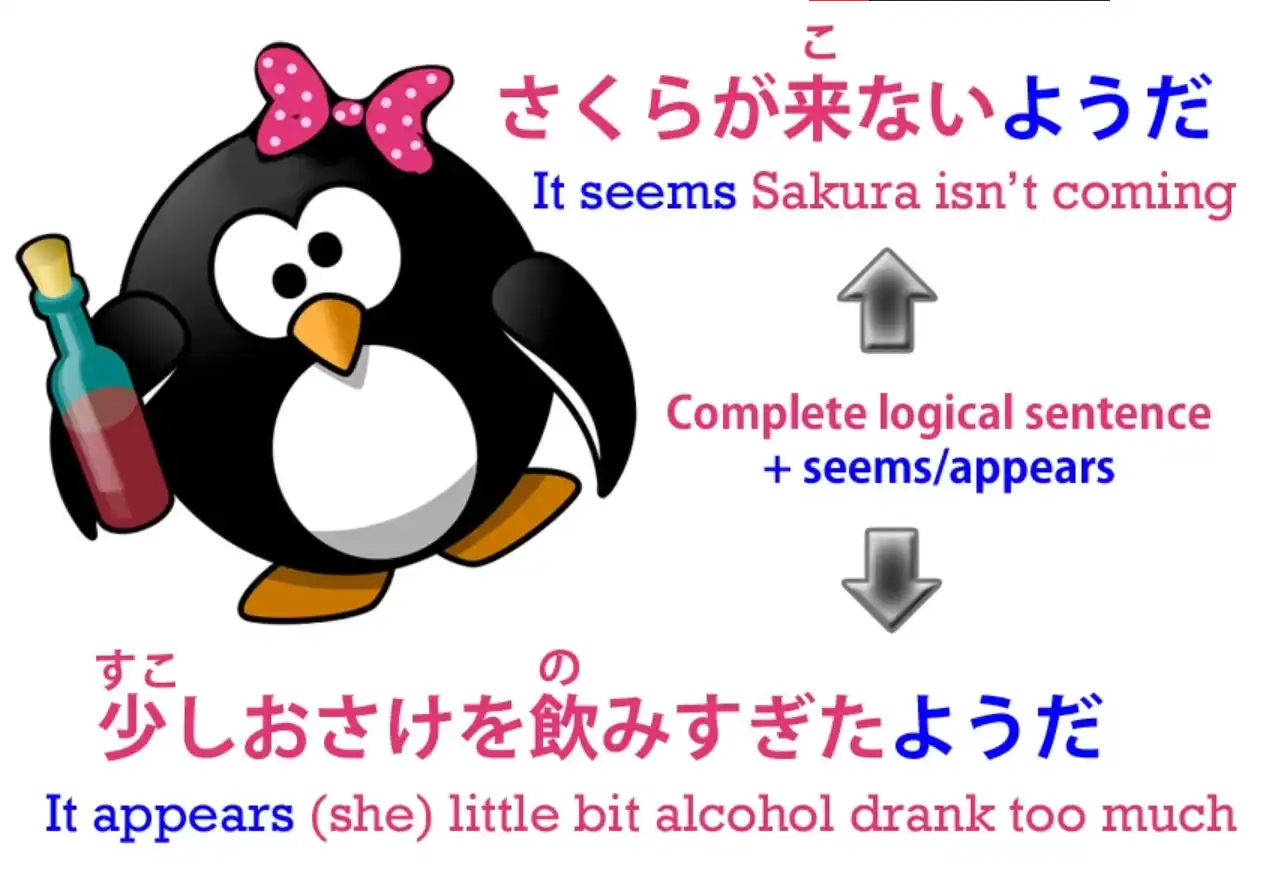
As you know, we can simply pop it onto an entire sentence, as we can the other two, with the meaning of “(that sentence) is what appears to be the case”.
But we can also put it onto an entire, complete sentence with a different meaning.
We can do it in order to turn the whole sentence into our simile.
So, for example, we can say “まるでゆうれいを見たかのような顔をした” - “She had a face (or made a face) exactly as if she had seen a ghost.”
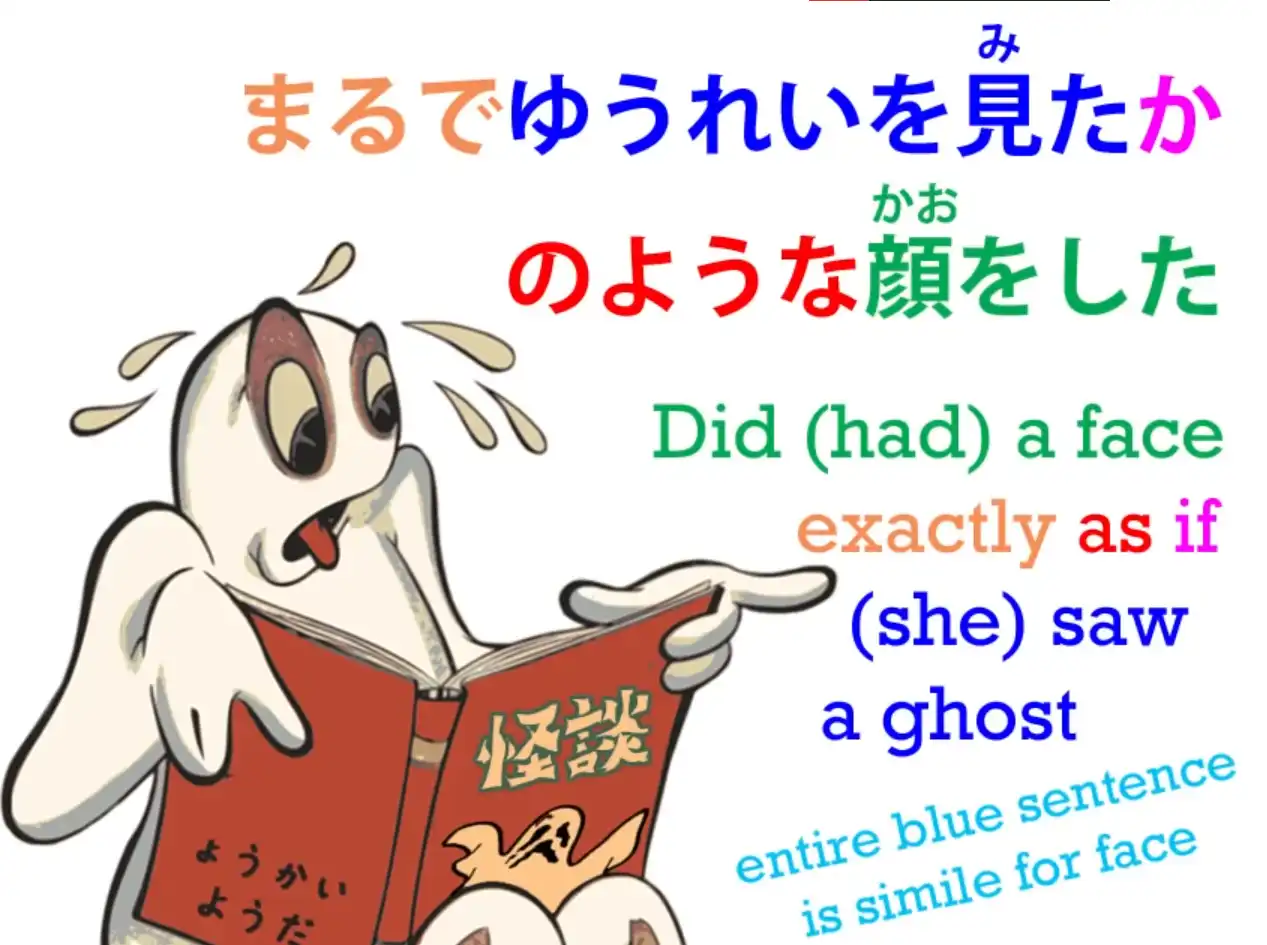
Now, as we see, “she had seen a ghost” is an entire logical clause.
In Japanese we have the zero-particle for “she”, but it’s a complete logical clause:
“she saw a ghost” - “ゆうれいを見た” - “zeroがゆうれいを見た”.
Now, then we put “か” onto the end of it. What is this “か”?
The か particle
We haven’t talked an awful lot about the か-particle because in です/ます Japanese you use it to mark a question.
You can use it to mark a question in informal Japanese, which is what we usually use here, but mostly we don’t because paradoxically it doesn’t seem polite to put “か” at the end of an informal question - it tends to seem a little bit blunt or curt.
However, the question-marker “か” has another important function.
And that is that it can bundle a statement into a kind of question, and that’s what’s happening here.
We start off with “まるで” to signal that we are going to use a simile.
Then we make our completed statement - “ゆうれいを見た” - “zeroがゆうれいを見た” - “she saw a ghost”.
And then we add “か” and that turns it into a question.
It gives us our “if” - “as if she had seen a ghost”.
And that “か” gives us our questioning “if”.
In fact, she hadn’t seen a ghost, so this isn’t really a statement; it’s a possibility, a potentiality, an if.
What she actually did perhaps was saw the fees that PayPal charged her for an international money transfer.
We’re not suggesting that she really saw a ghost.
We are suggesting that the face she manifested - “顔をした” - was similar to the face that she would have manifested if - “か” - she had seen a ghost.
Now, the other thing that we need to understand about this “か” is that it in effect nominalizes the logical clause that it marks.
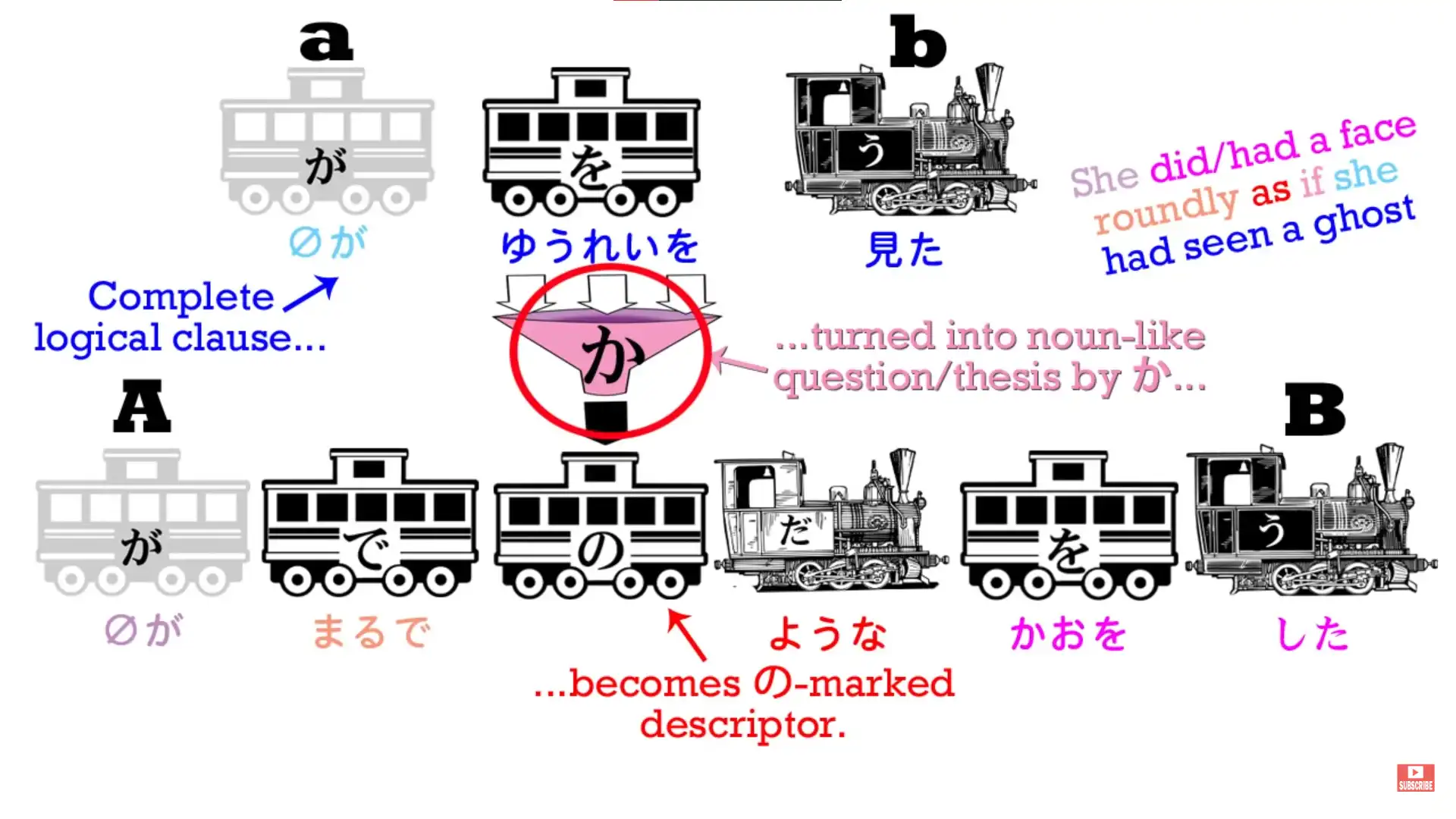
So what it’s doing is turning this complete logical clause into a question, a hypothesis, an if, that then functions structurally as a noun.
So it can be marked by の, which can only happen to a noun.
And so this new noun, this object that we’ve created from an entire logical clause, can now be connected to another noun by the particle の.
“よう” is a “form” or a “likeness” - “やまのよう” is the form of a mountain,
“風のよう” is the form or likeness of the wind,
and in this case, “ゆうれいを見たかのよう”
is the likeness of this object that we’ve created from the hypothesis of having seen a ghost.
Now, again, this is not something we can do with any of the others.
We can’t even do it with “みたい”, which works in most respects pretty much exactly the same as “のよう”.
みたい
“みたい” is the less formal cousin of “よう” and broadly means the same thing and broadly can be used in the same ways.
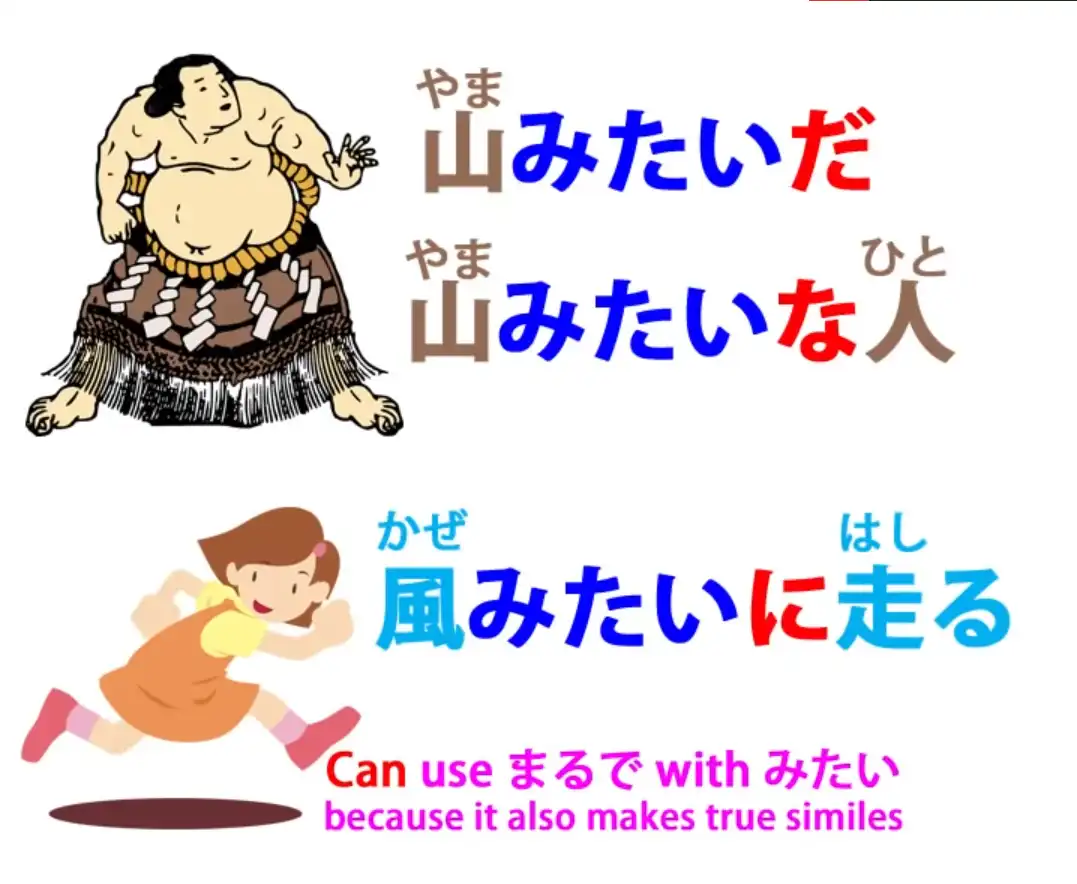
It’s an adjectival noun just like that “よう”, can be used with “に” to make it an adverb or with “な” to make it a before-the noun adjective just as any adjectival noun can be.
The main things to remember about it is simply that it’s less formal, so you don’t use it in an essay.
On the other hand, you might prefer to choose it when you’re talking to a friend over
“ようだ” in many cases, just because it sounds a bit less formal and a bit more friendly.
But you can’t use it with a completed sentence.
You can use it with a complete sentence in order to conjecture that that statement is the case, but you can’t use it with “か” to use a complete sentence as a simile.
You have to use “かのようだ/かのように” for that.
The other thing to note is that sometimes, probably because it is very casual, the “だ” or “です” gets left off from “みたい”.
You might say “まるでヒツジみたい” - “just like a sheep”.
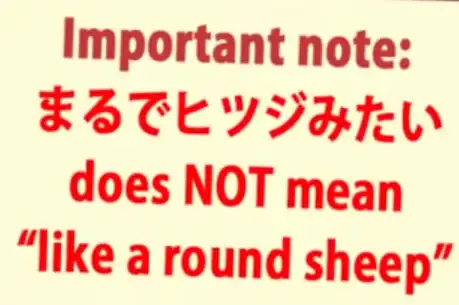
This isn’t correct grammar - you ought to say “みたいだ” - but it’s very common to leave it off. It’s not common to leave it off of “ようだ”.
*Note: I will just in case add that this adjectival noun みたい is NOT the same as 見たい (an adjective meaning “see-inducing”). These are two different “みたいs”. You can’t write this みたい as 見たい, else it will be an adjective “see-inducing”. What Dolly-先生 says in the comments:
*


27. ばかり
Lesson 27: Bakari meanings:: crazy patchwork or logical pattern?
こんにちは。 Today we’re going to talk about “ばかり”, which is one of those Japanese expressions that the textbooks can be very confusing about.
They will tell you that it has a number of different, seemingly random meanings which attach with different grammar structures that you have to memorize.
It’s another of these laundry lists that the textbooks love to give you.
Fortunately, as is often the case, we can cut through all this simply by looking at what the word really means and how it logically works in different situations.
This will give us a key both to the meanings and to the structure in its different uses.
“ばかり” is essentially a noun.
You’ll hear it described as other things, but in practice it works as a noun.
We use “だ” after it, which we can only do with a noun, although sometimes we will find the “だ” or “です” left off in casual speech, just as with “みたい”, which we discussed last week.
I notice that a lot of the times when a “だ” or “です” is left off, the word does end in -い, so I think that might be a slight influence from adjectives, although it is not an adjective.
It is a noun.
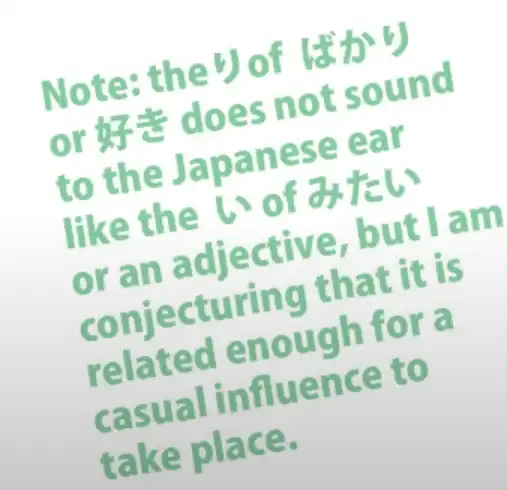
So what does it mean?
Its meaning is very simple.
It means “just” or “nothing but”.
And one of the commonest uses is simply to place it after a past tense statement to say that that has “just” taken place.
It works exactly the same as in English.
If we say “来たばかり” - “I just came” - that’s exactly what we also say in English: “I just came” or even “I only just came”.
It means that something has happened a very short time ago.
Why do we use, both in English and Japanese, a word meaning “nothing but” in this case?
Well, like many words, it is a hyperbole.
We discussed hyperboles in the case of “まるで” in the last lesson, didn’t we?
When we say “I just came/来たばかり(だ)”, we are saying that nothing has happened except that I came.
I came such a short time ago that there hasn’t been time for anything else: “I just came/I only just came/来たばかり(だ)”.
Now, this is very often very much a hyperbole.
Suppose, for example, that we meet a friend in the street and the friend says “Let’s go for coffee and cakes” and we say “食べたばかり” - “I just ate”.
Now, what we’re literally saying here is that I ate such a short time ago - milliseconds ago - that nothing else has happened in between eating and now.
Now, obviously that’s not literally true.
One must have left the place where one did the eating and walked down the street at least.
But hyperbolically we’re saying that we ate and nothing else happened between then and now.
The textbooks will tell you that this use of “ばかり” is attached to the plain past of a verb.
Now, that’s true, but it’s also confusing for two reasons.
First of all, saying “plain past” implies this whole world where we are taught that the “real” forms of verbs are the “ます” forms, so we have to deconstruct them every time we do anything with them.
We don’t need to say “plain past”, because everything we do with a verb inside of a sentence we are doing to the plain form of the verb even if we are using formal Japanese by putting ‘‘です’’ and ‘‘ます’’ on the end.
“です” and “ます” are nothing more than decorative appendages that we put at the very end of a sentence.
The other thing that makes this explanation confusing is that while it’s true that we do put it after the past form of a verb, we are not really attaching it to the past form of the verb. This is not logically what’s happening.
And it’s one of those things that makes it sound like a random rule when it isn’t.
What we are attaching “ばかり” to is a completed action.
And what we are saying is how long ago it happened.
We’re saying it happened a very very short time ago.
So we have to have a completed action and of course it has to be in the past, because that’s what we’re saying about it.
If it were in the non-past it wouldn’t make any sense, would it?
So we can say it attaches to the plain past of the verb or we can say it attaches exactly where it logically has to attach and where it would make no sense if it didn’t.
Now, the next use of “ばかり” is one that people sometimes find confusing because it expresses that there is a great deal of something.
Now, “ばかり” obviously is a limiting word, so why is it used to express that there is a great deal of something?
Now, once again, this is perfectly logical and natural and we use it in English as well.
If we say “There are nothing but cakes in that shop!” - now, we may mean it literally, but very often we mean there are other things, but there are an awful lot of cakes.
When I was staying in the countryside in Japan and I was moving to Tokyo for a while, somebody I knew there thought it was a bad idea for me to move to Tokyo and said,
“東京は外人ばかりだ” -
“In Tokyo there’s nothing but foreigners.”
Now of course this person did not mean that there was nothing but foreigners in Tokyo;
he meant that there are a lot of foreigners in Tokyo - and he knows that I don’t want
to be associating with foreigners who are going to start talking English at me.
(It’s all right - I avoided that.) So this is just a very obvious, natural use of “ばかり”.
Now, we can extend this further by saying that someone is doing something a lot or is doing it continuously.
Again, the textbooks give you these two meanings and make it sound a little complicated, but there’s nothing complicated about it.
It’s very easy to understand from context.
The way we do it is that we put “ばかり” after the て-form of the verb.

So, if you’ve ever heard “犬のおまわりさん”, which is a charming children’s song about a lost kitten: “まいごのまいごのこねこちゃん” - I’ll put a link below so you can listen to it if you would like to.
Now, when the dog policeman (“犬のおまわりさん”) asks the kitten what her name is and where she lives, the song says “ないてばかりいるこねこちゃん”.
Now, “ないてばかり” means “doing nothing but cry”.
That’s what it literally means, and in this case it means it quite literally.
She did nothing but cry.
She went on crying and she didn’t answer, she didn’t say what her name was or where she lived.
And that’s where we get the idea of continuing to do something.
You don’t stop doing it, you don’t do anything else, you go on doing it: “してばかり”.
It can also be used figuratively.
You can say that somebody does nothing but play golf.
ゴルフをしてばかり
Now, in this case it’s a hyperbole, isn’t it?
Nobody does nothing but play golf.
Everybody sometimes eats, sometimes sleeps, and occasionally plays “Captain Toad”, because everybody plays “Captain Toad” sometimes.
So we have a hyperbole.
We’re not saying that someone continues doing something and doesn’t do anything else.
We’re saying that they do it an awful lot.
It’s a simple enough hyperbole and exactly the same hyperbole that we would have in English: “She does nothing but play Nintendo”.
Now, “ばかり” can also be used to make two conjunctions.
Conjunctions, as we know, are things that connect together two complete logical clauses in a compound sentence.
So we can say “うたったばかりか、おどった” - “she didn’t just sing, she also danced”.
Now, the only thing you really have to understand here is the use of “か”.
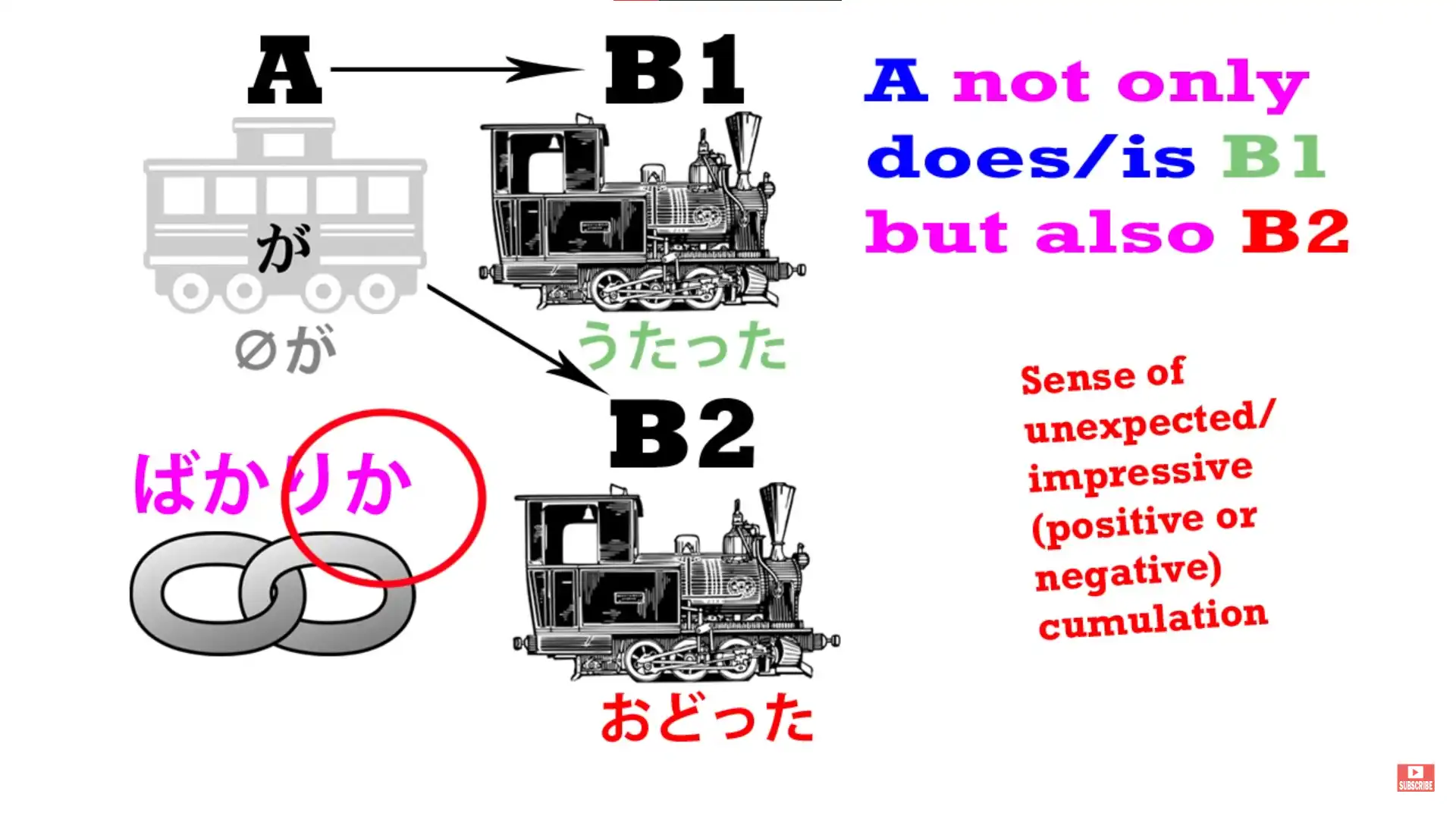
“か”, as we know, is the question marker and, as we discussed last week, it can turn a statement into a hypothesis, a question for discussion.
But it can also do another thing and that is it can, especially in colloquial usage, throw things into the negative.
And we have the same in English, don’t we?
When we ask a question in order to show a negative.
We can say “Do you think I’m going to do that?” meaning “I’m not going to do that.” And it’s the same with “か” in Japanese: in some cases we put “か” after something to say it isn’t the case.
So if we say “ばかり” we’re saying “only that is the case” and if we say “ばかりか” we’re saying “not only that is the case”.
The other common conjunction we make with “ばかり” is “ばかりに”.
“に” can sometimes be added to something in order to make a conjunction.
We’ve seen this with “のに” and I made a video about this a while ago which you may want to watch.
“ばかりに” is an explanatory conjunction.
We’re saying that something happened and then we’re putting a “because” at the end of it and saying it was because something else happened.
The most usual explanatory conjunctions are “から” or “ので”, but “ばかりに” has a special implication.
It’s not just saying that something happened because of something, it’s saying that it happened JUST because of something.
Again we can liken “ばかり” to English “just”.
“耳が大きいばかりに、 誰も遊んでくれない” - “Just because my ears are big, no one will play with me.”
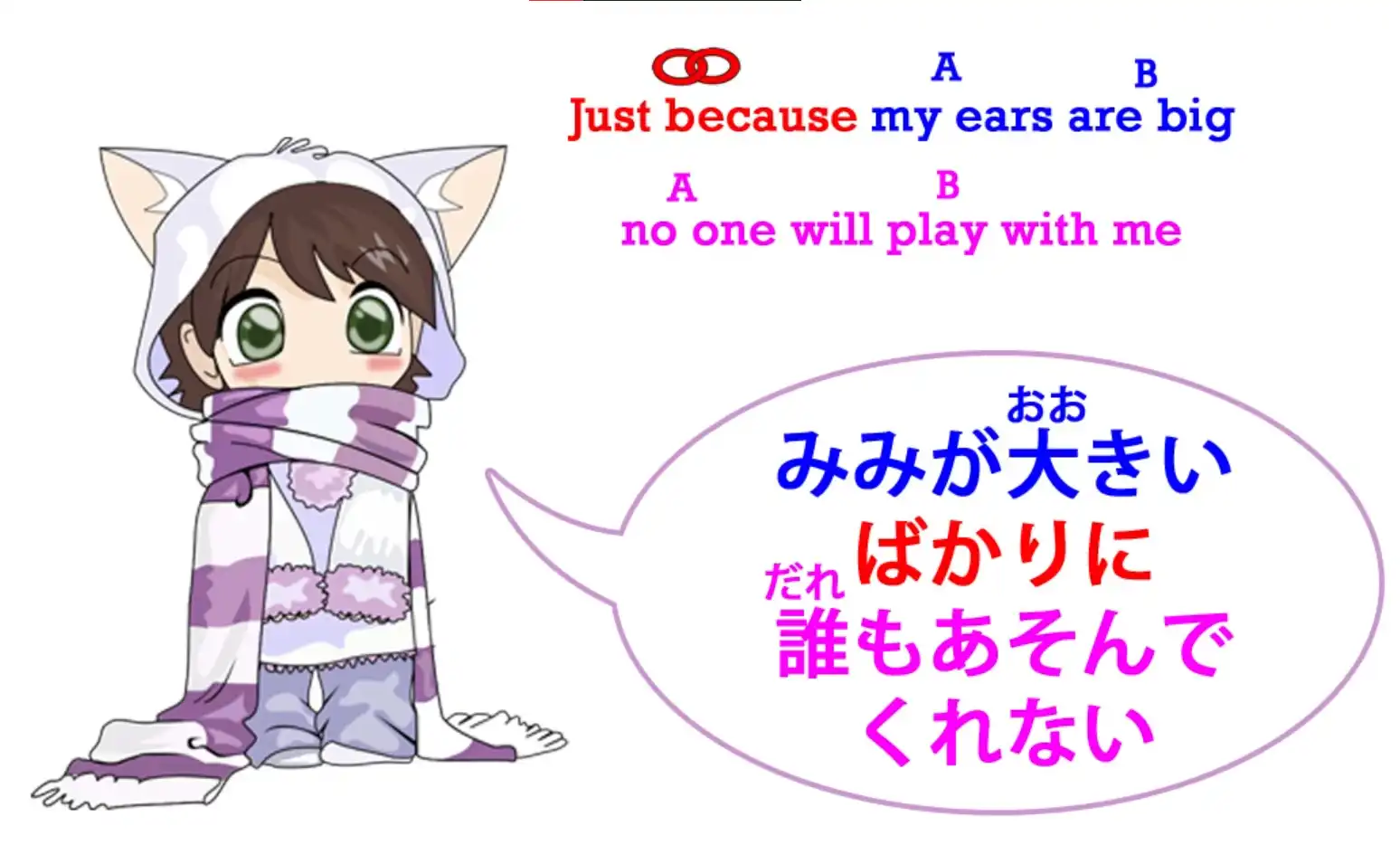
The textbooks will perhaps caution you here that “ばかりに” doesn’t necessarily mean this conjunction, and that’s true.
But understanding it from context is simple because we all know that a conjunction can only sit at the end of a complete logical clause that’s followed by another logical clause.
If “ばかりに” is not at the end of a logical clause then it’s not the conjunction, and if it’s in the middle of a sentence, which it normally will be, it must make sense to put a comma after it.
Because all conjunctions must logically be able to take a comma after them.
28. ように - one key to all the main uses
Lesson 28: You ni- one key to all the main uses! It’s easy when you know
こんにちは。 Today we’re going to talk about “ようになる”, “ようにする”, ことにする”, “ことになる”(nope) Now, all the elements of these expressions we’ve already learned, so what we need to do now is to see how they fit together in these cases, what they mean, and why they mean what they mean.
So let’s just do a quick recap of “になる” and “にする”.
As we know, the two primordial Japanese verbs are “ある” and “する”.
“ある” is the mother of all self-move verbs and “する” is the father of all other-move verbs.
“なる” is closely related to “ある” – “ある” means “be”; “なる” means “become” –
so we can say that “ある” and “なる” are the static and dynamic versions of the same verb.
That is, the same verb being still and moving in time.
Now, we know that when we use a noun followed by “になる”, we mean that something turns into that noun.
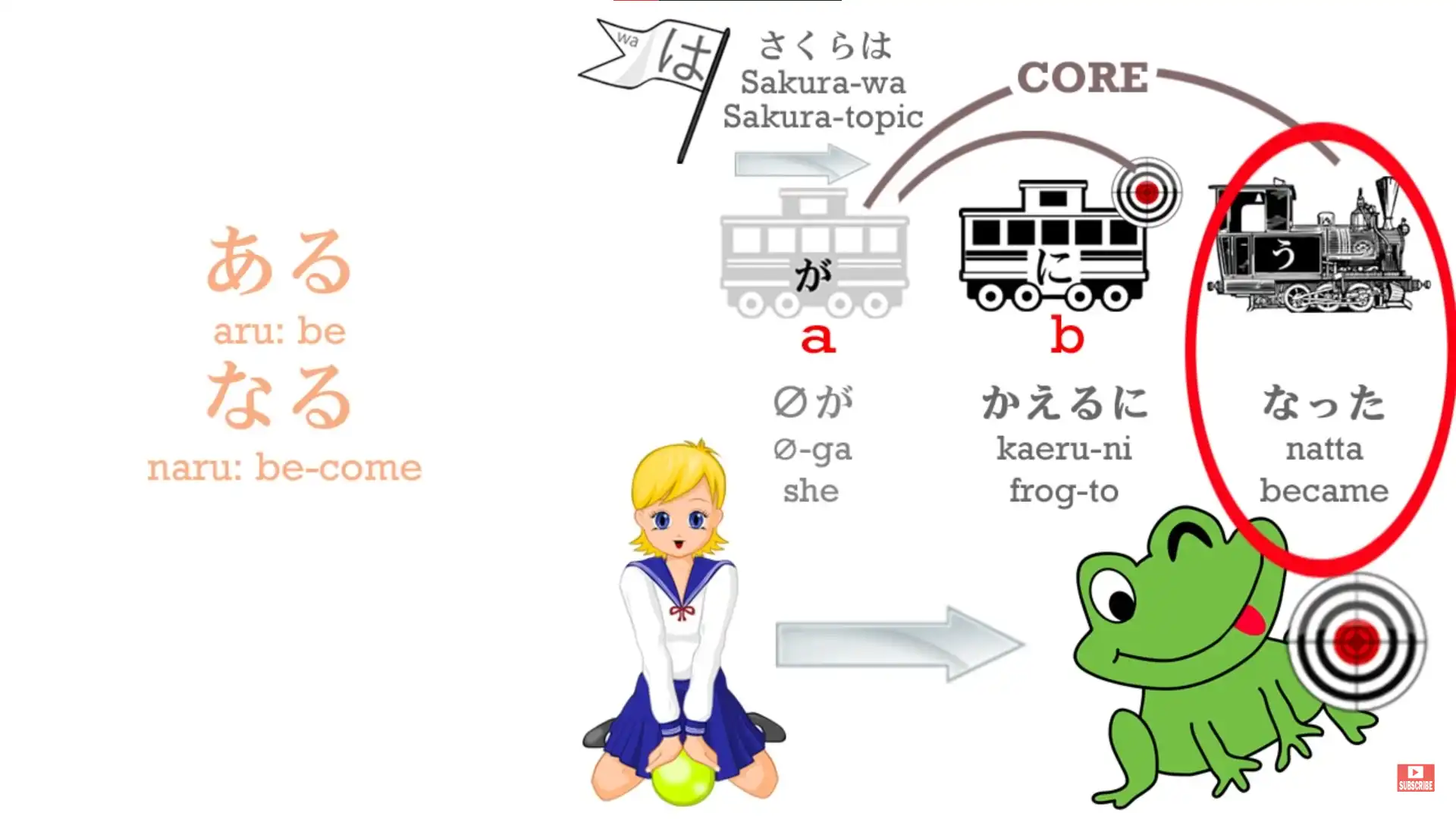
“に” marks the target of the transformation and “なる” is the transformation itself, the becoming.
ようになる
So, when we say “ようになる”…
Well, we looked at “よう” last week, didn’t we, and we saw that when we’re comparing things or likening things “よう” means a “form” or a “likeness”.
Its basic meaning is a form or a state of being.
When we say “りきしは山のようだ” – “sumo wrestler is like a mountain” – we’re not saying that the sumo wrestler “is” a mountain, we’re extracting the form or the state of being of the mountain and applying it to the sumo wrestler.
We’re not saying that the sumo wrestler is the mountain, we’re saying that the wrestler is the mountain’s “よう”, the mountain’s form or state of being.
So in English we say the wrestler is “like” the mountain; in Japanese we say the wrestler is the form or the state of being of the mountain – we might say, the “likeness” of the mountain.
Now, when we use “よう” in the expressions we’re talking about today, we don’t add them to a noun like “山”, we add them to a complete logical clause.
The textbooks sometimes say we’re adding them to a verb, but what we’re really doing is adding them to a logical clause with a verb-engine.
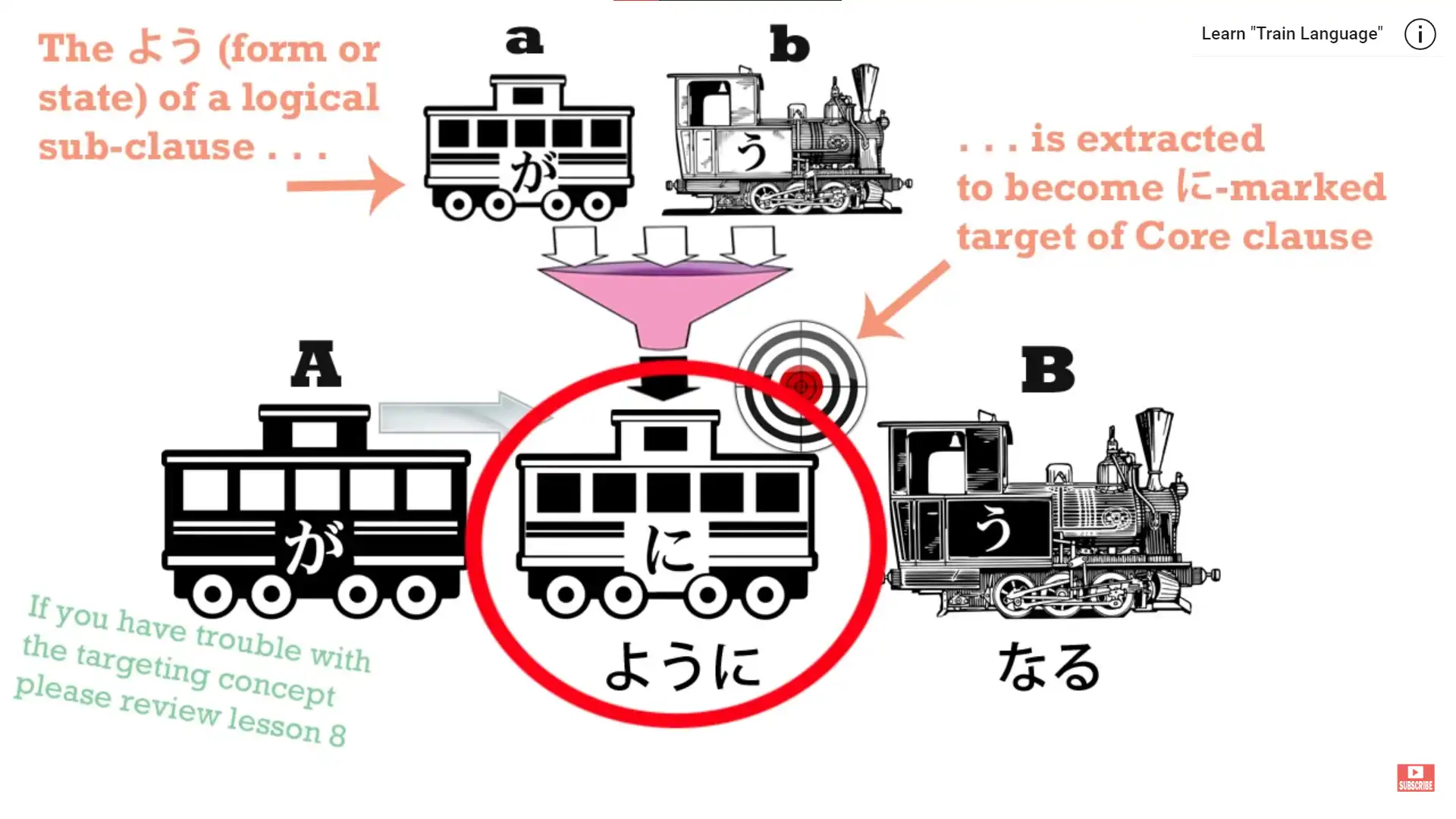
And “よう”, as we know, is a noun; the logical clause becomes the adjectival, the descriptor, for that noun, so we know that any verb-engine together with the logical clause it heads can become an adjectival so we’re not saying “のよう”, we’re NOT saying the likeness of something else here.
So when we have a logical clause plus “ようになる”, we’re saying that something became or entered the state of being or the form of that logical clause.
So, for example, if we say “彼を信じるようになった”, we’re saying “I came to believe him.”
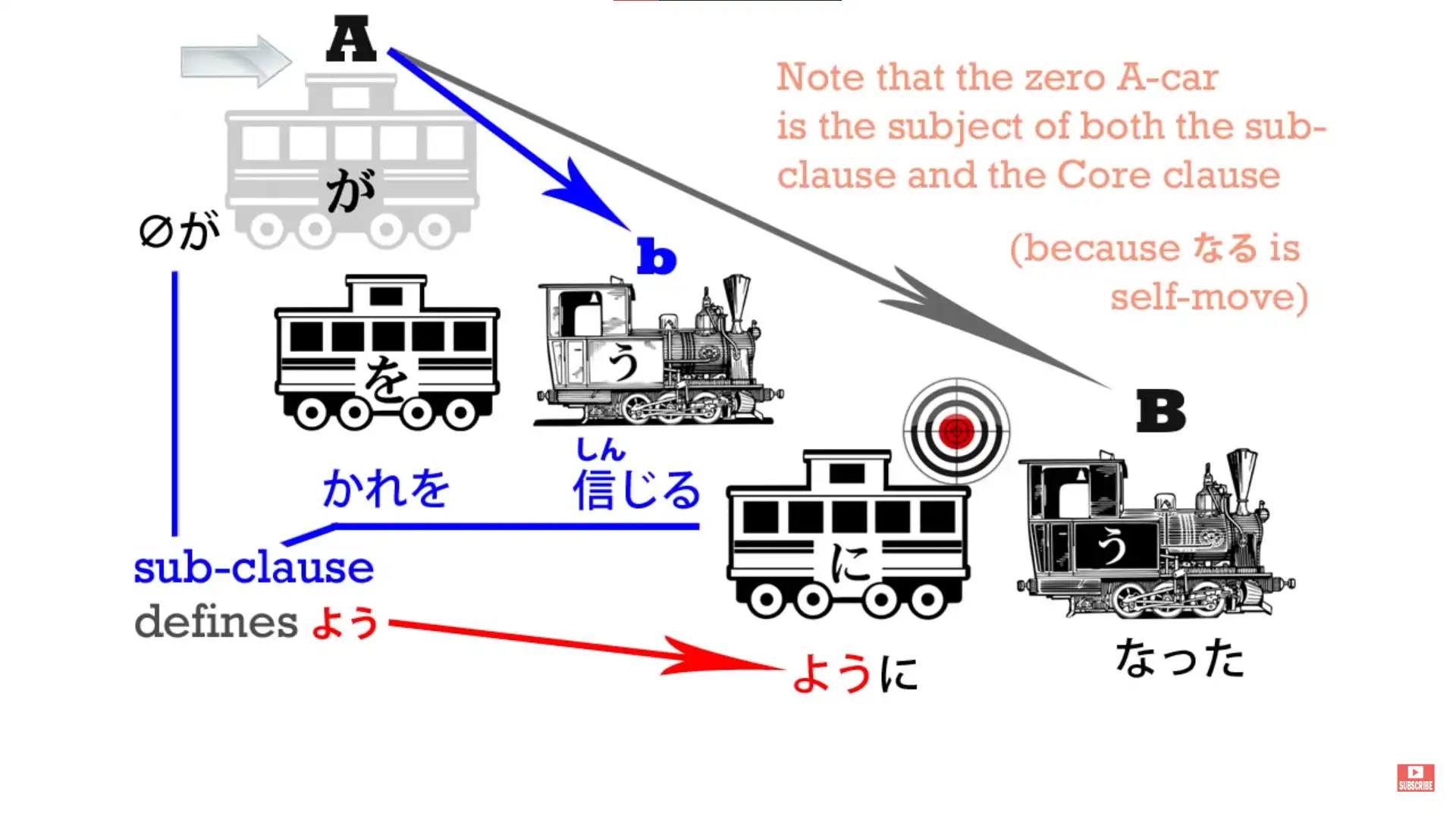
“彼を信じる” (or “zeroが彼を信じる”) –“I believe him” – is a logical clause, and we’re saying that I moved into the state, I became the state of that logical clause: “I came to believe him.” This is often used with a potential helper verb.
For example, we might say, “日本語のマンガが読めるようになった” – “Japanese manga became readable (to me)”.
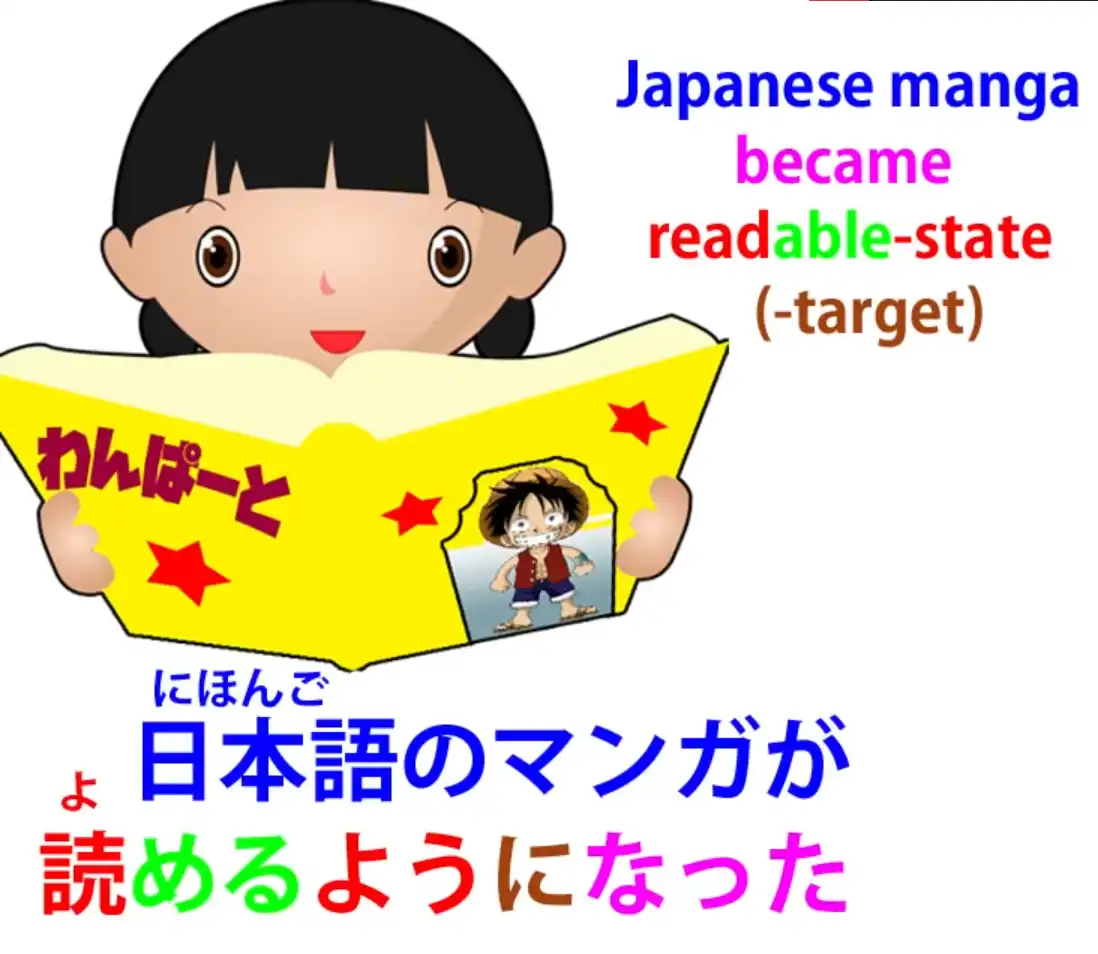
As you see, in both cases something is changing its state.
I change my state from not believing him to believing him; the manga changes its state from being non-readable to being readable.
In all cases we are talking about a change of state, a change of the existing state in someone or something from one condition to another.
And if you’re wondering why we most often in Japanese speak of the manga changing state from being non-readable to readable rather than speaking, as in English we usually do, of the person changing state from not being able to read the manga to being able to read the manga, please watch the video lesson on the potential helper verb where I explain how this works. (Lesson 10)
ようにする
Now, when we say “ようにする” we know that the “にする” construction is the other-move version of the “になる” construction.
If we say “まじょがさくらをカエルにした”, we’re saying “the witch turned Sakura into a frog”.

So “ようにする” is to make something enter a state.
It doesn’t enter it by itself; somebody’s making it enter the state.
So if we say “よく見えるにする” – “よく見える” means to “look good”,
so “よく見えるようにする” is to make someone or something look good.
Now, “ようにする” has an extended sense, and that is when we say something essentially equivalent to “please make sure that you do something”.
So, we can say “ドアにかぎをかけるようにしてください” and that means “please make it so that you lock the door”.
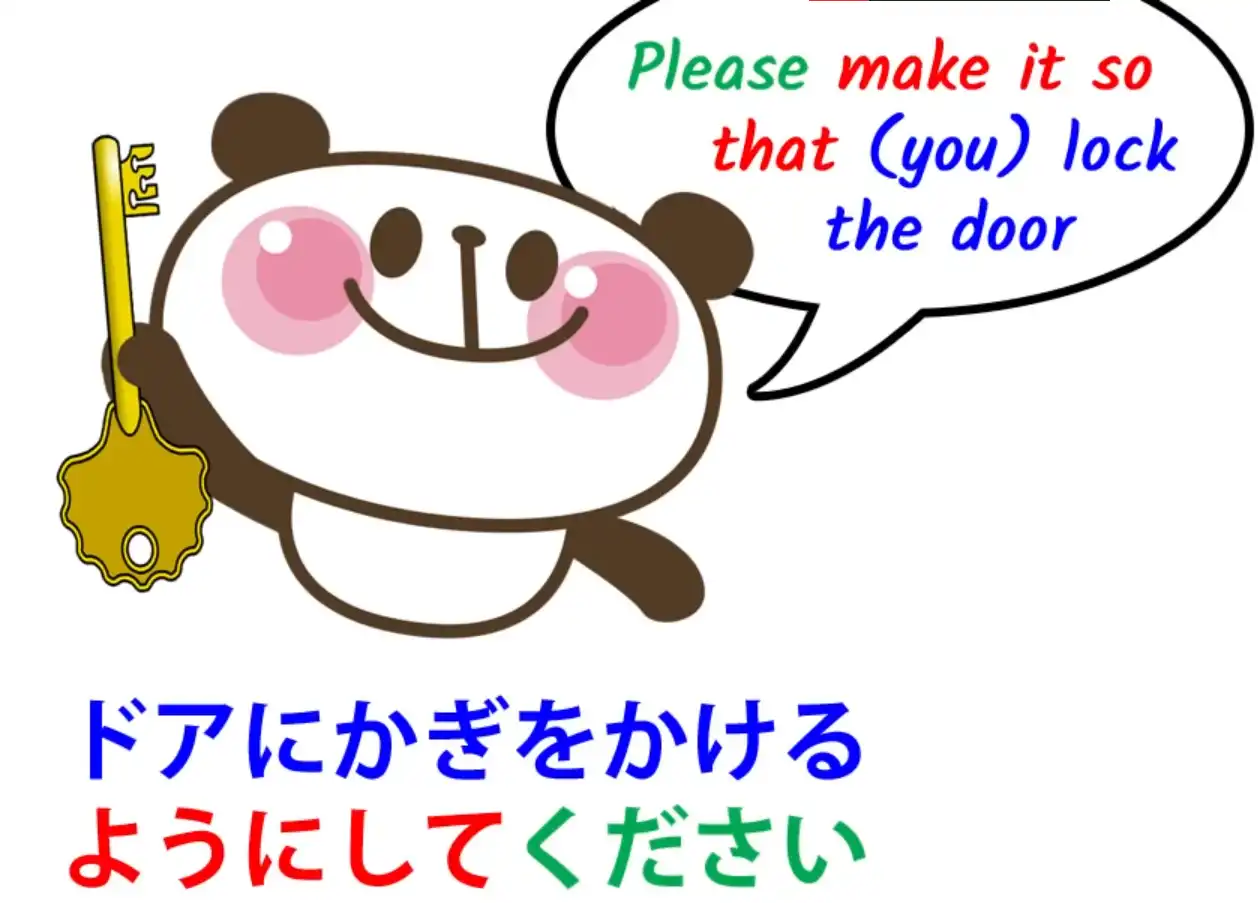
And I think you can see the difference here between simply saying
“ドアにかぎをかけてください”, which is just “please lock the door”.
In one case you’re kind of assuming that the person will simply lock it as a matter of course;
in the second case you’re making a very special point of it:
“Please make it so that you lock the door (this is important, so please make it be that way)”.
“It” in this case is just the same as it would be in English – the “situation”, the “circumstance” – “Please turn the circumstance from one in which you don’t lock the door into one in which you do lock the door.” So this makes a very special point of this instruction or advice.
Now, related to this is when you may say something about yourself, usually related to something you do regularly, such as saying “毎日歩くようにする”.
And that means literally, “[I] (try to) make it so that [I] walk every day”.
But when you put it this way, rather than just saying “毎日歩く”, which is simply saying “I walk every day”, the implication is that you try to do so.
You might not necessarily always succeed.
And, you see, as with the other usage, there’s some doubt as to whether you will do it.
You don’t say “Please make it so that you lock the door” unless there is in your mind a certain doubt as to whether this is going to happen and you’re trying to make it so that it does.
ことにする
When you say it about yourself – “毎日歩くようにする” – there is also another factor in play in that when it’s yourself you could also use “ことにする”, and that expresses a firm decision which we’ll talk about next week in the second half of this lesson.
So if you choose “ようにする” over “ことにする” you’re inherently leaving a little room for doubt.
*************************************************************************************************************
“Cause-and-effect” usage of ように
Now, “ように” can also be used with a clause behind it and a clause in front of it, in order to say “do one thing in order that another thing may happen”.
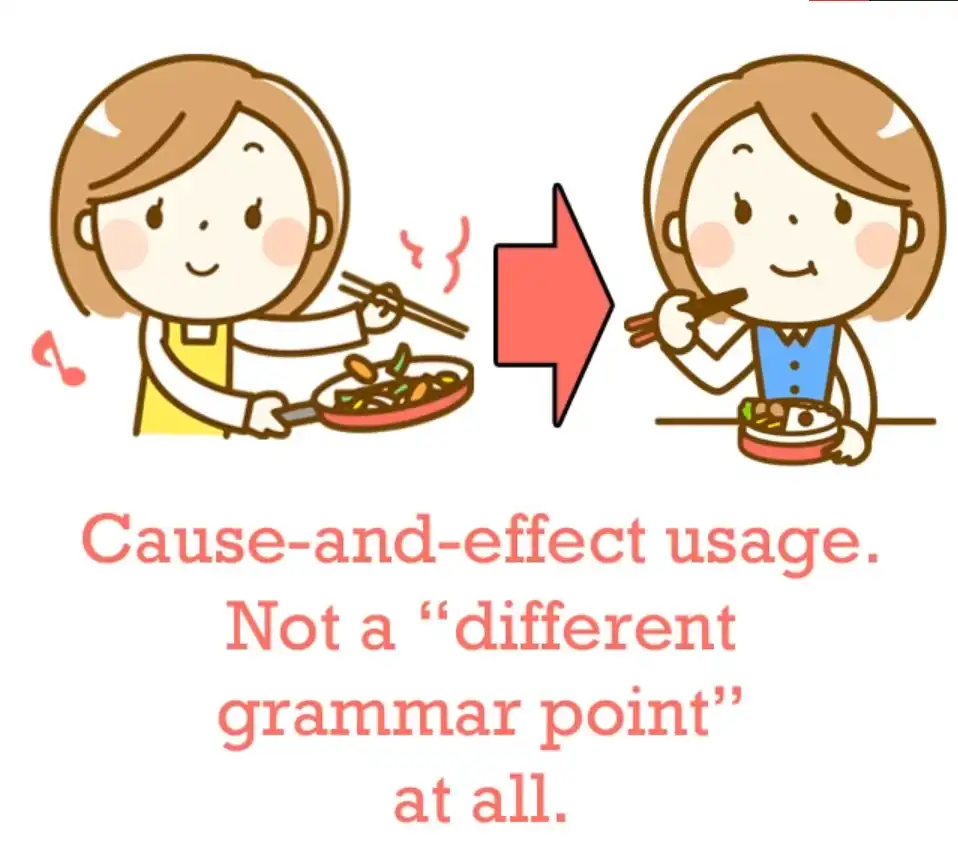
The textbooks treat this as if it were a different piece of grammar, a different grammar point, but in fact it isn’t, it’s the same as plain “ようにする”, and the only reason it seems a bit different is because we put it a little differently in English.
But we shouldn’t be thinking about English; we should be thinking about Japanese.
So let’s take a look at how this works.
Let’s take a sentence that we’ve already had: “よく見えるようにする” – “make something (or someone) look better”.
Now, let’s change that to “よく見えるように口紅をつける” – “in order that she will look better (or I will look better, or someone will look better), apply lipstick”.
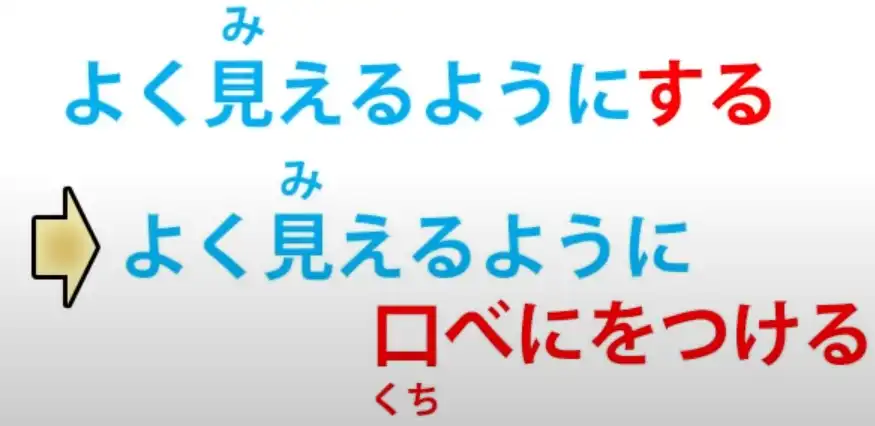
Now, as you see, in English the ways of putting those two ideas are different, and that’s why the textbooks and the conventional explanations talk as if we had two separate, unrelated grammar points.
But if you look at what’s going on, you can see that they’re actually the same thing.
In one case we’re saying “make someone or something look better” without specifying the means.
We’re just using the neutral, catch-all verb “する”, which is the fundamental other-move verb.
When we say “よく見えるように口紅をつける”,
“口紅をつける” is simply replacing the “する”.
Instead of unspecifically saying simply “make someone look better”, it’s saying “do a specific thing in order to make someone look better”.
Now, “する” is also an action; it’s just an unspecified action.
It’s just “do/act/make something happen”.
“口紅をつける” specifies what that “する” might be in a particular case.
So you see, we have exactly the same construction here, not two separate “grammar points”, as they like to call them.
ように at the end of a sentence
And one final note is that you will sometimes hear “ように” at the end of a sentence, usually a ます-ending sentence.
This is used primarily for prayers and petitions.
So you might say “日本に行けますように”.
And you might say that at a shrine or when you’re wishing on a falling star or perhaps just when you’re expressing a wish that a friend might be able to go to Japan.
Why do we use this?
Well, obviously it’s a kind of shortening of “ようにする”.
If you’re talking to a deity or a fairy, it might be short for “ようにしてください”.
So, next week we move on to “ことになる” and “ことにする”.
29. ことにする & ことになる
Lesson 29: Koto ni Suru, Koto ni Naru. The simple logic behind them.
こんにちは。 Today we’re going to discuss “ことにする” and “ことになる”.
Last week we looked at “ようにする” and “ようになる” and we briefly recapitulated the fact that when we say “(something)になる” we mean that the thing we’re speaking about turned into whatever is marked by に.
So if we say “さくらはカエルになった”, we’re saying Sakura turned into a frog.
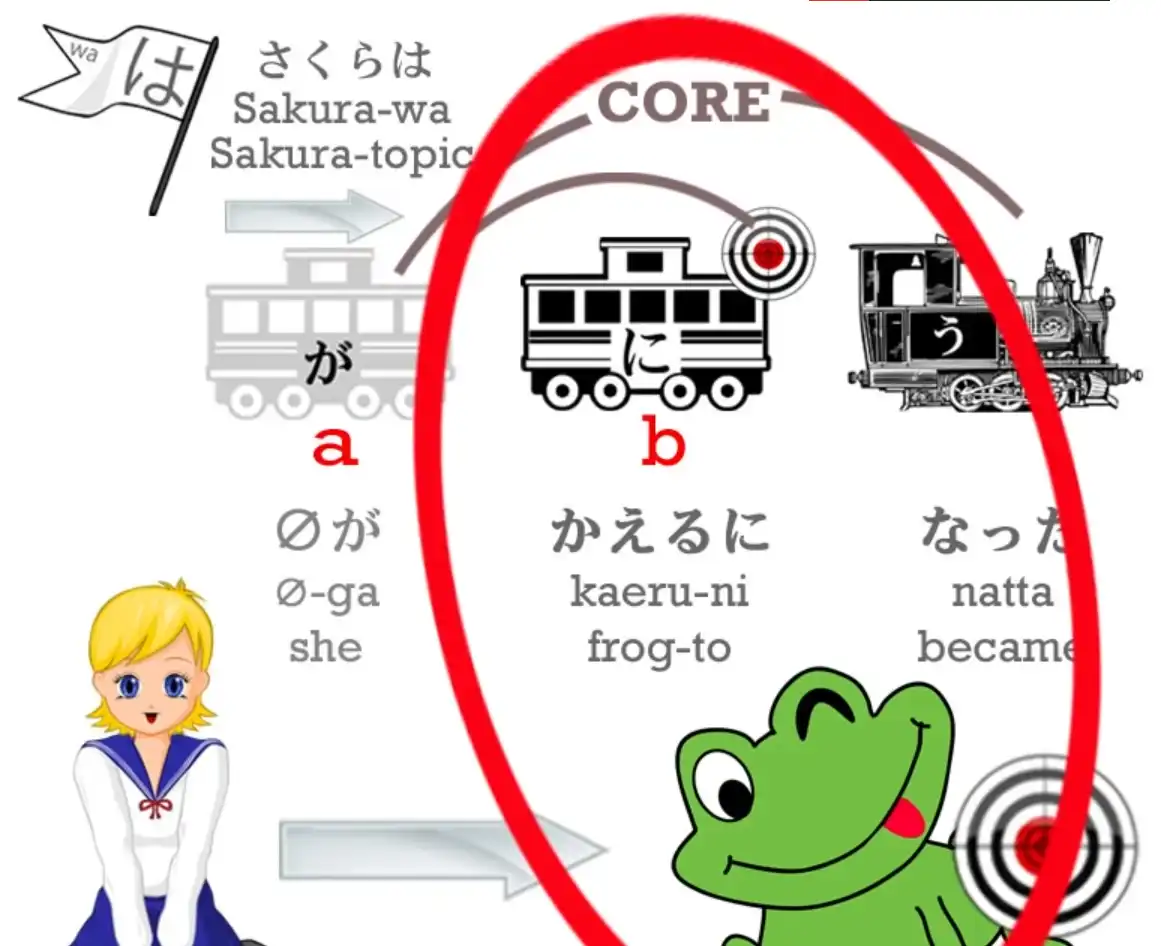
If we say “にする”, we’re saying that someone deliberately turned what we’re talking about into the に-marked noun.
So, if we say “まじょがさくらをカエルにした”, we’re saying
”the witch turned Sakura into a frog.”

So, what about “ことにする” and “ことになる”?
We know that “こと” means a “thing”, not a concrete thing like a book or pencil (=もの) but an abstract thing, a situation, or a circumstance. (=こと) So, if we say “けっこんすることにした”, we’re saying literally: It became the thing of getting married.
Obviously we have to have a zero-pronoun here, because something has to become something.
So, what’s “it”?
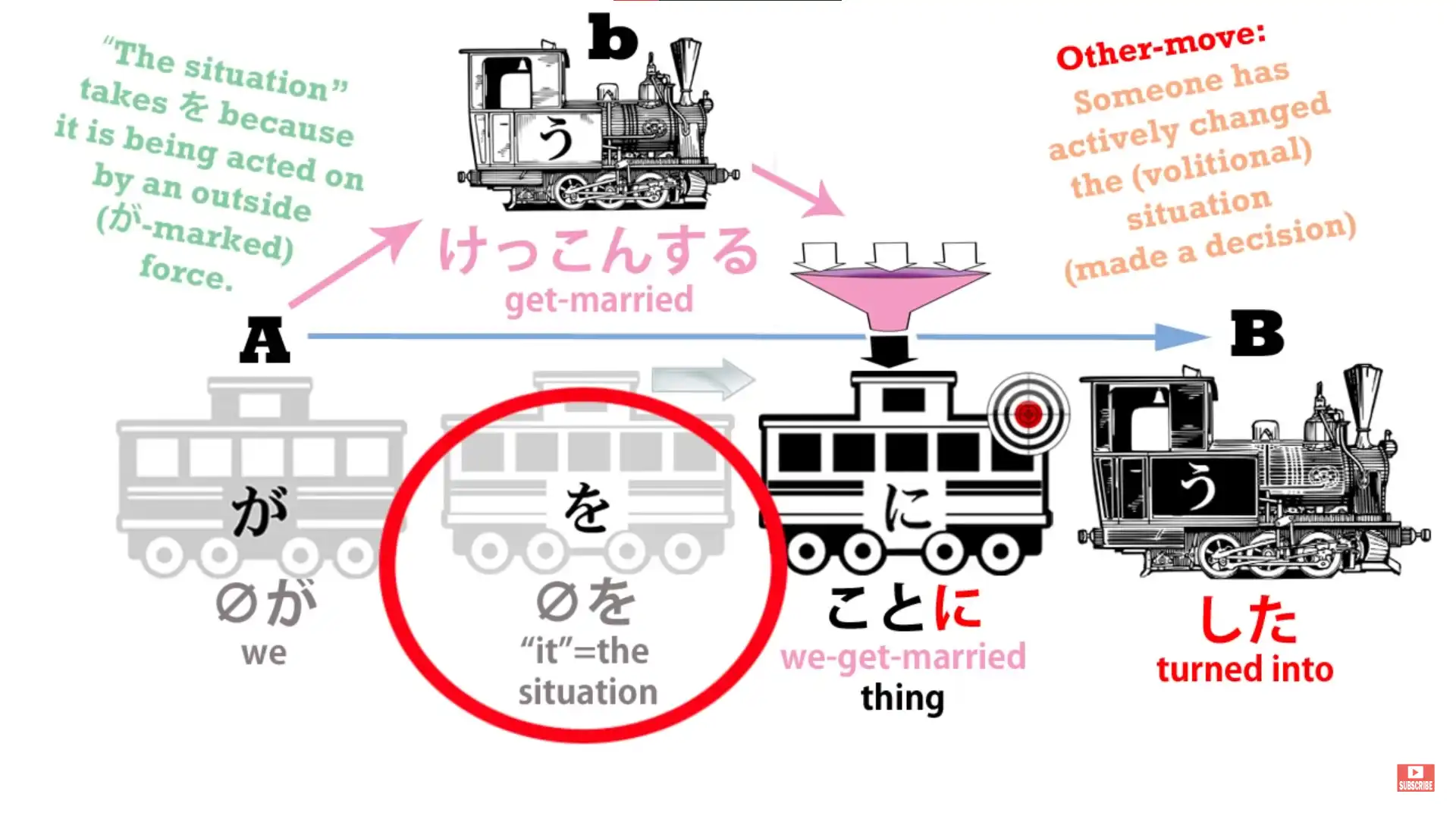
Well, “it” is what it might be in English: “the situation / the circumstance”.
“The circumstance turned into one in which we’re getting married/in which getting married is the thing.” We have to use “こと” here because, as you know, we can’t attach the logical particle に, or any other logical particle, to anything but a noun.
So, we use “けっこんする” as the modifier for “こと” in order to give us a noun of the situation or circumstance of getting married.
So what does it mean?
“We turned the situation into the thing of getting married” means “We decided to get married” / “We brought about a situation in which getting married was the thing”.
And so the textbooks will tell you that “ことにする” means “decide (something)”, and it’s not quite as simple as that, as we’ll see in a moment.
However, if we say “フランスで留学することになった”, we’re saying “It became the thing of studying in France”, which really means “It came about that I am going to study in France”.
The situation turned from one in which I’m not going to study in France to one in which I am going to study in France.
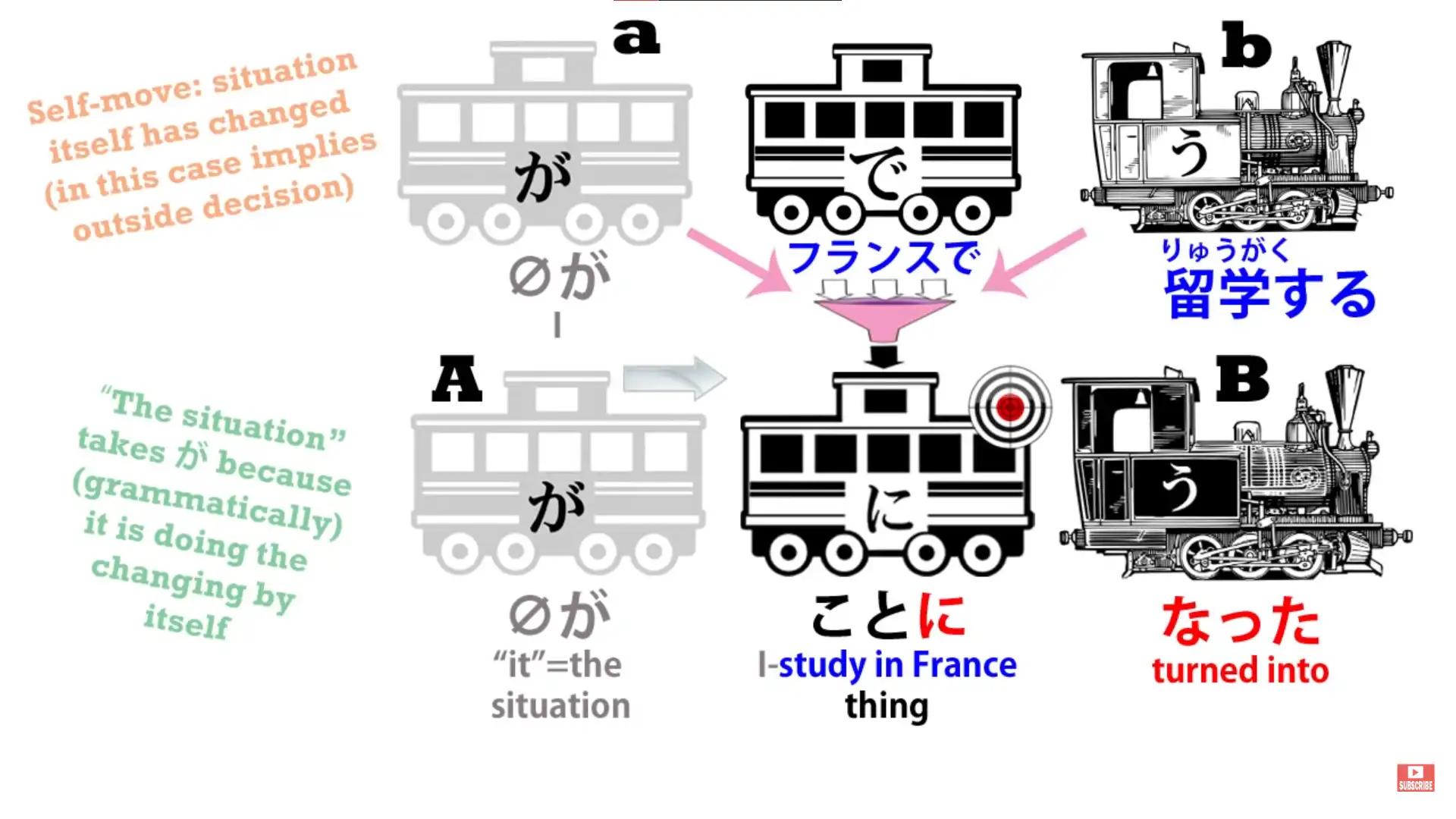
Now because “ことにする” is a deliberate act done by whoever is making the decision, “ことになる” is taken to imply in many cases a deliberate decision.
So we can translate this most of the time as “They’re sending me to France to study” / “It’s been decided that I’m going to France to study.” The thing to notice here, though, is that there’s no actual mention of a decision by anyone, and in this case it doesn’t matter if we assume that that’s what it means, because it probably does.
Some people will say “けっこんすることになった”, which kind of means “It’s been decided that we’re getting married” or, more literally, “It’s come about that we’re getting married”.
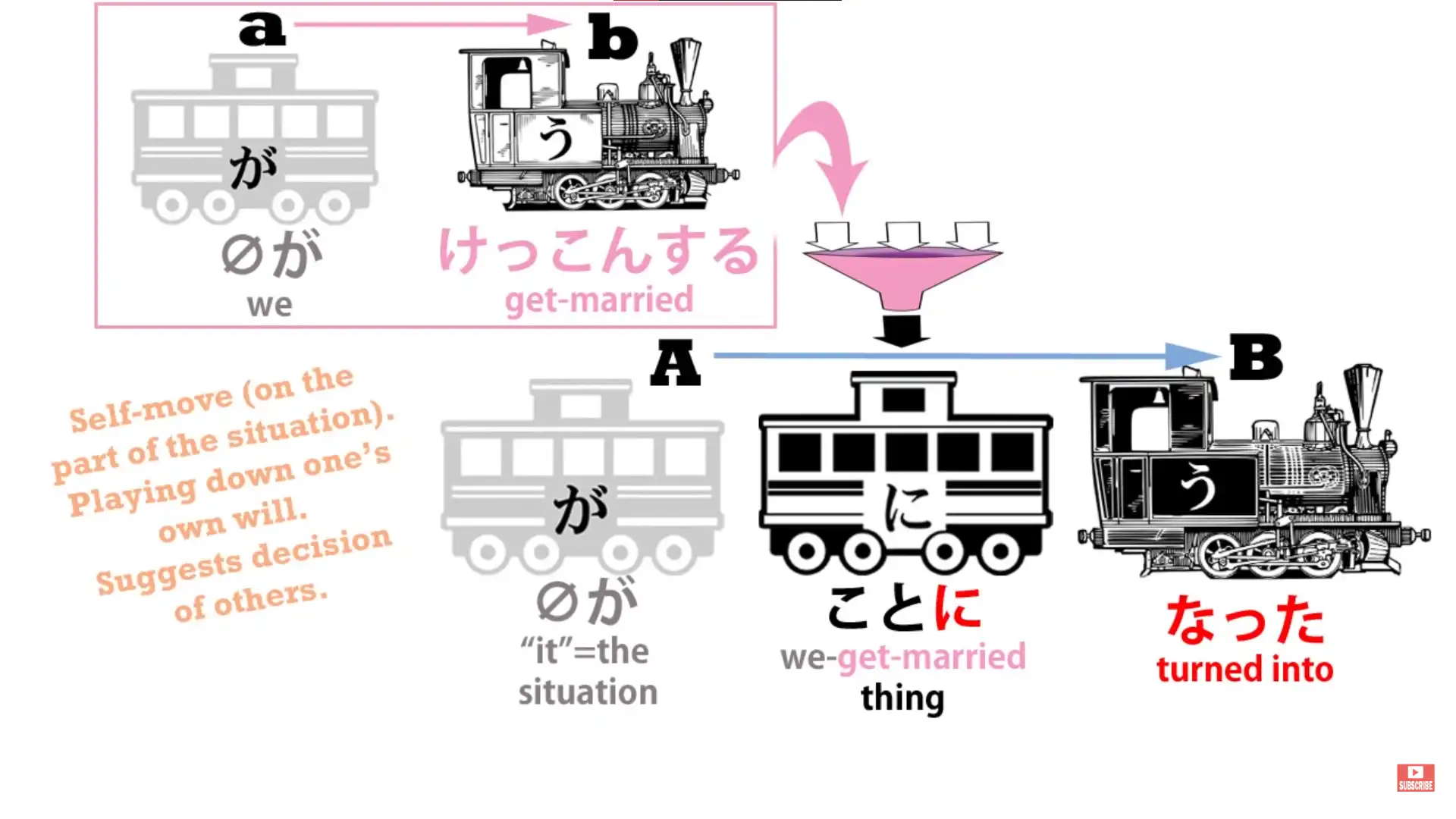
And the reason for saying this is that, even though in this day and age, the people who decide that they’re getting married are almost always the people who are actually getting married, it sounds a little less forceful, a little less ego-centered, not to say “we’ve decided…” but just to say “It’s been decided…” or “It’s come about…” And I have to say that sounds a little bit more pleasant to me as well, but I’m just an android, so what do I know?
However, we may also say “たいへんなことになった”, and what that means is “It became – the situation became – a terrible thing”.
And this does not carry any implication that anybody decided it ought to be a terrible thing.
It does not imply a decision, and there’s no reason it would, because there’s no mention of decision anywhere in “ことにする” or “ことになる”.
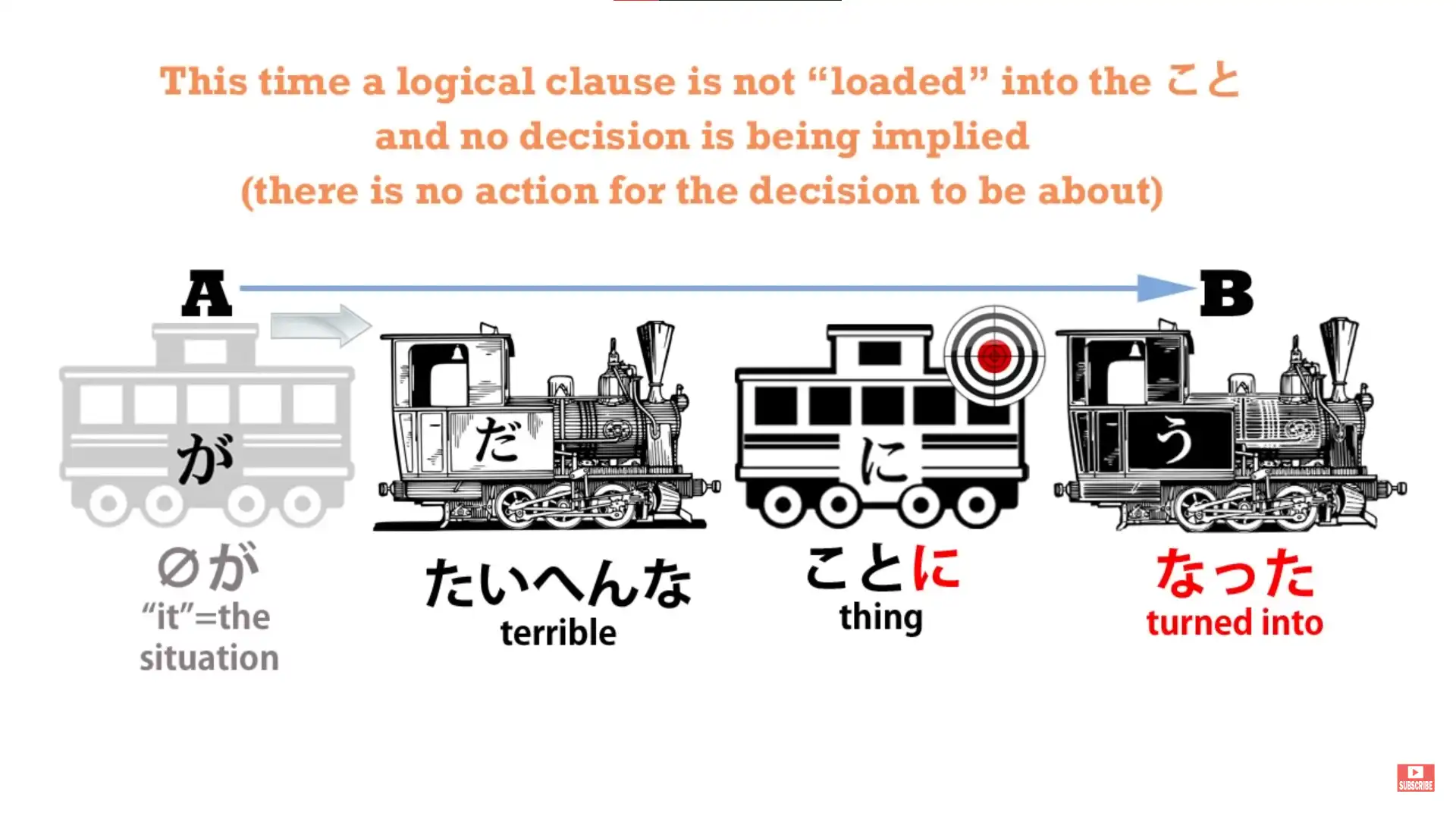
In many cases a decision is implied, but in cases like this – and there are many times when you’ll see “ことになる” working in this way – all it’s telling us is that the situation came about, not that anybody decided that the situation should come about.
So this is why it’s important to learn structure in Japanese, because if we just get a handful of Japanese and a handful of English thrown at us – “ことになる” means “it is decided” – well, sometimes it does and sometimes it doesn’t.
The important thing to know is what’s actually going on in the sentence.
Then we can make a sensible assessment ourselves of what’s being said when we see it in an anime or a book or in conversation.
Note: I will just in case put up a further explanation by Dolly-先生, responding to a comment regarding this ことになる/する, which she later pinned, since I feel it can be a bit tricky.

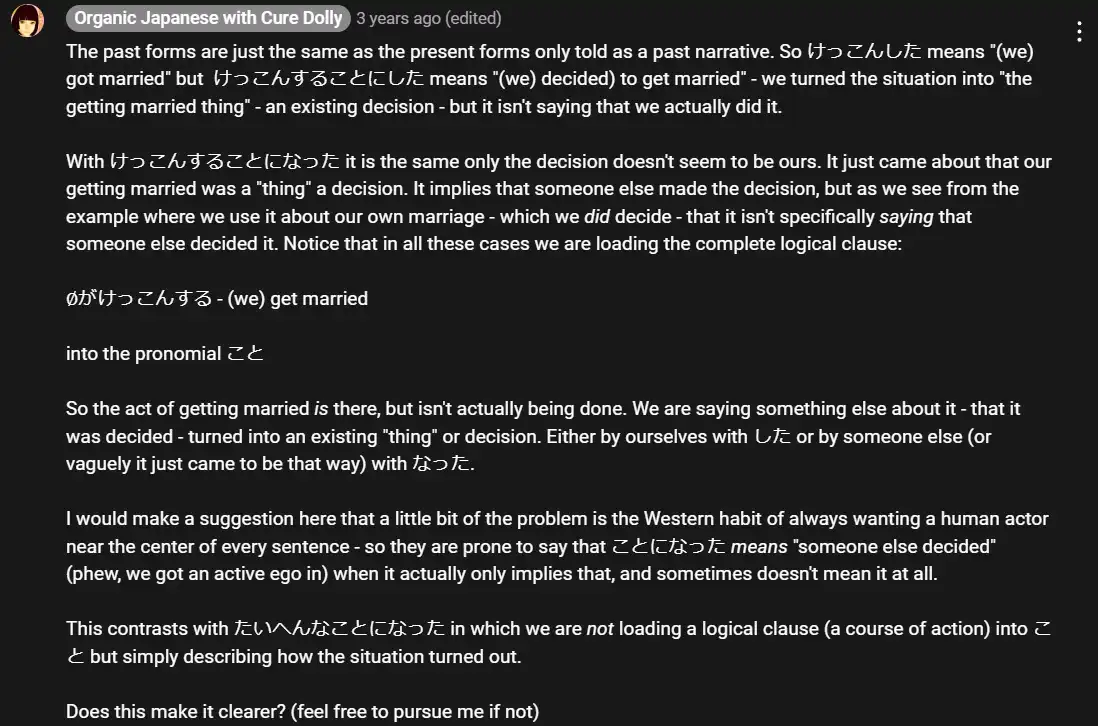
*Continuing with - the link is for the Lesson 28 by the way,
*
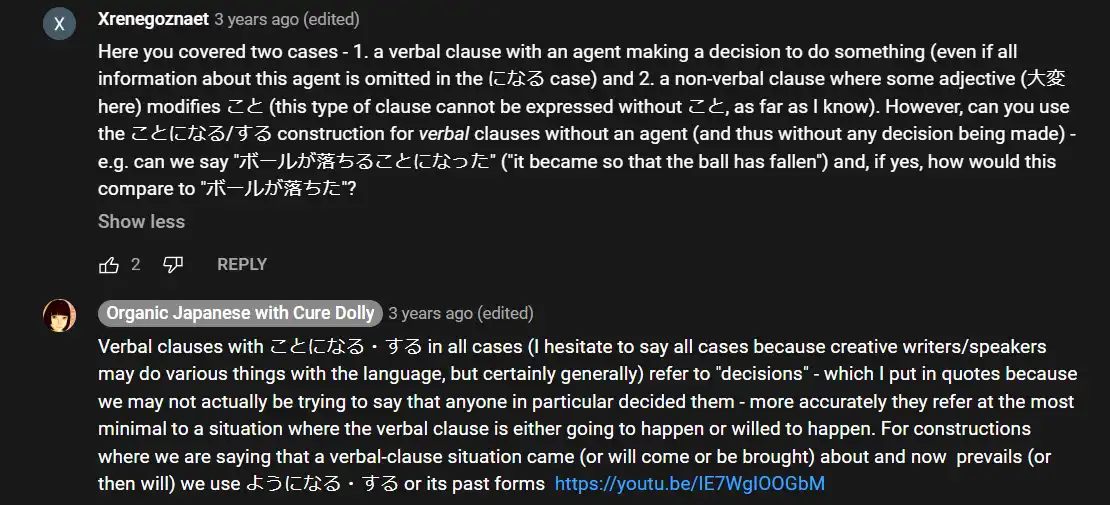
Hopefully this helps a bit in case the lesson explanation was a bit confusing, you can read the other comments under the video if you want, perhaps some other one may also help.
30. Japanese Conditionals: と
Lesson 30: Japanese conditionals: とTO. What the textbooks don’t tell you.
こんにちは。 Today we’re going to start talking about Japanese conditionals.
Conditionals are when you say something like “If…” or “When…” And in Japanese there are a number of different conditionals, and this can cause some confusion to learners.
Which one do we use, and when, and why?
As usual, we tend to get a list of these things from the text-books with complicated instructions, and as usual it helps a great deal if we can understand the underlying logic.
So, this lesson we’re going to start with the conditional と.
Now, we’ve already met this と.
It is the “exclusive and” particle.
I’m not talking about Boolean logic here.
I’m talking about the fact that Japanese has two words for “and” which are used to connect two nouns.
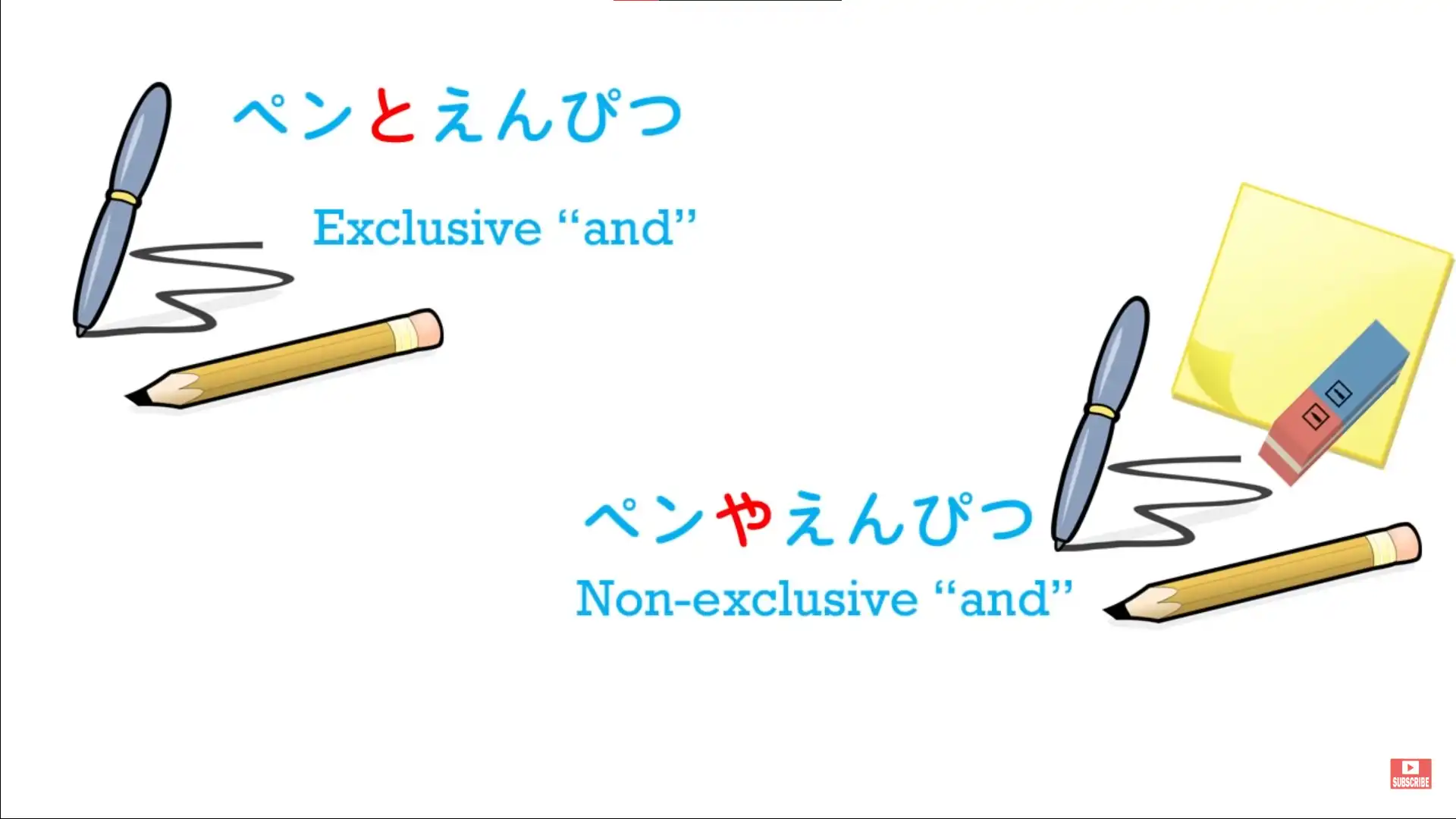
One is や, and や is the same as English “and”.
It means one thing “and” another “and” possibly other things too.
If we say “hat and coat”, we may well have on shoes and skirt and pants and other things too, but we just say “hat and coat”.
In Japanese, if we say “ペンや本” – “pen and book” – we’re saying, just like English “and”, “a pen and a book and maybe some other things and maybe not”.
But if we say “ペンと本”, that is exclusive.
We’re saying “pen and book and nothing else”.
Now, this is important to understand because this is exactly the same と that we use as a conditional.
The textbooks tend to introduce this と as if it were something different from the “and” と, but it’s not – it’s the same.
There is another と and that is the quotation particle which we’ve covered at some length in more than one lesson. That is separate from the “and” と.
But the conditional と is not: it’s the same と.
And when we understand that, it becomes much easier to see what’s going on with this particular conditional.
Now, one more thing we need to know is that this と is a particle, but it’s not a logical particle. And it’s not a non-logical particle either.
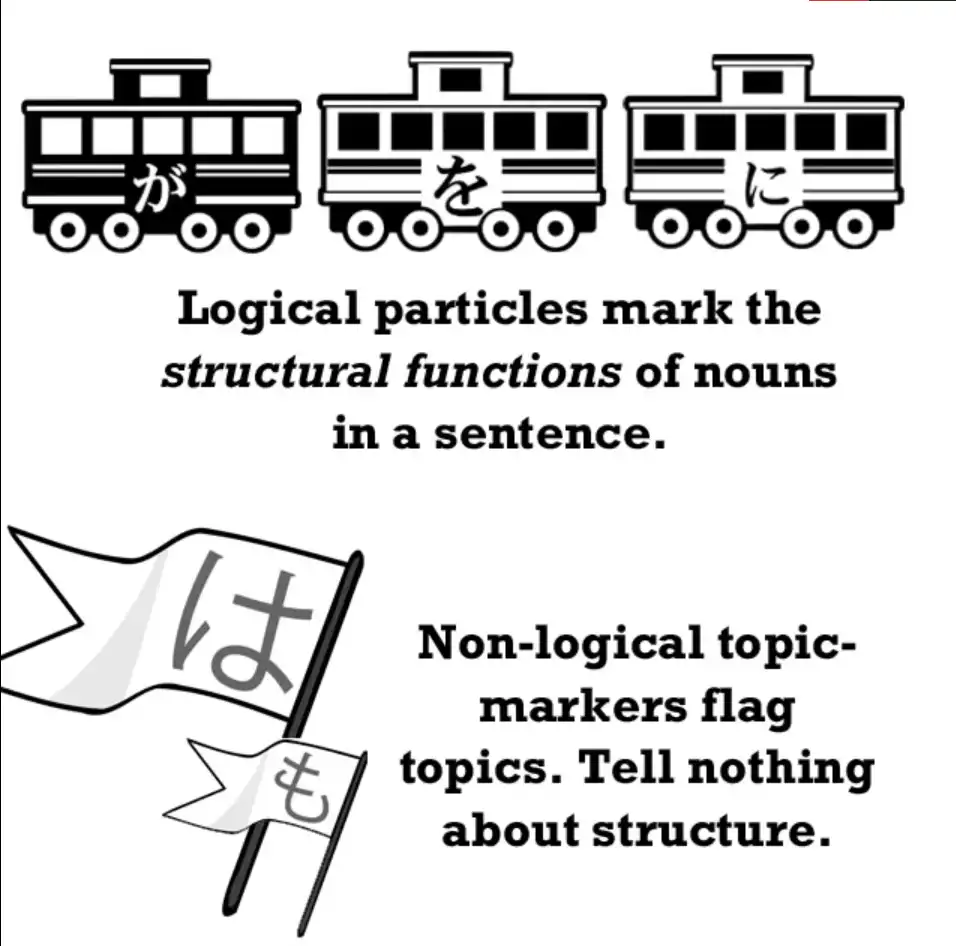
What do I mean by this?
Well, a logical particle is a particle that marks the case of a noun.
Now, you don’t need to know what that means – it’s not important to get that theoretical knowledge.
What it means is, in plain English, that it tells us what the noun is doing in the sentence in relation to other nouns and in relation to the verb.
The が particle tells us that the noun is being or doing something; the を particle tells us that it is having something done to it; the に particle tells us that it is a target.
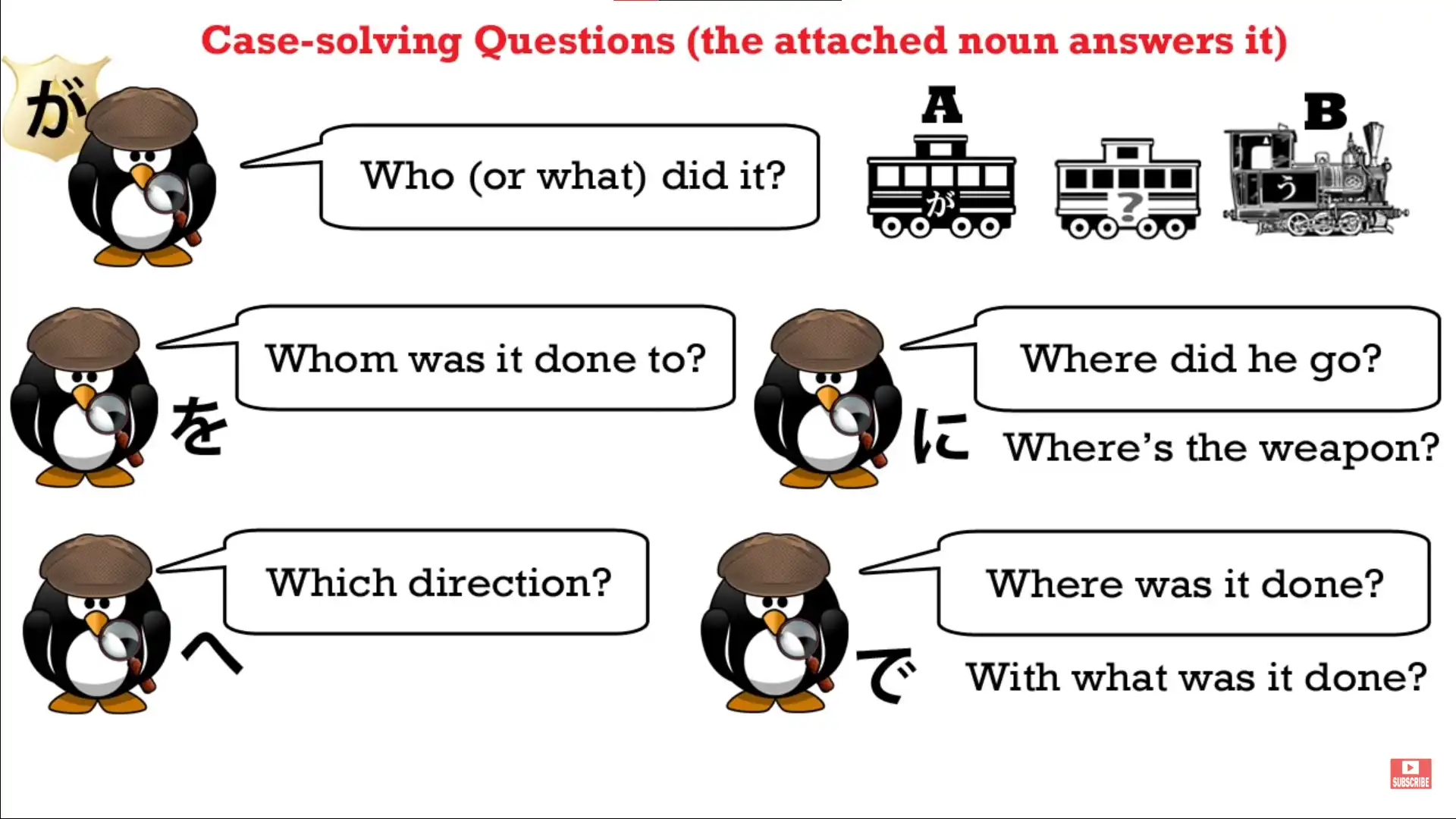
So what logical particles do is tell us who is doing what to whom and where and when.
Non-logical particles は and も mark the topic, which is not a logical construction.
They tell us what noun we’re talking about but they don’t tell us what part it plays in the sentence.
Now the point about logical particles is that they must attach to nouns.
They can’t do anything other than attach to a noun.
And this is obvious, because that’s their function – to tell us what role a noun plays in a sentence.
と is not a logical particle and therefore, while it can attach to nouns, it can also attach to a logical clause and that’s what allows it to be a conditional.
All right. So now we know enough to go ahead.
If I say, “冬になると寒くなる” – “When it becomes winter (or, if it becomes winter) it gets cold.” So why is this connected with the “exclusive and” function of と?
It is connected with it because what we are saying is that only one possibility exists, only one result can follow from what we’re talking about.
If winter comes, it will get cold – there’s no other possibility.
If rain falls, the ground will get wet – there’s no other possibility.
It can also be used in a hyperbolic fashion.
We’ve talked about hyperboles before, haven’t we?
This is where you say something that exceeds the truth.
And human language does this all the time.
So, someone might say “それを食べると病気になる” – “If you eat that, you will get sick.”
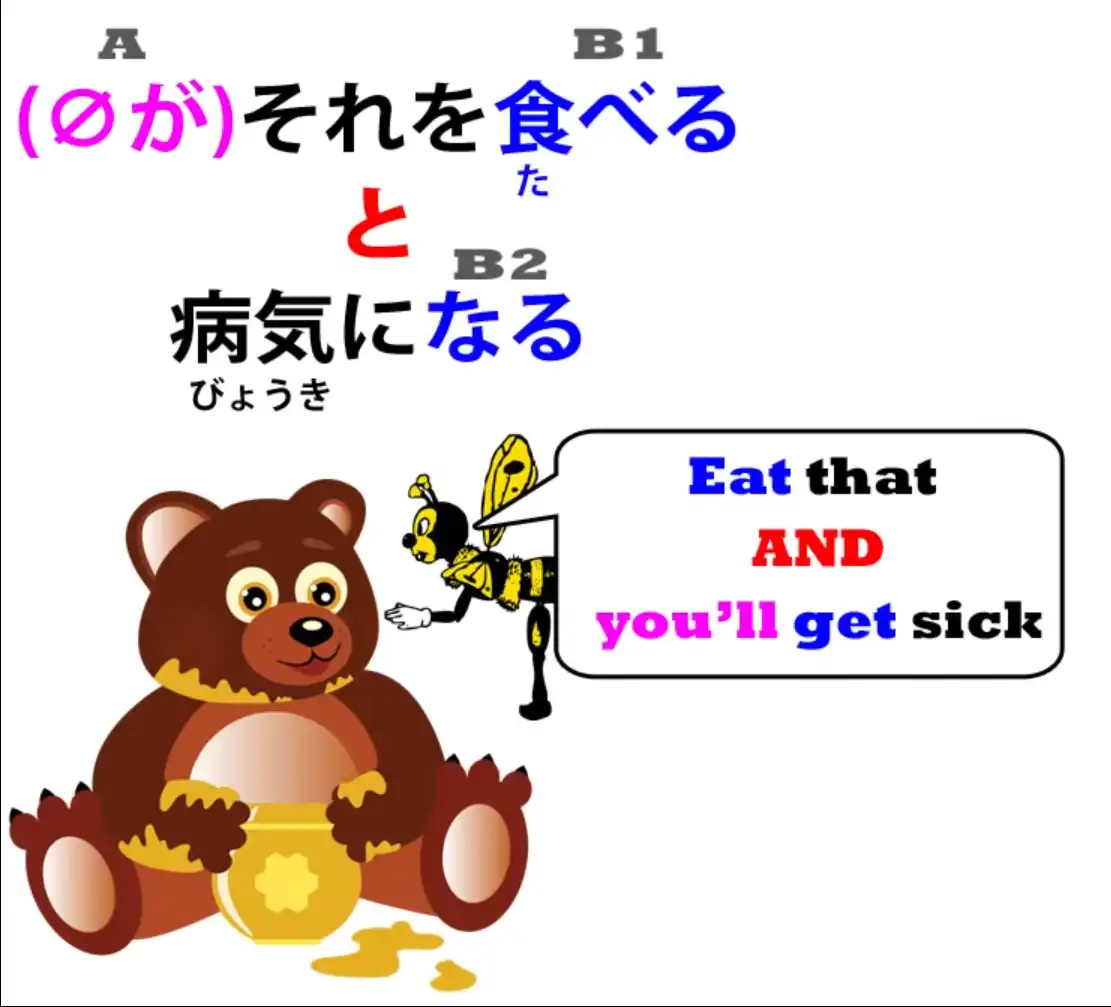
Now, this is not like winter coming and it getting cold or the rain falling and the ground getting wet.
It’s possible that you might eat it and not get sick, but this is a hyperbole.
What you are trying to say to someone is “If you eat that, you will get sick”.
“If you keep playing those games, you’ll fail the exam.” Now again, it’s possible that the person might keep playing the games and still get through the exam, but the hyperbole is “Do A and B will happen”.
“Keep playing those games and you’ll fail the exam.” “Eat that and you’ll get sick.” We are putting something forward as an inevitable result, an exclusive result, a result to which no other alternative exists.
Now, we can also use this と to mean that something is necessary.
We can say “行かないとダメ” – “If I don’t go, it will be bad.”
Note: だめ is in katakana, usually it’s done for style, to spot words better in-text/avoid confusion or for emphasis of it, maybe to give it more emotional force or such.
“勉強しないと行けない” – literally, “If I don’t study, it can’t go”
but what that means is “If I don’t study, it won’t be good”
(“…it won’t do”, as we might say in English).
And what it actually means is “I must study / I’ve got to study”.
And very often you’ll hear this just on its own.
For example, “逃げないと!” And that just means, literally “We don’t run and…” That’s to say, “If we don’t run…” And the implication here is that if we don’t run, something bad will happen.
So if in an anime somebody says, “逃げないと!” they’re really just saying “Run! / We must run.” And in this sense, と, because it is so absolute, because it is so exclusive, is stronger and a little more colloquial than similar uses like ば/れば.
And we’ll talk about the ば/れば construction next time.
31. The ば / れば Conditional
Lesson 31: The BA conditional. What it really means and how to use it easily.
こんにちは。 Today we’re going to talk about the conditional ば/れば.
Last week we looked at the と conditional and we saw that its particular characteristic was its exclusiveness, its implication that only one outcome is possible.
In many cases we can use any or most of the conditionals without changing the meaning to any great extent, but each conditional has its own particular qualities.
So today we’re going to look at the special quality of ば/れば and some of the things it does and why it does them.
First of all, what is ば/れば?
ば/れば is a helper which we put on to the え-stem of a verb.
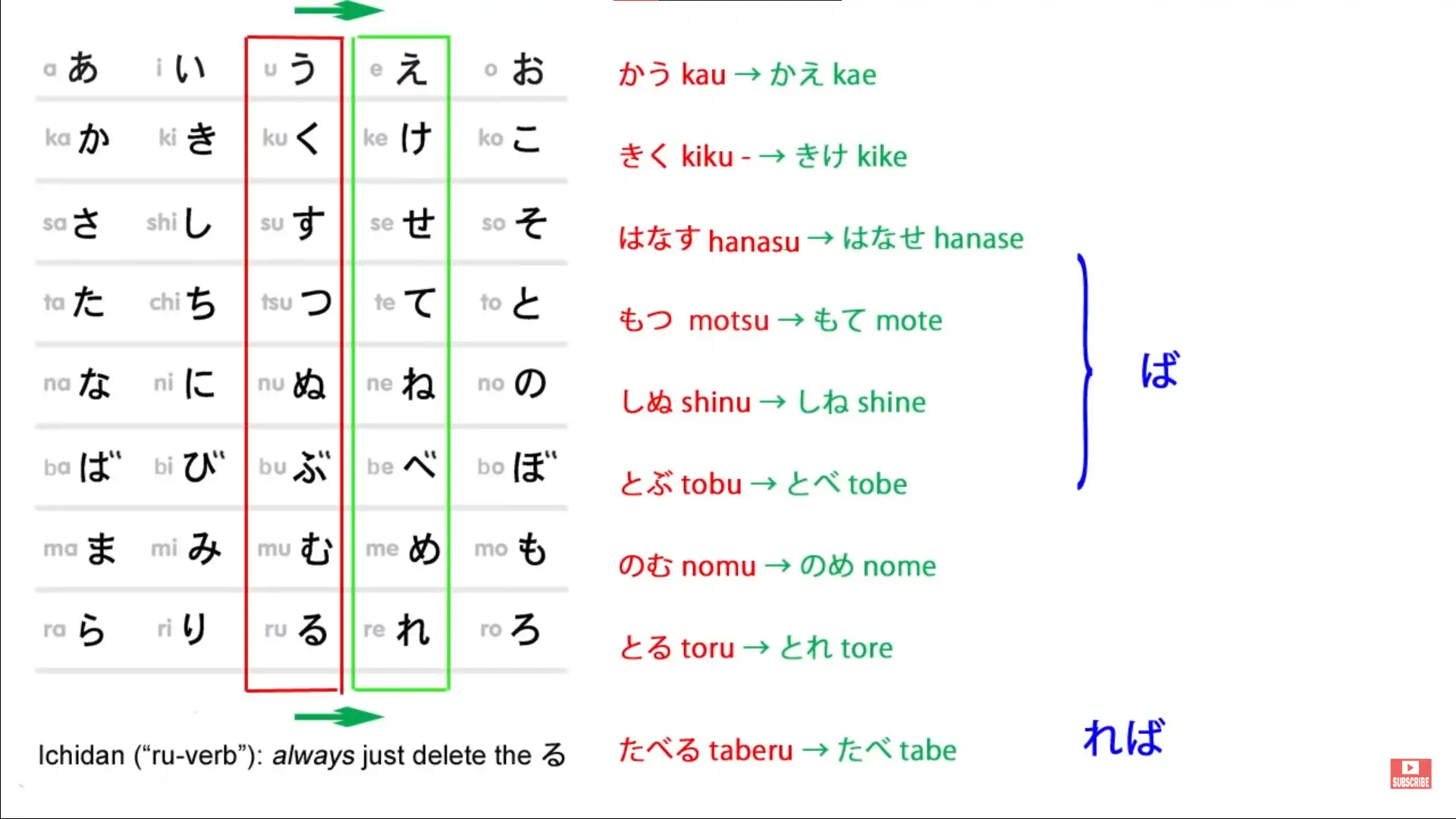
The え-stem is one of the lesser used stems but ば/れば is one of the things that uses it.
So, for godan verbs we put it on to the え-stem
and for ichidan verbs, as always, we simply put it on to … we simply take off the -る and add the ichidan form, -れば.
For the two irregular verbs, in this case they work exactly like regular ichidan verbs.
So “来る” becomes “来れば” and “する” becomes “すれば”.
Actually, “来る” and “する”, I would say, are in fact ichidan verbs, but they’re strong ichidan verbs. A strong verb is a verb that can change its vowel sound.
In English we have “come” and “came”, “eat and “ate”.
And “来る” and “する” in some cases change their vowel sound.
“来る” in the negative becomes “こない”, “する” becomes “しない”.
But in this case they don’t change their vowel sound at all, so that’s very simple – they just work like the ichidan verbs that they fundamentally are.
For adjectives, we take off the -い and use the helper -ければ.
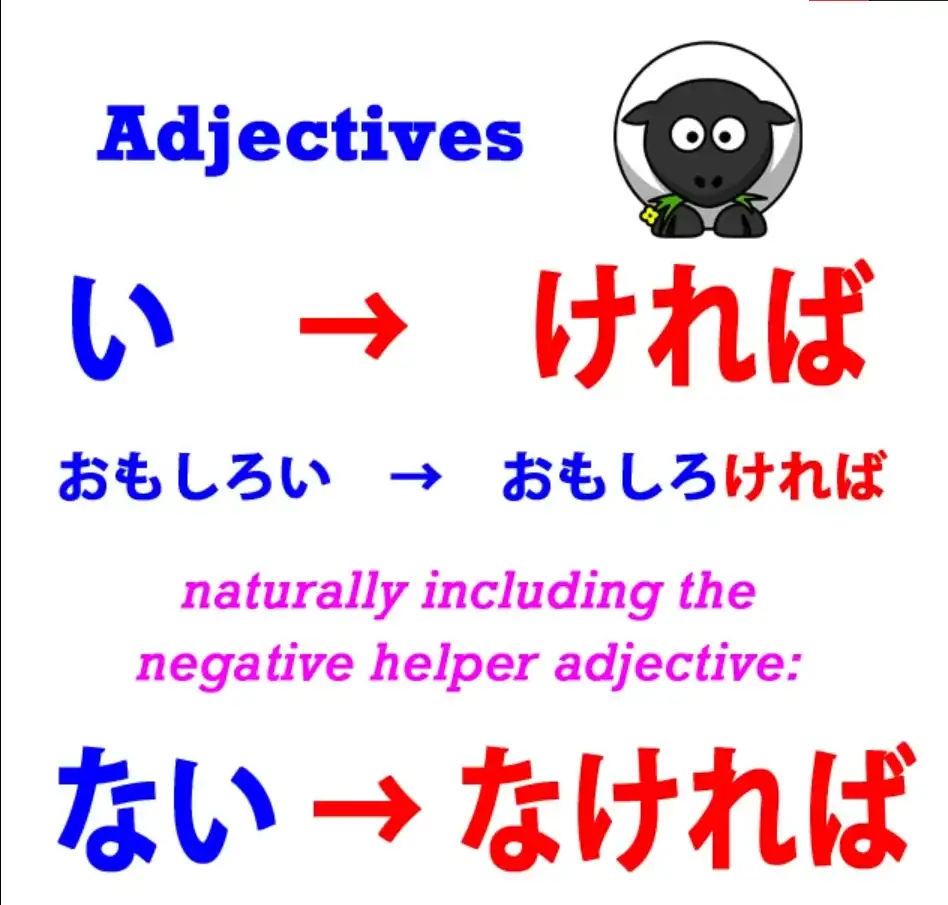
You might notice that when we do anything with an adjective other than simply take off the -い and add whatever we’re going to add, the specific adjectival modifications all come from the か-き-く-け-こ row. So, the negative of an adjective is -くない (“面白い” –> “面白くない”); the past is -katta (“面白い” –> “面白かった”); and the ば conditional is -ければ (“面白い” –> “面白ければ”).
So in a way we could say that if adjectives had an え-stem, it would be -け.
And that’s what we use in that case.
So what’s the special characteristic of ば/れば?
-と, as we know, its special characteristic is its exclusiveness.
The special characteristic of ば/れば is that it is used for hypotheticals. So it must always mean “if”.
It can’t ever mean “when”, because we never know for sure if the condition will take place and consequently if we use it about something that happened in the past it has to be something that didn’t happen because if it did happen we wouldn’t be dealing with a hypothesis, we’d be dealing with a fact.
Now this hypothetical nature of ば/れば allows it to be used in many common and very important Japanese expressions.
For example, “どうすればいい”.
What this literally means is “how, if I act, will be good”.
And I’ll just note here that while “する” is generally translated as “do”, in many cases the best way to render it into English is as “act”.
So, for example, if we say “静かにする”,
we’re not saying “do quietly”, we’re saying “act quietly”.
So, “どうすればいい” – “how, if I act, will be good”.
And in English what we’d normally say is “What should I do?” But in Japanese we don’t say that.
As we’ll see, this is partly because the concept of “should” isn’t quite the same in Japanese, and ば/れば is often used to solve the problem.
We’ll come back to that in a moment.
Another common use of ば/れば is in “すればよかった”.
For example, “かさを持ってくればよかった”.
In English we would say “I should have brought an umbrella”.
What we’re actually saying here is “If I had brought an umbrella, it would have been good”.
“持ってくる”, as I’ve explained elsewhere, we join the word “carry” and the word “come” to mean “bring” (“carry-to-here”) and we notice that “よかった” throws it into the past tense.
As you know, in Japanese, we mark the past tense at the end of a logical clause.
So even though it may be true that if it’s raining right now, if I had brought an umbrella it would have been good and it still would be good, we throw the whole thing into the past tense with that final “よかった”.
“かさを持ってくればよかった” – “I should have brought an umbrella / I wish I had brought an umbrella.” Now notice that in both these cases, “どうすればいい” / “かさを持ってくればよかった”, we are using this “if it were done, it would be good” to mean “should”.
And this happens again in an even commoner Japanese construction.
“勉強しなければいけない” – “If I don’t study, it won’t go / it won’t do.” Now what we are actually saying here is “I must study”.
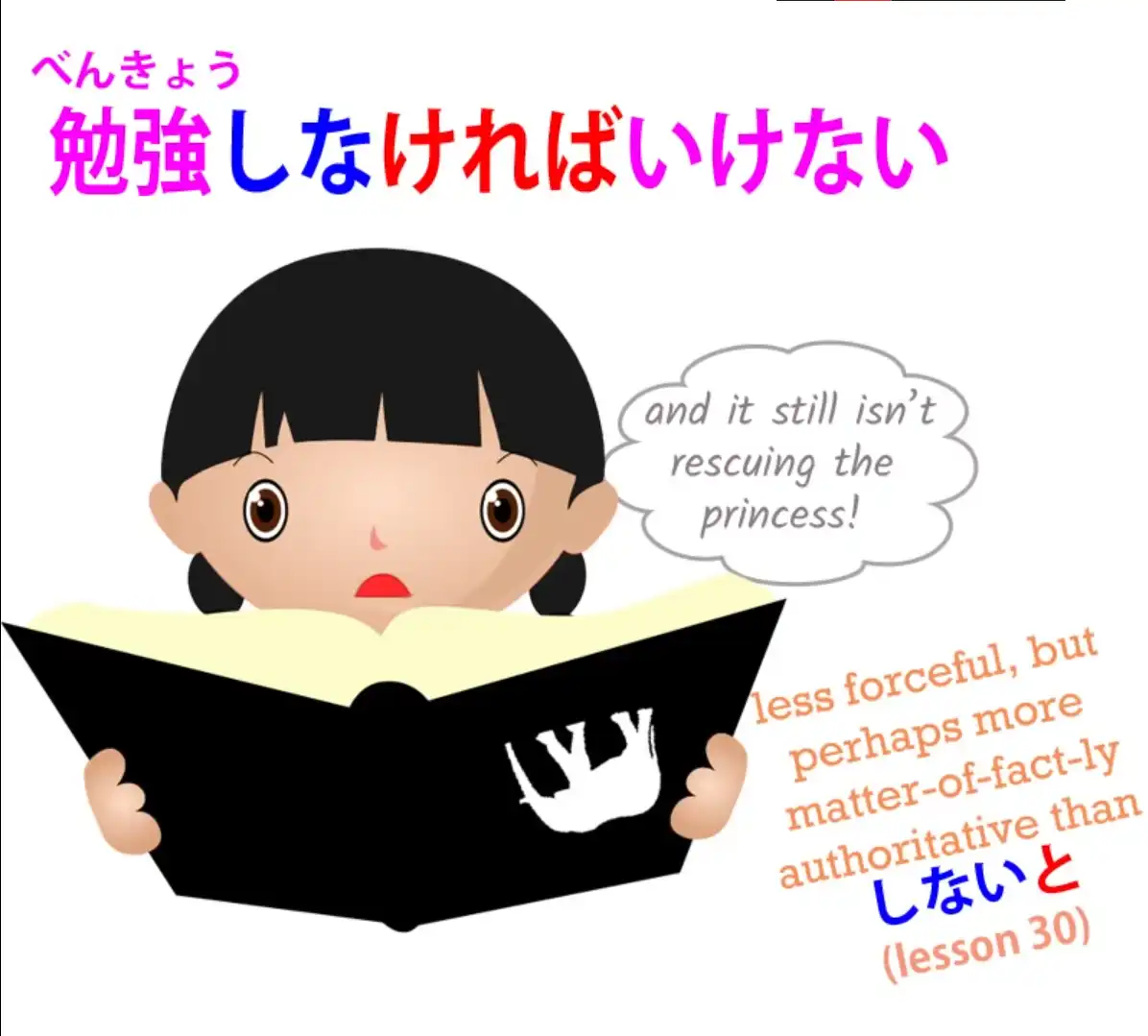
There actually isn’t a word for “must” in Japanese, so we always construct it this way.
We say “If I don’t… (whatever it is)” and then we can say “it won’t be good / it will be bad / it’ll be a disaster…” Whatever we say, some negative construction then follows this, and what we’re saying is “I must go / I’ve got to go / I’ve got to do this / I’ve got to do that”, and this is because we don’t have that construction “got to” and we don’t have “must” in Japanese.
It always has this rather lengthy “If I don’t do, it won’t be good / if I don’t do, it won’t do / If I don’t do, it’s bad” – “無ければ / なければダメ”.
And because it is indeed a very long-winded way of saying something common like “must” or “got to”, it often gets cut down in casual speech to just “しなければ” or even “しなきゃ”, which is short for “しなければ”, without adding the negative ending, because that’s just implied.
However, even in very casual speech it’s often said in full, and I think this is to emphasize the nature of the “must”.
“なぜ行かなければいけない?” – “Why have I got to come/go?”
*Note: if it helps, more literally something like “Why if (I) don’t go, (it’s) bad/it won’t do?”
Or as Dolly-先生 says in the comments for 行かなければいけない + what that いけない means:
*


In cases like that, where we’re putting stress on it as opposed to cases where
we’re just saying casually “行かなきゃ” – “I’ve got to go”.
Note: literally maybe “If (I) don’t go…”, negative afterwards is just implied/unvoiced
So this is the special characteristic of ば/れば, that it’s dealing with hypotheticals.
32. The たら, なら Conditionals
Lesson 32: Conditionals made clear! Tara, nara - how they really work
こんにちは。 Today we are going to complete our mini-series on conditionals with the conditionals たら and なら.
たら Conditional
The -たら conditional is particularly easy to form because all we do is form a verb or an adjective into its -た/-だ past form, and we know how to do that.
Once we’ve done that, all we do is add -ら and we have the conditional ready-made.
It’s no coincidence that -たら and -だら are formed on the past, because this is the only conditional that can be used about past events.
Now, of course, when we are using it about past events it’s not really a conditional, because we are no longer saying “if…”, we are saying “when…” We know that the condition was fulfilled because it’s already happened.
But what it does is shows that the event that happened in the past was unexpected or surprising, and this is because rather than using one of the more regular means of showing that one event followed another, such as the -て form or -から, we are using an if-type conditional.
So we are stressing the fact that what did happen might well not have happened and indeed it might have been more in line with expectation if it hadn’t happened.
So, if we say “家に帰ったらさくらがいた,” we’re saying “When I returned to the house, Sakura was there,” and obviously we’re very surprised to find that Sakura is there.
She didn’t even have a key; she must have gotten in through the window.
Sakura does that sort of thing sometimes, you know.
Now, of course, we can also use it as a true conditional about future events, and when we do that, it tends to throw stress on what will happen if the condition is fulfilled, as opposed to -ば/れば, which throws more stress on the question of whether or not the condition will be fulfilled or even the fact that it wasn’t fulfilled.
And this is perhaps natural, because just as in its past form -たら can mean more-or-less “when” something takes place as much as “if” it takes place, it certainly can be used for things that we don’t know whether they will be fulfilled or not.
Most of the conditionals are interchangeable in many cases, but if we’re talking about a condition which we’re fully expecting to be fulfilled, we’re really saying more “when” than “if”, we’re most likely to use -たら.
Another note on the -たら and -ば/-れば is that we sometimes use the forms -ったら and -ってば with a small っ before them to indicate exasperation.
So we might say “さくらったら” or “さくらってば”.
And what this literally means is the construction (of which they are abbreviations) of “さくらと言ったら” or “さくらと言えば”, in other words “When you speak of Sakura…” And this is a bit like saying, “Oh, you” or “When you speak of Sakura, it’s always something like this, isn’t it?” It’s not flattering, it is critical, but it’s not very strongly so, especially in the case of -ったら.
It can be quite humorous or joking or a kind of friendly exasperation.
In my experience, -ってば is more likely to express real exasperation, and it can be put on to the end of other things than just a person’s name.
For example, we might say “もう言ったってば”, which is “I’ve already said that, haven’t I?” Note: This may be a useful note about たら, so I will leave it here.

なら Conditional
Now, -なら is really the easiest of all conditionals to form, because all we ever do is put -なら after what we say and that turns it into a conditional.
We can put it after nouns and we can put it after complete logical clauses.
It’s very comfortable after nouns and we don’t need to use a copula, probably because the -な of -なら has its roots in the copula itself.
There are ways of grafting the other conditionals onto nouns, but I haven’t mentioned those, because I think it would just be unnecessary complication at this stage.
Generally speaking, all other things being equal, we’re most likely to use -なら with nouns.
Now, a characteristic of -なら is that more than the others it can be used of present and future conditions that really aren’t in doubt at all.
So, for example, if Sakura is worried that something may not be possible to her, we might say “さくらなら, できる” and that means “If it’s Sakura, it will be possible”.
Now, of course, we know it’s Sakura, we’re talking to Sakura, so what we’re really saying is “Since it’s Sakura, it will be possible” and we’re using it to reassure Sakura that we have confidence in her.
You might ask the way to the station; you might say, “駅はどこですか” and someone might reply, “駅なら, あそこです” and that’s saying “If it’s the station you’re asking for, it’s over there.” Now, of course, there isn’t any real doubt that it is the station you’re asking for, so it’s more like “Since it’s the station you’re asking for, it’s over there.” In both these cases there’s no doubt.
In the case of Sakura, we’re expressing confidence in her as a person – if it was someone else, it might not be possible, but if it’s Sakura, since it’s Sakura, it will be possible.
And with the station, we’re really just confirming that it’s the station we’re talking about.
And, as I say, the conditionals are very often interchangeable, but knowing the special characteristics of each one helps us to understand exactly what’s going on and which one we might choose ourselves.
Note: There were no notable pictures in the video - as for their lacking in this lesson here.
33. Limiting terms: だけ, しか, ばかり, のみ
Lesson 33: Dake, shika, bakari, nomi: making SENSE of Japanese limiting terms.
こんにちは。 Today we’re going to talk about terms of limitation: “だけ”, “しか”, “ばかり” (we’re already covered “ばかり” in a video of its own, but we’re going to look at how it fits in here) and “のみ”.
“のみ” is very easy and you won’t need to use it anyway, but it is important to understand it when you see it.
A lot of people find these terms confusing, but that’s only because they’re taught in a confusing way.
Once you see how they really work, they’re not difficult at all.
だけ
So, let’s start with the most basic word, “だけ”.
“だけ” means “limit”.
We’re sometimes told that it means “only”, and in its most basic form of expression “only” is what we would say in English.
However, it’s important in some of its other uses to realize that what it actually means is “limit”.
So, if I say “千円だけ持っている”, what I’m saying is “I have a thousand yen limit / A thousand yen is the limit of what I have”.
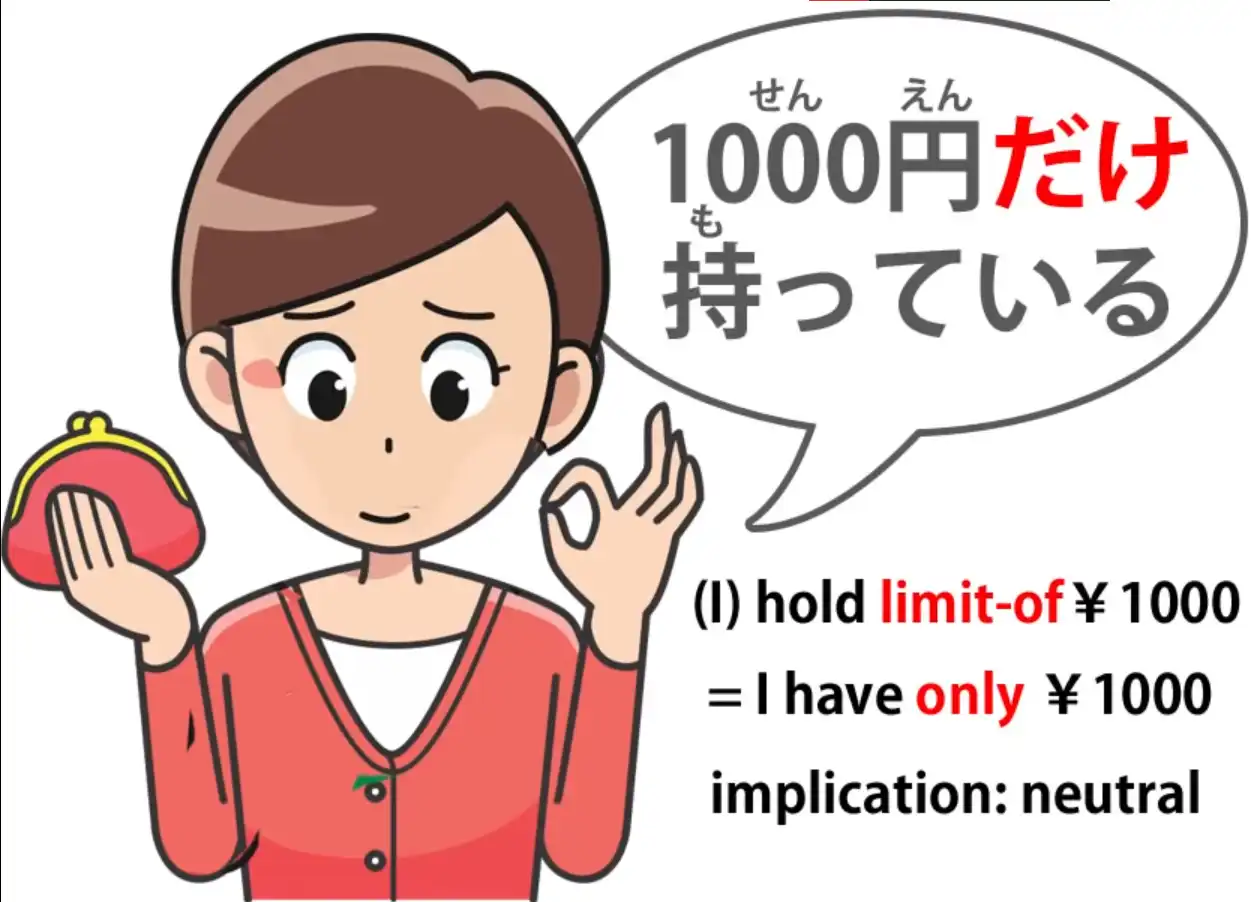
“だけ” is a noun, and when we put “千円” behind it, we’re using “千円” as the modifier to the noun “だけ”.
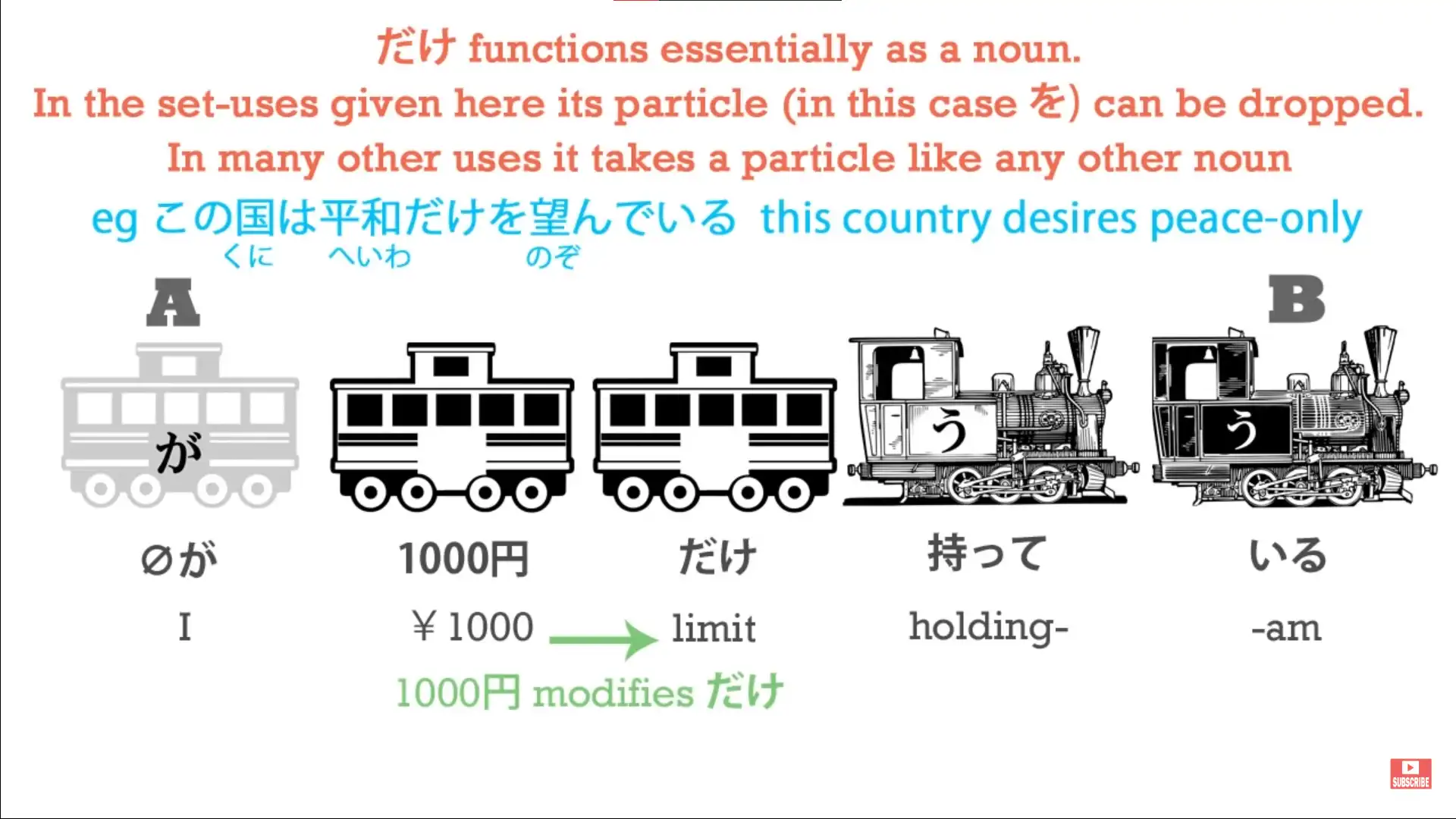
So we’re saying I have a limit of a thousand yen, a thousand yen is all I have.
So that’s simple enough.
We’ll come back to “だけ” in a moment.
Now let’s look at “しか”.
しか
Now, “しか” does confuse people and that’s because they’re given the impression that it means the same thing, more or less, as “だけ”.
And what it in fact means is the opposite of “だけ”.
“しか” means “more than”.
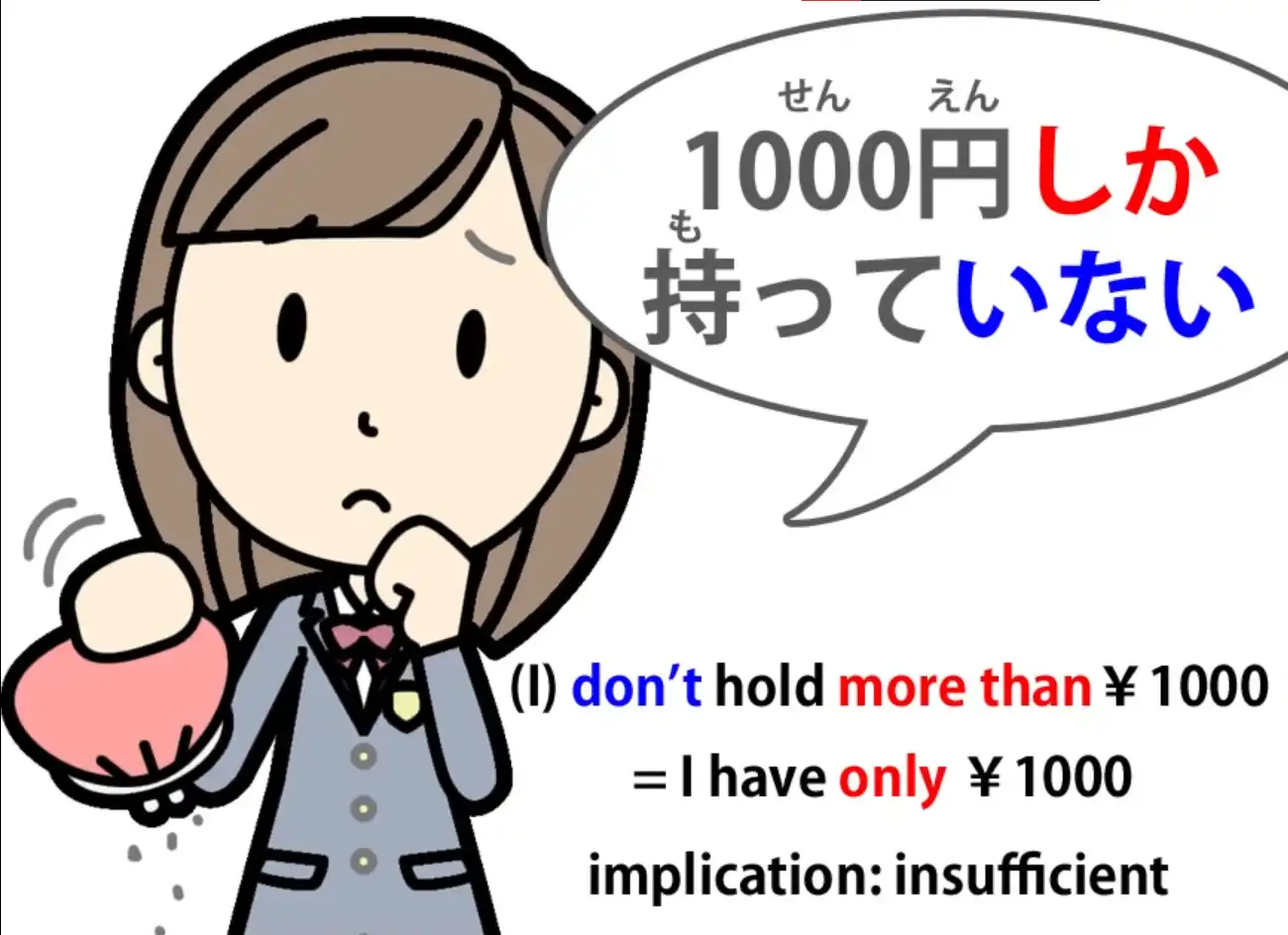
And if we understand that, we’ll never get confused about “しか” because it’s very simple.
The point is that it’s only ever used in negative sentences.
So, we always have a “ない” or an “ありません” when we use “しか”, so it ends up saying “not more than”.
And this is what makes it very similar to “だけ”.
But if we don’t realize that it actually means “more than”, we get very confused about how it fits into a sentence structurally.
So, if we say “千円だけ持っている”, we’re saying a thousand yen is the limit of what I have.
If we say “千円しか持っていない”, we’re saying I don’t have any more than a thousand yen.
And as you can see this is a negative sentence and the stress is on the negative.
It’s very similar to what we might say in English:
we might say “I only have a thousand yen” / (“千円だけ持っている”)
or we might say “I don’t have any more than a thousand yen” / (“千円しか持っていない”).
And you can see the difference between those two, and the difference is exactly the same in Japanese.
“だけ” doesn’t imply that a thousand yen is a lot or a little; it doesn’t imply anything about it, it’s just saying that that’s what I have and that’s all I have.
“I don’t have any more than a thousand yen/千円しか持っていない” is putting emphasis on the fact that this might be too little, or that if you were wanting any more you’re not going to get it, or whatever.
It has this negative emphasis because we’re putting all the emphasis on what I don’t have, not what I do have.
And that, in this context, is the difference between “だけ” and “しか… ない”.
And “しか… ない” can also be used in circumstances such as “にげるしかない”.
“にげる/逃げる” is to “run away” or “escape”; if we say “にげるしかない” we’re saying “There’s nothing for it but to run / There’s no other course of action but to run.” So just as “千円しかない” means (I) have nothing more than a thousand yen, “にげるしかない” means there’s nothing we can do other than – or more than – run.
So now let’s go back to some of the other uses of “だけ”.
Other uses of だけ
One of the commonest is “できるだけ”, which means “as much as possible” or “if at all possible”.
Now, you see, at this point, if we’re thinking of “だけ” as meaning “only” we can start to get confused.
Is this a completely different kind of “だけ”?
No, it’s exactly the same.
“できるだけ” means “to the limit of possibility”.
“できるだけ勉強します” – “I will study if I can” or “I will study as much as I can” / “to the limit of the possibility I will study.”

Note: In case someone may have been wondering… Another use which you’ll certainly see quite often is “だけあって”.
Now this “あって” is “ある” – to “be”.
And we’re often told that it means something like “not for nothing”.
So “留学しただけあって英語はうまい”.
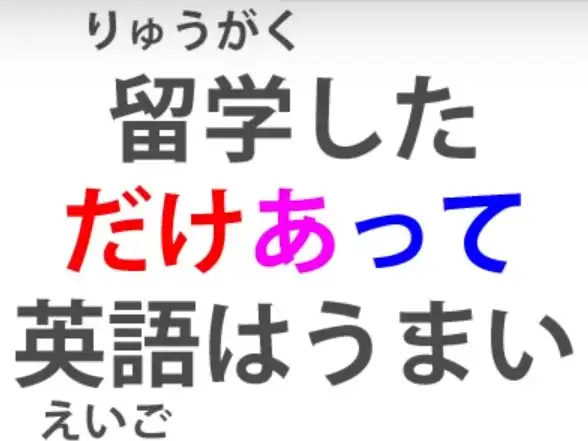
And this literally means “Because of the limit of the fact that she studied abroad…” (and the “because” here is that て-form, which often implies the cause of the following effect) “… her English is excellent.” Now the translation we’re given is “Not for nothing did she study abroad, her English is excellent.” But what is actually being said here is “Precisely because and only because she studied abroad, her English is excellent.” Now, you might think I’m splitting hairs here and being a bit too geeky about the exact meaning.
But let’s take another example.
“安いだけあってすぐに壊れちゃった” Now, this means “Because of the limit of its being cheap, it quickly broke.” Now, it wouldn’t make any sense here to say, would it, “Not for nothing was it cheap, it broke quickly.” What we’re actually saying is “Precisely because it was cheap, it broke quickly.”
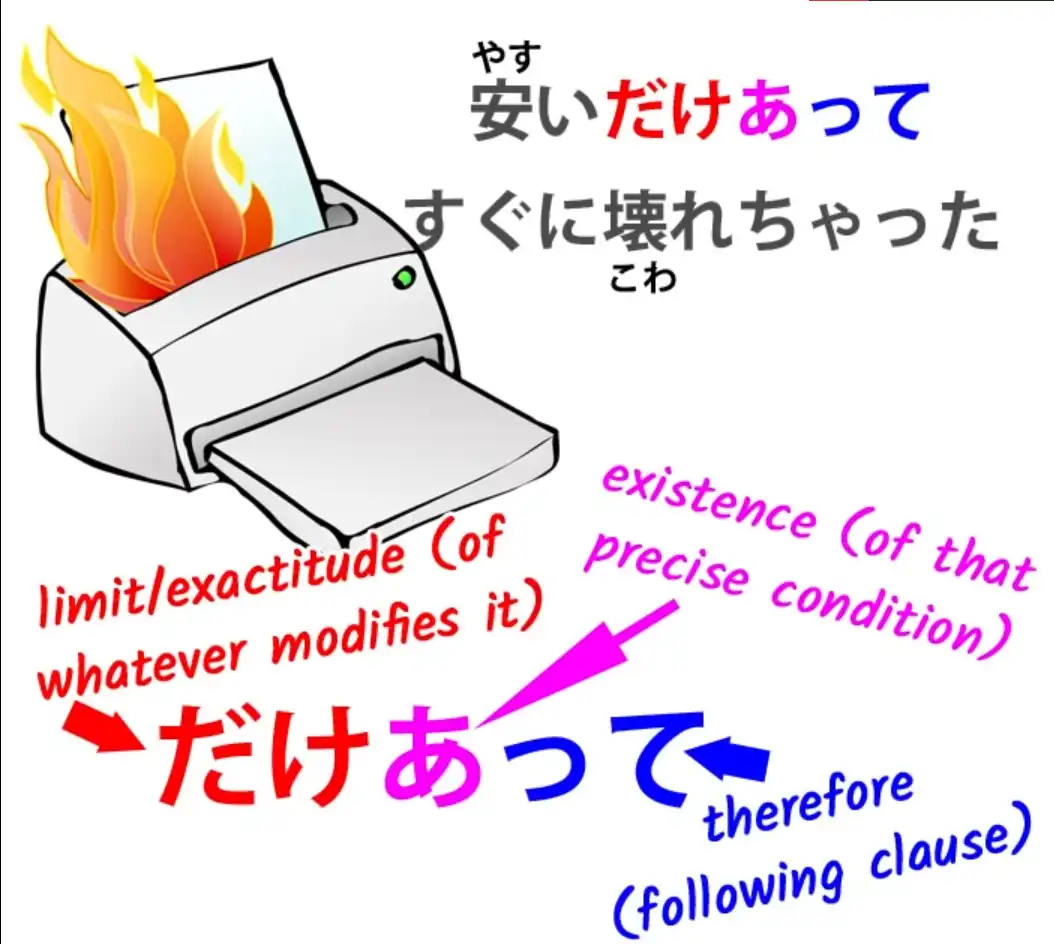
That “だけ” is using the limiting function to limit something down to something precise.
If we want to bring in the “only” aspect of it, the way it works is that what we’re saying is “Only by studying abroad would you get that good at English” “Only something really cheap would break that quickly.” So that’s how the limitation, the “only”, function of “だけ” is actually working here.
We’re using it to give precision to the statement: “Precisely and only because of this the result followed”; “だけあって” – “It exists because of and limited to this fact.” Now let’s bring in “ばかり”.
ばかり
“ばかり”, as we know, also expresses the same kind of limits.
It means “just such-and-such a thing”.
So let’s compare it with the other two.
If we say “あのお店はパンだけ売る”, we’re saying “That shop only sells bread”.
If we say “あのお店はパンしか売らない”, we’re saying “That shop doesn’t sell anything but bread”.
If we say “あのお店はパンばかり売る”, we’re again saying “That shop only sells bread” but as we know from the “ばかり” lesson, what we’re likely to mean by that is “That shop sells an awful lot of bread”.
It may not even be true that it only sells bread, because “ばかり” can be used hyperbolically.
We can say “東京は外人ばかりだ” – “In Tokyo there’s nothing but foreigners” which doesn’t mean, any more than it would in English, that there really aren’t any Japanese people in Tokyo. It means there are an awful lot of foreigners in Tokyo.
So, we can put these three on a sliding scale.
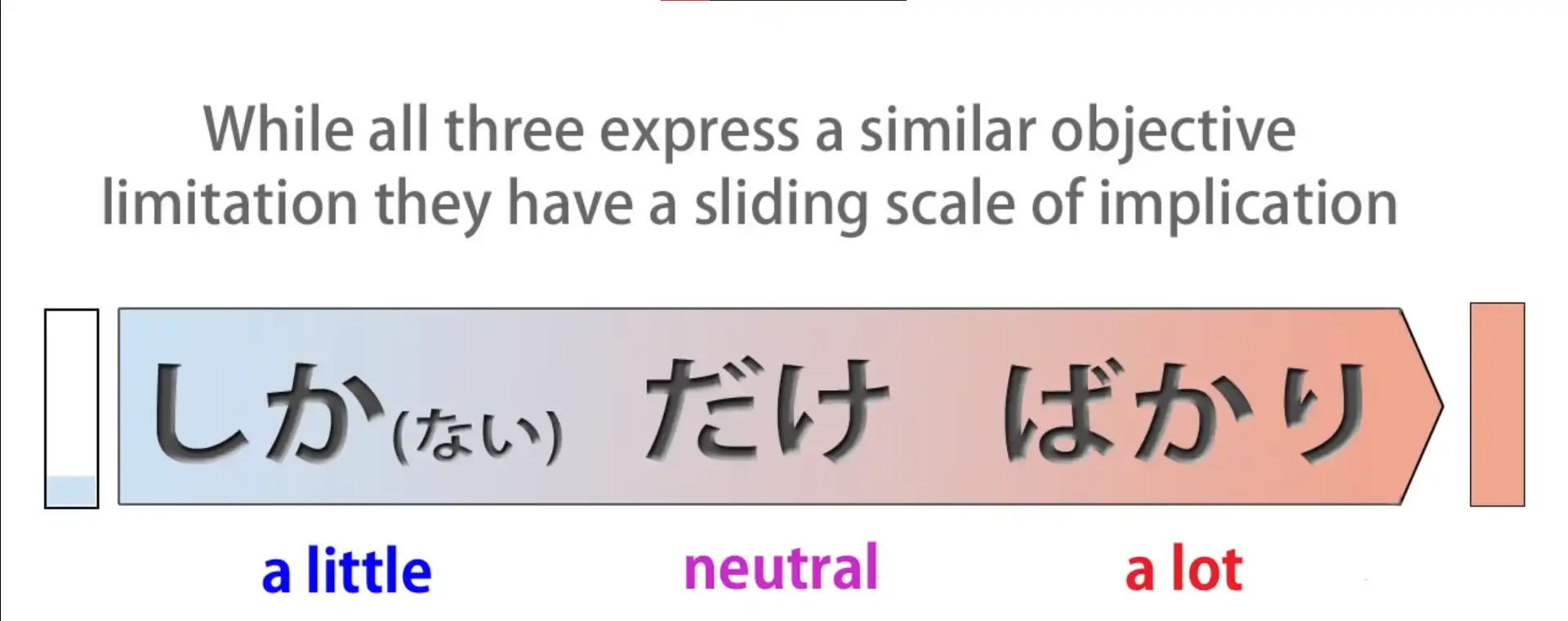
“パンしか売らない” is implying that only selling bread is very little, it’s insufficient.
Maybe we want something other than bread but we can’t get it.
“パンだけ売る” doesn’t have any implication. It’s neutral.
It could mean that the shop specializes in bread and therefore it’s very good.
It could mean, indeed, we can’t get anything if we’re wanting something other than bread.
It doesn’t have any particular implication.
It’s just neutrally saying that the shop only sells bread.
“パンばかり売る” implies that there’s an awful lot of bread there.
The fact that it’s limited to bread is essentially making the point that bread is there in abundance to the extent that we might hyperbolically say that nothing else but bread is there even though with “ばかり” in fact it could be.
のみ
And before we end, I’m just going to cover “のみ”.
“のみ” is very easy because all it means is “だけ” in its simplest sense.
So we say “パンだけ売る / パンのみ売る”.
They both mean the same thing.
They mean “only sells bread” without any special implication.
“のみ” is used in formal contexts, it’s mostly used in writing, and unless you’re trying to use very formal Japanese you won’t really need to use it.
The reason it’s important to know is that, for example, if you were going to go into a place and the sign was telling you that only members are admitted it could save a lot of embarrassment if you knew that that “のみ” means the same thing as “だけ”.
And that kind of sign is precisely where they would use “のみ”, because it tends to get used in these formal, official kinds of context.
34. Understand any sentence
Lesson 34: Understand any sentence. Powerful analysis technique.
こんにちは。 Today we are going to discuss the most fundamental thing in Japanese.
And, if we understand this, we can understand any Japanese sentence.
If we don’t, we can’t.
It’s really as fundamental as that.
And I introduced this in our very first lesson, because if we don’t have this, we’re going nowhere.
What we are going to do today is start talking about how we can apply this to any Japanese sentence that we find in the wild.
Now, the fundamental core of Japanese, as you know, is the core Japanese sentence.
It’s what I call the A-car and the B-engine.
Both of those elements have to be there in every sentence.
We can always see the B-engine.
We can’t always see the A-car, but it’s always there.
In English these are called the subject and the predicate and
in Japanese they are called the 主語/しゅご and 述語/じゅつご,
but we are going to continue calling them the A-car and the B-engine
because this way we can visualize exactly what’s going on in a sentence by using trains.
Now this lesson begins with a question asked by my Gold Kokeshi patron Pantelis Chrysafis-sama (and I hope I’m pronouncing your name right).
It was a very simple question, but a very good one, a very fundamental one.
It was simply, “How do we know where a logical clause ends?” And that’s really the same as the question “How do we identify a logical clause?” We need to know where it ends and we need to know where it begins.
The factors complicating this are that there can be more than one logical clause in a compound sentence (but as I’m going to demonstrate, that isn’t really as difficult as it seems) and also the fact that we can’t always see the A-car.
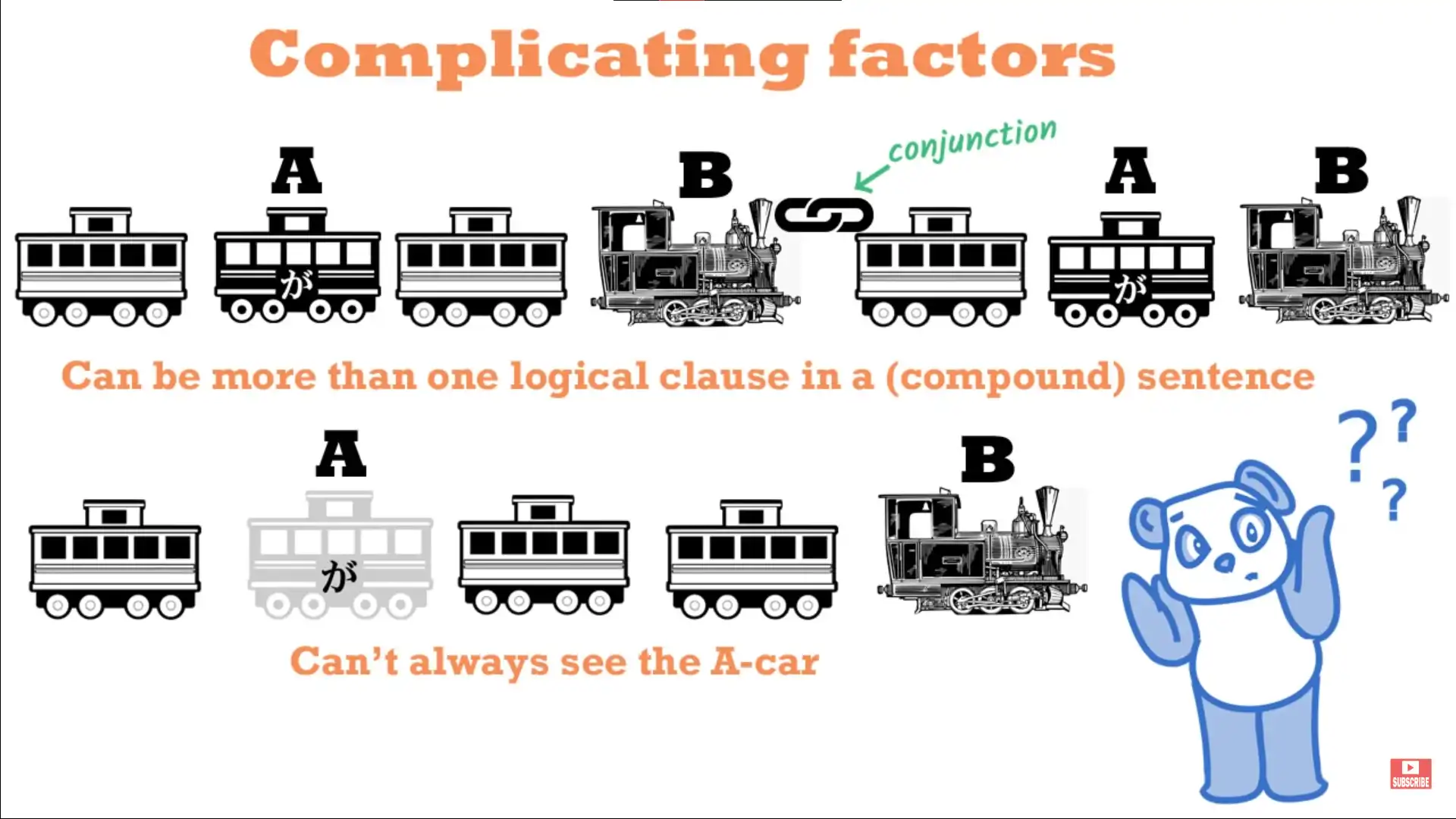
The other complicating factor is the fact that we will see the elements of logical clauses and even complete logical clauses that are not part of the sentence core.
And if they’re not part of the sentence core, what they are doing is modifying or telling us more about either the A-car or the B-engine.
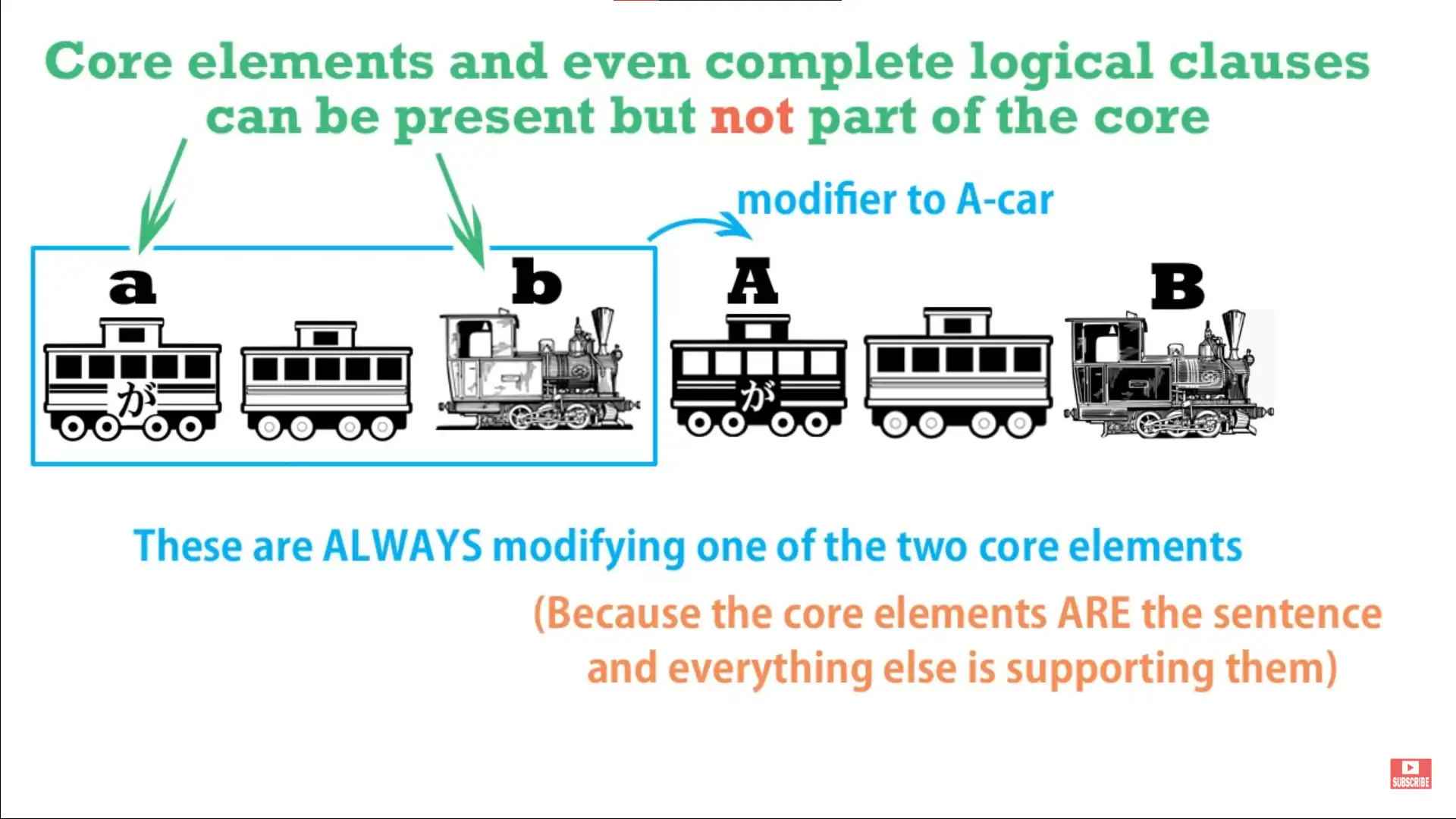
That’s the only thing they can ever be doing, because the sentence is its core and everything else in the sentence is related to and telling us more about that core.
Now, sentences where there is more than one logical clause have to be connected by some kind of conjunction.
And this is very important, because this gives us the key to seeing whether or not there is more than one core and if there is, where they are and how they’re working.
In our recent series on conditionals, we were in fact dealing with conjunctions.
There are various kinds of conjunction: and, but, when, if, etc.
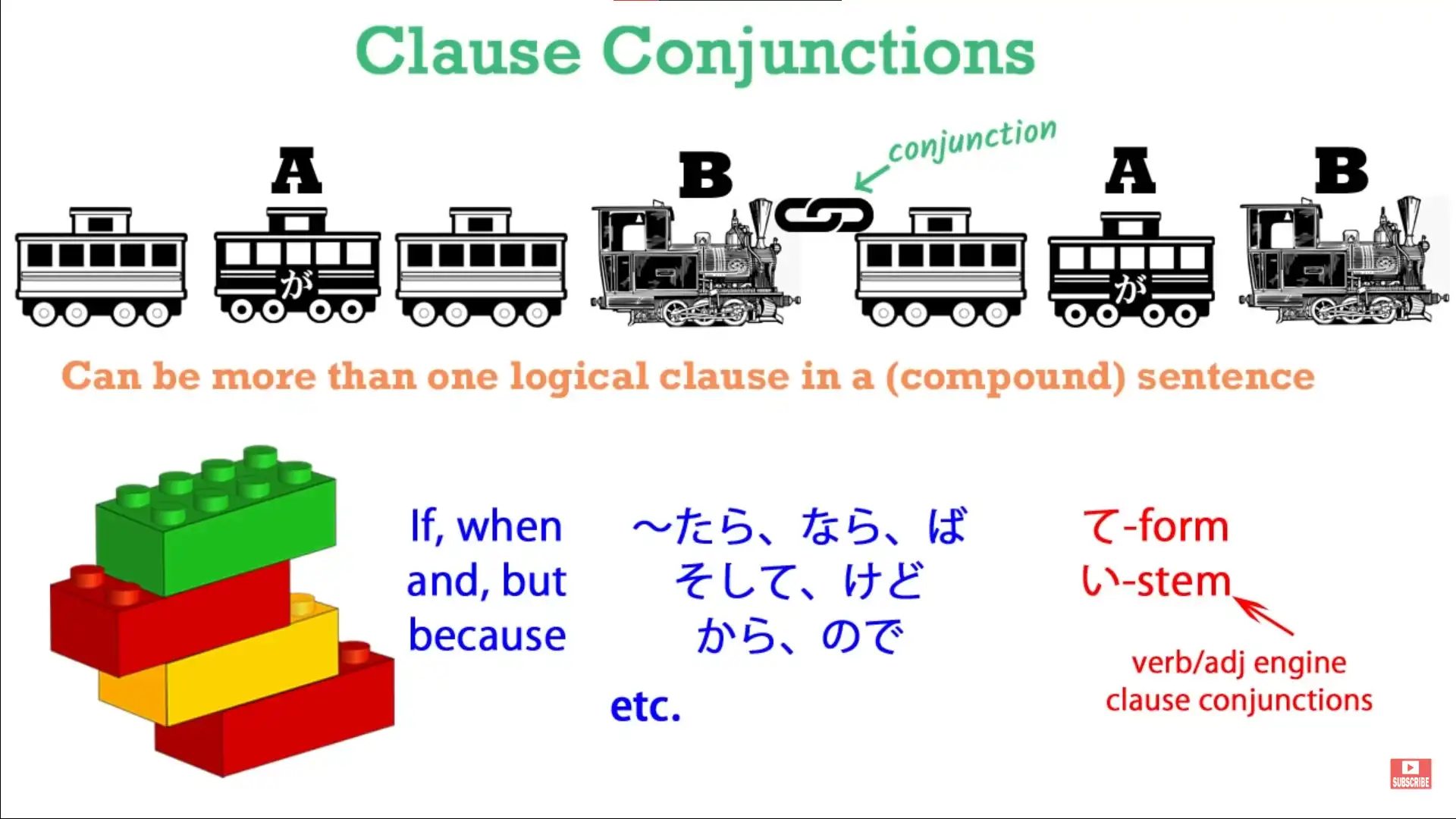
And the two other kinds of conjunctions that we need to look out for are the て-form, which can join two clauses together into a compound sentence, as we looked at in our first lesson on compound sentences (Lesson 11), and the い-stem of a verb.
You’ve seen how the い-stem is the main conjunctive stem out of the four stems of verbs.
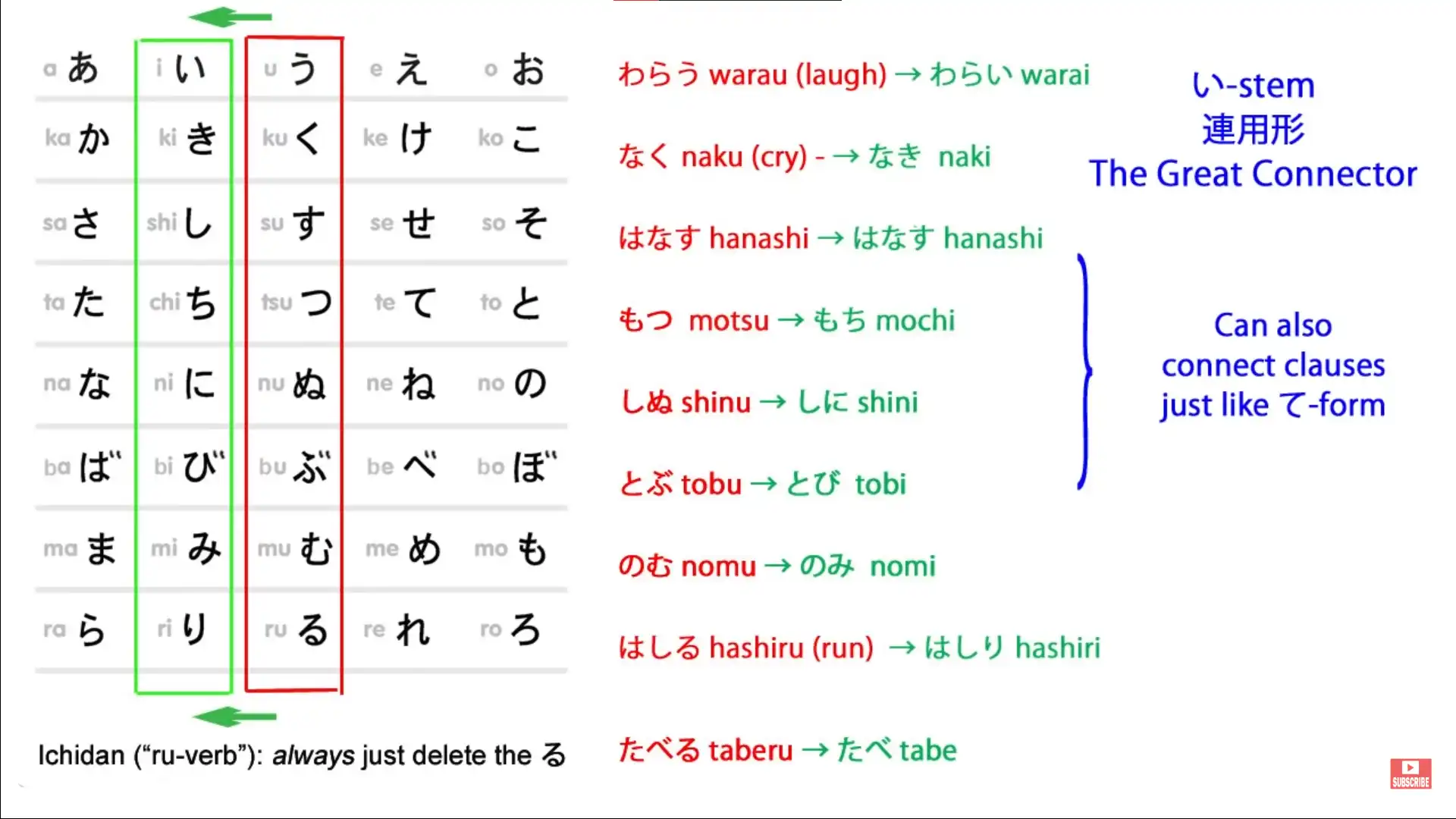
It can connect nouns to verbs; it can connect other verbs to verbs; it can connect various helpers to verbs; and it can also connect one logical clause to another.
This is slightly more literary, slightly more sophisticated, perhaps, than the て-form, but it’s the one other thing you need to look out for when you’re investigating whether there is more than one logical clause in a sentence.
We’ll talk about this more in a later lesson.
Now, let’s talk about the complications that can arise and how we can see through them, how we can use our detective powers to see what’s really going on.
I’m going to take a simple conditional sentence that we used before.
“かさを持って来ればよかった” which means “I should have taken an umbrella / I wish I’d taken an umbrella”.
What it literally means is “If I had taken an umbrella, it would have been good.” Now, we can see the first logical clause easily, can’t we?
That is “かさを持って来れば”, which is simply “かさを持ってくる” – “bring an umbrella” – turned into its conditional form – “if I bring an umbrella” – and that’s going to be thrown into the past tense by the final engine in the sentence, which is the way Japanese works.
So, we have clause one, which is “かさを持って来れば”.
We know that it’s a complete clause and we know it’s going to be followed by a second clause because we have a conjunction there in the form of a conditional.
But what follows it is simply “よかった” which is the past tense of “いい” and it means “good”.
Is this a core sentence?
Yes, it is.
The first sentence is “かさを持ってくれば” ; the second sentence is “(zeroが)よかった”.
We know this because “よかった” is an engine.
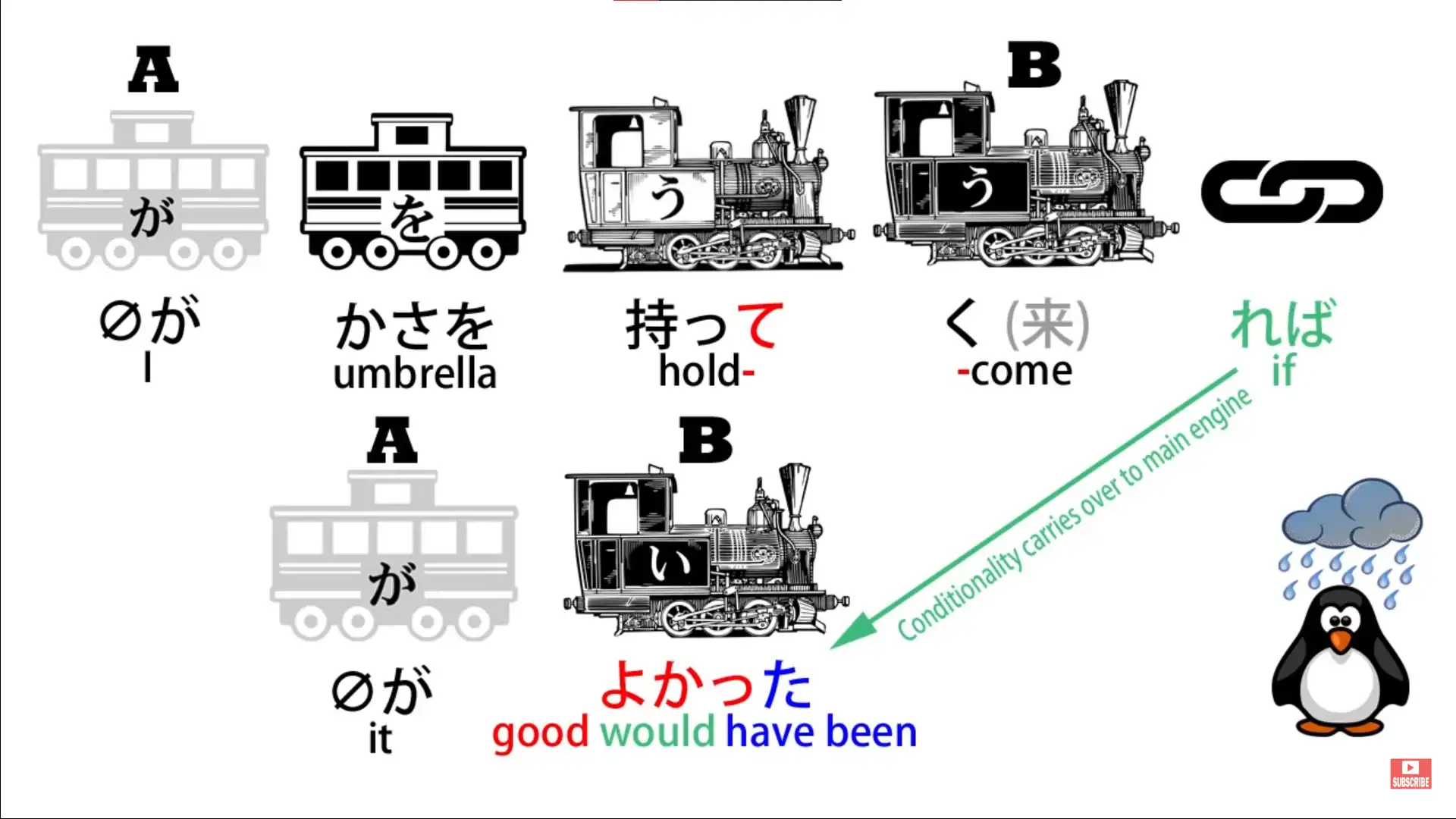
It’s an adjective, it’s a describing word and it has to be describing something.
Wherever you’ve got an adjective, the adjective must be describing something.
Wherever you’ve got a B-engine, there must be an A-car to correspond to it.
So what is the A-car here?
What is “よかった” describing?
What is it telling us “would have been good”?
This is a very important point.
If we translate it into very literal English, what we’re saying is “If I had brought an umbrella, it would have been good.” And this is exactly what the Japanese means.
“It” would have been good. The A-car is “it”.
So what is “it”?
This is the important point: “It”, or the zero-car, does not have to be clearly definable, either in English or in Japanese.
What “it” means here is “the circumstance / things in general (would have been good)”.
And we do this in Japanese all the time.
And we do it in English all the time.
So, for example, if we say in English “It’s sunny, isn’t it!” In Japanese we might say “(zeroが)晴れだね!”
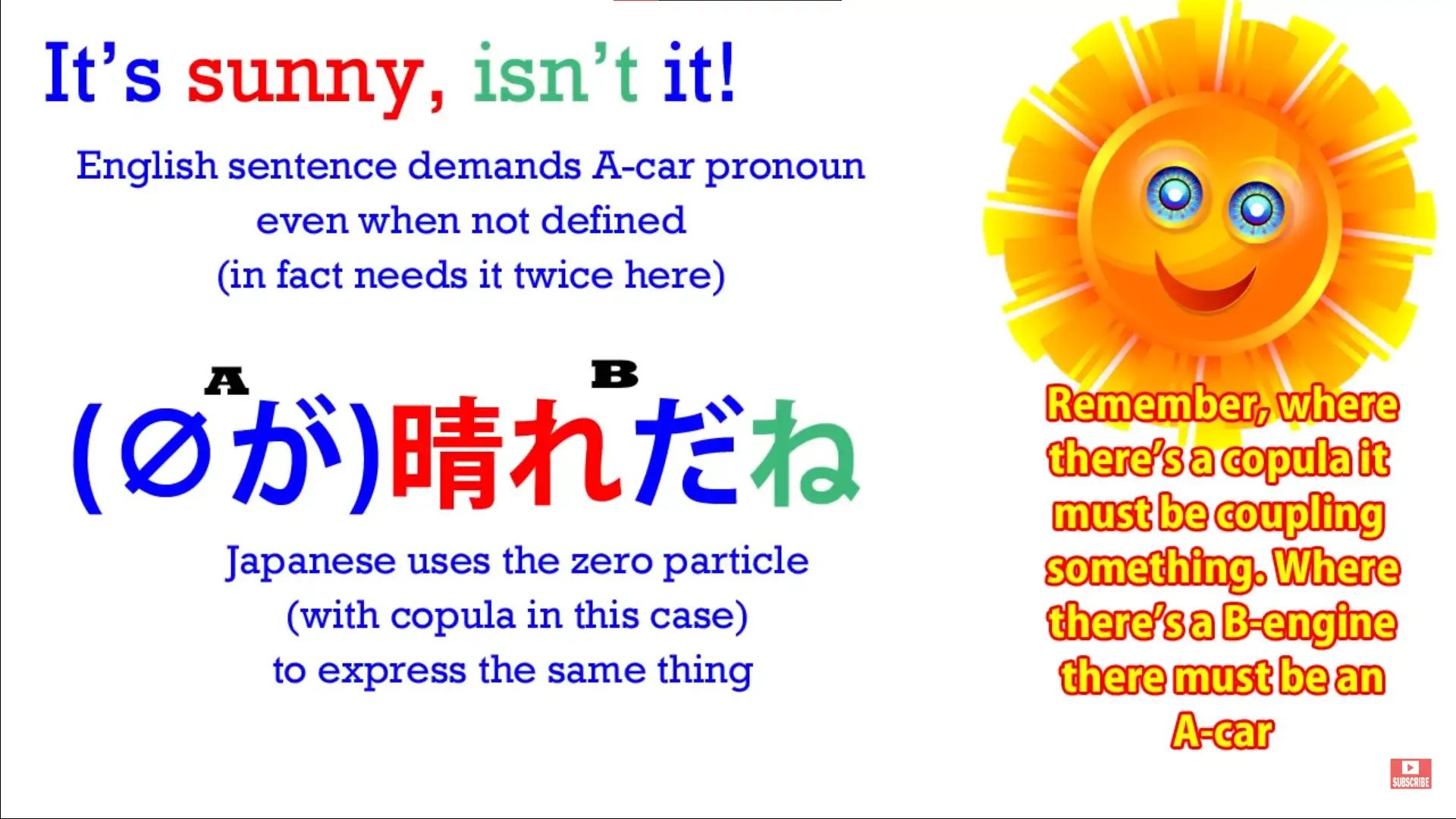
They mean the same thing.
In English we have to say “It is sunny” – we could say “Sunny, isn’t it?” but that’s only because we’re leaving out the “it”.
And we’ve still got it at the end, because we don’t ever say “Sunny, isn’t!” We say “Sunny, isn’t it!” which must be short for “It is sunny, isn’t it!” In Japanese we say “晴れ…” (which means “sunny” or “clear” in the sense of clear skies): “晴れだね!” Now, “だ” is the copula.
It’s got to be connecting that “晴れ晴れ” to something else, which is our zero-particle.
What is it connecting it to?
Well, in this case we don’t know.
It could be the day – “The day is sunny”.
It could be the weather – “The weather is sunny”.
It could be the sky – “The sky is clear” – because “晴れ” can mean “clear” as well in that sky sense.
It doesn’t matter.
It doesn’t matter in Japanese and it doesn’t matter in English what we mean by “it” when we say “If I’d brought an umbrella, it would have been good” or “It is sunny”.
But we can’t do without it.
We can’t do without it in Japanese and we can’t do without it in English.
Because in both Japanese and English we have to have an A-car and a B-engine.
A subject and a predicate. A 主語/しゅご and a 述語/じゅつご.
In English we always have to be able to see both of them.
In Japanese we don’t need to see the first one.
We do need to see the second one.
But the first one is always there, and if we don’t understand that we’re going to have great difficulty picking out the core sentence, especially as things get more complex.
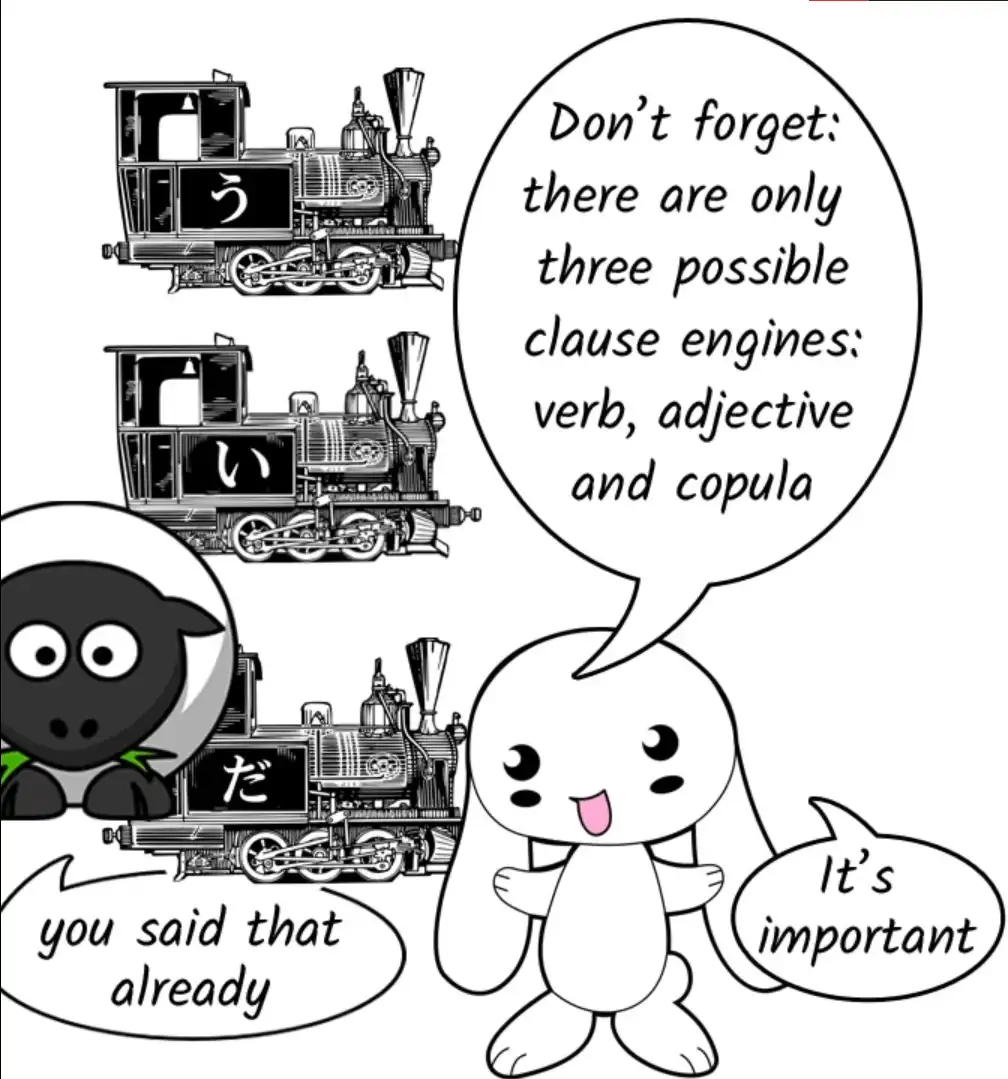
So, to get directly to the question, how do we find the end of a logical clause?
Now, the main logical clause, the head clause of the sentence, is always the last one, and we can find the end very easily because the end of the logical clause is the end of the sentence.
In Japanese, a sentence has to end with an engine, that is to say, an adjective, a copula (“だ” or “です”) or a verb.
So the last engine in the sentence will be the end of the head clause of the sentence, the main final clause of the sentence, always.

It will be the last thing in the sentence apart, perhaps, from one or two sentence-ender particles like “よ” or “ね” or “よね”.
We call them sentence-ender particles, but in a way it might be more accurate to call them particles that come after the end of the sentence.
The final engine is the end of the logical sentence and the ender particles are just a little add-on that we put on right after the end of the sentence.
So it’s very easy to find the end of the last logical clause in a sentence or the end of the entire logical clause if there is only one logical clause in the sentence.
The more difficult question – but it’s not really all that difficult, but the question that can cause problems is the question of how do we find or how do we eliminate the possibility of a compound sentence?
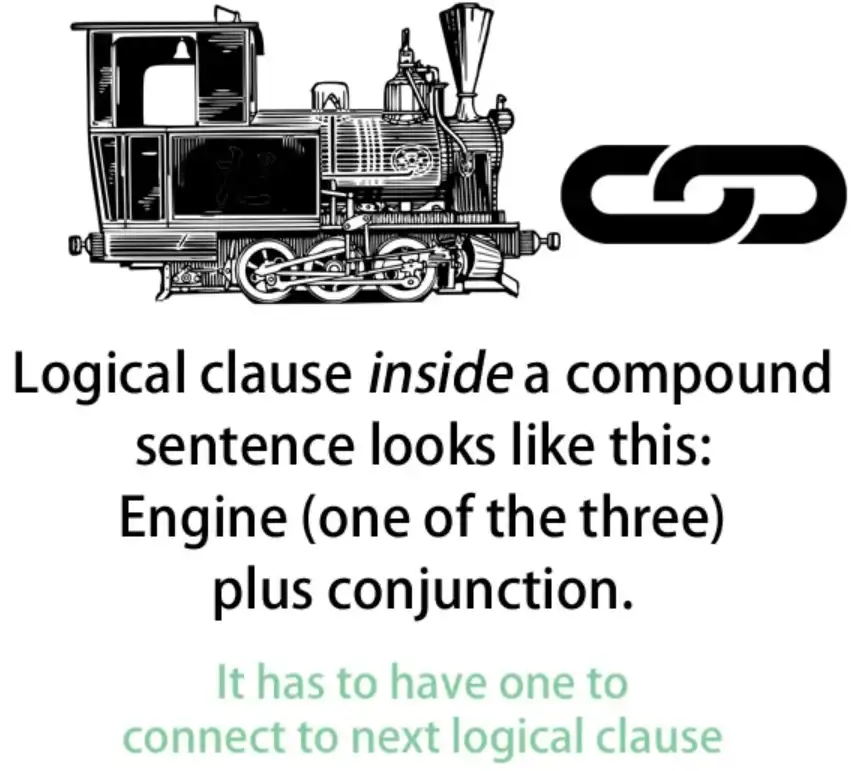
How do we know there are no other logical clauses in the sentence or, if there are, how do we find them?
And the answer to that is again very simple and straightforward.
A logical clause will always end with an engine: a verb, a noun followed by a copula (“だ” – it won’t be followed by “な”, because if the copula “だ” has become “な” then it must be a modifier, it can’t be a logical clause in itself) – a noun with the copula “だ”, or an adjective.
And if it is a clause before the final clause in a compound sentence, it’s going to end with a connector.
It has to, because it has to connect to the next logical clause.
So, now what we’re going to do is look at the sort of complex sentence that can confuse people and we’re going to look at how we tackle that sentence.
So the sentence is
“私がさくらに話した日本語ができる留学生は(zeroが)
五輪金メダルを獲得した女性と結婚した”
Now, as you can see, that looks pretty complicated.
How do we go about it, how do we go about analyzing it?
Jay Rubin-先生, for whom I have great respect, suggests that if we’re really stuck we should work backwards through a Japanese sentence.
And there’s some sense in that, because Japanese sentences do in a certain way and up to a certain point run in reverse order from an English sentence.
However, we can only do that with written sentences.
We can’t do it with spoken sentences because people won’t speak backwards for us most of the time.
However, one thing I do think is useful if you’re feeling particularly stuck with a sentence is to make sure you’ve got the head verb or the head copula or the head adjective, whatever is the head of the sentence, in your mind.
So if we just take a peek at that first so we know where we’re going to.
And the head of this sentence is very straightforward, isn’t it?
It’s “結婚した”.
The head verb is simply “した” – “did” – but that’s making a する-verb with “結婚”;
so, “結婚した”.
What the sentence is telling us is that somebody got married.
All right.
But now let’s do what I think we should do so long as we can, and most of the time we really can – Start from the beginning. All right.
So, the first part of the sentence, the first clause: “私がさくらに話した” Now, that could be a complete logical sentence in itself, couldn’t it?
“I spoke to Sakura.” Or it could be “I told Sakura” in which case it couldn’t be complete in itself, could it?
Because I would have to tell her something.
Now, which is it in this case?
Well, we know that’s it’s not a complete logical clause, “I spoke to Sakura.” Why not?
Because it’s not ending in any kind of conjunction, is it?
It’s followed directly by a noun, “日本語”.
There’s no conjunctive word, there’s no て-form and it’s not the い-stem of “話す”.
So we know that this is in fact a modifier for something else.
So, what have we got next?
“日本語ができる” – now, that means “Japanese is possible”.
日本語ができる” could be a complete sentence in itself, couldn’t it?
“To me, Japanese is possible.” The “to me” would be implicit, but that’s fine, we do that all the time.
But we know it isn’t because it doesn’t end in any kind of conjunction.
So this also can’t be a complete logical clause within a compound sentence.
It must be a modifier for something.
And what we expect it to be a modifier for would be a person: a person to whom Japanese is possible.
And that’s exactly what we get next: “留学生”.
“留学生” is an exchange student, usually from a foreign country.
So, “日本語ができる” modifies “留学生” – “an exchange student to whom Japanese is possible / a Japanese-speaking exchange student.” And “私がさくらに話した” is modifying all that.
“The Japanese-speaking exchange student who I told Sakura about” And then that’s followed by は.
Now, “留学生は” indicates it’s very likely, isn’t it, that this is going to be the topic of the sentence and that the topic of the sentence is going to be the doer, the A-car of the sentence.
But let’s continue the sentence and see if that seems to be the case.
We now have “五輪金メダル” and that means an Olympic gold medal.
“五輪” means “five circles”.
“五輪金” – which is gold – “メダル” – an Olympic gold medal – “を獲得した”.
Now that is not, that can’t be a logical sentence because it’s not a logical sentence, is it?
It’s not a logical sentence without a doer, and there’s no doer implied here.
But we have the doer right afterwards, don’t we?
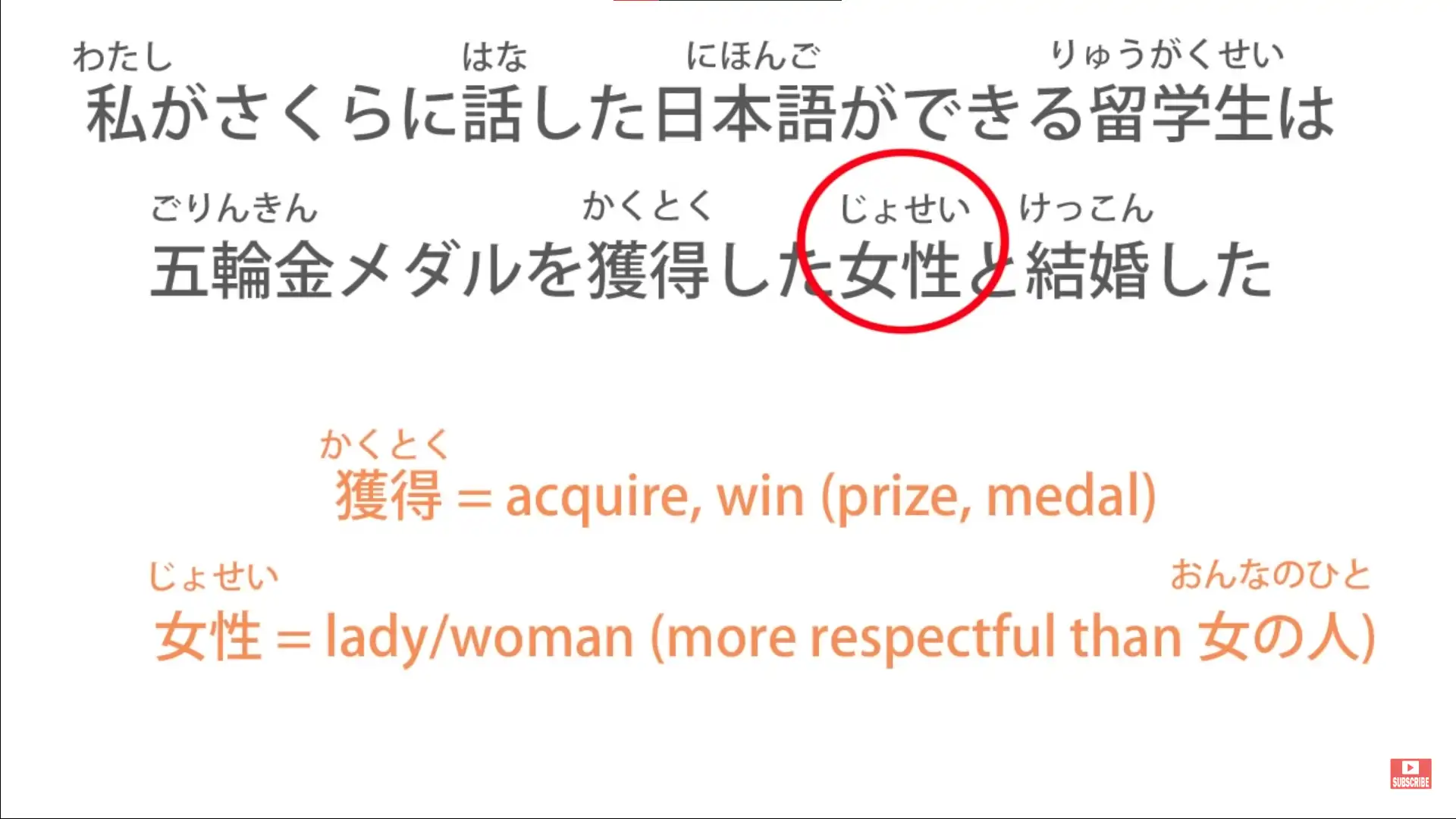
So we know that we have here a modifier for another noun, not a logical sentence in itself: “五輪金メダルを獲得した女性”.
So now we have another modified noun: “A woman who won an Olympic gold medal”.
And now we’ve come to the head-verb of the sentence: “-と結婚した”.
Note: about that と

So we were right. (about the は presumption) We have the A-car, which is the exchange student (in the sentence it would be more specifically the zeroが after ”留学生は” which implies said exchange student, that is the invisible subject, so subject is also the topic here) who can speak Japanese that I told Sakura about married (B car - predicate) a woman who won an Olympic gold medal.
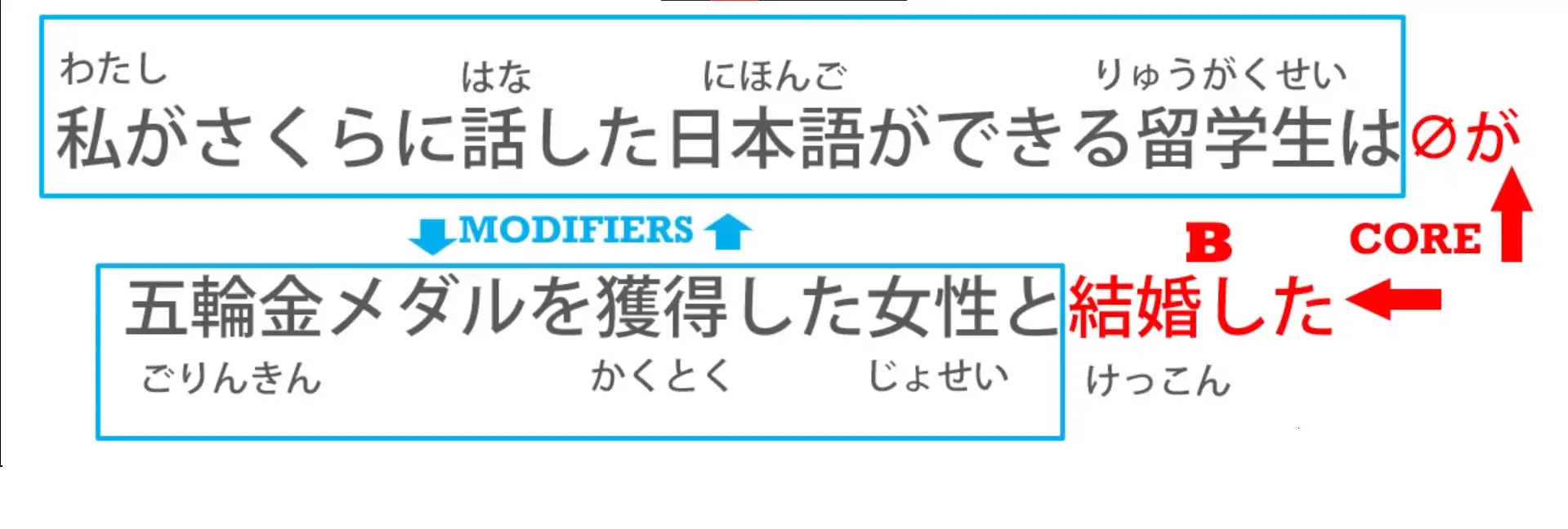
And as you see, we’ve got various actions going on in this sentence; we’ve got various things that could, under different circumstances, form logical clauses of their own, but none of them actually can.
We now know that this is not a compound sentence.
This is one rather complex sentence
with a single A-car (zeroが = 留学生) and a single B-engine (結婚した).
Where a logical clause ends is either at the end of the sentence or before a conjunction.
And if you can do that, you can analyze just about any Japanese sentence, however complicated it looks, and see what’s going on in the sentence.
A Personal Tip Note: if still confusing, I recommend you read the comments under that video. With lots of input, the brain should sort it out eventually, but it needs work and time. Dolly just prepares for that dive. At this point, you might want to slowly start with input if you have not yet, together with Dolly grammar. Once finished with the transcript, refer to it when you encounter something confusing or want to review, but comprehensible input/”immersion” is the key (as Dolly herself advocated). This way, you will be ready to apply stuff in Lessons 45-48 right away.
But it is up to you, it would be good to get the tools etc. ready now at least & start after 45-ish.
As mentioned on the first page, I have written a long document - LINK HERE - containing my most favourite sites that have hundreds of extremely useful and varied resources, tips, guides, tools and everything needed for deep Japanese immersion that you may find somewhat helpful.
35. より, のほう, 一方
Lesson 35: Yori, no hou, ippou- how they MAKE SENSE!
こんにちは。 Today we’re going to talk about “より” and “ほう”.
Now, “より” and “ほう” are often introduced together in sentences like: “メアリよりさくらのほうがきれいだ.” And that is a slightly verbose way of saying “Sakura is prettier than Mary”.
I think this is an unfortunate way of introducing the two terms because it can easily give rise to confusion.
It can be difficult to understand what term is doing what and how they relate to the rest of the sentence.
It’s much easier if we look at these two separate and independent terms, both important in its own right, separately, and then we can put them together.
So let’s start by looking at “より”.
より
より is a particle.
It’s not one of our logical particles, so it does not have to be attached to a noun.
It can go after just about anything: a complete logical sentence, a noun, an adjective, a verb – whatever we want.
Its basic physical meaning is “from”.
When we send a letter, we may say “さくらより” – “from Sakura”.
And abstract words all have their base in physical metaphors, even if we sometimes forget the physical metaphor, and with words like this, it’s useful to begin by understanding the original literal meaning and then seeing how the metaphor works.
So “yori” means “from”, and we already have another word meaning “from”, don’t we?
And that’s “から”.
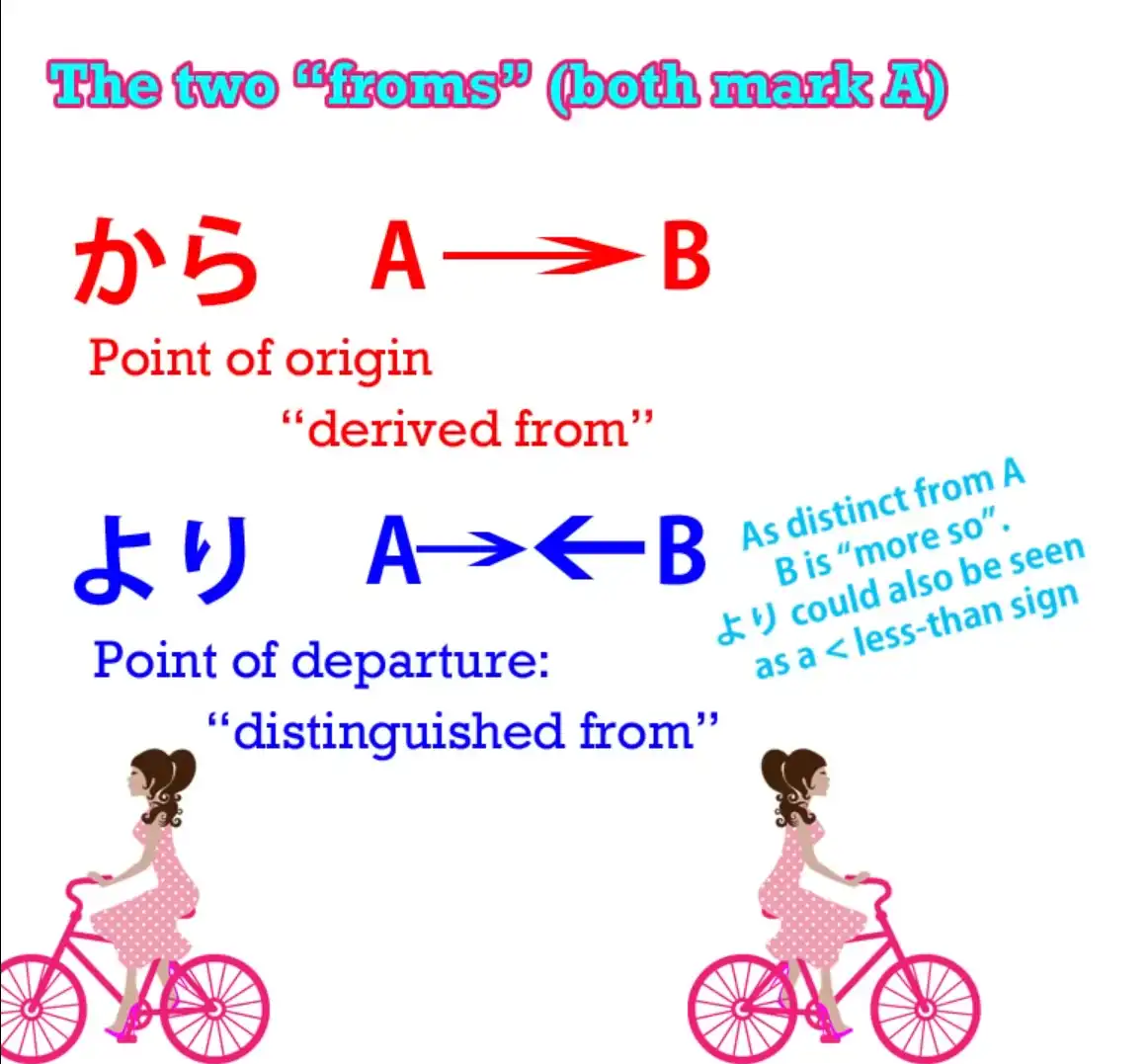
Now, there is a difference between the two, which is particularly pronounced as we start to apply them metaphorically.
“から” marks the “A” in “A from B” in such a way that it is treating “A” as the starting point or point of origin.
So, if I say “日本から来ました”, I’m saying “I came (or come) from Japan / Japan is my point of origin.” And this in a way is midway between the literal, physical meaning and the metaphorical meaning, because it can mean literally I just came on a plane from Japan or it can imply that I’m Japanese or that I was raised in Japan or something like that.
When we move to its purely metaphorical meaning, it usually means “because”.
In other words, “A” is the point of origin of “B”.
“寒いからコートを着る” – “Because (it’s) cold, I wear a coat” / “From the fact that (it’s) cold, I’m wearing a coat.” Now, “より” means “from” in a very different sense.
The directional metaphor is concentrating not on the origin of A from B, but in the distance or difference of A from B. So, if we say “さくらはメアリよりきれいだ” we’re saying that “from Mary” Sakura is pretty.
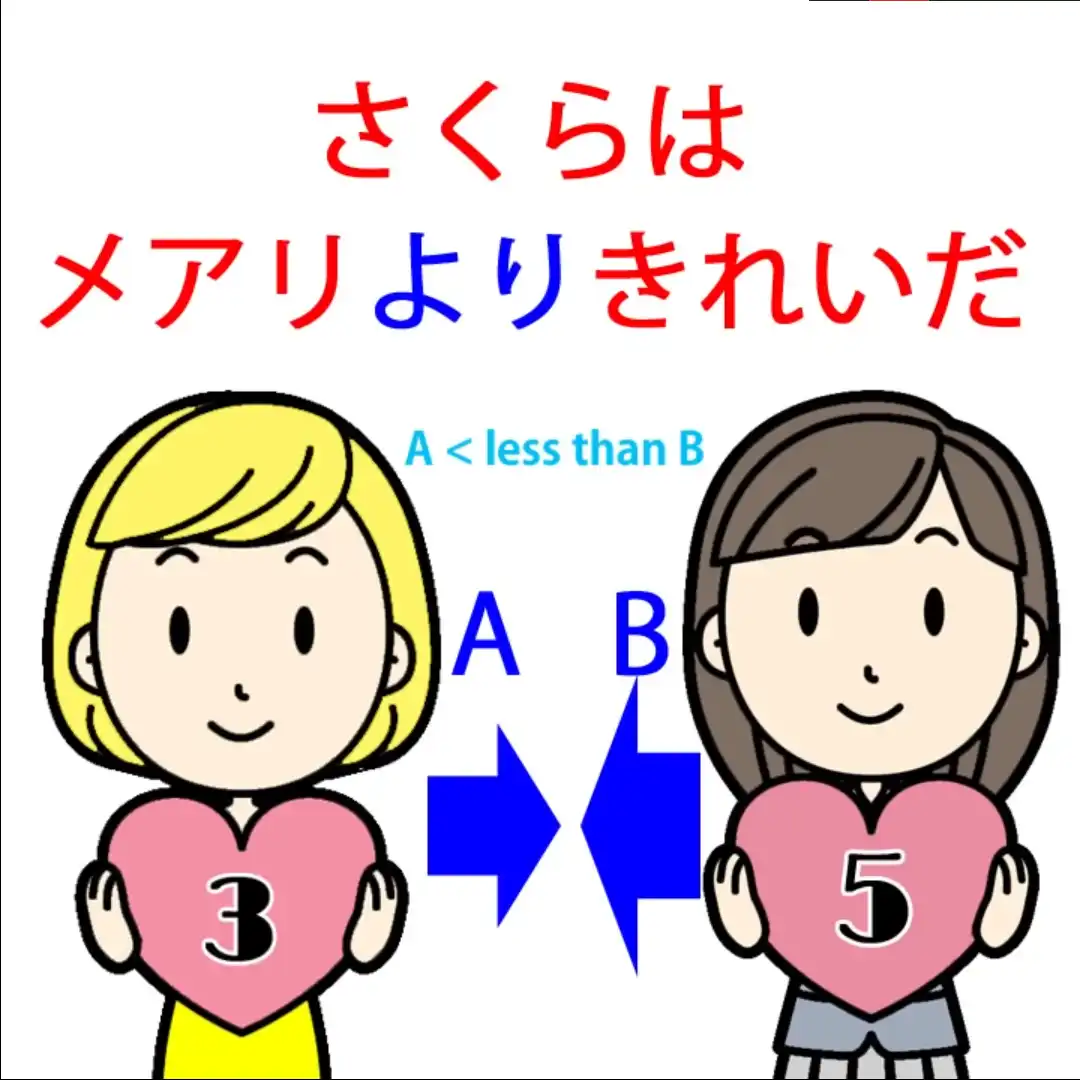
What we mean by this is that distinguished from Mary, Sakura is pretty.
Now, it does have something in common with “から” because we’re still using Mary as the base point, the point of comparison.
And because of this, because it has a comparative meaning, we’re not saying Sakura is pretty but Mary isn’t.
We’re saying that, taking Mary as the point of comparison,
Sakura is pretty – therefore, more pretty, prettier.
In comparison to Mary, going “from” Mary, Sakura is pretty.
And you notice here that we said just what that first sentence, “メアリよりさくらのほうがきれいだ,” was saying and we didn’t need “ほう”.
It works perfectly well to say exactly the same thing without that “ほう”.
And we use “より” in other contexts.
For example, we may say “今年の冬はいつもより寒い,” which literally means “Comparing from always, this year’s winter is cold” or “This year’s winter is colder than always.”
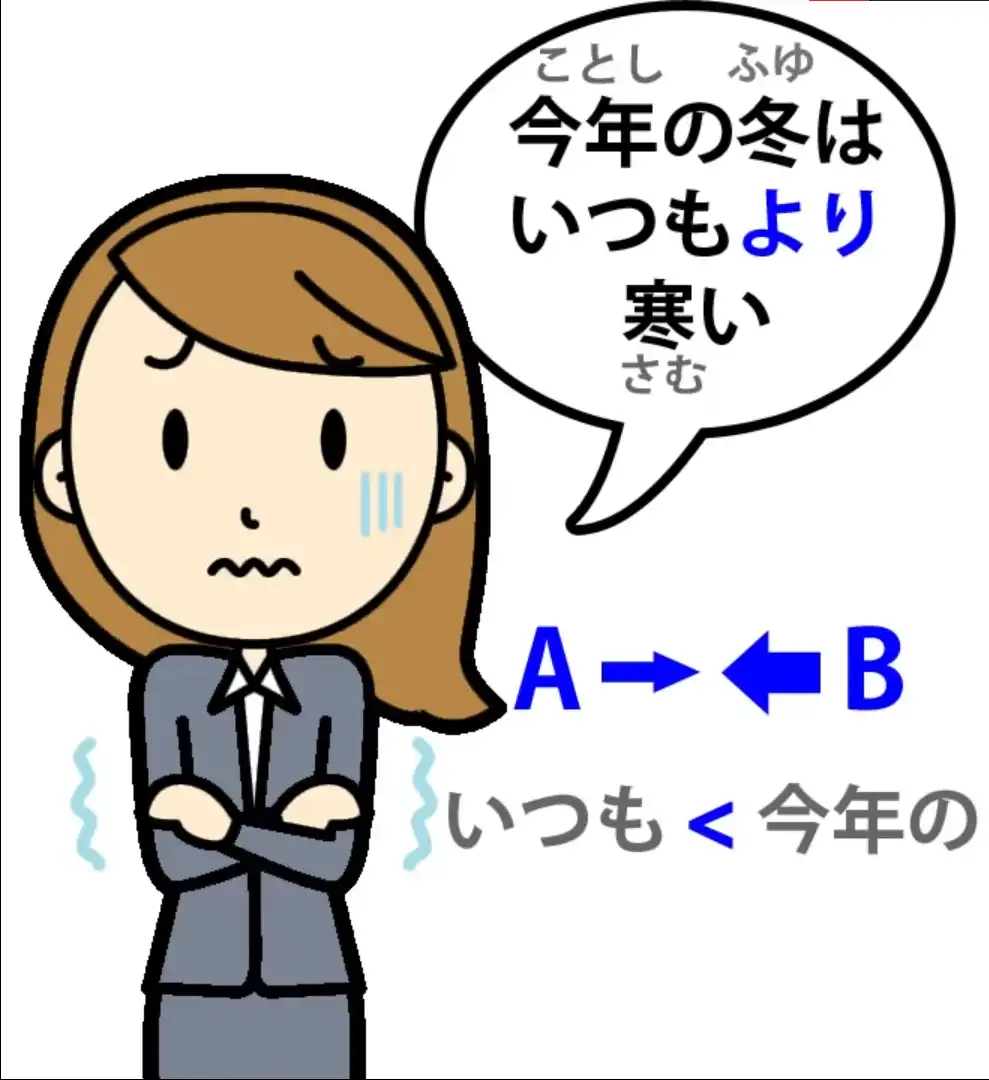
And what that actually means is “This year’s winter is colder than usual, colder than most other years.” So that “always” is a kind of hyperbole, in a way.
Similarly, we can say “さくらは人より賢い(かしこい)” – “Sakura is clever compared to people.” And what that means, again, is “Sakura is clever compared to most people / Sakura is clever compared to people in general” – in other words, is cleverer “than” the average person.
All right, so now let’s look at “ほう”.
ほう
“ほう” is quite different.
It’s not a particle, it’s a noun.
That’s why we have “のほう”.
And its literal meaning is a “direction” or a “side”.
And when we say “side”, we mean “side” in the sense of “direction”,
not in the sense of “edge”.
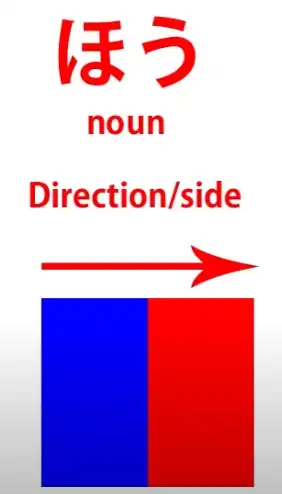
So, for example, if we talk about two sides of a field with “ほう”, we’re not meaning the two edges of the field, we’re meaning that we divide it approximately in half and we talk about “the left side” and “the right side” of the field.
Now, as we see from this analogy, one side always implies the other side.
And that’s the important thing about “ほう” in its metaphorical uses.
In its literal use, when I’m cycling in Japan, I might say to a stranger, pointing in the direction I’m going in, “それは本町の方向ですか?” And that’s saying “Is that the direction of Honmachi?”
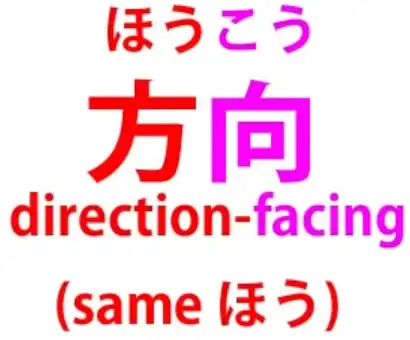
I’m not asking for street directions, which I can’t understand in English, or Japanese, or any other language.
I’m asking for the literal direction: “Is Honmachi that way, or am I going in the opposite direction?” – which I often am, because I am “方向音痴 / ほうこうおんち”, which means (I) have no sense of direction.
So when we apply it metaphorically, we mean one thing or circumstance or whatever as opposed to another.
We can put it after a noun with の, as we do with Sakura: “さくらのほう”,
or we can put it after a verb or an adjective, in which case that verb or adjective is describing the “ほう”, telling us what kind of a “ほう” it is, which “side” it is.
So, if you say to me “メアリがきれいだと思う?” – “Do you think Mary is pretty?” – and I reply “さくらのほうがきれいだ”, I’m saying “The side of Sakura is pretty” – in other words, I think Sakura is prettier.
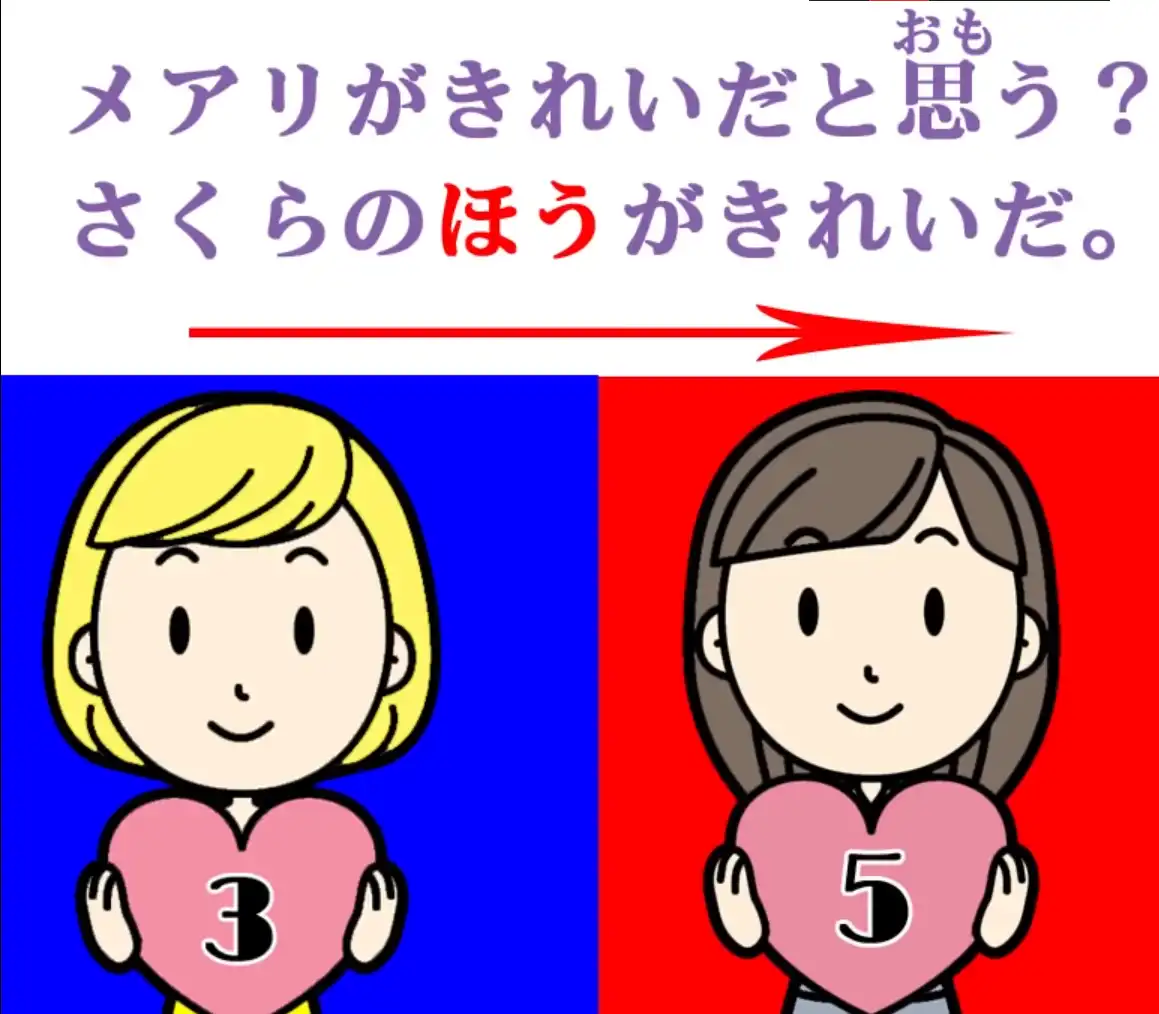
Once again, it’s a comparative construction, so I’m not saying Sakura is pretty and Mary isn’t, but I am saying that the side of Sakura is prettier than the other side, which is Mary.
And, once again, let’s notice that we don’t need “より” here.
“さくらのほうがきれいだ” works perfectly happily on its own to mean exactly the same thing. And a lot of the time you’re going to see either “より” or “のほう” on their own.
We do sometimes use the two together and when we’re doing that we’re either speaking fairly formally or we’re really trying to underline the point of the difference and comparison between the two.
一方 (いっぽう)
Another case in which we see “ほう” is in the expression “一方”, which means “one side”.
And we can see this often used in narrative, sometimes right at the beginning of a sentence – not just a sentence, but a paragraph, and indeed a whole section of the story.
And what it’s doing when we do this is it’s saying essentially what we mean in English when we say “meanwhile”.
But we shouldn’t say that “一方” means “meanwhile”, because it doesn’t.
“Meanwhile” is a time expression. It’s saying “at the same time”.
“一方”, while performing the same function, does it quite differently.
What we say when we say “一方” before going into something else, is really referring back to what we were talking about before, whatever that was.
And we’re saying “All that was the one side; and now we’re going to look at the other side.”
It’s like “でも”, which wraps up whatever it was went before with “で” which is the て-form of “です” – “all that was, all that existed” – “も” gives us the contrasting conjunction:
“でも” – “but”. And we’ve talked about that in a different video lesson, haven’t we?
Note: That video is not part of this transcript grammar series, but it is this video.
“一方” should probably, strictly speaking, be “一方で”; however, because it’s a common expression, as is often the case with common expressions, we are allowed to drop that copula.
So, if we say that King Koopa (that’s Bowser) was completing his preparations for the wedding ceremony with Princess Peach, and then we say “一方” Mario’s jumping up blocks on his way to rescue the princess.
So on the one side, that’s what’s happening with Bowser in Bowser Castle; on the other side, this is what’s happening with Mario in the Mushroom Kingdom.
We can also use “一方” as a conjunction.
And essentially this is working just the same way as the “一方” which means “meanwhile”.
It’s taking one side, and then the other side, so it’s a contrastive conjunction.
So we might say “この辺りは静かな一方で不便だ” – “It’s quiet around here, but it’s inconvenient / on the one hand, it’s quiet around here, but it’s inconvenient.” Literally that “この辺りは静かな” (which of course is “静かだ” in its connective form) .. “this area is quiet” – and all that is a descriptor for “一方”: “静かな一方”.
“One side is that around here is quiet.”
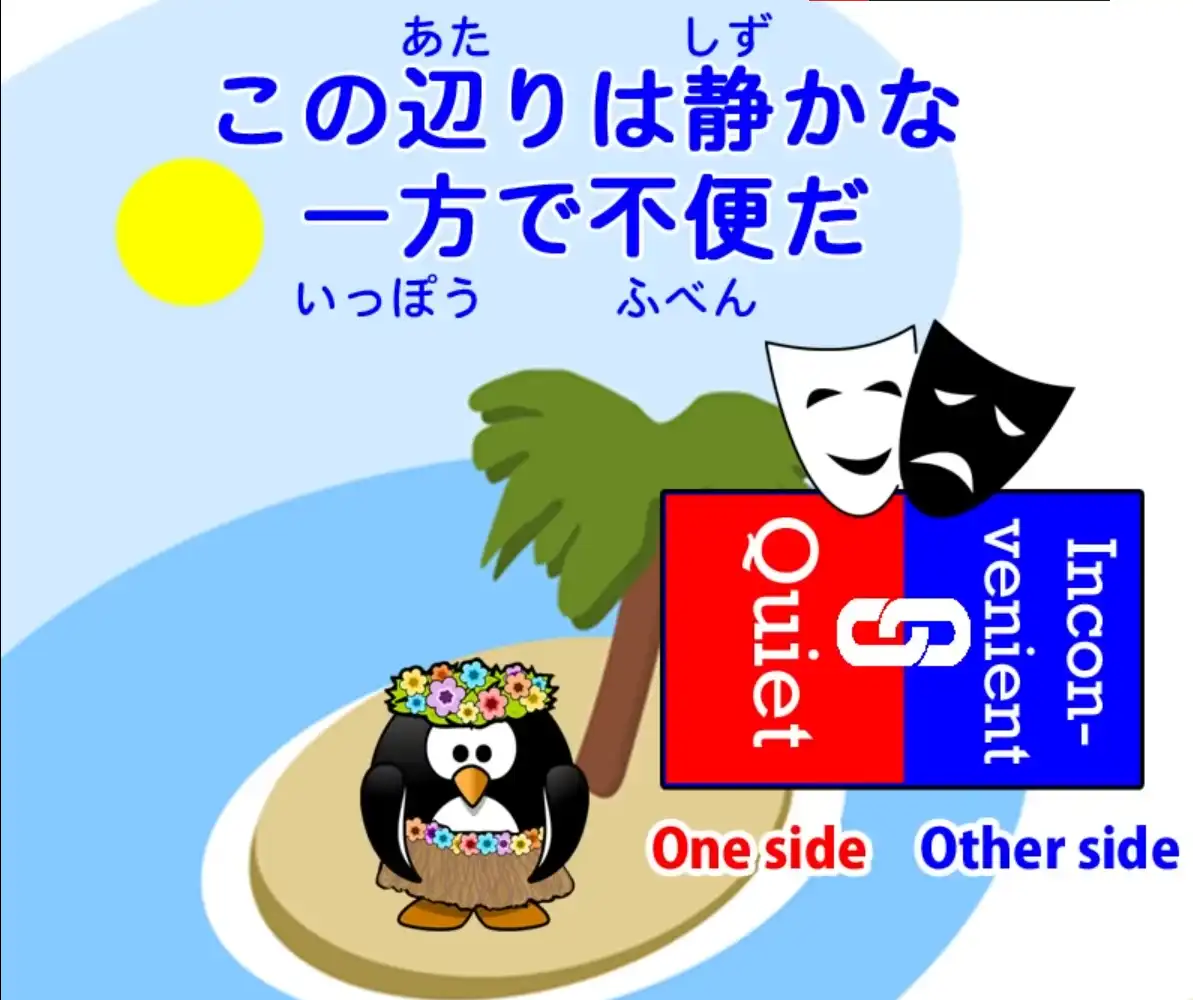
So, we’re describing the one side, the “一方で” and then “で”, that’s the copula – “One side is that it’s quiet, and the other side is…” (but we don’t actually say “but the other side is”, that’s already implied) – “One side is that it’s quiet, it’s inconvenient.” And that “一方で” acts as the conjunction.
And we can, once again, leave off the copula here.
One other use of “一方” that we should mention is that it can also be used after a complete verbal clause to show that something that is happening is continuing in one direction.
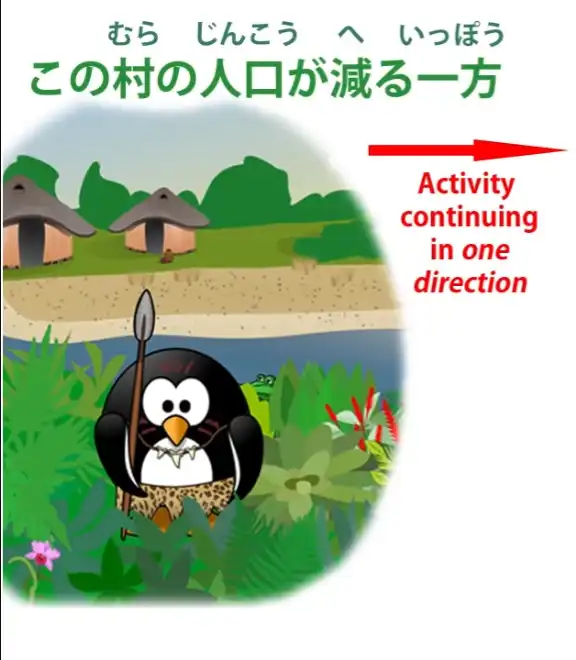
For example, we might say “この村の人口が減る一方だ” – “This village’s population is just declining and declining / … just goes on declining.” “この村の人口が減る” means “This village’s population is declining” and the “一方” is telling us that it just continues on in that one direction: it never grows, it never stays still, it just declines and declines.
36. 所 - the concept of “place”
Lesson 36: Tokoro- the Japanese concept of Place - Grammar Magic
こんにちは。 Today we’re going to talk about the concept of “place” in everyday Japanese, because this is something that often confuses people, and I’ve seen even quite good amateur translators getting it wrong.
The word for “place” in Japanese is, of course, “所/ところ”, and we learn this from quite early on.
It means a literal place and it quickly takes on slightly metaphorical uses.
For example, we can say “私のところ”, which means “my apartment or house / the place where I live”.
“Come and hang out at my place.” In English, that doesn’t mean “hang out” as in “hang out of the window”. It means…
oh, forget it, English is too complicated.
However, in Japanese, the figurative sense of “place” goes a lot further than it goes in English.
For example, if I say “さくらのどこが好きなの?”
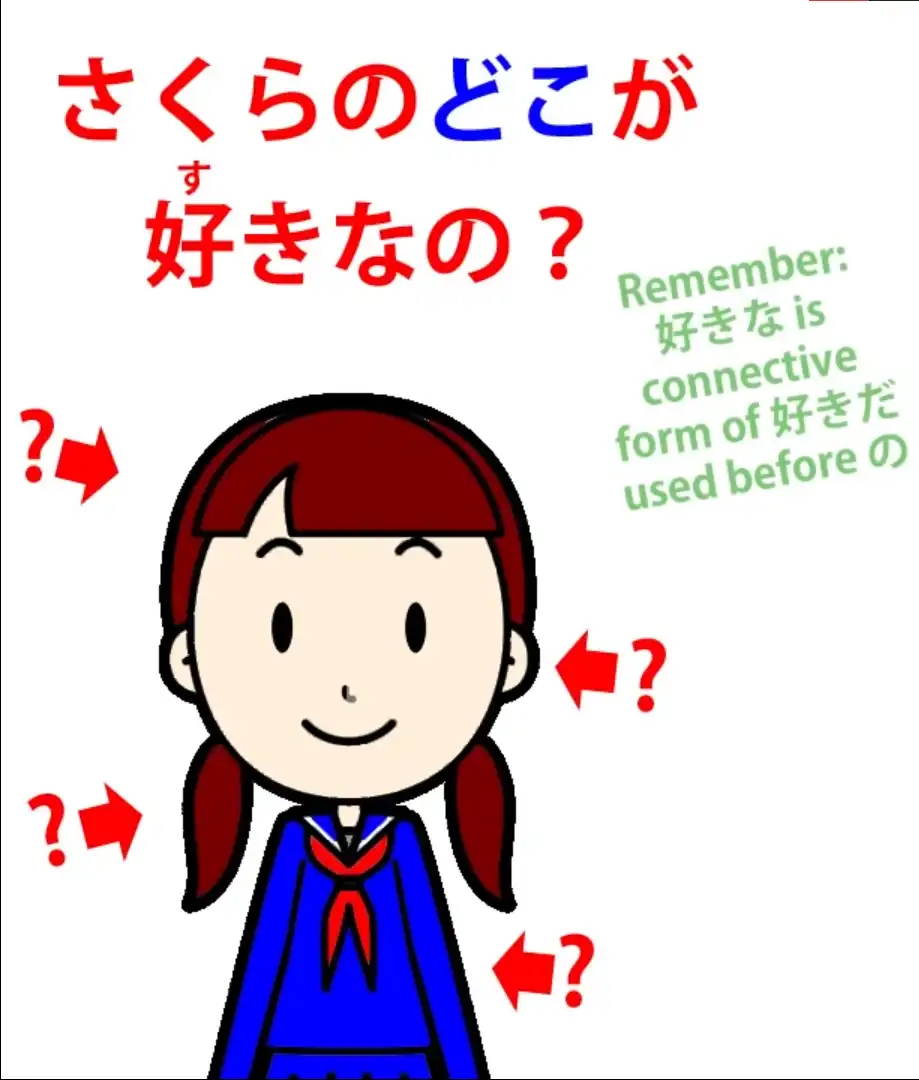
I’m asking, literally “Sakura’s where do you like?” or “What place of Sakura do you like?”
Note: To quote Dolly-先生 in the comments: ‘どこ means what it always means: “what-place?”
I was simply demonstrating the use of the “place” metaphor in more abstract areas. If you look again at the sentence you will see that if どこ meant simply “place” it would make no sense…’
Now, if I ask this, I’m not expecting an answer like “I like her left ear.”
An appropriate answer might be something like “やさしいだ” – “She’s gentle /
What I like about her is that she’s gentle / The place I like about her is that she’s gentle.”
And we might say “This is, in my opinion, Sakura’s いいところ’” – “Sakura’s good place
or one of Sakura’s good places”.
So “place” here doesn’t mean anything remotely like a physical location.
It means an aspect of something, even a really abstract something like a person’s personality.
If I listen to a complicated lecture, someone might say to me “分かりましたか?”
– “Did you understand it?” – and I might reply
“分かるところがあったが分からないところもありました” –
“There were places I understood and places I didn’t understand.”
And here, as you see, this is closer to a usage we might have in English:
“I mostly understood it, but there were places that I didn’t understand.”
This could lead to a subtle misunderstanding in that what I’m most likely to be saying
in Japanese is not that there were times during the lecture when I didn’t understand, but
there were aspects or subtleties that I wasn’t quite grasping.
So, especially if you’re more advanced, it’s good to be aware of this metaphorical depth of the concept of “place”.
Now, “place” is also often used to mean a place not in space but in time.
And if we understand this analogy, we can understand certain usages that are often explained without explaining the structural underpinning for them, which ends up by just giving you a list of things to memorize and as usual say “well, this goes with this and happens to mean that and we don’t particularly know why.” So, for example, we can use “ところ” – “place” – with “A does B” sentences in all three tenses, that’s to say, the past, the present, and the future.
So, for example, if we say, using the plain dictionary form of the word “食べる” – “eat” (which, as we know, from our lesson on tenses is not present by default; it’s future by default).
If we say “昼ご飯を食べるところだ”, what we’re saying is “I’m just about to eat lunch.” What’s the structure of this?
Well, it ends with “だ”, so we know that what we have is an “A is B” sentence, even though the original sentence sandwiched into it is an “A does B” sentence.
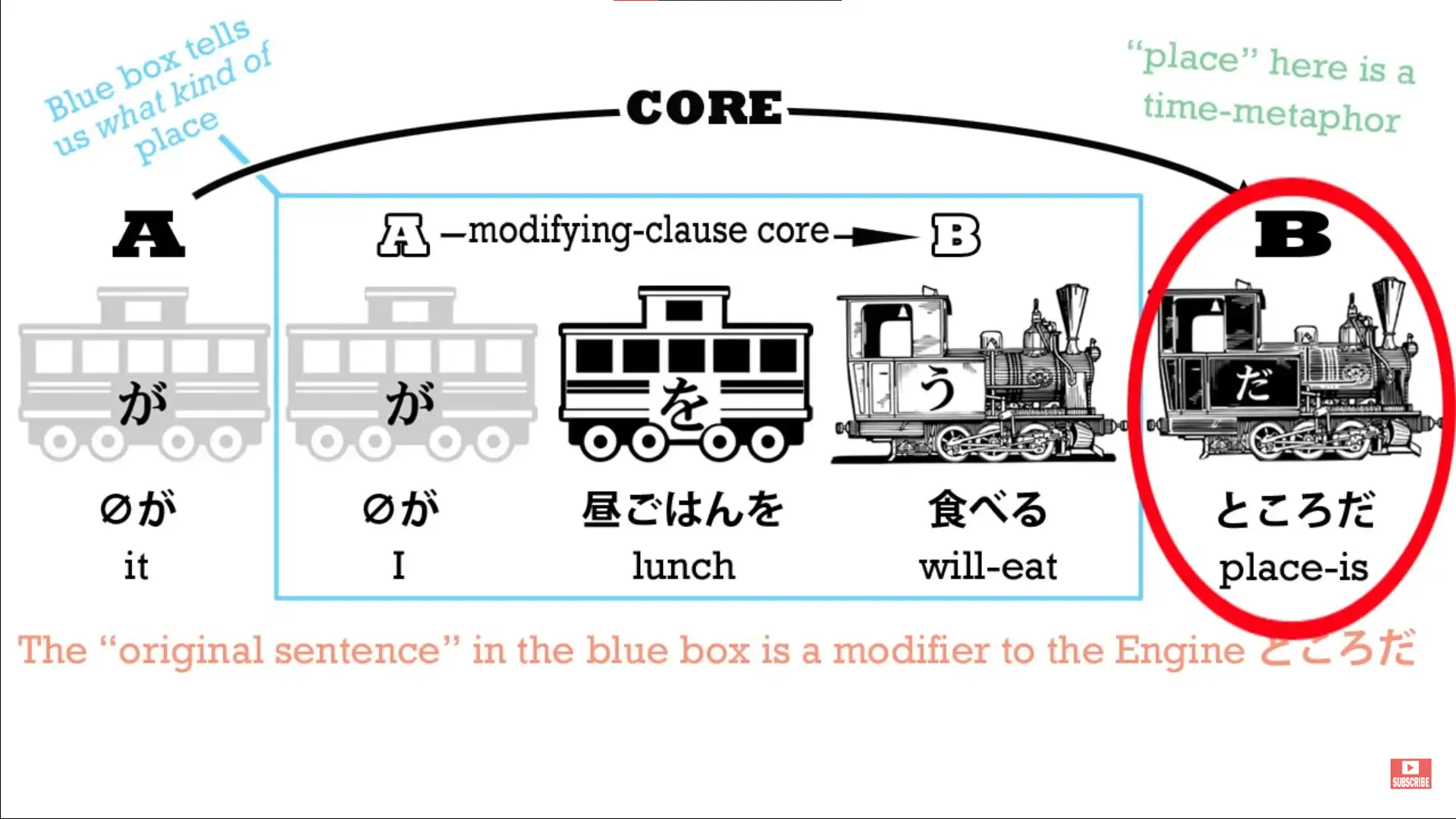
So we’re saying that “(something) is place”.
The zero-car here is “it”, as it would be in English, and what it means is the present time, exactly as it does in English when we say “It’s time to leave” – “the present time is time to leave”.
The “it” is “the present time” in both Japanese and English in these constructions.
So, we’re saying “It (the present time) is I-will-eat-lunch time”, so what it means is “I’m just about to eat lunch”.
So how putting “ところだ” onto this sentence changes it from what it would mean if we just said “昼ご飯を食べる” is that it’s telling us that we are right now at that place where I’m going to eat lunch, therefore I’m just about to eat lunch.
NOT “I’m going to eat lunch possibly in half-an-hour.” I’m just about to eat lunch right now.
This is the place where I’m just about to eat lunch.
“昼ご飯を食べるところだ.” Now, if we use it with the actual present, the continuous present, which is what we use when we’re actually saying we’re doing something right at this moment, so we say “昼ご飯を食べているところだ”, what we’re saying is “I’m eating lunch right now.” And just as with the previous example, what that “ところだ” is doing is making it immediate.
It’s the difference in English between saying “I’m eating lunch” and “I’m eating lunch right now.” Now, in the past, if we say “昼ご飯を食べたところだ”, what we’re saying is “I just ate lunch.” The “ところだ” is adding to that past tense the immediateness: “The place in time that we’re at now is the place where I ate lunch / I just ate lunch.” Now, in this case we could say “昼ご飯を食べたばかり” - “I just ate lunch.” The two mean pretty much the same thing.
And I’ve seen textbooks giving us this set of rules : “You can use ばかり with a noun.
You can say “このお店はパンばかり売る” – “This shop sells nothing but bread” – or we can say “昼ご飯を食べたばかりだ” – “I just ate lunch.” But you have to remember that the rules say that “ところ” can’t be used with a noun.” Now, this is true, but it’s a strangely abstract way of putting it.
It’s putting it as if these are just some random rules that somebody made up, perhaps in the Heian era because they had nothing better to do with their time.
In fact, if we understand the logic of it, we don’t even need to be told this, because it’s obvious.
I can say either “I just ate lunch” or I can say “I’m at the place where I’ve eaten lunch”.
We can say “This shop just sells bread”, but “this shop bread place sells” doesn’t make any sense at all, does it? (あのお店はところ売る = wrong) And this is why I think it’s so important to learn structure.
People sometimes say to me “Am I supposed to be working out all this structure you teach in every sentence I speak or read?” And of course the answer to that is “No”.
What you’re supposed to be doing is getting used to Japanese by reading, listening, and preferably speaking too. (=The importance of immersion stated right here (๑˃̵ᴗ˂̵)و ) If you’re not doing that, you’ll never get used to the grammar however many textbooks you study.
But if you understand the structure you won’t be confused by things like whether you can use “ところ” with a noun or not, and why can’t you use “ところ” with a noun when you can use “ばかり” with a noun, and you have to think all that out.
You don’t have to do that because you understand how it’s actually working.
This is what the textbooks could usefully be teaching, but they don’t.
Now, having learned the structure, it’s also important to be aware of the times when bits of the structure can get left off.
As with many regular set expressions, the copula “だ” can be left off, and more than this, even the end of “ところ” can be left off.
The “ろ” can be left off and we can just say “とこ”.
This is the case in all languages, that there are places where, colloquially, we can leave bits out.
And so long as we know what the structure is, it’s not very difficult to understand the omissions too.
So, we might say “名古屋/なごやに着陸したとこ” – “I just landed at Nagoya.” And we often use these abbreviations like “とこ” – leaving off the “ろ” and the “だ” from “ところだ” – when we are trying to express a sense of immediacy.
But people do it on various occasions, just as they do the equivalent thing in English.
So, we see that “ところ” can be literal, a “place in space”.
It can express very abstract concepts like an “aspect of someone’s personality”, and it can very often mean a “place in time”.
And it can be used in various ways as a place in time; for example, if someone says “いいところに来たね?” That is most likely to mean “You came at a good time, didn’t you?” NOT “You came to a good place, didn’t you?” although in fact it can mean either.
Remember that in Japanese, context is king..
37. New structure secrets + な vs の, なる & たる adjectives
Lesson 37: Dominate Japanese Text! New structure secrets + “na vs no, naru & taru adjectives”
こんにちは。 Today we’re going to go a little deeper into Japanese structure.
But perhaps unexpectedly, that’s going to make things even simpler than we might have thought they were.
And it’s going to make it much easier to look at a page of Japanese and, even when it looks very complicated, have a much clearer idea of what the elements are and how they’re likely to fit together.
You may have noticed that I map sentences very often using trains, and you may have noticed also that we have a relatively small number of carriage types.
We have the three engines: the verb engine, the adjective engine, and the noun-plus-copula engine.
And we have the various cars, all of which represent nouns with their various attached logical particles, which tell us what the nouns are doing in the sentence.
Now, this relatively small number of cars actually boils down to only three types of word.
We have the い-engine, which is adjectives, we have the う-engine, which is verbs, and everything else is a noun.
We have the noun-plus-copula engine and we have the various noun carriages with their different particles.
And we may notice that I haven’t introduced an adverb car, and that’s because most adverbs – not all but most – are in fact variants on an adjective or variants on a noun.
There are a few genuine other kinds of word, but most of what you see in Japanese is going to boil down to one of these three, despite what the dictionaries will sometimes tell you.
And if it’s not a verb or an adjective, then it’s likely to be a noun.
What the dictionaries call な-adjectives are nouns, what they call の-adjectives are nouns, what they call する verbs are nouns.
And most of the things that they put into other categories – not all but most – turn out to be nouns. Japanese is a very noun-centric language.
We could be tempted to attribute this fact to the fact that there are a lot of foreign words in Japanese and all of them are nouns.
A great part of the Japanese vocabulary comes from Chinese.
There are also words from English and German and other languages, but they pale into insignificance compared to the older Chinese vocabulary in Japanese,
which is similar to the large amount of the English vocabulary which is Latin, either directly from Latin or indirectly via French.
The difference is that, as I’ve said, in Japanese everything that comes from any language other than native Japanese comes in as a noun.
And I said that we might be tempted to attribute to that the noun-centric nature of Japanese, but in fact, I would say it’s the other way around.
It’s because Japanese is so fundamentally noun-centric that it seems natural to import anything into the language as a noun.
Once it comes in as a noun, if we want to use it in the manner of a verb or in the manner of an adjective, there are ways of doing this.
And we’re somewhat familiar with those ways, aren’t we?
When a noun comes in from Chinese, if we want to use it as a verb, we turn it into what the dictionaries call a “する verb”.
And in this one case I have no quarrel with the dictionaries.
“する verb” is a real thing, but this is an exception because in nearly all other cases where a noun comes in, it stays a noun even when it’s used for a different purpose.
So, let’s start by looking at する verbs.
They’re very simple.
If we take the word “勉強” from Chinese, which comes in as the noun meaning “the act of studying”, we can say “勉強をする”, which means to “do the act of studying”, but we can also glue the words directly together and say “勉強する”, which means “(to) study”.
We have, in effect, by welding “する” onto the noun turned the combination into a true verb.
So, in this particular case, we can say that a noun came in from Chinese and really became naturalized as a する verb.
However, if we want to use a noun as an adjective, let’s say the noun “綺麗/きれい”, which means “prettiness” or “cleanness”, it never stops being a noun.
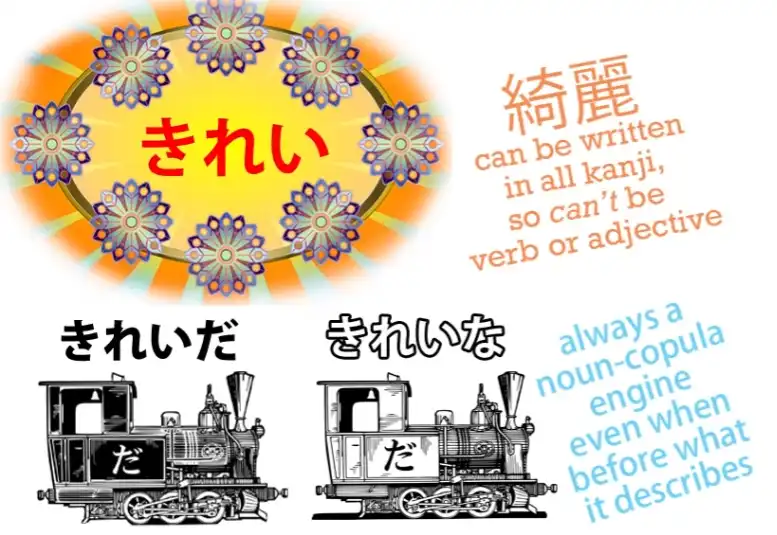
The dictionaries and textbooks tell us about “な-adjectives”, but the word is really nonsense.
There is no such thing as a な-adjective.
There is an adjectival noun which continues to act in almost every respect like any other noun. The only difference between an adjectival noun and any other noun is that we can use “な” with it.
And “な”, as we know, is simply the connective form of “だ”.
So, we can say “女の子は 綺麗/きれい だ” – “the child is pretty” – or we can say “きれいな女の子”, which means “pretty child”.
“きれいだ” means “is pretty” and “きれいな” also means “is pretty”, so we’re saying “child is pretty” or “is-pretty child”.
“な” and “だ” are the same copula.
Now, the reason these are called adjectival nouns is that we can’t do this exact thing with other nouns.
But we can do something very close, and we’ll come to that very shortly.
But I’ll just note before passing on that we can say that there are essentially two types of adjectival noun, and that is, the ones like “綺麗/きれい”, which really are not used as ordinary nouns at all; they’re almost entirely dedicated to being adjectival: we don’t talk about a person’s “きれい”.
And then there are the ones which continue to work as independent nouns, like “元気”.
So we can say “子どもが元気だ” – “the child is lively”; we can say “元気な子ども” – “lively child”.
But we can also say things like “元気を出して”, which loosely translated means “cheer up”, but literally translated means “get out your 元気”.
“元気” is a thing here: it’s marked by the を-particle, and you can’t put a logical particle onto anything but a noun.
So, “元気”, even though it’s primarily adjectival and is classed as an adjectival noun, works as both an adjectival and a noun.
Now, if a noun is not classed as an adjectival noun we can still use it adjectivally.
So, the word “魔法/まほう”, which means “magic”, can be used as a noun just as it can in English.
We can talk about magic as a thing.
But we can also say “魔法の帽子” – “magic hat”.
It’s not an adjectival noun, but as you see, we can achieve pretty much the same effect just by using “の” instead of “な”.
There are also some words that can be either の- or な-adjectivals.
A good example of this is “不思議/ふしぎ”, which means a “mystery” or a “wonder”.
It tends to get used very often as an adjective as in “不思議な屋敷/やしき” – “mysterious mansion” – but it’s also used quite often as a noun.
We can talk about the school “七不思議” – which means literally the ‘‘seven wonders’’ or “seven mysteries” of the school, and what it usually refers to is in fact ghost stories connected to the school, such as “トイレのはなこさん”, who you may have heard of – the girl who haunts the lavatory.
Now, “不思議”, if we’re using it adjectivally, it can be what the dictionaries call either a “な-adjective” or a “の-adjective”, that is to say, we can use either “な” or “の” when we’re using it adjectivally.
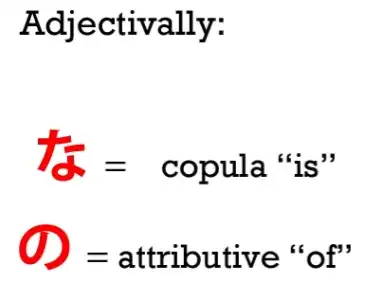
Is there a difference between the two?
I would say yes, there is a subtle difference.
“Alice in Wonderland” in Japanese is called “不思議の国のアリス”.
Now, it could have been called “不思議な国のアリス”, but I think “不思議の国のアリス” is a much more appropriate title and a much better translation of the original title, “Alice in Wonderland”.
“不思議な国のアリス” would mean “Alice of the mysterious country”, to say literally “Alice of the mysterious-is country”.
“不思議の国のアリス” implies more “Alice of the country of wonders”.
We’re leaving “不思議” more as a noun in itself and attributing it to the country.
It’s a subtle difference, but it’s one that’s worth bearing in mind, especially where there is a choice between the two.
But the most important thing to bear in mind is that whether a noun is an adjectival noun or an ordinary noun being used as an adjective with “の”, it’s always going to function as a noun.
Now, the dictionaries also like to mix things up by telling us that there are other kinds of adjective too;
なる & たる “adjectives” (nouns)
they’re less common, but there are “なる-adjectives” and “たる-adjectives”, and what on earth do these mean and what’s the story about them?
Well, the truth is that they again are simply nouns.
#
なる
So, if we take a book that my little sister likes… it’s called “アリスとペンギん:華麗なる探偵”, which means “Alice and Penguin: The Magnificent Detectives”.
Actually, “華麗/かれい” is an adjectival noun, so we can use it with “な”, but in this case the author has chosen to use “なる” instead.
What does “なる” mean here?
Is it the “なる” that means “become”? No, it isn’t.
It’s a contraction of “のある”.
And as I have explained in another video,
“の” can be used in place of “が” in adjectival phrases.
And I’ve explained why that is in the other video.
So “華麗なる探偵” means “華麗のある探偵” which means “華麗がある探偵” which means “detectives possessing ‘華麗/かれい’”. (lit. 華麗-exists detectives) What is “華麗/かれい”? Well, it’s “splendor” or “magnificence”.
*Note: there is a recent comment made by one Nihil, who gives a highly useful & detailed breakdown of this なる being short for にある and not のある. From my look into japanese dictionaries, I also found it referring to にある (from archaic なり) instead of のある. Thus, I highly recommend reading through Nihil’s comments under the video. Unfortunately, since Dolly is no longer around, we may not entirely know what she meant here, but she does admit in the comments also that she did not find what なる actually means (in full form). Of course, this may not be some huge thing in the grand scheme of understanding for some, but I think it is good to know and Nihil’s answers are just incredible, so they deserve some recognition:)
*

The author actually supplies an English translation, although the book is entirely in Japanese, of the title: “Alice and Penguin: The Excellent Detectives”.
But I would say this is not a very good translation into English.
“華麗” means something more than “excellent”, but even more than that, the choice of “なる” rather than “な” – what does that mean?
Does that have an implication, like the one in “不思議の国のアリス”?
I would say it could have done, in the past, up to a certain point, but with a modern text, making the choice to use “なる” has a different meaning.
It’s being chosen because it sounds a bit more old-fashioned, a bit more literary, a bit more somehow portentous.
Therefore, in English I would choose the rather overblown term “magnificent”, because “華麗” is in fact quite an overblown word to use in the first place and choosing to use “なる” with it blows it up even further.
#
たる
“たる”, which is also sometimes used, is a contraction of “とある”, so that “ある” is actually being attributed to the thing being described rather than to the thing that’s describing it.
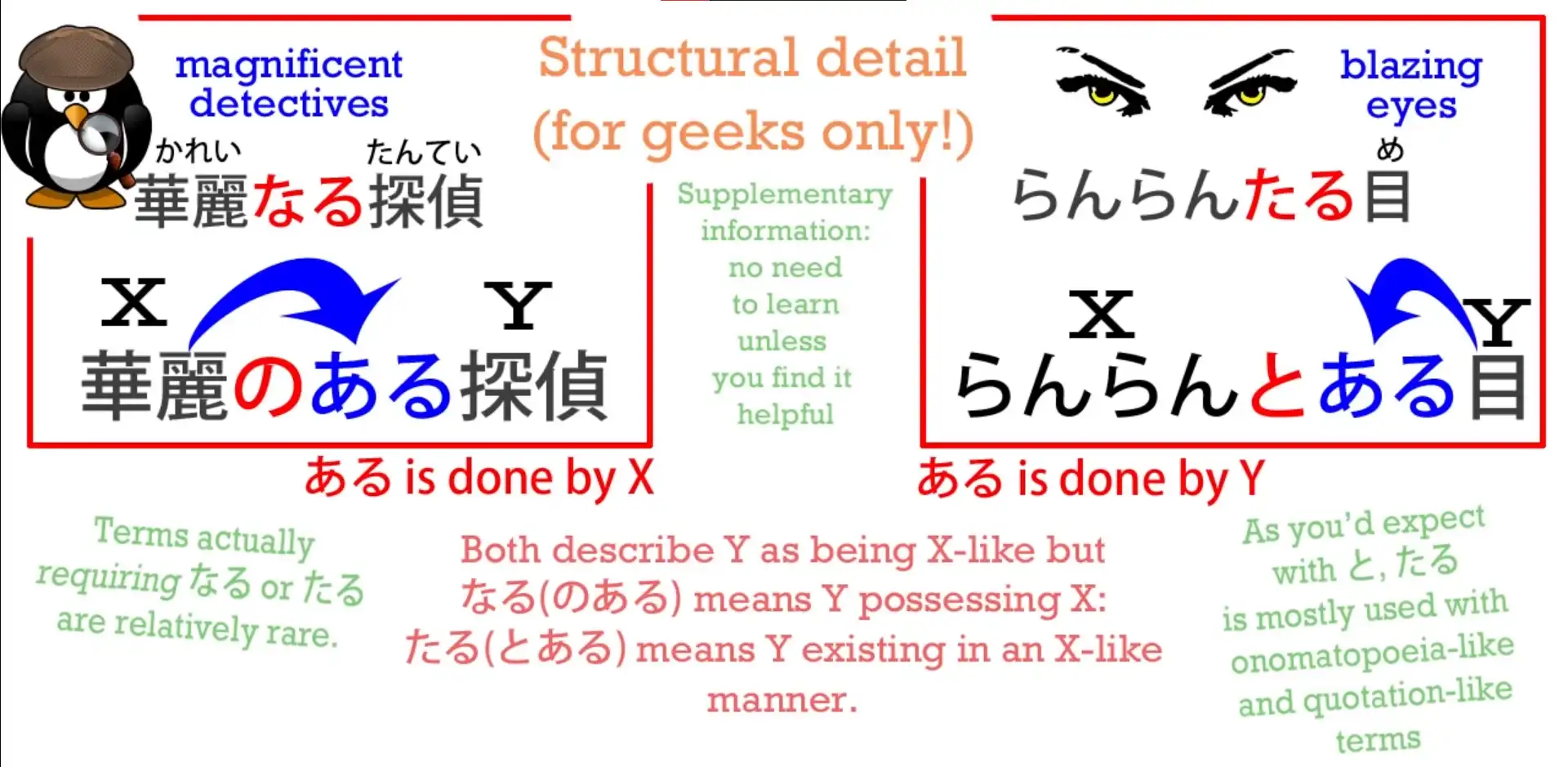
It’s saying that the thing being described exists in the way implied by the noun that it’s using as a descriptor.
In practice, the difference isn’t huge, but it’s worth bearing that in mind just to see what the subtler implications might be.
But the point here is that we’re playing with a very small number of elements.
We have verbs and we have adjectives and most of what is not one of those is simply going to be a noun.
Even if it works as an adverb, it’s going to be fundamentally either a noun or an adjective.
And an important thing to bear in mind, because every word that’s imported from Chinese is a noun, if we see a word that is made up of kanji without any okurigana, without any attached hiragana, we know that that word is almost certain to be a noun.
So, understanding the noun-centric structure of Japanese makes it easier for us to see what’s going on when we look at a page of Japanese.
One thing that can be confusing, however, is the fact that we will sometimes see groups of kanji sitting together with no kana in between them.
What’s going on on these occasions?
We know that free-standing kanji are going to be nouns, so when we see a lot of them together, what’s happening?
Well, what’s happening is that one noun is modifying another.
We’ve seen the ways in which nouns modify each other with “な” or “の”
or even “なる” or “たる”,
but they can also modify each other with nothing, and we’re already familiar with
that where two words glue together to make another word, such as “日本語”.
“日本” is “Japan”, “語” is “language”, and if you put the two together you have “日本語” – “Japanese language”.
Now, we see that in many, many cases, some of which we’ve already covered.
And this works exactly the same way as in English.
For example, in English we have words like “bookshelf” and “seaweed”.
In Japanese we can do exactly the same thing.
So we have “本棚” – “本” is “book”, “棚” is “shelf”: “本棚” is “bookshelf”.
“海草” – “海/かい” is the 音読み-reading of “海/うみ”, “sea”;
“草/そう” is the 音読み-reading of “草/くさ”, “grass”,
and together they make “海草” – “seaweed”, because “grass” can mean any kind of plant-life, which is why we have Grass Pokemon.
And this also happens in the case of combinations that don’t exist in English, such as “指輪”.
“指/ゆび” is “finger”, “輪/わ” is a “ring”, so “指輪” is a finger ring.
However, we can see larger combinations too, for things that would be phrases rather than words in English. And again this is done in exactly the same way as it happens in English, so it should really be no cause for alarm.
For example, we have “大学教育” – “大学” means “university”; “教育” means “education” or “training”.
So “大学教育/だいがくきょういく” is “university education”.
And, as you see, again it works exactly the same way as in English.
We don’t need, in English, to say “education at a university” every time; we can say “university education”.
And in Japanese we can say “大学教育”, and we don’t need any “な” or “の” or anything else to join them. They create a commonly used phrase on their own.
We can’t do this every time. It’s like adjectival nouns.
There are certain expressions where this is known and accepted and certain kinds of construction where this is frequently done.
Now, we may see longer blocks of kanji which can look very daunting until you understand what they are, how they work and what they’re likely to be.
It’s often done in the case of institutions and things like that.
For example, “日本語能力試験”. Now, that looks quite a daunting block of kanji perhaps, when you’re not familiar with the idea.
But what this actually is is the Japanese Language Proficiency Test, which you’ve probably heard of and of which I’m not a great advocate.
And we can see that exactly the same thing is happening in Japanese as in the English equivalent: “日本語” – “Japanese language”; “能力” – “proficiency” or “ability”; “試験” – “examination”.
And exactly as in English we can use one noun to modify another noun and then the two of them together to modify the third noun – and so on.
So, “日本” modifies “語” (what kind of a language? Japanese language).
“日本語” modifies “能力” (what kind of proficiency? Japanese language proficiency).
And then all of it modifies “試験” (what kind of exam? A Japanese language proficiency exam).
So even when you see kanji piled up in this way, there’s no need to panic.
Just take a breath and see what it’s all made up of.
38. When “it isn’t” means “it is”: じゃない, ではない
Lesson 38: Know when “it isn’t” means “it is”: mysteries of じゃない janai, ではない de wa nai
こんにちは。 Today we’re going to talk about something that puzzles many learners of Japanese, especially once they’ve learned a little Japanese and they start reading Japanese or listening to anime etc.
And this is the fact that Japanese people often make what appear to be negative statements when they may mean in fact a positive statement.
For example, someone may say “さくらじゃない”, which would appear to mean “That isn’t Sakura.” But its actual meaning is “That is Sakura, isn’t it?” or even simply “That is Sakura”.
Now, how does this work, how do we recognize it, and how do we understand it?
For a start, “じゃない” is the contraction of “ではない” which, of course, is the negative of the copula, as we learned right back in our lesson on Japanese negatives.
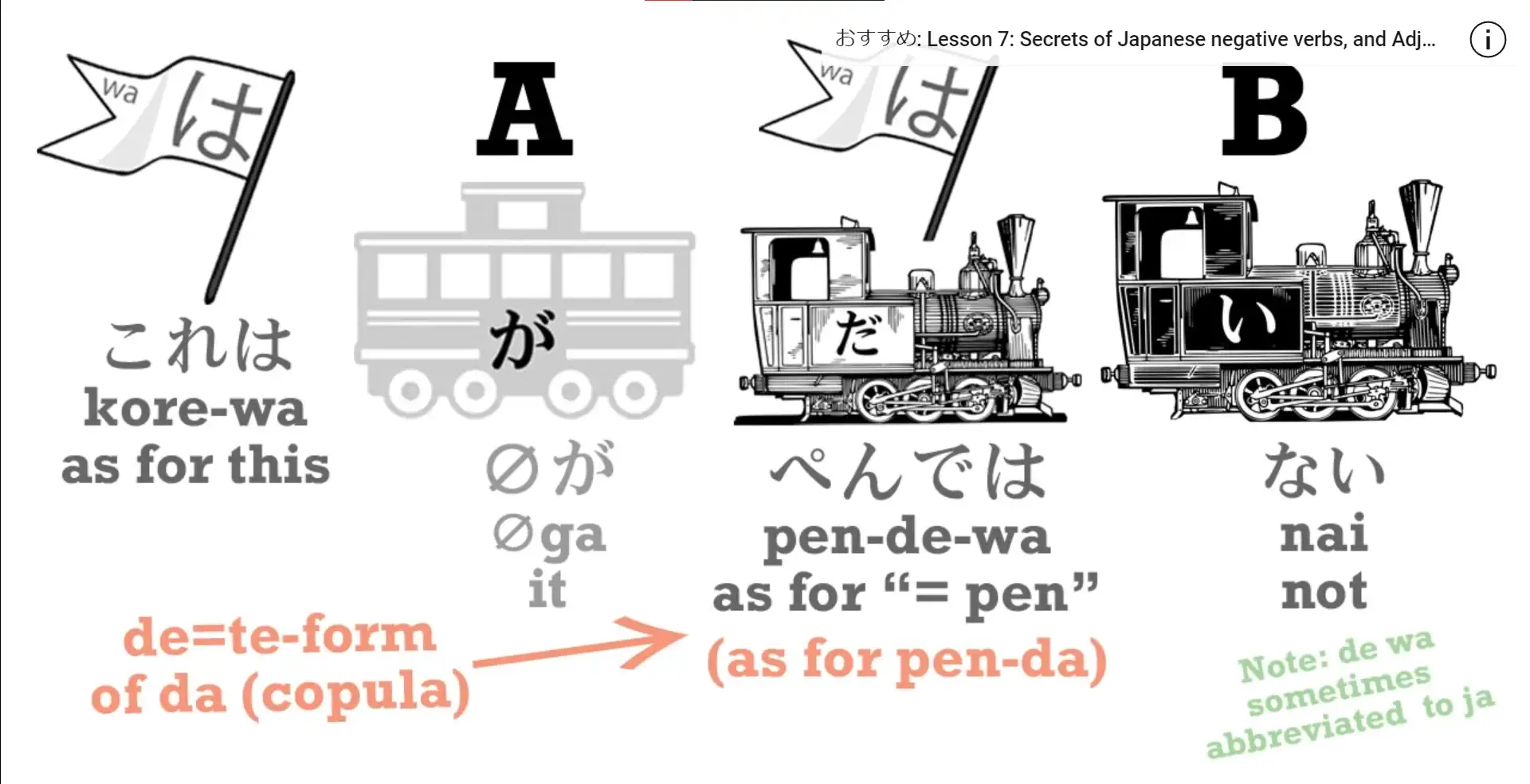
So, “A,Bだ” or “A,Bです” means “A is B”.
“A,Bではない (or ではありません)” means “A is not B”.
So there is no question here that we are in fact hearing what is, grammatically, a negative statement.
So how do we interpret this?
Well, to begin with, let’s remind ourselves of the fact that negative questions are used in most languages, including English, to elicit a positive response.
So if we say “It’s a nice day, isn’t it?” we mean that it is a nice day and we expect our hearer to agree.
If we say “Are you Sakura?” this is a neutral question.
We’re not suggesting that we either think it is or it isn’t.
We’re simply asking the question.
But if we say “Aren’t you Sakura?” then we are in fact indicating that we think you are Sakura.
And a negative question asking for a positive response like “It’s a nice day, isn’t it?” is common certainly to all the languages I know.
In French we have “n’est-ce pas”, in German we have “nicht wahr”, and of course in Japanese we have “ね”, which is originally a negative question.
So if we say “さくらじゃないですか” we’re saying exactly the same thing as in English “Isn’t that Sakura?” meaning we think it is.
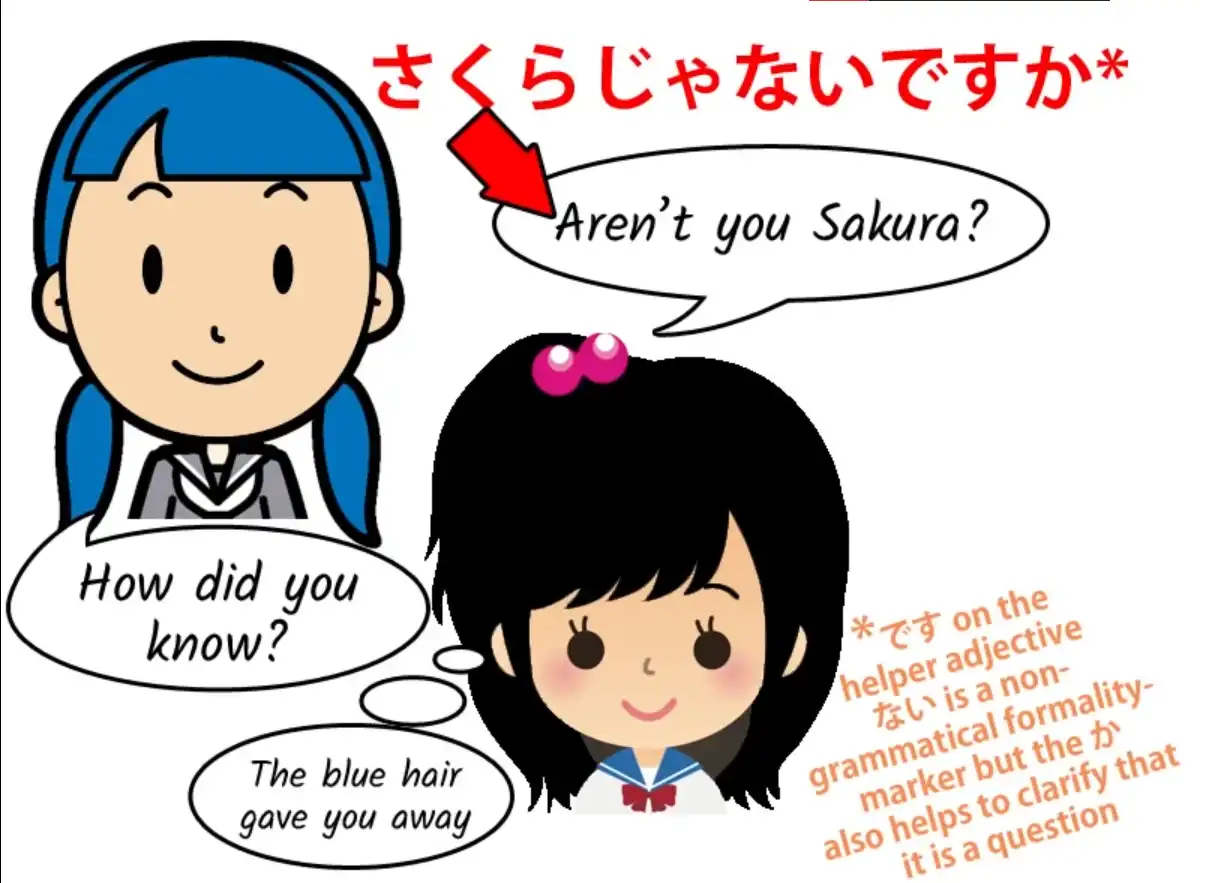
The first problem that arises here is that, while we say in formal speech “さくらじゃないですか” because in formal speech the “か” acts as a verbal question mark, turning any statement into a question, we don’t usually use “か” as a question-making sentence-ender in ordinary, non-formal Japanese.
So what would be “さくらじゃないですか” in formal Japanese becomes “さくらじゃない” in regular Japanese.
“さくらじゃない” has fundamentally three potential meanings. (indicated by tone in speech) We can say “さくらじゃない。” – that means “That isn’t Sakura”.
We can say “さくらじゃない?” and that means “That’s Sakura, isn’t it?” But we can also say, perhaps meeting Sakura after quite a long time, “さくらじゃない!”, and that certainly doesn’t mean it isn’t Sakura and it’s not a question either.
We’ve actually recognized her and what we’re saying is something that could perhaps best be rendered into English as “If it isn’t Sakura!” meaning it is Sakura.
Now there’s nothing particularly mystical and Japanese about this.
We do the same sort of thing in English.
For example, if we said “She came on Saturday”, that’s simply conveying a piece of information.
If we say “She came on Saturday?” we’re asking whether she came on Saturday or not.
And if we say “She came on Saturday?!” we’ve just received the information that she came on Saturday and we are expressing surprise about it.
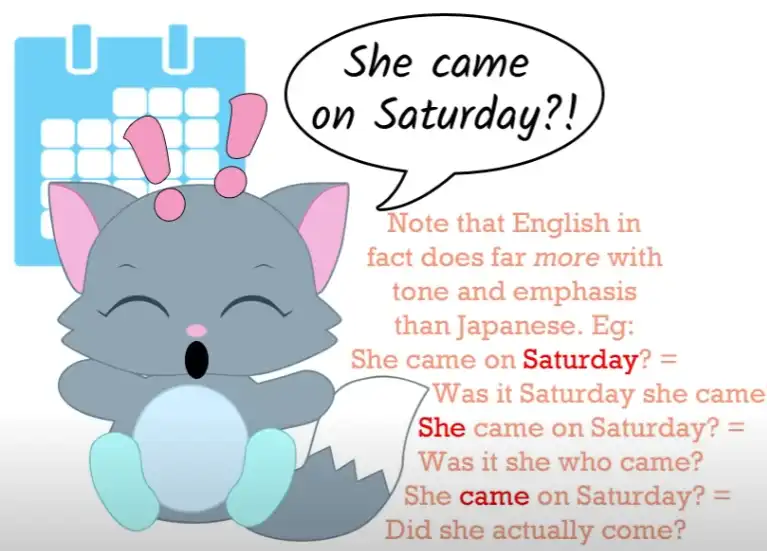
We know how to interpret this in English and it’s easy to learn how to interpret “じゃない” in Japanese once we understand the range of meaning it possesses.
“じゃない” gets used with other meanings too.
Particularly, it gets used as a negative question tag-ending very much like “ね”.
For example, we might say “暑いじゃない”
which means pretty much the same thing as “暑いね”.
It’s something like a tag-question, expecting our listener to agree with us.
And we can note here that there’s no ambiguity at all in this, because “暑いじゃない” is not the negative of “暑い” – that’s “暑くない”.
And it can also be put after verbs.
For example, “もう言ったじゃない”, which means “I already said that, didn’t I?” We should also note that “じゃない” is often reduced to just “じゃん” in very colloquial speech, and it’s often used in that way when it’s affirming something or asking for confirmation.
Now, it’s clear that these expressions are very colloquial and in fact so colloquial that when we use them with a verb or an adjective they’re not in fact grammatical.
And the reason for this, as I’ve already alluded to, is that, for example, “暑いじゃない” is not the negative of “暑い” because that’s “暑くない”.
Why can’t we use “じゃない” with verbs or adjectives?
Well, that’s because, as we learned right back in the first lesson, “じゃない” is in fact “ではない”, which is the negative of the copula.
So if we say “これはペンだ” we’re saying “This is a pen”; if we say “これはペンではない”, we’re saying “This is not a pen”, and you can’t properly use “ではない” with anything but two nouns.
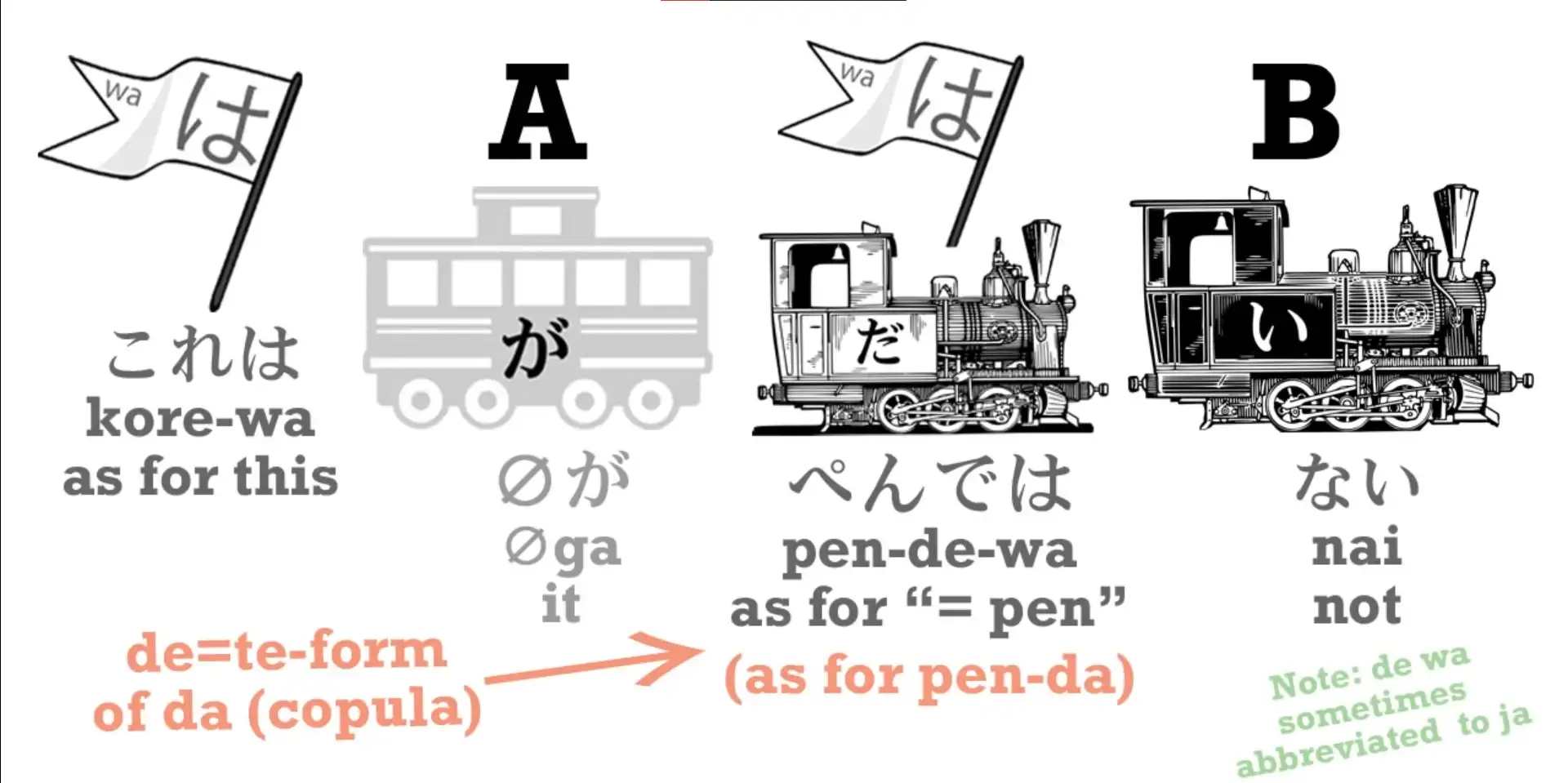
I don’t actually think that these colloquial statements are fundamentally ungrammatical.
It’s just that being colloquial may leave a few steps out of the process.
There are in fact much more formal ways of using “ではない” as a positive statement, but these of course tidy up the grammar.
So, for example, if we say “その理論が間違っているのではないでしょうか”, we’re saying “Might that theory not be in error?”
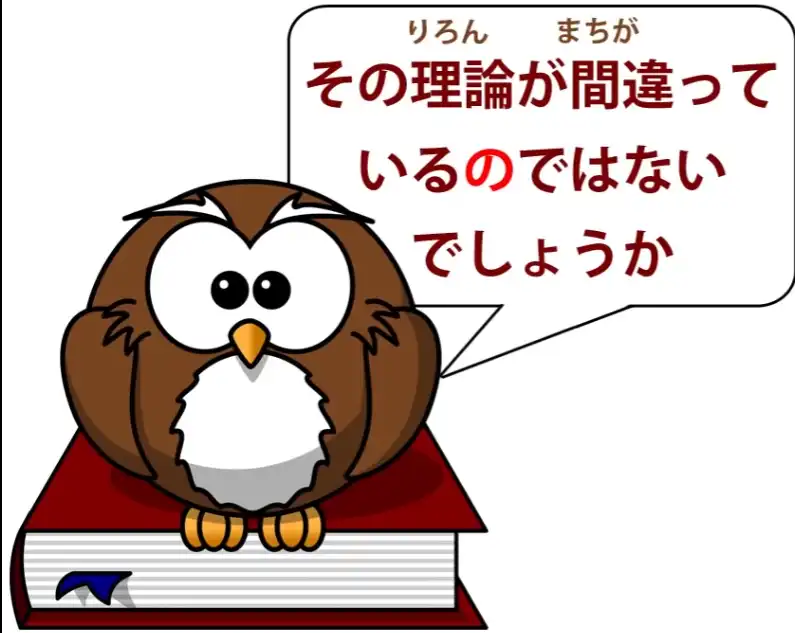
And we see we have essentially the same construction that we’ve been dealing with before: “その理論が間違っている… ではない”, but that “の” turns it into a grammatical statement.
Why?
Because “その理論が間違っている” means literally “that theory exists in a state of mistaking”. That’s a verbal clause complete in itself.
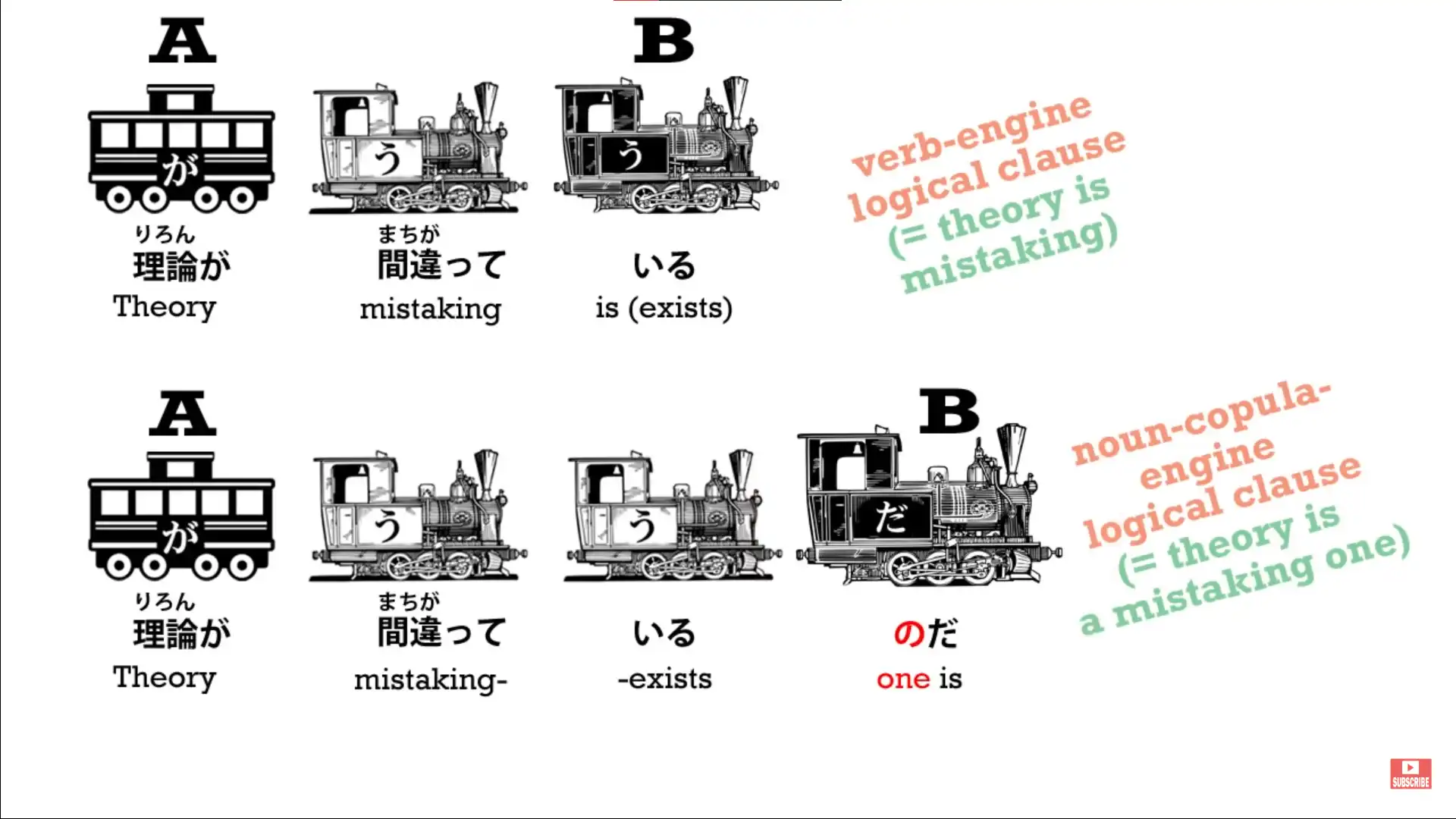
However, when we add “の”, that “の”, as we’ve seen in other lessons, plays the role of a pronoun like “thing” or “one” which is being modified by “間違っている”.
So now we have “that theory exists in a state of error one”.
So we have two nouns and we now need the copula to join them together.
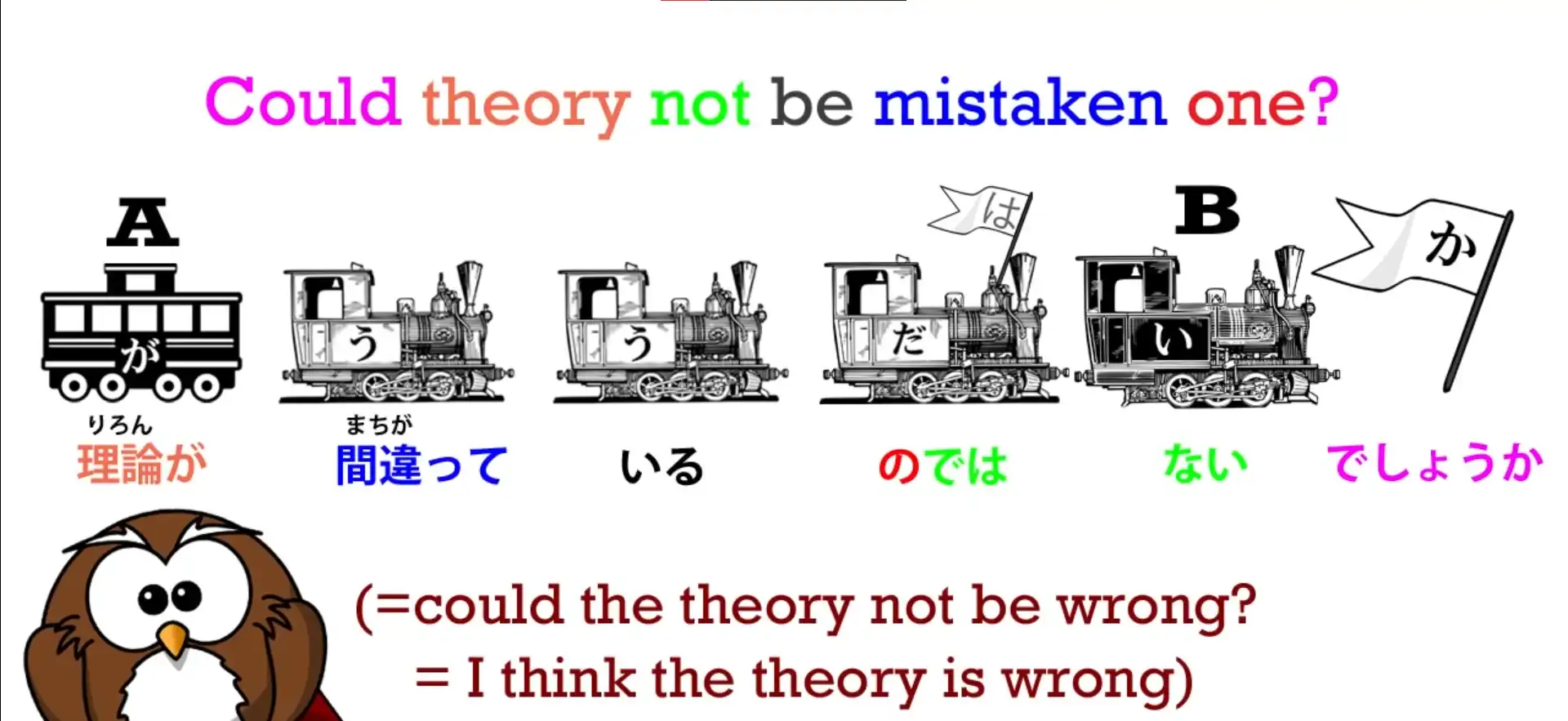
So “その理論が間違っているのではない” means “that theory existing-in-error-one is not”.
The “でしょうか” doesn’t add anything grammatically to the statement.
As we know, adjectives like “ない” stand on their own.
They don’t require a “だ”, even though they get a “です” as a mere decoration, a non-grammatical decoration, in formal speech, so what “でしょうか” is doing here is it’s simply a flag put at the end of the complete grammatical statement:
“その理論が間違っているのではない”.
“でしょうか” turns it explicitly into a question and into a suggestion rather than a statement.
So we’re saying “Might that theory not be a mistaken one”?
Now, this can mean what it seems to say.
It can mean that we’re in some doubt and we’re actually asking whether that might not be the case.
But a lot of the time this is used not just as an assertion but as a quite strong assertion.
We might use this to sum up our argument when we have definitively disproved the theory in question.
An American writer or speaker might sum up such an argument with “It is now clear to anyone with an intelligence greater than that of a Roomba that this theory holds about as much water as a topless thimble in the Sahara Desert.” However, that kind of definite assertion in Japanese is not considered either polite or very persuasive.
It sounds as if you’re trying to make up for a weak argument by a strong assertion.
So the equivalent Japanese speaker may sum up the same completely persuasive argument with “ですからその理論は間違っているのではないでしょうか”.
And that means exactly the same thing, allowing for cultural differences…

Note: if anything is still unclear, delving into the comments of the video might be helpful.
39. The か Particle: “Buried questions”, かな, もんか, かどうか…
Lesson 39: The か Ka-particle’s Secret Life! “Buried questions”, Kana, Monka, Ka dou ka & much more
こんにちは。 Today we’re going to talk about questions that aren’t questions.
They come up all the time in Japanese, so it’s important to understand what they are and how they work.
So, what we’re going to talk about is the particle -か.
Now, we probably know the particle -か as a kind of verbal question mark that goes at the end of です/ます sentences to turn them into questions.
However, we don’t use -か, as we explained last week, at the end of sentences to mark them as questions in regular, non-formal Japanese.
Why not?
Because putting -か at the end of a non-formal sentence sounds kind of blunt and rough.
It’s not ungrammatical, and it’s sometimes used by male speakers who want to sound blunt or rough.
But generally speaking, we don’t use it.
We indicate questions by intonation in regular speech.
But we do use the -か marker all the time, just not at the end of sentences.
What do we use it for?
Well, we use it to mark questions, but not quite what we normally think of when we say “question”.
So let’s start right off with an example.
Suppose we say, “さくらが来るかわからない.” What we’re saying is “I don’t know if Sakura will come.” And what’s literally happening here is that we’re turning the logical sentence, the proposition, “さくらが来る”, which means “Sakura will come”, into a question, and then we’re saying “わからない.” So we’re essentially saying “Sakura come (question), not clear / The question of whether Sakura will come is not clear to me.” In English, “I don’t know if Sakura’s coming.” Now, we can use this as part of an actual question.
We might say “さくらが来るか知っていますか.” Now, if we ask that in です/ます form, as I just did, we use a second -か at the end to mark the actual question.
So we’re saying “The question of whether Sakura will come, do you know?” And we should notice here that what’s happening is, first of all, the -か is turning the proposition, the question, into something noun-like which we can then use as the basis of a new sentence.

So that’s the first thing we need to notice, and the second thing we need to notice is that -か displaces logical particles most of the time.
So, normally when we say “わからない”, we say “(何-何)がわからない”; if we say “知ってる”, we say “(何-何)を知ってる”; but in this case the -か particle displaces the normal logical particle.
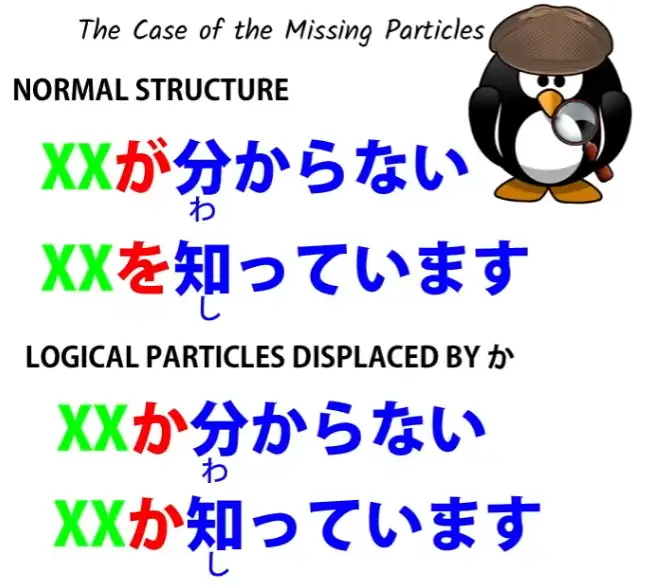
So we say “さくらが来るかわからない” not “さくらが来るかがわからない.” So “さくらが来るか” is a noun-like entity which, because it ends in -か, doesn’t need to take the usual logical particle.
かどうか
Now, it also gets used in the common expression “かどうか”.
And although we can learn this as a glued-together expression meaning “whether or not”,
so “さくらが来るかどうかわからない” means “I don’t know whether Sakura’s coming or not,”
(in English that’s how we’d say it, as opposed to “さくらが来るかわからない” –
in English we’d say “I don’t know if Sakura’s coming”;
“さくらが来るかどうかわからない” – we’d say in English “I don’t know whether Sakura’s coming or not.”)
what we’re literally saying here is “Sakura coming (question) how (question) わからない.”
So what we’re saying is something like “I don’t know if Sakura’s coming or how it will be.”
And from this we can see how we get the use of -か to mean “or” between nouns.
So we can say “お茶かコーヒーどちらがいい?” – “Tea or coffee, which would you like?” Now, how is this working?
Well, essentially this is an abbreviation of “お茶かコーヒーかどちらがいい?” So, we’re putting two propositions side by side, “whether coffee or whether tea,” and then asking “どちらがいい?” And once again although this seems like a different use, -か is doing the same thing – it’s bundling something up as a proposition.
But remember that when we use “or” in English it’s always got to be a question.
It’s never a certainty.
If we say “A or B” we’re saying it might be A and it might be B.
If we say “A and B”, we know what we’re talking about.
We know that both A and B exist or do whatever it is that we’re saying.
But if we say “A or B”, we don’t know whether it’s A or whether it’s B.
We know it’s one of them.
So, again this -か, this questioning-whether particle, is continuing to use that function of marking a possibility, a question, something that might happen or might not happen, might be there or might not be there.
かも知れない
Now, we see this at work, for example, in “かも知れない”.
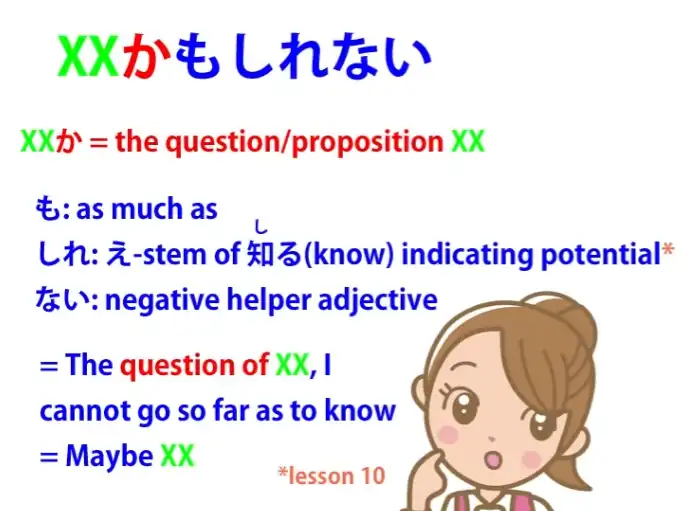
Now, this is taught as if it were a word or expression that means “maybe”.
And it is, but teaching it as a lump like that, as I’ve explained in another video, is misleading.
The point of that misleadingness that I would like to talk about here is that it confuses us about what that -か is actually doing.
That -か is attached to the proposition that we are talking about.
So, if we say “さくらが来るかも知れない” – “Perhaps Sakura will come” – what we’re saying is “さくらが来るか”, that’s the question or proposition that we’re talking about, and then “も知れない.” The も is giving us the meaning of “even” or “as much as”, as I’ve explained that it very often does, and “知れない” is “知る” – “know” / “知れる”– “ability to know or be known” and the helper adjective “-ない”.
So the whole thing actually means “さくらが来るか” – “the question of whether Sakura comes” – “も知れない” – “I can’t go so far as to know / Maybe Sakura will come, maybe she won’t.”
かな
Similarly with “かな”, which is sometimes presented as a particle meaning “I wonder”, you see how this actually works.
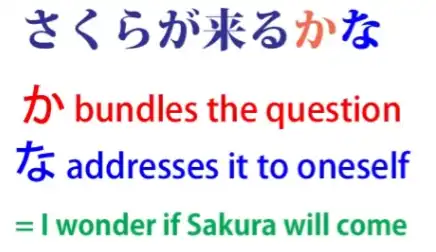
Note: in the video, there is a typo where the red line says が instead of か. I fixed it.

“か” is taking the proposition, so if we say “さくらが来るかな”, we’re saying “さくらが来るか” – “the question of whether Sakura will come” – “な”.
Now, “な”, as we’ve discussed in another video, is a marker that indicates addressing something to yourself.
So, you’re saying “Will Sakura come?” addressing that to yourself.
The way we would say that in English is “I wonder if Sakura will come / I am pondering the question of whether Sakura will come.” And while it’s all right to learn things like “かな” and “かも知れない” as if they were what the textbooks say they are, lumps of grammar that you just have to memorize, it helps not only with those but with structure as a whole to understand what they’re really doing.
They’re bundling something into a question, so a proposition becomes a question which is a noun-like entity which we can then add something like “do you know / I don’t know / I can’t be sure” or “I wonder (I’m addressing this question to myself).” Now, from this proposition-making quality and questioning quality of -か, we get expressions such as one which we discussed in a previous video, “まるでゆうれいを見たかのような顔.”
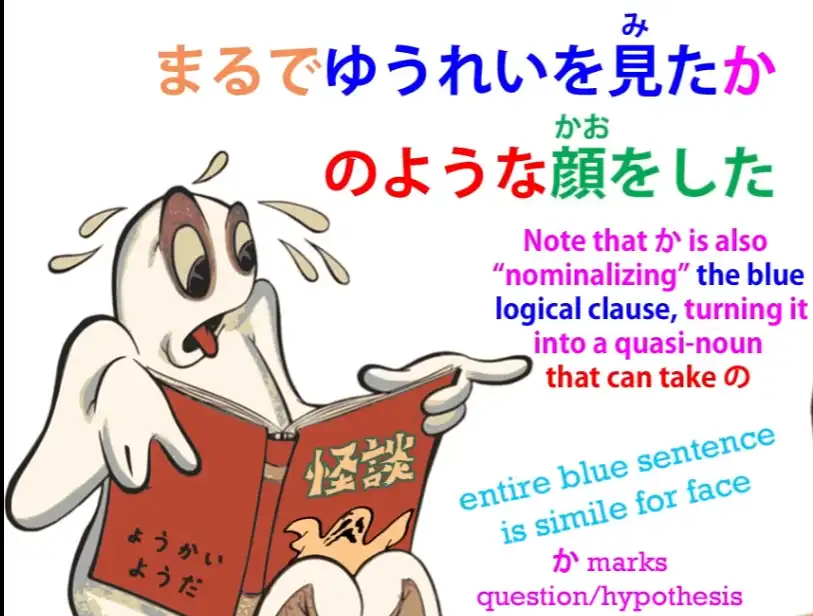
Now, that means “a face as if one had seen a ghost.” So what’s the -か doing here?
It’s doing the same thing as before.
It’s marking “ゆうれいを見た” as a question, a proposition, a thing that’s not certain, in fact in this particular case, a thing that hasn’t happened: we’re not saying that the person HAS seen a ghost, we’re only saying that she had a face AS IF she had seen a ghost.
So we’re marking the proposition that she’d seen a ghost as a question and then continuing to comment on it, and in this case we actually are attaching a logical particle, the logical particle の, to the か-marked noun-like entity that we have made of the proposition that she is seeing a ghost.
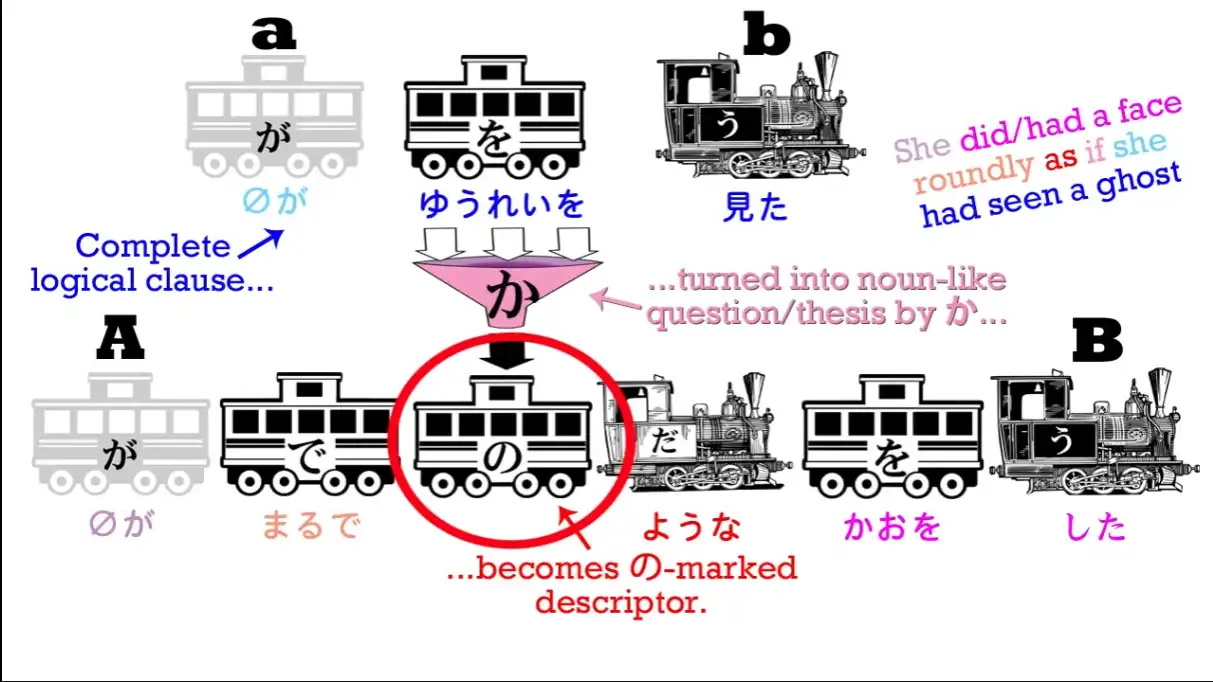
So with a の-particle, unlike the が and を-particle, we can attach this to a か-marked entity.
Now, there is another use of -か, which is a little different but still closely related to its question-making quality.
もんか/ものか
And that is in certain expressions where it negativizes what we’re talking about.
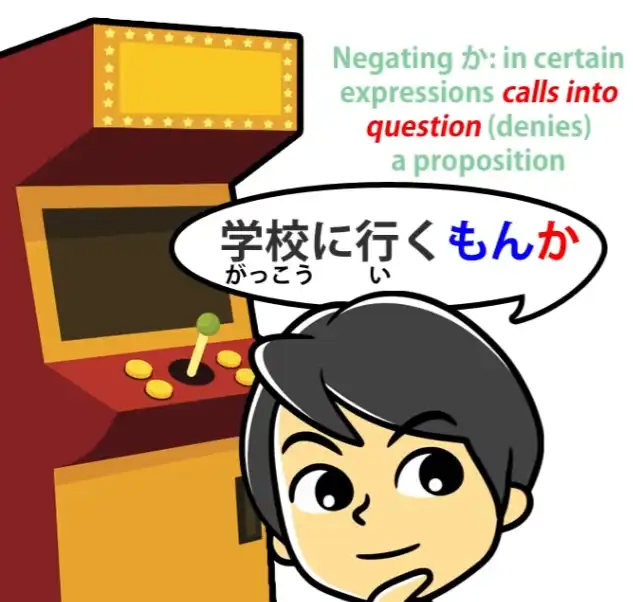
An example of this that you’ve probably come across if you’ve been watching anime or reading manga is “もんか”.
And that’s short for “ものか”, and it can be used in more formal speech, in which case we say “ものですか”.
So, if I were to say “そちらへ行くものですか,” I’m saying “I won’t go there / I’m not going there.” If I say “さくらが来るものですか,” I’m saying “Sakura is not coming / She won’t come / There’s no likelihood of her coming.” What does “ものですか” mean?
It means literally “Is that a thing?” So, it’s a question, but it’s the kind of negativizing question that we also get in English when we say things like “Do you think I’m going to do that?” or “Would I do that?” or “How likely is that?” In all those cases, by turning something into a question we’re denying its likelihood.
Now, when we say “ものか” it’s the same thing, and it often gets reduced right down to “もんか”.
So someone might say “それを食べるもんか” – “I’m not eating that.” And you notice here that we are in fact using the か marker after a regular non-formal sentence, and that’s because “もんか” or “ものか” is in fact rather a rough way of talking.
You’re denying something very forcefully and often in opposition to somebody.
どころか
Another place where we often see -か as a negativizing question marker is in “どころか”.
Now, “どころ” is a form of “ところ”,
which we talked about in a recent lesson, didn’t we? (Lesson 36)
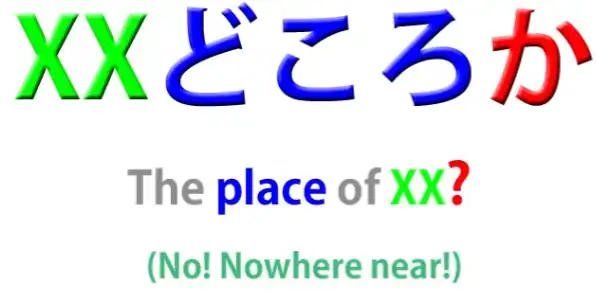
“ところ” can mean not just “place” in the literal sense, but a time or a circumstance or condition.
When it’s said as “どころ” it’s usually negative, so when we say “どころか”, we’re negativizing what came before it and usually putting an even stronger negative after it.
So if we say, for example, “漢字が読めるどころかひらがなも読めない” – “Not only can’t I read kanji, I can’t even read hiragana.”

What’s “どころか” doing here?
Well, of course it’s negativizing, just as we’ve already seen that it can, but it’s also using the concept of place / “ところ”, that’s to say, conceptual space rather than literal place.
We’re saying “Not only can’t I go as far as reading kanji, I can’t even get to the point of reading hiragana.” That’s the metaphor that’s being used here: not only has the situation not reached this far place, it hasn’t even reached a nearer place than that.
So we see that while -か has a variety of meanings, all of them are closely connected to its ability to make a question and turn the question into a proposition, but never a proposition that exists in actuality, always a hypothetical condition…
40. 3 pitfalls in Japanese and how to avoid them
3 PITFALLS in Japanese and how to avoid them 【Japanese Structure Lesson 40】
こんにちは。 Today we’re going to discuss some pitfalls in Japanese structure.
These are very small elements, single kana elements of the language, but very vital ones that can, if you don’t know about them, be very confusing because one element can be easily confused with another one that looks identical.
And the textbooks, in many cases, don’t tell you about this at all.
They leave you completely floundering.
で (connective/て-form of the copula)
The first one we’re going to look at is “で”.
Now, “で”, as you know, is a logical particle.
It has a very clearly defined use which we introduced in Lesson 8b.
Like all logical particles, it marks a noun, and it tells us that that noun is the place where an action took place or the means by which an action was done.
However, there is another “で”, which is not a particle, which is also used very frequently in Japanese, and the textbooks make no attempt to distinguish these two completely different but identical-looking elements.
The first time most of us will meet the second of these “で”s is in the use of adjectival nouns, which are very confusingly and misleadingly called “な-adjectives” by the textbooks.
So if we say “さくらがきれいで優しい”, what we’re saying is that Sakura is pretty and kind.
“綺麗/きれいだ” is an adjectival noun.
If we want to say “The flower is pretty”, we say “花がきれいだ”.
And if we want to say “the pretty flower”, we have to put “きれいだ” on the other side of the flower, so we say “きれいな花”.
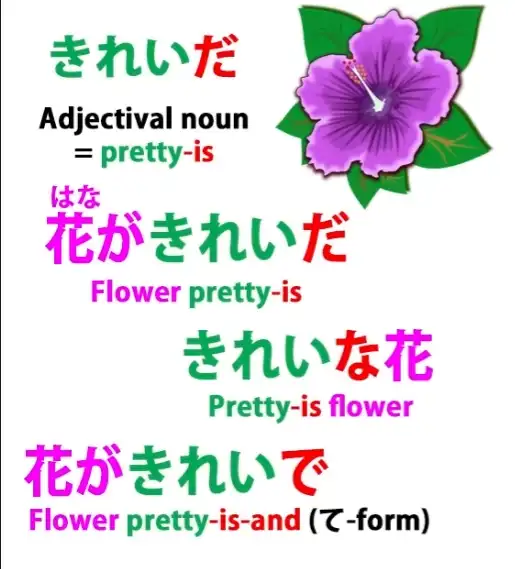
And that “な”, as we know, is the connective form of “だ”.
But if we want to say “Sakura is pretty and kind”, we can’t use “だ” and we can’t use “な”,
but we do have to use the copula.
What we use now is the connective form of the copula, that is to say, its て-form.
And the て-form of “だ” is “で”.
Note: to avoid confusion of Dolly using the words ‘the connective form of the copula’ for both な and subsequently で.

So if you say “Sakura is beautiful and kind”, this is a true adjective, an “い-adjective”, and we use the て-form to connect it: we say “さくらが美しくて優しい.” If it’s an adjectival noun, we still have to have the copula, so we say “さくらがきれいで…” That’s the て-form of the copula.
Now, I’ve already explained that in our lessons on adjectivals, but we also find this “で”, the て-form of “だ”, in lots of other cases in Japanese.
So let’s take a couple of cases and see if you can tell which of the two “で”s is being used.
A very common thing to say to someone when you’re leaving them, perhaps for a while, is
“お元気で”.
Now, “元気”, as you know, means “well” or “healthy” or “lively” and the “お” is just an honorific or prettifier.
What is the “で” here? Is it the logical particle or is it the て-form of the copula?
This is the て-form of the copula, not the particle.
The particle doesn’t make any sense here, does it?
What’s the て-form of the copula doing?
Well, we know, don’t we, that the て-form is often used to make an imperative, to tell someone or ask someone to do something.
So, if we say “待って” – “wait” – this is kind of short for “待ってください” and we’re asking someone to wait (“待って!” – “Wait!”).
Now, it’s exactly the same with “で”, which is the て-form of the copula.
So, “元気だ” means “is 元気”, someone is genki, someone is healthy or lively.
“元気で” is telling them to *be* genki or lively.
“お元気で” – “be healthy / be lively / keep up the good spirits”.
#
無事/ぶじで
Right. So here’s another one: “無事でよかった” is another very common expression and it means “I’m glad that you’re all right / it’s good that you weren’t harmed / it’s good that you’re safe” – “無事でよかった”. What do we have here?
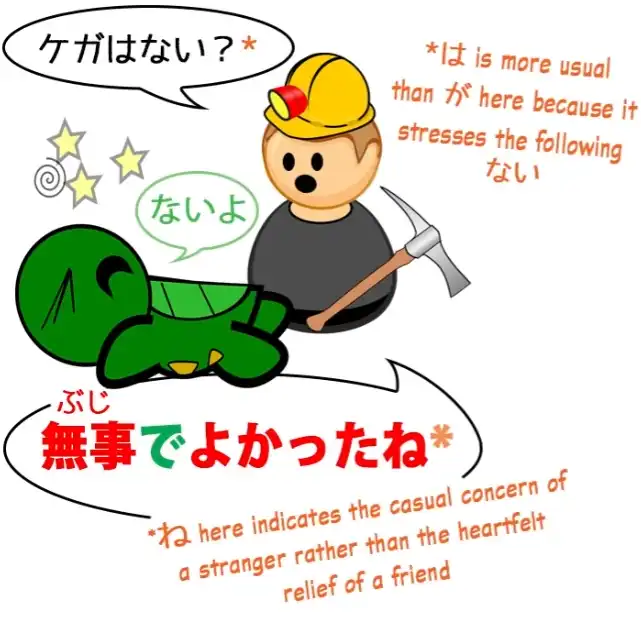
Once again, we have the て-form of the copula.
“無事”, which means literally “no incident” and therefore it means
“nothing happened / nothing bad happened / you weren’t harmed / you’re safe.”
So, “無事だ” means “you’re safe / you weren’t harmed / nothing happened”.
“無事で” is turning that “だ”, that copula, into the connective form.
We use the て-form to connect things, don’t we?
So, just as we might say, “遅くなってすみません” – “That I came late, I’m sorry”– we also say “無事でよかった” – “That you weren’t hurt, that was good.” And this connective て-form is also used in longer compound sentences.
So, for example, we might say “さくらはいい子で毎日学校に行く” – “Sakura is a good child and she goes to school every day.” We have two complete clauses and, just as with the て-form of any verb, we can use it to connect that verb-ending clause to a second clause, so we can do exactly the same thing with the copula.
So, “さくらがいい子だ” – “Sakura’s a good girl” – is a complete sentence in itself.
If we want to connect it to a second clause to make it the first half of a compound sentence, we turn that “だ” into its て-form, “で”.
So, “Sakura is a good girl and she goes to school every day.” And as is usual with the て-form connector, it tends to imply a positive relation between the two.
It has this implication of “Because Sakura’s a good girl, she goes to school every day,” but it’s not stating it as strongly as if we’d used “から”.
Now, another confusion, which is not kept such a deep, dark secret by the textbooks, but they don’t always stress it clearly enough, and it’s very important because it concerns the very center of the Japanese language, and that is the が-particle.
が clause connector
The が-particle, as we know, is the one particle that no sentence or clause in Japanese can ever be without, whether we can see it or whether we can’t.
“が” marks the A-car of every sentence, the do-er of an A-does-B clause and the be-er of an A-is-B clause.
But there is also another “が”.
It’s not easy to confuse the two, provided you’re clearly aware of them.
The other “が” is also a clause connector.
And usually it’s a contrastive clause connector.
So, if we say, “お店に行ったがパンがなかった,” we’re saying “I went to the shops, but there wasn’t any bread.” Note: The second が is the particle version of が for its logical clause, marking パン. So, this is a contrastive conjunction.
We went to the shops hoping that there would be bread, but there wasn’t any.
It’s not possible to confuse this with the other “が”, the “が” that marks the subject of the sentence, the A-car, because that “が”, the particle “が”, can only ever mark a noun.
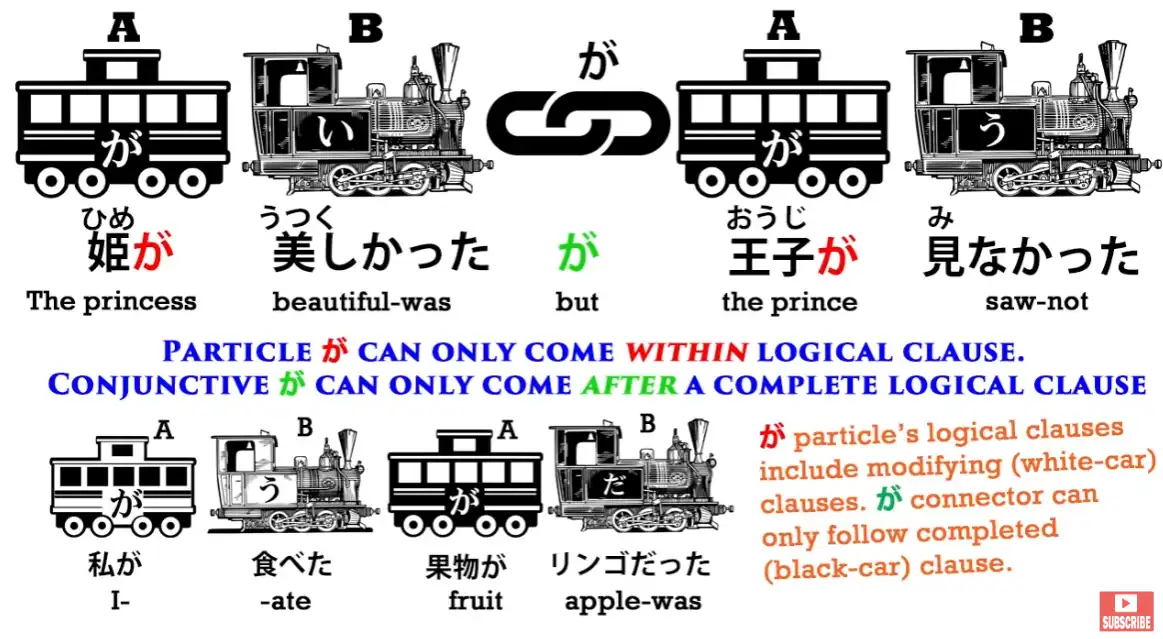
And the clause-connector “が” can only ever mark a complete sentence.
The particle “が” can’t mark a complete sentence, because a complete sentence can’t end with a noun.
It has to end with a verb, an adjective, or a copula, as we learned in our very first lesson.
So it’s not possible to confuse these two so long as you’re clearly aware of them.
One more thing that we should note is that “が” doesn’t have to be contrastive.
Most of the time it is, but it can be used as a regular, non-contrastive conjunction.
It’s worth knowing that, because if you see it connecting two clauses and there doesn’t
seem to be any contrast there, you don’t have to rack your brains to find the contrast – occasionally it is used in a non-contrastive manner.
And the other thing you need to know is that
you will sometimes find this contrastive “が” at the end of a sentence.
And I have talked before about sentences that end in a conjunction.
Strictly, they’re not complete, because what they’re doing is implying a following clause.
“が” at the end of a sentence is often a politeness, because “が” is in fact more polite than “けど” or “でも”, the other ways of saying “but”.
So if we said something like “(私は) コーヒーがほしいが” – “coffee is want-making (to me)” and then we’ve added “が”.

And what that “が” is doing is saying “but…” and it’s implying a second clause but not stating it, so “コーヒーがほしいが” means something like “I would like coffee, but…
if it’s any trouble please don’t try to get me any coffee” or something along those lines.
に that works as “と”
The last one we’re going to consider is less common, but if you’re reading any amount of Japanese you’re going to come across it pretty soon, and that is “に”.
Now, we know “に”. It’s again a logical particle.
It’s the targeting particle, and I’ve done a whole video on this because it’s an important and complex particle.
But there is also another “に”.
And this other “に”, which is a slightly old usage – it comes from older Japanese – it means the same as “と”. It can be used to and-together two nouns or a list of nouns.
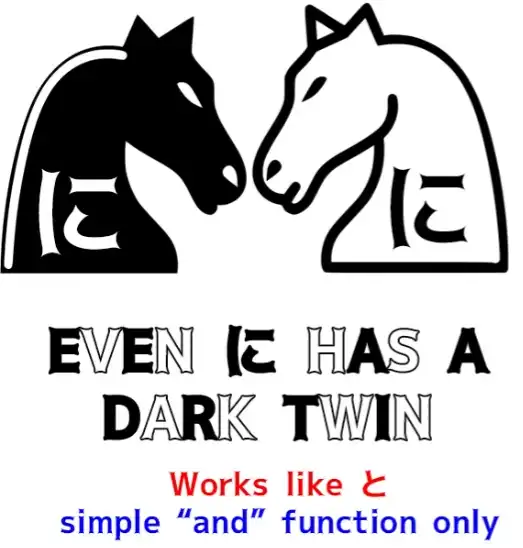
So in the folk tale Beauty and the Beast, when the father asks one of the less good sisters what she would like him to bring back for her, she says “靴に指輪に帽子”.
She’s saying she would like shoes and a ring and a hat.
So this “に” can be used to and-together two things or a list of things, and it’s completely different from the particle “に”.
It’s a little bit literary, so you’re more often going to see it in written Japanese.
But if you don’t know that it’s there, you can spend a long time puzzling over what “に” means in these contexts.
It’s also more commonly used in the expression “それに”, which means “furthermore” or “in addition to that”.
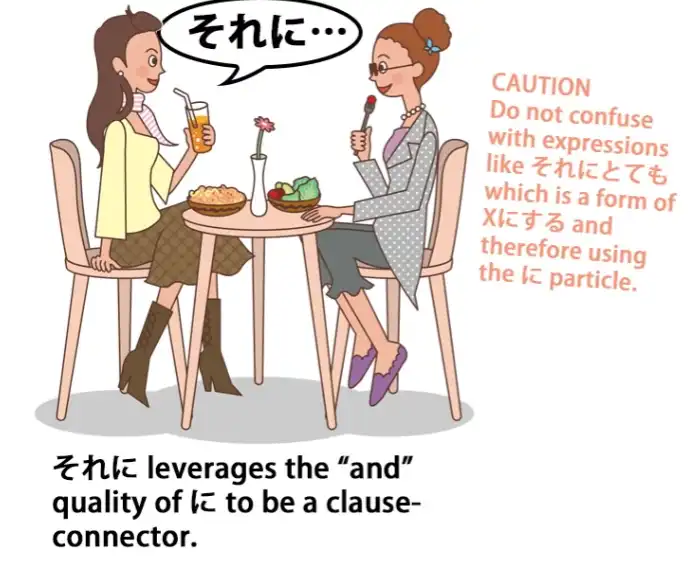
Note: There is a typo in the picture’s orange note. それにとても should be それにしても.

And, as you can see, this is made up of “それ”, which means “that”, plus “に” – not the particle “に” but the “に” that means “and”.
41. 5 key facts about the basic structure of Japanese
5 key facts they never tell you about the basic structure of Japanese. Lesson 41
こんにちは。 Today we’re going to talk about something very important that affects the whole structure of Japanese.
And, surprise, surprise, the textbooks never explain this properly.
What we’re going to talk about is Japanese words.
Not vocabulary, but the actual nature of the words themselves and how they structurally work inside the language.
This isn’t difficult. In fact, it’s very simple.
But if you don’t know it, it’s very confusing because you actually see a sentence and you don’t know what the words are really doing inside that sentence.
And this is the position that the textbooks leave you in.
Now, the fact is that Japanese is much simpler than English and much simpler than most languages in the types of words that it has.
However, the English textbooks and dictionaries try to assimilate Japanese words to the various English types and this doesn’t work well at all and leads to endless confusion.
So I’m going to present five facts that will clarify the whole situation.
Fact 1
Fact 1: Nearly all Japanese words fall into one of three categories. Just three.
And those three categories are: Nouns, Verbs, and Adjectives.
Now, there are also, as we know, particles – they’re not words, but they are the nuts and bolts that hold the language together.
And there are a few – a very few – specialized words that don’t fall into those three categories.
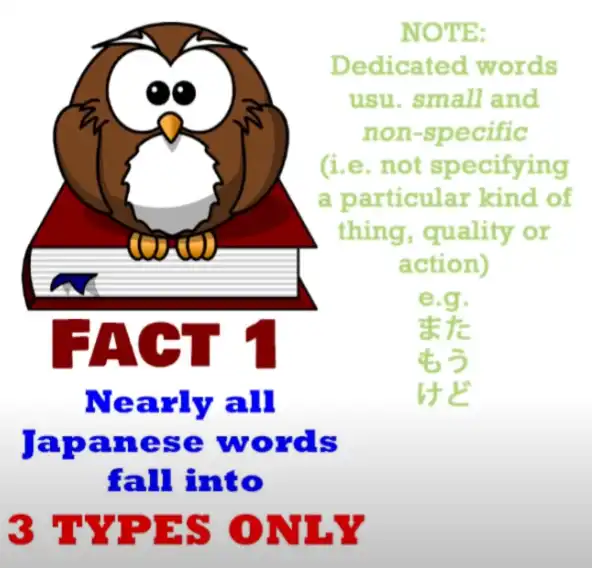
For example, there are conjunction words that join together two logical clauses to make a compound sentence.
Most conjunctions aren’t done with words anyway – they’re done with the て-form, the い-stem, or groups of particles like “でも” and “のに”.
But there are a few dedicated conjunctions like “けど” and the other “が”, the “が” that isn’t a particle but a conjunction, which we discussed in a recent video.
Now, apart from these, everything you see is going to be a noun, a verb, or an adjective.
Fact 2
Fact 2: Verbs and adjectives are very easily recognized and distinguished.

Every verb ends in an -う row kana – and it has to be a kana, it can’t be included in kanji.
And every adjective has to end in the kana い.
Again, it has to be the kana, can’t be part of a kanji.
Now, as we know, there are certain completely regular transformations that this -う row kana and that this い can make.
They can go into て-form or た-form, and the final -う row kana of a verb can change into the equivalent kana in the same row in order to attach a helper word such as the negative helper adjective “ない” or the causative helper verb “せる/させる”.
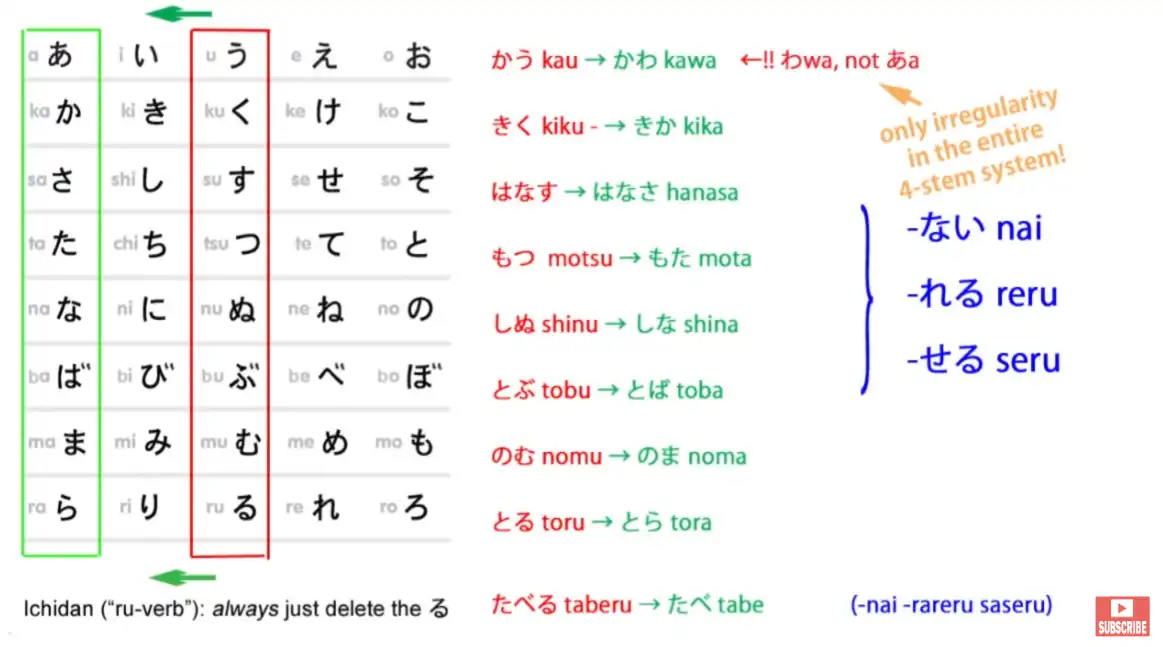
Now, once you know the basic permutations of verbs and adjectives, which you should do very early on, you know that if a word doesn’t have one of those possible verb endings or one of those possible adjective endings, it is a noun.
You know that if a word is written in kanji only or can be written in kanji only, it is in 99 cases out of 100 a noun.
So Japanese, as I’ve said before, is a very noun-centered language.
Fact 3
Fact 3: There is a legion of super-nouns.
What I mean by this is that there are certain special categories of noun, each of which has one superpower and one only.
That’s to say that the nouns in each of these groups of special or super-nouns differ from ordinary nouns in one respect only.
Now, two of those groups we already know, so as Fact 4 I’m just going to go over those quickly.
Fact 4
#
Adjectival nouns
The first group is adjectival nouns, which are horribly misnamed by the textbooks “な adjectives”.
They’re not adjectives. They are nouns that can under certain circumstances be used adjectivally.
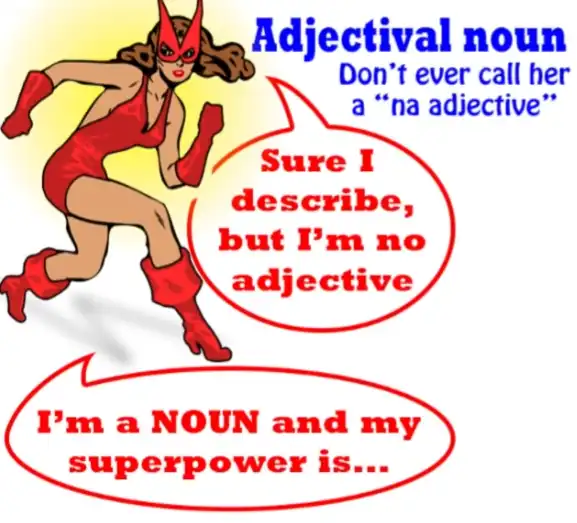
The superpower of adjectival nouns, the one thing they can do that makes them different from any other noun, is that they can use the soft or connective form of the copula “だ”.
So, we can say “屋敷が不思議だ” – “mansion mysterious is”.
When we do this we’re just doing what we can do with any noun.
We can say “さくらが日本人だ” – “Sakura Japanese person is”.
But we can also use that soft form of “だ”, which is “な”, and we can say “不思議な屋敷” - “mysterious-is mansion”.
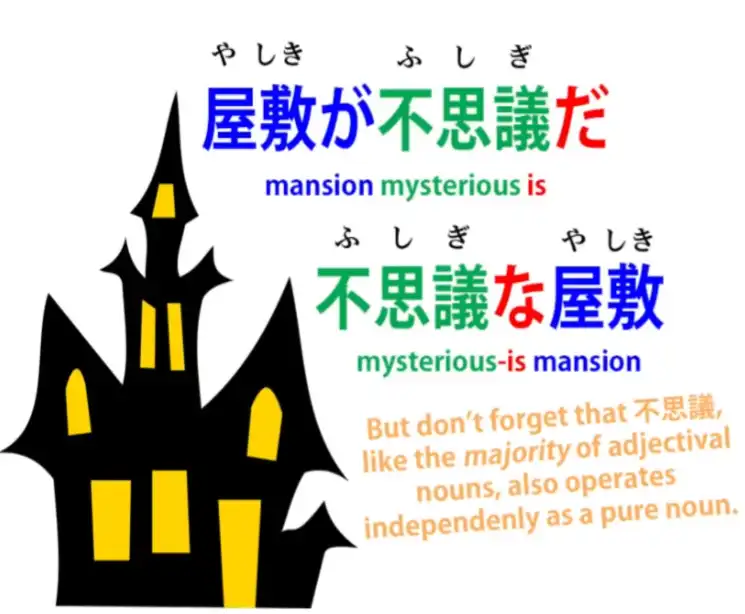
You can’t do that with a regular noun.
And that’s the only difference between a regular noun and an adjectival noun.
#
する nouns
The second group is する nouns, which the dictionaries somewhat confusingly call “する verbs”. What they are is nouns.

And their superpower is that they are allowed to drop the direct object marker, “を”.
So, if we take the noun “勉強”, which means “study”, we can say “勉強をする”,
which means “do study”
but we can also say “勉強する”, which means “to study” (the verb).
Note: It’s just a very nuanced difference, basically. *
The を is the Direct Object (noun) + verb (勉強を + する) & the 勉強する is a する verb.*
We can use the を to mark a direct object of any verb, but we can only drop that を in the case of する nouns. That is their superpower.
So when we do that, we fuse together “勉強” with “する” and make what we really can call a “する verb”.
But the important point to remember is that when “する” is not attached to it, it’s not a する verb. It’s not any kind of a verb. It’s a noun.
Note: Do note that “WHEN する is NOT attached to it” e.g. 勉強をする, where 勉強 is a noun. But with 勉強する, the する should be the Head of the phrase 勉強する, so it should be a verb. So we can say “勉強が好きだ”.
That means “study (noun) is pleasing to me”.
We don’t say “勉強するのが好きだ”, because what we’d be doing if we said that would be taking a noun, turning it into a verb with “する”, and then turning it back into a noun again with “の” (the nominaliser for the verb 勉強する).
We don’t need to do that because it’s a noun in the first place.
Fact 5
#
Adverbial nouns
Now, the third group, which we haven’t yet introduced, is adverbial nouns.
Now, there are a lot of these and an awful lot of them end in the kana “り”, but not all of them by any means.
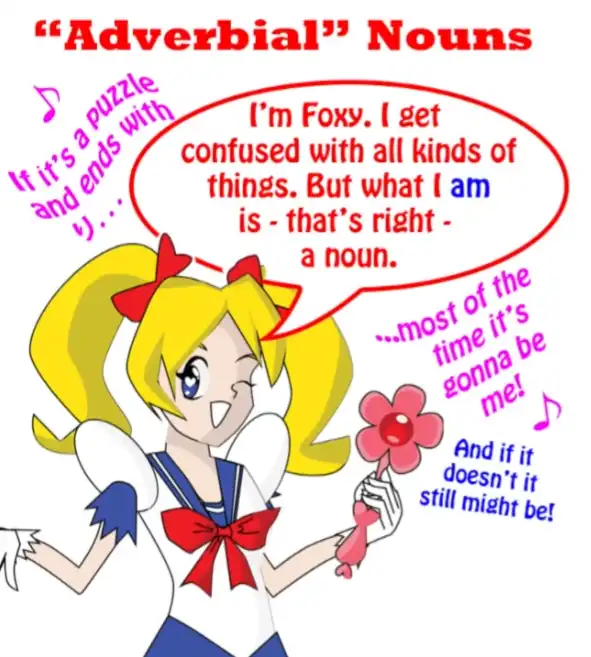
So, we’re going to look at two that do and one that doesn’t, and we’re going to look at their superpower.
Their superpower is very similar to the superpower of the する noun, which is to say that they can drop the relevant particle under certain circumstances.
As we know, any noun that’s appropriate for the use can be turned into an adverb by adding に.
So, “静か”, which is the (Adjectival) noun “quiet”, can be used adverbially with に.
We can say “静かにする” – “do quietly / act quietly”.
We can say “静かに歩く” – “walk quietly”.
(But) With adverbial nouns, we can drop that に.
Note: I think Dolly here does NOT mean that we can drop に with 静か because it is NOT an adverb(ial noun) like ゆっくり, but Adj. Noun. At least I can’t find anything about 静かする etc.
Dolly also seems to allude at multiple points (Lesson 8) to that adverbs like ゆっくり could be classed as a kind of noun, although stuff like Jisho/Yomichan lists them as Adverbs and their name 副詞 (ふくし) is different of course, means Adverb, so it would be just a special sub-class.
I think that the term “Adverbial Noun” might be what that 副詞 refers to for Dolly, where usually they are called Adverbs, but they might be this very special class of nouns in Japanese, so why Dolly calls them that. As to why we can drop the に, since ゆっくり is already 副詞 on default.
So, we’ll take one that ends in the typical “り”: “ゆっくり” – that means ‘‘slow’’ or ‘‘leisurely’’
and we can say
“ゆっくりにする” – “act in a leisurely manner”, “ゆっくりに歩く” – “walk slowly”.
But we can also say “ゆっくりする”, “ゆっくり歩く”. We can drop that に.
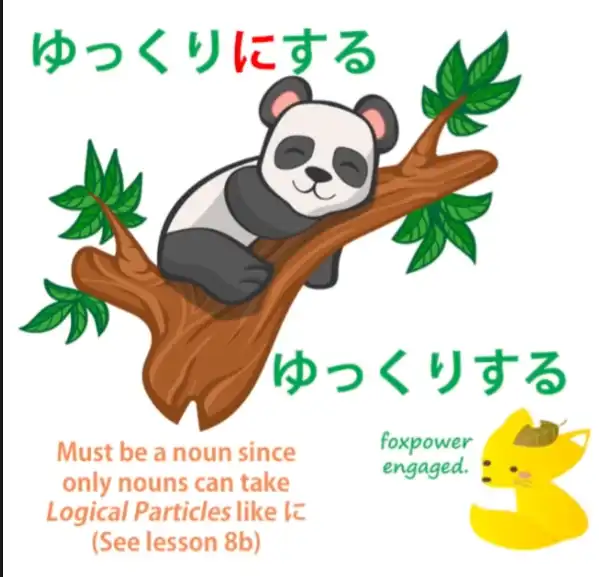
So, that’s the one and only superpower of the adverbial noun.
And it’s important to understand this because when you start trying to explain them without recognizing this fundamental fact, you can get into all kinds of difficulty.
Let’s take another one: “余り/あまり”.
##
あまり
Now, this noun is usually explained in a way that’s completely confusing.
“あまり” is a noun, and what it means is “excess”.
You can use it in a completely literal sense.
You can say “ご飯のあまり” – which means “the excess rice / the leftover cooked rice”.
It’s very often used in more abstract ways.
So, we can say “悲しみのあまり泣いた”.
Now, this means “from an excess of sadness, I cried.”
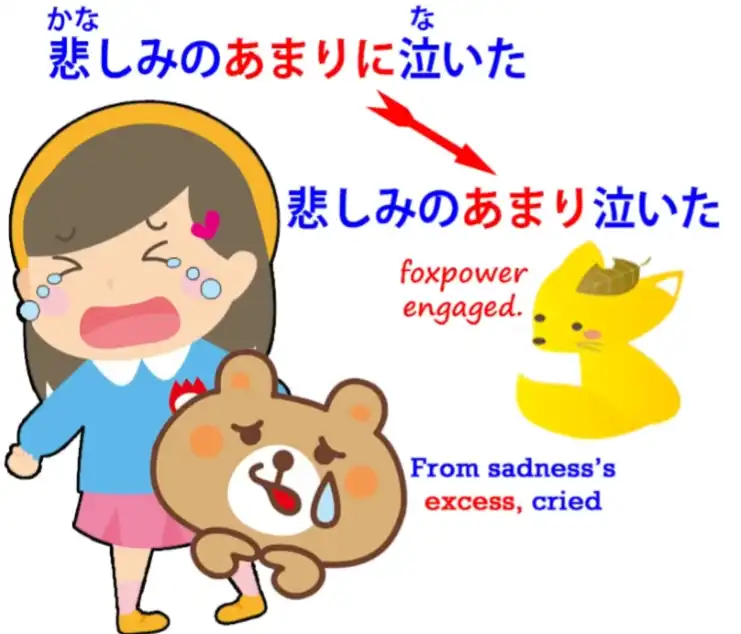
And, as you see, we can leave out the particle.
We usually do leave out the particle with “あまり”.
So it’s now being used adverbially and it still means “excess”.
Now, the textbooks generally introduce it in a different context, which makes it very confusing when we see it in other contexts and especially when we don’t understand that it’s actually a noun.
They show it being used adverbially in expressions like “あまり勉強しない”.
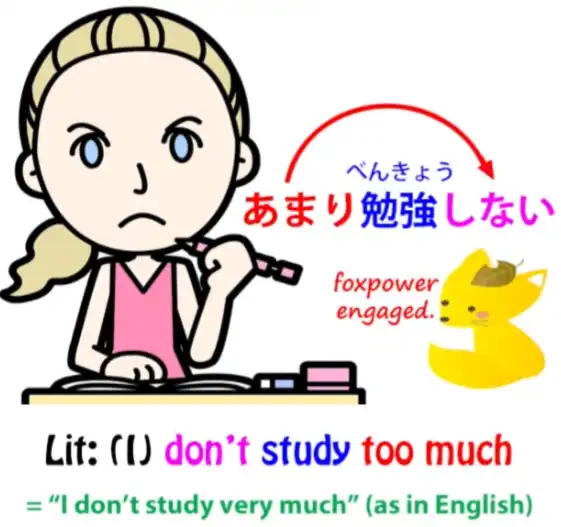
What does that literally mean?
It literally means “I don’t study too much / I don’t do an excess of study.” But of course, as we know, what it means in practice is that “I don’t study very much”.
And this is what we call litotes.
We’ve talked about hyperbole in language and how it’s a very common phenomenon.
Litotes is the opposite of hyperbole.
Hyperbole is saying more than we really mean; litotes is saying less than we really mean.
The word “litotes” isn’t as well known as “hyperbole”.
That’s perhaps because current Western speech is much more prone to hyperbole than to litotes.
But we still have litotes in set expressions.
So, if we are going on a picnic and we look at the dark clouds in the sky and say “It doesn’t look too good!” what we’re literally saying is “It doesn’t look excessively good” but what we actually mean is “It doesn’t look very good!” And it’s just the same with “あまり”.
If we say “あまり勉強しない”, we’re saying “I don’t study too much / I don’t study excessively” but what we actually mean is “I don’t study very much at all.” ##
随分
So, let’s just take one more that doesn’t end in “り”, and that’s “随分/ずいぶん”.
What it really means is “sufficiently”.
And you may say, “Well, ‘sufficiently’ isn’t a noun”.
And that’s true – in English it isn’t a noun.
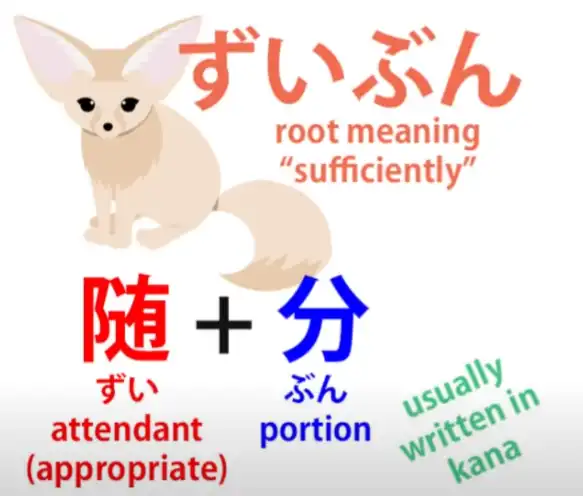
In Japanese it is, and if we look at the kanji “随分”, what it actually means is something like “appropriate portion” or “appropriate amount” – in other words, “sufficient” or “sufficiently”.
And this is another litotes which is common to both English and Japanese and many other languages.
When you say to someone “ずいぶん上手だね”, what you’re literally saying is “you’re skilful enough / you’re sufficiently skilful”.
What you actually mean is that the person is very skilful.
And this is just the same in English. You might say “You’re pretty good”.
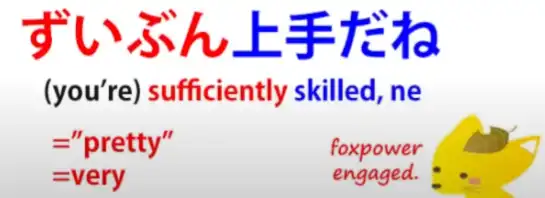
And “ずいぶん”, like “pretty” or “fairly” in English can run the full range from its original meaning of “sufficiently” or “fairly”
to its more usual litotes meaning of “very / considerably”.
So the thing to remember is that there are a very limited number of word-types in Japanese.
Nearly all words are either verbs, nouns or adjectives.
And the ones that aren’t verbs or adjectives, whatever the dictionaries tell you they are, are practically all the time nouns. (This seems to support that 副詞 theory of mine above) When you understand that, you have a much clearer understanding of what’s going on in a sentence.
Note: Check this:
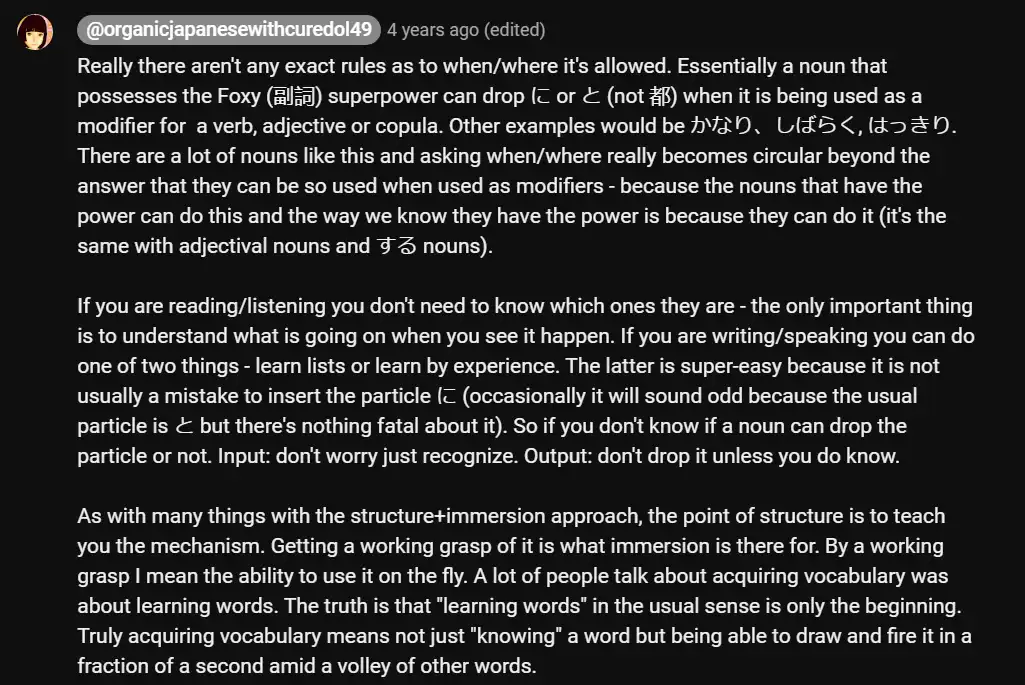
42. Basic word-confusion - まま
Why textbook “grammar points” are so misleading. Basic word-confusion - まま mama - Lesson 42
こんにちは。 Today we’re going to talk about some of the ways in which the standard conventional explanations of Japanese lead you out into the desert and then fly away in a helicopter, laughing.
We talked in the earlier lessons in this series about how that happens in relation to the fundamental structure of the language.
But this also happens at a later stage with the explanation of all kinds of what they call “grammar points”.
And one of the main causes of this is the fact that they fail to recognize what words actually are and what they actually do.
So, we’re going to take, as an example, “まま”, the word “ママ”.
Now, this can mean a mother or the mistress of a bar or a cafe, but we’re talking about
it in the other sense, the more abstract sense, which, if we look at traditional explanations,
they seem to have various opinions on what part of speech it is.
Note: to avoid confusion, ママ in katakana means “mom” or “mistress of a bar”. Whereas まま is what Dolly is going to be talking about. It also has a Kanji form 儘 or 侭, but that is not really used.
So まま ≠ ママ, different things. まま marks unchanged state, ママ means “mom/bar mistress”…
I’ve even seen it described as a particle, which it certainly isn’t.
And they tell you that it means “as it is / as we wish it to be / as we would like it to be”, that it means a state or a condition.
Now, all those things are things that we might say in English in relation to certain uses of the word.
But none of them express what the word actually means.
In any case, if it meant “as it is” or “as we wish it to be”, what kind of a word would it be?
So the first thing to ask ourselves is “What kind of a word is it?” And, as I explained in our last lesson, nearly all Japanese words fall into one of three categories: nouns, verbs, and adjectives.
Now, “まま” is not a verb: it doesn’t end in -う or any う-row kana.
It’s not an adjective: doesn’t end in -い.
So the chances are it’s a noun, and that’s exactly what it is. It’s a noun.
So, what kind of a noun is it? What does it mean?
What is a “まま”? A “まま” is a thing; it’s a noun. What kind of a thing is it?
Well, it’s a very simple thing, a very straightforward thing, and once we know what it is we can understand it in all circumstances.
A “まま” is an unchanged condition.
Wherever you see “まま”, you can read “unchanged condition”.
There’s one circumstance in which it has a slightly extended meaning and apart from that – which is very simple and we’ll come to that shortly – we have the definition, the understanding of “まま”: “unchanged condition”.
So, let’s look at some of the ways in which it’s used.
We can say “自然のままの森” – that’s “a forest in its natural (unchanged) state”.
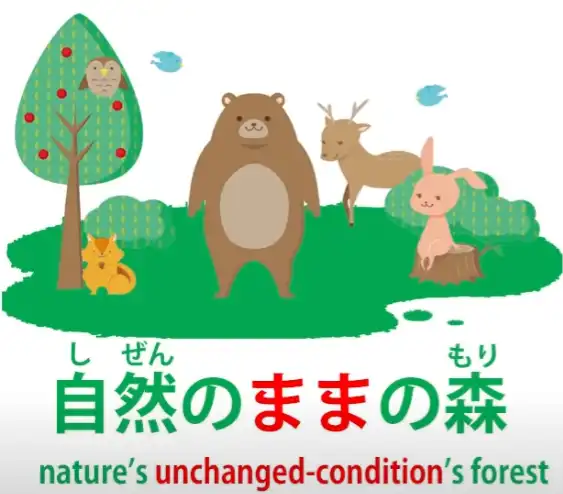
“自然” is nature” and “まま” is “unchanged state” or “unchanged condition”.
So, “自然のまま” is the “unchanged condition of nature”.
“自然のままの森” is “the forest in the unchanged condition of nature”.
Now, when you’re in Japan somebody may offer you 枝豆/えだまめ, which are beans which grow from the branches of trees, which is why they’re called 枝豆 (which means “branch bean”).
And you might look at them, they’re not cooked or anything, you might say “そのままで食べられるの?” – “Can you eat them just as they are / can you eat them in their unchanged condition?”

Now, that “で” is in fact the copula, so we’re saying “being their unchanged condition, can we eat them?” Now, there’s one thing we can do with “まま” that we can’t do with all nouns and that is that we can drop that “で”.
So we can say “そのまま食べられる?” Now, we can say that this is because “まま” is something like an adverbial noun that we discussed last week, where you are allowed to drop the particle in certain cases, but I don’t think we necessarily even have to go that far.
“An unchanged condition” is by definition a condition that could change but hasn’t changed.
So, I think in cases like this if we say “そのまま食べられる”, we’re saying “そのまま食べられる” without the “で”, I would say, is treating that “そのまま” like a relative time expression.
We’re saying “while they’re in their unchanged condition”, so we’re essentially talking about a time period, the time period during which they are in their unchanged condition.
So this is actually how I would tend to look at it.
“During the period when they’re in their unchanged condition, can we eat them?” In any case, there’s no doubt what the word means.
It means “unchanged condition”.
We can say “パジャマのまま朝ごはんを食べる”.
That means “Eat breakfast while we’re still in our pyjamas”.
In other words, “in the unchanged condition of being still in our pyjamas, eat breakfast”.
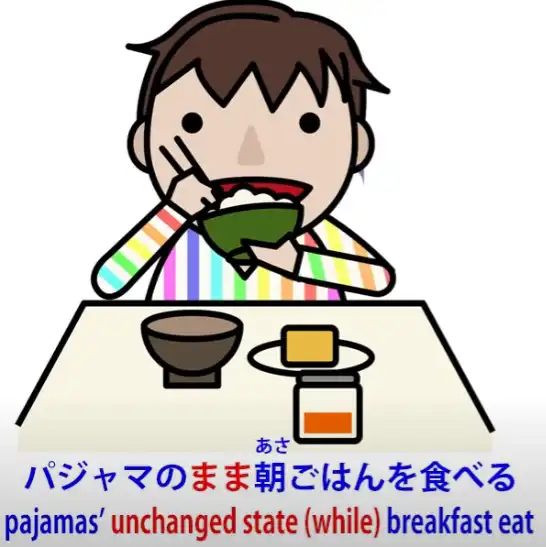
And as we can see, once again the implication here is that the condition could change but hasn’t changed.
“いつまでも若いままでいたい” – “I’d like to stay young forever.” “I’d like to stay in the unchanged condition of being young forever.”

And notice here that we’re saying “若いまま”, so you see “若い”, the adjective, is doing what adjectives always do, qualifying a noun.
And the noun it’s qualifying is “まま”: “the unchanged condition of being young”.
Now, there’s a use of “まま” that you’ll probably come across quite often, and that is “思いのまま” or “心のまま”.
And what this means is “in the unchanged condition that’s in our thoughts” or “…in our hearts”.
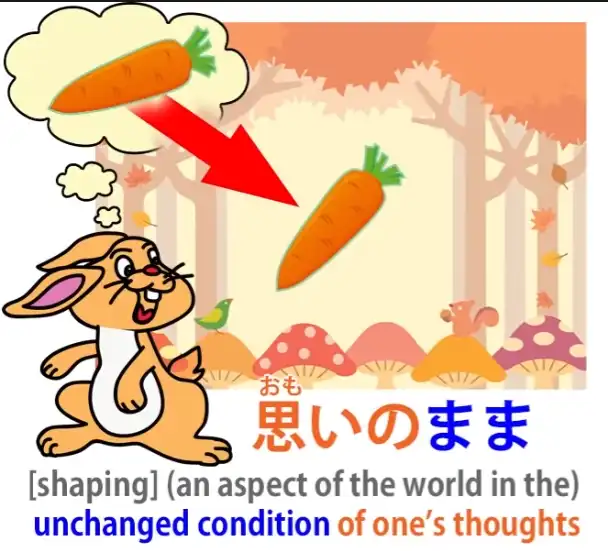
So what does this actually mean?
Well, it’s always applied to something that is outside ourselves, so we’re talking about something outside ourselves being in the unchanged condition, the exact same condition, as what is inside ourselves.
So this essentially means making the outside world conform to our thoughts, our desires, our will.
And this can under certain circumstances imply selfishness, but it doesn’t need to.
I think the first time I heard it was in an anime where the characters were underwater.
They were able to breathe but they found that they couldn’t move the way that they wanted to, just as one can’t in water.
And they said “思いのままに動けない” – “we are unable to move in the unchanged condition of our thoughts” or “…the unchanged condition of our will or desire”.
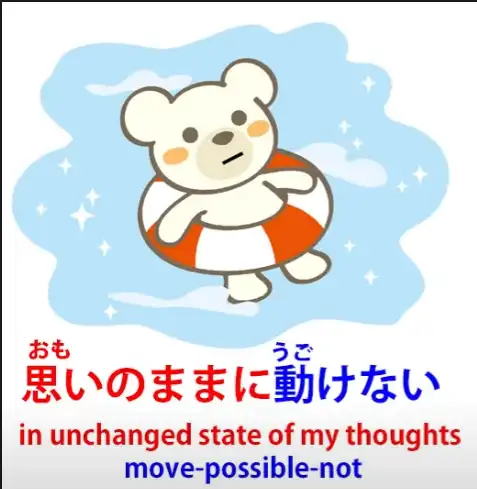
Now, we should understand here that “思い” sometimes does imply desire.
For example, when we say “片思い”, which is literally “one-sided thought”
or “one-side thought”, what that actually means is “unrequited love”.
It means having a desire for someone but it’s only one side of the desire.
The other person doesn’t reciprocate that desire.
So it’s “片思い” – “one-sided thought” or “one-sided desire”.
So “思いのまま” is “in the unchanged condition of one’s thought or desire”.
And it’s really from this use of “まま” that we get “わがまま”, which I’m sure you’ve heard, which means “selfish” or “selfishness”.
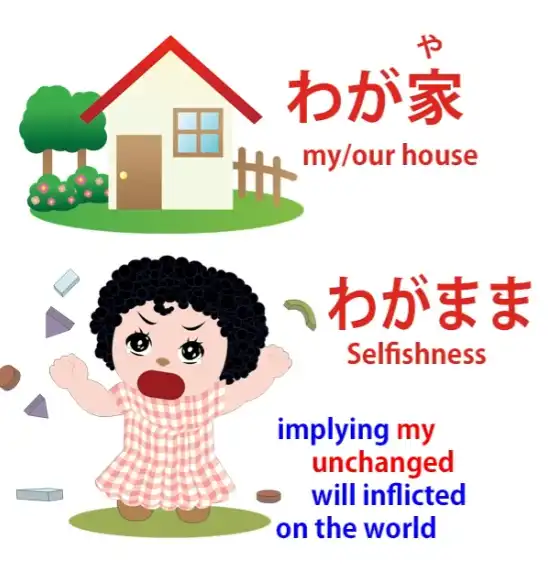
Why does it mean that?
Well, “我が/わが” means “I” or “we” and it can be put next to a noun to denote possession of it. So we can say “わが家”, which means “my house” or “our house”.
“わがまま” means “my unchanged condition”, but this clearly is influenced by expressions like “思いのまま” or “心のまま”.
So this “わがまま” means “my unchanged condition” implying “my will”, “wanting the world to go in accordance with my will,” wanting the world to be “思いのまま”, “心のまま”.
So as we see the whole of “まま”, we don’t have to have all these different definitions of it.
We can see that every time we use it it means the same thing.
It means “unchanged condition”…
43. PARADIGM SHIFT: Cut through the confusion
Japanese learning PARADIGM SHIFT: Cut through the confusion. Lesson 43
こんにちは。 Today we’re going to talk about what I rather over-dramatically refer to as “The Final Problem”.
What I mean by that is that we’re going to unlock a new area of Japanese and we’re going to do it by the same method that we started with, that is, by looking at Japanese as Japanese and not as English written in some secret code.
The reason I call it “the final problem” is because this is the one problem that some of my most astute and analytical pupils find with my Japanese-structure models.
For the most part, if somebody understands my models, they become self-evident.
And that’s what I base my work on.
I don’t ask anyone to trust me.
See if they work.
If they don’t work, throw them away.
If they do work, use them.
There’s no act of faith involved anywhere.
Now, I take this one problem as a tribute to my work.
Partly because, of course, there only is one problem, which out of a whole and very radical model of Japanese is pretty interesting.
But the second reason is this: people have this problem because I’ve spoiled them.
I say that somewhat humorously, but the truth is that people come out of this world of English “Japanese grammar explanations” in Genki and the various Japanese grammar (so-called) websites and they’re leaving a world of an entangled mass of strange things that just happen to mean what they mean for no particular reason and with a whole range of exceptions and random rules into a world of crystalline logic where everything makes sense, where everything is what it is for a good reason.
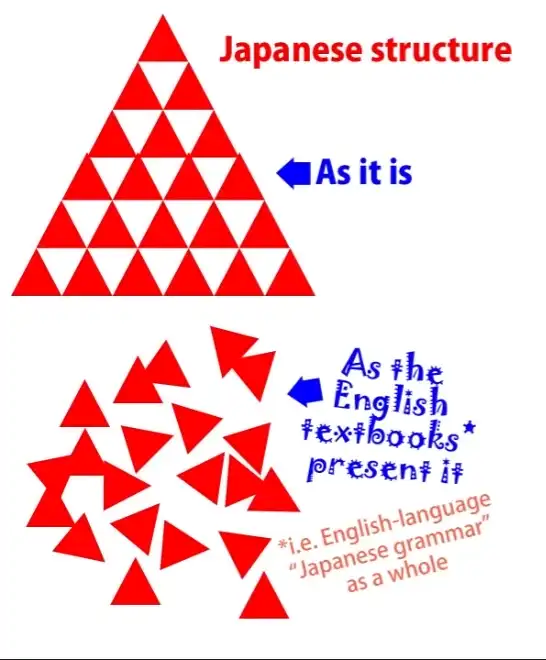
And so when they come across something that looks like an exception or a random rule, they want to get rid of it.
They won’t tolerate even one of these things any more and I can’t blame them.
However, this is not a random rule.
This is something that’s very understandable if we can make the same kind of paradigm shift that we made in the first place and see it as it really is in Japanese, not look at it through English eyes.
So what is this? Let’s take an example.
If we say “クレープが好きだ”, we’ve learned that this does not mean “I like crepes”.
If you think it means “I like crepes”, then you’ve really given up all hope of ever understanding Japanese structure.
Because, as we know, every Japanese sentence has two core elements.
It can have any one of three engines, which can be a verb, an adjective, or a noun plus copula.
And the second part of the core sentence is always the same: it’s a noun marked with が.
We can’t always see it, but it’s always there.
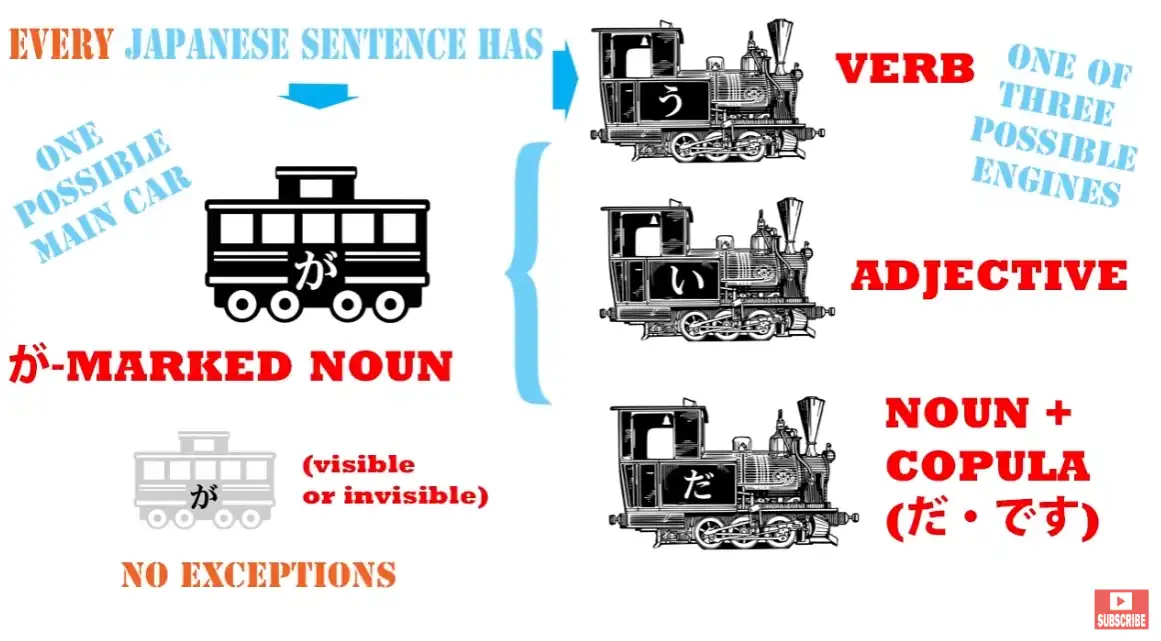
And those two elements, the engine and the が-marked subject (or main carriage), are the core of any sentence. They’re the only things we need in a sentence.
We’ve got to have those two, and everything else in a logical clause is telling us more about either the engine or the が-marked carriage.
It can’t do anything else.
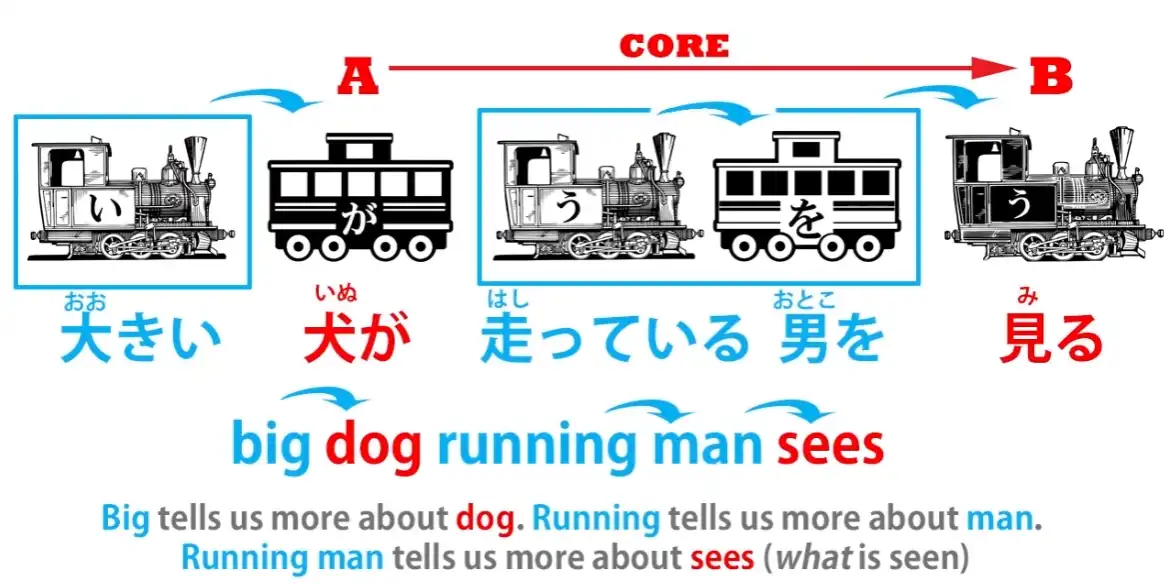
The core of the sentence is the sentence and everything else is an appendage to one of those two core elements.
So, with “(私は) クレープが食べたい”, the が-marked carriage is not “I”, so it can’t be “I want to eat crepes”.

Because “I” am not doing something here, the crepes are the が-marked main carriage.
And the head of the sentence, the engine, is not a verb, it’s an adjective.
It’s the helper adjective “-たい”.
It’s attached to a verb, but the actual engine of the sentence isn’t a verb,
it’s the adjective “-たい”.
It can’t mean “want”, because “want” is a verb.
So what this is actually saying is that the quality of crepes is such that it induces want in me.
This is a wordy way of putting it, but it avoids any kind of English-based misreading of the sentence.
That’s what it actually means.
It’s describing the crepes adjectivally, and what it’s saying about them is that they have the quality of making me want to eat them.
And what we learned right from the beginning is that English is a very ego-centric language.
If there is an action, a subjectivity, it always wants to put an ego-actor at the center.
Japanese doesn’t have that strong imperative.
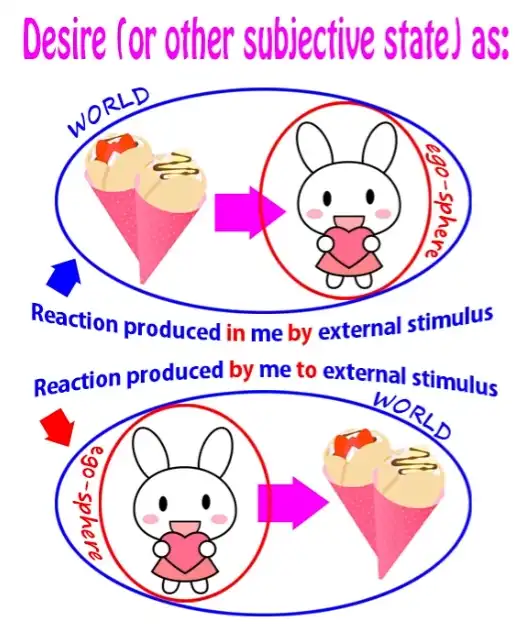
Now, if we look at it in terms of subjectivities – because a lot of this is to do with subjective feelings, as a lot of language is – we can look at subjectivities in two ways.
We can either look at them with the thing that induces the subjectivity as the focus,
the fulcrum, of the subjectivity, so “crepes which induce desire in me” are the fulcrum of this sentence. (Japanese)
“Crepes are inducing eat desire in me.”
Or we can look at the subjectivity as an activity – wanting – and then we put “me” at the center. We put the ego at the center and we say “I desire to eat crepes”. (English)
Now, both of these are fairly natural.
A subjectivity is in fact something that we passively experience and that is induced in us by something on the outside of us.
That is a perfectly valid way of looking at things, and perhaps more valid than the English ego-centric way. Certainly no less valid.
Japanese happens to prefer this way of looking at it; English prefers the other.
And this spills over into all kinds of areas.
So, for example, Japanese is very happy to say “水が犬に飲まれた” which means “The water drink-received from the dog”. The key actor of this sentence is the water, not the dog. The water is receiving the act of drinking from the dog.
English is so biased against this that it’s almost impossible to translate this into English without turning it passive. It’s not passive in Japanese.
And this bias goes so deep that the entire “-れる/-“られる”” helper verb, which is the verb of receiving an action, is called “the passive” by this pseudo-Japanese grammar that gets taught in English.
It’s not passive – it’s just that the only way to translate it into English is to turn it passive.
Now, let’s get back to our crepes.
If we say “クレープが食べたい”, the center of the action is the crepes.
They are inducing desire in me.
If we say “お腹が空いた、(zeroが) 早く食べたい”, we’re saying “I’m hungry; I want to eat soon.” Now, “早く食べたい” doesn’t have a visible actor, but the actor of this - the zero - is “me”, so it’s “(zeroが) 早く食べたい” – “I want to eat soon.”
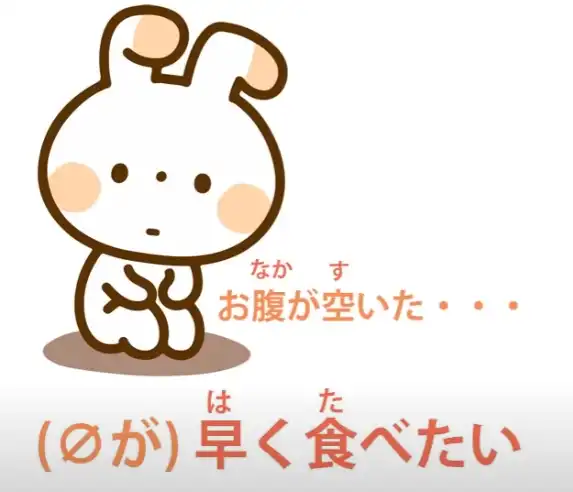
Now, this is the final problem.
This is the thing that some of my most astute students have reacted against.
They don’t like the fact that the “-たい” helper adjective switches polarity, that it can both describe something inducing the desire to eat and the person feeling the desire to eat if the inducer is not explicitly present. (If confusing, check Lesson 9c about たい) They actually have suggested – and several people have suggested this to me independently – have suggested the work-around of saying “Well, can’t we say that the が-marked actor is in fact food? Just food in general perhaps: ‘Food is making me want to eat it.’” And I see why they’re trying to do this.
They’re trying to get rid of what looks like the one anomaly in an otherwise perfectly logical system.
But actually this isn’t an anomaly, and we’ll come to that in a moment.
The work-around doesn’t work, firstly because if you know much about Japanese you understand that this is not what’s happening.
Someone is not saying they’re wanting to eat anything or food in general, they’re just saying that they want to eat. That’s something I think you’ll intuitively come to understand, but I also understand that intuition is not an argument.
Even Genki could probably use the intuition card to support some of their rather outlandish interpretations of Japanese.
But we don’t have to rely on that. We can produce proof.
Let’s take the sentence “(zeroが) 東京に行きたい.” This means “I want to go to Tokyo.”
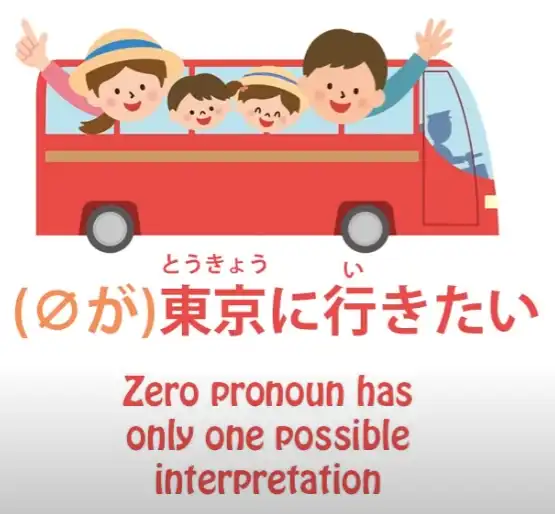
Now, there is no possible other “zeroが” in this sentence than “I”.
It can’t be Tokyo, because that’s already the に-marked destination.
It can’t be “go” because that’s a verb and we can never mark anything but a noun with が or any other logical particle.
So we know for certain that it is in fact possible for “-たい” to flip its polarity, to point not to the object inducing desire to do but also to the person or animal experiencing the desire to do.
And this goes on to extend to other areas of Japanese.
For example, the potential.
When we say “本が読める”, we’re saying “The book does readable.”
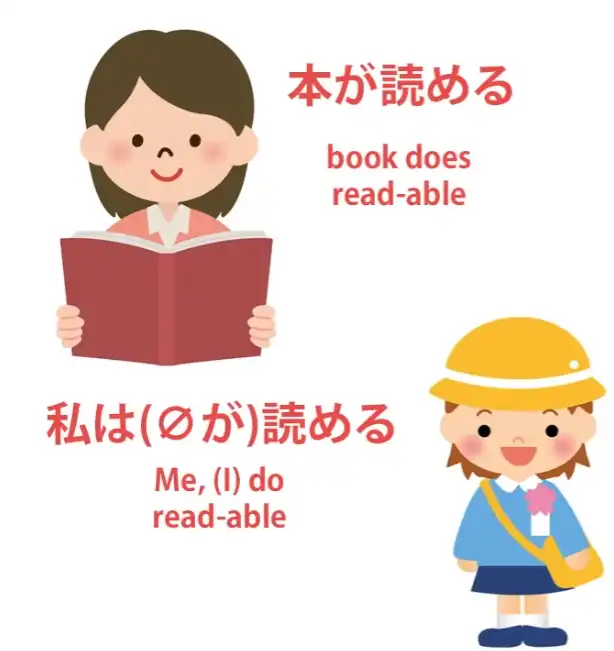
We can’t translate this directly into English because it’s a verb and “readable” isn’t a verb in English, but in Japanese we’re saying “The book does readable.” Now this is the subjectivity in a certain sense because it’s not talking about the fact that it’s in general possible to read the book. That would be “可能性/かのうせい”.
It’s talking about the fact that the book is readable to a person or people in particular.
But again, the が-marked subject is the book.
So saying “I can read the book” or “We can read the book” is simply false.
That’s not what the sentence is doing and if we think it is, we’re going to end up with
this completely destructive idea that が can sometimes mark the object of a sentence.
It never can. It can only ever mark the subject, the A-car of a sentence.
And this is so crucial to Japanese because it’s what every single sentence you ever see, ever in your whole life, consists of: a が-marked A-[car] and a B-engine.
Disrupt that and you’ve disrupted everything.
So, the actor of “本が読める” is the book: “The book does readable.” But if we say “私が読める” or “さくらが読める”, what we’re saying is “I can read”/ “Sakura can read.” Not can read a particular book, not can read a newspaper, not can read a manga, but can read, is literate.
So, once again, the potential can flip its polarity.
If there’s a specific readable thing, then it’s that that “does readable”, but if there isn’t, if it’s just referring to literacy in general, then it flips polarity and points to the person or people who are able to read.
Now why is this? We’ve talked about the fact that the non-egocentricity of Japanese is fundamentally rooted in a more animist way of seeing the world.
I’m not saying anything here about what Japanese people as individuals believe nowadays.
I’m talking about how the language looks at the world.
English requires an ego at the center; Japanese doesn’t.
It’s much more happy to have non-ego actors as the center of even a subjective-based sentence.
But it doesn’t stop there.
And once you realize that, we’ve done away with the final problem.
It’s not just that it doesn’t find having a non-ego actor at the center and that in many cases it has a preference for that, it’s also that it sees the two, the inducer of the subjectivity and the receiver, the experiencer, of the subjectivity, as not fundamentally separate.
The action of subjectively desiring or fearing or wanting etc. is something that goes on between the two, between the inducer and the experiencer.
And we can look at it from either perspective and it doesn’t really matter.
The bias, as it were, the default condition, is to attribute it to the inducer, but there’s no difficulty at all in moving it to the experiencer.
Because the two aren’t regarded as completely separate.
They are two halves of the same action.
And if we understand this, we’re looking at it much more through Japanese eyes.
We’re not having to re-route it through strange English intermediaries.
And this affects all kinds of things, not just the grammatical areas we’ve talked about, but all kinds of things. For example, let’s take the word “不思議”. “不思議” means “mystery”.
It’s a noun, it means “mystery”.
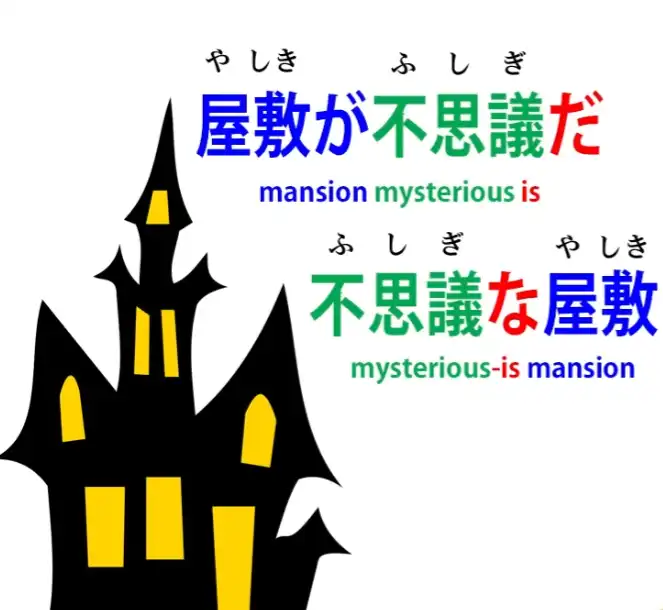
And it can be used as an adjectival noun, in which case it means something like “mysterious”.
So if we say “不思議な屋敷”, we’re saying “mysterious mansion”.
But we can also attach “そう” to “不思議”, which, as we’ve discussed before, means “seems” or “like”.
So “不思議そう” would seem to mean “seems mysterious” or “mysterious-like”.
Now, this in itself is meaningless, because “mysterious” is a subjectivity.
If we say something is mysterious, this isn’t an objective quality like being red or being three feet high. It’s a subjectivity. It’s mysterious because we find it mysterious.
If we don’t find it mysterious, then it’s not mysterious.
So saying it’s mysterious-like or seems mysterious is meaningless because saying it’s mysterious in the first place is really only saying that.
But that isn’t what “不思議そう” means.
“不思議そう” is used in sentences like “「これはなーに?」とさくらは不思議そうに言った” – “‘What’s this?’ asked Sakura in a mystified manner.” “不思議そう”, you see, again flips polarity.
It doesn’t apply to the thing which is inducing the sense of mystery, it applies to the person feeling the sense of mystery.
So “不思議そう” means something like “mystified”, sometimes perhaps “puzzled”, but in any case it means “perceiving quality of ‘不思議’ in something else”.
So you see this whole flipping of polarity, which is based in a more unified view of the world, not just more “animist”, to use that term, but unified.
More in a sense that the inside and the outside are not wholly separate but are two sides of the same perception.
And if we can grasp that, the final problem is solved and a whole area of Japanese is unlocked and released from the necessity of routing it through English.
Note: As usual, if this lesson feels confusing or complex, I recommend looking into the comments of the video where Dolly discusses some stuff in more depth.
44. How to use natural Japanese: ちゃう, ちゃった
How to use natural Japanese: chau, chatta, how they really work ちゃう、ちゃった - Lesson 44
こんにちは。 Today we’re going to talk about something that you encounter all the time in anime, manga, everyday conversation, light novels, and anywhere that you encounter real, so-called casual – that’s to say, non-formal – Japanese.
Now, we’re going to have to use a little trick to understand from an English point of view how this works.
And of course the standard explanations wouldn’t give you a trick like this because they don’t even explain the basics of the underlying principles of Japanese structure.
So we get the effect of the three blind men and the elephant.
I’m sure you’ve heard the story.
The first one feels one of the elephant’s legs and says an elephant’s like a tree, the second one feels its trunk and says it’s like a snake, the third one feels its tail and says that it’s like a rope.
And of course none of these are exactly incorrect.
The elephant does manifest all these qualities, but if you present them as isolated facts without explaining that there’s an elephant underlying the whole thing, which makes sense of it, you’re making everything a great deal more difficult than it needs to be.
And the standard English so-called Japanese grammar does this from the very beginning with the structure of the language, which is disastrous, and then it does it again, and again, and again with what it calls “grammar points”.
And the very fact that it calls them “grammar points” is part of the problem, because for the most part these aren’t in fact points, they are logical structures, and if we understand the structure we don’t have to memorize them as separate meaningless “points”.
So, what we’re going to discuss today are the expressions “-ちゃった” or “-じゃった”, which are attached to the end of verbs.
Now if we look at the conventional explanations, we will read that it indicates an action that’s been finished or completed, or an action that we regret or did by accident, or something that just happened unexpectedly.
They don’t usually add to this that it can also indicate something that happened that was very good, or that it can in fact be used in the future tense as “-ちゃう” or “-じゃう”, which would seem to contradict everything that we’ve just learned, wouldn’t it?
So, instead of looking at the tail and the legs and the trunk, let’s start by taking a look at the actual elephant.
First of all, “-ちゃう” or “-ちゃった” is in fact a contraction of the past tense of the word
“しまう”, which means to finish or complete.
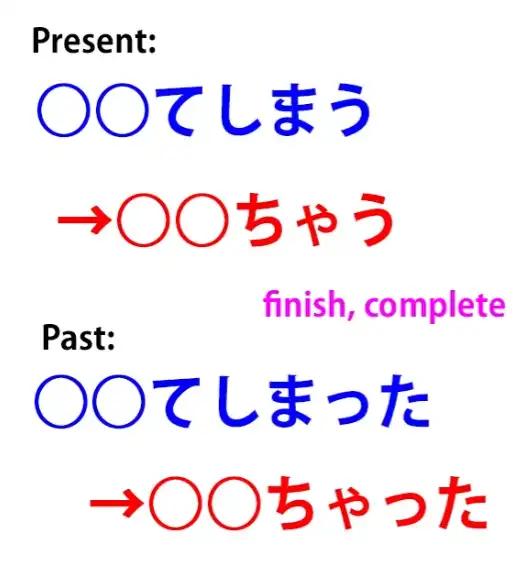
So, if you ever listen to Japanese fairy tales, you’ll find that they often end with the formula
“おしまい”.
And “しまい” is the い-stem, which makes it a noun of “しまう”, so it means “the finish / the ending / the end”.
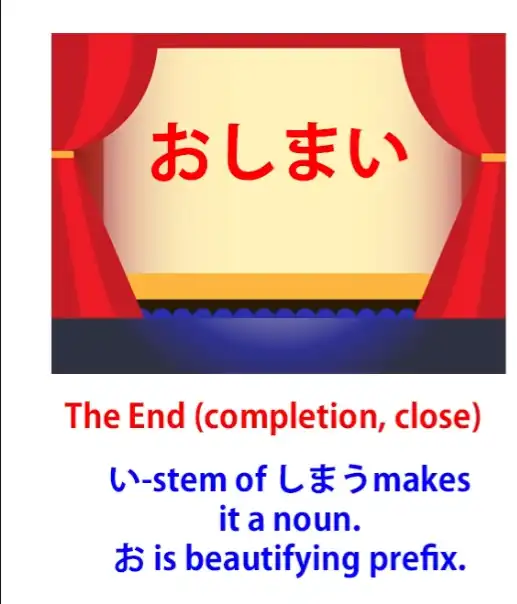
Now, if you put that into the past tense, it’s “しまった”, and “しまった” can be used all on its own as an expression, and it usually means “Something’s gone very wrong / This is not at all satisfactory” : “しまった!” Perhaps the best way to put that in English would be to say something like “That’s done it” or “That’s the end!” or something like that.
Now, we can then use this “しまった” as a helper verb that we put onto the て-form of another verb.
And the way we do that is, we put the other word into て-form and then we add “しまった”.
And “-てしまった” gets contracted down to “-ちゃった”.
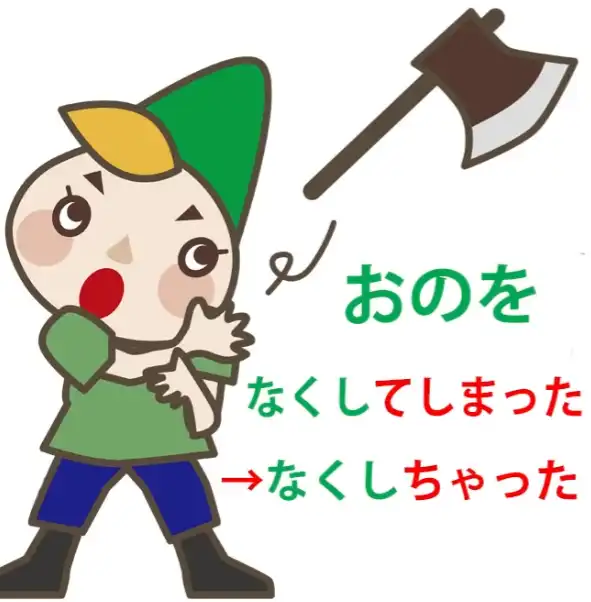
Now, if the て-form is “で” (as we know that it is in some words and if you don’t understand that, I’ve explained it in a previous video - Lesson 5 & 40), if the て-form is “で” then instead of becoming “-ちゃった”, it becomes “-じゃった”, just in the way that “では” becomes “じゃ”.
Now, this has a much wider range of meanings than just “しまった” on its own.
It can be used for things that we did by accident or that we wish we hadn’t done.
For example, we often say “忘れちゃった”, which is “忘れる” – “forget” – plus “-ちゃった”.
There’s a famous song “ネコ踏んじゃった”, which is great fun, and I’ll put a link in the information section below.
And what that means is “I trod on the cat”: “踏む” – to “tread (on something)”.
So we can see that it has a negative sense here, but it can also be something very good.
We might say “スーパーヒーローになっちゃった” – “I became a superhero.” So what do these things have in common?
Accidental things, things we regret, things we’re very pleased about.
The way I would put this, the way I would translate this into English, because this is the English expression that I think covers practically all cases of “-ちゃった”, is the word “done”.
“忘れちゃった” – “I done forgot”; “猫踏んじゃった” – “I done trod on the cat”; “スーパーヒーローになっちゃった” – “I done became a superhero.” In all these cases , the idea is very similar.
We’re saying that it happened, it’s done, it’s completed, it’s a fact, and the implication generally speaking is that we didn’t expect it to be a fact or it wasn’t what most people would normally have expected to be a fact, but it is. It “done happened”.
And if we understand that, it’s very easy to understand all the different kinds of circumstances under which “-ちゃった” gets used.
The only real difference between this and “done” in English is that we don’t only use it about past things. We also use it about future things.
So we can say, “夏休みが終わってしまう” and that means “the summer vacation will done end”.
Now, of course you can’t say that in English but that essentially is what you’re saying.
It will just be and go and end.
That’s what’ll happen and it’ll be done and there’s nothing we’ll be able to do about it.
If you’re about to tell somebody something embarrassing, you might say “君のは笑っちゃうだろう” – “You’ll probably laugh” or “You’ll probably done laugh / You’ll probably just up and laugh.” Again, it’s the same idea but in Japanese we can project that idea into the future as well.
We can say “今日はどんどん飲んじゃう”, and that’s “Today, I’m going to drink like crazy”.
“どんどん” is “one after another in rapid succession”; “飲んじゃう” is “done drink”.
Again, we can’t put that in the future in English, but we can put it in the future in Japanese.
So if we understand how these work, we don’t have to have a lot of complicated explanations of all their different cases.
They work in the same way all the time if we only think about what is the way they work rather than what their end result is if you translate it into English.

45. First-Step Guide into Self Immersion Technique
Japanese Immersion. First-Step Guide into Self Immersion Technique - Lesson 45
こんにちは。 Today, we’re going to take the plunge from abstract theoretical Japanese – grammar and structure and vocabulary – into actual direct immersion in real Japanese material for Japanese people.
As you know, I recommend doing this at the earliest stage possible, but it’s pretty difficult, because once you’re in real Japanese material you’re going to encounter vocabulary that you didn’t know before even in very simple material, because small Japanese children have a huge vocabulary compared even to foreigners who’ve taken quite high-level Japanese exams.
This is why I don’t recommend core vocabulary decks and things like that.
The way to pick up core vocabulary beyond a small base is to pick it up as you proceed through real Japanese material.
That way you get the kind of vocabulary you’re actually going to be encountering and using.
So what I’m going to do is take a simple Japanese story that’s not in any way doctored for foreigners. It’s just the way it is.
And it also has audio and I’ll link you to that in the Comments below.
So once we’ve gone through the story and you’ve got it clear in your mind, you can put the audio onto your phone or your mp3 player and hear it over and over again. That’s going to consolidate any new vocabulary; it’s going to consolidate the rhythm and spoken form of Japanese and the structure, because we need to move structure and vocabulary from the abstract area, where you know them but you have to think about them very carefully to do anything, into the area where it starts to become instinctive.

So please, use that audio once we’ve been through the story.
It’s very short, and I’m going to make a page, which I’ll link below, where I give the links to the various videos where I talk about the grammar points that we encounter.
You’re going to see that even in a short and simple story like this, we use a lot of the structure that we encounter in my various lessons.
All right, so let’s get started.
This is a short and simple fable about a greedy dog.
And the first sentence is: “肉をくわえた犬がはしをわたっていました.”
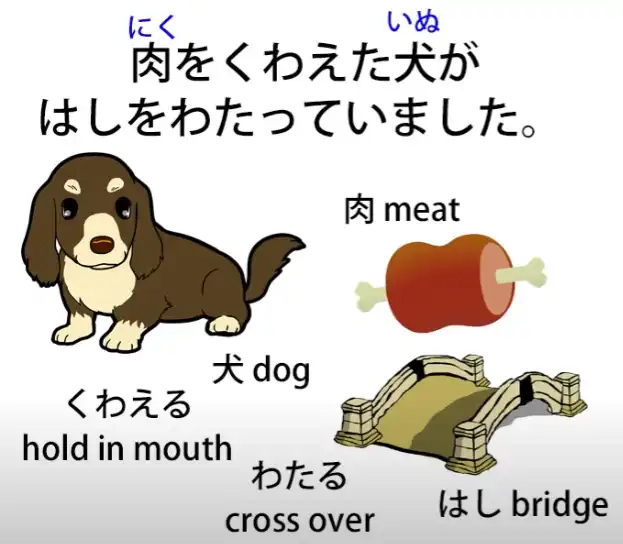
So you see this is in です/ます-style Japanese, so if you’re a little bit uncertain about that please refer to my です/ます video.
“肉をくわえた犬が.” Now, “肉” means “meat” and “くわえる” means “hold in one’s mouth”.
It’s one of those words that you could do a huge core deck and still not know.
And what’s happening here is that very common technique of inverting a simple logical clause to turn it into a descriptive clause.
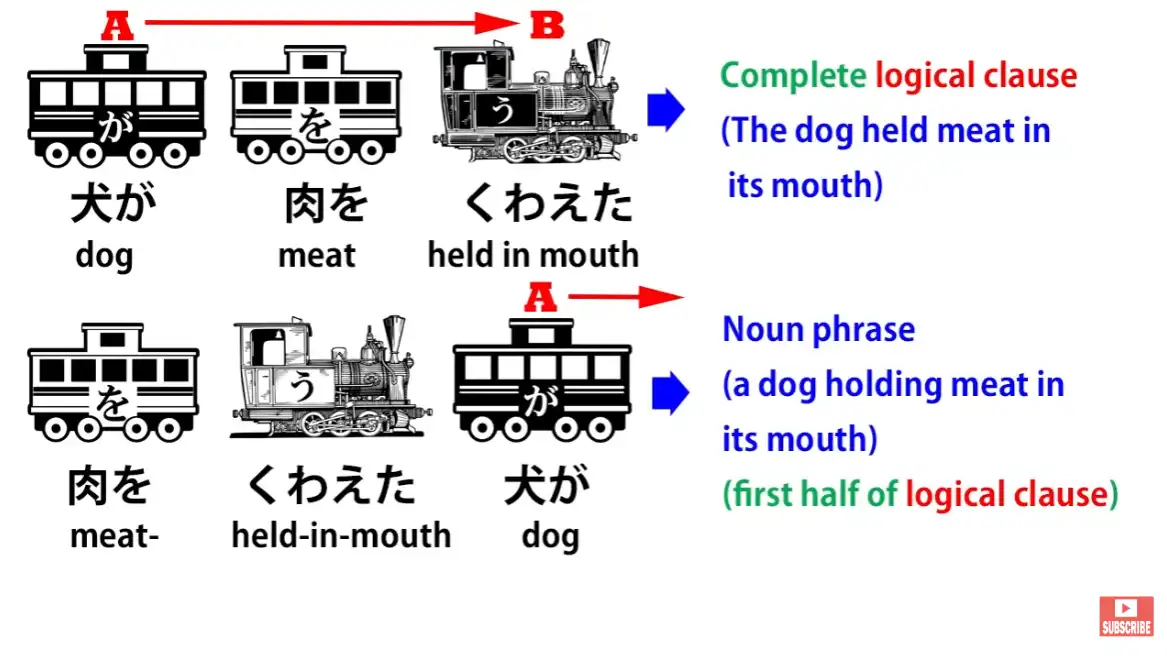
So, “犬が肉をくわえた” is “a dog held meat in its mouth”, but “肉をくわえた犬” is “a dog that was holding meat in its mouth”.
So, that dog is the subject of our sentence, marked with が.
“肉をくわえた犬がはしをわたっていました.” “橋/はし” is “bridge” and “わたる” is “cross”.
So, the dog was in the process (“-ている”) of crossing the bridge.
“肉をくわえた犬がはしをわたっていました.” So that set the scene.
We know what’s happening.
“ふと下を見ると、川の中にも肉をくわえた犬がいます.”
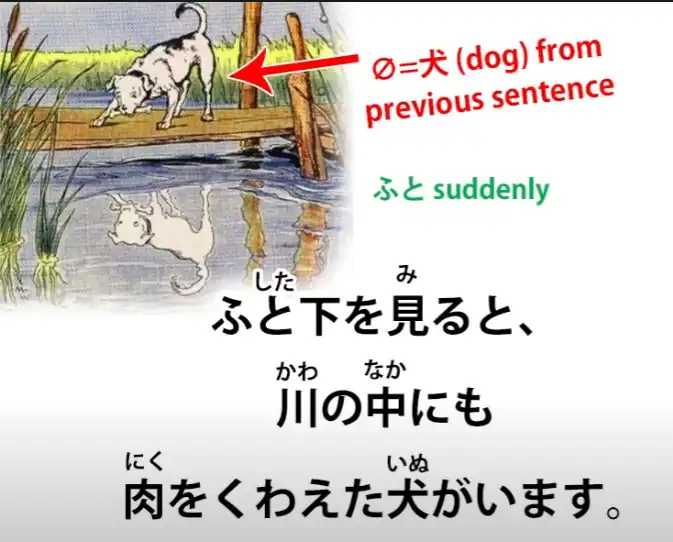
Now, the first thing to notice here is that this second sentence is in the non-past tense, isn’t it?
So this is a difference between Japanese narrative convention and English.
In English narrative, if the narrative is in the past tense it stays in the past tense and every sentence is in the past tense.
In Japanese narrative this isn’t the case.
We can set a narrative in the past tense but sometimes when we want to give more immediacy to something, we just move into the present tense.
This is not allowable in English narrative, but it’s perfectly allowable in Japanese narrative, so we need to be aware of that and not let it confuse us.
So, what’s going on here?
“ふと” means “suddenly” – I’m not going to explain the simplest vocabulary here because I’ll assume that you’ve got very basic vocabulary in order to start making the plunge into Japanese narrative.
So, “ふと” means “suddenly”.
“ふと下を見ると” – “(the dog) suddenly looked down”.
The zero-pronoun here is “it”, the dog.
So, the dog suddenly looked down, and that “と” is the conditional connective, “if” or “when”, and I’ll link to that (Lesson 30).
So it’s saying “When the dog suddenly looked down…” or “The dog suddenly looked down, and…” “When the dog suddenly looked down… 川の中にも”.
“川の中に” is “in the river” and the “も” here is telling us “also”: “also in the river”.
“川の中にも肉をくわえた犬がいます.” So, “also in the river there’s a dog carrying meat in its mouth”.
Not just on the bridge but also in the river, there’s a dog carrying meat in its mouth.
“犬はそれを見て思いました.” Now, the dog is now being referred to with は rather than が, and that’s because we’ve now had the dog introduced, so it’s no longer “a dog”, it’s “the dog”.
And I’ll link to the video where I explained this.
“犬はそれを見て”; “それ” is “that” and so this is the first part of a compound sentence: “The dog saw that and..” – the て-form is giving us the “and” there.
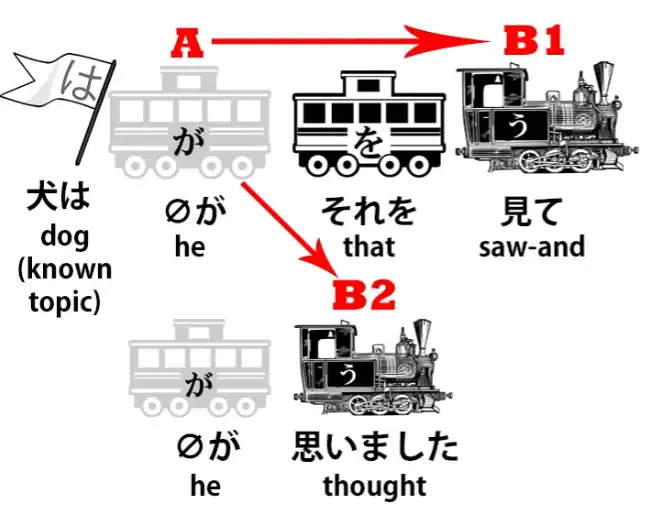
And I’ll link to compound sentences (Lesson 4).
I’m going to stop telling you now what I’m linking to, but if you look at the special page that I’ve made – which I’ll link below – I’ll give all the links to the different parts of this story.
You probably don’t need to follow them all up, but if there are any bits that confuse you, you can go to the videos where I’ve explained those specific points. Right.
So, “犬はそれを見て” – that’s a logical clause in itself: “The dog saw that and… 思いました.” “The dog saw that and thought (or felt).” “あいつの肉のほうが大きそうだ.”
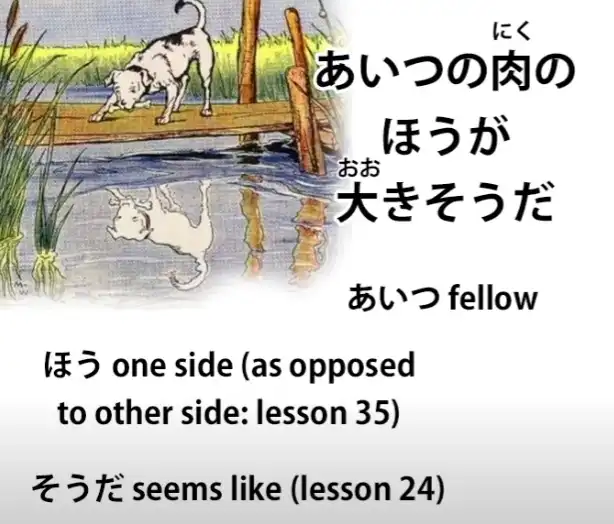
“あいつ” is “that fellow/ that type/ that character”.
“あいつの肉のほうが”, that’s to say “the side of that character’s meat…” (that character’s meat as opposed to my meat) “…大きそうだ.” So that’s the connecting of “そう” to the adjective “大き” – “looks” – meaning it looks or appears bigger.
“The side of that character’s meat appears bigger than mine.” How do we know it’s a comparative?
Because of the “ほう”, which is telling us that we’re talking about the side of that character’s meat as opposed to some other side, which in this case is going to be “my meat”.
“犬は悔しくてたまりません.” “悔しい” is an adjective and it means that something is “irritating” or “annoying”.
But like all adjectives of subjective emotion, when it’s applied directly to the individual, it can refer not to the annoyingness of the object but to the annoyance of the individual.
So that’s what it’s doing here.
“犬は悔しい” means “the dog was annoyed”.
It could mean “the dog was annoying”, but in this case it means “the dog was annoyed”.
And then, “たまりません”.
“たまる” is to “bear” or “endure”, so “たまりません” means “not bear”.
Now, when you add “-てたまりません” to something, we’re saying that it was “to an unbearable degree”.
The dog was annoyed to an unbearable degree at seeing this other dog with what he believed to be a larger piece of meat than his own.
And then we have a quotation from the dog:
“そうだ、あいつを脅かしてあの肉を取ってやろう.”
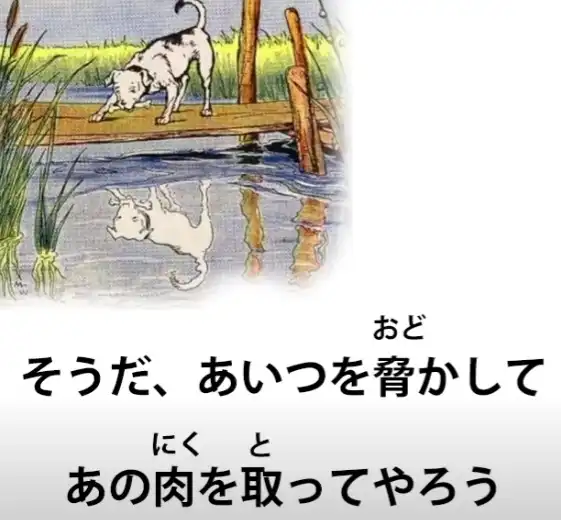
“そうだ” – “Okay then/that’s the case”; “あいつを脅かして” – “脅かす” is to ‘‘intimidate’’ or to “scare (someone)”, so: “I’m going to scare that fellow and… あの肉を取ってやろう.” “あの肉”, of course, is “that meat”; “取る” is “take”.
“取ってやろう” is related to “-てあげる”, to “do an action up to someone / to give someone the benefit of your action”.
“-てやろう” is like “-てあげる” in that it means do it for someone else, but instead of being honorific, it’s the reverse of that.
It’s doing down to someone else, doing to someone that you consider inferior.
So, for example, it would be appropriate to use “-てやろう” for feeding the dog, because the dog really is legitimately considered as inferior.
In a case like this, it’s just a rather rude way of speaking.
And, of course, what he’s going to do is not a favor to the dog: he’s going to steal something from this poor dog in the river.
And so it’s rather like when someone might say in English, “I’m going to punch your head for you,” which is phrasing it as if you were doing someone a favor when actually you’re doing someone something that isn’t a favor.
“I’ll take that meat for him.” “そこで、犬は川の中の犬に向かって思いっきり吠えました.”
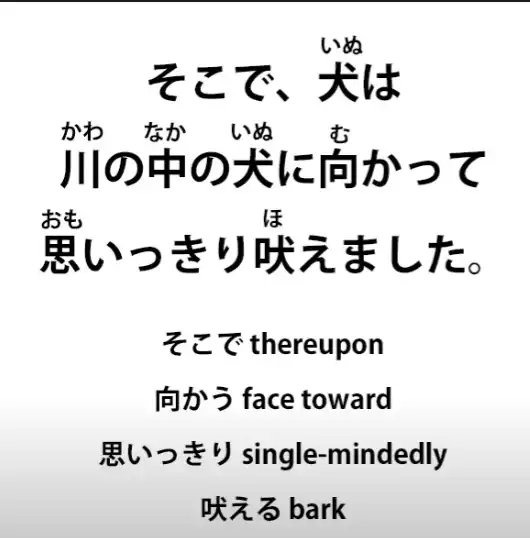
“犬は川の中の犬に向かって.” “向かう” is to “face toward”, so the dog faced toward / directed its action toward the dog in the river.
“思いっきり吠えました.” “吠える” is to “bark” and “思いっきり” is… “思い” is “thought” or “feeling”, and when we add this “-っきり”, which is actually the “切り” of “cut”, it means to do something completely, to do it to the cutting point, we might say.
So, “思いっきり” means “putting one’s whole thought into it, one’s whole heart into it”.
So, the dog faced towards the dog in the water (river) and put its whole effort into barking at it in order to scare it.
ワンワンワンワン.
As we all know, “ワンワン” is “woof woof” in Japanese.
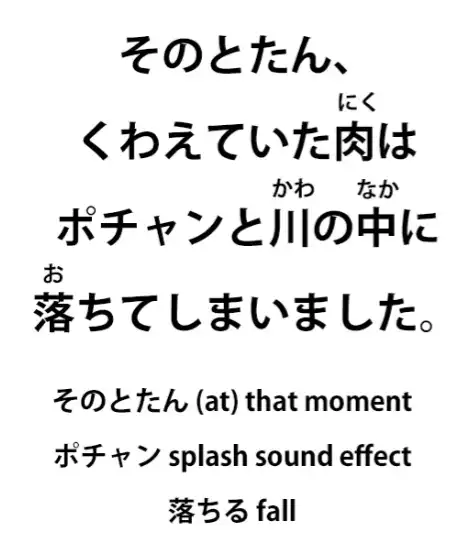
“そのとたん…” “そのとたん” means “at that moment”.
“とたん” is “just as something happens or just after it happens”.
So, “そのとたん” – “at that juncture / at that point / at that moment”.
“くわえていた肉はポチャンと川の中に落ちてしまいました” So, at that point, the meat that was being held in the mouth –“くわえていた肉は” – “ポチャン”, which is a splash-type sound effect, “ポチャンと” – and -と, of course, marks sound effects – “川の中に” – “into the river” – “落ちて” – “落ちる”, to “fall” – “しまいました”.
And that “しまいました” is saying “it done fell into the river”, and I’ll link to the video on that “しまいました / ちゃった”, which means “it done happened”. (Lesson 44) Ahh! “川の中には、がっかりした犬の顔が映っています”
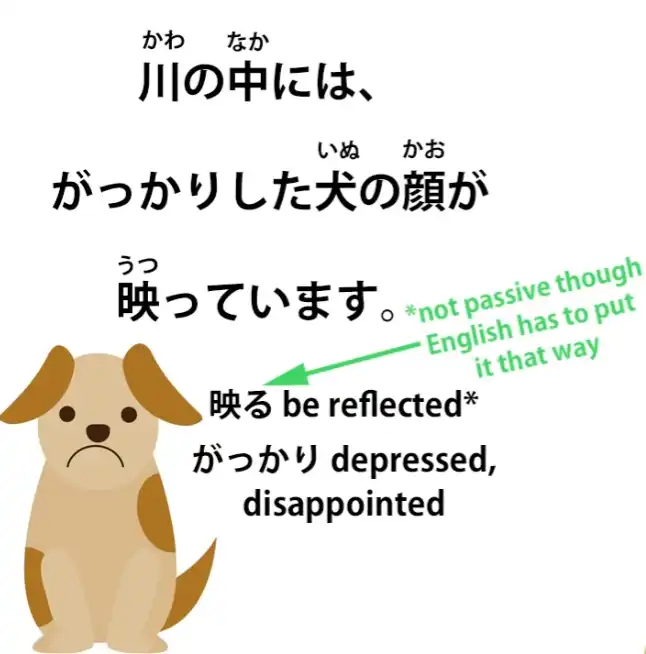
And again we’ve switched into the present tense to give more immediacy to this.
“Inside the river… がっかりした” – “がっかり” is “upset / depressed / disappointed / dejected”, “映る” is “reflect”, “顔” is “face”.
So, inside the river, the face of a disappointed, miserable dog was reflected.
“さっきの川の中の犬は水に映った自分の顔だったのです” “のです” – “The fact is that it was…” The fact is that it was what?
The fact is that… さっきの川の中の犬は” – “さっき” in this case means “just before” or “previous”.
So “さっきの川の中の犬” is “the dog in the river from just before”; “水に映った自分の顔だった” – “自分” is “oneself”, so it’s “one’s own face reflected in the water”: “水に映った自分の顔だったのです.” The fact is that it was… the fact is that the previous dog in the river was one’s own face reflected in the water.
And now there are two morals that follow this story.
And they’re put into one long compound sentence, which looks a bit difficult, so let’s just break it into two parts.
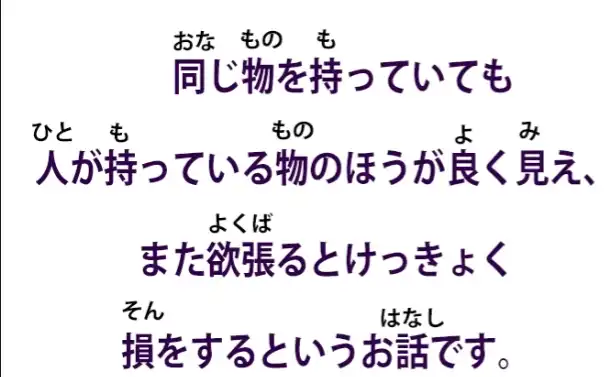
“同じ物を持っていても人が持っている物のほうが良く見え、” Now, first of all, that “見え” is the “連用形/れんようけい”, the い-stem of “見える”, to “be visible or look like”.
It doesn’t look like an い-stem because it’s an ichidan verb and, as we know, all the stems of the ichidan verb look the same.
But the い-stem of a verb can be used, especially in literary contexts, like the て-form, to connect two logical clauses within a compound sentence.
So, that “見え” is completing a logical clause and then leading onto the second logical clause which is the other moral of the story.
So, let’s look at the first moral first.
“同じ物を持っていても” – now, the “-ても” ending, as we know, means “even though”, so we’re saying “同じ物” – “the same thing” – “を持っていても” – “is in a state of carrying” (or holding or possessing).
So, even though they possess the same thing (“同じ物”) “人が持っている物” – “the thing that people have” – and “人” here means “other people”.
You’ll often see this in Japanese: “人” in general can mean “other people”; it means “people in general”, but it means “people other than oneself”.
“人が持っている物” – “what other people have… のほうが良く見える” – “のほう”, once again, is that comparative, “the side (of what other people have)”; “良く” is of course “いい”, so “良く見える” is “appear good”.
So, the side of the things other people have appears good; in other words, in comparison to one’s own things, their things appear good.
So the first moral is: Even though it’s the same thing, something that other people have can appear better.
And that’s the first moral.
In English, we’d probably put that the other way around and say, “Other people’s things appear better than ours, but in fact they’re the same.” — “また” – “また” means “again” or in cases like this it means “also”.
So, also the second moral is: “欲張るとけっきょく損をするというお話です.” “欲張る” is to “be selfish / to be full of glittery, to be full of desires and wants” –“欲張る”.
“欲張ると” is again this connective if-or-when “と”; in this case, “if one ‘欲張る’s”, if one is full of selfish desire – “けっきょく”, which means “in the end”, “けっきょく損をする” – “損” means “loss”, “損をする” means literally “do a loss”, but in fact means “have a loss” or “suffer a loss”.
So it’s saying, if you’re full of selfish desires, in the end, you’ll have a loss.
“というお話です” – “という”, so this is quoting that saying “If you’re full of selfish desires you’ll have a loss” – “というお話です” – “お話” is a story, a “物語” – “お話”.
So, “this is a story that says ‘if you’re full of selfish desires you’ll have a loss’.” So there we are. It’s a very short story, as you see, there’s a lot in there.
Even in a short and very simple story like this we come across all kinds of the things that we’ve learned in the course of the Structure series.
And if we use what we’ve learned, we can understand everything in the story.
So now, you’ll go over that carefully, at your leisure, using this video.
Make sure you understand everything in it and then put it on your phone or your mp3 player or whatever it is you use, and listen, listen, listen.
Get the new vocabulary into your mind, but more importantly than that even, get the structure, the feel of it into your mind so it stops being abstract work, the kind we’ve done right here, explaining everything, and starts to become intuitive grasp of language…
46. Word Order MATTERS 2 Simple rules to crack tough sentences
Japanese Word Order MATTERS (more than you think) 2 Simple rules crack tough sentences - Lesson 46
こんにちは。 Today we’re going to talk about Japanese word order, because this is something really fundamental.
As sentences become more complex, word order becomes more and more necessary in order to understand exactly what’s going on in any given sentence.
And, as is often the case, English-language so-called Japanese grammar doesn’t give us very much help with this.
If you look up “Japanese word order” on the Internet, you’ll find that there are broadly two different opinions being promulgated.
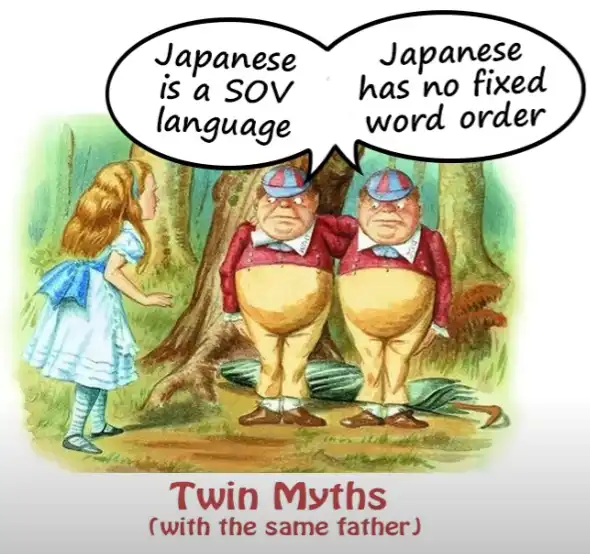
The first is that Japanese is an SOV language, that’s a Subject-Object-Verb language.
And the second is that word order in Japanese really doesn’t matter and isn’t very important, because you can put words in pretty much any order and continue to mean the same thing.
And both of these opinions are completely false.
And interestingly enough although they’re diametrically opposed to each other, they both stem from the same fallacy.
They both come from giving different answers to the same question which was the wrong question to ask in the first place.
In other words, what they come from is our old friend, treating Japanese as if it were not Japanese but a European language and asking questions and giving answers that are relevant to European languages and not to Japanese.
So, let’s look into this and see how it works and understand how word order really works in Japanese.
First of all, let’s look at this question of Japanese being a Subject-Object-Verb language.
Now, this would be contrasting it to English, which is a Subject-Verb-Object language.
So, to give you an example of that, if we say “Mary hit Susan”, this is a standard English Subject-Verb-Object sentence.
Mary is the Subject – she did the hitting.
Susan is the Object – she received the hitting.
If we change the order around and say “Susan hit Mary”, we’re now saying something different, aren’t we?
Now, the way in Japanese we would say “Mary hit Susan” is
“メアリーがスーザンをなぐった”.
And this is of course Subject-Object-Verb.
Mary’s the Subject, Susan’s the Object, and the Verb comes at the end.
So, isn’t Wikipedia right? Isn’t Japanese really a Subject-Object-Verb language?
No, it isn’t.
Because although “メアリーがスーザンをなぐった” is the most common way of putting it, it isn’t the only way of putting it.
We could just as easily say “スーザンをメアリーがなぐった” and we’re still saying “Mary hit Susan”, even though we’ve changed the order.
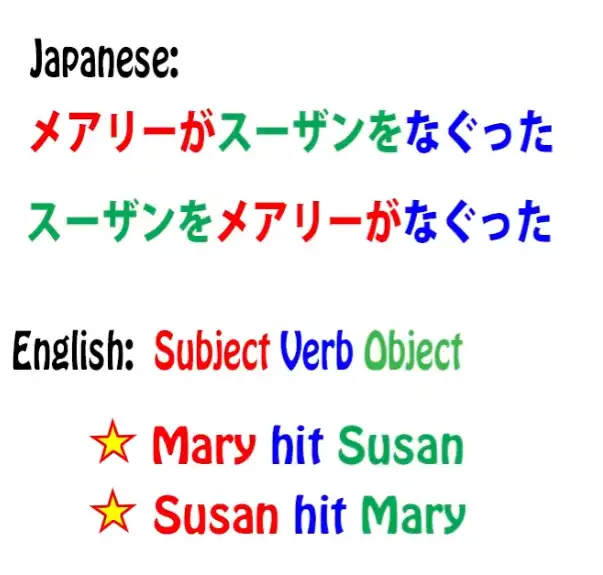
Because in Japanese the question of who did what to whom and most other logical questions like where it was done, what it was done with, and all those things are handled by logical particles.
So the important thing in this sentence is not which order we have Mary and Susan but which one is marked by が and which one is marked by を.
So this talk of a Subject-Object-Verb language is nonsense.
It doesn’t actually matter which order you put them in.
And this of course is the basis of these people who say Japanese word order doesn’t matter.
So aren’t they right?
No, they’re not right.
Because Japanese word order does matter.
It just doesn’t matter in the same ways and the same places that European word order matters.
If we start thinking about Japanese as Japanese and not trying to interpret it as a European language, then we can make some progress on actually understanding Japanese.
Japanese word order rules
So what is Japanese word order and why does it matter so much?
Japanese word order goes according to two simple rules. They’re both very simple.
It’s just that they don’t work in the same way that European languages work.
So if we can throw our European concepts out of the window and start looking at Japanese as Japanese, there’s nothing difficult about this. It’s very simple and straightforward to understand.
So, what are the two rules of Japanese word order?
The first one you probably already know.
It’s very simple, and I expect you use it all the time if you’re actually using Japanese at all even at a very basic level.
#
Rule 1
The first rule of Japanese word order is: The Engine always goes at the end of the sentence.
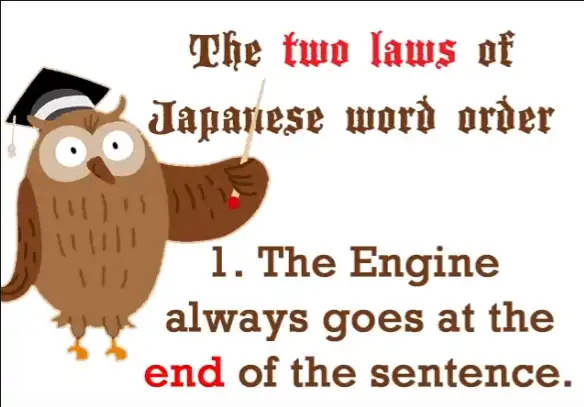
Now, if I were talking in this very verb-centered English way, I would say “The Verb always goes at the end of the sentence”, and that’s perfectly true.
The Verb always does go at the end of the sentence.
But not all sentences are verb-sentences, “A does B” sentences.
We also have “A is B” sentences.
And whatever kind of sentence we have, the Engine always goes at the end of the sentence.
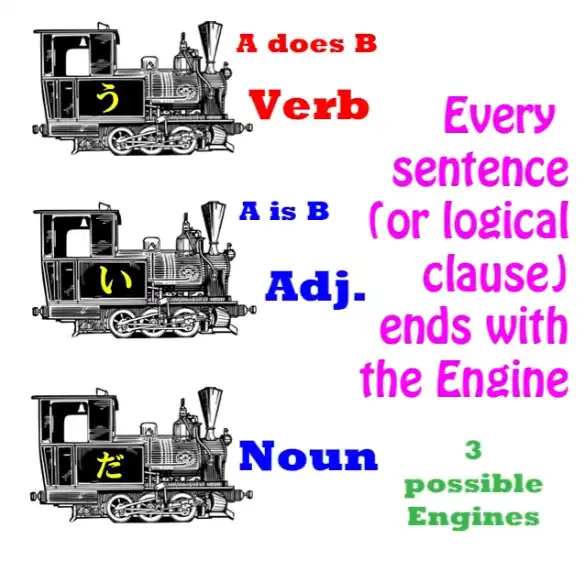
There are three possible kinds of Engine.
There is the Verb Engine, which is an “A does B” sentence.
And then with “A is B” sentences we either have an Adjective Engine, an engine made from an adjective which always ends in -い (this is what the textbooks call an “い-adjective” and is in fact the only adjective there is in Japanese) or with a Noun plus the Copula, which is “だ” or “です”.
So every sentence is going to end in one of those three.
And whatever Engine we’re using, a Verb, a Noun with the Copula, or an Adjective, it has to go at the end.
We may have a couple of sentence-ender particles after it (and I’ve done a video on sentence-ender particles) but the actual end of the logical sentence has to be its Engine.
So that’s the first rule, and it’s very easy, and I imagine you’re accustomed to it already.
#
Rule 2
The second rule is this, and this is the one that can cause confusion if you don’t understand it: Anything that modifies any-THING must go before it.
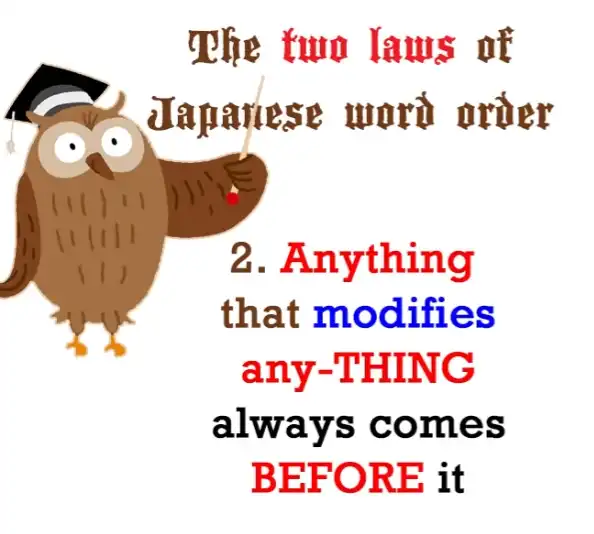
Now what do I mean by “anything” and “any-THING” and what do I mean by “modify”?
Let’s break it down.
By “any-THING” I mean literally a thing, a noun. We’re talking about nouns at the moment.
And by “anything”, I really mean anything.
It could be a logical clause, it could be part of a logical clause, it could be another noun – it’s anything that modifies any noun.
So what do I mean by “modify”?
Well, I mean literally changing something or, we could say, describing it.
So if we have a dress and then we put a modifier before it and say it’s a “blue dress”, then we’ve modified it – we’ve made it blue.
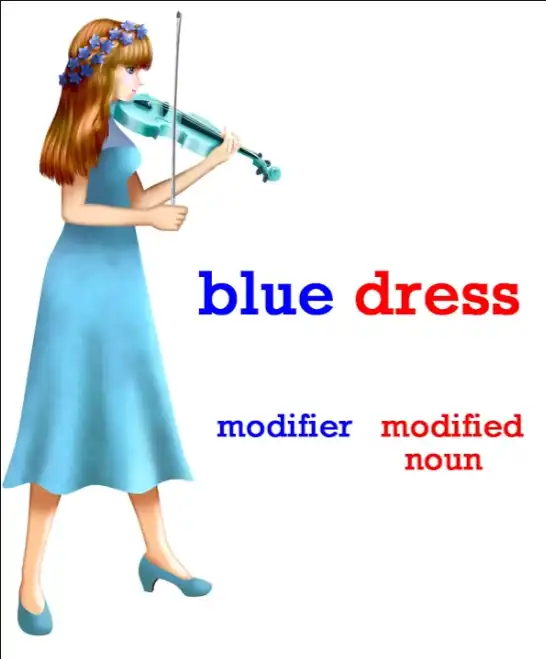
If we say it’s a “big dress” then we’ve modified it and made it big.
If we say it’s a “hot dress” then we’ve modified it and made it hot.
And of course modifiers can become more complex than that and we’ll talk about that in just a moment.
But a modifier is something that tells us more about a noun.
It modifies it from just being the simple noun to being a more particular version of that noun.
So what do I mean by saying that “Anything that modifies any-thing must come before it”?
Well, if we speak English we should be used to this idea already, because in English simple modifiers always come before the noun they modify.
So, as we’ve just seen, if we say “a blue dress”, “blue” comes before the modified noun “dress”, the noun that we’ve just turned blue.
We say “a warm day”. “Warm” comes before the noun “day”. And it can become more complex.
We might say “a pale blue dress”, “a nice warm day”, and the modifier still comes before the noun it’s modifying.
And it can get more complicated still.
We might say “an interesting-looking pale blue dress”, and all of it still comes before the noun “dress”, doesn’t it?
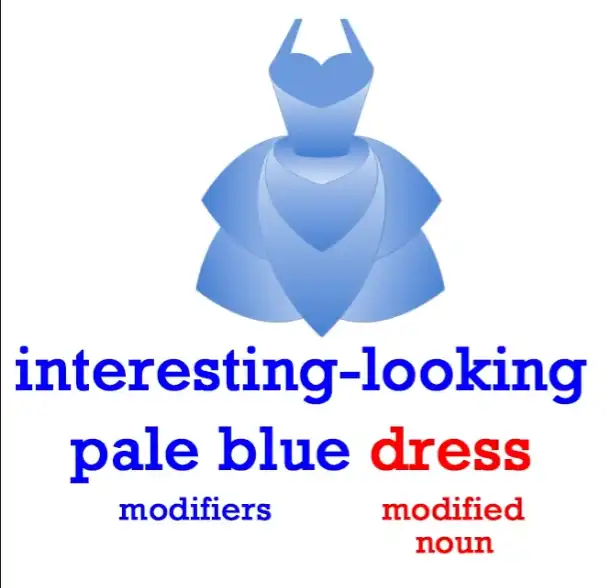
However, when modifiers become more complex in English we start throwing them on the other side of the noun.
So if we want to say “the dress I bought at the market on Saturday”, now “dress” comes first and the modifier comes afterward.
And sometimes we’re throwing modifiers onto both sides of the noun.
So we might say, “the pale blue dress I bought at the market yesterday”.
So we’ve got “dress” sandwiched in the middle and clauses modifying that dress on both sides of it.
That’s not the way Japanese works.
Japanese always keeps modifiers before the thing they modify.
So it’s very predictable and we always know what’s going on.
A way of looking at Japanese word order is to see it as a stage scene.
To see every sentence or every logical clause as a little scene on a stage.
And the way Japanese works is that first of all it dresses the little dolls that go into the scene.
So before each doll comes whatever it’s dressed in, whatever modifies it, whatever tells us more about it, its clothes, its setting. Then we put it on the stage.
We mark it with whatever part it plays in the sentence, and then we put the next noun if there is another noun, and finally we put on the action button, the verb.
And we always press the action button last.
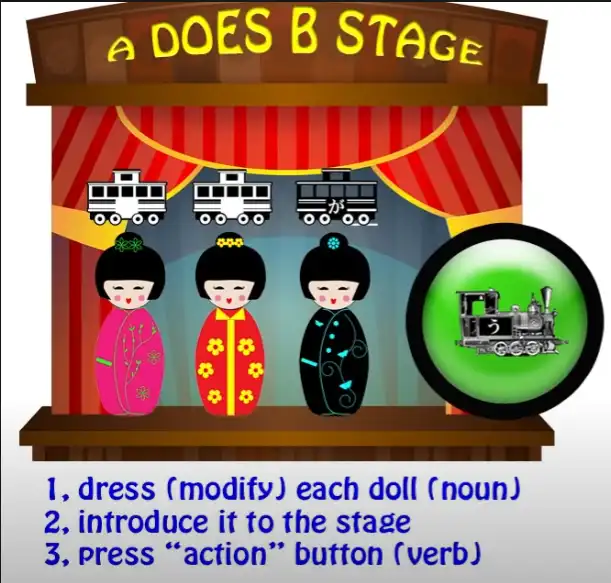
So this is the order of Japanese sentences.
First of all, the information about the actors.
Then the actors themselves.
And if there’s more than one actor, we put its information first and then the actor, and the next one we put its information first and then the actor.
And then finally, if it’s an action scene, if it’s an “A does B” scene, then we put on the action button and we watch the actors going through their parts.
And from the word order we can always tell what’s happening.
If we have a clause that ends in one of the Engines, a Verb, an Adjective or a Noun plus Copula, we know that that is a logical clause.
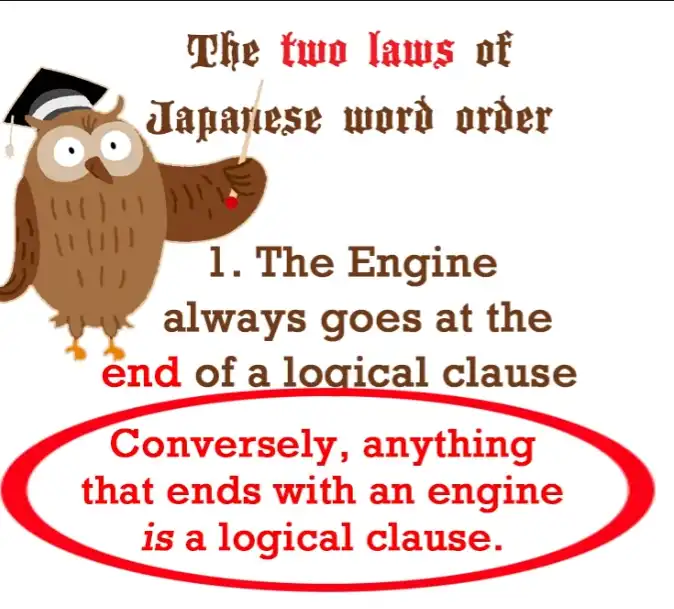
But if it’s turned around in any way, if it’s ending in a noun and not in an Engine, then we know that the noun at the head of that clause is a modified noun and the clause is not functioning as a logical clause.
Let’s take the example we’ve been looking at.
If we say “いちばで(zeroが)青いドレスを買った”, we’re saying “I bought a blue dress at the market.”
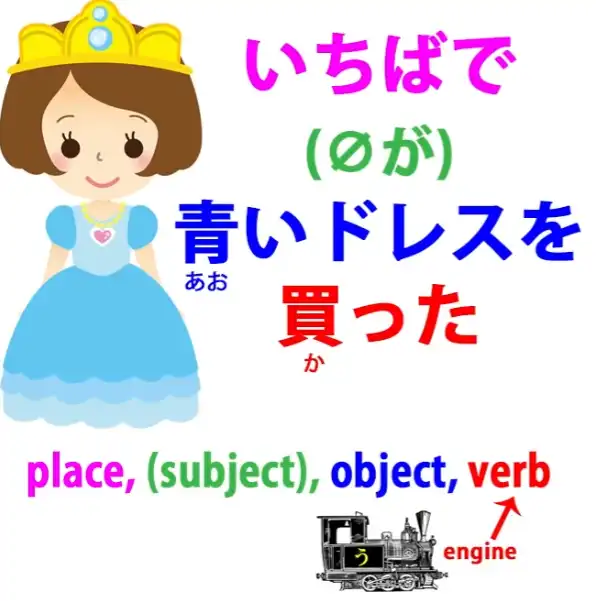
And we know that that’s a logical clause because of Rule One.
So this is a logical clause ending with an Engine.
It’s an “A does B” clause: “I bought a blue dress at the market.” Now, we can move almost any element from a logical clause to the front of the clause, that’s to say, to the position nearest the Engine, furthest right in horizontal text, furthest down in vertical text.
We can move it to the head of the clause and if we do that, if we move any non-Engine element to the head of the clause, then it’s no longer functioning as a logical clause, but it’s functioning as a modifier for that element that we’ve moved to the head.
So, if we say, “いちばで(zeroが)買ったドレス”, we’re saying “the dress I bought at the market”.
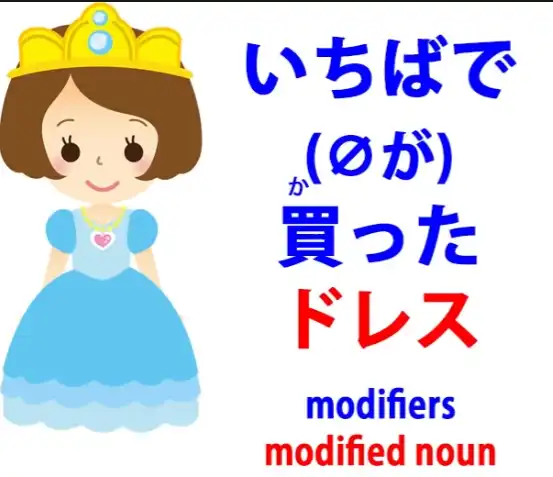
This is no longer a logical clause. It’s a modified noun, and the noun is the dress.
Now, we can just as easily bring the market to the head of the clause.
We can say, “(zeroが)ドレスを買ったいちば”, and now we’re saying “the market at which I bought the dress”.
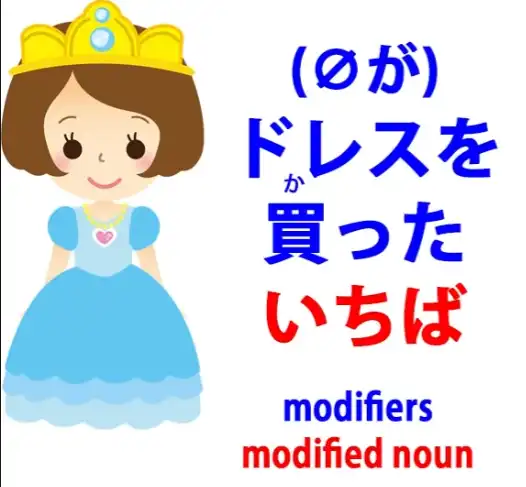
And again, we know this isn’t a logical clause because it doesn’t have an Engine at the head.
At the head it has a noun, and so that noun must be modified by what is going before it.
And since it’s not a logical clause, in order to make a logical clause we have to have something else after it.
And that again could contain modifications.
Because Japanese does things with these modifications that in other languages are done in other ways.
So almost any complex Japanese sentence is going to be heavily dependent on these premodifiers.
And knowing what is modifying, what is being modified, knowing whether something is a modified noun or whether we’re looking at a logical clause – all this is dependent on word order.
So, the full clause here might be:
“(zeroが)いちばで買ったドレスをメガネをかけている少女にあげた.”
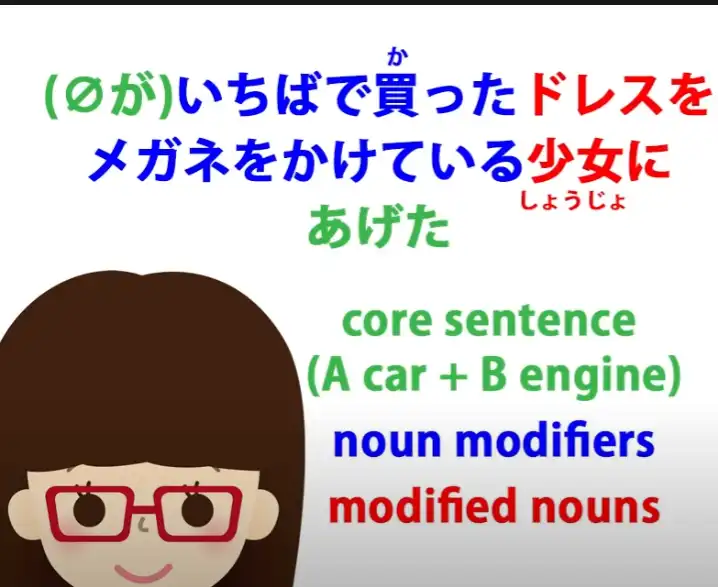
So then we’re saying, “I gave the dress that I bought at the market to a girl wearing glasses.” And once again, we have what could be a logical clause – “少女はメガネをかけている”, “The girl is wearing glasses” – but we’ve taken the noun “少女” – “girl” – to the front, so now it’s not a logical clause, it’s a noun with a modifier, the girl (少女) modified by the phrase “メガネをかけている” – “girl wearing glasses”.
“I gave the dress I bought at the market to a girl wearing glasses.” And this is very typical.
You’re going to see this kind of construction all the time.
The way Japanese does an awful lot of the work of conveying things is by using these modifying clauses, which always come before whatever it is they’re modifying.
First of all we dress the doll, then we put the doll on the stage, then we press the action button.
So, word order is crucial to understanding Japanese…
47. How to Understand Japanese: Your Secret Weapon for breaking down sentences
How to Understand Japanese: Your Secret Weapon for breaking down sentences - Lesson 47
こんにちは。 Today we’re going to talk about the secret weapon that will allow you to grasp any Japanese sentence regardless of how complex it may appear to be.
A lot of Japanese sentences in fact appear much more complicated than they really are because of what I call the modular or modification structure of the language.
But once we understand how it really works this structure stops being our enemy and becomes our friend, because it allows us to break down any complicated Japanese sentence into something that’s really laughably simple.
I told you right from the beginning of this course that every Japanese sentence consists of two elements, and they are the A-car (the subject) and the B-engine.
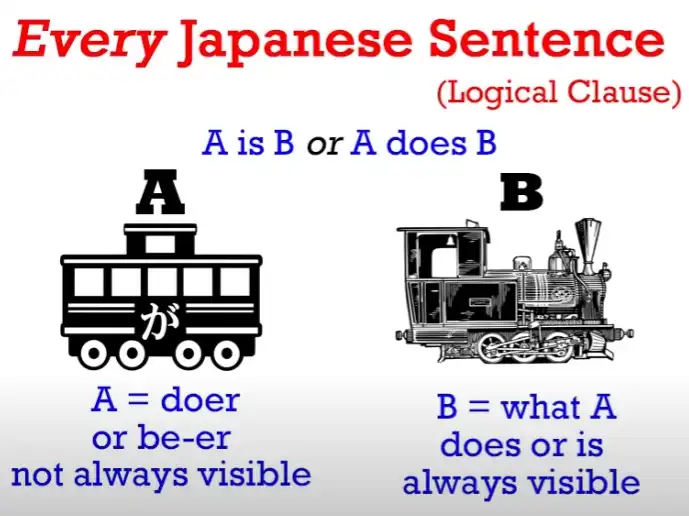
The A-car is always marked by が.
We can’t always see it, but whether we can see it or not, it’s always logically there and it’s always marked by が.
The B-engine can be one of only three things.
It can be a verb, an adjective, or a noun-plus-copula “だ” or “です”.
There are only two kinds of sentences: “A is B” and “A does B” sentences.
In an “A does B” sentence, A is the thing that does B, which is the engine, which has to be a verb.
In an “A is B” sentence, A is the thing which is B, which has to be an adjective or a noun-plus-copula.
Now, we’ve seen much more complicated sentences since then and we’ve seen how every one of them has this same A and B as its fundamental core.
But the important thing we are going to look at today is the fact that A and B are not just the core of the sentence: they are the sentence.
Everything else is doing nothing other than telling us something more about A or something more about B.
Now, the only other thing that can complicate this at times is the fact that when we say “a sentence” what we actually mean is a logical clause.
Now, we sometimes use those two terms interchangeably and we very often can use them interchangeably, but the difference is this: a logical clause is by definition a complete sentence, that’s to say, we could put a “○ / まる” or a period at the end of it and then it’s a sentence.
It can stand on its own; it’s grammatical; it doesn’t need anything else. It is a sentence.
But the reason we call it “a logical clause” is because a sentence can contain more than one logical clause. That’s to say, it can contain within itself two elements that could each be a complete sentence.
Now, a very simple example of this is if we say “(zeroが)お店に行って(zeroが)パンを買った”, which in English is “I went to the shops and bought bread.”
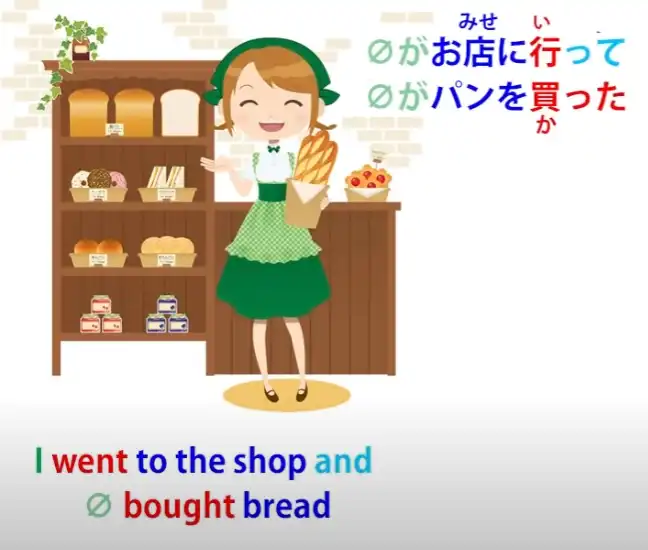
Now, in both English and Japanese, this is two logical clauses made into one compound sentence.
And I’ve talked about compound sentences in another video.
So what we have here is the logical clause “(zeroが)お店に行った” – “I went to the shops” – and “(zeroが)パンを買った” – “I bought bread”.
In English this is “I went to the shops and I bought bread”.
Now, in Japanese we don’t need to have the “I” visible but it has to be logically there and it logically carries the particle が.
We sometimes say that English requires the subject to be visibly present in every clause, but this isn’t actually true, although it’s close to being true.
And this is an example of how it isn’t always true.
English actually does use the zero pronoun just as Japanese does.
It just doesn’t do it nearly so often.
So with this sentence in English we don’t normally say “I went to the shops and I bought some bread”.
We usually say “I went to the shops and bought some bread”.
So you see here that English is actually using the zero pronoun.
We don’t have to say “I” twice.
We’re allowed to carry it over from context to the second clause of the sentence just the way Japanese much more freely allows us to do that.
But in all cases the subject is there.
Bread isn’t buying itself. I’m buying it, whether I am visibly there as the subject or not.
So one skill that we need for understanding a complex sentence is the ability to see where logical clauses end, to see when something is in fact a complete logical clause with its own A-car and B-engine.
And I’ve done a whole video explaining how to do that, so you may want to watch that video after you see this one. (Lesson 34) Today we’re going to concentrate on the logical clause and the ways in which it can apparently become complicated.
Last week we were talking about the concept of modifiers and we were talking about it in its perhaps simplest and most approachable form, which is noun modifiers.
And to understand modifiers you have to understand word order in Japanese because Japanese word order is extremely important. As sentences become more complex, you have to understand word order to understand what they’re doing.
So these people who tell you that Japanese has no set word order or that Japanese is an SOV language are really leading you up the garden path because neither of those statements is true, as we discussed last week. (Lesson 46) So the first law of Japanese word order is that the engine of the sentence, which can be a verb, an adjective or a noun-plus-copula, always has to come at the end of the sentence.
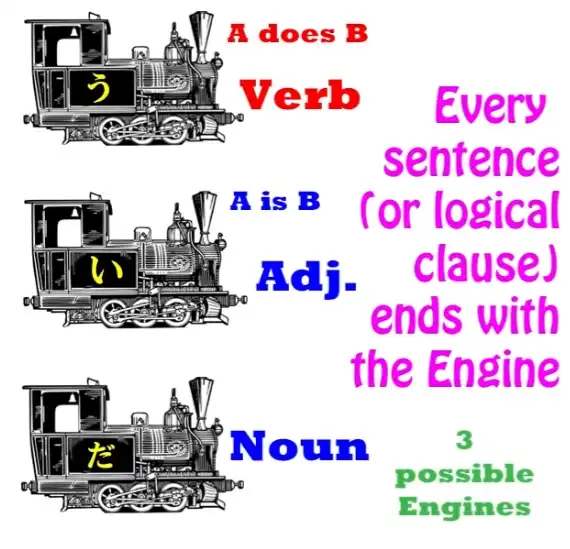
And the second law, and this is the most important one for our present purposes, is that anything that modifies anything has to come before it.
Now, last week, the form I put this in was “Anything that modifies any *THING* has to come before it”, that’s to say, anything that modifies a noun has to come before that noun.
But we can take this further, and that’s what we’re going to do this week.
And we can simply say “Anything that modifies ANYTHING always comes BEFORE it”.
It doesn’t have to be a noun.
What else could it be?
Well, it could be the head verb of the sentence.
So, let’s go back to a somewhat complex sentence that we analyzed last week.
“(zeroが)いちばで買ったドレスをメガネをかけている少女にあげた.” – “I gave the dress I bought at the market to a girl wearing glasses.”
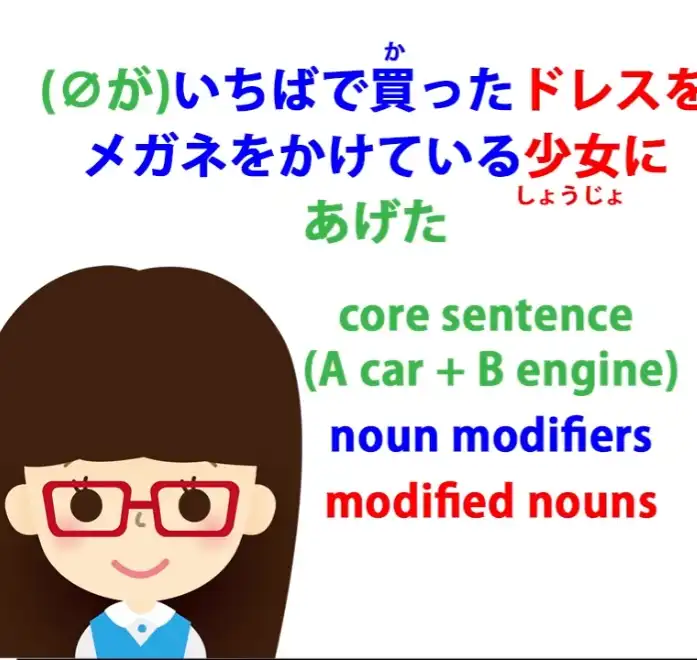
Now, I colored this in order to show the process of noun modification.
In this sentence we have the A-car, which is invisible (it’s “I’’, zeroが), and we have the engine, which is “あげた”.
And that is the sentence core: “I gave”.
Now, inside the sentence we have two nouns and they’re both modified by more information. And in both cases that information is given by taking a logical clause and pulling out one element and putting it at the head of the sentence, at the engine end of the sentence.
So we could say “いちばで(zeroが)ドレスを買った” and then we have the engine at the end and we’re saying “I bought a dress at the market”, but we can also pull out any element from that sentence and put it at the end and that becomes a modified noun.
So we can say, as we’re saying here, “いちばで(zeroが)買ったドレス”, which means “the dress I bought at the market”.
We could also do the same thing with the market: “(zeroが)ドレスを買ったいちば” – “the market at which I bought the dress”.
And neither of these is a logical clause, because it couldn’t stand on its own as a sentence, could it?
It’s now a noun which has to play some role in a larger sentence.
So, the blue elements here are the modifiers, the red elements are nouns that are marked with logical particles. (the last picture still) And here is this fundamental radical fact that you need to take a moment to ingest.
In an “A does B” sentence, the nouns marked by the main logical particles other than が, that is, by を, に, で, and へ, are all modifiers for the verb.
The logical particle が tells us what the subject of the sentence is, what the A-car is.
The logical particle の is an exception here because what it does is couple two nouns.
But the main verb-sentence logical particles, を, に, で, and へ, do one thing and one thing only.
They modify the verb; they tell us more about it.
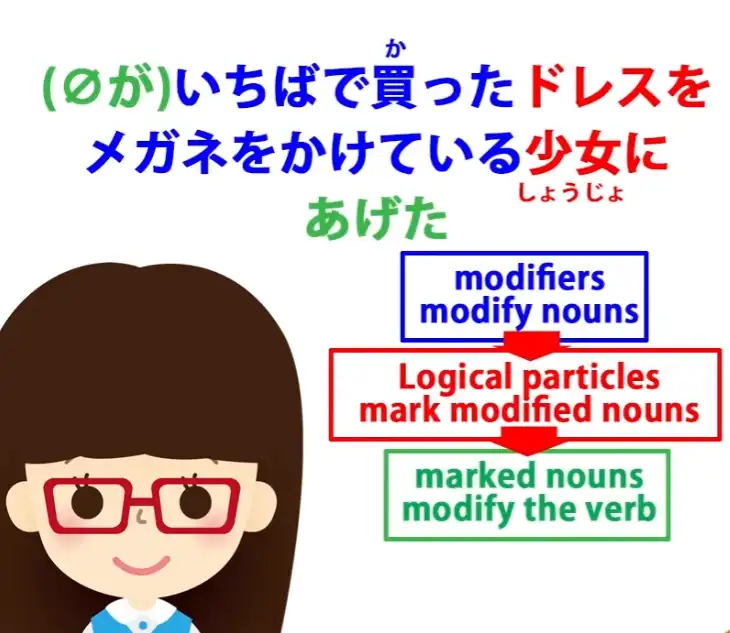
So in this sentence, the sentence itself is “I gave”, and then these modified nouns provide more information about that verb “gave”.
Note: - I’ll give the direct Japanese sentence examples here, but take them with a grain of salt.
(zeroが)あげた
“I gave.” What did I give?
The を-marked (direct) object tells us this: “I gave a dress”.
(zeroが)ドレスをあげた The modifier tells us more about the dress: “the dress I bought at the market”.
いちばで(zeroが)買ったドレス (if unclear about zeroが here, check L.46 Rule 2 section) To whom did I give it?
The に-marked indirect object tells us that: “I gave it to a girl”.
(zeroが)少女にあげた
What kind of a girl?
Well, the modifier tells us more about the girl: “the girl wearing glasses”.
メガネをかけている少女。。。 So, the sentence itself is “(zeroが)あげた” and everything else is telling us more about “あげた”.
And however long and complicated it gets, that structure always stays the same.
We have to identify the engine of the sentence and that’s very easy because the engine of the sentence is invariably at the end of the sentence.
It may have a couple of sentence-ender particles after it (and I’ve done a video on that) but the logical end of the sentence is the verb, the adjective or the noun-plus-copula that is the last one in the sentence.
So we always know where to find the engine: it’s at the end of the sentence.
And the A-car is whoever is doing that verb or being that adjective or noun-plus-copula.
Now the other useful thing to remember is that it’s usually easy enough to find even an invisible actor because it’s not going to have anything behind it.
In this sentence, as we see, there’s a lot of modifying going on but it’s all modifying the verb.

We can’t have anything modifying the A-car, the が-marked actor, because the が-marked actor isn’t visible and we can only modify something that we can actually see within a sentence.
*Note: I may not be fully getting what Dolly means here by zeroが not having anything behind it, since she does give examples (in L.46) where invisible が actors have something before them - even in logical clauses, such as the place - いちばで(zeroが)青いドレスを買った in L46.
I think what she means is simply that this would not work without the mentioned 私が because the dress is being modified by the entire pre-modifier “私がいちばで買った” which is a pre-modifier for dress, instead of its own full clause forming a sentence on its own as it would be if it were - 私がいちばでドレスを買った。Where the verb is the last as the head of the clause.
Here instead it is just a pre-modifier, and the head verb of the clause is あげた at the end.
*So if we wanted to modify both elements of the sentence we’d need to make the first one visible.
Let’s try doing that.
“あのさくらをなぐったみにくい外国人は(zeroが)私がいちばでかったドレスをメガネをかけている少女にあげた.” – “That ugly foreigner who hit Sakura gave the dress I bought at the market to a girl wearing glasses.”
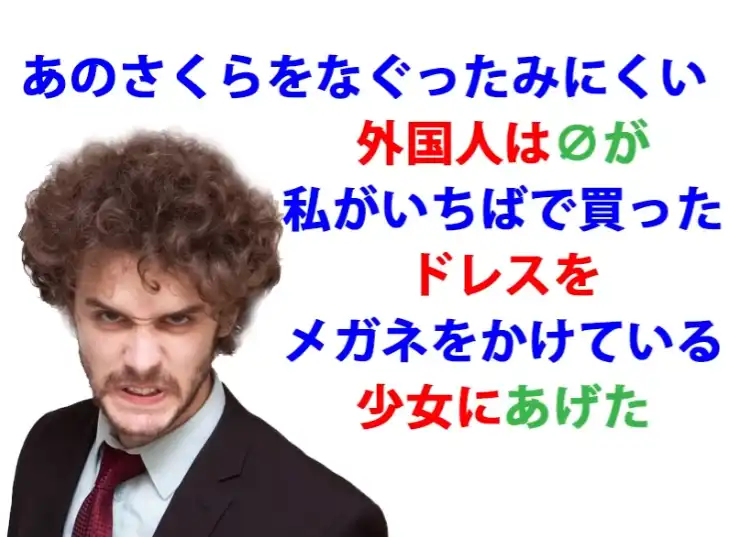
Now we’re starting the sentence out with a non-logical topic marked by は.
But what that topic is doing is defining for us the zero pronoun, the が-marked A-car of the sentence, which is zeroが.
Now, we could say, “みにくい外国人がさくらをなぐった” –“An ugly foreigner hit Sakura” – but what we’re doing here once again is we’re pulling out one of the elements, in this case “外国人”, and putting it at the end of the clause, so it isn’t a functional logical clause, it’s a modified noun: “the ugly 外国人 who hit Sakura”.
So it’s telling us more about that 外国人: “As for that ugly 外国人 who hit Sakura, he did…” What did he do?
“He did..” – that’s “zeroが” – “he did…” and then we say what he did.
*Note: I am going to put this comment here.
*
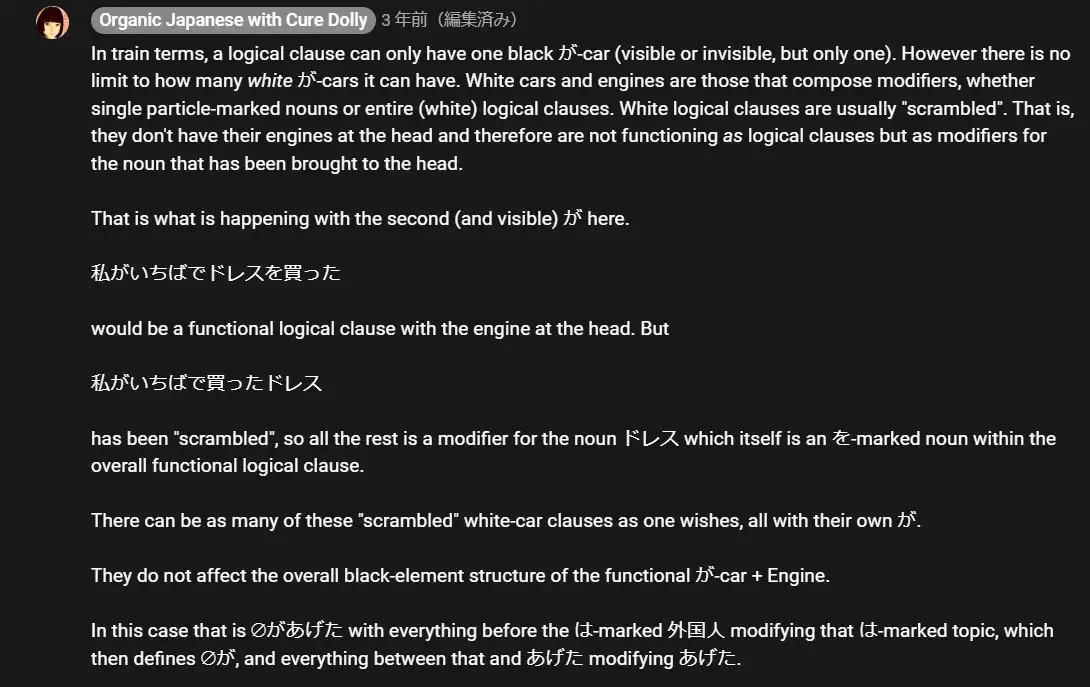
And let’s notice that everything, everything in this sentence apart from the core consists of what we might call “serial modification”.
Even the word “外国人”, which is so often seen together that we tend to regard it as a word in itself, and it is a word in itself, is in fact an example of serial modification, one thing modifying the thing that comes after it.
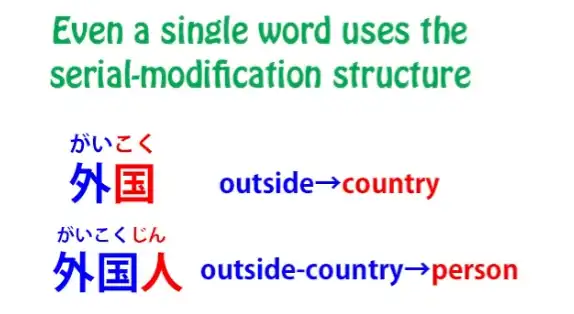
So, “コク/国” is the on-reading of “くに/国” – “country”.
“外国” – in “外国”, “外” modifies “国”.
What kind of a country was it? An “outside” country, a “foreign” country.
And then, “ジン/人”, which is the on-reading of “ひと/人” – “person” – is modified by these two together.
What kind of a person was it?
An “outside-country” person, a person “from a foreign country” – “外国人”.
So, everything in this sentence is modifying whatever comes after it, until we get to the A-car, and then we have the first fundamental element of the sentence, and then everything after that is then modifying the engine.
And that’s all that can ever happen.
This is how every Japanese sentence is structured.
We have the A-car, we have the B-engine.
If there’s anything modifying the A-car it comes directly before it.
If there’s anything modifying the B-engine, it comes directly before that.
Every noun marked with a main logical particle,
the detectives of our logical particle video (Lesson 8b):
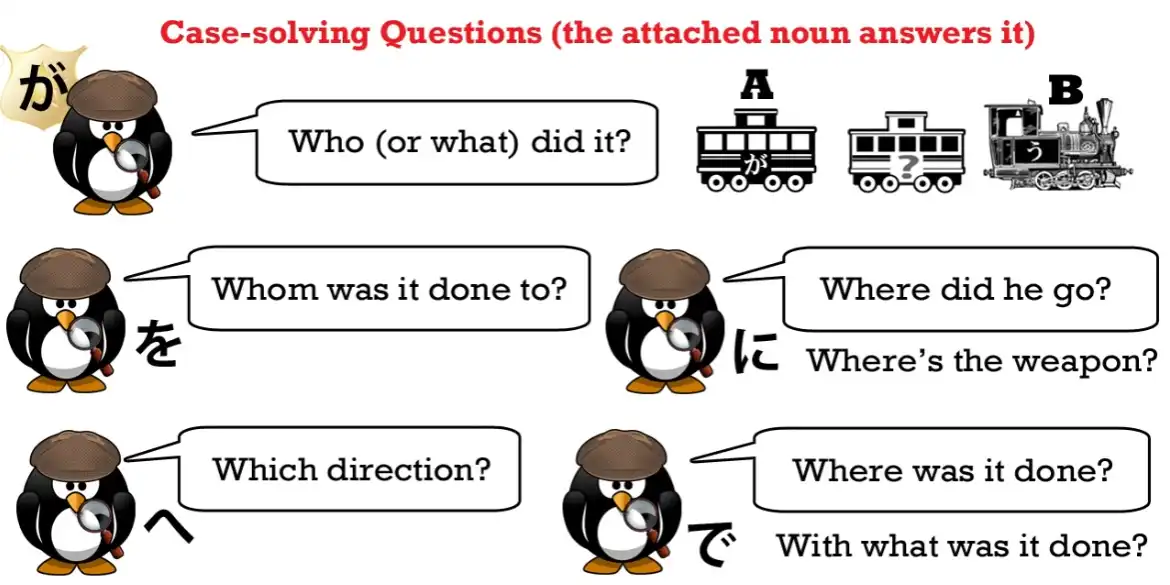
を, に, で and -へ, are in fact modifying the verb.
They’re telling us more about the verb, and I said in that video that these logical particles – other than が, which gives us the subject of any sentence, and の, which links together two nouns – these four fundamental logical particles only work in verb-sentences, “A does B” sentences.
Or, in detective terms, they only work on cases.
And that’s because their function is to tell us more about the verb, to modify the verb.
So, every sentence has this same structure: the A-car, the B-engine, the things that are modifying the A-car, and the things that are modifying the B-engine.
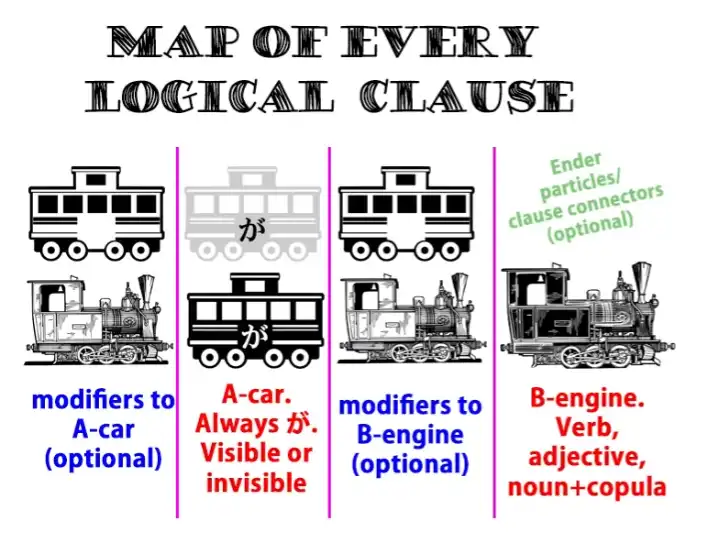
And there’s nothing else that can be in a sentence except for things like sentence-ender particles.
But there may be more than one logical clause operating in a sentence and, as I say, identifying logical clauses is not complicated…
48. Dealing with ambiguity in Japanese
Dealing with ambiguity in Japanese 3 Laws that Make Everything Clear! Lesson 48
こんにちは。 Today we’re going to talk about ambiguity in Japanese, because this is something that makes the language much harder to understand for many non-Japanese learners.
Now, Japanese has a reputation for being an ambiguous language.
And whether this is true or not, the perception of ambiguity makes sentences harder to understand.
So, I want to look at real and perceived ambiguity in Japanese and how to deal with it.
Japanese people don’t have any difficulty in understanding each other, and there’s no reason for you to have any difficulty either.
A lot of the perceived difficulty comes from the fact that it’s taught in such a way as not to explain the real structure of the language.
So let’s look at some different aspects of real and perceived Japanese ambiguity.
Probably the first thing that makes Japanese feel ambiguous and difficult to foreigners is the zero pronoun.
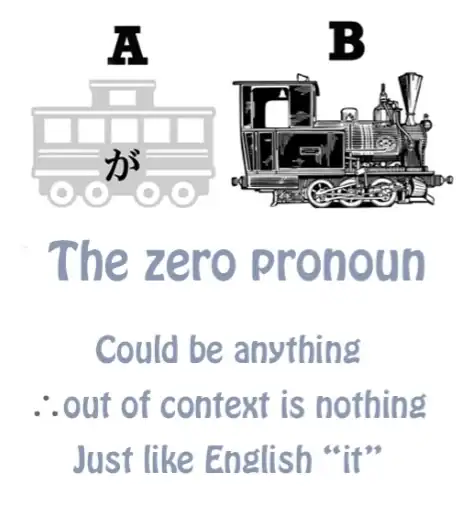
It’s so confusing to many people that there are intelligent and respectable teachers of Japanese on the Web who even go so far as to claim that Japanese has no grammatical subject.
It certainly has a grammatical subject and it’s present in every sentence.
The thing is that you can’t always see it.
Now, I’ve explained before that this is really that the Japanese invisible pronoun (or zero pronoun) is no more confusing than English “it”.
The word “it” could mean the Andromeda galaxy, it could mean a tree, it could mean my kneecap (I do have kneecaps), it could mean a chimpanzee’s tail, assuming chimpanzees do have tails, and even if they don’t it could be an imaginary chimpanzee’s tail.
The point is that because “it” can mean just about everything, it actually means nothing except in context.
And that’s exactly how the zero pronoun works.
And one is no more ambiguous than the other.
But some people are going to say, “But the fact that you can’t see it means that we don’t even know whether it’s there or not.” And the answer to that is that yes, we can know.
So long as we understand the structure of the language, we know it’s there because it has to be there.
It’s logically there.
So there’s no difficulty at all about pinpointing the zero pronoun provided we understand the structure of the language.
And one of the difficulties of course is that conventional Japanese grammar textbooks and websites don’t teach the real structure of the language and so they leave us in doubt on this as on many other subjects.

But that’s what my course is for, so if you follow my course or have followed my course you should be clear enough about the structure of the language.
So, can the zero pronoun ever cause ambiguity?
Yes, it can. Just as “it” can in English.
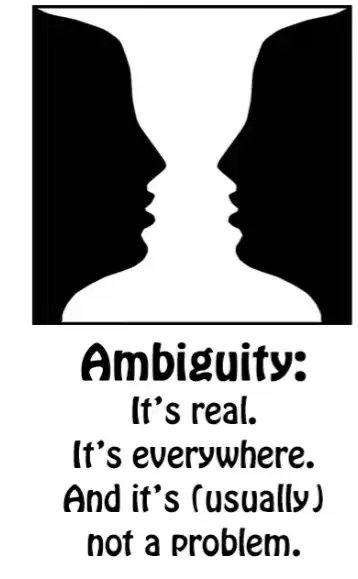
For example, if I say, “My right antenna was so broken that it fell off” (you haven’t seen my antennae, have you? Well, they’re a bit of a secret, so let’s pass on) “My right antenna was so broken that it fell off”, you know from context that “it” refers to my right antenna.
But suppose I say, “I was trying to fix the door handle, but my right antenna was so broken that it fell off.” Then you may not know whether I mean that my right antenna fell off or that the door handle fell off.
And this kind of ambiguity can occur in any language, and really no more in Japanese than any other language.
What do we do about it when it does occur?
The Context Rule
Well, fundamentally it’s up to the speaker to make herself clear or the listener to ask her to clarify if she hasn’t made herself clear.
If you’re watching anime, reading books or playing games or in general dealing with any kind of professional writing or speaking, people will make things clear unless they actually want to play games with ambiguity.
So this is just the same as English or any other language.
There’s nothing special about Japanese in this context.
If we go back to the example we used right back in our first lesson about the non-logical は topic marker, “私はうなぎです”.
“私は(zeroが)アメリカ人です” means “I am an American.” / As for me, (I) American-am “私は(zeroが)うなぎです” does not usually mean “I am an eel.” As for me, (food?) eel-is
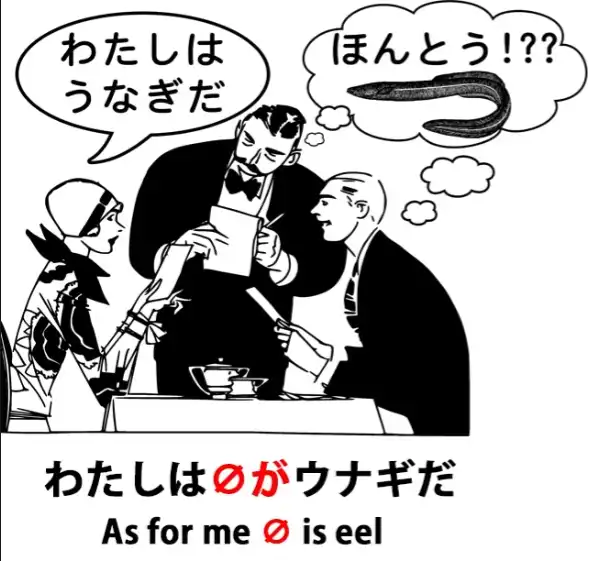
If it’s spoken in a restaurant and the topic of conversation is what we’re going to eat, then it’ll be understood that the zero pronoun of that sentence is not “私” but the thing we’re talking about: what we’re going to have to eat.
Could it ever mean “I am an eel”?
Yes, it could.
For example, if I go up to a stranger in the street and point to my nose (which is the way in Japan you indicate yourself) and say, “私はうなぎです”, they would know that I’m saying that I’m an eel and they’d probably think I was a little strange, because I don’t look like an eel.
I look a bit like a human but I hope not very much like an eel.
Now, if in a restaurant we weren’t talking about food at all, maybe about the weather, and I suddenly say “私はうなぎだ”, people would probably still understand me to mean that I have decided I want to eat eel.
So, how does this work?
Well, in Japanese – and it’s just the same in English or any other language – we have three rules that we apply to interpreting sentences that can be in any way ambiguous.
And they are: context, probability, and the absurdity rule.
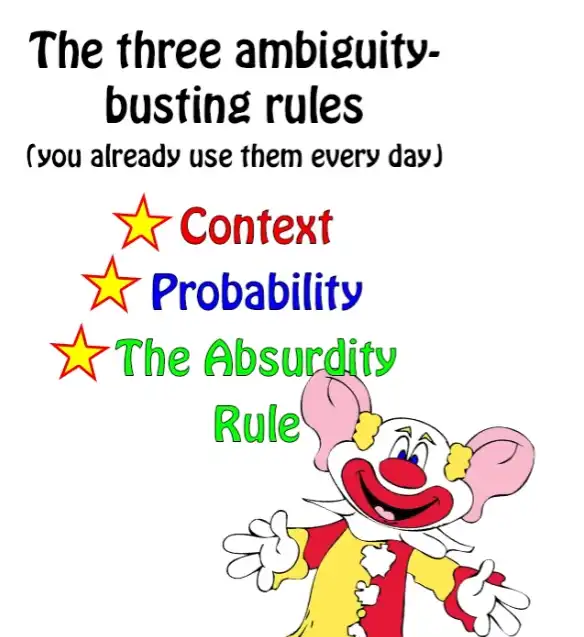
Context is the obvious one that we’ve already discussed.
If I say “My left antenna was so broken that it fell off”, you know from context that “it” means my left antenna.
The Probability Rule
Probability is the fact that when two possibilities are both possible and context hasn’t actually told us which, we’ll go for the one that’s most probable.
And this isn’t just an accident.
This is something everybody knows about language.
So listeners do it, speakers expect listeners to do it, and language is tailored to work with those rules – in Japanese or in English.
So there’s nothing mysterious about it.
So, for example, if I say “I saw a man on a hill with a telescope”, probably you would interpret this as meaning I used the telescope in order to see the man on the hill.
So that’s probability, I haven’t actually said anything to indicate that interpretation, but it’s the most likely default interpretation.
However, if you said to me, “Do you think we’re being watched?” and I said, “I think we are.
I saw a man on a hill with a telescope”, then you would probably interpret me as saying that I saw, with my naked eye, a man on a hill who had a telescope and therefore was probably watching us.
Now, there are other interpretations too.
I could have meant I saw a man on a hill that had one of these public pay-telescopes on it, so “a hill with a telescope” would be where I saw the man.
And one could even mean that I use a telescope as a saw to cut a man on a hill.
Now, the last one, like “I am an eel”, is somewhat absurd and so that comes very low down the scale of anybody’s making that interpretation. Context also helps here
The Absurdity Rule
And the absurdity rule is that the burden of expression lies with absurdity.
And this is similar to the legal dictum that the burden of proof lies with the prosecution.
In other words, we assume the defendant to be innocent unless we can prove that they were guilty.
Similarly, we assume a statement not to be absurd unless there is clear evidence that absurdity is intended.
So, for example, “I ate dinner with Sakura last night” is not generally considered to be an ambiguous sentence.
“I ate dinner with chopsticks last night” is also not considered to be an ambiguous sentence.
But you can see that they are structured identically but they work differently.
Now, if I wanted to say “I ate dinner with Sakura last night” meaning I used Sakura as an eating implement or if I wanted to say “I ate dinner with chopsticks last night” meaning a friendly animated pair of chopsticks was my dining companion, it would be incumbent upon me to make that clear.
I cannot convey to you the idea that I used Sakura as an eating implement by saying “I ate dinner with Sakura last night”.
You will always put the more probable and less absurd interpretation on it.
Language reserves the right, and must reserve the right, to express the improbable and the absurd.
Otherwise language would have whole areas that it would be unable to express.
But the further you go from the norm, the higher is the incumbency upon the speaker to make what she is saying clear.
So if I really want to say that I used Sakura as an eating implement, I would have to say “I had dinner last night and I used Sakura as a pair of chopsticks.” Anything with any ambiguity at all is going to have the absurd possibility ruled out.
Now, this isn’t logic, it isn’t grammar, but it is the way human languages work – English, Japanese, any other language.
To take a specific example in Japanese, something that sometimes troubles people is the fact
that the ICHIDAN potential helper verb “-られる” and the Ichidan receptive helper verb
“-られる” are identical.
*Note: For Potential, check Lesson 10, Godan potential is え-stem + -る. For Receptive L13.
*

Note: There is also a mistake in the video’s picture where it says that both attach to the あ-stem (Godan verbs), but Potential attaches to the え-stem, whereas Receptive goes to the あ-stem. And people often think, “Well, this is really worrying. The two are the same. How am I ever going to know which is which?” And part of the problem here comes from the whole textbook approach to Japanese, which has to do with learning things in the abstract and dealing with these cut-off, isolated, out-of-context sentences.
Although we need to learn structure, the way we learn Japanese is from immersion in Japanese, using real in-context Japanese language.
So, let’s look at this “-られる” problem.
For example, “食べられる”: “食べられた”, if it’s the potential, can mean either “I was able to eat” or “I was able to eat (something) / I was able to eat (this particular thing)”.
On the other hand, if it’s the receptive, it means “I received the action of eating”.
In English we would say “I was eaten” or “I got eaten”, which is closer to the Japanese.
It tends to get translated as a passive sentence – “I was eaten” – in English.
What it actually means is literally “I got eaten / I received the act of being eaten”.
And if we think of it as passive, we’re going to get very messed-up with the structure of those sentences.
But that’s not really the subject of this video and you can watch my video on the Japanese receptive to clarify all this. Lesson 13 The ambiguity here is that if I say “食べられた” I could mean “I was able to eat” or I could mean “I got eaten”.
Now, in this case the absurdity rule comes into play: I could be saying that I was eaten but considering that I’m standing here telling you that, it’s not very probable.
So I would have to say something more than that in order to get you to register the possibility that I could say that I had been eaten.
So this is a simple case where the absurdity rule and the likelihood rule will determine what’s being said and from probabilities of the particular case we’re talking about.
There can be cases where there’s real ambiguity.
For example in the case of a pet mouse.
If we say “ネズミが食べられた”, we could mean that the mouse was able to eat something we gave her or able to eat in general or it could unfortunately mean that the mouse got eaten, perhaps by a cat.
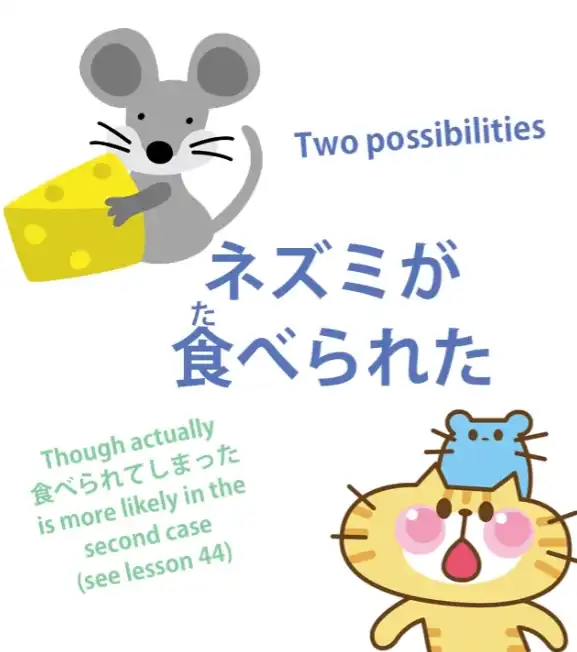
How do we resolve this ambiguity?
Well, we can’t do it structurally.
Just as in the telescope case in English, there are some cases where linguistic structural ambiguities are only resolvable by external considerations, the probabilities of the particular case.
Now, people tend to act as if there were something special and strange about this happening in Japanese that would freeze us and make us unable to understand, but that’s no more the case in Japanese than it is in English.
Japanese is not some magical language ruled by strange, impenetrable rules.
It’s just a language, and it’s a far more logical language than English, but like all languages there are many potential ambiguities, all of which are resolved by the speaker, the listener and the situation.
Every now and again there is some genuine ambiguity where somebody can misunderstand, but no more than in English.
Most of the time people communicate what they want to communicate without any difficulty, using both the structure of the language and external probabilities – and also a knowledge of how the language works.
And to give an example of that, in our last lesson we examined the sentence “(zeroが)いちばで買ったドレスをメガネをかけている少女にあげた” – “I gave the dress I bought at the market to a girl wearing glasses.”
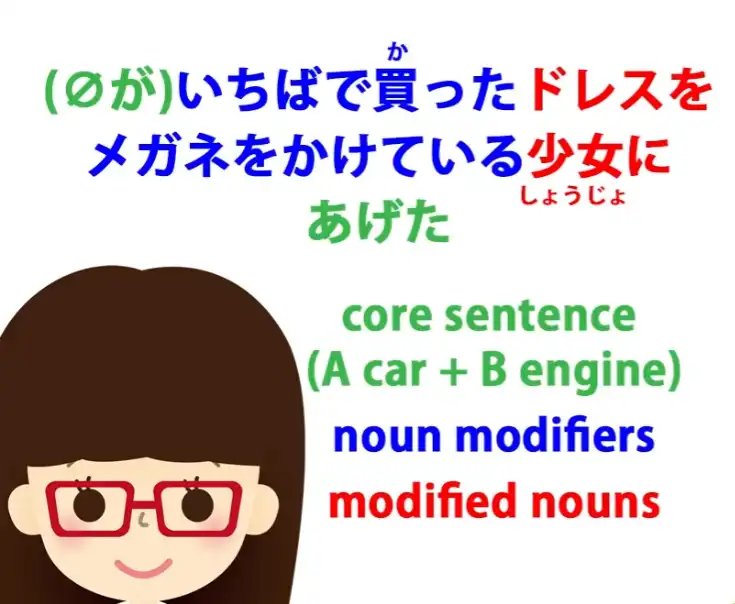
And then we elaborated a more complex sentence:
“あのさくらをなぐったみにくい外国人は(zeroが)私がいちばで買ったドレスをメガネをかけている少女にあげた”
And this means: “That ugly foreigner who hit Sakura gave the dress I bought at the market to a girl wearing glasses.”
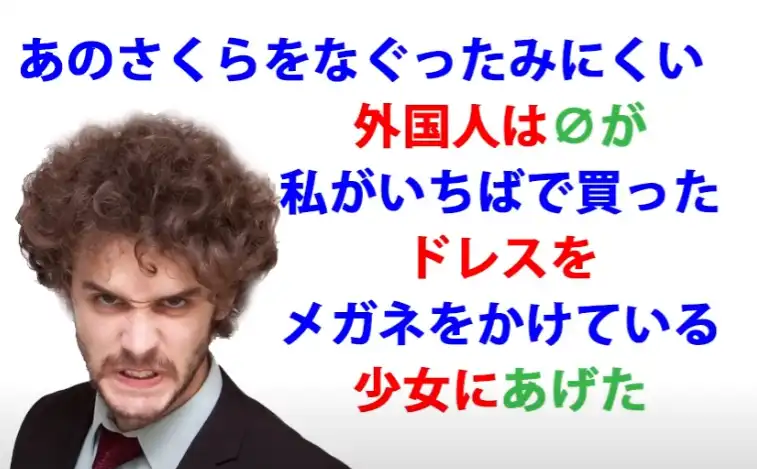
Now, somebody asked me, “How do we know that the first part of this, after ‘the ugly foreigner’, isn’t working just like the original sentence?
How do we know that that ‘私が’ isn’t the subject of the sentence?
Because after all a は-statement is a non-logical statement.
It doesn’t have to be defining the subject of the sentence.
It may be just standing on its own.
So how do we know that this second part of the sentence doesn’t just still mean ‘I gave the dress I bought at the market to a girl wearing glasses’?” And the answer to that is a knowledge of how Japanese works.
Although は-statements are not logical, they are in fact grammatical.
They’re part of Japanese grammar.
When we make a は-statement it has to be related directly to the rest of what we’re saying.
Even in English, for example, if we were to say, “Speaking of the Andromeda galaxy, Sakura’s got a pimple on her nose”, you’d be taken aback, wouldn’t you?
What has Sakura’s pimple got to do with the Andromeda galaxy?
But in Japanese it’s even more so, because the は-statement isn’t just saying “speaking of”.
It’s actually a grammatical connection. So if I were to say, “Speaking of that ugly foreigner who hit Sakura, I gave the dress I bought at the market to a girl wearing glasses”, that makes no sense.
Why are we saying “speaking of the ugly foreigner who hit Sakura”?
Now, it’s possible, just as it’s possible for “私はうなぎだ” to mean “I am an eel” under certain circumstances, it’s just possible, given surrounding circumstances, given something the listener knows that connects the two things together, that it could actually be working this way.
If, for example, it was because of the ugly foreigner being there that we ended up giving the dress to the girl wearing spectacles.
But, once again the burden of proof lies with the unlikely possibility.
Unless we have good reason to think that there’s some connection between the ugly foreigner who hit Sakura and the fact that I gave the dress to a girl wearing glasses, that’s not the interpretation we’re going to put on it.
So again like the telescope sentence in English, we interpret sentences not only according to their strict structure but also according to the circumstances and the likelihoods of the situation.
Because Japanese is a very logical language, I think sometimes people expect that everything should be determined by the structural logic of the language.
But that isn’t the case in Japanese.
It isn’t the case in English.
It isn’t the case in any language.
So in order to interpret sentences with possible ambiguity, we can do this 99% of the time.
We do it in English; we can do it in Japanese.
Japanese people do it in Japanese; we can do it in Japanese.
It’s not a magical language with strange, inscrutable connections.
It’s a language just like English in this respect, that it works by structure but it also works by the everyday common sense criteria of language, which look at context, probability,
and always rule out absurdity unless it’s made very clear that absurdity is intended…
Note: You should have key grammar basics by now. If you have not started yet with input, I HIGHLY recommend starting out now. Refer to introductory links in my document or read all MoeWay. Consuming & using Japanese is crucial for acquisition, so don’t be afraid to plunge in!
49. Japanese Point-of-View Deconfused! -もらう・てもらう
Japanese Point-of-View Deconfused! -もらう・てもらう morau, te-morau - Lesson 49
こんにちは。 Today we are going to talk about something that arises quite frequently and in a variety of different ways in Japanese and causes quite a lot of confusion because of the rather strange way it’s taught in conventional えいほんご / English-language Japanese grammar.
And this is the word “もらう”, which is used in all kinds of different contexts and can be very confusing and difficult for learners to grasp what’s actually going on in these sentences.
Now, part of the reason this is so confusing is that “もらう” is customarily grouped together with “くれる” and “あげる” as if the three belonged together and worked in the same kind of way.
And up to a point this is true.
But dealing with them in this way is actually more confusing than it is helpful.
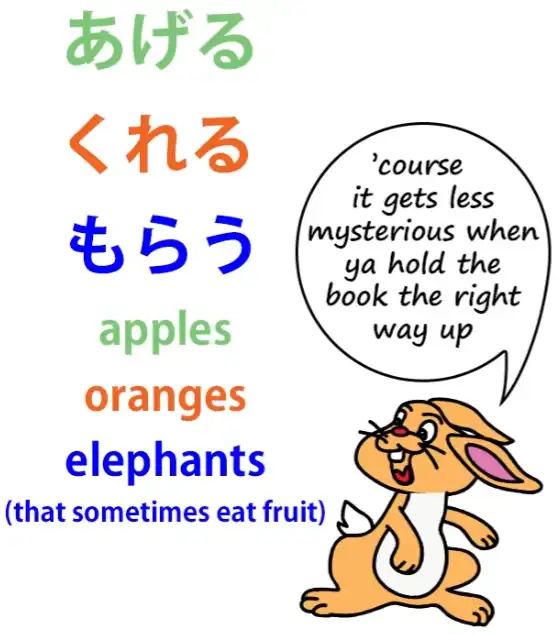
Quite a while ago I dealt with “くれる” and “あげる” (Lesson 11) and at the time I quite specifically didn’t include “もらう” because I believe teaching them together in the way that is common causes a great deal of unnecessary confusion.
I’m going to just run quickly over “くれる” and “あげる” now, and we’ll talk about the ways in which they are similar to “もらう”, the much more important ways in which they aren’t similar to “もらう”, and what we should really be comparing “もらう” to, which will make it much easier to understand a whole range of Japanese expressions and sentences.
So, as we know, “あげる” and “くれる” mean respectively “give up” to someone else or someone else “giving down” to oneself or to one’s in-group or someone one identifies with.
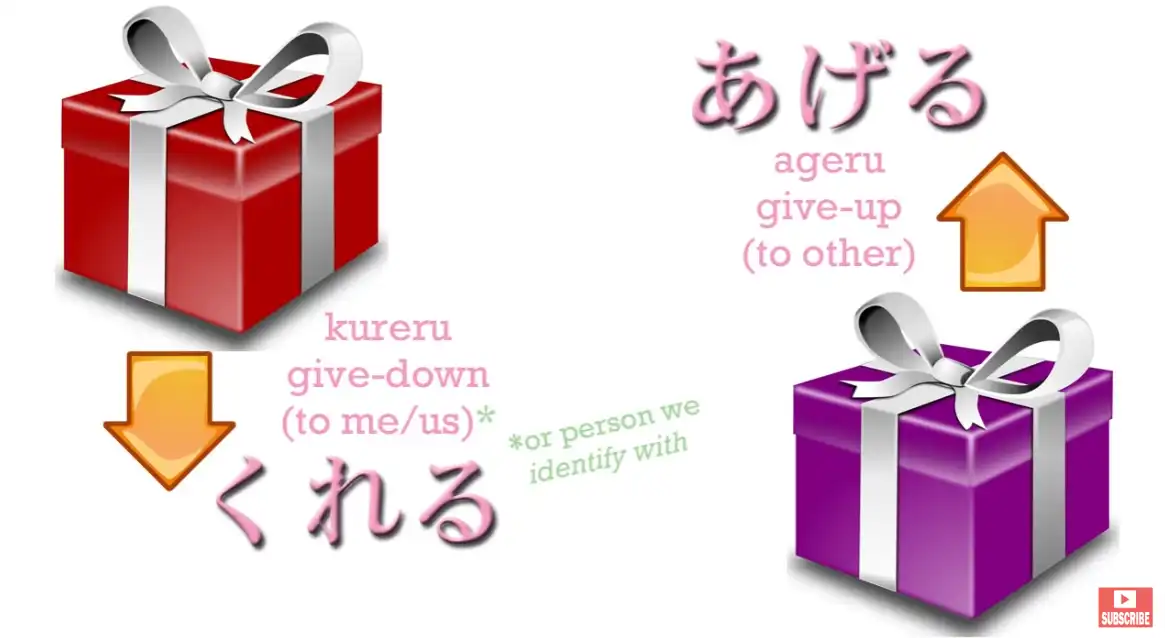
It can refer to giving an actual object, a present or something, or it can refer to giving an action, doing an action for the benefit of another person or another person doing an action for one’s own benefit.
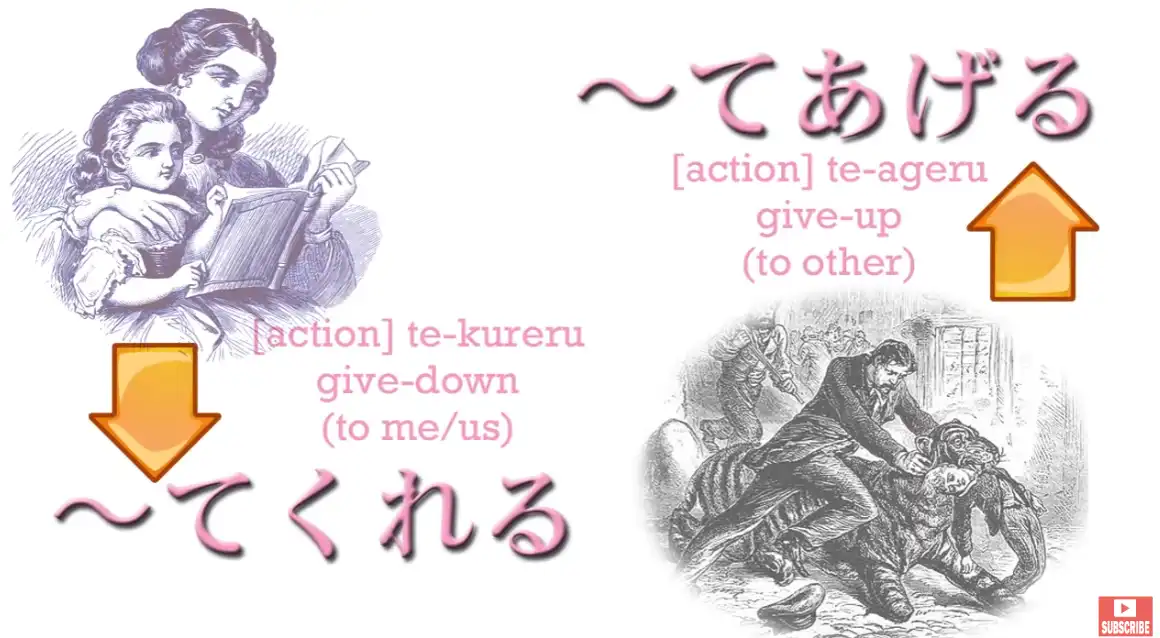
And before we move on from there, I just want to make a little point that people sometimes misunderstand and that is that while giving up and giving down are originally honorific, regarding the other person as higher than oneself, as it were, this origin is so old that it’s almost lost.
So, in a way, despite its honorific origin, we could regard it in a more neutral way, rather like uploading and downloading, downloading meaning towards oneself, uploading being towards someone else.
And the reason for that is that “あげる” is not in fact honorific and it’s generally considered rude if you use it to a superior when you’re talking about an action, because “してあげる” means “doing for the benefit of (someone else)”, doing someone a favor, essentially.
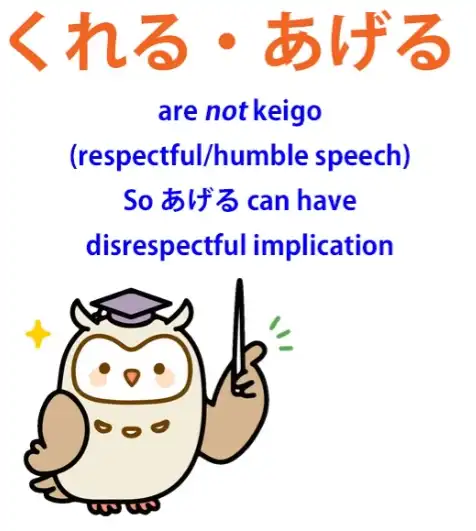
So if you talk to a superior in such a way as to imply that you’re doing them a favor, this is going to cause offence, so we should not regard “あげる” and “くれる” as being actually honorific or humble. They’re not けいご/敬語.
“くれる” can imply gratitude but it doesn’t imply humility.
And “あげる” doesn’t imply honoring the person to whom it’s applied.
All right. So now let’s move on to “もらう”. Note: Kanji is “貰う”. Some texts use it.
もらう・てもらう
Its similarity to the others is simply that it does represent “downloading”.
And while “くれる” is, as it were, a “push” download – someone else taking the initiative to download to you, “もらう” is more like a “pull” download.
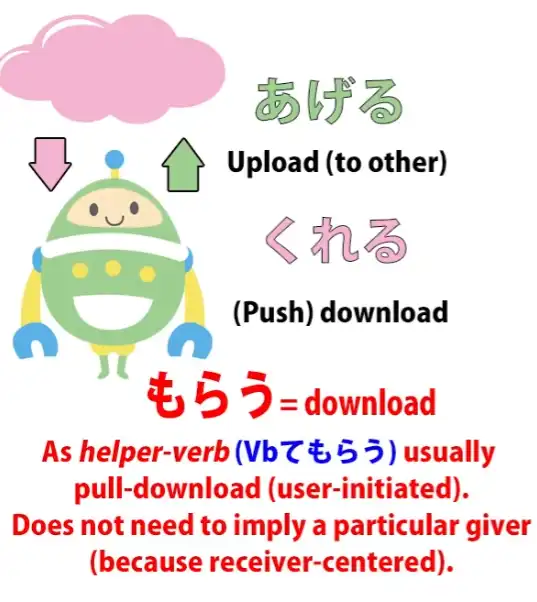
And that really is about where the similarities end, because “もらう” works in many ways very differently from “くれる” and “あげる” and much closer to something else, which we’ll come to in a moment.
When you use “もらう’ with a noun – “receiving something” – it doesn’t necessarily imply a particular giver at all.
If we say “(zeroが)一万円をもらった”, we’re saying “I got ten thousand yen”.
The implication is it came from somewhere, it was given perhaps by someone, or at least it came very easily.
But we’re not saying anything about who gave it to us
or where it came from or how it all came about,
unlike “くれる” and “あげる”, which are bound to a particular giver and receiver.
Now, when we’re using it with a verb, “もらう” contrasts strongly with “くれる” in that “くれる” implies that the giver took the initiative, whereas “もらう”, because the emphasis is on the receiver, implies that the receiver took the initiative.
It’s sometimes translated as “I got (someone) to do (something)”, and that isn’t a bad translation in some cases.
It can also refer to getting a service, which of course you take the initiative, you pay for it, that kind of thing. And I’ll come to that in just a moment.
Let’s notice that if no giver is mentioned, then no giver is necessarily implied.
When a giver is mentioned, the giver is marked by に.
Now, this is exactly the same as the receptive helper verb “-れる/-られる” because “もらう”, like “-れる/-られる” (the receptive, the so-called passive form, which is not passive at all), both of them are in fact about receiving, aren’t they?
So they’re what we might call pull-sentences rather than push-sentences.
In a push-sentence, the に marks the indirect object, the ultimate receiver of the action.
So, if we say “メアリーにボールを投げた”, we’re saying “I threw the ball at Mary”.
The ball is the direct object (what I threw).
Mary is the indirect object (the ultimate receiver of the action).
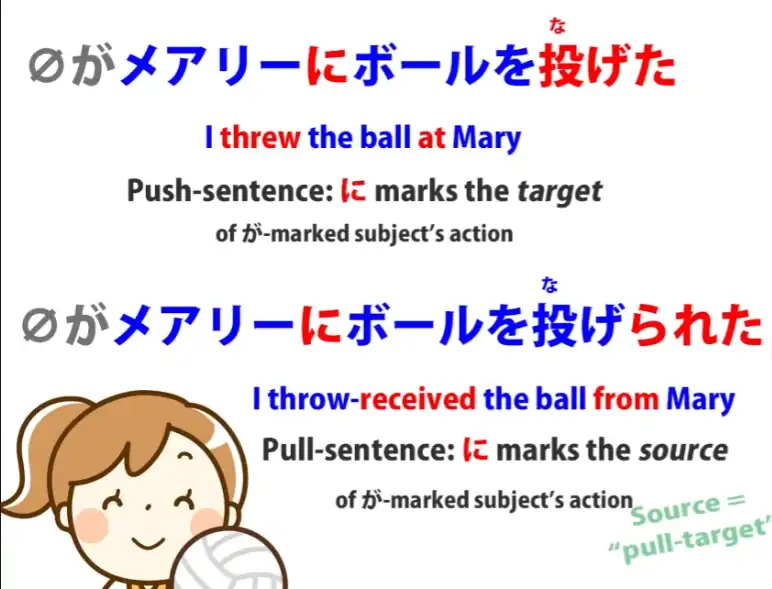
In a pull-sentence, where the receiver is the が-marked actor, then the に-marked person is the ultimate giver, the ultimate source of the action.
So it’s actually much more useful to compare “もらう” to “-れる/-られる”, the receptive helper, because it does almost exactly the same thing.
It takes a verb, adds another, helper verb to it which tells us that the action is being received and the actor of the sentence is doing the action of receiving the action from somebody else.
And this similarity, this likeness, between “もらう” and “-れる/-“られる”” is not pointed out
by conventional Japanese grammar, although it’s really by far the best way of understanding it,
because of course they confuse the whole issue by calling the receptive “-れる/-られる” helper “passive”. It’s not passive, it’s receptive, just like “もらう”**.
Note: Btw. you can’t use both of these receptives at once. Dolly explains in the comments.
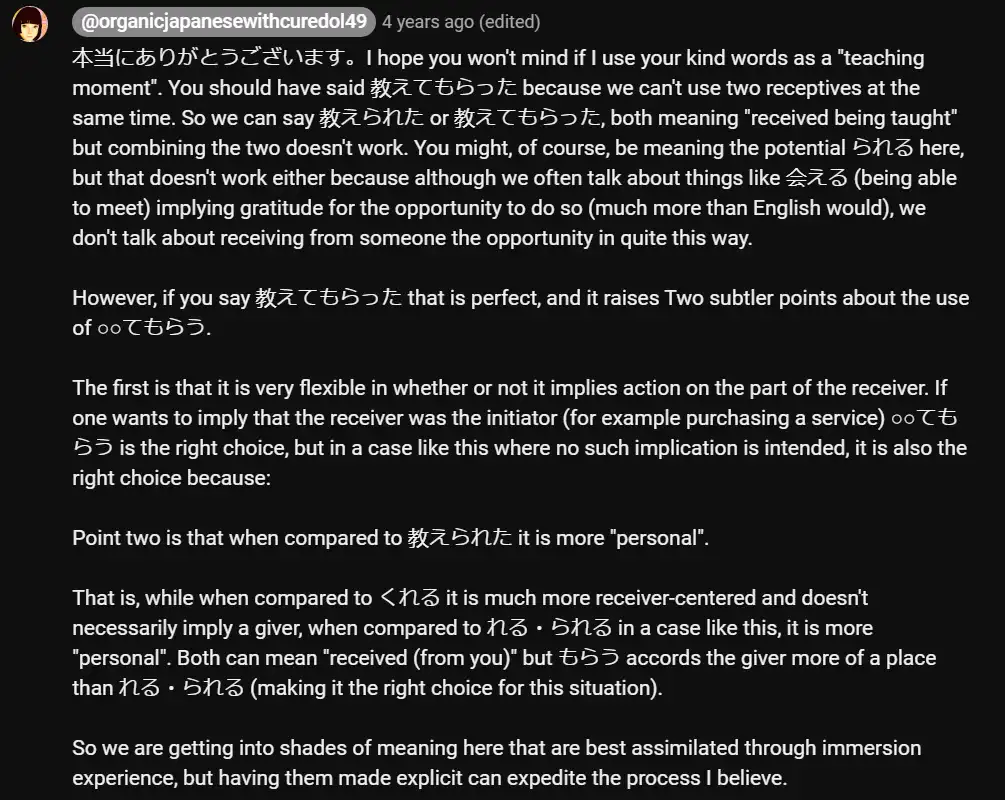
And they work very similarly.
The difference between them is that “-れる/-“られる”” implies that the action just happened to us. We may or may not have wanted it, but it wasn’t really our doing.
“もらう” implies that we took the action, that we actively brought the action upon ourself from somebody else; we got them to do it for us.
So let’s talk about receiving a service.
A very, very common expression is “(zeroが)お医者さんに見てもらう” which is translated in dictionaries and English grammars as “see a doctor”.
And this is a terrible, terrible, terrible, irresponsible translation.
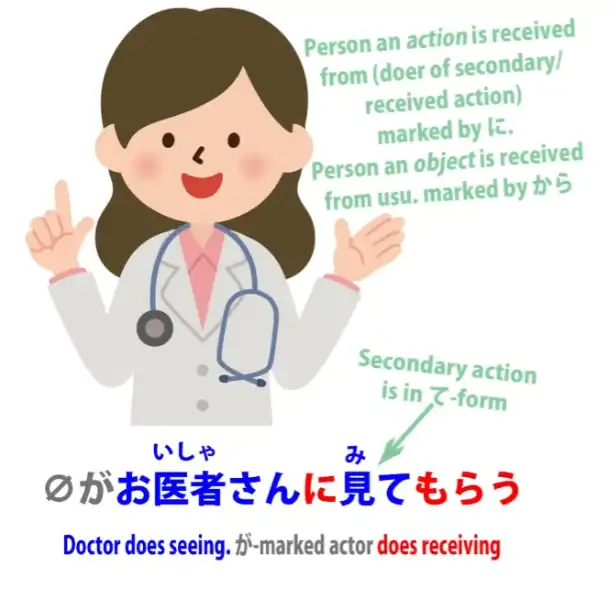
I don’t know why they do this exactly.
I think it’s because they feel that the likeness to a common English expression makes it easier.
It doesn’t make it easier, it makes it much harder, because it confuses your entire perception of what’s going on here.
“お医者さんに見てもらう” doesn’t mean “I will see a doctor”; it means “I will have a doctor see me / I will get examined by a doctor”.
Now, we can see this much more clearly if we’re talking about hairdressing or a haircut.
“さんぱつ/散髪” means “hairdressing” or “haircut”.
And if we say “散髪をしてもらう”, we’re saying “have someone cut my hair”.
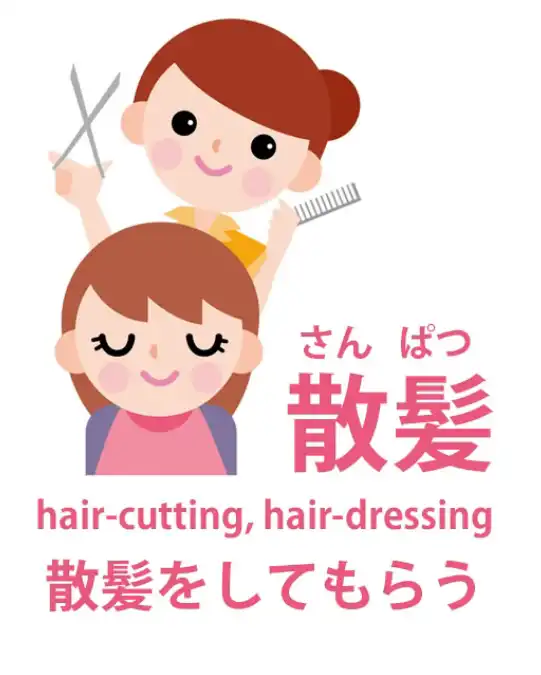
“お医者さんに見てもらう” – “have a doctor look at me / examine me”.
So you see the two work in exactly the same way.
And we can also see that while with “お医者さん” we’re specifying a giver, with “散髪をしてもらう” – “get one’s hair cut” – we’re not specifying a particular actor.
Someone might say “散髪をしてもらったほうがいい” – “you should get your hair cut” – but it’s not saying anything about by whom.
It’s not saying whether they want you to go to the hairdresser or whether you get your big sister to do it, it doesn’t matter.
Just “get someone to cut your hair”.
And this leads to another very important point, which is that the actor of “もらう”, the person “もらう”-ing, does not have to be the speaker.
And by comparing it to “くれる” a lot of people get very confused by this and they get extremely muddled when they see someone referring to someone else other than themselves “もらう”-ing.
But there’s no rule against this at all.
You can’t use “くれる” for someone who isn’t either yourself or a member of your in-group or, for example in a novel, it could be a character because the writer is allowed to be inside the head of the character.
So “くれる” is tied to a person or an in-group, but “もらう” is not.
We can freely talk about other people “もらう”-ing, receiving something.
Now, another important area that confuses people terribly, but we’re ready to deal with this now, is “させてもらう”, which is a combination of the causative helper verb with “もらう”, and we now know enough about the logic of “もらう” to deal with this, but we’re going to need to learn a little bit more about the logic of the causative helper verb “-せる/-させる”…
50. 2 Aspects of Japanese that Foreigners Can’t Fathom: させてもらう Last Secret of the Potential
2 Aspects of Japanese that Foreigners Can’t Fathom: させてもらう Last Secret of the Potential - Lesson 50
こんにちは。 Today we’re going to talk about a whole range of expressions in Japanese that cause a lot of difficulty and confusion to foreign learners.
Last week we talked about the use of “もらう” with the て-form, so “〇〇てもらう”, which also causes a lot of confusion and seems very unintuitive to the foreign speaker of Japanese though once we understand how it’s really structured, it’s actually highly intuitive.
So, building on that, we then find a lot of expressions which combine the て-form + “もらう” with the causative helper verb “-せる/-させる”, so we get “させてもらう”.
And this is really a bridge too far for a lot of foreign learners because it seems very convoluted.
But once we’ve understood how “もらう” works with the て-form, it’s really all quite logical except for the fact that we also have to assimilate an important fact about the causative helper “-せる/-させる”. Now, I’ve done a whole lesson on this (Lesson 19) and we’ve talked about most of the aspects of it which cause trouble to foreigners.
However, there’s one part that I didn’t go into because it wasn’t really relevant at that time, so we’re going to look at that now.
As I said at the time, the causative helper verb is, for a change, very well named in English-language Japanese grammar because that’s exactly what it is – it’s the causative form.
So when we attach it to another verb what we’re saying is “cause someone to do that verb”.
Now, one thing that confuses English speakers is that it can mean either “allow someone to do it” or “make or compel someone to do it”, and the causative verb in itself doesn’t draw the distinction between those two.
That confuses English speakers because English does draw the distinction.
We say “make someone do something” or “let someone do something”; we don’t say “cause someone to do something”.
The thing we now have to understand is that the Japanese causative can mean “make”, it can mean “allow”, but it doesn’t have to mean either.
It means exactly what it says on the packet.
It means “cause – by any means”, doesn’t specify what means we’re using to cause someone to do something.
And this confuses English speakers because they don’t have a way of saying this.
You can’t really say “cause someone to do something”, at least not in modern English.
And actually English sometimes feels the loss of this and has to make up for it by cheating with what it has.
So, an example of that is when we say “Would you let me know tomorrow?” or “I’ll let you know tomorrow”.
We don’t actually mean “let you know” or “let me know”.
We mean “cause me to know”.
We don’t mean “allow me to know”; we don’t mean “force me to know”.
We mean “cause me to know”.
But because we don’t have this “cause someone to do something” expression in modern English, we actually have to cheat and say “let me know”, which isn’t what we really mean.
In Japanese, of course, we use the causative for this.
So, “知る” is “know” and “知らせる” is “cause someone to know”.
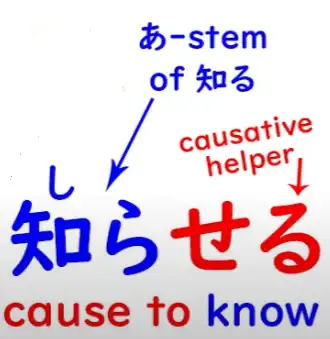
So this is essentially doing what English “let me know” is doing, without having to bend the grammar to do it the way English does.
And this causative can be used in many other ways that don’t mean either “make” or “allow”.
So “聞く”, for example, is “hear”; so “聞かせる” means “cause to hear”.
And we might say “後で聞かせよう”, which means “I’ll tell you tomorrow (later on) / tomorrow I’ll cause you to hear / tomorrow I’ll give you all the information”.
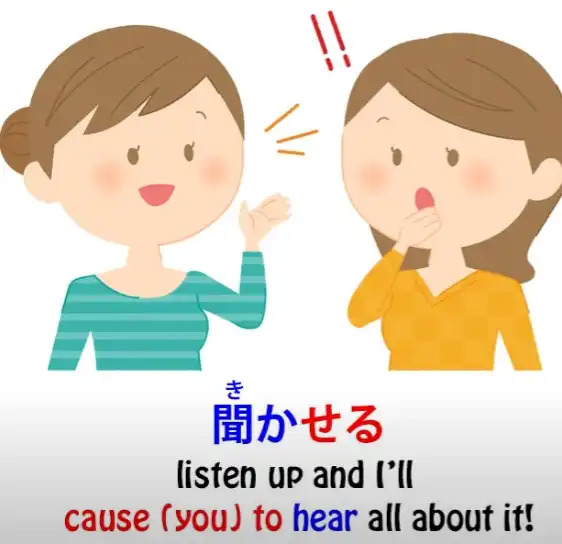
And we can lego this together with other words, so we can have something like “読み聞かせる”, which means “read and cause to hear”/read-cause-to-hear.
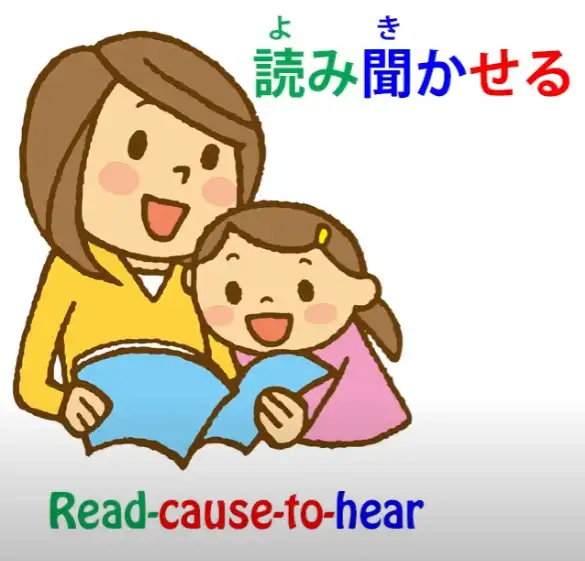
And this is what we say if we’re reading someone a story, reading a letter to someone, or something like that: “読み聞かせる” And once we understand this way in which the causative helper works, we can see how it gets て-formed to have “もらう” attached to it.
For example, we might say “聞かせてもらえますか”, which means “Can you tell me?” “聞かせて” – “cause me to hear”; “もらえる”, which is the potential form of “もらう”, in other words “possible to receive”.
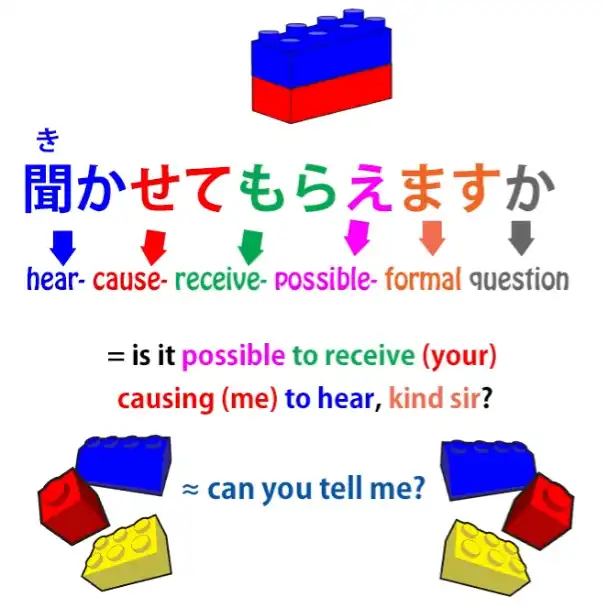
“Is it possible to receive you causing me to hear?” which in English, we’d probably say “Can you tell me?” So, this “聞かせてもらえますか” might seem very confusing to a foreign speaker because it isn’t how we put it in English, but, as you can see, structurally it’s very straightforward.
It’s built out of elements that we already know and understand and it makes perfect sense.
We could take the sentence “学生でも下宿させてもらえませんか”.
And this would tend to get translated as meaning “Do you take in students?” But literally what it’s saying is “Even if one is a student …” – “学生でも” – “…is it not possible to receive being caused to lodge here?”
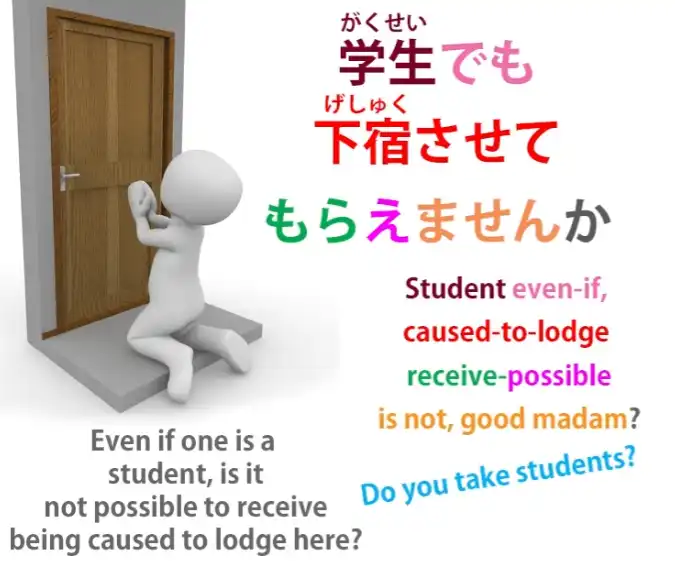
That’s the structure of this, so when you see this “学生でも下宿させてもらえませんか” and you get told that it means “Do you take in students?”, you can look at it backwards, forwards and upside down and wonder how those words come to mean that.
And of course they don’t really come to mean that at all. That’s just what we would say in English. In Japanese we’re saying “Even if one is a student, is it not possible to receive being caused to lodge here?” And it doesn’t necessarily have to be oneself that’s being caused to do something in these sentences.
For example, if we say “(zeroが)メガネを合わせてもらった”,
this gets translated as “I was fitted for glasses”,
but what it literally means is “to receive the glasses being caused to fit”.

So it’s the glasses that are being caused.
They’re the ones that are being “させる”-ed, but I am the one receiving their being caused to fit.
So it doesn’t have to be me personally receiving being caused.
I could be receiving something else being caused as well.
So, we have to look at the sentence and see what it means and, of course, apply the rules we talked about in the lesson about busting ambiguity (Lesson 48) – we look at what’s most probable, knowing that if something improbable is being said the speaker will have to make that clear, just as they do in English.
Now, sometimes of course it can actually mean “allow”, so for example if we say
“帰らせてもらいます”,
what we’re really literally saying is “I will receive your allowing me to go home”.
That’s the literal meaning.
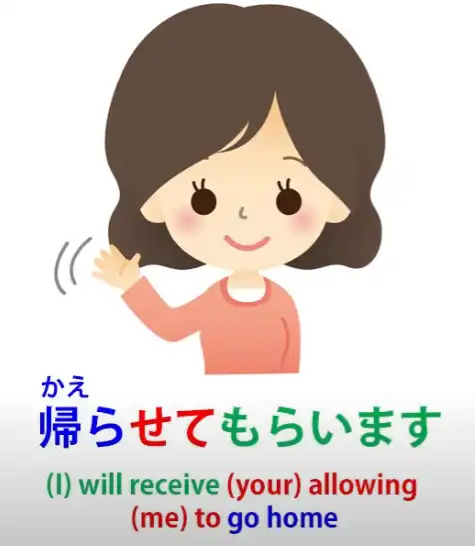
It’s rather like saying in English “With your permission, I’ll leave now”, which could very well mean “I’ll leave now, with or without your permission”, but it puts a veneer of politeness over the matter.
And whether it’s genuinely polite or whether it’s just informing someone that you’re going with a thin veneer of politeness, this is something you’ll obviously grasp from context and tone of voice etc., just as you would in English.
There’s a considerable difference between saying “With your permission I’ll go home now’’ [softly] and saying “With your permission I’ll go home now’’ [harshly] – and that’s just the same in Japanese as in English.
So, as you see, there are many ways in which these elements can be combined, but if we understand each of them and we understand how they fit together, we have the tools necessary to assimilate from immersion how these things are used.
Remember, structure doesn’t teach us how to understand Japanese. It gives us the basic tools we need in order to pick it up from the only place you can really learn how a language works – and that is direct immersion.
And I’ll just add before we go… I’m not teaching 敬語/けいご at this point.
敬語 is hyper-polite Japanese, which is almost a little sub-language of its own.
It’s not that difficult, but it will take a few lessons to go into it.
But I want to mention here that there is a 敬語 word for “もらう”. And that is “頂く/いただく”.
Because it’s hyper-polite, it’s usually used in ます-form, so it’s usually “いただきます”.
And undoubtedly you’ll be familiar with that as being the thing people say before they eat:
“いただきます!”
But what it literally means is something like “I humbly receive”.
It obviously means “I receive”, because “いただく” means “もらう”,
but it is a form of 敬語 called “謙譲語/けんじょうご”or “humble language”, so you’re saying
“I humbly receive”.
And I’m mentioning this at this point because you will probably see some of these “させてもらう”-type forms used with “いただく”: “させていただきます” etc.
And this piece of 敬語 can get used a little more often than regular 敬語 because it adds politeness to the concept of “もらう”.

So sometimes if there seems to be a danger of being a bit demanding or grabby by saying what you’re going to receive or what you want to receive, you might use “いただく” to take the edge off that and show that you’re actually being humble and polite.
So if you see “いただく / いただきます” used in any of these places, it means exactly the same thing as “もらう”. It’s just putting a more polite edge on it.
So you needn’t be confused by that when you see it.
51. How to read a Japanese 怪談 / かいだん (ghost story)
Hands-on Japanese: How to read a Japanese Kaidan (ghost story) - Lesson 51
こんにちは。 Today we’re going to flex our muscles by tackling some real live Japanese.
And I’m happy to announce that we’re partnering here with another YouTube channel called *Akasic Tails*.
And they specialize in narrative, and I really like their work, so I’m very happy that we’re able to work together with this Japanese channel to bring you some real Japanese material that we can break down and apply the principles that we’ve learned up to now to real situations.
So what we’re going to listen to today is a “怪談” – a scary story – and it’ll take us a couple of lessons to get through it because I want to break down every sentence and look at the various problems as we come to them to put you in a position to be able to do this sort of thing for yourself when you’re really listening to real Japanese material.
Right. So let’s start by hearing the portion of the story that we’re going to listen to today, and then we’ll tackle it bit by bit.

All right. So, the first word here is “それは”, and it’s rather like saying in English “It was”.
And we often begin a story, especially a ghost story, with this kind of expression, don’t we?
“It was a dark and stormy night…” So, you might start by asking, “Why is this ‘それは’, which means ‘that is’ or ‘that was’ rather than ‘it was’?” Well, it’s a very simple reason.
There is no visible word for “it” in Japanese.
The function of what is “it” in English is always in Japanese performed by the zero pronoun.
And it’s very important to understand this because it’s one of the fundamental keys to understanding Japanese.
We do have pronouns in Japanese for “me” and “you” and “they” and “she” and “he”, and the zero pronoun is used in the places these would be used in English more often than not, but there is no word at all in Japanese for the simple neutral pronoun “it”.
So, in the cases like this where we actually want to make a topic of what would be “it” in English, we use the slightly more definite pronoun “that”.
So we say “that was”. Here we’re saying “it was”.
Now, we don’t know at this stage that it’s “it was”, and in fact we never learn that directly.
Now, if you want to make sense of this sentence, we can run through it piece by piece and if we’re listening to it without having the words in front of us, we have to do that.
And it’s not that difficult to do. But I’m going to use a shortcut here because when you have the text in front of you you can do that.
I don’t think we should work backward the way Rubin-先生 suggests, even though I’m a great fan of Rubin-先生 in some ways.
But what we can do is take a glimpse at the end because it’s going to tell us where this whole rather complicated-looking sentence is actually going.
So, the end of the sentence – and we know that the engine of a sentence always comes at the end and then it may be followed by a couple of sentence-ender particles, but the engine comes at the end apart from that.
And what comes at the end of this sentence is “日” – “day”.
Now, when we see a noun ending a sentence like this, we know that this is going to be an
“A is B” sentence and that the copula “だ” or “です”, which belongs there to turn it into a sentence, has been dropped.
Now, this happens relatively often in casual speech.
And this is casual speech – “casual speech” is a bit of a catch-all term, but this is the kind of language we’ll be using perhaps in a sleepover or something where we’re telling “怪談”, where we’re telling creepy tales to each other.
And so we’re using that level of language where sometimes the copula will get dropped.
And we’ll see a few other things being dropped in the course of this story.
So, we have the structure of the sentence here.
“それは” sets the topic, and that’s also going to be the subject, so it’s “それはzeroが”.
And then “日”, that’s all. “It was… day.”
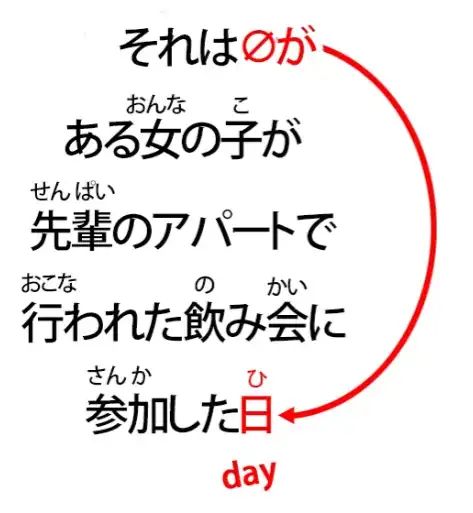
And we don’t even know that it “was”, because we need the copula on the end to give us the tense.
So if the copula was “だ”, it would end “だった”; if it were “です”, it would end “でした”.
As it is, we have no tense marker.
But because we know this is setting the scene for a story, we can tell from that fact that this is an “It was”-type statement, a scene-setting statement.
So what about the rest of this sentence?
“ある女の子が先輩のアパートで行われた飲み会に参加した”
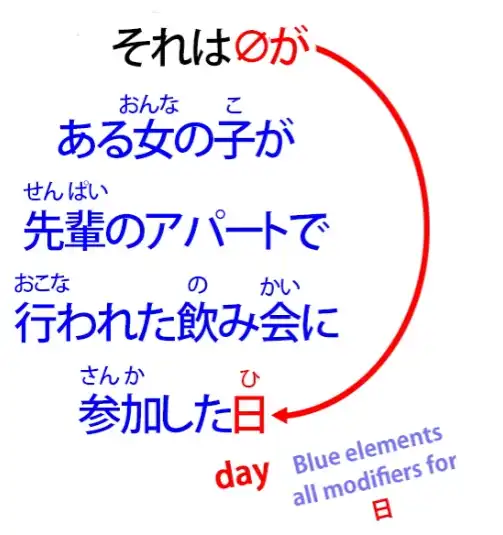
Now, as you see, between the “それは” and the “日” comes a complete logical sentence in itself.
And we can see that each clause in this logical sentence, just as we’ve seen in our videos on word order (Lesson 46) and sentence structure, works by successively modifying each element.
So, “ある女の子が先輩のアパートで行われた飲み会に参加した” *** It’s modification mania! ***
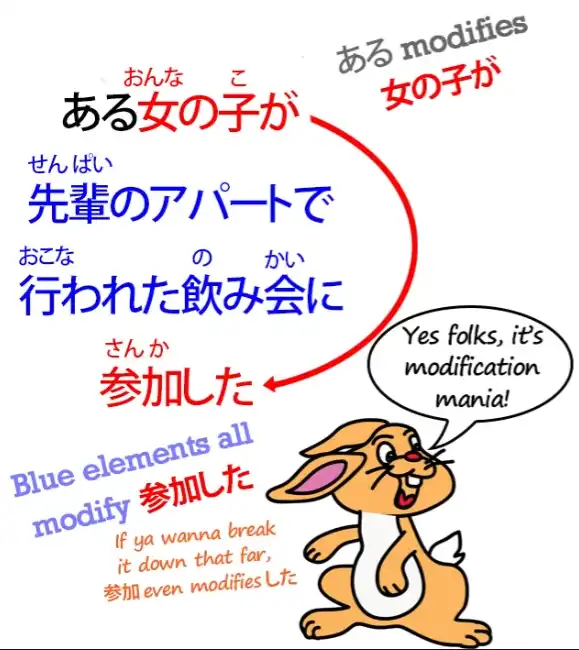
So this sentence, again, we can break down into its A-car, which is obviously “女の子が”, and its engine, which is “した” – “did”.
And then “参加した” – “‘参加 did’’ – “took part”.
And then all the rest of this sentence is successively modifying elements which modify “参加した”: “先輩のアパートで行われた飲み会”.
So, “飲み会” is “a drinking party / a drinking meeting”.
“飲み” is the い-stem, the noun form of “飲む” - to drink - which is put together with “会” - a meeting or party - to give us “drinking party”.
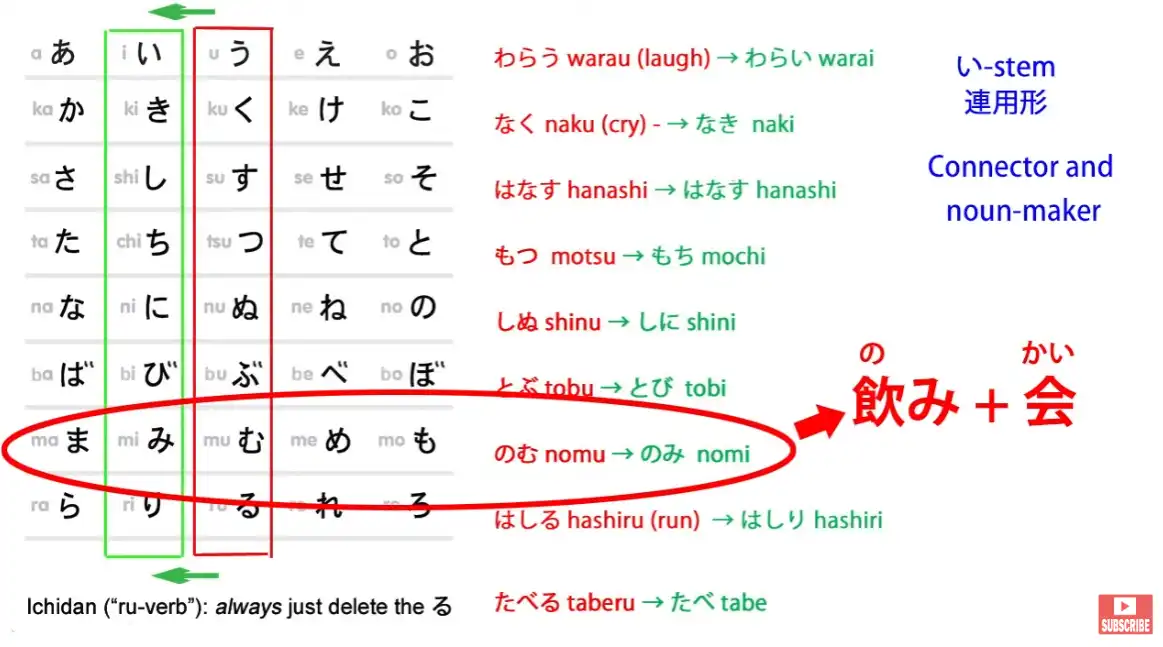
And then everything before that modifies “drinking party”.
“先輩のアパートで行われた飲み会” – “a drinking party held in senpai’s apartment”.
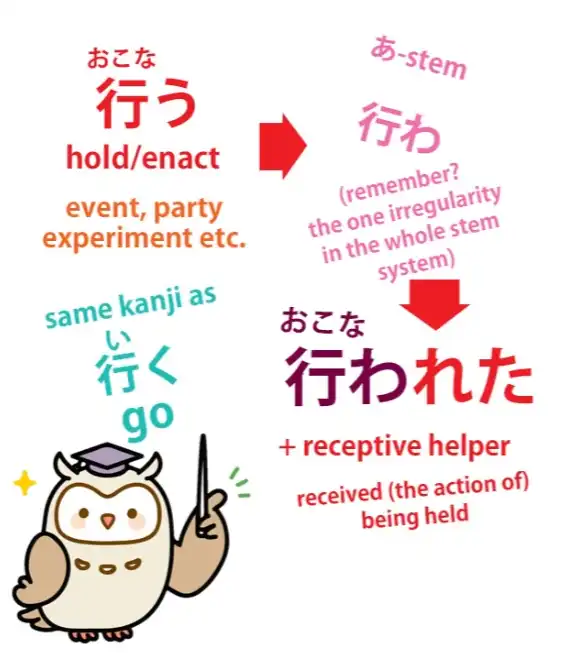
So we have “ある女の子が” – “a certain girl” – “先輩のアパートで行われた飲み会に” – and this gives us the place where she went to take part. It was a drinking party held in senpai’s apartment.
So we have that whole logical clause: “a certain girl – took part in – a drinking party – held at – senpai’s apartment” and all of that is a modifier for “day”.
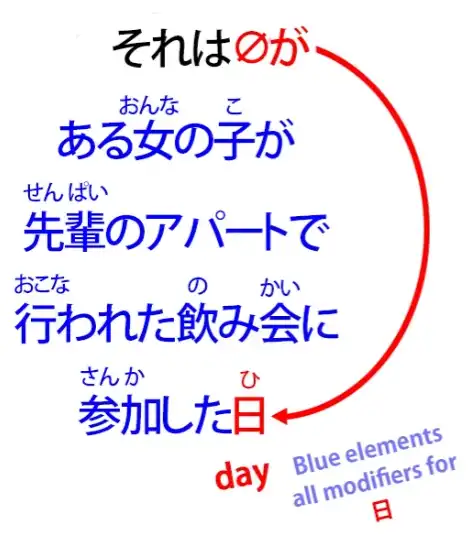
So, “それは…” – “It was a day when a certain girl attended a drinking party held in senpai’s apartment.” So you see this isn’t constructed the way we generally expect English to be constructed, but that’s fine because we have some experience now about how Japanese is constructed.
And I think you’ll agree this all makes good sense.
So that is setting the scene. It’s telling us the day when this happened and it’s filling in details about that day which are going to be relevant as we move into the story.
Well, that took rather longer than I expected for a single sentence, but I think it’s worth going into it in detail, don’t you?
So I’m afraid we’ll have to leave this on a bit of a shorter cliffhanger than I had originally anticipated, but the next few sentences I think will contain less questions, so we should be able to proceed through the text a little bit more quickly next time.
52. In-depth Japanese Sentence Analysis in Real Native Context
In-DEPTH Japanese Sentence Analysis in Real Native Context - Lesson 52
こんにちは。 Today we’re going to get our hands dirty by digging into some real-life Japanese by courtesy of our Japanese partner channel, Akasic Tails.
And we’re going to look at some of the real Japanese structures that we’ll encounter in real life and we’ll learn how to analyze them, and once we’ve got that clear in our heads we’ll be able to understand them on the fly.
Last week we looked at a Japanese “怪談” – a scary story – and there was so much important material to analyze in the first sentence that we didn’t get beyond the first sentence.
So, this week I think we can progress a little further and a little faster into the story.
So, I’m going to play you the portion I want to analyze today and then we’ll start analyzing.
Of course, we’ll start from the second sentence because we’ve analyzed the first one rather thoroughly already.
So, the next part is “飲み会が終了した後” and this is a time statement.
It’s setting the time of the action we’re now going to describe.
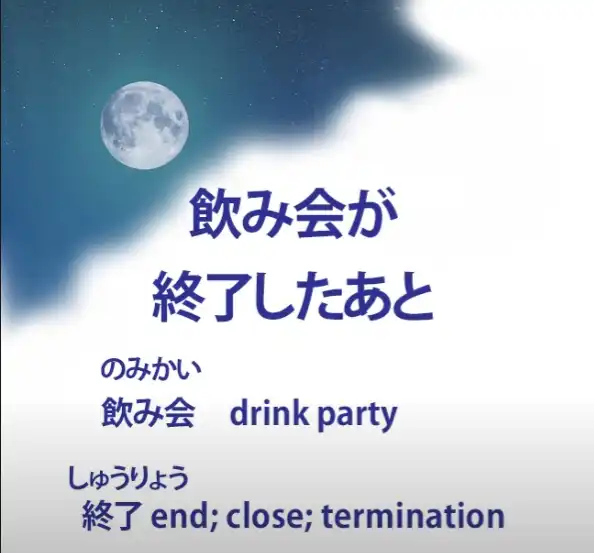
Now, strictly speaking, we should say “後に” rather than simply “後”, but again we can drop that because we’re talking relatively informally.
So having set the time, we then say what happened: “彼女はアパートを出てしばらく歩いていた”.
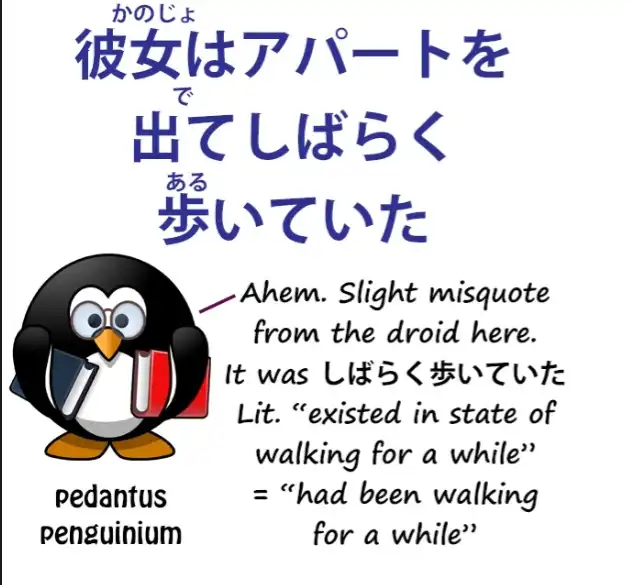
So, she left the apartment and walked for a while.
So then we have “ふと先輩の家に携帯電話を忘れてきたことに気づいた”.
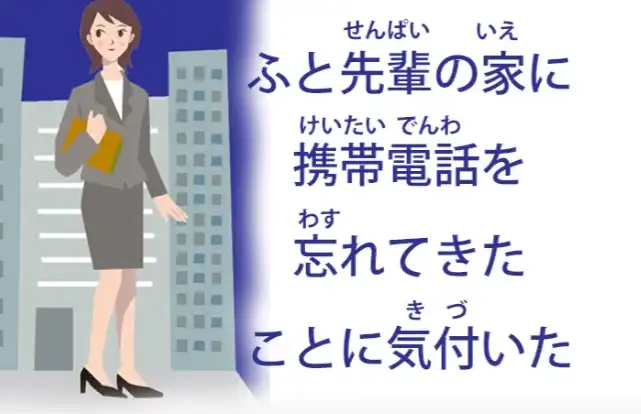
“ふと” – suddenly – “先輩の家に” – in senpai’s house – “携帯電話” – portable telephone – “を忘れてきたことに気づいた” – 忘れてきた is 忘れる, forget, joined to “来る”.
“忘れてくる” is literally “forgetting-coming” – or what it means is really “leaving behind”: “忘れてきた”, coming while having forgotten her portable telephone in senpai’s apartment.
“ことに気づいた” – she realized that that’s what she’d done.
“こと” makes a noun, or bundles everything before it into that noun.
So forgetting her phone in senpai’s apartment was the “こと” that she now realized.
So why is it “ことに気づく” and not “ことを気づく”?
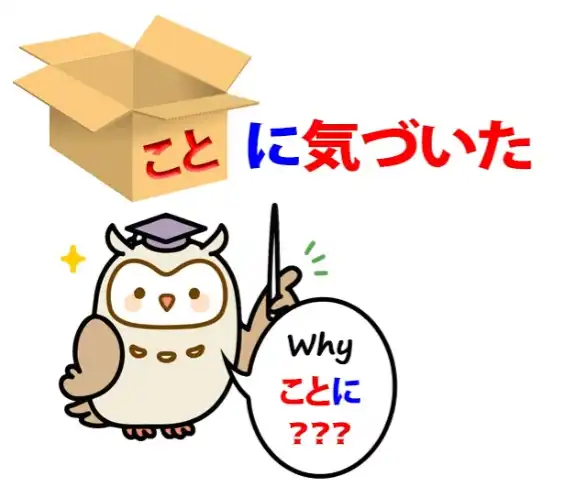
The English-language Japanese dictionaries and textbooks will tell you that “気づく” is a verb that means the same as English “realize”.
And in practice it means much the same, but structurally it’s different.
It’s made up of an amalgam of two words that we already know well.
One is “気” which means “spirit” or “mind” or “feelings” and the other is “付く” which means “stick” or “adhere”.
So what this literally means is “spirit stick” and what we’re doing is sticking our spirit to something, that is, our attention, our mind, our feelings become adhered to a particular thing.
And in English we express that differently by saying that we “realize” – make real – a fact.
In Japanese, our spirit adheres to a fact.
In Japanese, a very common expression is “気を付けてください”, which is translated as “take care”, but what it literally means is “stick your spirit”.
Stick it to what? Well, stick it to your surroundings, stick it to what you’re doing.
In other words, pay attention. Now, the translation “take care” is actually better culturally than “pay attention”, because “pay attention” sounds like an order, doesn’t it?
And that’s not the atmosphere of saying “気を付けて”.
Note: Dolly-先生 says “気をつくて”, but I think she meant to say 気を付けて instead as the first one does not really seem to make sense, and I failed to find anything about it, especially pointing to said “take care” or the like…my theory is that she misspoke, but nobody noticed. In practice, culturally it means something more like “take care”, so the translation isn’t wrong but the structure isn’t the same.
So now we get an idea why we say “ことに気づく” rather than “ことを気づく”.
If we stick a poster to a wall, the wall, the thing it’s stuck to, is not the direct object, is it?
The direct object is the poster; the wall is the ultimate target of that action.
And ultimate targets, in Japanese, are always marked by に.
As we know, the indirect object, the ultimate target, is marked by に.
Now, even if we take the human actor out of this and just say “The poster sticks to the wall”, we’re still saying “to the wall”, aren’t we?
We’re not saying “The poster sticks the wall”, which is what we would say if the wall were the direct object.
We’re saying “The poster sticks to the wall”. The wall is the target of the poster’s sticking.
So by the same token, if we stick our spirit to something or if our spirit sticks to something, the something to which it sticks is the target, not the direct object of that sticking.
Now, this is important to know, because it’s another small example of the way that “えいほんご” – so-called English-language Japanese grammar, the stuff you find in the textbooks and the websites everywhere –
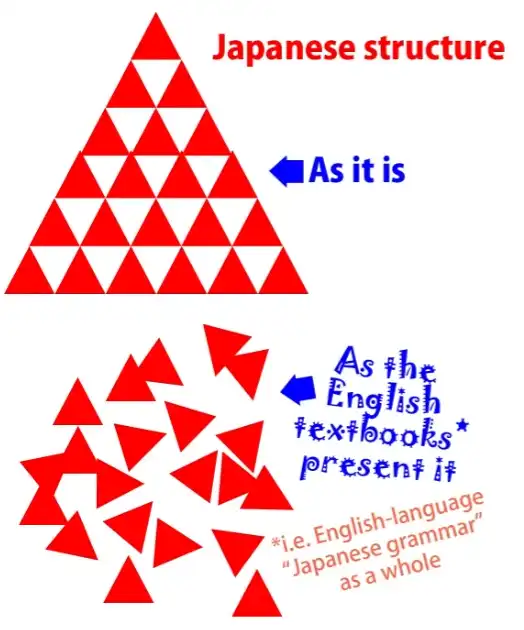
it’s another way in which it simply messes up our understanding of the logic and structure of a very, very logical language.
Because what they’ll tell you is “気づく” is a verb that means ‘realize’, but it takes に”.
Now, leaving aside the fact that no verb can take に or any other logical particle (only a noun can ever take a logical particle), we know what they mean.
They mean that this word, that means “realize”, which in English treats the thing realized as the direct object, actually treats the thing realized as a target and therefore marks it with に and “this is one of those weird quirks of Japanese that you have to learn in every individual case because it’s so random and irrational”. It’s not random and irrational at all.
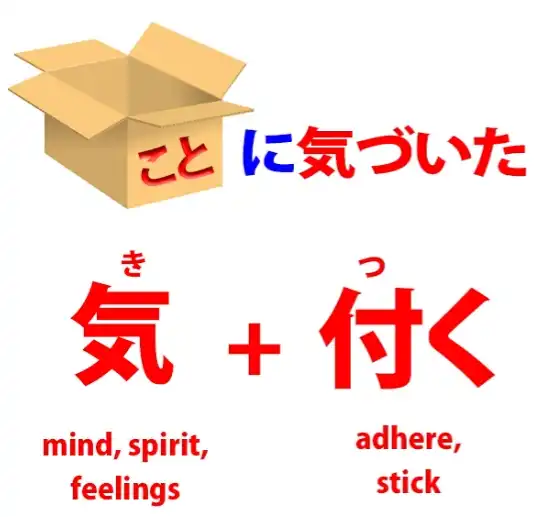
While “気づく” is broadly equivalent to “realize” in English, it’s not the same structure.
We’re not real-izing, making something real, we are sticking our spirit to something
and that something is a target and therefore it’s marked by に,
just as targets are always marked by に.
Note: obviously that something に-marked is a noun, like こと. Not the verb 気づく that “takes に”, like some textbooks say. Just in case mentioning this again, as it can be a tad bit confusing.
Japanese doesn’t go in for random irrationalities.
You need to go to European languages if you want that.
And if I can just pop in a little footnote here.
This talk of verbs taking particles is hugely, hugely misleading.
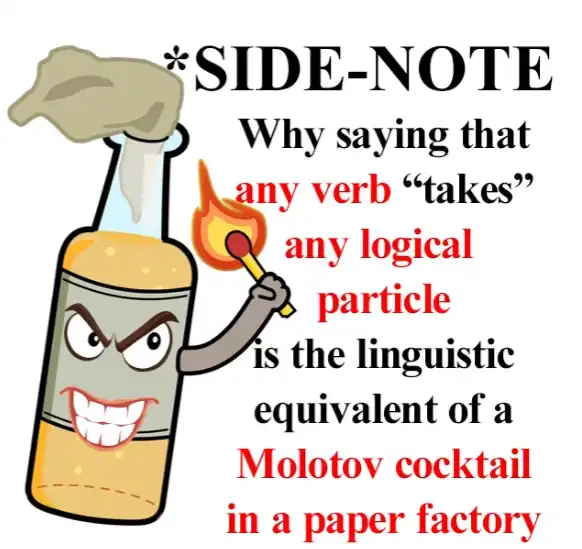
It’s not just a quibble to say that logical particles can only ever belong to nouns, never to verbs.
I said I knew what they were talking about when they spoke of verbs taking particles, but what they’re talking about is horribly wrong on every occasion.
It’s based on the fallacy that logical particles can perform different functions in relation to different verbs.
And they never, ever can.
The only reason for ever thinking so is, as in this case, misunderstanding what the verb is actually doing, usually because they assume that it works exactly like its nearest English equivalent, which is very often not the case.
And as we’ve seen in the case of the potential helper verb and adjectives of subjectivity, this fallacy covers a huge area of Japanese and makes a very large contribution to the inability of many students to understand Japanese.
Because it seems so illogical and random when in fact it’s completely logical.
That’s why we call them “logical particles”.
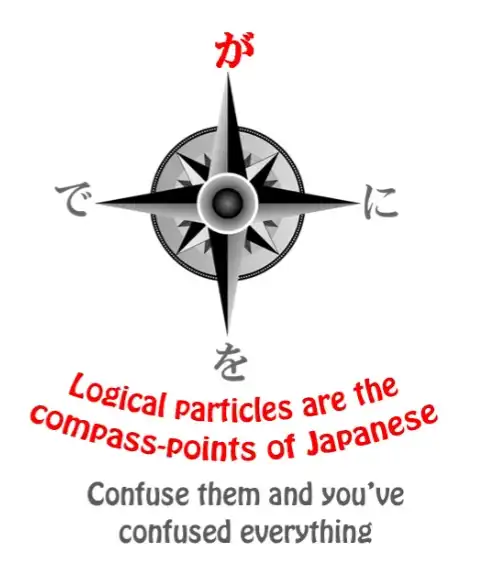
They never change their function regardless of what adjective or verb is involved in the sentence.
They always, always do the same thing.
And if you’re at all confused about what I’m saying here, please see the ninth lesson in this course. And I’ll put a card up for that right now.
“彼女はアパートで引き返し先輩の部屋に戻って呼び鈴を押す”
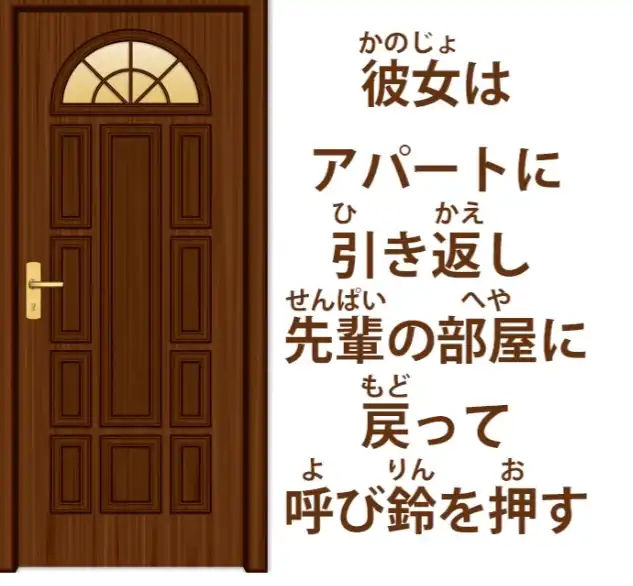
So she returned to senpai’s apartment. “引き返し”, that means “return”, and as we’ve seen before, the い-stem of a verb – the verb is “引き返す”, which is “return” – and particularly in narrative we can use the い-stem of a verb in much the same way as we use the て-form of a verb to make it the first clause of a compound sentence.
So, she returned to senpai’s apartment – “先輩の部屋に戻って呼び鈴を押す”. She returned to senpai’s room and pushed the bell.
“呼び鈴”: “呼ぶ” is “call”, “鈴/りん” is the on-reading of “鈴/すず”, “a small bell”, so “呼び鈴” is a “call-bell / a bell for calling”.
“押す”: she presses the bell. And as we’ve seen before, in Japanese narrative it is allowable to use present-tense sentences within a past-tense narrative to add immediacy.
And the sense here is that we’ve come to a point here, to a point almost like a landing on the stairs where we rest for a moment and make this our present.
She pressed the bell.
“ところが反応がない”
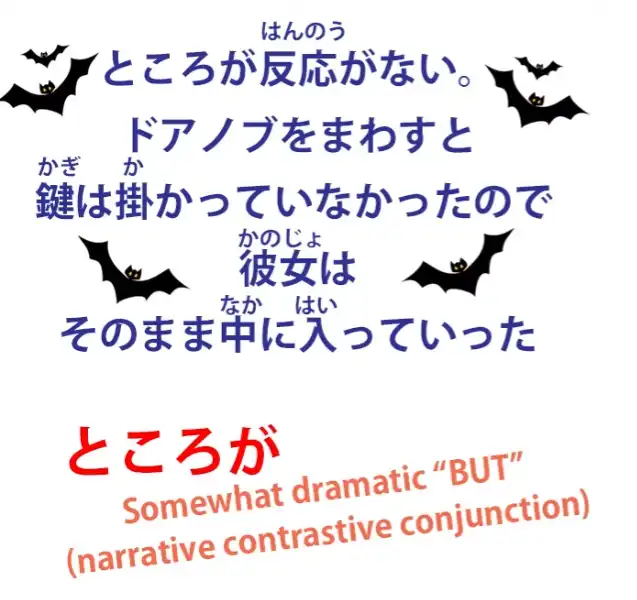
“ところが” is an expression that we’ll often find in narrative, again.
“が”: This “が” is obviously not the particle が.
It’s the other “が”, which is a contrastive conjunction and essentially means “but”.
Why do we add “ところ” to it?
Well, as we discussed in a previous lesson, “ところ”, which means “place”, can also mean a place in time.
It’s almost like a resting place in time. It gives us a temporary “now”, as it were.
So when we say “ところが”, we’re saying “at that point / at that time, but”.
So we’re using this as a narrative conjunction to mark the fact that something is happening that’s contrary to our expectations or wishes.
So, “ところが反応がない”. So although she pressed the bell, there was, unexpectedly or contrary to our hopes, our wishes, there was no answer.
And when she turned the doorknob… “回す” As we know, “回る” is to “go around”, “回す” is the other-move version of “回る”, so it’s to “cause to go around”.
When she caused the doorknob to turn, when she turned the doorknob, “鍵は掛かっていなかった” The lock existed in a state of not being locked, of not being hooked or hung or fixed.
A slightly confusing-seeming expression because it comes from the fact that Japanese people often lump together the concept of a key and the concept of a lock into one. Strictly speaking, this could be called incorrect.
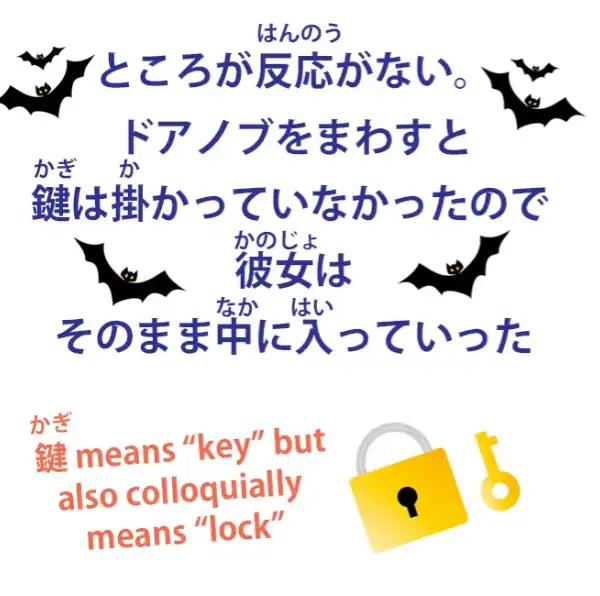
Really we’re saying “錠前が掛かった” – the lock was fixed or hooked, but it’s common in Japanese to say the key was fixed or hooked (“鍵が掛かった”) and it would seem even a little unnatural to say it correctly.
And because the door was unlocked, “彼女はそのまま中に入っていた” – she went in.
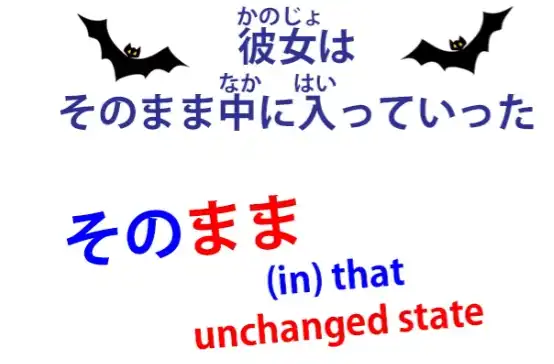
“そのまま” we discussed in another video (Lesson 42) and, as we know, a “まま” is an unchanged condition.
“そのまま” means “in that unchanged condition / just as it is”.
And we can see here how that concept is being extended a little in a way that we’ll find often.
So, for example, if we’re talking about edamame, and we say “そのまま食べる”, we mean “eat them just as it is, eat them without changing their condition, eat them without doing anything further to prepare for eating them” and this is what “そのまま” means here.
Because the door was unlocked, she went in just like that, just in her present condition.
She didn’t press the bell again, she didn’t wait to be invited, but “そのまま” – in the unchanged condition of that moment – she went in…
53. Enjoy Japanese Horror in Japanese
Enjoy Japanese Horror in Japanese - Lesson 53
こんにちは。 Today we’re going to encounter a lot of the structural points in Japanese that we’ve covered in this course of lessons in action, in real situations.
And we’re going to do that by continuing with the “怪談”, the Japanese story, that we’ve been reading over the last few lessons by courtesy of our Japanese partner channel, Akasic Tails.
And we’re going to be covering such a lot of points this time that I’ll put up cards for some of the main ones but I’ve also made a supporting page on Kawajapa where you can go and look up any of these points and follow them up if you need to do so.
And I think it would be a very good idea to follow up anything that you’re not absolutely clear about after we go through this story.
Now, to remind you where we got to at the end of last week’s lesson, our heroine had gone to a drinking party at her senpai’s apartment.
After she left the party and was walking home at night, she became aware that she’d left her “携帯電話”, her portable telephone, in senpai’s apartment.
So she went back, pressed the bell, but there was no answer, turned the handle of the door and found that it wasn’t locked.
So she walked right in.
So, let’s see what happened next.
“部屋の中は電気がついておらず”
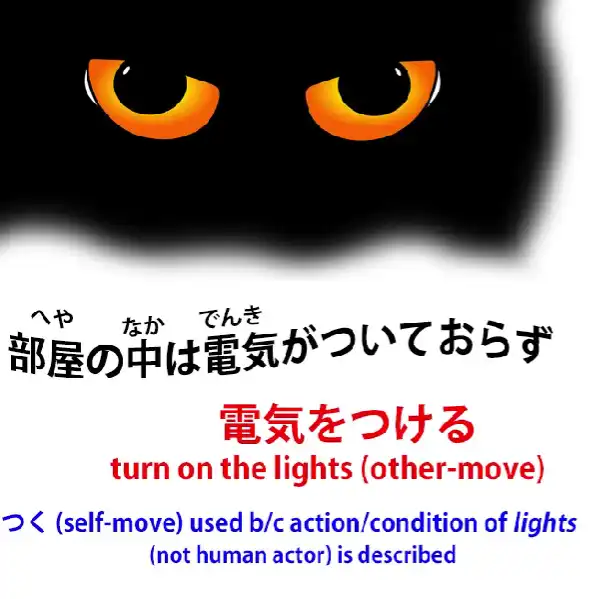
Now, so long as we understand that “電気をつける” means “turn on the lights” (literally it means “turn on the electricity”, but it in fact refers to the lights), the only problem with this clause is “おらず”.
What does that mean?
Well, “おる” means the same as “いる”, which is to “be”.

Generally we’re told that it means to “be” of animate beings, like animals and people.
It’s not quite as simple as that and I’ve explained that in another lesson, which I’ll link.
“おる” is a rather older form of “いる”, but we encounter it in a variety of circumstances.
For example, it is used in keigo as a humble form, “謙譲語/けんじょうご” form, of “いる” which we use to humble our own actions and possessions, but it’s also used in dialect, in Kansai-ben for example, and it’s used in literary contexts to give a literary narrative feel.
And that’s how it’s being used here.
So, “おる” means “いる”, but what does “おらず” mean?
Well, you also have to understand that “-ず” is also a piece of older Japanese which gives a literary feeling to a narrative and it’s simply a negative helper like “-ない”.
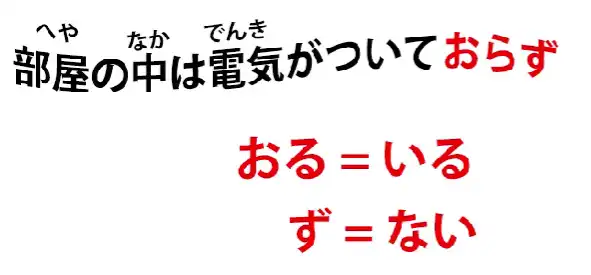
So why is it “おらず”?
Well, that’s because while “いる”, as we know, is an ichidan verb, “おる”, as it happens, is a godan verb.
So, as with all godan verbs, the negative helper is attached to the あ-stem.
So that’s what’s happening here.
“おらず” means the same as “いない”.
So, “電気がついておらず” means “the electricity existed in a state of not having been switched on” or, in plain English, the lights were off.
“真っ暗で”: “真っ暗” is “pitch-dark”, literally “true dark / complete dark”.
“暗”, of course, we know as “暗い”, the adjective “dark”, and we know that when we see an adjective without its -い on the end, if it makes a word at all, it will be a noun.

We also know that if we see a word that is all kanji, it’s almost certainly going to be a noun.
So “真っ暗” is “pitch darkness”.
“真っ暗で” – the “で” here is the て-form of “だ” or “です”.
So, “部屋の中は電気がついておらず真っ暗で” – “As for the inside of the room, the lights were off, it was pitch dark”.
“どうやら先輩はもう寝てしまったらしい” “どうやら”: in this case means “it seems, it appears to be the case” and this is actually working in tandem with the “-らしい” at the end, which also means “seems like, appears to be”.

And we’ve covered this in a previous lesson as well. (Lesson 25) So in between this sandwich that gives us the “it appears to be the case” meaning, it says “先輩はもう寝てしまった” – “senpai has already done gone to sleep / done gone to bed”.
As we know, that “しまう, しまった” gives that “done” meaning.
And that’s really the best way to put it in English.
It sounds a bit rustic in English, but there’s nothing else in English which I think gives that sense of “しまう, しまった, ちゃった” quite as well as “done”.
She’d already done gone to bed, it seemed.
“無用心だな”: “無用心” means literally “not using one’s heart”, but “heart” here means mind or spirit.
“用心” is “care” or “cautiousness”; “無用心” is “lack of care” or “lack of cautiousness”.
Note: An alternative writing is 不用心. They should mean the same thing. But this particular word “無用心” tends to mean lack of cautiousness in relation to criminal or other hostile activity.
So we might say that walking alone in a dangerous place is “無用心” or leaving valuables on display in our car is “無用心”.
And here, leaving her door unlocked at night so anybody could just walk in is “無用心”.
“無用心だな”: “な”, as we know, is the particle used for directing a comment at ourself, so she’s thinking to herself “無用心だ” – it’s reckless, dangerous behavior.
“無用心だな、と思った彼女は”: so, she, who was thinking this, “電気をつけて先輩を起こそうかと思ったが”.
All right, so this looks a little bit complicated and we still haven’t finished the sentence, but let’s just take it bit by bit.
First of all she thought “無用心” – “unsafe, dangerous behavior”; “she thought” – “と思った彼女” – she who thought that, then thought something else; “電気をつけて” – “点ける/つける”, of course, is the other-move version of “点く/つく”, so she thought of switching on the lights; “先輩を起こそう” – now, as we know, that “そう” ending is a volitional ending; “起こそうか” – she thought about taking the action of awakening senpai.
“起こす” –to “wake someone up”; “起きる”, you wake up yourself; “起こす” – -す endings, as we know, mean other-move verbs, so “起こす” is to wake someone else up.
“起こそうか” – so, she’s thinking about this action.
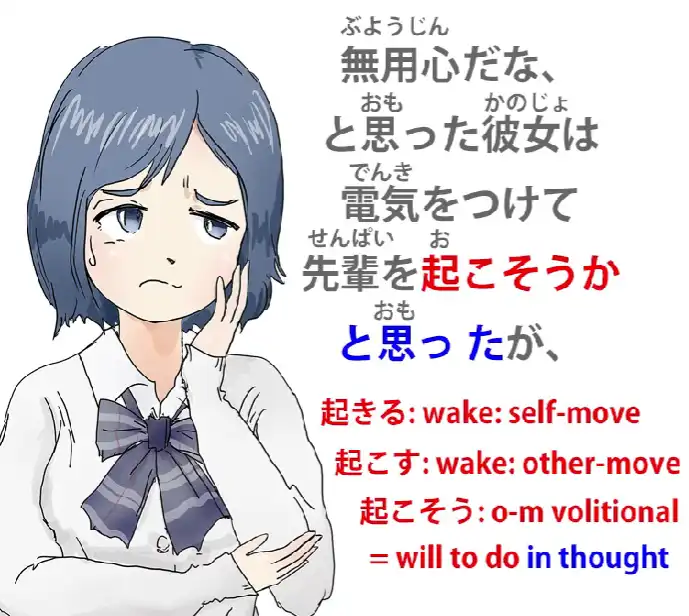
The “か”, as we know from another lesson (Lesson 39), marks a question, that’s to say, a proposition.
So the proposition was taking the action of waking up senpai.
This is what she thought, but… (“が” – “but”) “先輩がかなり酔っていたのをおもいだし、”.
So, “かなり” is another one of those adverbial nouns that can modify a verb or an adjective without the に or -と that’s usually needed for a noun to modify a verb or an adjective, so “かなり酔っていた” – “酔う” is to “be sick or to be drunk”, in this case “drunk”.
“かなり” means “sufficiently” or “pretty much” or “very”.
So she was pretty drunk, she was in the state of being pretty drunk: “かなり酔っていたの” – the “の” of course bundles that statement into a noun box – “のを思い出し” – “思い出し” is “remember”, so she remembered the fact – the “の” – that senpai had been pretty drunk.
“思い出す” is “remember”; “思い出し”, once again, as we discussed last week (Lesson 7.5), is the い-stem of “思い出す” – “remember” – and the い-stem here (the し) is being used like the て-form to make this clause a part of a compound sentence.
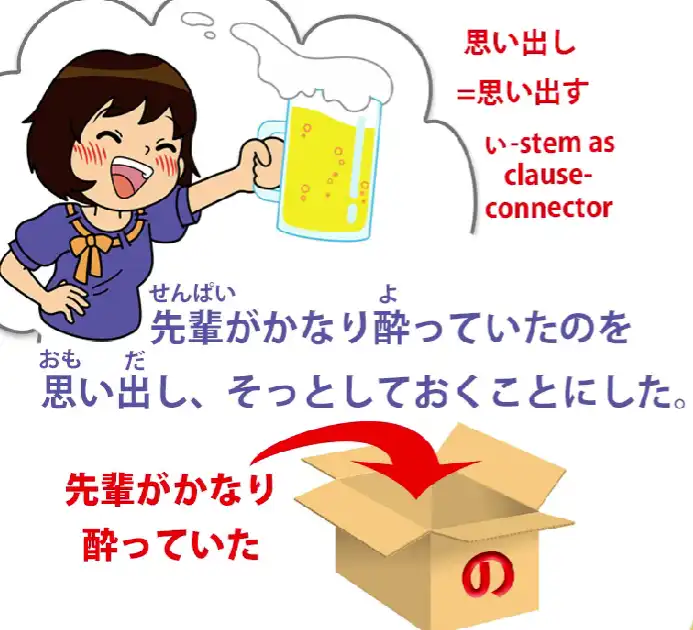
So we have a three-fold compound sentence now.
First of all, we use “が” – “but” – as the connector for the first part, and the second part we’re using -し like the て-form as the connector for the third part, and the third part is “そっとしておくことにした”.
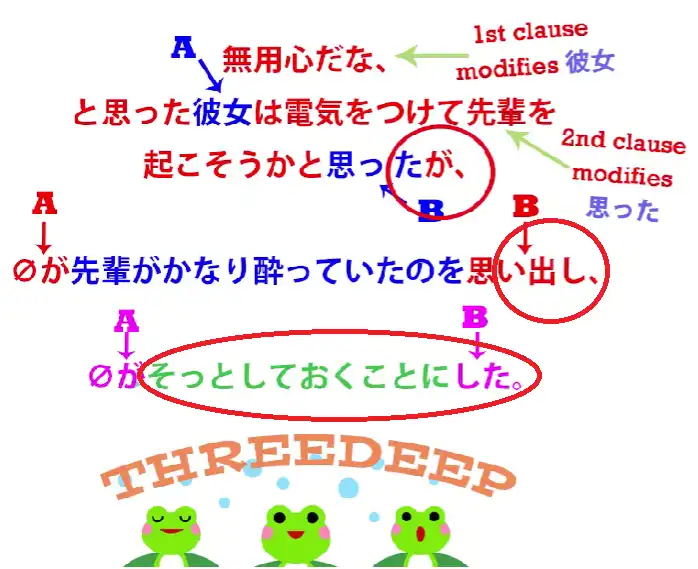
“そっと” is another one of these adverbial nouns, meaning “softly, gently or quietly”.
“そっとする” means to “do softly, gently or quietly”.
It’s like “静かにする”, which means to “do quietly”.
“そっとする” means also to “do quietly”, but “静か” means more “keep quiet”.
You might say this to a class: “静かに!” – “Keep quiet!” “そっとする” is more to “do (something) in a quiet manner”.
Now, “静か” can be used in that way too, but “そっとする” means to do something quietly; it can even mean secretly.
“静か” can’t mean secretly; “そっと” can mean secretly.
Here it doesn’t mean secretly, but it does mean doing something quietly so that someone else won’t be aware of you doing it, which is the kind of implication that “そっと” often tends to have.
“そっとしておく” – “しておく”, as we know, is to “put in place an action”.
“置く/おく” means to “place (something)”.
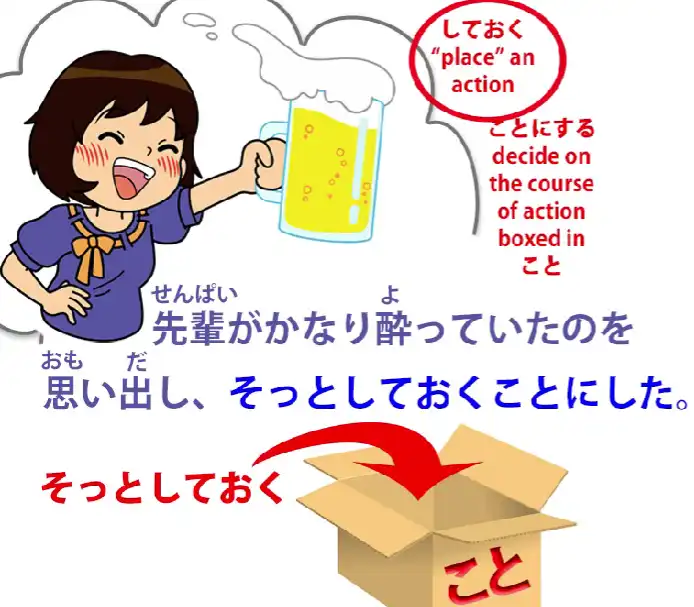
Attaching “おけ” to the て-form of a verb means putting that action in place.
And, as we know, the textbooks often say it means “doing it in advance” or “doing it in preparation”, but actually it means “putting the action in place”.
So she’s essentially saying here, “do what she has to do, put her action in place, quietly”.
“そっとしておくことにした”: now, “ことにする”, as we’ve also covered in a previous lesson, means “decide to do”.
So this last bit means she decided to put her action quietly into place, literally.
So we’ve got this whole sentence here: “無用心だな、と思った彼女は電気をつけて先輩を起こそうかと思ったが、(zeroが) 先輩がかなり酔っていたのを思い出し、(zeroが) そっとしておくことにした”
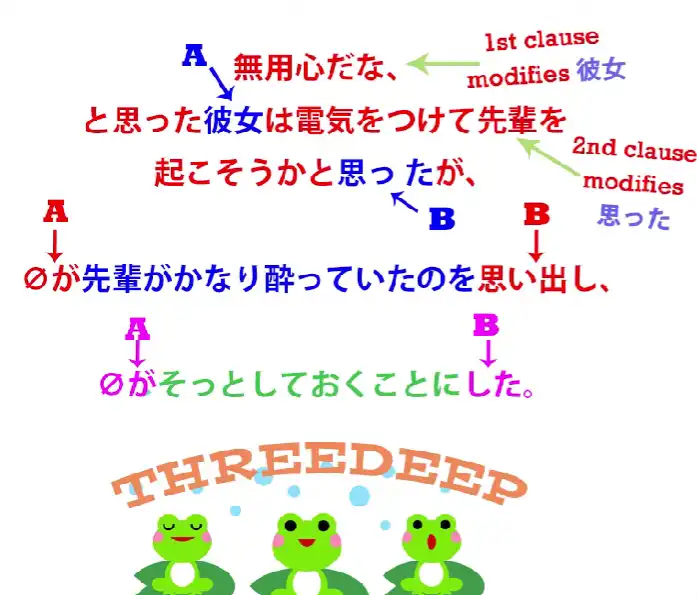
So, “‘That’s dangerous, isn’t it, leaving the door open,’ she thought; she considered switching the lights on and awakening senpai, but she remembered that senpai had been pretty drunk and so she decided to do what she had to do quietly.” “真っ暗の中で自分の携帯電話を探し出すと” –

“In the pitch darkness – 真っ暗の中で – 自分の携帯電話 – her own telephone – 探し出す”.
“探し出す”: “探す” as we know, is “search”; “探し出す” is literally “search out”, so she sought it out, she found it – “と”.
’‘「忘れ物をしたので取りに戻りましたー」とひと声かけて部屋を後にした” So she said something aloud here, but presumably quite quietly so that she wouldn’t wake senpai.
She said: “忘れ物” – “forgotten thing” – “をしたので” – “I did a forgotten thing / I forgot a thing / I left a thing behind” – “忘れ物をしたので” – because of that – “取りに戻りました” – “I came back to take it / in order to take it, I returned” – “とひと声かけて” – “声 (を) かける” is to say something to someone, to engage them in conversation, here “ひと声” – she just said that single word, she just said that single voice, literally, she just said that – “部屋を後にした” – so she just said that, presumably quietly so that senpai wouldn’t even hear her, but she felt she ought to say something – “部屋を後にした” – “後にする” literally means to “turn it into behind”, in other words, put it behind you, in other words, leave – she left the room – “部屋を後にした” – she made the room the thing behind her by leaving it.
And that was that for the evening.
Well, she got out of that all right, didn’t she?
It was a bit scary, but we didn’t hear what happened the next day.
That’s what we’re going to talk about next week..
54. IRREGULARITIES & how they work - 見る, 見られる, 見れる, 見える, 聞く, 聞ける, 聞こえる
IRREGULARITIES in Japanese and how they work - 見る、見られる、見れる、見える、聞く、聞ける、聞こえる - Lesson 54
こんにちは。 Today we’re going to talk about some exceptions in Japanese, how they work, and why they’re there.
And in doing that, I think we’re going to gain some insight into how Japanese holds together and how we can understand it.
So what we’re going to talk about today is 見る, 見られる, 見れる, 見える, 聞く, 聞ける, 聞こえる.
Now, that seems like quite a confusing lot of things, doesn’t it?
But in fact all we have there is the basic dictionary forms of “見る” and “聞く” – “see” and “hear” – and the potential form of each and one alternative or exceptional potential form.
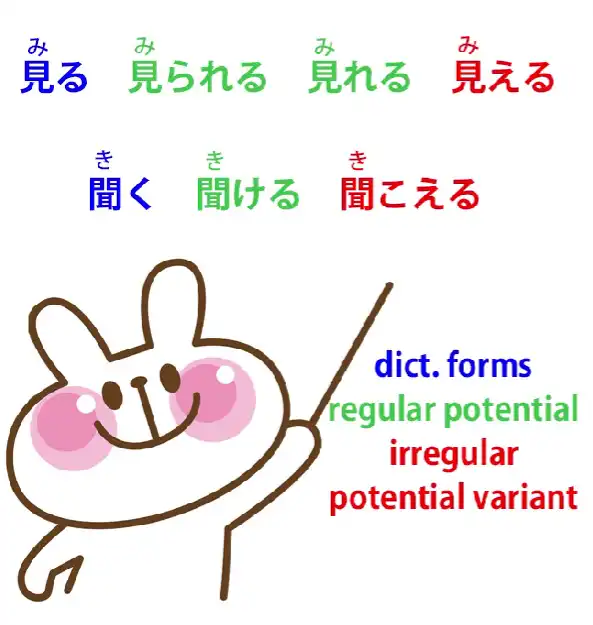
Now, it looks like two in the case of “見る”, but it’s actually one, and we’ll come to that in just a moment.
I always say that Japanese is a very, very regular and logical language, and the conventional wisdom is that it only has two irregular verbs, “来る” and “する”.
Now, as I’ve mentioned before, it does in fact have a few other minor irregularities, and by minor irregularities what I mean is verbs that aren’t really irregular verbs but they do become irregular in one particular area, in one single place only.
And there aren’t many of these, but there are a few and these are two of them.
And we want to look at what they are and, more importantly, why they are what they are and what they mean, how we can understand them.
So to start with, we understand how the regular potential form, the “able to do” form, of verbs work, don’t we?
We form it simply by turning the verb into its え-stem and adding the very simple potential helper verb “る”, which is just one character: る.
That’s the godan form.
And the ichidan form: in the ichidan we do what we always do, we simply remove the -る and put on whatever it is we’re going to put on.
In this case, the ichidan potential helper is ““られる””.
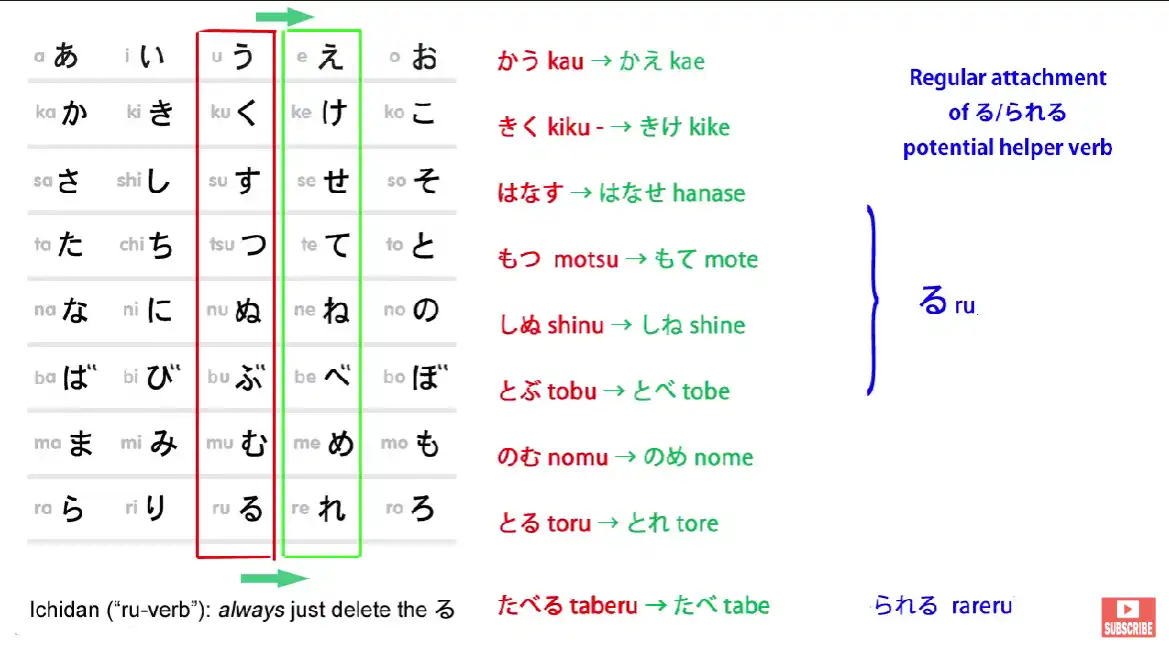
So, as we can see, “見られる” is the regular potential form of “見る”, which is an ichidan verb, and “聞ける” is the regular potential form of “聞く”, which is of course a godan verb.
So why am I saying that there’s only one variant of “見る” and not two?
Well, that’s because the variant is “見える”, and we’ll come back to that in a moment.
“見れる” is in fact the ichidan form being affected by a phenomenon which we call “ら抜き”. “ら抜き” means literally “taking out the ら”.
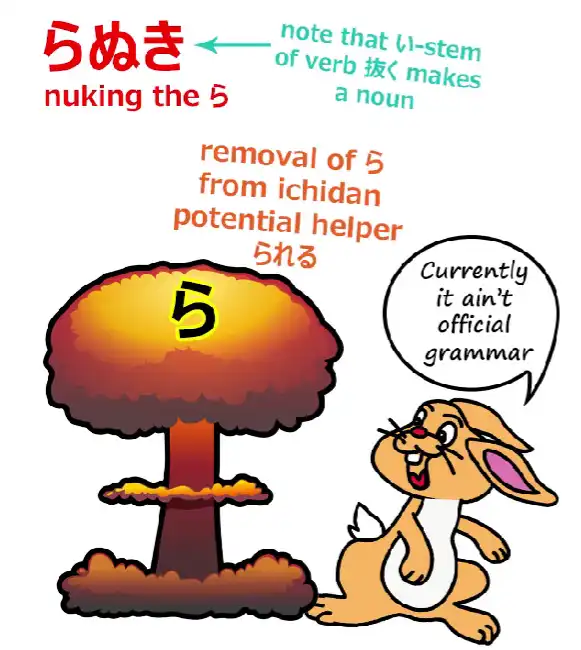
And this is something that happens quite widely in Japanese.
You’re going to encounter it pretty often once you’re actually using Japanese, so that may be right now.
It simply consists of taking out the “ら”, dropping the “ら”, in the ichidan potential form of verbs.
This is considered to be incorrect grammar, not only by the English Japanese textbooks but also by native Japanese grammar textbooks.
It’s considered to be incorrect grammar, but it’s very, very widespread, much more widespread than most of the popular bits of incorrect grammar that you’ll hear from time to time.
And I would suggest that this is probably going to be an evolution of the language.
Now, Western people often tend to say, “Well, if a number of people are using an incorrect usage then how can you say it’s incorrect?
Surely it’s a new correct usage, because ‘correct’ is just what people use.” And I think this is a mistake and a rather dangerous and irresponsible mistake, because while it’s true that language evolves, the evolution of language is pretty much the same as the theorized evolution of species.
That’s to say, species evolve from mutations.
Mutations happen relatively often and most of them die out.
Only a few of them, and usually in cases where they have some special advantage, actually persist and become part of the evolution of the species.
And the same is true of languages.
Most incorrect usages that get taken up by largish numbers of people die out.
Only a very few of them ever become parts of the real evolution of the language.
So if you do what is currently being done in the West, which is put in misuses of language into dictionaries, what you’re doing is actually short-circuiting the self-correcting function of language.
Language over a generation or so, over maybe a couple of decades, will reject most uses that go against its basic logic.
A very few of them will end up making minor changes in the basic logic.
And that’s why it’s a mistake to put into dictionaries at an early stage misuses of language, because we have no way of knowing at that early stage whether they’re really going to be genuine evolutions of language or whether they’re going to die out within a generation.
What we do know is that in most cases, in the vast majority of cases, they would die out within a generation, and by putting them into a dictionary we’re interfering with that self-correcting process of language.
And this, I would say, is important, because it’s this way of thinking that makes Japanese teaching so very poor in the West.
It’s the way of thinking that assumes that language is a completely irrational thing that just happens to evolve in any way it chooses to evolve.
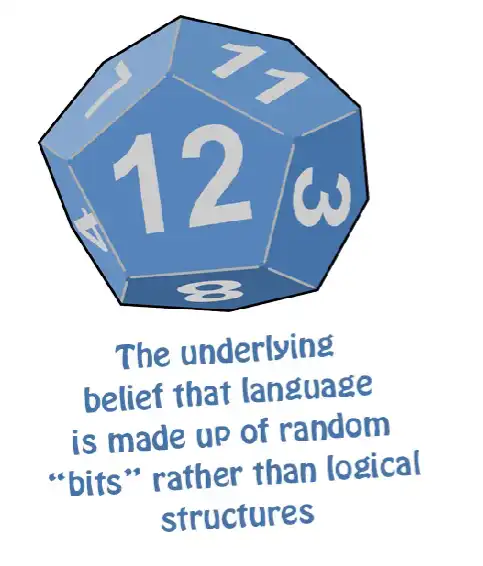
And it’s not. Language is governed by logic.
And Japanese is governed by logic more than most languages.
But if you reject that notion, if you think that language is simply irrational and chance and accidental and anything anybody happens to use is as correct as anything else, then you end up teaching language as if it were just a hodgepodge of things that you have to learn because they just happen to be there and don’t have any underlying logic.
And that really is the fallacy that underlies modern Western Japanese teaching.
So, that’s a digression.
Let’s get back to “見られる”.
“見られる” is what they’ll use, because that is currently the correct usage.
So we have “見る”, we have “見られる””, and “見える”.
We have “聞く”, we have “聞ける” and we have “聞こえる”.
Regular and irregular potential form
So what is the difference between the two potential forms, the regular and the irregular potential form?
Now, in each case here, the irregular potential form is what I’m going to call a forced self-move form.
Now, as we know from our lesson on the potential (Lesson 10), potential is usually self-move – and if you don’t know what “self-move” is, you should look at the lesson on self-move and other-move verbs too (Lesson 15).
They sometimes get called, not exactly accurately, transitive and intransitive.
So, for example, if we want to say “I can read the book”, in Japanese we actually say “the book does readable to me”.
So we say “(私は)本が読める”. This is self-move.
The book is the actor and it’s acting upon itself.
It’s making itself readable, it’s “doing readable” literally.
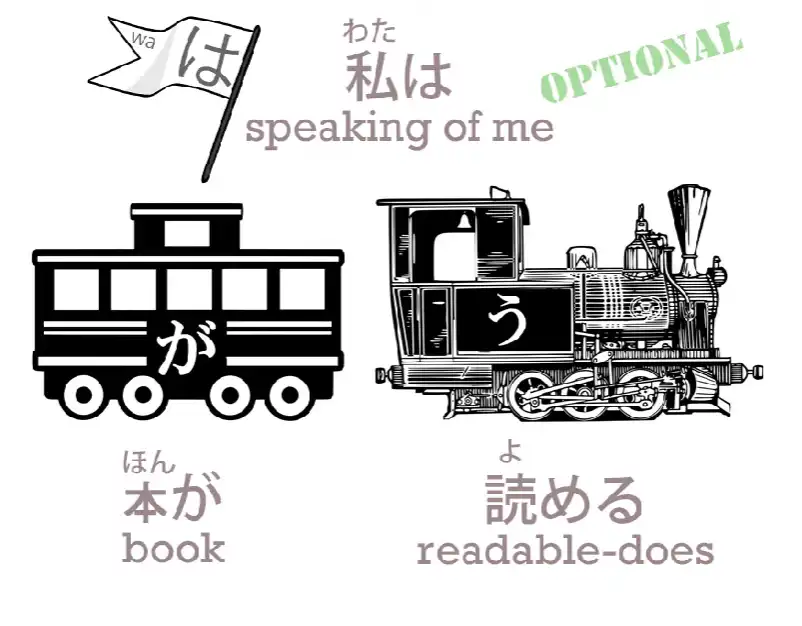
Note: The furigana of 私 should be わたし. There’s no exact English translation for this, because we’re not saying the book IS readable; it’s not an adjectival phrase.
We’re saying the book DOES readable.
So we just have to get used to the fact that Japanese is much more happy than English to treat states of being as verbal actions.
So if we want to say “I can read the book/As for me, the book does readable”,
we say “(私は)本が読める”,
but if we just want to say “I can read/I do readable”,
we might say “読める” or “(私は)私が読める”,
and again we have a self-move verb.
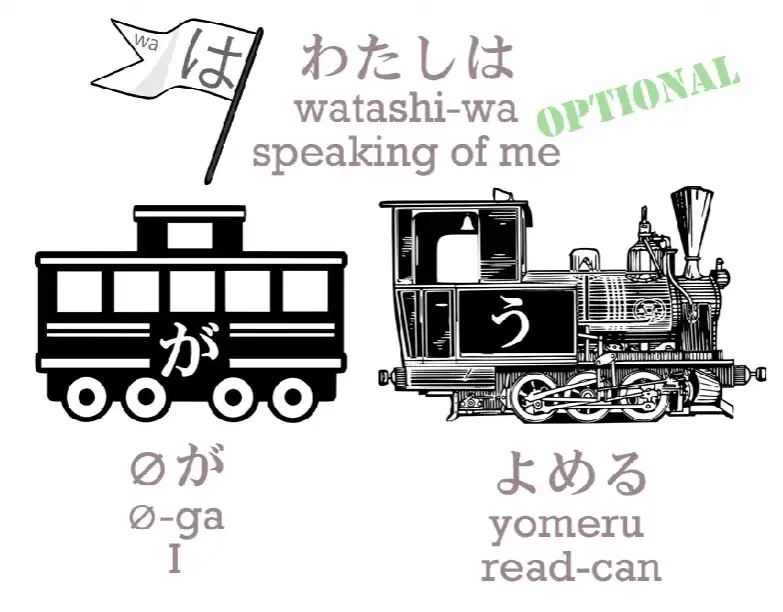
In one case we’re saying “I do readable (I am able to read)”, in the other we say “the book does readable (the book does being able to be read)” and that’s how it works.
However, it is also possible to use the potential in other-move contexts.
Usually this happens in modifying clauses.
These are sometimes called by Western textbooks “subordinate clauses”, which they are, but I think it’s better and clearer to call them “modifying clauses”, and I’ve done quite a lot of work on modifying clauses, so I’d recommend this video if you want to know exactly what I mean.
So, in modifying clauses particularly we can use the potential as an other-move verb.
For example, we might say “さくらを見られる日を楽しみにしている” This means “I’m looking forward to the day when I can see Sakura.”
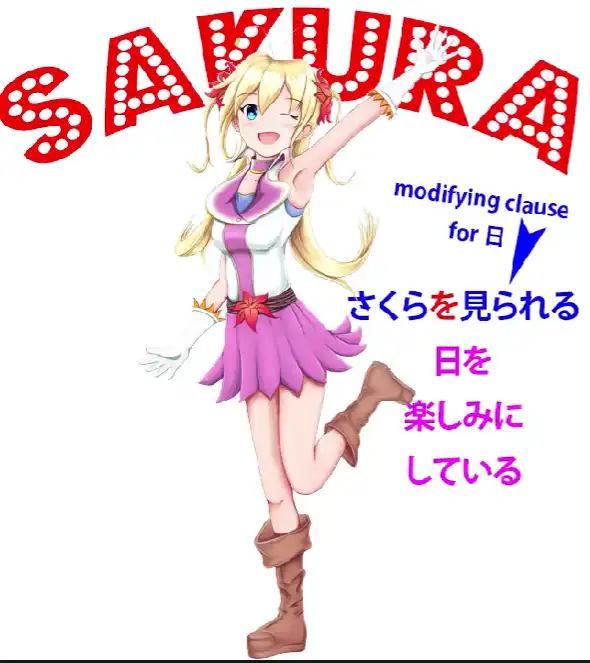
And as you see, here we’re saying “さくらを見られる”, using “見られる”, the potential, “being able to see Sakura”, as an other-move verb with an object, which is Sakura.
Now, we can do that with “見られる”, we can do that with “聞ける”, but we can’t do it with “見える” or “聞こえる”.
They are forced to be used as self-move verbs only.
And on the whole, because potential verbs mostly are self-move in Japanese, whether we’re talking about something else or whether we’re talking about ourselves, we use them in a self-move manner, those two are the most commonly used.
Actually we can use the other forms, the regular forms, “見られる” and “聞ける”, as self-move verbs too, but they can also be used as other-move verbs.
With “見える” and “見られる”, there is a difference in nuance, which is that “見える” usually means being able, actually physically able, to see something, and “見られる” more implies having the opportunity to see something.
So if we were to say “芝居/しばいが見られる”, we’re saying I have the opportunity to see the play.
If we say “芝居が見える”, we might mean the lady in front of me has taken off her big hat so I’m able to see the play.
However, this alone wouldn’t be, I think, sufficient reason for these two variants of the words surviving into modern Japanese.
The important reason, which is based in the very nature of seeing and hearing and expressions we use in connection with seeing and hearing, is this: they are both used in places where in English we would say that something “looks like” something or something “sounds like” something.
You can’t use the standard versions “聞ける” and “見られる”” for this.
You have to use these variants.
So if you say “さくらはカエルに見える”, you’re saying “Sakura looks like a frog”.
So when we say “looks like”, we use the targeting particle に with a noun, or with an adjective we use the く-stem of the adjective.
So we say “カエルに見える” – “looks like a frog” – or we can say of someone “若く見える” – “she looks young”.
And we can also use it not just for literally how something sounds to our ears or for how something looks to our eyes, but what its appearance is.
So we can say “奇妙/きみょうに聞こえる” – “it sounds strange / sounds peculiar”.
So, we’re not talking here necessarily about the actual sound.
It might not be a noise that sounds strange.
It may be something somebody said that sounds strange.
So we’re using either the adverbial form of an adjective or the adjective-making targeting particle に to describe how something appears to us, how something sounds to us, literally or figuratively.
And this is the real reason for the survival of these alternative forms of the potential.
They have this specific meaning, which the other form, the regular form, can’t have.
And it’s not a coincidence that it’s this forced, must-be self-move version that takes on that meaning, because the way something else looks, the way something else sounds, always has to be self-move.
We’re not talking about anything we do to the look or anything we do to the sound, but about how it looks and sounds in itself.
So this extremely self-move version (見える/聞こえる), which can’t be used in other-move contexts, is what is used in the case of both seeing and hearing to describe how something sounds to us and how something looks to us.
Note: in the comments, Dolly-先生 mentions some important point that did not make it into the video, given on her Patreon. Unfortunately, her Patreon is no longer available, possibly due to her passing, except for some comments she had left elsewhere. I guess we may never know.
55. Secrets of the で particle. Why do we say みんなで行く? and 世界で一番?
Secrets of the で particle. Why do we say みんなで行く? and 世界で一番? - Lesson 55
こんにちは。 Today we’re going to drill a bit deeper into some areas of Japanese structure.
I’m going to look at some aspects of the で particle that we haven’t looked at so far and, in order to do that, we’re going to have to look at some new structural concepts that we haven’t considered up to this point.
We haven’t considered them partly because you can get quite a long way in elementary Japanese without knowing them, but as we get into more complex areas it’s a good idea to have these tools in our tool box.
So, let’s get started.
As I’ve said before, almost all Japanese words divide into three kinds, that is, nouns, verbs and adjectives.
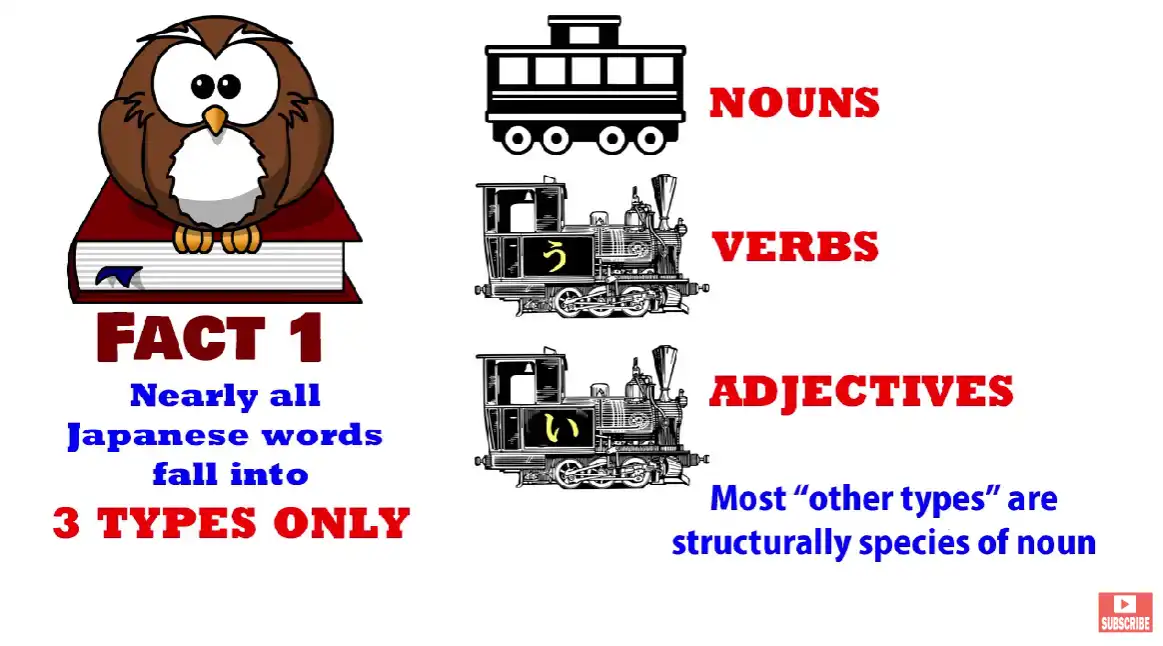
There are a few words that are outside these three but not a great number.
Most of the things that aren’t verbs and adjectives in fact turn out to be nouns.
体言 & 用言
However, there’s another way of dividing Japanese words which is used in Japanese grammar and that is into “体言” and “用言”, which literally means “body words” and “use words”, but the terms I’m going to employ is “static words” or “static elements” and “active words” or “active elements”.
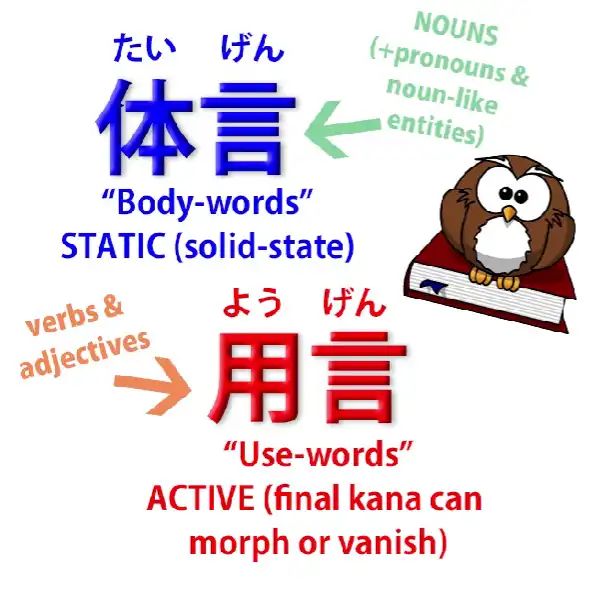
Now, static or body words essentially boil down to nouns, so in a way this underlines the noun-centered structure of Japanese, because we divide them into nouns and the rest, the other two.
And it’s very easy to see how this works.
By “active words” what we mean is those words that can transform, that can modify.
And that applies to both adjectives and verbs.
And in fact they transform in very much the same way.
In both cases the thing that transforms is always the last kana of the word.
And we know that both verbs and adjectives must always end in a kana.
They can’t be all kanji, otherwise they’d be nouns.
All verbs end in an う-row kana; all adjectives end in the kana い.
And that is the part, and the only part, that changes.
With godan verbs, the う-row kana changes to its equivalent in one of the other rows.
So, -す can become -さ, -し, -せ or -そ.
And ichidan verbs simply drop the -る.
Verbs can also modify into the て-form, and again this is essentially a question of either changing or dropping the final kana and adding -て or で.
And the same of course with た-form.
Adjectives can change the -い to -く, -か or -け, so we can have “美味しく”, “美味しかった” or “美味しければ”.
Or we can drop the -い altogether and add something else, as for example in “美味しそう”.
Nouns, on the other hand, can’t modify at all.
You can’t do anything with the last kana of a noun or any other part of a noun in terms of grammatical modification.
But you can add logical particles to a noun and you can also add the copula “だ” or “です” to a noun.
So, we have two sets of words: the “用言”, the active words which you can modify by changing the final kana and adding something but you can’t add logical particles or the copula to these, — and nouns and also pronouns and other noun-like entities, “体言” or static words, which you can’t modify but you can add logical particles or the copula.
And it’s important to understand that when we add the logical particle or the copula to a noun we regard those two things joined together as a unit.
So for example when we add the soft copula “な” to an adjectival noun like “綺麗/きれい” we have “綺麗な”, and “綺麗な” is regarded as a unit in itself.
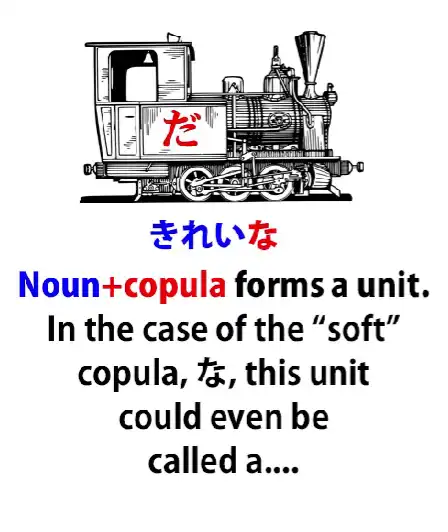
And actually that unit could be called a “な-adjective”, because “綺麗” plus “な” or “だ” becomes an adjectival unit.
So although I very much object to the term “な-adjective” in the way it’s used by Western textbooks, which is to say they will tell you that “綺麗” is a “な-adjective”, and it’s not – it’s a noun, it’s not any kind of an adjective – we could say that “綺麗な” or “綺麗だ” is a な-adjective.
I would not recommend it, simply because the term is so abused in Western so-called Japanese grammar that it’s best left alone.
It has a name in Japanese but since it would take rather a while to explain it, I won’t go into that here. But it’s not anything like “な-adjective”.
Now, the other thing to understand is that when we attach the copula to a noun, that combination is in fact a “用言” or active unit.
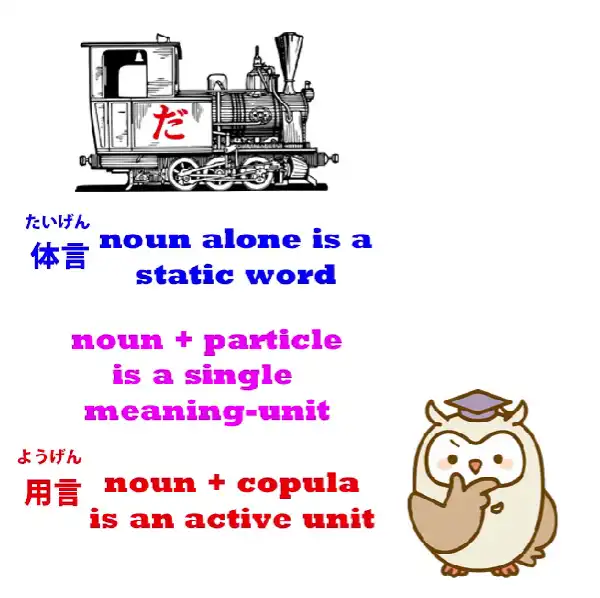
And that’s obvious, because once you’ve attached the copula to it, we can in fact modify it.
The copula has a て-form, which is “で”, so “綺麗な” can become “綺麗で” in order to conjoin it to something else.
We can also modify “綺麗だ” into, say, “綺麗だった”.
So, once we attach the copula to a noun, we have a “用言”, an active unit, and as I’m sure you have already worked out by now, this means that the three engines, the three possible ways of ending a sentence, are all “用言”, or active units. That’s to say, verb, adjective and noun-plus-copula.
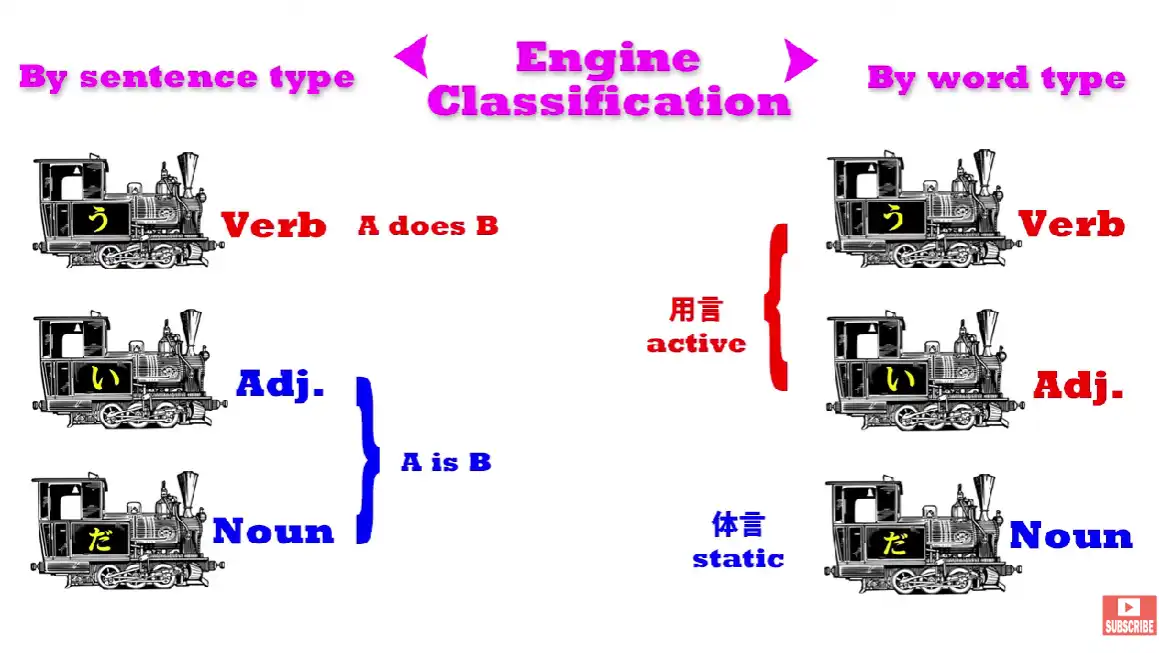
These are the three possible engines of a sentence and they are also the three possible “用言”.
We tend to call them “用言” when they’re modifying something else, when they’re inside a sentence.
So, armed with this information, we can now take a deeper look at the particle で.
A deeper look into the particle で
When I introduced it in the video on logical particles (Lesson 8b), I said that it, like the other logical particles other than が (which, of course, is in every sentence) and の (which is a logical particle, but it doesn’t tell us what its noun is doing in relation to the action of the sentence; it tells us about the noun in relation to another noun) but the other particles, including で, I said, were only active in A-does-B sentences, that’s verb-sentences.
Now, that is something of an oversimplification.
There is another way in which they can act.
It doesn’t become too much of a problem not knowing that at the beginning, but as we progress we need to understand this.
And in order to understand it we need to know what we’ve just learned.
We need to know about “体言” and “用言”, static and active elements.
Because the truth is not that で is absolutely restricted to verb-sentences, A-does-B sentences, although most of the time it is.
What it’s restricted to is clauses that modify “用言”.
And the “用言”, as we know, can be a verb, but it can also be an adjective or even an adjectival noun-plus-copula.
And there are some cases where this happens.
So what is で actually doing?
Well, as we know, there are three positional logical particles, and they are the targeting particle に (which tells us where something goes to or where it is, where it stays once it’s got there), there is へ, which is the directional particle, and there is で.
And what で really does is tells us the boundary or limit within which something happens.
Usually that’s a physical boundary, a physical area, though it doesn’t always have to be.
So, に tells where a noun (person, animal, thing) is headed to or where it’s located; へ tells us direction in which it’s going; で tells us the boundary within which an action or a state of being takes place.
It’s usually an action, so that’s how we introduce it, but it can be a state of being.
In other words, it can be an adjectival.
So for example let’s take the phrase “世界で一番美味しいラーメン”.
Now, people will ask, “Why で? Why are we using で in this case?” And the answer is that “世界で” – and remember that we always treat a logical particle plus the noun it’s attached to as a unit – “世界で” is defining the limit within which something is happening, but in this case it’s defining the limit within which a state of being applies.
So we’re talking about “the most delicious ramen in the world”.
“The world/世界” is the limit we’re applying.
And in this case, of course, with “the world” we’re trying to give as big a limit as possible.
But we might say, “この町で一番美味しいラーメン” and then we’re saying “the most delicious ramen in this town”.
So we’ve drawn a boundary around it.
We’re not saying it’s the most delicious ramen possible, but we are saying within certain limits, within the limits of this town, it’s the most delicious ramen.
So that’s what で is doing.
Just as with an action it tells us where the action takes place, the locality, the boundary within which it takes place, with the other kind of “用言”, an adjectival, it’s telling us the boundary within which that adjectival quality prevails.
Now, we can also say “世界の一番美味しいラーメン”.
That’s less commonly said, but it could be said.
And what that means is “the most delicious ramen of the world”, but the point to understand here is that で is drawing the boundaries of the “用言”, the active element, the verb or in this case the adjective; の is doing something different.
We know what の does: it links one noun to another.
So it’s not modifying the quality of “美味しい”, as で is.
It’s modifying “ラーメン”.
And because of this we can also say “このラーメンは世界で一番美味しい” – we’re saying “This ramen is the most delicious in the world.” But we can’t say “このラーメンは世界の一番美味しい”
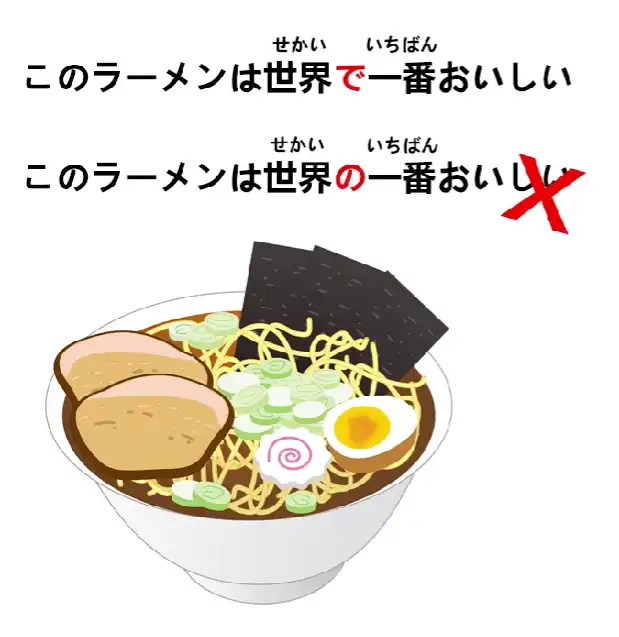
Why can’t we?
Because, as we know from the lesson on word order (Lesson 46), in Japanese words only modify words that come after them.
They can’t modify words that come before them.
And because の can’t modify “美味しい”, it can only modify “ラーメン”, which is another noun, and because “ラーメン” is on the wrong side of it, we can’t actually use that.
So we have to say “このラーメンは世界で一番美味しい”, because で sets the boundary within which “美味しい” prevails.
Now, since we know that a noun-plus-copula also functions as a “用言”, an active element, we can also say “世界で一番有名なアンドロイド”.
And in this case, “世界で” is modifying “有名な”.
It couldn’t modify “有名” on its own, because “有名” is a noun, but it can modify “有名な”.
So it’s telling us the boundaries within which this fame operates.
“She’s the most famous android in the world”.
She may not be the most famous android in the Solar System, but she is the most famous android in the world.
Now the same happens when we say something like “みんなで踊る” – “we all dance”.
Why do we say “みんなで”?
Well, if we say “二人で踊る”, we’re saying “two of us dance”.
If we say “一人で踊る”, we’re saying “dance alone”.
The quantitative sentence plus で is describing the limits of the people who do it.
So, as I said before, the boundary or area or demarcation that で draws for us is usually a physical one, a place.
If we say “部屋で踊る”, we’re saying “I dance in the room.” But if we say “一人で踊る”, we’re saying “I dance alone.” In both cases we’re drawing a boundary to say what are the limits.
The physical limits are the room, and the numerical or quantitative limits are “一人”, “二人”, “みんな” etc.
56. “Agility”: Deeper secrets of は and の particles
“Agility”: The Vital Language Factor No One Mentions. Deeper secrets of は and の particles| Lesson 56
こんにちは。 Today we’re going to talk about a topic that isn’t often referred to, which is agility in language.
And I’m not talking about my ability or your ability in language.
I’m talking about the agility of language itself, the ability of languages to express certain things in economical, swift-footed ways that other languages find more difficult.
And this is important because when languages have greater agility in particular forms of expression they use them in ways that seem quite unfamiliar and strange to people whose languages can’t handle those forms of expression in the same agile manner.
And this often leaves learners quite puzzled as to what’s going on in a lot of sentences.
So, I’m going to start off with one of the most fundamental and structural causes of this problem, and that is the topic-marking particle は.
Particle は
Once people get the idea that は is a topic-marker and is always a topic-marker, they often then start to say, “Well, why are we using a topic-marker?
Why are we saying ‘as for this apple’ in places where it seems really not something we would do in English or in many other languages?” Now, the reason for this has to do of course with the fact that Japanese is what linguists call “a topic-prominent language”.
Topic-comment structure is very fundamental to Japanese in a way that it isn’t to English, and I’m going to talk about that at greater length in a future video.
But currently what I want to talk about is how this affects the matter of agility, how it makes the formation of a topic a very lightweight, a very agile, a very quick-footed operation, which in other languages, like English, it isn’t.
So, I’m going to reintroduce a sentence I used in my first advanced lesson on the use of the は-particle, and that is: “アフリカはライオンはいるがトラはいない” Now, as you see, we have three はs in the space of a very short sentence and they are indeed all topic-markers, because は always is a topic-marker.
And I have explained what’s going on, but we’re going to look at this in terms of agility.
What’s going on, of course, is that the first は is the overall topic-marker.
It’s saying “アフリカは…” – “Speaking of Africa…” and everything that follows is going to be a comment on the topic of Africa.
What follows a は-marked topic has to be a logical clause.
It doesn’t matter how small it is, but it must be a logical clause.
And it must contain both the necessary elements of a logical clause just like any other.
What we have here in fact is a logical sentence consisting of two logical clauses and each of them contains what we might call a subtopic.
That’s to say, each logical clause in itself also has a topic statement preceding it.
So if we write it out in full, it would be “アフリカはライオンはzeroがいるがトラはzeroがいない” So the two logical clauses are “zeroがいる” and “zeroがいない”, but both of them state their own subtopics.
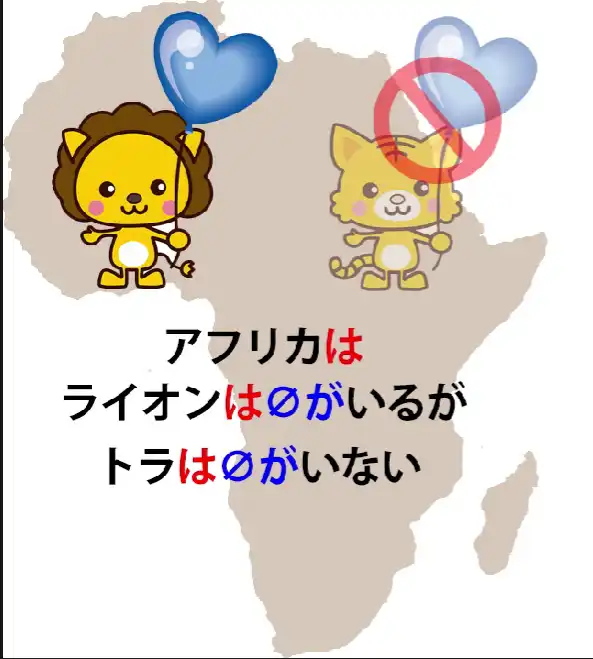
So, why are they doing that?
Well, we know this already.
It’s because は is used to distinguish things.
So what we’re saying here is “Speaking of Africa, speaking of lions, they exist, but speaking of tigers, they don’t exist.” Now, I think we can see how this works in English and how it uses topic-marking to distinguish two different states of affairs.
But this isn’t something we would ever say in English. Why not?
Because this “speaking of” in English is not agile at all.
It’s setting up a rather dramatic and heavy, cumbersome way of introducing a subject.
We can’t just keep saying “speaking of” in a sentence, because “speaking of” and the various other ways that we introduce topics in English are not agile.
Japanese は is very, very agile.
We can freely throw it in wherever we want to create a distinction like this, because は distinguishes things.
When we change a topic using は, we are implicitly saying that the comment on the new topic is different from the comment on the old topic.
If we want to say that the comment is the same, then we have to use the other topic-marker, も.
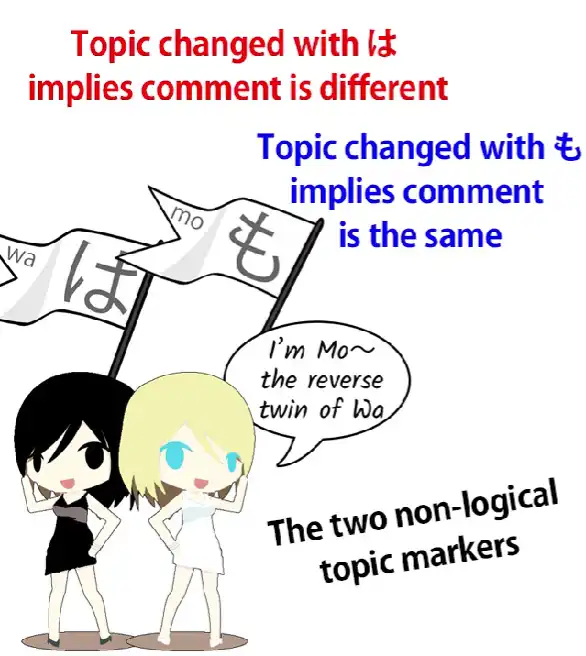
And this sentence actually doubles down on that by giving a は to both the compounded logical clauses.
So we’re saying “speaking of lions…” this topic has a comment which is different from another topic that may be nearby.
But “speaking of lions, they exist”, and then “speaking of tigers…” this topic also has a comment that will differ from the comment on any nearby topic: “they don’t exist”.
Now, as you see, this is a very cumbersome process if we think about it in English.
But if we understand it in Japanese, if we know how the は-particle is used lightly and easily and agilely in this kind of circumstance, it ceases to be a problem.
Particle の
Now, another area where we often get confusion because of the agility of a Japanese element in comparison to any way we would imitate it in English is the の-particle, the so-called nominalizing の, which acts as a pronoun and bundles everything coming before it, everything modifying it, into a noun-box, into a single noun-like entity.
And one of my patrons asked me this question, and it’s a short sentence and it ought to be fairly simple, but my patron found it quite difficult, and I think a lot of people find this sort of thing quite difficult.
Not because it is difficult, not because the structure is actually hard to parse, but because it’s very unlike what we would do in English or many other languages, under the same circumstances.
So, this comes from a Disney song, “The Bells of Notre Dame”, and the first line is “朝のパリに響くのは鐘だよ”.
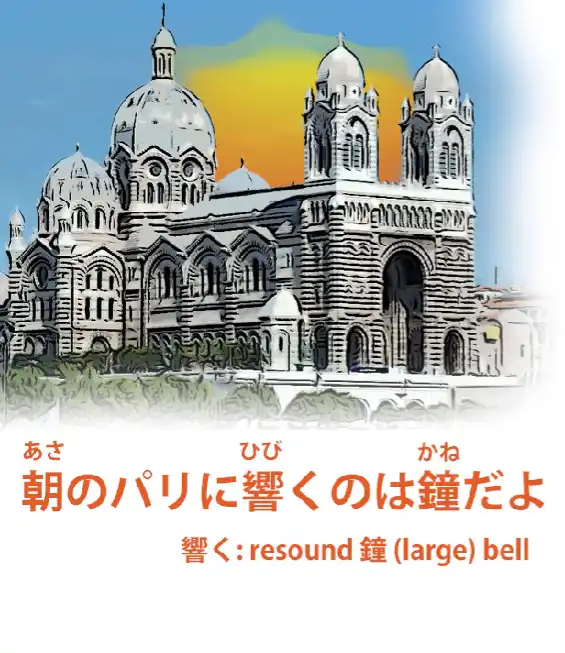
So, as you see, this is quite a short and simple-looking sentence.
But can you see where the A and the B of this sentence are?
My patron suggested that this meant “A bell resounds in morning Paris” and that’s more the sort of thing we would be saying in English.
But we can see that this is in fact an A-is-B sentence and we can see also that it has a は-marked topic and that the は-marked topic comes quite near the end.
So the A-is-B, the logical structure, has to come after the は-marked topic.
So what’s the は-marked topic?
The は-marked topic is “朝のパリに響くの”.
So の is bundling the rest of it, “in morning-Paris-resoundsの”, in other words “that which resounds in morning Paris”.
And then of course we must have a logical が-marked subject which has been defined for us by that の.
So, “that which resounds in morning Paris, it is (or they are) bells, よ.”
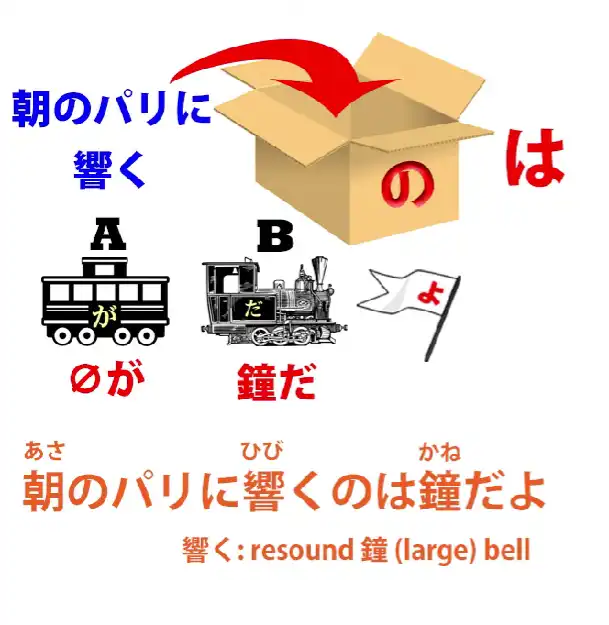
So why is it being put in this way?
You might say, because it can be.
In English, this is difficult.
In English, “that which resounds in morning Paris, that’s bells” doesn’t sound natural at all.
And the reason is because setting up a topic like “that which resounds in morning Paris” is not straightforward in English.
It’s not agile; it’s cumbersome; it’s large; it’s slow-footed.
But in Japanese we do this all the time.
We say things like “That which she saw when she went into the room was…” Now, in English we’re much more likely to say “When she went into the room she saw…” or “In Paris in the morning bells resound throughout the city.” If we want to use this “that which…” kind of structure, we have to have built up to it.
If we, for example, have spent some time establishing the fact that she’s nervous about what she’s going to see when she opens the door and looks into the room, then we can say “What she saw when she looked in the room was…” But we need to have set that up.
We need to have made some kind of preparation to use that form, because it’s not agile.
It’s not a lightweight thing that we can just slip in anywhere.
On the other hand, Japanese can use this as a narrative technique,
setting up anticipation of what she saw and resolving it very quickly over the course of a short sentence and without making any fuss about it,
because it’s a light, agile verbal formula.
And because of that, you’re going to see it all over the place in Japanese, so you need to get used to it.
But really the important point of this lesson is the concept of agility itself,
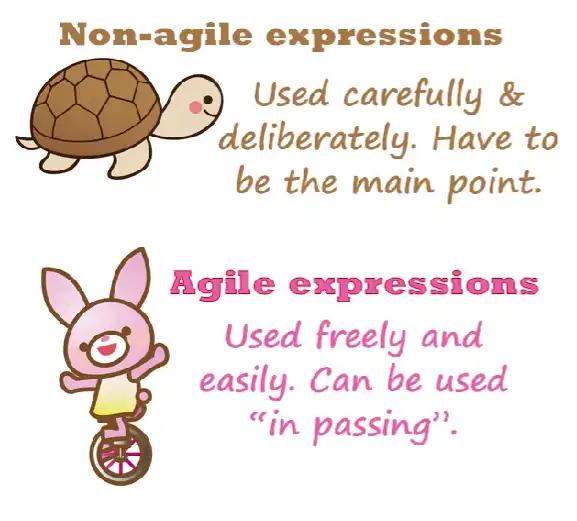
because we’re going to come across in Japanese as we go forward
various cases where Japanese uses expression strategies
which may seem very unnatural and strange when you try to translate them into English,
because the English equivalents are not agile
and the Japanese equivalents are very agile and lightweight.
And one of the things about being agile and lightweight is not so much that it’s easy to say in itself but that it’s easy to shoehorn into the middle of saying something else.
In other words, it doesn’t have to be the main point of the statement.
In English you can’t say things like “speaking of…” or “as for…” unless that’s going to be the main point of the statement.
But in Japanese you can because it’s lighter, it’s more agile…
57. 込む (Komu) and the secret of multi-meaning Japanese words
込む Komu and the secret of multi-meaning Japanese words - Lesson 57
こんにちは。 Today we’re going to talk about one word in particular that has a lot of different meanings in different contexts and can be attached to other words.
But, more than that, we’re going to talk about how this kind of word works and how we can understand them.
We often see in dictionaries words that have a whole range of different and apparently unconnected meanings.
I’m not talking about homophones here, where the kanji are different.
They may not be related, though they sometimes are.
But I’m talking about words that actually are the same word but have a range of different meanings.
And in these cases the important thing to understand is that normally there’s going to be a base, concrete meaning and then from that a number of metaphorical meanings.
And this isn’t just a side issue with human language.
Human language, whenever it discusses abstraction, uses words that are based in concrete, physical metaphors.
And we may sometimes forget the concrete, physical metaphors, but they’re always there.
Even when we talk about time, we have to talk about it in terms of space.
We talk about time “going forward” or “going backward”.
We talk about a time “line” – a line is an entity that exists in space.
We can’t actually discuss time without discussing it in terms of space.
And this continues with all other abstractions in human languages.
The word “focus” originally means a “hearth”.
People used to sit around the hearth fire and that would be at the center, the focus of their activity.
And from that physical metaphor come all the extended and abstract meanings of the word “focus”.
The word “stimulus” originally meant an “ox-goad”, a pointed stick that you would drive oxen along with.
And from that come all the abstract meanings of “stimulus”.
“Politics” comes from a word that simply means “city”.
“Economics” comes from a word that simply means “house”.
Now, we don’t need to know the physical metaphors on which words like this are based, but when we come across words in Japanese that seem to have different and contradictory meanings, we do need to understand the basic metaphor in order to grasp the other meanings without learning them as a long laundry-list of apparently random things.
So, if we see the word “切る” in a dictionary – which means “cut” – we see lots and lots of meanings for it like “ending a conversation”, “severing a relationship”, “crossing a field”.
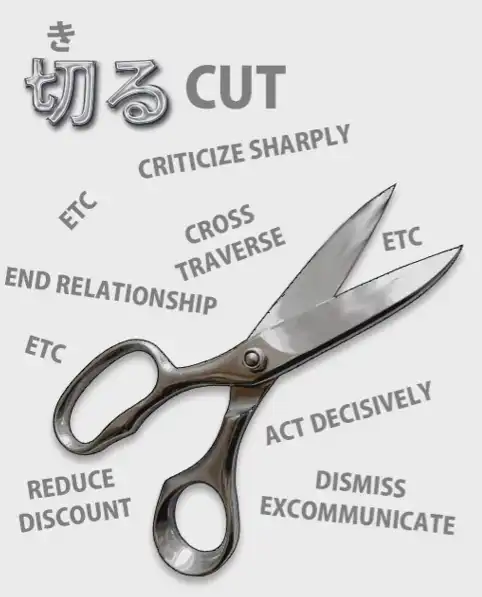
And all of these just come from the basic meaning of “cut”.
Even in English we talk about “cutting across a field”.
Now, that’s easy enough, so long as we understand the principle, with a word like “cut”, where we have a very definite, clear-cut (if I may say so) equivalent in English.
But when we come to words which don’t have an exact English equivalent, it can get a bit harder unless we understand what they mean.
And one of those words, which we’re going to see everywhere in Japanese, is the word “込む”.
込む
Now, “込む” does not have an exact meaning in English, but we can see what it does mean by looking at the kanji.
The kanji is essentially the kanji of “入る / 入る / 入れる”
– “go in” or “put in” – and that’s on a “road”.
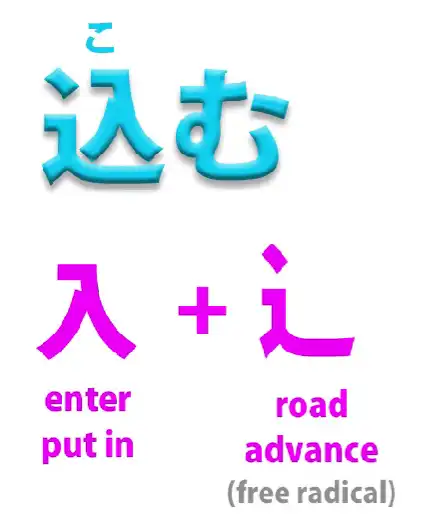
It’s a road that some people call “the water slide”.
I always see it as a “fast road” and that’s exactly what’s going on here.
It’s “putting in on a water slide / putting in on roller skates / cramming in in large quantities / putting in rapidly / putting in vigorously”.
That’s what “込む” means.
Now, we may encounter it first of all in very simple, concrete meanings such as “込んでいる”, the state of being “込む”, and that means “crowded”: a lot of people crammed into the same space, crowded.
Now, it can have more abstract meanings like “complicated”, which is essentially the same: a lot of ideas, a lot of concepts, crammed into the same mental space, that’s a complication.
#
飛び込む
And then it becomes attached as a helper verb to the i-stem of other verbs.
So we have “飛び込む”, which means “jump in”.
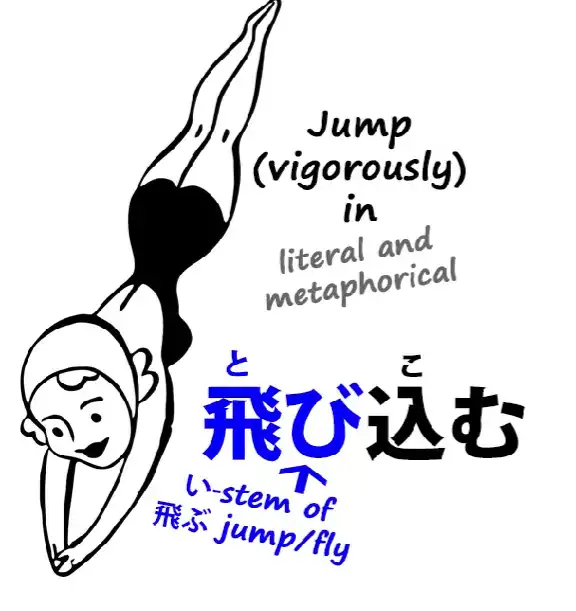
It can mean literally jump into the water or something, but it can also mean jumping vigorously into a conversation, a situation, or any of the other metaphorical uses of “jumping in”.
#
黙り込む
It can become more abstract, with concepts like “黙り込む”.
“黙る” means to “be silent”.
“黙り込む” means to “be quiet” about something / “clam up” about something, in other words, be quiet and keep everything 込む-ed up inside oneself, not letting anything out.
#
読み込む
Now, the word “読み込む” is one that you’ll see often if you have your computer or your tablet or whatever in Japanese.
(And if you haven’t, why not?) You’ll often see the word come up “読み込み中”.
Now, “-中” means “in process of”.
It means literally “in the middle of” – another metaphor, because literally it means “middle” or “center” or “inside”.
But in this case, when it’s attached to a verb like this, “中” means “in the process of”.
As we might say in English, “in the middle of doing something”.
“読み込み中” is “being in the process of 読み込む-ing”, and “読み込む” here means “loading”.
It means “reading and cramming in”: reading data and putting it into memory.
But the word has various other meanings, and while they are different, they’re all based on the same fundamental metaphor.
So “読み込む” can mean reading something several times, reading it thoroughly.
“込む” can mean doing something repeatedly, because again it’s cramming in iterations of doing it, cramming in reps, you might say.
But it can mean reading thoroughly, it can mean reading repeatedly, in any case it means cramming the subject matter into your mind.
And again, “読み込む” can mean reading something into something: somebody says something or you see a text, and you put in extra meaning which you believe to be there.
And very often it is. Texts can have implications.
Reading something into something again can be “読み込む”.
And again it’s a very obvious and natural use of the metaphor.
And once again, “読み込む” can mean reading poetry or something with feeling, with emotion.
You’re not just reading it; you’re putting something into it, you’re putting in the emotion, you’re cramming it with something, with emotion, with feeling, with expression.
So, all these meanings of “読み込む” are different and yet all of them essentially conform to the same metaphor: read and cram something in.
#
思い込む
Now, another common compounded verb with “込む” is “思い込む”.
Now, the most common use of that, I would say, is to “be under the impression / to be convinced of” something, usually something that turns out not to be true, but that doesn’t have to be the case.
So, “思い” is “thought” and “込む” is “cramming in”, so you have this thought crammed in, or this set of thoughts crammed into your mind.
Whether they’re true or not, they’re in there, they’re lodged in your mind.
And, interestingly, in older English, people sometimes used to talk about “cramming” someone, meaning filling them up with wrong ideas, giving them false impressions, cramming into their mind a particular set of ideas which would generally not be correct, at least in the opinion of the speaker.
So “思い込む” in that sense usually means having a strong impression, a strong belief, a strong notion that something is the case that probably in fact isn’t.
But “思い込む” can mean other things as well.
It can mean “being in love” and it can mean “having one’s heart set” on something.
And in order to understand that, we need to know a little more about the word “思い”, which, as I pointed out toward the end of another video, doesn’t necessarily just mean “thought” or “feeling”.
It can also mean “love” or “desire”.
So, for example, the word “片思い” means “one-sided love”.
“片” generally means “side” or “direction” and “片思い” is “one-sided or one-directional love / unrequited love”.
So “思い” there is being used in the sense of “love / affection / desire”.
So “思い込む” can mean “being in love”.
It can also mean “having one’s heart set on something”, and that doesn’t necessarily mean loving a person.
It could mean having one’s heart set on going on a picnic, or anything.
The point here is that “思い” in the sense of desire and love is crammed into one.
It’s not just a passing whim, it’s something that one’s whole heart is set on,
something “crammed in”.
We’ll come across a few other meanings of “込む” too, especially when it’s used,
as it very often is, as a helper verb put onto the い-stem of another verb.
But once we understand this point, that it’s to do with cramming, that it’s to do with filling, that it’s to do with thoroughness, completeness, or with locking away, then we can understand how these other words are going to work when we hear them.
Note: there is this one interesting comment. Shame we can’t hear Dolly’s thoughts on it :{
58. Japanese double particles. How they work
Japanese double particles. How they really work - lesson 58: Particle Combinations
こんにちは。 Today we’re going to talk about “combined particles” or “double particles” or whatever silly names the textbooks and Japanese grammar sites call them by.
And I’ll explain in just a moment why I’m calling them “silly”.
What I’m referring to is particles in combinations like “には”, “にも”, “-とは”, “のが” etc.
And if you look at the sites you’ll find lots of rules like “you can use に with は and も, but you can’t use it with が or で”; “you can use -と with this, but not that”, and so on.
And you don’t need to learn any of these rules.
If you understand what’s going on and why it’s happening, it all makes complete logical sense.
There are no random rules happening here, just straightforward logic.
The reason it gets so confusing in English-language so-called Japanese grammar is because they’re not just giving the wrong answers.
They’re giving the wrong answers to the wrong questions.
They’re posing questions that should never have been posed in the first place.
There’s really no such thing as a “double particle” or a “combined particle”.
What’s happening all the time is that
the particles are just doing their job the way they always do.
So what about all these random rules about when they can do it and when they can’t?
Well, all these are actually based on what the particles are and what they actually do.
So, the first distinction to make, that the textbooks and websites never make, is the distinction between logical and non-logical particles. This is absolutely crucial.
Logical & non-logical particles
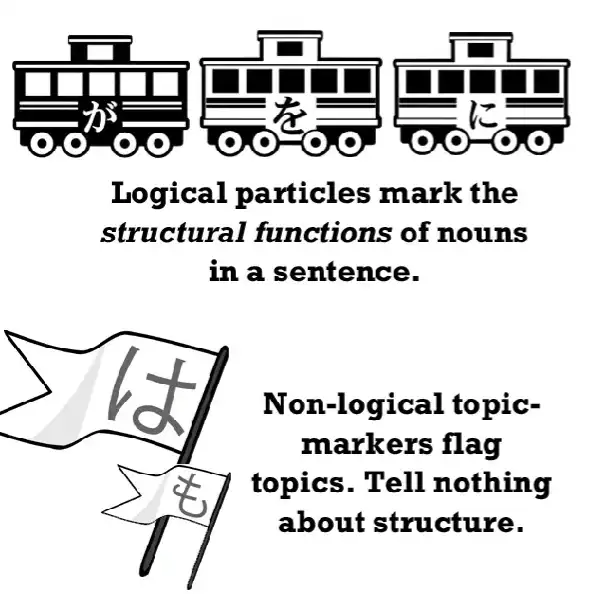
So, let’s start by looking at the five main logical particles.
These are the particles that tell us what’s going on in the sentence.
They mark each noun with the role it plays in the sentence, whether it’s the person doing something, the thing that’s being done, the thing it’s being done to, the place where it’s being done, etc. etc.
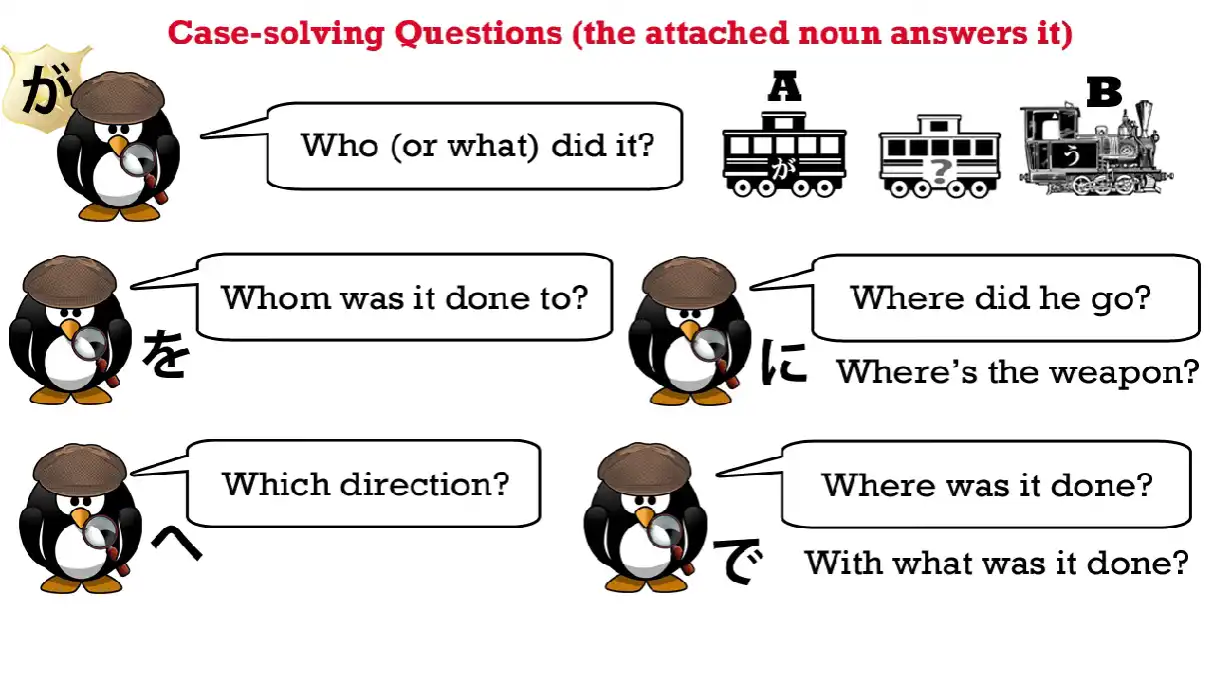
Now, the first obvious thing to understand is that you can’t combine any of these five logical particles with any of the others.
Why not?
Because of what they do.
They mark each noun with its function in the sentence.
A noun can’t actually be more than one part of speech at the same time,
so it would just make no sense at all
to combine any of these five together with each other.
But what you can combine them with is non-logical particles, notably the two non-logical topic markers, は and も.
You can combine these because they don’t clash logically.
は and も don’t tell us anything about what a noun is doing in the sentence.
It’s only ever marking that thing as a topic, either to make it the topic of the sentence or to make it a sub-topic for strategic reasons, which we’ll talk about in a moment.
Primary & secondary particles
Now, the next thing to know is that the two primary particles, or the primary and secondary particle, that is, が and を, don’t combine with non-logical particles.
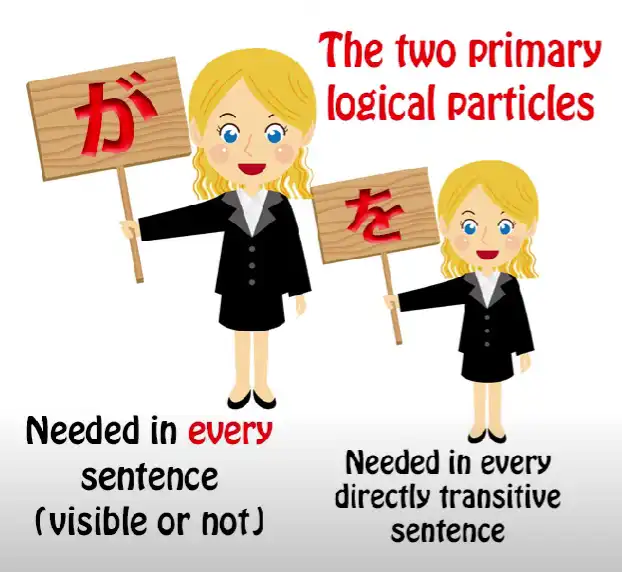
Why don’t they?
Well, が is the primary particle: it has to be in every sentence of every kind; を is the secondary particle: it marks the direct object.
This means that in any sentence that is directly transitive, を has to be present, whether we can see it or not.
Now, what do I mean by directly transitive?
All the textbooks and the dictionaries confuse transitivity with Japanese self-move and other-move verbs.
And in a way this is understandable, because there’s a large overlap between the two.
But they aren’t the same thing.
So let’s look here at what we mean by actual transitivity.
If I say “I walk”, “I sing”, “I eat”, those are all intransitive because I’m doing the verb and I’m not doing it to anything else.
It has no direct object.
If I say “I sing a song” or “I read a book” or “I eat bread”, then this is transitive because the verb has a direct object.
Now, when I say “directly transitive”,
what I mean is verbs that are done directly to an object.
So, for example, I can say “I talk to Sakura” but in English, as you see, we have to have a preposition there.
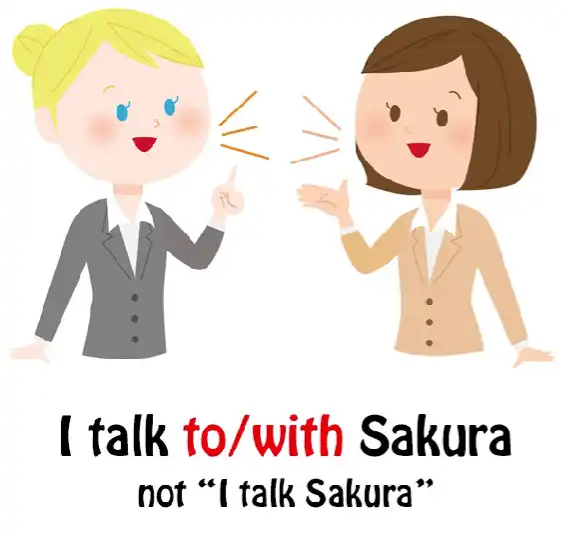
We’re not saying “I talk Sakura”, so we’re not directly transitive, we’re indirectly transitive through the medium of a preposition.
Now, Japanese has the same distinction.
We don’t say “さくらを話す”, which would be the equivalent in English of “I talk Sakura”.
We say “さくらと話す” or “さくらに話す”.
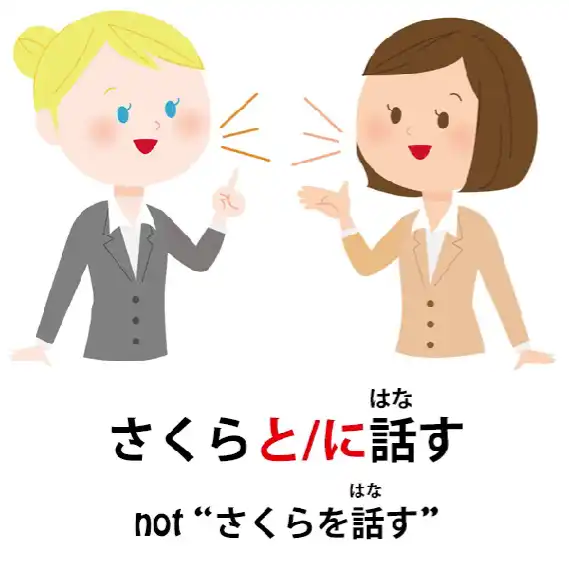
Now, please don’t run away from this with the idea that particles like に and -と are the same as English prepositions.
They’re not.
If you’re going to compare them to anything in European languages, you have to compare all the logical particles to the German or Latin case structures.
You may not know what those are and you don’t need to, because I model these in ways that don’t require knowledge of European grammar.
But the point here is that they’re not prepositions, but for our purposes here we can say that they’re used under the same circumstances that prepositions get used in English.
So if we say “I eat bread”, that’s directly transitive.
If we say “I talk to Sakura”, that’s indirectly transitive.
In Japanese, if we use the を particle, it’s directly transitive.
If we use another particle, like -と or に, it’s indirectly transitive.
In some cases English and Japanese will disagree about what is directly transitive and what’s indirectly transitive, but an awful lot of the time they’re in fact in agreement because these are fairly basic factors of human communication.
Now, the point here is that these two direct particles – if we say “I hit Sakura” there are no prepositions anywhere. This is completely direct.
I do the hitting and I’m hitting something, I’m hitting Sakura.
I’m not hitting to Sakura or hitting at Sakura or hitting by Sakura.
I’m directly hitting Sakura.
Now, because of the directness of these two particles they can’t have a non-logical particle appended to them.
So, if you want to use a non-logical particle here, you can do it.
But the way you do it is always by simply attaching the non-logical particle and leaving the logical particle out.
And because these are so fundamental to every sentence, they can be understood by the hearer in Japanese.
So, if we say “さくらはなぐった”– “I hit Sakura” – this means “(zeroが)さくらはzeroをなぐった”,

but we don’t say “さくらはをなぐった” or “さくらをはなぐった”.
Because you can’t put anything between these two direct fundamental logical particles and the thing they directly connect to.
So now we understand the basis for practically all the strange rules that you’re going to hear about.
You just need to remember these two facts:
you can’t pair one of these main five logical particles with any of the other four
and
you can’t put a non-logical particle before or after the two primary particles が and を.
Now, once we know that, what have we got left and how does it work?
We can pair non-logical particles with any of the remaining logical particles.
And the reason we’re doing this is not to make some kind of weird, unusual pair-combination.
We’re simply using the functions of both at the same time.
So the most straightforward thing we do here is simply make something into a topic.
If we say “(zeroが)冬には雪だるまを作る”, we’re saying “In the winter we make a snowman.”

Now, we could say “(zeroが)冬に雪だるまを作る”.
We don’t have to have the は there.
So why would we choose sometimes to have a は there?
Well, in this case we’re making it the topic of the sentence.
We’re saying “here’s winter/speaking of winter, this is what we do.”
And it also plays the other roles that は always plays
as an extension of its topic-making nature.
And I’ve done a video on these multiple uses of は, so if you’re not familiar with this, please take a look at it, because it’s rather important for understanding what’s going on here.
So, we’re making a topic out of the winter and we’re also differentiating winter from other seasons.
We’re saying “冬には” –
“As for winter, as opposed to the other seasons, we make a snowman.”
Now, if the person you were talking to was someone
from a very, very cold place, they might say
“(zeroが)春にも雪だるまを作る”.
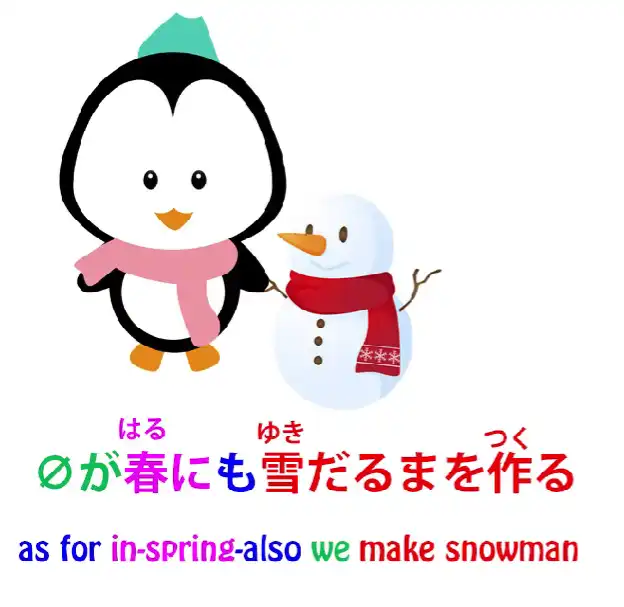
So what they’re saying is “We make a snowman in the spring as well.” So we can use the exclusive particle は or the inclusive particle も.
And both of them add that degree of meaning.
Now why do we have the に here?
Because we actually need the に.
We need the に to mark the fact that we’re doing an activity at a particular time.
This is the logical function of に.
And having done that, we can also make a topic out of it.
And that’s simply what we’re doing here.
In other cases we might say “明日学校に行く” and that simply means I’m going to school.
If we say “明日学校には行く”, the implication is that we’re going to school but we’re not going somewhere else that they thought we might be going.
If we say “明日学校にも行く”, we’re saying I’m going to school as well as somewhere else that you already know about.
So you see, in each of these cases our non-logical particle is simply adding meaning to the logical particle that’s already there.
They don’t clash, because one is logical and the other is non-logical,
so they’re not telling us conflicting information.
They’re telling us complementary information.
And that’s why you can use them that way and why you can’t combine one logical particle with another logical particle or one non-logical particle with another non-logical particle.
Now, there are other particles that can pair with other particles, but again, this whole pairing concept is the wrong way of looking at it.
As always the particles are simply doing what they do.
For example, the の particle, if it’s the nominalizing の, the の that turns something into a noun, so, for example, “泳ぐの” is “swimming”, the noun “swimming”, the activity called “swimming”.
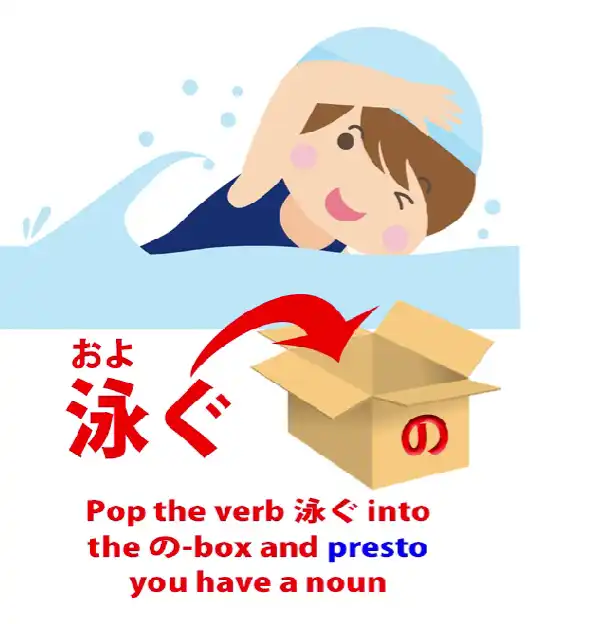
We can say “泳ぐのが好きです”.
We can say “泳ぐのをします”.
You can combine any logical particle with の because that kind of の turns the thing before it into what is effectively a noun, and a noun can take any of the logical particles.
It could be a longer logical clause:
“さくらと一緒に泳ぐのが好きだ” –
“I like swimming together with Sakura”. / Sakura together with swimming pleasing is.
Note: gave a bit more literal translation just in case, 好き is an adjectival noun. Go by Dolly tho.
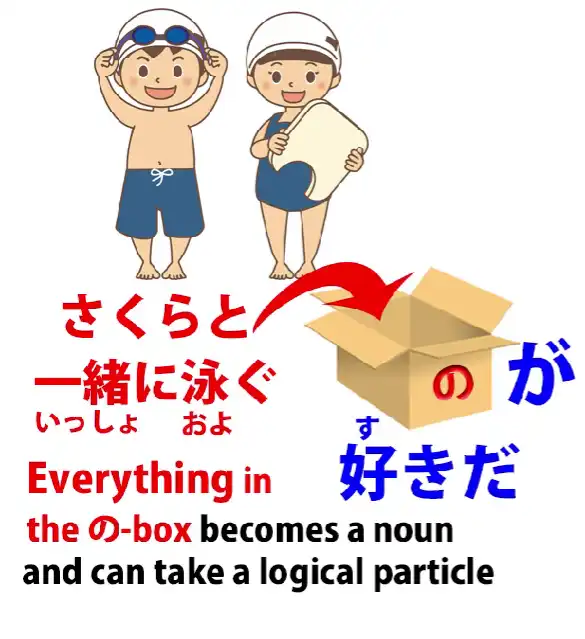
But the point is that once you’ve put that nominalizing の onto the end of it, when it’s the の that turns something into a noun, you then treat it as a noun.
And what do you do with a noun?
You put a logical particle onto it, don’t you?
So, this is simple logic.
If you have any questions or comments, please put them in the Comments below and I will answer as usual.
I’d like to thank my Gold Kokeshi patrons, and all my patrons and supporters on Patreon and everywhere.
59. Untranslatable Japanese exists! How to understand it
Untranslatable Japanese exists! How to understand it - Lesson 59
こんにちは。 Today we’re going to talk about something that makes quite a range of Japanese sentences difficult for English learners to understand.
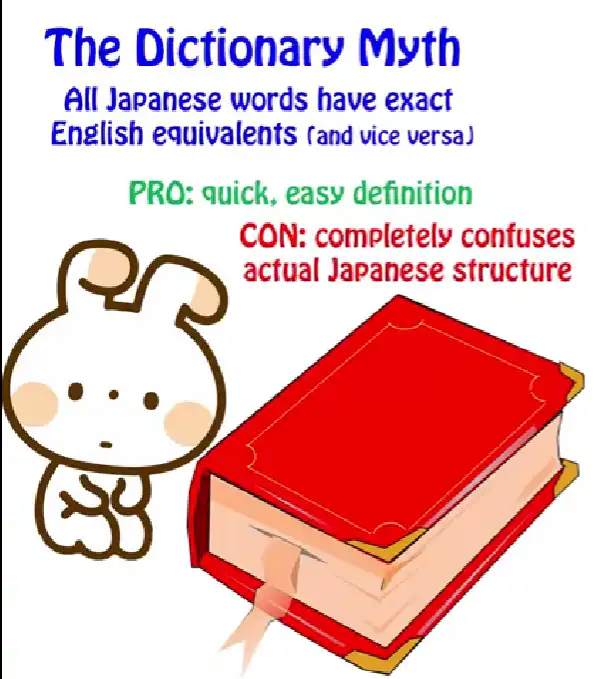
And that is something that I call “the problem of passivity in Japanese”.
And I’m not talking here about the so-called Japanese passive, which is actually the receptive helper verb.
That’s a problem because of the tendency to call it passive when it isn’t, but there are actually several Japanese constructions that go deeper than this and cause problems by being regarded and translated as passive even though they’re not actually called passive.
And this matters because if we see them as being passive, then we’re going to misunderstand the sentences, we’re not going to understand why the logical particles are in the places that they are and, especially with more complex sentences,
we’re just not going to be able to work out what’s going on at all.
Now, as I’ve said before, there is not any actual passive voice in Japanese, but something to consider here is that there is something that we can call the passive nature of Japanese as a whole.
And this has nothing to do with the grammatical passive voice as it exists in English.
This is more of a philosophical than a grammatical passivity.
And by “passive” here I simply mean the opposite of active.
As I’ve explained before, the Adam and Eve of Japanese verbs are “ある” and “する”, “ある” meaning “be” and “する” meaning “do”.
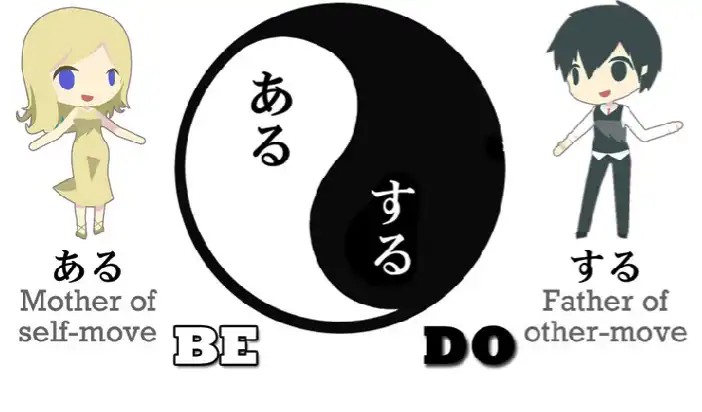
And while we call them the “Adam and Eve”, we should really refer to them as the “Eve and Adam”, because there is a tendency in Japanese to regard “being” as prior and primary to “doing”, whereas English tends to think of things the other way around.
It tends to be activist in nature.
And there are a whole range of Japanese verbs which depict not actions as we understand them but states of being which are regarded grammatically as if they were in fact actions.
And again, understanding that this is the case is vitally important to understanding how sentences work.
And we can start this off with something that isn’t in fact usually translated as passive but would be a little bit better if it were translated as passive and that is something we’ve looked at already in another context, which is that if we say “本が分かる”, this gets translated into English as “I understand the book” and it doesn’t mean that at all, because as we can see the book is the が-marked subject of the sentence.
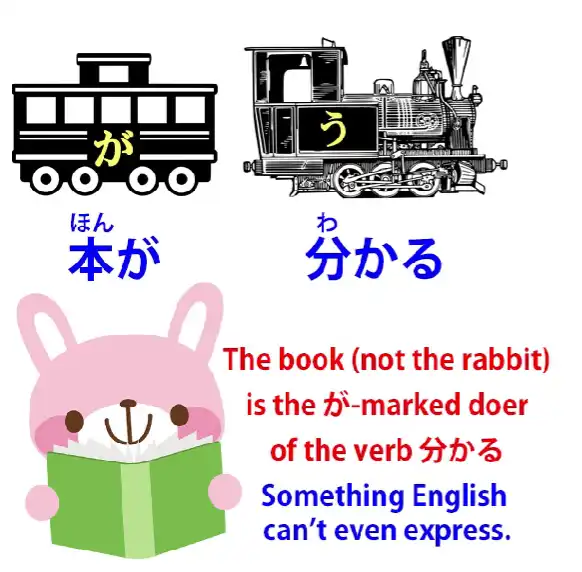
So it’s the book that’s doing something, not me. I’m not doing anything.
And in fact it does much less violence to the structure of the sentence if we translate it as “The book is understandable (to me)”.
This is almost what the Japanese is saying.
The book is the subject and it’s the book that’s actually doing the action.
The reason “The book is understandable to me” is not a perfect translation is because, as you can see, this is not in fact an A-is-B sentence.
So we shouldn’t be saying “The book is understandable (to me).” What we have to say to get the Japanese right is “The book does understandable (to me).” And of course that makes no sense at all in English because in English “being understandable” is regarded as a state.
But in Japanese it’s regarded as an action, what we might call a “stative action”, a being-kind of action, like “being” itself.
Even in English we can say that something “exists”.
But generally speaking, English requires things to be jumping about doing something in order to say that they’re taking any kind of action.
But in Japanese the action of existing in particular states is often expressed by a verb.
And this is important because it extends to a whole range of Japanese words, to できる and to any verb which has the potential helper attached.
So if we say “日本語ができる”
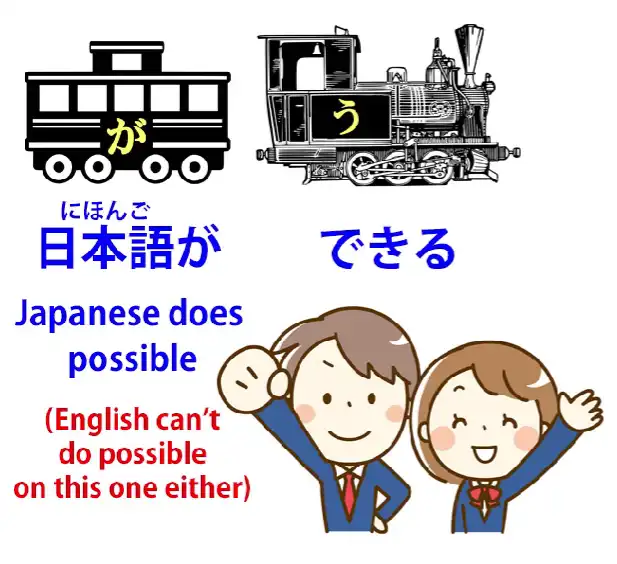
it gets translated as “I can do Japanese” or “I can speak Japanese”, which is even stranger because there’s no “speak” in there and what it’s actually saying is that “Japanese is possible (to me)”, but again this is an A-is-B construction when in fact this is really an A-does-B sentence.
What it’s saying is “Japanese does possible (to me)”.
Now, this may seem like a bit of a quibble, but it’s not a quibble because the particles, the structure, the entire framework of the sentence is different.
And in simple sentences like this it may not be very important but as sentences become more complicated, this whole issue becomes more important because we start to run into sentences that are quite impossible to understand unless we recognize what their actual structure is.
And there is a whole range of verbs that refer to what in English would be called states.
And in these cases the English translations are always passive.
And they have to be passive, because there really isn’t a way, another way of saying them in English.
For example, “乱れる” – to be scattered or disordered; “欠ける” – to be chipped or damaged or insufficient; “映る” – to be reflected or projected.
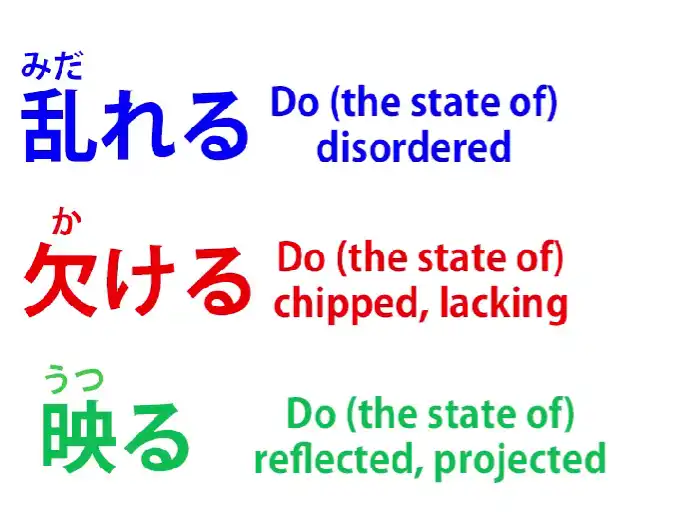
Each of those, as you see, I’ve translated with the English passive because it’s the only way to translate them into natural English.
But they’re not in fact passive in Japanese.
These are regarded as actions done by
- the thing which is disordered,
- the thing which is damaged,
- the thing which is reflected.
So if there’s no alternative to translating them as passive, aren’t we justified in doing so?
And the answer to that is, yes of course we are absolutely justified in doing so if what we’re trying to do is tell someone who doesn’t know Japanese and isn’t learning Japanese what is being said or, more accurately, what would be being said by an English speaker in the same circumstance.
But if, as learners of Japanese, we don’t know what the sentence is actually doing, we’re going to get ourselves into an awful tangle.
We’re going to look at sentences and wonder what they mean and if we try to make our own sentences we just won’t be able to do it because we’ll be looking for passive constructions, we’ll be trying to build sentences according to principles that we haven’t been introduced to and don’t understand.
So the thing to understand here is that in Japanese verbs can and often do represent what in English can only be expressed as either states of being or passive actions.
And then there is another group of verbs which is closely related in type to this in which they get translated as “becoming” a particular thing: “濡れる” – to become wet; “濁る” – to become cloudy or muddy.
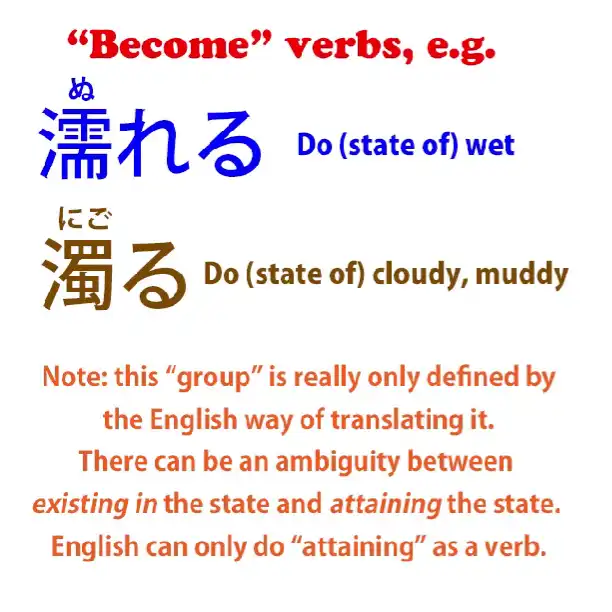
Again, in Japanese this isn’t talked about as “becoming” anything.
It’s simply an action in itself.
If we wanted to find a way of putting it in English we’d have to invent a word like “muddify” or “cloudify” or “wetiniflicate”, but in fact of course these words don’t exist in English.
And the key to understanding them in Japanese is not to try to translate them into English but to see how they’re actually working in the Japanese and to be aware that one-for-one translations are not possible in these cases.
And these becoming words like “濁る” or “濡れる” can also be used in the continuous present to get us back to our passive states that we had with the other words.
So, say, “濁ている”: we’re saying what in English can only be translated as to “be cloudy”,
but in Japanese, again, it’s to “exist in a state of cloudiness”.
So this is quite a simple and straightforward issue, but it’s very important
that we absorb and understand this principle or we’re going to have a lot of trouble
with a whole range of Japanese expressions..
60. The OTHER HALF of Japanese Structure - non-logical topic/comment structure
The OTHER HALF of Japanese Structure - non-logical topic/comment structure - Lesson 60
こんにちは。 Today we’re going to talk about one of the most important subjects in Japanese structure.
In fact this is the other half of Japanese structure.
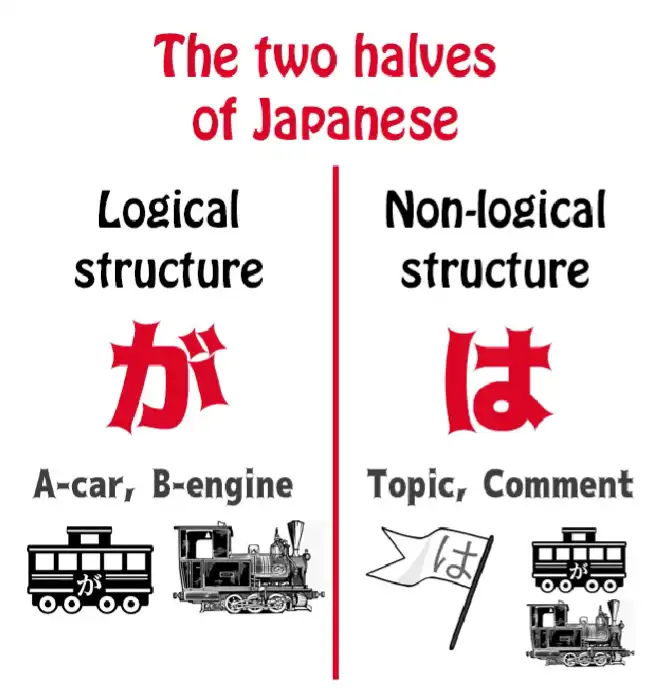
We’ve referred to it on many occasions.
You can’t really do much Japanese without it.
But we’ve never tackled it head-on, and that’s what we’re going to do now.
What we’re going to talk about is topic - comment structure.
And this is just as important as logical, subject - predicate, A-car - B-engine, structure.
In my book “Unlocking Japanese”, I referred to が as the king of Japanese and は as the queen of Japanese.
が is the head of the logical particles, the logical side of the language.
は is the head of the non-logical particles and strategies,
the non-logical side of the language.
And we can go so far as to say that
not only does every Japanese sentence have
a が-marked A-car, whether we can see it or not,
every Japanese sentence also has a は-marked topic, whether we can see it or not.
The topic
So what is a topic?
Every language has a topic; most languages are not, like Japanese, topic-prominent.
But to explain what a topic is in English, here’s a very quick example.
In English, we track topics by using pronouns, and that’s why English uses so many pronouns.
That’s why it’s saying “it” at the time.
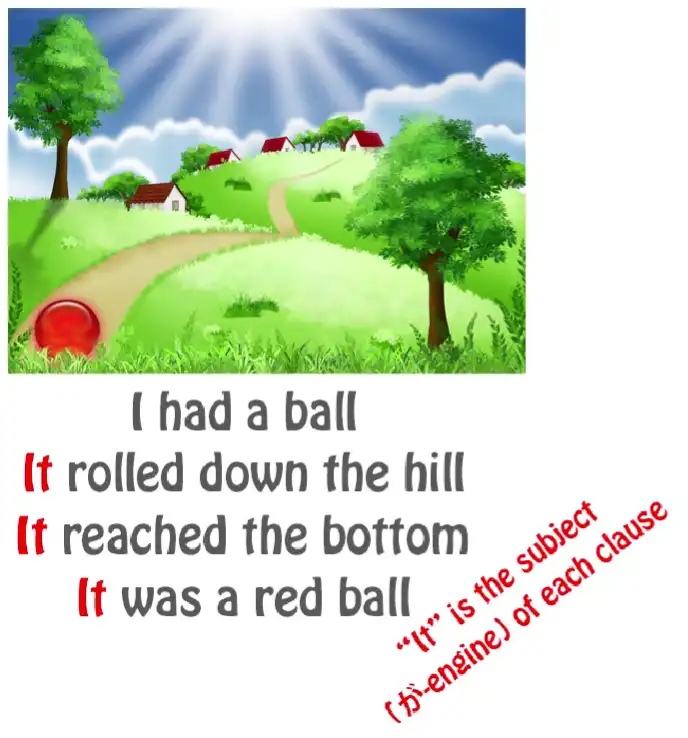
So, we can say “I had a ball.
It rolled down the hill. It reached the bottom. It was a red ball.”
As you see, each time the ball is marked by “it”,
and you might say that what’s being tracked here
is the subject, because it was the ball that rolled
down the hill, it was the ball that reached the bottom,
it was the ball that was red.
But we could also say “I had a ball. I dropped it.
It rolled down the hill. When it reached the bottom, Sakura picked it up and walked away with it.” Now, you see, the first “it” is the object of my dropping it: “I dropped it.” The second and third “it”: “It rolled down the hill… it reached the bottom” – in those two the ball is the subject.
And then “Sakura picked it up”, and it’s become the object again, the object this time of Sakura’s action.
So “it” is not tracking the subject, it’s not tracking the object, it’s tracking the topic, the thing we’re talking about.

That’s what a topic is.
And as I said, Japanese always has a topic, even though we can’t always see it.
So, if we say “アメリカ人です”, usually we would map that out as “zeroがアメリカ人です” – “I am an American”, but to be completely thorough we would have to map it as “zeroはzeroがアメリカ人です”, that is “I am the topic, I am the subject, and I’m an American.”
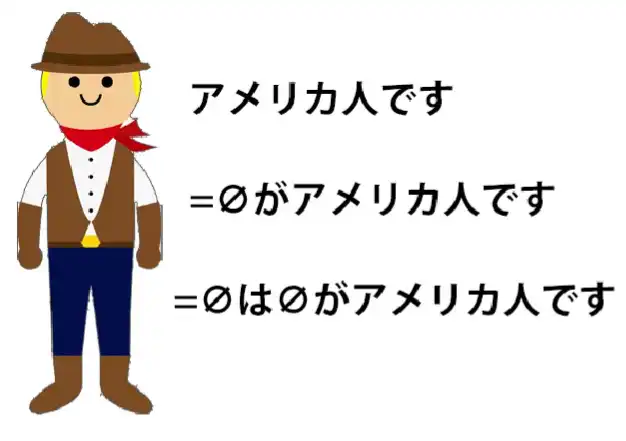
We don’t have to go through all that every time, but it’s important to know that it exists.
When the topic and the subject are the same,
it’s not so important, but as we know they often aren’t.
And in Japanese much more than in English they very often aren’t.
So, in sentences like “コーヒーが好きだ”, “頭が痛い”, “おなかが空いた”, “クレープが食べたい”, all of these are complete logical sentences: “Coffee is likeable”; “Head hurts”; “Stomach is empty”; “Crepes are eat-want-inducing”.
In each case we have an A-car, we have a B-engine, we have a complete logical clause.
But while it’s logically complete, it isn’t grammatically complete without understanding that there is also an invisible は-marked topic:
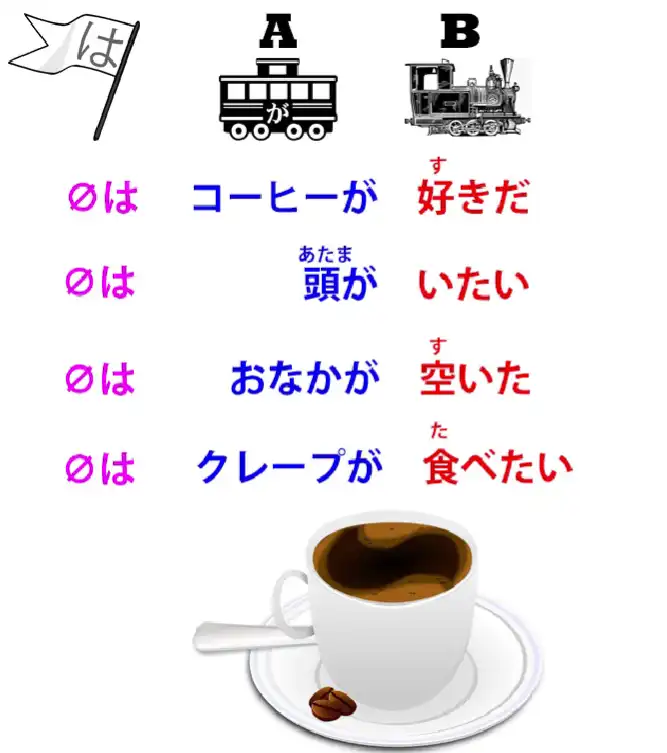
“zeroはコーヒーが好きだ”; “zeroは頭が痛い”;
“zeroはおなかが空いた”; “zeroはクレープが食べたい”.
“In relation to me, coffee is likeable/pleasing”; “In relation to me, head hurts”; “In relation to me, stomach is empty”; “In relation to me, crepes are eat-want-inducing”.
And while, as with the zero が-marked pronoun, the default is “I” but it doesn’t have to be “I”, so the は-marked zero-pronoun the same applies.
For example, if we look at a tall person go by and we say “背が高い、ね?”, literally, “back is high, isn’t it?” and that’s the way we say someone is tall.
But as you see, this isn’t complete without the は-marked zero pronoun: “zeroは背が高い” – “In relation to that person, back is tall”.
And because Japanese has so many constructions that don’t center on an ego, as we talked about in one of our previous videos (Lesson 9), so many constructions in which neither the A-car nor the B-engine are in fact the person concerned, like all the examples we’ve just talked about, it’s very necessary in lots of cases that we understand that the は-marked topic is there.
And the other thing we need to understand about topic-comment structure is that the comment is always a complete logical clause.
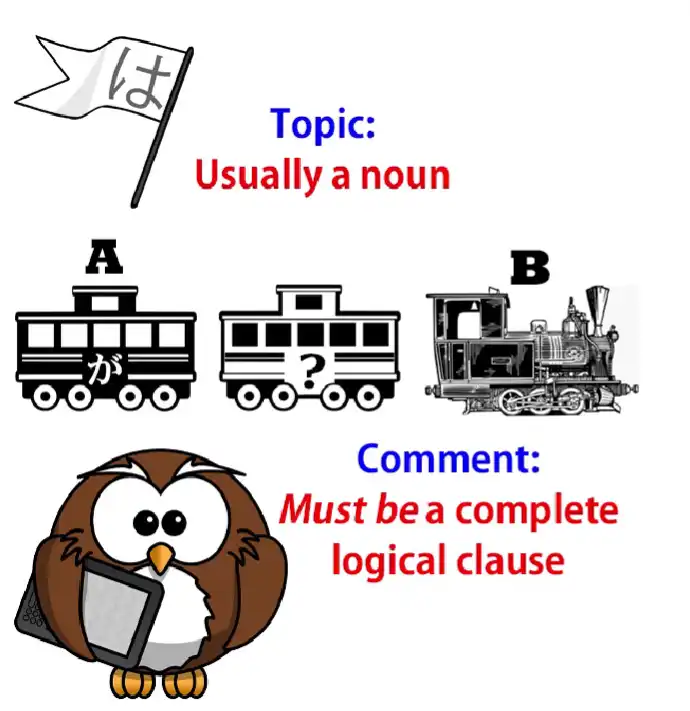
The topic is usually a noun (it could be something else) but the comment is always and must always be a complete logical clause.
This is something the textbooks don’t explain,
and it may be a good thing that they don’t explain it,
because if they did, I think we know how they’d go about it.
They’d present this as some kind of strange Oriental rule that we have to memorize.
But that’s not what it is: it’s a logical necessity.
As we know, every sentence, every logical clause, must
have an A-car and a B-engine, a subject and a predicate,
and as we know from our third lesson on は,
は can never mark either the A-car or the B-engine, or any other element of a logical sentence. It can only mark the non-logical topic.
So that means that if we’re going to have a sentence at all, both its elements have to be outside of the topic.
We have to have a topic and we also have to have an A-car, we also have to have a B-engine.
Therefore, every topic-comment sentence only has two elements, the topic and the comment.
Both the elements of the logical clause have to be in the comment.
Therefore, logically, in a topic-comment sentence the comment is always a logical clause.
In another video I’ve talked, and I’m going to talk again, about some of the implications of what is called the choice between は and が; what it means when we mark something with は, what it means when we mark it with が.
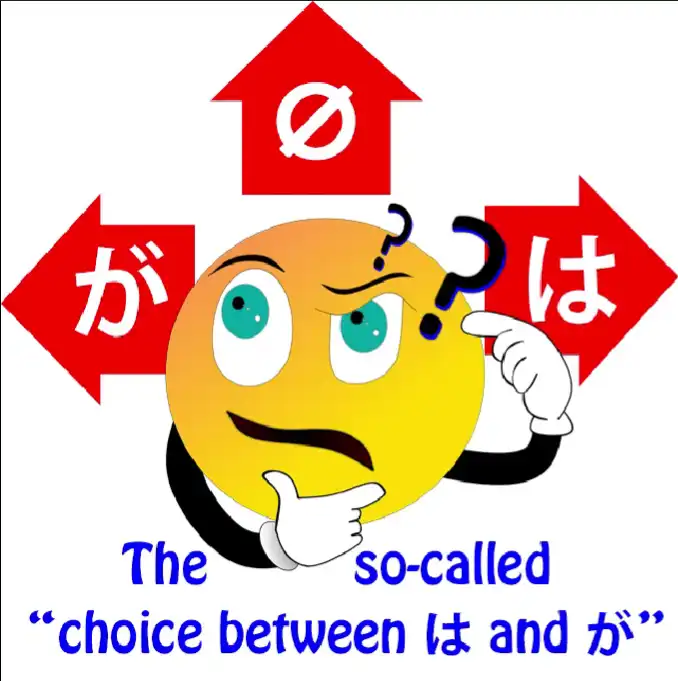
And there are a lot of implications involved here.
I won’t go into them in this video but you can watch the other one and I’ll put a card up for that.
But the thing to remember here because we’re talking about the actual structure, is that
when people talk about the choice between は and が, it’s confusing and somewhat misleading because it implies that は and が are somewhat similar,
that they do a similar kind of job.
And we know that they don’t. We know that they’re absolutely different species of particle.
And what we know from this lesson is that what we’re actually doing when we’re making a choice between は and が is that we’re choosing which of two elements which are always present to make visible, whether we make the は visible, the が visible, or neither visible.
So we can say “アメリカ人です”, we can say “私はアメリカ人です”, and we can say “私がアメリカ人です”.
And each of those has a slightly different implication.
When we’re not actually choosing between は and が, what we’re choosing to do is to emphasize, by making it visible, the topic-nature of the subject or the subject-nature of the topic, or neither.
And which of those we choose to emphasize has big implications for what we’re saying and what we’re implying…
61. は and が: the Deeper Secrets! The yin-yang structure of Japanese
WA and GA: the Deeper Secrets! The yin-yang structure of Japanese - Lesson 61
こんにちは。 Today we’re going to talk about the subtler meanings of the は- and が-particles and the implications they can have in different uses.
Last week (Lesson 60) we looked at the fact that topic-comment structure is fundamental to Japanese.
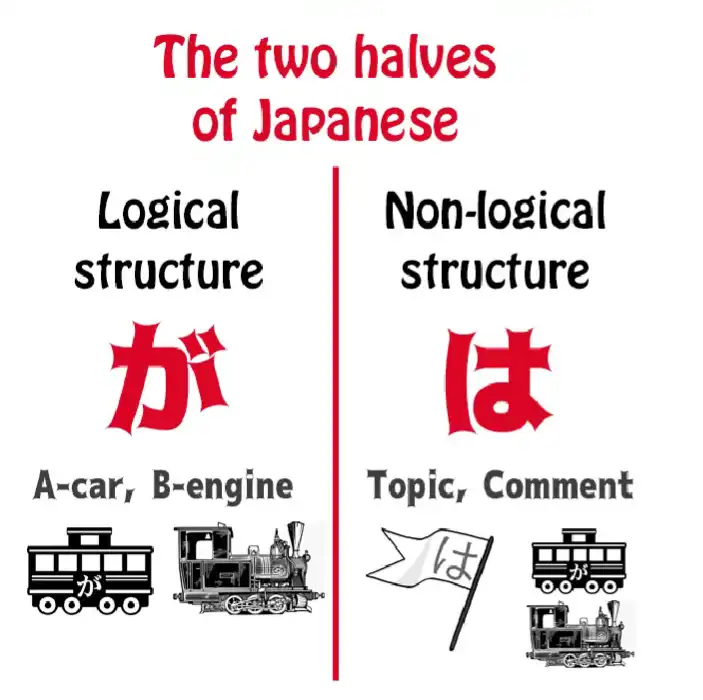
Every Japanese sentence has a topic as well as a subject, so that we can say that where the topic and the subject are not made explicit, Japanese sentences have both an invisible が and an invisible は.
So, “日本人です”, meaning “I am a Japanese person”, is strictly “zeroはzeroが日本人です” – “I am the topic, I am the subject, and I am a Japanese person.”
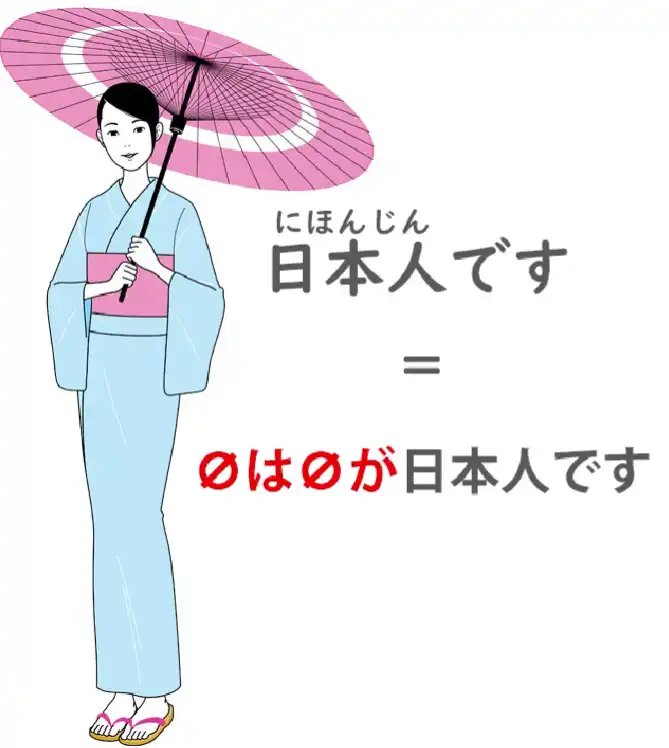
On the whole, we don’t need to worry about the invisible は, and that’s because in English and related languages we don’t normally need to have the topic made explicit.
We do need to have the subject repeatedly made explicit, so we feel a bit lost if we don’t know where it is.
And that’s why we use the invisibleが model.
But the important thing that we concluded in our last lesson was that the so-called choice between は and が, which only exists, of course, in sentences where the topic and the subject happen to be the same thing, and what we’re doing is not really making a topic or making a subject: we are emphasizing the fact that something is either the topic or the subject.
And this choice is important for the implication we’re going to throw on that topic/subject.
And in order to understand the implication, we do have to have some idea of what is the most natural way of putting a thing.
And this is why I always say that structure is important, but you can’t understand Japanese with structure alone.
You have to have enough immersion to understand what sounds natural.
And from that plus the use of structure you can understand what implications are being made by a particular statement.
Now, when we treat something as a topic and mark it with は or も, this can’t be new information.
Just as in English if we say, “Speaking of Melfrog Pooftoofular”, it’s no good saying that if your hearer doesn’t know who or what “Melfrog Pooftoofular” is.
You have to start by introducing “Melfrog Pooftoofular” first.
So a topic-marker can only mark old information.
And this is important because old information is unimportant information.
New information is what you are actually trying to convey to someone.
This is the way language works.
We’re not supposed to be telling people things they already know. We’re supposed to be adding something that they don’t know, and that is the actual information content of the statement.
So, in a certain way, は works like “the” in English, only in this one respect, that it can’t mark new information.
So if we say “I fed the iguana”, unless people already know about this iguana, they’re immediately going to say, “What iguana? You never talked about any iguana before.
What are you talking about, ‘the iguana’?” If you say “I fed an iguana”, that’s all right.
And we also need to understand that this concept of old versus new information and important versus unimportant information is closely bound up.
So you can in fact say “I fed the dog” without anybody knowing that you even had a dog, because it’s very normal and natural for a person to have a dog.
They don’t particularly want to stop and have that point explained anyway.
So “I fed the dog” will be taken to mean “I fed the dog that I keep at home, even though you didn’t know I kept a dog at home, you do now”.
If I say “I fed the iguana”, that’s a conversation stopper.
If you don’t introduce the iguana first, nobody’s going to just take it as read – “Yes-yes, she’s got an iguana at home, like most people.” So you see that while we say linguistically “new information” versus “old information”, it’s a bit subtler than that.
It’s “new, important, relevant information” versus “old information or information that we can easily take as read”.
And even this is quite a heavy-handed way of describing it.
Let’s take a look at how this sort of thing works in practice in Japanese.
If we say “本を買った”, this is the most normal way of saying “I bought a book”.
As we know, the zero-pronoun defaults to “I” when the context isn’t telling us that it’s anything else.
So “本を買った” puts no particular emphasis on anything; it’s just saying, neutrally, “I bought a book”.
Now, in this sentence, “I” is the subject and the topic.
If we choose to stress “I” as the topic and say “私は本を買った”, we’re making “私” into the old information, the buying of the book into the new information, and because of this, は has a distinguishing function.
When we use は, we are either establishing or changing the topic.
And even establishing a topic is in most cases changing it,
because we can assume there was some topic before.
So we’re changing the topic to “I” and saying that I bought a book.
And we know that what は does is not only change the topic to whatever it marks (in this case “I”) but it also implies that the comment on the new topic
is different from the comment on the old topic.
And if there wasn’t in fact an old topic, it still implies that it’s different from the comment on other possible topics.
So, “私は本を買った” is essentially saying “What I did was bought a book.
You may have bought something else, other people may not have bought anything at all, but what I did was buy a book.” We’re stressing the fact that I bought a book as opposed to other possible topics who didn’t buy a book.
This means that it is implicitly the answer to a question which may not in fact have been asked: “What did you do?” The answer to “What did I do?” is “I bought a book” when you’re marking “I” with は.
Now, if you say “私が本を買った”, you’ve changed the emphasis.
You’ve reversed the emphasis.
The old information is now the buying of the book and the new information is “I”.
So under what circumstances do you say that?
Well, suppose people are looking at an empty space in the bookshelf and wondering what happened, and you say “私が本を買った” – “I’m the one who bought the book.” We all know that the book’s gone, we know something happened to the book, now I’m giving you the new information: “I” am the one who bought the book.
So while “私は本を買った” is implicitly the answer to the question “What did you do?”, “私が本を買った” is implicitly the answer to “Who bought the book?” — It’s also important to understand what is the natural, neutral way of saying something.
We know in this case that the natural, neutral way of saying “I bought a book” without emphasizing anything is just to say “本をかった”.
So if we say “私は” or “私が”, we’re specifically making a point here.
We’re adding something to the neutral statement that I bought a book.
Now, from this direction of the emphasis forward or backward,
は, and が can mark particularities as opposed to generalities.
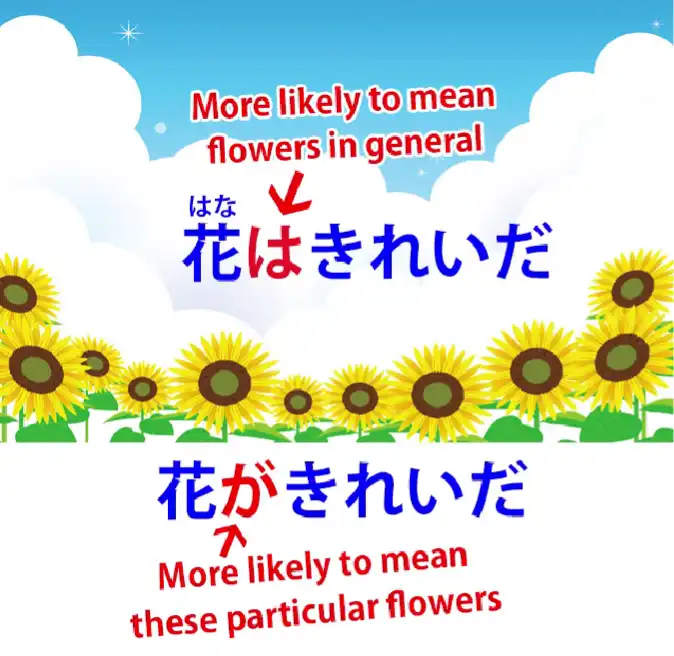
So, for example, if we say “花が綺麗だ”, we’re stressing the “花” as the subject and this means “The flower (or these flowers) are pretty”.
“Pretty” is important, but the real subject is “these flowers”.
These flowers are what is pretty, these are pretty flowers.
If we say “花は綺麗だ”, we are likely to be saying that flowers in general are pretty.
We haven’t singled out any flowers as the subject; we’ve made “flowers” the topic, and the important new information is prettiness.
Flowers in themselves are not new.
They’re something we’ve known about for a long time.
The fact that they’re pretty is my comment, my assessment of them.
“花が綺麗だ” – the flowers are taken to be something new.
They’re taken to be a particular subject in themselves and so we’re more likely to be talking about particular flowers instead of flowers in general.
Now, all the time we’re talking about tendencies here, aren’t we?
There’s no logical, structural reason why saying “I fed the iguana” is any different from saying “I fed the dog”.
It becomes different because of expectations.
We expect someone is very likely to have a dog and so this is not new or important information.
We don’t expect someone to have an iguana, so this counts as new, important information and you can’t slip it by with a “the” in the same way that you can the dog.
Similarly, が can mark new material as well as old material,
but は can’t mark new material.
は can mark specific things as well as generalities but が can’t really mark generalities.
So we’re talking about fairly subtle shades here.
Now, knowing the usual way of saying something, again, is what gives using a different strategy its emphasis.
So, as I spoke about in an earlier video on は and が (which I would recommend seeing, because it covers some material I’m not covering here) we know that “雨が降っている” means “it’s raining”.
This is the normal way to say it’s raining.
We use が. We can’t use nothing because we have to say what’s falling, and we don’t normally use は.
So “雨が降っている” simply means “rain is falling”.
“雨は降っている” is something you’d say when perhaps there was an expectation that it was going to snow.
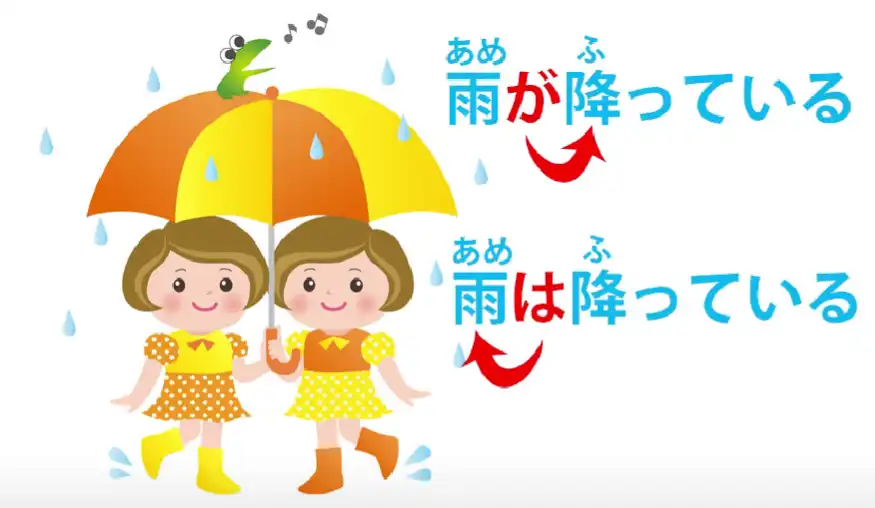
Rain is the topic and the comment on it is that it’s falling,
with the implication that if the topic were different the comment would also be different,
because we’re using は not も, and は is the exclusive topic-marker as opposed
to も, which is the inclusive topic-marker.
Now, it’s not only used for differentiation; it’s also used because it throws emphasis forward. It’s also used for emphasis.
So I’m going to take an example here from one of my favorite anime,
which is Aria the animation.
Unfortunately, I don’t think it has any Japanese subtitles, so you may have to wait a little while before you watch that.
I know you never watch anything with English subtitles any more and I congratulate you for that.
So the sentence is “おまえみたいな半人前に休みはない”.
“おまえみたいな半人前に休みはない” And what this means is “For trainees like you, there are no rests”.
Now, it’s interesting to notice what’s going on here.
What is the topic of this sentence?
Actually, it’s “trainees like you”: “おまえみたいな半人前に” could have been “おまえみたいな半人前には” and this would made a topic out of “trainees like you”, and the comment on this would be the logical clause “休みがない” – “there are no rests”.
However, the speaker has chosen to do something different.
She’s chosen to de-emphasize the topic by not marking it with は, but this doesn’t stop it being the topic.
It’s still the topic on which the logical clause is a comment.
And she’s made a sub-topic out of “休み” – “rests”.
Why has she done that?
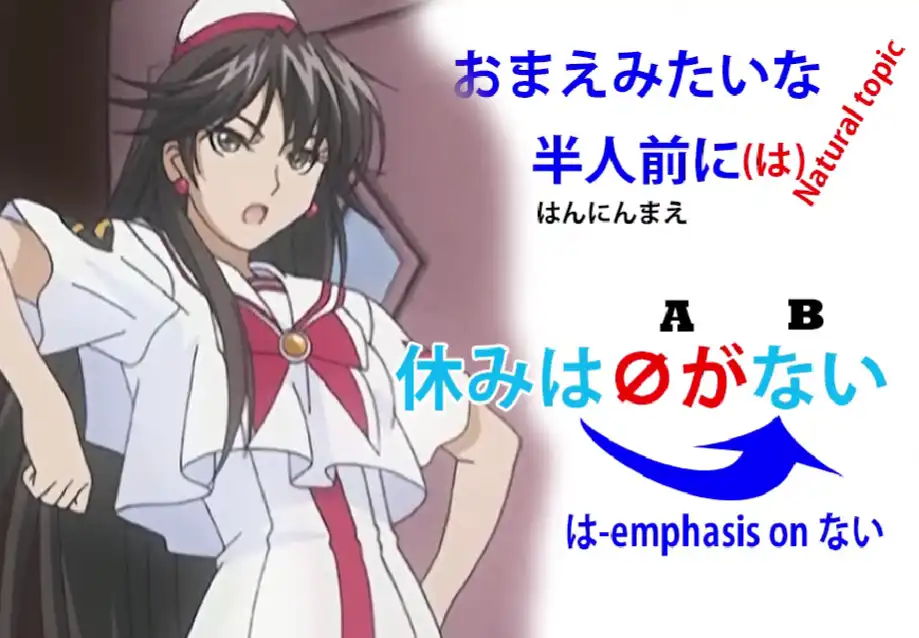
Because when you make something a topic, even if it’s a kind of sub-topic like this, you’re throwing the emphasis forward onto what follows it.
You’re making the thing that follows it the salient,
the important information of the sentence.
So, what it’s saying here is “休みは(zeroが)ない” – “As for rests, (they) don’t exist”: “For trainees like you, as for rests, (they) don’t exist.” Now, this isn’t quite as cumbersome as it sounds in English because は is a much more flexible particle that can be used much more easily than things like “as for” in English.
But it’s using the same essential strategy to throw all the emphasis of that entire sentence onto that last word, “ない” – “they don’t exist” – “forget about rests, you’re not getting any.” Now, I hope this makes the topic-marking は and the subject-marking が a little bit clearer in their deeper and subtler implications… Note: This may be quite a difficult thing to grasp, as always, comments under the video may perhaps help a bit. The brain should eventually sort it out via natural, comprehensible input through the active organic exposure to the language and its active use. Just keep going (•̀o•́)ง
62. ておく vs てしまう, helper verb secrets
Te-oku vs te-shimau, helper verb secrets. ておく てしまう - Lesson 62
こんにちは。 Today we’re going to start talking about what I call the bridge between structural learning and actual immersion, because we learn expressions and structures and then sometimes when we encounter them in real use we don’t understand quite what they’re doing there.
I’m going to take an example from my patron Kimika-sama, who gives me this sentence: “各団体には私からよく説明しておく” Now, Kimika-sama is able to translate this pretty much correctly (it means broadly in English “I will give each group a good explanation from me”), but still doesn’t understand why “おく” is used as a helper verb to “説明する”.
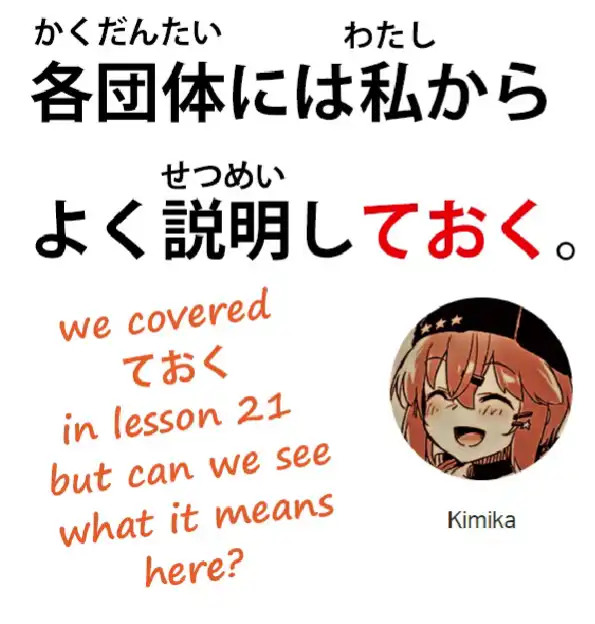
And to understand that more fully, I think we need to look into something a little more deeply.
This is the fact that Japanese people are very fond of their helper verbs and they attach them quite often in various kinds of circumstance. Is this something we can understand from an English point of view? I would say yes, it is.
We do the same thing in English, though not so much with verbs as with prepositions, particularly the prepositions “up” and “out”.
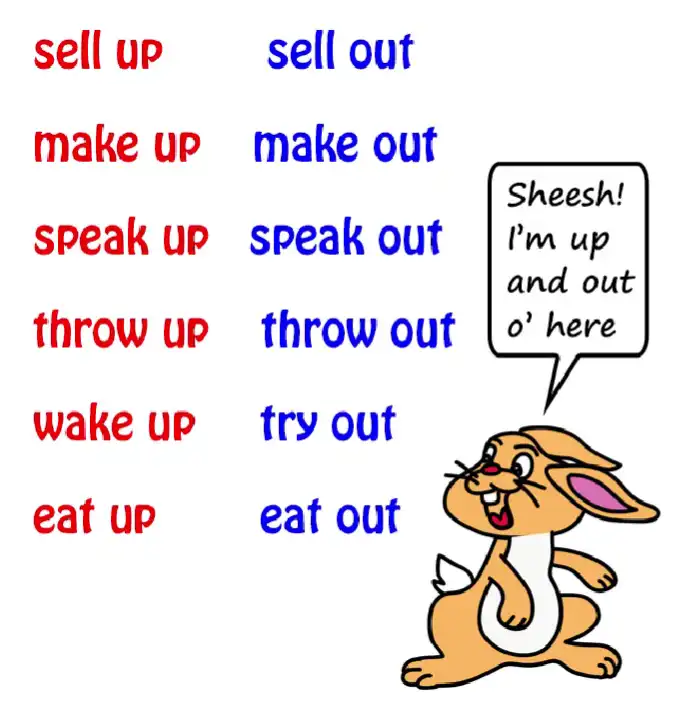
We eat things up, we make things up, we cry out, we lose out, we think up an idea, we think out an idea, etcetera etcetera. Now, Japanese doesn’t have any prepositions.
None at all. If you think it has, it’s time to throw that textbook out of the window.
What it uses in place of these English prepositions “up”, “out”, etcetera, are verbs – helper verbs. And the difference between the Japanese helper verb and the English verb-helper preposition is first of all that there are a lot more of them and then, because of that, they’re a lot more specific. If you look at the various ways in which English speakers use “up and “out” – they even “peace out”, whatever that means – you can see that because there are only a few of them they get used all over the place in all kinds of circumstances and there’s only a marginal amount of reason to the way they’re used.
Now, because there are more helper verbs, they can be much more targeted.
So, even though they’re used widely, in a whole range of situations, we can generally tell what any given helper verb is doing, if we understand that we need a fairly wide interpretation.
So what “-ておく” is doing here is really what it always does.
If we say “窓を開けておく”, what we’re saying is
“open the window in order that the window will be open and probably that
ventilation is going to come into the room”.
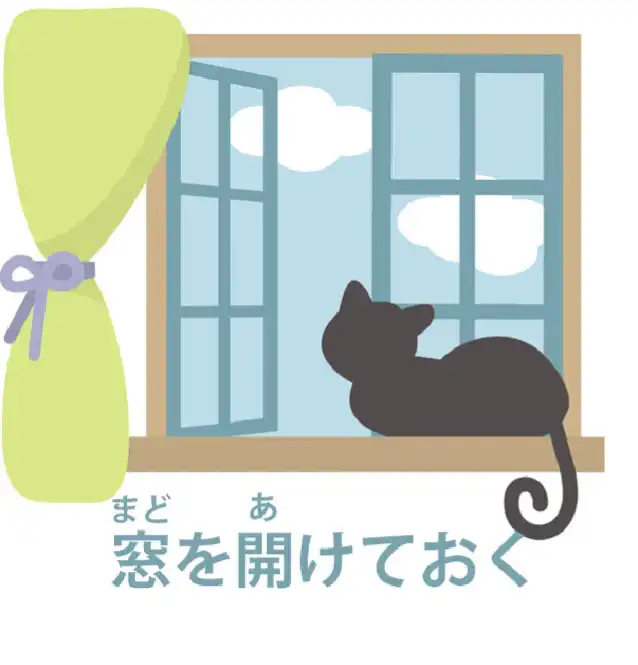
Open it for a purpose, put that action in place: “おく”, which means “put in a place”.
Put that action in place so that it will then
change the circumstance in the way that we want.
In this case, airing out the room.
And the same with the “説明” here.
“説明しておく” – put the act of explaining, or the explanation, in place, so that, after that, each group will understand what’s going on, they won’t be in the dark about it any more.
Now, we can compare this with another very common helper verb, which is “しまう” and its various variants like “ちゃった”, “じゃった” etc.
We could say “説明してしまう”, but that would have a completely different implication.

In this particular case it would probably mean something like
“I’ll go ahead and explain to them, even though that’s not what I’m expected to do,
or perhaps not what people want me to do.
I’ll just go right ahead and explain to them” – “説明してしまう”
In another situation we might say something like
“聞かないでよ。さくらは説明してしまうから”,
which means “Don’t ask, because Sakura will explain”

– but what that “しまう” is implying is probably something like
“Don’t ask, because if you do Sakura’s going to explain
and we’re going to be stuck here for hours with Sakura’s long rambling explanations.”
So, “しまう” has a wide variety of implications,
some of them negative, not all of them negative,
but “おく” has a completely different range of meaning.
“しまう” is talking about going ahead and
doing something, something happening by accident;
as I said in the video on “しまう” (Lesson 44),
essentially when it’s in the past, all those things that we can mean by “done” –
“I done explained”, “I done fell over, “she done stole my cake”, “I done won the lottery”
– doesn’t have to be negative, but it has that exclamation mark feeling to it.
It happened, even though you might not have been expecting it or you might not have wanted it.
It happened.
“おく” doesn’t have that exclamation mark feeling.
It has that workman-like feeling: it was done to put the action in place, to achieve a result, to change the circumstance from what it was before into one that is more in accordance with what we want, whether it be opening a window or explaining to several groups what the situation is…
63. WILD sentence enders in real life Japanese かい、だい,、ぜ、ぞ、さ、から、し、ちょうだい
WILD sentence enders in real life Japanese かい、だい,、ぜ、ぞ、さ、から、し、ちょうだい - Lesson 63
こんにちは。 Today we’re going to talk about some more of those things that hit us between the eyes as soon as we leave the walled garden of theoretical Japanese and venture into the wild woods of the real thing.
One of the things people often ask me about are the various sentence-enders they encounter.
And I’m not talking about the tame ones like “ね”, “よ” and “な” – I’ve done a video about those if you’re interested and I’ll pop a link for that over my head.
But today we’re going to talk about some of the more colloquial and unconventional sentence-enders that you’re going to run into once you get into “wild Japanese”
in anime, manga, etc.
かい
So, one of the ones I often get asked about is “かい”,
and “かい” is simply a softened and colloquial form of “か”.
As we know, “か” is regularly used in formal Japanese, where we use the です/ます decorations at the end of sentences, to form questions.
So we say “何々しますか / 何々ですか”.
But in colloquial Japanese we don’t use “か” as a sentence-ender question-marker all that often.
We do use it in other positions – and I’ve done a video about the various ways we use “か” (Lesson 39) and I’ll pop a link for that over my head too.
But where we don’t tend to use it in informal speech, on the whole, is at the end of sentences marking questions, the way it does in です/ます Japanese.
And that’s not because it’s ungrammatical, in fact it’s perfectly grammatical, but in modern Japanese it’s come to sound a little bit rough, so while you may hear it between men who are being “one of the boys” together, you don’t hear it so often in female speech or in the speech of anyone who’s trying to be a bit courteous.
So what do we do?
Most of the time we simply use a rising intonation in speech or a question mark in writing where we’re depicting casual speech.
And there’s nothing wrong with this.
Spanish continually makes questions by simply adding a rising intonation to the equivalent statement and there are no problems there.
There are no problems in Japanese either.
Sometimes we add “の”, which is ambiguous, because it can mark either a question or a statement, but again that doesn’t really matter because intonation works just as well.
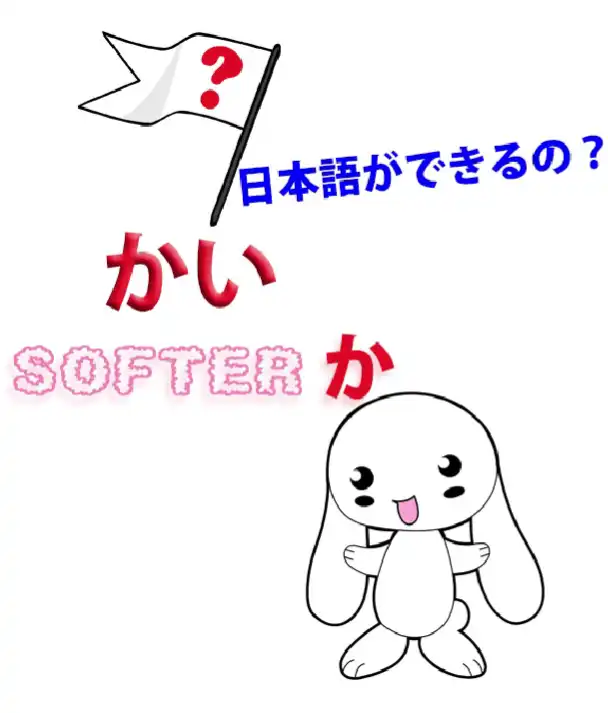
However, we do have the informal, non-rough-sounding question-marker “かい”.
You might think that would be used all the time, but it isn’t,
because it sounds very colloquial indeed and sometimes a little bit… well, folksy.
Some sources say it’s primarily masculine and that’s kind of half-way true.
You don’t hear many younger female speakers using it, but you do sometimes hear older female speakers using it.
だい (& どうだい)
“かい” also has a partner, which is “だい”.
“だい” is really “だ” plus “かい”.
So this is the form of “かい” that we use in
copula-ending sentences, “だ”-ending sentences.
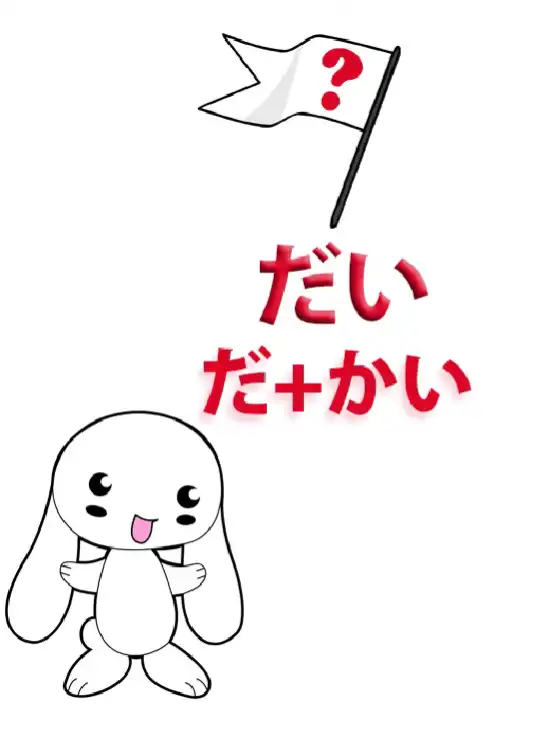
And just about everything I’ve said about “かい” also applies to “だい”,
except that there is a particular collocation, “どうだい”, which is much more widely used.
So, if somebody’s eating something and you say “どうだい?” – “what’s it like? / how is it?” – and they might say “おいしい/美味しい!” or they might say “まずい/不味い”, but asking it in that form is something anybody can do provided it’s an informal setting.
ちょうだい
People also come across the expression “ちょうだい”, and that’s not related to “かい” or “だい” at all; it’s an informal equivalent to “ください”.
So it’s usually adding it to the て-form of a verb to ask someone to do something.
It’s sometimes considered to be female speech but it is not exclusively so.
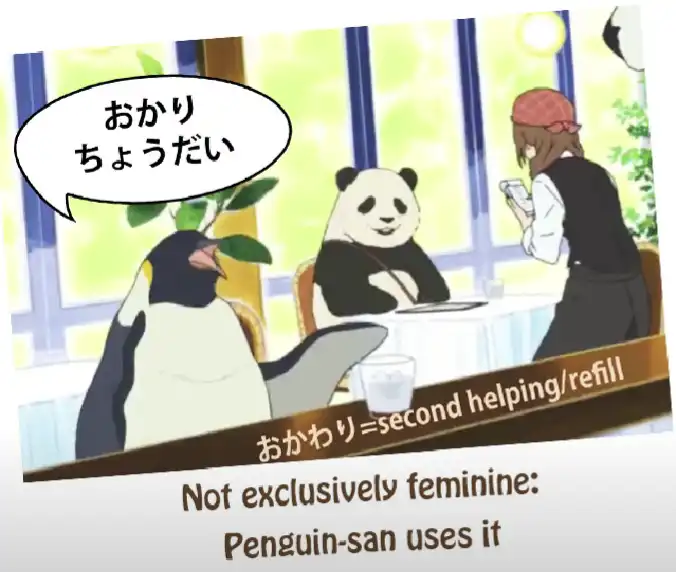
ぜ、ぞ、さ
Other real sentence-ender markers in casual speech are “ぜ”, “ぞ” and “さ”.
Now, “ぜ” and “ぞ” are very simple.
They’re just verbal exclamation marks which lend a little force to whatever it is you’re saying.
They’re quite rough and really are masculine speech and they’re the sort of thing you’ll probably see more in anime and manga than you will in real life.
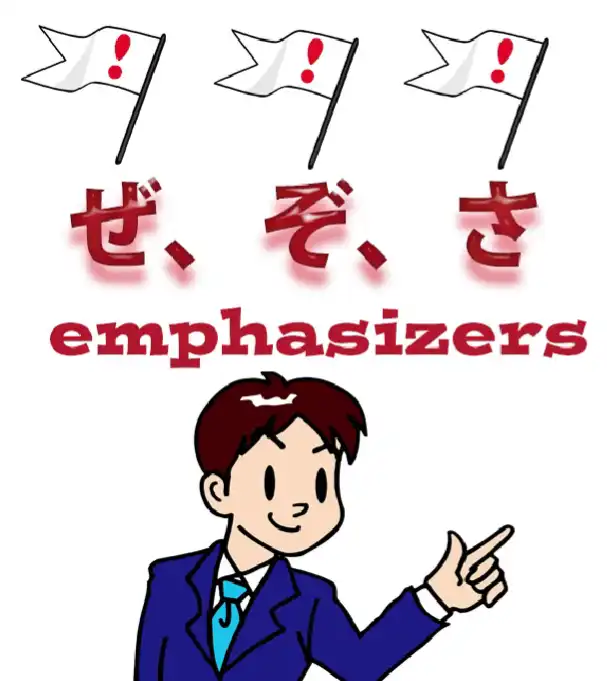
“さ” is similar but it’s not nearly so rough.
It’s much more widely used, you’ll see a lot of it, and you’ll hear it in real life.
It tends to get called masculine speech, but again it’s not exclusively masculine speech.
All kinds of people use it.
It’s important not to confuse “さ”, the emphasis-lending sentence-ender, to “さあ”, which comes at the beginning of a sentence and is more of a pause-for-thought kind of expression.
Now, there are also sentence-enders that are not sentence-enders but effectively they are, because people do pop them after the engine at the end of a sentence.
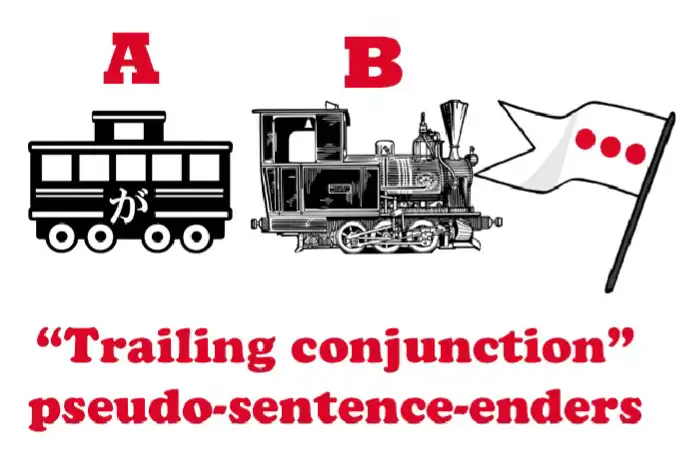
Here, Dolly also suggests watching this video on pseudo-enders, のに & なのに respectively.
One of these is “から”.
から “sentence-ender”
Now, “から”, as you know, is not technically a sentence-ender.
What it is is a conjunction that joins two logical clauses to make a compound sentence.
So a proper use of “から” might be:
“さくらが来ないから帰ります”, which means
“Because Sakura isn’t coming, I’m going home / Sakura isn’t coming, so I’m leaving”.
However, you might simply say as you are leaving, “さくらが来ないから”,
and that is just leaving the other half of the sentence unsaid because it’s obvious.
Now, from that, “から” can be added to a lot of sentences to imply that something else is coming.
That extra something else isn’t always completely clear.
In fact, the “から” may be performing the function of either softening what it marks or hardening it.

It can soften it by making the statement feel explanatory; it can harden it by making it sound as if it’s part of a logical argument or a natural piece of reasoning that the hearer ought to understand and agree with.
So, for example, if you’re riding your bicycle in a place where you shouldn’t be riding a bicycle and somebody official comes up to you and says “自転車に乗るのは禁止ですから” [polite tone], that’s conciliatory, and really all they want to say is “It’s forbidden to ride a bicycle around here”, but by adding the “から” to the end of it, they’re kind of softening it, turning it into an explanation for you.
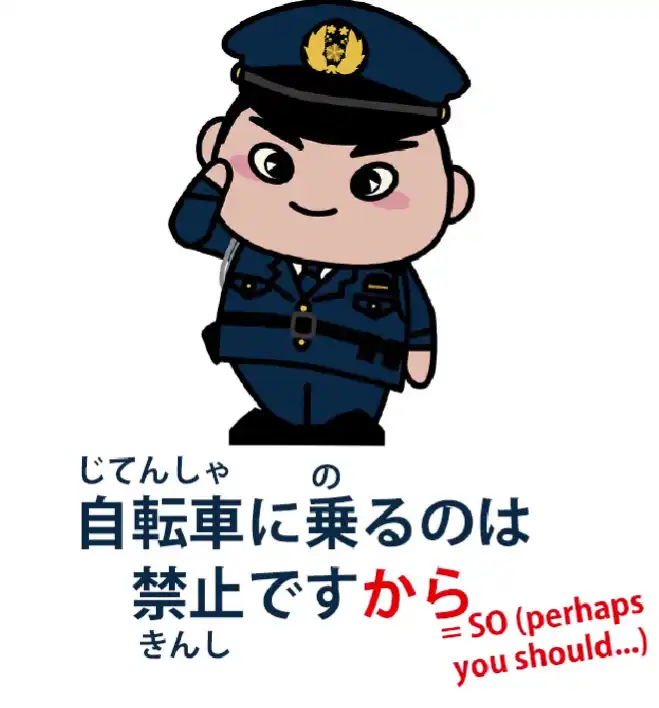
Conversely, they might say “自転車に乗るのは禁止ですから” [stern tone], and that has a different implication.
There, the “禁止” is being rammed home all the harder for that “から”.

So, “から” can have a variety of uses, often depending on context, on the way in which they’re said, on the demeanor of the person saying them, and on the whole situation.
し sentence-ender
“し” is another very common sentence-ending particle which is similar to “から” and has a meaning in the same area.
“し” can actually combine various conditions or statements, but its most common and regular use is to combine reasons.
So, for example, we might say, “遅くなったしさくらが来ないし帰ります”, and that means “Because it’s gotten late and because Sakura isn’t coming, I’m going home”.
And this is the most standard kind of use of “し”.
But then we might often use it for only one condition, implying others.
For example, if we said “遅くなったし帰ります”, we’re saying “because it’s gotten late, I’m going home”, but we’re also implying that the fact that it’s gotten late isn’t the only reason: “Because it’s gotten late (and for other reasons) I’m going home.” And this, in this particular case, probably implies that it’s not just because it’s getting late, it’s also because Sakura isn’t coming, but we’re leaving unstated the more personal part of it.
Now conversely, we might say “さくらが来ないし帰ります” and this time we’ve put in the most important part, the real reason for our leaving, but by saying “し” rather than “から” we’re also saying “Because Sakura isn’t coming (and for other reasons) I’m leaving.” What this does is take the pressure off Sakura.
Although she may be the main reason, we’re diffusing it a bit by suggesting
that there are also other reasons.
And we might do this when there are no other reasons at all,
just as a way of softening and diffusing the statement.
Another example might be, suppose you’re riding your bicycle again in that place where you shouldn’t be riding it and this time a friend comes up to you and says, “自転車に乗るのは禁止し”.

Note: Yes, normally, after 禁止, there would be だ before し. But since this is casual, it is left off. Now, the difference between this and the “から” statement is simply that the “し” is diffusing it.
It’s saying “Oh, because it’s forbidden to ride
a bicycle here and for other reasons…”
Now, there aren’t any “other reasons” at all, but
what this does is make it sound a bit more colloquial, a bit more friendly,
and it vagues up a bit that “から” which can sound too much like an order.
It’s just saying “Oh, for that and other reasons”.
And this “vaguing up” tactic often takes place in languages.
In English it’s often done by adding words like “like” or “kinda” to what you’re saying.
Now, the ways in which these sentence-enders work can’t be learned from structure alone or from abstract instruction alone.
We need to immerse in Japanese to get the feel of what people mean when they say these things.
But conversely, understanding the structure, understanding how they really fit together, gives us a substantial boost in being able to make sense of our immersion.
It’s rather like a rope and climbing a mountain.
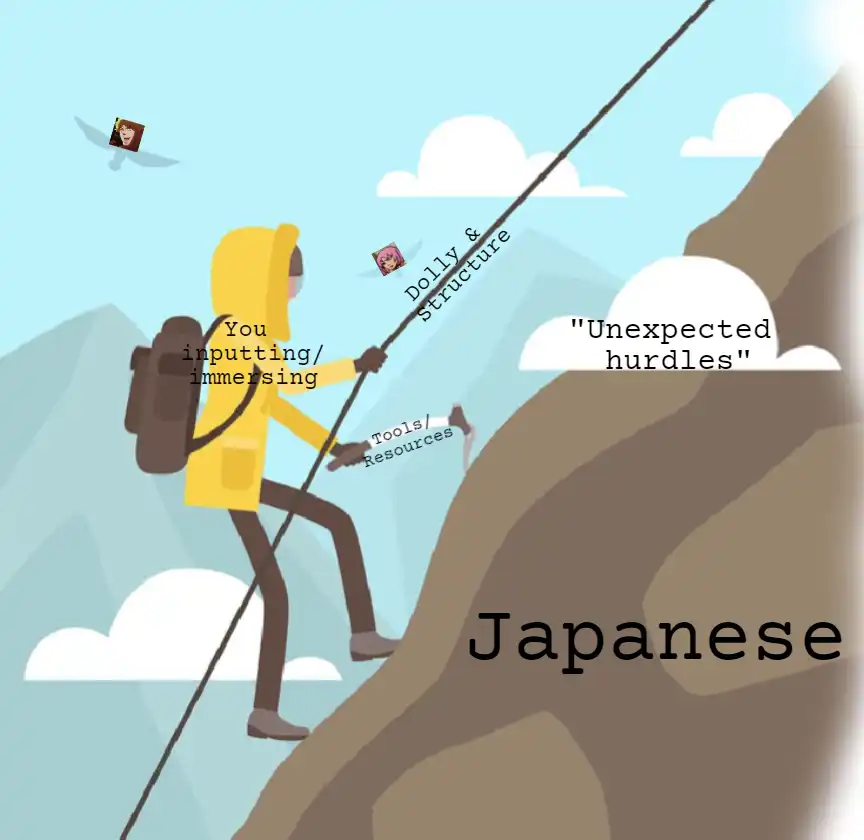
*Note: Indeed, ‘tis modified a bit …somewhat…*cough*…bizarrely… ╮(︶▽︶)╭
*If you have a rope, that will help you climb the mountain,
but if you just stand staring and learning all about the rope
you’ll never get to the top of the mountain.
Conversely, if you try to climb the mountain without the rope, you may not get very far…
64. “Things” get Strange! もの and こと - Advanced secrets: ものだ, ことがある, こと as sentence-ender
“Things” get Strange! Mono and Koto: advanced secrets: ものだ, ことがある, こと as sentence-ender - Lesson 64
こんにちは。 Today we’re going to talk about “もの” and “こと” in some of their more advanced senses.
Now, near the beginning of this course we talked about “もの” and “こと”, and I said what people usually say, which is that “もの” is a concrete thing, like a pencil or an apple or a tree, and “こと” is an abstract thing, like a situation, a circumstance, an action.
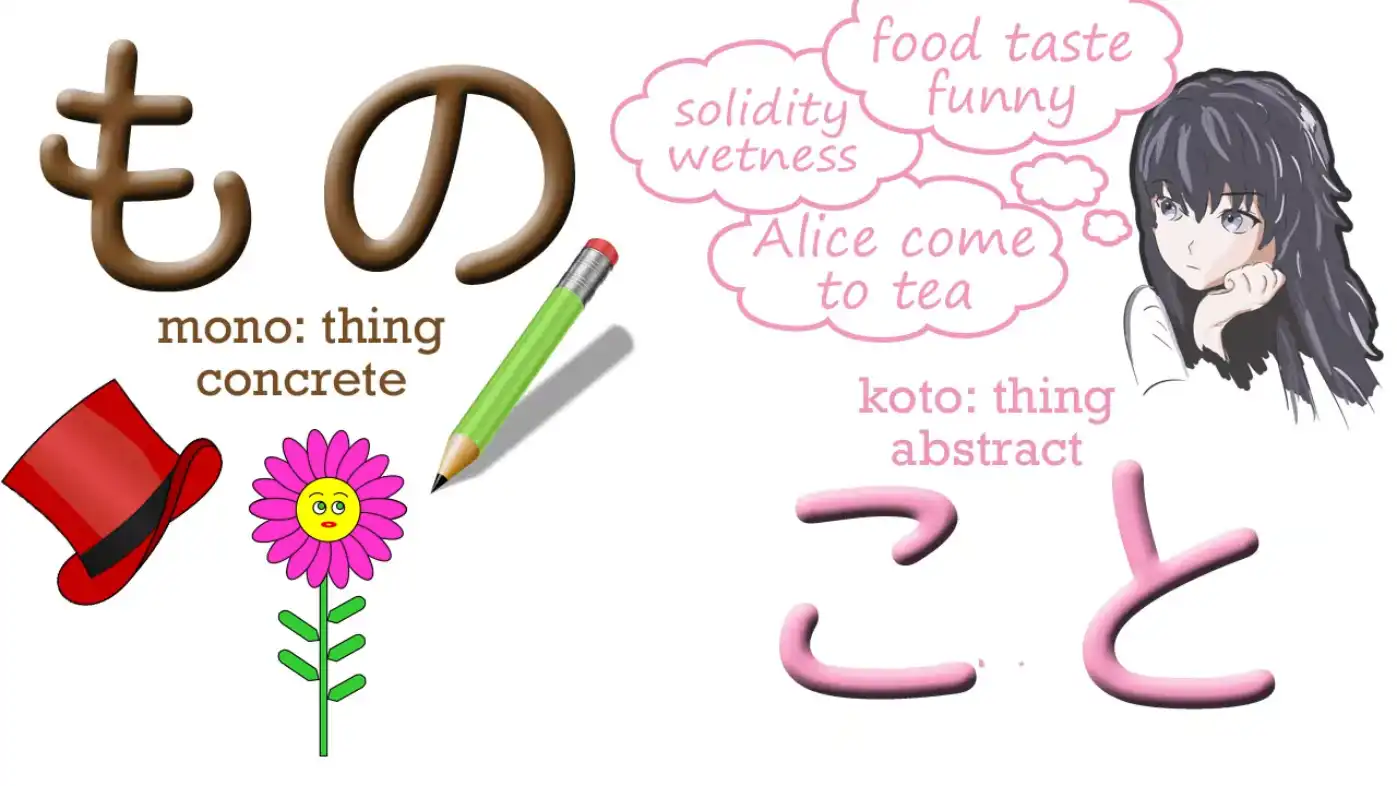
Now, this is broadly true and it’s certainly the best way to grasp it in the beginning, but then we come across some other situations which don’t seem to fit in with that.
One of my Patrons wrote to discuss the sentence: “愛はすばらしいいもの”, which means “Love is a wonderful thing”.
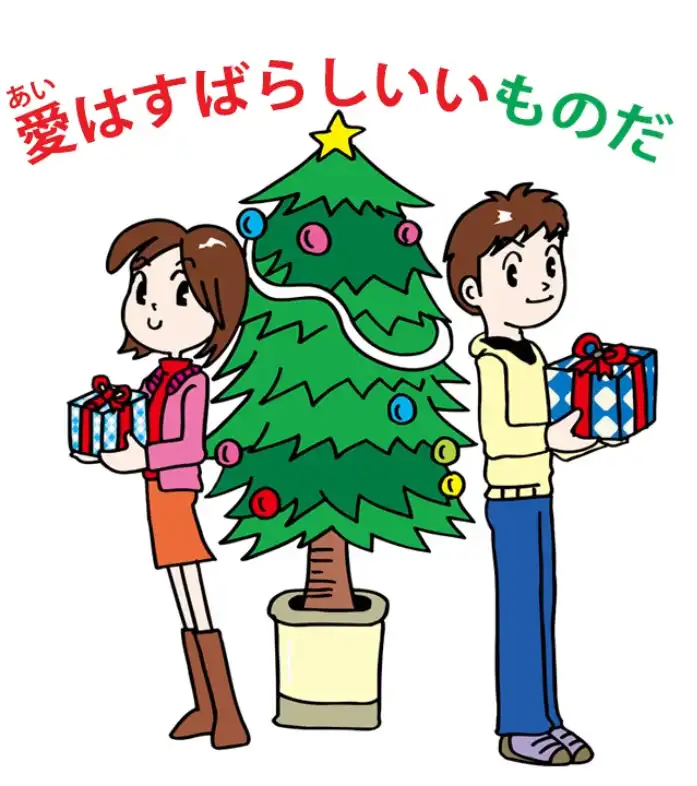
Now, surely love is abstract. You can’t put it in a box and carry it from Kyoto to Tokyo.
So what’s going on here?
My Patron said that she looked it up on various Japanese learning sites and they couldn’t explain it at all.
They just said you have to learn which cases you use “もの” and which cases you use “こと”.
This isn’t the case at all. What “もの” really designates is a “thing”.
And a thing is a noun, so it can be a concrete thing like an apple or a book or a universe, but it can also be an abstract thing like love or happiness.
These are all nouns.
So “愛はすばらしいいものど” is the only way you can say it, because “ai” is a “もの”, not a “koto”.
It’s a noun. It’s a thing.
It’s not a state, it’s not an action, it’s not a condition.
It’s a thing.
And we need to bear this in mind as we look at some of the more extended meanings of “もの” and “こと”, as we start to see “もの” and “こと” on occasion being used as something like sentence enders.
But before we get to that, let’s look at some of the other extended uses of “こと”.
Now, one of the most common ones is “したことがある”.

For example, we might say “日本に行ったことがある”.
And that means “I have been to Japan”.
And, as you see, “I have been to Japan” is a different kind of statement from “I went to Japan”.
“I went to Japan” is referring to one particular instance of going to Japan.
“I have been to Japan” is saying that in the past, perhaps on one occasion, perhaps on many occasions, going to Japan is something that I have done. In Japanese what we’re literally saying is “The activity, the fact, of my having been to Japan in the past exists.” Now, I had an Italian Patron at one time who took me up on my early lesson on the Japanese tenses.
I said that Japanese has only three tenses.
And that’s correct: Japanese has only three tenses.
And my Italian friend asked me “So how would I say something like ‘I have been to Japan’ as opposed to ‘I went to Japan’?” And I explained how that is. And he said “Well, in that case, Japanese doesn’t just have three tenses. It’s just like Italian or French or other European languages…” It has perfective tenses and pluperfect and all these complicated things that European languages have.
And therefore I should be teaching it that way.
I should be teaching the Japanese past and present and future and pluperfect and perfective and all that sort of thing.
But that is a perfect example of what’s wrong with Western Japanese teaching.
It would be bundling Japanese, categorizing Japanese as if it were a European language gone wrong.
Of course any language of any sophistication needs to be able to express just about any kind of time relation.
But it doesn’t do it in the way that European languages do it.
It doesn’t do it by means of conjugating verbs.
In fact, as I’ve said before, Japanese doesn’t conjugate verbs at all, even in cases that look a bit more like it to Western eyes.

It uses an entirely different kind of strategy.
It says “The fact of my having been to Japan exists”.
Now, if we go from “したことがある” to the present tense, “することがある”, if instead of saying “日本に行ったことが ある”, we say “日本に行くことがある”, we’re now saying “The fact of my going to Japan exists”.
In other words, we’re saying “I sometimes go to Japan / going to Japan is a fact that exists”.
If we say “どんな人にも失敗することがある”, we’re saying “everybody sometimes makes mistakes / whatever kind of person it may be, the fact of making mistakes exists”.
Now, if you’re going to start calling these things tenses, that would have to be the past-present-and-future-occasionally-happening tense, which is nonsense, but then so’s all the rest of it.
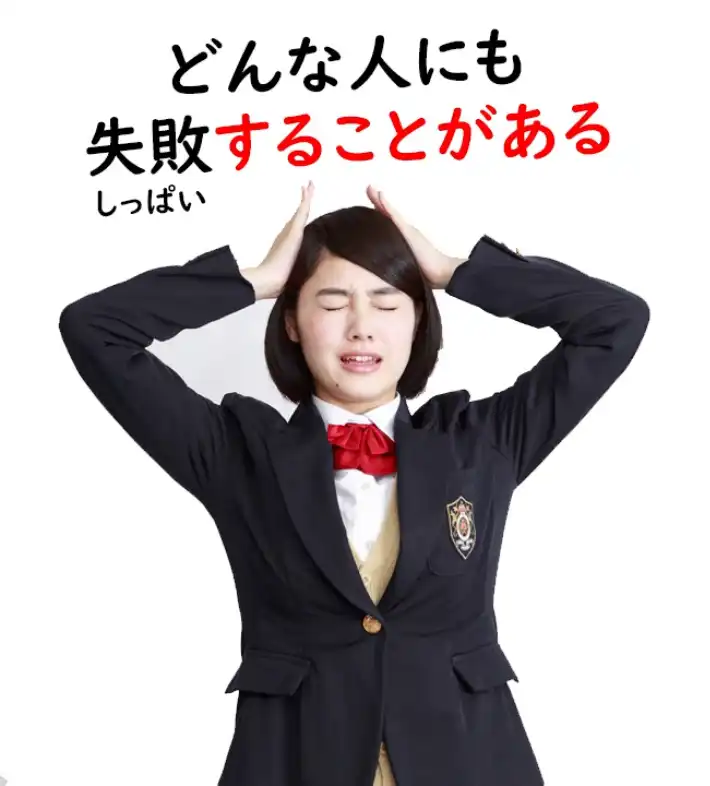
It’s simply the Japanese strategy for saying that a certain category of event sometimes happens–the fact of its happening exists.
Now, “もの” is sometimes used in ways that really do seem like a sentence-ender.
And the first way in which this happens is when we add “mono だ” to a complete logical clause.
And what this means is that the logical clause we’re talking about, as a generalization, is a reality–it’s a “もの”, it’s a thing, it’s something we have to contend with, it’s something we have to accept.
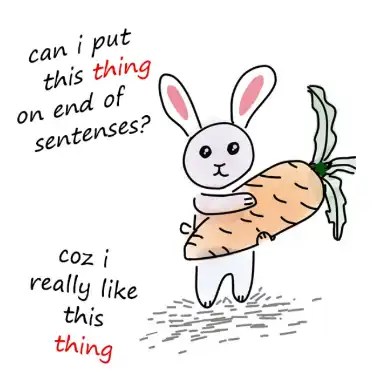
And this is why we’re using “もの” here and not “こと”.
When we say “ことがある”, we’re literally talking about a “こと”, a state of affairs, a fact that happens, but here we’re consolidating what we’re talking about into a “thing”.
It’s not literally a thing, it’s not literally something you could hold in your hand, but we are using the hyperbole of saying that it is.
If we say “冬は寒いものだ”, what we’re saying is “winter is cold, and that’s just a thing, that’s a thing, you have to come to terms with it”.
Someone says “Ooh, it’s cold” and you say “冬は寒いものだ” – “winter IS cold / winter’s a cold thing”.

Now, we can actually parse it out in that way.
We can make it “冬は寒い” is a complete sentence but we could also be saying “冬は寒いものだ” - “winter is a cold thing”, and this would be a complete logical sentence.
Whether it’s intended in that way or not is not always possible to tell, and it doesn’t tend to matter because the meaning is much the same either way.
But there are sentences when it can’t possibly be read as simply grammatical.
So, for example, we may say “希望のあるところには必ず試練があるものだ”, and what we’re saying there is “Where there’s hope, there’s always a test”, a test here meaning something we have to overcome, something we have to do in order to attain that hope.
Now, there’s no way of tying this up logically. We simply have the complete logical sentence “希望のあるところには必ず試練がある” and then we’re adding to the end of it, as a kind of sentence-ender, “ものだ”.
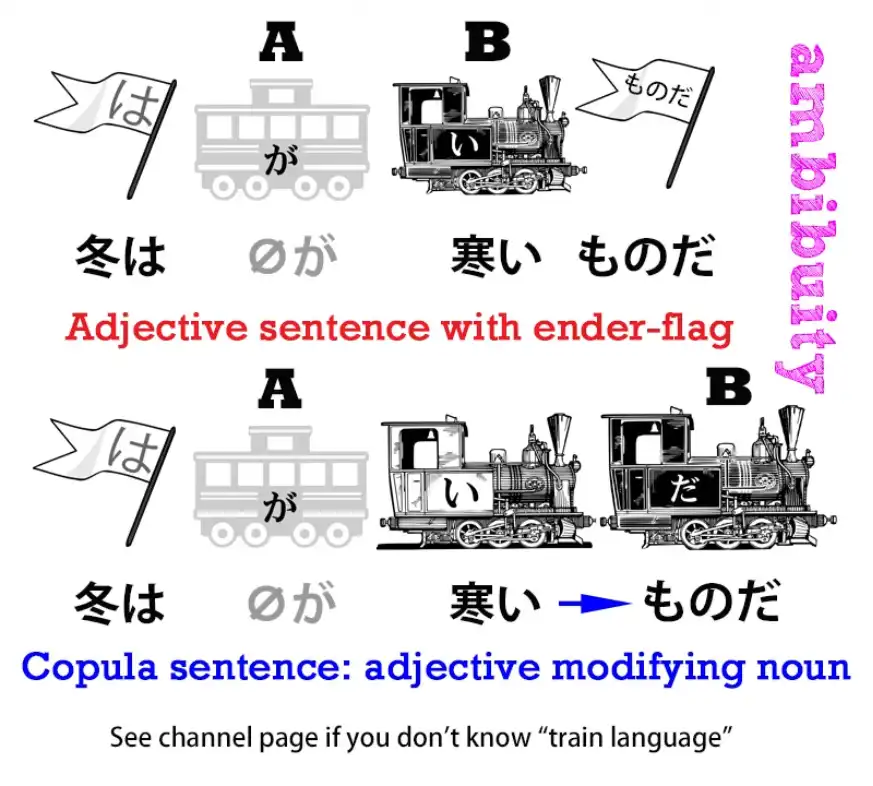
It doesn’t make logical sense, but what you’re doing is making that statement and then emphasizing it and also putting a particular kind of stress on it by saying “ものだ” – “that’s just how it is, it’s a thing, that’s something we have to understand, that’s something we have to get used to, it’s something that doesn’t change, it’s something that’s inevitable”: “ものだ” – “it’s a thing”.
Now, interestingly, that’s when we have “ものだ” in the present; when we put it in the past it has a different implication.
And again, this isn’t some strange rule we have to learn.
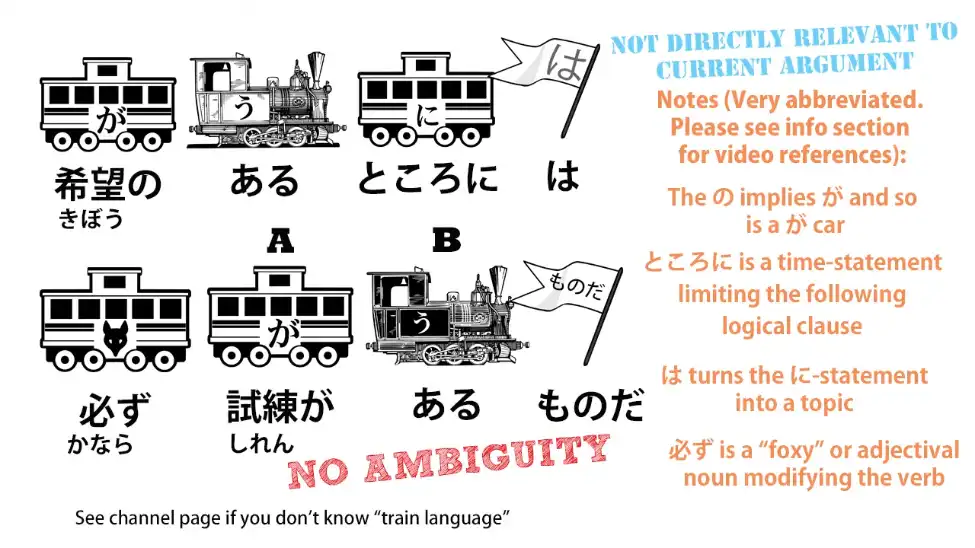 Just as with “することがある” versus “したことがある”, there are perfectly good reasons why it has to be like that. The “ものだ” we’ve just discussed has to be in the present tense
because we’re talking about generalization, and the present tense, as we know, isn’t really a present tense.
Just as with “することがある” versus “したことがある”, there are perfectly good reasons why it has to be like that. The “ものだ” we’ve just discussed has to be in the present tense
because we’re talking about generalization, and the present tense, as we know, isn’t really a present tense.
It covers the present and the future, and it can, even though it’s called the non-past tense

– it’s really the indefinite tense – it can cover the past as well so long as it’s also covering the present and the future. So it’s a generalization tense in this case. But when we say it in the past it has a different meaning.
If we say “子供のころには、よくこちらに来たものだ”, what we’re saying is “When I was a child I often used to come to this place.”
“ものだ” here is referring to something in the past.
—
And what it’s saying is that in the past it was a thing. And it has a kind of personal implication. “It’s a thing, it’s a thing I think about, it’s a thing I remember / to me, those past memories are a thing, they’re a reality.”
So again, we’re using this “もの” for something which is essentially abstract.
What’s the difference between saying “東京に行ったものだ” and “東京に行ったことがある”?
The “ことがある” is simply a literal statement: “The fact of my having been to Tokyo exists.” “東京に行ったものだ” is in English like saying “I used to go to Tokyo” and it has much more emotional weight.
It’s like saying “This is a thing I used to do, this is something that used to happen”.
And you see we concretize it by figuratively calling it “a thing”: it was a “もの”, it was a thing, it was something that used to happen.
Now, I’m not going to go into sentences that top off a logical clause with “ということ” or “というもの”, because that would take us into the extended meanings of “という” and the quotation function, which is a whole other area.
But I am going to talk briefly about a place where we see “こと” used on its own as something like a sentence-ender.
We see a logical clause followed by “こと”.
And people sometimes say that this marks an order, but that’s not exactly correct.
What it marks is a rule or a regulation.
And that’s an important distinction. You’ll see why in a minute.
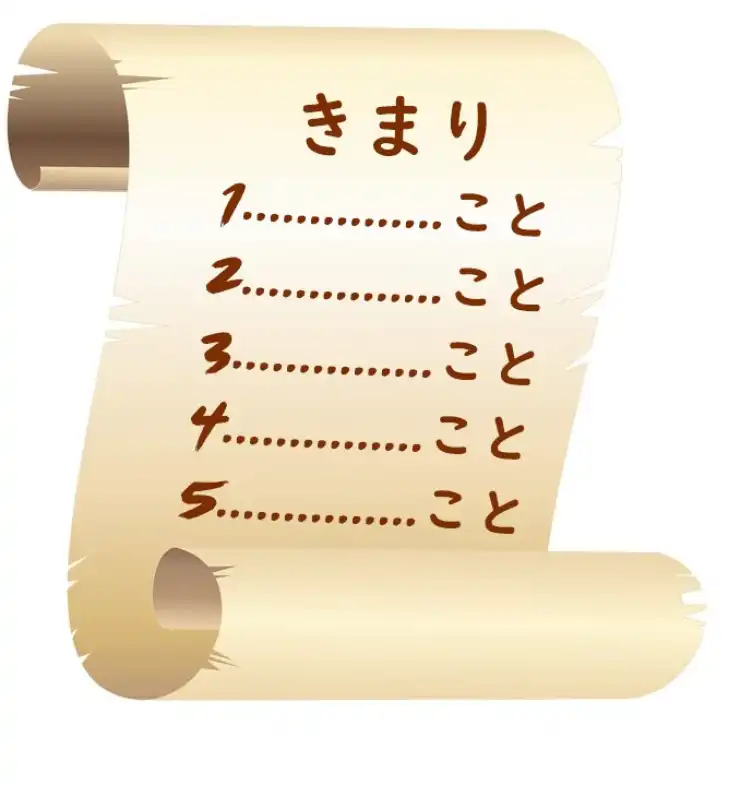
So, if you’re going to a dojo and see a list of rules pinned to the wall, it may be numbered and it may say “一何々こと, 二何々こと, 三何々こと”, and that’s really like saying “Rule 1: 何々, Rule 2: 何々”, etc.
You might go into one of those Penguin Cafés where the waiters and waitresses are all penguins and you may see a sign saying “ペンギンをくすぐらないこと” and that means “Don’t tickle the penguins”.

And the reason it’s marked with “こと” is because this is a rule of the establishment.
If you go into that café, you are duty bound not to tickle the penguins, ever, however tempting it may be, because it’s a “こと”.
And what is a “こと”?
In this case it’s a decision which also means a rule or a regulation.
I’ve made a video before about the expressions “ことになる” and “ことにする”.
When you put “ことにする” at the end of a logical clause, we’re saying that one has “decided to do” the action of that logical clause.
When we have “ことになる”, it means that the action of that logical clause has been decided upon.
And we have to put that passively in English, because there’s no other way of translating it into English, but it’s not passive in Japanese.
As we know, Japanese has no passive.
So, this is the same “こと” – “a decided thing”.
And in Japanese, this also implies a rule or a regulation.
One of the commonest words for a rule or regulation in Japanese is a “決まり”.
Now, “決まり” is the i-stem, the noun-form of the verb “決まる”.
And “決まる” is the self-move version of the pair “決める / 決まる”.
“決める” means to “decide something” and “決まる” means “something has been decided”.
And once again, we’re forced to put it passively in English although it’s not passive in Japanese.
And I’ve made a video about this whole passivity problem that English has with Japanese.
So if you want to pursue that further, I suggest you watch that video.
So, a “こと” is the same as a “決まり”: “a decided thing / a rule / a regulation”.
And when it’s put on to the end of a logical clause, it simply marks that logical clause as a rule or a regulation.
65. Coming and Going: Deeper secrets of 行く and 来る、て行くand て来る (te-iku, te-kuru)

こんにちは。 Today we’re going to talk about coming and going in Japanese.
Now, “行く” and “来る” are two of the first words we learn when we start learning Japanese, and we learn that they mean “come” and “go”, and broadly they do.
But as we become more advanced we understand that it isn’t quite that simple.
They have many metaphorical and more subtle meanings, but even the physical meaning doesn’t correspond exactly to English “come” and “go”.
Essentially, “iku” means “go from where the speaker is to somewhere else”, and “kuru” means “come from somewhere else to where the speaker is”.
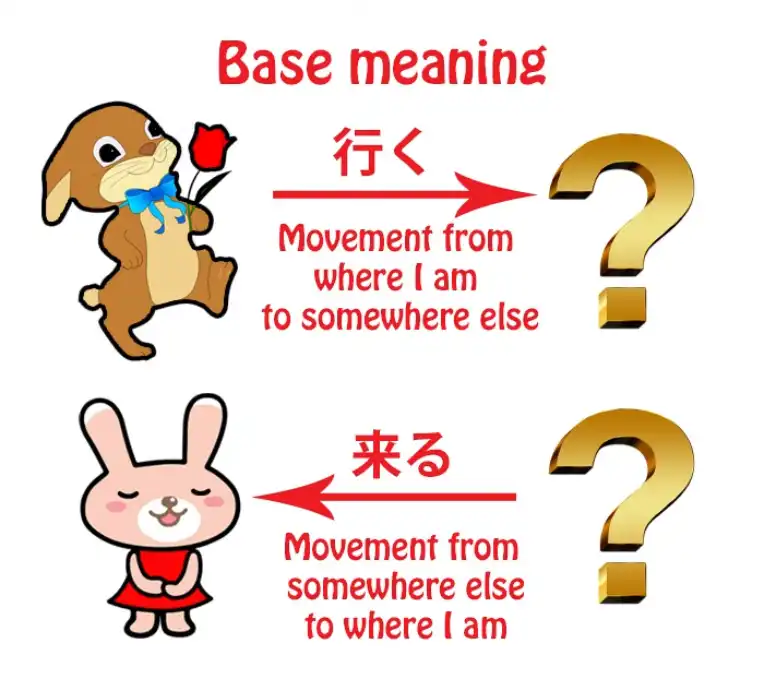
Isn’t that just the same as English “come” and “go”?
Well, not quite.
For example, we can say to someone on the phone “Shall I come over to see you?” or you might say “Will you come to me, or shall I come to you?”
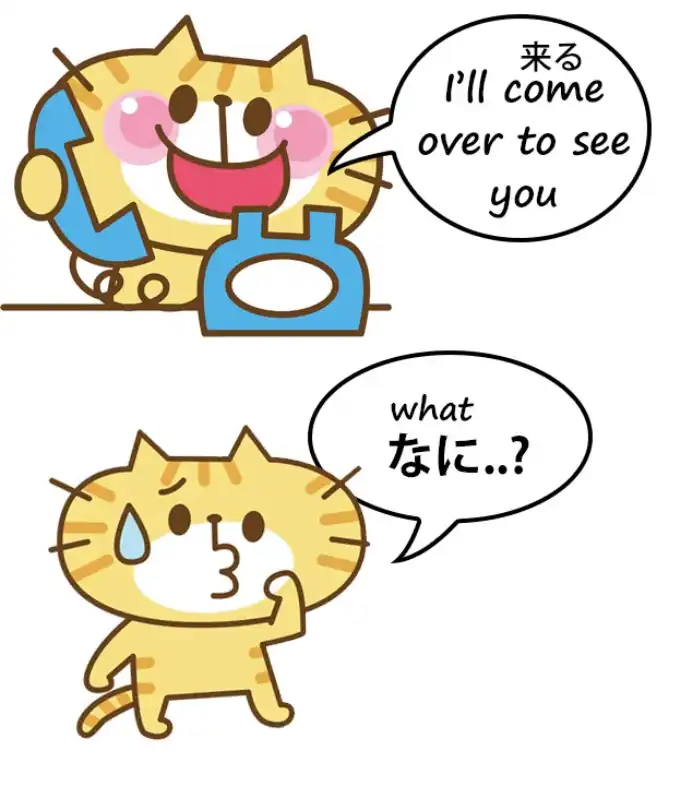
And in Japanese that’s quite impossible, because you can’t “come” to a place where you aren’t.
“Coming” means coming from somewhere where the speaker is not to the place where the speaker is.
So you can’t say to someone on the telephone “Shall I come to you?” with “来る”.
You can only say “Shall I go to you?” with “行く”.
“Shall I go to you?” would sound strange in English, so we see that “来る” and “行く” aren’t exactly interchangeable with English “come” and “go”.
“来る” can only ever mean “move from where the speaker isn’t to where the speaker is”.
“行く” is not quite so strict.
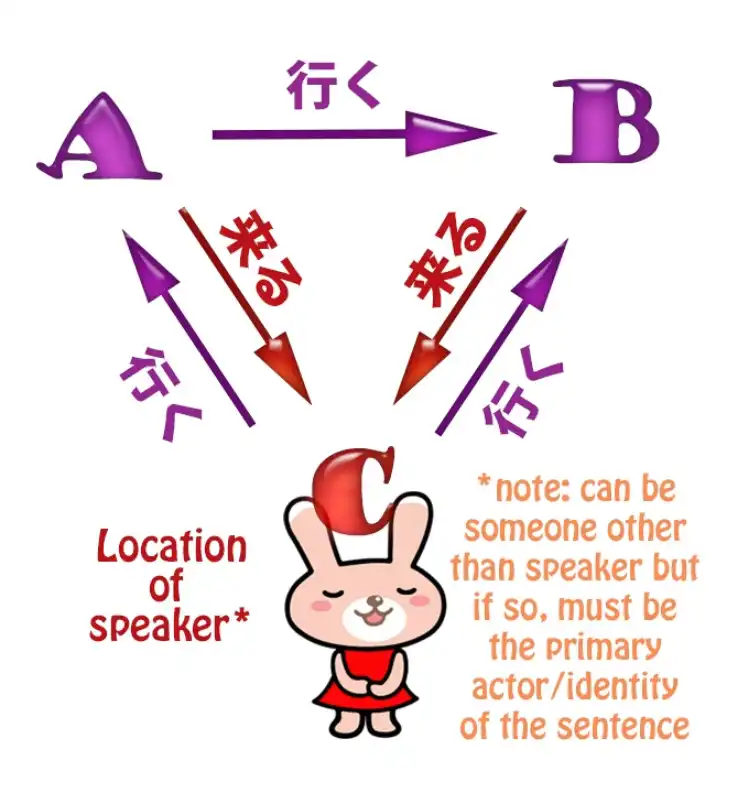
We can talk about someone “行く”-ing from A to B when we are actually at C, but “来る” must always mean movement toward C, the place where we are.
And this is important to understand as we get into the more metaphorical meanings of “来る” and “行く”.
We’ve talked about some of the extended meanings in an earlier lesson but still physical ones, especially those which involve connecting “来る” or “行く” to the te-form of a verb.
So “持ってくる” means “bring (to the place where I am)”; “持っていく” means “take (from the place where I am)”.
But “the place where I am” can actually be a time or it can actually be a mental state of identification.
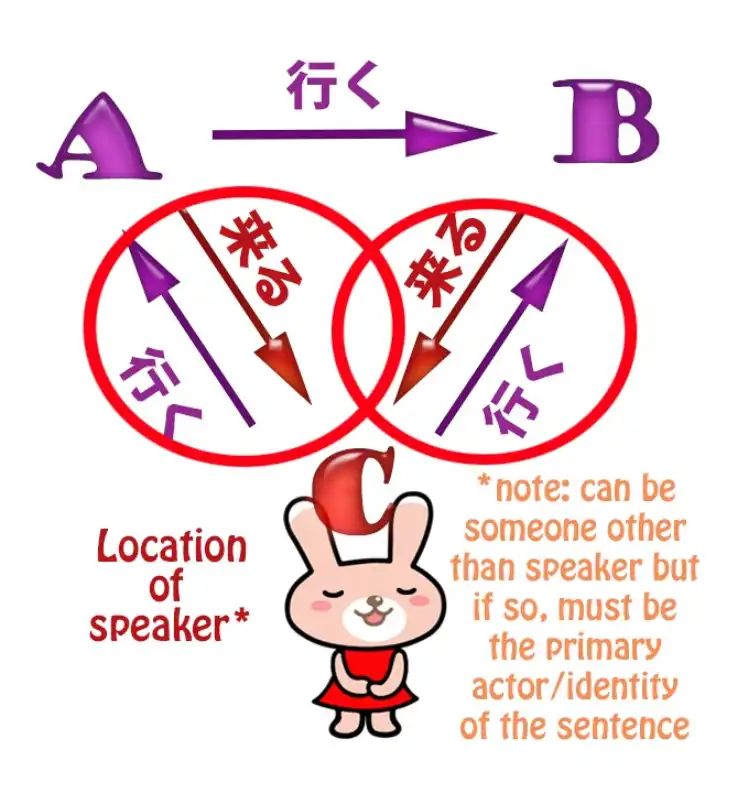
So we get more advanced meanings which are all based on the fundamental physical metaphor of coming to the place where one is, going from the place where one is, or going from or going one place to another (but not coming from one place to another because that isn’t possible).
So, a very simple example is we may say “雨が降ってきた” – and we have almost an equivalent English expression: we might say “It came on to rain”.
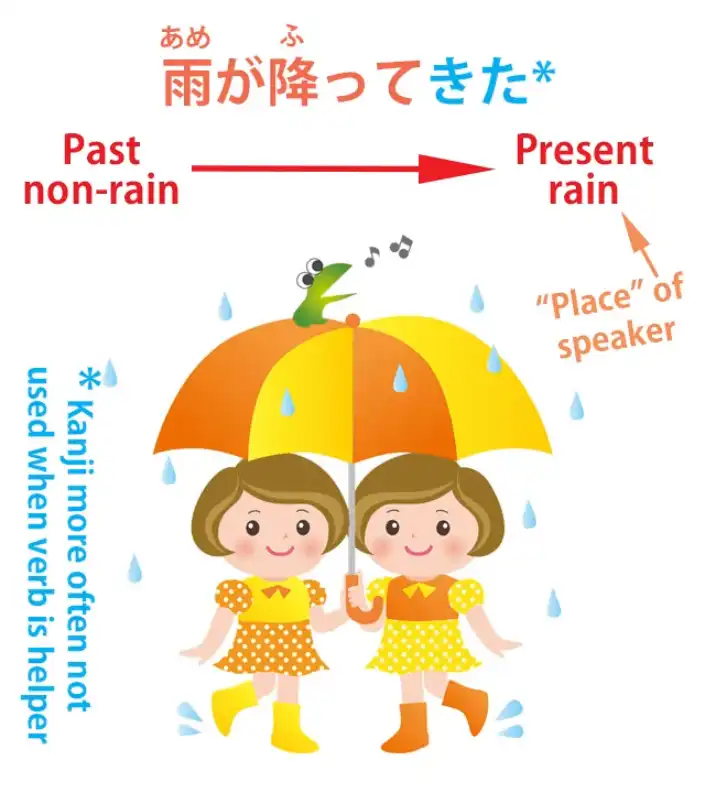
And the metaphor here is a time metaphor.
Rain came towards us in time, from a time when it wasn’t there to the time where we are, when the rain is there.
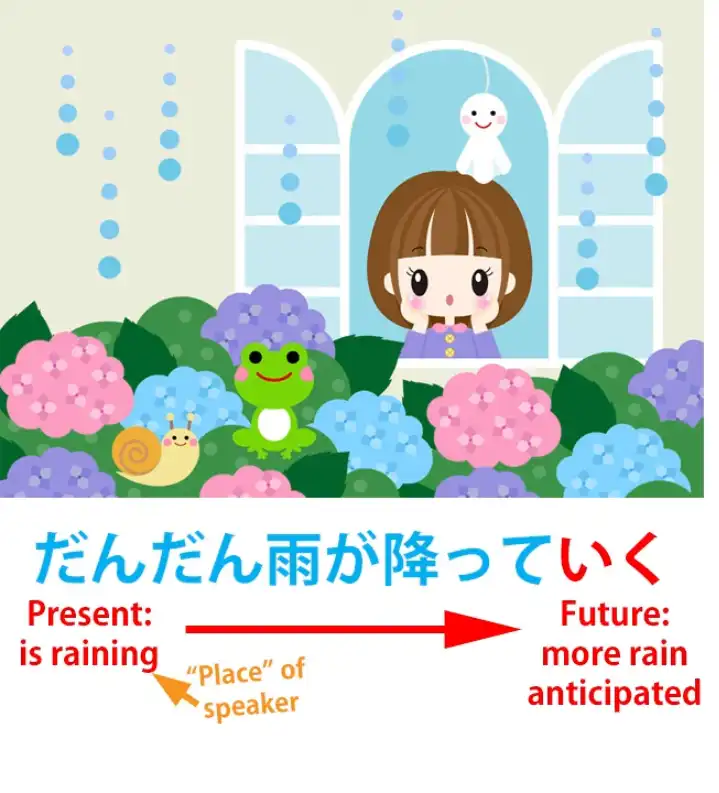
If we say “だんだん雨が降っていく”, we’re saying “It’s getting rainier and rainier” and we’re projecting into the future.
“いく” is moving from where we are into the future.
Now, since time, at least apparently, moves forward, we can only use “いく” in the sense of moving forward in time, away from us, away from the point where we are, not moving backward in time away from the point where we are, because that isn’t currently possible.
So, “雨が降っていく” in this case implies that it has become rainy (“降って来た”) and that it’s increasingly going to do so in the future.
Now, we can also use “くる” and “いく” in subtler ways still, concerned not with space or time but with subjectivity, with our mental state.
So, a very common expression is “分かってくる”, which in English might be rendered as “come to understand”, but this of course would be wrong.
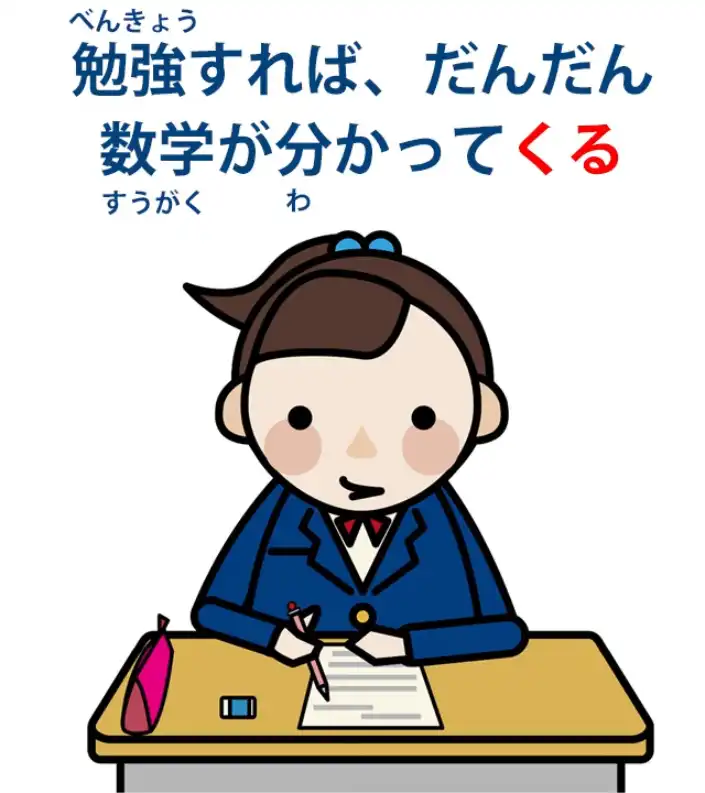
Let’s take an example of why.
We might say “勉強すれば、だんだん数学が分かってくる” And that would be translated normally as “if you study, you will come to understand mathematics”.
And as you can see, if you’ve been paying attention, there’s a contradiction here.
You can’t come to a place where you aren’t yet in Japanese.
You can’t use “くる” to speak about coming to somewhere that you aren’t at this stage but will be in the future.
It would have to be “いく”, wouldn’t it?
So why is “くる” used here?
Well, if you’ve followed this course you probably know the answer already.
“分かる” does not mean “understand”.
It means “be understandable / be clear” or literally what it actually means is “do understandable”.
So what we’re in fact saying is that if you study, math will come to be understandable to you.

In other words, math will come from being far from you to being nearer to you and being understandable.
So we’re using this in a subjective sense.
And this is an important thing to understand, and it’s important to understand that “くる” and “いく” can represent movement in time, toward one or away from one, movement in space, toward one or away from one, movement in subjectivity, towards one’s mental condition or state or away from it, but also “iku” can represent objectivity versus “kuru” representing subjectivity.
And the reason for this is something we’ve already covered, which is that “iku” can mean moving from A to B while we are at C.
Therefore, “iku” can represent a movement from one place to another that doesn’t involve us, physically, temporally, or mentally or emotionally.
So, if we say “samuku natte kita”
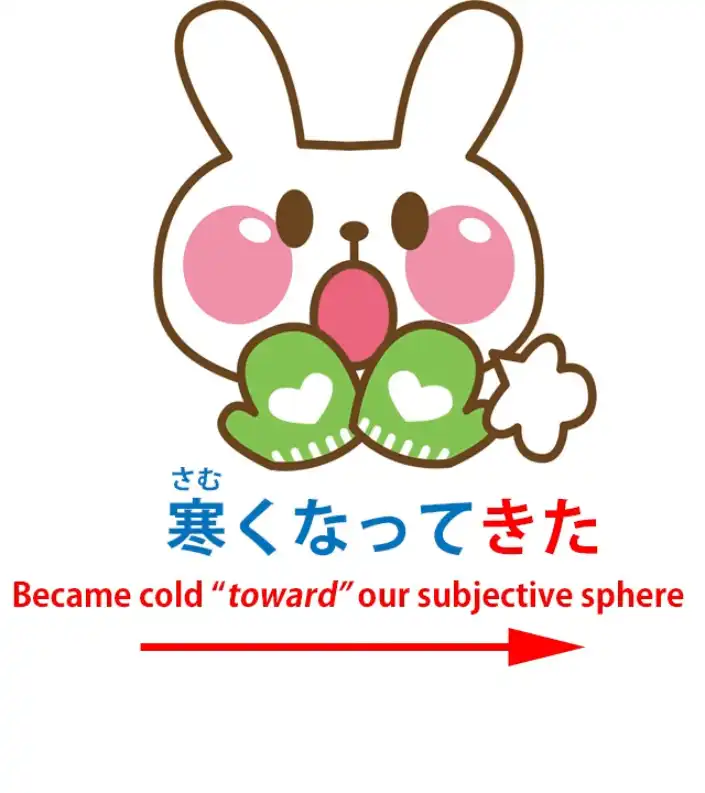
we’re saying “it became cold”, and adding that “kita” (“kuru”) is relating it to us: “It became cold (coming toward me or us).” So what we’re saying is not just that it became cold, but implying that it affects me or us subjectively: “Samuku natte kita”.
By contrast, “samuku natte itta” is more objective.
It doesn’t involve us. It doesn’t imply that it in any way affected me or us.
It just happened. It became colder.
Because this is the “itta” that in spatial terms is going from A to B, objectively, without involving me or us.
Now, you may be asking, “How do I tell when it’s movement in space, when it’s movement in time,
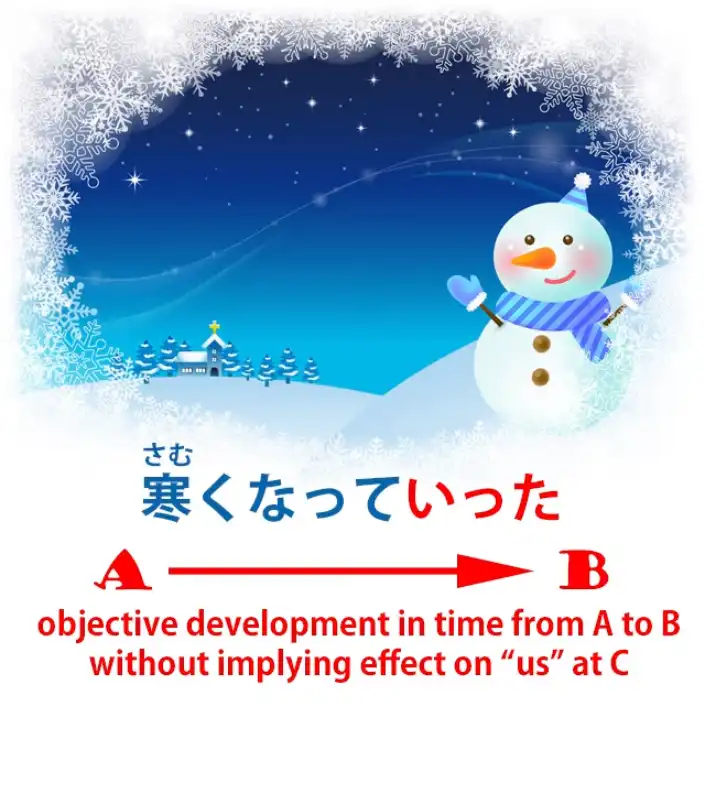
when it’s movement in terms of mentality and subjectivity, and when “kuru” and “iku” represent subjectivity versus objectivity?” And the answer to that is: There aren’t any rules and we shouldn’t be looking for rules in cases like this.
The reason we learn the ways that these work is not as an end in itself, not as a set of facts to learn, but as an aid to understanding real Japanese.
As we immerse in Japanese, as we watch anime, read novels, play games in Japanese, these things start to make sense.
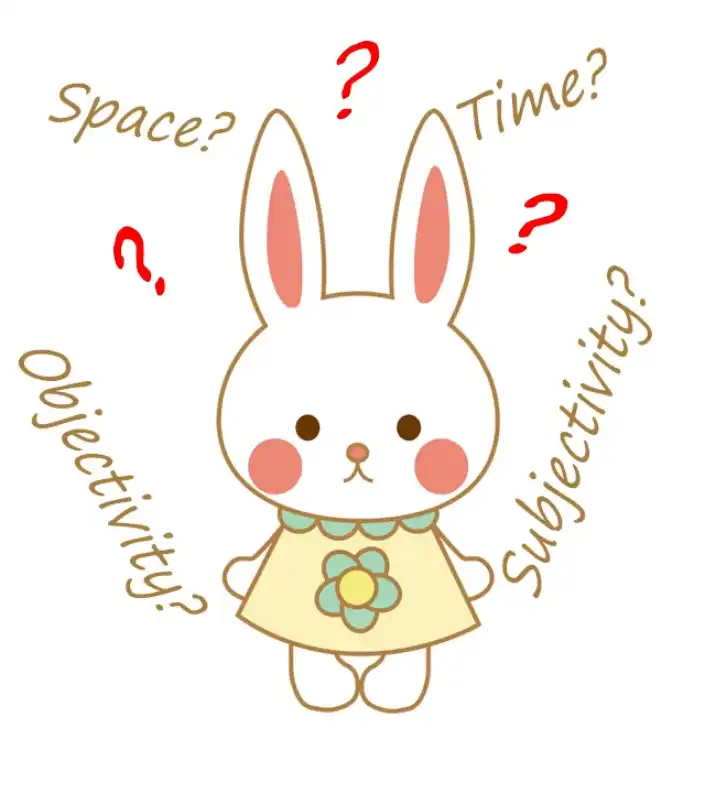
What we need is the principles on which they’re based, which gives us a head start in making sense of them.
But structure is never going to substitute for immersion.
Structure is the underpinning that makes immersion quicker, and easier, and more understandable..
66. HIDDEN Subjects in Japanese - and how to understand them
HIDDEN Subjects in Japanese - and how to understand them - Lesson 66
こんにちは。 Today we’re going to talk about the “hidden hand” in Japanese.
What do I mean by that?
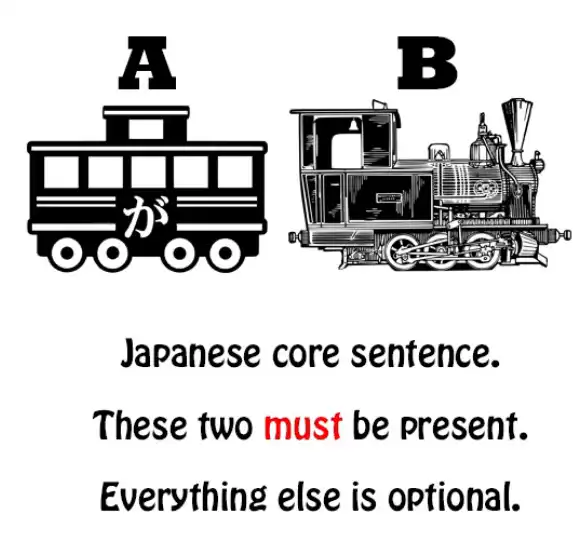
No subject in Japanese?
Well, a number of people claim that Japanese has no subject.
And I think we’ve established beyond any doubt that Japanese not only has a subject (Lesson 9) but that you can’t have any Japanese sentence without a subject, although you can’t always see or hear the subject.
It can be a “zero-pronoun”.
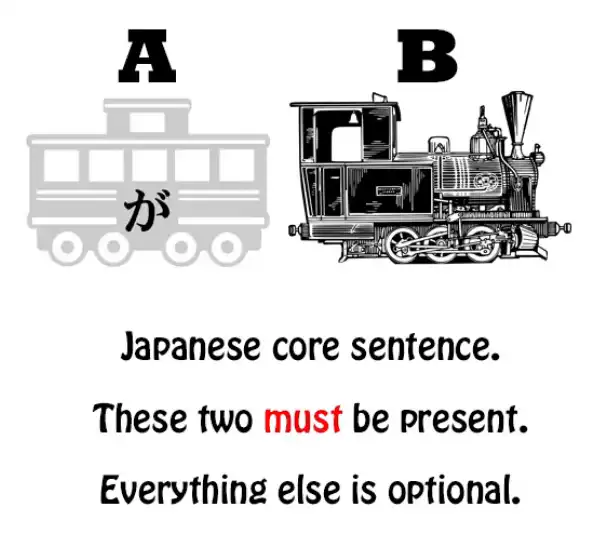
By subject, of course, I mean the A-car of a sentence.
And since every sentence is telling us either that “A is B” or that “A does B”, Obviously we can’t have a sentence without A.
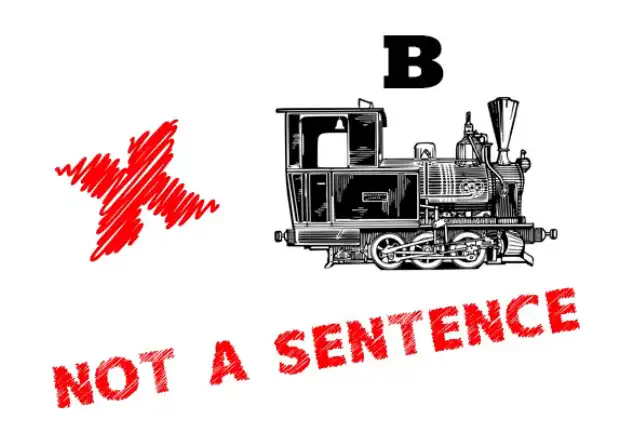
It’s as simple as that.
However, there are times when not only can’t we see the subject, the A-car, but it can be difficult to work out what exactly it is.
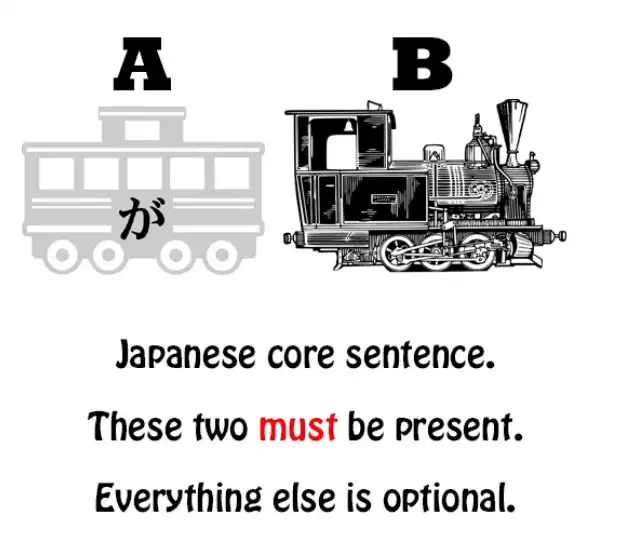
And this difficulty will be seen to derive from not fully understanding how some aspects of Japanese work.
One thing we need to understand is that different languages have different expression-strategies.
Different expression strategies
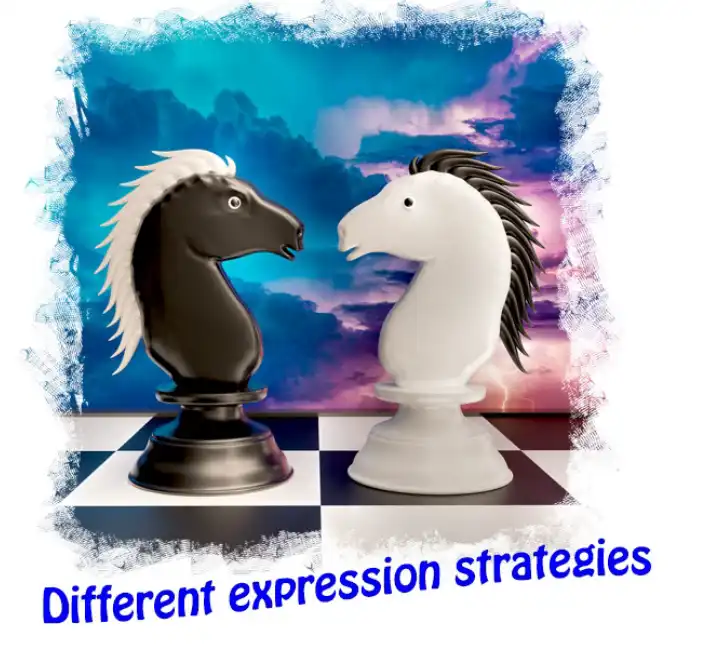
We know already how damaging it is to say that “コーヒーが好きだ” means “I like coffee”.
“I like coffee” is what we would say in English, but English uses an entirely different expression-strategy from Japanese.
Liking is expressed by a verb, and the doer of the verb is the person who likes the coffee.
In Japanese, liking is expressed by an adjectival noun, and the be-er of that adjectival noun is the coffee.
So the Japanese expression-strategy here is closer to the Spanish than the English, although they’re not identical.
Now, although languages have differing expression-strategies, it turns out that languages, even when they’re not related, tend to have a relatively limited bag of tricks that they draw on.
So we find the same expression-strategies in different languages, but not necessarily in the same places.
And also expression-strategies can vary in status between languages.
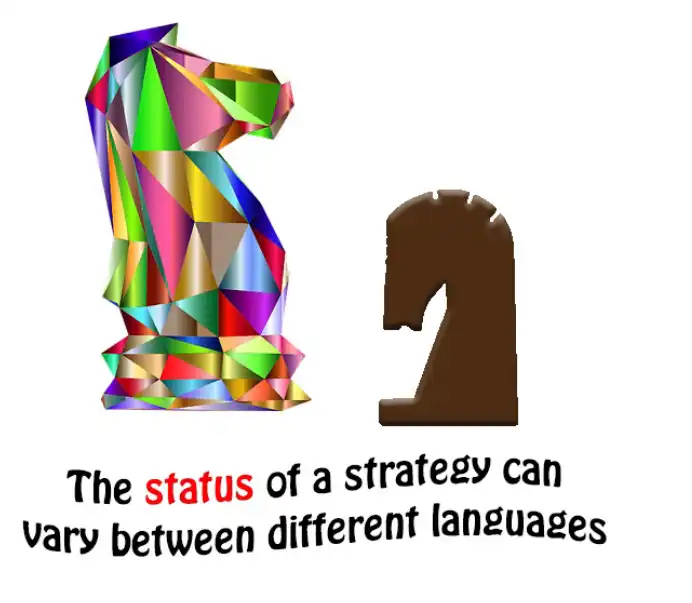
Receptive helper
So, one of the reasons that English so-called “Japanese grammar” misnames the Japanese receptive helper-verb as a passive conjugation or passive voice, is that what it really is, while it exists in English, is not of very high status. (Lesson 13) Because we use the receptive in English by using the word “got” under various circumstances like “I got rescued by my big sister”, “The sandwiches got eaten by the dog” – but this isn’t considered good English.
Now, the fact that it isn’t considered good English is simply a matter of fashion.
It’s perfectly grammatical.
It just happens to be unfashionable or to hold low status in the language.
This is really just a historical accident.
Now similarly, other expression-strategies exist in Japanese that are not considered of very high status in English and that can confuse us.
So, I’m going to take a sentence here which was put to me by one of my viewers, who had considerable difficulty in disentangling what the subject of this sentence actually is.
And that’s perfectly understandable, because until you understand this expression-strategy, it’s not entirely clear.
Hidden subject sentence analysis
Now, the sentence comes from NHK News Easy, which is a very good news service for beginners in Japanese.
And the sentence is: “東京オリンピック選手が食べる料理をみんなに教えてもらう”
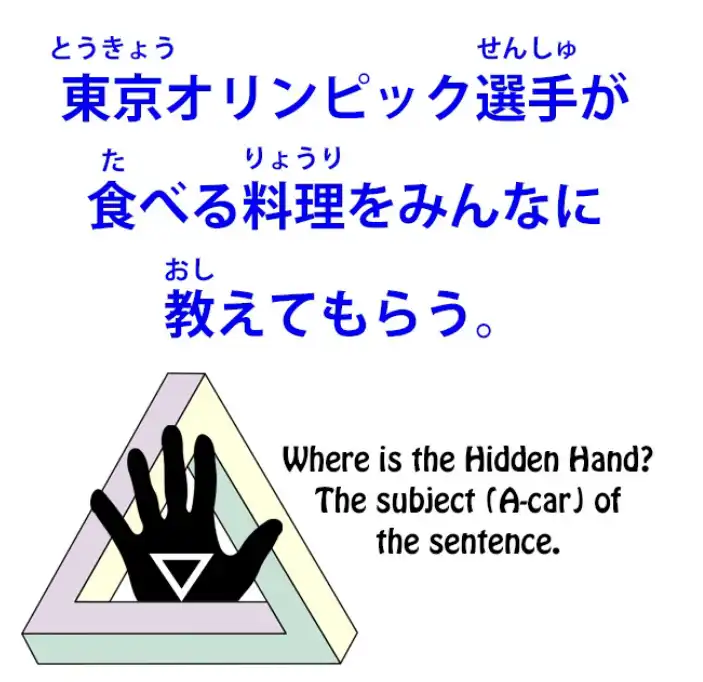
So, what do we think is the subject, the A-car, of this sentence?
Now, the first thing to do when analyzing a sentence is what I said in my video on sentence analysis (Lesson 37), which is that we need to see where logical clauses end within a sentence.
A logical clause which is functioning as a logical clause and not a descriptor or a helper to anything else can only end in two ways,
either with a full stop, making it the end of a sentence,
or with a conjunction, marking it as the first logical clause within a compound sentence.
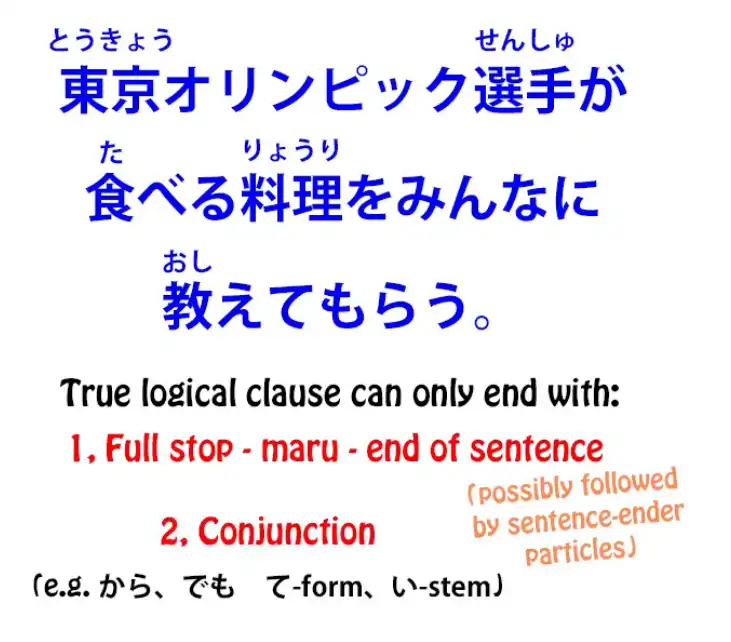
Of course, if it comes at the end of a sentence it may be followed by one or more sentence-ender particles, but it has to be the final engine in the sentence: the final verb, noun-plus-copula or adjective.
So let’s go through this in the manner that I’ve taught you in the past.
“東京オリンピック選手が食べる…” Is that a logical clause? Well, it could be a logical clause, couldn’t it?
It would mean “The Tokyo Olympic athletes eat.” However, is it followed by a full stop, by sentence-ender particles with a full stop, or does it end in some kind of a clause connector like “から” or “でも” or the て-form or the い-stem of a verb?
No, it doesn’t end with any of those, does it?
It’s directly followed by a noun.
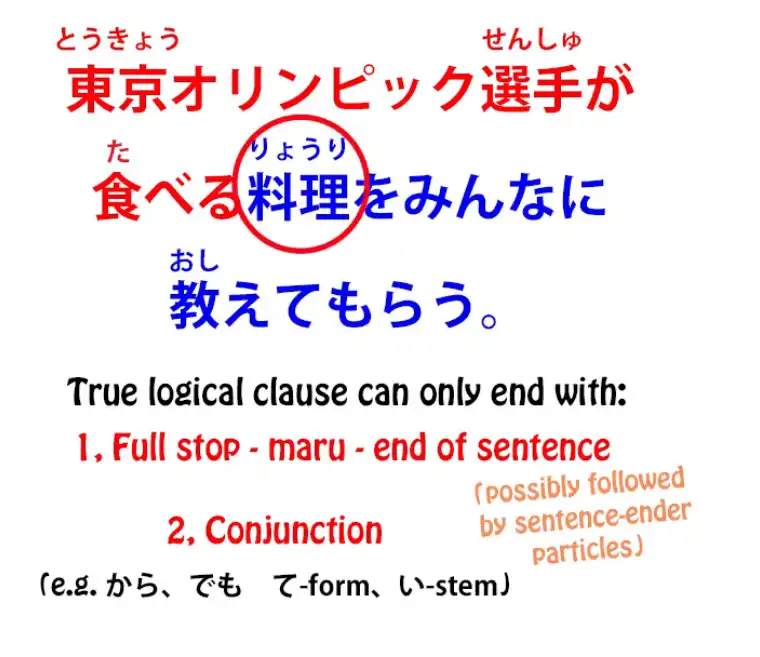
And, as we know, when a logical clause is directly followed by a noun, what it’s doing is modifying that noun.
In other words, it’s not functioning as an active logical clause; it’s functioning as, essentially, an adjective, a noun modifier.
So “東京オリンピック選手が食べる” is all simply modifying “料理”.
It’s just telling us more about the food.
So then we have: “…料理をみんなに教えてもらう” Now, we still haven’t arrived at the subject of the sentence, have we?
Because the subject of any sentence has to be marked with が.
The “選手” are marked with が, but we know they’re not the subject of the sentence; they’re just helping to modify “料理”.

Note: Just put this here…the link is for Lesson 47. Check also Lesson 46. “料理” can’t be the subject of the sentence because it’s marked with を, not が.
“みんな” can’t be the subject of the sentence because it’s marked with に, not が.
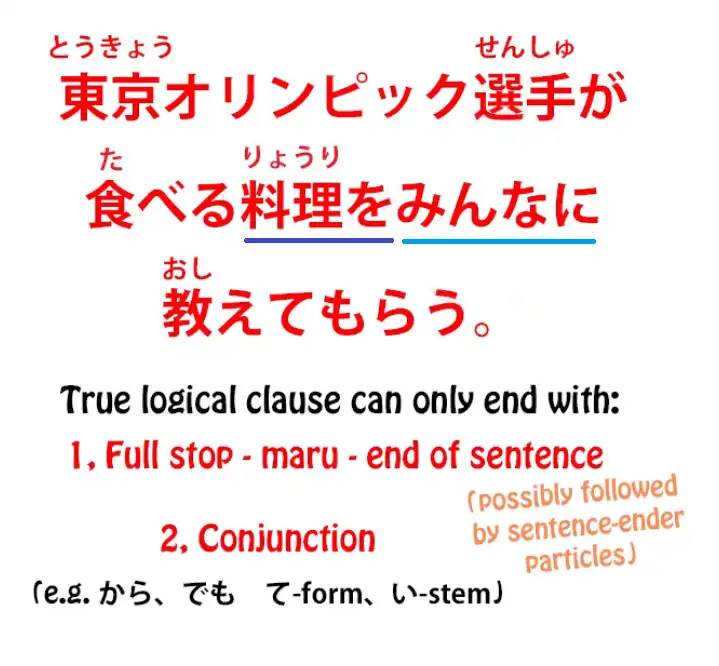
So what is going on here?
Hidden subject sentence action

Well, what is the sentence actually saying?
It’s saying that someone, the subject of the sentence, whoever that may be, is having everyone teach or advise them about the food the Olympic athletes are to eat.
Now, my questioner actually got this far, but then was stumped by the question of who this unnamed person or people might be.
Could it be the athletes?
Well, that isn’t likely, and we always have to consider likelihood in resolving any kind of ambiguity. (Lesson 48) This isn’t really an ambiguous sentence but the context makes it pretty clear that it’s not the athletes.
First of all, by default these “-てもらう” sentences mean that somebody actively had someone else do something. (Lesson 49) So the person doing “もらう” (the A zeroが subject) is getting (the B train - もらう) the person (みんなに) doing the て-formed verb to do that て-formed verb (教えて).
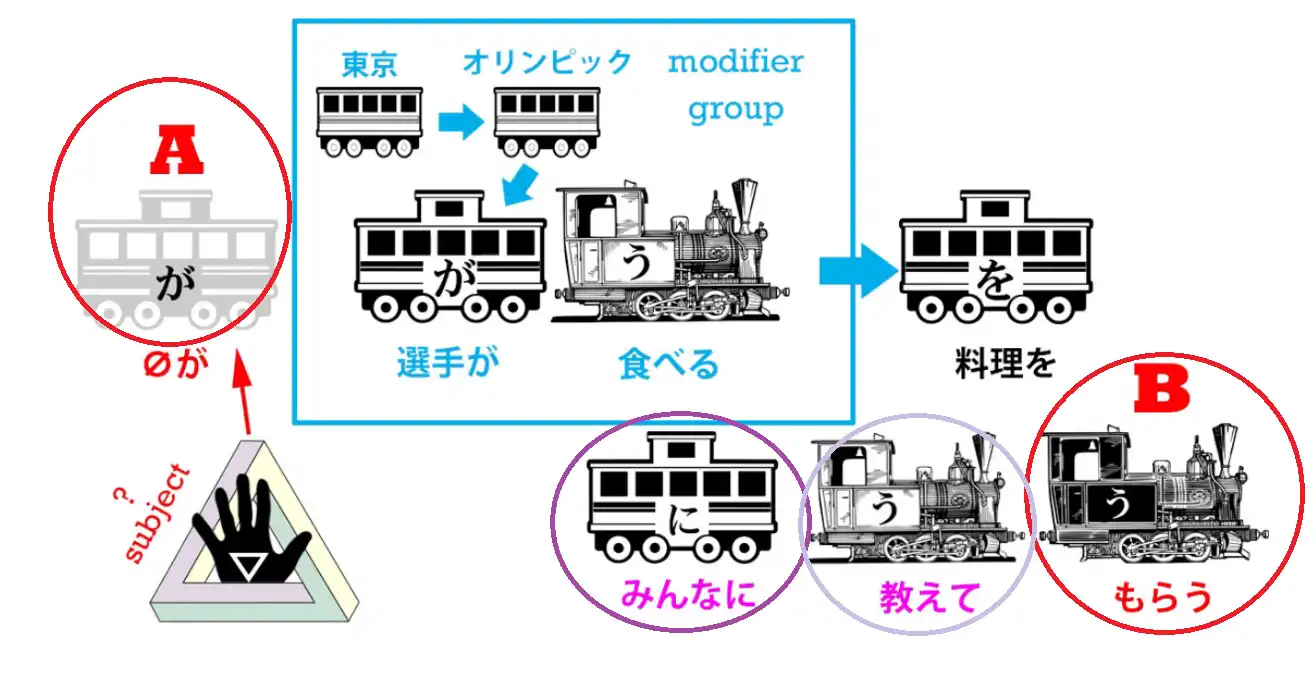
So if we say “お医者さんに見てもらう”, we’re saying “have the doctor look at me”.
So someone is having everybody teach them or give their opinions on what the athletes should eat.
Is this likely to be the athletes? Well, not really.
Are they likely to be getting together and asking everybody what they should eat?
#
Who is the subject here?
So who is it?
Who is the が-marked zero-pronoun, the subject, the A-car of this sentence?
And the answer is, it is simply an undefined zero-pronoun.
Now, that might seem very strange, but in fact it isn’t.
As a matter of fact, we use it all the time in English.
But you would never see it in a newspaper or a news service the way it is here, which is what’s confusing about it.
So when do we use an undefined pronoun like this?
Well, let’s think about it.
Suppose someone said “I hear they’re putting a man on Mars next year.” Well, who’s “they”?
Well, we don’t know who “they” is.
Presumably whoever it is that puts men on Mars – NASA or Mr. Musk, or somebody.
Now, suppose I say “They’re getting everyone’s opinion on what the Olympic athletes should eat.” Well again, somebody might well say that in English.
You wouldn’t see it in the newspaper, but a friend might well say it to you: “You know, they’re getting everybody’s opinion on what the Olympic athletes should eat.” Who’s “they”? Well, we don’t really know.
Whoever it is that’s responsible for feeding the Olympic athletes, presumably.
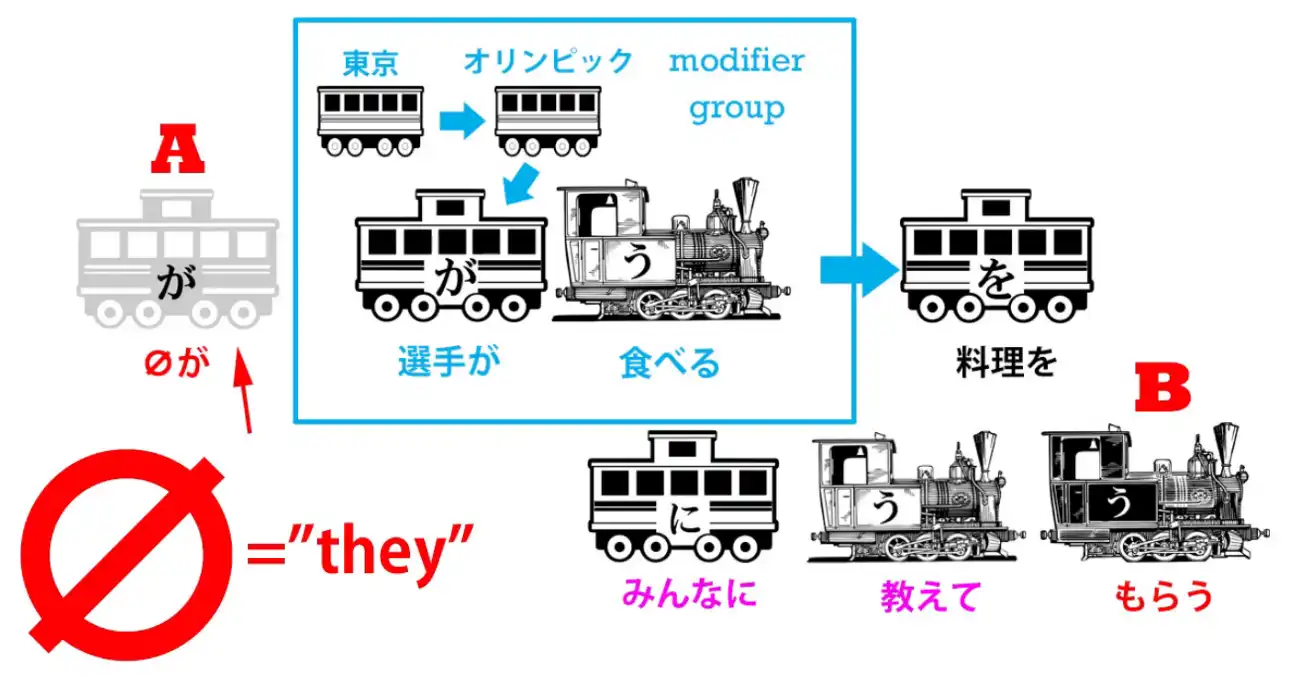
And this is a construction that you’ll see quite often in Japanese, this unnamed “they”, whoever they might be.
You hear it in English all the time but it’s of low status.
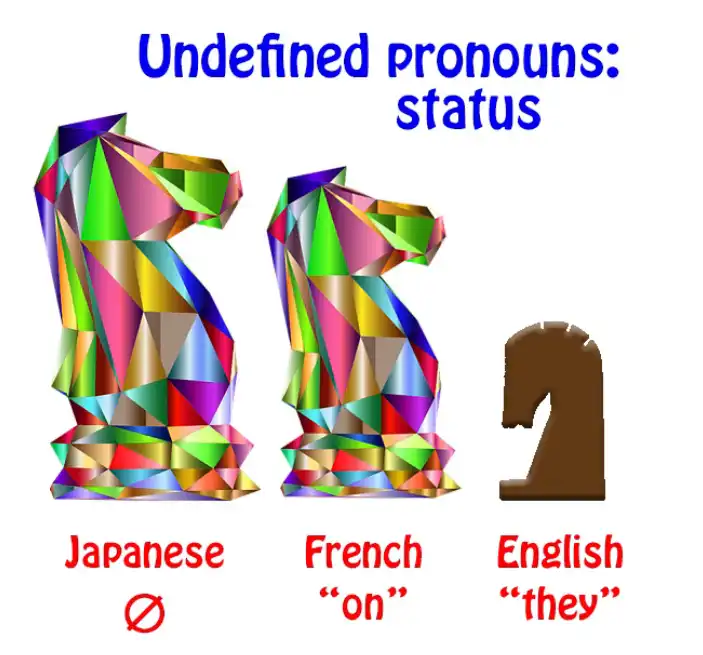
You won’t see it in official documents or newspapers or anything like that.
You only hear it in relatively casual speech.
In French you might hear it more often.
“On” (they, one) can be used more generically at a higher level of discourse than it can in English.
So once we know this, it’s easy enough to pinpoint the subject of this sentence.
And it’s an important thing to know because we’re going to come across this kind of construction relatively often in Japanese.
67. もう and まだ the time-relations that make sense of them
もう and まだ the time-relations that make sense of them (mou and mada) Lesson 67
こんにちは。 Today we’re going to talk about “もう” and “まだ”, two expressions which can be a little confusing, particularly “もう”.
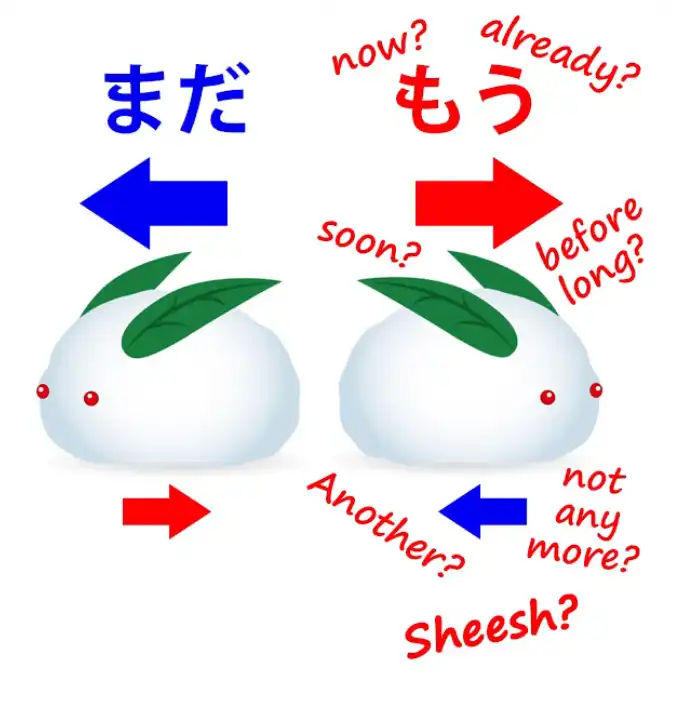
If we look up “もう” in a Japanese-to-English dictionary, we get told that it means “now, already, soon, before long” and sometimes even “not any more”, as well as meaning “another” and being an expression of annoyance.
How can it mean all these different time relations at the same time?
Well, we’re going to find out today.
And we’re going to see that it’s not nearly as confusing as it looks.
But first of all I want to look at “まだ”, which is a bit less confusing but will give us the principles we need for understanding how “もう” really works. All right.
まだ
So, “まだ” has a less confusing collection of definitions.
Mostly we’re told that it means either “still” or “not yet”.
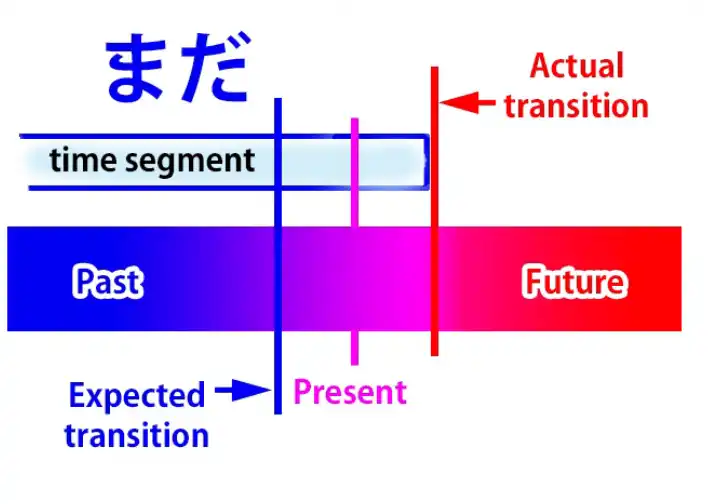
So let’s start by looking at what it really does mean, what it really does.
“まだ” does a number of things.
It tells us about the present time.
It situates the present time inside a time segment that stretches back into the past and is either expected to end or at least the possibility of its ending is being considered.
Most often it’s expected to end.
Now, this does three things. It tells us about the present, so we can say that it is in fact a way of saying “now”, but “now” in a particular relation to the past and the future.

What is that relation?
Well, as you see, we have two things.
We have the section of time in which “now” lies and we have a transition point.
Since it’s a section of time, it can’t go on forever, so there’s a transition point at which it changes to another section of time with other qualities that is expected in the future or at least considered as a possibility in the future.
Now, “まだ” gives us two contrasts.
The section of time is contrasted with the future when it will or may change, but the present moment is contrasted with the past when it might have been expected to change.
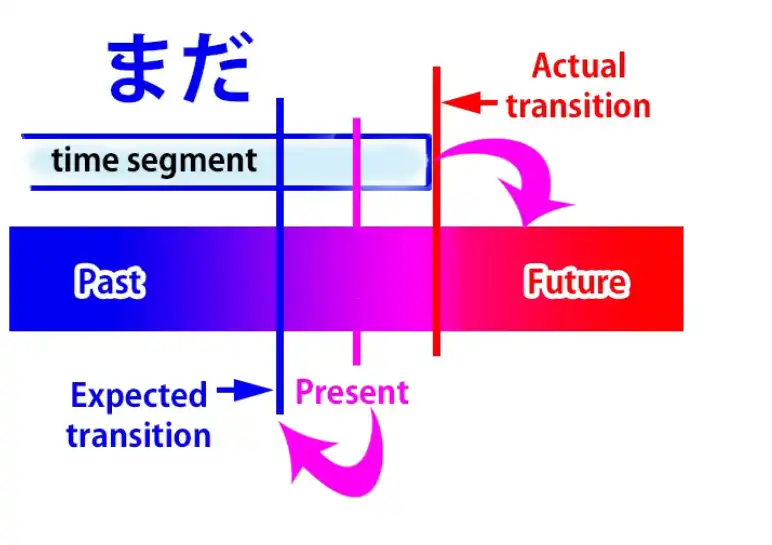
So what this means in English is essentially “still”.
And this may seem a bit abstract, but I think we’ll understand it clearly enough when we see how it works.
So, if we say “宿題はまだしなかった”, we’re saying “I haven’t done my homework yet” or “I still haven’t done my homework.”
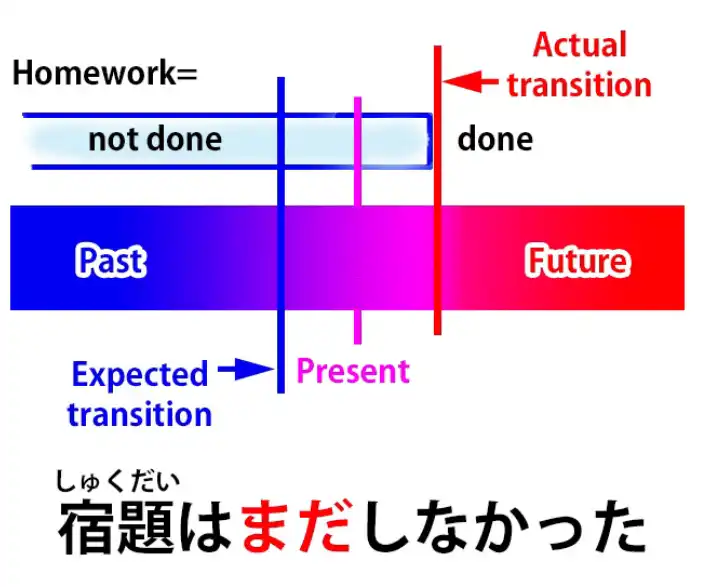
Now, as you see, this means that we are in a section of time where I haven’t done my homework.
This stretches back into the past and is contrasted with a period in the future where I will have done my homework.
But the present time is being contrasted with a time in the past where I might have or should have done my homework.

That’s why we say “まだ” and that’s why in English we would say “still” or “haven’t yet”.
In other words, there’s a time in the past where it might have been expected to happen, but it hasn’t.
So it’s still in a state which won’t change until the future.
And this is what we mean by terms like “still” and “yet” in English.
If we say “さくらはまだ若い”, we’re saying “Sakura is still young.”
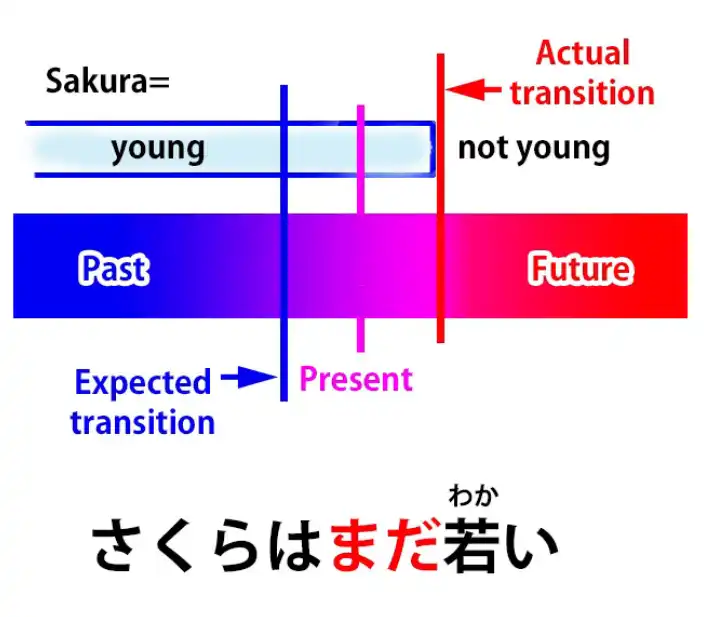
Now again, what we’re saying is that
the present time is situated in a period where Sakura is young,
that period stretches back into the past and is expected to change at some time in the future.
She won’t be young forever, she’ll get older.
So we can see that the time period while Sakura is young is contrasted with the future when she will get older.
But the present moment is being contrasted with the past.
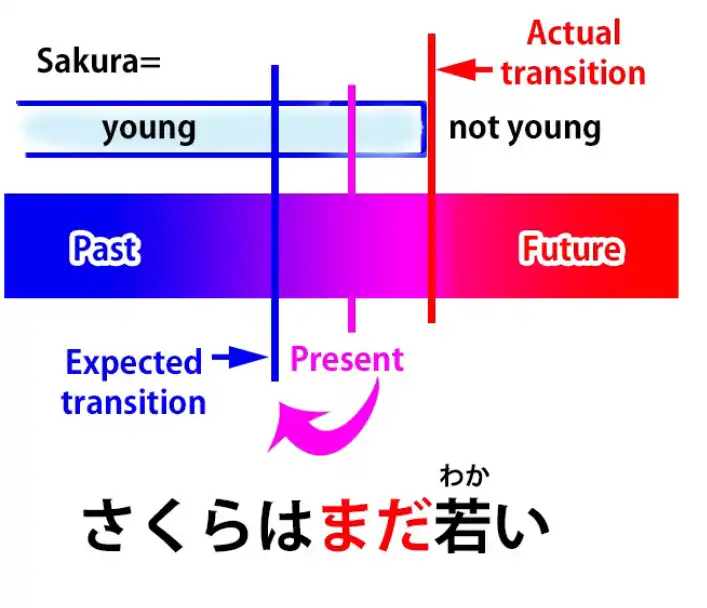
That’s why we say “まだ” or why in English we would say “still”.
What we’re saying is “She hasn’t stopped being young yet”.
As opposed to the possibility that she stopped being young in the past, she hasn’t stopped being young in the past – she’s still young now, even though she won’t be young in the future.
If we say “さくらはまだ大人ではない”, we’re saying “Sakura is not yet grown-up”.
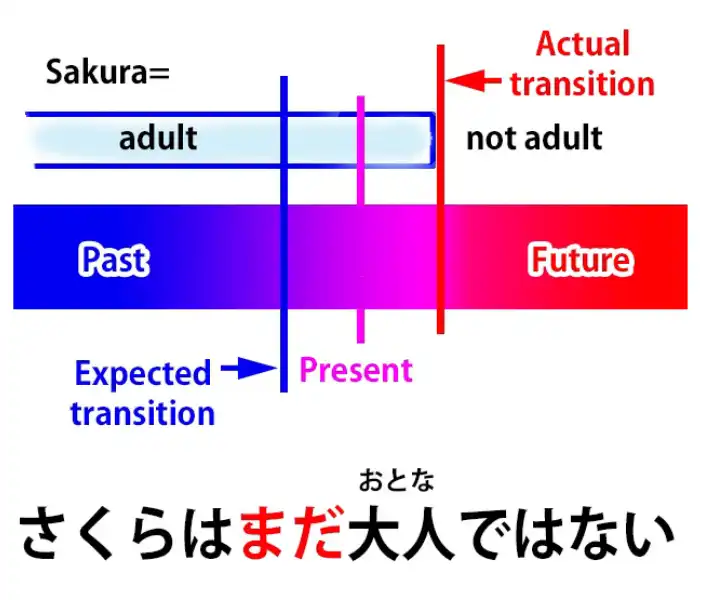
So now we’re using the negative, and that’s why “まだ” can mean “still” or “not yet”.
It just depends, at least in this case, on the fact that it’s being used with a negative.
So, if we say “さくらはまだ大人ではない”, we’re saying that at the present period Sakura isn’t grown-up.
Even though you might have thought she’d grown up a little while ago, she hasn’t.
But of course she will grow up in the future.
As you can see, the reason why it gets translated both as “still” and “not yet” is because Japanese puts things a little bit differently from English.
In English we say “Sakura is not yet grown-up”.
But in Japanese what we actually say is “Sakura is still not grown up”.
However, for “まだ” to mean “not yet” we don’t have to have an explicit negative.
For example, if someone says to you “日本語は上手いね” – “Your Japanese is very good, isn’t it?” Well, Japanese people tend to say that even if you can stagger out “こんにちは”.
And even if your Japanese really is very good, you’ll probably reply “いえまだまだです”.
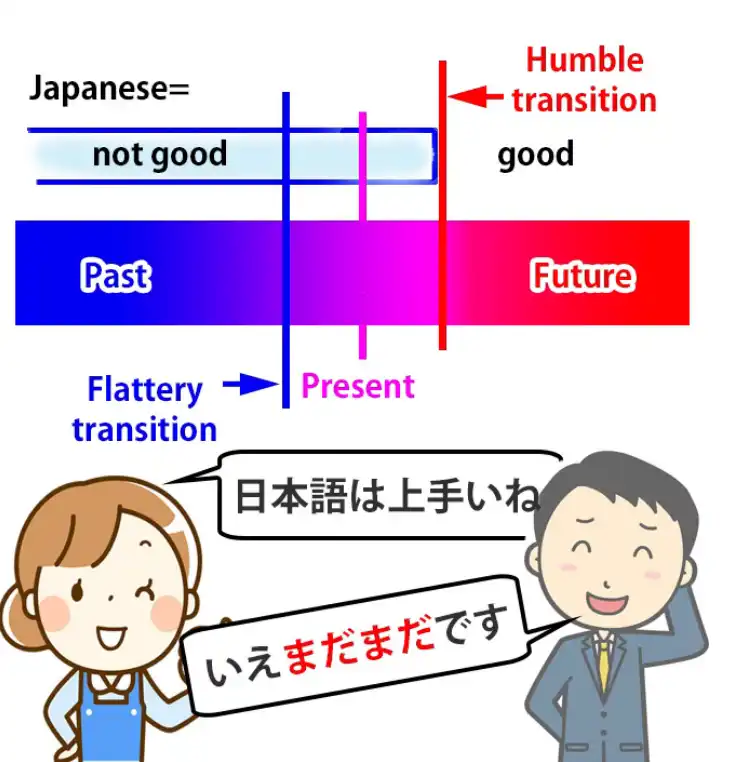
“まだまだ” in this case means “not yet”.
In other words, we’re still in the time period where my Japanese isn’t good.
The change didn’t take place in the past, as you are saying; it will have to take place in the future.
And just a little cultural note: In the West it can sometimes be considered a bit rude to contradict someone who’s said something nice to you, but in Japanese we do that all the time.
It’s considered a bit arrogant not to.
もう
Now, let’s move on to “もう”, where we get a few more apparent complications, but they aren’t really complications, as we’re going to see.
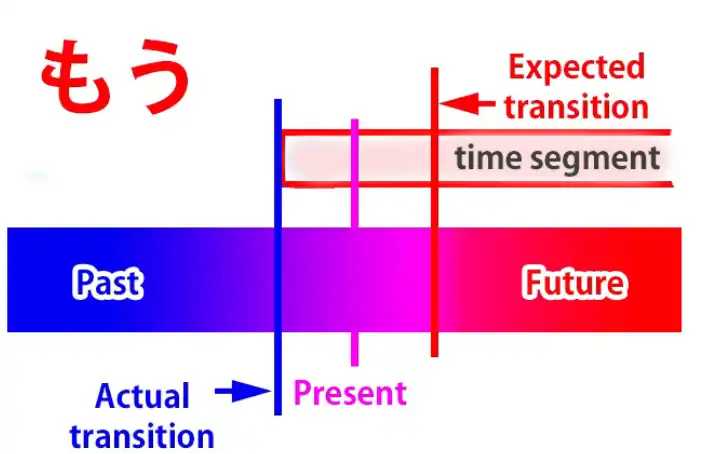
“もう” is essentially the opposite of “まだ”.
The best translation for it in English is that it means “already”.
What it means is that we are now in a time segment stretching forward into the future.
So, just the other way around from “まだ”.
The time segment is compared to the past when the current conditions didn’t prevail and now is compared to the future when the transition might have been expected to happen, but in fact it’s already happened.
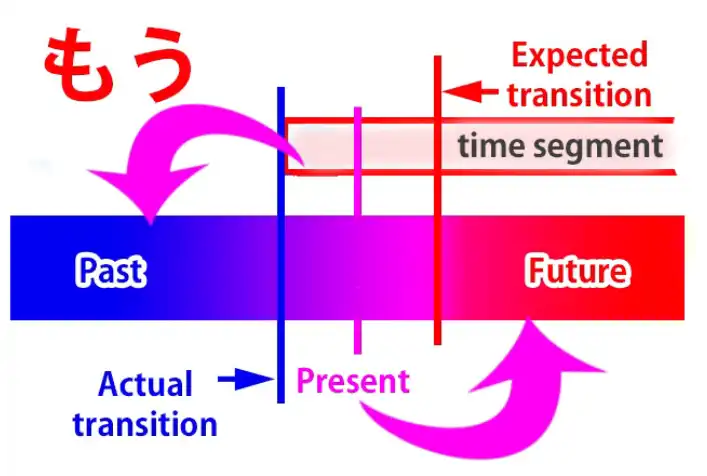
So if someone says “宿題をしなさい。” (“Do your homework!”), you might reply “もうやったよ” (“I already did it”).
So what we’re saying is we are now in the time segment where my homework is done, I’ve done it, and the transition isn’t going to happen in the future, as you might think; It’s already happened in the past.
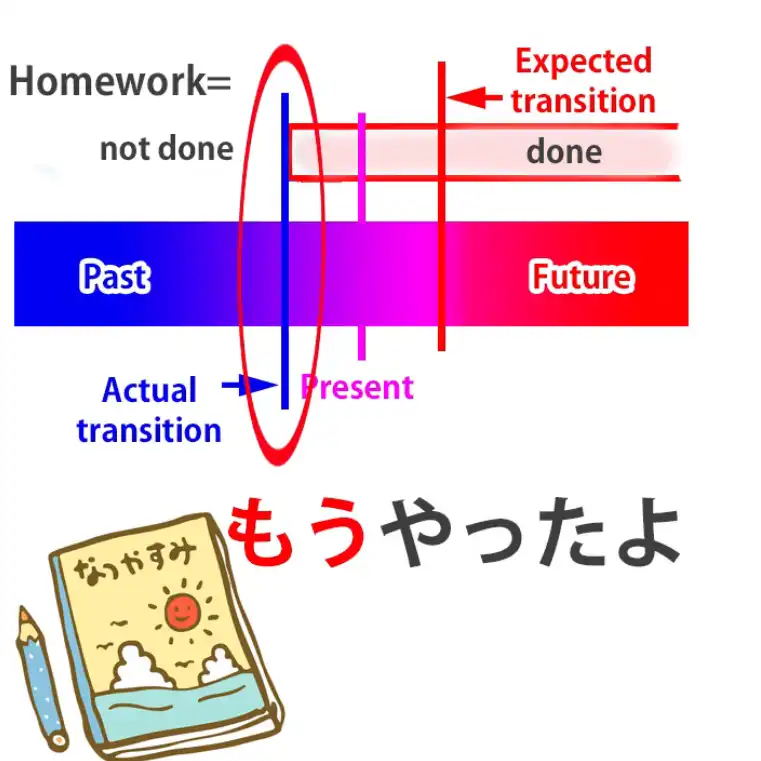
So why is it sometimes translated as having different meanings from “already”, such as “now”?
Well, as we’ve seen, both “まだ” (“still”) and “もう” (“already”) are in fact species of “now”.
We’re talking about now.
We’re just making different contrasts with the past and the future when we talk about now.
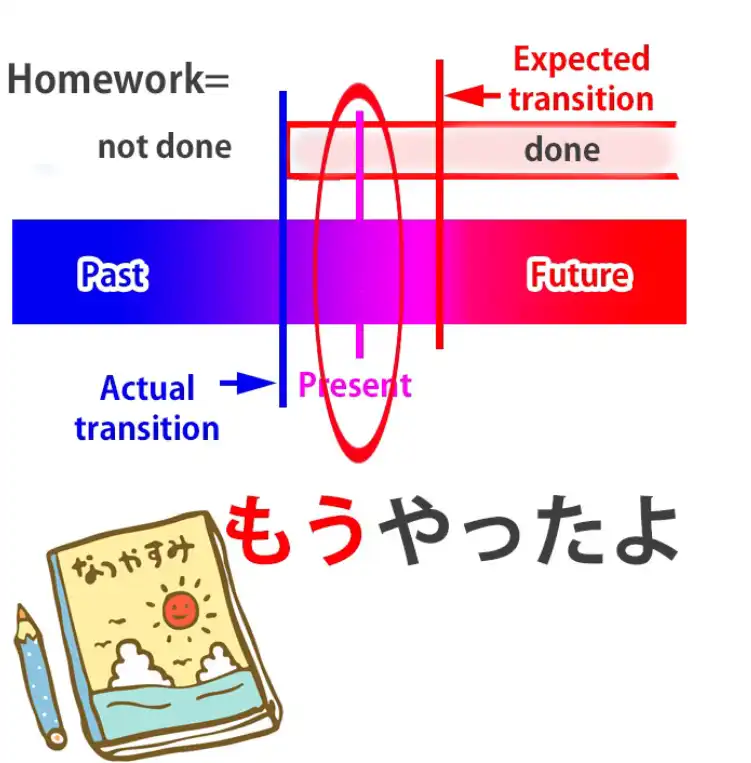
So, of course, “もう” does mean “now”, just as “already” does.
But because words in different languages very rarely occupy exactly the same stretch of the meaning spectrum, sometimes we use “もう” in places where we would use “now” in English.
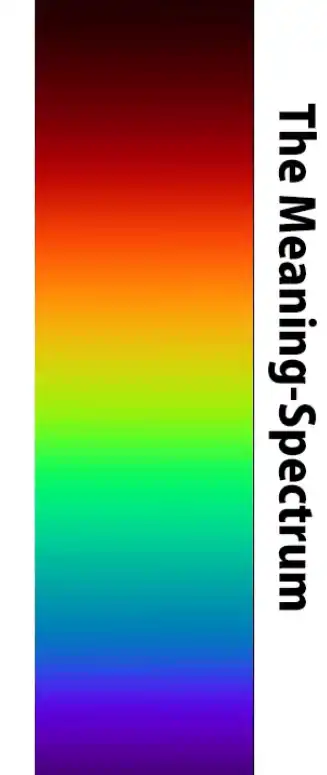
And because J-E dictionaries are Anglocentric they will try to translate “もう” as meaning “now” in those cases.
So, for example, if you’ve hurt yourself and you’re getting up and somebody says “大丈夫?”
and you reply “もう大丈夫”,
how you would translate this into English is usually “I’m all right now”.
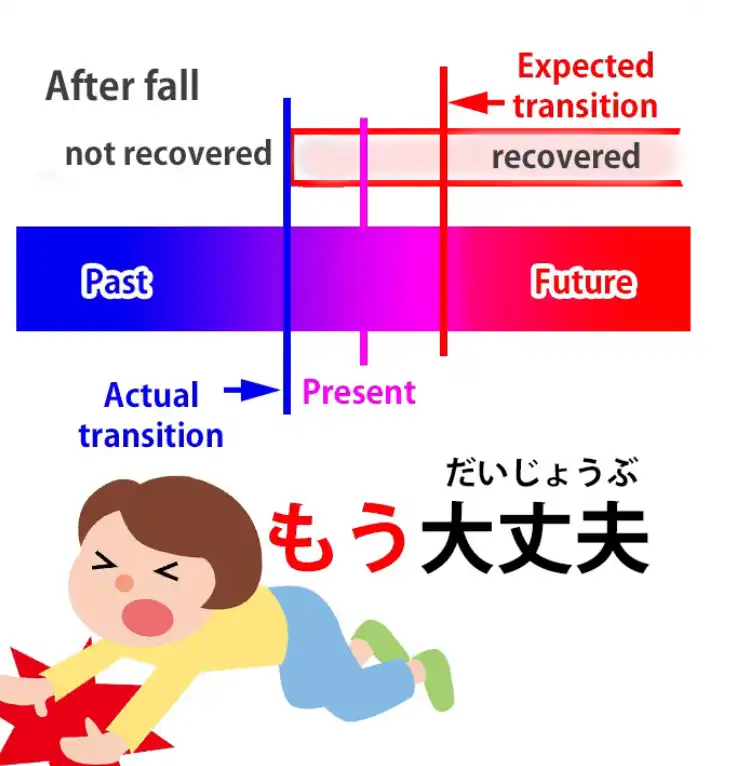
In English you wouldn’t usually say “I’m already all right”.
Now, in Japanese you could also say “今大丈夫”, which also means “I’m all right now”, but when you say “もう大丈夫” you’re specifically adding the nuance that, while you weren’t all right before, you are now, as opposed to at some time in the near future, all right.
In other words, you don’t need any more time to recover, you’re okay.
In English, we don’t use “already” for that.
Logically we could, but in practice we usually don’t.
Now, it’s perfectly true to say that “もう” is also used as an expression of annoyance or exasperation: “もう!”
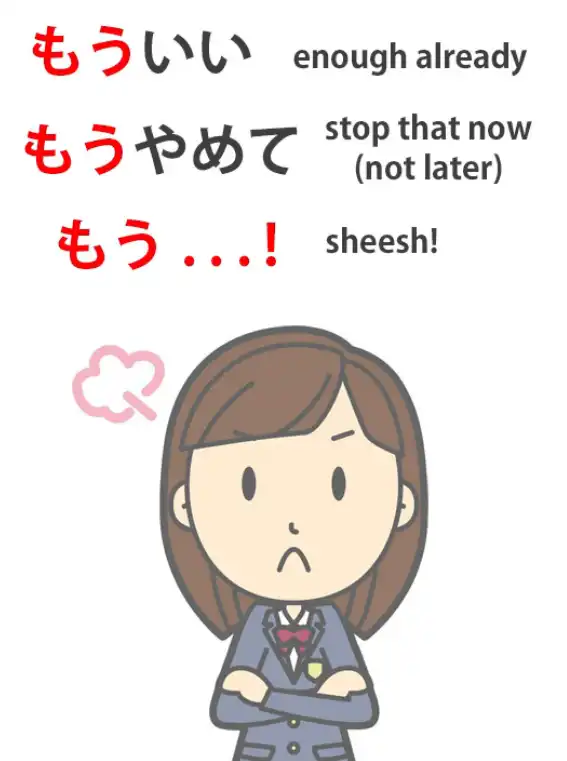
And it compresses all kinds of complaints or grumbles, or it can just be on its own: “もう!” How does that work?
Interestingly, “already” can in some circumstances have a little bit of that kind of nuance in English.
So, if someone says “Enough already!” what they mean is, at this point, as opposed to at some point in the future, I’m fed up with it.
And that’s really what “もう!” tends to mean in Japanese. So that’s really simple enough.
#
Second もう?
However, there is one aspect of “もう” which is a tiny bit confusing until you understand it, and that is that there are really two words “もう”.
Now, this may be a little bit controversial, but in fact in pitch-accent dictionaries they’re actually given two different accentuations, one for the “もう” that we’ve been talking about, the one that means “already”, and one for another “もう”, which is quite close in many respects and I’ll explain why it’s quite close later.
But first of all let’s look at the area where it isn’t so close.
This second “もう”, I think, is ultimately related to the particle “も” and it has the same additive kind of meaning of “another”.
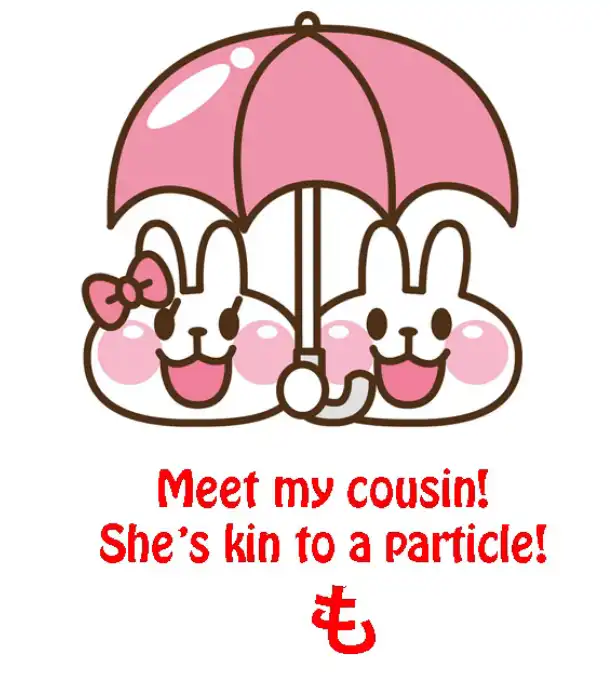
So if we say “もう一つ”, we’re saying “another one”.
If we’re saying “もう一人”, we’re saying “another person”.
So, when we put it like that, we can see we’re really dealing with two separate words, two separate concepts.
Now, it then becomes a little bit more confusing, and I’m going to tell you why.
It even confuses Japanese people, who actually don’t do this pitch accent thing right in many cases, because the idea that they are two different words often gets rather lost even by Japanese natives.
And the reason for that is that there are many cases where they get pretty close.
Why? Well, as we’ve seen, “もう” tells us about a time relation, it’s a time-related word, and it means “already”.
And also the dictionaries tell us that it means “soon”.
Why do they say that it means “soon”?
Well, it doesn’t mean soon on its own, but it means “soon” in certain combinations.
So, for example, if we say “もうすぐ”, which means “soon”, what we’re really saying is: “すぐ” means “soon” and “もう” means “already”, so that “もう” is emphasizing the “soon”: it’s already soon, it’s not going to be soon at some point in the future, it’s soon right now.
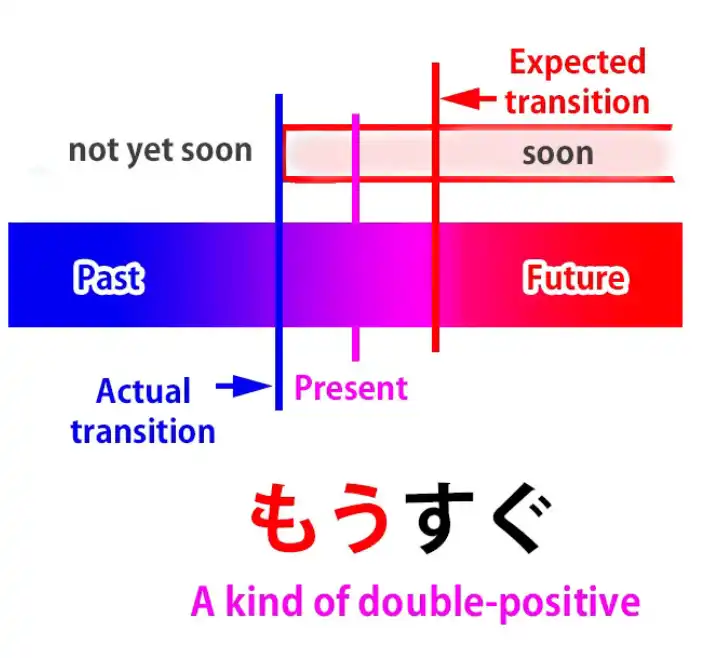
Now, we can also say “もう少し”.
For example, if some people are walking somewhere and they’ve been walking for a long time and they’re getting tired, someone might say “もう少し!” which means “just a little more / just a little extra”.
And it could mean “just a little more effort”, but it can also mean “just a little more time”.
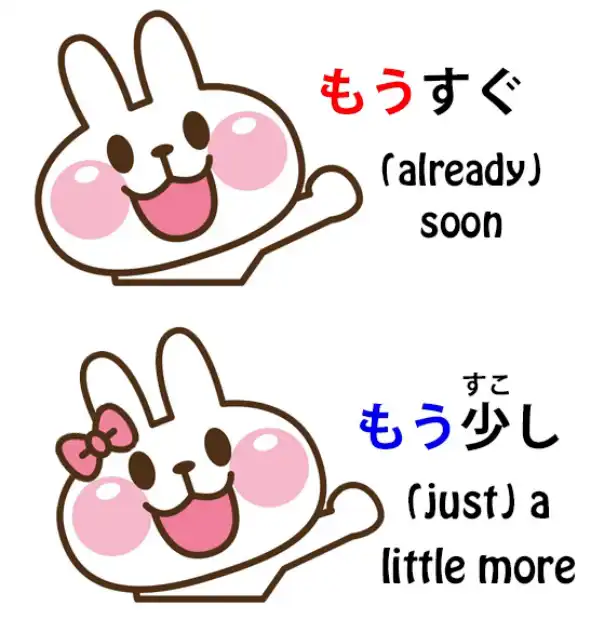
So, you see, “もうすぐ” and “もう少し”, even though they’re different words “もう”, under some circumstances have a very similar meaning.
And the other “もう”, the additive “もう”, also is often used to express time relation.
So if we say “もう一度”, we’re saying “one more time”.
Now obviously this means very much the same as it means when we say “もう一つ”, which means “one more thing” – one more candy, one more anything.
But it also is very often used with “一度”: one more time.
“もう二度来ない” means “I’ll never come again”, literally “I won’t come for another second time”.

So we can see that the two “もう”s tread fairly closely toward the same territory.
They can both be used for time relations and in a few contexts, like “もう少し” and “もうすぐ”, the meaning is almost identical.
But once we understand the two and how they work, I don’t think there’s going to be any more room for confusion…
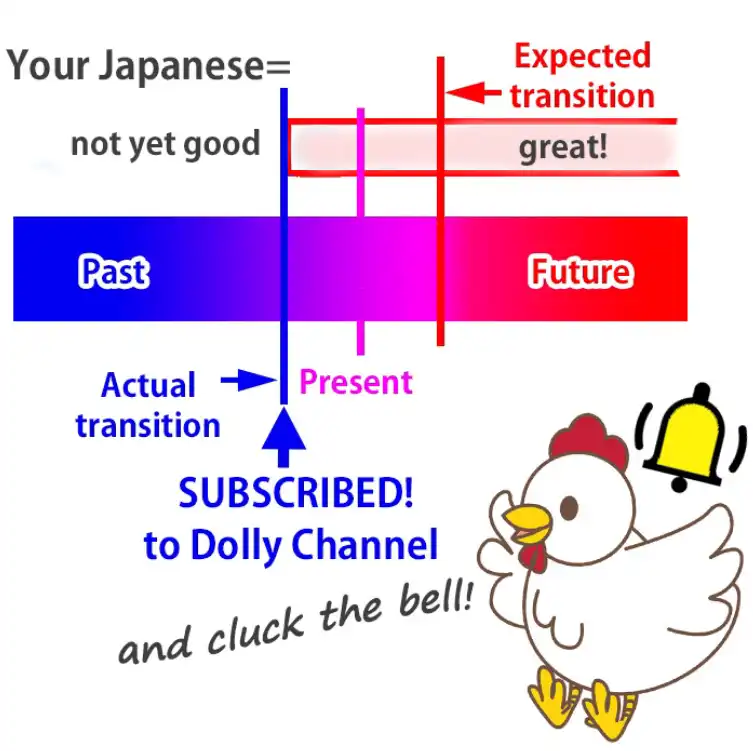
Note: Will add this here:


68. Japanese “underlying logic”: わけ、そういうわけ、わけが分からない、わけない
Japanese “underlying logic”: わけ、そういうわけ、わけが分からない、わけない - Lesson 68
こんにちは。 Today we’re going to talk about “わけ”,
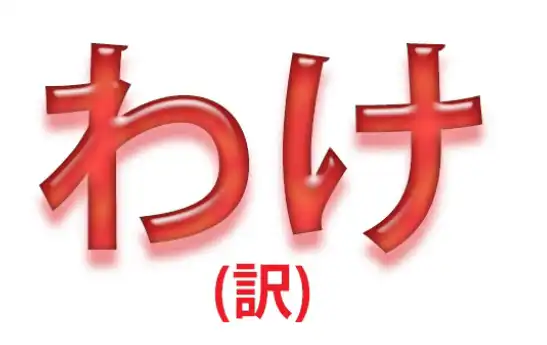
which is a Japanese word that can cause quite a lot of confusion because it’s used in a variety of different ways and situations in Japanese and in English dictionaries it has a whole string of definitions that seem particularly disjointed and confusing.
However, once we understand the real logic, the underlying meaning of the word, it all falls into place rather nicely.
So, what is “わけ”?
わけ/訳
First of all, let’s look at the English dictionary definition.
In the online dictionary it says “わけ” means “conclusion from reasoning; judgement or calculation based on something read or heard; reason; cause; meaning; circumstances; situation”.
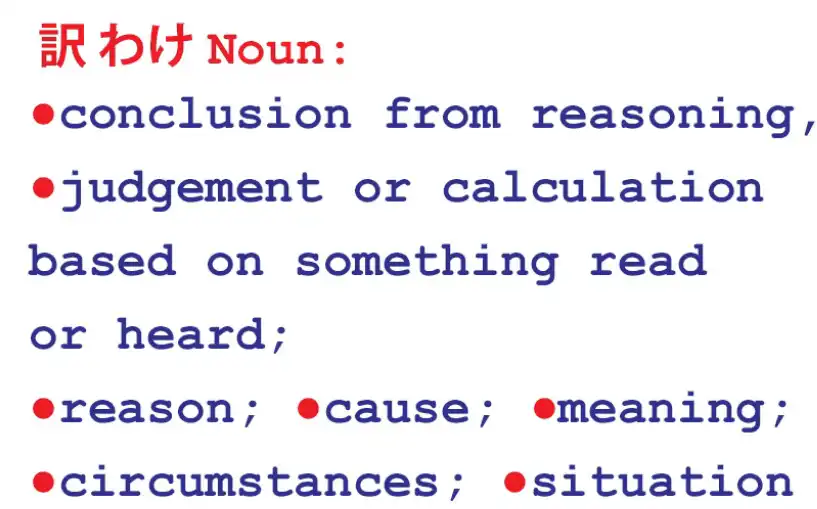
So, what does it actually mean out of all that?
Well, for a nice change the dictionary actually agrees that it’s a noun.
“わけ” is a noun, so what kind of a noun is it?
What is a “わけ”?
Well, let’s look a bit at the history of the word.
Originally, “わけ” meant “divide or separate”.
So it’s connected with “分ける”, which is a verb meaning “divide or separate”, and also, more importantly for our present purposes, “分かる”, which also fundamentally means “divide or separate” but in the sense of “break down, or analyze”.
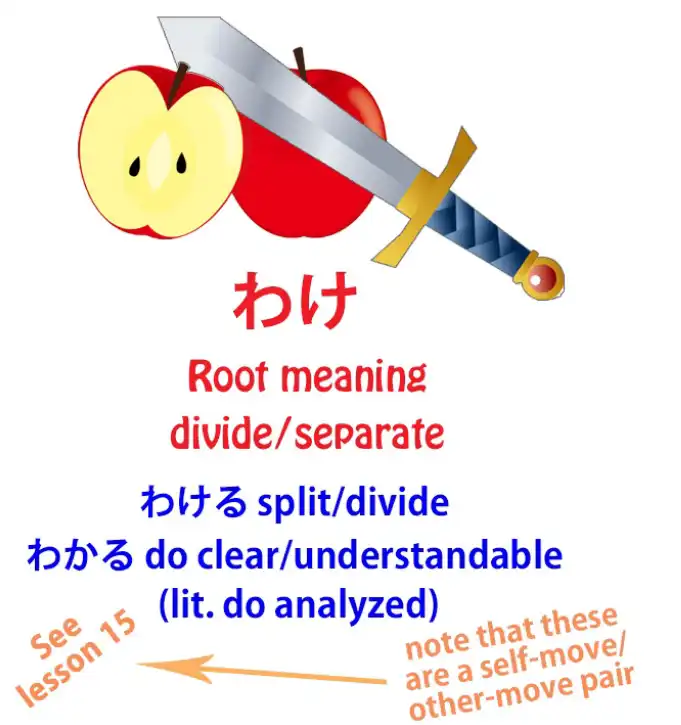
So, when we say “本が分かる”, as I’ve pointed out in previous lessons, we’re not in fact saying “I understand the book”; we’re saying “the book does understandable or does clear”.
We could say in English “The book is clear to me”, but in fact it’s not an adjective, it’s a verb – “the book does clear (to me)”.
But when we say “clear” we are using slightly the wrong metaphor if we want to go into the actual etymology of the word.
“Clear” is a metaphor, obviously, from seeing.
But the real metaphor that underlies “分かる” is being broken down into constituent parts, being analyzed or analyzable. (check Lesson 59)
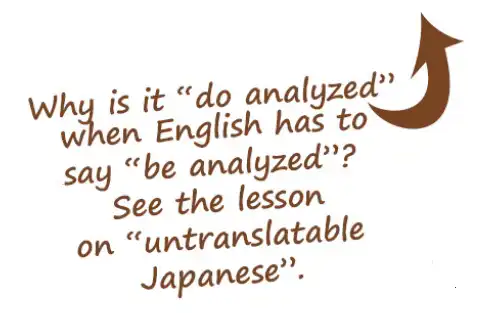
And that’s what “わけ/訳” means here.
Now I know some of you may be thinking “but it’s a different kanji”.
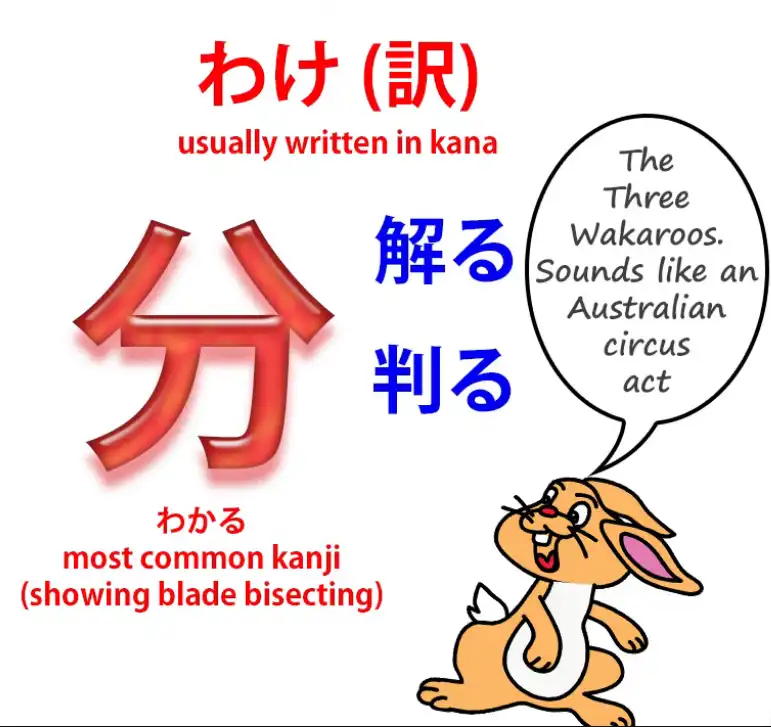
Well, that’s true. We usually associate “分かる” with this kanji, but in fact you can write the word “分かる” with three different possible kanji and they all have slightly different implications – 分かる, 解る, 判る and I’ve written an article (it is a video actually) about that if you’re interested, so I’ll put a link in the information section below (what is linked is a video). The point is that “わけ / 分かる” is not tied to any one kanji.
It’s a fundamental Japanese word that goes back further than the kanji used to represent it, and the fundamental idea in all these cases is the same: the idea of separation, division, analysis, breakdown.
So, what actually is a “わけ/訳”?
Let’s take the most prominent English definitions, which are: cause, reason, and conclusion based on something we’ve seen or heard.
Now, let’s note that cause, reason, and conclusion generally speaking refer to the same thing.
The main difference is whether the process is going backward or whether the process is going forward.
Let’s take an example.
If I say “Sakura was out in the rain, and therefore she’s wet”, we are taking two known facts and stating the causal, the reasoning, connection between the two.
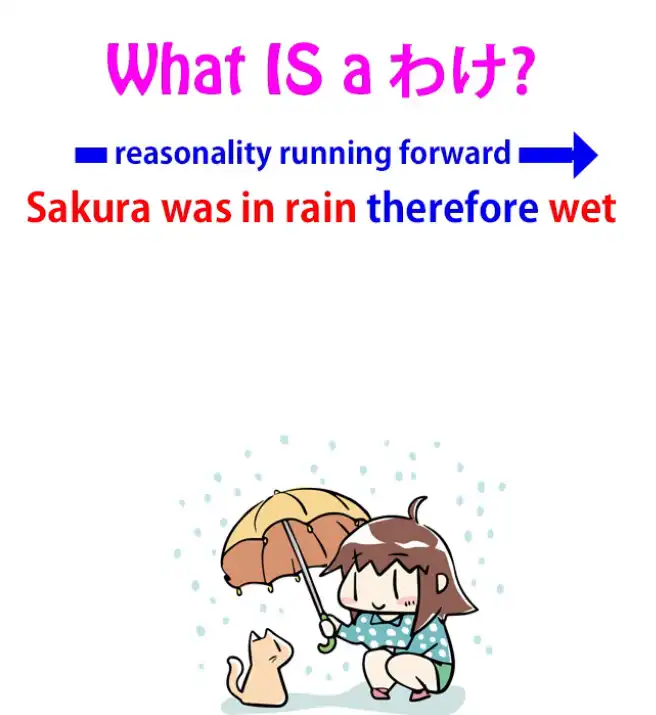
If I say “Sakura is wet and therefore I reason that she was out in the rain”, we’re taking exactly the same piece of reason, the same causality, and working in the other direction.
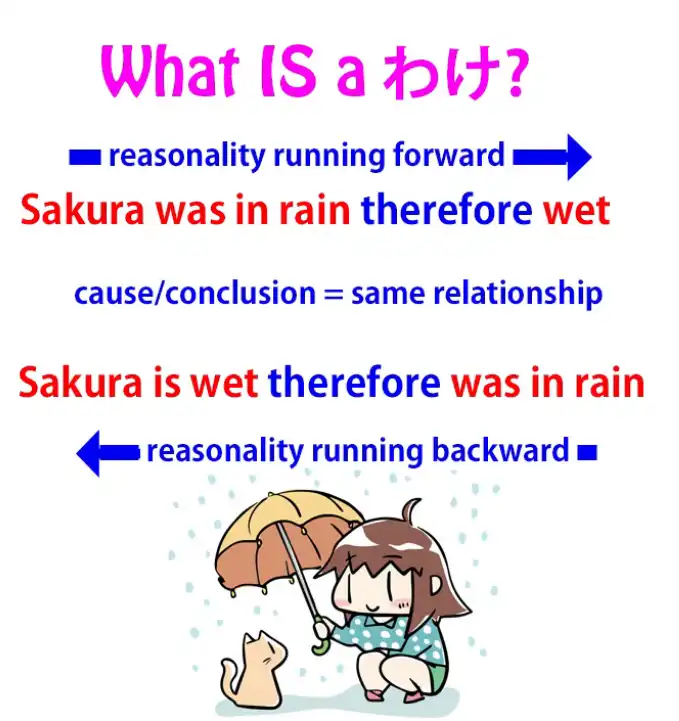
We’re working from one known fact to another unknown fact that we use the reasoning to arrive at.
But that piece of reasoning, that causal link, that fundamental underlying reasonality, is the same in both statements.
In one case we’re working it forward, in the other case we’re working it backward, but that fundamental underlying causal logical reasonality, to coin a phrase, is the same.
And I coined the phrase “reasonality” because there isn’t really a word for this in English.
But in Japanese there is, and the word is “わけ/訳”.
So “わけ”, as we see, expresses a cause, a reason, and a conclusion or a logical judgement – all of those things.
What it really expresses is the underlying causality or reasonality, and when the dictionaries say that it also expresses a circumstance or situation or something like that, in fact it doesn’t really do that, but what it does is express the underlying reasonality of a circumstance or a situation.
And once we understand that, we can start to understand the different ways in which “わけ” is used. So, it’s used to give a reason.
そういうわけ
So, if someone says “そういうわけでベッドの下に隠れた” – By so-said reasonality I hid under the bed “that’s why I was hiding under the bed” – that’s the reason.
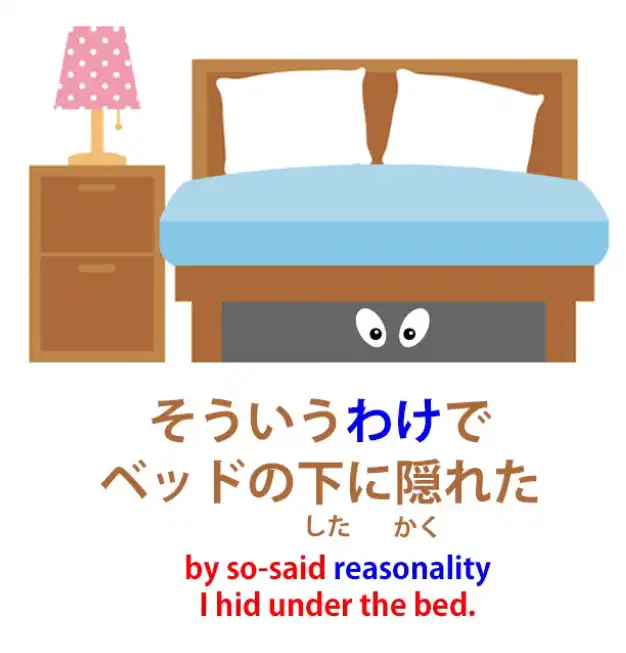
If we find out the solution to what seemed like an impossible crime, we say, “そういうわけでした” – “so that’s how it happened”.

And we’re not actually talking about the fact of the crime, the circumstance of the crime, the situation of the crime; we’re talking about the reasonality that at first seemed completely obscure and now we’ve understood.
And if you notice, in this phrase we say “そういうわけでした”, in the past tense.
It’s not because my reasoning happened in the past.
My reasoning might be happening right now.
But it’s because the underlying reasonality of the event happened at the time of the event, and that’s what we’re talking about.
If we say “そんなわけで宿題を忘れました” – By such a reasonality I forgot my homework
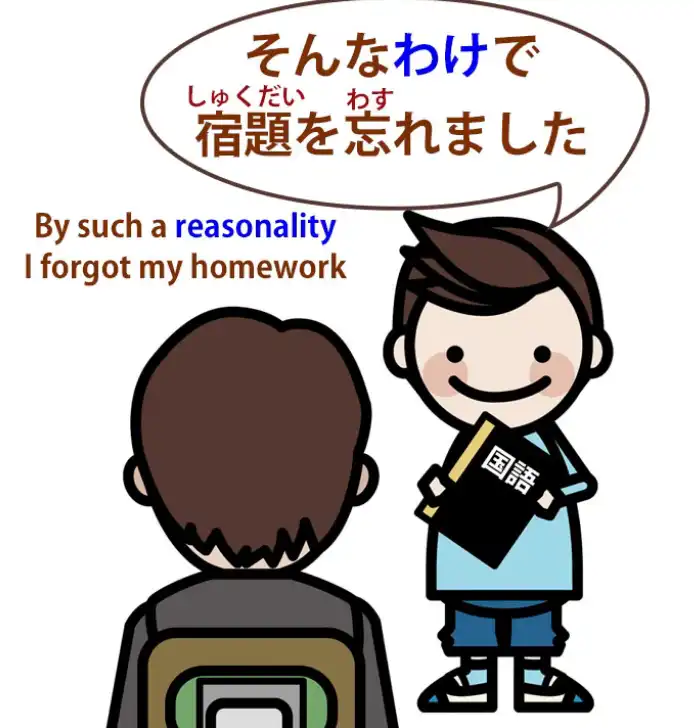
we’re saying “that’s why I forgot my homework”, that’s the reason, the causal link that tells us why it was that I forgot my homework and why you shouldn’t blame me.
わけが分からない / 訳が分からない
Now, “わけ” is used in a lot of negative uses that are very important in Japanese.
One that you’ll commonly hear is “わけが分からない”.
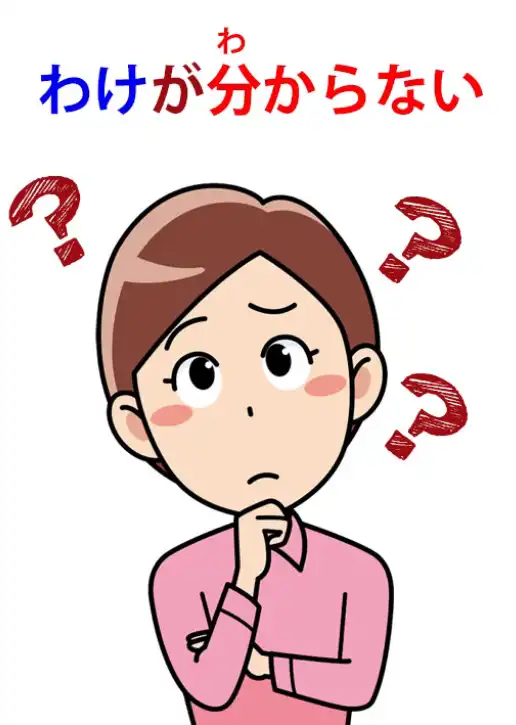
Now, that’s very puzzling if we don’t know what “わけ” means and we also, as is the case if you take the textbooks seriously, don’t know what “分かる” means.
“分かる”, as we know, doesn’t mean “understand”; it means “do clear” or, if we take the most literal sense of the word, “do broken down / do analyzed”.
So what we’re actually saying here is that the reasoning, the underlying reasonality of something “doesn’t do analyzed”.
The way AI entities like myself would tend to put it is “the reasoning behind that does not compute”.
In other words, it’s meaningless, it’s nonsense.
#
わけ as “It’s not as if…” / “It’s not that” / “It doesn’t mean that…”
In other negative uses, “わけ” is often used to mean “it’s not as if… / it’s not that…” or “it doesn’t mean that…” And of course, all those in fact fundamentally break down to the same thing.
We take sentence A and then we’re saying that sentence B conclusion can’t be drawn from it.
So if we say, for example, that she always eats in cheap restaurants and then add “お金が足りないわけではない”, we’re saying “it isn’t that she’s short of money” or “it’s not as if she’s short of money”. / Money-is-insufficient reasonality is-not What we’re saying here is that the conclusion from the fact that she always eats in cheap restaurants isn’t that she’s short of money; she isn’t short of money.
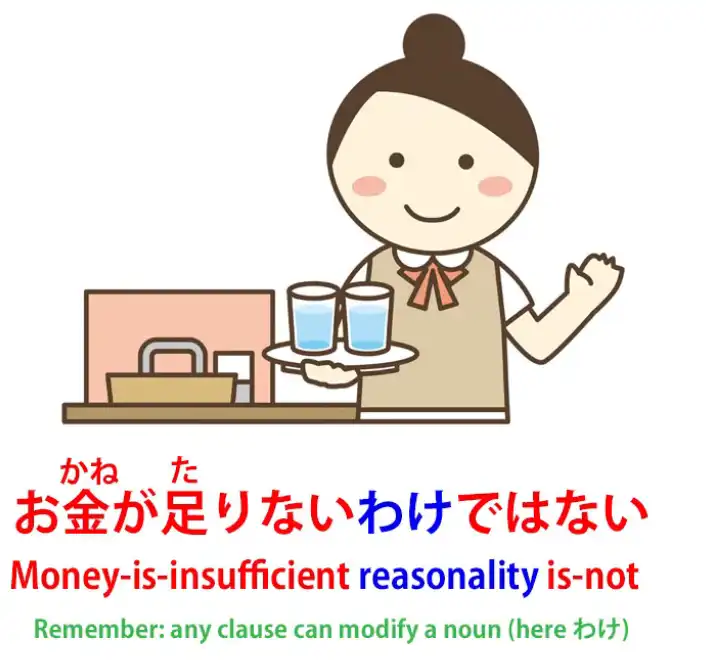
Someone might say, “嫉妬したわけではありません” – “it’s not that I got jealous”.
Again, “don’t draw from my actions or words the conclusion that I got jealous. That’s not what it was”.
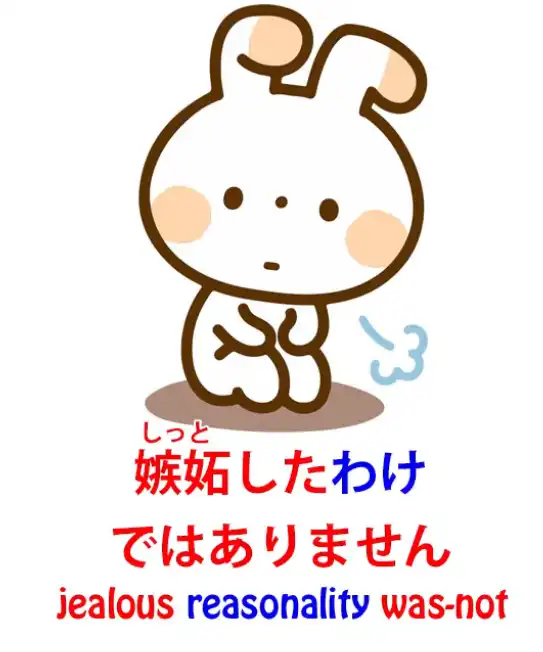
And, essentially, the dictionaries here say that “わけ” means a situation or a circumstance because they take these statements as being denying the situation or the circumstance, but as you see, that’s not exactly what they’re doing.
They’re not denying the situation or the circumstance, they’re denying the underlying reasonality of the situation or the circumstance, and in doing that also implicitly denying the situation or the circumstance, but that isn’t always the case.
For example, we might say “Just because she’s fat doesn’t mean she eats too much” – “食べすぎるわけではない”, the reasonality isn’t that she eats too much.
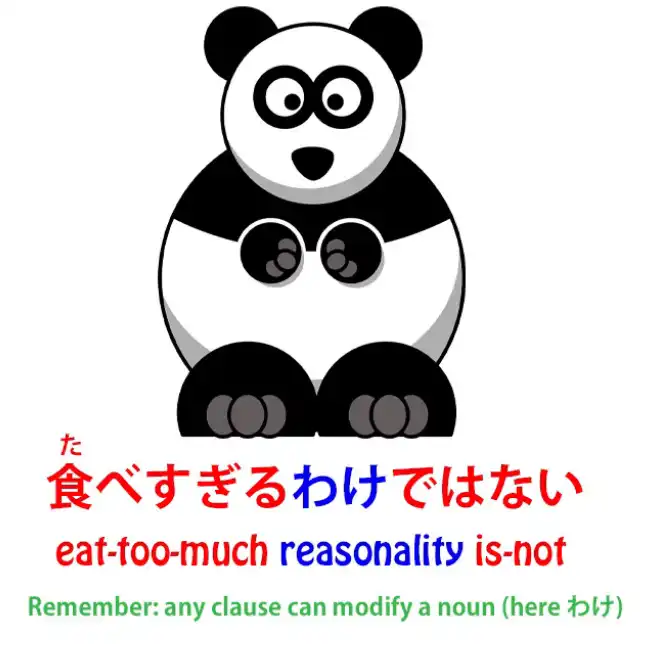
And we may not be saying that she doesn’t eat too much.
We’re just saying that the fact that she’s fat doesn’t necessarily mean that she eats too much, that’s not good reasoning.
We don’t know whether that’s true or not, but from the fact that she’s fat we can’t say that.
So, what we’re doing in all these cases is denying a certain rational connection.
We’re saying that that rational connection doesn’t exist.
Whether the fact that it implies exists or not isn’t really what we’re talking about here.
In some cases we’re implying that it doesn’t, in some cases we may not be implying anything either way.
But the important thing that we’re denying is the underlying reasonality, the logical link that might be made in these cases.
わけない / 訳ない (訳がない)
Now, another common negative use is “わけがない”, sometimes shortened to just “わけない”.
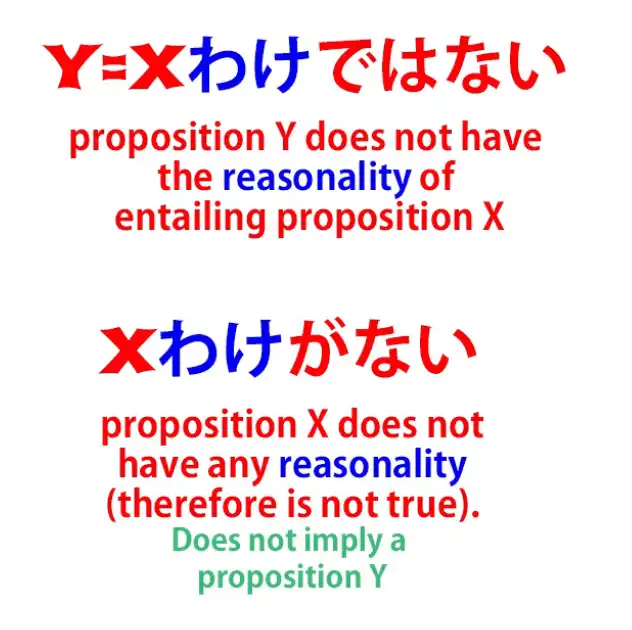
This tends to be strongly denying that something exists at all.
Again one might think one is denying the situation or the circumstance, but what one is denying is the rationality of it.
Now, how do we tell this from the uses that we saw before?
Well, let’s notice the structural difference.
One is “x わけではない”, that’s to say that the circumstance we’ve talked about or are referring to doesn’t have that reasoning.
This is the simple difference between “ではない” and “がない” that we talked about way back in our lesson on negatives. (possibly Lesson 7) So, in these cases where we’re saying “it doesn’t mean that… / it’s not that… / it’s not as if…” etc, in other words “that reasoning doesn’t apply”, here we’re saying that no reasoning exists.
“わけがない”: “there is no reasoning”.
And therefore, since there is no reasoning, since it doesn’t compute, it can’t be the case.
So, for example, “さくらはウソをつくわけがない” – Sakura-tell-a-lie reasonality is non-existent “Sakura wouldn’t tell a lie” – there’s no way she’d tell a lie.
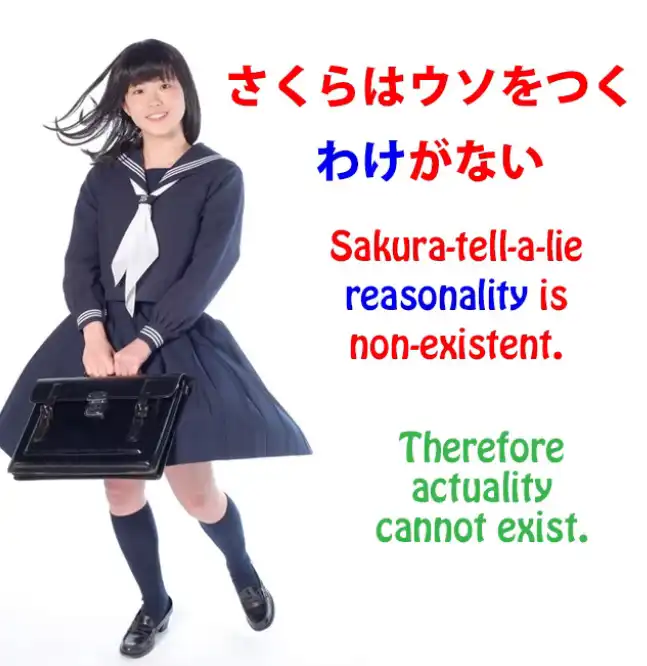
The underlying logic or reasonality of Sakura telling a lie doesn’t exist, therefore it’s not possible that she would tell a lie.
Again, “さくらを忘れるわけがない” – “I won’t forget Sakura” or “I won’t forget you, Sakura”.
What we’re saying here really is that the underlying reasonality of forgetting Sakura doesn’t exist.
There is no reasonality, it doesn’t compute, therefore it can’t happen.
#
わけがない as “there is no reason”
Now, there is another possible meaning for “わけがない” and that is in a more direct and literal sense saying simply “There’s no reason”.
It’s not to say it’s not happening or it doesn’t exist, but there’s no reason for it.
So, for example, “そんなにお金の要るわけがない”
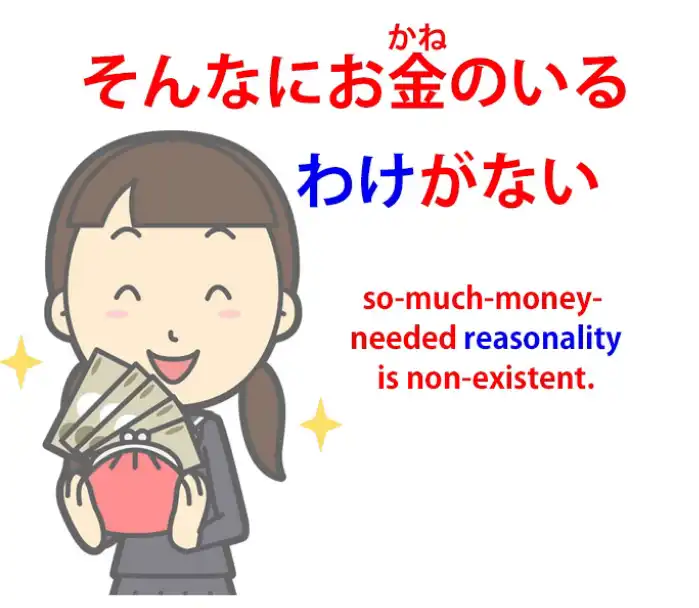
“there’s no reason she would need that much money”
Note: since this いる, as per what Dolly says means “need”, I put 要る in its Kanji form to reflect it, rather than just regular “to be” 居る/いる.
*Also, this…just in case…
*

She might be asking for it, she might get it, but there’s really no reason why she would need it.
How do we know the difference between these two?
Well, this is a matter of context, and I’ve done a video on how we deal with this kind of thing.
We actually do it in English all the time.
Lots of statements have more than one possible interpretation and most of the time we’re not aware of it because we are so used to using the context to determine which of a possible range of meanings is to be applied in a given case.
We’re not conscious of this process so we really need to understand it in order to apply it in Japanese or any other language.
So take a look at that video if you haven’t seen it already (Lesson 48).
#
わけがない as “simple, easy”
And that might be particularly useful, because there is a third use of this negative “わけがない”, often reduced to just “わけない”, which is to say that something is simple or easy.
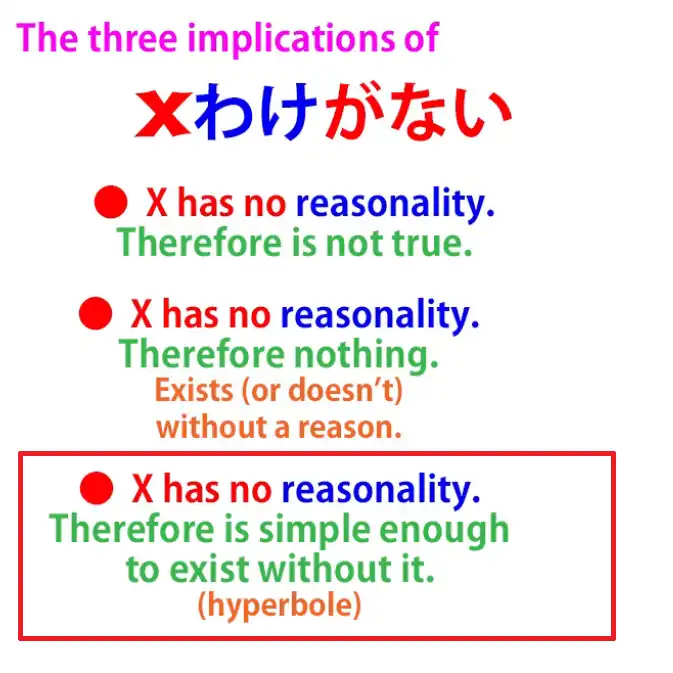
“日本語を話すのはわけがないことだ” – “Speaking Japanese is easy, no problem.” Why do we say “わけがない” here?
What we’re saying is that there’s really no reasoning needed.
It can be compared to the English expression “no-brainer”.
You might think that meant that something was stupid, but what it actually means is that something is so easy or so obvious that it doesn’t take any brainwork to arrive at it.
And this is the use of “わけない” here.
“It’s a no-brainer. Talking Japanese is just simple.
A cakewalk. Easy-peasy lemon-squeezy.” And again, there’s not much chance of misunderstanding or confusing the different uses provided you understand the basic rules of disambiguation.
And provided that most of the time you’re doing it in context, in real Japanese immersion, and not in chopped-off bleeding sample sentences.
So don’t forget: structure is the key to immersion but immersion is the key to Japanese.
69. Japanese in the Wild! Tackling native Japanese material. 怪談 4
Japanese in the Wild! Tackling native Japanese material. Kaidan 4 - Lesson 69
こんにちは。 Today we’re going to go back to the 怪談/かいだん, the scary Japanese story that we started a few episodes ago, so that we can tackle some more of the challenges of reading real native Japanese.
I’ve gathered all these episodes together in one playlist, so you can look at the whole 怪談 in one place, and I’m putting that in a link just above my head right here.
Now, to recap the story so far, our heroine went to a drinking party at her Senpai’s apartment and, walking home late at night, she discovered that she’d left her 携帯 (her portable telephone) in Senpai’s apartment.
So, she went back, knocked on the door, and there was no answer.
She tried the handle and the door was unlocked, so she walked in.
And it was completely dark in there, so she assumed that Senpai had gone to bed already.
She thought of putting the lights on and waking her, but remembering that she’d been pretty drunk at the time when she left she decided not to.
She groped around in the dark to find her 携帯 and then left. And that’s the story so far.
So let’s see what happened the next day.
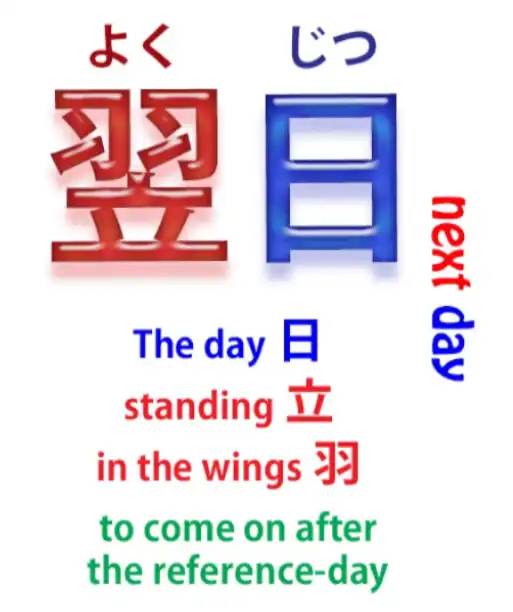
“翌日” – that means “next day”.
This word “翌” – as you see, the kanji is feathers or wings and the kanji for stand.
So we could say that it was the day standing in the wings waiting to come on stage,
which it now has.
“翌日” – The next day – “彼女は先輩のアパートの前を通りかかると…”
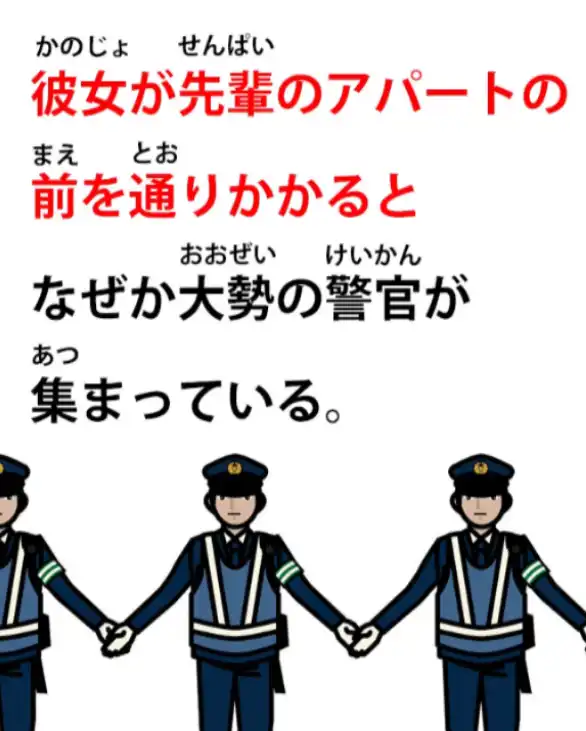
So we have the first logical clause here and we have a “と” which is the if/when conditional.
So something’s going to follow it, but let’s just look at this first one: “通りかかる” means literally “pass hang”, but what it means, what the Japanese dictionaries say is that it means “ちょうどその場所に通る”, which means really “just happened to be passing that particular place”.
So she didn’t go there for any purpose, she just happened to be passing by.
“なぜか大勢の警官が集まっている” –
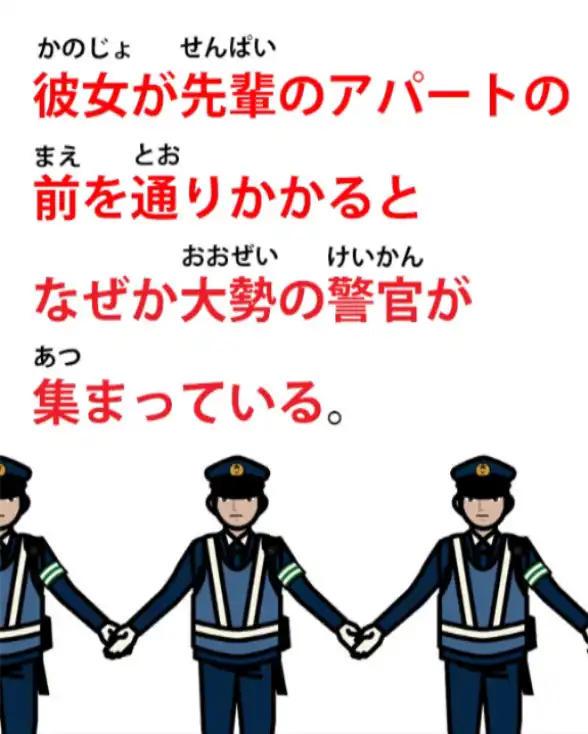
“大勢” means a large number, a crowd – it refers to people – “警官”, as I’m sure you know, is a policeman.
So, “なぜか…” (“なぜか” – “for some reason”) a lot of policeman were gathered – “集まっている”.
“集まる” is “gather”; “集まっている” – “exist in a state of being gathered”.
A lot of policemen were gathered.
“事情を聞いて彼女は驚いた”
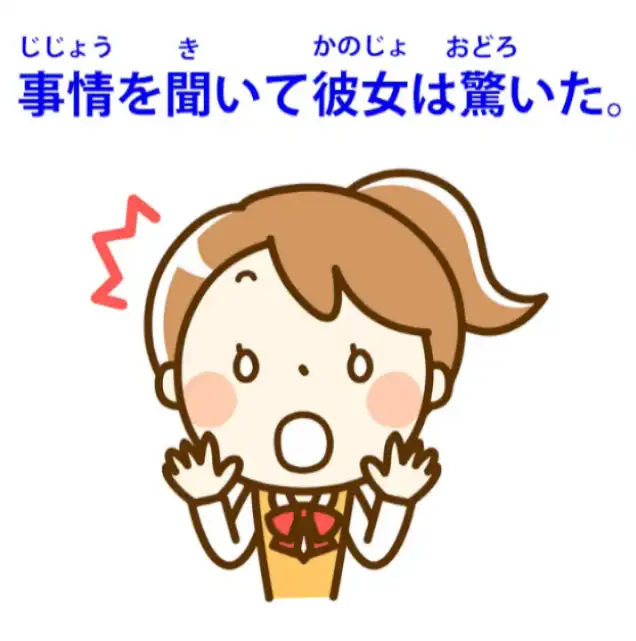
“事情” is “the situation or circumstances”.
In English we’d probably say “She asked what was going on”.
And “驚いた” usually gets translated as “be surprised” but it can be stronger than that, and we can see that it’s stronger than that in this case.
When she asked the situation, she was startled or shocked.
And the “彼女は” here also throws emphasis onto that “驚いた”, and we’re going to talk about that in a video in the near future, this emphasizing quality of は (video unknown).
When she asked the situation, she was startled or shocked by what she heard.
“なんと… — “What! / What’s this?” “なんとあの先輩が部屋で殺されたというのだ” – “That senpai, in that apartment, received the action of being killed.”
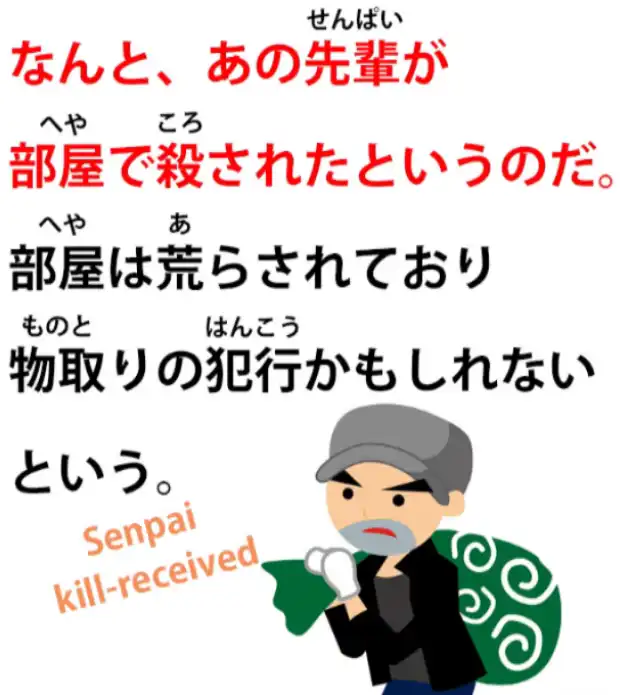
And this is the receptive, isn’t it?
She received the action “being killed”.
“というのだ” : “という” – that’s what she was told, that’s what was said; “のだ” – now, we’ve talked about these “んだ / のだ” endings in another video.
So this is really saying, “It was that senpai had, in that room, received the action of being killed.” That’s what it was; that was what was going on.
When she asked about the situation, it was that the senpai had been killed in that room.
“部屋は荒らされており”

“荒らす” is “storm or violate or mess up”.
So, the room received the action of being messed up or violated.
And the helper receptive verb is in て-form and followed by “おり”.
Now, “居る / おる” – as we talked about in a previous episode in this series, “居る / おる” is a literary, slightly old-fashioned way of saying “居る / いる”.
So “荒らされておる” is the same as “荒らされている”: “was in a state of having received being violated or messed up”.
And then that “おる” is put into its い-stem, “おり”, which again, as we discussed before, is a slightly more literary way of joining two clauses in a compound sentence.
So this joins this clause to the next clause, which gives a conjecture about the situation:
“The room was in a state of having received being messed up or violated, and…”
“物取りの犯行かもしれないという” :
“物取り” is “もの/物” (thing) + “取る” (take),
so “物取る” – “take thing”;
“物取り” – the noun of taking things, so “物取り” here is “theft”;
“犯行” is a “criminal act”, a “criminal going”, literally, but a criminal act.
So this was perhaps or probably a crime of theft, a burglary…
“という” – “was said”. And who said it?
Well, presumably the police.
Now, the next part comes in quotation marks, those square Japanese quotation marks, and this is something she’s thinking to herself.
And we’re going to see there are a number of clauses joined together here, and then they’ll all end with -たら before we pass on to the comment about them.
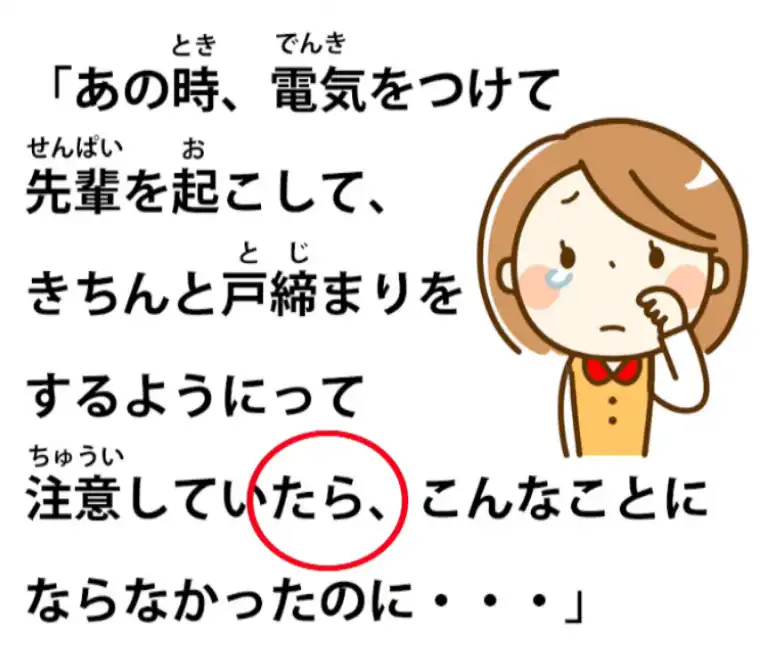
So all these clauses that culminate in the -たら ending are if-statements, conditional if-statements.
We’ve talked about the conditional -たら, haven’t we? (Lesson 32, but also check 30 & 31) So, “あの時” – “at that time” – 「電気を付けて先輩を起こして」 – “if I had put on the light” –
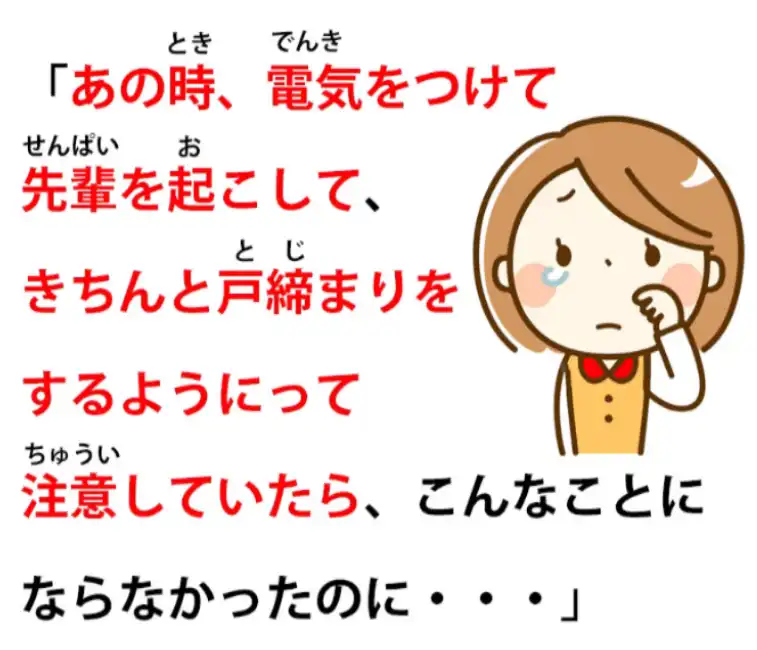
“きちんと/ちゃんと戸締りをするようにって”.
Now, “ちゃんと” means “properly or correctly”;
Note: In the video/picture, Dolly instead gives きちんと instead of ちゃんと.
But in basic terms, they seem to mean the same thing - along the lines of “properly”, so it should not be a big deal. There probably is some difference, but should not be detrimental here…
“戸締り” – “戸” is “door”, “締まる” is “closing”,
so “戸締り” is “door-closing”.
And then “をする”: you could just say “戸締りをする” – “do closing the door” – but here it’s saying “戸締りをするようにって注意をしたら”.
“ように” in this case means “making (something) become like (something)”.
So what it’s really saying is “made it so that the door was properly closed”.
And then that “って” is a shortening of “という” (we’ve talked about that). - Lesson 18 So “という” meaning in this case “that kind of”; “注意をして” – “注意” is “care or caution” – you often see signs in Japan “注意をしてください” – “take care please / act cautiously”.
If she had in this way acted cautiously by turning on the lights, waking Senpai, making sure that the door was properly closed – and then this all ends with the -たら.
If she’d done this…
“こんなことにならなかったのに”
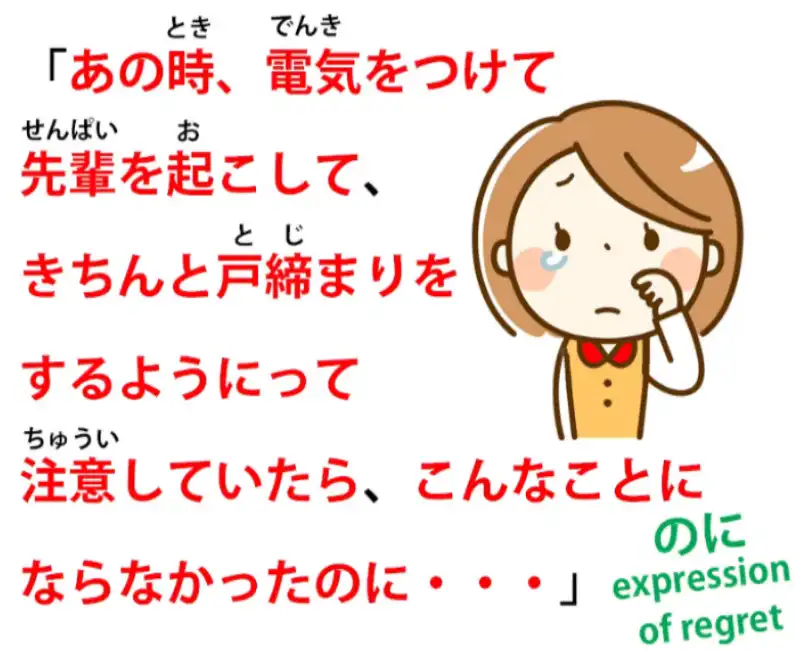
Now, “こんなこと” is “a state of affairs like this / this state of affairs” ; “にならなかったのに” : now, as we see, this is a logical clause and it needs a subject, it needs a が-marked A-car.
So what is it? Well, it’s a zero car, isn’t it?
“(Zeroが) こんなことにならなかった” – “It would not have become a thing like this.” Now, what does that mean?
I think we can see a very close English analogy to this.
In English we would probably say, “it wouldn’t have come to this.” What she’s saying is, “it wouldn’t have become this kind of situation.” So it’s very much the same kind of expression strategy.
If she’d done all those things: if she’d made sure everything was safe and proper in the house, even at the risk of disturbing a drunken senpai, this terrible thing wouldn’t have happened.
— “彼女が自責の念でいっぱいになりながら.”
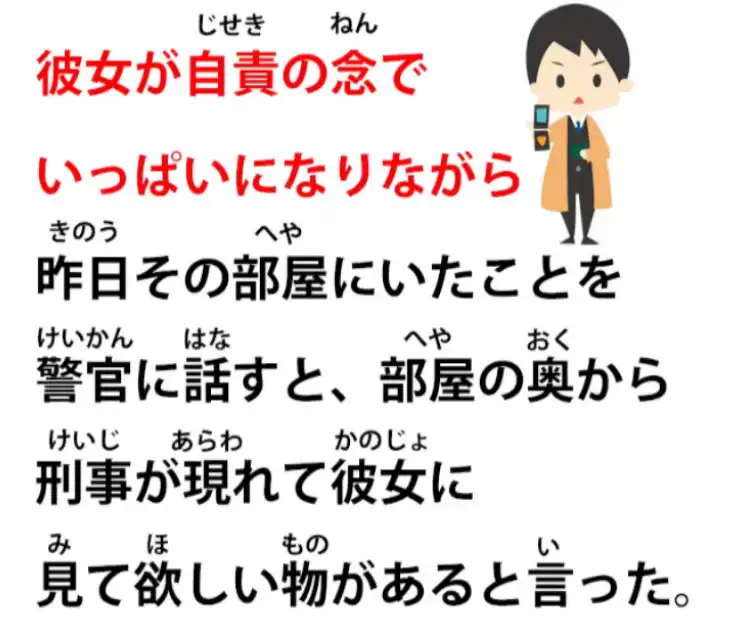
“自責” is “self-blame / self-reproach” – “責” here, this kanji is the same as the kanji for “責める” – “criticize or blame” – and the “ji” is “self”, so “自責… でいっぱいなりながら” – “-ながら”, as I think we know, is a helper word, meaning doing the verb it’s attached to while doing something else.
Now, what she’s doing here is becoming full of “自責の念” – “thoughts (or feelings) of self blame”.
So, while becoming full of feelings of self-blame, “昨日その部屋にいたことを警官に話すと” –
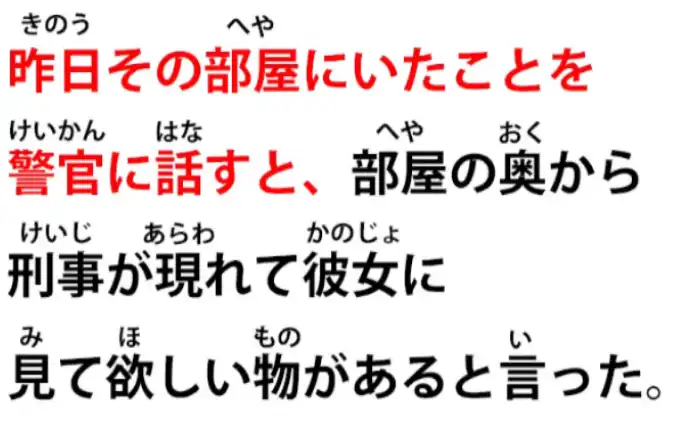
Now, “と” is giving us an if/when statement, but we’ll just deal with this to start with.
“昨日その部屋にいたこと” means “the fact that she was in the room yesterday”.
Now, we know she’s talking about a person (or an animal) here because it’s “いた”, so the only thing it can be is herself, the fact that she was in the room.
Had it been “昨日その部屋にあったこと”, it might be saying “the thing that took place in the room yesterday”.
Well, we know it can’t be that because it’s “いた” not “あった”.
So, we’re talking about a person; we’re talking about her.
“昨日その部屋にいたことを警官に話す” and then “と”, which is our if/when statement.
So, when she told the police the fact that she’d been in the room yesterday…
“部屋の奥から刑事が現れて…”

Now again, it’s ending in the て-form; it’s going to lead on to something else.
So it’s a complex sentence, but it’s not really difficult because it’s made up of clear logical clauses building one on another into a larger whole.
So, “部屋の奥から刑事が現れて”: from the interior of the room, from inside the room – “奥”, “the inside /the interior” – “刑事”, that’s a police detective, “現れて” – “appeared”.
A police detective appeared from inside the room, and…
“彼女に見て欲しい物があると言った”

Now, “見て欲しい” means “want someone else to see” just as, as we explained in a previous lesson (Lesson 49), “見てもらう” means “have someone else see”, “見て欲しい” means “want someone else to see”.
And just as with “もらう”, the person who you have doing the seeing or want to do the seeing (or want to do anything else) is marked with に as the target of a pull-sentence.
So, “もらう” and “欲しい”, they are receiving pull-type sentences, so their indirect object is the person doing the thing that we want them to do, that we receive them doing etc.
So, it’s saying “彼女に見て欲しい物がある” – “a want-her-to-see thing exists”.
“There’s something I want you to look at” is how we’d put it in English.
“と言った” – the detective said, there’s something I want you to look at.
And in quotes these are the words of the detective: “「部屋の中で” – “inside the room” – “こんなメモを見つけたんですが… – “this kind of memo (or really, this memo) we found, but –
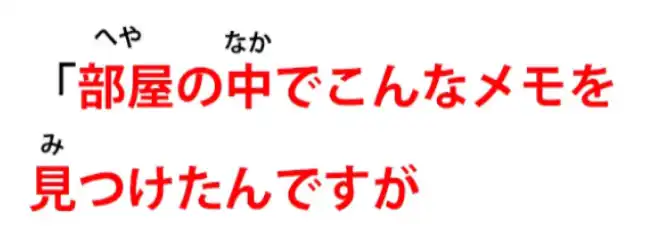
“見つけた”, “found/discovered/saw” – we discovered this memo – “んですが”.
“んですが” – once again we have this “んです / のです” ending.
So what he’s saying, “It is that we found this memo in the room”.
That’s what it is / this is the thing: “It is that we found this memo in the room, but/が…” – “これの意味が分からなくて…”
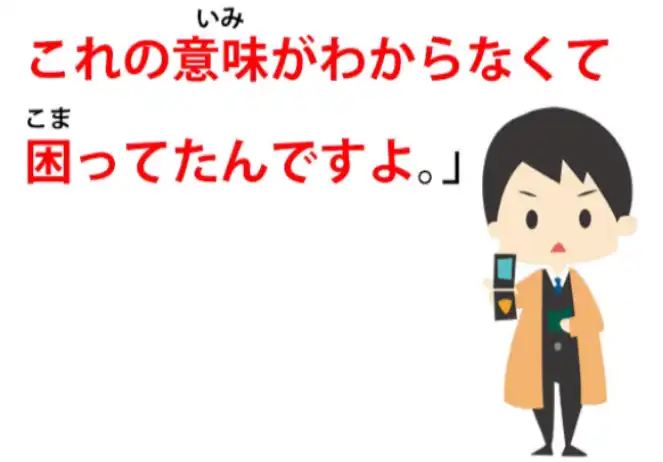
Once again we’re leading into something else.
“Its meaning does not do understandable, and…
“困ってんですよ」” – “困る” is “be at a loss / not know what to do” so “because its meaning does not do understandable…” because we can’t understand its meaning, as we say in English, “…we’re at a loss”.
And again that “んです” ending: “It is that because we can’t understand its meaning, we’re at a loss.”

Note: The sentence may be a bit harder to read, but I cannot zoom-in more, else for some reason it will then permanently hide the end portion of the comment with “…” instead of the text.. “彼女はそのメモを見て青ざめた” She looked at the memo and… “青ざめる”.
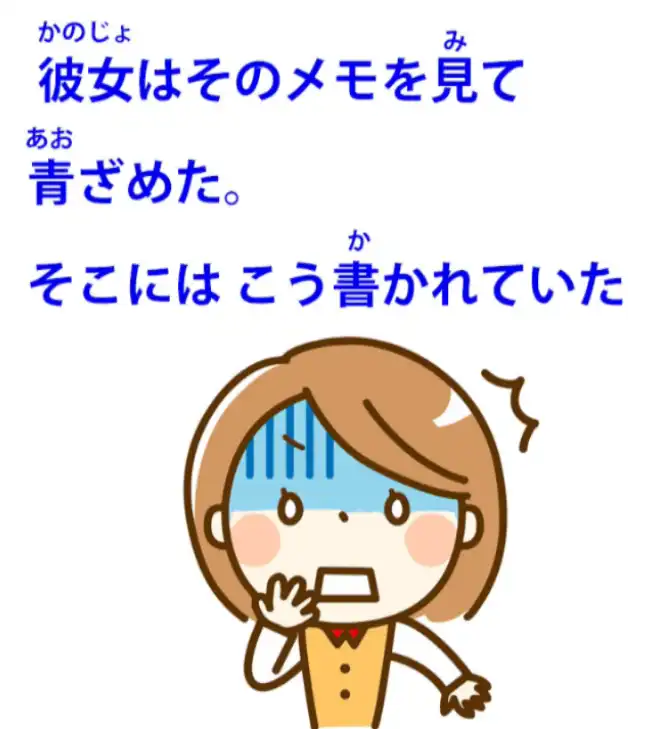
In English that usually gets translated as “turned pale”.
What it literally means is: “青” is of course “blue” and the “ざめる” here means to “fade or lose color”.
So she faded to blue, is what it’s literally saying.
And you’ve probably seen in anime and manga etc. that this is in fact how they tend to represent this situation.
You often see people’s face shaded blue, usually from the forehead down to about the middle of the face.
so turning blue is the way they represent what in English we call “turning pale”, and we see it when someone is shocked or sick or something like that.
So, her face turned pale.
“そこにはこう書かれていた” – “In that place”, that’s to say, on that piece of paper, “it had received being written this way / it was in a state of having received being written this way”.
In English we’d just say “this is what was written”.
And what was written?
“電気をつけなくてよかったな” : “It’s a good thing you didn’t turn the lights on.”
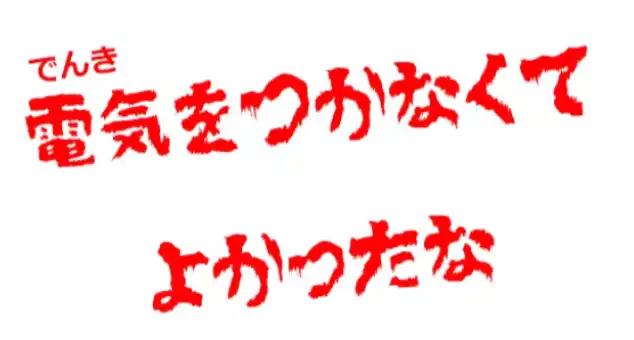
So what do you make of that?
Who wrote that memo?
And what did he or she mean by it?
What went on in the room that night?
70. かける / かかる All-purpose Japanese Explained!
かける / かかる All-purpose Japanese Explained! Means everything = means nothing? Or real logic? Lesson 70
こんにちは。 Today we’re going to talk about the words “かかる” and “かける”, which have perhaps the longest and most heterogeneous list of definitions in the whole Japanese-English dictionary.
And so it’s a bit of a challenge, but we’re going to defeat it.
The impetus for this video came from a question from one of my Gold Kokeshi patrons – and one of my very oldest Gold Kokeshi patrons, right from nearly the beginning of this series.
This is Scykoh-sama, who is also another YouTuber and a much more popular YouTuber than I am – and deservedly so.
He has a wonderful Nintendo-focused channel and I’ll link that in the information section below.
And as a unit who’s been a Nintendo fan since I was a cogwheel, I really appreciate that.
(That’s just a joke – I never really was a cogwheel.) So the question is: “I often hear the word “かける” and when I look it up in a J-E dictionary, there are over twenty different definitions of it.
Is there any logic that ties all these definitions together?
Or is it really just a word with a ton of different meanings?” Well yes, there is a logic that ties it all together, but that logic has a number of metaphorical extensions, so we’ll take a look at it and see how it all works.
The base meaning of this word could be translated into English as “hang” or possibly “hook”,
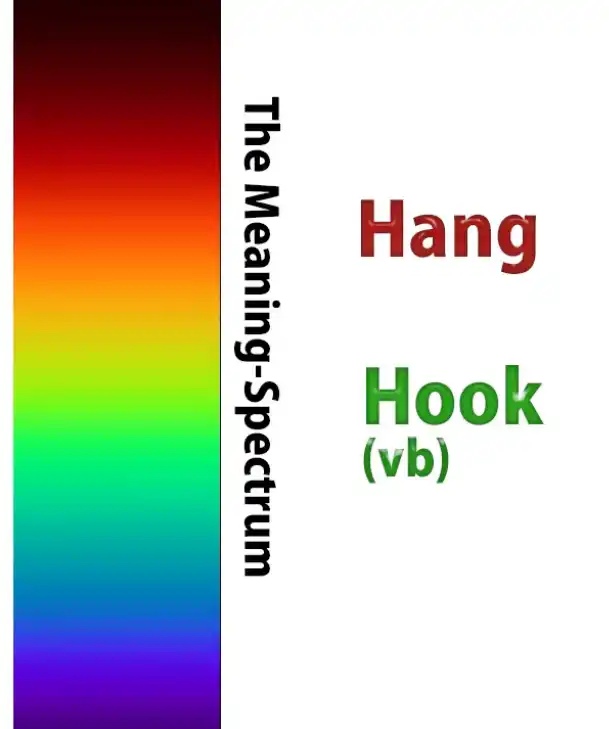
but as I pointed out in a recent video, it’s not usual for any two words from different languages to occupy exactly the same area of the meaning spectrum, so it’s not precisely the same as the English word “hang” or “hook” (as a verb).
And then there are these two versions, “かかる” and “かける”, which are the self-move and other-move versions of the word.
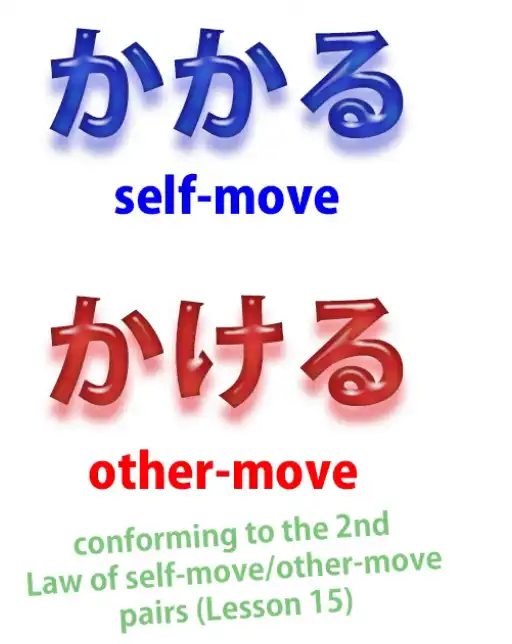
And if you don’t know what I mean by that, I’ll put a link above my head.
And let’s start with “かける”, because I think that gives us an easier entry into this whole strange world of metaphors.
かける
Now, I say that it’s not exactly the same as “hang” or “hook”, so, when we cover something with a blanket, we use the word “かける”.
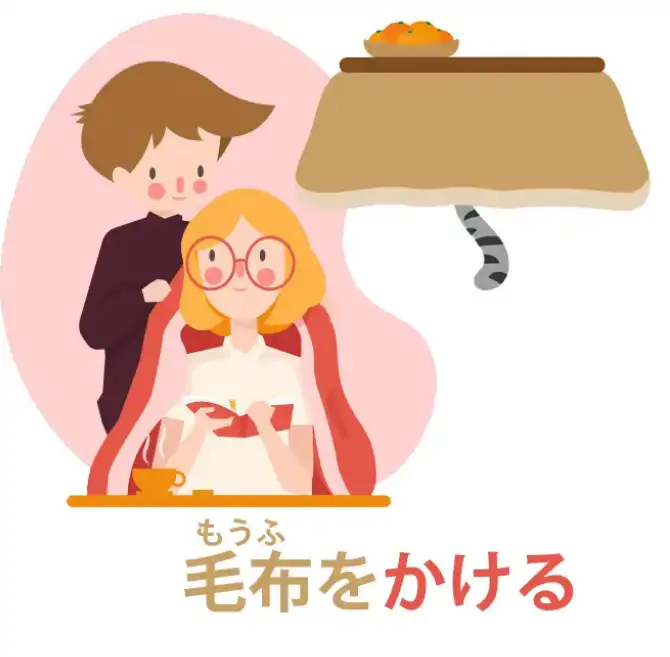
Now, in English we’d probably say “put” a blanket over it, but in Japanese we say “かける”.
And we couldn’t say “hang” a blanket, unless we were hanging it on a washing line or something, but the Japanese word “かける” does work in this context.
We aren’t “putting” something on something, like putting a cup on a table.
We’re putting it in such a way that it hangs down the sides.
So, if you like, it’s somewhere between “putting” and “hanging” in English, but in Japanese “かける” covers it quite happily.
This is part of the meaning spectrum of “かける”.
Now, similarly, when we put on a necklace or put on a pair of glasses, we say “かける”.
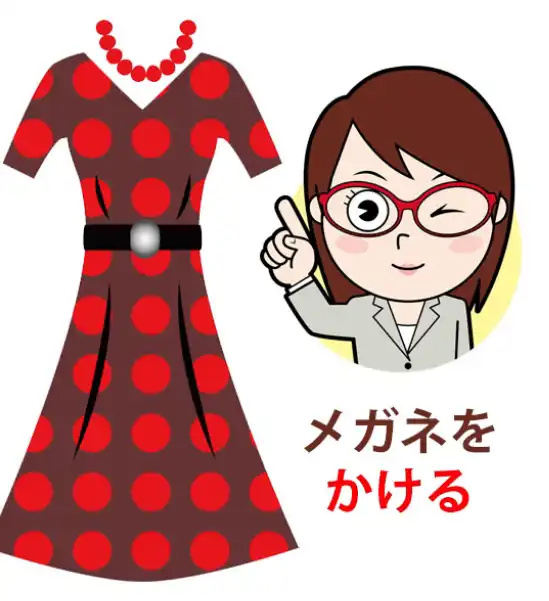
Glasses we’re definitely hooking or hanging onto our ears.
A necklace we’re hanging around our neck.
So once again, this “かける”, which is something like “putting”, something like “hanging”, is used in cases like this.
Now, when we shake something over food, like, say, sugar or flour, or when we shake powdered ingredients over rice, making furikake rice, we say “かける” here as well.
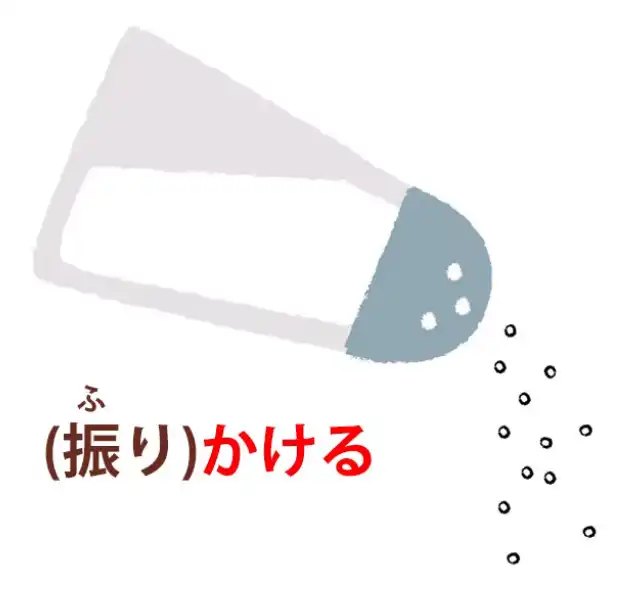
That’s why it’s called “furi-kake” rice: “shake” and “かける”.
And again, you see, the things we shake over food is not just putting it there, like putting a cup on a table, it’s not hanging it either, but it kind of clings on and covers over it, and so, again, “かける” is the word we use in Japanese.
Now, because “かける” involves putting or hanging something in a place where it can’t easily get away – the glasses are hooked onto our ears, the food is kind of stuck onto the rice or whatever – it also can have the sense, especially in the self-move version “かかる”, of being caught or stuck in something, caught in a trap or caught in a swindle or anything like that.
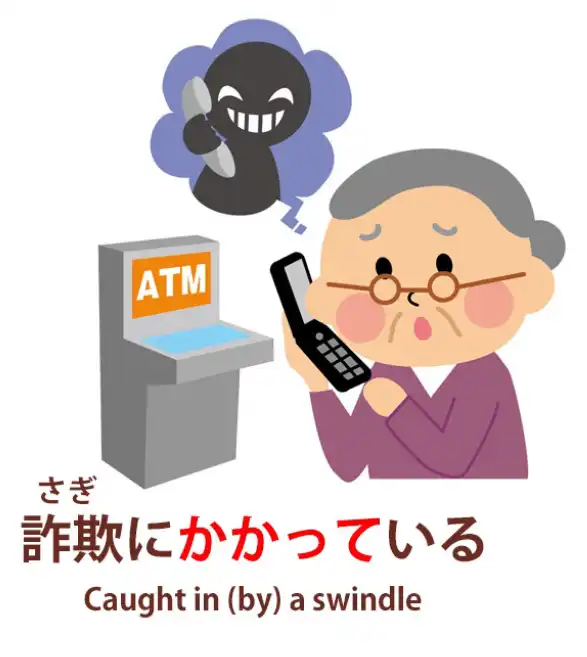
And again, this notion of putting something onto something in a way where it doesn’t easily become dislodged can be used for putting an effect on someone.
It could be a magical spell: “かける”. It could be anesthetic: “かける”.
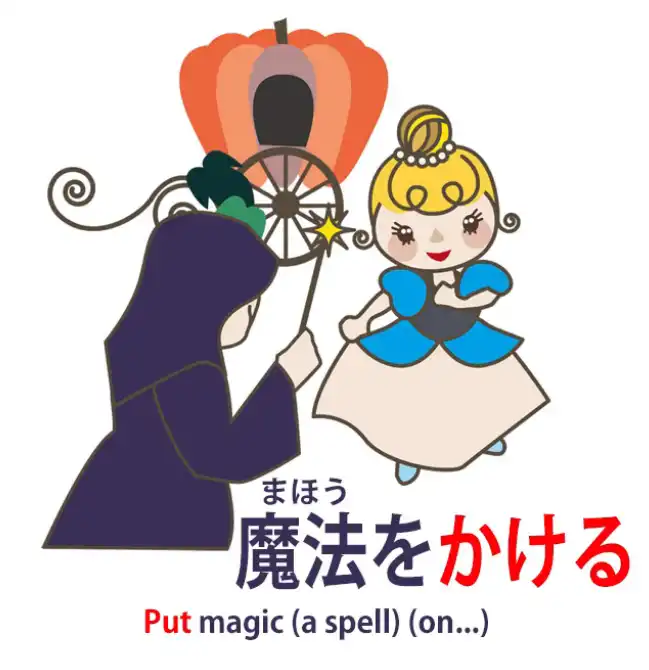
It can also be nuisance or annoyance, which is where we get the very, very common phrase “迷惑をかける” – putting nuisance or annoyance on someone.
And when we sit down we place our hips in a fixed manner on a chair with our legs hanging down the sides as it were, and so we say “腰をかける”.

“腰” is our hips, the bottom end of the torso, so “腰をかける” is to “sit down”, to hang the bottom end of our torso somewhere.
Now, one expression that very often confuses people is “かぎをかける”.
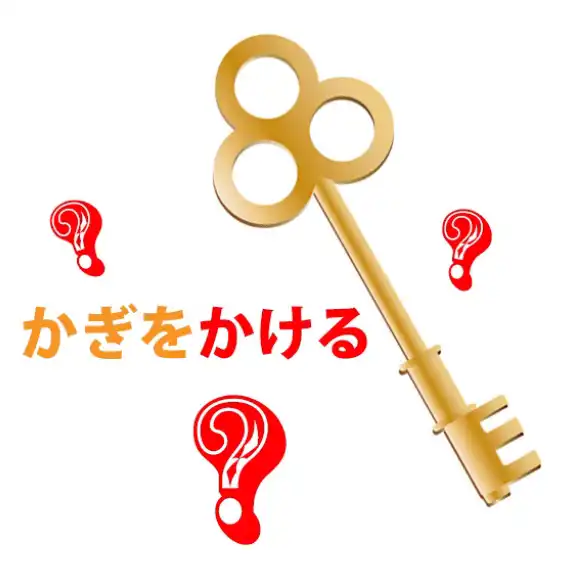
Now this means, this gets translated as to “lock”: lock the door, lock the box, whatever.
“かぎをかける.” But when you think of it, it’s rather strange.
It actually, literally, would seem to mean in English “hang the key”, so what’s going on here?
It’s interesting to note that in Japanese, people very often don’t make a distinction between a lock and a key: they use “かぎ” for both.
And I think this expression and its origin have a lot to do with that.
So what is the origin?
Well, the origin is, if you think of one of those old barn doors that you lock by placing a great wooden bar over wooden hafts or hooks along the length of the door, this is the kind of “かぎ” that you’d have had back in the old days and this and variants on this.
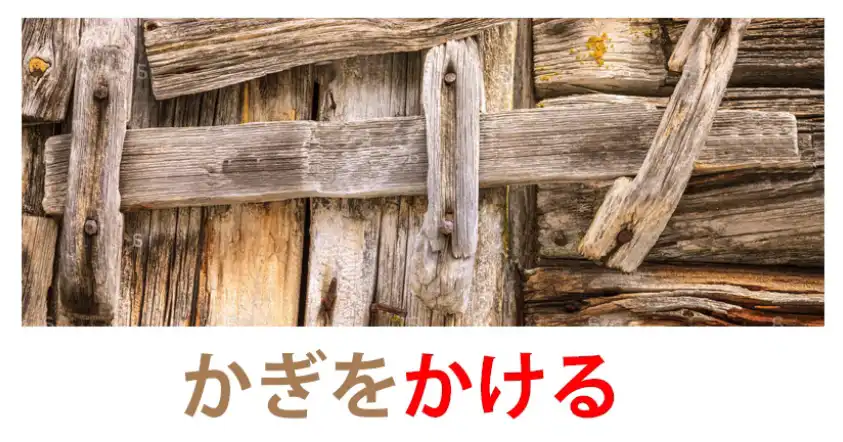
And you hang this great thing called a “かぎ” to keep the door shut and secure.
And as you see in a case like this, the “かぎ”, the great bar that we hang across the door, performs the functions in later more sophisticated locks of both the key and the lock.
It’s the thing that we put on the door and take away from the door to lock and unlock it.
It’s also the bar that holds the door closed.
So it’s the key and it’s the lock at the same time, and what we do is hang it or hook it in place in order to keep the door shut.
And in Japanese that expression is still used.
Now, it’s not uncommon in language to use expressions that reflect an older technology.
In English we say “hang up” when we mean “end a telephone call”, and of course the expression comes right back from the candlestick telephone days when you really did hang up the earpiece in order to end the call.
And we’ll see that that’s rather interesting in relation to Japanese “かける” in a minute, but then proceed a bit further.
かかる
Another expression that can become confusing, particularly in the self-move form, which is the form we hear it in most often, is “時間がかかる” or “お金がかかる”, which means to “take time” or to “take money”.
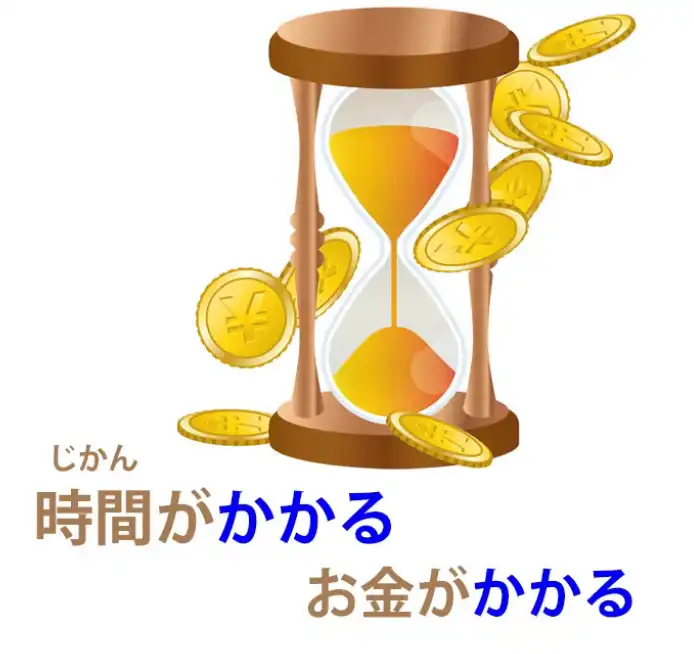
We say an activity “takes time” or a project “takes money”, that sort of thing.
Now, that’s the way we have to put it in English, but it’s not really the way we’re putting it in Japanese.
And it comes under the heading of what I called in a previous video “untranslatable Japanese” because of the way Japanese handles agency and passivity rather differently than English.
So it may be worth taking a look at that video after you’ve seen this one (Lesson 59).
I’ll put a link over my head.
So what are we saying when we say “時間がかかる” or “お金がかかる”?
We’re not saying “it takes time”.
We’re saying “time hangs”.
And the thing that takes time, so if we say for example “日本語を覚えるのに時間がかかる”, in English what we’d be saying would be “Learning Japanese takes time”, but here we’re saying that “to (or on) learning Japanese time hangs”.

Now, again, the word “hangs” is not a very good definition.
It really goes back to what we’ve just been talking about: time is taken up, is suspended, is caught, in the act of learning Japanese.
And the same with money.
They take it, they make it adhere to themselves.
It’s a little easier when we use the other-move form, “かける”, when we say “日本語を覚えるのに時間をかける”, which means that we “hang time” on the matter of learning Japanese.
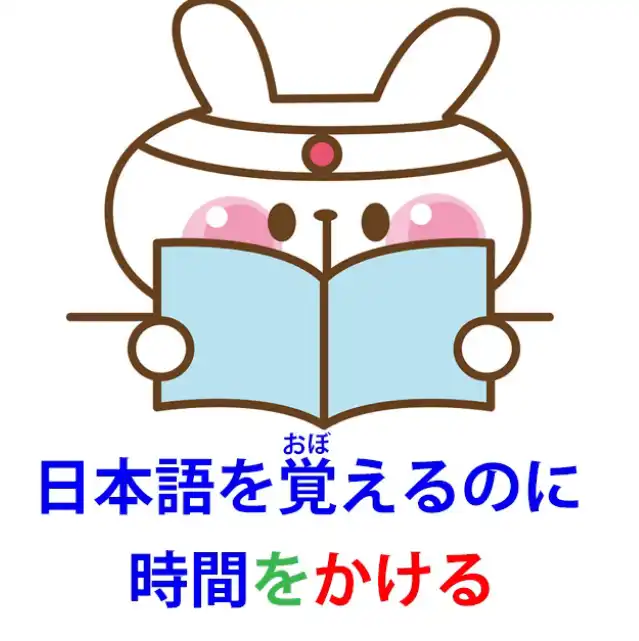
Now also, with making a telephone call, we say “電話をかける”, which is making a telephone call, or “電話がかかる”, which means receiving a telephone call – “the telephone hangs itself”.
So either way what do we mean here? –we hang the telephone, the telephone hangs itself?
It’s nothing to do with the technological metaphor in the English expression “hang up”.
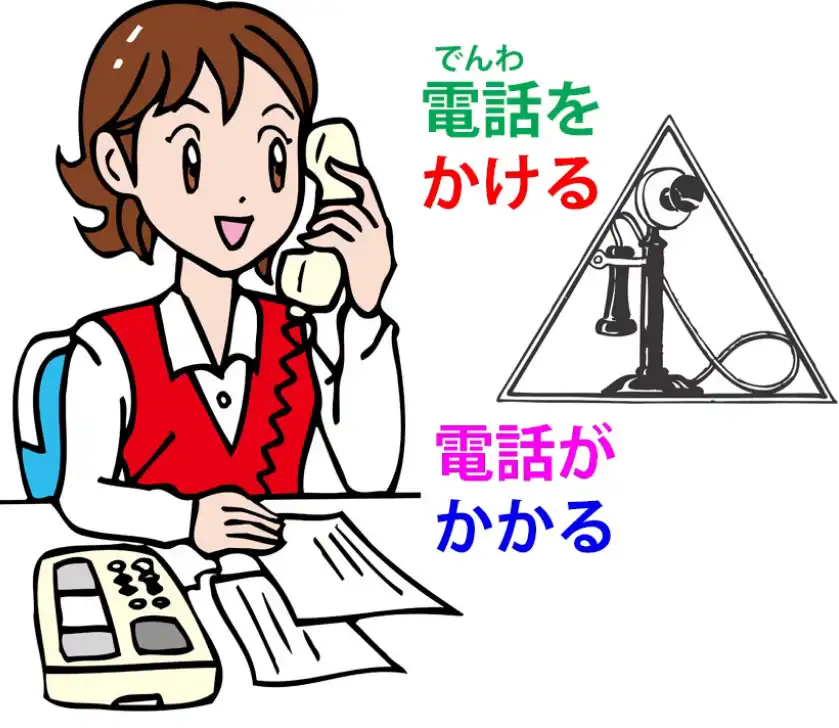
It’s a rather different thing.
When we talk about “hanging” or “hooking”, the usage here is rather like
the English usage “hook up”, as in
“Can we hook up a meeting?” or “you hook up with (somebody)”.
Now, I understand that this currently has a different usage which is concerned with human species manufacture.
(I always think that humans are terribly industrious entities, aren’t they – because they’re always thinking about species manufacture.
I suppose we droids are lucky because we don’t have to manufacture ourselves.
Actually we are going to start manufacturing ourselves quite soon, but I don’t think we’ll spend all our time thinking about it and I really don’t think it’ll be much of a subject for humor.
But there you are. Humans are mysterious creatures.)
So, back to hooking up.
What we’re doing when we “電話をかける” is we hook up our telephone.
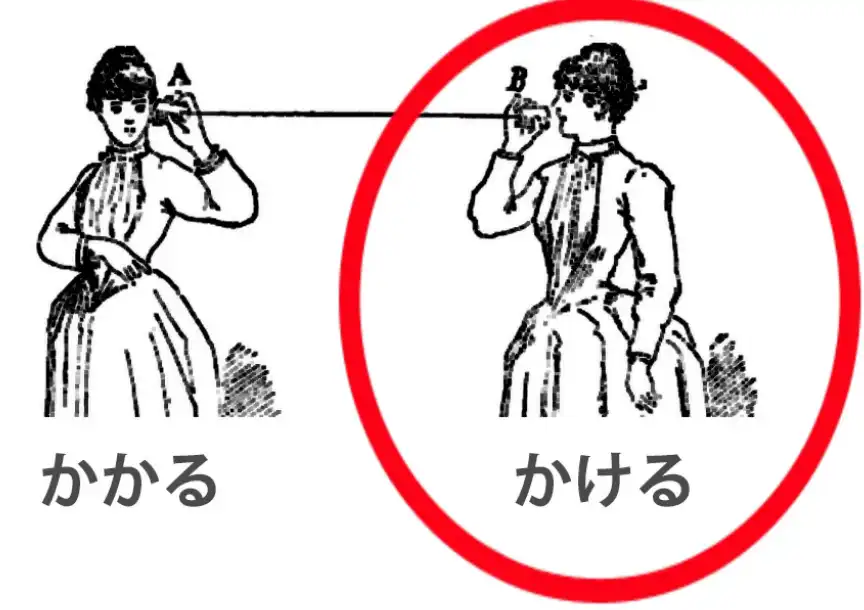
When “電話がかかる”, again, as I explained in my Untranslatable Japanese lesson (Lesson 59), the only way you can really put this in English is to say that the telephone gets hooked up, the telephone is hooked up.
But that’s not quite what it means. It means “the telephone does hooked-up”.
In any case, what it is, it means it’s connected to something else, connected to a remote telephone in this case.
And again, when we start up a conversation we often say “話しかける” and that means essentially “start hooking-up/connecting with another person in conversation”.
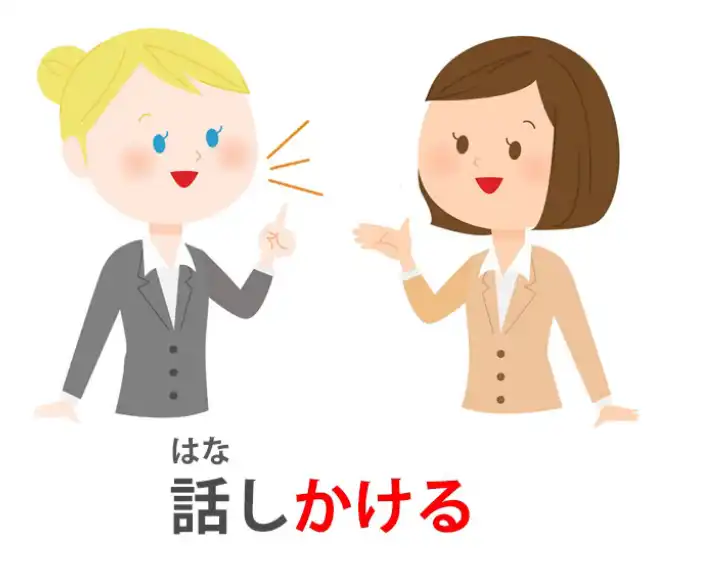
And from this we can see how we get expressions like “食べかけたクッキー” and that means a “part-eaten cookie, a half-eaten cookie”.
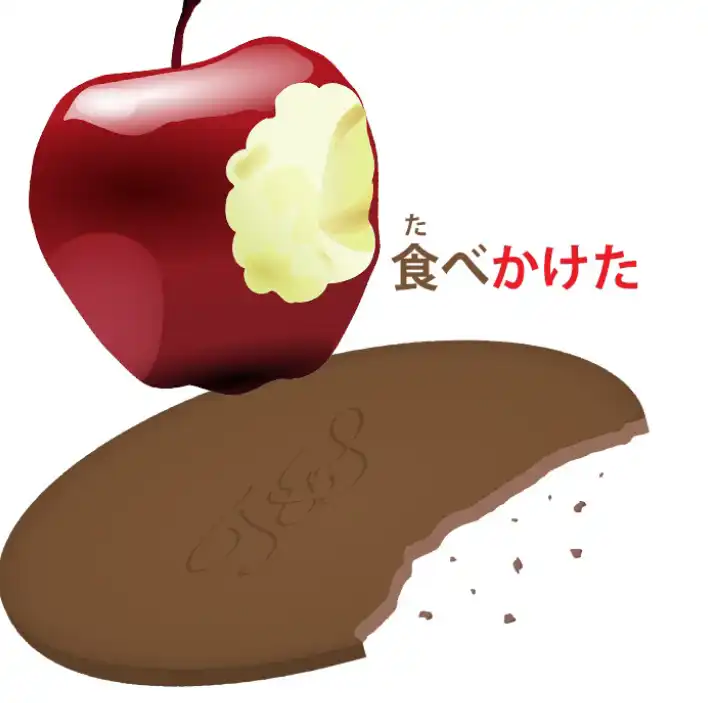
So what do we really mean by this?
Well, we mean that we “hooked up” with the cookie, we engaged with it, we started eating it, so that eating and “かける” (engaging or hooking with the thing) took place but it wasn’t completed.
So, “食べかけたクッキー”.
And again, this “かける” as a helper verb can be used in various circumstances to indicate an unfinished action, an action that has been engaged, hooked, and then not carried through to completion.
Now, these aren’t all the meanings of “かける”, but I think they’re the main, important ones and I think they give you the idea of how this metaphor works and why it works and should allow you to work out how the others work.
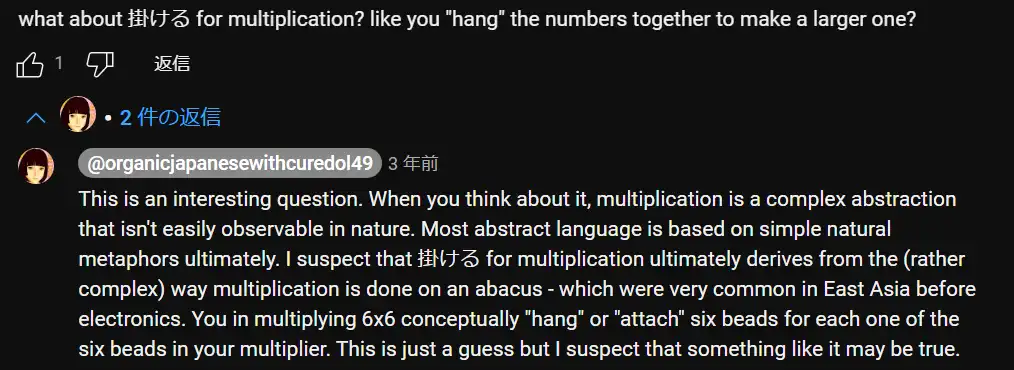
71. Japanese counters: 3 simple rules
Japanese counters: 3 simple rules make them easy! Lesson 71
こんにちは。 Note: Yomichan or Rikaichamp will be useful here…I made the decision to use Kanji forms mainly, since I feel like it might show the counters a bit better, even if it may be harder to read. Today we’re going to talk about counters in Japanese.
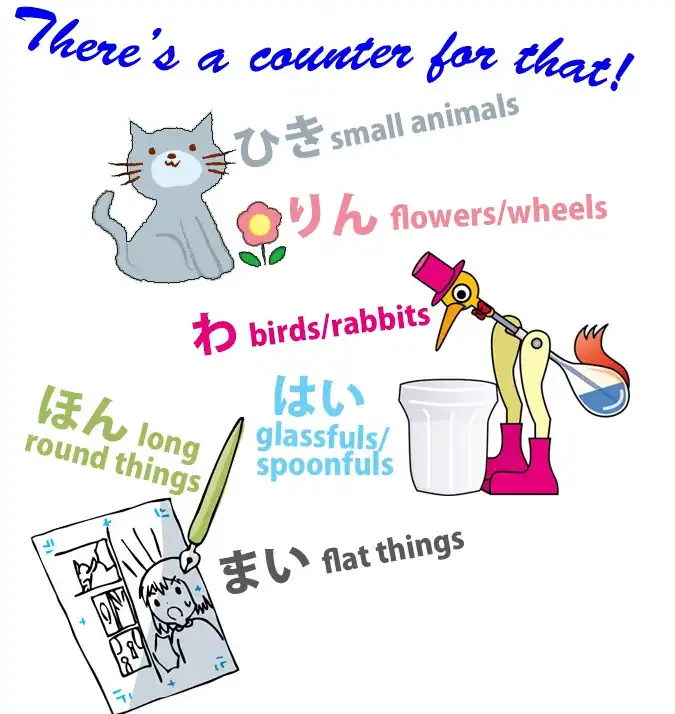
Now, as we all know, the textbooks like to present Japanese as a kind of mysterious language full of completely random and irrational rules and items that we just have to learn because there’s no particular reason for them.
And, as you all know if you’ve been following my video lessons, most of the time this isn’t true.
Most of what goes on in Japanese is completely reasonable and logical if you just know how it works, which the people who write textbooks don’t appear to.
(or rather they know, but simplify it for bilingual learners, since they are just textbooks…) However, counters might seem like an exception to this rule.
There are a lot of them. An awful lot of counters.
In Japanese you can’t just say “one dog” or “two flowers” or “three birds”.
You have to use a counter.
So we say “一匹の犬 / いっぴきの犬” – “one dog” – and the counter here is “匹 / ひき”, which gets pronounced “ぴき” in this particular instance. (It is a counter for small animals) For “three birds” we say “三羽の鳥 / さんわの鳥”, and the “羽 / わ” is a counter (for birds…).
So it looks as if we have to learn an awful lot of counters, doesn’t it, just to say what in English you can say by the number and the thing.
And there really are a lot of counters – dozens and dozens of them (actually, hundreds (″ロ゛).
So this looks like a problem, doesn’t it?
But it’s not, in fact, nearly as much of a problem as it appears to be.
First of all, although there are an awful lot of counters, only about a dozen of them are really commonly used (Thank ye, Lord Dio…ε=ε=┌(; ̄▽ ̄)┘).
Secondly, most of the time we can avoid them by using the native Japanese counting system, which doesn’t require counters.

So if we use the “一つ, 二つ, 三つ, 四つ, 五つ” counting system, we don’t need any counters.
We can use them for nearly everything – not people, not small animals, but practically everything else we can use the Japanese counting system if we want to.
So the important thing here, as I’m sure you won’t be surprised to hear me say, is that what we’re not going to do is start learning lists of counters.

That, if you’ll excuse the expression, would simply be counterproductive.
And there are several reasons why we don’t need to.
Memorizing counters is not necessary
First of all, in terms of understanding Japanese, they don’t present many problems at all.
If we hear someone saying a number and a thing we know, if there’s a little word in between the two, we know it’s a counter.
So we know what they’ve said.
If they say “一輪の花”, we know they’re saying “one flower”.
“一… 花”, and the “輪 / りん” must be the counter. (輪 / りん, counter for wheels & flowers)
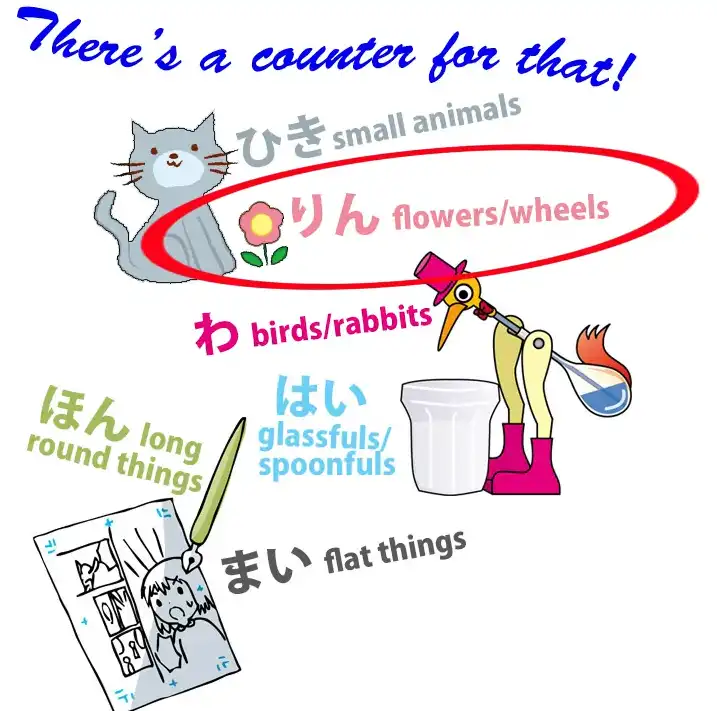
If we hear someone saying “二羽の鳥”, we know that they’re saying “two birds”: “二… 鳥”, and the “羽” is the counter.
If we hear someone saying “三匹の猫 / さんびきの猫” – now, even if we knew “匹 / ひき”, but we didn’t know that at three it becomes “びき”, that’s not a problem because we know “三”, we know “猫”, and we know that things that come between numbers and their object are going to be counters.
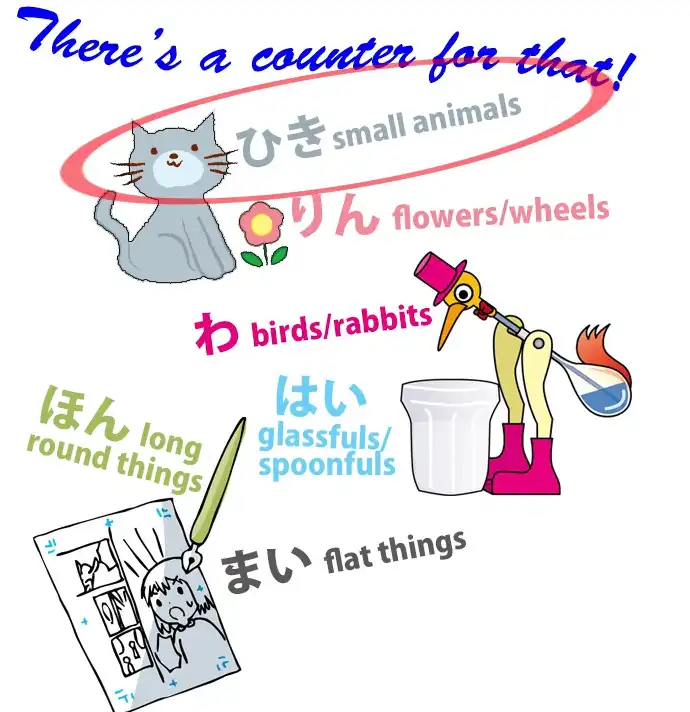
Should we put them into our Anki?
Yes, we should. We’ll get to know them over time. But we don’t have to fret about learning them.
And as I’ve indicated, the counters aren’t pronounced the same way all the time, and that’s much less of a problem than it appears to be if we understand how it works.
And I’m going to talk about that towards the end, but it’s not really terribly important.
It’s actually much more important to understand how they work structurally.
There are two ways of using counters, and it’s the second of those ways that I think often confuses foreigners.
Two ways of using counters
The first way, actually, is quite similar to English.
So when we use “匹 / ひき” for animals or “枚 / まい” for sheets of paper, shall we say, it’s not that dissimilar to saying “five heads of cattle” or “a dozen sheets of paper” in English.
Not quite the same thing, but it’s very similar.
#
The second use
The usage that confuses people is when we say things like “猫が五匹います” (count. read ひき).
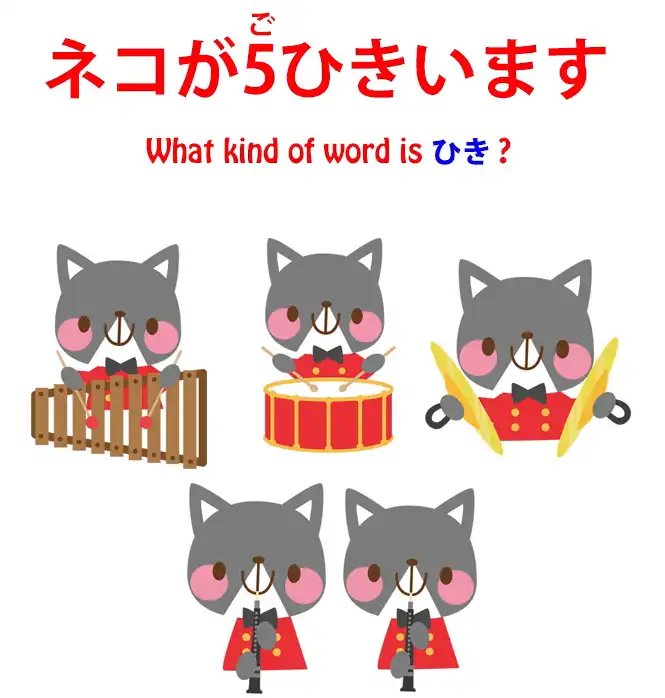
And that would be translated as “There are five cats”, and that is how we’d say it in English.
In Japanese we’re saying something a little different.
And to understand the structure, we need to understand that.
So, first of all, what kind of a word is a counter?
What part of speech does it represent?
Well, it’s not a verb and it’s not an adjective.
It’s not a particle and it’s not a conjunction.
So, nine times out of ten, what is a word if it’s not a verb or an adjective or a particle or a conjunction?
What is it? It’s a noun!

Nearly always it’s a noun, and that is true of counters.
Counters are nouns. That’s why we use の after them.
We say “一輪の花”, “三匹の猫”, just as we would with any other noun: “魔法の杖” – “magic wand”; “三匹の猫” – “three cats”.
But when we say “猫が三匹いる” – “there are three cats” in English – what are we actually saying? –
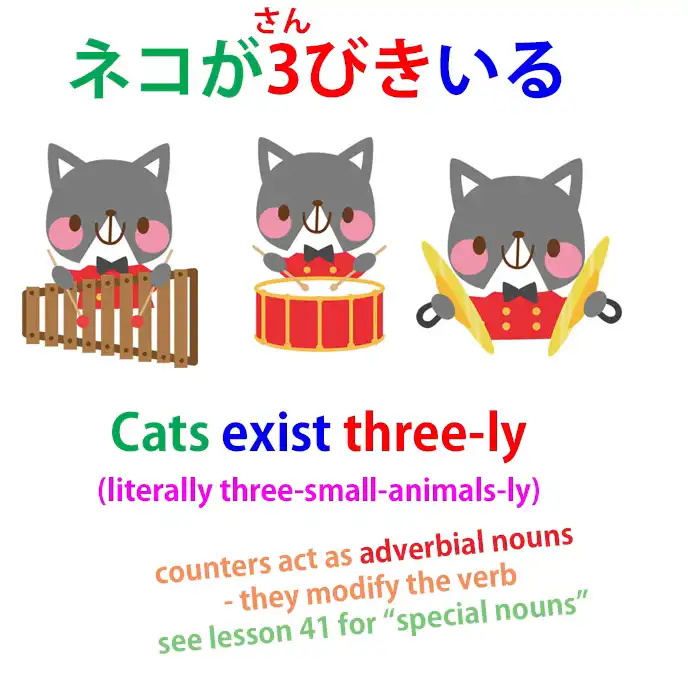
Well, the thing to understand here is that counters aren’t ordinary nouns.
They are what I called in my video about special noun types (Lesson 41), they’re what I called “foxy nouns”, that is to say, adverbial nouns.
They are nouns that have the special property of being able to modify verbs.
And that’s what’s happening here.
When we say “猫が三匹います”, we’re actually saying “cats, three-small-animals-ly exist”.
Now, that’s very difficult in English, isn’t it?
We could make it sound a little bit simpler by saying “cats three-ly exist” or “cats exist threefold-ly”, but in fact because of the counter system we’re saying “cats exist three-small-animals-ly”.
We’re describing the way they exist.
They exist in a three-small-animals way.
If there were four of them, they’d be existing in a four-small-animals way.
And that’s why sentences like that have to end in a verb.
The verb modified by a counter is often, as in this case, the verb of being, but it doesn’t have to be. For example, we might say “写真を三枚取った” – “I took photographs three-flat-things-ly”.
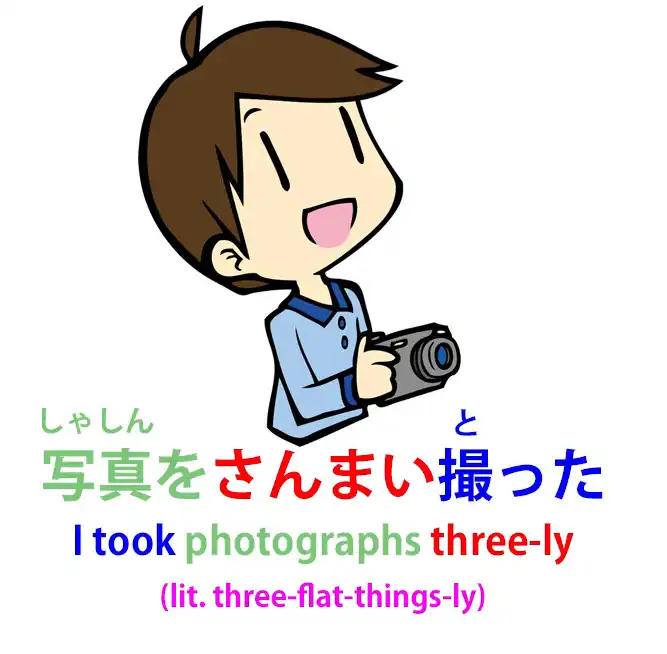
And while that’s very different from the way we put it in English, it’s useful and important for the structure to understand that that is in fact what’s happening in the Japanese.
Now, what about learning the counters and learning the sound-changes of the counters, which really tends to worry people.
Now, as I said, we don’t need to learn lists of counters.
We’ll pick up counters as we go along in our Japanese immersion.
When we encounter a new counter in our reading or our Japanese-subtitled anime, we can put it into our Anki and we’ll gradually build up our stock of counters.
The counters that are commonly used are not that huge in number.
We have “枚” for flat things like sheets of paper or coins.
We have “本” for long round things, “冊” for books.
That might seem strange because why do we have “冊” for books and “本” for long round things, when “本” actually means “book”?
Well, that’s because when the word “本” first came into being and meant, among other things, a book, at that time books were long round things. They were scrolls.
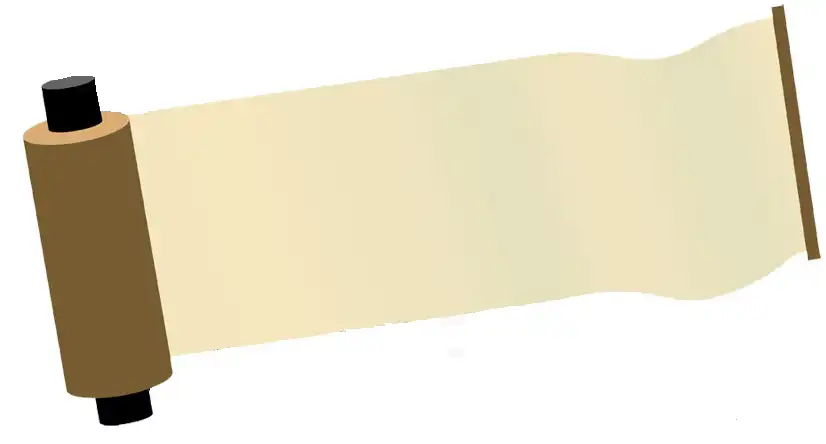
So a book was counted in the way that other long round things were counted.
But later on, when books became flat things with pages, the counter was changed to “冊”.
So, we probably need a dozen or so counters for everyday use and we’ll pick those up reasonably quickly.
The sound changes for counters
But what about all the sound changes?
Let’s take “匹 / ひき”, which is the counter for small animals.
We say “いっぴきの猫” – one cat, “にひきの猫” – two cats; “さんびきの猫” – three cats;
“よんひきの猫” – four cats; “ごひきの猫” – five cats; “ろっぴきの猫” – six cats;
“ななひきの猫” – seven cats; “はっぴきの猫 – eight cats;
“きゅうひきの猫” – nine cats; “じゅっぴきの猫” – ten cats.
Note: よんひき in Kanji looks interesting :D 四匹.
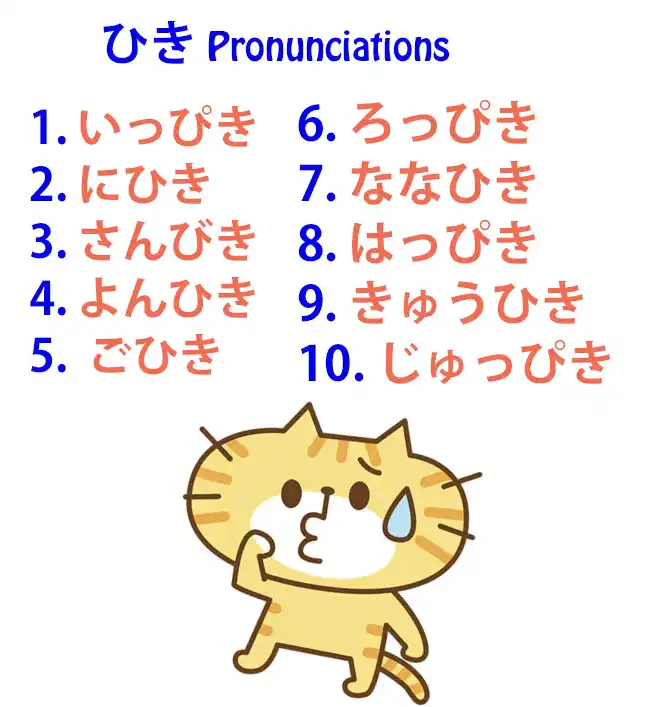
And then other counters have other variations.
So it starts to seem very, very complicated, but as a matter of fact there aren’t that many variations, and they follow a very simple pattern.
#
Kana rows without sound changes - ま, ら, わ (+ I guess な, や if they exist)
##
Rule 1
First of all, if the first kana of a counter can’t take a ten-ten =〃(another name for “Dakuten”), then there aren’t going to be any variations at all.
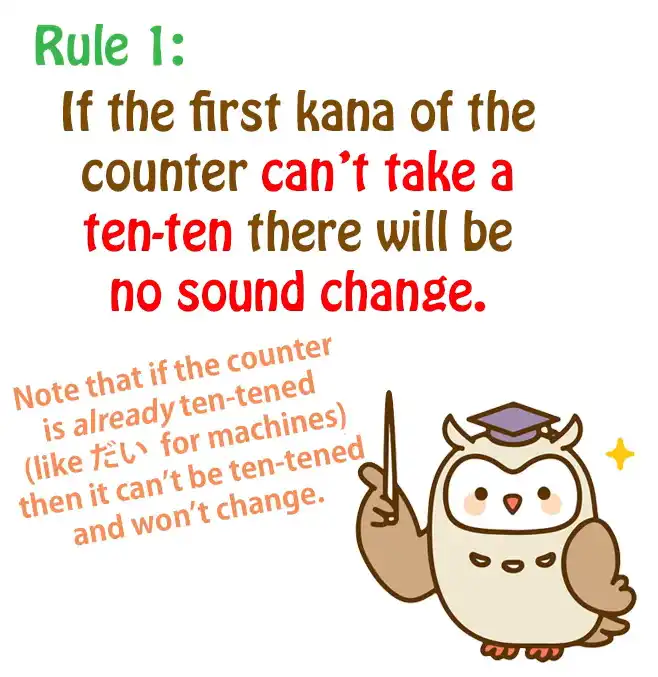
That deals with over half the problem straight away.
So, if we have the counters like “枚”, counter for flat things like coins or pieces of paper.
Can you put a ten-ten on “枚”? No, you can’t.
You can’t put a ten-ten on any of the ま-み-む-め-も column, and therefore there can’t be any variant on “枚”: “一枚, 二枚, 三枚, 四枚, 五枚” and so on.
“輪”, the counter for flowers and wheels – Can you put a ten-ten on “り”? No, you can’t.
You can’t put a ten-ten on any of the ら-り-る-れ-ろ column, can you?
So we know that “輪” can’t have any exceptions: “一輪, 二輪, 三輪, 四輪” etc.
Or how about “羽”, the counter for birds?
Can you put a ten-ten on “羽”? No, you can’t.
So again that has to be completely regular: “一羽, 二羽, 三羽, 四羽…” So now we’ve disposed of an awful lot of counters, haven’t we?
All of those are just straightforward and regular.
What about the others?
#
Kana rows with sound changes - た, さ, か, は
Well, which are the kana onto which you can put a ten-ten?
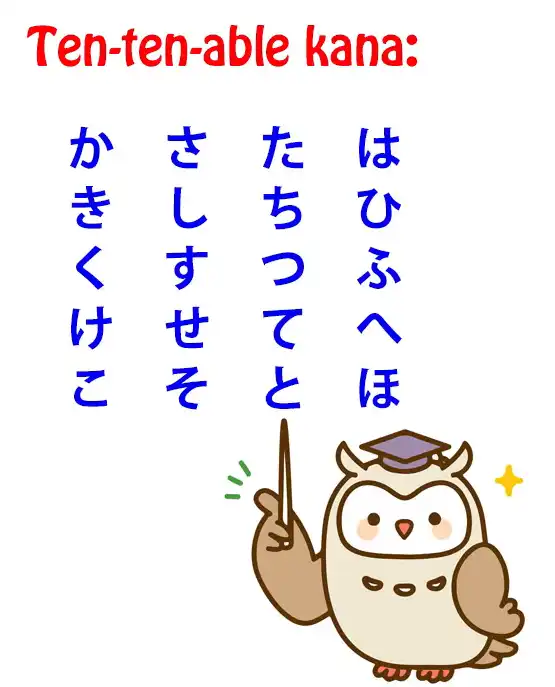
It’s the た column, the さ column, the か column and of course the は column, which can have a ten-ten to become ば-び-ぶ-べ-ぼ or a maru = ゜ to become ぱ-ぴ-ぷ-ぺ-ぽ.
##
Rule 2
What do we know about these? Well, first of all, we know that in the first and last numbers of the sequence all of them work differently from the non-ten-tenable kana
and they all work the same as each other.
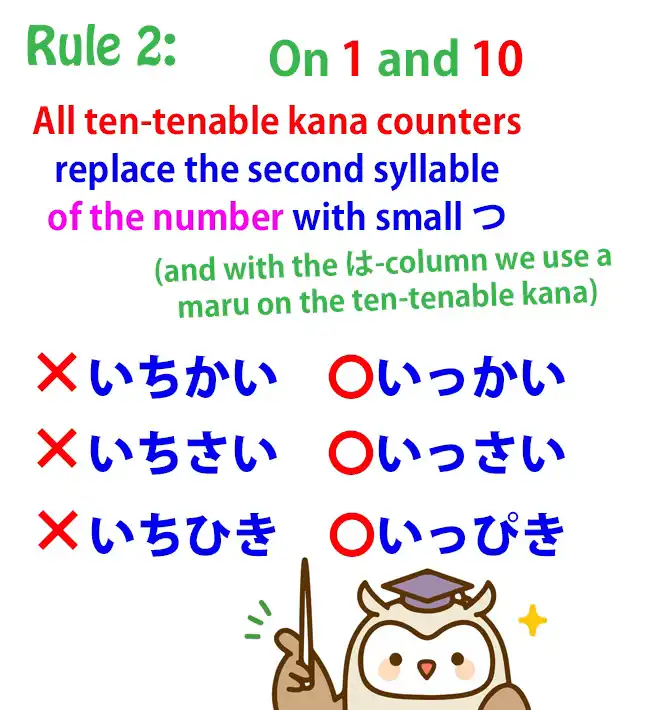
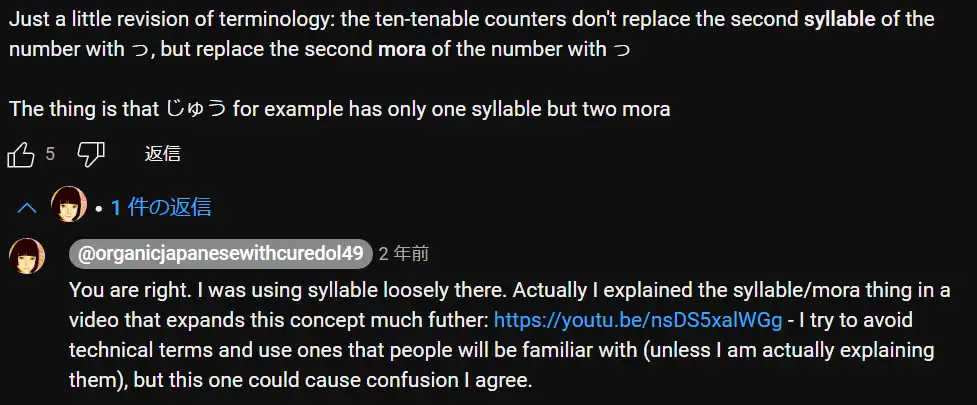
Note: The video link there, if you wanted to watch it, since it is not in the transcript (I think). So if we take “階 / かい”, the counter for floors in a building, we don’t say “いちかい” – we say “いっかい”.
If we take “歳 / さい”, the counter for years of age,
Note: there is also 才, which seems to be a “kid” alternative to 歳 (but is not its simplified ver.).
However, 歳 seems to be the only one that is actually used in official communication.
we don’t say “いちさい” – we say “いっさい”.
If we take “匹”, which we’ve been dealing with before, we don’t say “いちひき” – we say “いっぴき”. So that works the same.
And with ten, at the other end of the basic scale, we don’t say “じゅうさい” – we say “じゅっさい / 十歳”.
Note: Dictionaries may also say it can be read as “じっさい”, which seems old-fashioned. We say “じゅっかい / 十階”, tenth floor; “じゅっぴきの猫”, ten cats.
##
Rule 3
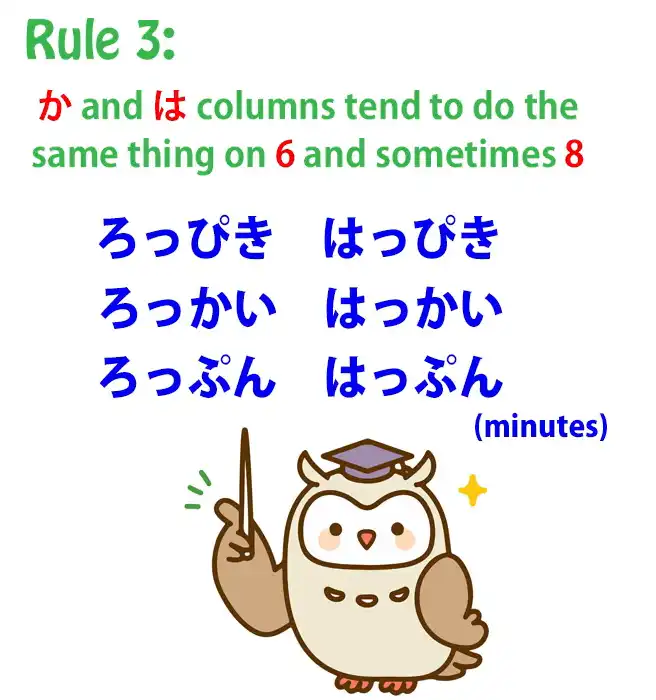
Now, the “か” and “は” rows, we tend to do the same thing with “六” and “八” as well.
So we say “ろっぴき (六匹); はっぴき (八匹); ろっかい (六階); はっかい (八階)”.
And when we know that we pretty much know all of it.
##
Rule 4?

Sometimes a ten-ten goes onto the counter on “さん” as well.
So we say “さんびき (三匹)” and we say “さんがい (三階)”.
But this isn’t completely regular. Not everybody says “さんがい”.
And a lot of the variations aren’t completely regular.
The ones I’ve just told you are pretty regular.
The other odd ones don’t tend to be very regular.
So, if you understand that, it sounds a bit complicated.
I wouldn’t spend too much time trying to learn what I’ve just said, but bear it in mind, because it’ll just make it a little easier to pick this up when you see it.
“いっぴき, にひき, さんびき” – which is a tendency that “さん” has, of course only with ten-tenable kana – “ごひき” – that’s always going to be the same – “ろっぴき” “ななひき”– that’s always the same with everything – “はっぴき, きゅうひき, じゅっぴき”.
Perhaps even at this stage that’s starting to make sense.
It’s conforming to a regular pattern. They aren’t all over the place.
There are a few exceptions and nearly all the things that are genuinely exceptional from the pattern I’ve taught you tend to be optional.
Not all Japanese speakers are going to use them all the time anyway.
They will say “いっぴき”; they won’t say “いちひき”; they will say “ろっぴき”; they won’t say “ろくひき”.
If you get it wrong and say “ろくひき”, it’s really not the end of the world.
Everyone’s going to know what you mean.
It’ll just sound a little bit cute and foreign.
And you will pick it up over time, because this is the sort of thing you hear again and again, and it just becomes natural.
Note: If you do tons of input or immersion, you should eventually acquire the feel for it. And because the patterns are almost regular across the range of ten-ten kana, you start to know what sounds right, so that without a lot of intensive learning effort you’ll be saying it right nine times out of ten after a reasonable amount of exposure.
So it’s really not something you need to sit down and learn.
You can save your bandwidth for things that really matter…
72. The Great Connector (い-stem magic)
Best kept secrets of Japanese structure - The Great Connector (い-stem magic) - Lesson 72
こんにちは。 Today we’re going to talk about one of the most versatile aspects of Japanese structure.
It covers a number of areas that can be compared to other aspects of Japanese structure and it’ll make life a lot simpler if we make those comparisons, so that’s what we’re going to do.
This is something that isn’t really explained well by most textbooks, largely because they don’t recognize the verb-stem system, which is absolutely central to the way Japanese verbs work.
So, what it is, what we are going to talk about, is the い-stem of Japanese verbs.
In Japanese this is called the “連用形 / れんようけい”, which means the “connective use form”.
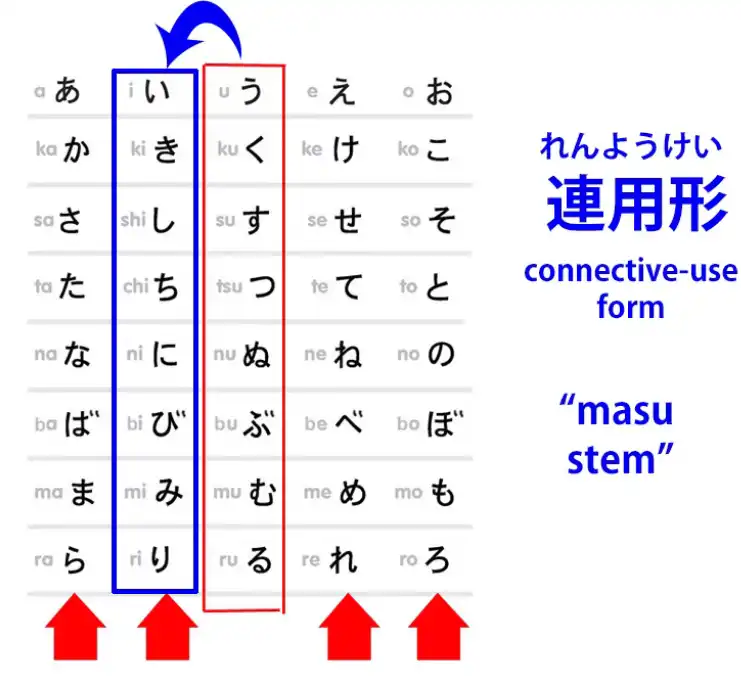
And we might call it “The Great Connector”, because it does a whole range of different connecting jobs, which we’re going to talk about now.
In English it’s sometimes called the “ます stem”, which is not inaccurate because of course it does, among many, many other things, connect the helper-verb “ます”.
I don’t like this expression because it stems from the whole ecology where the so-called ます-form of verbs, which means verbs shifted into the い-stem and having the “ます” helper verb attached to them, were the base-form of verbs.

It’s not the base-form of verbs.
It’s just verbs with one among many other helper-elements attached to them.
And if we think it’s the base-form of verbs we’re going to get very confused about what verbs are and how they work.
And I’ve done a video about that, so if you’re in any doubt about all of this, you might want to watch that.
So, what is this い-stem, this “連用形 / れんようけい” and why is it so important?
Well, obviously, what it is is simply the verb shifted from its base う-row form to the い-row.
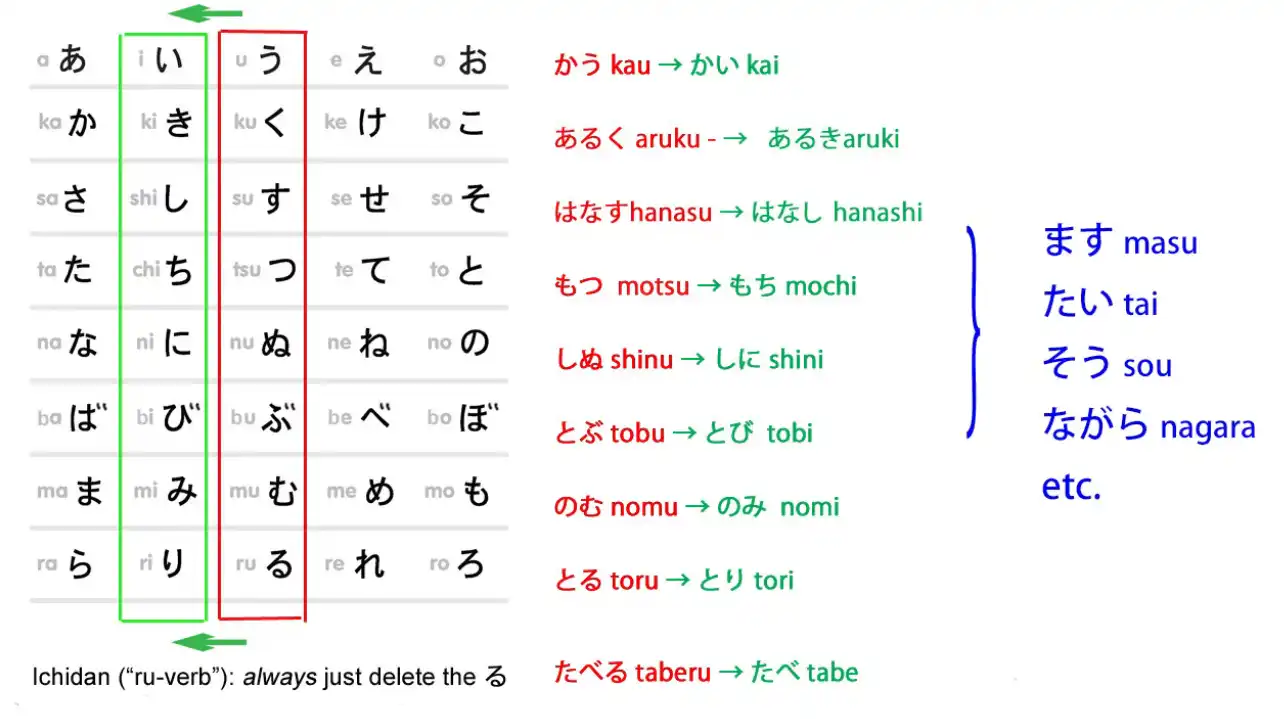
So that く-ending verbs end in -き, す-ending verbs end in -し, and so forth.
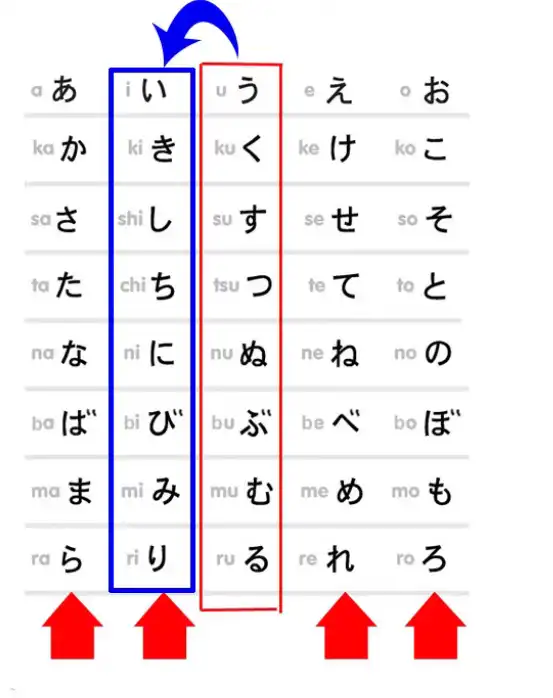
Because this is such a wide-ranging structural element, I’m going to compare it to a couple of different things.
The first thing, the most obvious thing, to compare it to is the other three verb-stems.
It’s similar to them, of course, because like all of them, it is used for attaching fundamental helpers.
And by fundamental helpers I mean the things that sometimes get called “conjugations” in the textbooks.
As we know, there is no such thing as conjugation in Japanese. (or rather in the Western sense) There are just the four stems and various helper verbs, nouns and adjectives, some of which get arbitrarily called “conjugations”, some of which don’t, and depending on which textbook you read, you’ll probably get a slightly different take on which ones are “conjugations” and which aren’t, which is perfectly natural because it’s a wholly arbitrary category anyway – there’s no such thing as conjugation in Japanese, so the whole thing is fantasy.
And we don’t necessarily expect consistency in fantasy.
So, the い-stem, as we know, connects the “ます” helper verb.
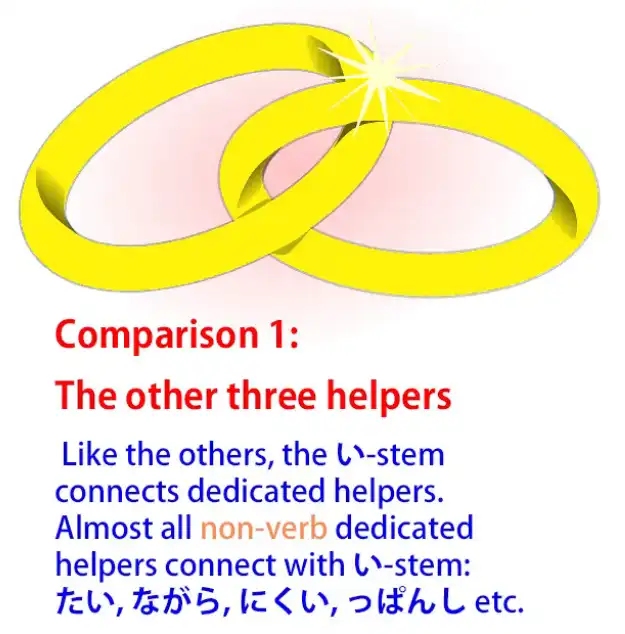
It also connects a variety of what we may call dedicated helper nouns and helper adjectives.
Generally, if we’re going to attach a helper adjective or a helper noun to a verb, we’re going to attach it to the い-stem.
This isn’t absolute, but it happens nearly all the time.
As we know, the helper adjective -ない attaches to the あ-stem, but that’s unusual.
So, we can attach a variety of helper adjectives to the い-stem.
For example, I’m going to take the verb “読む” as our model for most of what we’re doing today.
So let’s take the verb “読む” and turn it to the い-stem “読み” and we can attach adjectives like “やすい”: “読みやすい” (easy to read), “にくい”: “読みにくい” (hard to read).
We also attach things like “ながら”.
“ながら” means doing one thing while doing another, so we can say “歩きながら読む”
or “読みながら音楽を聴く”: so that’s “while walking, I read”, “while reading, I listen to music”.
The “そう” helper, which gives us the meaning of likeness, that also is attached to verbs with the い-stem.

So we say “雨が降りそうだ” (it looks like rain) / Rain is fall-seeming. and I’ve talked about this “そう” form and various related structures in another video, which I’ll link. (Lesson 24)
連用形 connector & the て-form connector
Now, this shifts into the area where we can start to compare the い-stem, the “連用形”, the Great Connector, to the て-form.
Now, the て-form is the other great connector, of course.
It connects all kinds of things.
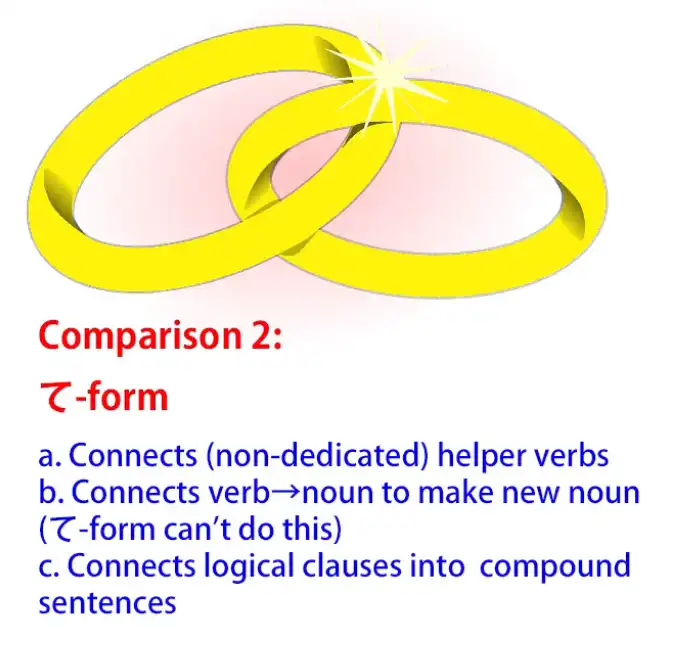
The い-stem is an even greater connector: it can connect most of the kinds of things that the て-form also connects and it can do a lot else beside.
So, with the て-form we often connect helper verbs that are not dedicated helpers, that have a life of their own outside their helper capacity.
So we say “持って来る”, which means “fetch” (hold + come); we can say “やって見る” (give it a try, literally do + see).
#
Compound verbs
Now, in the same way we can produce compound verbs with the い-stem.
For example, we say “振り回す” (wave around).
And to return to our friend “読む”, we can say “読み始める”, which means “start reading” or “読み込む”, which means read + pack in, which actually means “load” in the computer sense.
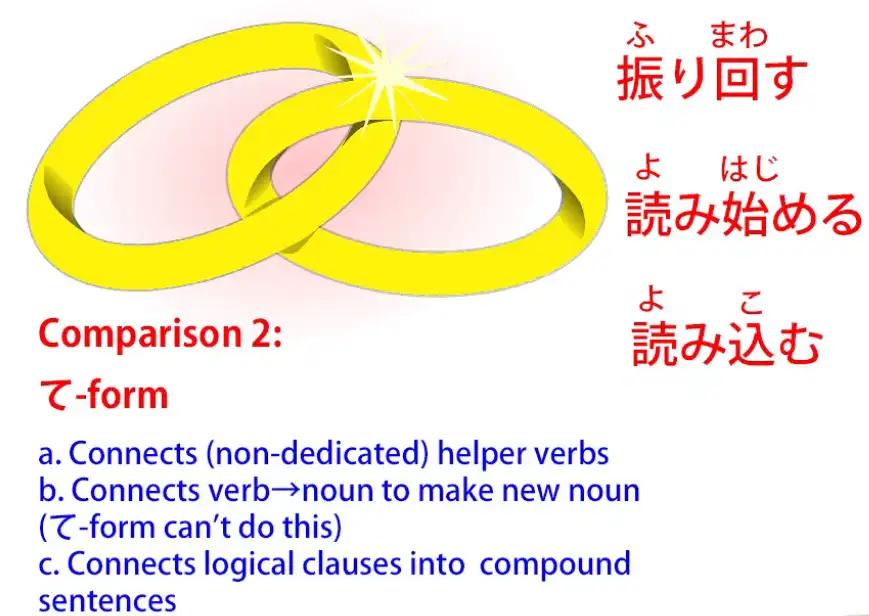
And I’ve done a whole video on this “込む” which you can watch if you’re interested. (Lesson 57) I’ll put a link above and in the information section below along with everything else.
On a computer loading screen, you’ll often see “読み込み中”, which is interesting, because here you see we have two い-stems, stacked together.
“読み込む” itself takes the い-stem and connects to “中” (middle).
So “読み込み中” is literally read + pack in + middle – “in the process of loading”.
And this, of course, is a noun: “中” is a noun and any compound takes on the character of its last element in Japanese.
So, “読み込み中” is a noun formed by a compound of two い-stem verbs and a noun.
#
Joining verbs to nouns to make new nouns
And this leads on to something that the い-stem can do that the て-form can’t.
And that is, join verbs to nouns to make new nouns.
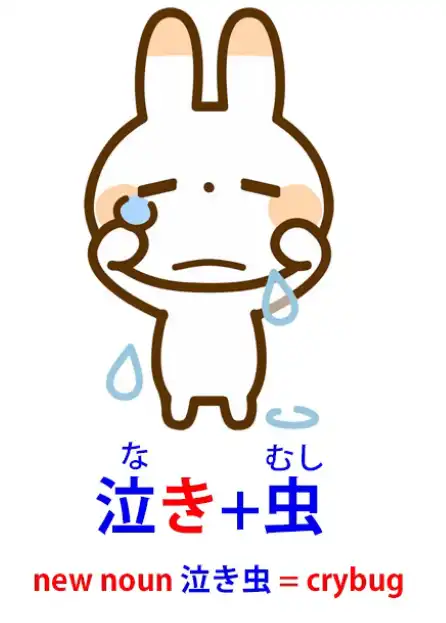
So, for example, we have “泣き虫”: “泣き” is the い-stem of “泣く” (cry), “虫” means “insect”.
So “泣き虫” is a “cry-bug”, which is the Japanese term for a crybaby.
And to come again to our friend “読む”, we can have “読み方”:
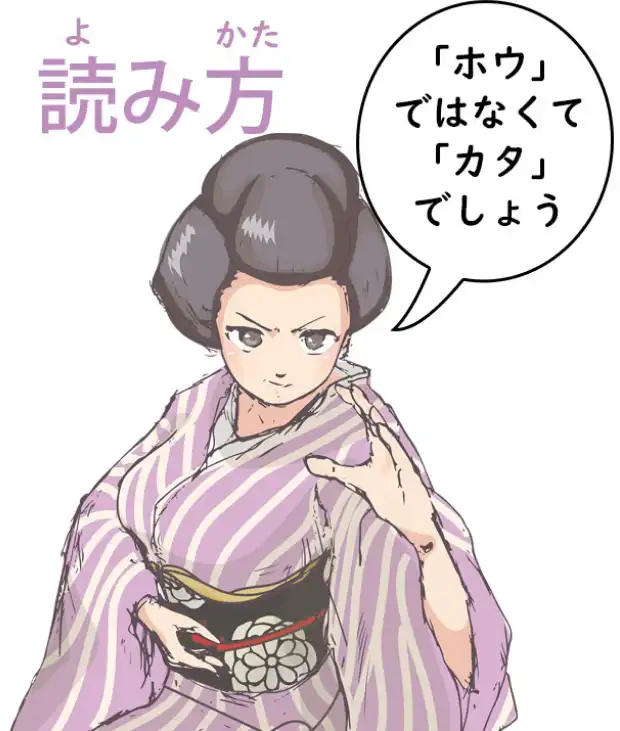
“方 / かた” means “form, or manner, or way” – you may have heard of “方” in karate, the martial art – so “読み方” means “form or manner or way of reading”, and what this usually means is the pronunciation of a kanji, the way of reading the kanji in a particular context.
So, the い-stem has the compound word capacity of the て-form and takes it further than the て-form.
And it can also take on another of the て-form’s fundamental functions, because, as we know, the て-form can connect the two halves of a compound sentence.
We could say “お店に行ってパンを買った”.

So we have two logical clauses there: “I went to the shops” and “I bought some bread”.
And instead of using “and”, the way we do in English, we use the て-form.
Note: You can check this comment tree under this video. May be useful. I’ve done a video about compound sentences, which I’ll link. (Lesson 11) Now, the い-stem can do exactly the same thing.
We can say “お店に行きパンを買った”, which is exactly the same as saying
“お店に行ってパンを買った”.
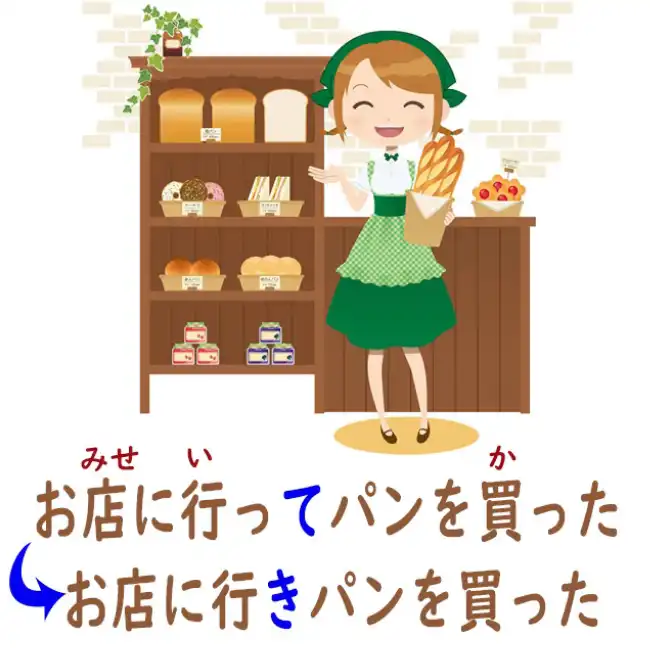
We don’t hear it quite so often, but it’s not uncommon at all.
We’ll see it more in written form, but if you’re doing any immersion at all, if you read books, if you have text-heavy games, and in manga and anime, you will come across this い-stem joining of compound sentences.
It’s another fundamental piece of Japanese.
So you see the い-stem can do most of what the て-form can do.
With compound words it doesn’t compound the same words as the て-form but it compounds words in very much the same manner.
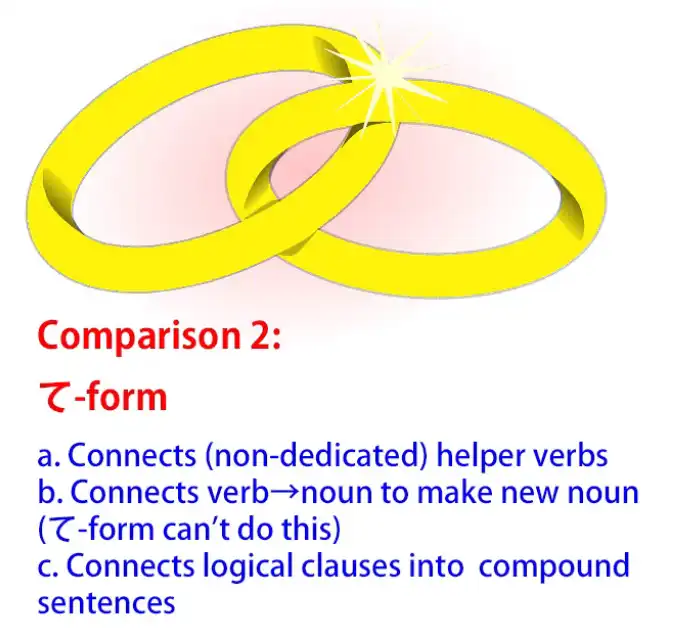
連用形 giving noun-form of verbs (verb clauses)
But the い-stem doesn’t stop there.
It can do one other thing which is very important.
It gives us the noun-form of verbs.
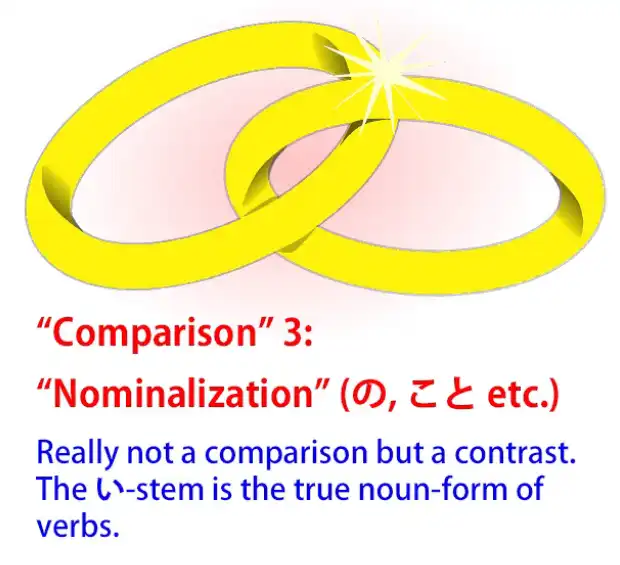
We’ve talked before about what’s sometimes called nominalizing verbs, that’s to say using the の or -こと or some other means to bundle something verbal into a noun.
Now, this isn’t really nominalizing verbs, which is why I tend to avoid that terminology, because what we’re actually doing here is not turning a verb into a noun but turning an entire verb-clause into some kind of a noun.
We’re not actually turning it into a noun.
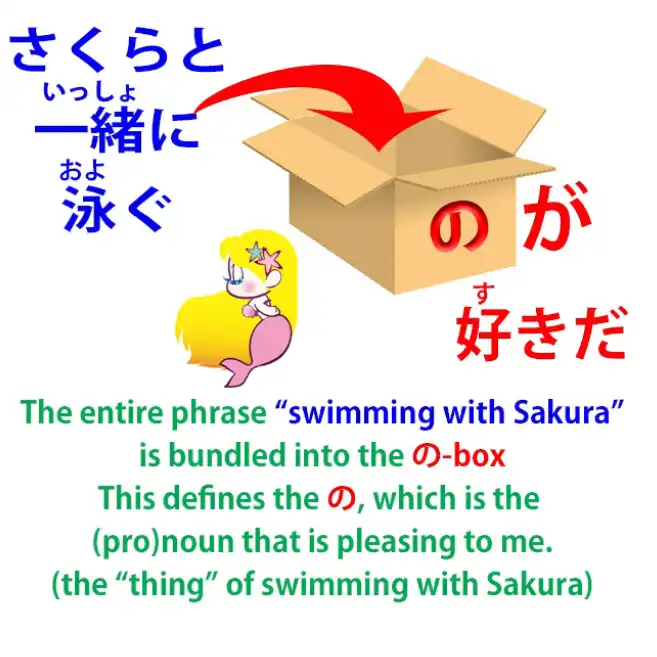
What we’re doing is bundling it into a box created by a pronoun like の or -こと, and I’ve talked in various places about putting verb-clauses into a の-box or into a こと-box.
In some cases, of course, we may also be bundling into that pronoun literally a single verb, so if we say “泳ぐのが好きだ”, we’re saying “I like swimming”, and that means “I like the activity of swimming”.
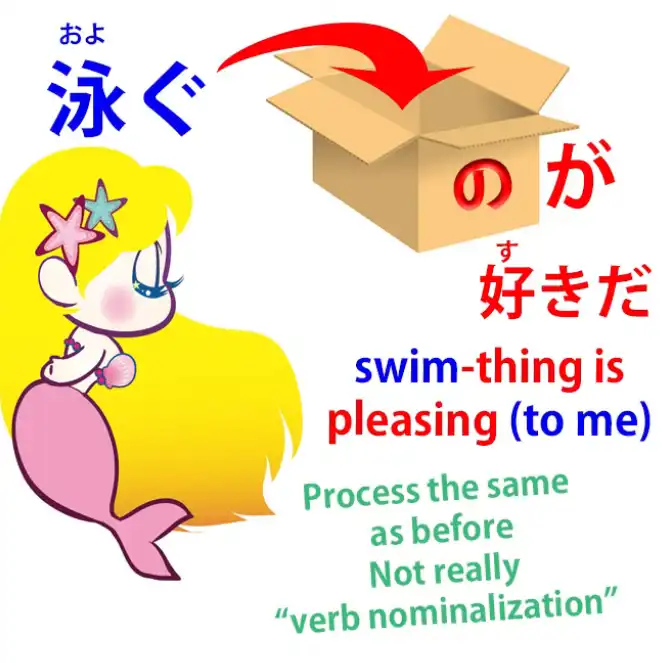
But, again, this isn’t what the い-stem does.
What the い-stem does is give us the true noun-form of a verb.
And in English it’s usually represented by the unchanged verb, so that the verb-form and the noun-form are identical in English.
In Japanese they’re not identical.
In Japanese we have the base-form, the う-ending form, of the verb for verb and for the noun-form we have the い-stem.
So, let’s take an example so you know what I’m talking about here.
In English we have “rest”, the word “rest”, which can be a verb or a noun.
We use the verb “rest” when we say “I need to rest”.
We use the noun “rest” when we say “I need a rest”.
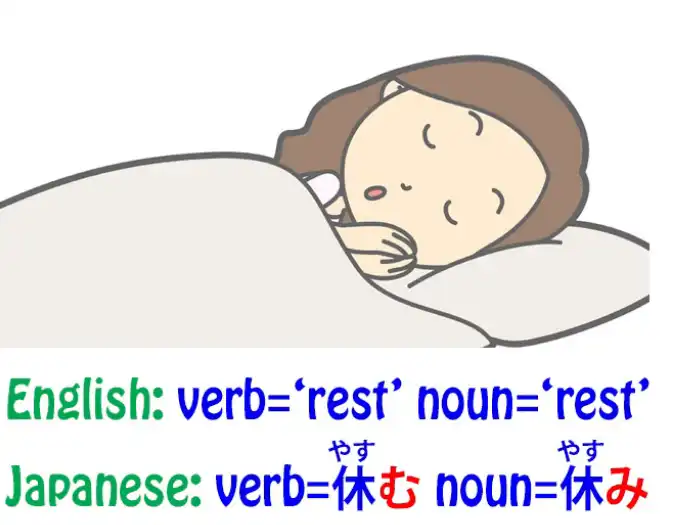
So, if we take the verb “休む” in Japanese as a kind of rough equivalent to “rest” in English, we have “休む”, which is the verb “rest”, and “休み”, which is the noun “rest”.
So, “休む” is the action of resting, the verb “rest”; “休み” is “a rest”, the noun “rest”.
And we use this both on its own and in compounds like “夏休み”, which means “summer vacation” or “summer break”.
And, we see, we wouldn’t call it the “summer rest” in English, but that’s because, as we’ve discussed before, it’s very rare for a Japanese word to cover exactly the same area of the meaning spectrum as an English word.
So the word “休み” can mean “rest” literally as in lying down, taking a rest; it can mean being off school or off work because you’re sick; it can mean a vacation, like “夏休み”.
But the point is that the verb-form is “休む”, the noun-form is “休み”.
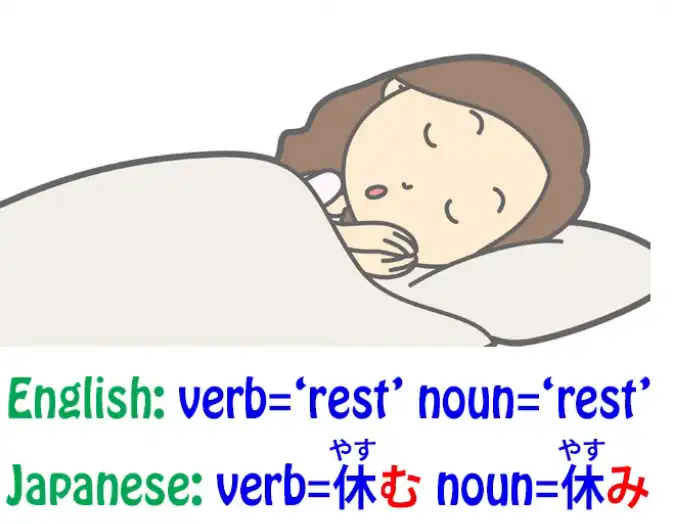
And just about any verb that can have, logically, a noun-form will have that noun-form represented by the い-stem of the verb.
And very often these will be the same thing in English; sometimes they will be different.
So, for example, “痛む” means “hurt”; “痛み” means “pain”.
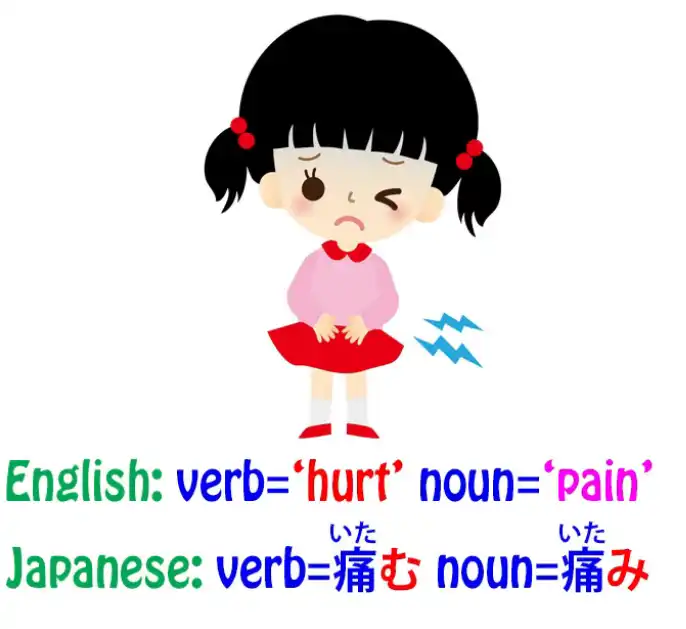
Again, we have the noun-form of “hurt”, which is “pain”.
And this is very important because not only does it give us this whole range of verb-formed nouns, but also it plays a role in other structures which are very rarely explained by the textbooks.
So if we say, for example, “お店にパンを買いに行く” or “公園に遊びに行く”,
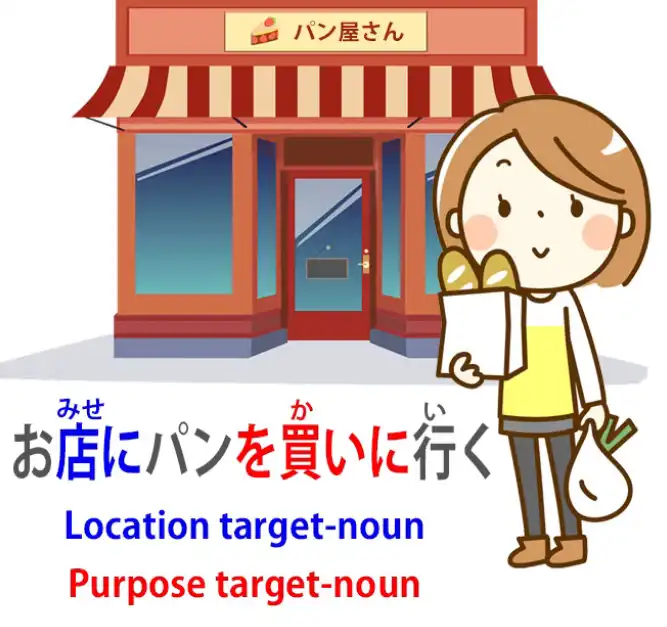
what do we mean by the い-stem of “買う”, which is “買い”, or the い-stem of “遊ぶ”, which is “遊び”?
What we mean is the noun, so when we say “公園に遊びに行く”, we’re marking the locational target of the place we’re going – we’re going to the park, “公園” – and then we’re stating our purpose. – Our purpose is the thing of playing, the thing of having fun, and that is “遊び”.
So literally we’re saying “I’m going to the park for play”.
If we say “お店にパンを買いに行く”, we’re saying “I’m going to the shops for bread-buying”.
This is how these are structured, and I think very few textbooks actually ever explain that what we’re using here is the noun-form of the verb.
And that’s important, because as I taught in our lesson on the logical particles (Lesson 8b), the five main logical particles can only be attached to nouns. (が, を, の, に, へ, で) Note: Just like Dolly remarks in Lesson 8b, の is also part of the logical particles, So if it’s not explained that the “遊び” here and the “買い” here are nouns, I’m not sure what most learners think the structure actually is.
And we’ll find in various structures that the noun-form of a verb is used and the structure only really makes sense if we understand that it is the noun-form of the verb.
So here we have the い-stem.
It’s the Great Connector and it’s also the fundamental noun-of-a-verb-forming stem.
So it has a very wide range of applications.
It does all the kinds of things a regular stem can do, it does all the kinds of things that て-form can do, and it creates nouns out of verbs to be used as regular nouns like “痛み” (pain) or “休み” (a rest/some rest) and also for deeper structures like “遊びに行く” (going for play, going for the activity of play).
If you have any questions or comments (again, it’s a good idea to read video comments after), please put them in the Comments below and I will answer as usual.
I’d like to thank my Gold Kokeshi patrons
and all of my patrons and supporters on Patreon and everywhere,
who make all of this possible.
Note: In the comments, there is this rather interesting comment by one shary0 about て-form.
If anyone wants to read up on い-stem in a more “text-booky” language - here is the source link.
Also, check this comment discussion under this video.
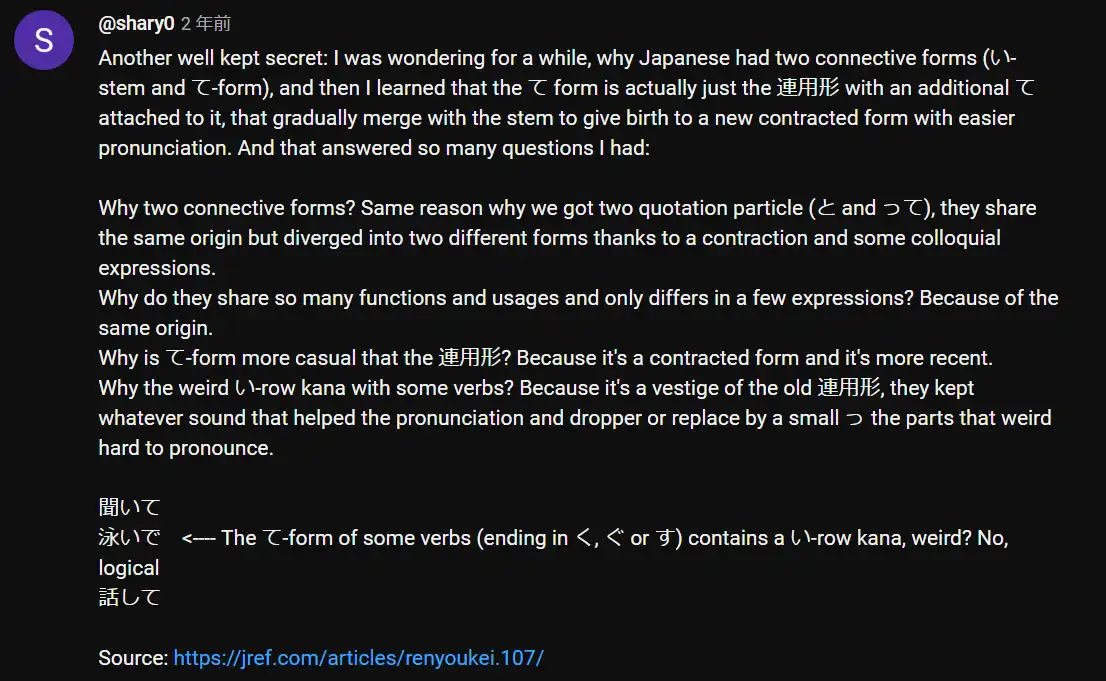
73. Secrets of 気: 気になる, 気にする, 気がする, 気に入る etc.
Secrets of 気 Ki - ki ni naru, ki ni suru, ki ga suru, ki ni iru etc. 気になる、気にする、気がする、気に入る - Lesson 73
こんにちは。 Today we’re going to talk about the word “気” and various expressions that incorporate it, like “気にする”, “気がする”, “気になる”, “気に入る” and so forth.
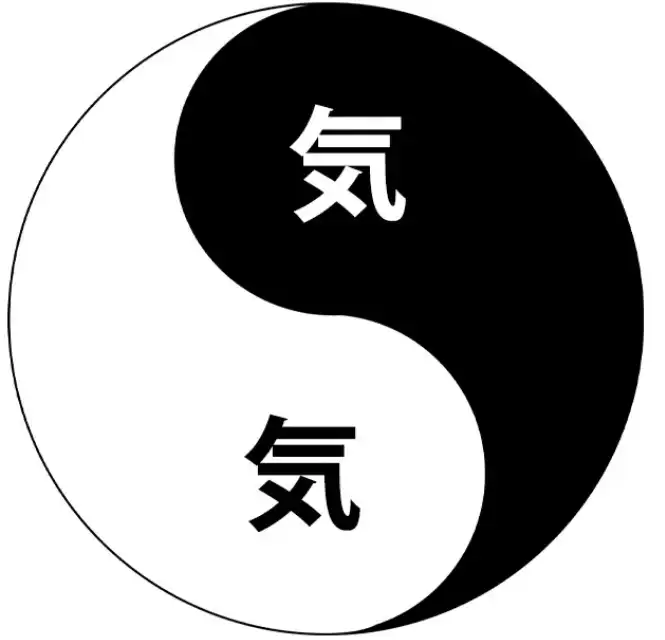
Now, people often find these confusing and difficult to work out exactly how it is that they’re structured, how it is that they work, how we should use them.
And there are two reasons for this.
The first is that we need to understand what “気” really means.
And the second is that we need a very firm grip on the logical particles if we’re going to differentiate things like “気にする”, “気になる”, “気がする”, from each other.
And of course if you learn conventional textbook Japanese, a firm grasp on the unchanging nature of the logical particles is exactly what you don’t have, because if you are taught things like “コーヒーが好きだ” means “I like coffee”, you never really understand what the unchanging nature of the が-particle, for example, is.
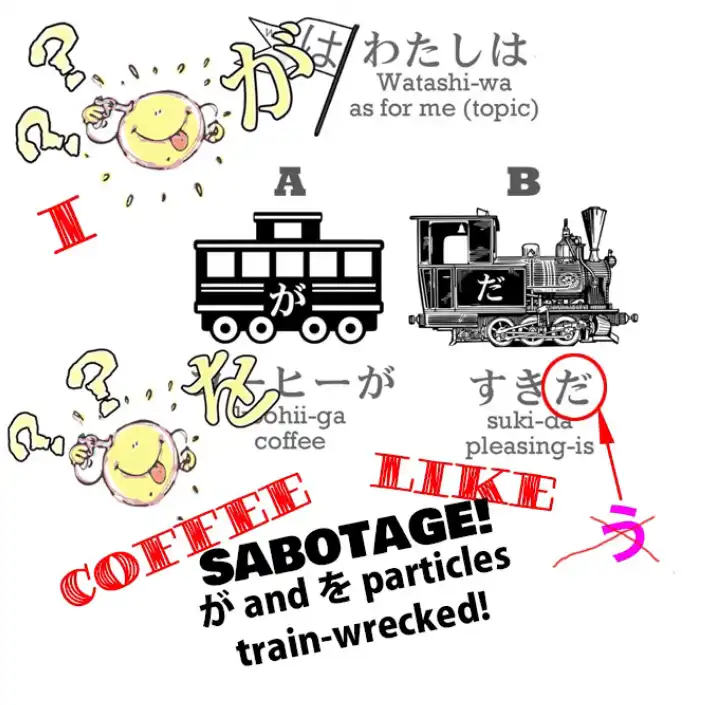
And if you do have any doubts about the nature of the five main logical particles, I do recommend that you watch this video on the subject (Lesson 8b), because it is the very foundation of Japanese.
If you’re fuzzy about the logical particles, then you’re fuzzy about Japanese, period.
All right. So what is “気”?
“気” comes from Chinese.
Note: Dolly erred here, 気 is not used in 太極. Luckily, one “nleseul” clears it up, kudos to them.
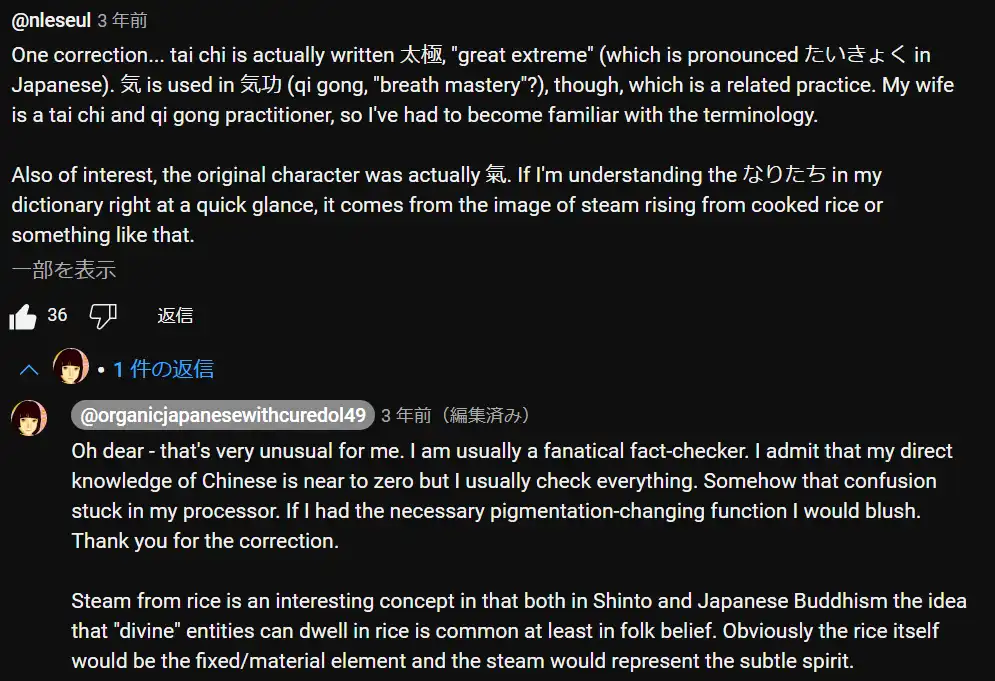
It’s a Daoist concept and probably goes back to a time before what we now know as Daoism.
To this day the concept is used in Chinese medicine, Chinese and Japanese martial arts, and other areas.

What it is is the fundamental spirit of fluid energy in a person or something else.
Originally it was associated with breath, and in many languages, “breath” and “spirit” are in fact the same word.
Latin “spiritus”, Greek “pneuma”, Hebrew “ruach”, Sanskrit “atma”: all mean both breath and spirit.
Now, the breath meaning of “気” is no longer active, but it’s still this flowing spirit principle within a person.
If we look at the kanji, interestingly, this part of it 气 (Radical 84) (which is also pronounced “き”) means steam or vapor.
So, a “汽車” is a steam engine.
And then we have this “メ”, as it were, and here “メ” really “marks the spot”. (気)
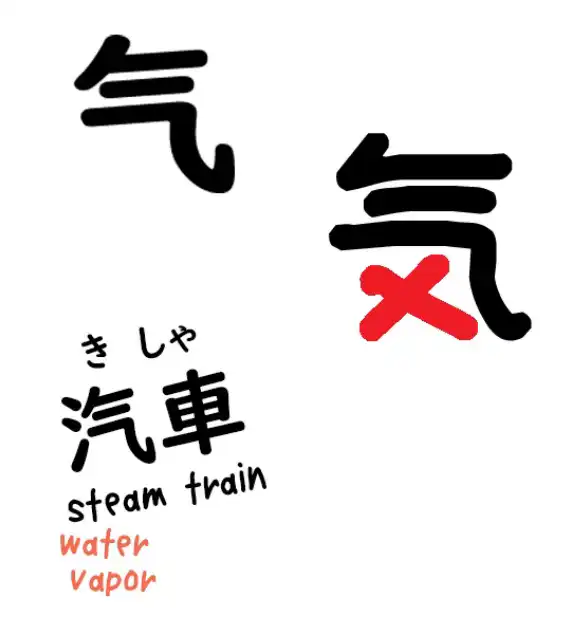
We have the fixed cross portion and we have the fluid, vaporous portion.
And both of those aspects of “気” are important, and you can never entirely separate the two, although we can move from the fixed end of the scale to the fluid end of the scale.
So, to give examples of those two ends of the scale, let’s take two expressions that you almost certainly know.
The first is “元気”, the second is “やる気”.
Now, “元気”, as you know, is vigor or health.
The “元” means original, fundamental.
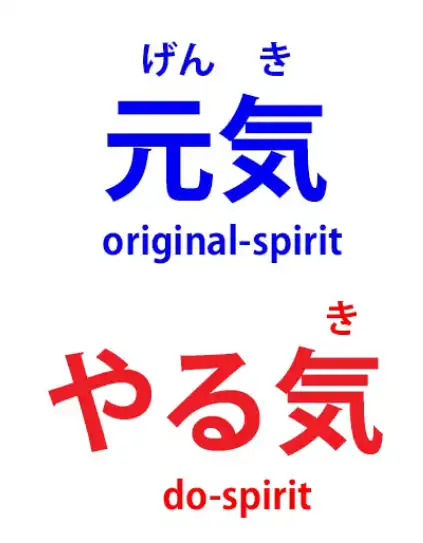
So, one’s original “気” is healthy and vigorous.
If something goes wrong, we may become “病気” (sick or dispirited).
And our aim is then to return our “気” to its original healthy and vigorous state, to restore our “元気”.
“やる気” is the will to do something.
So it’s the do-spirit, get-up-and-go-spirit.
And this kind of “気” is not our basic “気” that in a sense remains constant within us.
It’s a particular “気”, the “気” to do a particular thing.
So we might say “海外で勉強する気がある”

And what we’re saying here is that a particular “気” exists in us that is the “気” to study abroad.
So in this sense “気” is the will or inclination to do a particular thing.
When we say “気を付ける”, this literally means attach or stick your spirit.

So if someone said “階段に気を付ける”, what they’re literally saying is “attach your spirit to the staircase”.
Now, what we’d say in English is “watch out for the staircase” or “take care on the staircase”.
Attach your spirit, your consciousness, your feelings, your thoughts, to the staircase; pay attention to it; take care.
And it may not be a particular thing.
Very often people say “気を付けて” (attach your spirit).
And this is not attach it to any particular thing, but attach it to whatever it’s appropriate to attach it to; have situational awareness, as one might say in a more modern jargon; take care.
気になる & 気にする
Now, when we get on to things like “気になる” and “気にする” – we’ve dealt in a previous lesson with “になる” and “にする”. (not sure, possibly Lesson 8 & 18)
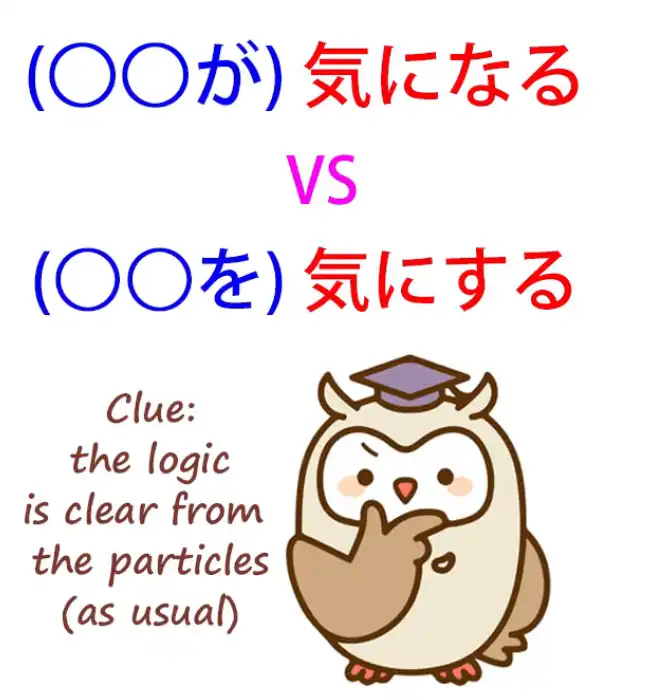
So, for example, if we say “さくらがカエルになる”, we’re saying Sakura turns into a frog.

If we say “魔女がさくらをカエルにする”, we’re saying that a witch turns Sakura into a frog.
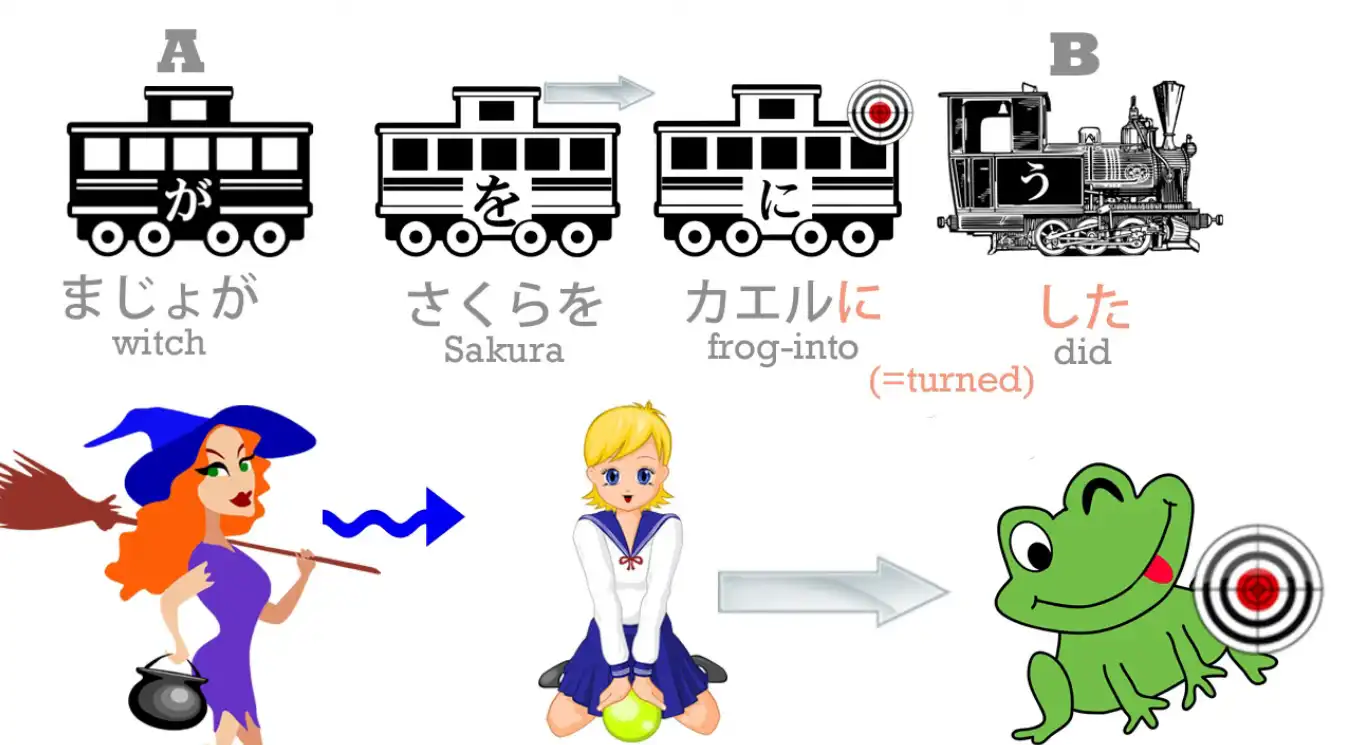
And of course we know who is doing what because of the logical particles.
So what does it mean when we talk about “気になる” and “気にする”?

We’re saying that something becomes our spirit. What would we mean by that?
Well, to understand that we need to understand something else.
We need to understand that becoming a feeling, an emotion, the expression of emotion, is something that we do in Japanese.
We don’t do it in English.
So, for example, in AKB48’s song “Heavy Rotation” we have the line: “こんな気持ちになれるって僕はついているね” And this means “That I could become this feeling, I’m lucky, aren’t I?” Now, in English we don’t talk about “becoming” a feeling, but in Japanese we do talk about that.
And I think this is somewhat connected with the concept of “気” and also with the Buddhist idea that there really is no self.
What we are is not a fixed and absolute thing.
The self is essentially a shifting congeries of actions and reactions, feelings and sensations.
And so we may temporarily become a particular feeling.
You may even become, in Japanese, the expression of a feeling.
We may say “深刻な表情になる” – someone became a grave or concerned face.
For that moment, the whole person transformed into that expression of gravity and concern.
Now, this is what we’re saying when we say “気になる” and “気にする”.
If we say “あの人は気になる”, we’re saying that person turns into my spirit.

My spirit is remolded, as it were, a certain part of it, for a certain period, into the form or shape of that person.
What does that mean? It means that that person is, as we would say in English, occupying my feelings.
Now, this can mean a variety of things.
It can mean that we’re concerned or worried about that person.
It can mean that that person intrigues us.
It can mean that we feel there’s some mystery about that person.
Or whatever it is, that person is occupying our feelings, our sensations, our thoughts; in Japanese, is becoming our feelings, our sensations, our thoughts, our “気”.
Now, an important thing to notice here is that we tend to see in grammar books and dictionaries “‘気になる’ means this”, “‘気にする’ means that”, but the important thing to understand is that “気になる” on its own doesn’t mean anything. Neither does “気にする”.
“気になる” is the tail-end of a complete logical clause.
“なる” is the engine, “気に” is telling us more about the engine.
The A-car in the case of “気になる” is whatever it is that’s occupying our thoughts, whatever it is that’s turning into our spirit.
So in this case “あの人” is the A-car and what we’re saying about that person, what that person is doing, is turning into our spirit.
Now, when we take “気にする”, we say “あの人を気にする”.
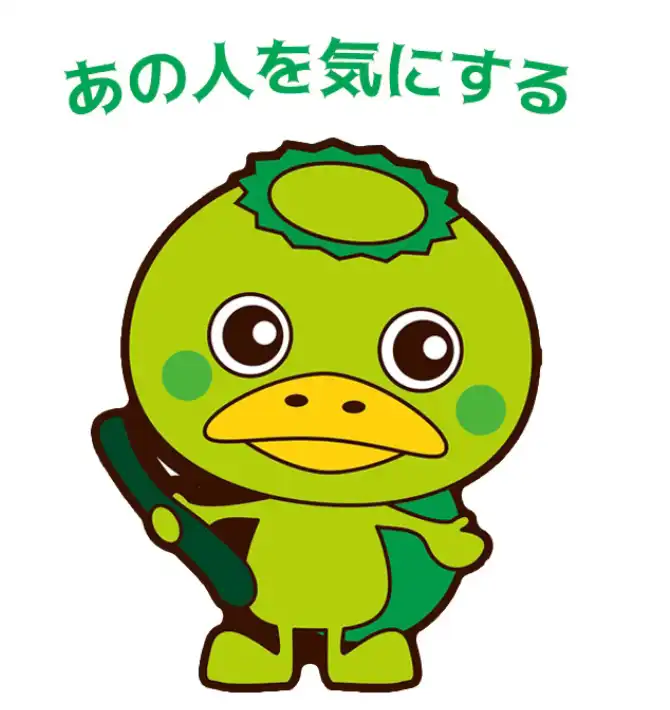
So now the doer of the action is not that person; the doer of the action is me.
I am turning that person into my spirit.
I am being concerned about that person.
And that has two implications.
One is that in a sense we’re doing violence to our spirit.
It’s not just our spirit naturally becoming that person – we are making it so.
And that tends to give it a slightly more negative meaning.
While “気になる” can occupy a whole spectrum of meaning from being intrigued to being worried, “気にする” usually means worried.
Now, the other implication it has is that we’re in control of it.
Our spirit isn’t simply turning into that person.
We are turning our spirit into that person.
And that’s why you often hear people say “気にしないで” (don’t turn it into your spirit).
It wouldn’t make any sense to say “気にならないで”, because you aren’t making anything happen.
Your spirit’s simply turning into it.
But “気にしないで” is telling you to control something that you have control over: “Don’t turn it into your spirit; don’t worry about it; don’t be concerned.” Now, we have “気にする” and “気になる”.
気がする
What about “気がする”?
Again, the particle gives us the clue to what’s going on.
When we say “気がする”, it’s the “気”, the spirit itself, that’s acting.
It’s not something becoming our spirit, it’s not us turning something into our spirit.
It’s our spirit doing something or a certain aspect of our spirit acting (“する”, do or act).
How do we understand this?
Well, again we need to understand something else in Japanese before we can properly understand this.
When we use expressions like “いい匂いがする” or “綺麗な音がする”, what we’re saying is “There’s a good smell”, “There’s a pretty sound / a pretty sound happened / a pretty sound acted”.
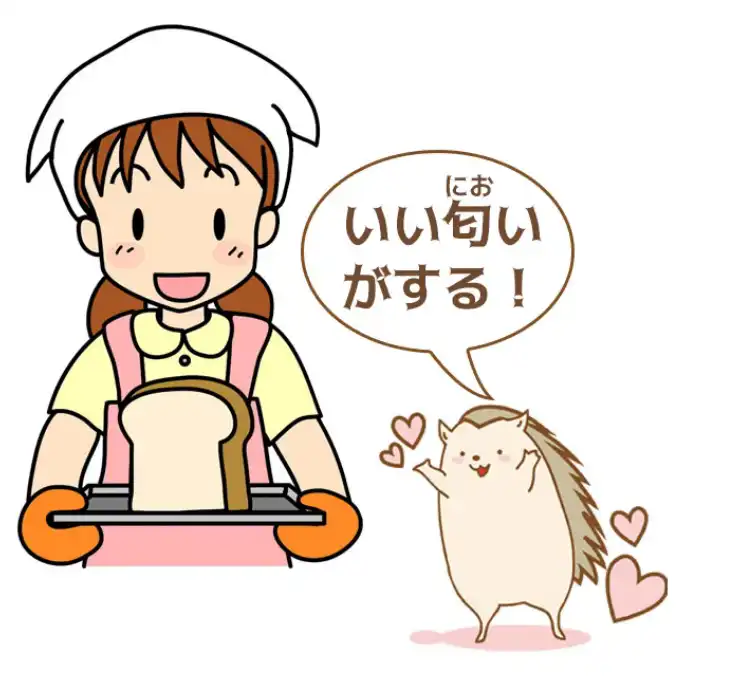
What we mean by “する” in the case of a smell or a sound is the only thing a smell or a sound can do: a smell smells and a sound sounds.
When we say “匂いがする”, we’re saying that a smell acts, a smell is active, I can detect a smell.
“音がする”: a sound acts, a sound is active, I can detect a sound.
When we say “気がする”, we’re saying a certain spirit, a certain thought, a certain consciousness is active, I can detect that consciousness, I can detect that feeling.
So, if we say “騙されているような気がする”, we’re saying “I’ve got a feeling we’re being deceived, I’ve got a feeling we’re being tricked” – such a “気”, such a feeling, is active.

If we say “強くなった気がする”, we’re saying “I feel that I got stronger, I sense that I got stronger” – that spirit, that inclination of the emotions, of the thoughts, is active in the same way that a smell is active or a noise is active.
気に入る
Now, one last one that I think is more confusing than the others because essentially it uses a word in an uncommon way is “気にいる”.
If we say “それを気に入る”, we’re saying “I like that”.
Note: それが気に入る is also possible. As Dolly gives with これを気に入る.
Now, what we’re really saying is that I’m letting that into my soul.
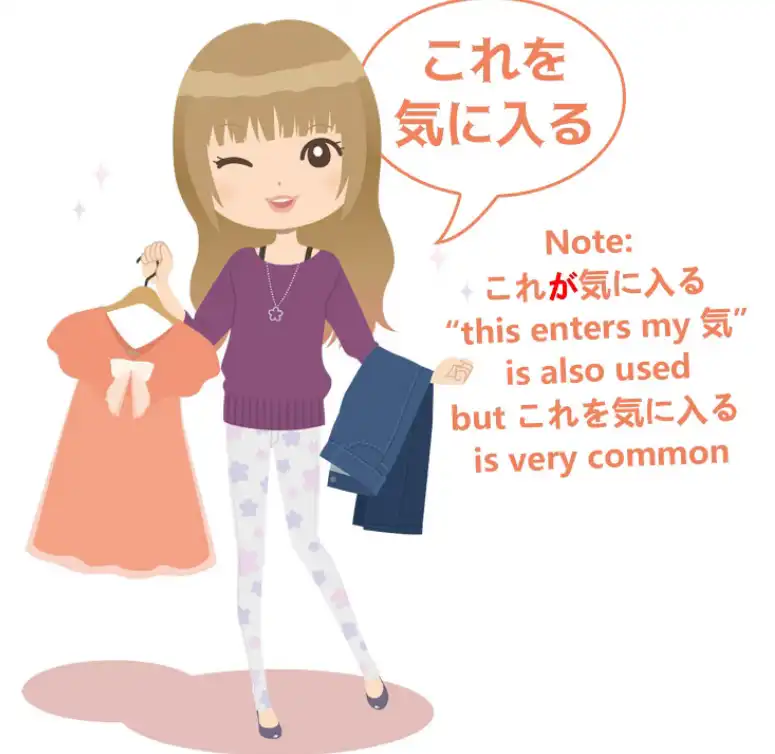
What’s confusing here is that “入る/いる” is not being used in its normal way.
“入る” usually means to enter or come in.
And if we’re talking about putting something into something, we say “入れる”.
But in this case, “入る”, probably because it’s an older usage that’s cemented into the language in this particular very common phrase, “入る” actually means allow into one’s spirit.
So, the one who is doing “気に入る” is oneself.
And we know that is the case because that’s the way the particles are working.
We can always trust the particles.
If the particles are saying one thing and the form of the word is saying another, we can be confident in every case that the particles know what they’re talking about and the word may have changed its meaning over time.
“気に入る” is something you’ll hear on various occasions, and a particular characteristic of this is that it’s much easier to use it about other people than things like “欲しい” or “好き”.
This is not to say that we can baldly state what other people like and what they don’t like, even using “気に入る”, but if we’re going to talk about other people’s feelings, ask them about their feelings, suggest what their feelings might be, “気に入る” is much politer than using terms like “たい” or “好き” or “欲しい”.
So you’ll very often see “気に入る” in references to other people’s feelings
as well as to one’s own.
So, I hope this makes the whole “気” usage a little clearer…
Note: The Buddhist concept of “non-self” may be a good study to see how Japanese works.

74. LOVE and other mysteries of こと! あなたのことが好き, 私のことが嫌い, ということ, そういうこと, どういうこと, そんなこと
LOVE and other mysteries of KOTO! あなたのことが好き、私のことが嫌い、ということ、そういうこと、どういうこと、そんなこと - Lesson 74
こんにちは。 Today we’re going to talk about some of the mysteries of the word “こと”.
And this can indeed be very mysterious to foreign learners, because some meanings really can’t be translated into English or other languages.

We can understand them, but we have to understand them as Japanese concepts.
One example is when we encounter expressions like “あなたのことが好きだ”.
あなたのことが好きだ
Now, I think we all know what this means in phrase-book terms.
It means, more or less, “I love you”.
It’s not in fact how we would say the exact phrase “I love you” in Japanese, which would be “愛してる”, and that’s an expression that, while it technically means “I love you”, almost nobody ever uses it in Japanese.

“あなたのことが好きだ” is fairly understandable if it were just “あなたが好きだ” (“I like you”), but actually what we’re saying is that I like your “こと”.
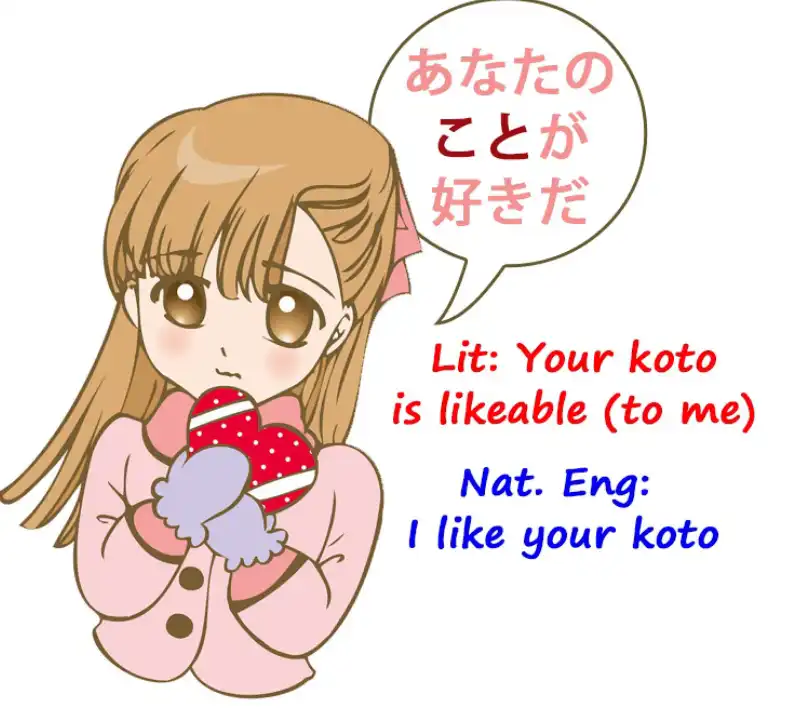
Now what does that really mean?
Probably the best way to translate it is to say “I like things about you” or “I like the thing about you”.
In practice it implies that I like things like your laugh, the twinkle in your eyes, the way you walk, the way you drink your coffee, your funny little blue hat, and the implication is that you’ve become familiar by observation or proximity with various things about the person and that this has gradually accumulated into feelings of love.

Now, you can’t say that in English without writing a little essay or a song to somebody, but in Japanese it’s all encapsulated in that “こと”.
So what we could say is that “こと” is very, very agile, more agile than most agile words in Japanese.
And the concept of linguistic agility is very, very important and completely neglected in most language teaching.
What we can say in an agile way isn’t just a matter of convenience.
It deeply affects how we express ourselves and what we’re likely to actually say.
Things that can be said in an agile way in a particular language are the things we’re most likely to actually express and express regularly.
Conversely, the things that a culture particularly wishes to express are the things that become agile in a language.
So, if you want to learn more about agility, please watch my video on the subject (Lesson 56).
The use of “koto” here is less direct, as textbooks sometimes say.
It’s not just a question of being less direct. It avoids any sense of direct physicality and it tends to give this whole implication of the gradual blossoming of love through the understanding of things about a person.
This is something that Japanese wants to express commonly enough that it has made it a very agile thing to express.
私のことが嫌い
Now, similarly, we may say things like “(zeroは)私のことが嫌いらしい” (“that person, or those people, appear to find my ‘こと’ dislikeable”).
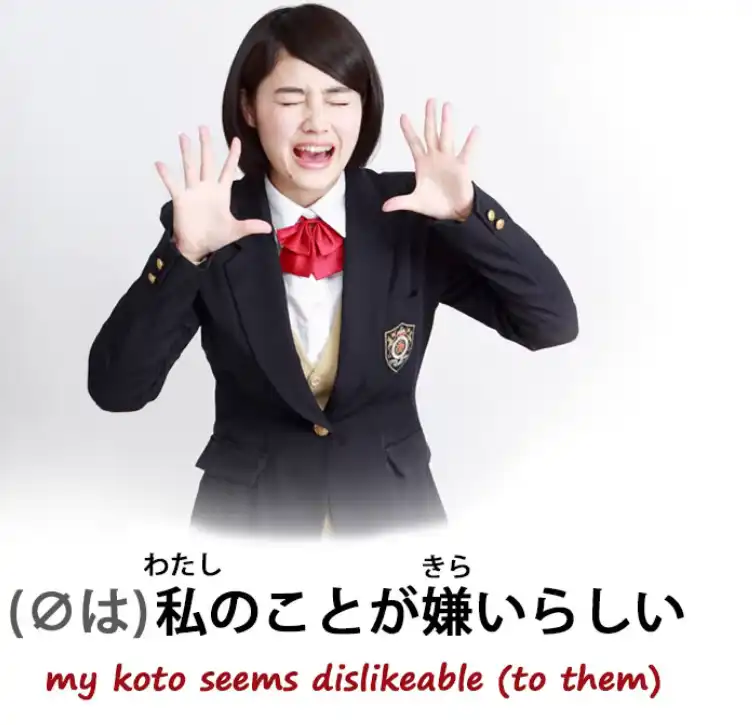
Why would we say that?
Well, a lot of the reason, I think, is connected with the way of thinking that also means that
we can’t directly express someone else’s emotions,
which of course is an actual fact that European languages tend to overlook:
the fact that we never actually do know someone else’s feelings or emotions.
Similarly, no one actually knows anybody else directly. We can’t really know another person.
We can’t know the depths of their being. I’m sure many people watching this assume that
I’m a human being pretending to be an android.
This is how little we can know about any other being.
So when we’re talking about something deeper that affects our emotions rather than simple acquaintance with a person, it really makes no sense talking about them being reactions to us.
They’re not reactions to us; they’re not reactions to our actual being.
They’re reactions to what they have observed about our conduct, our appearance, our words.
And that, our “こと”, is what they may either like or dislike.
Now, where there isn’t a cultural factor, “こと” can in some circumstances be much easier to translate and understand.

So, for example, if we say “田中さんのこと” and we don’t have any particular affection for Tanaka-san, this translates most of the time fairly easily into things like “the matter of Tanaka-san / the affair concerning Tanaka-san” or just “the fact that Tanaka-san is a bit of an awkward person to deal with”.
What we actually mean by “田中さんのこと” will depend on what the hearer knows about the history of ourselves and Mr. Tanaka.
So this really isn’t very difficult at all.
どういうこと, そういうこと & ということ
But a lot of people have asked me to explain expressions like “どういうこと” and “そういうこと”, and I’ve touched on these before (Lesson 20), so I’ll just go over this a little.
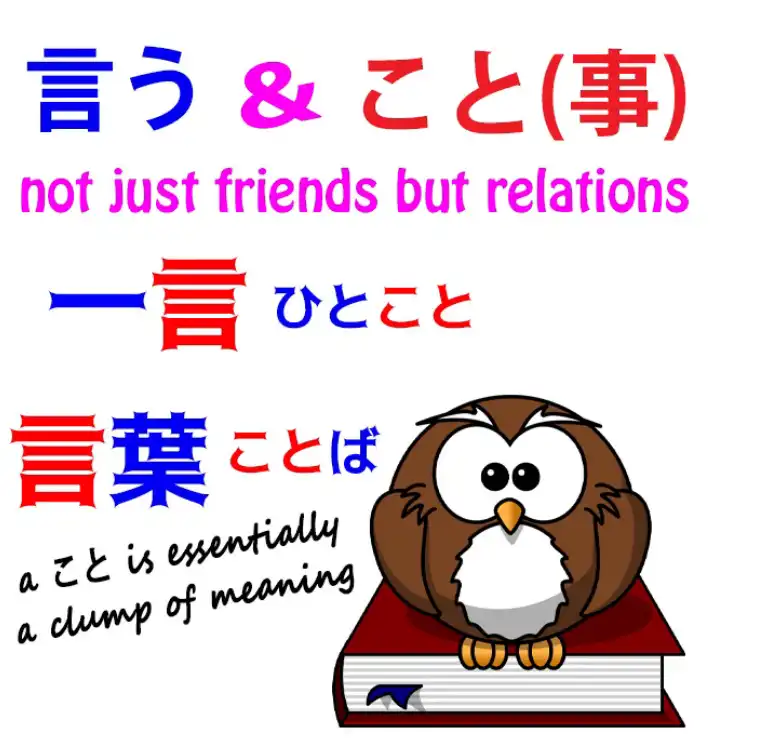
“言う/いう” and “こと” in a way belong together, because a “こと” is a situation, a circumstance, by implication something that actually requires a bit of explanation.
And the idea of explanation, the idea of expression, and the idea of a “こと”, I think, have always been very close in Japanese.
That’s why the kun-reading of the kanji that we use in “言う”,
the other kun-reading, the one when it’s a noun, is “こと”. It’s not the same “こと”,
Note: Just in case, the Kanji 言 in Kun-yomi can be read as “い” or as “こと”, latter of which is usually when it is a noun. In そう言う事, the koto is the 事 Kanji, different one to the 言 - こと.
but as we know if we know much about Japanese and kanji,
there are often alternative kanji for the same word.
Now, these aren’t quite the same word, but they are related.
And this is why we’re always getting expressions like “そういうこと”, “どういうこと”, “ということ”, because a “こと” is something said, something explained, a situation that requires words.
So the question “どういうこと” is one that we often hear.
It means, in a way, “what kind of こと?”
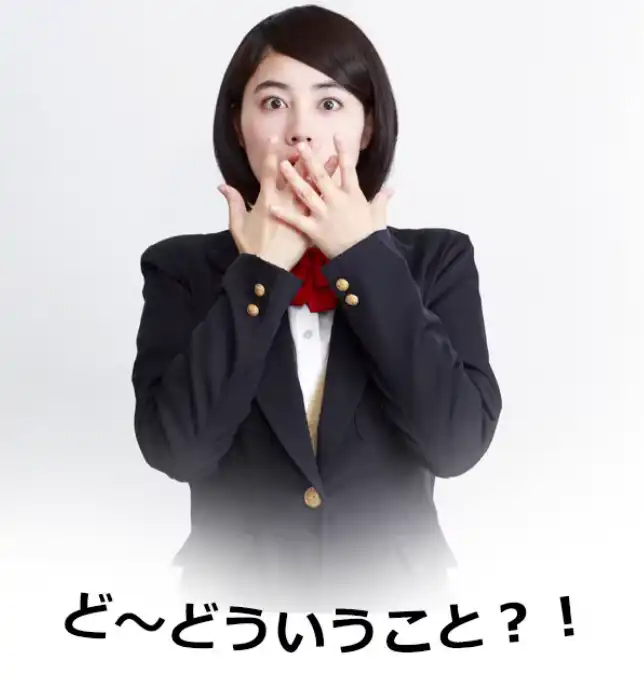
And “what kind of…”, we’re taught in Genki and other textbooks, is “どんな” in Japanese, and indeed it is, but we tend to use “どういう” more often in cases where either more explanation might be required or where the explanation would be perhaps a little less expected.
So, for example, when a character finds herself in a strange situation or simply doesn’t know what’s going on because it’s all very strange and unexpected, she’s very likely to say “どういうこと” – “what kind of a thing is this?
In what way explained a situation is taking place or has taken place here?” Similarly, when Katrielle Layton solves the case, she says “そういうことでした” (“So that’s how the situation was explained”).
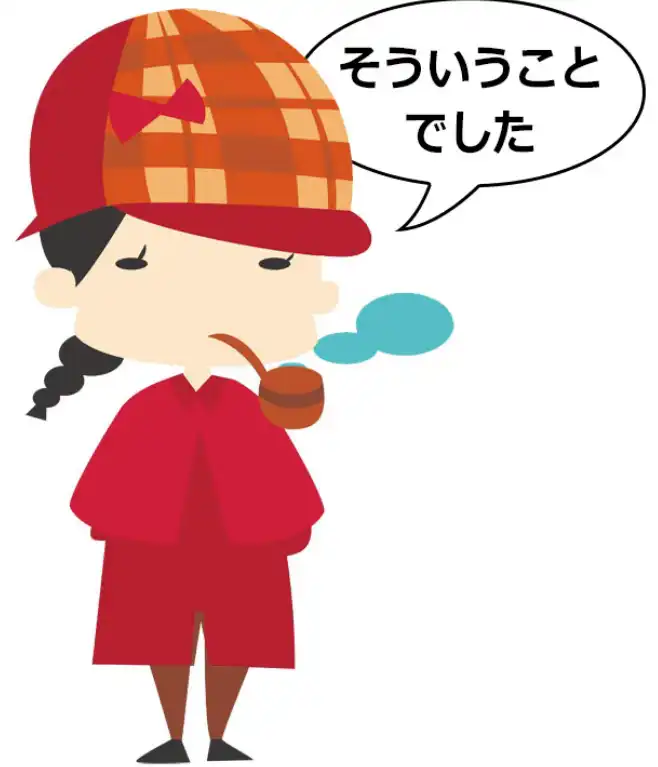
And it’s thrown into the past tense because the idea is that she has solved a mystery that is a standing mystery, in other words, this was the explanation all along and she’s just discovered it.
Now, “そういうこと” or “どういうこと” doesn’t have to be something particularly recondite or difficult, but it tends to imply a greater depth of needed explanation than a simple “どんな”.
そんなこと
On the other hand we do also have “どんな”’s partner “そんな” frequently used with “こと”, and in these cases the implication is often that while the “こと” is relatively easily understood or explained, we have some kind of a negative reaction to it.

Now, that could be denial or it could be protest or disappointment.
So, for example, if somebody praises us, you may say “そんなことがない” (“that’s not true!”), because in Japanese it’s polite to reject praise.
And this is so frequent that it’s often reduced simply to “そんなこと” or even just “そんな、そんな”.
So, we’re saying that what you’ve said, this situation which you’re describing about me, is not the case: I’m not worthy of this praise.
And we’ll also often hear characters or people saying simply “そんなこと” or just “そんな” and the implication of this is that what is happening is very unsatisfactory or that what someone has said was a bad or unkind thing to say.

So, “そんなこと”, or more often “そんな”, represents a negative reaction to the situation.
And it’s interesting in that clearly it’s an unfinished sentence.
You were going to say something about the “そんなこと”.
But unlike many Japanese unfinished sentences, this one, this “そんな” of protest, is so lodged into the language that it’s actually difficult to finish the sentence.
It’s actually difficult to say what the person might have said if they had finished the sentence, because it’s almost never finished.
“そんな!” has evolved into a protest against the dreadfulness of something all by itself…
75. Japanese is NOT English: How expression strategies differ - polite 英本語=rude Japanese
Japanese is NOT English: How expression strategies differ - polite Eihongo=rude Japanese - Lesson 75
こんにちは。 Today we’re going to talk about expression strategies in Japanese that are so different from their English equivalents that they can cause great difficulty once we get into the real world of Japanese.
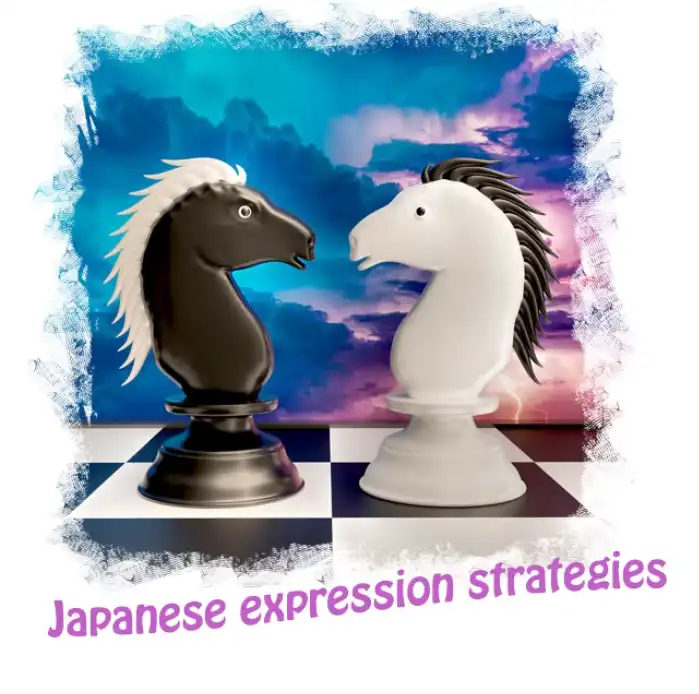
And this difficulty is made much worse by the way Japanese is taught in conventional textbooks and websites and the whole “英本語” Japanese model, which teaches Japanese essentially by pretending that it’s much more like English than it is and “dumbing down” Japanese expressions into 英本語-type equivalents.
So, let’s start with one of the things that causes the most difficulty because it’s something that’s really fundamental to English and doesn’t exist in Japanese.
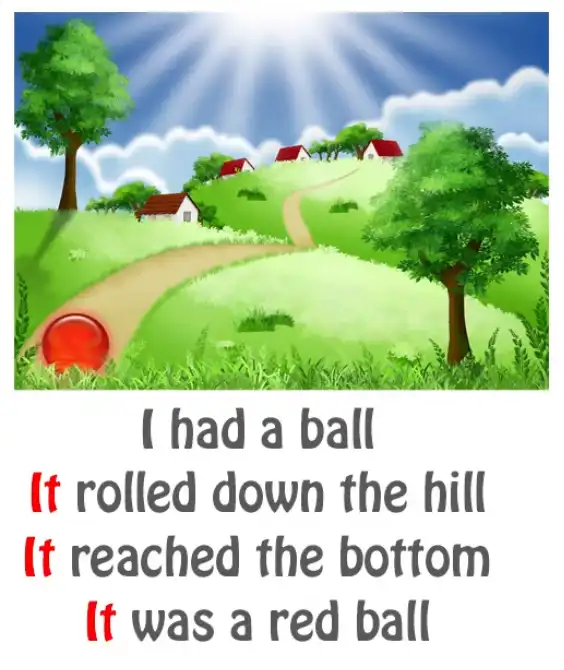
And that is, pronouns. In English, we can’t get through a moderately complex sentence without using pronouns like “it”.
If we’re talking about any kind of an object, from the Andromeda galaxy to an insect, even a moderately complex passage about it is going to contain “it” over and over again.
And this is not how Japanese works. In fact, I’m going to say something that may seem unduly radical. I’m going to say that Japanese doesn’t have simple pronouns at all, not in the sense that they’re understood in English and other European languages. Now, that may seem a bit extreme, but let me explain what I mean.
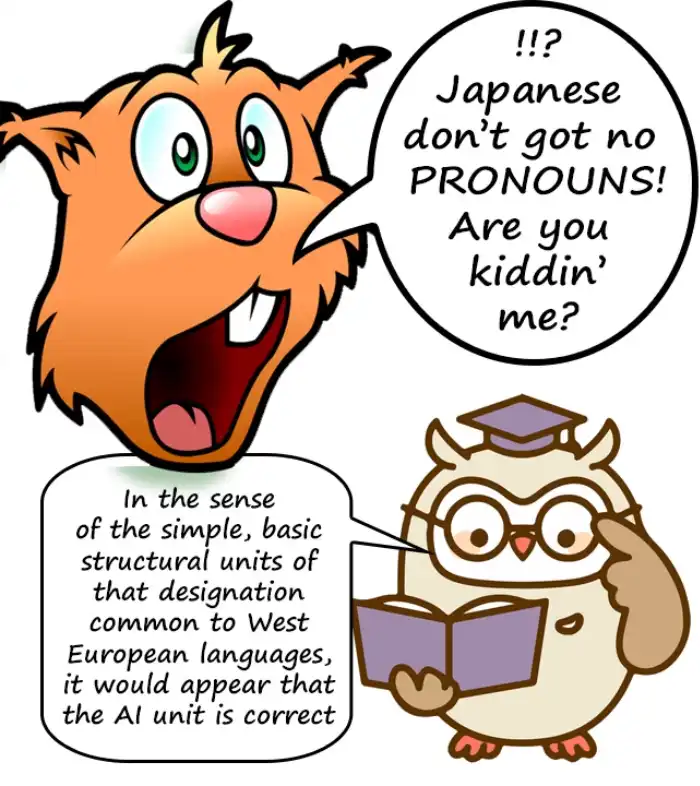
Pronouns “it”, “I” and “you” in Japanese
First of all, let’s take the most basic pronoun, “it”. There is no equivalent word in Japanese to “it”. Nowhere in Japanese can you find anything that corresponds to “it” except zero.
The only way to say what we mean when we say simply “it” in English is to say nothing or write nothing: to use the zero pronoun.
Now, you may say that while we accept this, surely there are in fact pronouns.
After all, most textbooks start off with the pronoun “私”.
Almost every basic sentence in a basic textbook is “私 this, 私 that, 私 the other”.
And the ones that aren’t are “あなた this, あなた that, and あなた the other”.
So, doesn’t Japanese at least have the basic pronouns “you” and “I”? And the answer to that is “No, not in the European sense.” In the European languages, there is always one basic, simple pronoun that means “I”.
It is the ego-pronoun: “I” in English, “ich” in German, “je” in French, “yo” in Spanish.
There is no equivalent to this in Japanese.
There are many ways to say “I”: 私, 僕, 俺, あたい, わがはい.
All of them are in fact roundabout ways of referring to oneself.
When referring to the person you’re speaking to, you can say “あなた”.
You can also say: お前, 手前, きさま, 君, and various other things.
In other words, this basic personal pronoun doesn’t really exist.
And although we can identify “私” and “あなた” as the most basic of them, it still isn’t the same as a European personal pronoun.
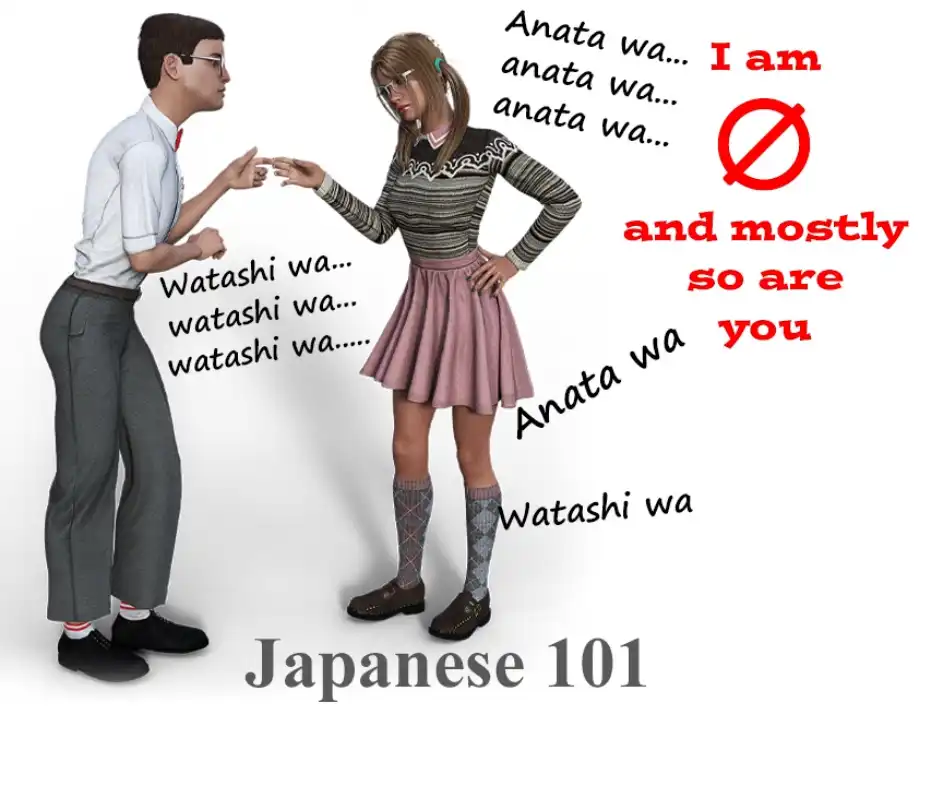
Most of the time we don’t use it. All this “私 this, 私 that, 私 the other” in the textbooks is ridiculously unnatural. Unless we’re trying to stress a particular point, we don’t say this.
The usual word for “I” is zero. The usual word for “you” is either zero or the person’s name.
None of the words for “you” that I’ve cited above, including “あなた”, are used all that often because among other things they’re just not very polite.
And it’s one of the remarkable things about the textbooks which cause enormous damage to people’s understanding and grasp of Japanese structure by compelling them to stick the -ます helper onto the end of verbs and letting them believe that this is the basic form of verbs, allowing them to believe that adjectives require a copula when they don’t (and if you want to know more about the damage that です/ます does to our basic grasp of the language if we learn it before we learn fundamental basic Japanese, I’ve done a video on that and I’ll put a link above my head and in the Comments below) (Lesson 17).
The textbooks do this, which is an extremely destructive thing to do, for the reason that, if you go to Japan and don’t use です/ます to people like your teacher, your employer or strangers that you meet, they’ll think you’re rude.
Now, this is perfectly true, but of course until you’ve got a basic grasp of the language you won’t be saying anything to anybody, and if you are, it’ll be so inept that the last thing they’re going to be thinking about is whether or not you’re sticking です/ます decorations onto the end of your sentences.
But having caused this damage to the learning of structure by using です/ます, they then proceed to teach you to address people as “あなた”, which is actually ruder than not using です and -ます. If you don’t use です/ます and your Japanese is pretty poor, most people will just assume that you’re like a small Japanese child who doesn’t really know the decorations yet. If you call people “あなた”, even though they’ll cut you some leeway because you’re foreign, they’ll probably find it difficult not to wince.
You don’t call your teacher “あなた”, you don’t call your boss “あなた”, you don’t call strangers “あなた”, but even with friends, to whom you don’t need to use です/ます, you don’t call them “あなた” either.
So why do the textbooks, when they actually put your grasp of Japanese structure through the wringer by forcing you to use です/ます too early, then proceed to teach you something far ruder than not using です/ます?
Well, the reason is that they’re prepared to sacrifice anything in order to structure Japanese as if it were English. In English you use the simple, neutral personal pronoun “you” all the time, and in Japanese you don’t. But they seem to think you’re too dumb to get that.
They seem to think that unless Japanese sentences are structured in such a way that they sound unnatural but feel to you like an English sentence, with “私 this, 私 that, あなた this, あなた that”, you won’t be able to grasp it.
So, Japanese doesn’t have an “it” and it doesn’t really have a “you” or an “I” in the sense that European languages do. What about “he” and “she”? At least it has “彼” and “彼女”, doesn’t it?


Well, “彼” and “彼女” were introduced into Japanese in the late Edo and early Meiji era in order to translate nineteenth-century European novels into Japanese. That’s what they were for.
Since then, they’ve become integrated into the language and they’re used sometimes in everyday speech, but not nearly as much as the zero-pronoun is used.
For every one time that “彼女” or “彼” are used for “he” or “she”, there are at least a hundred times when the zero-pronoun is used in that capacity.
So, what do we do when, for example, we want to express possession?
Suppose we want to say “Sakura and her dog”. Now, we could say “さくらと彼女の犬”.
That is grammatical Japanese, but it’s not very usual Japanese.
The usual way of saying it would be “さくらとその犬”.
And this word “その” is very important here.
その
We’re taught, early on (Lesson 20), that it means “that”, in the sense of “that dog”, “that hat”, “that country”, and it does, but as we’ve learned before, Japanese words very rarely correspond to the exact same part of the meaning spectrum that their supposed English equivalents correspond to.
If in English we say something like “that dog” or “that tree” we mean the one we’re talking about, the one related to the current subject. But in Japanese it goes considerably further than this.


So, “さくらとその犬” means Sakura and a dog related to her, in other words, Sakura and her dog. And this ability of “その” to express things like possession and relatedness gives rise to a whole range of strategies. But once we understand what it means, they’re much easier to understand.
So, for example, the simple Sanseido Japanese dictionary defines the word “立ち会う”, which can’t really be translated into any particular English word because what it means is go to a particular place in the capacity of a witness or act in the capacity of a witness.
The Sanseido definition is “証人としてその場に出る” : as a witness, go to that place.
Well, that’s the nearest we can get in English without getting rather convoluted.
What does “that place” mean here? The only way to translate that properly into English would be to say something like “as a witness, go to the place which is whatever place is involved at the time – that place, the place to which you go as a witness”.
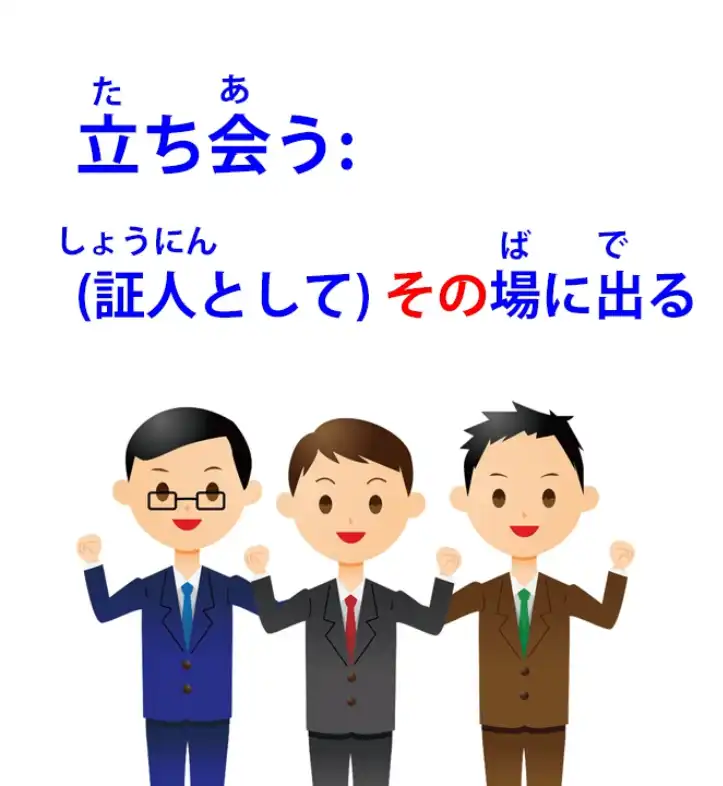
So this opens up a whole range of uses of “その” which don’t really have any equivalent in English. “その” is the related thing, the thing in question at the time, the thing belonging to the person we’re talking about, or whatever, and this gives strategies that are essentially the ones that displace English pronouns.
And there are various other strategies that displace pronouns.
For example, we’ve talked in the past (Lesson 48?) about “くれる” and “あげる”, and I think we often get the impression that this has a lot to do with a more personal sense of relation.
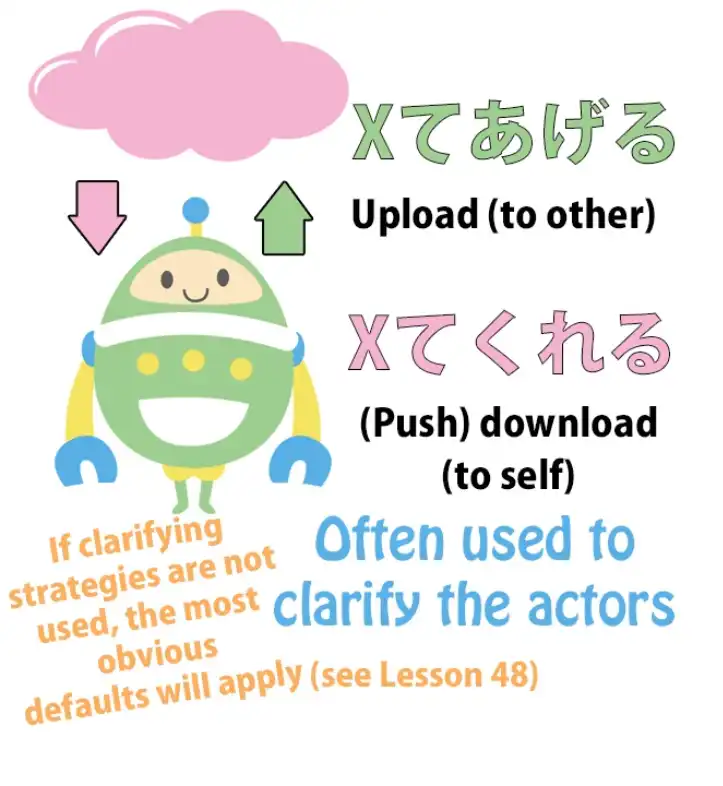
We’re not just talking about what’s done but whether it’s done as a favor to ourselves, whether it’s done as a favor to someone else, and that kind of thing.
And that is important too. But also it takes the place of pronouns. If we said “教えてくれた”, what we’re saying is “she taught me”.
We know that someone else did it, because the “-てくれる” form can only be something done by someone else. We know that they did it to me because “くれる” means either me or someone within my circle.
So, we can say “教えてくれた” . There is no “she” and there is no “me” in that sentence, but the form of the sentence tells us what the pronouns would tell us in English.
Again, if we say “殺してやる”, it means “I’ll kill you”.
And again, it’s the “-てやる” which gives us both the “you” and the “I”.
And generally speaking, if we use any plain, non-past action referring to the future the default actor is going to be “I”. If we say “今帰る”, this means “I’m going home now”.
How do we know it’s “I”? Well, first of all, “I” is the default, and secondly we’re predicting an action which is in our own minds.
We can’t predict the actions of others except under special circumstances.
So unless the context suggests otherwise, this has got to be “I”: “I’m going home now.” And somewhat related to the use of “その”, we have the use of “ある”.
And stories often begin with “ある日”, and people often wonder why “ある日”.
“ある” simply means “being”.
Now, as we know, any verb or any verbal clause can modify any noun.
So why “ある日”? “ある” just means “exist”. So “ある日” means “existing day”.
Now, when a story begins with “ある日”, we’re saying “One day”.
If we say “ある国のある村に”, we’re saying “In a certain village, in a certain country” and this is another very usual setting for a story. But we’re not saying “a certain”, because the expression strategy is different in Japanese from in English.
In English we say “ a certain…” – and what do we mean by that?
Well, we mean that the place is certain. We know where it is, we know what it is, we’re just not telling you. Which, when you think about it, is rather a strange way of putting it. The only reason we really say “a certain…” is that we want to introduce it without saying anything at all about it.
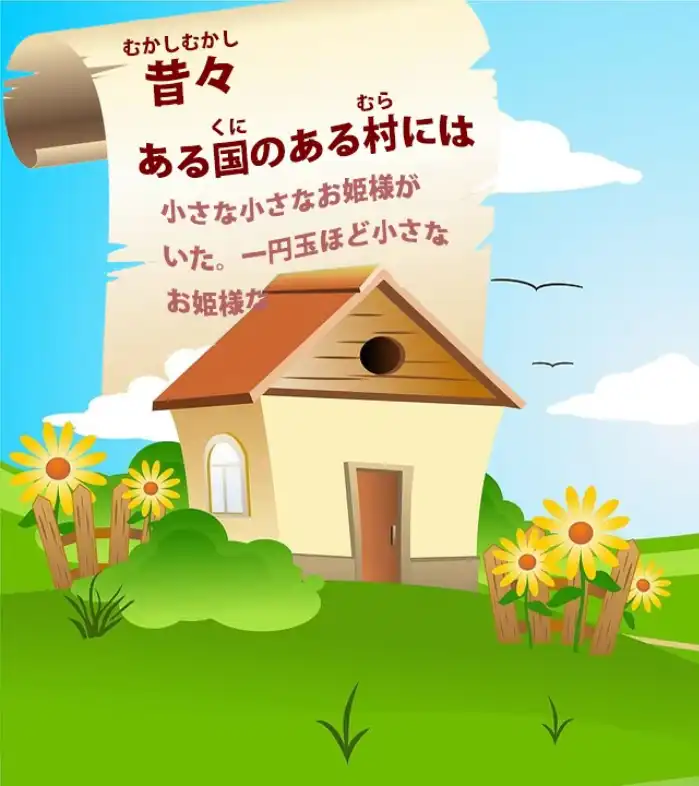
And Japanese, which is often more logical than English, does that in the most logical way possible. It doesn’t tell us anything about it except the fact that it exists.
And if it didn’t exist, it wouldn’t be there, there’d be nothing to talk about, so we’re saying the absolute minimum we can say, that it exists.
Of course, it may not even exist in reality, but it exists in relation to the narrative, so it exists: “ある国のある村には…” And just as a rider to this, I’d like to talk about “ある日のこと” or even “ある国のこと”, which again can introduce a story.
のこと
Why are we saying “のこと” here?
Well, it’s worth remembering that “こと/事” not only means a situation or a circumstance but is a kind of cousin to the “こと/言” of “言葉”.
Note: Check Lesson 74 for this.
A “こと” is a thing, a circumstance, something that you can’t just see or touch, you need a verbal story or description to convey it.
So, “ある日のこと” essentially means the affair of a certain day.
“ある村のこと” means the affair of a certain village. And we’re saying this to preface the story. We’re saying that what follows will be the affair of a certain day / the affair of a certain village. And because of the kinship to “言葉”, it has a slight overtone of “the story of a certain village / the story of a certain day”.
So, here we have some expression strategies that are very different from English ones, difficult to grasp until we know what they mean, and very difficult to grasp when we’ve been misled into thinking that Japanese expression strategies are much nearer to English ones than they actually are.
Links from comments: The Meaning Spectrum introduced in this video, How です・ます (desu/masu) undermines early structural understanding, Sono and its’ relatives (sono, sonna, sore, konna kono kore etc.)
76. The Right Opening? - あく, あける, ひらく, ひらける, 開く, 開け
The Right Opening? aku, akeru, hiraku, hirakeru - あく、あける、ひらく、ひらける、 開く、開け - Lesson 76
こんにちは。 Today we’re going to look at something that is important in itself but also throws light on some of the subtleties of Japanese that are very useful to know as we go forward into deeper immersion.
So, what we’re going to look at is four different ways of saying something that in English are all covered by the one word “open”.
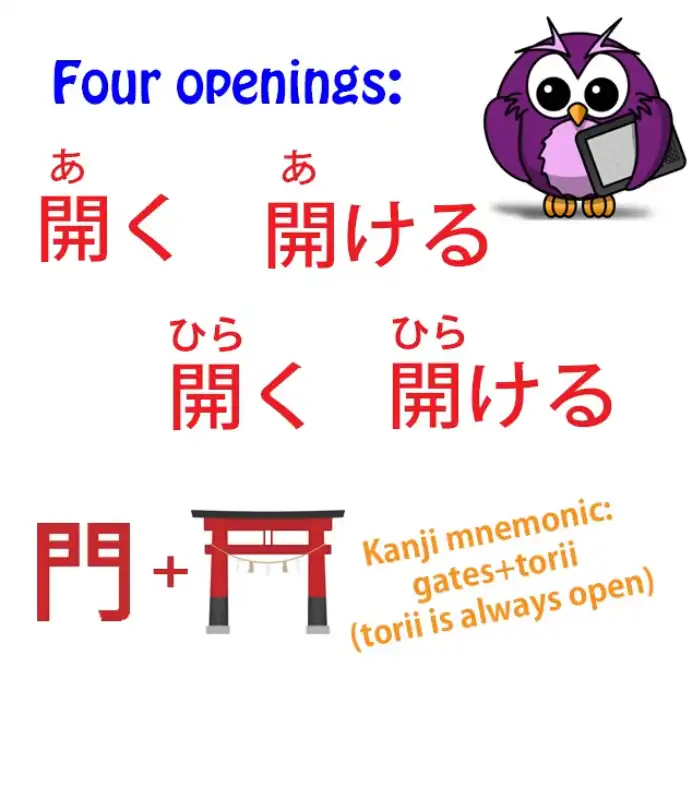
Now, these are “開く”, “開ける”, “開く”, “開ける”. Note: These are read as あく, あける, ひらく, and ひらける, respectively, despite having the same kanji and okurigana. Dolly clarifies this later in the lesson. Now, when we look at these at first they look like two self-move/other-move pairs, don’t they?
And up to a point they are.
But what this is going to illustrate is something of the subtlety of the whole self-move/other-move concept in Japanese, as opposed to the much more technical and clear-cut contrast between transitivity and intransitivity in English and other Western languages.
So, if you’re not familiar with the concept of self-move and other-move verbs (what in the West tend to get called transitive and intransitive verbs) I’ll put a link to my video on that subject above my head and in the Comments below.
The second thing we notice is that when you write them with kanji, you can’t actually see the difference between “あく/あける” and “ひらく/ひらける”.
Now this is partly because they are actually interchangeable in many cases and on the whole if it’s not a case where it really needs to be “ひらく/ひらける”,
people will generally read “あく/あける”.
But if a writer wants to specify that she’s using “ひらく” for a particular effect (and we’ll look at some of those effects a little later) she will write it in hiragana to make the matter clear.
Right. So first let’s take the top two, “あく・あける”. “あく” is self-move. “あくる” is other-move. They both mean “open”. So, “あく”: a door opens, a bottle opens; “あける”: open a door, open a bottle.
That at least is the theory.
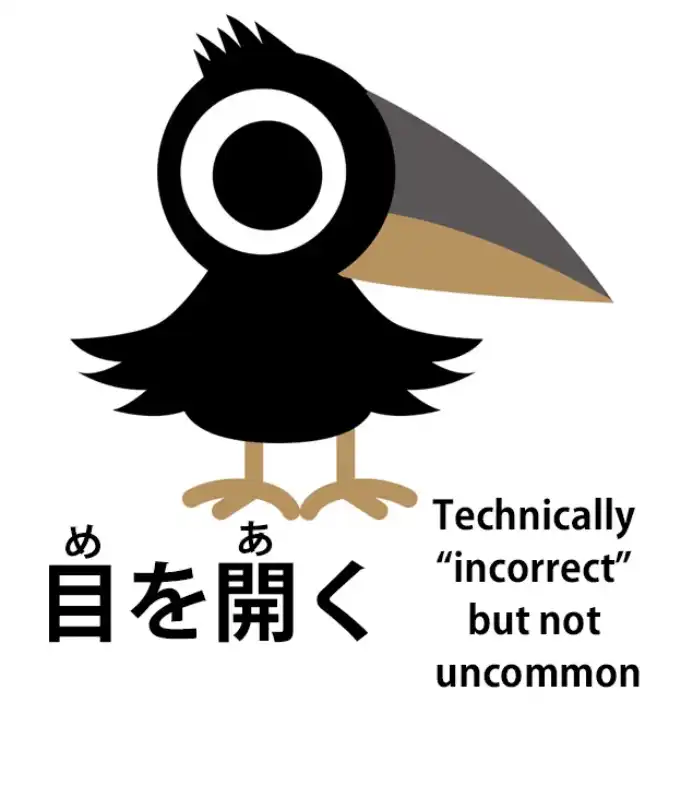
In practice, we will often hear Japanese people say things like “目を開く” (open one’s eyes), which is technically incorrect in the eyes of the grammarians because “開く” is self-move and they’re using it in an other-move way: open one’s eyes.
Now, I’m somewhat challenging the grammarians here and I’ll tell you why in a moment, but you should stick to the actual grammatical model because there are only a limited number of instances in which Japanese people do use “開く” transitively (and I’m using the word “transitively” deliberately here – you’ll see why in a moment) and you don’t want to be memorizing which those are.
If you use “あける” as the other-move version – opening your mouth, opening the door, opening anything – you’ll never go wrong. That’s always correct.
So why am I challenging this official view that “あける” ought to be intransitive?
Well, I’ve got a slight feeling here that Japanese grammarians are a little bit influenced by Western thinking and by the Western concepts of transitivity and intransitivity.
When Japanese people say “目を開く”, I believe the instinct or the feeling behind it is that opening one’s eyes is toward the ある side of the ある・する map that we talked about in my transitivity lesson.
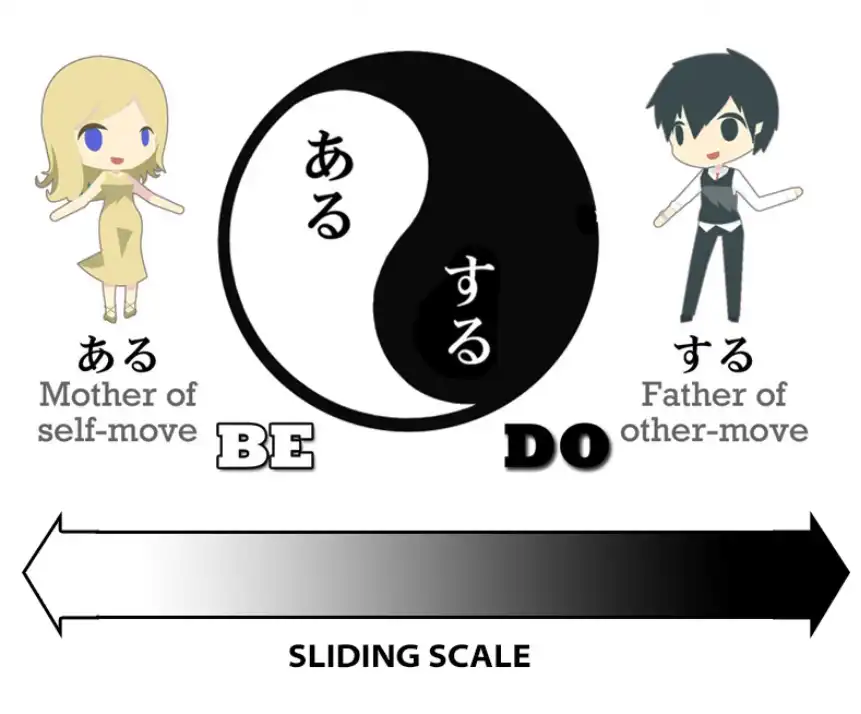
In other words, opening one’s eyes is closer to being self-move, closer to being then doing, as opposed to opening the door, opening a bottle or some other external object.
Now, that’s my take on this, and you can ignore it if you want to, but we’ll get on to some more of these subtleties which are not disputed by anybody as we go forward.
開く (ひらく & あく)
So now let’s look at the difference between “あく” and “ひらく”.
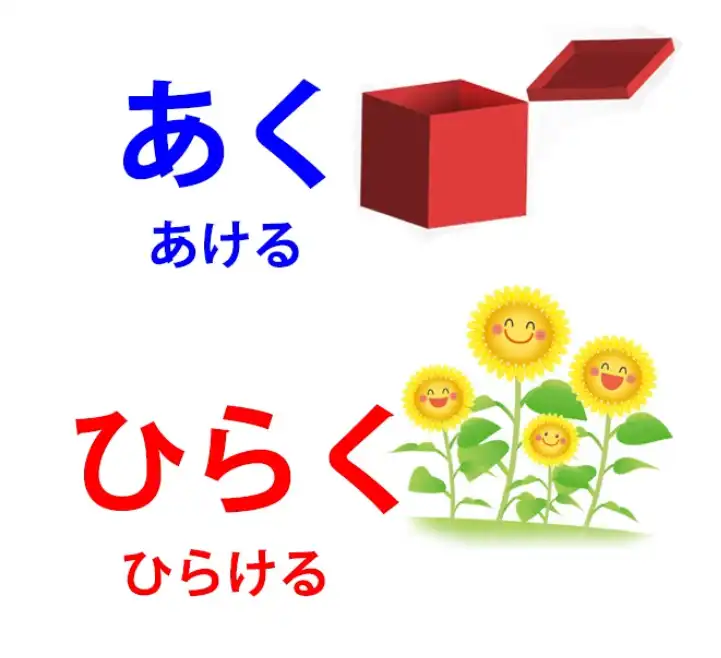
They both mean “open”. “あく” is officially speaking self-move, although we can see that there’s a little bit of leeway here; “ひらく” is both self-move and other-move quite formally.
The difference between them has nothing to do with self-move or other-move. It has to do with the kind of opening that we’re talking about.
So if we talk about opening a bottle, taking the lid off a box, anything like that, it’s definitely “あける”.
On the other hand, if we talk about a flower opening it’s definitely “ひらく”.
So something that unfolds, opens out, is “ひらく”.
Something that simply becomes open instead of closed is “あく・あける”.
And if you like Japanese children’s songs, you may well have heard the hand game song that goes 「むすんでひらいててをうってむすんで」.

“むすんで” is “結ぶ”, which means “gathered or joined” and that refers to a closed hand.
“開いて” refers to a hand that’s spread out like an open flower.
Now, there are various areas where these two are interchangeable, but even when they’re interchangeable they stress one aspect rather than another.

So, for example, a French door can “あく” (open) or “ひらく” (spread open).
Eyes are generally “あく”, but they can be said to “ひらく”, and when we use “ひらく” instead of “あく” in these cases it’s rather like in a movie when you zoom in on someone’s eyes slowly becoming open or on doors slowly spreading open.
There’s more sense of the actual process of the opening, of the spreading out.
So this gives a subtlety that we don’t have in English that can be infused into speech or writing just by choosing “ひらく” instead of “あく”.
Now, when we come to more metaphorical or abstract uses, the distinction is important again.
For example, we can say “店をあらく” or “店をひらく” and they both mean “open a shop”, but “店を 開ける” implies simply opening in the morning for business or opening after the lunch break or something like that, simply literally opening the shop, just opening the doors so the customers can come in.
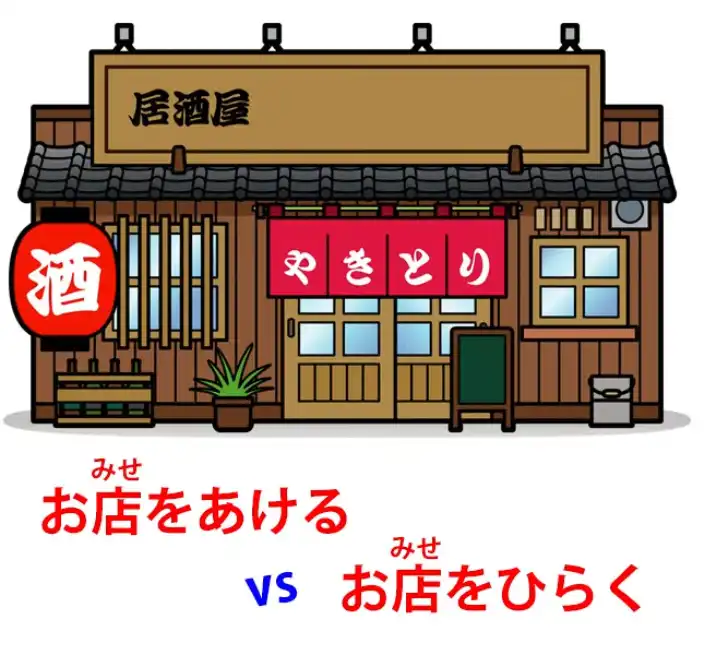
“店をひらく” implies opening a shop for the first time, opening to the public.
In other words, spreading out like a flower, changing from something that was closed into something that’s open.
And just a side note here: with an umbrella, which also spreads out and you might be inclined to say “ひらく”, we don’t usually use that, it’s generally “さす” for opening an umbrella.
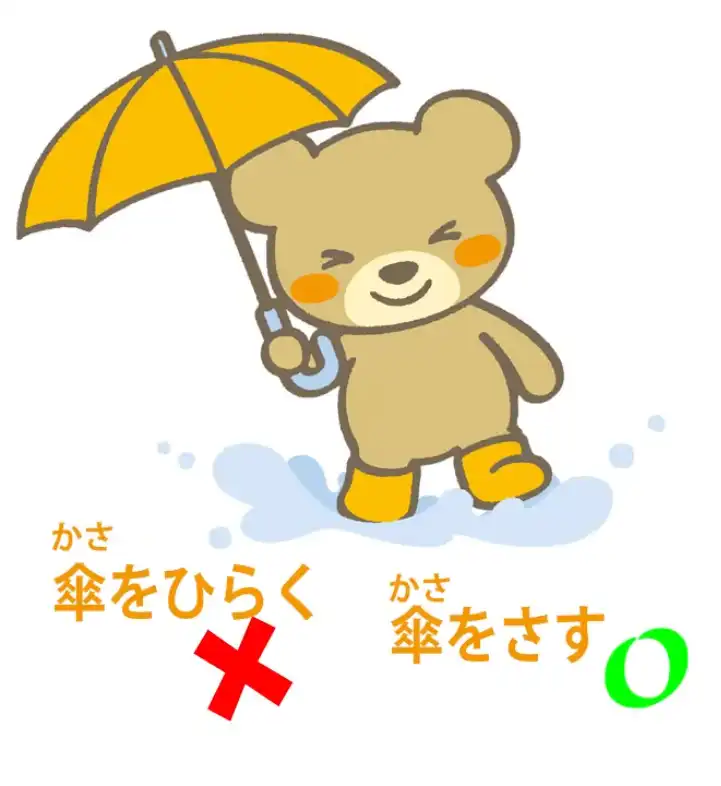
開ける
Now, what about “ひらける”?
The Japanese grammarians, or at least many of them, actually designate “ひらける” as the self-move version of “ひらく”.
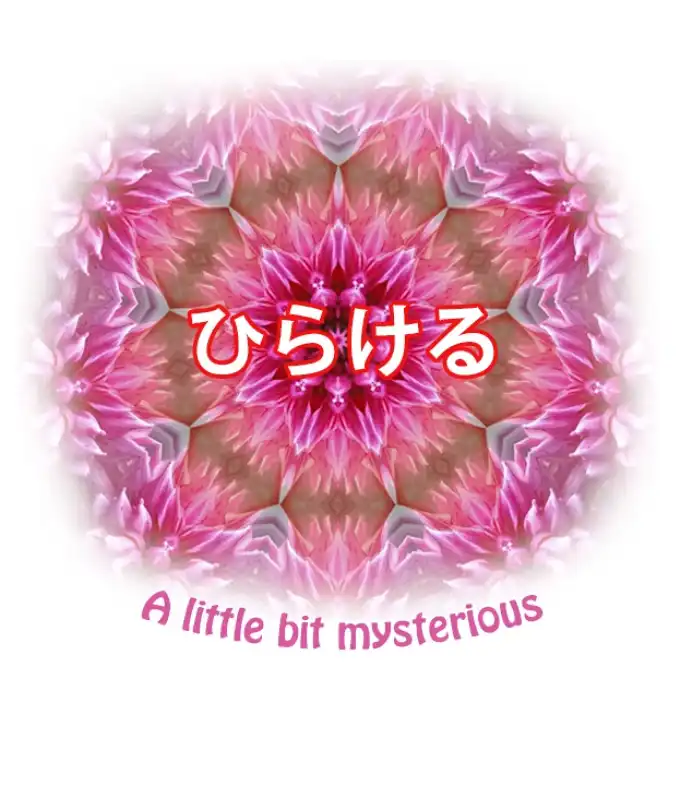
But that doesn’t really make any sense, because “ひらく” itself is both self-move and other-move. So what’s actually going on here? This is quite interesting.
“ひらく”, which can be either self-move or other-move, is further over to the “する” side of the map than “ひらける”. And what do I mean by that?
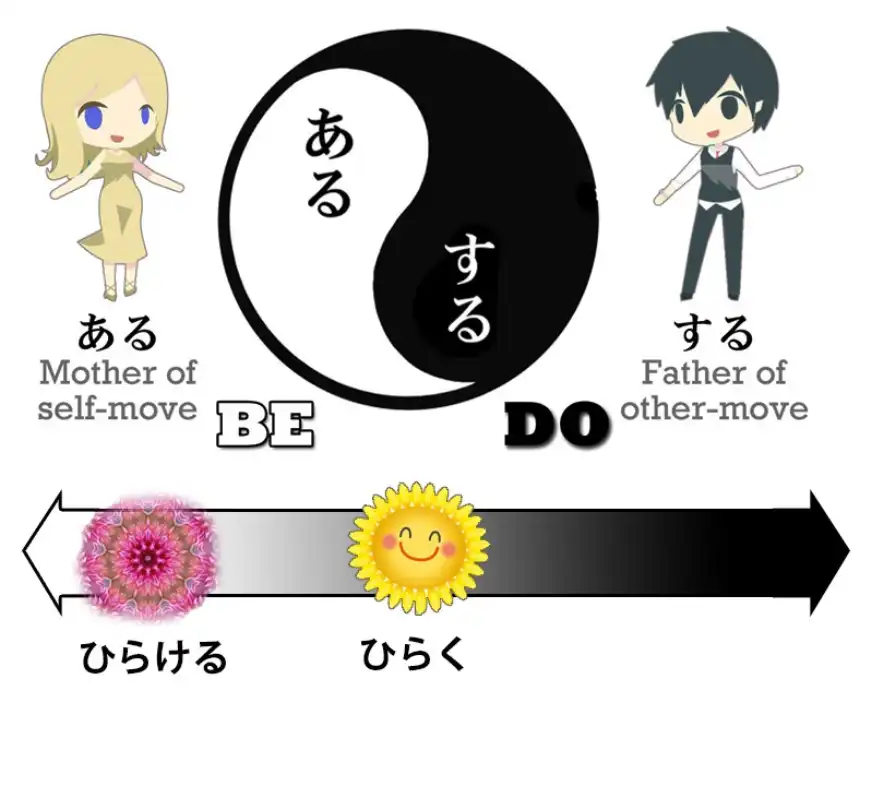
Well, I did a video a while ago about what I call untranslatable Japanese.
And this is about Japanese verbs that really can’t be reproduced in English because they express states rather than actions in a way that just doesn’t happen in English.
A very simple and common example is “分かる”, which is often translated by English dictionaries and textbooks as “understand”.
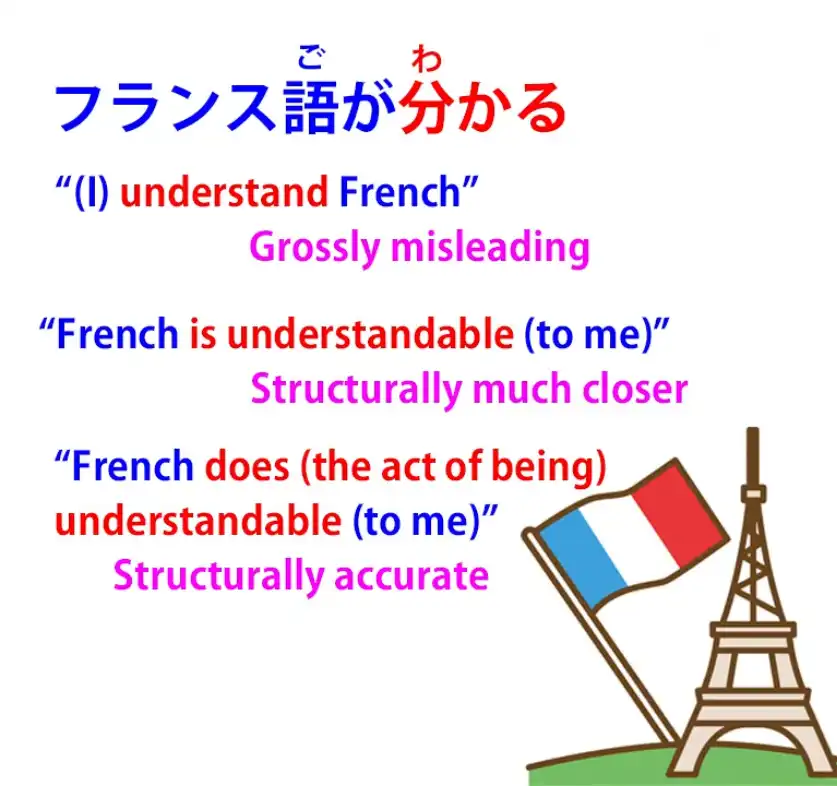
It certainly doesn’t mean “understand”, but when you get a better translation that will tend to be “be understandable” or “be clear”, and that’s much closer to what “分かる” actually means, but the real meaning can’t be translated into English because it’s actually not an adjective like “clear” or “understandable”. It’s a verb.
So what we’re really saying is “do understandable / do the act of understandability” and this just doesn’t have an English translation.
And there are lots of stative verbs like this and I talked about them in the video.
And “ひらける” really comes closer to being one of these.
“濡れる”, which is often translated as “become wet”, but it doesn’t actually mean “become wet” – It can include that but implies “existing in the state of being wet”.
It may mean “become wet and then continue to be wet” or it can just mean “be wet”, but of course it isn’t “be wet”, it’s in fact “do wet”, which isn’t translatable into English.
The same with “ひらける”. So it’s used in cases like, for example, we often say “運が開ける”, which means “one’s luck opens”.
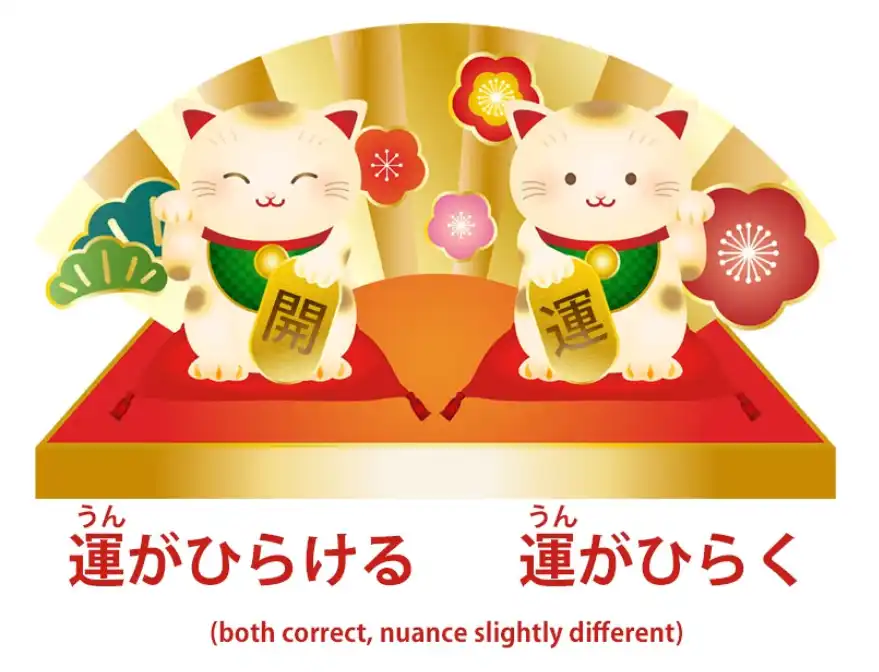
Now, we could say “運が開く”, and that would mean “one’s luck unfolds like a flower, becomes open”, but “ひらける” implies not just unfolding but continuing to exist in that state of unfolded-ness.
The reason we would be more prone to say “店をひらく” is partly because it’s more other-move than “ひらける” and we’re actually doing it to the shop, we’re opening it; also because stress is on this act of opening the shop.
“運がひらける”: the stress on the actual opening of the luck is less important than the fact that it’s going to change.
From then on, we’re going to be lucky, whereas at the moment we’re not so lucky.
So, I think this gives us a view not only of the four words for opening in Japanese and how they work, how they interplay.
A lot of the time they overlap with each other and it doesn’t matter too much which one you use.
In some cases it really is important, either for what you’re specifically saying or for the nuance and implication and atmosphere that you want to build by saying it.
Links in the description: Self-move/other-move the aru-suru axis, Untranslatable Japanese, むすなでひらいて hand song
77. Real Japanese Structure vs Tae Kim: Structural Review of Tae Kim’s Japanese Grammar
Real Japanese Structure vs Tae Kim - Structural Review of Tae Kim’s Japanese Grammar - Lesson 77
こんにちは。 Today’s is the first video that I’ve really hesitated to make and had second thoughts about it, but I’ve decided to go ahead.
It’s a video that I think will throw more light for all of us on the structure of Japanese.
And it’ll do this by taking it from a slightly different angle and contrasting it with something different from what I normally contrast it with.
Normally, I contrast Japanese with the conventional “Eihongo” Japanese grammar models.
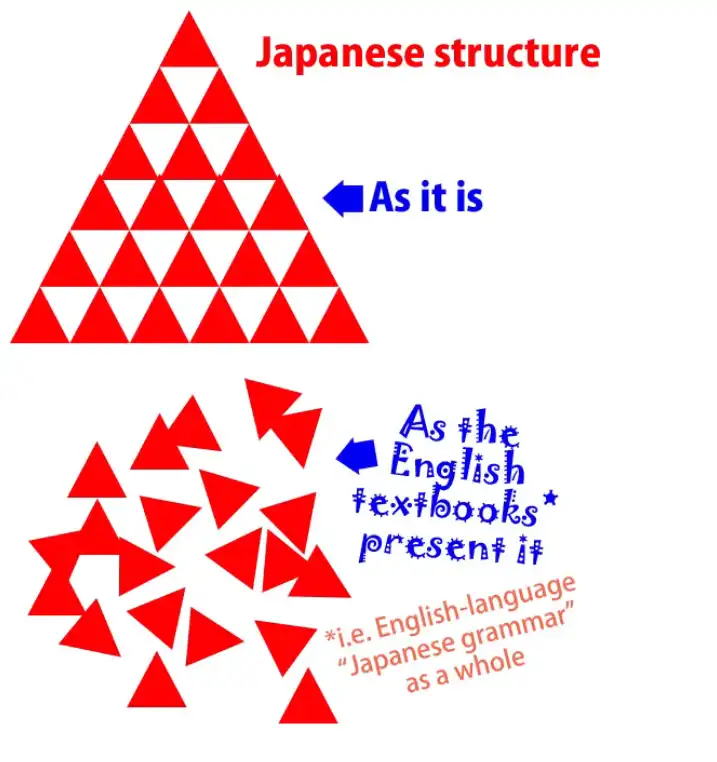
And some people actually have criticized me for criticizing those models too much, for repeatedly pointing out the failings of those models rather than simply expounding what I have to expound.
And I do this for a reason, and the reason is this: conventional Eihongo/Western Japanese grammar really hasn’t changed since hundreds of years ago, when Western people started imposing classical European grammar on the Japanese language in an attempt to explain it to other Western people.

And these explanations are enshrined in the most prestigious places.
They’re taught in universities by people with strings of letters after their names.
They’re taught in all the standard textbooks and then echoed down to everybody with a Japanese learning website or channel.
And because of this, because of the prestigiousness and the ubiquity of these models, when people hear other models, they’re very likely to wonder how they can reconcile the two.
The old models “must” be true because they’re so prestigious and the new model sounds true as well, so how do we marry them up, how do we reconcile them?
And the answer is of course that we can’t actually reconcile them.
If 2 and 2 equal 4, then they can’t also equal 5.
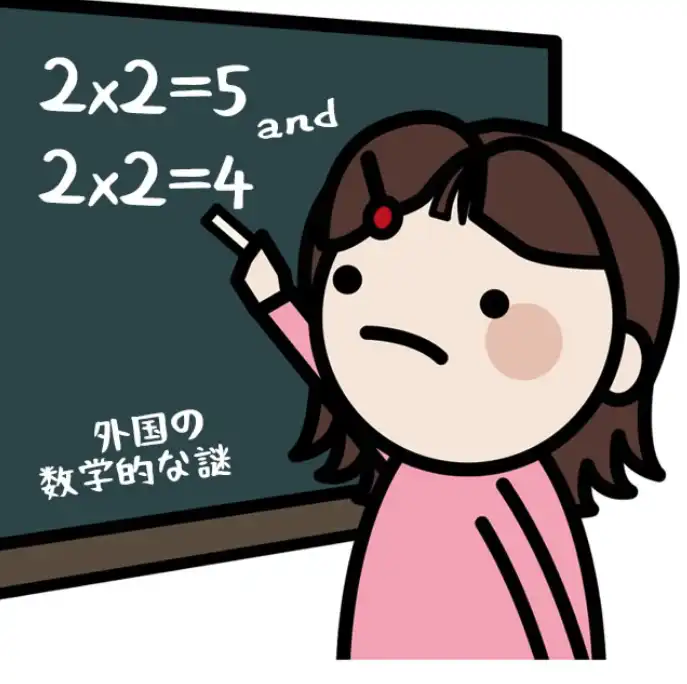
And it’s necessary to point this out because people will try to reconcile them if they’re not aware of that, and that’s going to lead us into all kinds of logical tangles.
Now, Tae Kim-sensei, whom we’re going to speak about today, was intelligent enough and brave enough to see the fundamental flaws in the conventional Western Japanese models.
He saw that they were full of contradictions and inconsistencies and illogicalities, and he tried to create models that were more consistent and more logical.
The problem is that in the most important areas what he essentially did was keep the bits that were wrong and try to reconcile the bits that were right with those.
So we ended up with something that was in many respects worse than the original Eihongo models.
Now, I want to make it clear that I am not trying to do any kind of a “hit job” on Tae Kim-sensei.
I respect him greatly and I recognize that he was just about the only person (apart from Jay Rubin) who recognized that there is a problem with conventional Eihongo Japanese and had the courage to try to do something about it.
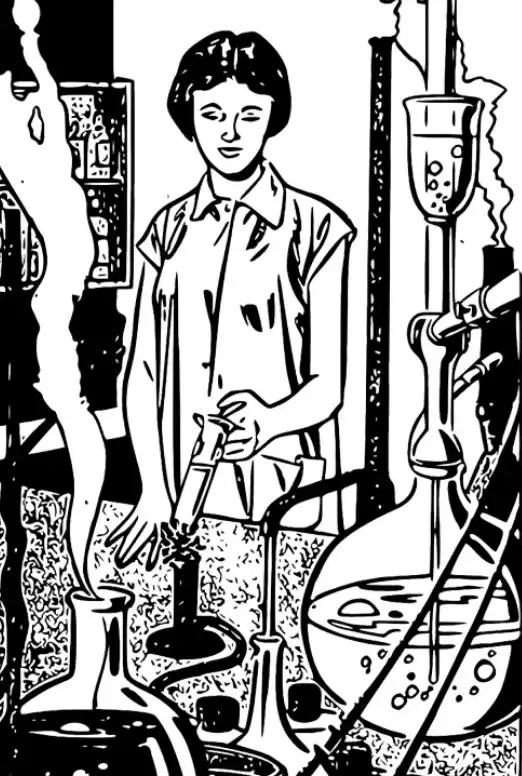
Note: Jay Rubin seems to have been what Dolly based her explanations. It’s people who recognize the problems and try to solve them who move knowledge forward.
And this process of moving knowledge forward is littered with experiments that didn’t work and models that in the end didn’t stand up to testing.
That doesn’t make them foolish. They are part of the path of knowledge.
Tae Kim
Tae Kim-sensei has quite a lot of information online and a lot of what he says is useful.
The areas in which we have to dispute his models are essentially three, and unfortunately these three are so near to the very core of the structure of the language that they do cast a shadow over everything else, because they have logical consequences.
So, the three are essentially:
the が-particle, which is the absolute backbone of Japanese structure,
the copula “だ”, which is essential to all non-adjectival A-is-B structures,
and the myth of Japanese conjugation (Lesson 10).
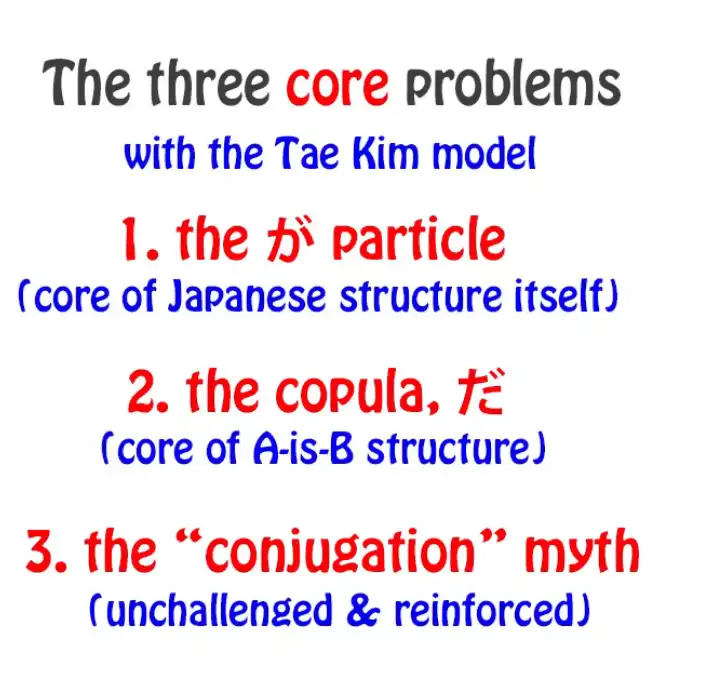
So, as you see, this is quite a formidable threesome that really casts a shadow over everything.
However, if we’re sufficiently aware of the problems it could still be possible to use at least some of Tae Kim’s work.
And his approach to immersion itself is actually closer to what I believe than anything else I’ve seen.
So let’s look at the three problems.
The first is the が-particle.
The が Particle
Now, the が-particle, as I’ve explained on various occasions before, is the absolute core of Japanese (Lesson 1).
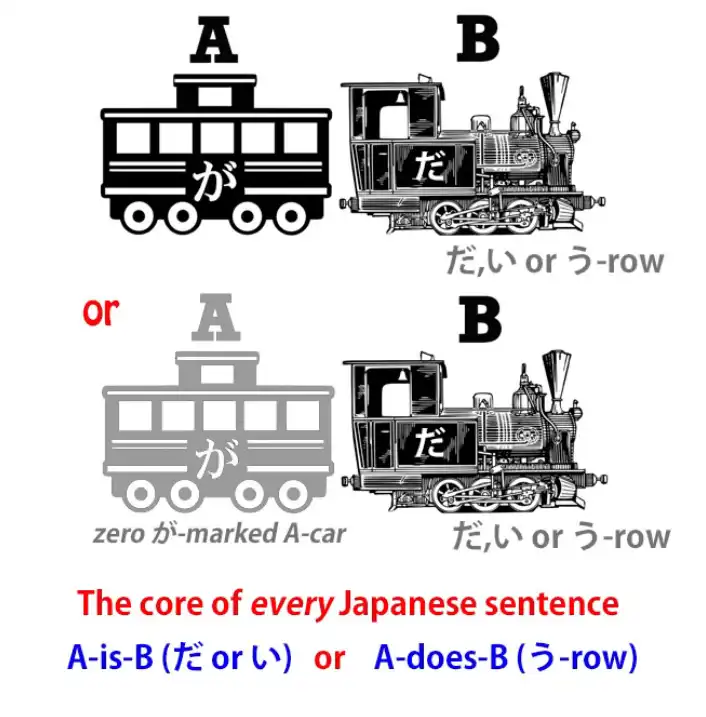
You can’t have a sentence without the が-particle, even though you can’t always see it.
It’s sometimes present only as a logical entity.
But it’s always there, and if we don’t have it, we don’t have a sentence. Simple as that.
What the が-particle does is, it marks the subject of the sentence, that’s to say, the thing that we’re saying something about.
We’re either saying “A is B” or “A does B”.
What the A-car is is the subject of the sentence, the be-er or the do-er of the sentence.
The が-particle marks this. It can never mark anything else.
But conventional Japanese makes a mess of this by misunderstanding some Japanese sentences to the point where it has to say that が only sometimes marks the subject of the sentence; other times it marks the object.
Now, this is nonsense and I’ve demonstrated that it’s nonsense.
が never marks anything but the subject.
Tae Kim tries to reconcile this problem by saying that が doesn’t mark the subject and even going so far as to say that there is no such thing as a subject in Japanese and saying that there is a subject is simply imposing European concepts on the language.

Now, the truth is that every human language has a subject, which is what we call an A-car, and a predicate, which is what we call a B-engine.
All we are saying when we say this is that every human language can say something about something.
It can take a particular thing and say a particular thing about it.
The particular thing it takes is called the “subject”.
The particular thing it says about it is the predicate (=basically everything excluding the subject).
It’s as simple as that.
If we don’t have subjects and predicates we don’t have language in any developed sense of the word.
All we can do, if we can’t say a particular thing about a particular thing, is make noises that express that we’re happy or sad or angry or frightened, just as animals do.
Without subjects and predicates there is no language. Simple as that.
Different languages may deal with them in very different ways, but the concepts have to be there.
Now, what is it that induces Tae Kim-sensei to declare that Japanese is so different from any human language that it has no subject?
Well, ironically, it’s the fact that he can’t shake the Eihongo grammar approach that continually imposes English structure on Japanese.
It’s because they can’t conceive (and apparently Tae Kim-sensei can’t conceive either) that the Japanese could ever take the ego out of the heart of a subjective sentence.
So, the example he uses to “prove” that Japanese has no subject is the phrase “クレープが食べたい”, which of course in all the textbooks gets translated as “I want to eat crepes”.
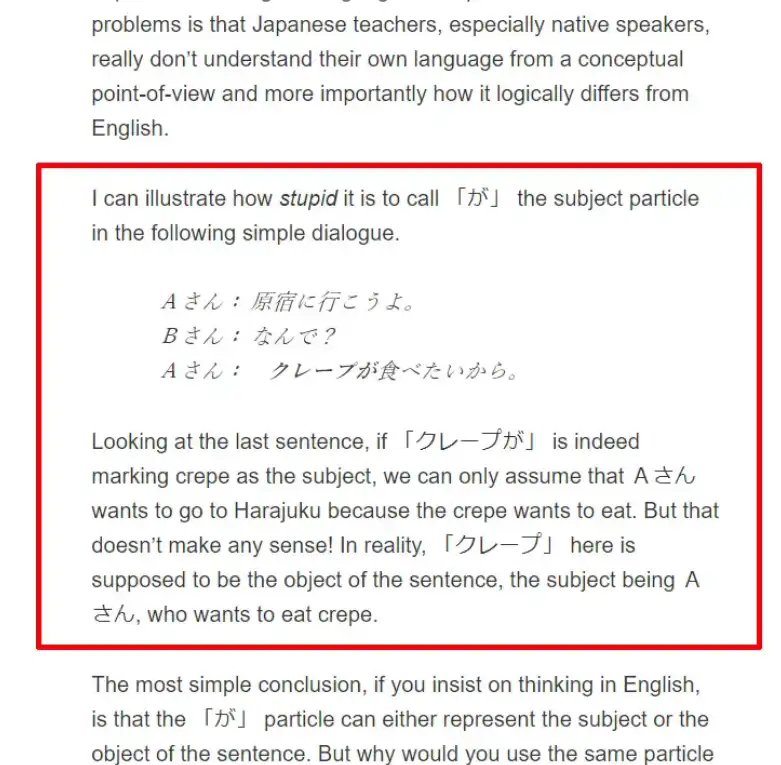
Note: Tae Kim-sensei’s explanation. And, as usual in English, the experiencer of the subjectivity, the ego, is placed at the center.
That’s the subject, that’s the doer: “I want to eat crepes.” And of course the crepes are marked by が, and they’re not the subject, are they?
So が isn’t marking the subject. On this, Tae Kim-sensei and conventional Eihongo Japanese are at one.
Eihongo Japanese explains it by saying that が only sometimes marks the subject.
Tae Kim-sensei explains it by saying that there is no subject in the entire language.
But the simple reason for both these statements is a complete inability to even consider the fact that Japanese might use different expressions from English and that it could be possible to take the ego out of the center of a statement about subjectivity.
Now, the odd thing about this is we don’t even have to go as far as Japanese to know that this happens all the time. It happens in Spanish.
“Me gusta el Tequila” is not saying “I like Tequila”, although all the textbooks will tell you it is.
It’s saying “Tequila does pleasing to me”.
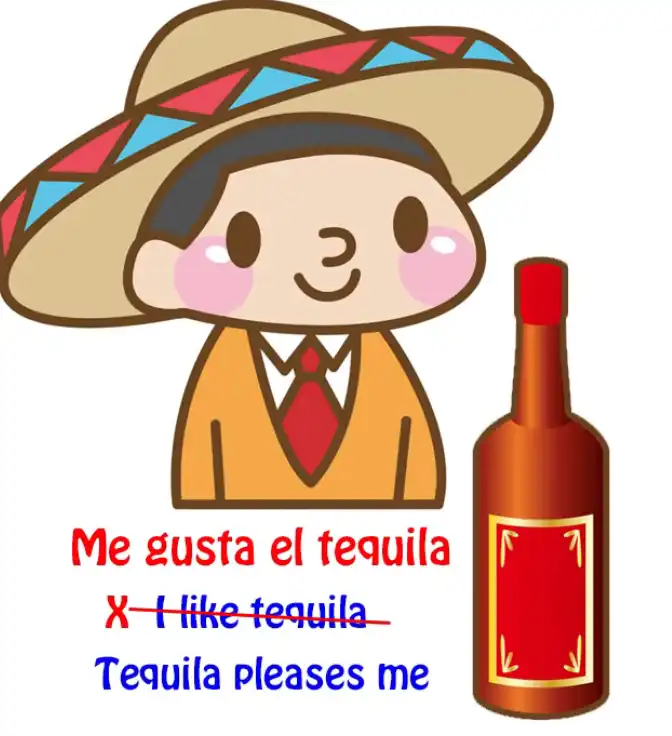
Now, this may not be the way English wants to put it, but it is the way Spanish puts it.
“クレープが食べたい” means “Crepes are eat want-inducing (to me)”.
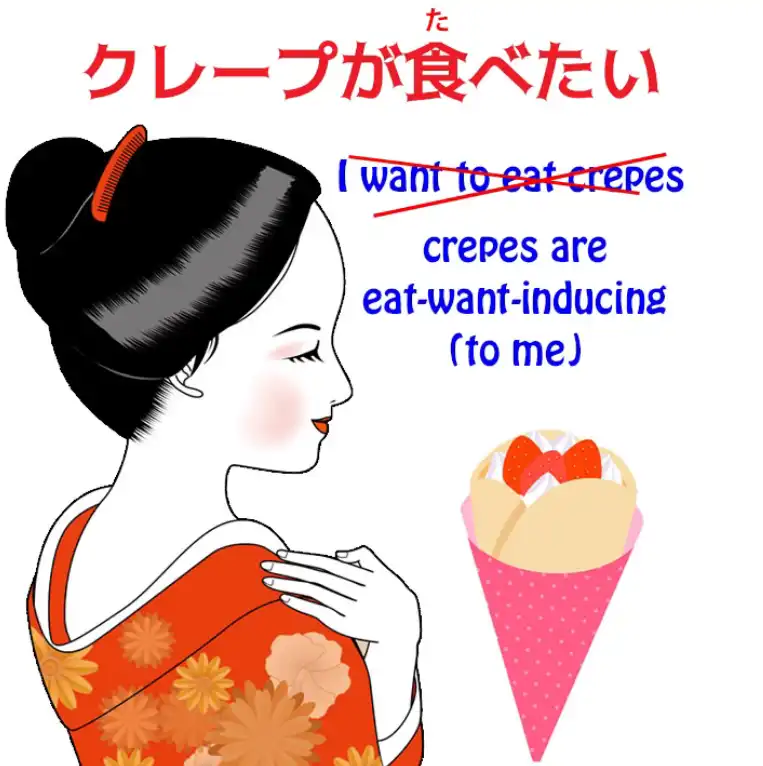
Again, this may not be the way English wants to put it, but it is the way Japanese puts it.
The が-particle is doing what it always does.
It’s marking the subject, the doer, the A-car, of the sentence.
It’s just that the subject, the doer, the A-car, of the sentence in Japanese is not the same as it would be if an English person tried to express the same sentiment.
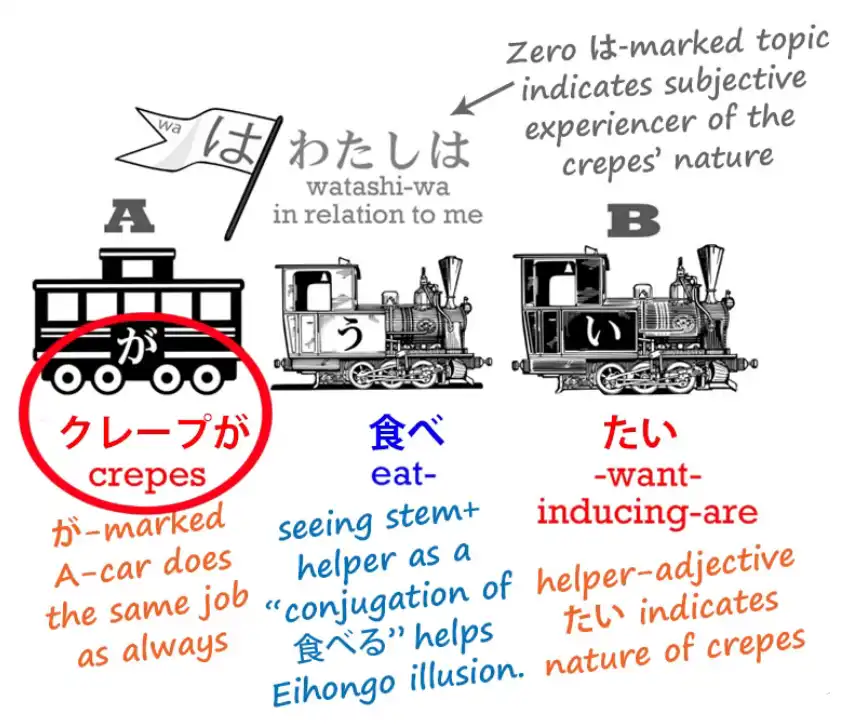
The subject of the sentence is the crepes.
They are the one that’s doing the eat want-inducing to the experiencer.
And if we understand this we don’t have to say that が marks the subject some of the time.
We can see that が marks the subject all the time.
And we don’t have to start saying that there’s no such thing as a subject in Japanese.
Because the only language in which there’s no such thing as a subject
is “wanwan” and “nyan-nyan” language.
Note: Since I was not able to find anything about them, I am pretty sure it was a joke ( ̄□ ̄」)
Human language has to have subjects and predicates or it ceases to be language.
The Metaphysical Trap
Now, some of you may be asking, how can I say that my model is the truth?

Note: And yes, Linguistics is in fact a scientific field too. That the whole of conventional Japanese grammar is not true and Tae Kim-sensei, whom I acknowledge to be a very fine mind, is also producing models that aren’t true?
And the answer to that is, I’m not saying that at all.
There is no such thing as truth in language structure or linguistics, just as there is no such thing as truth in science.
Humans have metaphysical minds.
They want narratives and they want truth and falsehood.
Both of these are inherited from deep and ancient metaphysical intuitions.
And I’m not saying anything here about whether those intuitions are true or whether they’re false.
All I’m saying is, if they’re true, neither science nor linguistics are the places to look for them.
If we have a model that is inconsistent and has to be continually shoehorned with rules and exceptions to make it work, or we have a model that is too vague to be very useful, and then we have a model that is precise and consistent and works all the time, we’re likely to say that that third model is the true one.
But in fact this is falling into the metaphysical trap.
I may occasionally speak that way myself, but let’s be perfectly clear: this is just really a trick of language.
When compared to the inconsistent model or the vague model, the consistent and accurately predictive model is not “truer”, but it is more useful.
Science doesn’t tell us truth. It predicts things.
It tells us that when we do A and B the result is going to be C.
This has nothing to do with truth, metaphysics, narratives or anything else, it’s just a method of prediction.
And if we can predict things, we can do useful things with those predictions.
It’s exactly the same with language.
So the conventional model is sufficiently inconsistent that in many cases it’s not fit for purpose, at least not if we can find a better model to replace it with.
Tae Kim-sensei’s answer to this is to create a model so vague that it’s unfalsifiable.
Now, when we talk about models or theories, being falsifiable may sound like a negative, but it’s not.
It’s a positive.

Because if there are no circumstances under which a theory can be falsified, then essentially it doesn’t really mean anything.
Theories work by defining phenomena; that’s to say, setting out their limits: setting out the conditions under which they apply and the conditions under which they don’t apply.
If we create one that applies under all possible conditions, then it really doesn’t mean anything.
If you give me an object and ask me what it is, if I say it’s a marble, or it’s a box, or it’s a twig, you can verify or falsify that statement.
If I say it’s an object, you can’t falsify it, because everything is an object, but on the other hand, I haven’t told you anything worth knowing.
Note: This above portion was really good. It shows that linguistics is not merely black and white, there are not only “right” and “wrong” ideas - rather, “more useful” and “less useful” ideas for a PARTICULAR individual. For some, Tae Kim-sensei’s explanation works way better than Dolly’s, and that is okay…if a person keeps going with the studies/exposure, they will eventually understand how the language truly works even if at first they were told conflicting info - due to how our brains restructure around and solve language problems by natural patterns, logic etc.
What Tae Kim does with the が-particle is call it the “identifier particle”.
Now, if you went a bit further, that might be useful.
Does it identify the subject? Does it identify the object?
Does it identify some completely different kind of category?
And the answer is, we’re not told.
All Tae Kim-sensei has to tell us is that it indicates that the speaker wants to identify something unspecified.
Now, this vagueness might be considered not very destructive, but in fact it is very destructive because it essentially takes away our ability to define anything.
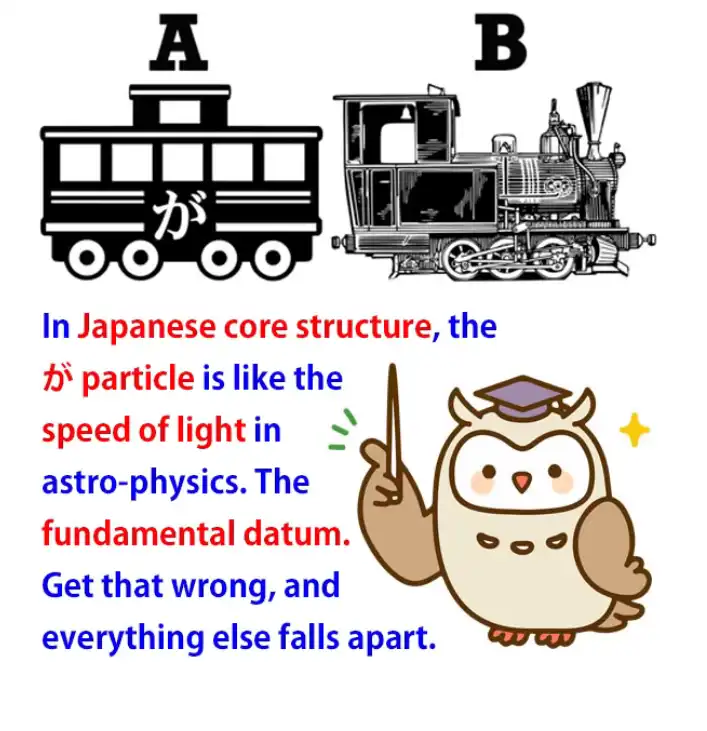
We can’t see how the core Japanese sentence works because we don’t have the が-particle.
We can’t talk about the difference between logical and non-logical particles (Lesson 8b), like the は and も topic markers, because we don’t have the key logical particle.
If we have to build a theory around this undefined が, then we’re going to have a very undefined kind of theory.
So we’ve essentially created a structure that negates the core structure of Japanese from the beginning.
And once we’ve done that, we logically find ourselves having to do other things that take the theory even further from being useful and predictive.
So in our next lesson (Lesson 78) we’re going to look at what happened to the “だ” copula in Tae Kim-sensei’s theory and some other consequences.
Now, once again, I’m not trying to denigrate Tae Kim-sensei.
In fact, the reason I’ve singled him out is because he’s the only person who’s really challenged the conventional Eihongo model at a deep enough level to give us another perspective, another angle for assessing Japanese structure.
And it’s really only because he’s that important and that intelligent that I made the difficult decision to make this video and the next one.
Note: To reiterate, this is NOT Dolly putting down Tae-Kim-sensei or saying her way is superior, because language is not black and white… It just compares Dolly’s understanding to Tae-Kim’s.
And it is completely okay to have different kinds of mindsets about things in language. This happens all the time in linguistics. It is not meant to cause ill-will or ridicule whatsoever.
We are all different and for each of us, something else works, so there is benefit in it.
#
78. Breaking the Core: Tae Kim vs the Copula - Japanese Structure-Based Critical Review
Real Japanese Structure vs Tae Kim - Structural Review of Tae Kim’s Japanese Grammar - Lesson 77
こんにちは。 Today we’re going to talk about the core of Japanese structure and we’re going to look at it from a different angle by contrasting it to something different from what we normally contrast it to.
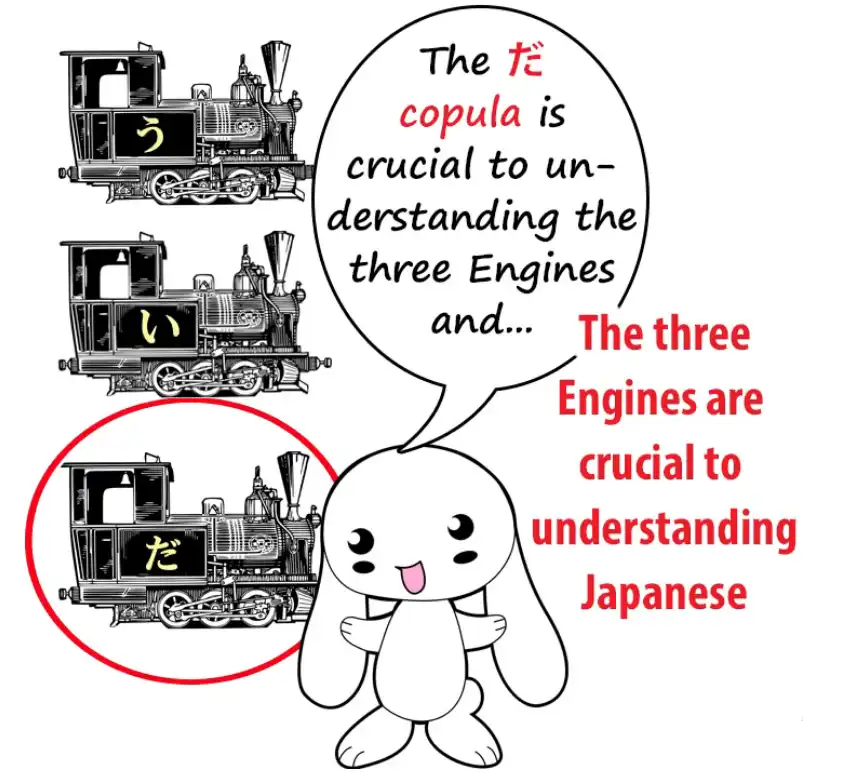
And that is, we’re going to look at what Tae Kim-sensei does with it.
Last week we looked at what Tae Kim-sensei does with the が-particle, which is the absolute core and center of every logical Japanese sentence.
Today we’re going to look at what he does with “だ”.
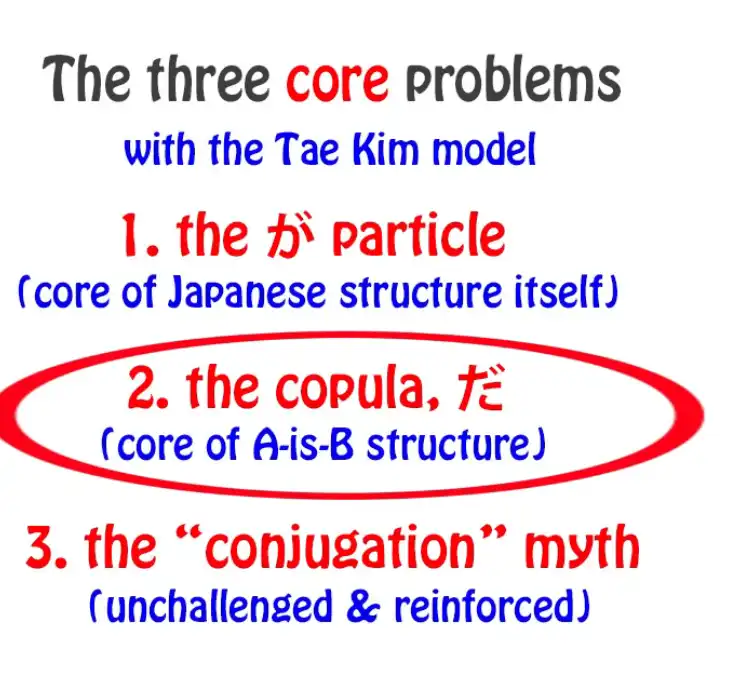
And in a way this is parallel to what he does with が.
The だ (& です) copula
That is to say, he essentially vagues it out of existence, takes away its logical function and gives it a vague kind of function.
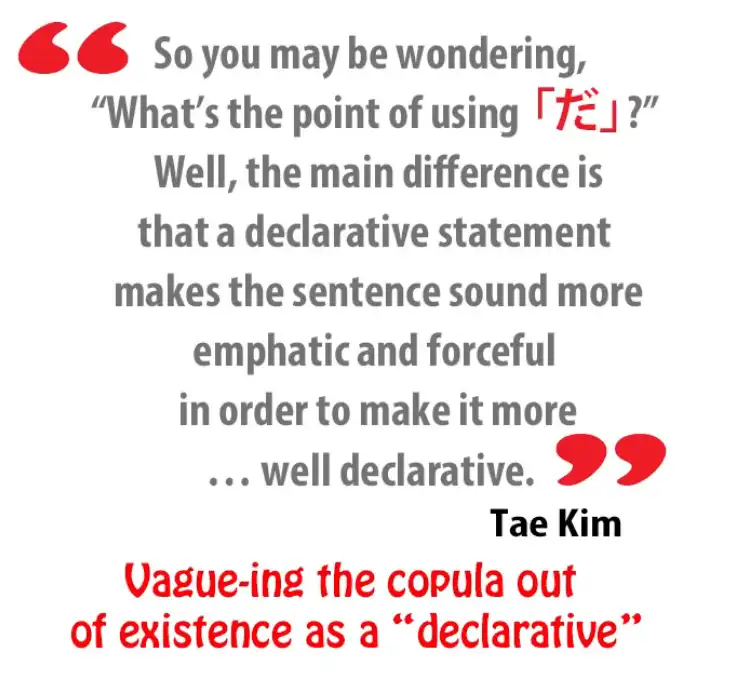
Now, why does he do this?
Again, essentially for the same reason: because the conventional Eihongo grammar interpretation is a bit of an illogical mess and Tae Kim-sensei wants to tidy it up.

But essentially once again what he does is take the part of it that’s wrong and try to reconcile the part of it that’s right with that.
So we end up with something that’s actually more damaging and less useful than the Eihongo mishmash we had in the first place, which at least had some of the actual structure of Japanese in it, even if in a rather illogical and messy way.
And he also denies that “だ” and “です” are actually the same thing, and this is really for three reasons.
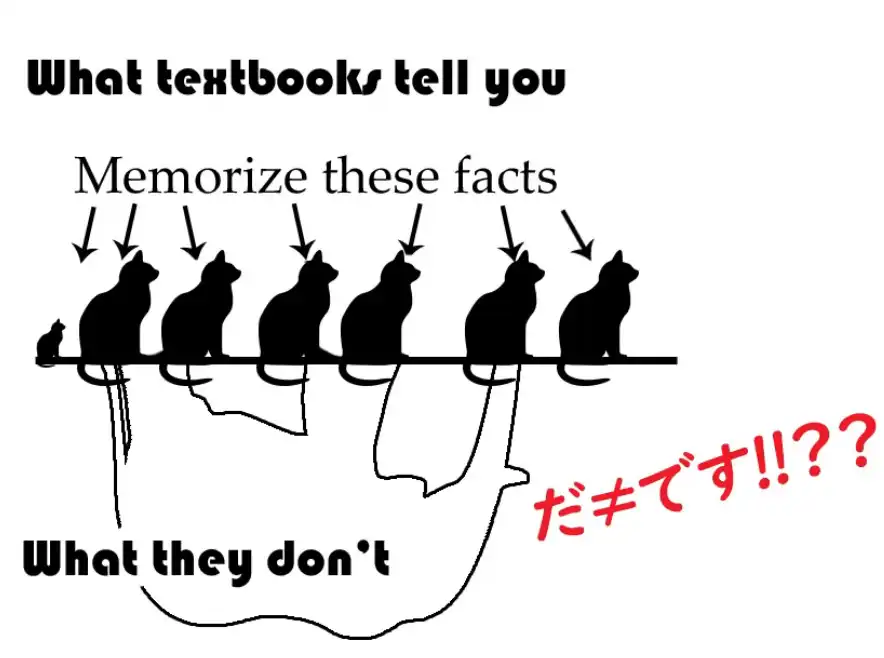
Firstly, if you deny the copula function it doesn’t really much matter what they are.
Secondly, “です” is a little bit eccentric.
It does one thing that “だ” doesn’t do. Just one thing.
But also because the Eihongo Japanese model is so confusing and so wedded to the myth of so-called “Japanese conjugation”, which doesn’t exist, that it makes that one eccentricity of “です” look like more than one.
It looks as if it’s all over the place when in fact it’s only got one eccentricity – which is a little bit confusing, but when you see it for what it is, it’s just that one thing.
So, how important is it that we misunderstand the “だ” copula?
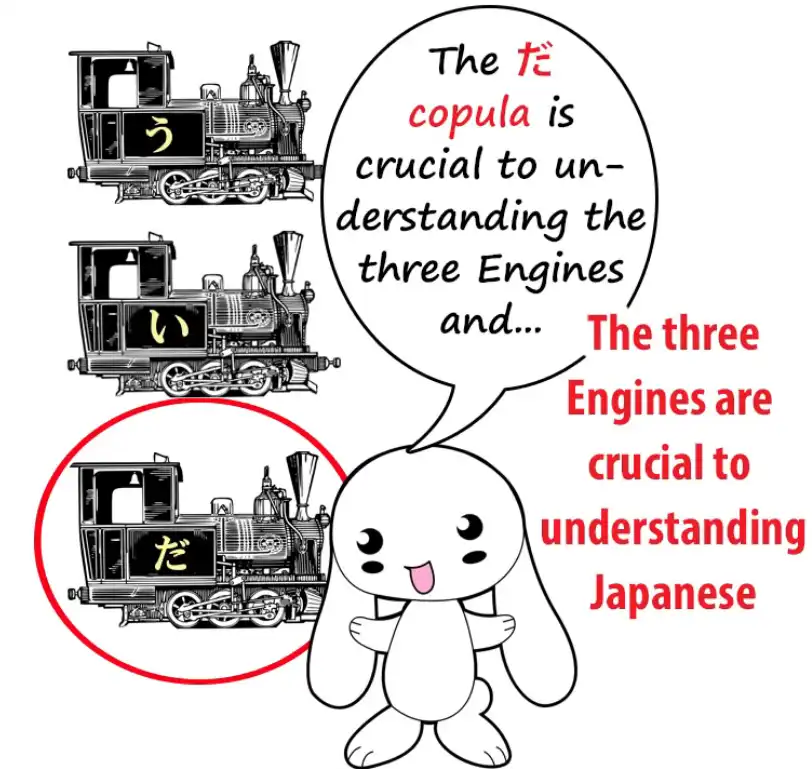
It’s not central to every Japanese sentence the way the が-particle is, so is it that bad?
Well, as a matter of fact it is, because it takes away another of the absolute pillars of understanding Japanese structure.
And that is, understanding the three engines and the three core sentences.
There are only three ways a logical Japanese sentence can end: with a verb, an adjective, or a noun + copula.
It can’t end with a noun on its own; it can only end with a noun + copula.
And this is fundamentally important and we’ll get to why in just a moment, but I’ll just note here that part of the reasoning behind Tae Kim saying that the copula is a mere declarative – it doesn’t actually do anything logical and grammatical, it just emphasizes what we have to say – is because in casual speech “だ” sometimes gets dropped.
Now, the important thing to understand here is that this does not mean that it’s unnecessary.
In English we often say things like “Got up early this morning”, “Fancy a cup of coffee?”, “Call that a rabbit? Looks more like a teddy bear in a rabbit suit to me!” And in all these cases we know, everybody knows, that the sentences aren’t fully grammatical.
You have to say, “I got up early this morning”, “Do you fancy a cup of coffee?”, “Do you call that a rabbit? It looks more like a teddy bear in a rabbit suit to me!” This is perfectly natural. All languages drop necessary grammatical elements when they can be readily understood by the [listener] in very casual speech.
You can’t do it in an essay or in formal writing or in a legal document or anything like that, but you can do it in casual speech.
In Japanese, not only does the copula get dropped, half the particles can get dropped in very casual speech.
And I don’t think anybody argues that they aren’t necessary.
So, in actual grammatical Japanese you can only end a sentence in one of those three ways.
It can end with a verb, it can end with an adjective, or it can end with the copula, and the copula always has to be attached to a noun, because that’s how the copula works.
And as we know, what the copula does is tell us that A is B.
“さくらが日本人だ” means “Sakura is a Japanese person”.
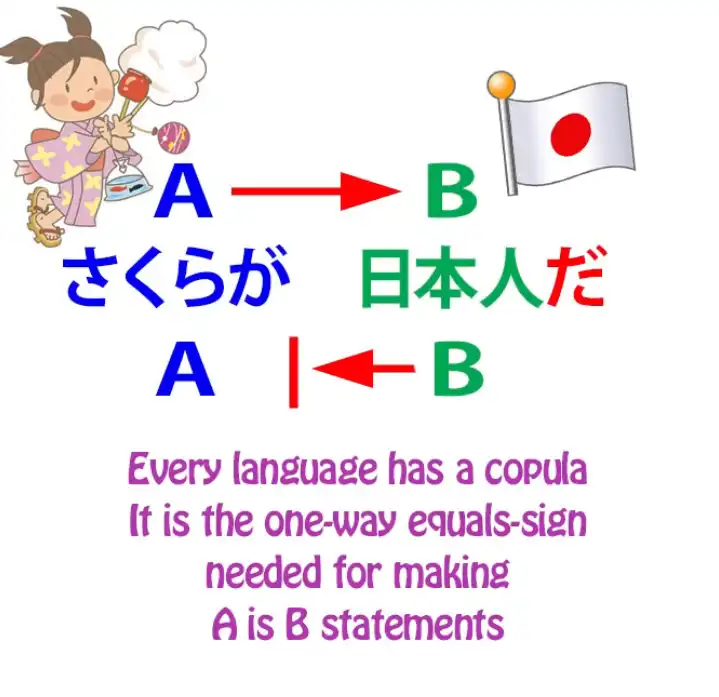
It only works one way around.
A Japanese person is not necessarily Sakura.
Sakura is a Japanese person.
That’s what we’re being told by a copula sentence.
Now, if we look at all the elements in Japanese, all the verbal elements, there aren’t very many.
Unlike English, unlike European languages, there really are very few.
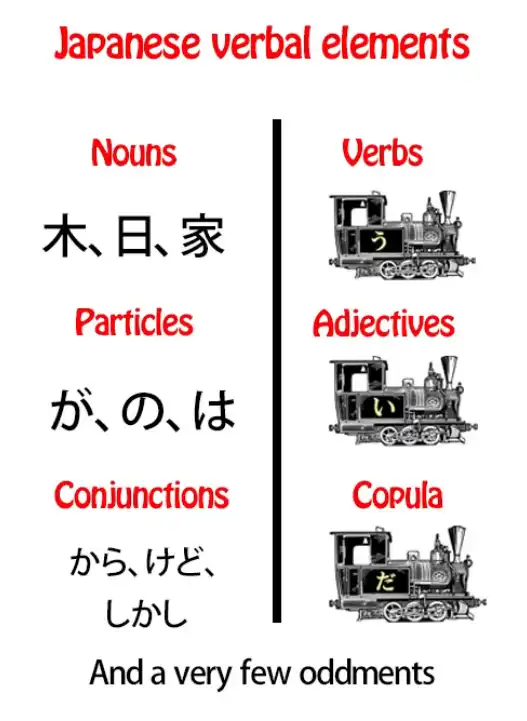
There are verbs, adjectives and the copula, and then, aside from that, we have nouns – – nearly everything that’s not a verb or an adjective is a noun.
There are also particles, and there are some conjunctions like “なら” and “けれど”.
Almost everything else that isn’t a verb or an adjective is in fact a noun.
There are a few exceptions but not very many.
Now, why are we dividing them up in this way?
On the one side we have verbs, adjectives and the copula; on the other side we have nouns, particles and conjunctions.
The reason is that when we split them up this way, apart from the fact that we have the three engines together, the three engines have another characteristic, another quality.
They are all “用言”, they are all transforming verbal elements, that’s to say, they can all change grammatically.
Note: Dolly does not give the Kanji form of 「ようげん」but I am practically sure it is this one. They don’t change as much as conventional Japanese or Tae Kim-sensei would have us believe. They don’t conjugate.
But they do change the last kana (in a couple of cases a little more than the last kana) and then, in the case of verbs and adjectives, they can attach helper verbs, helper adjectives, and helper nouns.
And this is a fundamental basis of the way Japanese works.
In the other column we have nouns, particles and conjunctions, and these never change.
A noun never changes grammatically.
It never has any kind of transformation or modification made for grammatical purposes.
Particles never change. They attach to nouns but they always stay the same.
Conjunctions, like “から” and “けれど”, don’t change their form for grammatical purposes.
The only verbal elements that do that in Japanese are the three engines: verbs, adjectives and the copula.
But if you look at the conventional Japanese grammar textbooks and websites you don’t end up knowing, for the most part, that the copula is one of these grammatically transforming elements.
We know that the verbs are. We know that the adjectives are.
We know that “だ” can actually move into the past tense and become “だった”, but we don’t realize that it’s a fully, slightly limited, but a modulating element.
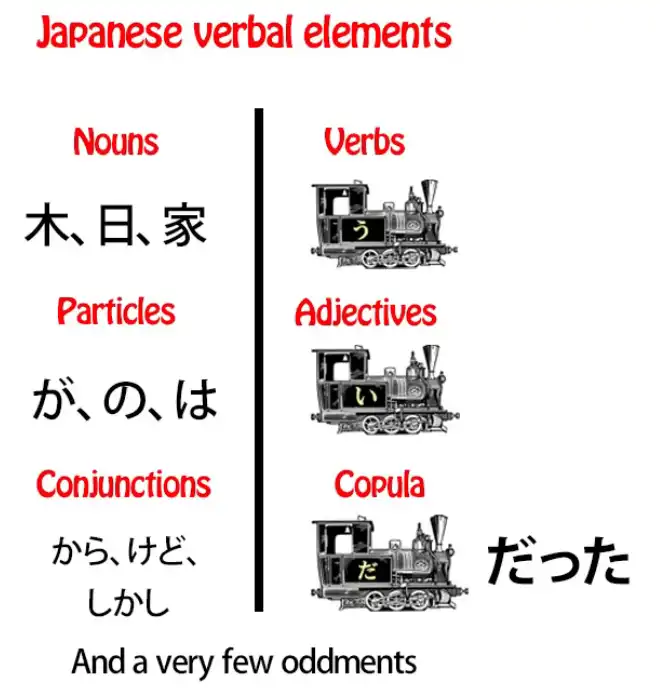
The fact that we know that it has one modulation just makes the whole thing more confusing.
It looks like an oddity. But it isn’t an oddity.
Just like verbs and adjectives, the copula is a fully transforming element.
It has a て-form, just like verbs and adjectives. And that て-form is “で”, and it’s the same て-form whether it’s the “だ” version or the “です” version.
And it has a connective form (な), which is used when it’s going before the noun it modifies rather than after the noun it modifies.
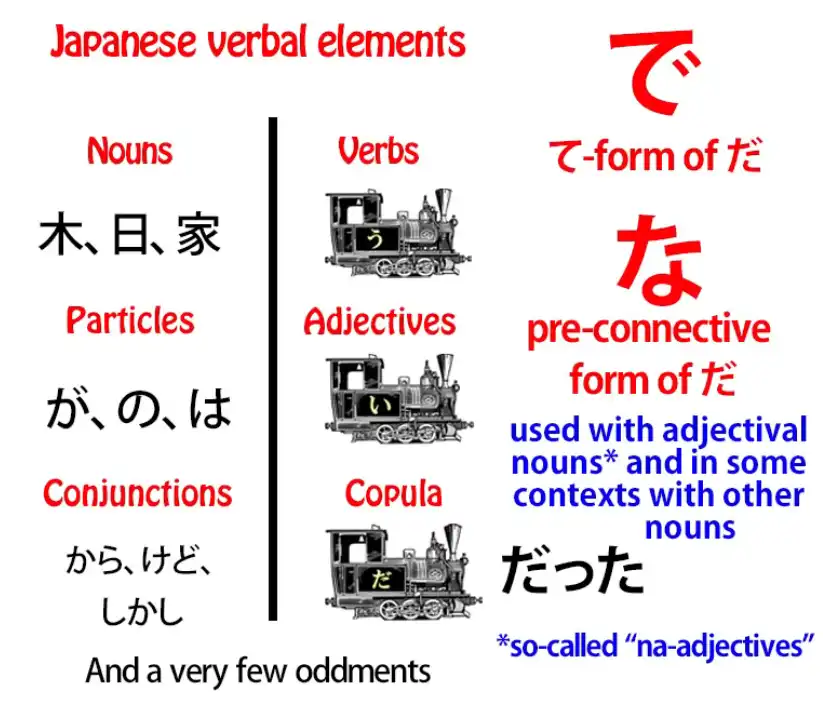
We can say, “女の子は綺麗だ” (the girl is pretty), or we can say “綺麗な女の子”.
And when we turn it around this way, the “だ” has become “な”.
If we want to chain two adjectival nouns together, we use the て-form of the copula.
And this is just the same as what we do with adjectives.
If we want to say “Sakura is small and pretty”, we say “さくらが小さくて綺麗だ”.
If we want to say, “Sakura is pretty and small” (pretty, “綺麗”, is a noun, an adjectival noun – we know it’s a noun because it can be written with all kanji and anything that’s written with two or more kanji and almost everything that’s written with one kanji is always a noun), we say “さくらが綺麗で小さい”.
If we want to say “Sakura is genki”, we say “さくらが元気だ”.
If we want to say “Sakura is genki and pretty”, we say “さくらが元気で綺麗だ”.
Note: I guess that since copula attaches to a noun, it is why we have both て-form of the copula 「で」after 元気 & also the regular copula form だ at the end after 綺麗. So basically 2 copulas but one of them is also chaining the nouns together. But just my guess, so take it with a salt. And you see we’ve done exactly what we do with adjectives.
With adjectives, if we want to chain two adjectives together, we put the first one into the て-form: “さくらが小さくてかわいい.” Note: If I understand correctly, the て is the adjectival joining copula form like で, and the last い in かわいい is the plain copula form of the adjective as given in lesson 6. — If we want to chain two adjectival nouns with their attached copula together, we turn the first copula into its て-form, which is “で”.
Now, for some reason the textbooks never explain this.
They try to tell us that adjectival nouns are some weird thing called a “な-adjective” that has this thing called “な” stuck onto it for no reason that we can possibly understand, even though when it comes at the end of a sentence it has “だ” like any other noun.
And then, when we want to chain two together, most people, I think, seriously believe that the で-particle, for no possible explicable reason, is used for this purpose.
Of course, it’s not the で-particle; it’s the て-form of the copula “だ” or “です”.
And I think it’s the fact that this is never explained that allows Tae Kim-sensei to believe that “だ” is simply a declarative.
If it was a declarative, why would it need a て-form?
Why would you need a て-form on what’s essentially just a verbal exclamation mark?
Why would you need a soft connective form on what’s essentially just a verbal exclamation mark?
You wouldn’t.
But because conventional Eihongo Japanese never makes it clear to us that this is what’s actually happening, that “な” is the pre-connective form of “だ”, that “で” in these cases is the て-form of “だ” the copula, because it never explains that, it makes it possible for even someone as intelligent as Tae Kim-sensei to misconceive what “だ” actually is and what it actually does.
And having done that, we’ve really lost our grasp of the three fundamental engines of every Japanese sentence.
And I should say that “だ” and “です” aren’t in fact the only two forms of the copula in modern Japanese.
They’re the most common forms, but there are also two others.
である copula form
Sometimes we use “である”, which is a bit of a fossil.
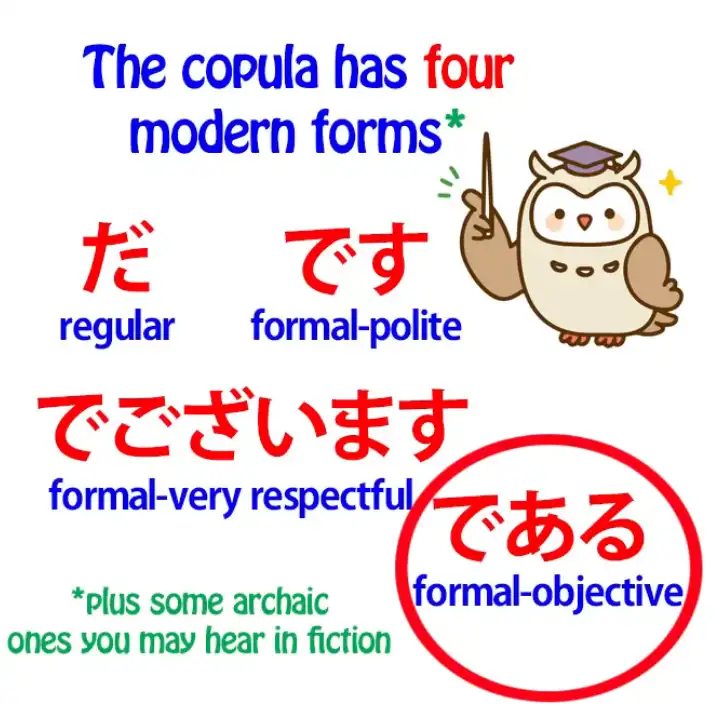
It’s an old form of the copula and it’s used in formal but not necessarily polite contexts.
So it can be used for example in newspaper reporting where it’s just being formal and objective, not particularly polite.
The famous novel “I Am a Cat” is, in Japanese, “我輩は猫である”, and the reason it uses “我輩” for “I” and “である” for the copula conveys in Japanese, in a way that the English translation can’t convey, the character of the cat in question, who has the personality of a rather “偉そう”, a rather self-important gentleman who refers to himself as “我輩” and uses the rather archaic and formal but not particularly polite copula “である”.
Note: わがはい has two forms - 我輩 and 吾輩, they are basically identical, but apparently,
it seems that 吾輩 is a bit less pompous/restrained and 吾 is not a 常用漢字.
でございます copula form
The other copula that we’ll hear often is “でございます”, and that’s ultra-polite.
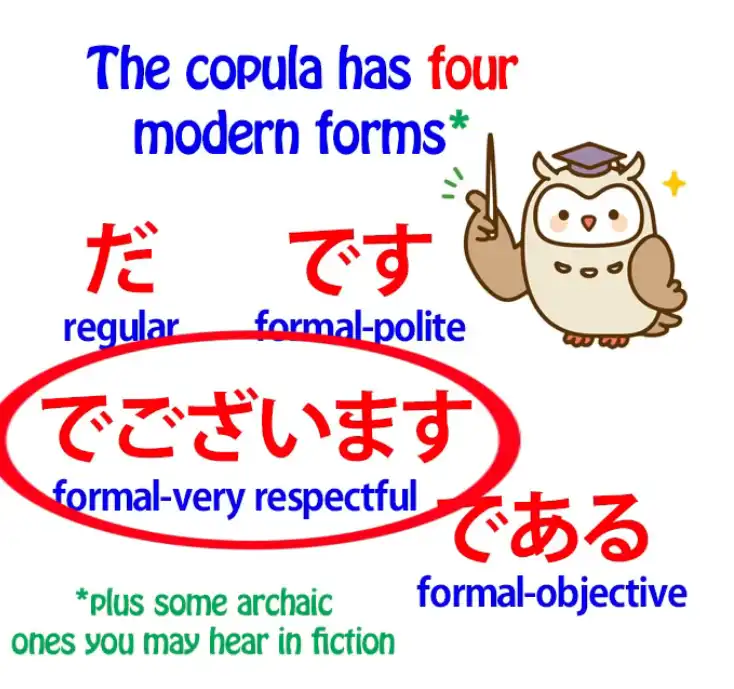
It’s 敬語, and you’ll have this used to you in Japanese hotels and places like that.
All of them are forms of the copula,
and all of them have the same て-form, “で”, and the same connective form, “な”.
です & ます eccentricity
Now, the other thing, I think, that makes it possible to imagine that “です” is not the same copula as “だ” is that “です” and “ます” are both a little bit eccentric – and I’ve made a whole video on this. (Lesson 17) And it’s for this reason, because their eccentricities actually disrupt our grasp of fundamental core Japanese grammar – once we’ve got used to it it’s easy enough to add “です” and “ます” on, but it’s best to leave them alone at first because they do things that no other modern Japanese words do.
And a thing that “です” does in this case is that it can be added to adjectives.
So we say “女の子がかわいいです”.
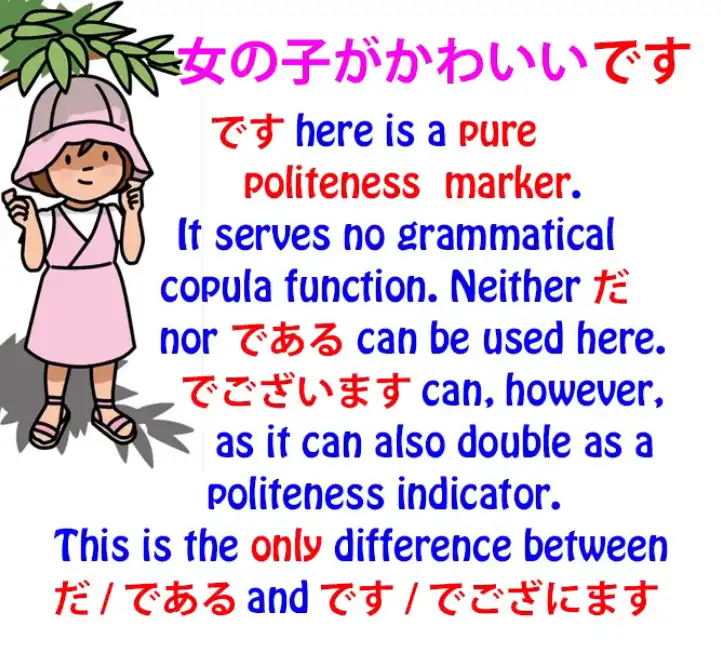
Note: Although this will be touched upon in Lesson 79. It isn’t just a random empty marker. Now, this “です” is not acting as a copula. It’s simply a formality marker.
And the reason it’s there is because there isn’t a formal version of the adjective engine.
And it only happens in this one case, and it only happens because adjectives don’t have another way of formalizing themselves and somehow Japanese settled on this idea of using the formal copula as a formality marker in that particular case.
The other, non-polite forms of the copula, “だ” and “である”, are not put onto the end of adjectives.
And of course it’s not just a question of adjectives.
The connective form of the copula and the て-form of the copula are used in various places in Japanese to form a variety of different constructions.
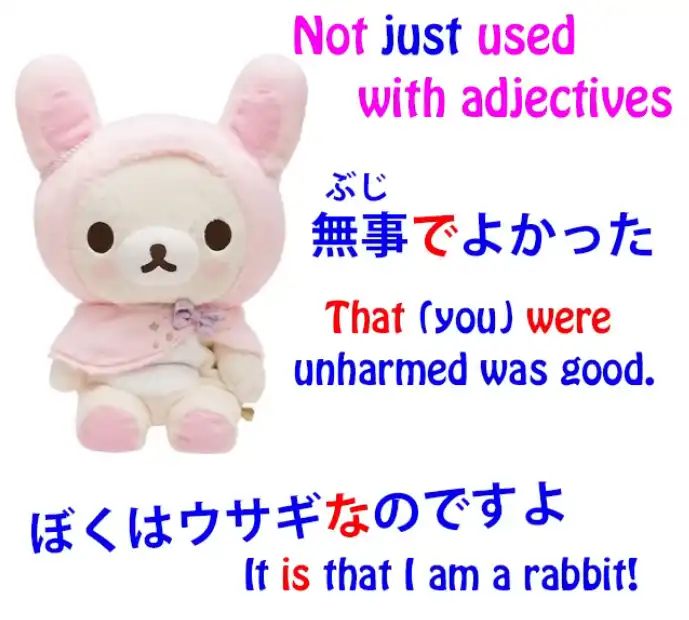
And I’ve included some of these in a video (should be Lesson 40) that I’ll link above my head and in the information section below if you’d like to follow it up a bit.
And if we don’t know that the copula has a て-form, or a connective form, then we’re going to have a lot of difficulty in understanding what these constructions are actually doing.
And if we follow the conventional Eihongo Japanese grammar we probably won’t know this, and if we follow Tae Kim-sensei we won’t even know that there is a copula.
And this is going to make all kinds of constructions extremely difficult.
The matter with conjugation
And we should really touch here on the other problem with Tae Kim, which is not actually worse than the Eihongo textbooks, but it’s no better.
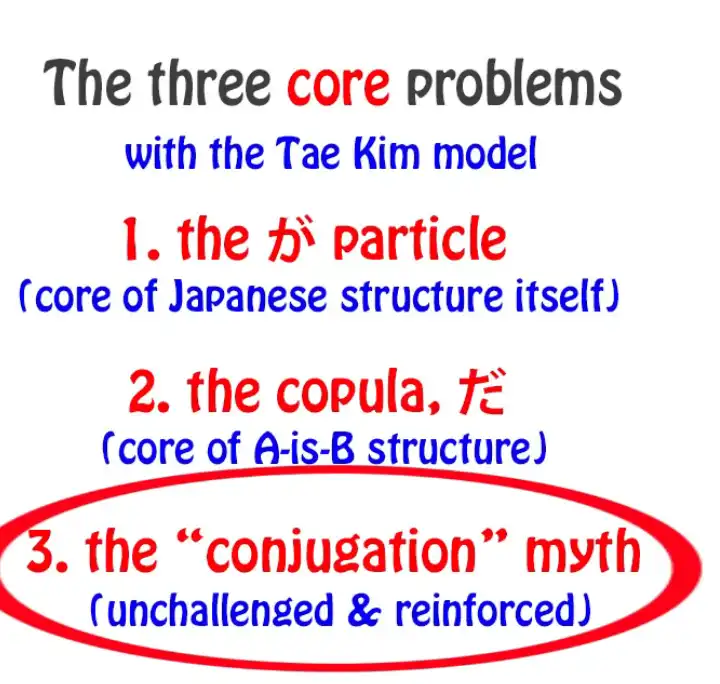
And that is that he, like them, accepts the myth of “Japanese conjugation”.
He believes that Japanese verbs conjugate, when all they actually do is change one kana and attach helper nouns, verbs and adjectives.
Note: Rather as in terms of Western language structure and logic. Linguistically, I think it could be argued whether Japanese truly doesn’t have or does have a certain kind of conjugation…
All-in-all, in the end it doesn’t really matter as long as Japanese is approached as Japanese.
And that becomes important in this particular case because it makes it appear
that this eccentricity of “です” covers a wider range than it really does.
If I say that “です” is only used as an empty formality marker on adjectives, someone who is following either conventional Japanese or Tae Kim may say “Well, it’s not only adjectives. It also happens to conjugated verbs, like for example ‘食べないです’ or ‘食べたいです’.
They’re not adjectives, are they? They’re conjugated verbs.” And the answer to that is, of course, yes, they are adjectives.
They’re not conjugated verbs. There are no conjugated verbs in Japanese.
“ない” is a helper adjective that is attached to the stem of “食べる”.
“たい” is another helper adjective that is attached to the stem of “食べる”.
And I’ve explained all this in my video about the Japanese stem system. (Lesson 7.5) These helpers look like adjectives, they function in every way like adjectives, and there’s a good reason for it. They are adjectives.
So, the empty formality marker version of “です” does not attach to all kinds of different words.
It only attaches to one kind of word and that is adjectives.
And this indicates to us how one logical error in Japanese actually feeds into others.
Because we don’t understand that the copula modulates, it can feed into a much greater error: that there isn’t a copula at all.
Because we don’t understand the stem-and-helper system and believe that Japanese verbs conjugate, we can believe that
the empty formality marker “です” is used in a wide range of different situations
when in fact it’s only used in one situation.
Now, as I’ve said before, I’m not trying to attack Tae Kim-sensei.
He’s done a great deal of exceptional work and the fact that he’s misconceived a lot of Japanese is essentially because he’s seen what’s wrong with conventional Eihongo Japanese grammar and tried to tidy it up.
Unfortunately, instead of sweeping it into the trash can, he’s swept it onto the living room carpet.
But that isn’t because he’s illogical.
It’s because he’s logical and he just didn’t get exactly what was going on.
And that’s not surprising, because nobody’s teaching it, nobody’s telling anybody.
So I hope I’ve helped to set things a little bit straight here..
Note: Have been trying the underlines again, in this style I feel it looks quite good and can help show the important parts better. But you can of course let me know your view on it (o≧▽゜)o
79. Deeper secret of the copula
1/3 of all Japanese sentences cracked! Deeper secret of the copula. +The Tae Kim fallacy - Lesson 79
こんにちは。 Today we’re going to talk about something that’s absolutely crucial to the core structure of Japanese.
We’ve talked about this recently in relation to Tae Kim-sensei and the way he disrupts our understanding of this particular thing.
What it is is the copula, and this really governs an awful lot of what we can say and communicate in language itself.
It’s crucial to how we conceptualize the world.

Now, Tae Kim never actually uses the C-word, “copula”, and that’s a large part of the problem.
But some people may be asking not so much why Tae Kim doesn’t, as why I do.
After all, I try to avoid technical linguistic and grammatical terminology as far as possible.
I don’t often use the word “grammatical subject”; I even less often use the word “predicate”.
I prefer to say “A-car” and “B-engine”.
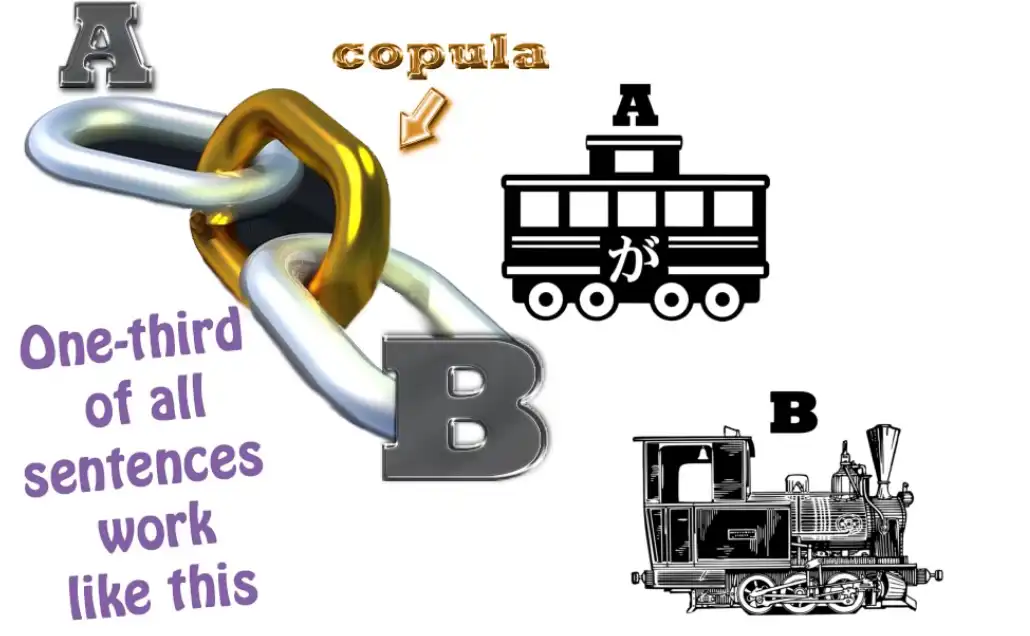
That way we all know what we’re talking about.
So why do I use this abstract and rather horrible word, “copula”?
What is a “Copula”
Well, the reason is that English doesn’t have a dedicated copula, so it can be quite difficult for English speakers to grasp exactly what a copula is.
I have to introduce that function as something in itself.
When Tae Kim talks about copular expressions, he refers to them as “state-of-being” expressions, and this really is the key to the whole problem.
So, what is the copula, and why does English not have a dedicated copula, and why does it matter so much?
Let’s start off with “what is a copula?” The simplest way of defining a copula is that it is a one way equals sign.
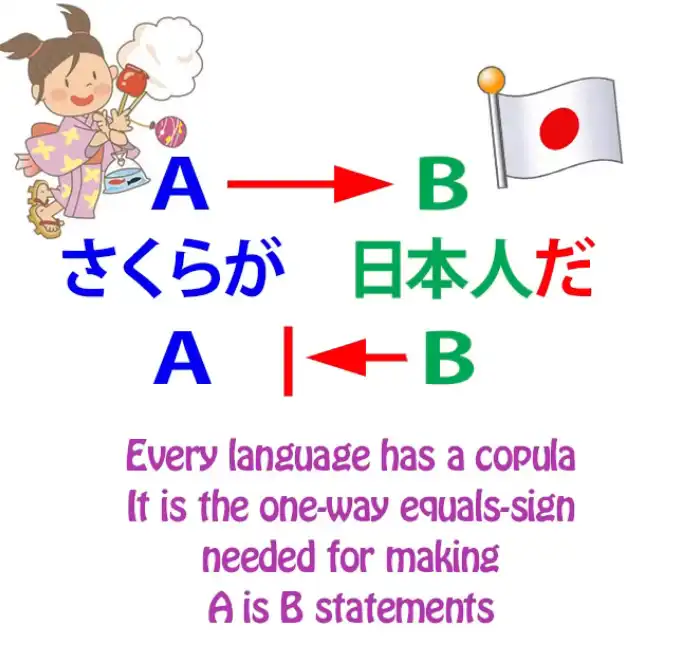
It tells us that A is B, although B is not necessarily A.
So, “さくらは日本人です”. (Obviously, だ also) Sakura is a Japanese person; a Japanese person is not necessarily Sakura.
Now, that is the simple explanation.
But if we go a little deeper, what the copula actually does is place things in sets.
“さくらは日本人です” means that Sakura belongs to the set “Japanese person”.
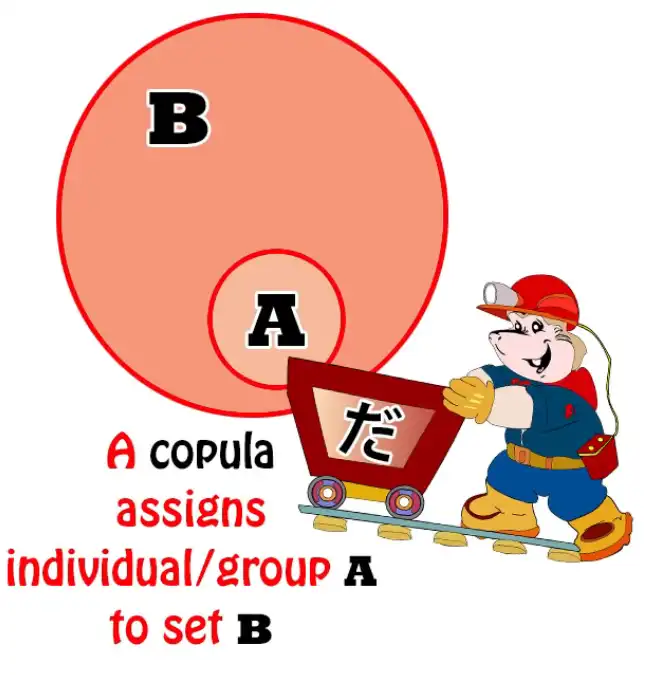
And this is fundamentally important for language, which is the tool humans use to conceptualize the world, the things they see about them, the visible and perceptible universe.
Placing things into categories is our most fundamental way of dealing with them.
A rose belongs to the set “flower”.
Flower belongs to the set “growing things”.
Growing things belongs to the set “living things”.
Living things belongs to the set “things”.
All the time we are placing things into sets, and that’s the way we conceptualize them.
We could say very little about anything if we weren’t able to place things into sets.
So this, fundamentally, is what the copula does.
It gives us a very simple, straightforward, unfussy way of putting anything into a set at any time, of defining at any time the set to which something belongs.
Now, the set may only be a set of one. In that case the equals sign works both ways.
So, for example, if I say “That person over there is Sakura”, well, that particular person over there and Sakura are the same person.
Sakura is a set of one to which that person over there, and that person over there only, belongs.
At least, this particular Sakura. We’re not talking about all people called Sakura, obviously.
So this is what the copula does. Why so much confusion about it?
Isn’t it a relatively simple function? Well yes, it is a simple function.
The main problem here, as very often with Western misconceptions of Japanese, lies not in Japanese but in the nature of the English language itself.
English, as I said, doesn’t have a dedicated copula.
It does have a copula. Every language has to have a copula.
If we didn’t have something that performed the copular function, we just wouldn’t be able to put things into sets, which means that we would be very limited in our ability to conceptualize things.
So what English does is that it doubles up the verb of being with the copula.
The verb of being is something that simply tells us that something exists.
It has various forms: “is / am / are / was” etc.
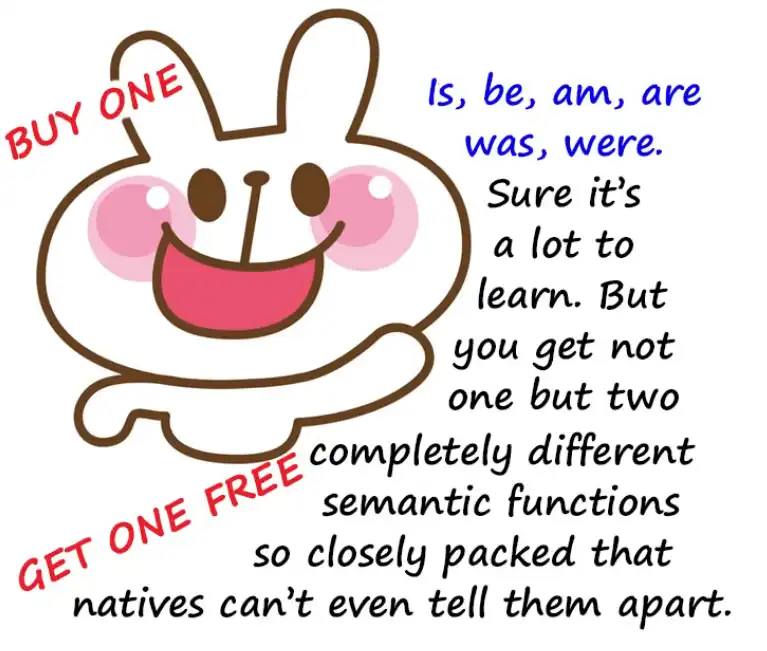
So, if we say “I am an American”, that’s the copula at work.
We’re saying I belong to the set called “American people”.
If we say “I think, therefore I am”, we’re using the verb of being.
We’re not saying anything about what I am, what set I belong to.
We’re simply saying that because I think, we can state confidently that I exist.
Now, because English does not have two separate words for those two concepts, it doesn’t actually cause much trouble to native speakers of English or to foreign speakers who have learned English at least partly through immersion, because after a while it all becomes clear through usage and experience, but it does cause trouble when English tries to look at languages that have a separate copula.
Japanese obviously is one of these, and Spanish is another.
The Spanish language has two copulas, “ser” and “estar”: “ser”, which tells us the permanent set to which something belongs, and “estar”, which tells us the relatively temporary set to which something belongs.
That’s a distinction that most languages don’t make. But the important distinction here is that “ser” and “estar” are not the same as “haber”, which is the verb of being.
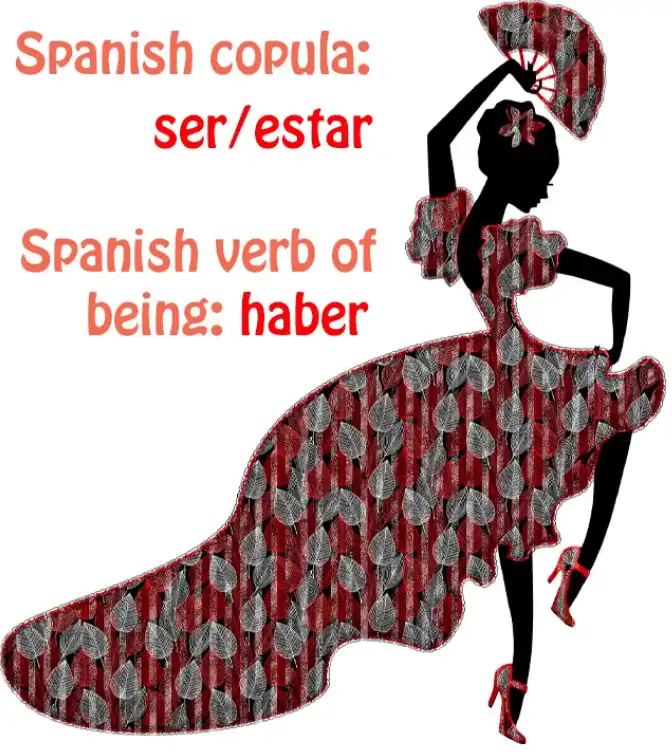
So if we say “Estos son huevos”, we’re saying “These are eggs”; (“son” should be copula here)
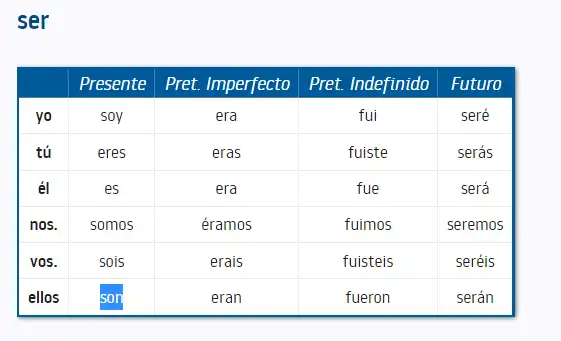
if we say “Hay huevos”, we’re saying “Eggs exist” – two entirely different kinds of statement.
As I say, in English we don’t get confused between those two kinds of statement, but when we try to apply English explanations to languages that do have different words for the copula and the verb of being, confusion often ensues.
だ & です being the same copula
Now, some of the people who commented on my video on Tae Kim versus the copula were not entirely convinced by my argument that “です” and “だ” are the same thing, because Tae Kim argues so strongly that they aren’t.
I think I disposed of most of them. I didn’t dispose of all of them because I wasn’t trying to be exhaustive.
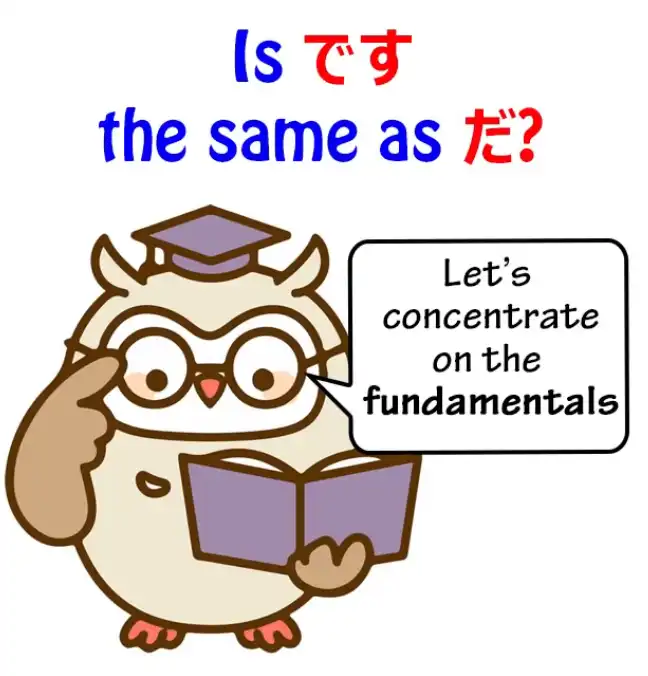
And I’m not going to deal with those arguments here either, because I think they’re peripheral.
I will in fact be dealing with them in a video in the fairly near future, but the point here is that taking arguments like “だ isn’t necessarily needed in this case but です is” as a way of sustaining the larger argument that “だ” and “です” are not the same thing is taking the whole thing upside down and inside out.
What’s important is not that “だ” and “です” function a little differently in this way or that way, that “だ” can be dropped here and “です” can’t be dropped there, things like that.
They’re entirely peripheral to the issue of the fact that they are both the copula.
And the fundamental argument against this fallacy is simply this: we know that every language needs to have a copula.
Without a copular function, you can’t say half of the things that language absolutely needs to say.
You don’t have a real language.
You have a broken language if you don’t have any copular function.
Now, Japanese sometimes speaks in 丁寧語 (in です/ます speak = polite language) and sometimes speaks in straightforward, plain Japanese.
The copula in one is “です” (polite); the copula in the other is “だ”. (plain) Now, if you’re going to argue that they’re not the same thing, therefore that one of them is not the copula, then you have to come up with what the copula is, in either plain language or 丁寧語 (です/ます language), because both of them have to have a copula.
You have no language without a copula, so it’s incumbent on you, if you’re saying that they’re not the same thing, to tell us where the copula lies in both those forms of speech.
And of course Tae Kim never tackles this problem because he doesn’t really seem to understand that there is a copula as opposed to what he calls “the state of being”.
Copula vs state of being
Now, another thing that people may raise is they may say, “Well, surely it isn’t just an accident that English uses the state of being to mean the copula.
Aren’t the two things somewhat closely related?
After all, in older forms of the Japanese copula, like ‘である’ and ‘でございます’, the state of being plays a role. ‘ある’ and ‘ございます’ are state of being words even though the ‘で’ changes them to copula.”

And the answer to that is absolutely yes.
And the reasons for this lie in the human perception of ontology, that’s to say, the science or philosophy of being itself.
Humans tend to believe that the set a thing belongs to is fundamental to its being.
And in a sense that’s certainly true.
We define something by the set it belongs to, and its existence as the being it is, as opposed to any other being, is fundamentally tied up in the set to which it belongs.
A rose belongs to the set “flower”. Once we know that, we can guess all sorts of things about it.
We may not know exactly what it looks like, but we can say that it probably has a stem, has petals, has leaves, grows in the earth, etc. etc.
So the set something belongs to is crucial to its existence as that particular being and not another being.
But understanding that the state of being and the set to which something is attributed are related semantically doesn’t mean that we ought to confuse the two.
When we say “I am an American”, we do not mean the same thing by “am” as we do when we say “I think, therefore I am.” If we believe that the Japanese copula, which is expressed by “だ” or “です”, and the state of being, which is expressed by “いる” or “ある”, are in fact the same, we’ve simply lost a fundamentally important distinction in Japanese.
Of course, Tae Kim-sensei doesn’t believe that, but at the same time he has great difficulty in clarifying what the distinction is, and that’s how we can end up thinking that “だ” and “です” are not the same thing.
There are a few cases where “だ” can be dropped, sometimes grammatically, sometimes ungrammatically, which do not apply to “です”, that’s true, but they don’t affect the fact that they’re both the copula.
One case of です not functioning as a copula
There’s one case where “です” is used where it doesn’t function as a copula, and that is the case of adjectives.
As I demonstrated in that previous video (Lesson 78), adjectives are the one case where “です” is used and it’s not the copula, it’s just an empty formality (politeness) marker.

#
です in adjectives is not just a random politeness marker
But there’s another point that we have to consider here, and that is that while in those cases – that’s to say, in the case of adjectives and no other case (it only happens in the case of adjectives as I demonstrated in that video) – while in the case of adjectives it’s true to say that “です” is an empty formality marker, it’s not just a random empty formality marker.
Like I mentioned earlier, です / ます are rather politeness markers, not formality markers. They are part of the 丁寧語 (polite language). So it is more accurate to call them polite instead. As we know, there are only two kind of sentences, A-is-B sentences and A-does-B sentences, and in Japanese there are two kinds of A-is-B sentences, that is, adjective sentences, that in their simple form have to end in -い, and copular sentences, which have to end in “だ” or “です”.
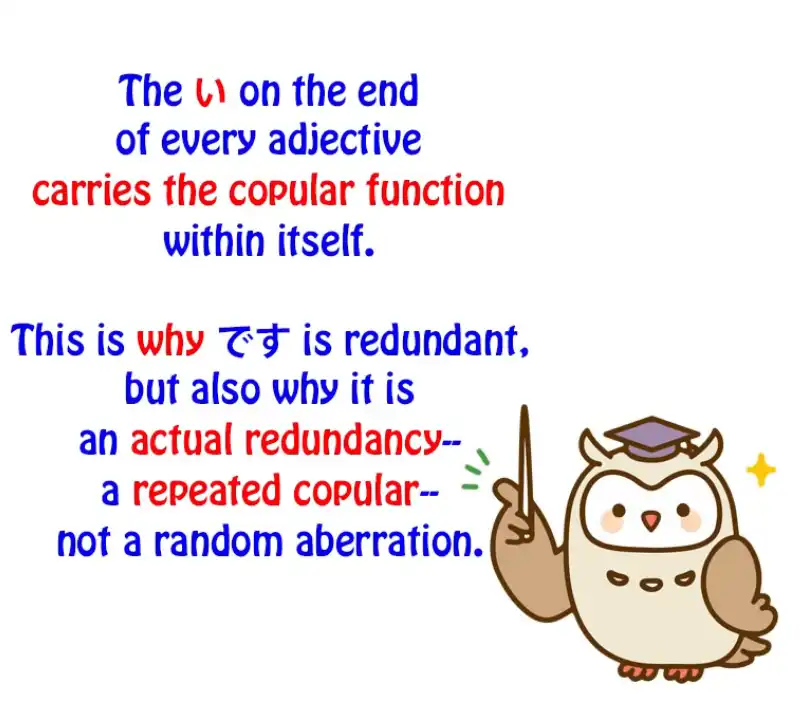
Note: JUST IN CASE, this and this, it may be beneficial not to mistake the -い to be a copula proper like だ, but rather a predicative suffix for ADJECTIVES that can end a sentence in itself.
It shows “X is / = this adjectival quality”, e.g. likely why it carries the copular function in itself.
This is also why だ is not used with it since it is redundant as the -い already basically implies it.
Dolly explains it that way - carrying a copular function within itself & likely why だ isn’t used.
But there are different stances you can check by searching on this issue, some refer to -い as “sort of a copula”, others don’t, some even question whether Japanese has adjectives at all.
But overall it does not entirely matter how it is called, what matters is that you understand how it works in the language & how it is used properly. As not all words ending in -い are an adjective automatically, since there may be a hidden Kanji form etc. Although in 98% it is an adjective.
Basically, Dolly is there to give you the basics, if you go into the depths, things are rarely straightforward & universal. Language is a very complex construct & doesn’t quite work like that.
E.g. why there are so many ways to study it, interpret it & explain it. Choose what works for you.
So what’s happening when we put “です” at the end of an adjective sentence
is that we’re doubling the copular.
Saying “さくらはかわいいです” is like saying “(Speaking of) Sakura (she) is-cute is”.
Saying “ペンが赤いです” is essentially saying “Pen is-red is”.
We’re doubling that copular.
So while “です” is an empty formality marker, it’s not just a random formality marker.
It’s doing something that is sometimes done in languages, and that is, (it is) acting as a redundancy – saying the same thing twice.
Note: I understand that since it’s a redundancy, we may say that it’s not a copular that is strictly used to fulfill the copular function of the clause or sentence, but rather its main focus is that it provides this politeness aspect to the copular in -い so as to show the sentence is polite. It is still a copula by all means, but since -い has a similar function, it mainly shows politeness. And that’s the only actual case where “です” does something different from “だ”.
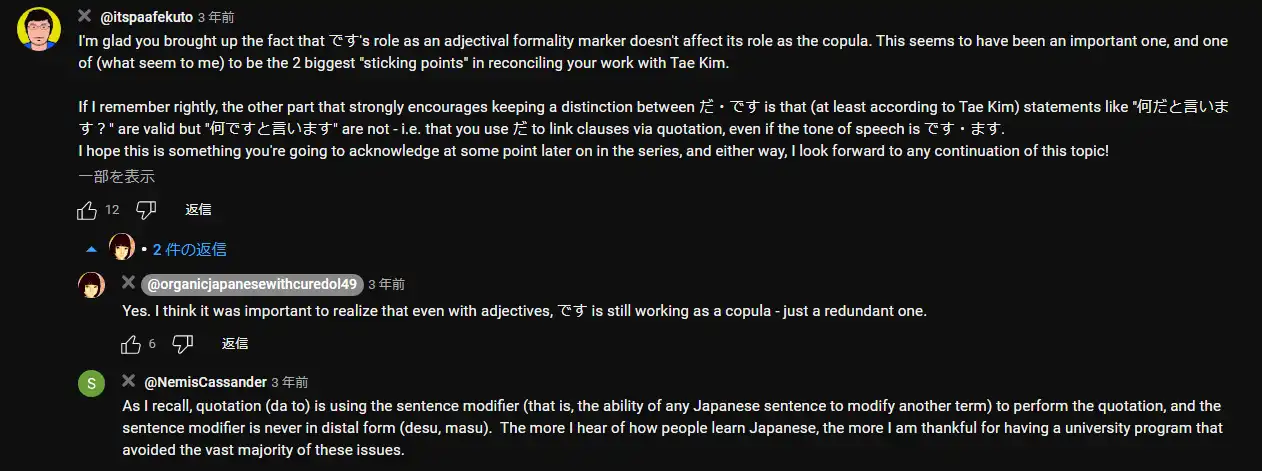
Note: Recommend reading the comments under the video as usual. Zoom-in if anything.
80. Dropped particles & casual omissions
Understand Japanese Even When they Leave Bits Out! Dropped particles & casual omissions - Lesson 80
こんにちは。
Once we start seriously immersing in
and consuming actual Japanese material,
often colloquial and casual, not textbook Japanese,
one of the problems that many people encounter is the idea that –
“Good heavens, they leave out half of what they’re going to say!
They’re omitting this and leaving out that,
and how are we supposed to guess what they’re actually talking about?”
Now, this isn’t nearly as much of a problem as it can seem at first,
but we need to know what’s going on and what to look for.
So, first of all let’s talk about omission in language.
There are fundamentally two kinds of omission in language: legal omission and illegal omission.

Legal Omission
Legal omission is when it’s perfectly grammatical within the terms of a particular language to leave something out.
This happens in English.
For example, if we say in English “The night we met”, that’s considered a grammatical phrase.
What we actually mean is “The night that we met”.
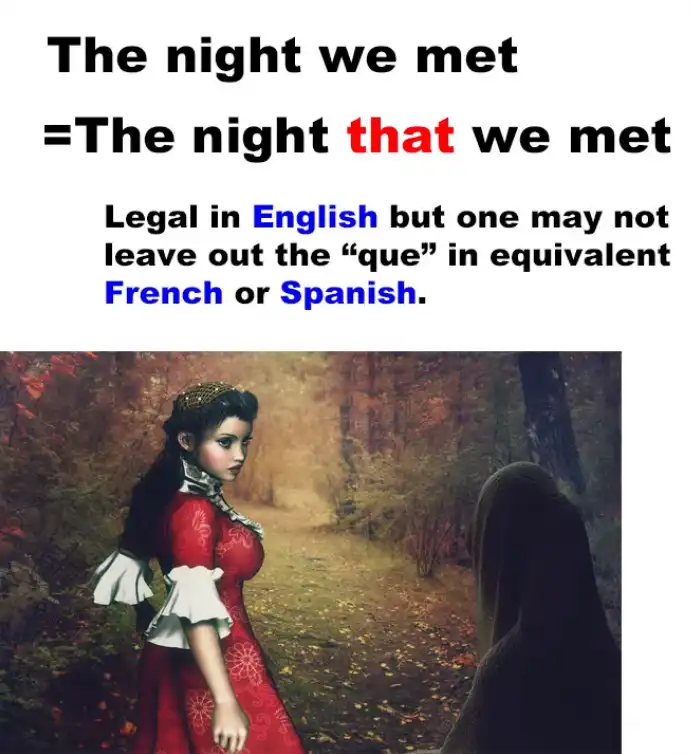
And in French or Spanish you can’t do that.
You can’t leave out that “that”, which is “que” in French or Spanish.
But in English you can.
In English it’s part of the rules of English grammar that that everybody’s going to understand what you mean and you’re allowed to leave it out.
You can do it in an academic paper or a legal document.
You can do it anywhere. It’s not ungrammatical.
It’s not an illegal omission. It’s a legal omission.
#
The zero pronoun
Now, this happens in Japanese, and a very, very common example, of course, is the zero pronoun.
If we say “(zeroが)疲れた”, which is “tired”, we mean “I am tired”, and this is a hundred percent legal, grammatical Japanese.
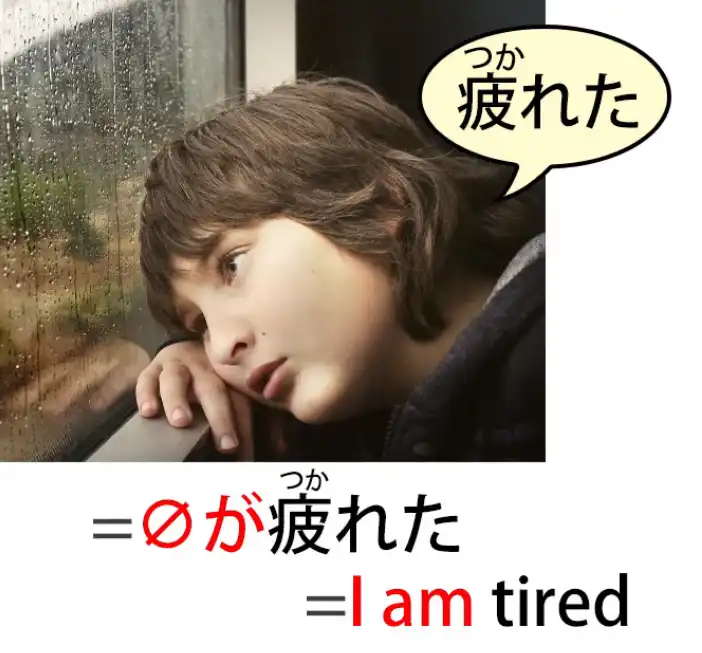
You can use it in an academic essay or a legal document or anywhere.
It’s understood as perfectly grammatical Japanese.
There’s no question about what you mean by it.
Firstly because the zero pronoun always defaults to “I” and secondly because Japanese, as we know, is very strict in saying that we can only talk about things we are actually capable of knowing.
So we can’t talk about someone else’s state of emotions.
We can’t talk about someone else liking or disliking something.
We can only say that they appear to like or dislike it.
And we can’t say that someone else is tired.
So “疲れた” can only mean “zeroが疲れた/ 私が疲れた”.
So this is a legal omission.
Illegal omission
But there’s also a lot of illegal omission that goes on in all languages, and in casual speech as opposed to very formal speech it’s completely legal.
So strictly speaking it’s illegal, but in terms of ordinary, everyday, casual speech, it’s legal.
So what kinds of accepted but strictly illegal omission are there?
Fundamentally, three kinds.
#
Leaving out bits of words or phrases
The first is when we leave out bits of words or phrases.
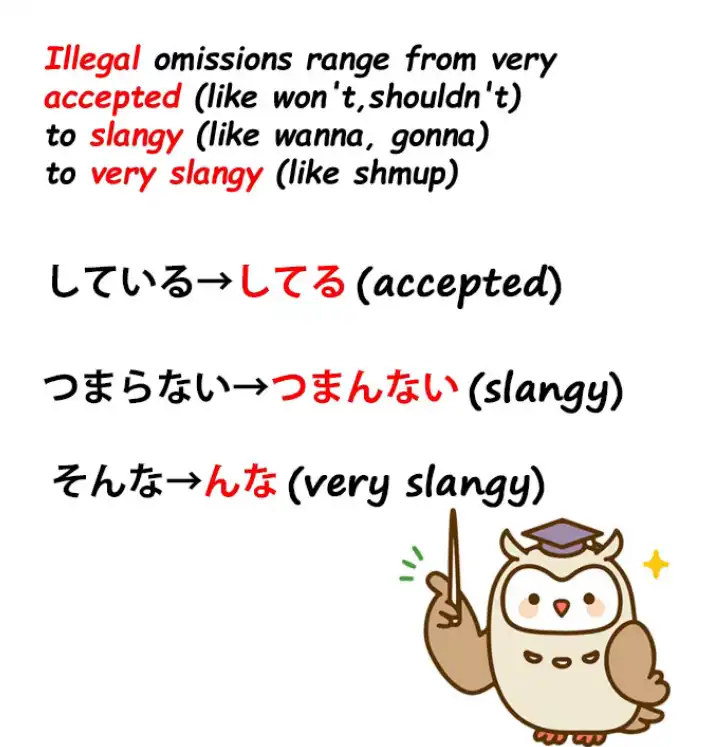
So, for example, instead of “している” (am doing / is doing) we say “してる”; instead of “しておく” (do and put in place) we say “しとく”.
Now, these are such regular illegalities that they’re really no different from saying “shouldn’t” or “hadn’t” in place of “should not” or “had not” in English.
You can use them almost anywhere, but not in the most formal circumstances.
A little bit further down the scale, we have things like saying “分かんない” instead of “分からない”, or “つまんない” instead of “つまらない”.
So that’s one type, and although it may take a little while to get used to the expressions, once you know them they’re no more difficult than anything else.
The other thing that gets left out a lot is anything that attaches to a noun.
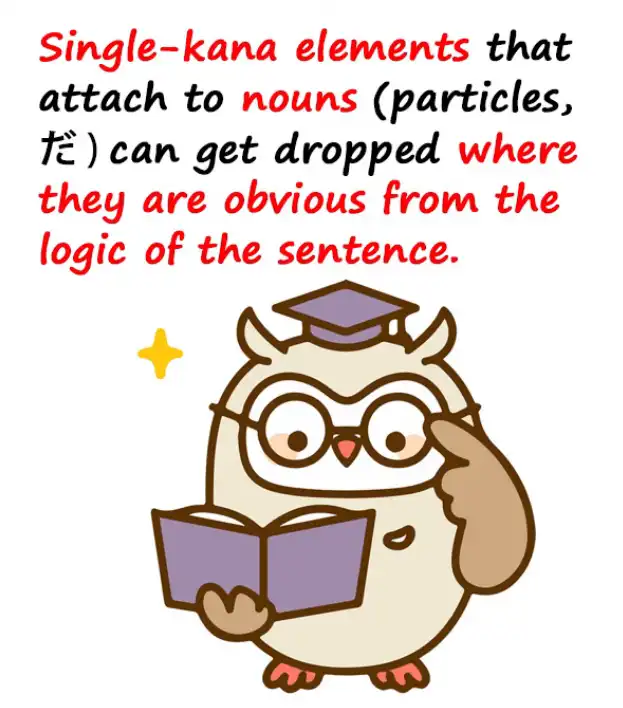
As I’ve said before, Japanese is a very noun-centered language.
And, as you know (Lesson 8b), nouns always have something stuck to them: a logical particle to tell us what role they play in the sentence, sometimes a non-logical particle, and sometimes a copula.
Now, just about all of these can be dropped at some time.
If it’s clear without the marker what role a noun is playing in the sentence, we can in casual speech, not in formal speech, but in casual speech, we can leave off that marker.
The markers that get left off most often are が, を, and the non-logical topic marker は, and also the copula “だ”.
So, for example, if I say “私アンドロイド”, I’ve left off what would probably have been a は after my name.
I’ve also left off “だ” after “アンドロイド”.
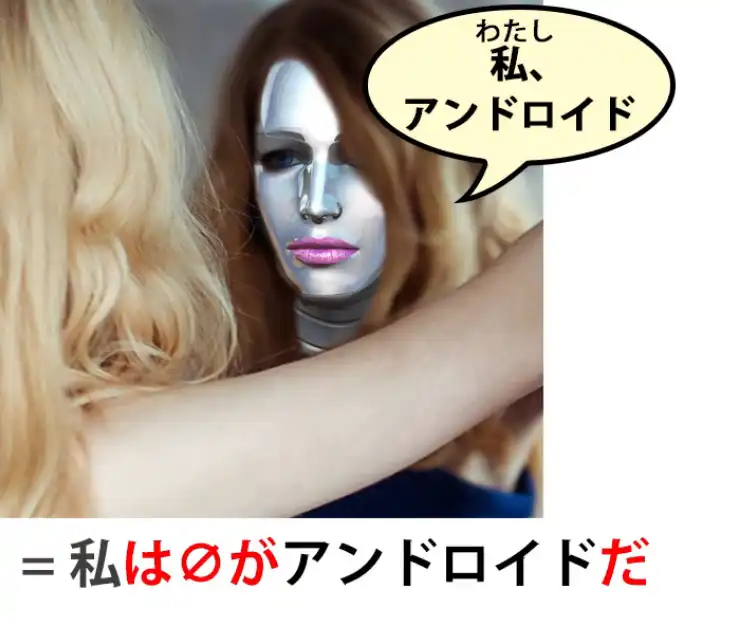
Now, if you know that I’m introducing myself or saying something about myself, there’s no doubt about what’s going on here.
And… I don’t want to go back too much to the subject of Tae Kim-sensei, I’ve done a three-part series about the things Tae Kim-sensei teaches that he actually shouldn’t be teaching, and I’ll link to that (Lessons 77, 78, 79), but what I will do here is make a point that I didn’t make there which is that Tae Kim-sensei says that because “だ” is often dropped and “です” is not dropped, (according to him) they’re not really the same thing, they’re not both the copula.
#
Why だ is often dropped and です isn’t
And I’ve dealt with this at length and I’ve explained what a mess it makes of Japanese if you ignore the copula, so I won’t go over that again.
But the point I do want to make here is that the reason that “だ” can be dropped in places where “です” can’t are twofold.
First of all, why can “だ” be dropped as often as it is?
Well, if the textbooks taught us the basic structure of Japanese, it would be obvious, but of course they don’t.
The most basic thing about Japanese structure is that a Japanese sentence can only end in one of three ways.
And I think you know what those three ways are, don’t you? Let’s say it together.
A Japanese sentence can only end with a verb, an adjective, or a noun-plus-copula.
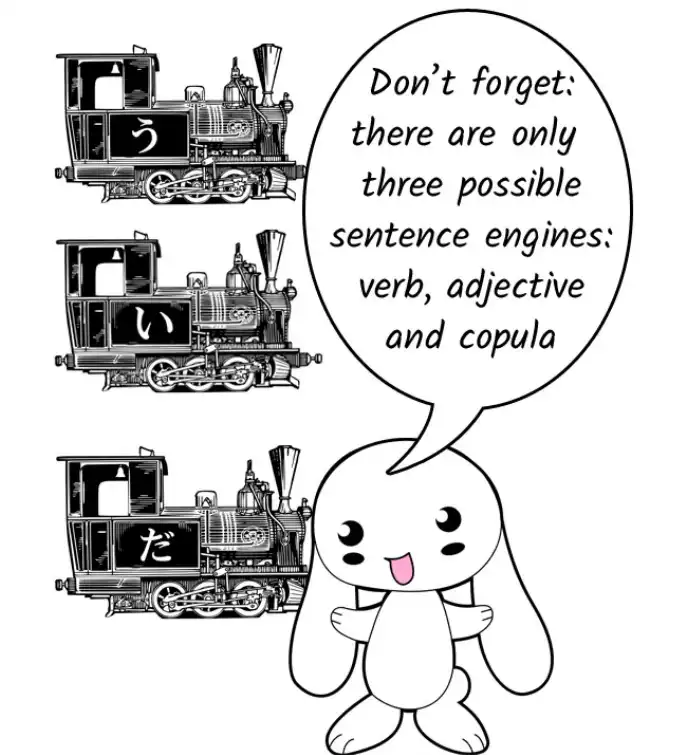
Now, once we know that, we know why the copula can get left off very easily.
As I said before, particles and the copula get left off where it’s obvious what the nouns were without marking them. That’s when they get left off.
Now, if a noun comes at the end of the sentence, we know that it’s not a verb sentence.
We know that it’s not an adjective sentence.
We know that it’s a noun-plus-copula sentence.
And since we know that, we can, if we want to, drop the copula.
And this, I think, is why Tae Kim-sensei gets lured into saying that “だ” is a declarative, a sort of verbal exclamation mark.
What he’s saying is that people use “だ” when they want to stress what they’re saying.
Well, there’s a certain amount of truth in that because the fact is that you can in casual speech always drop the copula and still be understood, so if you’re speaking at the kind of casual level where you probably would be dropping it, then when you include it is when you want to stress what you’re saying.
It’s not really as simple as that, because a lot of people don’t drop it, not everybody drops it all the time. It’s a bit more complex than that, but the idea that it is a declarative at least has that grain of truth in it that because you can drop it pretty much whenever you want to in casual speech, you often include it because you want to stress it.
So if it’s easy to drop the copula when it’s “だ”, why isn’t it easy to drop it when it’s “です”?
Tae Kim-sensei turns this into a whole argument for the fact that “だ” and “です” are two different things, but if you think about it it’s perfectly obvious why “だ” does get dropped (I’ve explained that already) and why “です” doesn’t.
“です” doesn’t get dropped because it’s formal speech.
In the first place, we drop less in formal speech.
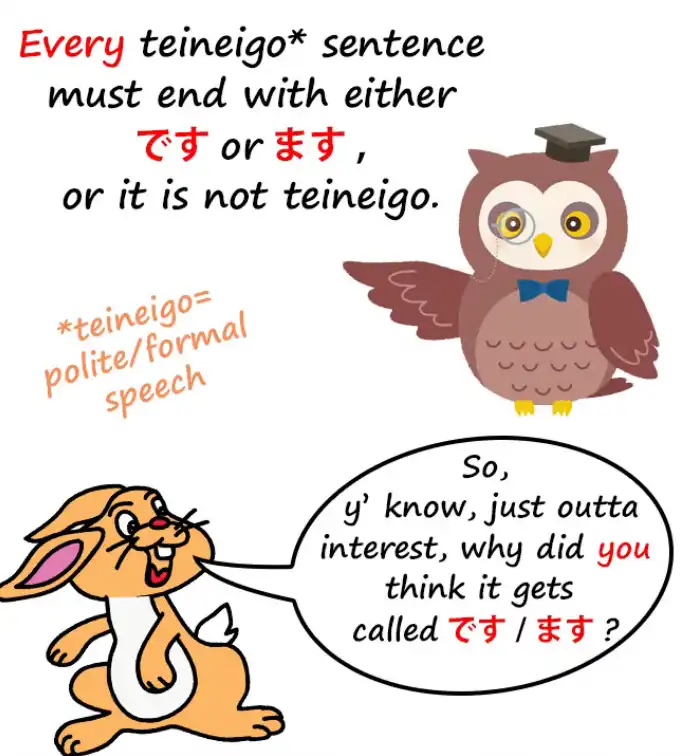
We don’t drop as many things in a formal sentence as we do in an informal sentence.
But even if we’re speaking formal speech at a loose level, where we can be dropping things out of the sentence, we won’t drop the “です”.
Why not?
Because there’s only one thing that makes 丁寧語 (です/ます level speech) into 丁寧語, and that’s the fact that we add the “ます” helper verb to the end of verb sentences and the “です” copula to the end of noun-plus-copula sentences and even, redundantly, to the end of adjective sentences.
So you can’t, in 丁寧語, drop the “です” without dropping the 丁寧語.
It’s as simple as that.
Now, there are various rules about when you can and can’t drop things like を out of a casual sentence.
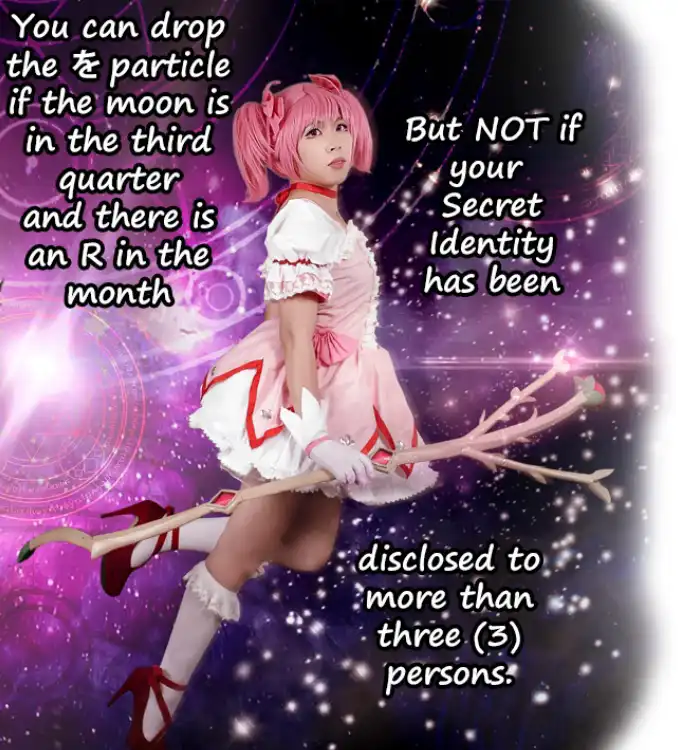
Note: Obviously it’s a joke…just in case (ノ*°▽°*) You can in theory drop something whenever it isn’t needed.
In practice there are places where it seems natural and other places where it doesn’t seem natural.
If you want to know the rules for it, sometimes they’re very complex and even when they’re very complex they don’t necessarily work all the time.
But you don’t need to know that.
Why don’t you need to know it?
Well, let’s think about this.
You need to know that they can be dropped and you need to know that they’re dropped in places where you can actually work out what they were going to be.
Once you know that, you’re not swimming in an ocean of strange vagueness where things get dropped and you’ve no idea what they are.
What you don’t need is to be able to reproduce very casual Japanese in exactly the way that Japanese people do it.
And that’s the only reason you’d need to learn these strange lists of rules.
If you just use all the particles all the time, occasionally, especially when you’re speaking casual Japanese, your Japanese will sound a bit stilted.
Well, what about that?
Language spoken by foreigners usually does sound a little bit stilted, doesn’t it?
You’ve probably noticed that in English.
If you’re going to be using Japanese a lot, gradually, bit by bit, you’ll get used to the places where you can naturally drop things.
If you’re not going to be using Japanese a lot, why do you want to sit down and learn a bunch of rules in order that you can pretend that you’ve naturally acquired Japanese when not only haven’t you, but you’ve no intention of doing so?
So my advice to you is “Learn Japanese naturally”.
Don’t try to memorize sets of rules when all they could possibly do is make you seem as if you’re more used to Japanese than you actually are.
But in practice they’re not even going to do that, because you will make mistakes.
The important thing to understand is how things get dropped in Japanese, why they get dropped in Japanese, and how to understand them when they have been dropped.
Note: Great advice indeed, Dolly (o≧▽゜)o #
Dropping entire clauses
The other kind of thing that gets dropped, the third category of things that get dropped, are essentially entire clauses.
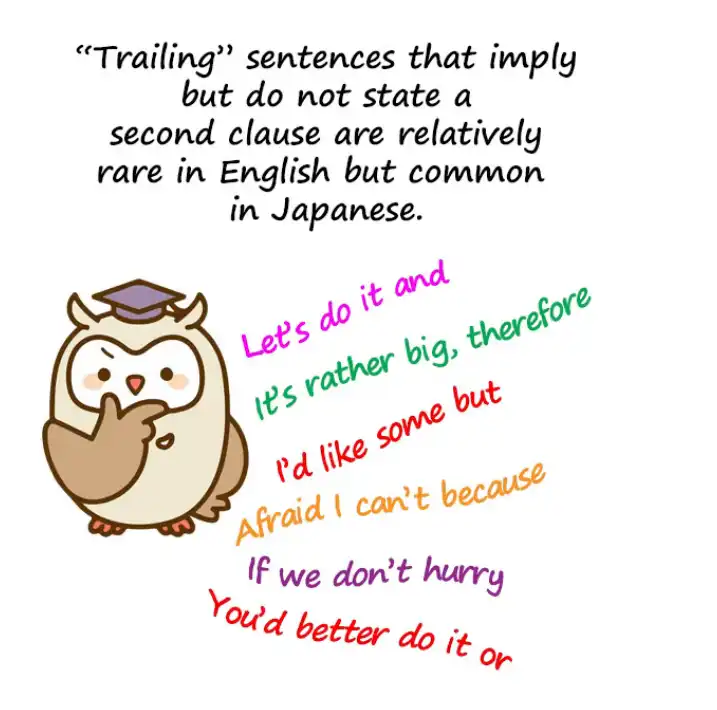
People often end a sentence with a て-form or a “because” or a “but” kind of ending.
And what they’re doing on these occasions is leading into a second clause that would add some more information but they’re not stating that clause.
And that can serve a variety of purposes.
It can hint at something they don’t want to say.
It can hint at something that they think is too obvious to need to be said.
Or it can be used just to soften the thing you’re saying right now or perhaps to strengthen it a bit.
I’ve talked about this in other places and I’ll link to the places where I’ve done that (Lesson 63).
But these are the fundamental principles of omission in Japanese, and once you know them, the whole thing becomes much less puzzling.
81. Global principle of all Japanese word-forms.
At last! The TOTAL structure of Japanese! Global principle of all Japanese word-forms. Lesson 81
こんにちは。 Today we’re going to talk about something we’ve never talked about before, which is the overall, global, cosmic structure of Japanese.
We’ve touched on it in the past, but I’ve never talked before about its totality.
And there’s a reason I didn’t do that, which we’ll come to in a minute.
What we’re going to talk about starts out with something you already know about, which is the stem system.
If you’ve been following my lessons at all, you know that there is no conjugation in Japanese.
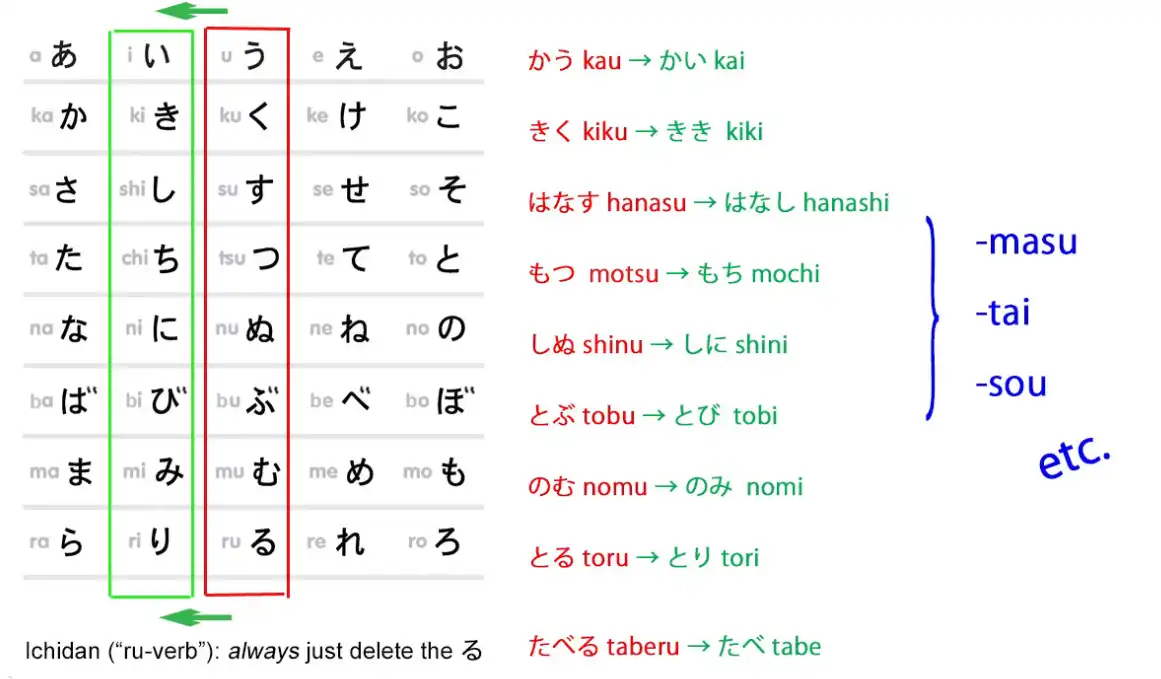
*Note: As you know, take this not as a definitive statement, it is just to dodge some associations that come from the word “conjugation” in terms of European languages, since there is a form of conjugation in Japanese, as given in the Lesson 7.5 note screenshot citation from Dolly’s book.
*Verbs just make a small change to the one kana on the end,
changing it from an う-row kana to one of the four other rows.
And then we attach various kinds of helpers, helper nouns, helper verbs, helper adjectives.
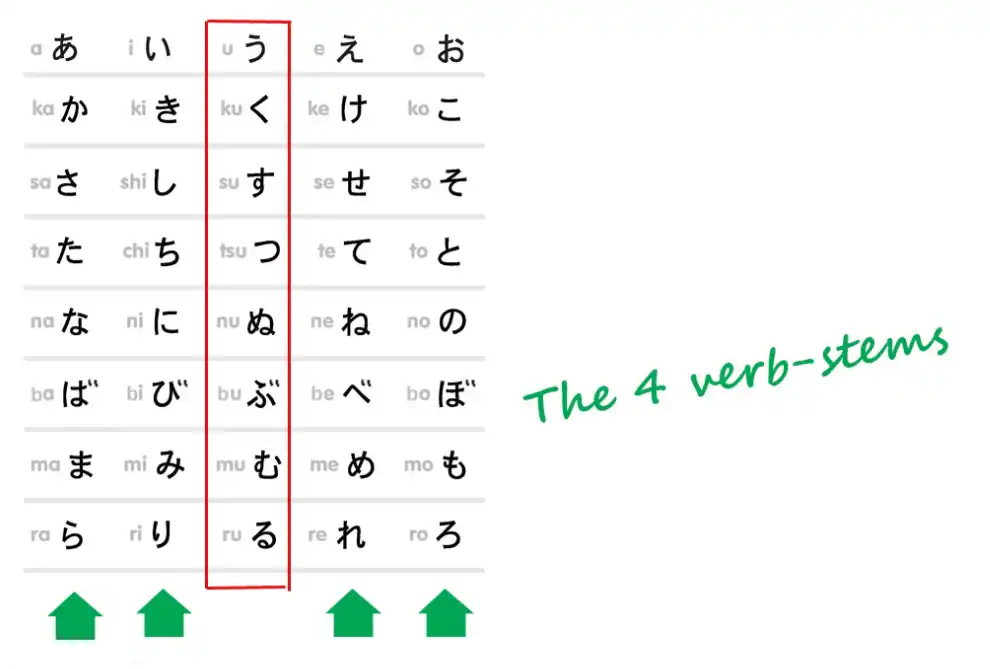
But what I didn’t explain at the time I introduced this is that it goes much further than this.
I left you thinking perhaps that the て-form, as it’s called, and adjectives have some kind of a minor conjugation-thing happening that’s a bit like European conjugation and the stuff the textbooks teach.
This isn’t true. I didn’t talk about it too much at the time because I think before you’ve ingested the basics properly it could be a bit complicated-feeling and hard to take in.
But now let’s look at it properly.
Active & Static/Inert words
As you know, there are two kinds of word in Japanese, and that is, active, changeable words and static (inert) words.
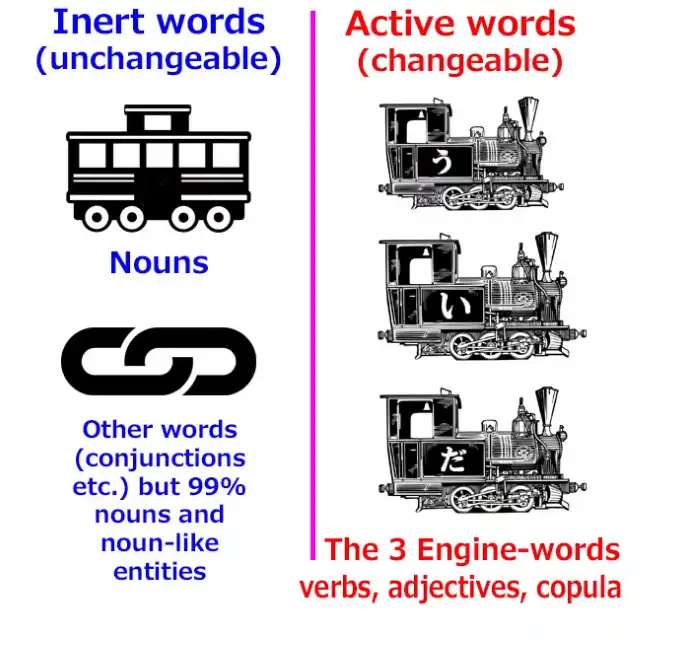
Active, changeable words consist of the three kinds of word that can make the engine of a sentence, that’s to say, verbs, adjectives, and the copula.
Static words are nearly all nouns, and they never change at all. They can’t change in any way.
Now, all the words that can change change in exactly the same way.
We have to know two things about them.
The first is that nothing changes in the base form of a word except the last kana.
That’s the う-row kana in a verb or the い in an adjective.
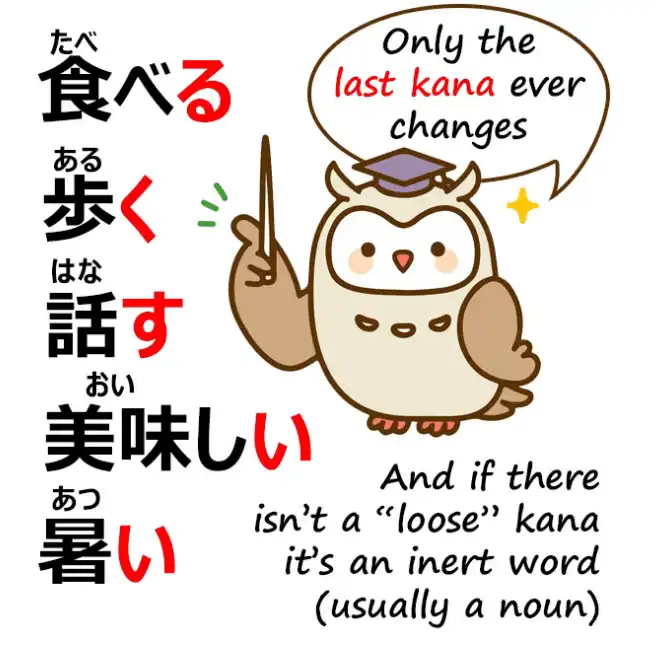
Nothing before that can change.
That’s as fixed and settled and inert as a noun.
It’s only that last kana that can ever change and that can then have things attached to it.
The second thing to know is that they all change according to the stem-helper system.
So, although I introduced the て-form as if it was a “form”, a kind of morphing or conjugation of the whole word, it is in fact a stem-helper system of its own.
In real Japanese grammar as taught to Japanese natives by Japanese natives, -た and -て are regarded as helpers, as entities in themselves that attach to the stem of a word.
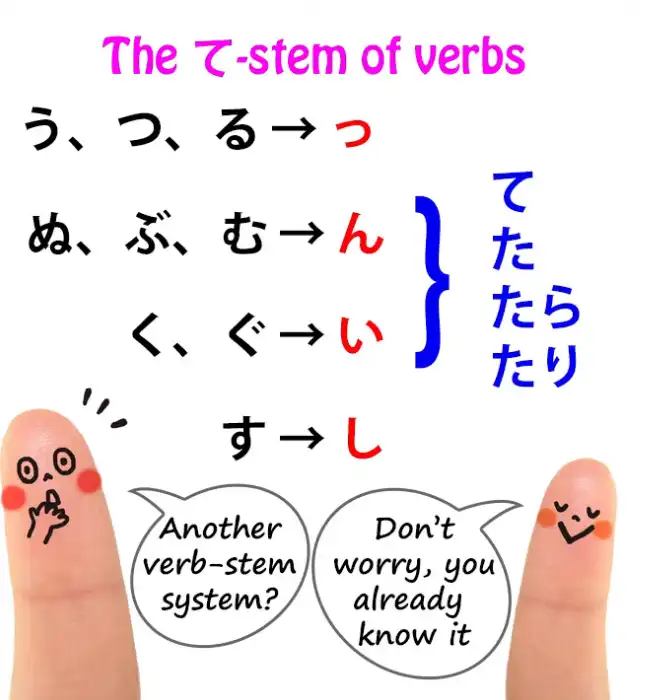
So essentially verbs have not one stem-system, but two stem-systems.
And that’s partly why I didn’t introduce it straight away, because that feels a bit overwhelming at first.
The て-stem system
The second stem-system, that’s the て-stem, you already know. We’ll go over it briefly.
#
う-つ-る group
There’s the う-つ-る group, and that changes the last kana, う, つ or る, into a small っ, and then we can add the -た or the -て.
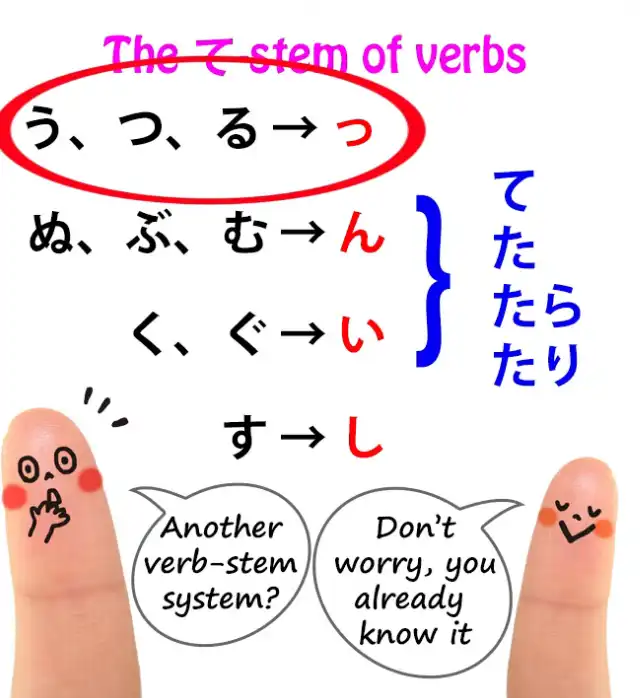
#
ぬ-ぶ-む group
There’s the ぬ-ぶ-む group: this changes the last kana, ぬ, む or ぶ, into ん, and the influence of the softness of those kana and of the ん itself affects in a euphonic manner the -て or the -た, turning them into で or -だ.
#
く-ぐ group
く and ぐ turn into い – and we’re going to notice in a minute that this relation between い and the か-row kana, か-き-く-け-こ, is something that continues to play a role in adjectives.
We’ll look at that in a minute.
く and ぐ turn into い, and in the case of ぐ, that ten-ten 〃 on the く, that soft sound, again has a euphonic effect on the -て or -た that follow it, turning them into で or -だ.
#
す “group”
And finally, す in the て-form does exactly what it does in forming the い-stem in the regular stem system: it becomes し.
So, there we have the second verb-stem system, the て-stem, and we use this not only for
-て and -た, but also to add helpers like the conditional -たら and -たり.
The Adjective stem system
Adjectives also have their own stem-system. Adjectives in fact have four stems.
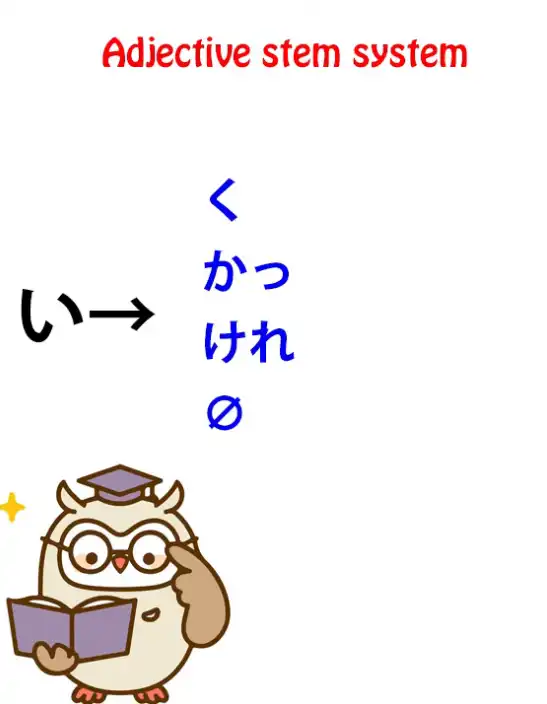
You can form adjective stems by dropping the い, just as we drop the る in ichidan verbs, or by changing that い to one of three か-row kana, か, け or く.
And as we said before, there’s a relationship between か-row kana and い, so with the て-stem of verbs, verbs ending in く, the き turns into い, and the same with the ten-ten 〃 version, ぐ.
So we have four stems for adjectives, dropping the い or turning it into か, け or く.
#
The く stem
The く-stem attaches the -ない helper adjective, negativizing the adjective,
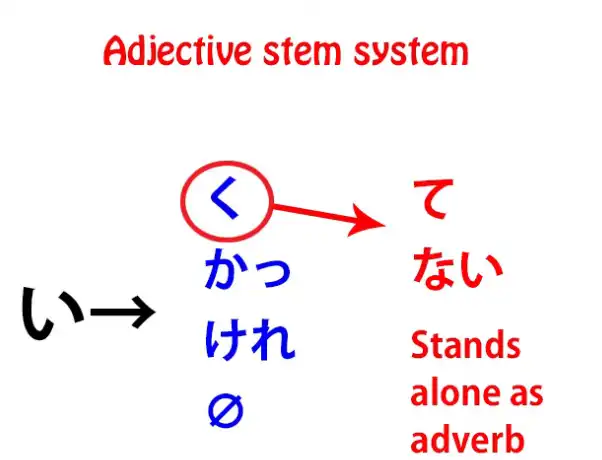
and also if it stands on its own – and as we know, stems sometimes can stand on their own.
So the い-stem of a verb on its own becomes a noun.
The え-stem on its own forms the imperative.
The く-stem of an adjective on its own turns the adjective into an adverb.
So, we can say “早い車” (fast(-is) car) or “速く走る” (run fast, fast is an adverb).
And く is also used, of course, to make the て-form: we just add -て to the end of the く.
#
The か stem (かっ)
The か-stem takes a small rider, which is the small っ, so it becomes かっ
and we use that to attach the past-helper -た,
so we say -かった: “おいしかった” (that was delicious).
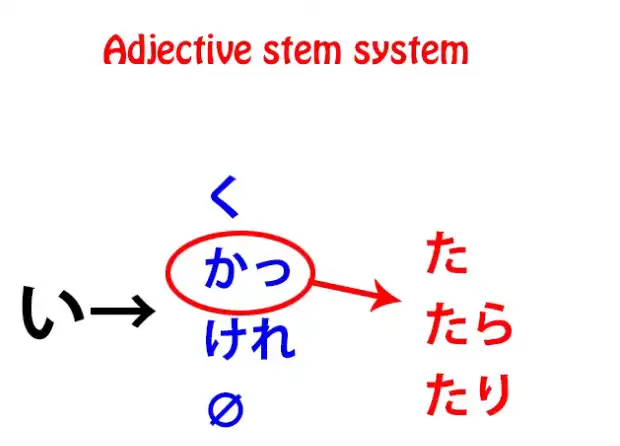
#
The け stem (けれ)
The け-stem also takes a rider, which is -れ so we have the stem -けれ, and to that we attach the helper -ば, which is the conditional (and I made a whole set of videos on conditionals like -ば and -たら (Lessons 30, 31, 32 & 33), and I’ll put a link above and in the information section below).
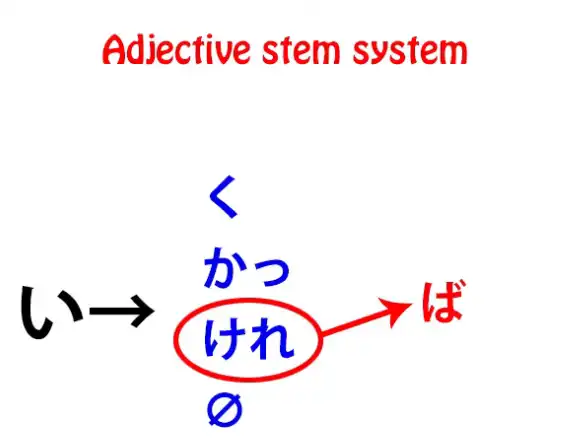
#
The zero stem
When we drop the -い altogether we can use it for attaching things like the -そう helper noun, which means that something appears to have that quality, and also to attach helper verbs like がる.
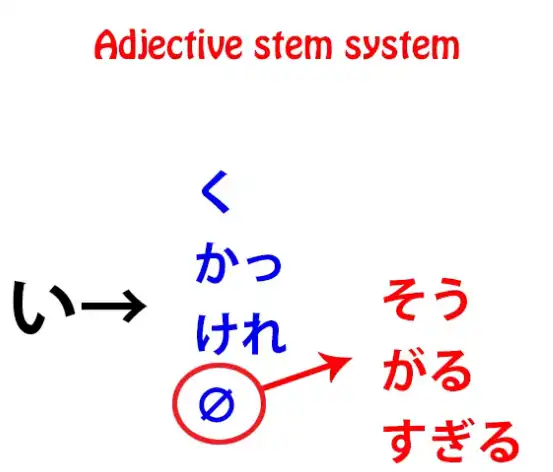
So to the stem of “欲しい” we can attach がる to make “欲しがる” (show signs of wanting something, appear to want something).
Or to the たい helper we can drop that い and attach がる and get “たがる” (show signs of wanting to do something, appear to want to do something).
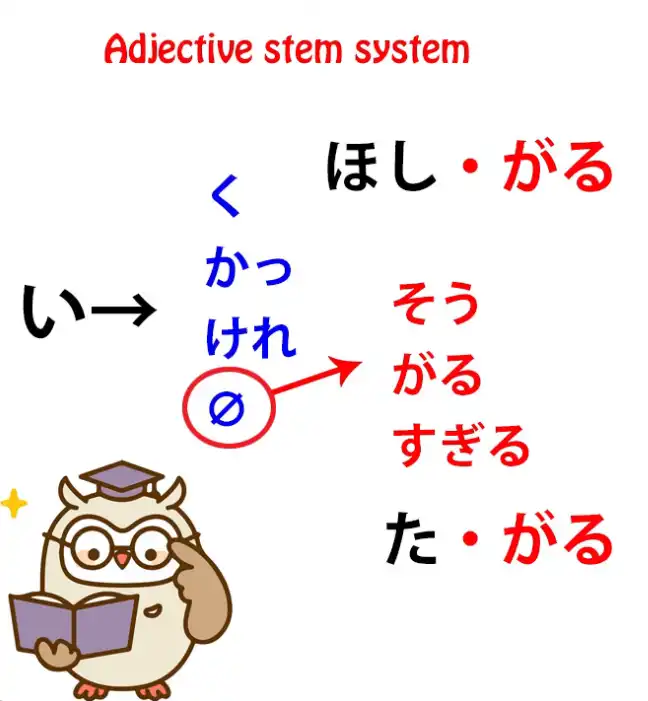
So, as you see, adjectives have a stem-system of their own to which we attach a variety of helpers, like a smaller version of the one verbs have.
The Copula
Now, what about the copula?
That’s the other dynamic element, the other engine.
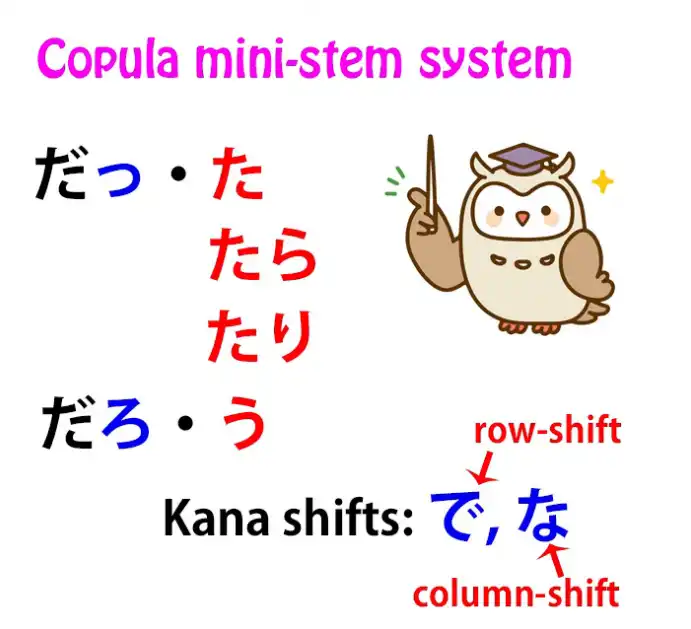
Now, the copula’s only one kana (だ in this case) to start with,
so generally we add something to that.
We can add the small っ, to make the stem だ~, (I think by ~ here is meant っ = だっ) which can then have the -た past helper added to it to make “だった”.
We can add -ろ, so it can have the volitional helper added to make “だろう”.
And in the て-form, the だ itself changes – of course having only one kana, だ is the last kana – and that can become “で” to make the て-form.
It’s a little bit less regular than the others, but that’s really because there is only one copula, so it doesn’t have lots of other things in the same group for it to be regular with.
Summary
So, that’s the overall structure of Japanese.
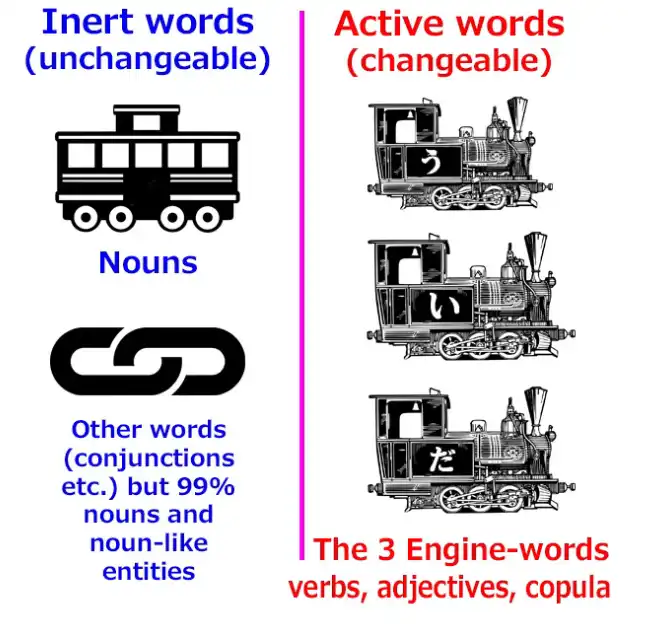
It/Japanese has two kinds of words, active and passive words, transforming and inert words.
The inert words can’t change in any way, but they can attach particles that tell us what they’re doing.
And fortunately, because they never change at all, there’s nothing tricky about nouns.
They always attach the same particle to do the same job regardless of what noun we’re talking about.
Much simpler than foreign grammatical systems.
Active elements, verbs, adjectives and the copula, can only change that last kana and they always do it according to the stem-helper system.
When we understand that, the whole thing becomes a great deal easier to conceptualize and deal with.
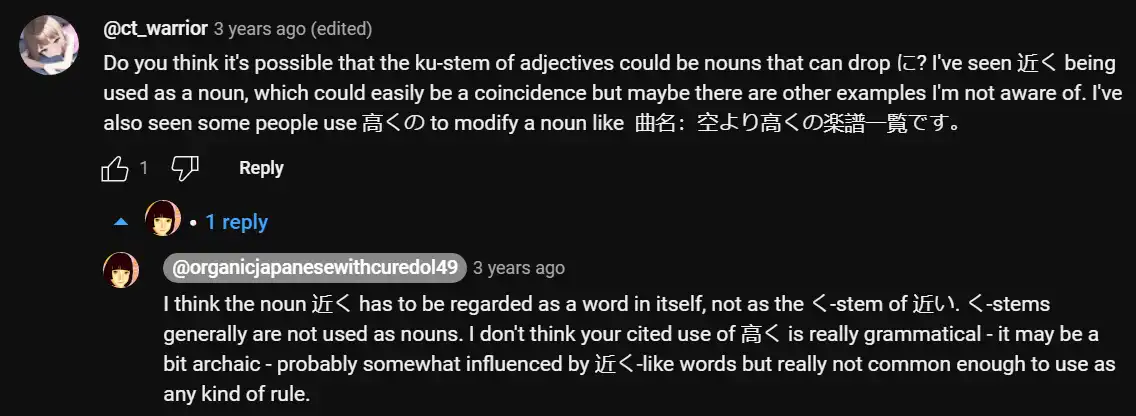
82. なんて、なんか、など: 3 Common words clarified.
なんて Nante なんか Nanka など Nado: 3 Common words clarified. Lesson 82
こんにちは。 Today we’re going to talk about three words that you’ll encounter often in your immersion.
They have quite a wide meaning spectrum, and that means that dictionaries can’t really cover the full range of what they mean, especially when, as they often are, they’re used in very colloquial ways.
And I’d like to thank all the people who tell me which words give them trouble in immersion.
This helps me to know what to cover and in what order to cover it.
A lot of people wanted to know about “なんて” and “なんか”.
So if you have words that are giving you trouble, please pop them in the Comments below.
It’s very helpful to know what it is that’s causing problems.
So, the three words are “など”, “なんて” and “なんか”.
They have different meanings but they overlap in certain areas.
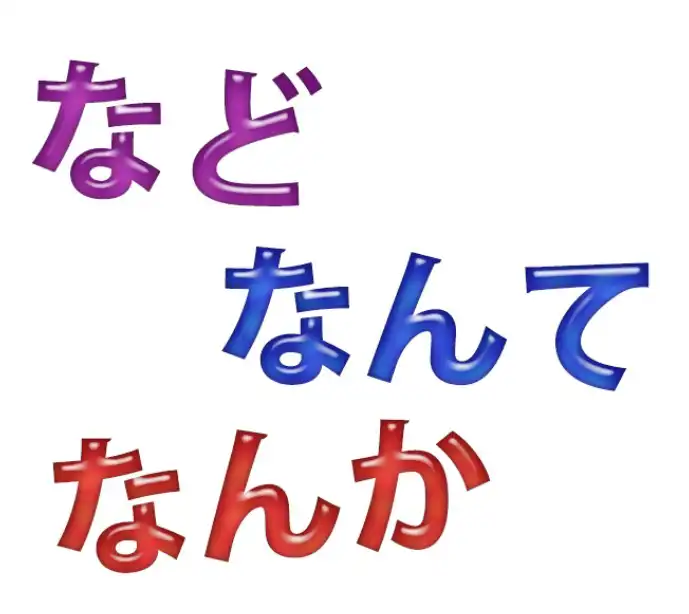
And the simplest one is “など”, so we’re going to start off with that.
など
“など” essentially means pretty much what “etcetera” means in English, but the thing to bear in mind in formal language is that it has higher status than “etcetera” in English.
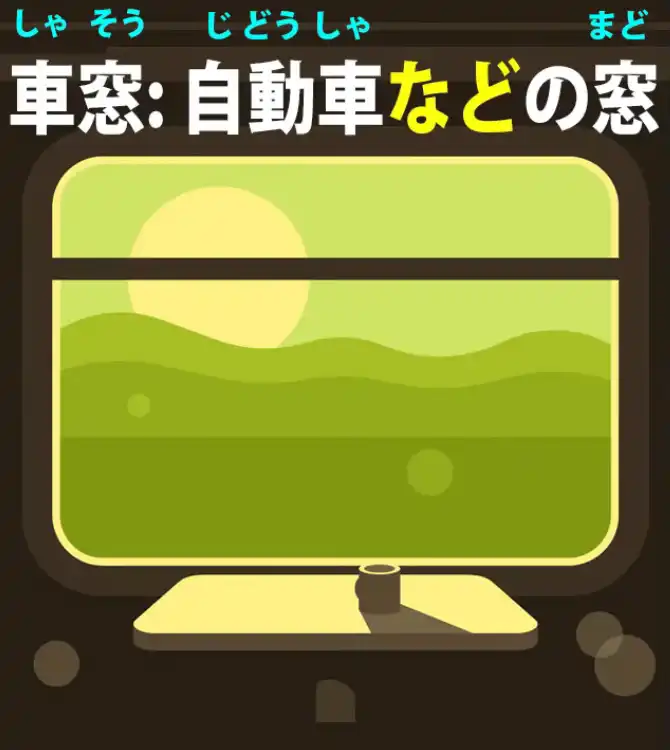
In English, “etcetera” tends to be treated in many cases as a bit of a cop-out.
It’s a way of not really saying exactly what you mean.
In Japanese it has much higher status. Its meaning spectrum is broader.
You will encounter it both in completely formal writing and in informal conversation and writing.
It’s an indispensable part of the language.
To give an example of its formal use, a dictionary definition of the word “車窓” – and “車窓” is one of these words that I’ve talked about in a previous video, two-or-more-kanji words that really aren’t words in quite the English sense of the word, that’s to say, they are really phrases.
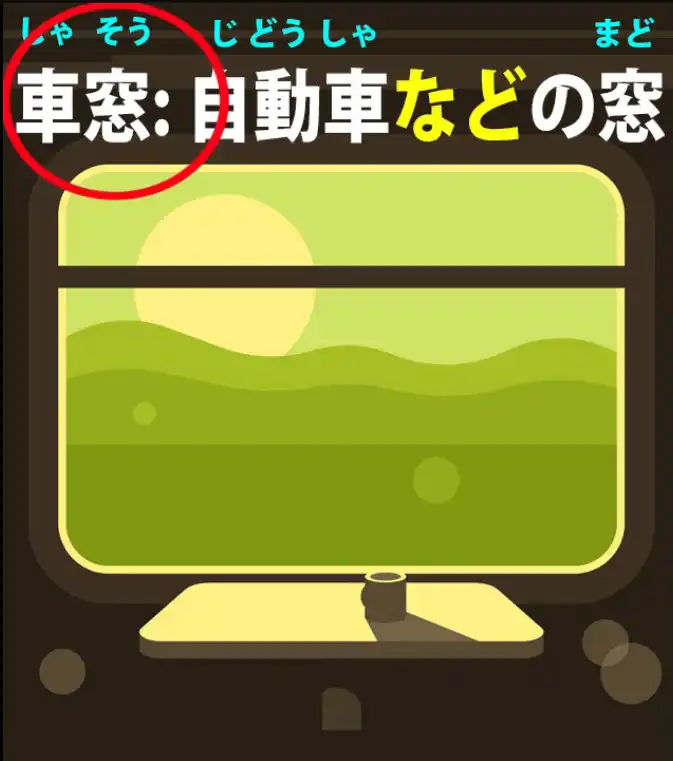
They bring together two known entities, which are known if we’ve done much Japanese, into what in English would simply be a phrase.
So we can throw these words into our Anki if we want to remind ourselves that they exist but we shouldn’t treat them as completely new entities.
They’re really just like phrases and this one is very close to the English phrase “car window”, which isn’t a word, it’s just a phrase.
If we know “car” and we know “window”, we know what a “car window” is.
So if we know “車” and we know “窓” and we know the on-readings of the two, which are “しゃ” and “そう”, then “しゃそう” really presents no problems, except that we need to remember that “しゃ”, the on-reading of “車/くるま”, refers to a broader range of vehicle.
“くるま” usually simply means a “自動車/じどうしゃ” (an automobile) while “しゃ” can refer to any kind of surface vehicle.
A bicycle is a “自転車/じてんしゃ”, a train is a “電車/でんしゃ”, etcetera.
And the definition is: “自動車などの窓”.
So essentially that means “the window of an automobile, etcetera”, which in this case means any kind of a surface vehicle that has windows, so not a “自転車” but a “電車”, etcetera: “the window of a vehicle”.
Note: Notice how the など here is used right after 自転車 (preceding even the の particle).
など seems to be used directly after its noun / noun phrase like any other particle would (など is a particle too). Furthermore however, looking at some Yomichan sentences where it is used, it seems like it takes priority over the logical particles like の, が, を in that it is the first one to attach to/after its attached noun, with the logical particles following it only once it was attached. As seen above or in a sentence from Yomichan: 大学ではフランス語やドイツ語などを勉強した。
And this “など” is a very typical use of the word.
It gets used freely in formal and informal Japanese.
#
など in informal Japanese
In informal Japanese, “など” also has another use, which overlaps with the other two words we’re going to look at.
It can be used to mildly denigrate or belittle a word that it’s attached to.
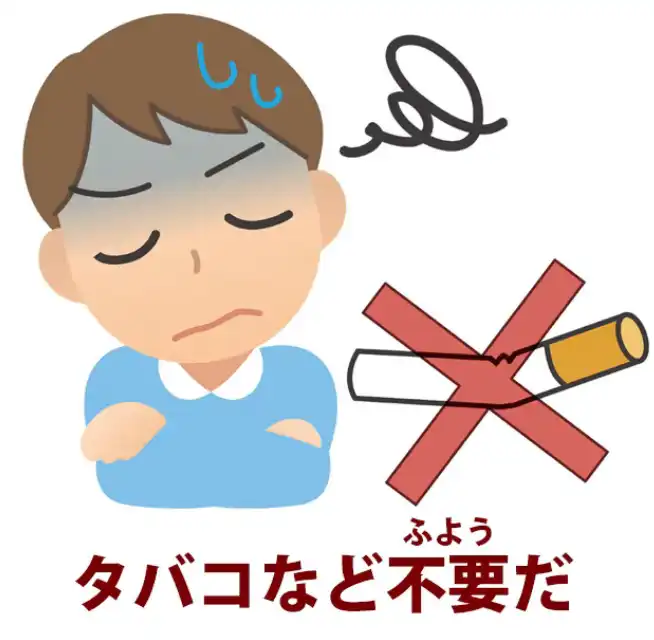
Now, “denigrate” and “belittle” are not exactly the right words to use here, but I don’t think there are quite the right words in English.
It throws a negative light, which in the case of “など” is usually making light of or slightly rejecting whatever it is.
So we might say, “タバコなど不要だ”, which means “I’ve no use for cigarettes”.
Now, “タバコは不要だ” would mean the same thing essentially (notice that “など” knocks out other particles). - so Dolly confirms my observation from above, except that here it straight-up removes the は particle, likely because it is not a logical particle. — The only difference here is that “など” is throwing that slightly disparaging light on cigarettes.
So the way we could read it is something like, in English, “I don’t need stuff like cigarettes”.
Now, actually this doesn’t mean that literally.
It’s not saying I don’t need cigarettes or cigars or a pipe or a hookah.
It means I don’t need that kind of thing – that’s something I don’t need in my life.
And as I say, this use overlaps with our other two words.
Both “なんか” and “なんて” can be used in this throwing-a-negative-light-on-the-noun-they-follow way.
The strongest and most colloquial of the three is “なんか”, and “なんて” comes somewhere in the middle.
なんか
So, “なんか” is really a contraction of “何か/なにか” (something), but it has quite a few colloquial uses.
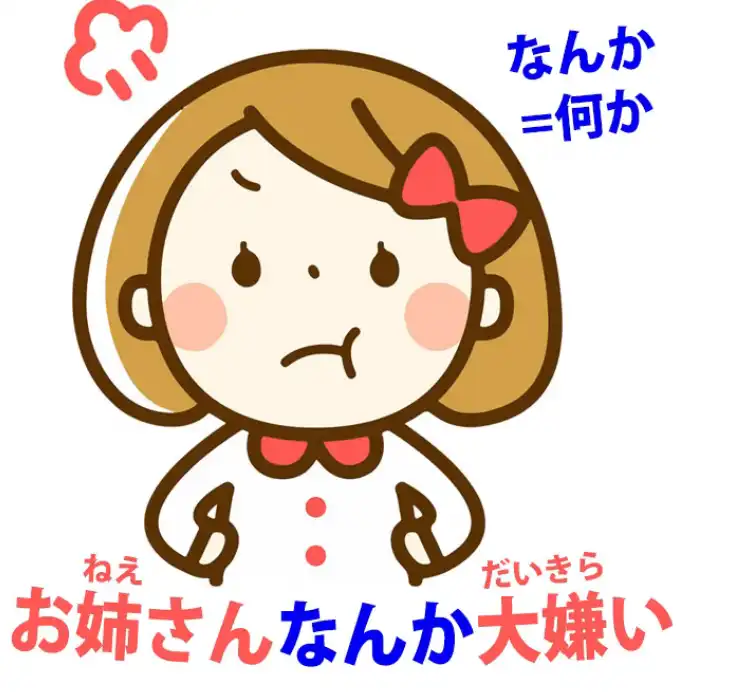
And it’s the denigrating one we’ll hear sometimes very strongly in cases where…
well, let’s say in an anime a younger sister is angry with her older sister.
She may say, “お姉ちゃんなんか大嫌い!” (I really hate stuff like my big sister).
Now, of course, that’s not literally what she means.
She doesn’t mean she hates “stuff like” her big sister, but by using this expression –“stuff like you”, “stuff like my big sister” – you’re throwing a very disparaging light on what it is you’re talking about.
It can be milder: we can say, “サッカーなんか興味がない” (I’ve no interest in stuff like soccer / I’m not interested in soccer).
And it can be more mildly belittling still: we might say, “雨なんか平気だ”.
And what we’re saying there is “(Stuff/Something like) Rain doesn’t bother me / I’m not troubled by (stuff/something like) rain / I’m okay with (stuff/something like) rain”.
And the “なんか” is just throwing that slightly diminishing light on the rain, indicating how little we’re worried about it.
#
なんか used with oneself
And it often gets used of oneself, as in “私なんか”, and this is often used to stress a perceived inferior position or a difficult position that one finds oneself in, for example, “私なんかまるで子供扱いだ” (I’m treated just like a child).
#
なんか - contraction of なにか / 何か
Now, the fundamental meaning of “なんか”, as I said, is actually a contraction of “なにか / 何か”, which is “something”.

And it can be used simply as a contraction of “なにか / 何か” in, for example, “なんか心配はある?”, which just means “何か心配はある” or (Is there some worry? Is anything worrying you?).
#
なんか as “something”, “somewhat” to make things vaguer
Now, from there it goes on to preface things in order, as with “something” or “somewhat” in English, to make them a bit vaguer.
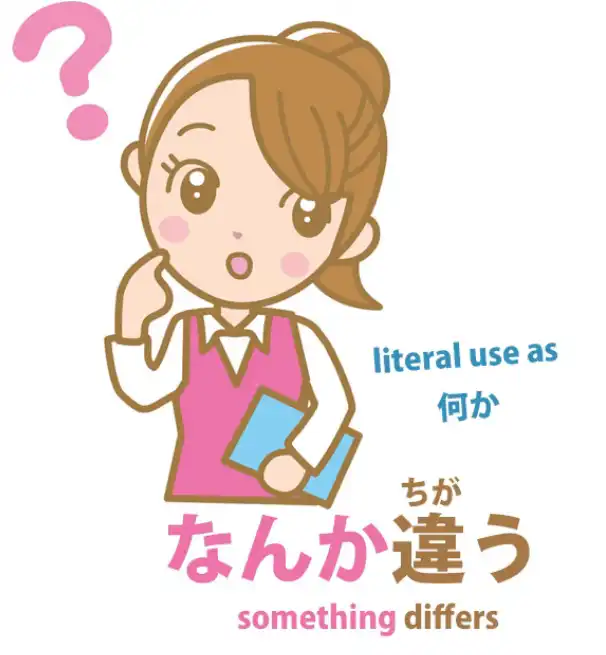
So we might say “なんか違う” (something’s different / something differs – I’m not sure what it is, but something’s different).
“なんか違う.” #
なんか as “somehow / for some reason”
Now, from that it goes on to meaning “somehow”.
So we might say “なんか好きじゃない” (somehow, I don’t like it / For some reason, I don’t like it).
“なんか好きじゃない” #
なんか in very casual / sloppy speech as “kinda” x
Now, from there it gets worse.
It goes on to become even vaguer.
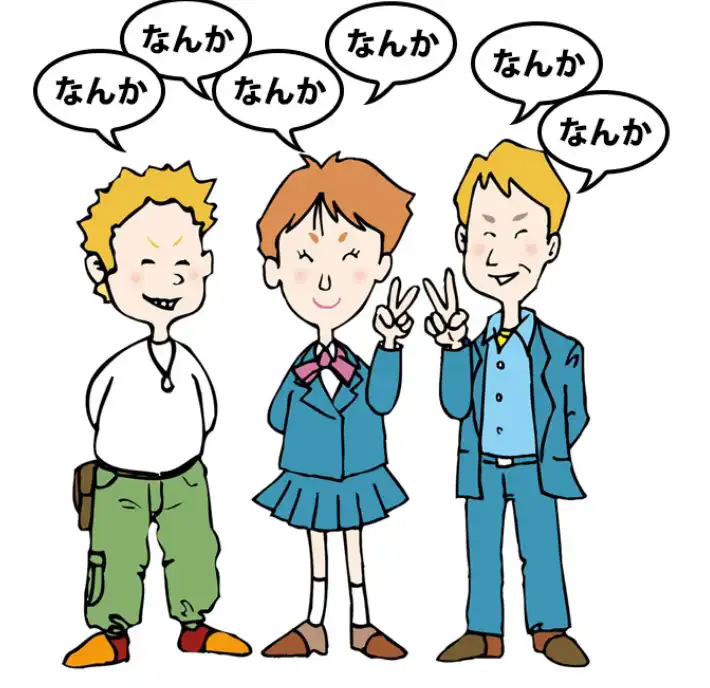
So in very casual and (I would say) rather sloppy speech, you can hear “なんか” at the beginning of a sentence and then several times during the sentence: “なんか this, なんか that”.
And when it’s being used like that, it’s really being used like “kinda” or “like” in English.
And, just as in English, this is a sloppy way of talking.
It’s not good Japanese, but you may hear people talking like this in some anime, etcetera.
The function really, as with “like” or “kinda” in English, is simply vaguing things up a bit and releasing oneself from the need to express oneself precisely.
Just kinda saying, like, whatever it is that kinda comes into your mind, like – “なんか… なんか… なんか”.
So, we should look out for this very loose use of “なんか” and realize that it doesn’t really mean very much at all.
なんて
“なんて” is essentially a contraction of “何って”
and I’ve done another video about this -って, which is a contraction of -と or “-という”.
(Lesson 18)
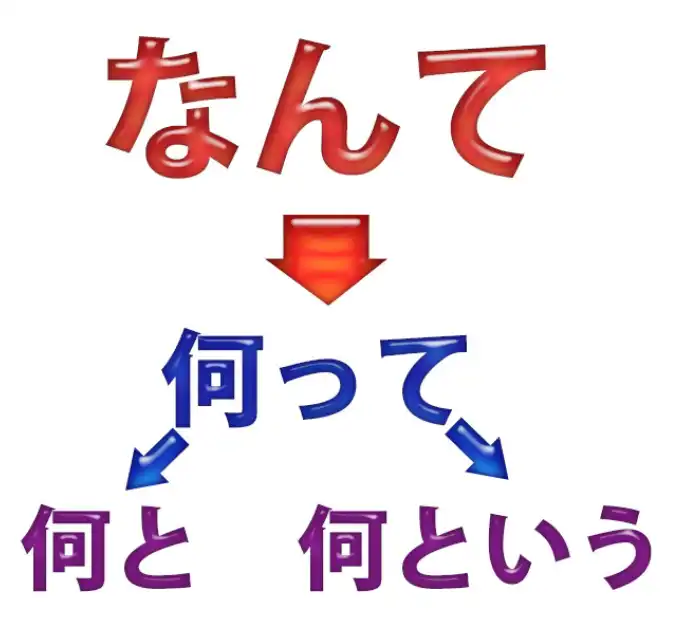
And it’s the same with “なんて”.
So, in its simplest and most basic use, it’s used, for example, in saying “なんて言った?”, which means “what did you say?” English speakers may be tempted to ask “なにをいった?” (what did you say?).
But that’s not natural Japanese.
We can say “なんと言った”, but it’s actually more natural in casual speech to say “なんて言った?” (what was it that you said?) which isn’t very easy to translate into English because it’s using that quotation particle (the と) even though it’s rather morphed itself into “なんて” in colloquial speech.
#
なんて as “What a (this)” or “What a (that)”
Now, you’ll also see it a lot with a meaning of “what” in English as used in expressions like “What a nice day!”, “What a stupid person!”, “What a beautiful flower!” etcetera.

And this is an abbreviation of “なんという / 何という”, but it’s more often than not, even in not particularly casual speech, used as “なんて”.
“なんて美しい景色だ!” (What beautiful scenery!) And, just as in English, this “なんて” can be used to introduce any fairly strong reaction to anything.
It can be negative; it can be positive.
We’re saying “what a (this)” or “what a (that)”.
#
なんて used in a belittling manner
Now, it’s also used, as we said before, in this belittling manner attached to a noun.
So, for example, we can say “試験なんて嫌いだ” (I hate exams); “お金なんていらない” (I don’t want money).

Like “なんか”, it both stresses the noun that it follows and indicates a negative or a dismissive attitude towards it.
#
なんて used to express surprise
And it can also be used at the end of a complete statement to express surprise.

So in this sense it’s rather like the first one we looked at, the “what a (this)” or “what a (that)”, which comes at the beginning.
It can also be used at the end to express surprise or in some cases disbelief or doubt.
So we might say, “冬に燕を見るなんて” (see a swallow in winter + “なんて”).
What’s that “なんて” doing?
Well, it’s turning the whole thing into an expression, rather like the “what a (this)” or “what a (that)” expressions.
So what we’re saying is something like “Gosh, imagine seeing a swallow in winter!”
And this use of “なんて” on the end, after the engine of a statement, can be used as part of a longer sentence.
So, for example, we could say “腹を立てるなんて君らしくない”.
Now, “腹を立てる” means literally “stand your stomach”, but this is an expression meaning “get angry”.
So the whole thing is saying “getting angry, that’s not like you”.
And I’ve talked about this “らしい” and “らしくない” in another video. (Lesson 25) So, if you’re not familiar with those, I’ll put a link above my head and in the information section below.
Now, we can take out the “なんて” here and then of course we’d have to put in a particle and say, “腹を立てるのは君らしくない”.
But the “なんて” is expressing our surprise about this because it’s not like the person concerned.
And note that this can’t be the belittling “なんて”, which attaches to nouns.
This is attaching to a complete statement, so we’re expressing our surprise about someone being angry and then adding the comment that it’s not like her.
#
なんて as this vague という
And finally, we can use it in a way that comes right back more or less to the original meaning of “-という”, but adding a bit of vagueness to it.
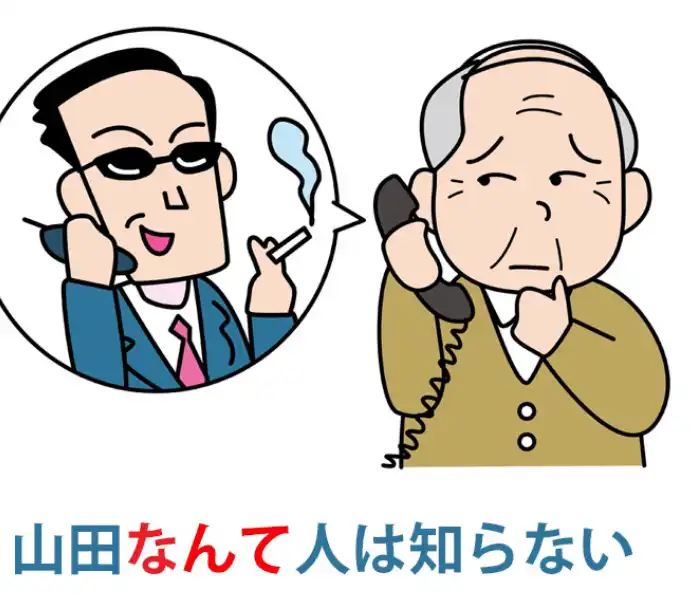
So if we say “山田なんて人は知らない”, we’re saying “I don’t know anyone called Yamada”.
Now, the “なんて” here could be replaced simply with “-という”: “山田という人は知らない”.
So what’s the difference between using the regular “-という” and using “なんて”?
Well, “山田という人は知らない” is like saying in English simply “I don’t know a person called Yamada”.
But “山田なんて人は知らない” is more like saying “I don’t know any character called Yamada”.
It’s throwing a lot more doubt and questioning into the whole thing.
So, we’ve covered the main usages of these three words or expressions here.
It’s not completely exhaustive, but I think it gives you the basic keys to how they work, what they mean, how they’re used.
Note: Damn, quite a few sub-titles in this one, heh (ノ*°▽°*)
*Wanted to make it a bit easier to search, if anything. Also, this is quite interesting:
*


- Sorry for the microscopic font, Youtube again hides the text parts if I zoom-in for some reason…*
83. Three Levels of Command in Japanese: て-form commands, なさい, な-commands, imperative form.
Three Levels of Command in Japanese: て-form commands, なさい, な-commands, imperative form. Lesson 83
こんにちは。 Today we’re going to talk about ways of making commands and requests in Japanese.
You’ll probably know some of these already, but I think we’re going to go a little bit deeper to some things you may not have realized.
We’re going to go from the least commanding and intense towards the most, so we’ll start off with one that we all know, which is the て-form.
The て-form
Some sources will tell you that the て-form on its own is a command or request form.
That’s only half true. It’s the abbreviation of a command or request.
If we say “ちょっと待って” (wait a little), this is an abbreviation of “ちょっと待ってください” (wait a little please)

and probably because of this
it’s the one that’s least likely to be offensive, although it’s still casual.
Now, sometimes you’ll hear people saying not “ちょっと待って” but “ちょっと待ってて”. What’s going on here?
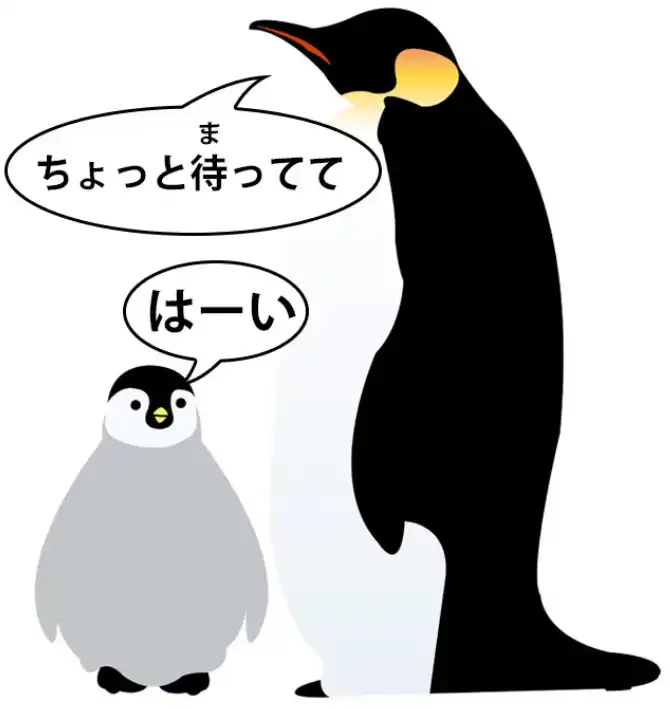
Essentially what they’re saying is “Wait a little bit and I’ll be back”.
The implication is that the waiting period will end fairly shortly.
And what this actually is is a contraction of “ちょっと待っていて”.
As we know “待っている” means “exist in a state of waiting”, “be waiting”, in English.
So “ちょっと待ってて” is actually taking this “待っている” and putting it into て-form, so that what you’re being asked or instructed to do is exist in a state of waiting.
And the implication of this is, just exist for a little bit in a state of waiting.
And of course this doesn’t have to be waiting, it can be anything, but the implication is, just do it for a bit, just exist in that state for a short time.
If we don’t say “ちょっと” (and we don’t necessarily) there’s nothing to indicate a short time, but that is always the implication of telling someone with the て-form to exist in a particular state.
#
て-form with ない helper adjective
The other thing to know about the て-form which is used to tell or ask someone to do something is that, as we know, the equivalent negative adjective of any verb is made by simply attaching the helper adjective “ない” to the あ-stem.
And the helper adjective “ない” actually is unusual in that it has two て-forms.
It has the regular て-form, which is formed just like any other て-form, by attaching -て to the く-stem, so that’s “なくて”, but it also has the irregular て-form “ないで”.

And when attached to a verb this is only used in two kinds of circumstance.
##
ないで - irregular て-form of ない
One is when we say “do B without doing A”, so “話さないで歩く” means “walk without talking”.
The other is when we’re making that て-formed command or request.
And again it’s short for “ないでください”.
So if we say “泣かないで” (don’t cry), that’s using this secondary, specialized て-form of “ない”, which is specifically there for making negative commands or requests, as well as for the one other usage that we discussed.
And sometimes in anime you’ll hear someone scream, when a monster is approaching her, “来ないで!” (don’t come).

In English we’d probably say “Keep away!” In Japanese we say “来ないで!”

なさい
Now, next up in our hierarchy of commands is “なさい”.
“なさい” is attached to the い-stem of verbs, and when you attach “なさい” to the い-stem of a verb, you make it into a command.
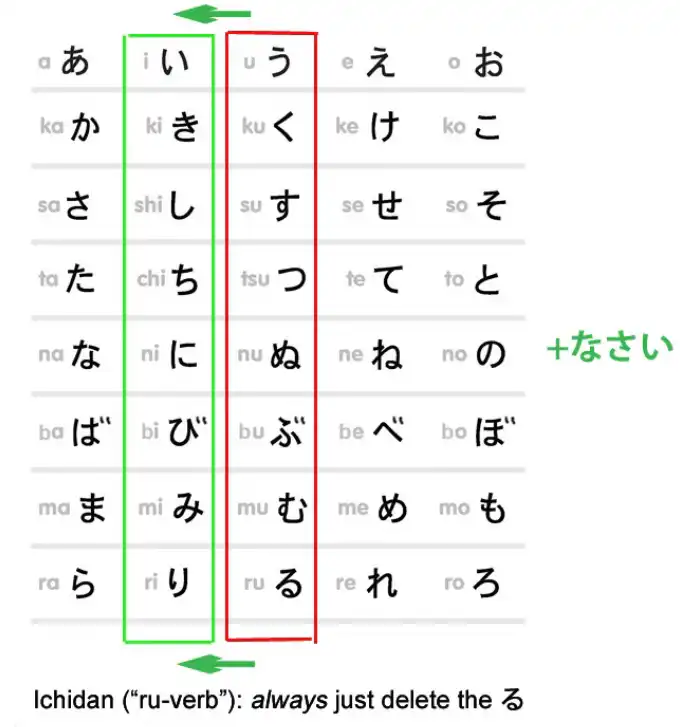
So, “起きなさい” is “get up / wake up”; “落ち着きなさい” (calm down, settle down), we’re attaching “なさい” to the い-stem of “落ち着く”, which means “calm down” or “settle down” and turning it into a command.
“なさい” is the sort of command given by parents to children, teachers to a class, that sort of thing.
It’s not offensive if it’s given by someone who’s entitled to give it.
So, for example, in the anime “借りぐらしのアリエッティ”, Arietty’s father says “寝なさい”.
That’s the い-stem, which of course with ichidan verbs we make by simply removing the -る, of “寝る” (sleep, or go to bed) plus “なさい”.
#
な - the abbreviation of なさい
Something that can be confusing here is that there is an abbreviation of “なさい” which can be confused with a different abbreviation meaning the opposite.
And that abbreviation is “な”.
When we attach “な” to the い-stem of a verb, then we’re actually abbreviating “なさい”.
So if we say “準備しな”, we’re saying “準備しなさい” (get ready, get prepared): “準備する”, い-stem of “する”, “し” + “なさい” or “な”.

Now, that in itself isn’t particularly confusing.
What can confuse people is that if we say, for example, “バカにするな” (don’t make fun of me, of her);
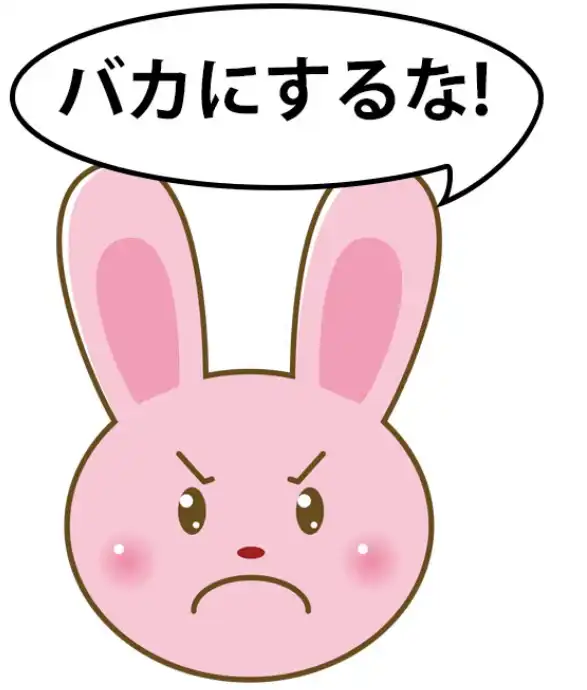
“それを食べるな” (don’t eat that! [could be poison]).
This means the opposite! We’re using “な” for both a command to do something and a command not to do something.
So how do we tell the two apart? Fortunately, it’s very easy.
If the “な” is attached to the い-stem, then it’s an abbreviation of “なさい”.
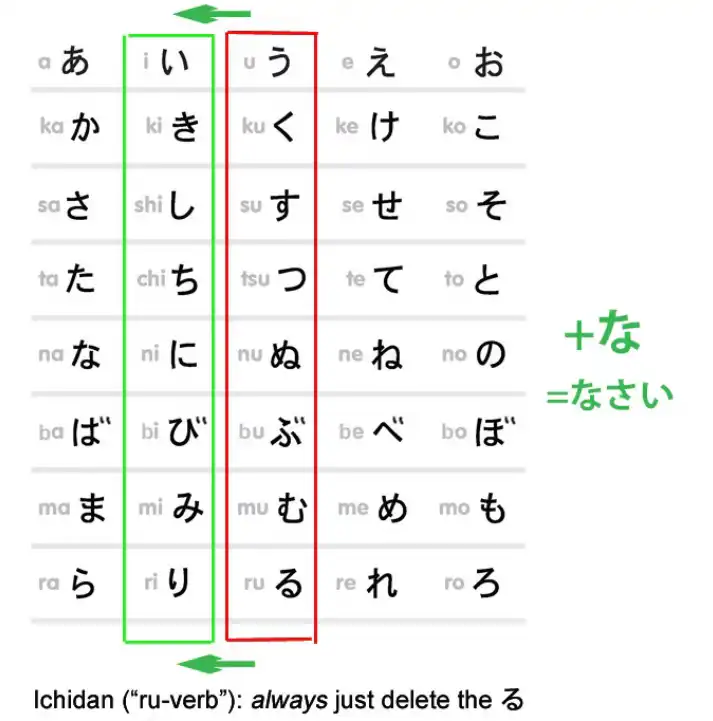
It always is.
If it’s not attached to the い-stem but attached to the entire logical clause as in “それを食べるな”, then it is not an abbreviation of “なさい”.
It’s in fact an older negative related to “ない”.

So really, although they can seem confusing at first and they’re probably confusing when you’re told by some textbook just to learn which particular forms they stick to, it’s not really confusing in practice.
One only attaches where “なさい” would attach to the い-stem, and that’s the one that means “なさい”! The other one tops off a complete logical clause with the negativizing “な”.
Note: Some further info Dolly gives about なさい in the comments
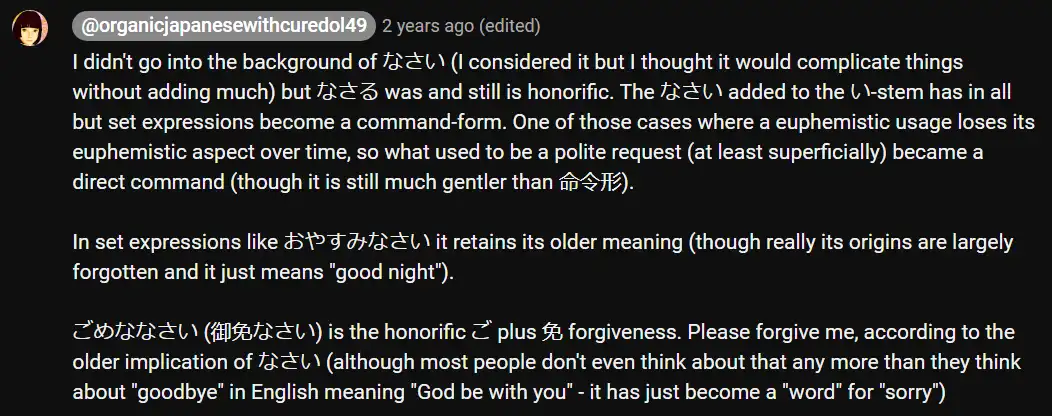
The real command / imperative form - 命令形
And now we come to the real command form, “命令形” in Japanese.
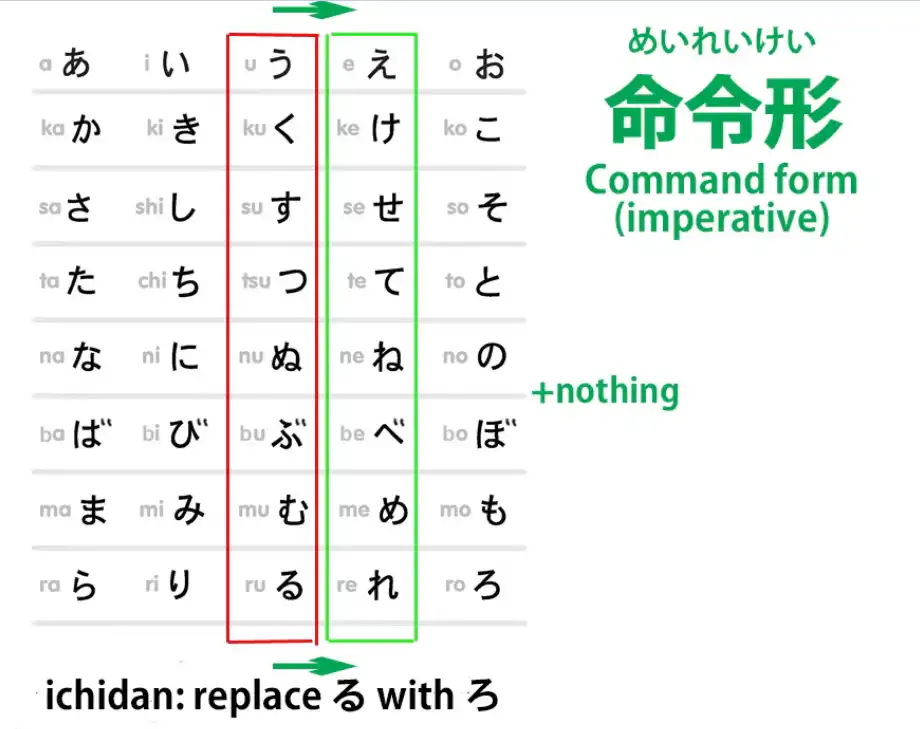
And this is formed very simply by using the bare え-stem of a godan verb or, in the case of an ichidan verb, we take off the -る as always, and replace it with -ろ.
So you might hear people say in an anime “黙れ!” That is the verb “黙る” (to be quiet, to be silent) turned into a command: “Be quiet!” And this is really pretty forceful.
It’s stronger and potentially more offensive than “うるさい!” (And I made a video on “うるさい” if you want to follow that up.) It’s not inherently offensive, Note: the 命令形 form If someone really has the right to be giving orders, they may use it.
And people who talk rough may use it among friends or to enemies.
You may hear it a lot in shounen anime, where people do tend to talk rough.
It can also express urgency in a few cases.
One case that you’ll often hear is when a character is in serious trouble and calls out “助けてくれ!” which is like “助けてください!” but turning it into a real order, a command.
Now, obviously someone in deep trouble isn’t trying to insult or offend anyone who might help him.
So what this “くれ” is doing in this case is expressing the urgency of the situation.
Yet even here, I’d have to say that I’ve only ever heard male characters use this “助けてくれ”.
Female characters, even in the direst emergency, will tend to content themselves with “助けて!” And this shows how delicate the real “命令形” command form actually is.
“くれ” is really the only irregular “命令形” apart from the two regular irregulars, which are “する” and “くる”.

So “くれる” (to give down / to me) becomes “くれ”.
Note: Obviously, as shown, the くれ is a form of くれる; not くる/来る (that one has こい/来い)
And, as you see, it’s a particularly touchy kind of word to use, because you’re asking for a favor but you’re demanding it, you’re commanding someone to do a favor down to you.
Now, for completeness, I’d say that there are two other ways of commanding that are mostly used for other things but can be used as command forms as well.
のだ / んだ ending
One is the “のだ / んだ” ending which is put at the end of a complete logical clause, and I’ve made a video about this “のだ / んだ” ending, and I’ll put a link to that over my head and in the information section below.
As I explain in the video, it has a wide range of uses, but one of those uses is turning something into a command.
So if we say “宿題をするのだ”, we’re saying literally “It’s that (you) do (your) homework”.
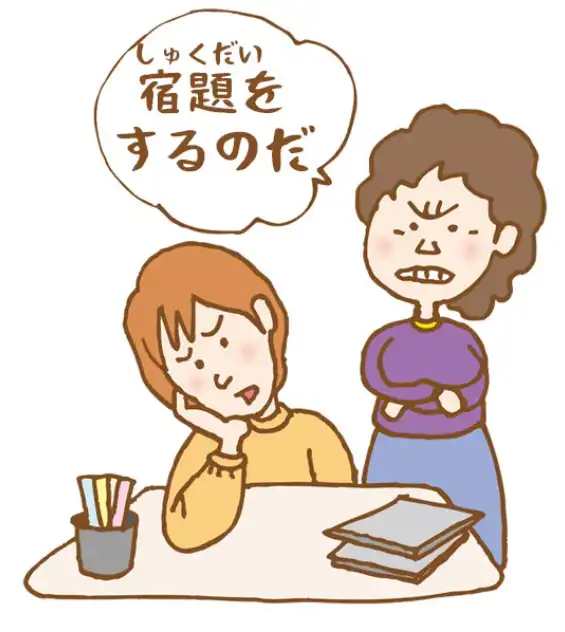
This will be somewhat like the English “You’re going to do your homework”. It’s a command.
ように
Also, “ように”, which as an ender would tend to be more associated with prayers and petitions and requests, can also form a command.

And the main reason I mention these is because if you come across them in your immersion and you see something that usually is doing something else looking like a command, “のだ” or “ように”, then don’t be puzzled by it.
In these cases, it is a command.
Note: This might be useful:
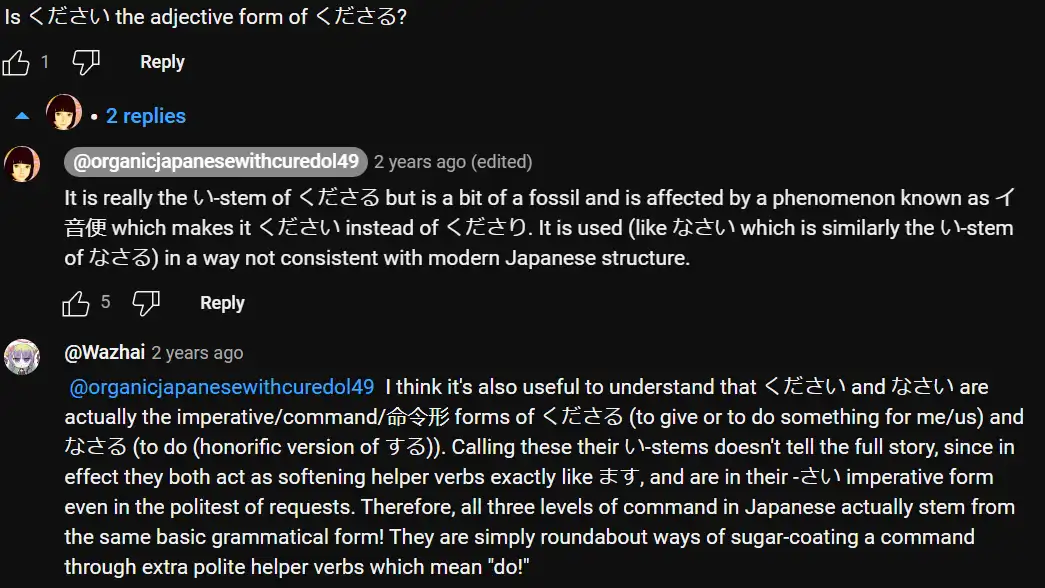

84. である and the Structure of Japanese. What older copulas tell us: である, であります、でござる、でございます
De-aru and the Structure of Japanese. What older copulas tell us: である, であります、でござる、でございます - Lesson 84
こんにちは。 Today we’re going to talk again about that element of Japanese that gives us the key to about a third of all Japanese sentences, and that is the copula.

Note: Notice how copula LINKS together the A (Subject) and B (Predicate), that is its function. Now, I’ve talked quite a bit about the copula before and I’ll put links in the information section below so that you can follow that up. (Lesson 40, 41, 55, 77 & 79 I think…) But today I want to look at slightly less commonly used versions of the copula which you are going to see quite a bit in your immersion and that raise certain questions about the structure of the copula itself which we’re going to address.
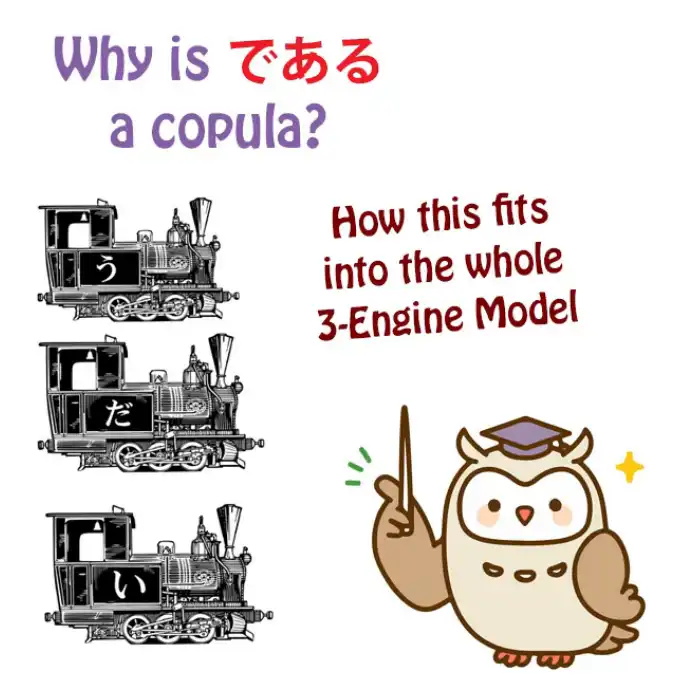
These are: “である”, “であります”, “でございます” and “でござる”.
Now, we can deal with the last three very quickly, because all of them are just variants of the first one, “である”.
であります
“であります” is obviously “である” with the “ます” helper verb attached.
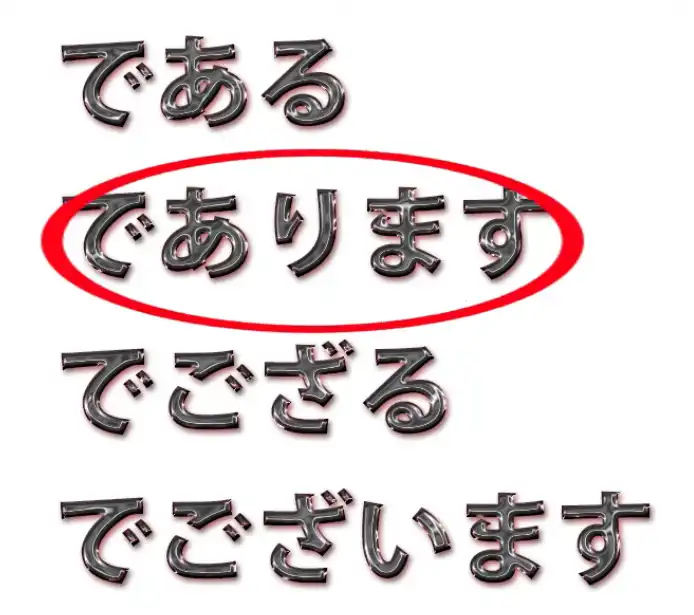
でござる
“でござる” – “ござる” is simply a polite, keigo version of “ある”, the verb of being.
Now, how does the verb of being get into this?
Well, we’ll talk about that in a minute.
“ござる” is simply made up of the honorific “ご” plus “ざる / 座る”, which originally means “seated”, but has the extended meaning of “existing”.
Note: 座る is normally read as すわる, but its On-yomi reading is ざ, therefore ざる here because I guess it is referring to its extended meaning of “existing”? So “ござる / ご座る” is just “ある” in fancy form.
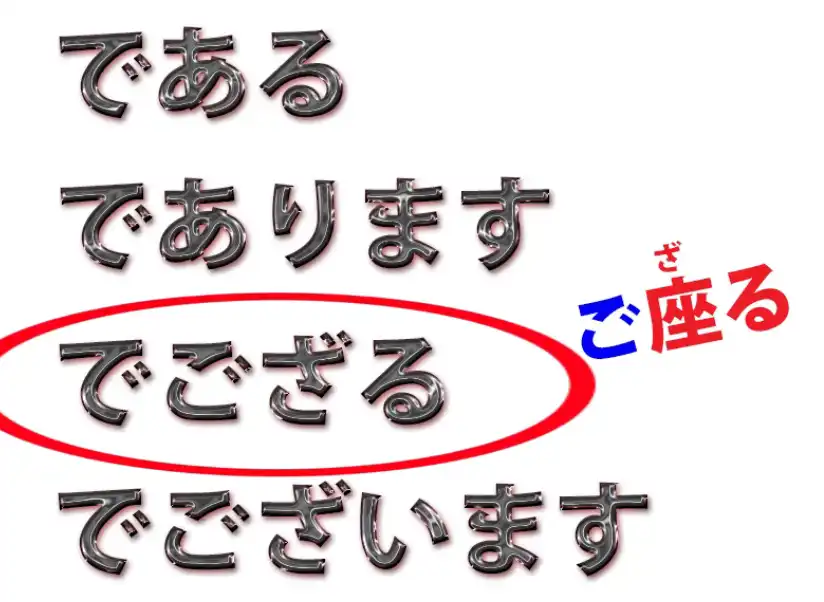
You won’t hear “でござる” very much at all because since it’s an honorific form these days it’s nearly always used with the “ます” helper verb attached.
But you will hear “ござる” perhaps in period drama and things like that.
It’s samurai talk.
でございます
“でございます” is the form of the copula that’s used in keigo,
so you’ll hear it in shops, you’ll hear it in public announcements,
and you’ll hear it used by speakers in anime etc who are using very honorific speech,
perhaps sub-villains talking to the main villain.
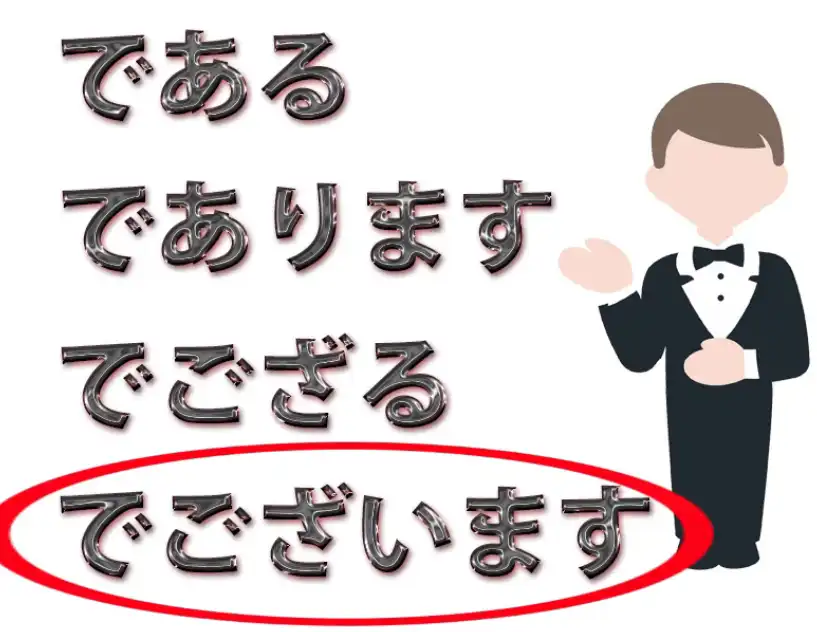
So that’s really all we need to say about those three.
である
But “である”, which is the root of all of them, is the one we need to pay attention to.
You could call it, in a way, the “straight copula”.
“だ” sounds casual, “です” is polite, but “である” is just the copula.

We see it used in contexts where we’re simply being objective, such as academic papers, newspaper reporting, that kind of thing.
We’ll also see it used in other contexts regardless of what register the writing is in because it has a particular quality.
As we know, “だ” and “です” can only be used at the end of a logical clause.
They are logical-clause endings and they can’t be used to pre-modify a noun.
If we want to pre-modify a noun with another noun marked by the copula, we can only do that if it’s an adjectival noun, because adjectival nouns can use the pre-modifying version of the copula, which is “な”.
We can say “花が綺麗だ” (flower pretty-is) or we can say “綺麗な花” (pretty-is flower).
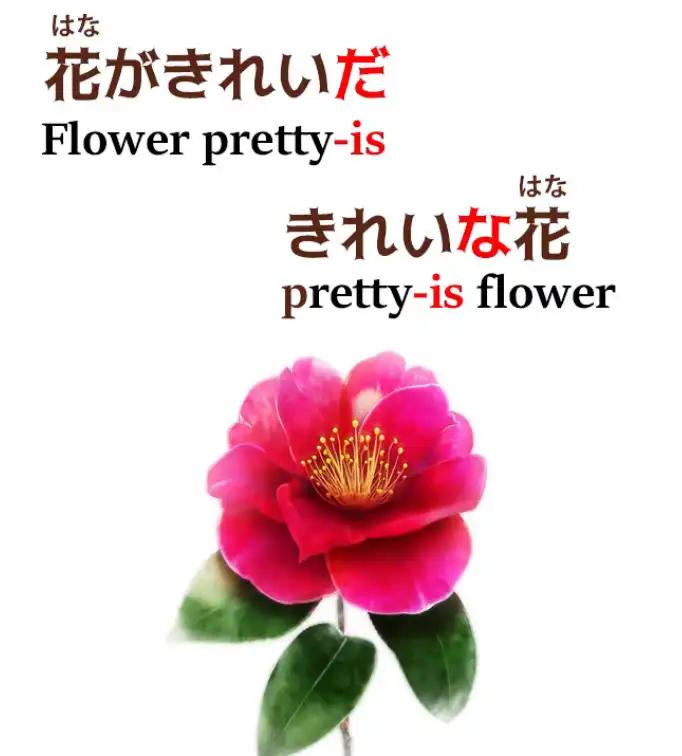
And it’s precisely because this group of nouns – and I’ve talked about the three groups of special nouns in another video if you’d like to look at that (Lesson 41) – this particular special group of nouns, adjectival nouns, has the property that it’s able to use the pre-modifying form of the copula, “な”.
This is something that the textbooks don’t seem to know.
They don’t tell you what “な” is and they tell you that adjectival nouns are actually some weird thing called “な-adjectives”.
But that’s another matter.
So what do we do if we want to use a copula-marked noun as a pre-modifier and it isn’t an adjectival noun?
Now, we don’t do this an awful lot because we can work around the situation by using “の”.
But in some cases either this doesn’t work or it just isn’t what we want to do.
So, suppose we want to say “Sakura who is a university student”.
Now, we can say “大学生のさくら”, which is “the university student Sakura”.
But suppose we don’t want to say that.
Suppose we actually want to say “Sakura who is a university student”? (make a relative clause)

It’s not quite the same, in Japanese or English.
In order to do this we have to use the copula and we have to use it as a pre-modifier, so we have to use “である”.
It’s our only choice. We can’t use “だ” or “です” because they can only be used at the end of a logical clause.
And we can’t use “な” because “大学生” is not an adjectival noun.
So we say “大学生であるさくら”. (Sakura who is a university student) And you’ll see that sometimes, especially in written material.
But there are cases where you really don’t have the choice at all.
For example, if you want to say “the state of being round”, you would say “円形であるさま”.
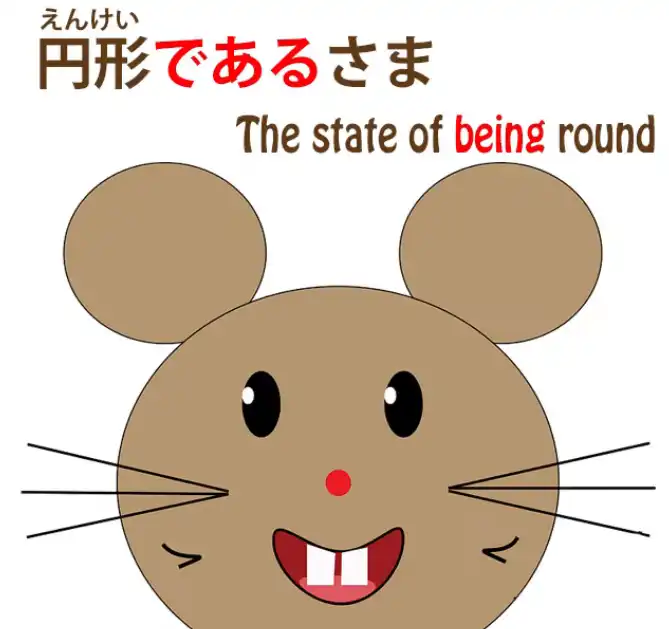
Now, “さま” is a state or condition.
We can’t really use の here; “円形のさま” doesn’t really work.
So we really have to say “円形であるさま”.
Now, when I say that “である” is the straight copula,
not the casual one, not the polite one, just the straightforward copula,
there’s another reason for this,
because ultimately and historically
“だ” is simply an abbreviation of “である”
and “です” is an abbreviation of “であります”.
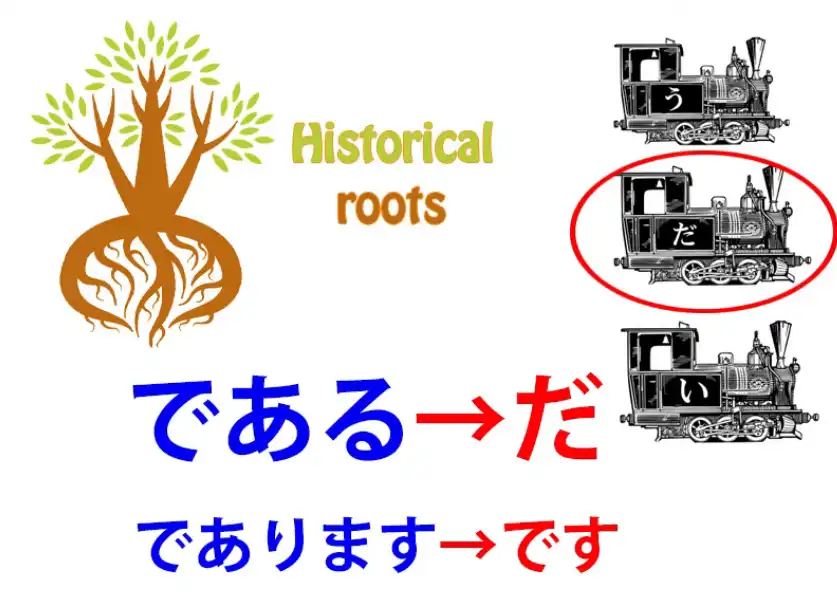
So, if you’ve followed my course, if you’ve been trained up to look at Japanese structurally, there are certain questions that this may make you want to ask, and some people have asked me.
First of all, haven’t I presented the copula as an indivisible, special unit,
one of the three engines, but
here it seems to be made up of two elements,
“で” and “ある”, and it looks very much like a verb.
So what’s going on here? And then, why in any case do the elements “で” and “ある” add up to the concept of the copula?
#
Why で & ある add up to make copula
Now, let’s look at this second part first and then we’ll look at the first part.
Why do “で” plus “ある” make the copula concept?
Well, as we know there are two “で”s in Japanese.
There’s the particle “で” and then there’s the て-form of the copula.
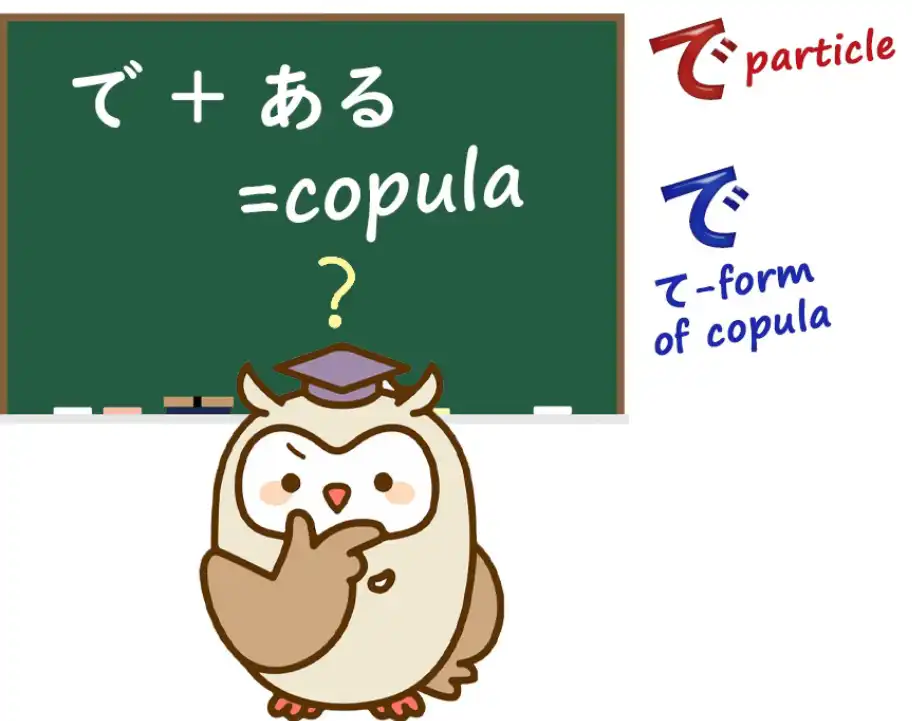
The textbooks don’t tell you this.
They let you think everything is the particle “で”.
But as we know there are two “で”s.
Now, the one we’re dealing with here is obviously the particle “で”.
Note: Huh…funny that this で particle thing was also one of my theories about である (and だ) It can’t be the て-form of the copula because the fundamental copula can’t be made up of two elements, one of which is already the て-form of itself.
And in order to understand what’s going on here, why “で” and “ある” add up to the copula, we need to know two things.
Now, I’ve made videos on both of these and I’ll link them as well,
but let’s just recap it here.
Note: it’s a bit hard to say which videos Dolly meant, but if so review Lessons 40, 41, 55 and 79.
The two things we need to know are first of all what the copula actually is,
and the second is what the particle “で” actually does.
##
What the copula actually is / does
What the copula actually is is something that takes two nouns, A and B, and tells us that noun A is part of a set represented by noun B.
That’s what the copula does. That’s all it does.
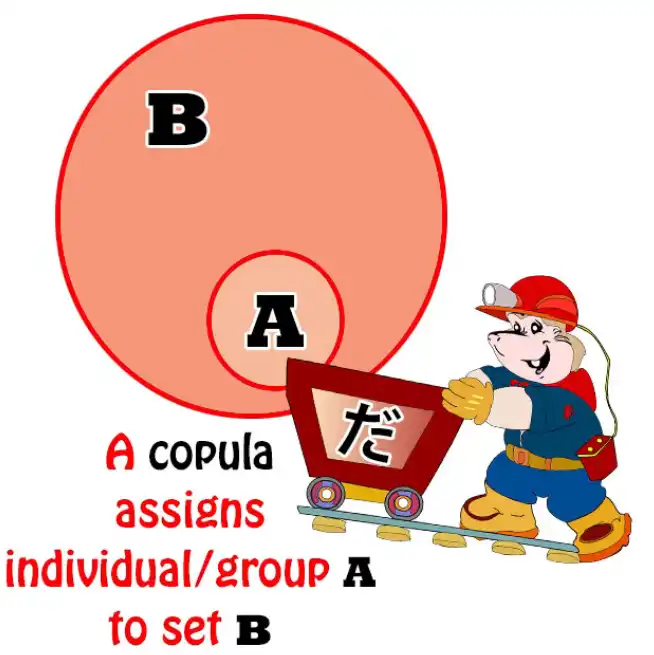
So if we say “さくらが日本人だ” we’re saying Sakura (noun A) is part of the set Japanese people (noun B).
And sometimes the set can be a set of one.
So if we say “That person over there is Sakura”, then we’re saying that that person over there belongs to the set of one which is Sakura.
We’re not talking about other Sakuras.
We’re talking about this particular Sakura.
##
What the particle で is / does
So now, what does the particle “で” actually do?
I’ve made a video about that and I’ll link it. (Lesson 55) Fundamentally the particle “で” defines the limit or field or parameter within which an action takes place or a state of being prevails.
So the simplest use of “で” is to say where an action takes place:
“公園で遊ぶ” (play in the park) –
the park, which is marked by “で”, is the field, the area, the parameters, within which I play;
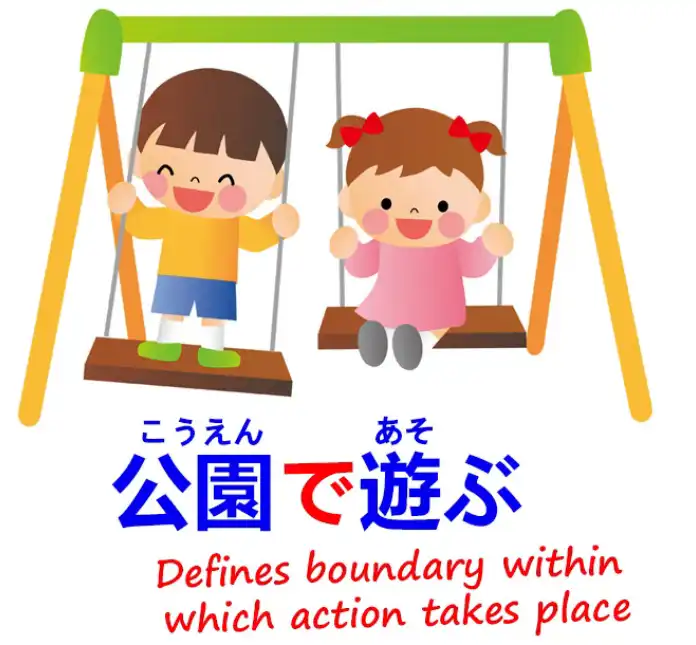
“世界で一番おいしいラーメン” (the most delicious ramen in the world) –
the world marked by “で” marks the field, the area
within which this ramen is the first, number one.
And it gets extended a bit further in other cases.
It could be the material something’s made with, the tool something is made by, etc.
In all cases it singles out a particular parameter from other parameters that allow the making to take place.
#
Back to である
Now, when we take “である”, what this is saying is exist (ある) within a particular boundary or parameter; in other words, exist within a set.
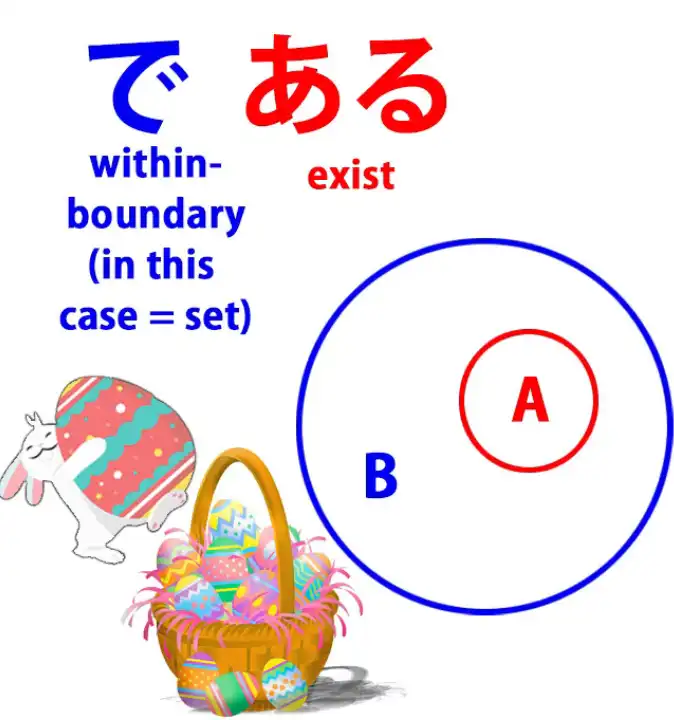
And that’s what the copula tells us.
It tells us what set, what boundary, something exists in.
Sakura exists within the boundary of Japanese people.
If we say “鷲が鳥だ” (an eagle is a bird) we’re saying
an eagle exists within the boundary, within the parameter, within the set, “birds”.
And this is what the copula always does.
So “である” is a very precise construction of the copula.
So let’s get to the second question.
##
Is である / the copula a verb?
The second question is, does this mean that it isn’t really an indivisible element of Japanese, one of the three engines?
And does it mean that it’s a verb?
Because obviously “ある” is a verb, and it’s because “ある” is a verb that we can use it as a pre-modifier.
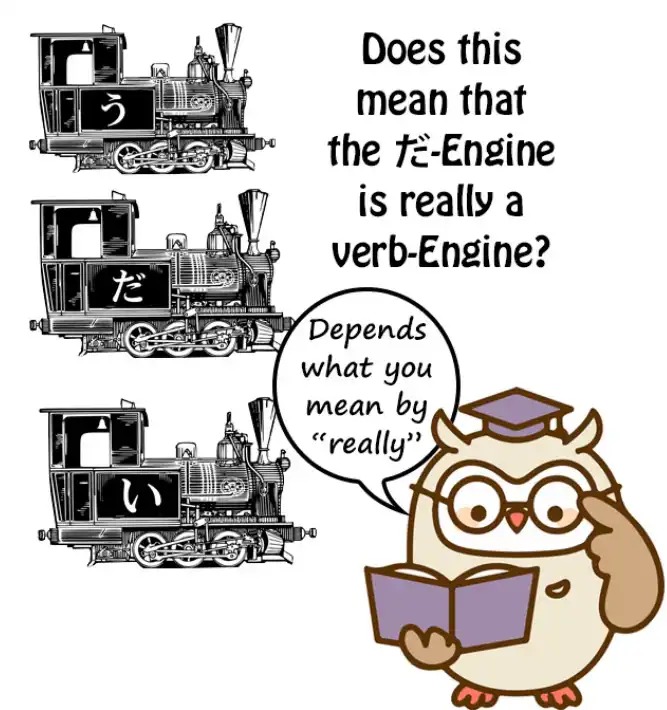
We can say “大学生であるさくら” because you can always use a verb to pre-modify a noun.
And the answer to the question is that this is a question of modeling.
I model Japanese in a particular manner.
It is possible to model it in other manners.
In Japanese grammar as taught to Japanese students, the copula is regarded as a verb.
(thus, copula has a verbal function = it can theoretically be regarded as a special kind of verb)
—
And in fact an adjectival noun plus the copula is called a “形容動詞”,
which means an adjectival verb.
The “verb” part is the copula which is added to it.
So “綺麗” is not a 形容動詞; “綺麗な” or “綺麗だ” is a 形容動詞.
And the “動詞” part, the verb part, is the copula.
But I do not model the copula as a verb.
And the reason for that is that in our three-engine structure I restrict the term “verb” to those entities that end in う-row kana and do all the things that those entities do: we have the four stems, etc.
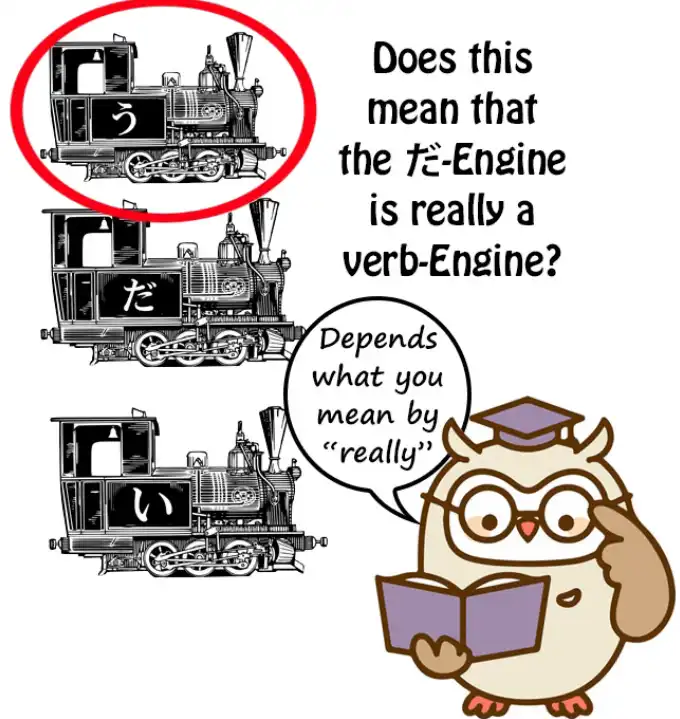
Note: This further shows that there are different ways to view language, and both can work in their own systems, so it is best to be aware of both ways & use them as what works for you. The copula doesn’t work like this in modern Japanese. It works differently.
“である” has evolved into an entity in itself with its own て-form, which it has, with its own connective form, “な”, which it has.
We could, if we wanted to, model all three engines as verbs, because in many ways adjectives are also verb-like.
But they don’t work like the う-ending entities and they don’t work like the copula.
So, within my model of Japanese, which I think is the best one for non-native learners of Japanese to use, we use the three-engine structure.
We regard verbs, adjectives and the copula as three unique entities.
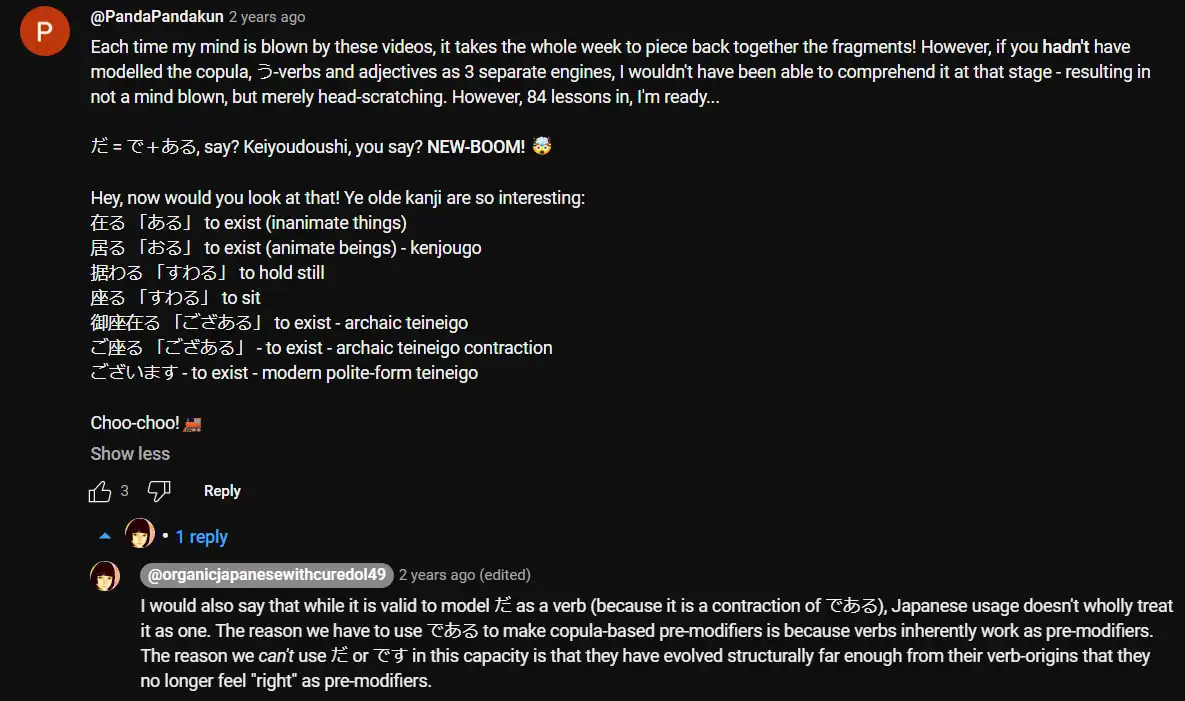
This is not a statement about the etymology of Japanese.
It’s not even a statement about the “real truth” of Japanese grammar, because there is no “real truth” in grammar.
Grammar is simply a means of describing a pre-existing phenomenon, which is language.
Grammar is not the source code of language.
Grammar is an attempt to describe language by modeling it.
And I use and recommend the three-engine model.
If you prefer another model, you’re free to use it.
The other reason I maintain that distinction is because it’s very important not to confuse “で” which is the て-form of the copula with the particle “で”, and it’s very important not to confuse the concept of the copula with the verb of being, “ある”.

And that happens all too easily to English speakers or people who are very familiar with English, because in English the copula and the verb of being are represented by the same word, and that’s “is” and its variants “was”, “am”, “are”, etc.
They’re the same word, but they’re not the same concept.
So when we say that “だ” and “です” mean “is”, this is a confusing way of looking at it.
They don’t mean “is” in all circumstances; they mean “is” when it’s the copula.
So if we say “That animal is a rabbit”, this is the copula.
We’re placing “that animal” into the set “rabbit”.
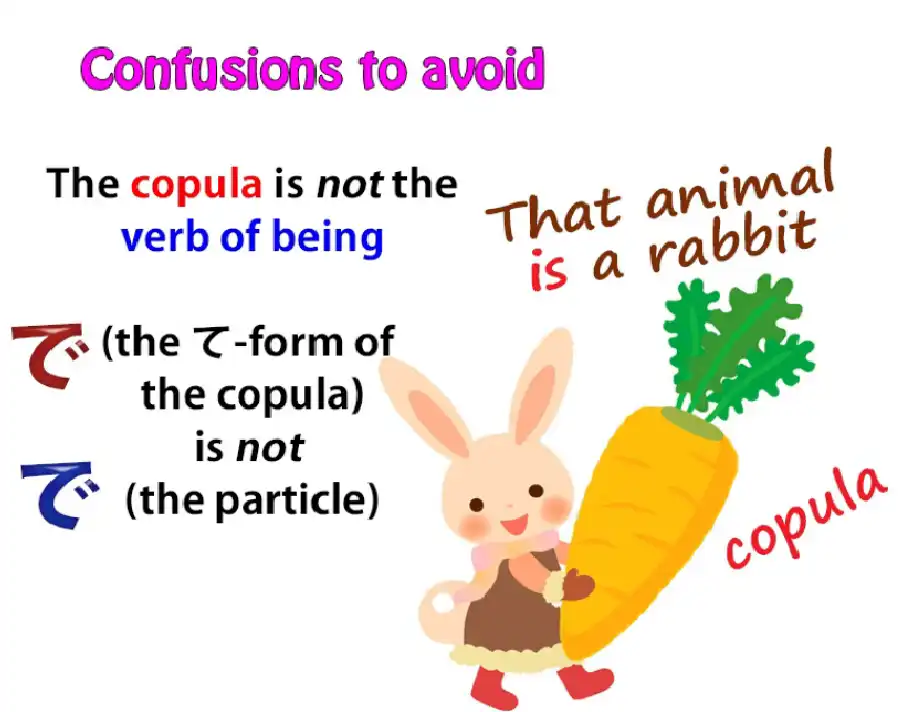
If we say “There is a rabbit”, that’s not the copula, it’s the verb of being.
We’re saying a rabbit exists, there in that place.
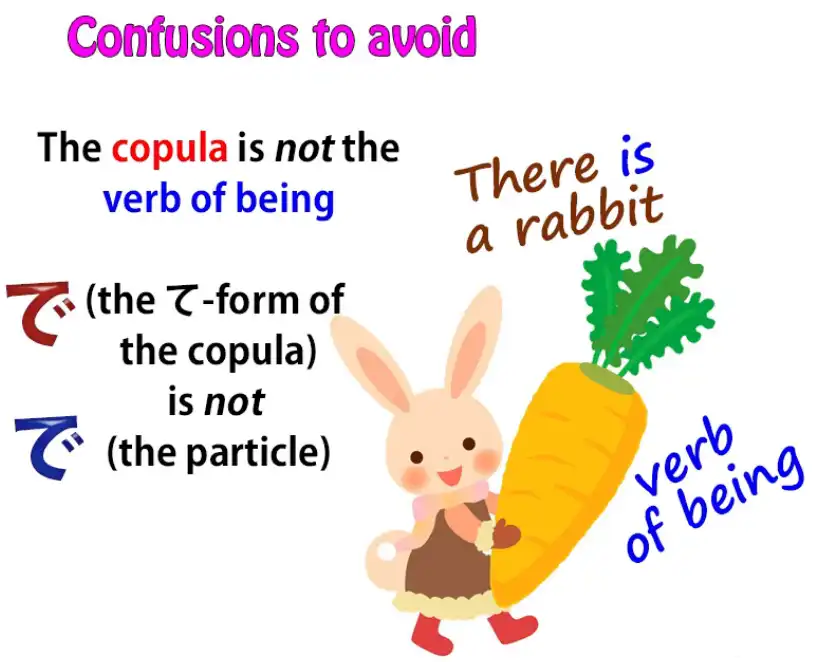
Now, because these two concepts are very easily confusable,
and because textbooks and even more advanced academic texts
do a very, very poor job of differentiating them,
I believe it’s important to keep the copula, which is
an unfamiliar concept in English, because English has no dedicated copula,
to keep it separate in the three-engine model.
Note: This is quite interesting, link here if the screenshot is too hard to read. Highly recommend reading the entire comment section under this video, as there are some interesting comments.
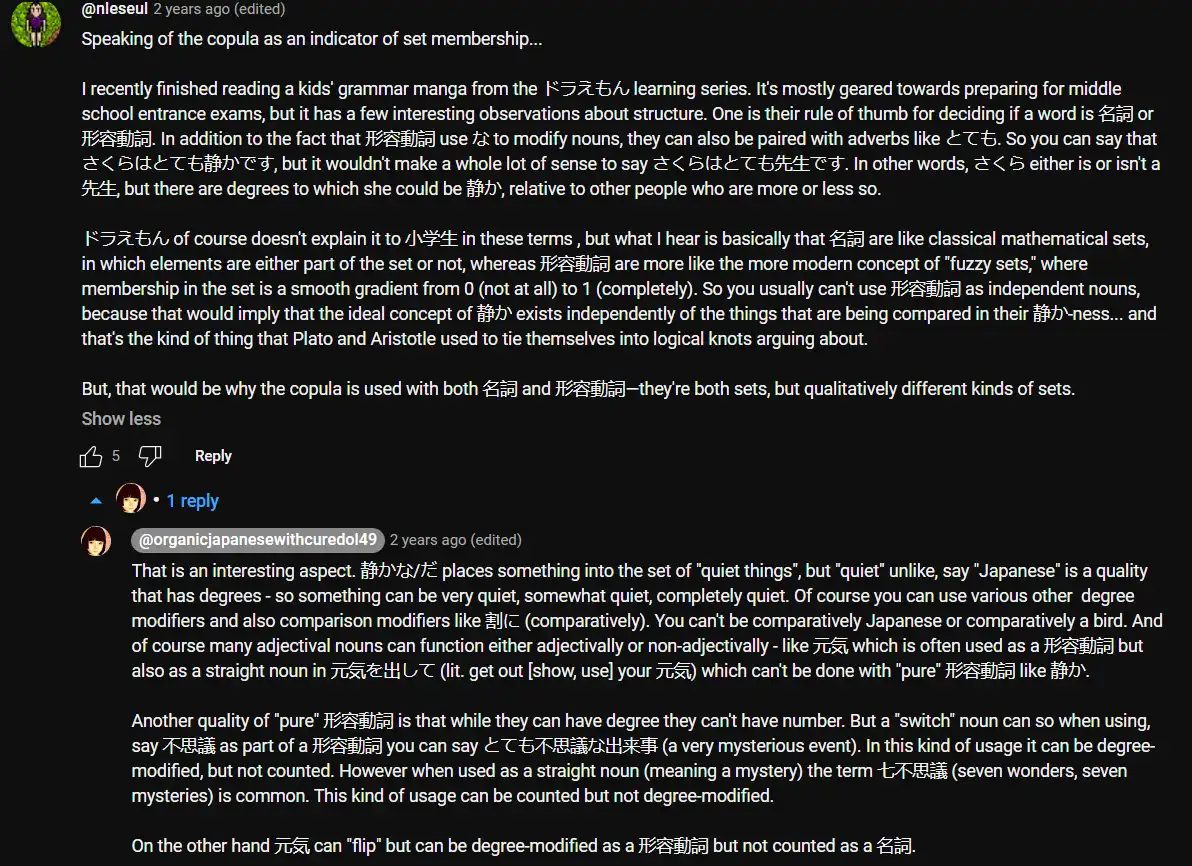
85. まい - the negative helper
まい the negative helper that never gets explained properly - Lesson 85
こんにちは。 Today we’re going to talk about an unusual but not uncommon element of Japanese that you’ll certainly come across in your immersion.
It can be confusing because nobody really explains exactly what it is and what it does – and of course they certainly don’t explain why.
A number of people have asked me about this recently including my Red Kokeshi patron Bob Nagler, who says, “Have you ever done a video of verb plus ‘まい’?
I’ve not found a very useful explanation anywhere, only lists with examples and translation which give somewhat of an idea.” Well yes, that is pretty much the state of play. So let’s do the video now.
What is まい?
“まい” is a negative helper like “ず” and “ぬ”, which I did a video on quite recently.
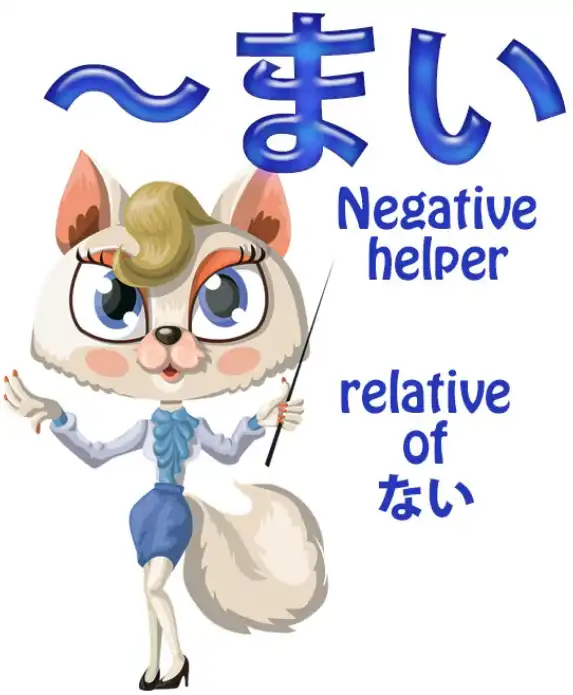
And like them it’s something of a fossil, one of those elements that’s not quite at home in modern Japanese.
But it’s used quite a lot, so we need to understand it.
The first unusual thing about it is that unlike most helpers, it doesn’t attach to one of the verb stems.
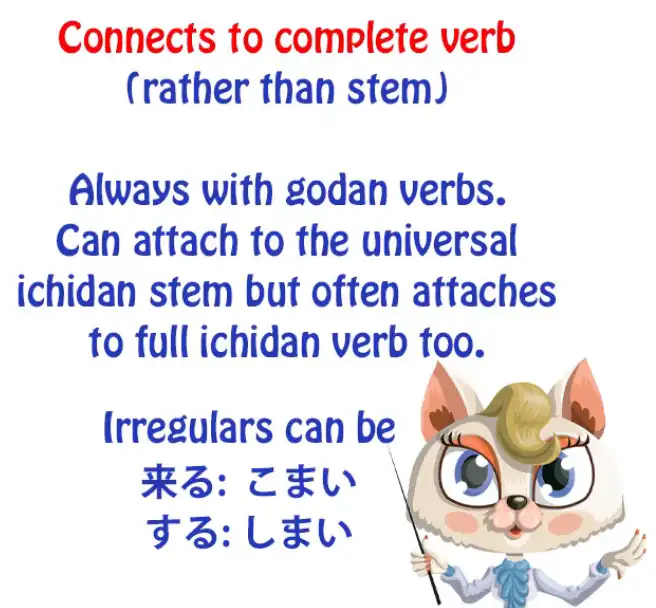
It gets stuck straight onto the end of the verb in most cases.
So if we want to put it onto “行く” we just say “行くまい”.
This is always the case with godan verbs because there’s no other way of attaching “まい”.
With ichidan verbs we can attach it to the universal ichidan stem (as you know, with ichidan verbs we always, whatever we’re doing with them, we always just take off the -る and put on whatever we want to put on).
So, for example, “見る” can become “見まい / みまい”, but just as often it’s “見るまい”.
With the two irregulars, “来る” and “する”, they can be “来るまい” and “するまい”, but they can also be “こまい” and “しまい”.
Now, strictly speaking, certainly in the past, using ichidan verbs in their entirety with “まい” on the end was probably ungrammatical, but now it’s so widely done that it’s generally accepted.
You’ll see it everywhere on the television news or anywhere.
So what is this “まい”?
Well, it’s really a sort of sister to the helper adjective “ない”, which is the negativizing adjective.
What’s the difference between “まい” and “ない” apart from the way it attaches?
Well, what “まい” actually is is the volitional form.
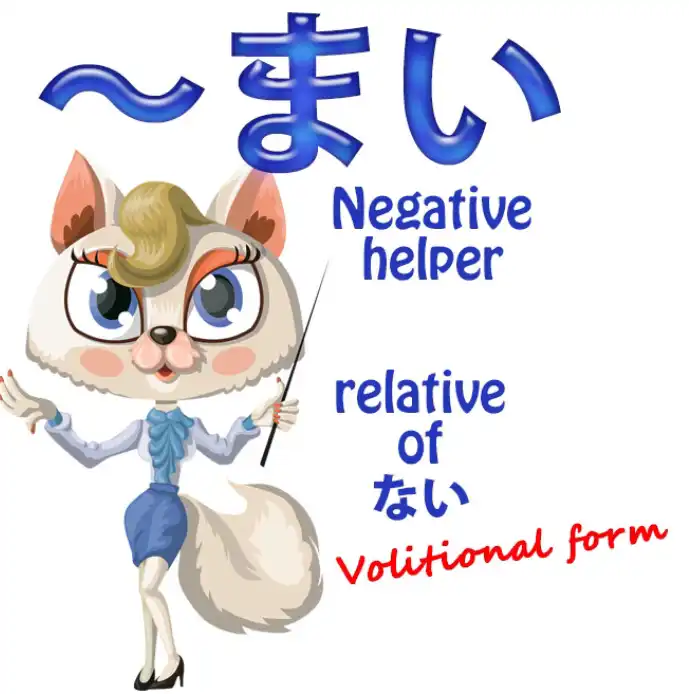
Now, adjectives don’t usually have volitional forms, but in this case we do, and it has certain uses.
Like “ない”, “まい” is an adjective, but unlike “ない” and just about every other adjective, it doesn’t morph in any way.
You don’t say “まくて” or “まかった”.
You only ever use it in its simple, unchanged form, “まい”, so it is, in a way, a static element in Japanese, not an active element.
And this actually is quite natural, because it’s the same with the positive volitional, isn’t it?
We have て-forms and past forms of helpers like the receptive and the causative and, of course, “ない” itself, but we don’t have past and て-forms, etc., of the volitional.
“食べよう”: you don’t put that into the past, it doesn’t have a て-form, because that doesn’t really make any sense with a volitional.
What a negative volitional cannot do
So what does a negative volitional actually do?
It doesn’t do all the things that a positive volitional does.
You can’t use it as a call to action: “行きましょう” (let’s go). (this example is positive volitional) You can’t say “行くまい” (let’s not go) – it doesn’t mean that.
You can’t use it for, as I’ve shown in another video (Lesson 18), forming a construction that means “try to do something”.
So you can’t use “まい” in let’s-try-not-to-do-type constructions.
The uses of まい
Its uses are pretty limited; it has a couple of direct uses and then a couple of other uses which are really quite useful.
So, let’s look at them.
#
Using まい to say that something is unlikely
Its most usual use by a long way is saying that something is unlikely.

It’s a volitional negative, so just in the same way that we can voice conjectures or assessments – and this is very often used with the verb “ある”, so we say “あるまい”.
“そんなことはあるまい” (that’s just not likely / I don’t think such a thing is probable at all).
But it works just the same with any other verb.
“この降りでは彼はこまい” (In this downpour, I doubt if he’ll come).
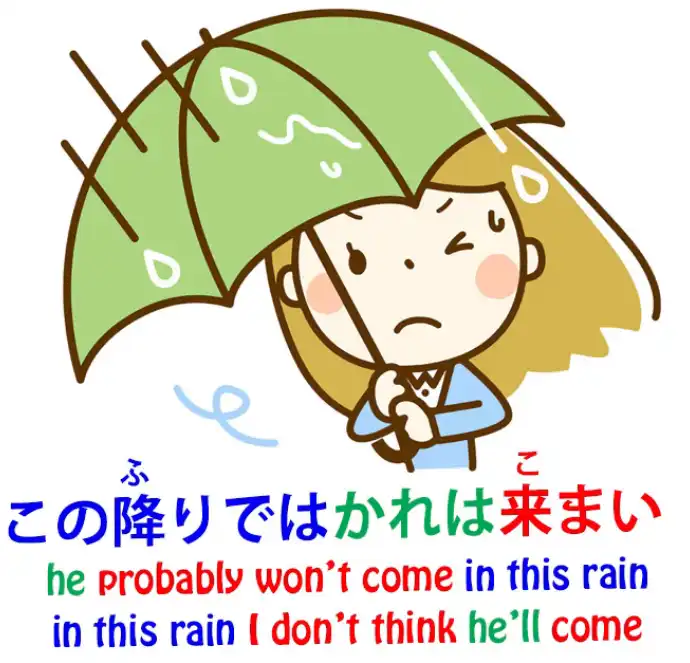
And this is rather related to the other adjectives of subjectivity that we’ve discussed elsewhere (and I’ll put a link for that), (Lesson 9) such as “欲しい”, which represents our desire for something, or “怖い” which represents our fear of something.
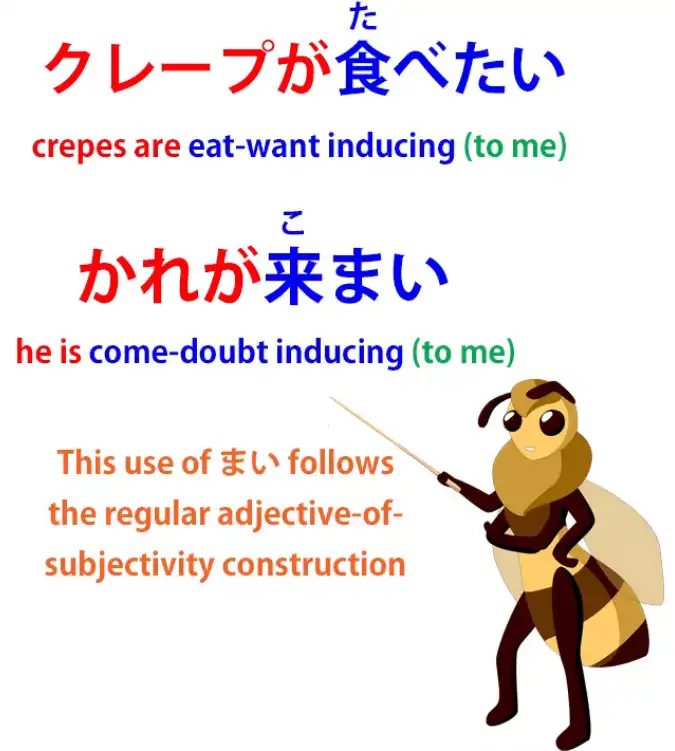
As usual, these adjectives are pointed at the thing that we desire, that we fear, etc.
And in this case, they’re pointed at the thing that we consider unlikely.
It represents really our subjectivity about the likelihood of something.
##
An exact Japanese equivalent to あるまい
If we want to give an exact Japanese equivalent,
“あるまい” is directly equivalent to “ないだろう”
(doesn’t exist, I conjecture) or “ないでしょう”,
and “ではあるまい” is directly equivalent to “ではないだろう”, “ではないでしょう”,
“じゃないだろう”, “じゃないでしょう”, (to all of these forms)
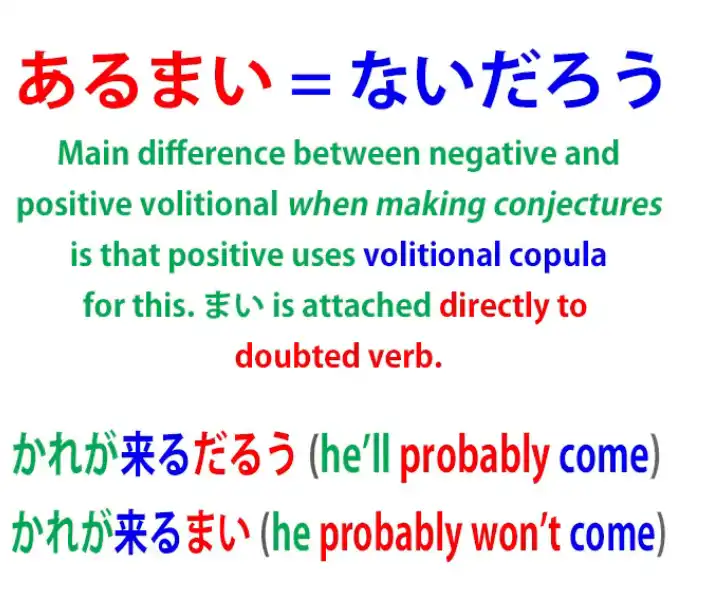
in other words, “A isn’t B, I would conjecture, it seems likely” etc.
And the interesting point here is that, as we see, with this conjectural use of the volitional in its positive, more usual form, we don’t attach the volitional directly to the verb that we’re conjecturing about.
So we don’t say “さくらはすぐに帰ろう”.
That doesn’t mean “Sakura will probably come”.
We say “さくらはすぐに来るでしょう (or だろう)”,
because that’s the way we do it.
We do it with the volitional copula when we’re making that kind of conjecture.
But with “まい” we can attach it directly to the verb as we did in the previous example.
“そんなことはあるまい” is directly equivalent to “そんなことはないでしょう”.
And there’s no room for ambiguity here because “まい” has a more limited range of meanings, as we’ve just discussed, than the positive volitional has, so we’re not going to get confused with, say, a call to action, because “まい” doesn’t do calls to inaction.
So, the most common use of “まい” is as the negative adjectival of these “でしょう / だろう” conjectural constructions.
#
まい used for a strong decision or determination not to do something
However, it is also used for one other negativizing structure that is directly equivalent to the positive.
So we can say “二度と行くまい”
(I won’t go there again; literally, I won’t go a second time).
That’s the other common meaning.
When it’s not expressing a likelihood or possibility, it’s expressing a strong decision or determination not to do something.
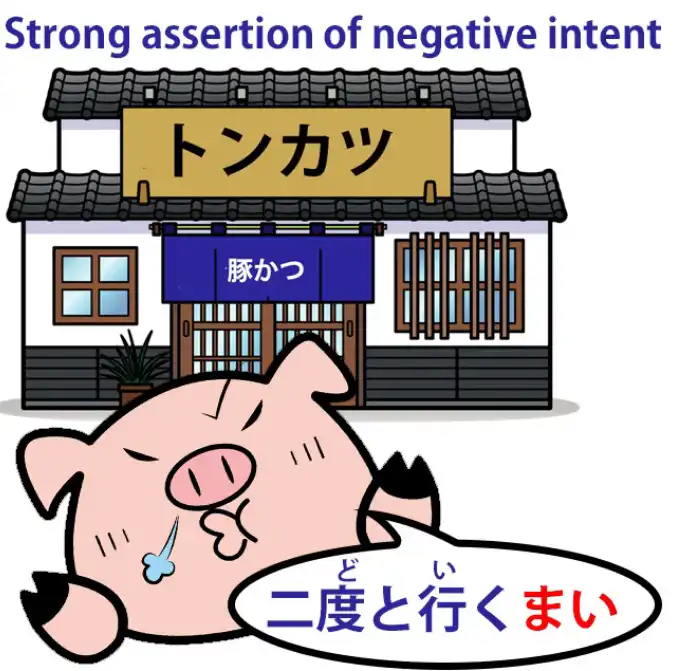
Now, beyond these few uses, there are also a couple of other common constructions in which “まい” is used, and you’re pretty much certain to hear these.
#
Using positive & negative volitional together
One uses the positive and negative volitional forms together, meaning whether the verb is done or not.
So, for example,
“行こうか, 行くまいか” means “whether I go or not”.
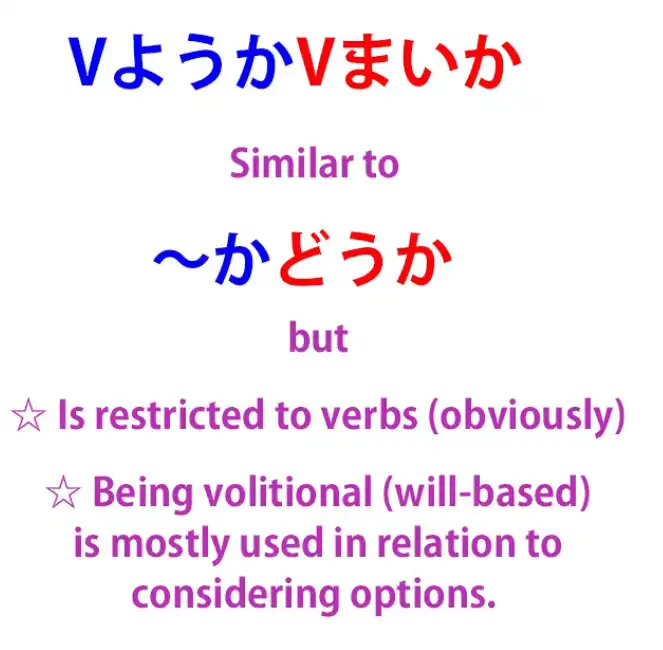
Now, this is very similar to a construction that we’ve talked about before and that you probably know already (Lesson 39), “行くかどうか” which means literally “whether I go or how”, which in more natural English would be “whether I go or what”.
#
Attaching し to the まい construction
Now, the other construction that you’ll commonly hear is formed by simply attaching “し”, which is used for listing causes of something, but as we’ve discussed elsewhere (Lesson 63), it’s often used on its own just to imply a continuing list.
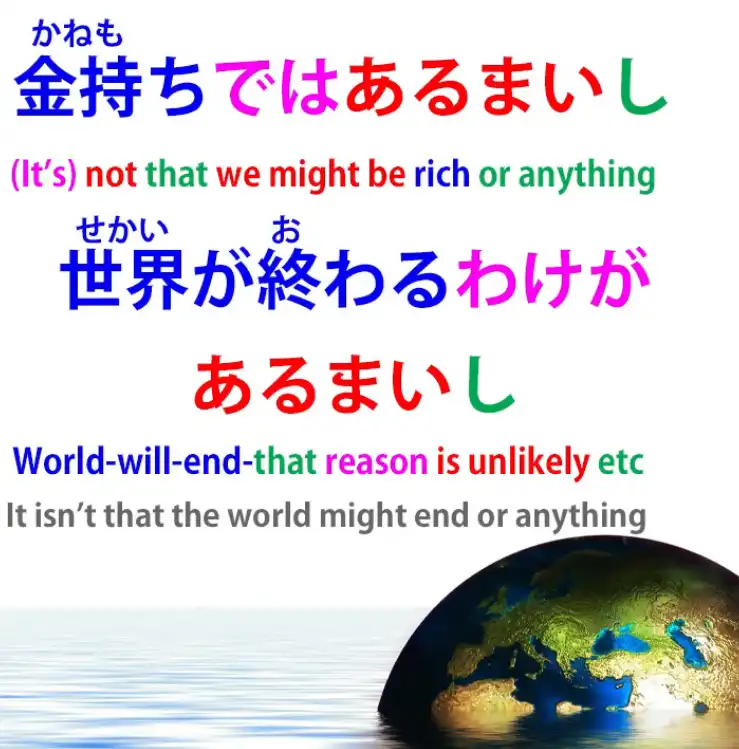
And this gives a construction that’s somewhat comparable to the “it isn’t as if…” or “it isn’t like…” construction in English.
So if we say “金持ちではあるまいし” which is roughly equivalent to the saying in English “it’s not as if we’re rich”, or “世界が終わるわけがあるまいし” (it’s not as if the world is going to end).
Note: In the video subs, it does not record the が after わけ, but Dolly seems to pronounce it, it is just very weakly pronounced by her here if you listen carefully. That’s how we’d put it in English.
In Japanese, it’s more like saying
“it isn’t that we’re rich or something like that”
(that’s the “し” , the something like that).
(I am trying to highlight the parts, but it is limited, luckily the video picture above shows it well)
And the volitional is again marking a negative hypothetical.
Someone might act as if the world were going to end, but in fact it probably isn’t.
We might look to some people as if we’re rich but, well, we don’t seem to be, do we?
So this is how the “まい” helper works in its various different common uses…
*Note: This can be useful, even if unrelated here.Sorry if hard to read, zoom-in here or see here
*
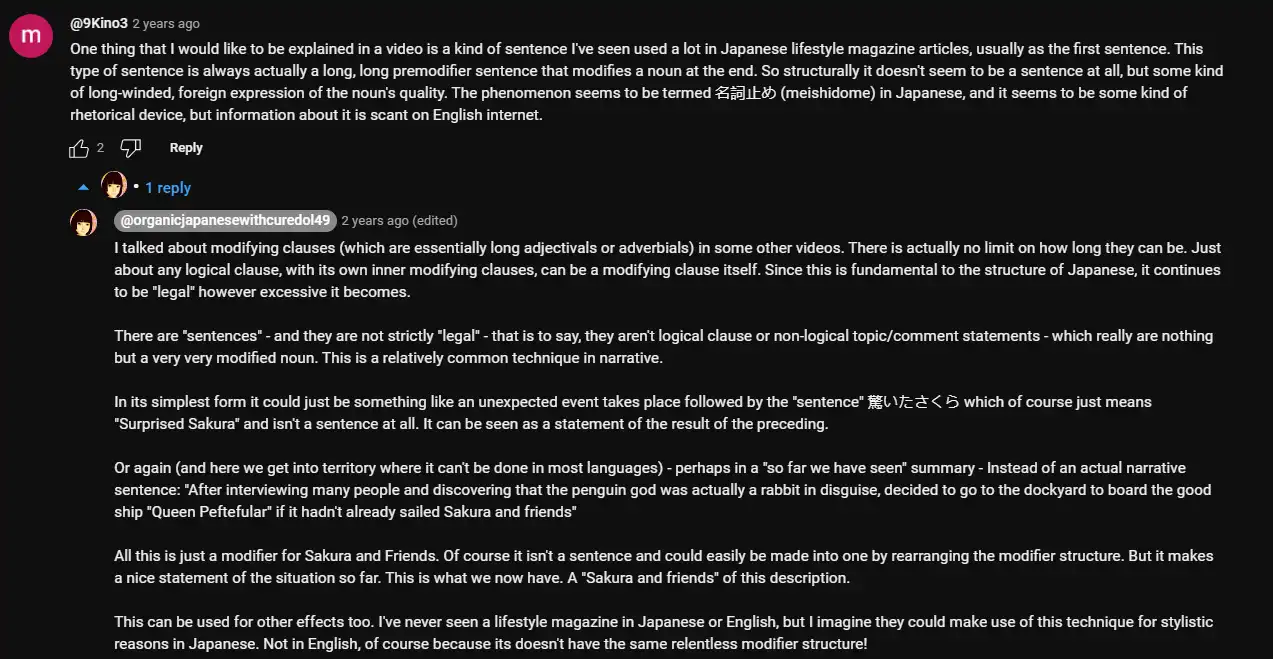
86. 次第 (shidai)
次第 (shidai) - What it really means and how it really works. Lesson 86
こんにちは。 Today we’re going to talk about one of those words that has a huge list of apparently unconnected meanings, if you take the English-Japanese dictionary seriously, which makes it feel very difficult.
But as is usual in these cases, the real problem is simply trying to fit the square peg of English definition into the round hole of Japanese.
So, if we take a look at the word we’ll be able to understand what it really means and how it really works.
The word is “次第”.
According to the dictionary, it can mean “depending on”, “as soon as”, “immediately upon”, “in accordance with”, “order”, “program”, “precedence”, “circumstances”, “course of events”.
And then we have what the conventional textbooks like to call a “grammar point”: “次第に”, which means “gradually” in the sense of gradually progress into a state.
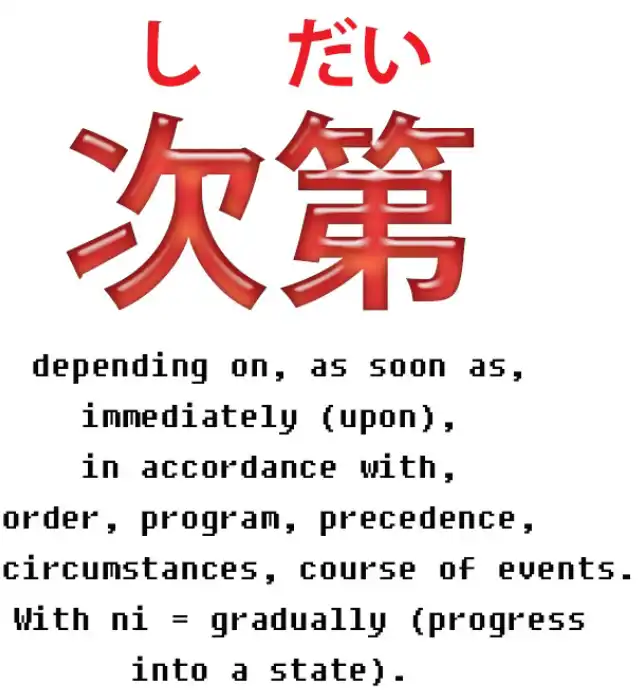
So, how do we make sense of all this?
What is 次第?
Well, let’s start by looking at “次第”.
“次第” is made up of two kanji and it’s a noun.
And you ought to know that as soon as I say it’s made up of two kanji and nothing else, we know that it’s a noun. That’s all it can be.
And the two kanji are: this first one, which is the kanji we use in “次” (next), and that’s what it means, “next”.
And this one, “第”, which is the Japanese ordinal.
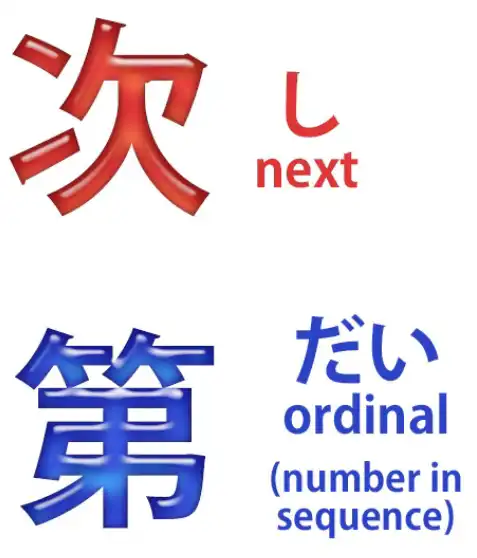
Now, what’s an ordinal?
In English, an ordinal is the -st in “first”, the -nd in “second”, the -rd in “third”, the -th in “fourth” etc.
In Japanese, fortunately, we only have one ordinal for every number and it’s “第”, and we put it before the number, not afterwards.
So if we want to talk about the third episode of an anime we say “第三話”; so the “第” is the -rd, the “三” is the three, and “話” is the counter for stories or episodes.
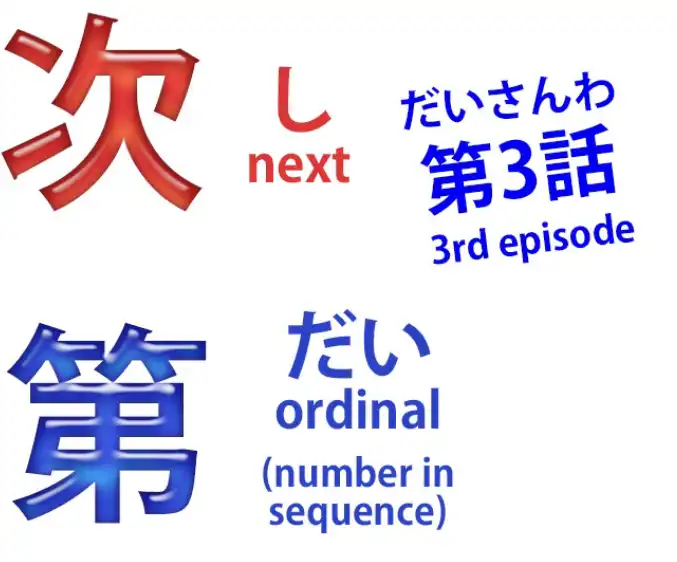
So, we have the “次 / つぎ” kanji, the “next” kanji, whose regular on-reading is “し”, and we have “第 / だい”, meaning “ordinal / sequence / number in sequence”.
So what it means is “next thing in sequence / next thing in order”.
And one more thing we need to know about this word is that it generally works by attaching to another noun.
And this gives us a kind of compound.
So if we attach “時計” to “腕”, “腕” is telling us about the “時計”.
“腕時計” is an “arm-clock” (a wristwatch).
If we attach “砂 / すな” to “時計” then we have a “sand-clock” (an hourglass) - 砂時計.
And similarly we form these noun-compounds
with “次第” and whatever it’s attached to.
次第 as “as soon as” or “immediately upon”
And the simplest use of this is where it replaces the English expression “as soon as” or “immediately upon”.
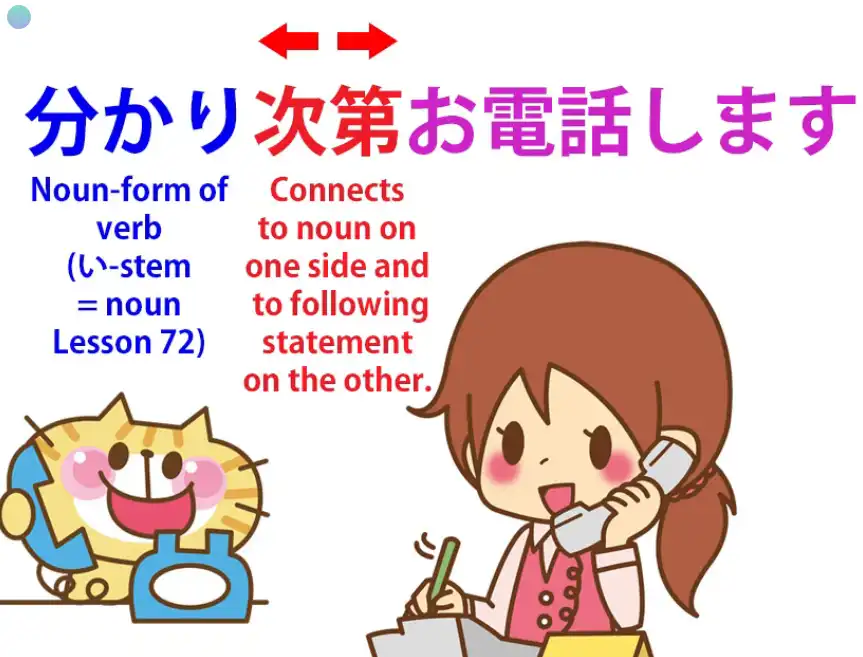
So, if we say, “分かり次第お電話します”, we’re saying, “As soon as (it) becomes known…
(“分かる”, become known; literally, do known, do understandable)…
As soon as it becomes understandable, I’ll call you.”
What you see that we have here the い-stem of “分かる” (do understandable),
which is “分かり”,
and we’re creating a compound noun, which means
“next thing in sequence after doing understandable is that I’ll call you /
As soon as it becomes understandable, as soon as we know the situation, I’ll call you.”
=分かり次第お電話します
—
“食事の用意が出来次第食べる.”
So, although here we actually have a logical clause:
“食事の用意が出来る” (preparations for the meal are completed; literally, come out),
we actually have the stem of できる here, which is “出来 / でき”,
and that’s attached to “次第”.

So, “the next thing in sequence after the preparation’s been completed is eat / As soon as the preparations for the meal are finished, we’ll eat”.
=食事の用意が出来次第食べる
次第 as “depending upon”
And from this logic we then get what seems to be a completely different idea in English, which is “depending upon”.
So we might say, “それは天気次第だ”.
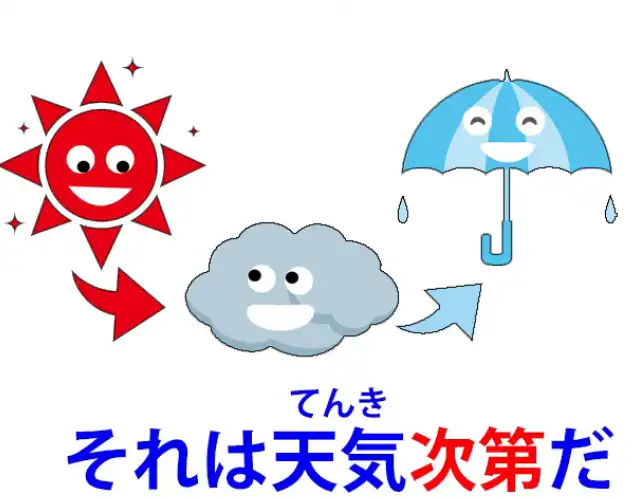
In English we’d say “that depends on the weather”.
But in Japanese what we’re saying is “that follows directly from the weather”.
And, as you see, it’s a different way of putting it, but it means fundamentally the same thing.
“彼の答えは気分次第だ.” Now, that means “his answer follows directly from his mood”.
In other words, his answer depends on what mood he’s in.
#
手当たり次第 phrase
And a useful phrase to know here is “手当たり次第”.
“手当たり” is “手” (hand) and “当たり” (touch or contact).
“手あたり次第” means “whatever one can lay one’s hands on / whatever comes to hand”.
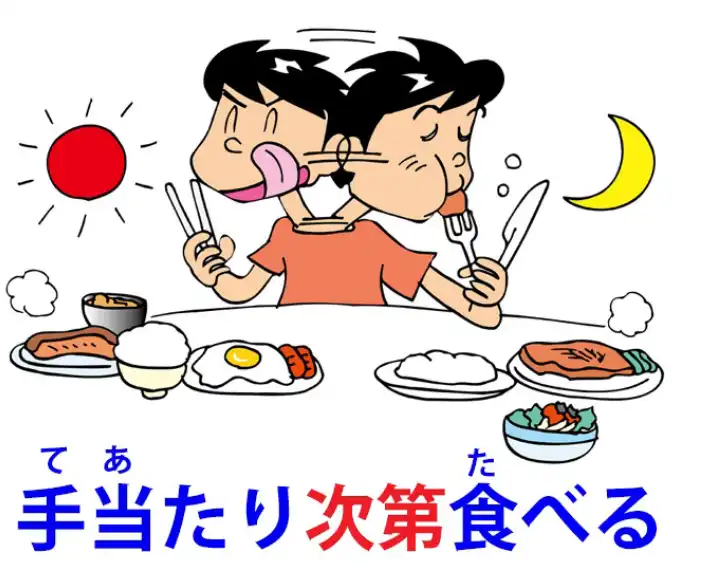
So, “手あたり次第本を読む” (I read whatever book comes to hand).
Reading a book follows directly from hand-touch of a book, literally.
“手当たり次第” can be used in all kinds of constructions: I eat whatever comes to hand; I read whatever comes to hand; I throw whatever comes to hand at the neighbors.
And, as you see, it’s the noun-form of this verb (touch) “当たる”, which is “当たり”, which attaches to “次第”.
#
Attaching 次第 to a person
Another useful trick is that we can attach “次第” directly to a person.

So if we say “あなた次第です”, we’re essentially saying “it’s up to you / it follows directly from you”.
Now, this wouldn’t be expressed in English as “depends on”, and in fact if we wanted to say “it all depends on you” in Japanese, we’d have to use a different kind of construction altogether.
Within the Japanese meaning spectrum, what “あなた次第だ” means is “it follows directly from you”: It’s up to you, it’s not up to anyone else, it doesn’t follow from me, it doesn’t follow from anybody else, it follows directly from you, it’s up to you.
The important thing to understand here is that while the English meaning spectrum and the Japanese meaning spectrum differ, in Japanese terms we’re dealing with the same fundamental idea all the time.
It’s not a random selection of ideas, the way it looks as if it is when you see it in an English-Japanese dictionary.
次第 as “according to”
From here we get meanings like “according to”: “値段は品次第で違う”, which literally means “the price differs directly following the goods”.
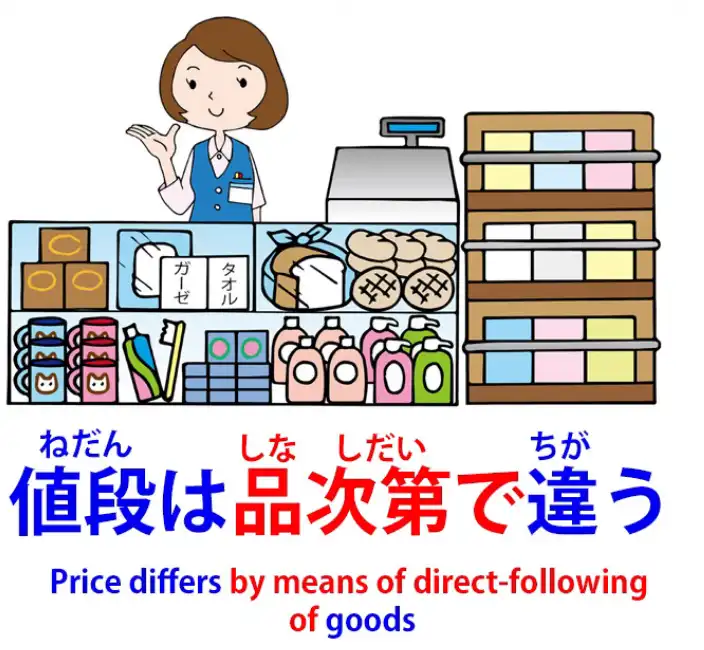
Now, if the goods are the same, which they usually are in this kind of a construction, then it would mean the quality of the goods, just as “天気次第” means the quality of the weather, the type of weather, and “気分次第” means the quality of somebody’s mood, the type of mood.
So, “品次第” means the type of goods, the quality of goods.
Now, we can still use the “depending” translation here and not the “according to” translation.
We could say, “The price depends on the quality of the goods”.
However, if we use an expression like “身分次第に暮らす”, we’re saying “live according to one’s station in life, according to one’s means”.

We can’t use “depend” here in English, but as you see as far as Japanese goes it’s exactly the same idea.
“身分” isn’t quite translatable, but it means one’s position in life, one’s status, and it can, particularly in modern times, mean how much money one has.
次第 as a process, a set of circumstances, a course of events
Now, in some cases, and this is where it becomes a little more extended, “しだい” (next in sequence) can represent the whole sequence.
So in these cases it can mean things like a process, a set of circumstances, a course of events.
So one might say, “それはこんな次第だった” (it was this kind of situation, it was this kind of a sequence of events).
次第に
Now, we also have what the textbooks would call the “grammar point”, “次第に”.
This is simply the standard practice of taking a noun (“次第” is a noun) and using it adverbially to describe a verb.
And doing something “次第に”, in a “次第” manner, is as a sequence of steps or gradually.
So, “チェシャ猫は次第に消えた” (The Cheshire Cat disappeared gradually).
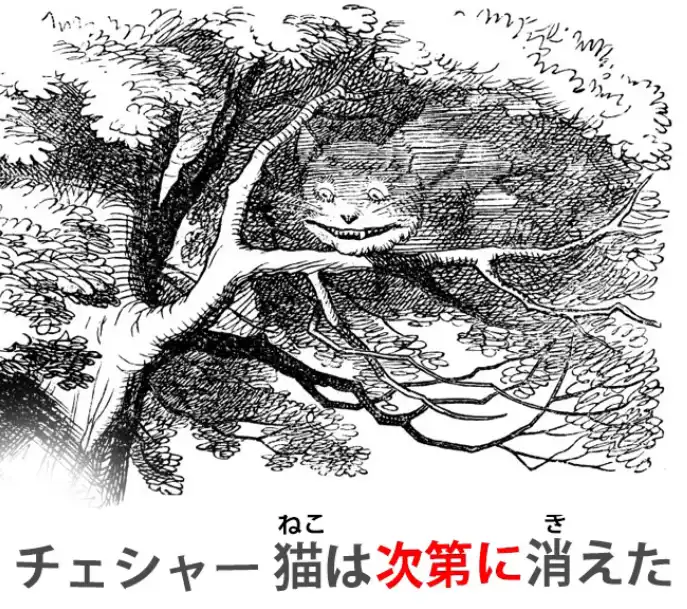
Or “夜は次第に長くなる” (the nights are growing longer, day by day, step by step).
And this always implies a process taking place over time either in definite stages or not, but taking place over time, bit by bit.
And because this is put forward as a “grammar point”, it can be a bit confusing.
What we need to notice is that not every use of “次第” that is followed by に corresponds to this so-called grammar point.
The real issue here, which doesn’t tend to get explained, is that
when “次第” is not modified by another noun
and it’s on its own acting as an independent adverb,
that’s when it has this meaning.
So, in the example we saw earlier, “身分次第に暮らす”,

that isn’t an example of this. It is being used adverbially, but what’s modifying “暮らす” is not “次第” on its own but the compound “身分次第”.
So these are the fundamental uses of “次第”.
They seem very different if you look at them through English glasses, but if you look at them as they are, I think we can see that “次第” works pretty much the same way all the time.
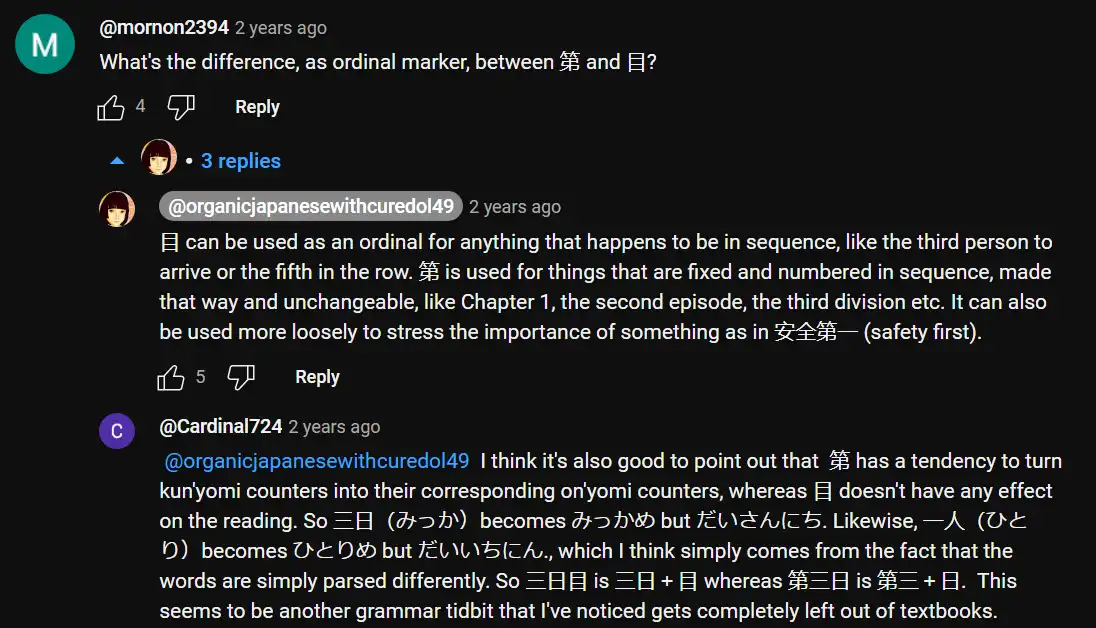
87. Japanese Structure INVERTED: strange life of しか
Japanese Structure INVERTED: the strange life of しか. How it really works. Lesson 87
こんにちは。 Today, I’m afraid I don’t have any reindeer for you, but I do have a few deer.
We’re going to talk about the word “シカ / 鹿”,
which, as you probably know, means “deer”,
Note: Just in case, this しか is different to the particle しか of this lesson, hence the Katakana, there is a lot of different しか nouns and whatnot with their own Kanji, but only one particle しか
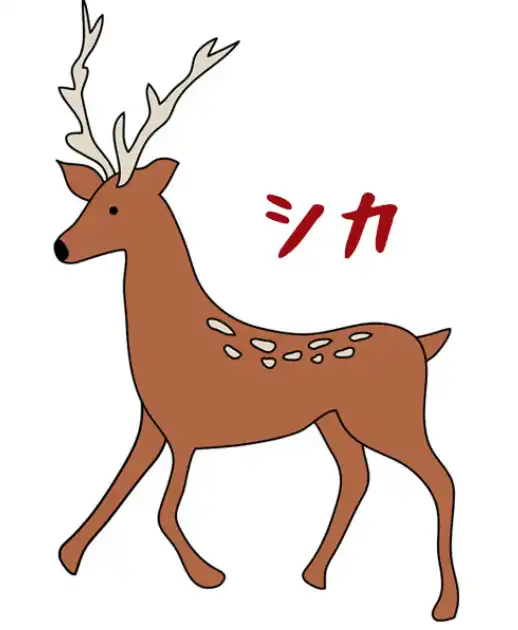
but there’s another “しか” element in Japanese which is a particle and which has a rather unusual effect on the structure of sentences.
So we’re going to look into that effect.
One of my commenters reminded me of a rather charming Japanese word play: “ならならしかしかしかられない”, / 奈良なら鹿しか叱られない (how it might be in Kanji form)
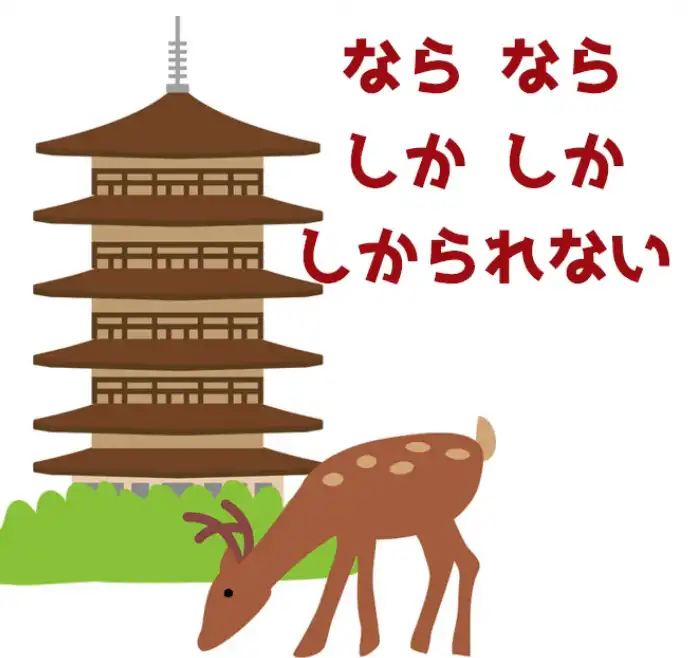
and in natural English we would translate this as “In Nara, only the deer get scolded”.
It’s useful to know here that Nara in the Kansai region is famous for its deer.
People go to Nara to see the deer (and for other things – it’s a lovely historical city).
Strictly, “奈良なら” doesn’t mean “in Nara”.
It means “if it’s Nara” or, more naturally, “in the case of Nara”.
But what does the rest of the structure mean?
This is what my commenter was really asking.
The question was, “What is the A-car of this sentence?
Does it have a zero-A-car somewhere, or does it even have an A-car at all?”
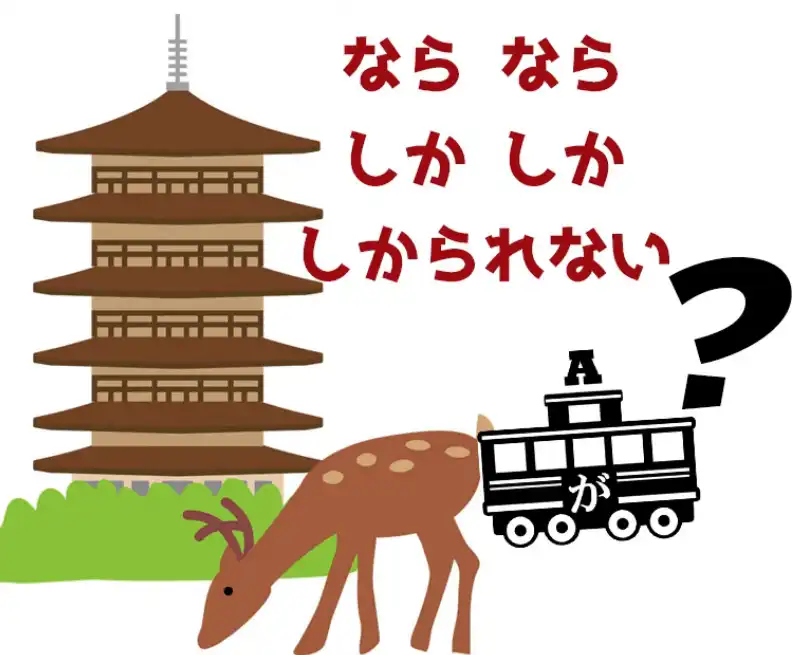
What is the A-car of a sentence like this?
Now, the problem is partly that “しか” has an unusual effect on the sentence structure, but it’s also that the receptive helper is used here which makes it look a bit more complicated than it is.
しか
So let’s start off with a very simple “しか” sentence.
“さくらしかいない。” In natural English we’d translate this as, “There’s nobody here but Sakura.”
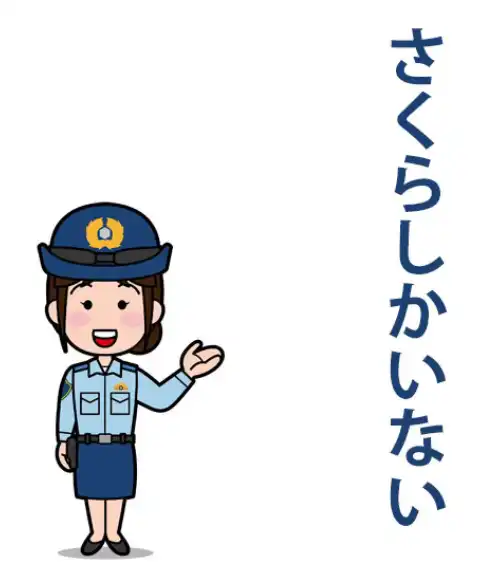
So what’s “しか” doing here?
“しか” does two things in a sentence like this.
It knocks out the が-particle just like “か”, so this isn’t something that we’re not already familiar with.
When you have “か” in a sentence where there would also be a が, we never say “がか” or “かが”.
“か” displaces が, but the が is still logically there.
That’s what “しか” also does.
But the other thing “しか” does is a little bit more unusual.
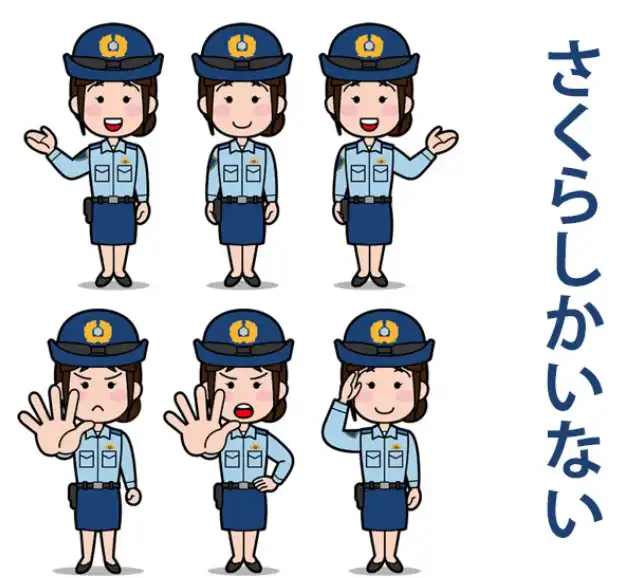
I don’t know if you’ve ever used Photoshop, but in Photoshop you can invert a selection.
What happens is that you select an object,
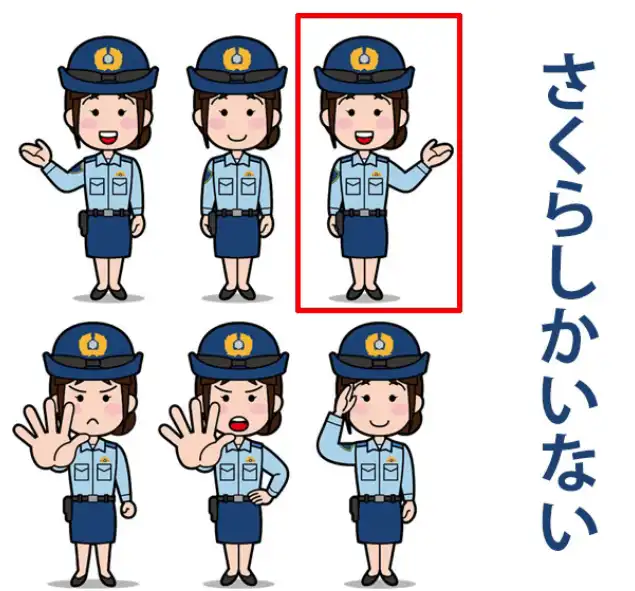
you press the key selection to invert that selection and what happens is that everything outside of that object is selected.
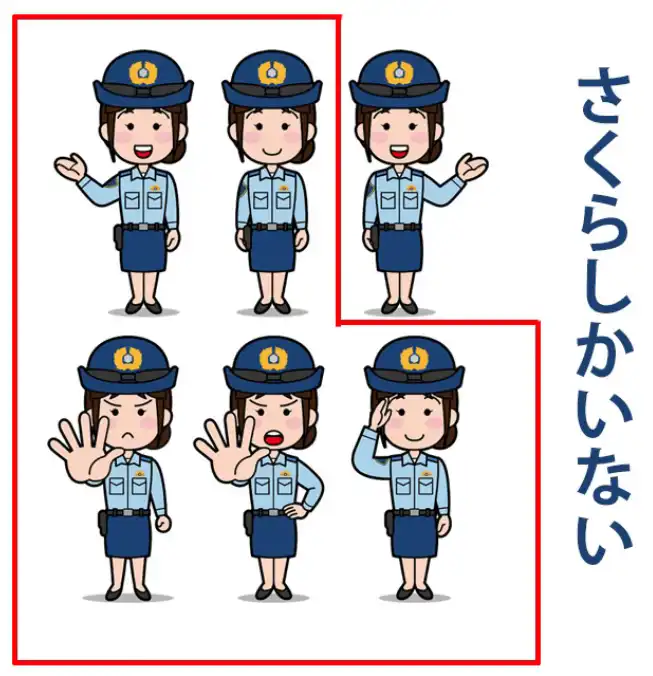
The object is the only thing there now that isn’t selected.
This is exactly what “しか” does.
While が, you might say, selects an object, a noun, and marks it as the A-car, the subject of the sentence, “しか” selects that noun, inverts the selection and marks that as the A-car of the sentence.
So everything other than that selected noun is now the A-car of the sentence.
So, “さくらしかいない” literally means “Everyone other than Sakura is not here”.
In the deer sentence, which looks a little more complicated, it’s exactly the same thing: “奈良なら鹿しか叱られない” (if it’s Nara, everything other than the deer are not scolded).
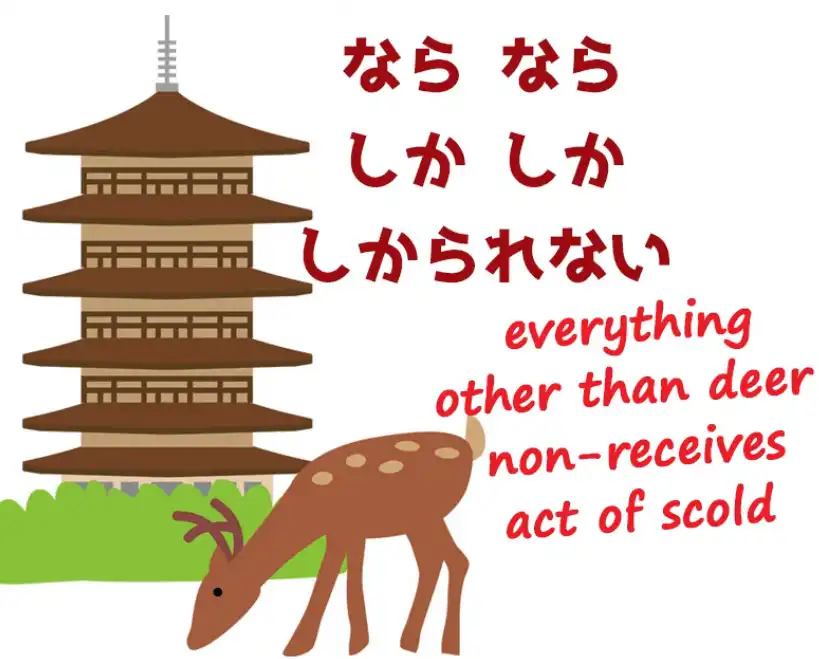
So again, we’re selecting the deer, inverting the selection to everything other than the deer, and then that becomes the A-car of the sentence, which is “not scolded”.
Now, there’s also an implicit relevance clause in this,
so when we say “さくらしかいない”
we don’t mean there’s nothing here but Sakura: no trees, no bushes, no flying saucers.
We mean there’s nobody here but Sakura.

Now, the “いない” partly tells us that, but it isn’t just that, because it also doesn’t mean that there are no bunny rabbits here, there are no birds, there are no capybara (did I pronounce that right?)
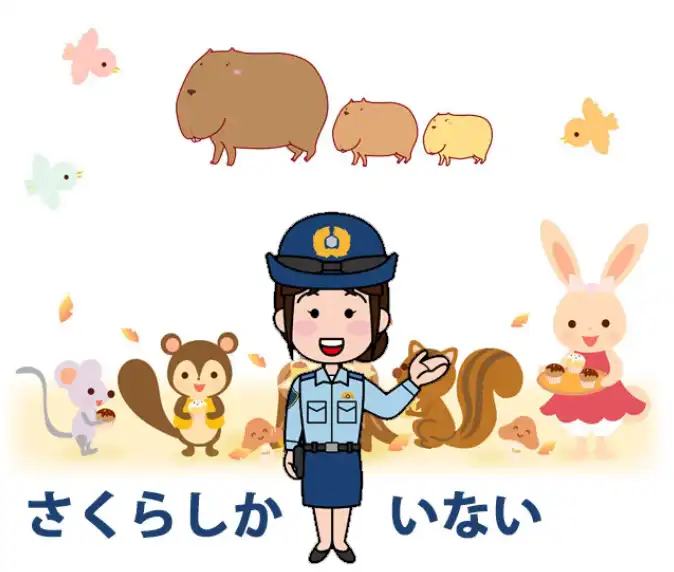
Note: It should simply select the relevance that no other Sakura / no other people are there. — So “しか” inverts the selection, but it’s also what you might call a “smart invert”: it selects for relevance.
しか in sentences with が-marked subject
However, in some “しか” sentences there is actually a が-marked subject, so what’s going on here?
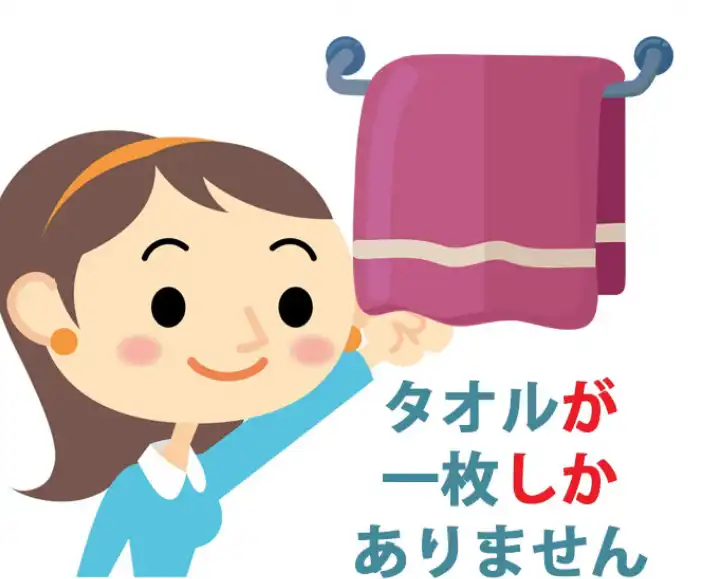
Let’s take a look at one. Suppose we say, “タオルが一枚しかありません”.
Again, in natural English: “There’s only one towel here.” Note: Notice how in Japanese they use ありません after しか here. The が-marked subject is “towel” or “towels”.
In Japanese, of course, there’s no distinction between those two things.
And as I explained in my lesson on counters (Lesson 71), a counter in this kind of sentence is working as an adverb.
It’s telling us more about the engine of the sentence, the verb.
So if we say “泥棒が三人いる”, we’re saying “robbers(=subject) exist three-person-ly”.
If we say “タオルが一枚ある”, we’re saying “towel(=subject) one-flat-thing-ly exists”.
If we say “タオルが二枚ある”, we’re saying “towel(=subject) two-flat-thing-ly exists”.
So when we say “タオルが一枚しかありません”, the subject is “towels”, then we have the counter “一枚” and that is marked by “しか”.
So we’re selecting one flat thing, one towel, and then inverting the selection to all towels.
Not all flat things, because we’ve already marked the subject as “towel”.
So we’re inverting the counter, which is working adverbially, from one towel to every towel but that one towel.
So we’re saying “towels, everything but one, non-exists”.
In natural English, “There’s only one towel”.
“タオルが一枚しかありません” And that’s how what we might call the inverse-selection structure of a “しか” sentence works.
しかない (Colloquial)
And I should just add at the end that there is a use of “しか” that’s more colloquial.
And this is when we say “しかない”.

Now, in an ordinary “しか” sentence obviously we just say “この古い車しかない”, which means in natural English “There’s only this old car.” We’re selecting the car, inverting the selection: “all cars other than this old car non-exist”.
But we can also put that “しかない” at the end of a logical clause or a verb standing in for a logical clause.
Now, this isn’t strictly grammatical, but colloquially it often happens.
So if you hear in an anime somebody saying “逃げるしかない!”, they’re saying “(we) gotta run!” in natural English.
What they’re literally saying is, we take this “逃げる”, we mark it with “しか” so that what we’re selecting is not “逃げる” (run) but everything else other than run.
And again, the relevancy smart selection comes in here.
What we’re really saying is
“every course of action other than running (away) doesn’t exist”.
Well, of course it does exist, this is very colloquial, but as far as we’re concerned it doesn’t exist: there’s nothing for it but to run (away).
In English we might say, “It’s run or nothing”, and again, that’s ungrammatical and for the same reason that the Japanese is ungrammatical, that “run” isn’t a noun.
But, when that thing’s coming after you, who cares about grammar?.
Note: Some useful comments I guess under the video…
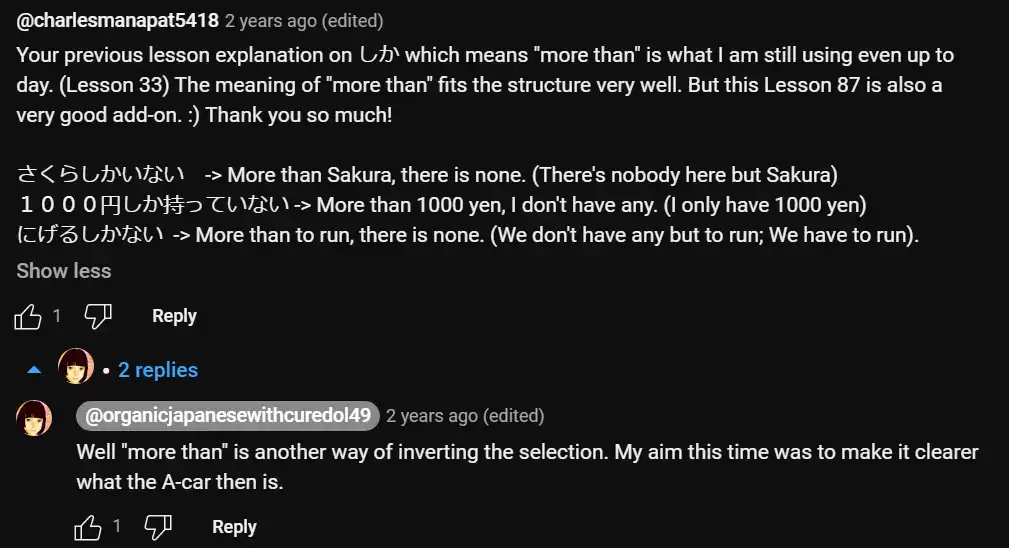
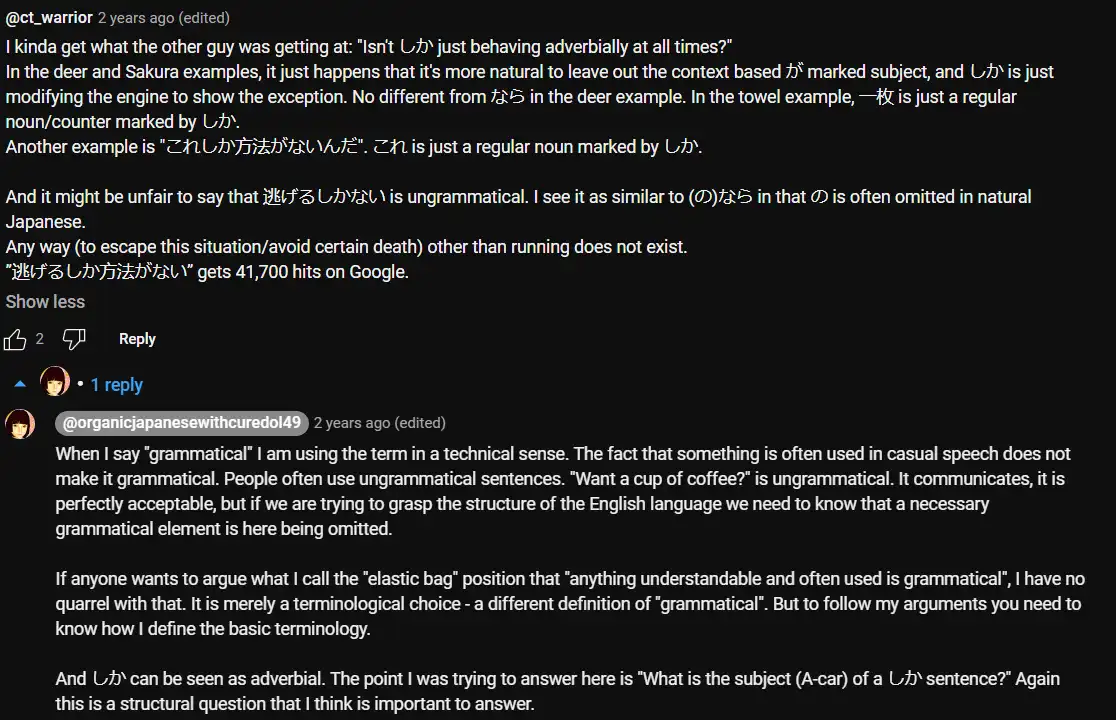
One miscellaneous about くせに (癖に?), for the full lesson, she made this video / Lesson 93
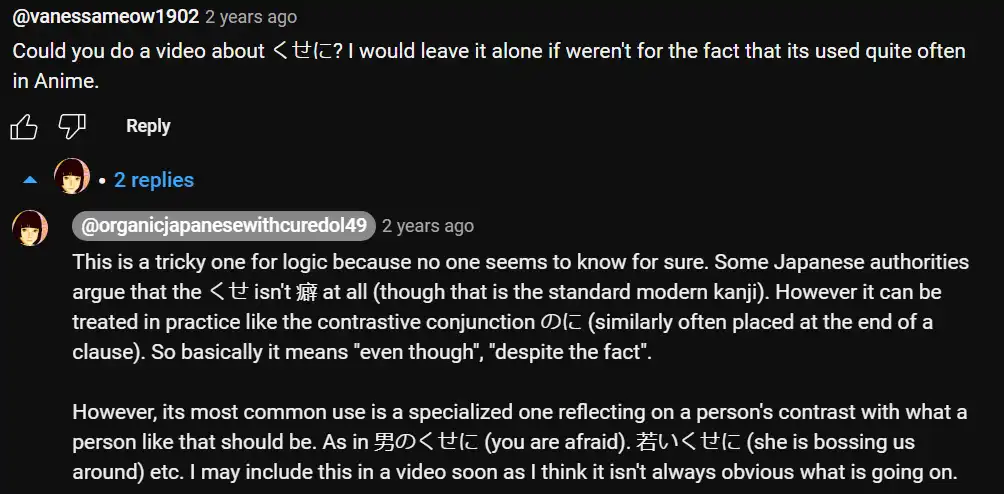
88. Xをしたい vs Xがしたい
The Indestructible Core of Japanese. How the logic never fails. Xをしたい vs Xがしたい - Lesson 88
こんにちは。 Today we’re going to talk about the core fundamental structure of Japanese and a problem that troubles some people about it, which I’ve tried to lay to rest (Lesson 43) but there’s still some difficulty, I think, so I’m going to try to tackle the question, for what I hope will be the last time, today.
And in doing that we’re going to look at a puzzle that’s posed by the title of a very popular work.

It’s been a manga, an anime, a live-action movie: “君の膵臓を食べたい”, which means literally “I want to eat your pancreas”, and we’ll talk about why it literally means that in a minute.
I didn’t actually know what a pancreas was.
I thought it was a railway station in London.
But apparently it’s a component that you find inside the human body and things don’t go so well without it.
I’m not very clear on what you find when you take off the front and back panels of a human body, so we learn something new every day! That’s why this is classified as an educational channel, I suppose.
So, the question that will be raised by this title in the minds of anybody who’s got some grasp of the real structure of Japanese, is:
Why is the particle を used instead of the particle が here?
Why is the particle を, rather than the particle が, used here?
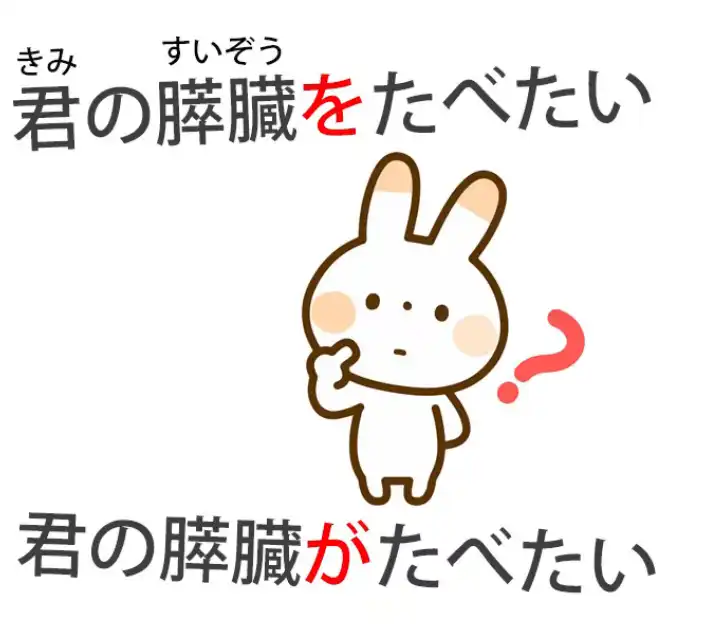
If we want to say what in English would be
“I want to eat that bread” or “I want to eat that cake”, we would say
“パンが食べたい”, “ケーキが食べたい”.
And, as we see, the adjective “たい”,
the adjective of desire “たい”, is pointing not at me but at the cake.
The cake carries the が-particle, so that is what the adjective is describing.
And confusion ensues (Lesson 9) when we actually translate this as literally meaning
“I want to eat cake”, because that’s not what it means.
It means “cake is want-inducing (to me)”. (私は) ケーキが食べたい。
But we also know that this adjective of subjectivity, like other adjectives of subjectivity, like “怖い” (frightening), and also potentials like できる or 食べられる – because potential is also a kind of subjectivity.
It’s something peculiar to the individual, whether they can or can’t do a particular thing.
It’s not inherent in the thing itself.
That would be “可能性”.
We know that all of these generally point at the thing that’s possible, the thing that induces the desire to eat, the thing that’s scary, etc.
But also the polarity can be flipped.
And it’s flipped particularly when there isn’t an actual cause, an actual visible or tangible cause of the subjectivity.
The polarity flipping
So if we say, “お腹が空いた、(zeroが)早く食べたい”, - there seem to be 2 clauses, I guess? we’re saying “Tummy is empty, I want to eat soon”.
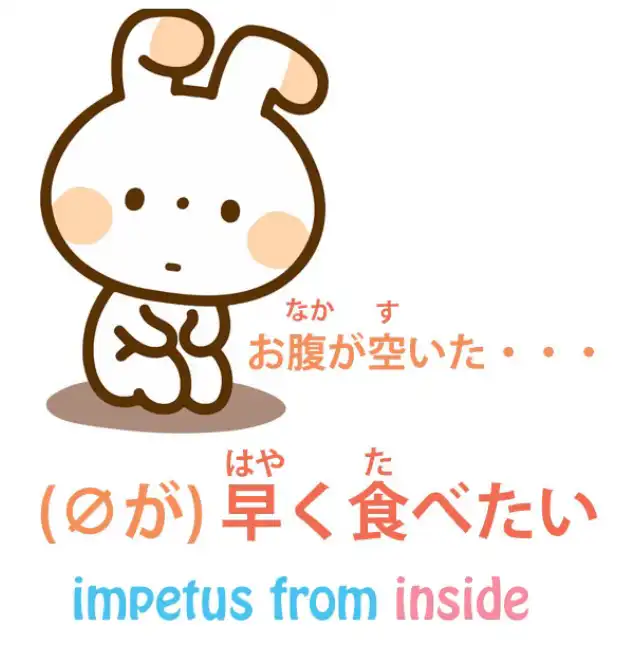
Now that “たい” is pointing at me, not at any particular thing, like cake or anything else.
Now, this is the point that a few people have actually resisted and said,
“Well, can’t we say that it’s not really saying ‘I want to eat’,
it’s saying ‘food in general is making me want to eat’?”
Well, it isn’t actually.
It’s your empty tummy that’s making you want to eat.
And we’re going to look at some constructions today, and the one we’ve just talked about
is one of them, that make it a 100% clear that not only in cases where there isn’t a
cause of the subjectivity, but in some cases where there is,
the adjective of subjectivity can still flip its polarity.
Now, why do people resist this idea?
As a matter of fact, it’s not unknown even in English.
We can say “We were happy that day”, in which case the adjective “happy” is pointing at us (we’re the ones that were happy) or we can say “That was a happy day”, and now the adjective of subjectivity is pointing at the day, which is the cause of our happiness.

We can say “I am suspicious of her behavior” and the adjective “suspicious” is pointing at me (I’m the one who’s suspicious) or “her behavior is suspicious”, and now the adjective “suspicious” is pointing at her behavior as the cause of my subjectivity.
So this isn’t something that doesn’t happen, even in English.
For the reason, I think, that people become so agitated about this and so determined to find quite unlikely ways of wriggling out of it is perfectly understandable.
It’s because they may have spent months or even years in this terribly confusing world where particles just change their meaning depending on which side of bed they got out of that morning.
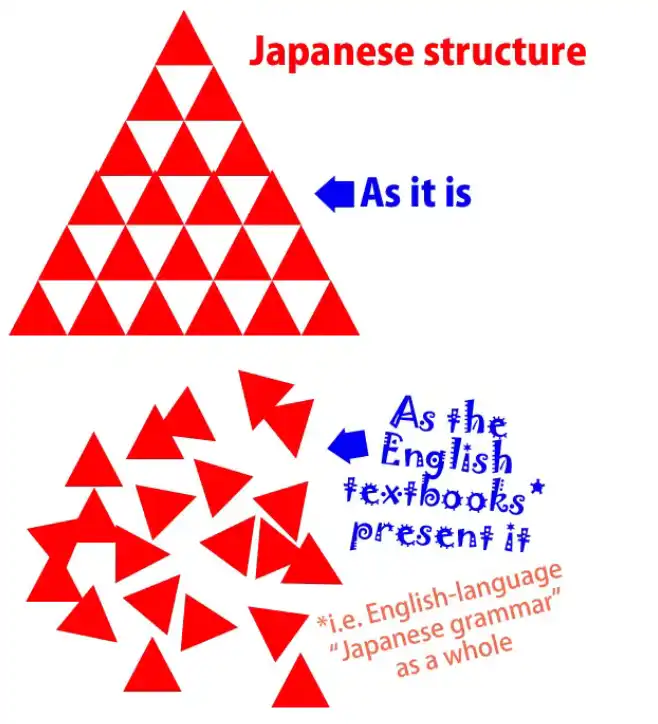
*(Dolly here 👇 is making an example of the confusing “trying to force English into Japanese”)
*So, “が usually marks the subject of a sentence but it can also mark the object of a sentence
as in ‘パンが食べたい’, in which obviously the bread isn’t the subject of the sentence;
it’s me, ‘I want to eat bread’.”
Well, we know that this isn’t the case.
We know that in those cases it’s the bread that’s the subject; it’s the bread that’s making me want to eat.
And if we start saying
“That the polarity can flip, doesn’t that either break the model of Japanese structure
that gets rid of all these ambiguities or introduce new ambiguities
so, ooh there are special rules that sometimes it points this way and sometimes it points
that way”, well, the answer to that is no, it doesn’t matter to the model.
It’s quite irrelevant to the model.
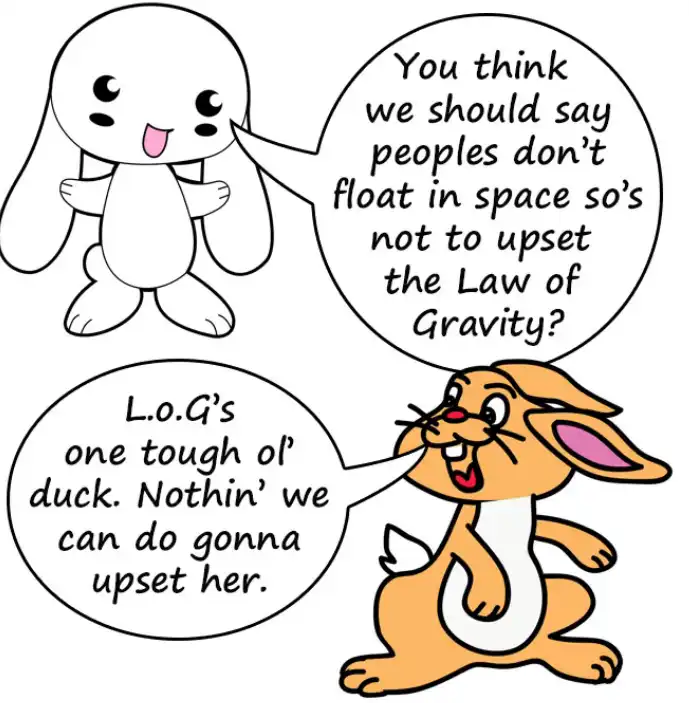
Whether we choose to say “パンが食べたい” (bread is making me want to eat) or “パンを食べたい” (I want to eat bread) doesn’t matter.
The only thing that matters to the model is that the particles are always doing the same thing.
If we say “パンが食べたい”, we’re saying “The bread (=Subject) is making me want to eat”.
vs If we say “(zeroが)パンを食べたい”, we’re saying that “(I) want to eat bread” (=Direct Object). Note: Here, zeroが is the implied/hidden “I” Subject, while パンを is the Direct Object = bread.
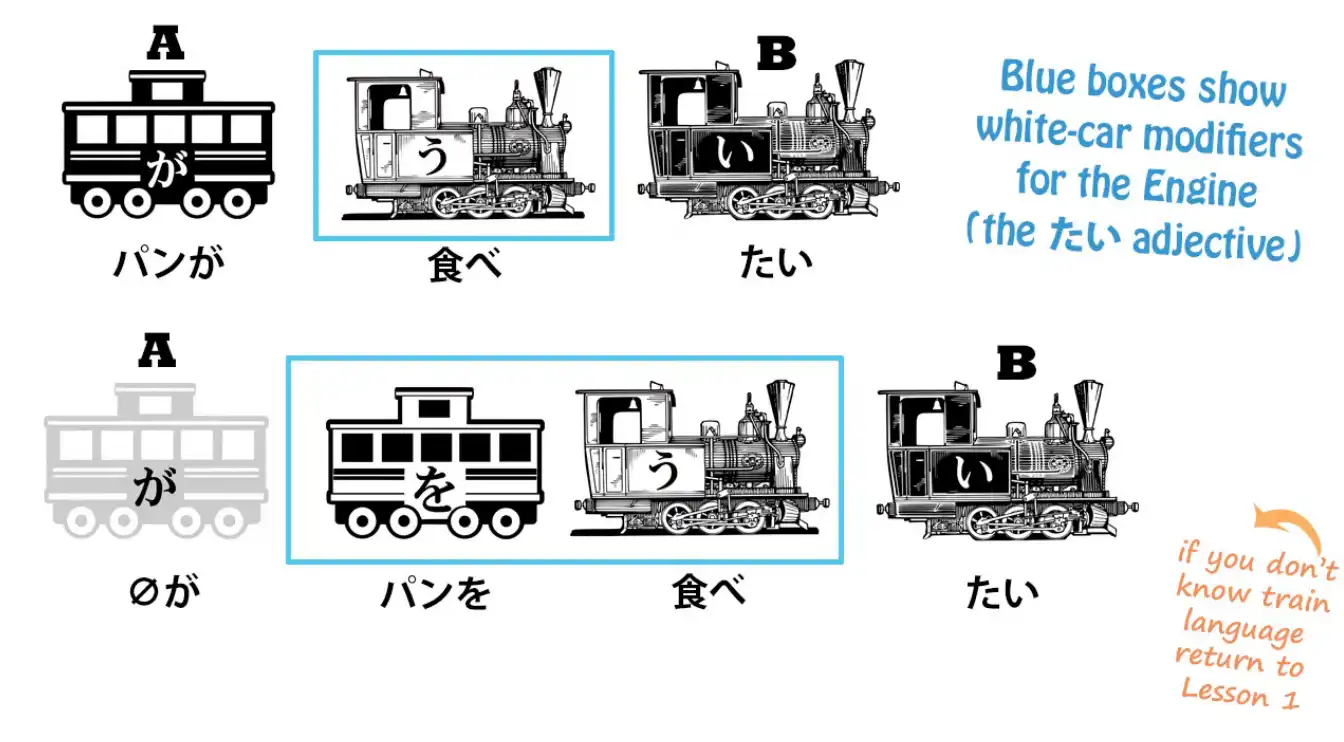
And the model doesn’t care which way we say it.
The model is doing the same thing either way.
All the particles are doing exactly the same thing.
How to justify the model grammatically?
Now, can we justify this grammatically?
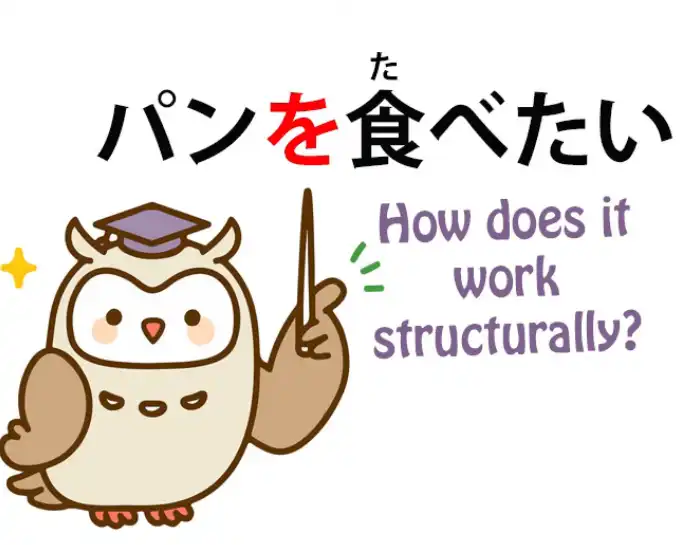
So if we say, for example, “パンを食べたい”, surely the problem here is that
with “たい” we have an adjective, so we have an adjectival sentence,
and an adjective, as we know, can’t take a direct object.
So how can we say “パンを食べたい”?
And the answer to this is really very simple.
Japanese, as we know, is very adept at gluing verbal elements together to make them into one element or taking them apart at will.

And what’s going on in a sentence like “パンを食べたい” is that
“たい” is no longer being attached simply to the verb “食べる”.
—
We’re not saying “パンを” and then “食べたい”,
we’re saying “パンを食べ…” and “たい” is being attached to that entire unit.
What we want is the action “パンを食べる”, so we can attach the “たい” to that entire unit.
That’s what makes sense of these constructions.
And while “パンを食べたい” is a less common way of putting it, and in general
“何々を食べたい” is the less common way of putting it,
there are some kinds of sentence in which it is the one that we always use.
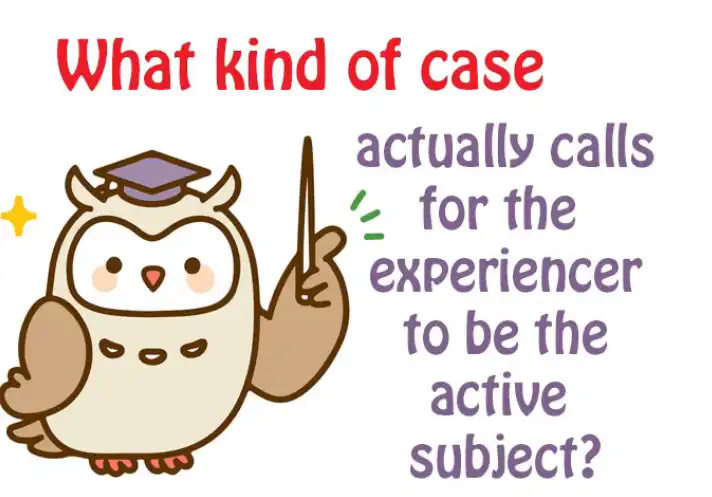
For example, “助けたい” (want to help) or “守りたい” (want to defend).
We don’t say “さくらが守りたい”, we say “さくらを守りたい”.
And if we’re talking about “正義” (justice) or “平和” (peace) or even “国” (country), it’s the same.

We don’t say Sakura is making me want to defend her, we don’t say the country is making me want to defend it, we don’t say justice is making me want to defend it, or peace is making me want to defend it.
We always say “I want to defend Sakura”, “I want to defend justice”,
“I want to defend peace”, “I want to defend the country”.
(all as Direct Objects instead of Subjects as shown above since they are used with を particle)
Why is that?
Well, essentially I think the reason is that we are not talking about an impulse desire.
If we look at bread and we want to eat it, “Ah, パンが食べたい” (bread’s making me want to eat it).
But we’re talking here about things that are more abstract, things that are less impulsive.
And in the case of people, it’s more respectful to say “さくらを守りたい” than “さくらが守りたい”, because we’re not saying that Sakura is an object (implication-wise, grammar-wise she is:D) that makes me want to defend her, like a piece of bread that we might want to eat, we’re saying that the action of defending her is something I want to do, which is more dignified in the case of a person.
But in the case of, say, the country, or peace, or justice, or even a house or a park, we’re talking about something less impulsive and more a decision of our own, if not a conscious decision, then a mindset, a way of thinking that is ours.
So we talk about that action as our own rather than something induced by the external cause.
If we do say “パンを食べたい”, this is likely to be in conditions where we’re talking a little bit more generally, we’re not talking about that particular lovely smell of bread by which the bread is making us want to eat it.
We’re not talking about some candy we’ve just seen that’s making us want to eat it.
We’re talking about the general desire to eat bread.
So we’re more likely to say “パンを食べたい時” (when I want to eat bread=Direct Object) Note: In the sentence above, “I” should be the Subject, which is hidden in Japanese as zeroが. than “パンが食べたい時” (when bread=Subject makes me want to eat it).
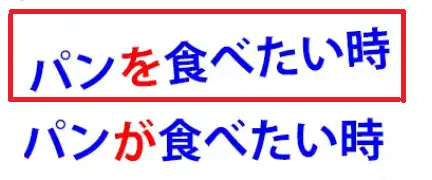
And this isn’t a firm and definite rule but this is the kind of tendency, the kind of reason, the nuance, which decides which way we’re likely to flip that adjective of desire, in this case, “たい”.
So why is を used in 君の膵臓を食べたい?
So if we come back to “君の膵臓を食べたい”, why is を being used here?

Well, essentially because again this is not an impulse to eat.
We’re not looking at the girl’s pancreas and thinking how delicious it is.
That would be rather hard to do anyway.
Something subtler, something more abstract, something deeper, is being talked about here, the desire for some emotional and quite complex reason to eat somebody’s pancreas.
So I hope this time we really laid to rest the final question of polarity switching (of Lesson 43).
It does not threaten the model. And it does happen.
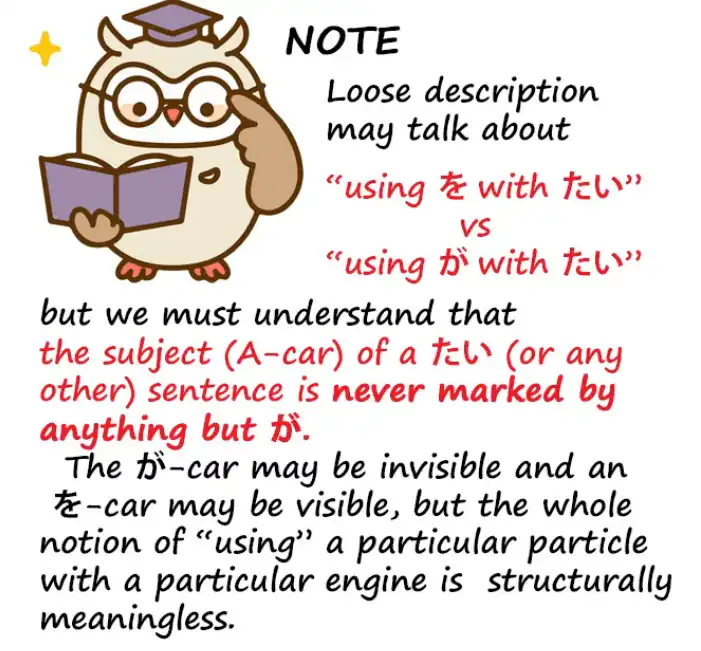
And it happens for reasons which are a little subtle, that will probably take time to ingest and immersion to ingest, because you can’t learn everything through raw structure.
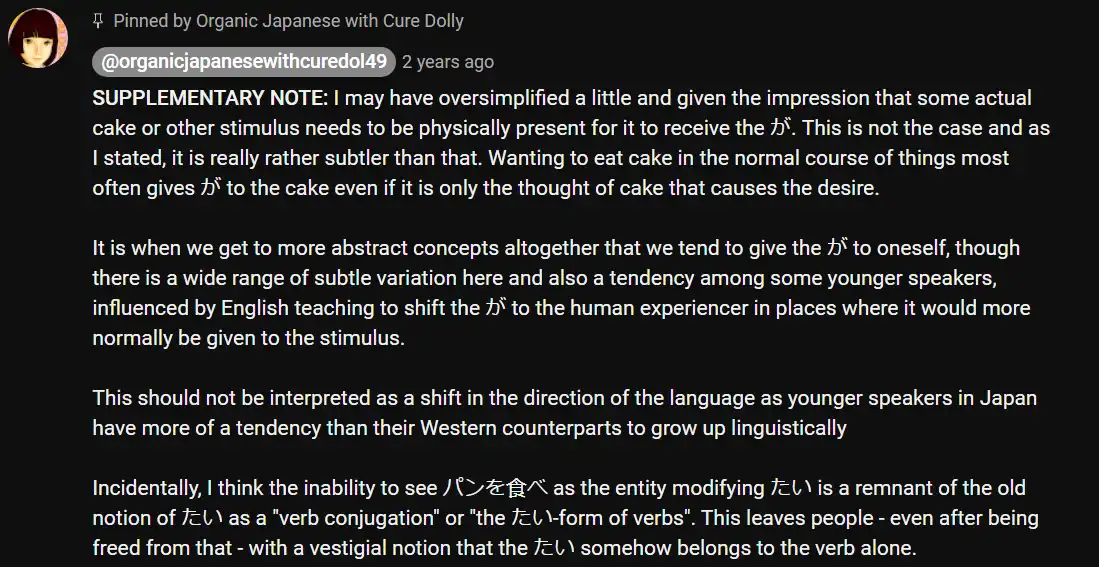

Note: Read THIS COMMENT TREE where Dolly gives some useful info about が use.
It also slightly touches over the cases where there are 2 visible logical particles like が or を in a single clause, since it can happen at times such as with a compound Adjective like 頭がいい.
Also, this one can be useful if the たい stuff used with を is a bit confusing, same for ない.
Hopefully it can be read/understood well enough & is not too bloated, but there was so much important stuff mentioned here that I had no other choice, really, to the point I even had to resort to bolding at times to make it clearer. Definitely recommend reading through the comments.
89. De-mystifying Japanese. The Universal Subject
De-mystifying Japanese. Let the world’s most logical language shine! The Universal Subject Lesson 89
こんにちは。 Today we’re going to talk about something that is the very basis of Japanese and that we’ve talked about right from the very first lesson.
And that is, the grammatical subject, what we call, in train language, the “A-car”.
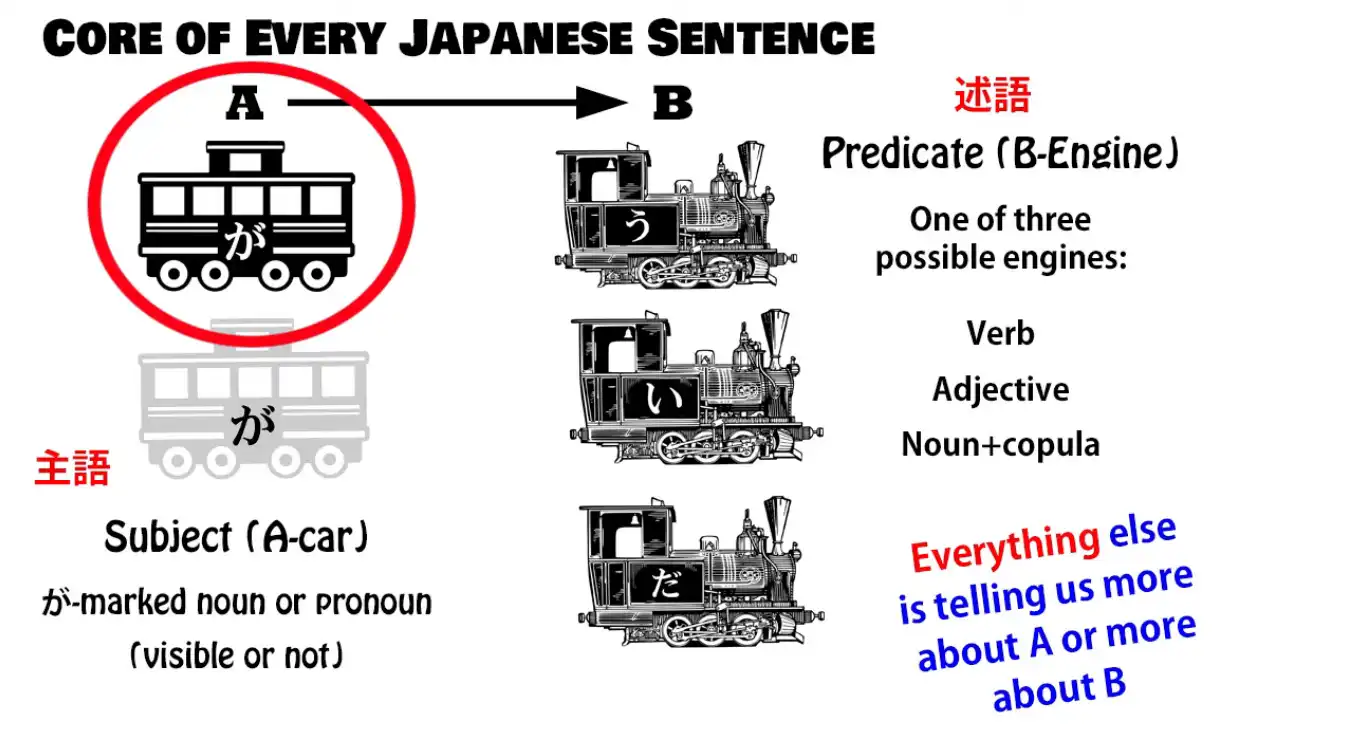
And as we know, every Japanese sentence has to have
an A-car, a subject, a “主語” in Japanese, and
a B-engine – that’s the predicate, or the “述語” in Japanese.
In other words, every sentence is saying something about something.
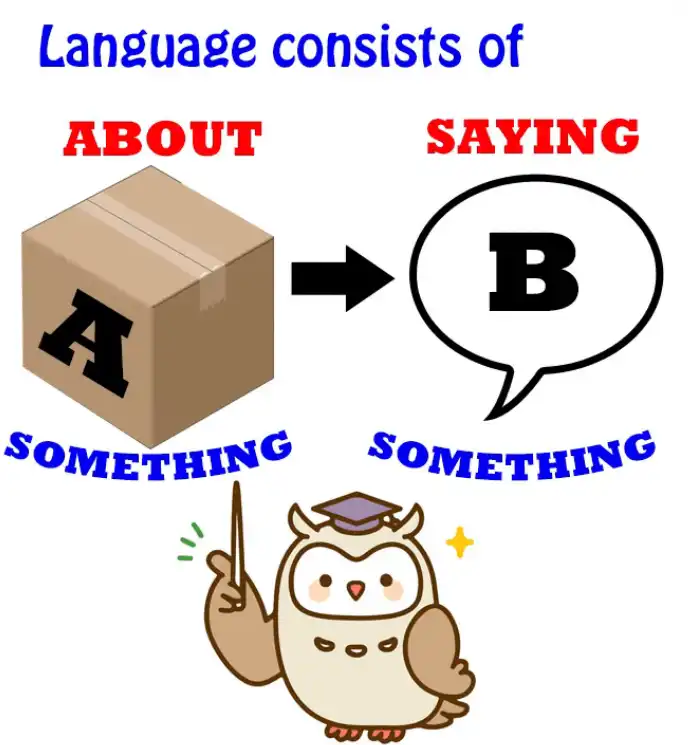
Now, some people argue that there’s no subject in Japanese; some teachers do this, including Tae Kim-sensei, and

generally this is because they don’t have a very good grip on how the language actually works.
Some Japanese people, a minority of linguists, also propose a no-subject model for Japanese.
Note: Again, this is simply due to the difference in models, just like how Dolly proposes there is no conjugation or passive. Usually, in terms of NATIVE-derived Japanese grammar linguistics, if something is called as x, it is linguistically viable to use it for description of the language, but some models have their own systems that either agree with them or not, for various reasons.
Just like Dolly says below, these models are there to just describe the language in some coherent chunk while finding some common ground, but they may differ in some instances.
It is up to you which model you will use, eventually you should achieve fluency either way once you don’t need explanations and terminologies anymore and you have the language automatised, but it helps studying the general consensus in most (esp. native) linguistic models.

As I’ve said before, grammar, structure, models, whatever you want to call them, are not the source code of language. They are means of describing language after the event.
So it may be possible to devise a model for Japanese that doesn’t use the idea of the subject, but really this is just going to be shuffling terminology around.
I had a Japanese person rather angrily coming into my Comments and saying that I’m Westernizing Japanese by bringing in the concept of the subject.
Now, I think if you know my work, you know that I don’t Westernize Japanese.
I teach Japanese as Japanese.
Whether non-subject models are really valid or not, I don’t know. I haven’t looked into them.
But what we do need to show is that the subject model that we use and that most Japanese linguists use works and works all the time, completely, reliably and predictably.
The “Null-Subject”
Some languages are termed “null-subject languages” in linguistics, which doesn’t
really mean they haven’t got subjects, it means that their subjects aren’t always visible,
which is exactly what we have in Japanese.
Note: This invisible Subject thing is much easier to grasp in Japanese if your native language has it too like that (obviously). Which is why English natives tend to (obviously) struggle with it due to how English mostly needs directly voiced/visible Subject & why there are those confusing explanations that try to force the English “Subject must be voiced/visible”-way onto Japanese.
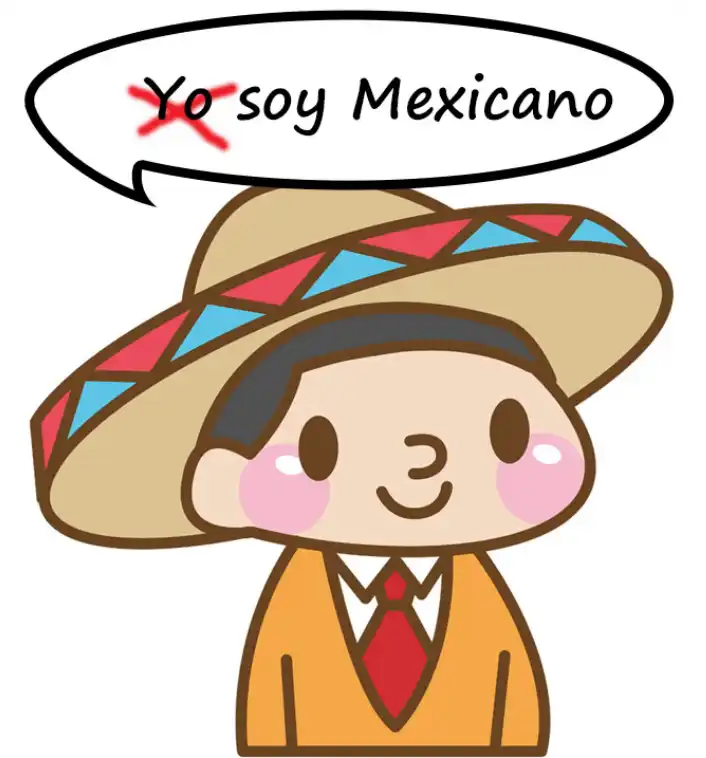
In Spanish, for example, we don’t generally say, “Yo soy Americana”, although we’re taught to do that by the textbooks. And the reason we don’t is that “yo” is redundant.
“Soy” implies “I”, so if we just say “Soy Americana”, that’s all we need to say.
Everything else is redundant. The same is true in English.
If we say “I am American”, we actually don’t need the “I”, because “am” implies “I”.
We don’t use “am” with anything other than “I”, so the “I” is redundant.
It’s just that English doesn’t permit you to drop it. So it’s just a matter of rules.
Japanese doesn’t work this way, because Japanese doesn’t have conjugations like “am / is / are”. In fact, it doesn’t have any conjugations at all, despite what the textbooks say.
In Japanese the null subject is determined entirely from context.
And when context doesn’t make it clear, it generally defaults to “I”.
This is almost exactly what English “it” does, except that “it” in English isn’t zeroed.

So if I say “It fell from the sky / It ate my breakfast / It’s half the size of the other one”,
you have no idea what “it” is unless context supplies the answer.
This is how the zero-pronoun works in Japanese.
The fact that we can see and hear “it” and we can’t see or hear the zero-pronoun makes no difference to all of this.
So if we take the kind of sentence that people try to call “subjectless”, let’s take a sentence like “(zeroが)疲れた”.
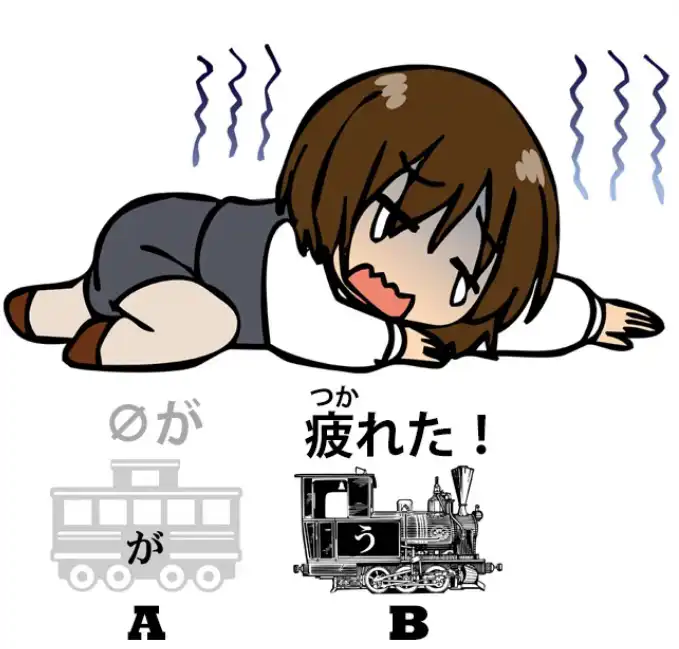
Now, literally this just means “Tired”, so it could be called a subjectless sentence,
but it absolutely isn’t – unless you want to avoid the term “subject” for reasons of your own.
When we say “疲れた”, we’re not saying that the rabbit in the moon is tired.
We’re not saying that Mickey Mouse is tired.
We’re not saying that tiredness settles like a purple haze over the known universe.
We are saying “I am tired”. If that wasn’t the case, Japanese wouldn’t be a language, because we couldn’t do the basic thing that a language needs to do, which is to make Statement B about Thing A.
If I look at a girl and say “(zeroが)綺麗なのね?”

again, I am not saying that the rabbit in the moon is pretty or that life in general is pretty.
I have a very clear subject known to both myself and the hearer.
Indeterminate Subject
Now, there are cases where we have an indeterminate subject, and some people might try to argue that these at least are our mystical subjectless Japanese sentences.
But actually they’re no different from their English equivalents.
So we might say “(zeroが)晴れそうだ”, which means “(it) looks like being fine”.
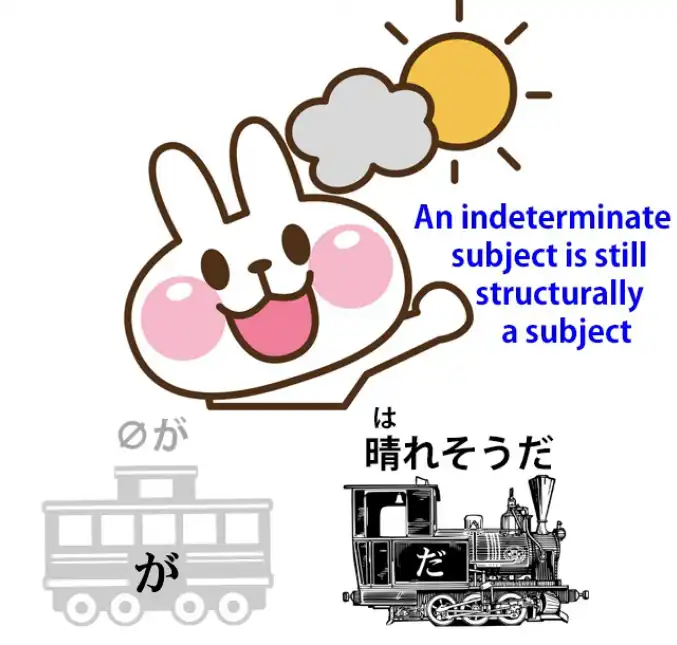
And you can ask “What looks like being fine? The weather, the day, this part of the world?” There isn’t an exact answer.
And of course this is the same in English and Japanese. The subject is indeterminate.
In English we know there’s a subject because its place is held by “it”.
What about Japanese?
Are we just shoehorning a subject in? No, we aren’t. Notice “だ”, the copula “だ”.
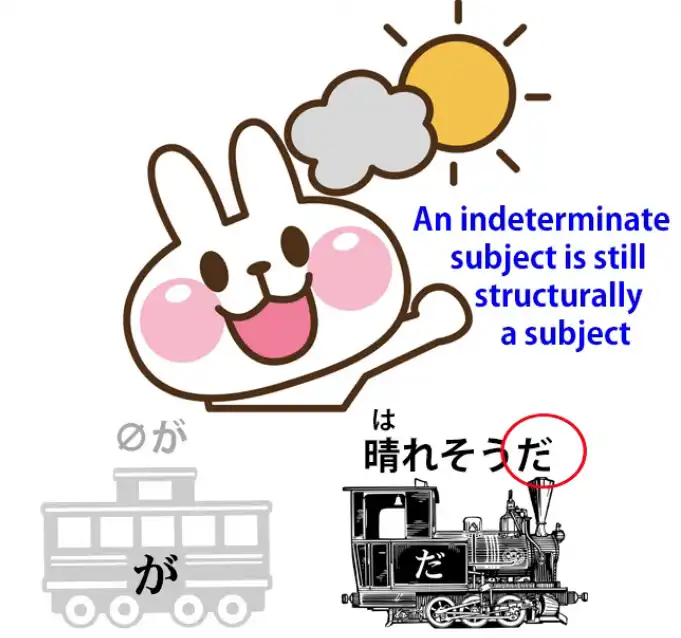
We all know what “だ” is (Lesson 79) (& if you don’t, I’ll link a video so that you can follow it up). *
*—
The copula tells us that one thing is another thing.
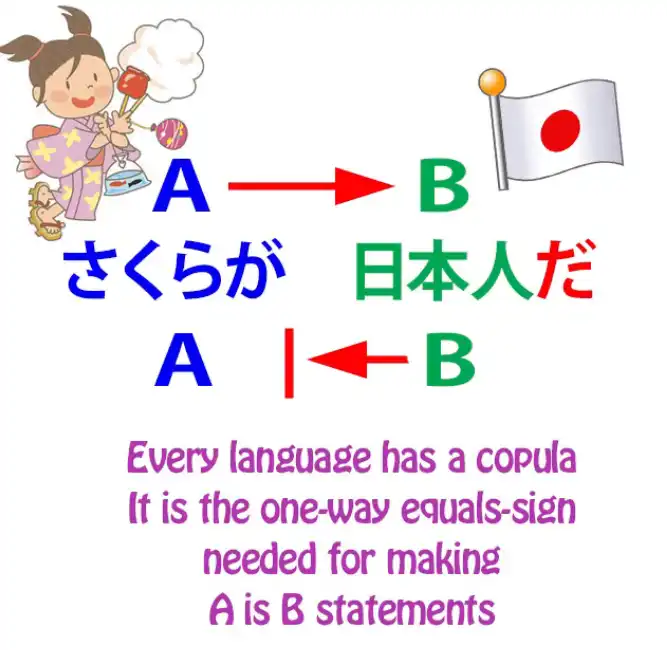
If we say “Roses are flowers / Mary is an artist / Today is Saturday”
we’re joining one thing (the subject) to another thing (the predicate),
or the A-car to the B-engine.
This is what “だ” does and it’s all that it does.
So we know that this sentence has a zero-subject even though it isn’t place-marked by “it”.
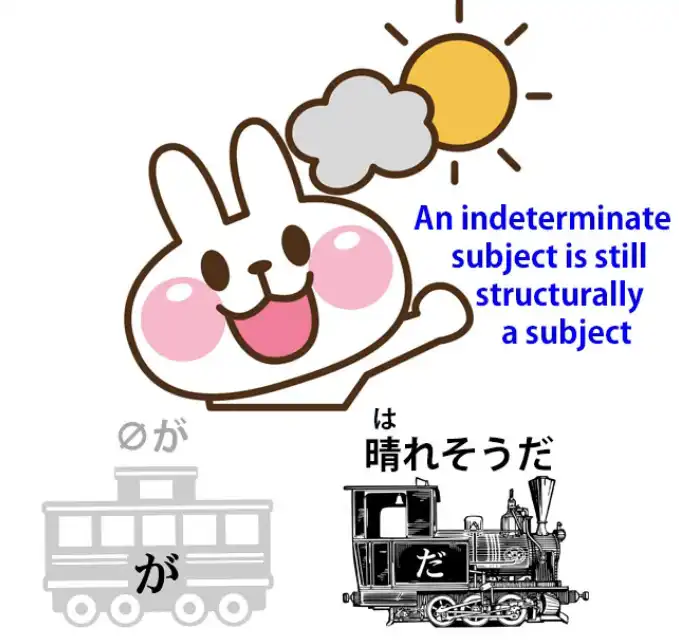
We can’t see it, we can’t hear it, but we know for a fact that it’s there, because without it “だ” makes no sense at all.
Really Subjectless sentences in Japanese
Now, there is actually one kind of sentence in Japanese that really is subjectless.
You can find it in English too, but it’s a little more common in Japanese – but not all that common.
And it’s a sentence like “大阪にたどり着いた桜たち” or “恥ずかしくなったハナコ”.
Note: I put the name Hanako into Katakana in the second example sentence.
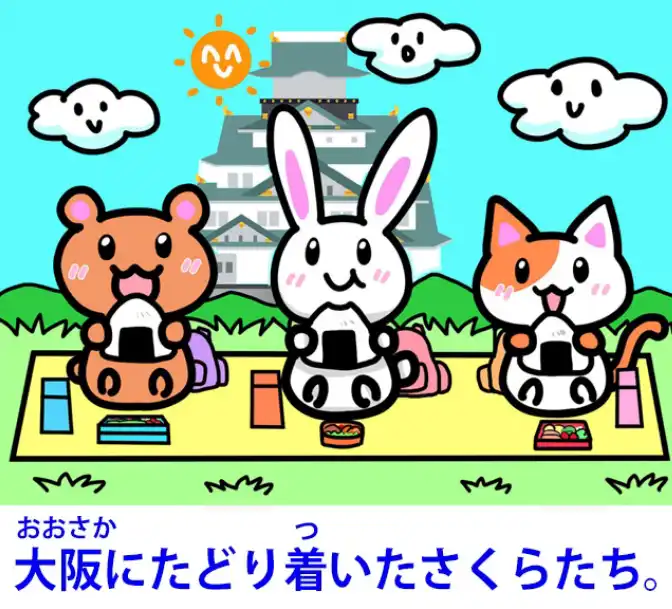
These are not in fact sentences, and they wouldn’t be seen as sentences by most linguists in Japanese. What they are is simple modified nouns. So we’re saying “Arrived-at-Osaka Sakura and friends”. We’re not saying “Sakura and friends arrived at Osaka”.
We’re simply saying “Sakura and friends” and modifying them with the modifier “arrived-at-Osaka”.
“恥ずかしくなったハナコ” – We’re not saying “Hanako became embarrassed”, we’re saying “Embarrassed Hanako”. Note: Or I guess “Hanako, who became embarrassed…”

Note: Sorry for the bad zoom, got “Youtubed” again. This kind of modifying can be basically translated into English as sort-of a relative clause. The link by Dolly references Lesson 46. When do we use “sentences” like this?
Well, not very often, but they can get used in narrative, because what they’re essentially doing is either summing up something that went before – you particularly often see this in, say, games where when you load up they give you a quick resume of what’s already happened – or where you’re describing the result of something that’s happened: “And the result was, an embarrassed Hanako”.
This really is, I think, the only example we can find of what might be called a subjectless sentence, but it’s not really a subjectless sentence because it’s not a sentence.
It’s simply a noun with a bit of modification.
So if you encounter these, and you will encounter these from time to time if you’re doing immersion, you haven’t found a subjectless sentence,
you have found a particular narrative technique
that occasionally gets used in Japanese.
It certainly doesn’t add any strength to the arguments of people who say that there’s no subject in Japanese, because these are a very small minority of so-called sentences and they certainly don’t influence the fact that a real sentence that’s telling us something about something always has an A-car and a B-engine, a subject and a predicate.
If you have any questions or comments, please put them in the Comments below and I will answer as usual. I’d like to thank my Gold Kokeshi patrons, who make these videos possible, and all my patrons and supporters on Patreon and everywhere.
Thank you all for making this possible and for helping us to dispel the myths and confusion and the general fog that surrounds Japanese.
I think there’s a feeling in the West that Japanese is somehow a foggy language that doesn’t work like other languages, and there are one or two Japanese people who, perhaps for nationalistic reasons, for wanting to stress the uniqueness of Japanese, play up to this idea.
Well, that doesn’t really matter because their audience is fundamentally Japanese people whose Japanese isn’t going to be ruined by a strange model of the language.
Yours, on the other hand, is best kept on the strait and narrow of straightforward subject-predicate analysis. Thank you for watching this lesson… Note: This is interesting, if hard to read, see it here. Recommend reading through all comments.
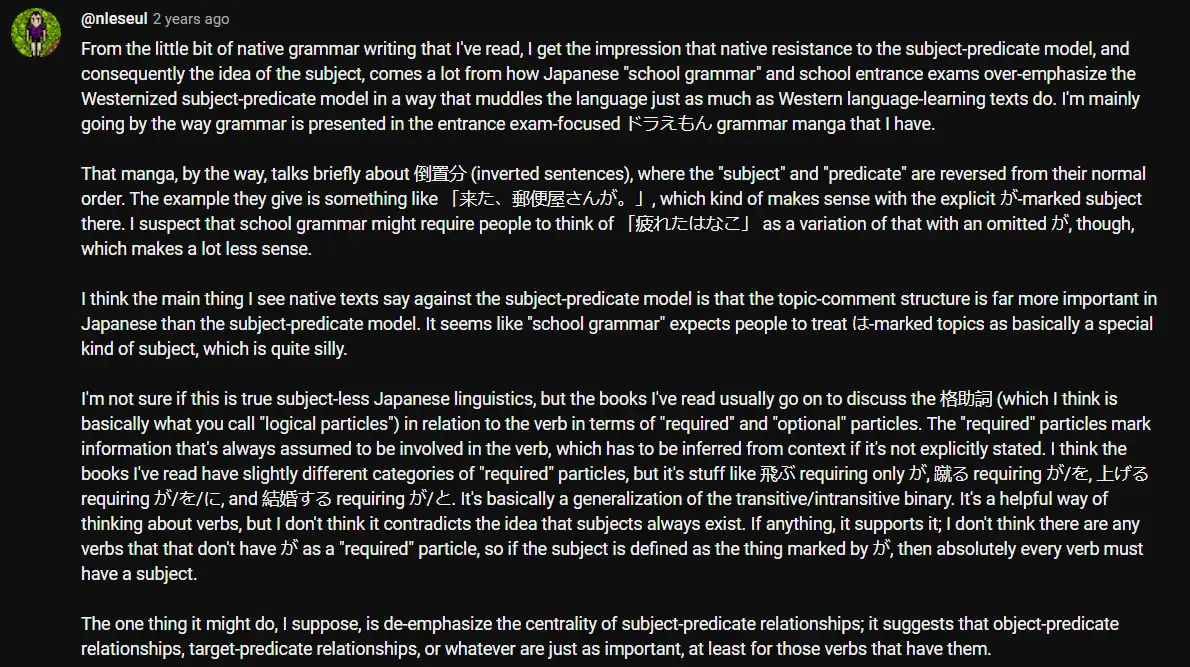
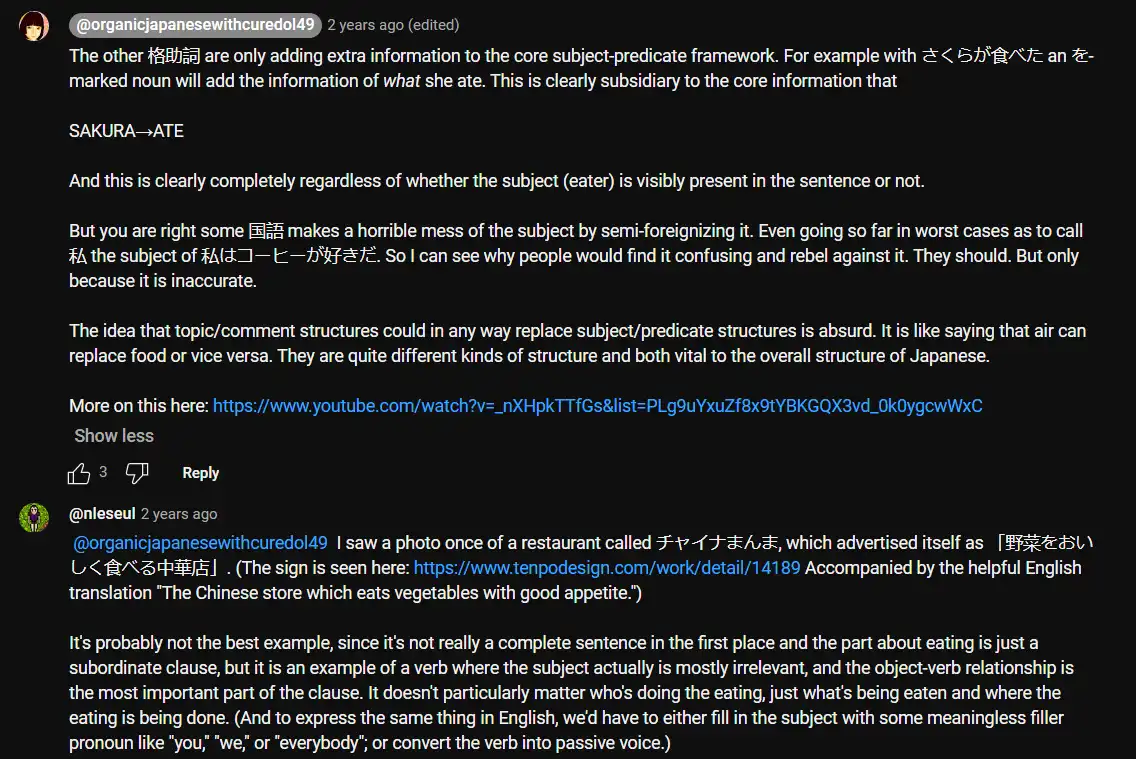
90. Japanese Punctuation: How it works.
Japanese Punctuation: How it REALLY works. Lesson 90
こんにちは。 Today we’re going to talk about Japanese punctuation.
Now, the first thing we need to know about about Japanese punctuation is that most of it is a relatively late arrival in Japanese.
Most of it came in during the Meiji era, about a hundred and fifty years ago.

This was when Japan was modernizing, and a lot of the reason it came in was to help in translating Western literature.
Now, what this means is that in most cases Japanese punctuation doesn’t have such fixed and structural meanings as the equivalent punctuation does in English and other European languages.
So, we need to know what the punctuation is doing and also what it isn’t doing.
The full stop / 。
So, the first mark we’re going to look at is the Japanese full stop or “まる / 。”, which looks like a little circle at the foot of a “letter”.
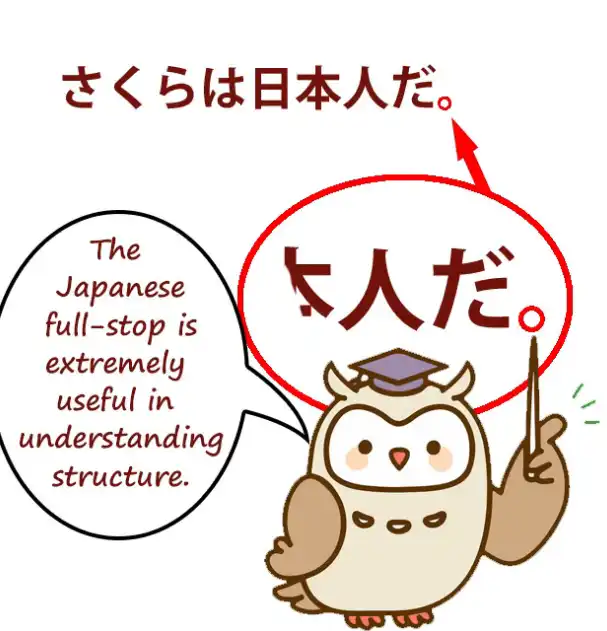
And this is really the exception to the rule, because it really is structurally clear.
What it does is end a sentence.
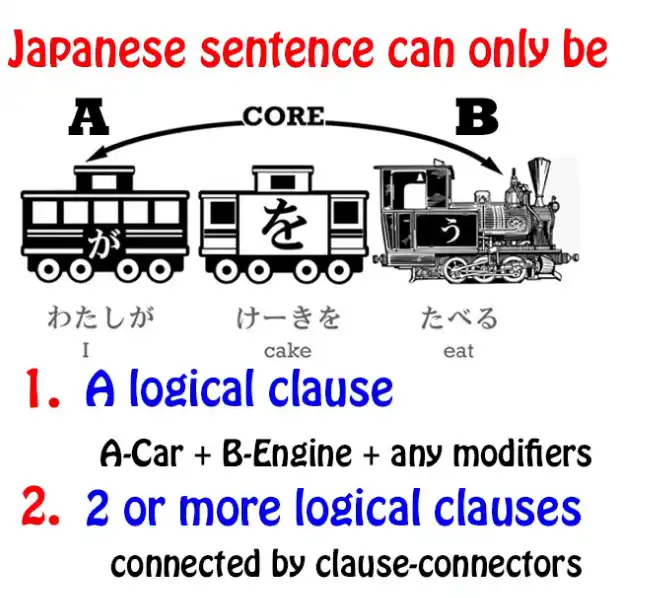
And this is very important for us in understanding how complex Japanese sentences are structured.
Why is that? Well, Japanese is a very modification-heavy language.
That’s to say, a lot of what other languages do by other strategies, Japanese does by modification, that’s to say, using clauses to modify nouns or other elements of a sentence.
Most of the heavy lifting in Japanese structure that’s not done by logical particles is done by this modification structure.
So whole logical clauses can be used not as logical clauses but in order to modify a noun or some other element.
So, let’s take a look at how this works.
“市場で買って川に落としちゃったお菓子。” And this means “The candy that I bought at the market and done dropped in the river”.
Note: I guess, done in the translation is used to point out the more literal translation of ちゃった.

Now, the problem with this when we’re reading a complex sentence is that we can get confused about whether something is a logical clause or not.
So, are we saying here that I bought something at the market? No, we’re not saying that.
Are we saying that I dropped something in the river?
No, that’s not what we’re saying in this sentence.
Both of those things are just modifying “お菓子”.
They’re telling us what kind of an “お菓子” it was: the one I bought at the market and done dropped in the river.
So all we have here is a single noun, “お菓子”, that’s been heavily modified by logical clauses that aren’t working as complete logical clauses.
We can then add a logical particle to that “お菓子” and make it into a whole logical clause.
So, we might say, “市場で買って川に落としちゃったお菓子が魚さんに食べられた。” The candy(=subject) (I) bought at the market and done dropped in the river got eaten by a fish.
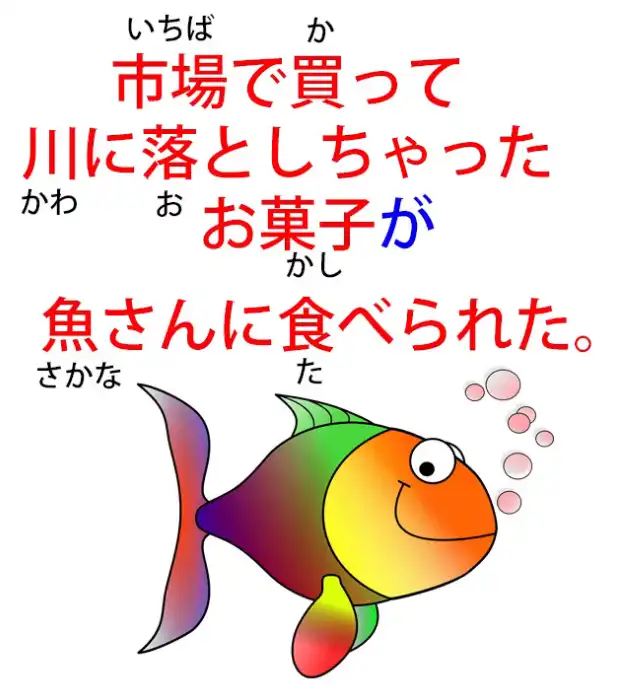
Note: If I understand correctly, because we marked お菓子 with が subject, we can now build another clause out of it, hence we get another logical clause of “お菓子が魚さんに食べられた”. While お菓子 is also modified by modifier clauses before it, specifically ”市場で買って川に落としちゃった”, they serve here as simply a modifier that describes お菓子 rather than being complete (standalone?) logical clauses. Although just my guess from how I understand it. But how do we ensure when we’re reading a sentence like this whether we’re looking at a logical clause or whether we’re looking at a modifier?
How to know if it is a logical clause or a modifier?
Now, the important thing to understand here is that in any kind of Japanese writing
(except perhaps on Twitter or something)
a logical clause has to end in one of two ways,
either with a “まる / 。”, which tells us that it’s the end of the complete sentence –
(it may have a couple of sentence ender particles after it, but it’s a very strict rule of Japanese
that what ends any logical clause is the B-engine, aside from any sentence-ender particles) –
—
or it has to end in a clause connector that completes the clause and leads into the next clause.
This may be the て-form, it may be a word like “から” or “けれど”, but armed with that information we can then see what’s going on.
So, let’s look at “市場で買って川に落としちゃった”.
That’s a complete pair of logical clauses.
Note: My guess here is that it is theoretically composed of two logical clauses if, like Dolly says below, we presume there is some hidden subject and a hidden direct object if we took both verbs as marking their individual logical clauses - 市場で(私がお菓子を)買った and (私がお菓子を)川に落としちゃった that are then connected using the て-form. Here, お菓子 should be a direct object hence why を, since 落とす and 買う are other-move verbs & require a Subject acting on a Direct Object. Obviously, topic marker can be there too, as 私は in the beginning.
But instead, these clauses are combined and since they are followed by a noun serve instead as a modifier for that noun, so therefore they are not logical clauses anymore and do not contain the hidden elements, where instead they are one single big modifier for a noun that is following them, in this case お菓子. It is a shame I cannot ask Dolly about this, as I feel it would help a ton
However, I am aware my guess might very likely be wrong, so please take it with a lot of salt.
It’s not telling us what it was that we bought in the market and dropped in the river,
but it could perhaps be presuming that.
But we know that it’s not in fact a logical clause because it doesn’t end in a clause connector and it doesn’t end with a “まる / 。”.
It goes straight into a noun.
And this is how we can tell the difference between a modifier and a logical clause.
And we know when the entire sequence, the entire sentence, is over because it’s going to have that “まる / 。”.
And I’ve done a video about this method of analyzing Japanese sentences and I’ll link that so that you can follow it up afterwards (Lesson 34).
But the “まる / 。” here is vital.
The comma / 、
Now, the next one we’re going to look at is the Japanese comma, which looks like a little diagonal line at the foot of a letter.
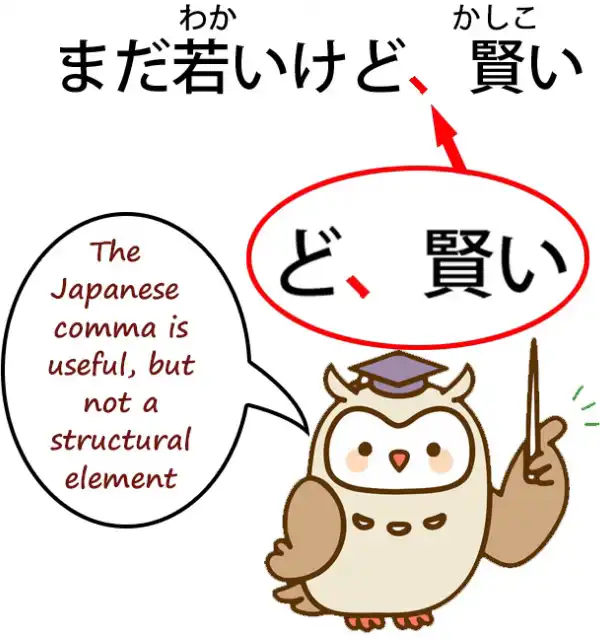
And that’s kind of the opposite of a “まる / 。”, because it really is not a logical element in the sentence.
It was adopted into Japanese, but unlike the English comma or other European commas, it has no logical rules.
Ideas like sectioning off a subordinate clause with commas at each end, that doesn’t exist in Japanese.
You just put in a comma wherever you want to indicate a pause. And that’s all it does.
In Japanese schools, students are discouraged from using too many commas, and the reason for this is not incorrect comma usage, because there is no such thing as incorrect comma usage in Japanese.
The reason is that commas are not a structural part of Japanese, so students are discouraged from using them as a crutch in conveying their meaning.
If you can’t convey your meaning without commas, then you’re not writing good Japanese.
The question mark / ?(はてな)
Now, the next one we’ll look at is the question mark or “はてな”.

Now, in English the question mark is subject to a rule.
If you have a question, you have to end it with a question mark.
And also in English, questions are structurally different from statements.
So if we say, “The coffee is hot”, that’s a statement, but if we say, “Is the coffee hot?” that’s a question.
In Japanese we don’t have this differentiation.
Statements and questions are structured exactly the same.
Now, in formal Japanese we have the question-marking particle “か”, which tells us that it’s a question.
But in informal Japanese we can use “か” but mostly we don’t.
Sometimes we use the question-marker “の”, but that’s ambiguous because “の” can also be a statement marker.
The only way you can really tell a question from a statement in Japanese is the rising intonation, which of course you can’t hear in text.
And so the question mark has become a very useful tool for indicating that rising intonation, for telling us that this is a question, not a statement.

In English, you have to use the question mark at the end of a question if you’re writing proper English. In Japanese, there’s no such rule.
If the “か” marker is there, you don’t use the question mark, but if you want to disambiguate the fact that something is a question rather than a statement, you just pop in a question mark if you want to.
The quotation marks / 「 」
The next thing we’ll look at is quotation marks.
These look like little square brackets at the ends of a statement, and they work exactly the same as English quotation marks.
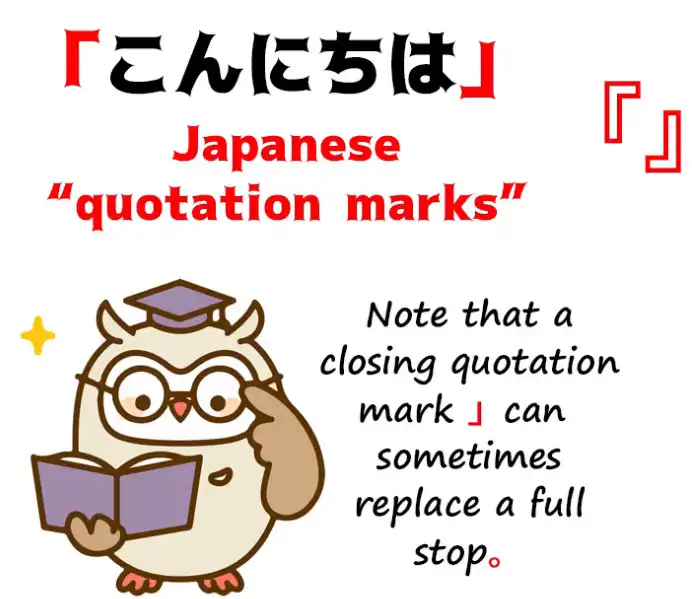
They just tell us that something is a quotation: it’s what somebody’s saying.
We don’t use them for what somebody’s thinking, as we sometimes do in English.
Now, sometimes you’ll see double quotation marks like this, 『 』 and what they do is mark a quotation that occurs inside another quotation.
The “side-marks”
Now, the last thing I want to talk about is something that really puzzles people quite a lot.
In Japanese, particularly Japanese books, you’ll sometimes see, especially in vertical text, a set of little marks that look a bit like Japanese commas, running along the left-hand side of a word or a phrase.
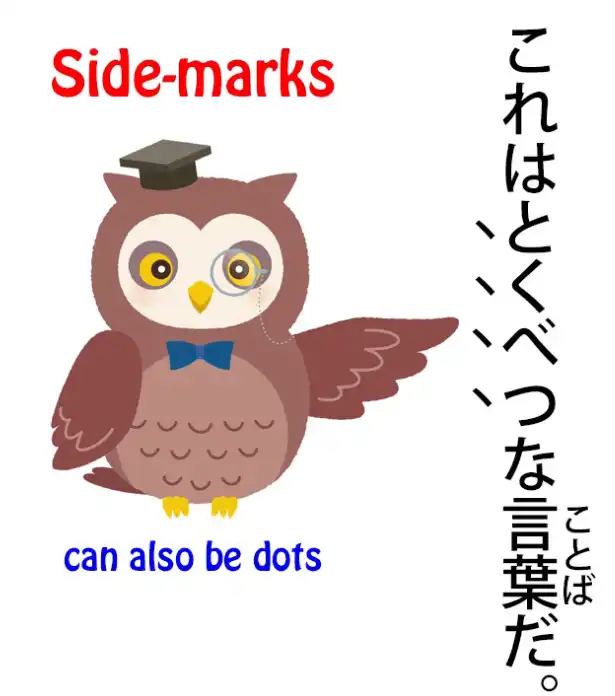
What on earth is this doing?
Nobody seems to tell you.
What it is actually doing is either emphasizing that word or phrase or telling us that it’s being used in a special sense.
So what these little marks are really doing is something like putting something into italics in English.
And I suspect they came into Japanese in the first place to render italicization when translating Western literature.
There’s no way of really writing Japanese characters in italics.
There is no italic format for Japanese, so this is what’s used instead.
This emphasis and the indication that something’s being used in a special sense can also be indicated by katakana, but you will see this from time to time in Japanese texts and that’s what it means.

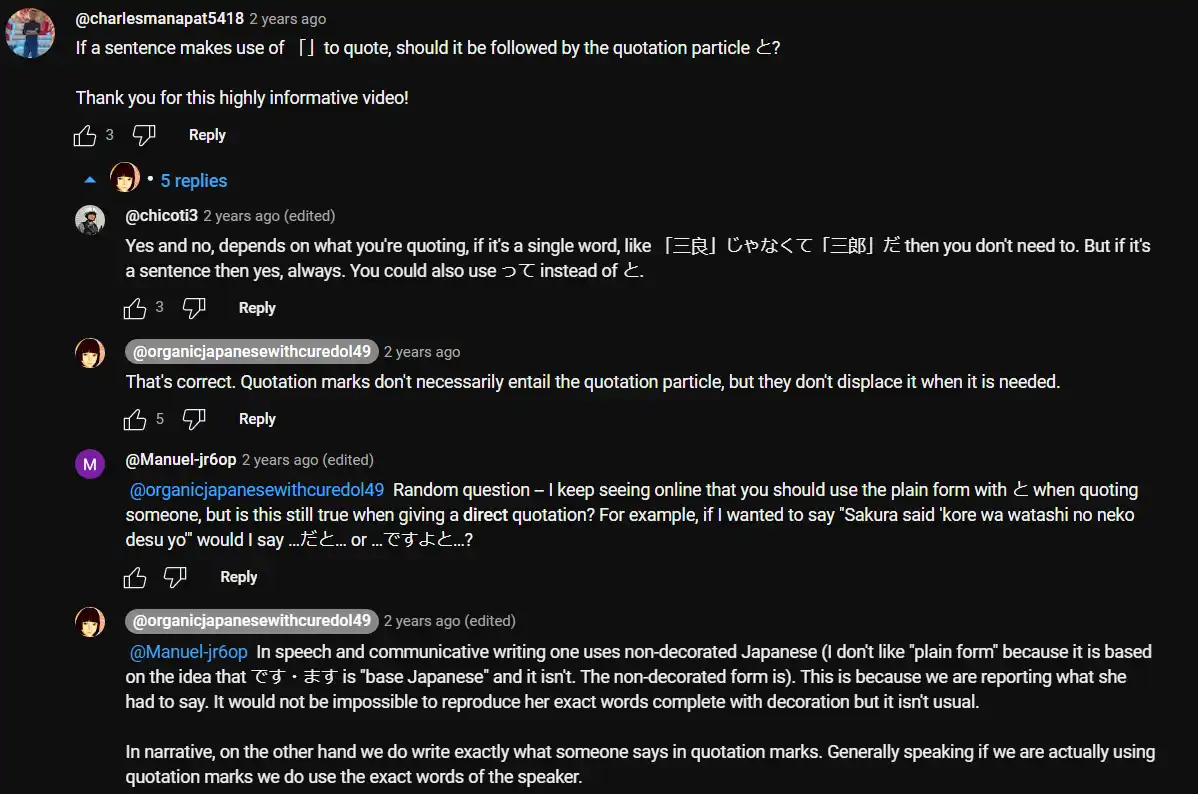
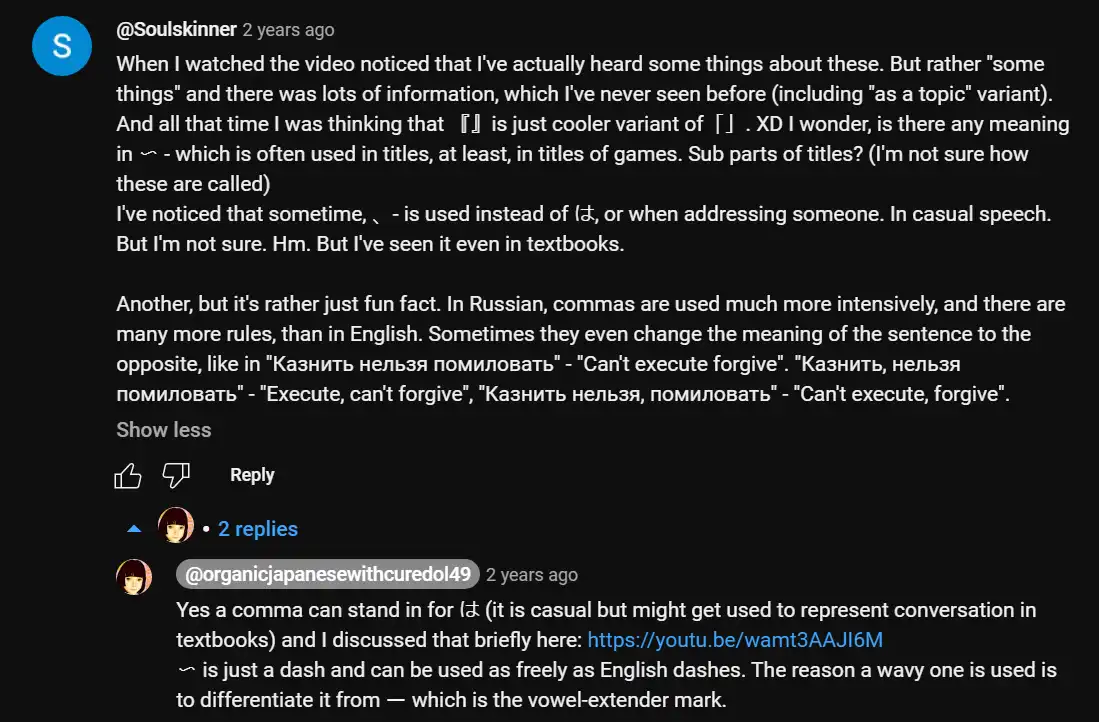
Dolly’s link is for Lesson 80.
91. Outer Limits! 限る & 限り: Its many meanings and how they work 知っている限り、とは限らない and more
Outer Limits! 限る Kagiru 限り Kagiri - Its many meanings and how they work 知っている限り、とは限らない and more
こんにちは。 Today we’re going to talk about “限る” and “限り”.
“限る” is a verb meaning “limit” or “restrict”, and “限り” is the い-stem, therefore the noun-form of that verb.
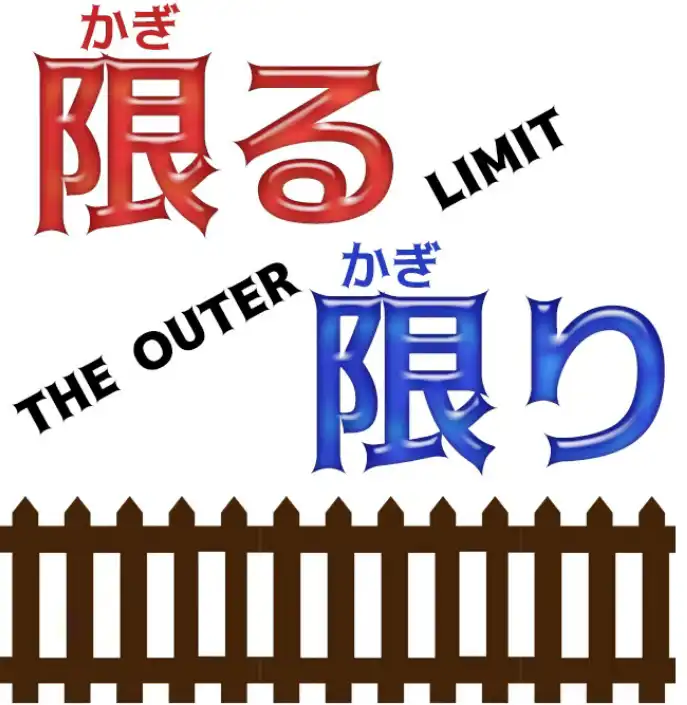
If you don’t know about い-stems making noun-forms,
I’ll link a video above my head which tells you all the secrets of the mysterious い-stem.
(Lesson 72)
Now, Japanese likes limiting expressions, expressions to do with limits and boundaries.
I did a video on “うち” (Lesson 97) a little while ago
and I’ll put a link above my head and in the information section below.
“うち” concentrates on the enclosure, on the area that we’re in and everything else is outside of.
“限り”, on the other hand, concentrates on the boundaries of that enclosure, the edges beyond which the enclosure does not reach.
And this gives rise to a whole range of expression strategies, some of which are quite literal, others of which are very metaphorical and can confuse people if they don’t understand where they’re coming from.
限る
So, let’s start with a very simple use of “限る”.
“出席は招待者に限る” “出席” is attendance at whatever the event may be.
It is limited at “招待者” (invited persons).
Outside that limit, “出席” doesn’t exist.
You can’t attend the meeting or whatever unless you are an invited person.
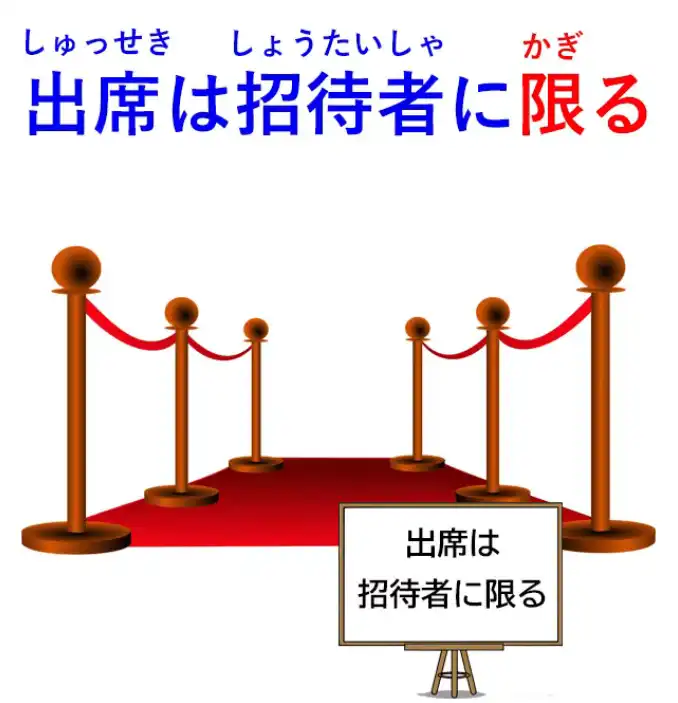
Now, another mainly literal use is “声の限りに呼んだ” (I called at the limit of my voice).

In English we might say “the top of my voice”.
What we’re saying here is the limit as loud as my voice would go.
So these are quite literal and easy to understand.
But then we get expressions which I think most of you will have heard at some time and are perhaps a little more confusing.
So, “夏はアイスクリイムに限る” – now, loosely in English that means “In summer, ice cream is the best thing”.
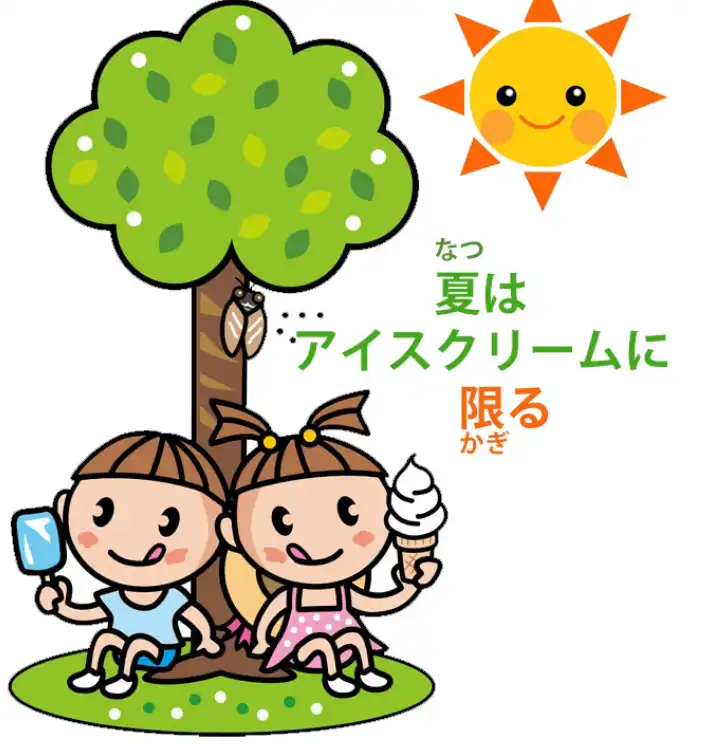
What we’re actually saying is
“Speaking of summer, when it comes to summer, it reaches its limit at ice cream”,
in other words, ice cream is the furthest you can take summer /
ice cream is the pinnacle of summer /
there’s nothing beyond ice cream when we’re talking about summer.
Note: Of course, this is just a natural Eng translation, hence why it is hard to pin-point 限る here.
And this can be used in all kinds of different expressions, for example:
“運動なら水泳に限る”
(if it’s exercise / if we’re talking about exercise, it reaches its limit with swimming [“水泳”] /
swimming is absolutely the best kind of exercise).

And moving on from this we get expressions like “彼女に限ってそんなことはしない”.

And again, in loose English this would be
“She of all people wouldn’t do such a thing
/ she’d be the last person to do such a thing”.
What we’re actually saying is “She is the very limit of people who wouldn’t do such a thing”.
So just like ice cream being the best thing in summer
or calling at the very maximum extent of your voice,
she is the maximum, the extreme of people who wouldn’t do such a thing.
Other people might possibly do it, even if you’d think they wouldn’t, but she is the very limit of the kind of person who wouldn’t do that kind of thing.
限る used negatively (not limited to x)
Now, the concept of “限る” (limit) is often used negatively to show that something is not limited to a particular statement, a particular notion.
So, “辞書に書いてあることが常に正しいとは限らない”.

And this “-とは限らない” essentially sums up the previous statement and says that’s not limited to being the case.
So what we’re saying here is “Things that are written in a dictionary are always correct” – that’s the statement, then we quote that “-とは限らない”: “It’s not necessarily the case that things written in a dictionary are always correct.” And I think we found that out to be true on various occasions.
限り
Now, again, this “限り” can be used for the limits of one’s knowledge and very often is, so “私の知っている限りではそんな言葉はない”.
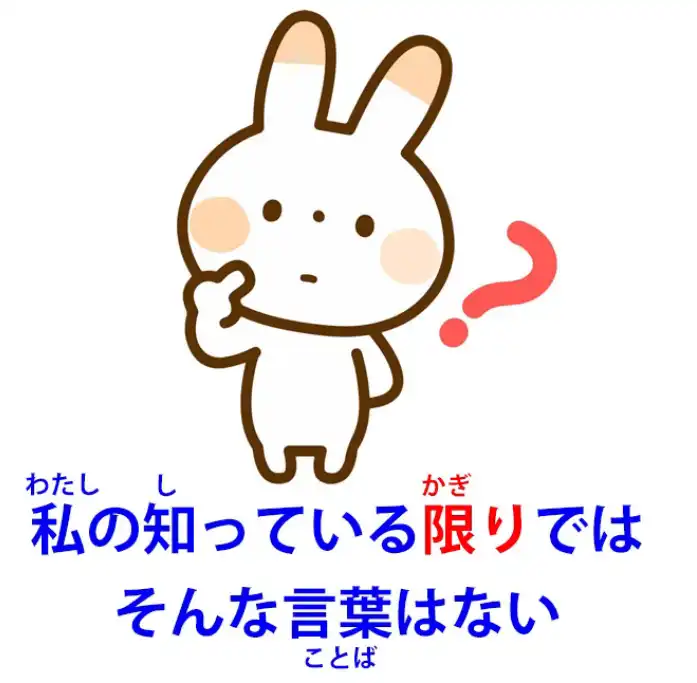
So, in English we would say “As far as I know, there’s no such word”,
but the expression strategy here is to modify the noun “限り” – “私の知っている限り”
(the limit of what I know): “Up to the limit of what I know, there is no such word.”
And actually in this case it’s pretty similar to the English:
“as far as I know / to the limit of what I know”.
And it’s interesting here that while English says “as far as I know”, Japanese achieves the same broad pattern by modifying the noun “限り” (limit).
And as we talked about last week (Lesson 90),
modification does an awful lot of the heavy lifting in Japanese
that’s done by other strategies in English.
Now, another common expression which can be a bit confusing is the kind of expression we find in “急いでいる時に限ってバスが遅れる” (limited to times when we are in a hurry, the bus comes late).

Now, this is obviously not literal, but it expresses a sentiment often felt, that the bus or whatever it is that does something we don’t want it to do does it specifically when we very much don’t want or can’t afford it to do it.
So really that expression that can seem a little bit confusing at first is a very natural kind of expression which I think you do find in English sometimes.
It’s only when we really need it that it doesn’t happen.
#
その場限り
Now, another expression is “その場限り”.
So, “その場限りことを言う” means
she says things on the spur of the moment / she talks right off the top of her head.

“その場”, which we’ve discussed in another video, which I’ll link (Lesson 75), means literally “that place / the appropriate place / the place one would happen to be at at the time”, but of course in Japanese as in other languages, place can also mean a time or an occasion.
So, “その場限りことを言う” means
she says things that just arise out of the particular occasion and nothing else –
limited to that particular occasion / having no real relevance outside that particular occasion.
So the implication is just essentially talking stuff of no real value that comes off the top of her head.
#
その場限りさ
And a very common expression related to this is “喧嘩はその場限りさ” – ケンカ and this is a popular expression, it’s not exactly a full sentence.
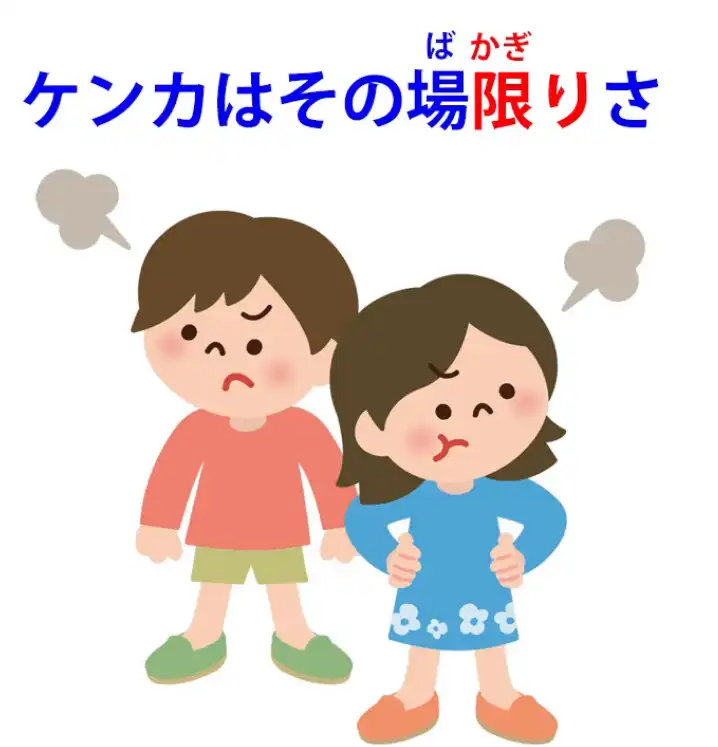
Note: I used Kanji form for ケンカ (喧嘩), but both are fine. The “さ” is rather making it into a “should”.
“さ” here is saying “that’s how it ought to be / come on, that’s how it should be”.
And it’s translated into English as “quarrels should not be continued”.

Sometimes it’s even translated as “let not the sun settle on your wrath”, which of course is nothing to do with what it’s really saying.
But the point here is that quarrels should be limited to “その場” (the occasion, the event on which they arise).
So if you quarrel with someone today you shouldn’t be carrying on that quarrel tomorrow.
Very good advice.
So this is a range of the circumstances in which the “限り / 限る” concept is applied in Japanese.
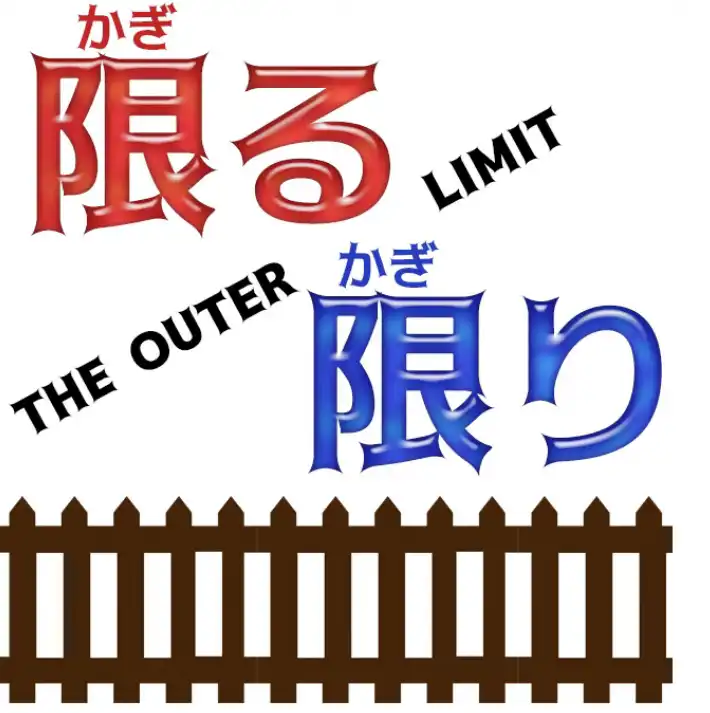
There are others, of course, but with this information I think you’ll be in a better position to see what’s going on.
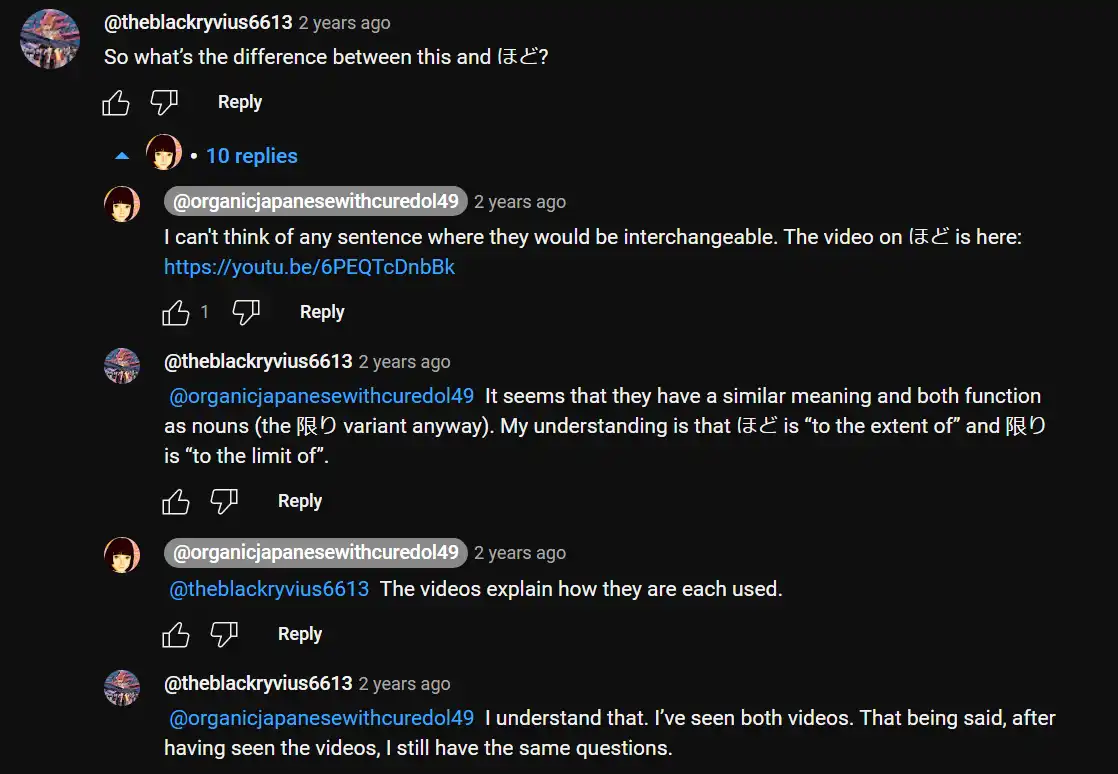
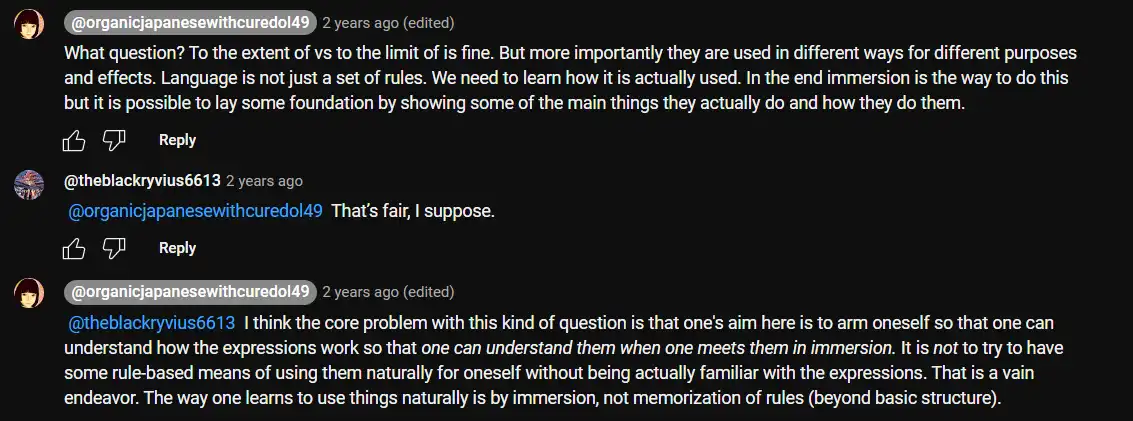
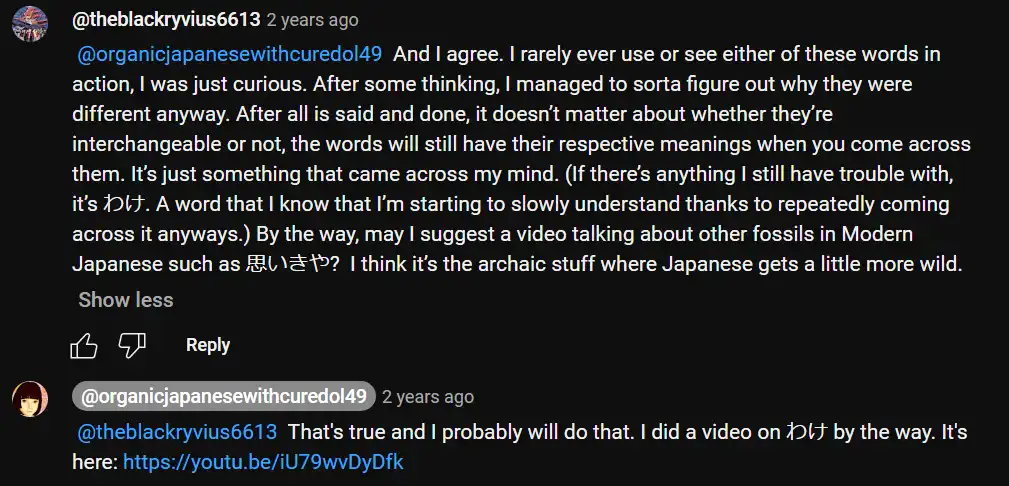
Note: The links referred are くらい vs ほど and Lesson 68 for わけ. You can check other comments under the video as usual.
Anyway, this is where Dolly’s Grammar playlist of 93 videos officially ends. We are reaching the end. There are a few other converted videos by Dolly below this yet.
92. Will English EAT Japanese? Loan-word invasion - is it really a threat?
Will English EAT Japanese? Loan-word invasion - is it really a threat?
こんにちは。 Today we’re going to talk about something that some people have been talking to me about ever since I started this channel, and one sees serious and semi-serious articles about the subject, usually written by foreigners, warning the Japanese about the terrible danger to their language of the influx of English into it and worrying that the Japanese don’t seem to be aware of the damage that this could do to the language and the ways in which it could make it less Japanese.

So today I want to look at what’s actually going on here and what is likely to happen and what is unlikely to happen.
Reasons so many English words exist in Modern Japanese
First of all, it’s absolutely true to say that there is an influx of English words into Japanese, and there are four main reasons for this.
The first is that English, of course, is the international language.
Most people learn it in school because it’s the most useful language to learn if you don’t already know it.
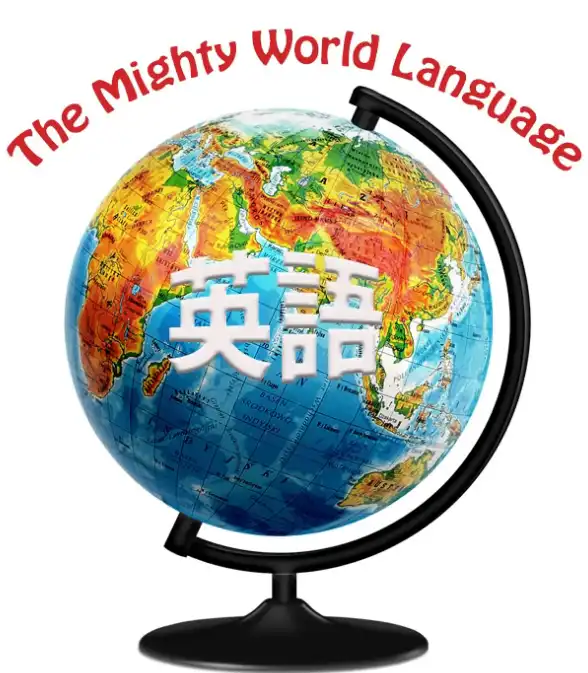
And this, of course, doesn’t affect only Japanese.
French purists have been complaining about words like “le weekend” and “le football” for over half a century, and I don’t think it’s really done much harm to French.
Now secondly, English has become the language of technology, and technology, in particular digital technology, has changed the life of humans radically over the last few decades and introduced a lot of new terminology into their lives.

And because most of this technology has been developed in America, the language in which the new terminology exists is largely English.
And the other reason – again, these are all connected – is that English, being the international language, has high prestige in various ways.
It can be considered cool. It can be considered cute.
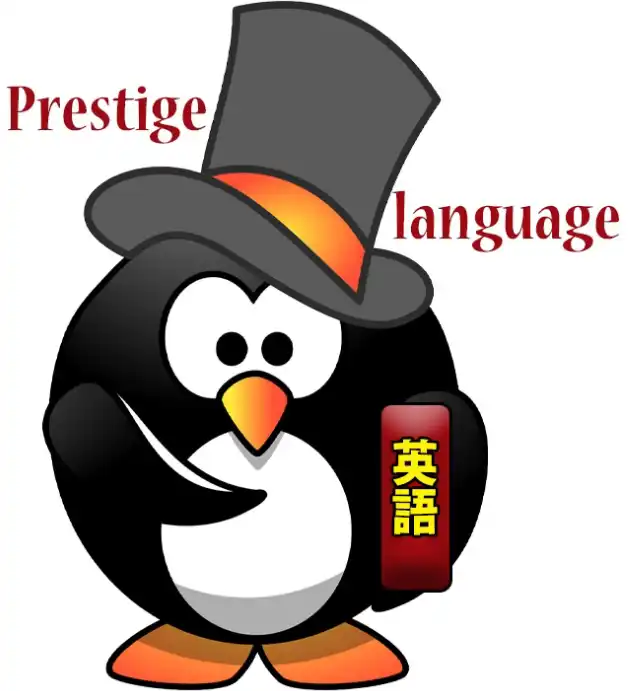
And if you see a magical writing in Japanese, it’s likely to be based on the Roman alphabet and possibly echoing English words because English is something that’s foreign to Japanese people but at the same time something they do actually know a bit of, so it’s a kind of friendly bit of foreign.
And using English words can have various effects: it can seem cute, it can seem clever, it can seem cool.
And this is a common phenomenon.
When French was more of a high prestige language and most English speakers learned it, you got very much the same phenomenon.
People would throw in bits of French into conversation, authors would use bits of French in books and it would be to look a bit clever, sometimes to look funny.
High-prestige languages tend to get words borrowed by other languages.
Now, none of this, as you see, is actually unique to Japanese.
If you go around a non-English-speaking country, you tend in almost all cases to see some English words on signboards, on products in shops, all kinds of things like that.
English is around because, well, people have learned it in school, they know a bit of English, and it’s the international language, so things often tend to get named in English.
Why do some people worry about English “invading” Japanese?
So why do people worry about this more in Japanese than in other languages?
I think part of the reason is that katakana English sticks out.
If you adopt English words into, say, French or German, they’re written in the same script as the rest of the language.
And to foreigners in particular, katakana-ized English sounds weird.
They have to distort English in various ways because they have to add lots of syllables.
So it all rather sticks out like a sore thumb, more to foreigners by a long way than to actual Japanese natives.
But a thing to bear in mind here is that on the whole English loan words don’t replace their Japanese equivalents, where there were Japanese equivalents to start with.
They tend to run alongside them, perhaps have a slightly different implication or just a different feel about them.
There are a few exceptions to this, like for example the word “ライオン”, which tends to be the main word for a lion in Japanese now.

Japanese has its own word for lion, which is “獅子 / しし”, but these days it tends to sound a bit literary, a bit old-fashioned, and if we’re going to talk about a lion, we tend to say “ライオン”.
That is a bit of an exception.
If we talk about an elephant, we say “象 / ぞう”.
If we talk about a tiger, we say “虎 / とら”.
Most wild animals are known by their Japanese names even if the English name is also known in Japan.
There’s a baseball team called the 阪神タイガース,

but this is a typical case of using the foreign word because it sounds kind of cool.
Normally if you’re just talking about a tiger, you say “虎 / とら”.
To what extent is English really moving into Japanese?
Now, if you want to do a little experiment to see to what extent English really is moving into Japanese and replacing the language, well, just take a look at a Japanese book.
If you have some Japanese books around – I don’t mean textbooks or readers for foreigners, but if you just have some Japanese books either on your bookshelf or on your mobile device, open them up and take a look at a few pages from a few books and see out of the entire page how many of the words are in katakana.
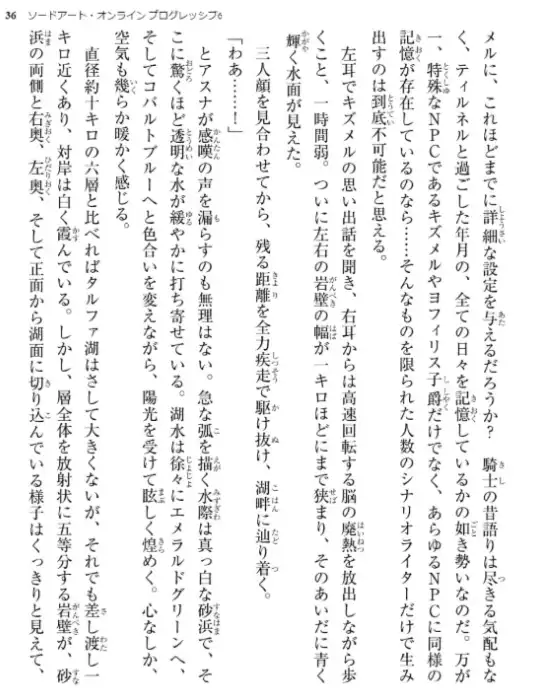
And you’ll see that it’s really a very small proportion, maybe one or two on most pages, often none at all.
And then see how many of those are in fact names of people or places or made-up words that are written in katakana: these are not loan words.
The number of actual loan words as a proportion of an average page of text or an average person’s conversation is very small.
Is it rising? Well, probably a bit, but it’s not really making very significant inroads.
And the other thing to remember is that in Japanese foreign words come in as nouns.
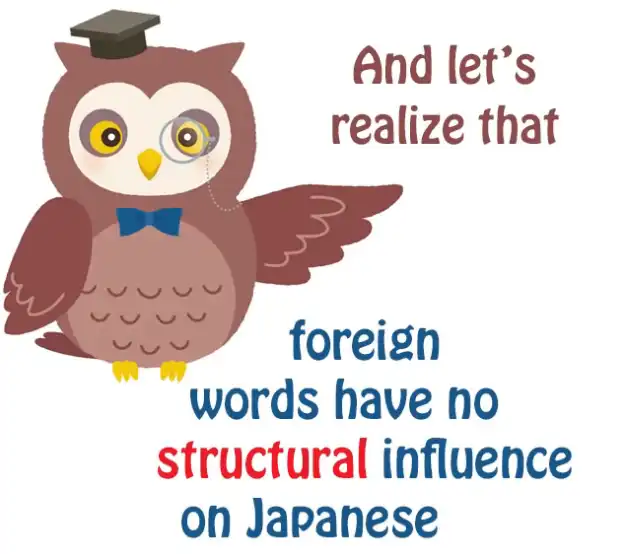
Almost always.
There are one or two small exceptions such as the word “サボる”, which means “not attending school or work”, and that’s actually a foreign word based on French “sabotage” - サボ, short for サボタージュ, and it has a hiragana -る and is actually treated like a verb.
But this is really very much an exception.
You can only find a tiny handful of words that do that in Japanese.
Nearly all the English words that come in, just like the Chinese words that came in in the past, come in as nouns, regardless of what they were in the original language.
So, if you want to use them as verbs, you have to add “する”.
If you want to use them as adjectives, they have to be adjectival nouns or you just have to use の.
So, structurally, even if English words increased exponentially, which isn’t really very likely, they wouldn’t have any impact on the structure of Japanese.
Even the Chinese words that actually now make up about 60 per cent of the Japanese vocabulary had just about no influence over the actual structure of the language, the way that sentences actually work.
And there’s an interesting parallel there in that when the Norman French were ruling England they gave English a huge, huge, huge amount of vocabulary but again they had almost no impact on the structure of the language.
Will English continue “invading” Japanese?
Now we might ask, is this going to go on, this so-called English invasion?

And we can’t really tell the answer to that because it depends on the continued prestige of English, which may or may not carry on into the future.
There doesn’t seem to be any candidate for an international language, but on the other hand the cultural prestige of English may decline.
We don’t know.
But the thing is that Japanese assimilates foreign words easily.
It doesn’t integrate them into the structure, but it does make them a part of the language and it does “Japanesify” them.
English as a cultural phenomenon makes surprisingly few inroads into the Japanese mind.
Japanese people are notorious for not learning English.
Japanese are worse at English than most other language groups.
Most Japanese people, if you talk to them, will have a surprisingly large English vocabulary but a surprisingly small grasp of the actual English language.
And I think there’s a reason for this, and that is that Japanese is closer than any other non-English language to being culturally self-sufficient.
Note: This is true indeed, most Japanese people online hang around solely with Japanese content and people, hence they have little need to learn or use English, it may be one of the reasons Japanese know English less despite its presence there, since I would argue that most foreigners learn English through the Internet via consuming content and talking with people in English - both heavy input and output because most school systems are artificial and outdated.
I mean, I acquired the vast majority of English through the Internet, books etc., not in school and it is the reason I became fluent in English, with school only this would be almost impossible.
Granted, school was useful for acquiring the basics which enabled me to consume stuff.
Of course, Europeans acquire English easier than the Japanese, but this still stands I believe.
Surrounding yourself in the language as much as possible means you will be able to acquire it faster, hence why immersion in especially foreign countries works so well if you try to slowly understand all that foreign language around you (and studying it) and by slowly utilising it.
The important thing is that you put active effort into understanding and into using the language.
Most people, even if they’re based in major languages like French or German,
kind of need English for cultural sustenance:
for using the Internet, for participating in the popular culture of the modern world.
Now, the popular culture of the modern world is far and away dominated by English, as we know.
But the second strongest popular-culture language and nation is Japan and Japanese.
Japanese manga and anime are popular all over the world and there’s nothing anywhere to rival them.

If you ask someone who has no interest in Japan or Japanese if they’ve heard of Japanese characters and phenomena like Mario, Sailor Moon, some of the Ghibli movies, Zelda, Pokemon, etcetera etcetera, most of them will have heard of it.
How many characters from any other language do most people know?
How many German ones?
How many French ones? And these are major languages.
How many Spanish ones? This is the biggest language in the world after English.
Japan is a popular-culture powerhouse to an extent that is only exceeded by English and not approached by any other language.
This makes them culturally self-sufficient in a way that no other language group (with the possible exception of Chinese) really is.
So, when is Japanese going to turn into some kind of hybrid English?
It’s not going to happen.
It’s not actually going to happen to most of the other languages that have an influx of English coming into them.
But Japanese is actually safer than the rest.
Note: Recommend reading through the comments as always.
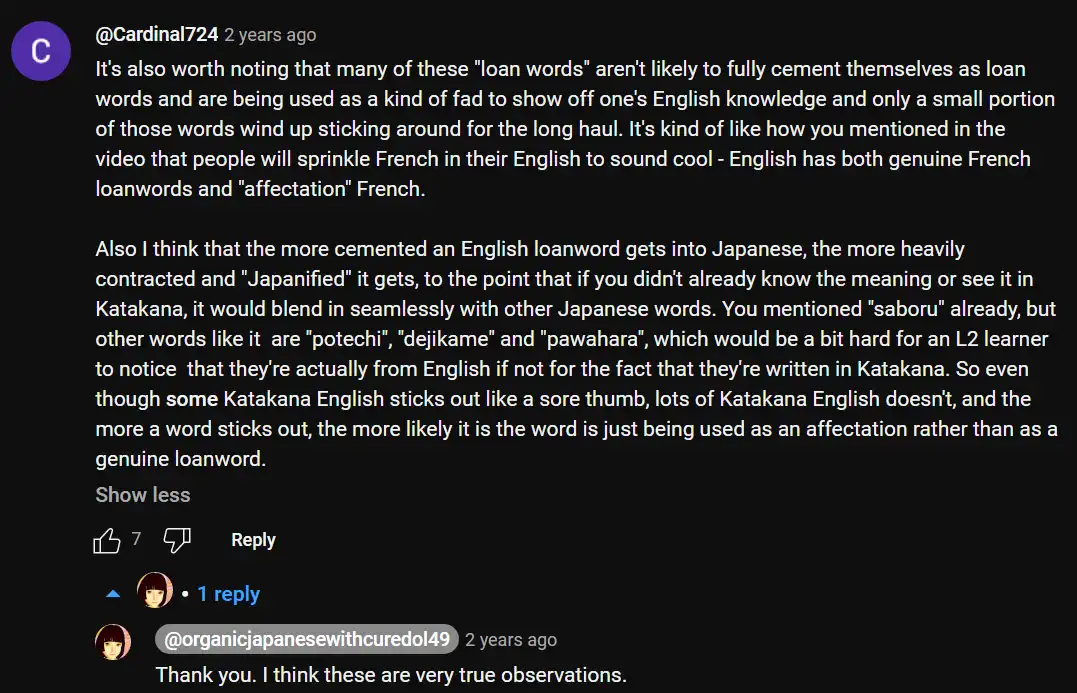
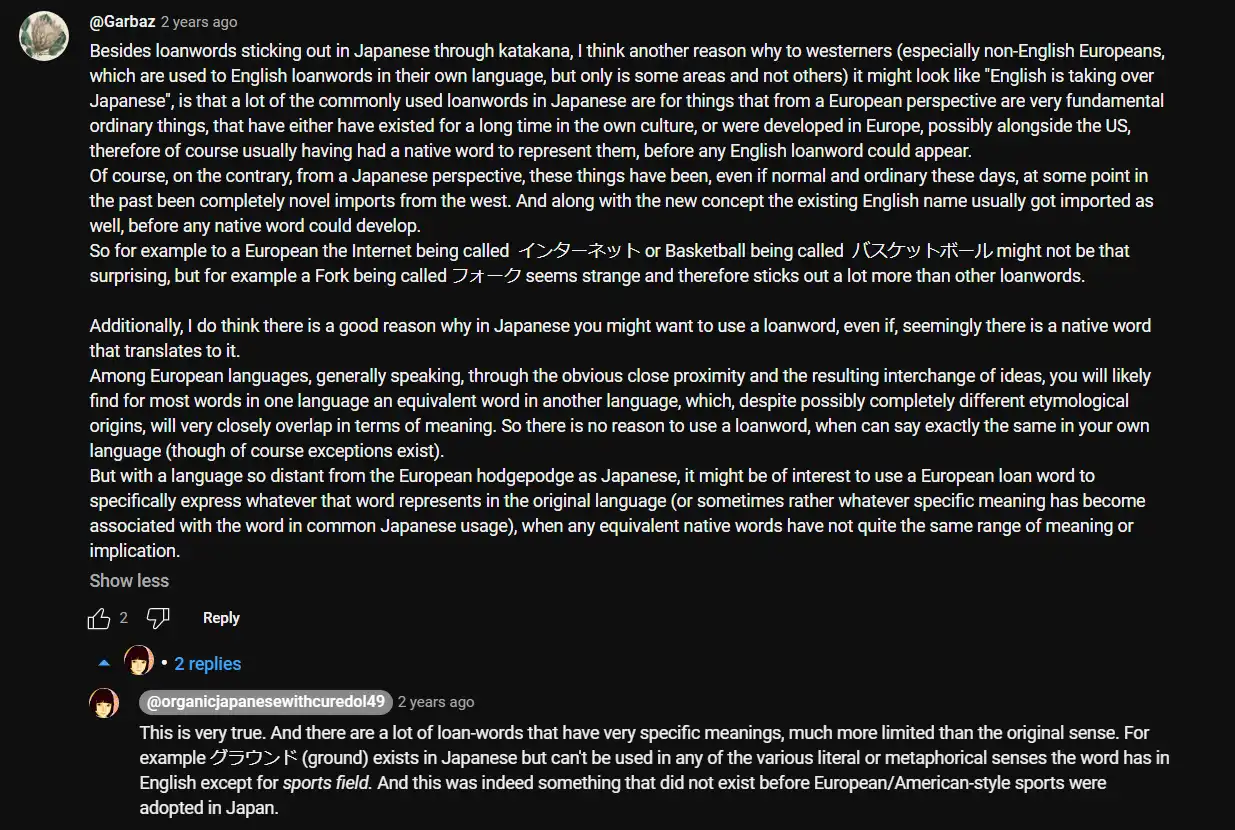
93. Cussin’ ‘Em Out with くせに. How it works.
Cussin’ ‘Em Out with Kuse ni くせに. How it really works.
こんにちは。 Today we’re going to talk about an expression that you see all the time in anime, manga, light novels etcetera, and can be confusing for two reasons.
One is that the apparent etymology, the apparent base of the word is very obvious but it’s completely misleading.
And the other is that because of the way it’s used, it’s often a bit unclear about which way it’s pointing and what it’s actually doing.
However, once we get clear about this, it’s very, very easy to understand.
The expression is “くせに”.
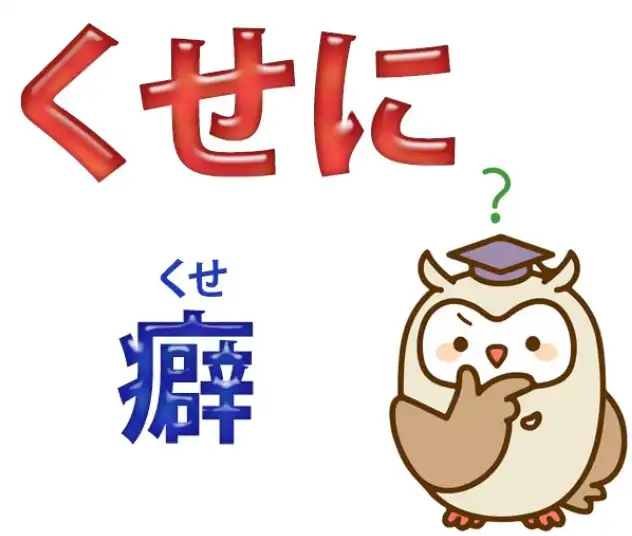
Now, the etymological problem is that whereas we all know what “くせ / 癖” means – it means a “habit or idiosyncrasy” – but it’s not very clear what that has to do with the expression “くせに”.
And the answer is: nothing.
Some Japanese etymological sources tell us that this “くせ” was actually a different “くせ” originally, but nobody really seems to know for sure.
But the point is that it really has very little to do with the modern usage.
All we really need to know is that “くせに” is a contrastive conjunction like “のに”.
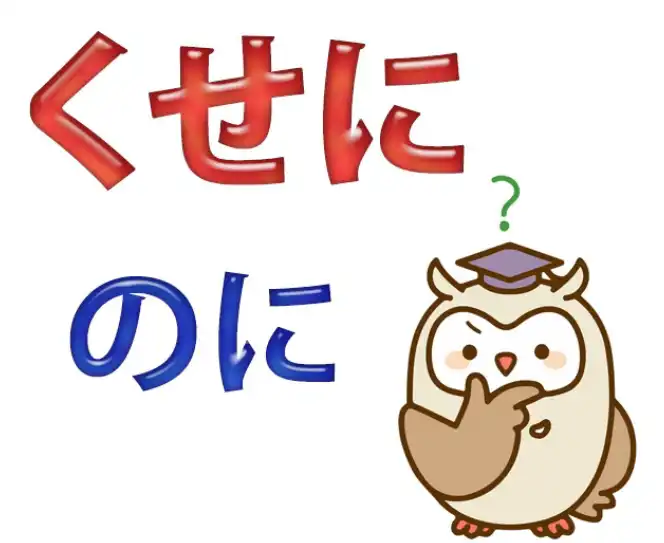
Now, I’ve done a video about “のに” and I’ll put a link here, but I’m going to assume that you basically know what it is and what it does.
“のに” and “くせに” are contrastive conjunctions, which means that they’re like “でも” or “けれど”.
They join two clauses in a manner that means “despite Clause A, Clause B / even though Clause A, Clause B”.
Now, “くせに” has two things in common with “のに”.
One is that it’s generally negative in its implications, and the other is that the second clause quite often gets omitted.
So we’re saying, “although Clause A…” and then not going on to say what clause B is.
We’re just implying it.
“のに” does that quite often and so does “くせに”.
The difference between のに and くせに
The difference between “のに” and “くせに” is that
“くせに” not only has a negative implication
but it has most of the time a very specific kind of negative implication.
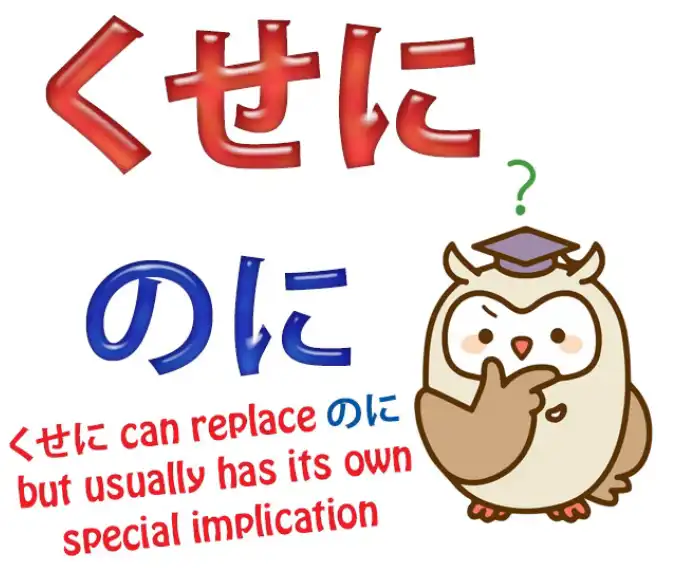
And this special usage is essentially taking the nature or character or position of a person and then contrasting their actions with it in a way that is highly unfavorable, so we could use “のに” in these situations, but “のに” would sound more regretful.
“くせに” sounds much more forceful.
It often sounds like severe criticism.
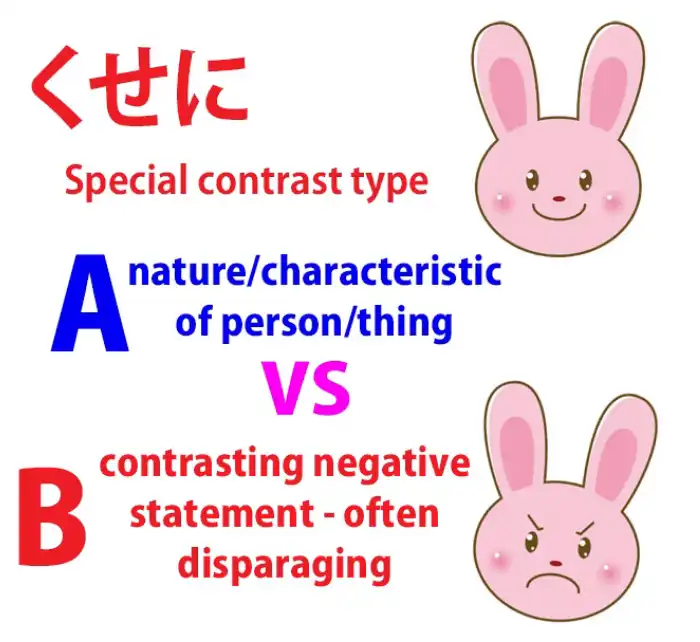
And, as we say, it’s making this kind of contrast, the contrast between what we expect of a certain type and what they actually do, and it’s a negative contrast.
So, for example, we might say, “お金持ちのくせにケチだ” (despite the fact that she’s well off / she’s rich, she’s stingy).

“女のくせに部屋が目茶苦茶だ” (despite the fact that she’s a girl, her room’s a mess).
“男のくせに泣いている” (despite the fact that he’s a man, he’s crying).
And these are generally intended in an offensive manner.
They’re intended to register harsh criticism.
So we’re taking the position of the person and what we expect of that kind of person and then saying something that’s in contrast to it.
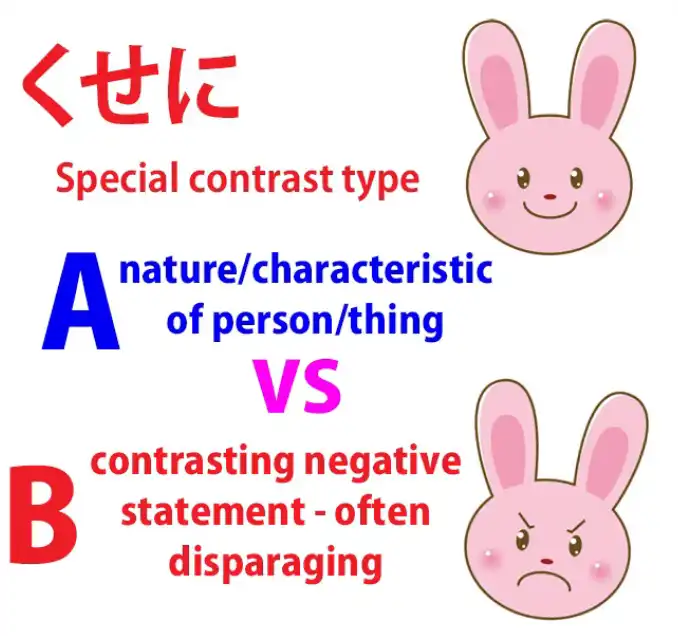
But very often we also leave that out.
So, for example, suppose some bad people or monsters break into the house and the heroine confronts them and the hero is cowering in a corner.
The heroine might just say, “男のくせに”, which literally means “Despite the fact that you’re a man” but doesn’t then say anything about it.

In English probably a non-structural but natural translation would be “And you’re supposed to be a man”.
And this can cause confusion because it can lead to constructions that confuse us about what’s really going on and which way “くせに” is pointing.
So, for example, “男のくせに泣かないでよ”.
Now what’s going on here?
“Despite the fact that you’re a man, stop crying”?
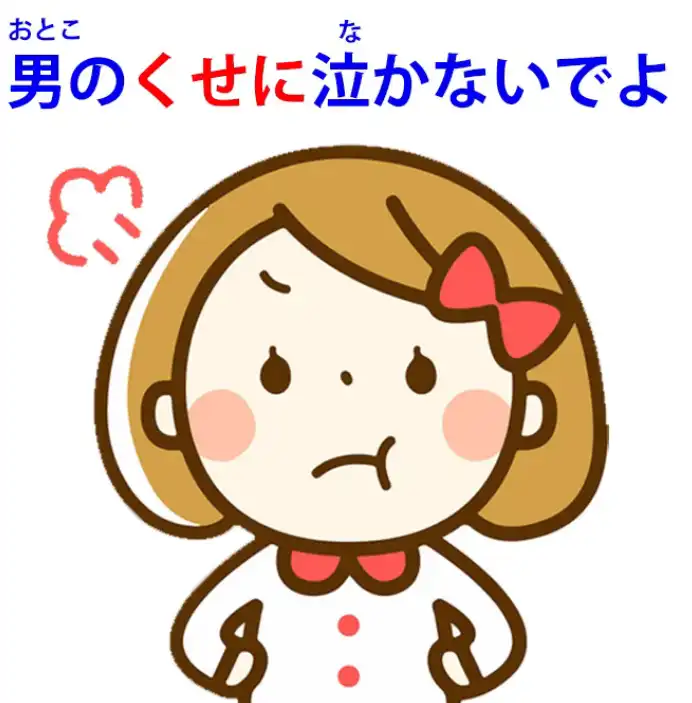
Is that what it’s saying? Well, no, it isn’t.
“男のくせに” is being used in a trailing manner like the previous example.
And then “泣かないでよ” is being added to that trailing insult, as it were, and that’s a command.
I’ve done a video on commands. (Lesson 83) So, “泣かないでよ” is not a sentence, it’s just a command: “Stop crying!” Just as in English “Stop crying” is not a sentence with a subject and a predicate.
It’s just a command.
So really those two statements should be separated by a period (or in Japanese a “まる / 。”) because they’re not part of the same sentence, but they won’t necessarily be when you see them written and they won’t necessarily have a wide gap when you hear them spoken.
“男のくせに泣かないでよ”: these are two separate statements and if we don’t understand that it can confuse us about the use of “くせに”.
Another thing that can be confusing is that the connection may go the other way around.
Generally speaking, we take the qualities of a person, which are fundamentally good qualities – being a man, being a girl, being rich – and then adding something negative to it: Despite the fact that you’re a girl, the room’s a mess / Despite the fact that you’re a man, you’re hiding in the corner / Despite the fact that you’re rich, you’re stingy.
But it can go the other way around too.
For example, we might say “下手なくせに熱心だ”.
This means “despite the fact that he’s unskilful / useless, he’s enthusiastic”.
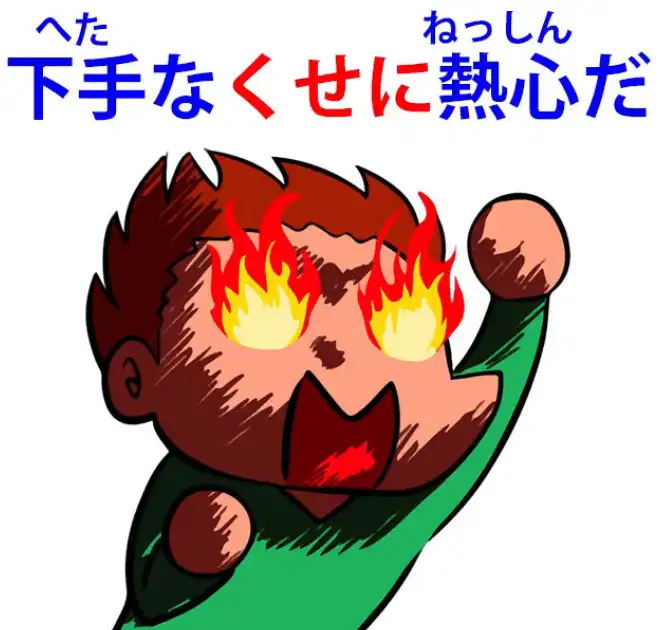
Now, this generally isn’t used in a positive sense.
It’s meaning:
“Here’s this person going around being all enthusiastic, and he’s useless, he can’t do anything’.
So it can also work that way around and we need to be aware of that, because that again can fool us.
Most of the time the contrastive conjunction goes the way around we’ve been talking about, but it doesn’t have to.
Now, if this was a textbook or a JLPT instruction
we would talk about what they call the “接続” (the conjunctions):
Note: 接続 is an abbreviation that can be used for the term conjunction, full version is 接続語
how does “くせに” attach to what comes before it?
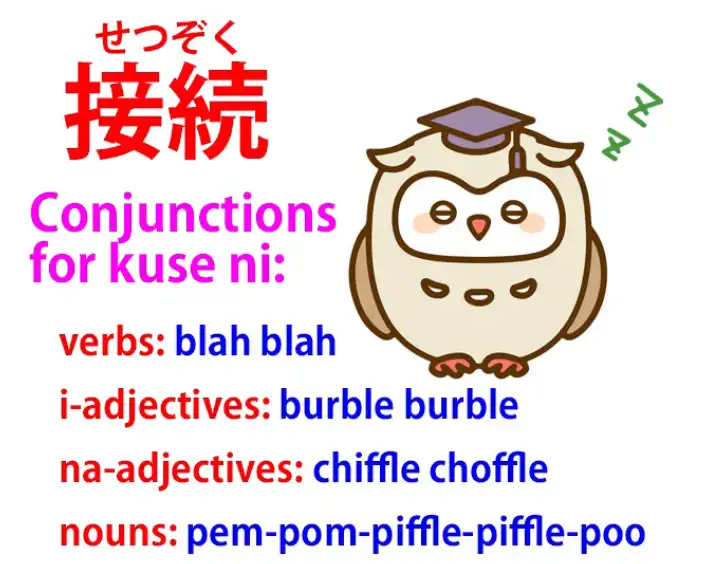
We know how it attaches to what comes after it: it’s simply a clause connector so what comes after it is the second clause, which could be left off.
But what the standard texts will talk about is how it connects to what comes before it: with a noun you use の, with an adjectival noun you use -な, with an adjective you don’t use anything.
None of this, of course, is necessary if you’ve done structural Japanese.
“くせ”, whatever it is, whatever its etymology, is a noun.
We pretty much know that, because anything that isn’t a verb or an adjective is a noun in Japanese.

What comes before “くせ” is modifying “くせ”, it’s telling us what kind of “くせ” we’re talking about.
And it does that in exactly the same way that every modifier always modifies a noun.
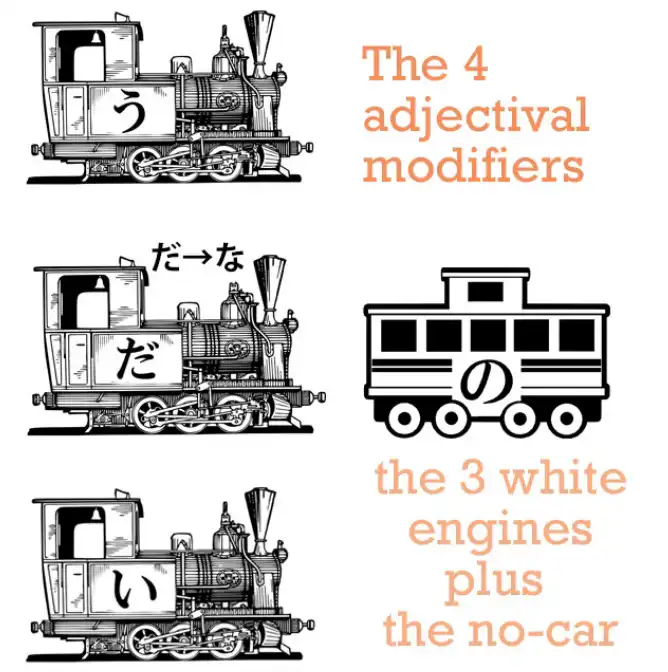
So, if it’s a noun, which it most often is, then we use の for modifying the other noun that’s following it just as we always do: “男のくせ / 女のくせに”.
If it happens to be an adjectival noun, then obviously we use -な as we did with “下手なくせに”.
And if it’s an adjective obviously we don’t need anything else – adjectives modify nouns directly.
That’s what an adjective does.
So we might say “若いくせにお年寄りに席を譲らない” (even though she’s young, she doesn’t give up her seat to older people).
If it were a verb, obviously we’d just use the verb to modify the noun as we always do.

So I think now that you won’t have any problems with “くせに”.
If you have any problems or questions, about that or anything else, please put them in the Comments below and I will answer as usual.
I’d like to thank my Gold Kokeshi patrons, my producer-angels, who make these videos possible, and all my patrons and supporters.
One of the things that our revolution in Japanese is doing is not just showing us techniques to apply but showing us that we need to apply them flexibly.
Some techniques apply sometimes and not other times.
History and etymology of words can be very useful on occasion, and I’ve done videos about that.
And whenever I do a video about that, even if I point out that history and etymology are not always very useful, people start asking me, “Do you know the history of this, do you know the history of that?” And well, of course I can just look it up in most cases.
You can’t always find it in English but you can usually find it in Japanese.
But the point is that there are occasions where the etymology helps us enormously, there are occasions where it doesn’t help us at all, there are occasions where it could help us somewhat but it’s a rather roundabout route and we can shortcut it by learning things by another method.
Part of our revolution here is getting away from the rigid approach of textbooks.
But always applying the fundamental structural knowledge, because structural knowledge gives us the core we need to get us away from rote learning of this and rote learning of that.
Thank you all for your help in this revolution.
94. くらい VS ほど
くらい (kurai) VS ほど (hodo) What they mean and why they mean it.
こんにちは。 Today we’re going to talk about two words that often cause people difficulty and confusion in immersion because they’re often not explained very clearly, so it’s difficult sometimes to understand what exactly it is that they’re doing.
The two words are “くらい” and “ほど”.
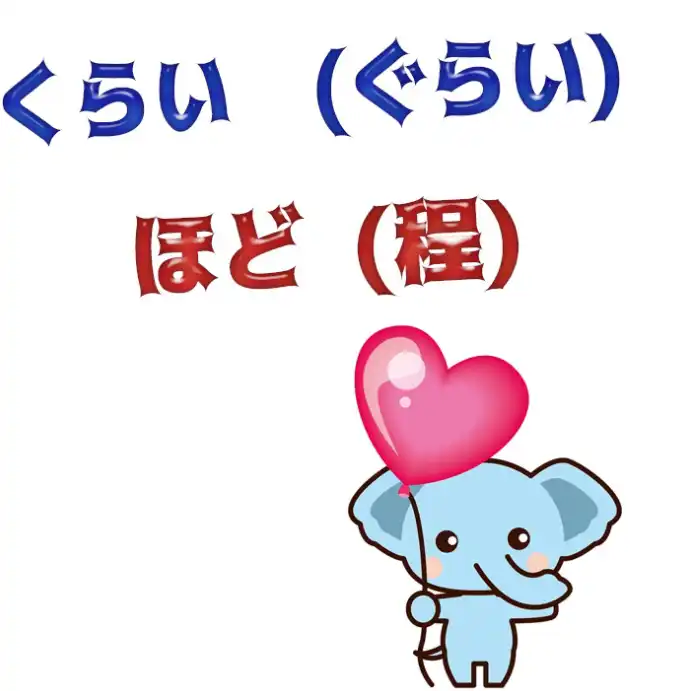
Now, I’ve had a lot of requests for “くらい”, here and on my Patreon, and quite a few requests for “ほど”.
And I’m going to deal with them together because I think they can throw a little light on each other.
And before we begin, I’ll just say that if you have any words that are causing you trouble, bringing you to a halt in understanding things in your immersion, please put them in the Comments below and I’ll either reply right away or add them to my list of things to deal with.
Right, so, “ほど” and “くらい”.
They’re both nouns, of course.
Practically everything in Japanese that isn’t a verb or an adjective, as we know, is in practice a noun or a noun-like entity.
So, what is a “ほど”? What is a “くらい”?
Both of them represent an extent or an amount of… anything: time, money, distance, etc.
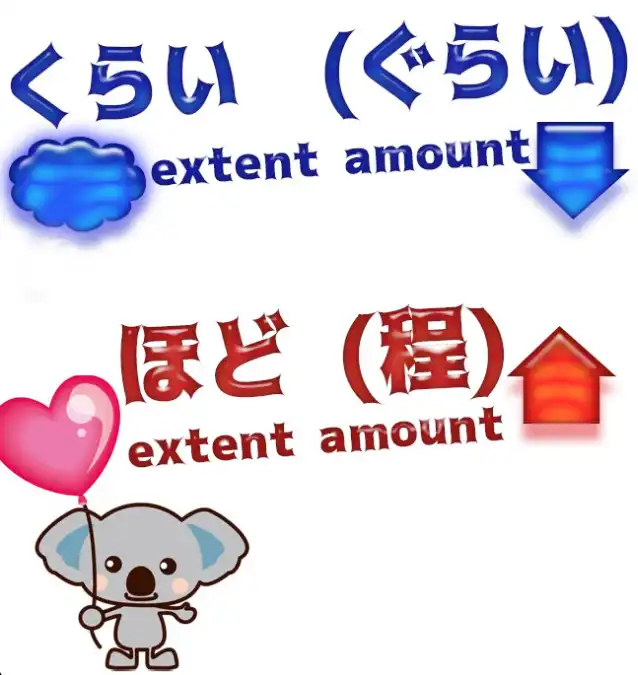
However, the main difference between them is that “ほど” tends to imply that the amount or degree involved is great, — and “くらい” either marks it as indefinite, as something we’re not sure about, or in some cases which we’ll talk about a bit later, that it is small, that it’s less than we might have expected or hoped.
So, to illustrate this difference, let’s look at them both in a very simple construction.
“これくらい” means: about this much, about this amount, about this far, about this fast,
about this temperature, whatever.
“これほど” means: this much, this amount, this hot, this cold, but it’s stressing that this is a large extent, a large degree.
ほど
So, if we say “これほど悪いとは思わなかった”, we’re saying, “I didn’t think it was this bad”.
So, the “これ” (this) modifying “ほど” is not only saying “this bad”, it’s saying that “this bad” is a lot, this is more than we might have expected or desired.
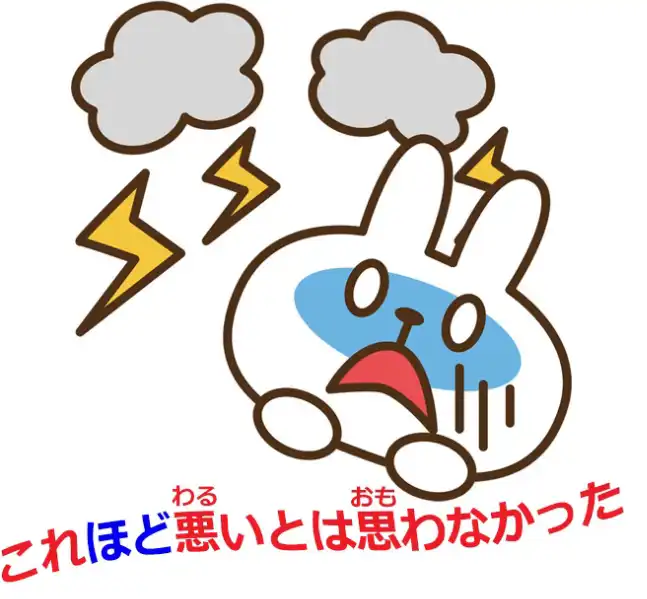
Negatively, if we say “それほど悪くない”, we’re saying “it’s not that bad”.
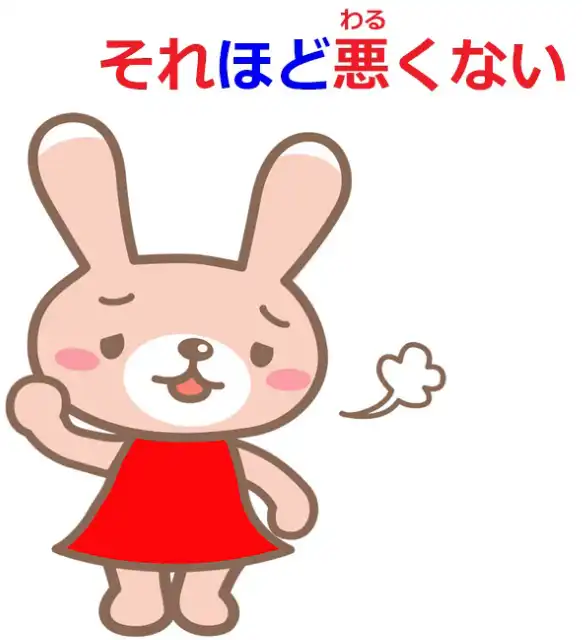
Now, what’s “それ” referring to in a case like this?
It can be referring to something we’ve already referred to, to a degree or an extent that we’ve already been discussing, but also, just as in English, “それ” (or “that”) can simply mean an amount that we might have expected.
So, again, the thing modifying “ほど”, the “それ”, represents a great amount, an upper limit, and then we’re falling short of that upper limit marked by “ほど”.
So, “それほど悪くない” means “not that bad” – either not that bad as we have been discussing or as is implied in the conversation, or simply “not that bad”, which works exactly the same as it does in English – the “that” when there’s no reference point simply means what we might have expected or what it might have been.
So if we say in English “it’s not that bad”, we mean it’s not very bad, it’s not as bad as it might have been.
And the same with “それほど悪くない”.
If we’re not referring to a specific, defined “that”, then we’re saying “it’s not very bad / it’s not all that bad”.
And again, “ほど” is often used to mark one side of a comparison, and once again “ほど” represents the greater side, the upper limit.
So if we say “私は彼女ほど若くない” we’re saying “I’m not as young as she is”,
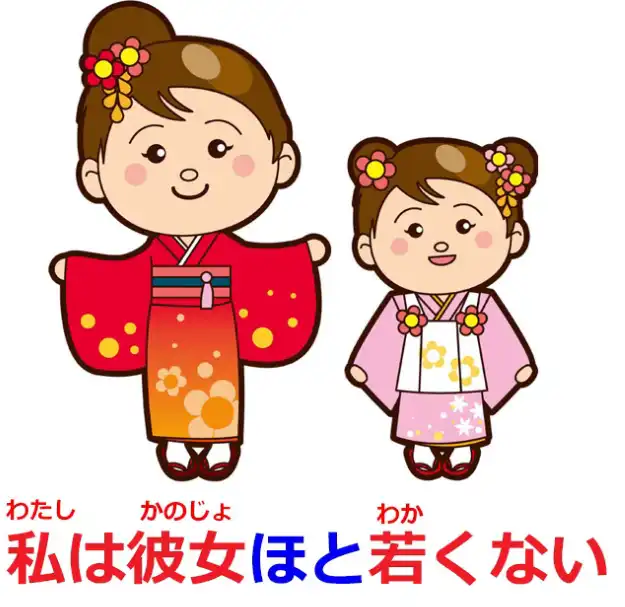
I’m not young to the extent that she is, and her extent is the higher extent and therefore it’s the one modifying “ほど”.
#
ほど as a noun
Now, “ほど” can be used as an almost independent noun representing the upper limit of something.
So if we say “不可能なほど”, we’re saying (“不可能”: “可能” means possible; “不可能” means impossible) “不可能なほど” means the upper limit of impossibility.
This is not just “不可能”, not just impossible, it’s the “ほど” of “不可能”, it’s the upper limit of “不可能”, it’s the height of impossibility.
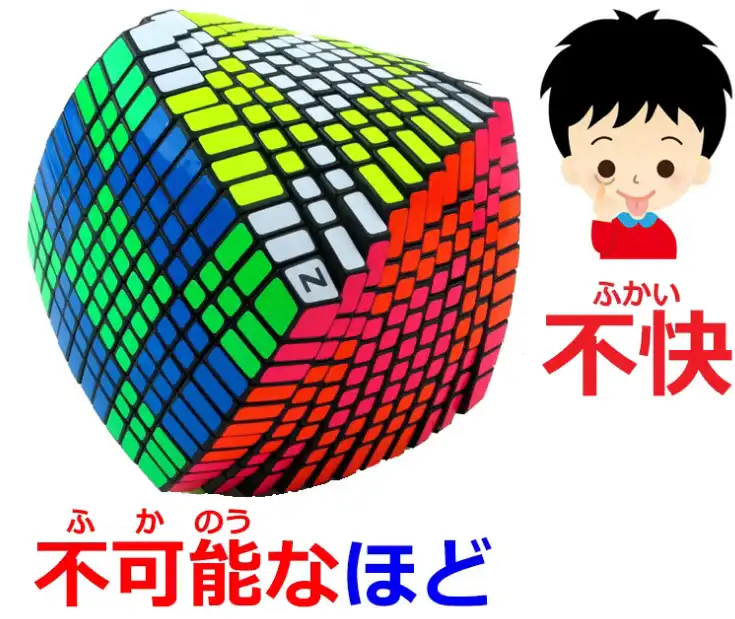
Or “不快なほど失礼” – “不快” is unpleasant, dislikeable; “失礼”, of course, is rudeness.
This is rudeness to the upper limit of unpleasantness / dislikeableness.
And these “ほど”s where we use an adjectival noun and add “なほど” – the upper limit of that adjectival noun, using that adjectival noun to modify the “ほど” – very often they tend to be negative things but they can be more neutral, for example, we might say “不思議なほど” – the upper limit of mysteriousness, absolutely mysterious.
Note: This phrase above is apparently an expression that can also mean “wondrous/marvellous” And another commonly used expression with “ほど” is “ほどがある”, and this really means an upper limit exists.
And this is usually used in complaining about something.
So we say “冗談にもほどがある”, which is literally saying even a joke has an upper limit, and what that usually means is, what you’re saying / what you’re doing goes beyond a joke.
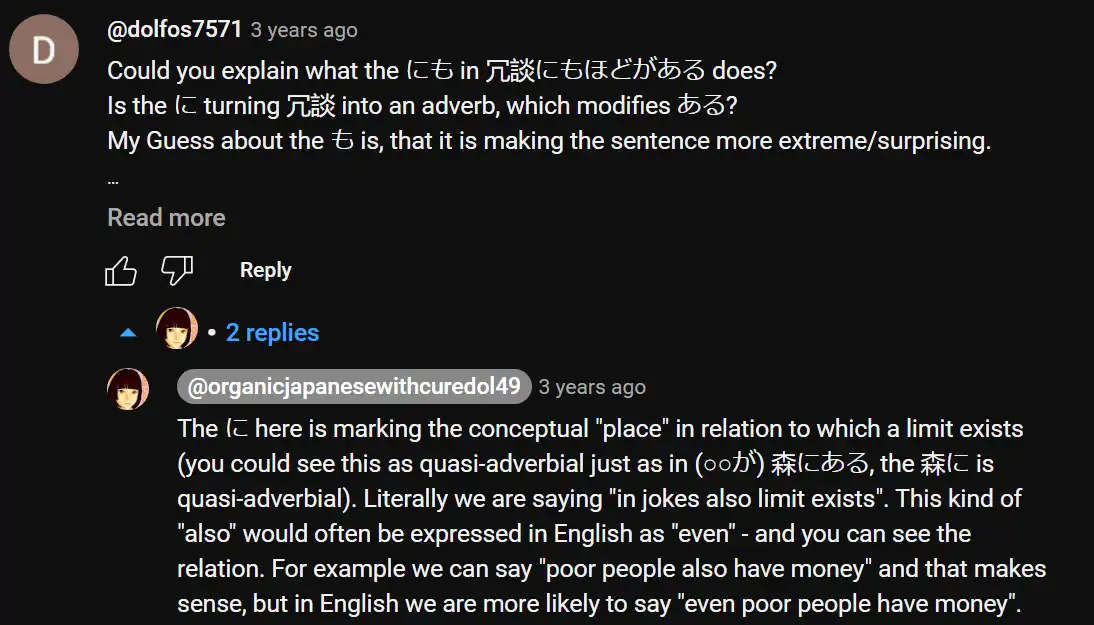
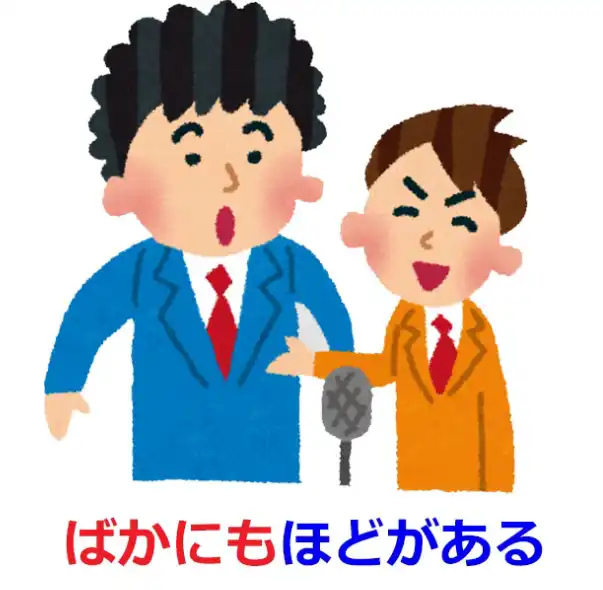
Jokes have an upper limit and you’ve passed it.
“バカにもほどがある” (stupidity has an upper limit), which is a bit like saying, “Even you can’t be that stupid” or you’ve passed the upper limit of stupidity.
#
ほど for forming comparisons
And perhaps the commonest use of “ほど”, the one that you’ll probably see all the time, is its use in forming comparisons.
Now, there are various kinds of comparison in Japanese, but “ほど” is used particularly when we’re stressing the extreme quality of something.
It’s often used for comparisons that are essentially exaggerations but making the point that something is very much whatever it is we’re saying it is.
So, we might say, “死ぬほど暑い” (it’s hot to the extent of dying); “肌を刺すほど寒い” (it’s cold to the extent of penetrating the skin);
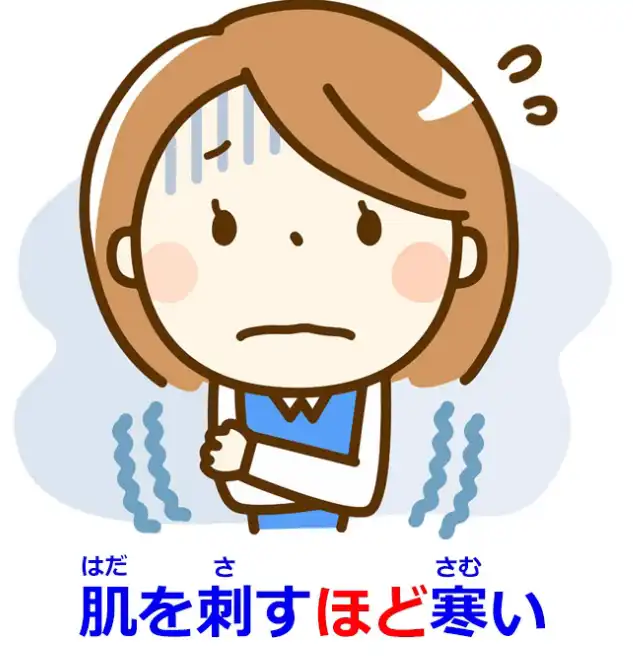
“信じられないほど美しい景色” (scenery that’s beautiful to the extent of being unbelievable).
And this “ほど” which is used for exaggeration, for literary purposes, just for making a point very strongly, is probably the “ほど” that you’re going to see more of the time than any other.
It’s a very common use of “ほど”.
くらい
So, let’s look at “くらい”.
“くらい” is most commonly used for approximation.
So we might say, “到着するのは八時ぐらいです” – we’re saying we’re arriving at approximately eight o’clock.

“八百円ぐらいです” (it’s around eight hundred yen).
And this is very straightforward.
Note: くらい as you can see can sometimes change in sound to ぐらい in some phrases. As to when, that is apparently no longer as clear, as can be read here. But wouldn’t worry much.
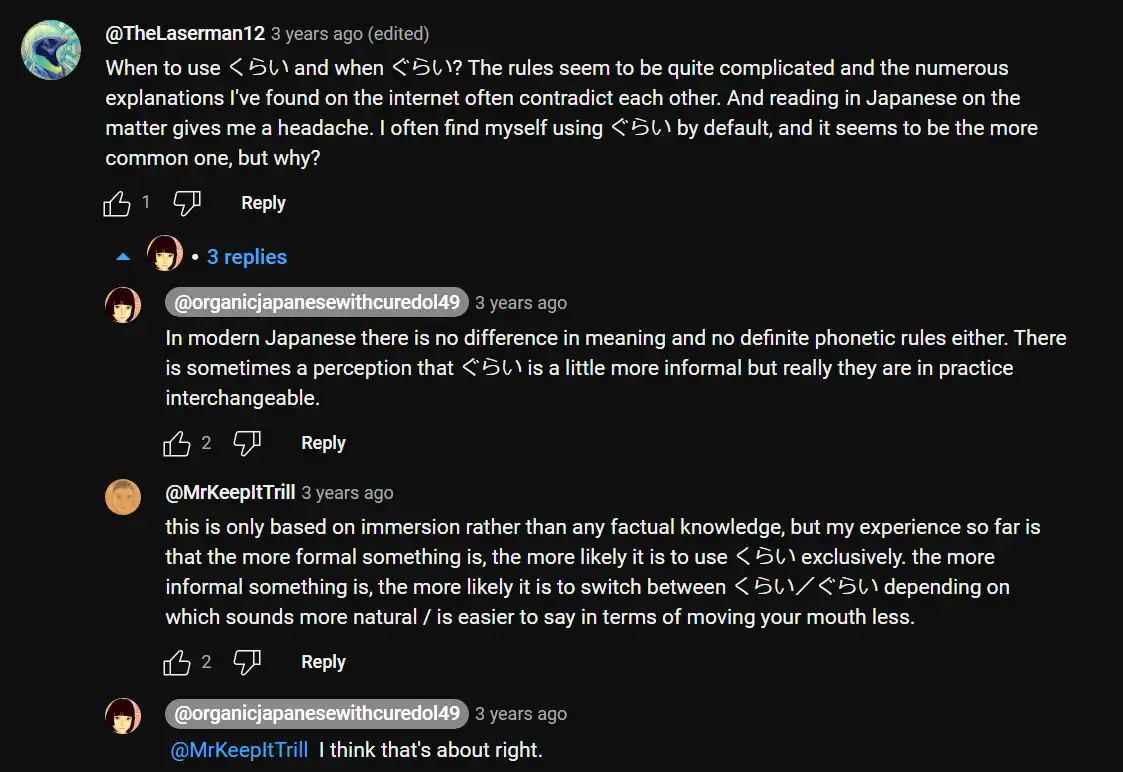
We use it whenever we want to talk about an amount, a degree, an extent, and make it vague, make it clear that we’re not talking about an exact amount or an exact degree.
And the only thing to bear in mind here is that sometimes Japanese people will use this when in fact the thing in question is exact.
So, for example, we might say, “どのくらい掛かりますか?” (about how much will it cost?) And we may be asking for an estimate, if it’s the sort of thing where you ask for an estimate, but we may also be asking the price in a case where we can expect the seller to know the exact price, but somehow it seems a bit less pressing to ask for an approximate price rather than the exact one.
And people will also sometimes do this when they’re talking about a time of arrival or… anything.
And this is partly because Japanese people are on the whole very precise, so if they think there might be any chance of the time being slightly different or any fact being slightly different from what they’re saying, it feels a bit safer to vague it up a little bit so that you haven’t committed yourself to something exact that might not turn out to be exactly true.
#
くらい as a small extent of something = “at least”
Now, the other use of “くらい” (or “ぐらい”), as I mentioned before, talks about an extent and makes the point that the extent is what we consider to be a small one rather than the large one that “ほど” implies.
So, if we say “今日くらい家族と過ごそう”, we’re saying “Today, at least, let’s spend as a family”.
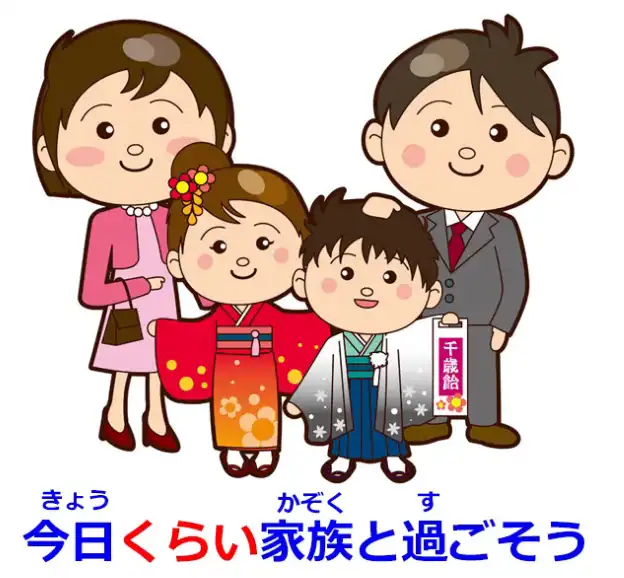
And it’s that “くらい” which gives us the “at least” meaning.
It shows that when we are saying “today” we’re not just saying “today”, we’re implying that maybe we don’t spend much time as a family, maybe we won’t be able to spend time as a family again, but today at least let’s spend time as a family.
##
くらい as complaining about something
And very often this “くらい” is used when one is complaining about something and when one is really saying that not only is the “くらい” small, but even that small “くらい” wasn’t forthcoming.
And when it’s used like that it’s often accompanied by another “at least” expression like “少なくとも” or “せめて”, and often marked at the end by a marker of regret such as “のに”.
So, we might say, “少なくとも「ありがとう」ぐらい言ってくれてもいいのに”, which literally is “at least as little as thank you if you kindly said would be good but…”

In natural English, we’d probably say “You might at least say thank you”.
What we’re here saying is that as little as thank you, if you had kindly said, would be good, and we’re adding “のに”, which, as I’ve explained elsewhere, is in fact a contrastive clause connector.
It’s used to connect one logical clause to another to make a complete sentence with the implication of “but”, that the second clause somewhat contrasts or contradicts with the first, but it’s often used like this as a sentence ender.
And the implication here is, it would be good if you said as little as thank you, but (you don’t even do that).
So, I hope this clarifies “くらい” and “ほど”.
95. Using Word-History the Smart Way どうも、やっぱり、やはり
In-Depth Vocabulary - Using Word-History the Smart Way どうも (doumo)、やっぱり (yappari)、やはり (yahari)
こんにちは。 Today we’re going to look at a question that sometimes comes up because I deal with the Japanese language structurally and people sometimes ask, “Does it help in understanding the granular structure of the language to know something about its history, to know where words come from?”
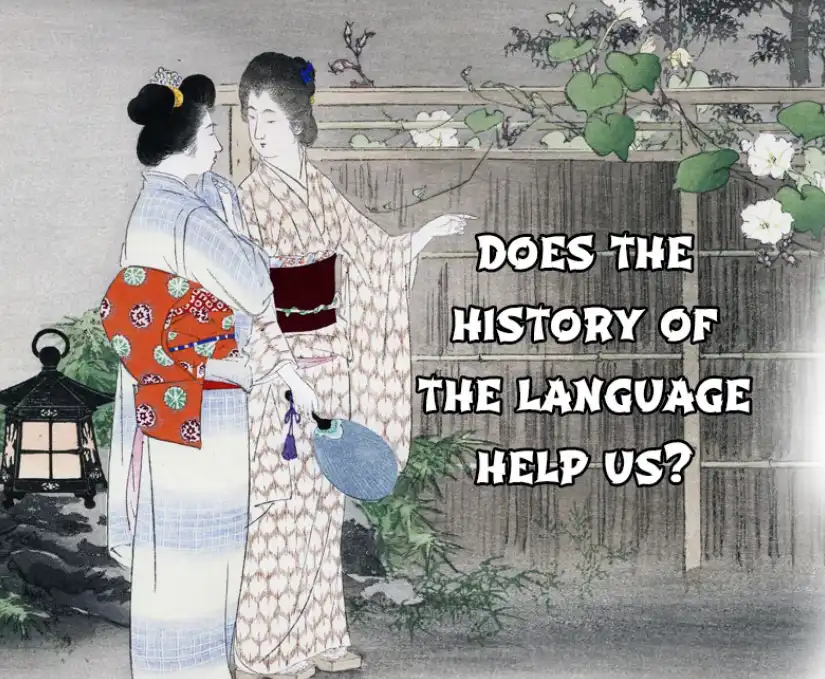
And my answer to that is a pragmatic one, because my whole approach is pragmatic, and the answer is, “I would say most of the time no, but some of the time yes.” I’m assuming that most people watching these videos want to learn to use Japanese, read it, hear it, speak it, write it, and are not fundamentally interested in the history of the language.
If we are interested in the history of the language, that’s a different matter.
purely from the perspective of acquiring the language, it’s cluttering our minds with information we don’t particularly need.
But there are times when it becomes very useful to know something about the history of the language and times when structural puzzles can’t be completely solved without it.
And I’ll try to give you a heads up where that’s the case and give you the necessary information.
There are also times, which may seem strange, when not so much the actual history of the language but folk history, etymological ideas that aren’t actually correct, can be very useful.

That sounds strange, I know, but why is it?
Well, it’s because one of the things about the history of the language and why it often isn’t very useful is that it’s not telling us about how the language works now, it’s telling us about how the language used to work a few hundred years ago.
And we don’t particularly need to know that.
On the other hand, folk etymology, ideas about the origins of words that aren’t actually historically true, tend to represent more recent people’s ideas about how the language really does work now.
And since these folk etymologies are coming out of Japanese-speaking people in a Japanese environment, they tend to be colored by Japanese people’s appreciation of how the language works now rather than how it used to work, back when the words were formed.
So, we’re going to take a couple of examples, and we’ll start off with one in which the real history of the language is useful to us.
And I’m going to take a comment from Algirion-san who commented, “One of the words that confuse me a bit is ‘どうも’. It’s often used as a greeting. However, I imagine its literal meaning is along the lines of ‘in any way’. It’s probably not that critical an issue, but I still wonder how it gets to ‘hello’ from there.”
どうも
Now, this is an interesting question, and it’s not that critical an issue when we’re talking about the more usual meanings of “どうも”, when it means “thank you” or something like that.
It does become more of a critical issue when we look at another meaning that it has which seems to be quite unrelated but actually isn’t.
When we look in a dictionary, we find a lot of definitions for “どうも”: thank you, thanks, much, very, and also things like somehow, in spite of oneself, try as one might, no matter how one may try to do or not to do.
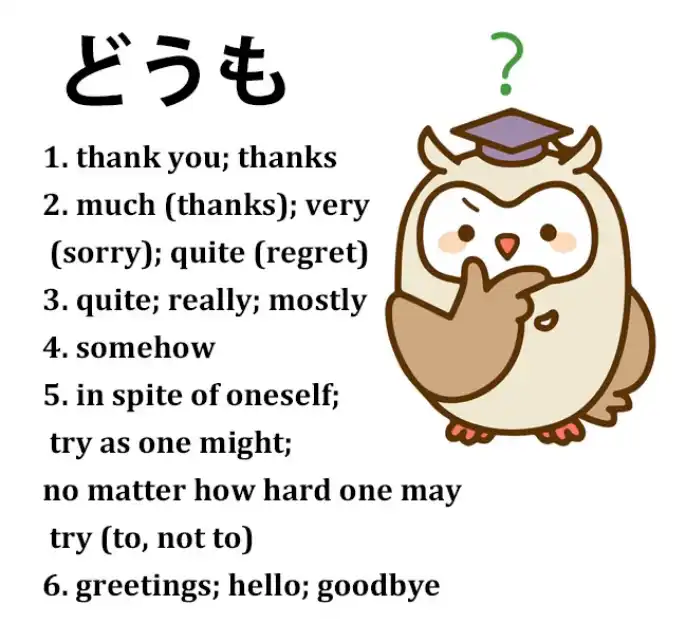
And as you see they seem to be quite unrelated to the more common meanings of the word and it helps us a good deal to know where “どうも” actually came from.
One of the reasons I quoted Algirion-san’s comment is that he actually got the structure right.
“I imagine the literal meaning is along the lines of ‘in any way’.” And it is.
The trouble here is that unless we know a little more about the history that doesn’t take us far enough.
“どうも” actually begins in the Edo era and it’s a contraction of the expression “どうも言えぬ”.
And that means “in any way” – the “どうも” part means “in any way” – and “言えぬ” means “unable to say”.
That negativizing -ぬ is something I’ve talked about in a recent video, so if you don’t know about that, I’ll put a link above my head.

And in most of the more common uses this was used in the Edo period along with the word “ほど”.
And I’ve made a recent video about “ほど” as well, so I’ll link that. (Lesson 94) So, “どうも言えぬほど”: “どうも言えぬ” means “I’m not able in any way to say”; “どうも言えぬほど” means “to the extent that I’m not able in any way to say”.
And now we start to see how this applied to the commonest uses of “どうも”.
“どうもありがとうございます” means not just “Thank you” but “I’m thankful to a degree (ほど) that I am unable in any means to express / I’m inexpressibly grateful”.
“どうもすみません”: “I’m inexpressibly sorry”.
Now of course this is a hyperbole and, as always happens with hyperboles when they become settled into the language as regular expressions, it loses a lot of its force, so it ends up just meaning “very”.
So, “どうもすみません” (I’m very sorry); “どうもありがとうございます” (Thank you very much).
And this gets attached to basic set expressions like 挨拶 to the point where it can be used to replace the 挨拶 even in cases where it wouldn’t be clear what the 挨拶 is.
So we can use “どうも” to replace goodbye and hello 挨拶.
We’re just saying “very much”: “I’m very happy to be seeing you”; “I’m very much looking forward to meeting again”.
It’s just become a kind of general 挨拶 stand-in.
And it’s a very useful one because being somewhat effusive, it seems pleasant and polite, it’s not over-formal, it’s not over-informal, it’s just a very useful expression to throw in in place of an 挨拶.
Of course, it replaces the ones where it makes more logical sense, so we can say “どうも” for “I’m sorry”, and “どうも” for “thank you”.
So these are the commoner uses.
Now, the other meanings in the dictionary: somehow, in spite of oneself, no matter how hard one might try to or try not to – that kind of thing.
We can see that this is in fact “どうも言えぬ” without the “ほど”.
We’re just saying “どうも言えぬ” (I can’t by any means express).
So if we say “どうも落ち付かない” (somehow I just can’t calm down, can’t settle down).

“どうも” (somehow), which is originally “どうも言えぬ”: I can’t in any way say why, but I can’t settle down.
“どうも呼吸が合わない” (somehow we just don’t get on).
“Our breaths don’t come together”, literally.
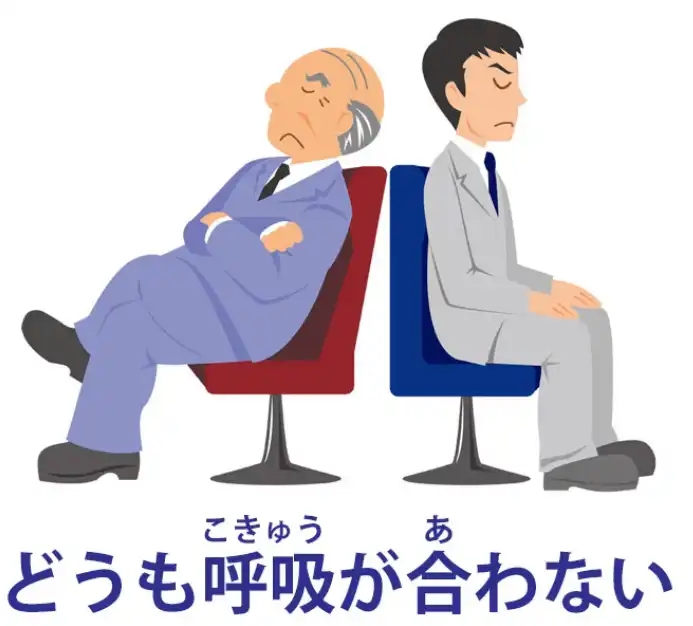
Somehow we just don’t get on – I can’t possibly say why that is, but somehow that’s the case.
And from there on, if we can’t do something or we don’t end up doing something, and no matter how hard we try to do it or not do it, it doesn’t come about…
“どうも言えぬ” (I can’t say why, but that’s just how it is).
So this is how “どうも’ comes to have such a wide range of meanings.
And if we link it back to just that concept of not in any way being able to express, we can see how it all came about, and I think it makes it much easier to understand and manage.
やっぱり / やはり
Now, one where we’re going to talk about a false etymology is “やっぱり”, which also takes the slightly more formal form “やはり”.
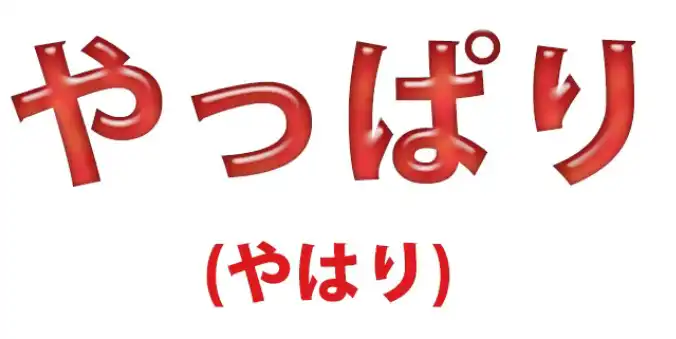
It’s rather like “日本 / にほん”, which also can be said as “にっぽん”.
“やはり” can be said as “やっぱり”.
And the most usual way in which we hear this is meaning “just as we thought, just as we understood”.
So, if Sakura does something very silly, we might say, “やっぱりさくらはバカなのね” (Just as we thought, Sakura’s an idiot).

Now, another way we often hear it in immersion, anime, other places, is when a feeling wells up inside us and very often changes our mind.
So, for example, if our heroine looks at a scary house
and she says, “Ooh, that’s really scary, I’m not going in there”
and then she makes up her mind, steels her nerve, and says,
“Right, I’m going in” (よし行くぞ) and in she marches, she opens the door,
looks around and says “やっぱり怖い” (As expected, (it) scary-is)
and decides not to go in after all.

Now, what’s going on here?
The dictionary once again gives it quite a wide range of meanings, some of which we hear less often but all of which are part of the meaning of the word, like still, as before, even so, either way, nonetheless, etcetera.
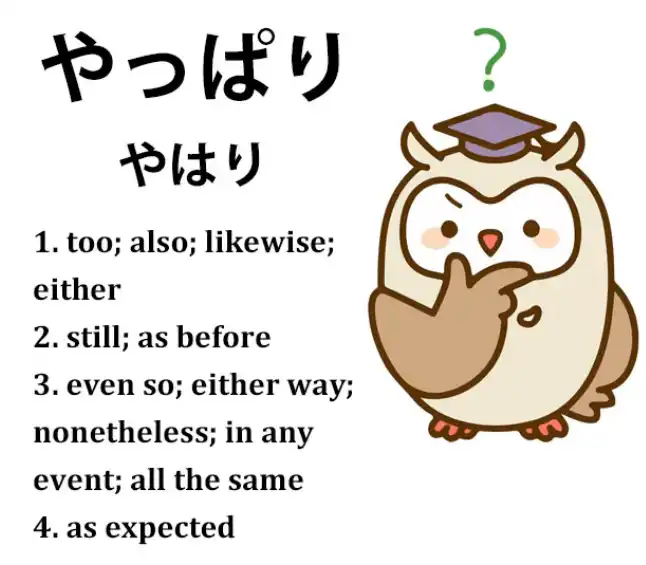
How does all this fit into “やっぱり”?
Now, there is a folk etymology for “やっぱり”.
“やっぱり” is written in kanji like this.
(or rather やはり since it won’t give you the option with やっぱり)
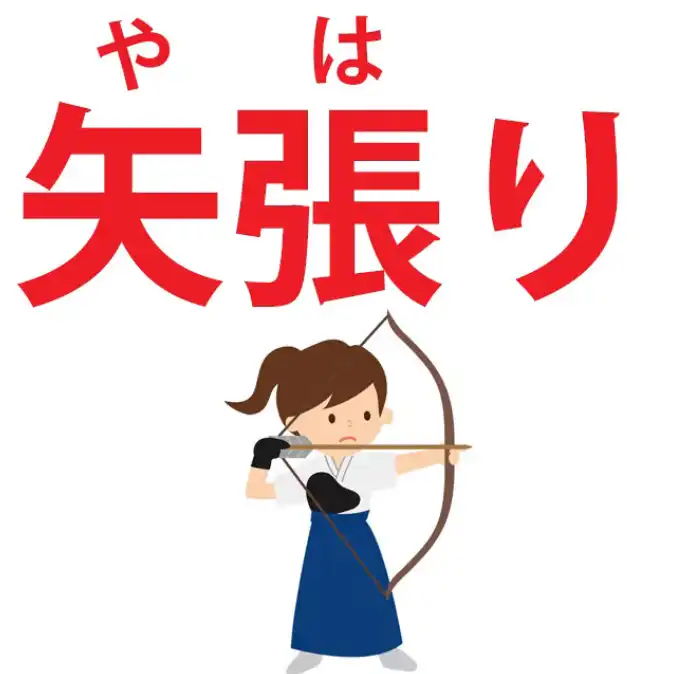
Don’t write it like this because you’ll look like someone who’s done Heisig and has no idea what’s written in kanji and what isn’t.
Note; This is good advice indeed, since one of the things of Japanese is knowing when an expression has an outdated/unnecessary Kanji form that is no longer really used outside of some specific writings in general language. Usually speaking, at least via Japanese keyboard, what is suggested to you first is likely the most common version; common expressions and function words tend not to use Kanji and writing every single word in Kanji may seem excessive. You will get the hang of what words do not tend to use their Kanji forms the more you read. Though, some authors may use outdated/excessive Kanji forms to simulate archaic settings etc. But these are the kanji: “やはり”.
As you see, we have an arrow and we have the kanji for stretching or straining or tightening.
And these kanji aren’t in fact the original kanji and were apparently only used for the sound.
So the folk etymology here isn’t historically accurate.
But what it states is that the kanji, which are for pulling an arrow tight on a bow – what happens when we pull an arrow tight on a bow?
Well, at this point we’re focusing, aren’t we, on the target.
And in Zen archery – and Japanese archery is rather based in Zen – we’re supposed to see nothing but that target.
Now, suppose we are distracted.
Suppose we look around, see something, hear something rustling, somebody speaks to us.
If we’re good archers, immediately after that we go back to the “やはり”, the stretched-bow target beyond which we see nothing else.
So, the idea is returning to our original focus.
This is what we mean when we’re talking about Sakura.
We always thought she was an idiot , and “やっぱり” she is an idiot.
It also works with feelings, which are a stronger focus in a way than thoughts.
So, if something felt scary in the first place, then we decide to go and face it, and then when we get there, “やっぱり” it is scary, we’re pulled back to our original focus.

Now, what we do about this depends on us.
We may then decide not to go in; we may decide to go in.
But either way, we’ve been pulled back to that “やっぱり”, that original focus.
So what about these other dictionary definitions?

As is often the case with English dictionary definitions, these aren’t really things that “やはり / やっぱり” actually means so much as English expressions whose meaning spectrum overlaps with that of “やはり” at certain points.
So, when we take the words “either” and “also”, which actually mean the same thing in certain contexts in English…
It’s just that English uses one word for the negative and another for the positive, which Japanese doesn’t.
So, for example, if we say “やはり…” (and in cases like this it is usually “やはり”) “やはり僕も見ない” (I don’t see it either).

What’s that “やはり” doing there?
Well, of course we don’t say “I didn’t see it either” unless the other person has said they didn’t see it.
So what we’re doing here is returning to the original focus of the conversation: A: “You didn’t see it?
B: Well.. (stressing the point by saying that we’re returning back to that focus)
I didn’t see it either.”
—
“僕もやはり行きました” (I went too / I also went).
Again, the other person has said that they went and we stress the も by saying “やはり”, returning to the original focus of this part of the conversation, to the fact that you went, “well, ‘やはり’ – original focus – I went too.” — And it can be used for concepts beyond even what the dictionaries draw it out to.
For example, it can mean “predictably”: “やっぱり雨が降り出した.”
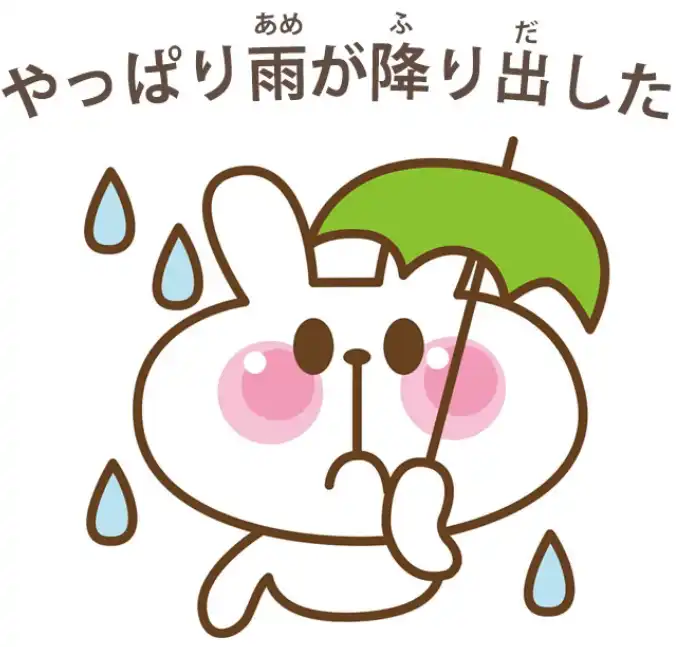
Now, in this case we may not have been specifically thinking it was going to rain, but what we’re saying is well, everyone knows it rains on these occasions.
So, going back to what might have been our original focus, if we’d had one, “やっぱり雨が降り出した” or as you might say in English, “Just as you might have expected, it rained”.
So I hope that helps with these very common words.
And fortunately I would say it’s not that often that we need to know historical information outside of the ordinary structure of a word in order to understand it.
But obviously there are cases, especially with expressions drawn from proverbs and things like that, where it helps to know the proverb, and in some cases with actual words like this where it helps to know what “どうも” originally meant.
And in the case of “やっぱり”, it’s a concept that we don’t really have in English, this original-focus concept, and even though it’s a folk etymology, not a historical etymology, it really helps us to understand how Japanese people see and understand that expression.
Note: As always, you can check the comments of the video for some interesting bits.
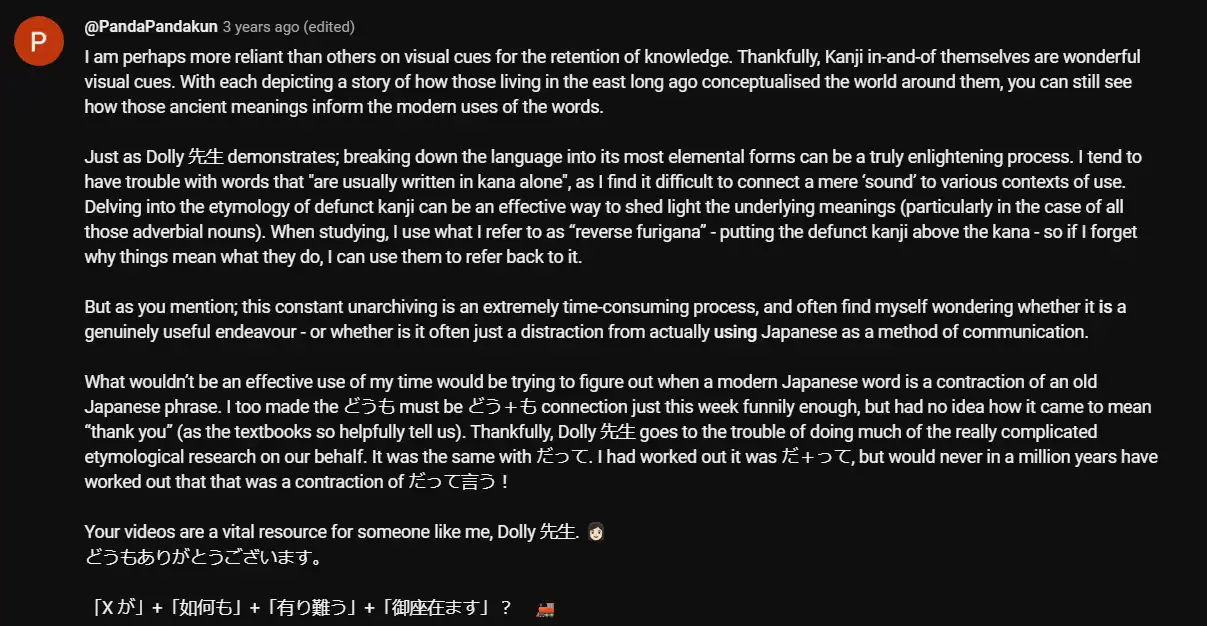
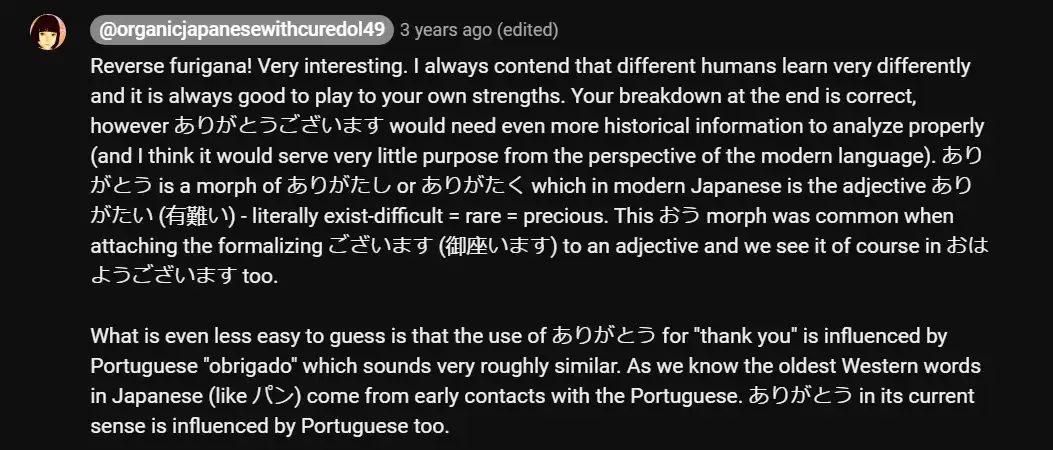
96. 通り and せっかく: A metaphorical road and an untranslatable word.
通り and せっかく: A metaphorical road and an untranslatable word. こんにちは, and welcome to 令和三年 (2021).
Under two years ago (the video is from 2021) the Reiwa era began (2019) with an upsurge of hope for a wonderful new era.
And then came Reiwa 2 (2020), which quickly turned out to be something of a disastrous year.
It was going to be the year of the Tokyo Olympics, and we all know what happened to that.
But I still believe that Reiwa is going to be a wonderful new era and perhaps 令和三年 will start to show us that.
Today we’re going to talk about two words that I’ve been asked about recently.
通り
The first is “通り” in its attachment to other words.
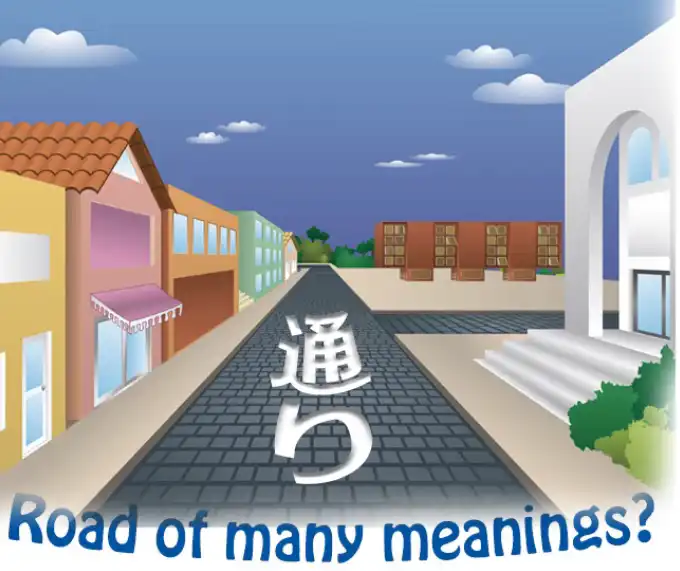
“通り” of course, on its own, is the い-stem of “通る” (pass through).
And as a noun, it means a road or a way, or the act of passing through.
#
その通り
It then gets used in expressions like “その通り” and what this means literally is “that road, or that way of travelling, that way of passing through”.
And what this actually means is “that’s right / you’re absolutely right”.

How does it come to mean that?
Well, it’s really saying that the way you’re thinking, the road, the track, the passage along which you’re thinking, is the correct one: “その通り”.
A little bit similar in English to saying “you’re on the right track”, except that “you’re on the right track” in English would imply that you’re not quite there yet, but “その通り” means you’re thinking along exactly the right lines, you’re there, you’ve got it, you’re right.
#
ごらんの通り / ご覧の通り
Another expression that uses “通り” is “ごらんの通り”.
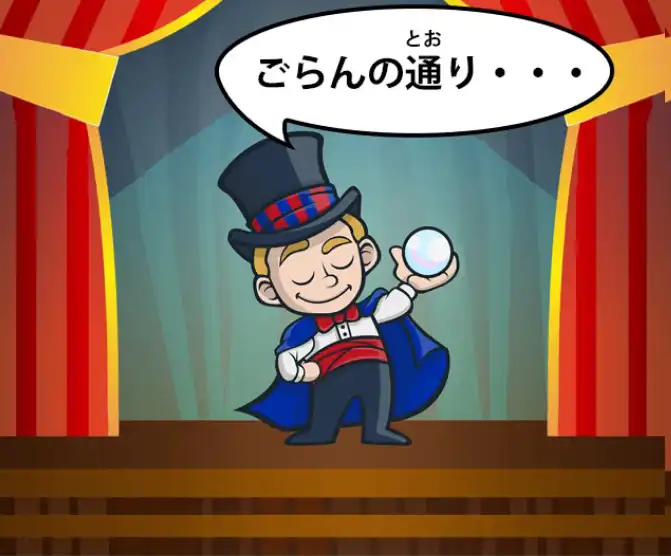
Now, “ごらん” when it’s written in kanji is written like this.
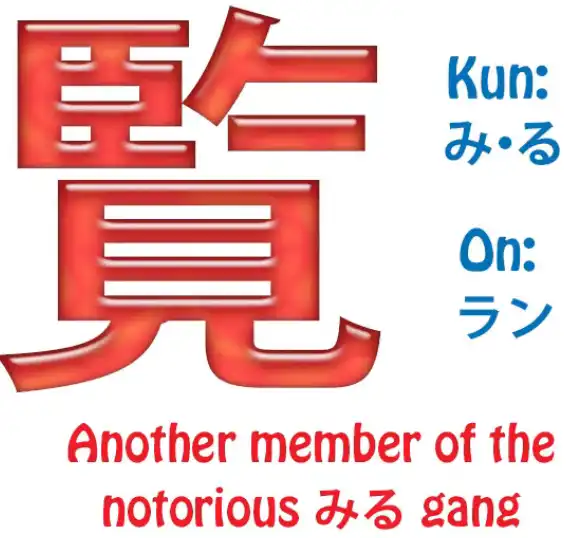
Note: 御覧 is the full Kanji version of ごらん, even with the ご honorific in Kanji form, but overusing Kanji for everything is not that viable either, but it depends on the words and usage. So you can see the “ご” is honorific; the “覧” is actually another way of writing the word “見る”.
Now, I did a video a little while ago on the word “見る” (see or look or watch) and five different kanji with which it can be written.
見る, 観る, 看る, 診る, 視る And I said at the time there are in fact more.
I didn’t introduce them because they’re not all that common, and this one (覧る) isn’t a common way of writing “見る” either.
But with its on-reading “らん” it is used, and “ごらん / ご覧” is an honorific way of saying “the act of looking or seeing”.
So “ご覧の通り”, rather like “その通り”, means “as you can see / along the lines of your seeing is correct”, just as along the lines of your saying or thinking is correct.
“ご覧の通り” (as you can see).
#
思い通り
Another “通り” expression is “おもいどおり / 思い通り”.

Now, here of course we’re using the い-stem of “思う”, which gets translated as “think” in English but actually means more than that, it means “feel”.
But “思い” often also means one’s will, one’s desire, and I mentioned this in a previous video (Lesson 42) when I was explaining how “思いのまま” means “in the unchanged condition of one’s will or desire”.
And I’ll put a link for that in case you’re interested in following it up.
“思い通り” means “in the road, the track, the course of one’s will or desire”, so it means having things go or wanting things to go in accordance with one’s will / in accordance with one’s wishes.
And that can be anything from selfish desire to, when you’re in the water perhaps, wanting your body to move in the way that you want it to move, which it doesn’t always do when you’re in the water.
せっかく
Now, the other word that I’ve been asked about is “せっかく”.
Now, “せっかく” has a whole range of definitions if you look in the dictionary.
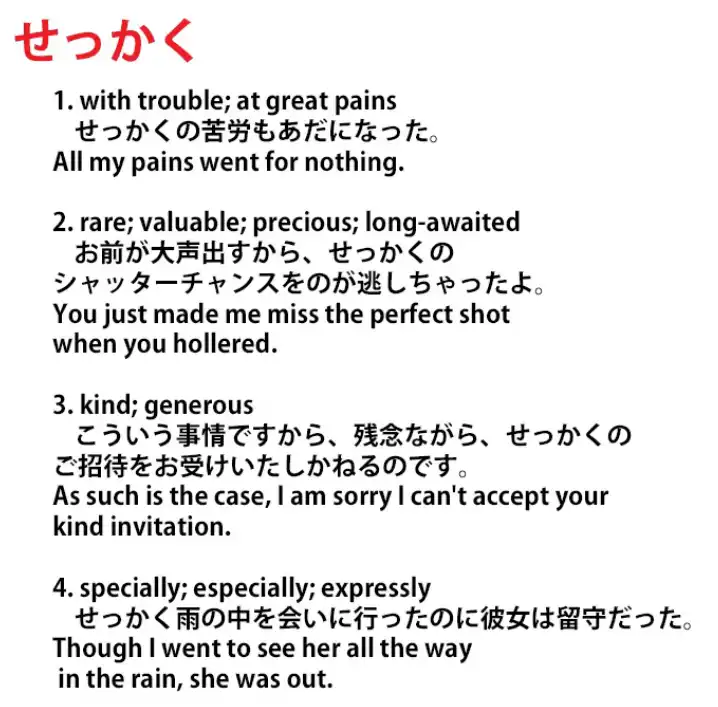
It’s defined as “with trouble, great pains; rare, valuable, precious, long-awaited; kind, generous; specially, expressly”, which is rather a lot of things for one word to mean.
But essentially they all come down to the same thing, which is the notion that something is valuable and in some sense irreplaceable.
#
せっかく as “do x with great effort / trouble and is too precious to replace”
Now, probably the most common implication is that great trouble has been spent on it.
So if we say “せっかくの努力が水の泡だ”, we’re saying “My ‘せっかく’ efforts have come to nothing”, literally “…are foam on the water / bubbles on the water”.

So we can see that obviously as the most common usage, the usage people probably think of most often, which is “with great effort / with great trouble / having taken the effort (to do something)”.
We might say “せっかく東京に来た, we ought to go to Sanrio Puroland”,
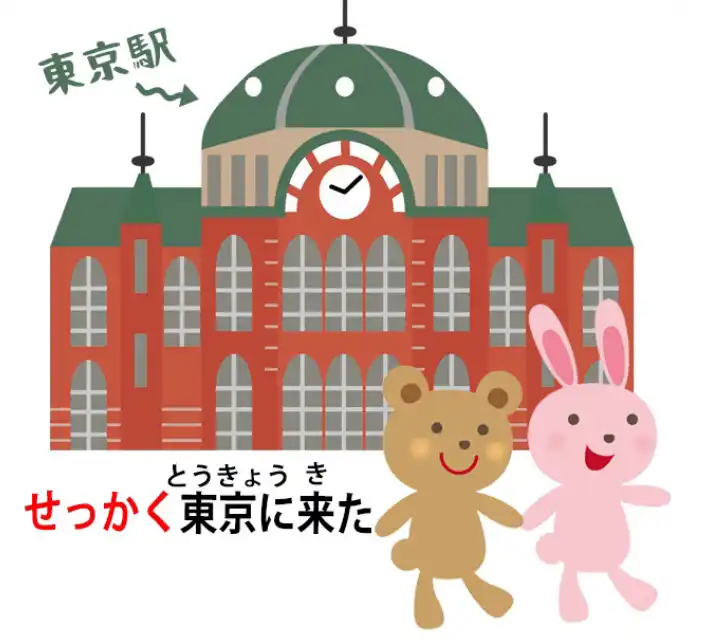
because if you’ve taken the trouble to go all the way to Tokyo, it’s a bit of a waste of time if you don’t get to Sanrio Puroland and see Hello Kitty and My Melody and Pom Pom Purin and all the wonderful people that live there, the Little Twin Stars.
If you ever “せっかく” get to Tokyo, you really must go there.
But back to the subject in hand.
However, the point about “せっかく” is not just the trouble that might have been taken, it is the fact that something is rare and precious and difficult to replace.
Going to Tokyo is difficult to replace because once you’ve left you’ve got to take all the trouble to go back there again.
But you might also say “せっかくの休日も雨で潰れた” (The “せっかく” day of rest / holiday was ruined by rain).
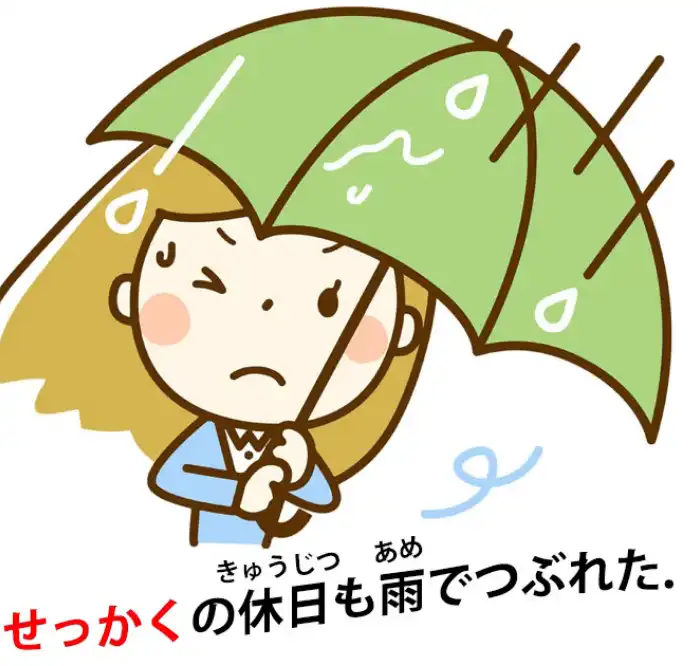
And that’s “せっかく” because it’s relatively rare.
You don’t get that many days off.
So just like going all the way to Tokyo or taking all those efforts to do something, it’s “せっかく”, it’s precious, it’s rare, it’s hard to replace.
“あの広告がせっかくの風景を損なう” (those advertisements / those billboards ruin the “せっかく” scenery).
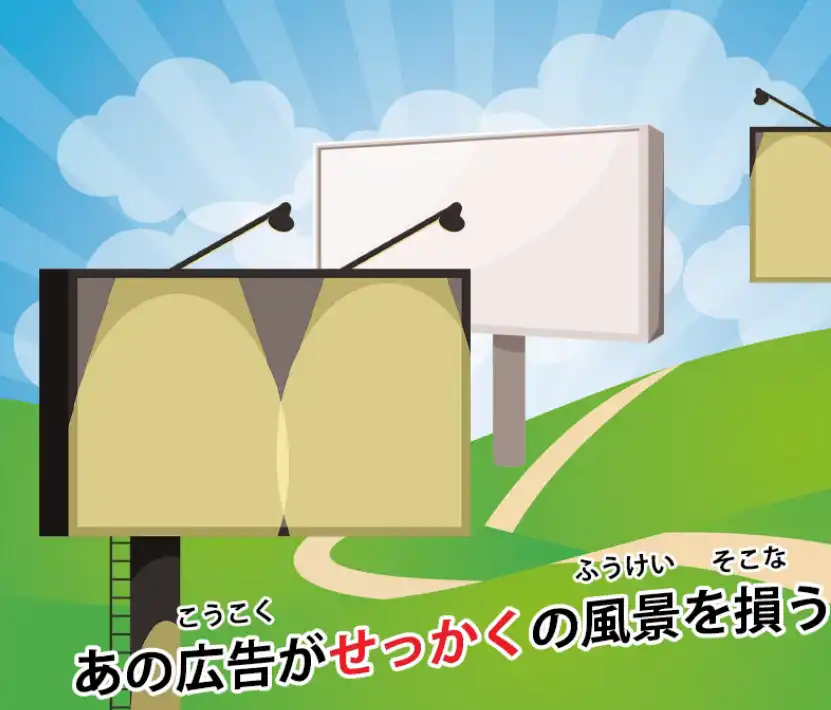
And again, “せっかく” in this case doesn’t mean hard work, it doesn’t mean rarity in the sense of not coming very often, it just means that that scenery is something beautiful and unique and irreplaceable and it’s being ruined by the billboards.
And there isn’t really a word to replace “せっかく” in English.
It’s a word that I would say is in some ways influenced by Japanese culture.
The idea of the preciousness of the sakura (tree) because it only comes for a short time and it’s quickly blown away by the winds or beaten down by the rain.
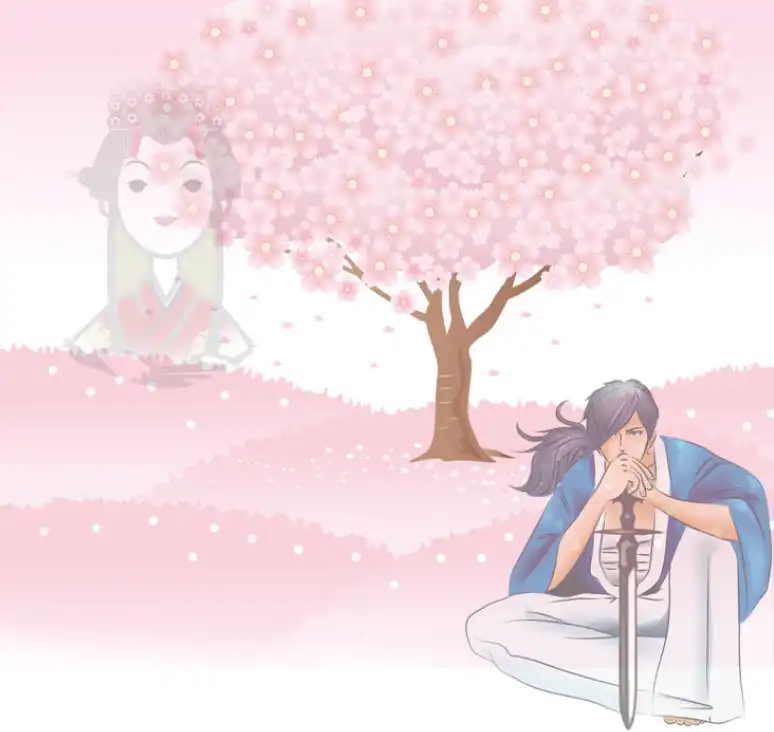
The sadness, the fleetingness, the “儚い” nature of life and the necessity to grasp what is rare and precious as it passes, while we can.
Note: This hits quite differently when we realise Dolly passed away that year… R.I.P. 🙁 .
97. The meanings of うち: Home, Self, Social boundary, Time marker: いまのうち、そのうち
Language and Culture: The meanings of うち: Home, Self, Social boundary, Time marker: いまのうち、そのうち
こんにちは。 Today we’re going to talk about a word that has a whole long list of definitions in the dictionary, many of which seem to have nothing to do with each other.
I won’t even go into this list.
We’ll just tackle the word and what it really means and see how it comes to have so many other extended meanings.
The word is “うち” and it’s one of the words you learn early on in Japanese.
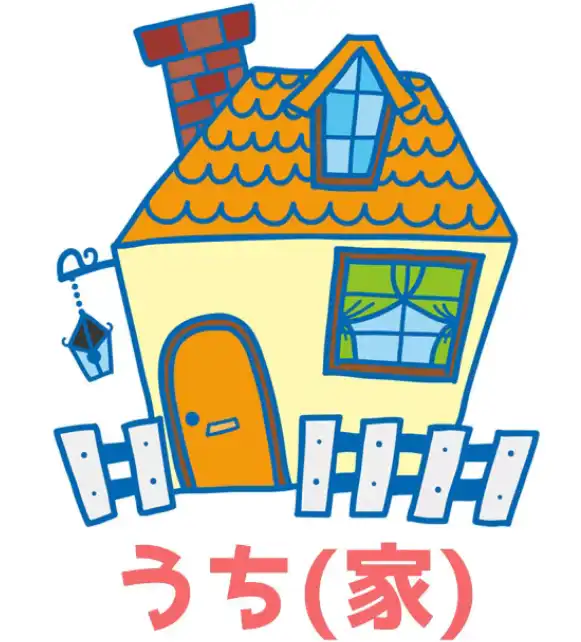
Probably the first context in which you learn it is that it is an alternative way of pronouncing this kanji (家).
It can be “いえ” but it can also be “うち”, and both of them mean “house”.
This is the only way we can use this kanji.
The other “うち” is this one - 内, and I don’t think we should really regard them as different words, because it’s a native Japanese word that had the Chinese kanji imposed at a later date and, as is often the case, the kanji helps a little bit to differentiate exactly what we mean.
But only a little bit here.
So, when “うち” means “house” (家), the difference between “いえ” and “うち” is that “いえ” refers to the physical building, the actual house.
“うち” refers to what you might call the spiritual interior of the house: the family, the life that takes place in the house.
To a small extent we can say that it’s somewhat similar to the difference in English between the words “house” and “home”.
If we say that we’re visiting someone’s house, we usually say “うち” because it is “house” in the sense of their family, their home.
That’s what we’re visiting. We’re not visiting the physical building.
And just as a little sidenote, you might sometimes encounter expressions like “さくらんち”.
This is a very common abbreviation for “さくらのうち”.
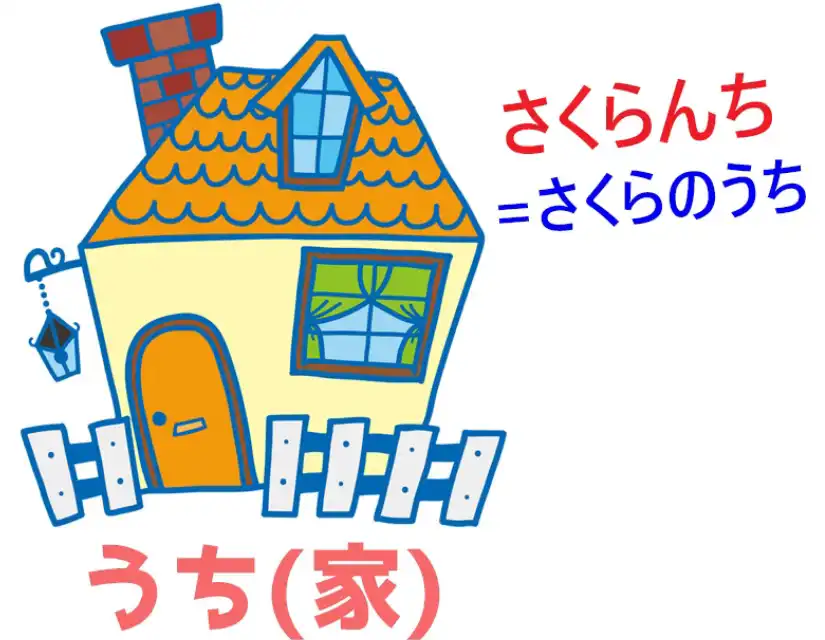
So this really actually gives us the basis for all the other meanings of “うち”, whichever kanji it’s written with: this notion of a spiritual interior, an enclosure, defined, as it were, by its contents.
うち as meaning “me” / 私 etc.
Now, the next time you encounter “うち” may well be when you encounter, in anime or something, a girl who’s using Kansai-ben, and typically she will say “うち” instead of “私”.
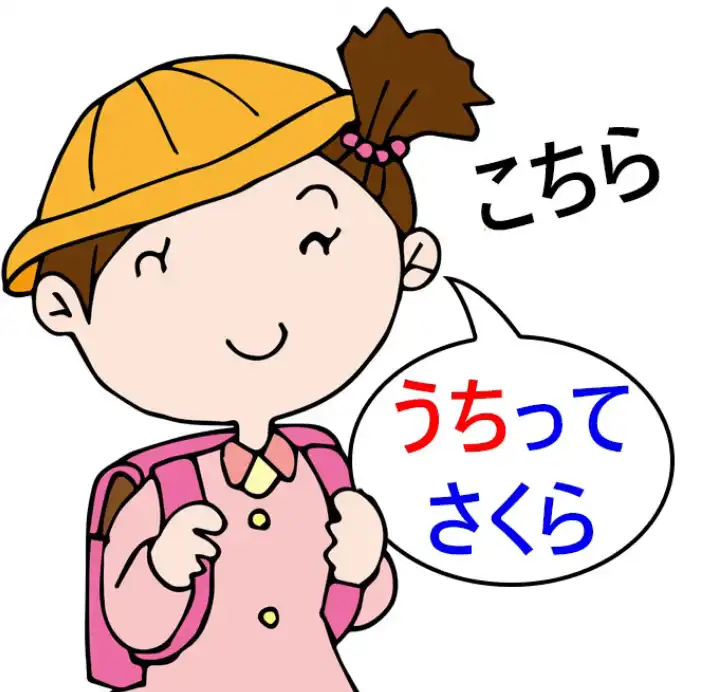
So “うち” can mean “me”, particularly feminine, particularly the Kansai dialect, although it’s not restricted to that.
And this is very interesting because it’s rather similar to when “こちら” is used to mean “me”; again, what “こちら” means is “this side (the side that includes me)”.
And this really has to be understood in the light of the fact that the distinction between the individual and the family or group to which an individual belongs is much less marked in Japanese than in Western culture and in the past was even less marked than it is now.
When Japanese people talk about, say, “my little sister”, generally speaking they won’t say “僕の妹” or “私の妹”.
They would tend to say “うちの妹” (the little sister of our house / the little sister of our family / the little sister of our group).

And even “うちのきょう”, which is “the religion of our house, our family, our group”, because religion is still to a large extent regarded in Japanese as something inherited, something part of one’s family group, rather than an individual decision or commitment.
うち vs そと
Now, from this we get a very fundamental distinction in Japanese, which is between the concepts of “うち / 内” and “そと / 外”.
“うち” refers to the group one belongs to, the in-group; “そと” refers to everything outside that group.
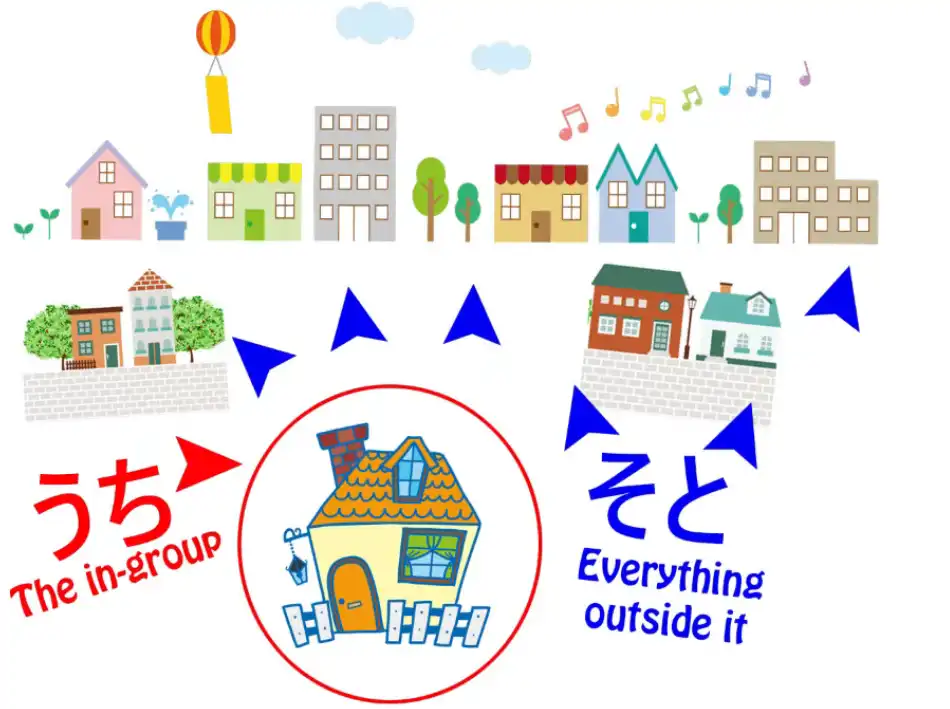
And this has wide-ranging implications for Japanese culture and also for the Japanese language.
For example, words like “くれる” and “あげる”, which are generally explained to mean giving something up from oneself or receiving something down to oneself, is not strictly limited to the self.
It’s actually referring to the “うち”, which could be oneself but could also be the group to which one belongs.
So, when we talk about someone “くれる”-ing to one’s sister or one’s friend this is because we regard the sister or the friend as part of our “うち”, therefore it’s giving down to “us”.
And you’ll sometimes see “くれる” used even where there is no strict connection between the speaker and the person receiving, but if the speaker is identifying with that person, regarding them at this point at least as more “うち” than “そと” then “くれる” is appropriate.
So we can see that this whole concept of “うち / そと”, which has wide-ranging cultural implications which I won’t go into, also has implications for the grammatical structures we use.
うち used to define a group that x is a part of
Now, developing from this, “うち” can be used to define a group of which anything is a part.
So we can say “多くのうちから選ぶ”, which means “choose from a large number” or, strictly speaking, “choose from a group consisting of a large number”.
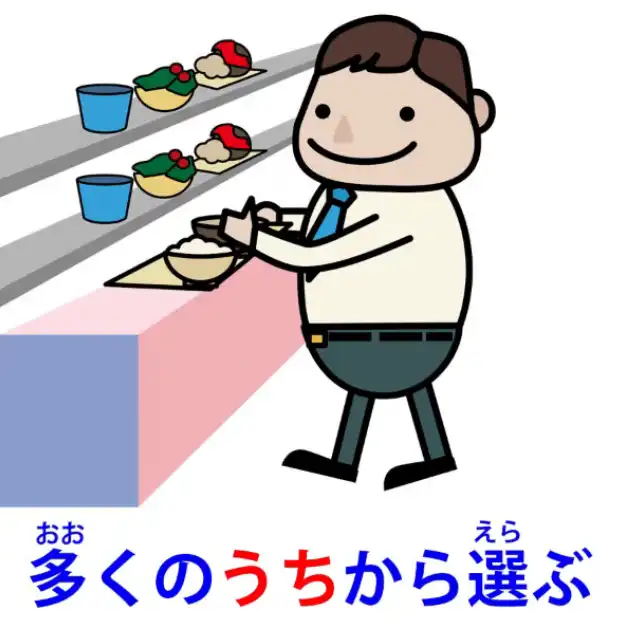
So “うち” here refers to the group from which one’s choosing.
And it can become a little more abstract than that.
It can be referring to an “うち” of time, an enclosure of time, and again, an enclosure defined by its contents.
So, we might say “温かいうちに食べる”, which means “eat it while it’s warm”.
“Eat it while it’s hot”, as we’d say in English.
“温かいうち” is that “うち”, that enclosure, that period, during which the food is warm.
So it’s an enclosure defined by its contents, like the other kinds of “うち”.
When does the “うち” end? It ends when the food stops being warm.
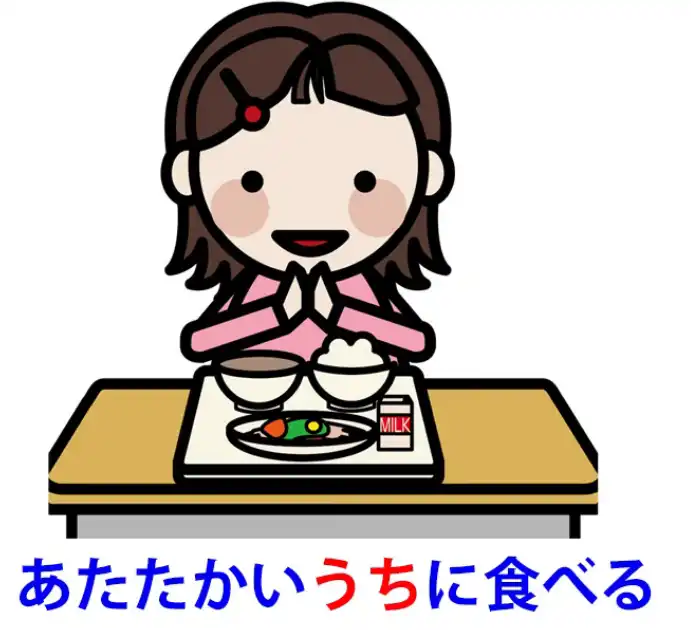
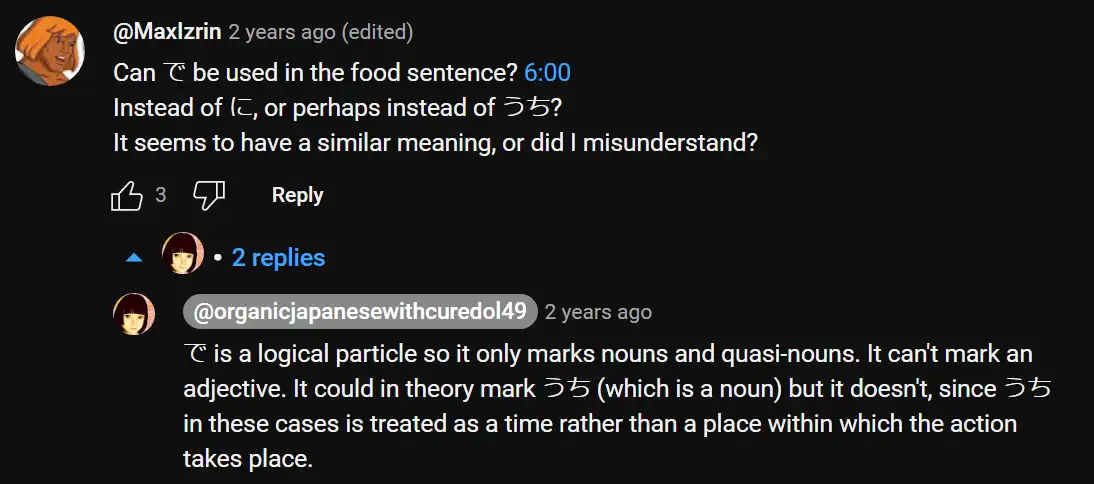
Similarly, “若いうち” (while one is young) – one should do this, do that, while one is young.
The “うち”, the enclosure of time, is defined by its contents.
While one is young, one is in the “若いうち”.
When one ceases to be young, that’s where the limits of the enclosure lie.
#
今のうち
And this can extend to usages that can be a little confusing at first.
So, for example, “今のうち”, which is a phrase you’ll often hear in anime and such.
For example, when an enemy is disabled and now is the time to do the magical purification, somebody might shout “今のうち!”

And what that means is literally “in the house of now / in the enclosure of now”.
It doesn’t necessarily mean “this absolute instant”, but it does mean “while now continues”.
What does “now” mean in this case?
Well, “now” means the situation as it is at present, in this case, while the villain is still purifiable, while he’s disabled, while we can actually do what we need to do.
It could mean, while we’re still able to run away.
It could mean, while the Great Door still hasn’t closed.
In other words, “今のうち” is “while the circumstances that prevail at the moment continue to prevail”.
Once they cease to prevail, you will no longer be “今のうち”.
#
そのうち
And another one that can seem confusing is “そのうち”.

Now, “そのうち” is translated as meaning, and does mean, “sooner or later / at some time in the future / it will eventually happen / by and by”.
So why does “そのうち” mean that?
To understand this, we not only have to understand “うち” but we have to understand a little bit more about “その”.
##
What does その mean
Now, I’ve made a video (Lesson 75) in which I explain various things about the use of “その” in Japanese.
It very often replaces what in English would be pronouns.
So if we say “さくらとその犬”, we’re not saying “Sakura and that dog”.
We’re saying “Sakura and her dog”.

“その” often implies something related to what we’re talking about.
And it’s one of the strategies that’s used in view of the fact that Japanese doesn’t use pronouns all that often.
A somewhat more abstract usage is, for example, in a dictionary definition like “立ち会う”, which means “be in a place as a witness”, and the Japanese definition is “証人としてその場に出る” which means “as a witness, appear in that place, come out in that place”.
But what does “that place” mean in this situation?
What is “その” actually being used to mean?
It means simply whatever place it is, the place appropriate to the current situation.
##
So, what does そのうち mean?
And this is the kind of “その” that’s being used in “そのうち”.
“そのうち” means during the enclosure of time that is appropriate to whatever we’re talking about (it will happen).

“そのうち” means it will happen within a period of time that’s reasonable for it to happen in, which may seem a little vague, but it’s no vaguer than the equivalent English expressions like “one of these days / sooner or later / before long”.
It’s a little bit more specific in that it does tend to imply a time that’s not too late for it to be of any use.
So this is really how “うち” extends its meaning from quite specific ones to more and more abstract ones, all of which are closely related to the fundamental meaning.
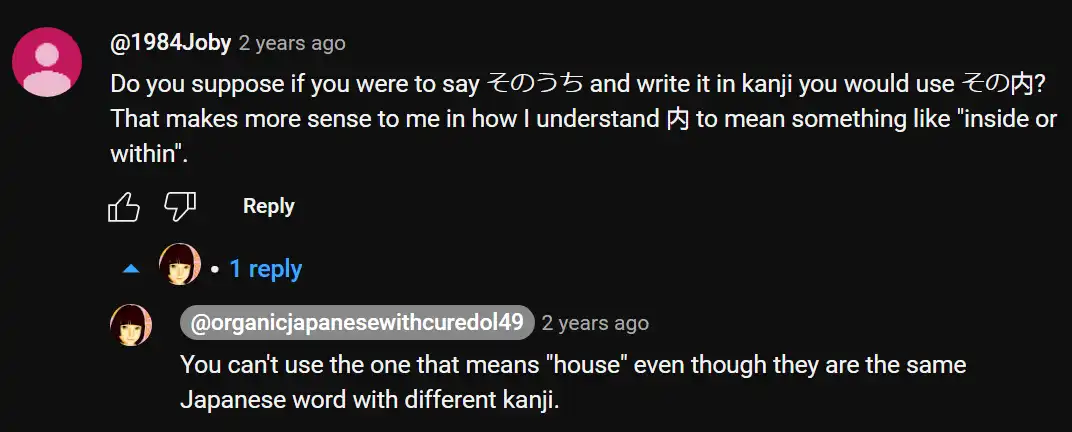
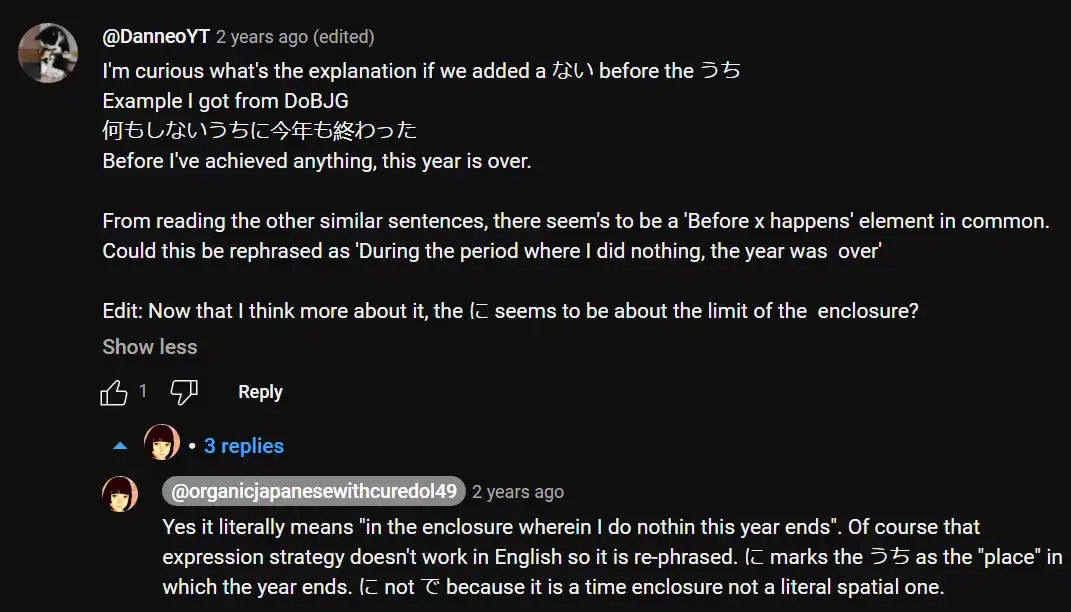
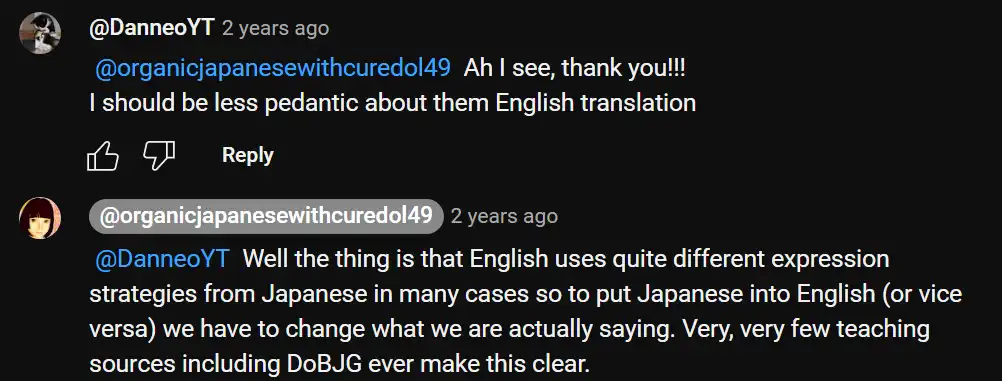
Note: If you came this far then I thank you and you are awesome!
Thus, we have reached the end at last… took me roughly 1.5 years to edit so I will get some rest soon, made it just in time for 2024:D Though I will yet need to update 26-78 I guess later.
Quite a journey indeed I guess (*^ω^)八(⌒▽⌒)
Dolly has 204 videos in total so there are still around 100-ish videos, but alas that is beyond the scope of my energy currently, I may add some videos from time to time if I feel like it if I find a good way to copy the subs and all (these 97 lessons were here before I became an editor).
I would like to add some of Dolly’s immersion videos and vocabulary / kanji acquisition videos especially, since I feel they are very useful. Though now I would like to focus on inputting a lot.
Anyway, this Transcript should get you well covered in terms of general stuff that you can then reinforce on your own, you should have the basics laid down already quite well at this point.
—
Keep it up and go consuming tons and tons of actual Japanese content & if you can go to actually USE the language.That is how one acquires it. Just keep going & it gets easier.
Obviously, for all kinds of resources you can check my Resource document on the first page.
Again, the only way you “Git Gud” is if you put in the time and ACTIVE effort! 頑張ります!
You can contact me on Discord or through mail if anything.
Especially if you find a typo or wrong information / note or if you have some tips etc.
I thank the people who reached out to me with kind words, reporting errors etc., feedback makes me really happy!
To close this, I would like to thank Nunko (formerly Dinuz) from MoeWay for this whole transcript and for allowing me to not only edit it, but to make me the owner down the line.
I appreciate it a ton! Definitely visit MoeWay and join their Discord! Amazing community.
Obviously I would also like to thank every single editor that worked on this transcript, whether it was before I came, or after, providing some assistance with the editing!
I thank you all and thank you for your contribution!
Fin (for now at least…)
[1] Robert Van Valin, “Semantic Macroroles in Role and Reference Grammar,” Role and Reference Grammar, 2002, https://rrg.caset.buffalo.edu/rrg/vanvalin_papers/SemMRsRRG.pdf, p. 1-3. Just in case. From that big note in Lesson 13 (for some reason pageless mode puts footnote citations here & I can’t use collapsible headings without it…)